Home | About us | Support the show | Contact us | Archives | Listen
Archives
On this page: Hoosier history facts | Listen to some of our past shows | Hoosier history as heard on our show
|
Home | About us | Support the show | Contact us | Archives | Listen ArchivesOn this page: Hoosier history facts | Listen to some of our past shows | Hoosier history as heard on our show |
Email newsletter
|
Bygone restaurants and supper clubs in Indy: the sequel(Dec. 30, 2017) The platter was overloaded when we welcomed the New Year 2017 by serving up a show about Bygone restaurants in Indy.
Also on the bill of fare: restaurants in the Indy area that have closed during the last year. Returning to Hoosier History Live are two guests who made the New Year 2017 show such a treat:
In addition to Sam's Subway and the Huddle chain, we explore Merrill's Hi-Decker, a drive-in that was located near the Indiana State Fairgrounds and, during the late 1950s, featured a disc jockey in a studio perched atop the circular building. A much longer-lasting restaurant discussed during the show: the Hawthorn Restaurant, which Jeff's book describes as "a fixture at 16th and Meridian for over 30 years," beginning in 1942. "The pretty white building featured a covered porte-cochere and expansive bay windows for diners to view the bustling traffic. The main dining room was centered on a large apple tree."
Our guests share insights about why supper clubs almost entirely vanished, here and across the country. They also discuss Indianapolis restaurants that closed in 2017 despite, in some cases, long histories and devoted patrons. In May, The Elbow Room, a pub at that opened in 1933 with the repeal of Prohibition, shut down. The Elbow Room had been a fixture at 605 N. Pennsylvania through eight decades of the evolution of downtown Indy.
Returning to the theme of restaurants from a previous era: For many decades beginning in the early 1950s, Knobby's Restaurant was a locally owned chain with popular drive-in options. (The drive-in component had long been eliminated by the time the last Knobby's, located on North Keystone Avenue and 52nd Street, closed in 2001.) On this edition of Hoosier History Live, our host Nelson, whose family frequently patronized Knobby's during his boyhood in Indy, shares a little-known tidbit: the origin of the Knobby's name.
History MysteryIn some Indiana cities, former Carnegie Libraries have reopened as restaurants during the last 25 years. They include the Carnegie Library in Carmel, which was built in 1913. After being closed as a library, it opened as Woody's Library Restaurant in 1998 and continues to serve patrons. In another small city in central Indiana, the historic Carnegie Library was built in 1904. It opened as a popular restaurant in 1999 and, like the library-turned-dining spot in Carmel, continues to serve patrons. Hint: Also like Carmel, the city is in a county that shares a border with Marion County. Question: What is the city? The call-in number is (317) 788-3314. Please do not call in to the show until you hear Nelson pose the question on the air, and please do not try to win if you have won any other prize on WICR during the last two months. You must be willing to give your first name to our engineer, you must answer the question correctly on the air and you must be willing to give your mailing address to our engineer, so we can mail the prize pack to you. The prize is a gift certificate to Story Inn, courtesy of Story Inn; and two admissions to GlowGolf, courtesy of GlowGolf.
Roadtripper: Covington in west central IndianaGuest Roadtripper Joan Hostetler of The Indiana Album and Heritage Photo & Research suggests that we explore the small town of Covington. It's the seat of Fountain County and is located just off I-74 in west central Indiana. Joan says that the town is famous for its courthouse murals, which were a Works Progress Administration project in the late 1930s. The murals were painted by Eugene Savage, who was a Covington native, and other local artists, mostly women; the murals depict the settlement of west Indiana. As Joan assures us, the murals are "worth a visit!" After looking over the murals in the courthouse, Joan says, "Take some time to wander the courthouse square and explore its many little shops. Be sure not to miss the restored Clerk's Building." The Federal style, red-brick building was constructed in the 1840s for government offices and now serves as an historical museum. On your way out of town, Joan recommends checking out the Beef House, which now offers dinner theater as well as fine dining. The coming season's shows include a Patsy Cline revue, Newsies, and Neil Simon's The Odd Couple.Toys, toys and more toy heritage: encore broadcast(Dec 23, 2017 ) As every mother's child knows, Christmas is all about the toys. So while the Hoosier History Live crew is off sipping cocoa this week, we're giving listeners the chance to revisit our 2016 show exploring nationally known toys with Hoosier connections. As Nelson and his guest make clear, Indiana's heritage of children's toys has not just been fun and games.
To explore enough Indiana toy connections to fill a playroom, Nelson is joined by studio guest Kara Kavensky, a marketing and communications specialist who has researched the links between nationally distributed toys and Hoosiers. (When this show originally was broadcast on Jan. 20, 2016, her name was Kara Reibel; she was the community relations specialist at Carmel-based pi lab, creators of Edwin the Duck. It's a computer app-enhanced children's educational toy.) According to Kara, the original Gyroscope was first manufactured in 1917 by Hoosiers. The gyroscope - as well as the Pet Tornado, the Original Blocks and Marbles and other "nostalgia toys" - are made today by TEDCO Toys in Hagerstown, Ind.
And talk about a big footprint: Guinness World Records lists Garfield, the comic strip about a cantankerous cat created by Jim Davis, who grew up on a farm near Fairmount, as the most widely syndicated comic strip in the world. Jim Davis and his team at PAWS Inc., which is headquartered on a wooded retreat near the town of Albany, draw the strip and create an array of Garfield products such as dolls with suction-cup paws, books and posters.
Some fun facts related to our toy heritage:
Raggedy Ann was created by Johnny Gruelle (1880-1938), who grew up in the Lockerbie neighborhood of Indianapolis and was a cartoonist for The Indianapolis Star for several years before moving to the East Coast. Raggedy Ann made her debut in a book published in 1918; the dolls initially were spinoff products, hand-made by Gruelle family members with small hearts sewn into their chests. Gruelle descendants have told Nelson that the inspiration for the famous character was Johnny's recollection of his two favorite poems by family friend James Whitcomb Riley: Little Orphant Annie and The Raggedy Man.
RoadTripper: Greensburg - more than a courthouse treeGuest Roadtripper John Pratt, a history teacher at Greensburg High School, suggests a Roadtrip to his hometown of Greensburg. Every visit to the small town of 11,000, southeast of Indianapolis in Decatur County, begins at the downtown courthouse to take a glimpse at the famous tree growing from the courthouse tower. But there is much more to see. The town square is filled with restaurants, antique stores and an art gallery. A short walk to 413 N. Franklin St. takes you to the Italianate Greek Revival home of B.B.Harris, a member of Morgan's Raiders. And across the street is the Porter Oliger-Pearson Funeral Home. The funeral home building is the former home of former Lieutenant Governor Will Cumback, who cast Indiana's first ever Republican electoral vote, which went to his friend Abraham Lincoln. While exploring the town square, be sure to check out the historical marker to Carl Fisher. As any self-respecting devotee of Greensburg knows, Carl Fisher, co-founder and president of the Indianapolis Motor Speedway, was born in Greensburg in 1874. Interested listeners can check out the podcast of our 2009 show about Carl Fisher with guest Glory-June Greiff. Heading south, you can enter the Decatur County Historical Museum, filled with a treasure trove of early Native American artifacts and local historical items. One block further south takes you back to the courthouse square, where presidential candidate Robert Kennedy gave a speech in 1968 as he marveled at the mulberry tree on top. Directly across the street, no visit is complete without a visit to Storie's Family Restaurant, the famous local eatery known for tenderloin sandwiches and homemade pie.
Hoosier History Live holiday dinnerVietnam War and Hoosiers: special perspectives(December 16, 2017) Following our November 11 2017 show featuring special perspectives on World War II - and in the wake of the 2017 Ken Burns documentary - we share insights about the Vietnam War and its impact from the vantage point of Hoosiers.
So does Ken Marshall, a Franklin resident who hosts a Saturday morning talk show for White River Broadcasting that airs on WCSI-AM in Columbus. Ken, who grew up in Indianapolis, enlisted in the Army in 1970, trained as a medic and was assigned to a hospital in Okinawa. He treated Army soldiers, Marines and others injured in Vietnam. Ken also became a disc jockey on a radio station in Okinawa, helped start a community theater funded by the Army and worked on a USO tour that visited islands in the Pacific Ocean during the war.
Their book emphasizes that many of those who served in the military were from blue-collar families, including Dick Wolfe. An avid drag racer, he had dropped out of Princeton High School. Next came the unexpected pregnancy of a 17-year-old girlfriend and the birth of his son in March 1967. After that, Dick Wolfe returned on a furlough from infantry training to get married.
Summer Wind includes a letter written by Dick Wolfe during the Christmas season of 1967 - one month before he was killed - in which he urges his parents not to feel sorry for him. The letter tells of one of his infantry comrades, a medic, who tended a shabby, artificial Christmas tree mounted on an ammunition box. (The medic would die during the same battle as Dick Wolfe.) At the hospital in Okinawa where our guest Ken Marshall was a medic, various Army agencies and the American Red Cross extended valuable support to wounded soldiers and their families. According to Ken, he also observed how government statistics could be manipulated to distort the number of casualties. During our show, Ken shares brief excerpts about combat experiences from a recent speech by a Hoosier veteran of the war. In addition to hosting his radio talk show, "Saturday Morning Live with Ken Marshall" for 23 years, Ken has been an adjunct professor at Ball State University, Franklin College and other colleges. Our guests Randy and Roxanne Mills are the authors of other military history books. For Summer Wind, they not only interviewed friends and relatives of Dick Wolfe - including his closest buddy from Princeton, who also served in combat during the Vietnam War - they tracked down photos that Wolfe took in the swamps and jungles. "His many letters home," they write, "rarely censored the perils of fighting in Vietnam." History MysteryIn addition to Princeton, the hometown of the Vietnam War soldier who is the focus of the new book Summer Wind, Gibson County in far-southwestern Indiana also includes a landmark community in African-American history. During the 1830s, African Americans began arriving in the Gibson County community, which is considered one of Indiana’s earliest black rural settlements. Today, two prominent buildings stand as reminders of this rich history: the Wayman Chapel Church (pictured above) and a restored school building that serves as a community center and museum. An exhibit about the Gibson County community is included in the Smithsonian's new National Museum of African American History and Culture that opened on the National Mall in Washington D.C. last year. Question: What is the name of the historic African-American community in Gibson County? The call-in number is (317) 788-3314. Please do not call into the show until you hear Nelson pose the question on the air, and please do not try to win the prize if you have won any other prize on WICR during the last two months. You must also be willing to give your first name to our engineer, and you must answer the question live on the air. The prize is a gift certificate to Story Inn in Brown County, courtesy of Story Inn, as well as a pair of tickets to the Indiana History Center, courtesy of the Indiana Historical Society, as well as a pair of tickets to GlowGolf, courtesy of GlowGolf.
RoadTripper: Kintner House Inn in Corydon
The history of Corydon's Kintner House Inn, which is still open as a bed-and-breakfast, stretches back even further than the Civil War, however. It was around 1819 that Jacob Kintner opened his two-story limestone home to travelers, and as business boomed, he built an elegant new hotel. Fire destroyed that building, and in 1873 he tried again and constructed the Inn that still stands today. The exterior is so pretty it's been featured on two Hallmark Christmas cards. Inside, the Kintner House Inn is steeped in Victorian-era charm: both an organ and piano grace the parlor, and bedrooms feature fringed lampshades, tasseled curtains and a variety of antiques. Visitors will find such treasures as an 8-foot tall flame mahogany armoire, a walnut dresser with pink marble top, an inlaid star-patterned game table and a towering, hand-carved walnut bed dated to the 1850s. The Kintner House Inn served as the reluctant hosts of General Morgan and his troops following the Battle of Corydon on July 9, 1863, but we'll let Jane share those historical details with you during this portion of the show. She may convince you it's worth the trip to see with your own eyes the only Civil War battlefield (aside from Gettysburg, of course!) located on Northern soil. Peace heritage in Indiana(Dec 9, 2017) This being the season of peace and goodwill, our show explores the heritage of peace-making in the Hoosier state. Specifically, we look at the resolution of conflicts ranging from bullying among children to disputes among adults in the workplace and neighborhood. Nelson is joined in studio by two guests from groups with deep traditions in peace advocacy:
We look into Indiana's past to examine efforts at conflict resolution and peacemaking. One such effort: during the Civil War, Quakers in Indiana struggled with the dilemma of whether to take up arms for the Union cause. Their ethical quandary later inspired a major storyline in the novel The Friendly Persuasion, a national bestseller written in 1945 by acclaimed author Jessamyn West, a native of Jennings County, Ind. In 1956, a movie version starring Gary Cooper was released.
Our guest Tim Nation, a native of Terre Haute, is the co-chair of the Indianapolis Race and Cultural Relations Leadership Network. According to Tim, the Peace Learning Center has worked with 200,000 children and adults since it was founded in 1997. The center now has programs in eight cities and several foreign countries. "At Peace Learning Center," Tim says, "we believe everyone can be a peacemaker." In the week before the show's broadcast, Indianapolis Colts players and Indianapolis Metropolitan Police Department officers visited the Peace Learning Center to work with sixth graders from Eleanor Skillen Elementary School (Indianapolis Public School No. 34). According to an account in The Indianapolis Star, the police officers helped teach "safe and simple ways to manage anger, solve problems and develop an understanding of different perspectives." Colts players who participated included Kenny Moore II, a rookie cornerback. At the Indianapolis Peace & Justice Center, founders during the 1980s included the late Jane Haldeman, who died in 2009, and her husband Ron Haldeman, a Quaker minister. The center advocates for peace-focused responses to national, state and local policy issues. Other Hoosier peace heritage notes:
History Mystery
Although hailed as a military commander for his triumphs even when his forces were greatly outnumbered, he also was known for his leadership of the Miami tribe during times of peace. He struck alliances with white leaders and sought to avoid the conflicts that led to the disastrous Battle of Tippecanoe. The Miami leader died at his lodge in Indiana in 1812. Question: Who was the leader? Hint: He was not Tecumseh, a great leader who was Shawnee, not Miami, and lived in Tippecanoe County, not northeastern Indiana. The prize is a gift certificate to Story Inn in Brown County, courtesy of Story Inn, as well as a pair of tickets to the Indiana History Center, courtesy of the Indiana Historical Society.
RoadTripper: Getting outdoors in Steuben CountyGuest Roadtripper and DNR volunteer Terri Gorney of Ft. Wayne encourages Hoosiers to get outside and explore natural areas in any season, including winter. “Everyone knows Pokagon State Park, but there are two wonderful nature preserves near Pokagon in Steuben County in northeast Indiana that are not so well known and are definitely worth exploring," says Terri. One is Wing Haven, a gem of a property that is owned by Acres Land Trust and includes an old stagecoach inn and wonderful prairie lands. It's right on the Seven Sisters Lakes, an undeveloped lake chain in Steuben County. Wing Haven, a birding destination, was a gift from Helen Swensen, whose 19th century log buildings are now used by the property's caretakers. And then there's McClure Reserve, which was donated in 1957 by Maurice McClure in an era before land trusts. McClure Reserve is owned by Steuben County and includes 80 wooded acres with spectacular pine trees. The reserve is maintained by volunteers and includes the best old-growth forest in northeast Indiana, including large tulip trees and red and white oaks. Terri stresses that winter is a great time to explore the outdoors in Indiana and experience the colors and textures of the natural landscape in its dormant period. As she notes, "Our four seasons give us an ever changing palette!"
Pioneer music in early Indiana: encore presentation(December 2, 2017) The jaw harp was popular. So were the fiddle and dulcimer. Community bands played flutes, whistles and drums.
Less widely seen (or, in some cases, not present at all) in the Hoosier state of the 1820s, '30s and '40s: the guitar, banjo, harmonica, mandolin, ukulele and accordion. On this encore show originally broadcast in 2013, Nelson is joined in studio by Erik Peterson to explore various aspects of the music played by pioneer families in Indiana. Erik, an Indianapolis-based musician and historian, has performed at Prairietown at Conner Prairie Interactive History Park and at other history-focused sites. "Keep in mind that, during the pioneer era, Mozart had not been dead for as long as Buddy Holly has been gone today," Erik says.
During this show, he performs a few musical interludes to convey a flavor of the music heard in pioneer Indiana. He has gained insights by tracking down diaries, letters and journals of pioneer families.
The jaw harp, a hand-held instrument about the size of a harmonica, was played frequently. Erik performs a tune on the instrument during our show, a rare opportunity to hear it. He notes that today, the jaw harp primarily is relegated to the soundtracks of animated cartoons. “The fiddle was king of instruments here during the pioneer era,” Erik says. “It’s loud, and it’s portable.” The first piano was brought to Indiana during the early 1800s; the historic instrument is exhibited today at Switzerland County Historical Museum in the far-southeastern county on the Ohio River. The piano was discussed during a Hoosier History Live show in 2013 about Switzerland County History. The extraordinary efforts undertaken to transport pianos here decades before railroads underscore the importance of music in the lives of pioneers, Erik emphasizes. He points out that many pioneer towns in Indiana even had community bands.
Before that, advertisements for academies such as the Indianapolis Female Institute touted instruction in piano for young women. During our show, Erik plays a few verses of a song that would have been played frequently in early Indiana: Hail, Columbia!, the unofficial national anthem of the era. The Star Spangled Banner was not adopted as the official national anthem until 1931, about 100 years after the era that is the focus of our show. Since then, Hail Columbia! primarily has been played to introduce the American vice president.
Roadtrip: Wabash and Erie Canal Park in Delphi
There's plenty of hiking and history at the Wabash and Erie Canal Park in Delphi, which is open year-round and includes an Interpretive Center, lots of trails for hiking and biking, and canal boat rides that continue through the end of September. Don't miss the Delphi Opera House and adjacent shops. Glory-June also has an eye for great small-town restaurants; she recommends Delphi's Stonehouse Restaurant and Bakery. And for your dining pleasure either coming or going, there is Treece Restaurant in Rossville.
Early era of the Indiana Pacers(November 25, 2017) Fifty years ago, the Indiana Pacers played their debut game against the Kentucky Colonels in the Coliseum at the State Fairgrounds in Indianapolis. The new team was part of an upstart professional league, the colorful American Basketball Association (ABA), and before any of the players had even scored a point, much civic, social and sports history already had been made.
Efforts at putting together the Pacers team had met a variety of challenges. Unsuccessful attempts had been made to woo household names in Indiana - including former high school basketball sensations Oscar Robertson and identical twins Tom and Dick Van Arsdale - to be part of the Pacers organization. And some of the African-American players who had been signed to the team encountered challenges finding housing in the Hoosier capital due to the racial discrimination that was unfortunately common at the time. To explore the rich history of the early era of the Pacers, Nelson is joined in studio by veteran sports journalist Mark Montieth, who, as a boy growing up in Indy, listened to the debut Pacers game on the radio. Mark is the author of a new book, Reborn: The Pacers and the Return of Pro Basketball to Indianapolis (Cardinal Publishing Group). In the early 1960s, Mark writes, the Hoosier capital was growing, "yet it had no national sports identity beyond the Indianapolis 500."
Early games in the ABA often were raucous, and fighting among the players was common. Several of the early Pacers were regarded as wild characters, including fan favorites Bob Netolicky and Mel Daniels. The starting salaries of early Pacers players? According to Reborn, one aspiring Pacer signed a contract for $10,000, with the possibility of a $2,000 bonus. The ABA was distinctive for its red, white and blue basketball and the introduction to the pro game of the 3-point shot. "The Pacers were born and raised in a league and an era unlike any other in the history of professional sports," Mark writes in Reborn. The future of the team and of the league were considered so uncertain that Bobby "Slick" Leonard (the former high school basketball star from Terre Haute who later coached the Pacers to the national championships) was so wary of giving up a secure job as a salesman for class rings that he didn't initially seek the coaching opportunity. Some early players were essentially being offered second chances to achieve hoops glory. In high school and college, Netolicky was "more motivated to have fun than to play basketball" and had exotic pets such as an ocelot and a boa constrictor, according to Reborn. His eventual teammate Roger Brown had taken a factory job on the night shift after his links to a gambler ended opportunities as a player in college and with the NBA. Other Pacers history facts:
History Mystery
Netolicky, a 6-foot-9 power forward and center, frequently chatted with patrons of the bar, which often was jammed after Pacers games. It cultivated a "swinging" atmosphere, with strobe lighting and go-go dancers. Question: What was the name of the neighborhood and shopping center where Neto's was located? The call-in number is (317) 788-3314. Please do not call into the show until you hear Nelson pose the question on the air, and please do not try to win if you have won any other prize on WICR during the last two months. You must be willing to give your first name to our engineer, you must answer the question correctly on the air and you must be willing to give your mailing address to our engineer, so we can mail the prize pack to you. The prize is a pair of tickets to The Messiah on Dec. 10, courtesy of the Indianapolis Chamber Orchestra, gift certificate to Story Inn, courtesy of Story Inn; and two admissions to GlowGolf, courtesy of GlowGolf.Roadtrip: Marshall County Museum in Plymouth
Plymouth is located at the crossroads of two historic highways, the Old Michigan Road (U.S. 31) and the Old Lincoln Highway (U.S. 30). Chris has been fascinated with Indiana history since the 4th grade and he now serves on the board of directors of the Studebaker National Museum Foundation. The Marshall County Museum is in downtown Plymouth and has won the Indiana Historical Society award in recognition of "remarkable public services and programs provided to its community." Chris will share details about the museum's displays, which cover 25,000 square feet. The museum features office suites that have been restored to reflect their original décor from the 1930s and 40s, when the building housed offices for a local dentist, lawyer and other professionals. The Titanic and Hoosiers: encore presentation(November 18, 2017) This week, Hoosier History Live features an encore presentation of a compelling show from 2010, The Titanic and Hoosiers. Did you know that there were 14 passengers with Indiana connections on the doomed Titanic, which struck an iceberg in the North Atlantic and sank in 1912?
Exploring a variety of aspects of the tragedy that has captivated the world since the British passenger liner sank on its maiden voyage, Nelson is joined in studio by Indianapolis resident Craig Ware, whose lifelong interest in the Titanic culminated with meeting the final living survivor - and then corresponding with her. That passenger was Millvina Dean, the youngest passenger on board, who died at age 97 in England in 2009. A member of the Titanic Historical Society years before the ship was discovered at the bottom of the North Atlantic in 1985, Craig has amassed a trove of information about the massive liner that was built for luxury and convenience, not speed. In the years since its sinking, the Titanic has become a symbol of the overconfidence and opulence of the Edwardian era. Nelson and Craig are joined in studio by Katherine Gould, associate curator of cultural history at the Indiana State Museum, where "Titanic: The Artifact Exhibition" was on display during the original 2010 broadcast of this show. The exhibit featured about 240 artifacts salvaged from the wreck site at the bottom of the North Atlantic.
Myths and folklore abound about the sinking. They include allegations that distress signals were ignored, that third-class passengers deliberately were kept below deck and that the ship's cargo included cases of dragon blood, a bright-red tree resin that has been used for centuries in varnishes, medicines, and dyes. Nelson and his guests separate fact from myth as they delve into a tragedy that for generations has fascinated social historians, analysts of mass panic and those intrigued by what happened to - and aboard - the ship. Their numbers are legion, particularly since the release of the blockbuster movie Titanic (1997) starring Leonardo DiCaprio and Kate Winslet. Their co-star Gloria Stuart passed away in 2010 at the age of 100. Some Titanic-related tidbits:
Roadtrip: Cole Porter Room at the Indiana History CenterGuest Roadtripper Amy Lamb of the Indiana Historical Society invites us to step into the 1940s in the Cole Porter Room, a permanent exhibit at the Indiana History Center at 450 W. Ohio St. in downtown Indianapolis. The room is designed to evoke the style of New York's famed Waldorf-Astoria Hotel.
Alas, the Cole Porter Room's similarities to an elegant 1940s cabaret lounge do not include libations; no Champagne cocktails or zombies are in the offing. Cole Porter (1891-1964) was born in Peru, Ind. and composed such classics of the American Songbook as "Night and Day," "Anything Goes" and "I Get a Kick Out of You." Of the many Broadway musicals he composed over the course of his lengthy career, his most famous is Kiss Me Kate, a reworking of Shakespeare's Taming of the Shrew. World War II and Hoosiers: special perspectives(November 11, 2017) Despite orders to soldiers during World War II to not write diaries, Roscoe "Rocky" Boyer, who grew up on a farm in Clinton County, Ind., secretly kept one anyway. He became an officer with a fighter bomber unit in the South Pacific.
As a salute to Veterans Day, Hoosier History Live explores their written accounts from the front lines, as well as related insights about Hoosiers' roles in World War II. Nelson is joined by two guests:
In June 1941, Rocky Boyer was drafted the morning after he graduated from Franklin College. His diary reads: "My first day out in the cold, cruel world. Yes, the draft got me - and how!" His service took him from Indiana to New Guinea, where he wrote about wartime camp life at one of the world's largest air bases, and to the Philippines. Rocky Boyer became a first lieutenant and participated in a major air blitz regarded as pivotal for the Allied victory in the southwest Pacific.
Also during our show, Ray Boomhower shares insights about a top U.S. military commander with Indiana connections who is mentioned several times in Dispatches from the Pacific. Admiral Raymond Spruance, who grew up in Indy and graduated from Shortridge High School, commanded naval forces during some of the most significant battles in the Pacific. In addition to describing battles - including the major air war in New Guinea - Rocky Boyer's diary describes daily life for soldiers that sometimes involved unexpected, unnecessary risks. According to accounts in his diary, Rocky was awakened by an alcohol-fueled party at an officers' club that involved periodic explosions of TNT and blasts of gunfire.
At the end of the war, Rocky Boyer was on a mission in Ie Shima, a small, volcanic island near Okinawa; Ie Shima also is where Ernie Pyle was killed. Hoosier History Live explored Pyle's columns about Indiana - as well as those of journalist John Bartlow Martin, who grew up in Indianapolis - during a show in May 2015. You can listen that show by visiting our website at hoosierhistorylive.org, or by clicking here. Both of our guests - as well as Nelson, our host - signed copies of their books at the Holiday Author Fair on Dec. 2 from noon to 4 p.m. at the Indiana History Center, 450 W. Ohio St. More than 60 authors with Indiana connections were participate in the annual event. Our show this week is shorter than usual because of coverage of UIndy football; there is no Road Tripper report. History MysteryDuring World War II, an Indiana city was seventh on a bombing list of American targets put together by Adolf Hitler and his advisers, according to some historic accounts. The Germans' interest in bombing the city was attributed to major industrial centers there that were involved in wartime manufacturing. They included a piston plant that was making parts for tank, airplane and truck engines. Other major employers in the Indiana city during WWII were International Harvester, General Electric, Magnavox and other plants that made U.S. Army trucks, airplane propellers and other items used by the military. An author who grew up in the Indiana city even wrote a book with a title that includes the town's name and the ominous phrase "Seventh on Hitler's List." Question: What is the Indiana city that was on the Germans' list of bombing targets during WWII? The call-in number is (317) 788-3314. Please do not call in to the show until you hear Nelson pose the question on the air, and please do not try to win if you have won any other prize on WICR during the last two months. You must be willing to give your first name to our engineer, you must answer the question correctly on the air and you must be willing to give your mailing address to our engineer, so we can mail the prize pack to you. The prize is a gift certificate to Story Inn, courtesy of Story Inn; and two admissions to the Indiana History Center, courtesy of the Indiana Historical Society, and two admissions to GlowGolf, courtesy of GlowGolf.
New individual contributors like the show's weekly podcastJim and Nancy Johnson recently hit the yellow "Donate" button on our newsletter to offer their financial support to the show. Along with their contribution, they left this comment: Won't you join Jim and Nancy in offering your support for the hard work that goes into creating a quality radio show like Hoosier History Live and making it available as a podcast? All you have to do is scroll down to the yellow "Donate" button below and pledge your support. The crew at Hoosier History Live thanks you! Adventures in personal DNA testing(November 4, 2017) As is clear from the popularity of the show Finding Your Roots, now in its fourth season on PBS, and from the high volume of visitors to the website ancestry.com, many Americans are interested in learning about their family history. And with the advent of personal DNA analysis from services such as 23andMe and AncestryDNA, more and more individuals are learning about the precise admixture of ethnicities in their genetic heritage, as well as discovering possible matches for unknown blood relatives who have undergone the DNA testing themselves.
For this Hoosier History Live show examining what personal DNA testing reveals about ourselves and our shared history, guest host and associate producer Mick Armbruster interviews three Hoosier women who have recently conducted a personal DNA analysis that yielded surprising results. Mick's guests in studio are:
Learn more:
History MysteryIn 1907, the Indiana state legislature passed a law that provided for the involuntary sterilization of "confirmed criminals, idiots, imbeciles and rapists." The law, which was later found to be unconstitutional and was repealed in 1974, was the first recorded sterilization law in world history and, according to some historians, served as a model for similar laws in Nazi Germany during the 1930s. During the time when the Indiana sterilization law was active, more than 2,300 Indiana citizens deemed "mental defectives" by the state were involuntarily deprived of their ability to have children. Question: What was the official term for the "science" (now regarded as pseudoscience) of improving the human population through forced sterilization? Hint: the word is based on the Greek roots for "well" and "born." The call-in number is (317) 788-3314. Please do not call into the show until you hear Mick pose the question on the air, and please do not try to win if you have won any other prize on WICR during the last two months. You must be willing to give your first name to our engineer, you must answer the question correctly on the air and you must be willing to give your mailing address to our engineer, so we can mail the prize pack to you. The prize is four tickets to the Indy International Festival on Nov. 9, 10, and 11, courtesy of the Nationalities Council of Indiana; a gift certificate to Story Inn, courtesy of Story Inn; and two admissions to the Indiana History Center, courtesy of the Indiana Historical Society.
Roadtrip: Completed east wing of Lanier Mansion in MadisonKisha Tandy of the Indiana State Museum and Historic Sites recommends a Roadtrip to the Lanier Mansion in the town of Madison in southern Indiana on the Ohio River. Since 1926 the mansion has been a museum dedicated to the story of its builder and original owner, James F. D. Lanier (1800-81), a financier who is credited with starting the first railroad in Indiana. He also helped stabilize the finances of Indiana on three separate occasions, including a series of loans to the state totaling more than $1million during the Civil War. The Lanier Mansion, completed in 1844, is one of the best examples of Greek Revival architecture in the country and is considered to be the crown jewel of Madison's Historic District. Designed by architect Francis Costigan, the mansion exhibits many original Greek Revival features, including its square plan, the full-façade porch on the south elevation, the Corinthian columns on the south portico, the Doric pilasters that appear on several locations on the exterior, the ornamental pediments over the windows and doors and the Ionic columns that separate the double parlors on the first floor. Careful interior restoration and redecoration have recaptured the mansion's 19th-century splendor. During the 1990s, the Department of Natural Resources Division of Museums and Historic Sites, with major funding provided by the Lanier Mansion Foundation, restored the building and grounds to their former grandeur. After many years of painstaking research, the home was painted in the original colors both inside and out. On the interior, horsehair brushes were used to paint the walls and decorative plaster moldings, which were then covered with a high-gloss varnish as they were in 1844. The wallpapers and carpets all are reproductions of those available for purchase in the 1840s. Curators and other staff continue to research furnishings from the period, and changes to reflect their research may be made to the home in the future. And now, for the first time in the past 100 years, the east wing of the Lanier Mansion has been opened to the public, restored to its appearance at the time Lanier lived in the home. "The restoration has taken more than 20 years, involving painstaking research, physical reconstruction and plenty of community involvement," Kisha says, and the results are well worth a visit.
Charity music event at historic Alford HouseHoosier History Live senior tech consultant Richard Sullivan invites listeners and readers to his third annual benefit for FACE Low-Cost Animal Clinic. The Nov. 11 Fall Bash Dance Party features the Gordon Bonham Band performing an evening of "rump-shaking blues-rock" at the historic Alford House, 2428 E. 10th Street in Indianapolis. The event will be from 7:30 p.m. to midnight. Tickets are $20 in advance, $25 day of show. The historic Alford House, which is newly opened as an event center, was built in 1898 by Marion County Criminal Court Judge Fremont Alford and later became a funeral home for many decades. The event will benefit FACE (Foundation Against Companion-Animal Euthanasia), the near-eastside charity veternary clinic that has performed more than 250,000 animal spay/neuters and other surgeries since its opening in 1999. A newly constructed expansion building is set to open in February. "My admiration for the work of FACE is boundless," says Richard, who while a reporter at The Indianapolis News wrote stories about FACE founder Scott Robinson, an emergency-room physician who became an animal rights advocate during his doctor training. "They are responsible for reducing the companion-animal (dogs and cats) euthanasia rate in Indianapolis from more than 22,000 per year before their founding to fewer than 3,000 per year today. And they had to fight city hall and established interests to do it. "Without FACE," Richard continues, "it is estimated that 50,000 dogs and cats would be euthanized in Indianapolis annually," based on human/pet population growth formulas. Hoosier History Live producer Molly Head will be working the door at the beginning of this event, and our associate producer Mick Armbruster will be there to close out the evening. Stop on by and say hello! "Old as Dirt" with a trio of Indiana garden writers
Among other dirty topics, the trio talks about some important historical highlights of Indiana horticulture: a hall at Purdue University that was named for a female leader in agriculture; landscape architects who worked in Indiana and whose culturally significant designs remain largely intact; and a brief look at consumer trends in growing plants in pots over the last few decades.
Irvin is horticulture display coordinator at the Indianapolis Museum of Art at Newfields, where he wrote award-winning blogs. He speaks around the country about tropicals and other plants and is a former director of the Perennial Plant Association. He also raises rabbits and chickens for show. Jo Ellen, Carol and Irvin also talk about Seed Your Future, a new initiative that promotes horticulture in the U.S. to young people. "Our food depends on it!" Jo Ellen points out. The trio also talk about horticultural jobs (ranging from dungarees to lab coats) and how they have changed over the years.
History Mystery
Question: What is the name of the two fruits featured in a recent Hoosier History Live show? You must give both fruits in order to win.
The prize is a voucher for two admissions to Frightful: A Silent Halloween, a film screening of the 1922 silent classic Nosferatu at Indiana Landmarks Center on Oct. 27, courtesy of Indiana Landmarks, as well as four tickets to the Indy International Festival on Nov. 9, 10, and 11, courtesy of the Nationalities Council of Indiana.
Roadtrip: German Catholic heritiage in Ferdinand, Ind.Guest Roadtripper Jeannie Regan-Dinius of the Indiana Division of Historic Preservation invites us to take a trip to Ferdinand, Ind., in Dubois County to visit several historic landmarks associated with the area's German Catholic heritage.
The cemetery is across the street from the spectacular Monastery Immaculate Conception, known as the "Castle on the Hill." It was built in 1867 and is listed on the National Register of Historic Places. Just outside the entrance of the monastery is the cemetery for the sisters who once lived and worked there. "The gift shop at the monastery is always a favorite for handmade goods," says Jeannie. She also tells us that once we have taken in the sights of Ferdinand, there is much to explore in the pastoral rolling hills of Dubois County. Check out the county's visitor website for more ideas! Ian Fraser: a gay humanist reflects on life in 1950s Indianapolis(October 14, 2017) Known for its conventionality and lack of cosmopolitan sophistication, Indianapolis in the 1950s would seem to have held little appeal as a place for a non-conforming, artistically inclined foreigner to take up residence in the United States.
Raised and educated in England and its colonial holdings in Africa and the Caribbean, Ian had launched a successful career as a designer in London when a chance meeting with an American tourist from Shelbyville, Ind., inspired his move to the American Midwest. The people Ian encountered in his new Hoosier home were friendly but had little idea what to make of this exotic creature. In the insular culture of Indiana at the time, few locals could even trace his and Ambrose's English accents back to their British origins, and the two were sometimes mistaken for Germans.
On this Hoosier History Live show, associate producer Mick Armbruster talks with Ian about his early years in Indianapolis, exploring his perspective on American life in the 1950s and how he was able to adapt to the local scene. Ian shares stories from his 2013 book, A Sow's Ear: Digressions and Transgressions of a Gay Humanist, which relates how the Indianapolis cultural elite welcomed him and Ambrose into their social world. With a naturally artistic inclination, Ian found an "oasis" in the John Herron Museum of Art, which later evolved into the Indianapolis Museum of Art, where he worked as a curator and guide for museum-sponsored tourism overseas. When they weren't hobnobbing with the Clowes family and other well-heeled patrons of the Indianapolis art scene, Ian and Ambrose also had their share of adventures with colorful characters from a variety of backgrounds and social circumstances - including the Indianapolis gay demimonde. We hear stories about some of those characters, and the ease with which Ian and Ambrose moved among an ever-widening social circle. Ian also shares his experience witnessing racial prejudice in 1950s Indianapolis.
Roadtrip: Crazy quilts and happenings at the IMA at NewfieldsGuest Roadtripper Stephanie Perry invites listeners to visit the Indianapolis Museum of Art at Newfields. Stephanie, who works for the IMA as assistant director of communications, says "We have a ton going on this fall," for example the special exhibition Crazy Quilts: Stitching Memories, which is on display through January 7. The unique exhibition takes guests on a trip back in time to the late 1800s, when crazy-quilt making became a fad. Women caught up in the craze experimented with different types of fabrics, needlework and patterns in order to showcase their skills as seamstresses and creativity as designers. To learn more on the topic, check out the Hoosier History Live show on Quilting Heritage from June of 2015. Stephanie also tells us that after visiting the IMA galleries, you can stroll about the 30 acres of gardens, which are open year-round. Many of the gardens are part of the historic Oldfields estate, a National Historic Landmark featuring the Lilly House. Coming up this holiday season, the IMA will offer a new experience, The Garden with Winterlights, running Nov. 19 through Jan. 7. Stephanie explains that visitors will be able to explore the historic garden as never before with more than one million multi-colored lights and 80-foot tall decorated trees. Winterlights will also include a choreographed light show in front of the historic Lilly House mansion. Bloomington in the 1960s(October 7, 2017) During an era of social upheaval a half century ago - an era considered radical by some people, liberating and long-overdue by others - the college town of Bloomington became an Indiana epicenter of cultural change. Our guests call it "the Berkeley of the Midwest" in light of the fermenting free-speech movement and various liberation efforts that began to take hold in Bloomington during the turbulent 1960s. They also describe major Midwestern drug trafficking operations that unfolded in Bloomington at the time.
As a high school student in Bloomington during the 1960s, Greg was an acquaintance of the central figure in Busted in Bloomington: a popular, innovative teacher in his early 20s who used rock music in his lessons and urged teenagers to read books and poetry regarded as subversive by older generations. The Bloomington teacher also pushed boundaries in ways that ultimately created problems.
Nelson and his guests also are joined by Bloomington attorney Tom Berry, who was the Monroe County prosecutor during the era we will be exploring. It was an era that, according to the Dawsons' book, included "a budding free-speech movement on [the IU] campus, among the first in America." Tom Berry, who was just in his 20s when he first won election as prosecutor, initially took a hardline stance against marijuana users; he oversaw the prosecution of some of the major figures in Busted in Bloomington. (After a significant change in perspective, Tom Berry later pushed state legislators to give county prosecutors more flexibility in regard to recreational marijuana users.) Our guests describe Bloomington as a major hub of drug-dealing distribution, with, as Greg Dawson puts it, significant amounts flowing through the town via carriers en route to Chicago via I-65. According to Busted in Bloomington, J. Edgar Hoover, the controversial head of the FBI at the time, placed six of his agents in the Indiana city to monitor leftists whom he suspected were "communists plotting to overthrow the government."
The central figure in Busted in Bloomington, Chuck Walls (1944-1968), was a charismatic English teacher and student newspaper adviser at Bloomington High School, which later evolved into Bloomington South. During the summer of 1967 - which became known nationally as the "Summer of Love" - Walls chaperoned a group of Bloomington High students on a trip to England. That's where many of the Hoosier teenagers were initially exposed to the counterculture about to spread overseas. Our guest Dan Combs, 65, the current Monroe County township trustee, grew up in a rural family of eight children; his father worked in the limestone mills near Bloomington. "I took a job in the kitchens of the Indiana Memorial Union in 1966 and was suddenly immersed in the '60s," he reports. "The distance from my home to the Union Building was 10 miles, but I (figuratively) traveled much farther than that." Greg Dawson's other books include Hiding in the Spotlight (Pegasus Books, 2009), which is based on his mother's experience as a Holocaust survivor.History Mystery
Three IU researchers tested the experimental ingredient - a specific chemical compound - of the new brand on hundreds of Bloomington children during the early 1950s. After the tests had positive results, the new brand hit the national market in 1956. Question: What is the product and the specific brand? Hint: It is manufactured by Procter & Gamble, which is not based in Indiana. The prize is four tickets to the Indy International Festival on Nov. 9, 10, and 11, courtesy of the Nationalities Council of Indiana, and a gift certificate to Story Inn, courtesy of Story Inn.
Roadtrip: Milligan Block in HuntingtonGuest Roadtripper Stephen Towne, university archivist at IUPUI in Indianapolis, tells us about the colorful history of the Milligan Block on the south side of courthouse square in Huntington, Ind. The building is named after Huntington attorney Lambdin P. Milligan, best known as one of the Civil War-era conspirators in Indiana who was arrested by the U.S. Army for disloyalty and tried by military commission. As Stephen explains the legal history, Milligan's attorneys appealed to the U.S. Supreme Court, which ruled after the war that civilians should not be tried by military commissions in areas where the civil courts are open and functioning. The case, Ex parte Milligan, is considered a landmark ruling for civil liberties in the United States. In 1883, Lambdin Milligan went into partnership with his son Moses to build a handsome structure to house his law offices, as well as a hotel and restaurant for travelers. Moses Milligan and his wife ran the Windsor Hotel as an elegant inn. Later, Lambdin Milligan moved into an apartment in the Milligan Block and died there in 1899. Visitors to Huntington who need refreshment after investigating the Milligan Block firsthand should check out its street-level restaurant, the Rusty Dog Irish Pub, which a local review called "a glowing example of tradition done right." Cannon Ball Baker, dynamic motorcycle pioneer(September 23, 2017) Earlier this month, a historic marker was dedicated at a bungalow near Garfield Park in Indianapolis. The house once was the residence of a speed-loving daredevil nicknamed "Cannon Ball," whose exploits on the new invention of the motorcycle captivated America's imagination during the early 1900s.
In this show we explore the colorful life of Cannon Ball Baker (1882-1960), who made more than 140 cross-country speed runs, many on an Indian motorcycle, the first American brand. Nelson's call-in guest is Mark Swartz, owner of Cannon Ball Brewing Company on the near-northside of Indy. After researching Cannon Ball's impact on racing history, Mark decided to name his brewery at 1702 Bellefontaine St. in honor of the legendary Hoosier. Mark helped in the crusade to get the Indiana Historical Bureau to erect a historic marker at Cannon Ball's former home in the Garfield Park neighborhood. The marker effort was led by Vickie Goens, the current owner of the bungalow, and her friend Stan Kiwor.
Nor were his exploits confined to the United States. Cannon Ball raced in Australia, Cuba, Panama, Jamaica and elsewhere overseas. He won a motorcycle sprint race at the Indianapolis Motor Speedway in 1909, the first year the racetrack was open. Two Hollywood movies, The Cannonball Run (1981) and Cannonball Run II (1984), both starring Burt Reynolds, were loosely based on Baker's cross-country races. The future inductee into the Motorsports Hall of Fame was born on a farm in Dearborn County in southeastern Indiana.
His pioneering, cross-country drive on an Indian motorcycle during May of 1914 involved traveling more than 3,000 miles from San Diego to New York City in 11-and-a-half days. "Newspapers across the country covered the story and helped track his route," according to an Indiana Historical Bureau blog post about Cannon Ball. When Baker accomplished the transcontinental feat - which involved crossing streams, riding on railroad ties and negotiating mountain ranges - he was hailed as a daredevil and dubbed "Cannon Ball." The nickname stuck permanently. During interviews later in life, Baker claimed that when he raced through his home state of Indiana, authorities raised speed limits for one day to assist his record-smashing effort. Before and after the 1914 adventure - during scores of races that often set speed and distance records - Cannon Ball would promote sponsors, including manufacturers of motorcycles or of their component parts, touting their brands en route. Occasionally he drove early automobiles, racing against trains. "I love Cannon Ball's story," he says. "It's intertwined with racing history, my personal background and with Indianapolis history. Not enough people know about Cannon Ball today." According to Garfield Park residents who spoke at the recent dedication of the historic marker, Cannon Ball Baker captivated children in the neighborhood during the final years of his life by describing his exploits as a racing pioneer. After he died of a heart attack at age 78 in 1960, Cannon Ball Baker was buried in Crown Hill Cemetery. To learn more about Cannon Ball Baker, check out these sources:
History MysteryThe former home of Cannon Ball Baker in Indianapolis overlooks Garfield Park, which has well-known sunken gardens. Dedicated in 1916, the sunken gardens were designed by a nationally known landscape architect who put together the first comprehensive, city-wide plan for parks and boulevards in Indianapolis. A German immigrant who primarily was based out of St. Louis, the landscape architect spent much time in Indianapolis and died in the Hoosier capital in 1923. After his death, a major boulevard in the city was named in his honor. Question: Name the famous landscape architect who designed Garfield Park's sunken gardens. The call-in number is (317) 788-3314. Please do not call in to the show until you hear Nelson pose the question on the air, and please do not try to win the prize if you have won any other prize on WICR during the last two months. You must be willing to give your name and address to our engineer and be willing to be placed on the air, and you must answer the question on the air. The prize is two tickets to the Indianapolis Scottish Highland Games on Oct. 14 in German Park in Indianapolis, courtesy of Scottish Society of Indianapolis, and four admissions to the Indy International Festival in November, courtesy of the Nationalities Council of Indiana. Roadtrip: "Sweet Owen" CountyGuest Roadtripper and public historian Glory-June Greiff tells us that Owen County - affectionately known as "Sweet Owen" to those who love it - is always a good place to wander, with its plentiful sites to see and places to eat. And when you need to work off those calories, Glory-June points out, you'll find plenty of hiking opportunities as well! On the way to McCormick's Creek State Park - "certainly one of my favorite places to hike," Glory-June says - you can stop for a bite just off SR 67 at Millie McGee's Gosport Diner on Main Street in Gosport, which offers downhome Hoosier cooking at its best. Or you can check out the Hilltop Family Restaurant, further along SR 67, just north of Spencer. Offering "comfort food...with a view," as their motto says, the restaurant dates back to 1948. There are many lovely trails throughout McCormick's Creek State Park (Indiana's first!), from fairly easy to quite rugged. Dotted throughout its hills are numerous buildings constructed by the Civilian Conservation Corps (CCC) in the 1930s, some of which are listed in the National Register of Historic Places. For the chance to see a more pristine natural environment (activities limited to hiking only), check out the Nature Conservancy's Green's Bluff Nature Preserve, a few miles south of McCormick's Creek off SR 43. Don't leave Owen County without checking out its historic county seat, with its 19th century courthouse. Spencer native E. M. Viquesney was the sculptor of Spirit of the American Doughboy that graces the courthouse lawn. Just to the east of square is the old Carnegie library, which now houses the Owen County Heritage and Cultural Center. Looking for a treat? Check out Diamond K Sweets on the courthouse square in Spencer. This family-owned business is the home of Fudge O'Bits, a unique fudge treat that comes in several flavors. Try their brittles, too; Glory-June's favorite is cashew. As a final thought, Glory-June can't help adding that "Their milkshakes are like nothing you've ever had!" Korean immigration to Indiana
Four guests - including three who grew up in South Korea, immigrated to America and settled in Indiana - join Nelson in studio. Terri Morris Downs, executive director of the Immigrant Welcome Center of Indianapolis, discusses services and programs the organization offers, including Welcoming Week, which began mid September. The Welcome Center has served more than 10,000 immigrants and refugees from all over the world. Terri, who has been executive director since 2007, also discusses challenges that confront immigrants. The other guests are:
Johnathon, Abigail and Hae Lee all have close relatives and friends on the Korean peninsula; for example, Hae Lee's parents and younger sister live in South Korea.
According to some accounts, about 10,000 Korean Americans or natives of Korea live in Indiana; other sources put the figure at 30,000. Lafayette is among the cities with the greatest concentration, probably because of the presence of Purdue University. Although the physical size of South Korea is just 1.6 times larger than that of Indiana, its population is 51 million – significantly larger than Indiana's 6.6 million. It's an indication of the density on the Korean peninsula.
Our guest Hae Lee Cho, who contributes articles to the magazine, came to Indianapolis in 2010 to attend law school. She is a member of Greenwood Korean Baptist Church. On Hoosier History Live, our ethnic heritage shows have included a program last April that explored Italians in Indiana during the World War II era, including POWs who were held at Camp Atterbury. The Italian POWs built a Catholic chapel that was recreated as a "You Are There" exhibit at the Indiana History Center. In July 2016, we explored Latvian and Lithuanian heritage in Indiana. We looked at Russian immigration to Indiana during a show in August 2014. To learn more about Indiana's Korean community and its vibrant culture, check out these options:
History Mystery
For more than 40 years, the Indy International Festival has featured colorful exhibits, music and the cuisine of dozens of countries. For many years, the Nationalities Council of Indiana has hosted the three-day festival at the fairgrounds during a certain month of the year. Question: What month is the annual international festival held? The call-in number is (317) 788-3314. Please do not call in to the show until you hear Nelson pose the question on the air, and please do not try to win the prize if you have won any other prize on WICR during the last two months. You must be willing to give your name and address to our engineer and be willing to be placed on the air, and you must answer the question on the air. The prize is four tickets to the to the Broad Ripple Historic Home Tour, courtesy of the Broad Ripple Village Association, and a gift certificate to Story Inn, courtesy of Story Inn.
Irvington Library listening group member Phylis Bourne turns 94
If you're inspired by Phylis' dedication to the show, perhaps you would be interested in hosting or facilitating a listening group for fans of Hoosier History Live. You could host the group anywhere - your small business, a library or retirement center - gathering on Saturdays at noon to listen to the show together. All you need is a quiet room with comfortable chairs and either a regular radio (if you are in the WICR listening area) or an online listening device (such as a computer or smartphone with speakers) and wifi access for streaming. This makes a great social opportunity for your business or organization, especially in cooler weather when it is fun to "gather around the fire" to listen to the radio. The Central Library in downtown Indianapolis has offered space for a Hoosier History Live listening group, but the group must be facilitated by responsible volunteers. If interested in facilitating a group at Central Library, please email Molly Head and she can help you get started. Don't be shy - help Nelson and the crew "make some Hoosier history"! The violent early history of Fishers(September 9, 2017) It's a suburban boomtown continually in the spotlight because of developments like next month's eagerly anticipated opening of the first Ikea store in the state. So who today would guess that Fishers, located in Hamilton County, had a reputation for lawlessness, gun fights, grave robberies and drunken brawls in the years after it was founded during the 1870s?
Even Fishers' nickname of Mudsock has violent origins: a melee known as "the Battle of Mudsock" made national news in 1881, one month after the infamous Gunfight at the O.K. Corral (in Arizona) when, according to David Heighway, the public was paying close attention to violent incidents. "If you've seen the movie Tombstone or the TV series Deadwood - that was what Fishers was like," David contends. He has posted several blog entries about Fisher's violent early years on a weekly blog of the Hamilton County East Public Library, where he works in collection services. Much of the blame for the Wild West early years of Fishers, David says, falls on "the loose political structure of the town," which encouraged lawlessness. As a railroad depot (the community early on was known as Fishers Station), Fishers was located near several towns with strict temperance laws and ordinances. "So if someone wanted to raise a little hell," David says, "they would go to Fishers." A native Hoosier and a descendant of Indiana pioneers, David is on the board of directors of the Hamilton County Historical Society and serves on the Noblesville Historic Preservation Commission. According to an article David wrote for the Hamilton County Business Magazine, the Battle of Mudsock in November 1881 was a "community-wide brawl" that left one dead and 32 wounded. A fistfight escalated into an "explosion of violence."
Grave robbing in the Fishers area circa 1900 was an extension of "body snatching" problems in Indianapolis, which was the epicenter of a major national ring led by Rufus Cantrell, who was known as the "King of the Ghouls." Cantrell and his accomplices, who may have included a physician born in Hamilton County in 1859, supplied corpses to early medical schools desperate for bodies to use in teaching students. In one of David's blog posts about the grave robbery problems, he describes how Cantrell testified in court against the physician from Hamilton County. Hoosier History Live explored grave robbing - and Cantrell's ring based in Indy - during a 2008 show that we rebroadcast last May. Other crimes in early Fishers included "train wrecking," robberies in which desperadoes placed ties or other obstructions on railroad tracks. When approaching trains would crash or overturn, the criminals would loot the wreckage. When the Monon Railroad line opened in the 1880s through the western part of Hamilton County - the opposite end from Fishers - violence in the town began to decline, according to David. He adds, though, that a pool hall located in the back of a Fishers hardware store was demolished by a dynamite explosion in 1914. "By the end of World War I," he notes, Fishers "had begun to settle into a quiet farming community." History MysteryJust as it surprises many that rapidly growing Fishers shifted from being a town to a city only in 2014, another community in suburban Indianapolis - but not in Hamilton County - incorporated as a town only in 1995. Located west of Indy, the town has a history as a settlement that dates clear back to the 1830s. Like Fishers, it has been growing rapidly, so many Hoosiers assume the incorporation as a town occurred long before 1995. Its high school - which has the same name as the town - is known for the excellence of its marching band. Question: What is the town? The prize is two tickets to the Indianapolis Scottish Highland Games on Oct. 14 in German Park in Indianapolis, courtesy of Scottish Society of Indianapolis, two admissions to the Indiana History Center, courtesy of the Indiana Historical Society, and two tickets to the Broad Ripple Historic Home Tour, courtesy of the Broad Ripple Village Association.RoadTrip: Garfield Park's Confederate memorial revisitedWith Confederate monuments in the news and causing controversy around the country, guest Roadtripper and architectural historian William Selm invites us to explore Garfield Park's Confederate memorial. Bill explains that the memorial was originally placed in the old Greenlawn Cemetery in downtown Indianapolis in 1910. It read "Erected by the United States to mark the burial place of the 1,616 soldiers and sailors who died while prisoners of war and cannot now be identified." Basically these 1,616 men died between 1862 and 1865 while Confederate prisoners of War at Camp Morton, in what is now Herron Morton Place in Indianapolis. Their remains were moved quite a few times, from Camp Morton to Greenlawn Cemetery and finally to what is now called the Confederate Mound in Crown Hill Cemetery. Meanwhile, the memorial was moved from the then-closing Greenlawn Cemetery to Garfield Park on the south side of Indianapolis in 1929. Learn more:
News from the Hoosier History Live team(Sept 9, 2017) As an informational program that airs over a public radio station, Hoosier History Live is sometimes assumed to be a non-profit organization. And while it's true that we depend on the contributions of our listeners and the generosity of our sponsors for financial support, we have never chosen to file the 501(c)(3) paperwork required by the IRS for tax-exempt status, opting instead to retain the designation of a small business. Why? In a word, control. We are a small group of creative entrepreneurs who want control over our creative content and distribution. In a media environment where quality journalism is under increasing commercial and political pressure, we want to have an independent voice. We are proud of the high-quality content we offer through our live radio program, newsletter and website, and we believe that the flexibility afforded by our small-business status will allow us to keep producing the quality programming you love. To continue to thrive as a small business, however, we need to increase our distribution and broaden our listening audience. We are currently working to publish our audio archives online and make our content available for rebroadcast on Indiana stations and elsewhere via PRX, the Public Radio Exchange. What does this mean for our listeners? Only that you will have more opportunities to listen to the Hoosier History Live content you enjoy, whether by downloading old shows from iTunes or tuning into the show on local radio stations across the state. What does this mean for our sponsors and underwriters? New opportunities to get your message out to our growing population of listeners. As our media footprint grows on the web, your credit will live online on our podcasts and audio archives rather than just play once over the air. As our radio distribution increases geographically, your message will reach a wider, more diverse population of listeners. How can you help? We have no trouble finding guests who generously share their expertise about a given aspect of Indiana history or culture. What we do struggle with is financial support. If you are an individual, you can visit our yellow button, clearly marked below, right before the upcoming show description. Or, you may make out a check to "Hoosier History Live" and mail it to: Hoosier History Live Your name will go on our website on the "Support the show" page of our website, and you'll also be thanked in our weekly newsletter. You may indicate how you would like your name to appear, and you may also choose to make the donation "in memory of" or "in honor of" a loved one. If you are a business or organization and would like your logos and links on our website and newsletter (as well as spoken credits during the live show), contact our producer, Molly Head, at molly@hoosierhistorylive.org, or (317) 927-9101. Your support goes toward our ongoing expenses, including website hosting, email marketing software, audio editing, audio archiving and a long list of items that a media team of any size must have to keep operations going. Frank Sinatra, the Great American Songbook and Indiana(September 2, 2017) From his final concert in Indianapolis with a popular orchestra in 1942 (which is said to have inspired a storyline years later in The Godfather) to a civil rights-related visit to Gary three years later amid racial tension at a high school, Frank Sinatra had more connections to Indiana than many may realize.
In this show we explore various links between the legendary entertainer and the Hoosier state with a lifelong Sinatra aficionado as Nelson's studio guest: Jake Oakman, a speechwriter and special assistant to Gov. Eric Holcomb. In addition to our discussion of Ol' Blue Eyes (one of Sinatra's many nicknames), our show features a report about the Great American Songbook Foundation in Carmel. Housed at the Center for the Performing Arts, the foundation is led by executive director Chris Lewis, who phones in to the show to describe its gallery, hall of fame, archives and recently announced affiliation with the Los Angeles-based Grammy Museum.
In September 1942, when the historic landmark on Monument Circle was known as the Circle Theatre, it was the venue for Sinatra's final performance with the Tommy Dorsey Orchestra. Folklore about how Sinatra, who then was generating a national frenzy as a singing idol, maneuvered to get released from an iron-clad contract with Dorsey is said to have inspired a plotline in The Godfather. Critics have long noted some similarities between Sinatra and Johnny Fontane, a fictional entertainer in both the Mario Puzo novel and the Francis Ford Coppola film, whose breaking of a contract with a bandleader requires that the mafia make the bandleader "an offer he can't refuse." In 1945, Sinatra, who was of Italian-American heritage, won plaudits for The House That I Live In, a 10-minute film in which he teaches religious and racial tolerance to a gang of young street ruffians. In the wake of the success of that short, which won an honorary Academy Award, he was asked to come to Gary to help settle a "strike" by white students and their parents at a high school that had recently admitted blacks. Our guest Jake Oakman will describe what unfolded, which included a riveting speech by Sinatra in the school's auditorium in northwest Indiana.
During his career, Sinatra won a trove of awards, including an Oscar and several Grammys. Five-time Grammy nominee Michael Feinstein founded the Great American Songbook Foundation in 2007 to preserve and celebrate the songs of pop, jazz, Broadway and Hollywood. The foundation recently became a cultural affiliate of the Grammy Museum. The affiliation, which Chris Lewis will discuss during our show, will enable access to Grammy-related exhibits, research projects and other opportunities. The Songbook Foundation's archives include more than 100,000 artifacts, photos and recordings related to composers and performers of the 20th century. During a span of about 50 years, Sinatra performed a number of concerts in Indiana.
In November 1945, Sinatra visited Froebel High School in Gary on a civil rights mission; he was brought in as a teen idol who might have a persuasive impact on high school students. White students had walked out of school to protest an early integration effort that brought more than 200 black students to the high school. According to historic accounts, Froebel had opened in 1912 and had been serving students of diverse European ethnic heritage groups, but black students had been excluded. Amid racial tensions over the integration move that were drawing national attention to Gary, Sinatra spoke to hundreds of white students. He implored them to end the protest and return to school; he described the bigotry he had endured as a teenager because of his Italian heritage and pleaded for tolerance. His appearance in Froebel's auditorium, which also included some songs, drew praise nationally. But racial tension persisted at the high school, according to several accounts. Froebel High School closed in 1977. A historic marker on its site describes the protests against integration and racial tensions there during the mid-1940s, although Sinatra's visit is not mentioned. For more information on Sinatra's visit to Froebel High School, check out these stories:
History Mystery
Among the songs by the Indiana-born composer is one that's considered a standard - i.e. part of the Great American Songbook - that was introduced in the score of the 1935 stage musical Jubilee. Although the show was a critical success, it proved less popular with Depression-era audiences and closed after only half a year on Broadway. The song's title rhymes with one of its lines: "a trip to the moon on gossamer wings." Question: What is the title of the Cole Porter song? The call-in number is (317) 788-3314. Please do not call in to the show until you hear Nelson pose the question on the air, and please do not try to win the prize if you have won any other prize on WICR during the last two months. You must be willing to give your name and address to our engineer and be willing to be placed on the air, and you must answer the question on the air. The prize is two tickets to the Indianapolis Scottish Highland Games on Oct. 14 in German Park in Indianapolis, courtesy of Scottish Society of Indianapolis, and two tickets to the Indiana State Museum, courtesy of the Indiana State Museum.RoadTrip: Cole Porter House in PeruGuest Roadtripper Suzanne Stanis, Director of Heritage Education at Indiana Landmarks, tells us that while Cole Porter is celebrated as Peru's favorite son, it wasn't that long ago that his boyhood home sat deteriorating after being busted as a meth lab in 2003. But thanks to a group of dedicated volunteers, the home now reflects its original 1891 design and welcomes visitors as the Cole Porter Inn. Ole Olsen Memorial Theatre, Inc., named for a Peru-born vaudevillian, purchased the home at a 2004 tax sale. The foundation transformed the property through private donations, a loan from Indiana Landmarks, and sweat equity. Volunteers even stripped and sold the aluminum siding to fund construction projects. Cole Porter lived in the house from his birth in 1891 until moving to attend east-coast schools at the age of 14. While in Peru, the precocious Porter mastered the violin and piano and wrote several songs, including the Bob-O-Link Waltz at age 11. Porter lived the rest of his life away from Peru but returned to visit his parents at their next home, Westleigh Farm, on Frances Slocum Trail. That house is now owned by the sixth generation of Porter descendants and is listed in the National Register of Historic Places. "Stop by the Cole Porter Inn next time you're in Peru for the annual Cole Porter Festival or the Amateur Circus Festival," says Suzanne.
Volunteers needed Would you like to host a listening group?
The Central Library in downtown Indianapolis has offered space for a Hoosier History Live listening group, but the group must be facilitated by responsible volunteers. In other words, you need to commit to be at the Central Library every Saturday at noon or get a reliable sub. If interested, please email Molly Head, and please include your phone number. The listening group at Irvington Library in Indianapolis continues to meet; all are welcome to join the group on Saturday at noon! Burger Chef, White Castle and other fast-food connections to Indiana
In this show focused on Indiana's fast-food connections, we also take a look at the former White Castle building downtown (660 Fort Wayne Ave.) that Indiana Landmarks has been crusading to save. Built in 1927, it is one of only three original "high style" White Castles left in the country. If Burger Chef and White Castle don't have your stomach rumbling, you can stay tuned for a look into how Kentucky Fried Chicken was founded by - get this! - a native Hoosier. And the founder of Wendy's got his start in the food industry in Fort Wayne.
Indy-based Burger Chef was known for its Big Chef and Super Chef sandwiches, as well as its orange-and-aqua-blue signage. According to our guest Al Hunter, a lifelong enthusiast, "Burger Chef was the first fast-food chain to offer a kid's meal, a drive-thru window and a salad bar." The chain closed nationwide after being purchased by Hardee's in 1982, although a few franchise operators were allowed to use the Burger Chef name for several more years. The distinctive former White Castle located at the three-way intersection of Fort Wayne Avenue and Delaware and Walnut streets was the oldest continually operating eatery in the chain when it served its last burger in 1979, according to Indiana Landmarks. Since then, the building has housed a real estate office and a National Guard recruiting center.
The Indiana connections of Wendy's founder Dave Thomas, who died in 2002 at age 69, were less extensive; he started Wendy's in Columbus, Ohio, which Thomas considered his adopted hometown. But Fort Wayne played a pivotal role in his early life. Thomas (who, like Sanders, had a turbulent boyhood) was just 15 years old and living at the Fort Wayne YMCA in 1947 when he landed a job busing tables at a local restaurant, the Hobby House, where he eventually worked his way up to manager. According to news accounts after his death, Thomas loved the restaurant's chili and its chocolate "frosty" soft-serve ice cream, which years later became signature items at Wendy's.
Our guest Mark Dollase discusses what has unfolded with the Evansville landmark since we highlighted the then-unknown fate of the city's historic Greyhound terminal during a March 2015 show about Landmarks across Indiana. Built in 1939, the building is considered a rare survivor of Greyhound's "blue period" in which the bus station exteriors (with curved corners and parallel lines) matched the color and style of its buses. History Mystery
One of the characters was a middle-aged man with eyeglasses and a big nose. He was named, simply, "Burger Chef." The other character was a much younger assistant, a teenager with red hair and a beaming smile. His one-word name often was emblazoned on his chef hat. The duo were presented as "Burger Chef and …." Question: What was the name of the young Burger Chef cartoon character with red hair? The call-in number is (317) 788-3314. Please do not call in to the show until you hear Nelson pose the question on the air, and please do not try to win the prize if you have won any other prize on WICR during the last two months. You must be willing to give your name and address to our engineer and be willing to be placed on the air, and you must answer the question on the air. The prize is two tickets to the Indianapolis Scottish Highland Games on Oct. 14 in German Park in Indianapolis, courtesy of Scottish Society of Indianapolis, and two tickets to GlowGolf, courtesy of GlowGolf. Ferdinand State Forest
"Among my favorites is Ferdinand State Forest, not far from the town of the same name in Dubois County in southern Indiana," she says. "Both the Works Progress Administration (WPA) and the Civilian Conservation Corps (CCC) worked to create this forest property, which once boasted a small fish hatchery. The little stone building still stands below the dam impounding the attractive lake." If you go, be ready for a workout. Glory-June points out that this forest is hilly, so you can get plenty of exercise, especially if you choose to climb the fire tower. There is also a beautiful stone-and-timber shelter atop one of the hills. If you're hungry after all that hiking, Glory-June recommends Fleig's Cafe on Main Street in nearby Ferdinand. They offer sandwiches and plate lunches and dinners in a pleasant atmosphere. Don't miss the monastery of the Sisters of St. Benedict while you're in town," says Glory-June, "and catch their bakery if you can for yummy goodies." Switzerland County and living on the Ohio River
This Hoosier History Live encore show explores such fascinating aspects of Switzerland County as its Swiss heritage, a local historical figure known as the "Hay King" and a contemporary wine festival. We also examine the impact of the Ohio River on towns and farms in the far-southeastern corner of the Hoosier state. The county's early Swiss settlers, who included John James Dufour Jr., his family and descendants, initially called their land on the river "New Switzerland." They set up vineyards and in 1813 established the town of Vevay. Thanks to the ease of shipping goods by riverboat, the town and surrounding farms flourished for several decades. Farmers constructed flatboats and keelboats from plentiful nearby timber. At the "Life on the Ohio" River History Museum, riverboat models and artifacts from the heyday of steamboats offer visitors a glance into life during the steamboat era (1850-1920), when the Ohio River served as the economic "lifeline of Switzerland County," as the museum's website explains.
Modern-day visitors to Switzerland County appreciate the area's scenic, hilly terrain, but the difficulty of building roads and railroads eventually exacted an economic toll. When railroads came to dominate transportation in the second half of the 19th century, steamboats fell out of favor and river towns like Vevay and Madison (about 20 miles down river) fell on hard times. Their economic struggles have had an upside, however. The lack of 20th-century development in these river towns means that many of their historic buildings have been preserved and offer visitors a vivid glance into the Hoosier past. In addition to Barry Bown, an expert on Swiss immigration to the area and a history and genealogy specialist at the Switzerland County Public Library, Nelson's guests on this show show are Martha Bladen, an artist and executive director of the Switzerland County Historical Society and Kendall Miller, a photographer and writer who was executive director of Switzerland County Tourism at the time of the show's original broadcast in 2013. Roadtrip: The Hoosier Theater and Vevay, Ind.
The 1974 TV movie A Girl Named Sooner was shot in Vevay, and Eric even ran a showing of the film at the Hoosier three years ago! Right next door to the Hoosier Theater is Roxano's Restaurant, a popular local eatery that specializes in pizza and Italian cuisine. Eric also reports that just up the State Road 156 is Shell's Ice Cream and Grill, which he says is open late and is great for someone who just finished watching a long movie and wants to take a shake home for the road. Eric also says Vevay has a very strong Main Street program, which listeners can hear more about from our show's guests. Persimmons and pawpaws with Jo Ellen Meyers Sharp(August 12, 2017) Persimmon and pawpaw trees aren't confined to Indiana, but they have been associated with the Hoosier state for nearly 200 years. Today's enthusiasm for eating locally-grown produce has renewed interest in the fruits of these trees, which are most often used in pudding, ice cream and custard. Not to be left out of the trend, connoisseurs of adult beverages have been putting a new twist on classic cocktails with persimmon syrup and brewing beer with the fruit of the pawpaw, also known as the Indiana banana.
Jo Ellen, who writes "The Hoosier Gardener" column in The Indianapolis Star and is the co-author of The Indiana Gardener's Guide (Cool Springs Press), also takes phone calls from listeners seeking advice about their flower or vegetable gardens. As treasurer of the Garden Writers Association, Jo Ellen joins us fresh from the organization's annual convention in Buffalo, N.Y. She also is a member of Indiana Landmarks' cultural landscape committee and shares details about 40 culturally significant landscapes across central Indiana that will be highlighted during a national gathering in October. Free tours of some of the landscapes will be open to the public during the Oct. 6-8 events. In southern Indiana, the town of Mitchell will host the 71st annual Persimmon Festival from Sept. 23-30, a celebration typically attended by tens of thousands of visitors. Persimmon pudding has been beloved by generations of Hoosiers, but in recent years enthusiasts of the fruit also have used it to flavor everything from cookies and ice cream to margaritas.
For pawpaw enthusiasts who do not grow their own, several sources suggest visiting farmers markets in Indiana from late summer to early fall. The fruit has a "custardy sweet" flavor often compared to a blend of a banana and a mango. The Hoosier state, of course, also is known for the quality of its tomatoes. So we will prevail on Jo Ellen to share advice for listeners about growing them in their home gardens. Indiana companies in the tomato business include Red Gold, based in Elwood. The multi-generational, family-owned company is headquartered in a former elementary school in the Madison County town, but acres of Red Gold tomatoes are grown across the state. Not only does Red Gold distribute tomato products (including ketchup and tomato juice) throughout the United States, it ships them to more than 15 other countries. Some fun facts:
A few memories of James Worley, who loved persimmon and pawpawsColumbus (Indiana) East High School literature teacher and poet James Worley (1921-2014) was a great friend to Hoosier History Live, but he will also be remembered by former students and family members as a man who loved his pawpaws and persimmons.
Glynis tells us that her father used to pick pawpaws and let them ripen in a bowl inside the house, preferring this method to that of those who favor gathering the fruits only after they have fallen from the tree. A native of West Virginia who served as a conscientious objector medic during WWII, Worley loved persimmon fruit, too, and cultivated those trees on the family property as well. His wife Elizabeth "Bette" (1921-2015) made a mean persimmon pudding, and Worley so delighted in the flavor that he considered the addition of whipped cream to be an abomination. Unfortunately, a passion for the pawpaw fruit doesn't seem to be passed from one generation to the next: Glynis reports that she doesn't particularly care for the taste and "lets the critters have them." But she certainly cherishes the family pawpaw and persimmon trees that continue to bear fruit. History MysteryTomato juice was served for the first time - anywhere - in 1917. It happened at a famous site in Indiana, where a chef squeezed tomatoes and served the new beverage of tomato juice to guests. The landmark site, which dates to the early 1900s, underwent a spectacular restoration more than 10 years ago. It is listed on the National Register of Historic Places. Question: Name the site where tomato juice was first served. The call-in number is (317) 788-3314. Please do not call in to the show until you hear Nelson pose the question on the air, and please do not try to win the prize if you have won any other prize on WICR during the last two months. You must be willing to give your name and address to our engineer and be willing to be placed on the air, and you must answer the question on the air. The prize is two tickets to the Hoosier Hops & Harvest festival in Brown County on Saturday, Aug. 26, courtesy of Story Inn, as well as two tickets to Conner Prairie and the 1859 Balloon Voyage, courtesy of Conner Prairie Interactive History Park. Roadtrip: St. James RestaurantGuest Roadtripper, author and travel writer Jane Ammeson suggests we head to the small town of Avilla in Noble County in northeastern Indiana. "Avilla is not a big town," she says , "but the St. James Restaurant there has been in continuous operation there since 1897." Jane tells us that it’s a real destination place with lots of traditional Indiana foods like fried chicken and pork tenderloin sandwiches. The St. James also serves German fare, and they’re known for their excellent bean soup, too.
By the middle of the 20th century, the once-proud St. James Hotel had seen its better days and had become a rundown tavern. In 1949 the St. James was purchased and renovated by the Freeman family, who have kept it in the family for multiple generations since then, expanding the restaurant's seating space into the upper story originally occupied by the hotel. They proudly proclaim the St. James' status as the oldest restaurant in northern Indiana. If you choose to venture out to the St. James, be sure to tell them that Roadtripper Jane Ammeson from Hoosier History Live sent you! Chuck Taylor shoes, Wonder Bread and Alka-Seltzer: iconic products(August 5, 2017) Every day, more than 270,000 pairs of Chuck Taylor All Star basketball shoes are sold around the world by Converse. The athletic shoe's namesake was a shoe salesman who grew up in Columbus, Ind., during the early 1900s. He became a master marketer of the previously-created shoe, turning it into an enduring icon of the footwear world, worn by famous athletes and movie stars as well as by typical teenagers.
When the Converse sneaker was introduced in 1917, it revolutionized the athletic shoe industry; it was lighter, cheaper and more flexible than competitors becausee it was made of canvas, rather than leather as was common at the time, and featured rubber soles. Chuck Taylor was not responsible for any of these innovations, but, as a sales manager, he pioneered marketing techniques for the shoe. "He was a showman, kind of a P.T. Barnum," our guest Abe Aamidor notes. Crisscrossing the country, Taylor organized thousands of clinics focused on the increasingly popular sport of basketball. The events also helped promote the All Star athletic shoe. As part of the marketing strategy, Taylor made the decision to add his name and autograph to its design.
In 1969, a few months before his death of a heart attack at age 68, Chuck Taylor was inducted into the Naismith Memorial Basketball Hall of Fame as a "contributor" to the sport's success. We don't attempt to cover every iconic product with an Indiana connection during the show. But our focus includes two other household names with Indiana origins, which, like Chuck Taylor All Stars, are still sold around the world decades after their debuts: Wonder Bread and Alka-Seltzer. Both are among products featured in a "Made in Indiana" exhibit on the Indiana History Train that visitors can board during the Indiana State Fair. Angela Wolfgram, a researcher for the Indiana Historical Society, the creator of the exhibit, joins Nelson by phone during the show to share insights about the famous bread and the tablet many associate with its "plop plop, fizz fizz" jingle. Initially made by Indianapolis-based Taggart Baking Co., Wonder Bread was first sold in 1921. Its name and long-time logo of balloons has a direct connection to the Indianapolis Motor Speedway. A bakery executive attended an international balloon race at the racetrack and left in awe - i.e. with a sense of wonder - when marketing for the bread was initially being planned. Wonder Bread became the first bread to be sold pre-sliced in stores during the early 1930s. That was about the same time Alka-Seltzer was developed as a remedy for colds and upset stomachs by the Elkhart manufacturer that began as Miles Medical Company. Founded by Indiana physician Dr. Franklin Miles in 1884, the company eventually became known as Miles Laboratories. On previous Hoosier History Live shows, we have explored other iconic products with Indiana connections. They include Orville Redenbacher's Gourmet Popcorn, which was the focus of a show about the life and career of its creator, an Indiana farm boy-turned-entrepreneur and advertising icon. The show was broadcast in 2013, the "Year of Popcorn" at the State Fair.History Mystery
The doll made her debut in 1918 in a book of adventure stories in which she was the central character. The doll was created as a spin-off product that became far more popular than the books. Question: Name the famous doll. Hint: There's a connection between the doll and the poetry of James Whitcomb Riley. The call-in number is (317) 788-3314. Please do not call in to the show until you hear Nelson pose the question on the air, and please do not try to win the prize if you have won any other prize on WICR during the last two months. You must be willing to give your name and address to our engineer and be willing to be placed on the air, and you must answer the question on the air. The prize is two tickets to the Hoosier Hops & Harvest festival in Brown County on Saturday, Aug. 26, courtesy of Story Inn, and two tickets to the Indiana History Center, courtesy of the Indiana Historical Society.
Roadtrip: New at the Indiana State FairWe're bringing back Miss Melody, the schoolmarm in the Pioneer Village at the Indiana State Fair, to tell us about new happenings this year.
Miss Melody will tell us that you can ride the newly-installed Subaru Sky Ride for $5 to give you a bird's eye view of all the happenings. For those who prefer life on the ground, the regular shuttle pulled by a tractor will still go around the Oval (it still only costs $1 and features some of the best people watching ever). All concerts are free with fair admission. Also new this year is the ride at Hedrick's Racing Pigs. And don't forget to visit the Pioneer Village, which also has a new milk house! The Pioneer Village is in the northeast corner of the fair; look for the windmill! And visit the guitar-playing and singing Miss Melody in the one room schoolhouse (her 20th century alter-ego is known as Janet Gilray of Legacy Keepers Music). The fair runs August 4-21. Full information at 2017 Indiana State Fair. Massachusetts Avenue in Indy history(July 29, 2017) During the late 1800s and early 1900s, the diagonal Indianapolis street running through the northeast quadrant of the Mile Square was a vibrant retail and commercial district. By the mid-1900s, however, Massachusetts Avenue was known for fortune tellers and merchants who sold trinkets in struggling storefront shops. Dive bars eventually replaced many of these, along with boarded-up windows and vacant storefronts. By the 1980s, art galleries and "urban pioneer" merchants were popping up and the street was regaining some of its former panache. Today, "Mass Ave" is one of the most bustling, pedestrian-packed areas of the state, with an eight-block stretch providing a home to more than 40 restaurants. Condos, apartments and a range of retailers add to the vibrancy. More rejuvenation is on the horizon, with a massive, $260 million renovation project planned for a former Coca-Cola bottling plant constructed in 1931 in the avenue's 800 block. To explore the colorful history of Massachusetts Avenue, Nelson is joined in studio by three guests:
In addition to boutiques, public artwork and restaurants serving cuisines ranging from Irish, Thai and Scottish to gourmet hamburgers, seafood and fried chicken, Mass Ave also has landmark buildings and businesses that are more than 100 years old. They include Stout's Shoes (the oldest shoe store in the country) and the Athenaeum, the German-American cultural center built in the 1890s; it houses the Rathskeller, the city's oldest restaurant. During the early 1900s, Marott's Department Store in the 300 block opened in a building that later was renamed Marott Center. That's not to be confused with the Murat Temple, now renamed the Old National Center, the oldest extant theatrical venue in downtown Indianapolis, located at the intersection of Mass Ave, Michigan Street, and New Jersey Street. Although storefronts along the avenue declined in the 1940s and '50s, Massachusetts Avenue remained busy with motorists: before the construction of interstate highways during the 1960s, thousands of northeast side residents used the diagonal thoroughfare as a major artery to commute downtown.
The massive redevelopment project is expected to include retail shops, apartments, movie theaters and a boutique hotel. During the late 1800s and early 1900s, when several blocks of Mass Ave developed as a new retail district, shopping there did not have the prestige of retailers near Monument Circle or Washington Street like the Ayres and Block's department stores. But the Marott Department Store, opened in the early 1900s by British-born entrepreneur George Marott, was a success with middle-class shoppers. Stout's Shoes founder Harry Stout opened the Mass Ave landmark in 1886. The shoe store, which is still owned by the Stout family, quickly became known for stocking shoes in hard-to-find sizes and widths. The Chatterbox Jazz Club is known for year-round Christmas lights, Jamaican patties and drop-in visits by touring celebrities. (In 1989, Mick Jagger and Ron Woods of the Rolling Stones spent an hour relaxing there before a show.) In addition to making the Chatterbox an integral part of the city's jazz scene, our guest David Andrichik has been a key player in Mass Ave revitalization efforts. David and others were involved in spearheading the Mass Ave Merchants Association. In recent years, the area has been designated the Mass Avenue Art and Theater District. In addition to the Murat, a venue for touring Broadway musicals and other productions, and the Athenaeum, which has a theater, Mass Ave is the home of Theatre on the Square.History MysteryWhen the city of Indianapolis was laid out in 1821, Massachusetts Avenue was one of 22 streets named after states in what is today downtown (the Mile Square). For various reasons, some of the initial street names have been changed over the years.
Question: What state was in the original street name? Hint: Like several of the other streets that had their initial state names dropped, Capitol Avenue originally had the name of a Southern state. The prize is two tickets to the Hoosier Hops & Harvest festival in Brown County on Saturday, Aug. 26, courtesy of Story Inn, and two tickets to the Indiana History Center, courtesy of the Indiana Historical Society.Roadtrip: Jeffersonville on the Ohio RiverGuest Roadtripper Terri Gorney of Fort Wayne tells us that Jeffersonville makes a great day trip any time of the year. It's an old river town across the Ohio River from Louisville. In 1802 local residents used a grid pattern designed by Thomas Jefferson to lay out the original streets of the city, and Indiana Territorial Governor William Henry Harrison named the city in honor of the third president. Jeffersonville is undergoing a renaissance in its downtown Main Street district and along the Ohio River. One big reason is the restored 1895 Big Four Bridge bike and pedestrian walkway across the Ohio River, as well as the city's Big Four Park. "Big Four" refers to the Cleveland, Cincinnati, Chicago and St. Louis Railway, which operated primarily in Illinois, Indiana, Michigan, and Ohio, back when railroads ruled transportation in the Midwest. The old Big Four Bridge was abandoned in the 1960s and stood unused for decades before work began in 2011 to restore the bridge as a pedestrian and bicycle link between Louisville and Jeffersonville. Terri suggests that you park in Jeffersonville and walk or bike the bridge to Louisville's Waterfront Park. There are sweeping views of the river and historic markers to read, and in the center of the bridge Handel's Water Music is played. Visitors will enjoy the plaza just north of the bridge in Jeffersonville, where options abound for lunch or dinner. Terri says, "Two of my favorites are Buckhead Mountain Grill with good sandwiches, salads and great views of the Ohio River and the Red Yeti with its pub fare and craft beer. Another must stop is to Schimpff's Candy Store for treats to take home." Little-known stories of Hoosiers in the Civil War
A Copperhead grave robbery near Rochester, Ind. And captured Confederate battle flags that helped expand collections of the Indiana State Museum, which had its humble origin as a cabinet of mineralogical samples assembled by State Librarian R. Deloss Brown in 1862. They are among the little-known Civil War stories involving Hoosiers that are described in a new book we explore during our show. Nelson's guests are three Civil War experts who have contributed to the new book, A Cabinet of Curiosities from the Civil War in Indiana: Important, Moving, and Sometimes Odd Stories of the Human Side of the War (Hawthorne Publishing). The guests are:
After its establishment during the Civil War, the State Museum quickly became the repository of Confederate regiments' flags captured by Indiana soldiers. During the early 1960s, Gov. Matthew Welsh decided the captured flags should be returned to the South. Indiana sent nearly 210,000 men and teenage boys to fight for the Union cause, the second highest percentage of any Northern state in proportion to its population. As A Cabinet of Curiosities notes, diseases such as dysentery and typhoid fever in the soldiers' camps killed far more Hoosiers than battle. At some of the camps, Lovina Streight of Indianapolis joined her husband (who rose to become a brigadier general) and his troops. She nursed wounded soldiers and spent time as a spy.
The grave robbing near Rochester involved the return of a Union Army soldier's body to Fulton County, where he had been a prosperous farmer. As our guest Steve Towne recounts in A Cabinet of Curiosities, the soldier's widow wanted to see her husband's corpse. But his coffin, a metal box, could not be pried open. Southern sympathizers in the community speculated the coffin contained ammunition - resulting in their efforts to dig it up. During our show, Steve explains what unfolded. Nelson and his guests also explore the bizarre "Battle of Pogue's Run" in Indianapolis. An urban stream with stretches that disappear into the city's sewer system (parts of the 11-mile creek were rerouted underground after the Civil War), Pogue's Run "played its part in Copperhead agitation midway through the war," as A Cabinet of Curiosities puts it.
After soldiers stopped the trains to confiscate the guns, Copperheads threw as many as 1,000 revolvers into Pogue's Run. (Hoosier History Live explored Pogue's Run during a show titled Bygone Natural Landmarks in July 2016.) The Confederate regimental flags captured by Indiana soldiers - and stored for decades at the State Museum - were returned to the South amid much fanfare during the early 1960s by Gov. Welsh. They are now housed in a museum in Little Rock, Ark. History MysteryIn addition to being called Copperheads, Southern sympathizers in Indiana and other Northern states during the Civil War were often called by another name. The name also was used to refer to Confederate soldiers in general. That's because the one-word nickname was derived from the color of the uniforms that Confederate soldiers often wore. Question: What is the nickname? Hint: The uniform color that inspired it is not gray, although that was a standard color for Confederate soldiers, particularly during the final years of the Civil War. The prize is a Family 4-Pack to Conner Prairie Interactive History Park, including four rides on the 1859 Balloon Voyage, courtesy of Conner Prairie, and two admissions to the Indiana History Center, courtesy of the Indiana Historical Society.Roadtrip: Gravity Hill near MooresvilleGuest Roadtripper and educator Ken Marshall says we should explore Gravity Hill near Mooresville to determine if, as the story has gone for decades, cars and other earth-bound objects will defy gravity and roll uphill there. Explanations abound: Is it an optical illusion in which the road is actually going down although it looks like it is going up? Is it a huge magnetic field of some type, pulling objects counter to Newton's law of universal gravitation? Or does a Native American mystic buried at the top of the hill exert a magical influence over the area? To explore the phenomenon of Gravity Hill, you can watch WFYI's Across Indiana segment exploring the eerie phenomenon. The story was produced by Dave Stoelk and features Mooresville historian Don Adams, a former Hoosier History Live guest, as well as physics professor Bennett Brabson of Indiana University. If your curiosity still isn't sated, you can learn more about Gravity Hill from a file of news clippings provided by Mooresville Public Library. To investigate the phenomenon first-hand, take a road trip to Gravity Hill yourself. Plug in the following address to Google maps or your preferred GPS gadget: 705 Keller Hill Rd., Mooresville, Ind. 46158. If you're coming from Indianapolis, the route will take you west on I-70; turn south on Highway 267, go southwest on S.R. 42 in Mooresville, and then turn west on Keller Hill Road, which is also County Road 1200 North. If you do go to investigate in person, be careful to watch for cars coming up and down those funny hills! Spotlight: WICR student engineer Skylar SigmanAlthough Hoosier History Live host Nelson Price and his guest experts get all the glory, a live call-in radio show takes a good deal of behind-the-scenes labor to stay on the air. We are very grateful to a rotating group of outstanding communications students at WICR at UIndy, under the leadership of program director Henri Pensis, for providing this support.
Skylar did say he took extra care in screening the calls for our July 9 show on "Brothels and streetwalkers in pre-1920 Indy," wary that the unorthodox topic might attract some jokesters (a fear that proved unfounded: all our calls that day were respectful!) As producer Molly Head says, "We insist on being a gentleperson's show. That goes for our guests, hosts, and callers. We'd like to be a fresh alternative to the talk-radio vitriol out there. Besides, you might learn a thing or two while you are tuning in!" We'd like to encourage more callers to phone in during the show and pose their questions or comments to Nelson and his guests. Don't be shy! You'll have to give your first name to Skylar or another student engineer and will be asked to wait a few moments on hold until Nelson can take your call, but we'd love to hear your thoughts on the day's topic. Tamika Catchings, history maker(July 15, 2017 ) She has been called the most beloved athlete in Indiana - and not only because she's considered to have been one of the best female professional basketball players in history. Nor is it merely because she has won four Olympic gold medals.
Born with a profound hearing impairment that caused her to be bullied as a child, Tamika established her Catch the Stars Foundation in 2004 to help young people confronted by challenges. She has written an autobiography, Catch a Star (Revell Publishing, 2016) in which she describes how she was discouraged from chasing dreams. Tamika, 37, is about to be named a Living Legend by the Indiana Historical Society. Last month, her jersey (No. 24) became the first to be permanently retired by the Indiana Fever; her entire 15-year playing career in the WNBA was spent with the team. She is Nelson’s guest to talk about a range of aspects of her life and career, which includes a new role: tea shop proprietor. A few months ago, Tamika bought the Tea's Me Cafe, 140 E. 22nd St., after learning the owners intended to shutter it. She had been a longtime patron and didn’t want the cafe to close. The last two years have been something of a whirlwind for Tamika. She married her husband, Parnell Smith, in a small ceremony in downtown Indy. She has become a commentator for ESPN’s SEC network. She also has a new job with Pacers Sports and Entertainment: director of player programs and franchise development. And she recently gave the commencement address at IUPUI. "If anyone can do it, you can," she repeated to the graduates as a refrain throughout her speech. Although her father, Harvey Catchings, enjoyed a 12-year career with the NBA and then played pro basketball overseas, the WNBA didn’t even exist until Tamika was 16 years old. By then, she had moved multiple times, spending her formative years everywhere from Italy to Texas as the family was continually uprooted because of her father's career. In Catch a Star, which Tamika wrote with Ken Petersen, she describes how she was perceived at the succession of new schools: "Tamika Catchings was still just an odd-looking girl with big box hearing aids over her ears." She went on to lead the Fever to a national championship in 2012, win four Olympic gold medals (the most recent at the 2016 Rio Olympics) as a key player on Team USA and receive the ESPN Humanitarian Award.
Tamika was drafted by the Indiana Fever in 2001 after leading the University of Tennessee's team to a national championship. At Tennessee, she had suffered a severe leg injury, but in Indianapolis she rebounded and excelled with the Fever, overcoming what Tamika describes in her autobiography as painful shyness during her youth. "The name-calling, the put-downs, all the being singled out and set apart was too much," she writes in Catch a Star, referring to childhood teasing because of the hearing aids she wore. When she launched her Catch the Stars Foundation, Tamika's goal was to help disadvantaged and challenged youth. In recent years, the foundation has expanded its mission to "empower youth to achieve their dreams by providing goal-setting programs that promote literacy, fitness and mentoring," as stated on the organization's website. In addition to Tamika Catchings, the Living Legends this year will include Janet Allen, the longtime artistic director of the Indiana Repertory Theatre who was the Hoosier History Live guest July 1. At the Legends gala, which will be held July 28 at the Indiana History Center, business leader Mark Miles and civic leaders/philanthropists John and Sarah Lechleiter also will be named Living Legends.History MysteryIn addition to Tamika Catchings, who won a gold medal in women's basketball as part of Team USA, Hoosiers who won medals at the 2016 Rio Olympics included a diver who grew up in Noblesville. The diver, who won a silver medal in synchronized diving on the 10-meter platform, had done even better at the 2012 London Olympics. At those Olympic games, he won the gold medal on the 10-meter platform. He attended Purdue University; today, he lives in West Lafayette. Question: Who is the diver? The call-in number is (317) 788-3314. Please do not call in to the show until you hear Nelson pose the question on the air, and please do not try to win the prize if you have won any other prize on WICR during the last two months. You must be willing to give your name and address to our engineer and be willing to be placed on the air, and you must answer the question on the air. The prize is two admissions to the Indiana History Center, courtesy of the Indiana Historical Society, and two admissions to the Benjamin Harrison Presidential Site, courtesy of the Benjamin Harrison Presidential Site. Roadtrip: Kokomo Automotive Museum
Guest Roadtripper Kayleen Reusser of Bluffton in northeastern Indiana, author of the blog World War II Legacies: Stories of Northeast Indiana Veterans, suggests a Roadtrip to the Kokomo Automotive Museum. Kokomo is where one of the first motor vehicles built in America was assembled in 1894 by Elwood Haynes. Those first cars were called "Haynes" and then "Haynes & Apperson" after two brothers who bought into the business. The nascent U.S. automobile industry as a whole experienced rapid growth and by 1900 was producing 8,000 cars a year. Unfortunately, competition and the Great Depression caused Haynes to go out of business in 1925. The Kokomo Automotive Museum, which opened in 1997, features the largest collection of Haynes automobiles in the United States, as well as 112 vehicles of various models and purposes. Many of the vehicles date from the late 1800s, but not every car is more than a century old. Here's a museum where you can see a 1957 T-bird with a supercharged V8 engine, a 1935 Auburn sports car with front suicide doors (manufactured in Auburn, Ind., now home to the National Auto and Truck Museum), a 1936 Packard convertible and 1941 black Cadillac. Kayleen tells us that the museum is open year-round. Sharing her etymological prowess, she also informs us that the word "automobile" comes from the Greek word "auto," meaning self, and "mobile," from the French word meaning moving. Happy Roadtripping! Brothels and streetwalkers in pre-1920 Indy(July 8, 2017) In our quest to explore all aspects of our heritage, even the unsavory and notorious, this edition of Hoosier History Live delves into a seldom-examined topic: Red-light districts and prostitutes in Indianapolis at the turn of the last century.
Along with co-director Susan Hyatt and a team that includes both undergraduate and graduate students, Paul is publishing the project's findings in a blog titled Invisible Indianapolis. The project's overarching goal: to show the historical impact of seemingly invisible urban social factors such as racial redlining, highway construction and gentrification. Paul has identified two major red-light districts in Indy during the late 1800s and early 1900s:
"Prostitution probably always was an element of the early cityscape, but some of the earliest evidence for houses of prostitution comes in the 1850s," Paul writes in the blog. He quotes an 1857 newspaper account of a shooting at a brothel managed by a "mysterious woman." After the shooting, he adds, the illicit business "became the target of mob justice when [the woman's] brothel was set afire by a mob of more than 200 people."
"The desperation of some women working as prostitutes was documented in a string of suicides and suicide attempts," Paul reports. Paul Mullins is a past president of the Society for Historical Archaeology. For several years, Paul and his students could be seen during the summer months excavating sites near the IUPUI campus. Paul was a Hoosier History Live guest in 2009 when he was leading an excavation on the site of the long-demolished home of Madam Walker, the wealthy African-American entrepreneur and philanthropist. According to Paul’s research for Invisible Indianapolis, prostitutes often worked "in and around" Union Station during the late 1800s and early 1900s. (Before majestic Union Station opened during the 1880s, its predecessor, Union Depot, was the first train station in the country where competing railroad lines came together.) Near the bustling train station, brothels were located among saloons and stores on South Street. Farther east, a bygone street named East Court Street (now a parking lot between East and Park) had a cluster of brothels that Paul describes as "the city's most prominent concentration" of such businesses. In 1898, a Sanborn map "identified nearly every structure on East Court as a 'female boarding house,'" Paul writes, noting that at least 10 of these 16 homes listed in the 1899 city directory were brothels. His blog describes attempts by local churches to encourage police raids of the brothels. Some of the churches also were active in the temperance movement. History MysteryWhen the Indiana Convention Center opened in 1972 near what had been the site of a red-light district decades earlier, the new venue hosted dozens of music concerts. Headliners among the first performers at the convention center in 1972 included a rock group that continues to tour. The group had performed at the Indiana State Fairgrounds in 1966, two years after legendary concerts there by the Beatles. The first performance in Indiana by our mystery rock group was in Fort Wayne during 1964. Since the group's 1972 concert at the convention center, they have returned to Indianapolis several times, most recently for a concert during the Fourth of July weekend of 2015. Question: Name the rock group. The prize is two admissions to the Indiana History Center, courtesy of the Indiana Historical Society, and a family 4-Pack to Conner Prairie Interactive History Park, including 4 tickets to the 1859 Balloon Voyage, courtesy of Conner Prairie. Roadtrip: Central Library in Indianapolis
You might not think of a public library as a tourist destination, but guest Roadtripper Mick Armbruster recommends a sight-seeing visit to the Central Library in downtown Indianapolis. As the flagship of the Indianapolis Public Library system, this architectural gem offers outstanding examples of art, fascinating insights into history and an unparalleled view of the city skyline. Oh, and you might even check out some books during your visit as well! Parking is available in an underground lot directly beneath the library, but Mick suggests that you snag a metered parking space ($1/hour) on Pennsylvania, Meridian or St. Clair streets, just south of the library. This will allow you to enter through the main doors of the library's original building, constructed in 1917 in classic Greek Doric style. Before you pass under the massive portico and through its enormous fluted columns, however, take a minute to gaze south at the American Legion Mall with its gilt statuary, gigantic American flag and fountains that all serve to memorialize the fallen soldiers of our nation's wars. Once inside, take in the original library building's central hall (now called the Simon Reading Room). Its ceiling murals depict the history of written language, from the Rosetta Stone to the modern printing press, as well as scenes from Indiana's early exploration and settlement. The heart of the modern Central Library is the massive, light-filled atrium that joins the original building to the modern glass tower that was added in 2007. Here you can pick up a snack in the cafe, people watch, or make use of the library's free wifi Internet service. The atrium also provides access to the Learning Curve, the library's award-winning children's center, which offers state-of-the-art learning activities for kids. Don't miss out on Mick's favorite part of the Central Library: the sixth floor of the modern building, which offers spectacular views of the city skyline. The sixth floor also houses the Special Collections Room, where history buffs can view such treasures as ancient Babylonian tablets, a leaf of a Gutenberg Bible, and signed copies of books by Booth Tarkington. Janet Allen, IRT history and the Indiana Theatre(July 1, 2017) Although Janet Allen has been artistic director of the Indiana Repertory Theatre since 1996, her involvement with the state's acclaimed, professional equity theater company actually extends back to 1980.
Since becoming artistic director, Janet has significantly expanded the productions and services at the IRT, which was originally housed at another downtown landmark, the Athenaeum. (The inaugural production in 1972 was a performance of "Charley's Aunt", a farce written in the 1890s.) For 19 years, Janet has worked with the IRT's playwright-in-residence James Still to create 15 new works known as the Indiana Series. James has been a Hoosier History Live guest in connection with several of those Indiana-focused plays. Most recently, he was a guest on a 2015 show in connection with "April 4, 1968," his play about the impact of Bobby Kennedy's historic speech in Indy on the night Dr. Martin Luther King Jr. was assassinated. Janet began at the IRT as its first dramaturge (literary manager) in 1980, the same year the theater company moved into the space previously occupied by the Indiana Theatre.
Ever since the Indiana Theatre opened, the top floor has housed the Indiana Roof Ballroom. Designed to resemble a Spanish village square, the Indiana Roof is known for its domed, deep-blue ceiling with twinkling electric stars. According to The Great Theatre, a privately published history of the IRT and the Indiana Theatre, billboards announced "A Touch of Old Spain in Indiana" when the theater opened during the 1920s.
The IRT was founded during the early 1970s by three Indiana University doctoral students who solicited interest from nearly 100 cities. According to several accounts, Indianapolis expressed the most enthusiasm about a professional repertory theater. The IRT's premiere season in 1980-81 at the renovated Indiana Theatre included a production of "A Christmas Carol," the Charles Dickens tale that has become a holiday season staple. In an interview with The Indianapolis Star in 2007, her 11th year as artistic director, our guest Janet Allen said her favorite productions have included the Indiana Series and Shakespeare's plays. She noted a special fondness for plays "that we loved working on that we think won't be a big audience pleaser" - but then become one.
Janet Allen, who lives in a cottage built during the 1850s in downtown Indy, is a native of Illinois. She has studied theater at Illinois State University, Indiana University and Exeter College. Her array of civic and artistic honors includes a Distinguished Hoosier Award. In addition to Janet, the other Hoosiers named Living Legends this year are Tamika Catchings, the recently retired star of the Indiana Fever who is considered one of the best women basketball players of all time; Mark Miles, president/CEO of Hulman & Co., who previously led the campaign by Indianapolis to host the 2012 Super Bowl; and civic leaders/philanthropists John and Sarah Lechleiter.History MysteryIn 1928, one year after the Indiana Theatre opened as a movie palace in Indianapolis, a majestic movie palace opened in Fort Wayne. The theater, which has a pipe organ, also served as a vaudeville house and concert venue. Louis Armstrong, Tony Bennett, Doris Day and Red Skelton performed there. During the 1970s, though, the Fort Wayne theater was threatened with demolition. Civic leaders rallied to save this historic landmark, and it has since undergone several restorations. Today, it is a performing arts center listed on the National Register of Historic Places. Question: What is the name of this historic theater in Fort Wayne?
Roadtrip: Quayle Learning Center in Huntington
This evolution of the vice president's role, from irrelevance to power, as Whitcover describes it, is documented at the Quayle Vice Presidential Learning Center in Huntington. All six of Indiana's vice presidents (including Mike Pence) are featured, but make no mistake: This is a museum dedicated to all 48 men who have held the office. According to Smithsonian Magazine, this is the only museum in the land devoted to the nation's second-highest office. The center, open on weekdays but not weekends, is available for field trips and offers a variety of educational programs on the Constitution, the separation of powers and Indiana government. Hoosiers wanting to learn more about Indiana's six vice presidents will find information and artifacts at the Quayle Vice Presidential Learning Center in Huntington, the hometown of our fifth vice president, Dan Quayle. Coming soon to a podcast near you! Weekly Hoosier History Live shows now available onlineBreaking news! Shows aired on Hoosier History Live will now regularly be available as podcasts on our website, a week after they originally air Saturdays at noon on WICR, 88.7 FM. If our regular broadcast time doesn't fit well into your schedule, you can now listen to the show as a podcast any time you like, starting on the Friday following the show. Just look for the podcast link placed prominently under the Hoosier History Live banner above, or watch for the link at the top of your weekly Hoosier History Live newsletter. Making weekly use of the podcasting technology does present some challenges. We are a small group of Indiana creative types who work out of our homes, and in the past we have generally outsourced the production of our podcasts. The process involved numerous steps, including fine-tuning the audio recording, voicing credits, finding sponsors, uploading audio files and placing links on website. We've streamlined and simplified the podcast production process over the past several months. The new format will not involve the extensive audio editing or post-production work done on these recordings in the past, but we believe the regular availability of the shows as weekly podcasts outweighs any disadvantages. By making every show available on the web within a week of its original radio broadcast, we believe we are best serving the listening audience of Hoosier History Live. A media project like Hoosier History Live needs good tech people working together to survive, and we are grateful to our talented tech team of Richard Sullivan, Derrick Lowhorn, and Michael "Mick" Armbruster. Want to help? The best way you can help is to support us financially, either through a business or organizational sponsorship, which you can arrange by emailing Molly (molly@hoosierhistorylive.org) or calling her at (317) 927-9101. You can support us as an individual by clicking on the yellow "Donate" button (keep scrolling down and you'll see it), or by visiting the "Support Us" page on our website.Ask Nelson - and a top environmentalist, too(June 24, 2017 show) A few times each year, Hoosier History Live opens the phone lines for the entire show so listeners can inquire about any aspect of our state's heritage.
Jesse Kharbanda, executive director of the Hoosier Environmental Council, the state's largest environmental policy organization, is Nelson's co-host. The two interview each other between phone calls from listeners, who are invited to call in with questions. The WICR-FM studio number is 317-788-3314. A top issue for discussion between Nelson and Jesse: the White River, which has been a focus of civic leaders since the deepest history of Indianapolis, when founders of the new state capital dreamed of making it navigable for steamboats. An early governor, Noah Noble, even offered a prize of $200 to the first steamboat captain who could reach Indy with cargo. During the show, Nelson shares details about an attempt to navigate the river in 1831 by Gen. Robert Hanna that became the laughingstock known as "Hanna’s Folly." In addition to tracing the history of the White River as a waste receptacle - factories like the former Kingan meat packing plant used it as a garbage dump - the show explores the cleanup of the river and its Central Canal in recent years. Nelson asks Jesse, who has lead the Hoosier Environmental Council since 2007, for his reactions to ideas broached by business leaders and community groups for more retail and recreational use along the waterway. Characterizing the White River as "a largely underused asset," a cover story in the Indianapolis Business Journal described how public officials and community leaders have been "quietly traveling to other river cities" such as San Antonio, Texas, and Wilmington, N.C., "to see how they've turned their waterways into community assets."
Jesse also shares insights about the so-called North Woods, part of Crown Hill Cemetery in Indianapolis until being sold to the Department of Veterans Affairs in 2016 for development as a site for interment of the cremated remains of US veterans. The old-growth forest has been saved thanks to a recent land swap that will allow the VA to develop another area within Crown Hill, and Jesse discusses local environmental groups' hopes to turn the North Woods' 15-acre plot into a nature preserve for the enjoyment of the public. A Rhodes Scholar, Jesse recently received an honorary doctorate from DePauw University. The show also includes brief histories of two of the best-known public parks in Indianapolis, Garfield Park on the Southside and Ellenberger Park on the Eastside. The oldest park in the Indy Parks system, Garfield Park is featured in Nelson's visual history book Indianapolis Then and Now (Pavilion Books, 2015 revised edition). Garfield Park traces its beginnings to 1873, when the city purchased land from civic leaders who had created Southern Park, a harness racetrack, on the site. The park was renamed as a tribute to President James A. Garfield after his assassination in 1881. A conservatory, pagoda and sunken gardens (dedicated in 1916) made the park a popular destination.
Kessler, the namesake of Kessler Boulevard, primarily was based in St. Louis. That's also where Jesse Kharbanda, Nelson's co-host, grew up. Since moving to Indiana, he has been named by the Indianapolis Business Journal to its "Forty Under 40" roster of rising young business and professional leaders and has been the focus of a cover story in Nuvo Newsweekly. In addition to sharing insights about the White River and other topics during our show, Jesse discusses the proposed Mounds Greenway, a plan to create a "greenbelt" between Anderson and Muncie. Primarily, though, the show offers listeners the opportunity to phone in and ask questions of the two co-hosts. Reminder: The call-in number for the WICR-FM studio is 317-788-3314. History MysteryMonroe Lake southeast of Bloomington is the largest lake entirely located in Indiana. But Monroe Lake, a reservoir, is man-made. The largest natural lake entirely located in the state is Lake Wawasee near the town of Syracuse in far-northern Indiana. Question: What is the state’s second largest natural lake? The call-in number is (317) 788-3314. Please do not call in to the show until you hear Nelson pose the question on the air, and please do not try to win the prize if you have won any other prize on WICR during the last two months. You must be willing to give your name and address to our engineer and be willing to be placed on the air, and you must answer the question on the air. The prize is a gift certificate to Story Inn in Brown County, courtesy of Story Inn, along with a pair of passes to the Indiana History Center in downtown Indianapolis, courtesy of the Indiana Historical Society.Roadtrip: Squire Boone Village and Caverns near CorydonGuest Roadtripper and food and travel writer Jane Ammeson suggests a Roadtrip to Squire Boone Village and Caverns. It's tucked away on a dirt road just south of Corydon in southern Indiana, our state’s first capital. You’ll have an opportunity to explore a cave as well as a restored village that dates back to the early 1800s. Squire Boone was an explorer and woodsman, famed in his day for his exploits in opening up Indiana and Kentucky to European settlers. In this rural area near the Kentucky border, he established a small village with a gristmill and stores. Squire's older brother, Daniel Boone, achieved a lasting fame (including his own TV show!) after his death, but Squire faded into the mists of history. Or rather, he would have, if two spelunkers had not discovered his bones in a vast underground cave that Squire considered to be almost mystical.
Squire Boone discovered the cave that now bears his name during one of his forays into southern Indiana in 1790. While he was being chased by angry Shawnees, he found the cave and was able to hide there. Years later, Squire Boone, returning with his wife, four grown sons and their families, constructed the mill, built a house and spent time in the awe-inspiring cave. On the foundation stones of his mill he carved the following inscription: "My God my life hath much befriended, I'll praise Him till my days are ended." Honored by Congress for his service during the Revolutionary War, Boone often found himself in hand-to-hand combat, including at the Battle of Fort Boonesboro. These battles resulted in his being wounded eleven times, including several wounds that were nearly fatal. Squire Boone, who died at the age of 71, asked his children to bury him in one of the caverns underneath his village. And so they did when he died in 1815. After his bones were discovered more than 160 years later, a coffin was shaped out of walnut to hold his remains, and it lies in one of the cave's vaults. Visitors who descend into the cave and move through its rooms, past cascading waterfalls (more than a million gallons of water flow through the cave every day) eventually come into a room where the coffin and a tombstone marker sit in front of a set of bleachers. It is here that the cave guide tells the story of Boone and his cave. Open to the public since 1973, just recently a new passageway was opened for touring. Squire Boone Caverns has the largest rimstone dam accessible to the public in the United States. You can also see a mill where grain is ground. Johnson County's restored historic buildings
(June 17, 2017) If restored historic buildings were movie actors, the Artcraft Theatre in Franklin would be the Oscar-winning superstar of Johnson County. Reviewers have called it "iconic," "awesome" and an "architectural gem." But the Art Deco movie theater, built in 1922, isn't the only restored historic structure in the county that borders the far-south side of Indianapolis. In addition to examining how the Artcraft was saved from dilapidation and disuse, this show explores a variety of historic buildings that have been restored in Franklin and Greenwood; we also discuss several worthy candidates for restoration that preservationists hope can be brought back to their former glory.
Franklin Heritage owns and operates the Artcraft, which has become regionally renowned for showing vintage movies such as the holiday season classic It's A Wonderful Life (1946) and the films of Alfred Hitchcock. The renovation of the Artcraft (located on Main Street in Franklin) followed the purchase of the historic theater in 2004 by Franklin Heritage. The Artfcraft, which has a full stage and orchestra pit, had shown movies for 75 years but had closed in 2000 because of competition from modern multiplex cinemas.
Some of them have had multiple and widely varied uses. According to research by our guest Jennifer Hollingshead, a building at 299 W. Main St. constructed in 1860 has housed a furniture store, a tin shop and a law office and even served as the place of business for a local undertaker. The building is currently occupied by a restaurant. At 332 W. Main St. in Greenwood, the original building was constructed of wood and housed a livery stable. In 1920 it was replaced with a masonry building that became a 30-car garage and automobile sales office; it is currently used as an office building. We also explore the Grafton Peek building at 181 S. Madison Ave. Built in 1887, it was the first general store in Greenwood, according to Jennifer. During the 1930s, a drug store and bank occupied the first floor. Today, the second floor of the Grafton Peek functions as a reception hall, with a wedding rental service located on the ground level. In Franklin, Madison Street Salvage - an architectural salvage business - sells its wares in a restored historic structure at 350 E. Madison St. During the 1940s, the building housed a deli and bakery.
Founded in 1983 by residents concerned about the deterioration of the town's historic buildings and its tree-lined streets, Franklin Heritage has won several statewide awards for historic preservation. The nonprofit hosted its first home tour in 1987 and has offered workshops for potential owners of historic homes. For additional perspective, our guest David Pfeiffer discusses the history of Johnson County. He also describes some of the façade work underway on historic buildings in the town of Edinburgh. In June 2016, David joined University of Indianapolis archaeologist Dr. Christopher Schmidt as Nelson's guests for a show about the so-called Grave in the Road, where a county road splits to avoid the burial site of a farmer's wife, early Johnson County settler Nancy Kerlin Barnett, who died in 1831. More than 70 years later, her grandson stood vigil with a shotgun to prevent her grave from being moved. The Grave in the Road made headlines last year because archaeologists were excavating it as part of a project to make the county road near Amity safer for motorists. Unexpectedly, the excavations uncovered the remains of six county pioneers in addition to Mrs. Barnett. During our show, David updates listeners about the Grave in the Road and explains how the remains found there have been reinterred with the completion of the road project. History MysteryFor more than 50 years beginning in the mid-1920s, one of the largest swimming pools and recreation areas in Indiana was located on the south side of Marion County. Residents of Johnson County as well as the south side of Indy flocked to the huge swimming pool area with its beach-like atmosphere. At the multi-story bathhouse, the second floor was the setting for popular square dances and parties; the lower level had 1,000 lockers. During the 1950s, as many as 7,500 people per day came to the swimming pool, which had a towering slide and diving stands. Located in Perry Township, the pool and recreation area, which also featured a miniature golf course, refreshment stands and picnic tables, were open to the general public. But admission was charged. Many businesses based in Johnson County and Indy's Southside made use of the pool for company picnics. Question: What was the name of the massive pool and recreation area? The call-in number is (317) 788-3314. Please do not call in to the show until you hear Nelson pose the question on the air, and please do not try to win the prize if you have won any other prize on WICR during the last two months. You must be willing to give your name and address to our engineer and be willing to be placed on the air, and you must answer the question on the air. The prize is a gift certificate to Story Inn in Brown County, courtesy of Story Inn, along with a pair of passes to the Indiana History Center in downtown Indianapolis, courtesy of the Indiana Historical Society. Roadtrip: River cruising in Fort WayneGuest Roadtripper Terri Gorney of Fort Wayne, who is certified as an Indiana Master Naturalist by the Department of Natural Resources, suggests we take an excursion on Fort Wayne's new canal boat, the Sweet Breeze. Fort Wayne is an old canal town, with its downtown located at the confluence of three rivers: St. Joseph, St. Marys, and Maumee. The three rivers are depicted on the Fort Wayne city flag. Named for the daughter of Miami Chief Little Turtle, Sweet Breeze, who married Old Northwest frontiersman William Wells, the new canal boat was christened and launched on June 6th at Headwaters Park in downtown Fort Wayne. According to local historian Matthew "Matt" Jones, Fort Wayne's canal was dedicated in 1835 and ceased operation about 1870. Matt portrays the historical character "Dr. I. C. Coldwater" and also serves as a river boat tour captain. But there's more to learn and do on the water in Fort Wayne! The city is celebrating its river heritage with a variety of river tours. Riverfront Fort Wayne Historic Tours began operations in May, with the tours also departing from Headwaters Park. Other watercraft options include an amphibious Duck Boat, a Captain Black pontoon-boat tour, and even an airboat! Visit Fort Wayne Riverfront has information on all these opportunities. Hungry after your water adventure? Terri recommends The Deck at the Gas House Restaurant as a place to enjoy lunch or dinner along the river. Happy cruising in Fort Wayne! Learn more: The Redheads and all-female bands of 1920s, '30s
(Rebroadcast June 10, 2017; Originally aired on Aug. 9, 2014) Even though they became nationally known during the 1920s as The Parisian Redheads, many of the band members were not red-haired - and, rather than Paris, they were based in Indiana. In the 1930s, the all-female orchestra/dance band, which was promoted as "America's Greatest Girl Band," became known as The Fourteen Bricktops.
"So-called 'ladies' orchestras had existed since the late 19th century due to the fact that male orchestras rarely hired female musicians," Evan notes in an article in a 2014 issue of Traces of Indiana and Midwestern History magazine, published by the Indiana Historical Society. "As a result, women formed their own groups." However, the impresarios behind The Parisian Redheads were two men, Charles Green and Harry Z. Freeman of Indianapolis, both of whom had experiences with organizing musical programs on the Chautauqua circuit. Chautauqua, the popular adult-education movement of the late 19th and early 20th centuries, also had provided opportunities for many of The Parisian Redheads, several of whom were classically trained musicians, according to Evan's article. "By the end of 1926, the group had become a local sensation," Evan writes. "In Indianapolis alone, within a space of four weeks, the Parisians played a reception for Queen Marie of Romania, opened the city's Marott Hotel and graced the stage of the Circle Theatre."
"The other women were required either to dye their hair or wear red wigs when appearing in public. In the name of success, the musicians went along with the gimmick, although not always happily." The Redheads expanded to a 13-piece orchestra in 1927 and attained national success. According to Evan, the performers eventually included a "Mistress of Ceremonies," a woman who dressed in a man's tuxedo and "sang, danced, conducted and otherwise functioned as the band's public face." Some fun facts:
Group members also changed over the years with The Parisian Redheads-turned-Fourteen Bricktops (also known by other names, such as the Paramount Parisians, early on). Even though the Bricktops broke up in the 1930s, some of the musicians enjoyed flourishing careers long afterward. Bricktop member Ruth Hutchins Thrasher became, as Evan puts it, "a valued member of the Indianapolis Symphony Orchestra - and played several different instruments for them over the course of four decades." Why the emphasis (or insistence) on red hair? "In addition to adding an extra layer of novelty, red hair gave the band a visual identity - and a hair color associated with free-spiritedness seems in tune with the Jazz Age," Evan writes in his Traces article. He notes that, as the years passed, dozens of women musicians from across the country joined the band. But the group always had Indiana musicians, including Bobbie Greiss, a singer-dancer who grew up in Indianapolis and was recruited as the group's conductor. Trumpet player Lillian Evans was a native of Dublin in Wayne County, while another trumpeter, Alice Miller, attended Arsenal Technical High School in Indy. Other members of the Parisians (or of the Bricktops) included saxophonist Bernice Lobdell of Huntington; accordionist Jeane Brown of Greencastle, and saxophonist Marietta Gift of Converse.
"The success of the Parisian Redheads and the Fourteen Bricktops proved that a band of women could compete successfully with men, both in terms of performance and financial reward," Evan writes. He adds: "In the many years since the Bricktops' dissolution, opportunities for female musicians have improved. In 2010, it was estimated that the membership of America's top 15 orchestras - once almost exclusively male - had become 35 percent female." Evan and Nelson also share info about other all-female musical groups from Indiana. They have included the Hampton Sisters, who went, as the Indianapolis Star once put it, "from a child act to jazz legends." The last of the legendary sisters, Dawn Hampton, died in 2016. Fans of the genre might want to view this video montage of all-female orchestras of the '30s and '40s.
Presidential campaigns: The controversies, the extremes and the mishaps(June 2, 2017) Terre Haute native Eugene V. Debs ran for U.S. president as the Socialist Party candidate several times and captured tens of thousands of votes. During his 1920 presidential campaign, Debs was in federal prison for having spoken out against World War I.
And a very different kind of politician named Wallace - Henry Wallace, who served one term as FDR's controversial vice president - campaigned across Indiana in 1948 as the presidential nominee of the Progressive Party. In Evansville, more than 2,500 protesters gathered to oppose his presence. Our show explores the Indiana aspects of controversial presidential campaigns covering a 150-year span, including those of candidates considered to be extremists, at least during their lifetimes. (Historians often note that some of Debs' positions - such as objecting to child labor and advocating a five-day workweek - would be considered mainstream today.) Nelson's guest is Goshen native Andrew Stoner, the author of the book, Campaign Crossroads: Presidential Politics in Indiana from Lincoln to Obama, published by the Indiana Historical Society Press.
Andrew's book is a detailed look at every presidential campaign in the state - as well as visits by presidents and vice presidents - for more than 150 years. Our show, though, focuses on controversial candidates and the forgotten mishaps because previous Hoosier History Live programs have already explored several of the most-discussed presidential crusades. The rollicking 1940 campaign of Elwood native Wendell Willkie, the dark horse nominee of the Republican Party, was the focus of a September 2015 show with his grandson, David Willkie, as Nelson's guest. In April 2008, historian Ray Boomhower was the guest for a show about Bobby Kennedy's 1968 presidential campaign in Indiana. And several Hoosier History Live shows have explored various aspects of the life and career of Benjamin Harrison, the only president elected from Indiana. Most recently, Charlie Hyde, the CEO of the Benjamin Harrison Presidential Site in Indianapolis, joined Nelson last January for one of our periodic, all call-in programs.
Candidates discussed in Campaign Crossroads include George Wallace, whose 1972 crusade featured a fundraising luncheon in Indianapolis attended by members of the John Birch Society and the Ku Klux Klan. Nearly 25 years earlier, according to the book, hotels in downtown Indianapolis refused to accommodate third-party candidate Henry Wallace because his entourage included an African-American, acclaimed singer Paul Robeson. So instead of staying in hotels, Andrew's book says, Wallace and Robeson resorted to finding "shelter in the homes of local supporters." Debs, regarded as the "father of the Socialist movement in America," received 900,000 votes - six percent of the total cast across the country - in 1912. That remains the highest vote total ever for a Socialist Party candidate for president. Although Debs was being held in federal prison in Atlanta during his 1920 campaign, President Warren Harding, one of his opponents, finally commuted his sentence the next year. In Terre Haute, the public can tour the restored Eugene V. Debs Home, which has been declared a National Historic Landmark. Debs died in 1926. Three years later, Herbert Hoover - as a sitting president - briefly visited Madison with his wife, Lou. That visit included a tragedy caused by a 21-gun salute, which our guest Andrew Stoner describes in Campaign Crossroads. Robert Earls, a 19-year-old Madison resident and member of the Indiana National Guard, died when the burning wadding shot from one of the guns landed in a box of powder and exploded. The tragedy occurred in October 1929, less than one week prior to the stock market crash that signaled the arrival of the Great Depression.History MysteryThe largest political gathering in Indiana history occurred in an Indiana town during the 1940s. A crowd of more than 200,000 people gathered to hear a political speech in 102-degree heat. According to our guest Andrew Stoner’s book Campaign Crossroads, more than 100 vendors sold food, drink and other concessions to the record-setting crowd in the town. Traffic was choked for miles far beyond the town, which only had a population of less than 11,000 when the massive political event occurred. Question: Name the Indiana town that was the setting for the record-breaking crowd. The call-in number is (317) 788-3314. Please do not call in to the show until you hear Nelson pose the question on the air, and please do not try to win the prize if you have won any other prize on WICR during the last two months. You must be willing to give your name and address to our engineer and be willing to be placed on the air, and you must answer the question on the air. The prize is a gift certificate to Story Inn in Brown County, courtesy of Story Inn, and a pair of passes to the Indiana History Center in downtown Indianapolis, courtesy of the Indiana Historical Society.Roadtrip: Woodruff Place in IndianapolisJeannie Regan-Dinius of the Indiana Department of Natural Resources, Division of Historic Preservation & Archeology, suggests we visit Woodruff Place, Indianapolis's first "suburban" neighborhood. Designed in 1872, Woodruff Place was planned as a residential community and created with a park-like atmosphere. James O. Woodruff, who founded the city’s waterworks, purchased 77 acres about two miles east of downtown and began to develop a Victorian version of formal Italian Renaissance gardens. The neighborhood has three boulevard drives divided by grassy esplanades, each of which is graced by flower beds, cast-iron statues and intricate multi-tiered fountains. The picturesque homes that line the boulevards stand on spacious lots. Woodruff built his own elaborate mansion on West Drive (the house did not survive to the present day), but the neighborhood was slow to develop and had not reached fruition by the time Woodruff died in New York City in 1879, probably of encephalitis. Because it grew slowly over the years, Woodruff Place has a variety of architectural styles. Following World War I, many homeowners divided their residences into apartments to provide additional income. In 1962 Woodruff Place's town government folded, and the town became a neighborhood of the city of Indianapolis. In 2001, the neighborhood received local designation and protection to help preserve Woodruff Place’s architectural heritage. Every year during the first weekend of June, the Woodruff Place Flea Market promises two days of treasure-hunting and treasure-finding, combined with food, fun and terrific people-watching. It's been a neighborhood fundraiser since 1977, and this year's Flea Market is this weekend, Saturday June 3 from 8 to 5, and Sunday June 4 from 10 to 5. You're likely to find Jeannie there as well, as this is her neighborhood! On the Banks vs. Back Home Again(May 27, 2017) "(Back Home Again in) Indiana," which will be sung immediately before the "Lady and Gentlemen, start your engines" command Sunday (May 28) at the Indianapolis 500, is celebrating its 100th birthday this year. Contrary to what most people assume, though, it is not Indiana's official state song. That honor belongs to a too-seldom-heard, 120-year-old song titled "On the Banks of the Wabash, Far Away." Written in 1897 by Terre Haute native Paul Dresser, whose songs became national hits at the turn of the last century, the lyrics of "On the Banks of the Wabash" were appropriated after Dresser's death in an act our guest has described as "musical thievery." In fact, acclaimed novelist Theodore Dreiser, the brother of Paul Dresser, was outraged and threatened for years to sue the songwriters of "(Back Home Again in) Indiana" for plagiarism. This week's show explores various little-known aspects of the saga of our state song and its knock-off version, which race fans associate with Jim Nabors, the star of the "Gomer Pyle" TV series, which ran from 1964-69. He performed "(Back Home Again in) Indiana" at the Indianapolis Motor Speedway for much of a 42-year span beginning with an unexpected request just before the start of the 1972 race.
"On the Banks of the Wabash, Far Away" - a mournful, emotionally resonant song about the deaths of a sweetheart and a mother as well as an ode to the Hoosier state - was named Indiana's official song in 1913. Its rich sensory imagery includes references to "the new-mown hay," sycamore trees, the Wabash River, moonlight and gleaming candlelight. So do the lyrics of "(Back Home Again in) Indiana," which typically is performed in a jaunty tempo that makes it more appealing for festive occasions like major sporting events. At the 101st running of the Indianapolis 500 Sunday, "(Back Home Again in) Indiana" is sung by operatic tenor Jim Cornelison, who is known for his crowd-pleasing renditions of the national anthem at Chicago Blackhawks hockey games. Since Jim Nabors retired from singing the tune in 2014, it has been performed at the world-famous race track in 2015 by the a cappella group Straight No Chaser (which consists of Indiana University alums) and last year by Indy resident Josh Kaufman, a champion on "The Voice" TV series. Both Nelson and Tom have interviewed Nabors, who confided he was caught by surprise as a visiting celebrity in 1972 when Speedway owner Tony Hulman spontaneously asked him to sing it. Decades later, Nabors told Tom he scrawled some of the lyrics on his hand "so I wouldn't screw it up."
Although Dresser's publisher gave Hanley and Ballard permission from the publishers of "On the Banks" to use two bars of its music, our guest Tom Davies' article for the AP pointed out (with understatement) that the duo "borrowed a bit more than two bars." According to Dresser's novelist brother Theodore Dreiser (who maintained the original German spelling of the family name), his sibling "had the business sense of a fly." Dreiser won critical acclaim for controversial novels including An American Tragedy (1925) and Sister Carrie (1900). "(Back Home Again in) Indiana" was first performed at the Indy 500 in 1946. In the decades before a stirring rendition by Nabors became a Speedway tradition, it was sung during pre-race festivities by such visiting celebrities as Mel Torme and Dinah Shore. "On the Banks of the Wabash" hasn't been totally neglected at the Speedway. The Purdue University Marching Band often plays the official state song early during the pre-race festivities, but it is performed without a vocalist and usually while thousands of spectators have yet to take their seats. In its heyday, though, "On the Banks" was a national sensation. According to the Traces article, a department store in Chicago sold more than 1,400 copies of the sheet music in a single day in 1897. Within a year, the song shattered several national sales records. Some other history facts:
History MysteryThe Indiana state song, "On the Banks of the Wabash, Far Away," mentions sycamore trees. So does "Back Home Again in Indiana." But the sycamore is not the official state tree. Question: What is the Indiana state tree? The prize is a Family 4-Pack to Conner Prairie Interactive History Park, along with 4 tickets to the 1859 Balloon Voyage, courtesy of Conner Prairie, along with a pair of passes to the Indiana History Center in downtown Indianapolis, courtesy of the Indiana Historical Society. Roadtrip: African-American New Deal in O'Bannon WoodsGuest Roadtripper and historic preservationist Maxine Brown of Corydon suggests a Roadtrip to O'Bannon Woods State Park (formerly Wyandotte Woods State Recreation Area) on the Ohio River in Harrison County. The state park was renamed in honor of the late governor Frank O’Bannon, who was born and grew up in Corydon.
O’Bannon Woods also has a uniquely restored, working hay-press barn, complete with oxen for power, and a pioneer farmstead. Indiana’s scenic Blue River also flows through the state park. Maxine suggests that visitors look at the floor of one of the shelter houses for a special treat. It’s a carving of a Native American by the late African-American artist Lucien Garner of Corydon, also one of the 517th. Learn more:
From our archive: Johnny Appleseed and Graverobbers(May 20, 2017) Some people like to plant things; others like to dig them up. Hoosier History Live presents two 30-minute encore shows from our rich audio archives focusing on two memorable figures from Indiana history. The first show explores the life of errant Hoosier tree-planter John Chapman, aka Johnny Appleseed. The second investigates the disinterment of corpses for the purpose of selling them to medical schools in the early 1900s, as practiced by Indianapolis graverobber Rufus Cantrell. Johnny Appleseed: The facts and myths
To enlighten us, one of the country's foremost experts on Johnny Appleseed joins Nelson in studio. His guest is Indianapolis-based re-enactor and playwright Hank Fincken, who has spent decades researching Appleseed/Chapman. Hank portrays colorful, eccentric Johnny Appleseed at schools, festivals and special events. According to most accounts, John Chapman was born in New England in 1774. He was a pacifist and a vegetarian who befriended many Native Americans - all cause for many other pioneers to regard him as a bit of an oddball, although they were grateful for his gifts of apple seedlings as they settled in the frontier. The wanderlust of Chapman/Appleseed is said to have been motivated in part by his spiritual beliefs. In addition to apple seedlings, he distributed scriptures across the Indiana wilderness in the 1830s and '40s.
You can judge for yourself as Hank portrays a bit of his Appleseed character during the show. Some fun facts:
Grave robbers of the early 1900s in Indianapolis(Originally aired on March 3, 2008) Some people called them "resurrections." Grave robbers outraged people across the country more than 100 years ago; one of the most notorious was based in Indianapolis.
According to Joan, Cantrell and his large crew (often billed as "Cantrell and His Gang of Ghouls" by Hoosier newspapers) specialized in stealing bodies from small, rural cemeteries in the Indianapolis area. (They never robbed a grave at Crown Hill Cemetery, the city’s largest cemetery.) There's some thought that Cantrell and his gang befriended grave diggers, enlisting them in their scheme. The gang sold corpses to medical schools and physicians in four states. Among Cantrell's most shocking crimes: After presiding as a preacher at his niece's funeral, Cantrell later slipped into the cemetery and unearthed her corpse. His eventual capture and trial generated national headlines.
As refrigeration developed in the early 1900s and medical schools could keep bodies intact for later dissection and examination, the demand by medical schools for "fresh" bodies from the black market became obsolete. Joan, who collaborated with Nelson and photographer Garry Chilluffo on the Indianapolis Then and Now visual history book, stumbled upon Cantrell's story while researching the life of a detective who helped put the grave robber behind bars. By the way, you can listen to one of Joan's favorite songs pertaining to this grisly topic, "The Resurrectionist" by the Pet Shop Boys. Learn more:
World War I and Hoosier involvement(May 13, 2017) One hundred years ago, the United States entered "The Great War," resulting in Indiana's involvement in myriad ways in World War I. In fact, the first U.S. combat casualty of the war was a Hoosier: James Bethel Gresham, a factory worker from Evansville. He was killed in in France in 1917. In 1918, Opha May Jacob Jackson of Kokomo became the first female U.S. Marine.
To share insights about these and other contributions Indiana made to the World War I effort, two distinguished Hoosiers - both board members of the Indiana World War I Centennial Committee - join Nelson in studio as guests. They are:
During our 2014 show, Judge Osborne noted that about 3,000 Hoosiers were killed in combat during World War I. The U.S. death toll from the war was more than 116,500, and none of its 4.7 million U.S. veterans remain alive. This show explores Indiana's contributions that we did not previously highlight about the horrific conflict associated with doughboys, foxholes and gas masks. According to the centennial committee's website: According to Jim Corridan, the only Hoosier to receive the Medal of Honor from World War I was Samuel Woodfill, who grew up in Jefferson County near Madison. Hailed as the war's most outstanding soldier by Gen. John Pershing, Woodfill (1883-1951) participated in combat heroics and saved the lives of U.S. troops under his command despite suffering under the effects of mustard gas.
In total, about 135,000 Hoosiers served in World War I. On the home front, Hoosiers reduced their consumption of meat, gasoline and other products in order to assist the war effort. In May 1919, a massive replica of the Arc de Triomphe was constructed on the south side of Monument Circle in downtown Indianapolis to celebrate the return of hundreds of soldiers. Thousands of spectators cheered as the soldiers paraded through the replica. (It eventually had to be destroyed because of a lack of local storage space.) The Indiana War Memorial was built in downtown Indy to honor those who participated in "The Great War;" Gen. Pershing laid the cornerstone in 1927. Since then, the majestic memorial has come to represent Hoosiers whose lives were sacrificed in all modern wars, including the wars in Iraq and Afghanistan. History MysteryDuring World War I, a teenager from an affluent family in Terre Haute served with the ambulance corps of the American Red Cross. He served in France as an ambulance driver. After the war, he attended Yale University. Then he achieved great success as an Indiana-based business leader and entrepreneur. After World War II, he became associated with an Indiana landmark that draws international attention in May, an association that made him a household name in the state. He died in 1977. Question: Who was the famous Hoosier? The prize is a pair of passes to the Indiana History Center in downtown Indianapolis, courtesy of the Indiana Historical Society, and a gift certificate to the Story Inn in Brown County, courtesy of Story Inn, located in the small town of Story, the only town in America (as far as we know) that annually elects a Village Idiot. Roadtrip: Wagyu beef at Joseph Decuis restaurant in RoanokeGuest Roadtripper and travel and food writer Jane Ammeson suggests a Roadtrip to the Joseph Decuis destination restaurant in the small town of Roanoke, just southwest of Fort Wayne. Joseph Decuis is owned by dedicated foodies Pete and Alice Eshelman, and their restaurant is named after an early ancestor who was dedicated to fine "farm to fork" dining long before it was called that, way back in the early 19th century!
The Eshelmans also raise their own American Wagyu beef on their nearby Heritage Farm for use in the restaurant. The beef also is for sale, along with other restaurant food items, at the Emporium at Joseph Decuis next door to the restaurant. Organic, free-range eggs from their chickens and organic vegetables also are on the menu at the restaurant. Want to spend the night? You can also stay at the nearby 1884 Farmstead Inn Bed and Breakfast or their 1910 Inn at Joseph Decuis. Groups can also take a tour of the Heritage Farm. Here is a culinary destination in northeast Indiana that you won’t want to miss!
Insect heritage: the As to Zzzzzs(May 6, 2017) Since long before our guest founded the popular annual Bug Bowl competition at Purdue University, insects have been intertwined with the heritage of Indiana.
Malaria epidemics, which were rampant across the Indiana frontier, were spread by insects prevalent during the early 1800s. And a state entomologist advised James Whitcomb Riley about the use of insects in poems written by the nationally famous "Hoosier Poet." Those are among the swarm of topics related to our insect heritage that we explore as Tom Turpin, a Purdue professor of entomology, returns to Hoosier History Live. A witty public speaker and the founder of the Bug Bowl competition - which he began as a creative activity for his students, only to see it draw international attention - Dr. Turpin also appears on the Hoosier Histoyr Live show titled "Insects and Indiana," which originally aired on June 20, 2015. But the world of insects is crawling with subjects we didn't have time to explore in the original show. So Dr. Turpin returns to share more insights about Indiana's mosquitos, crickets, beetles, wasps, spiders, cockroaches and bees, including which ones are native to the state and which are not.
Guests on other shows have mentioned that 17-year cicadas were in their cycle of emergence in 1816, the year Indiana became a state. So cicadas also serve as fodder for discussion with Dr. Turpin, who has been a guest on such major TV and radio programs as ABC-TV's "Good Morning America" and NPR's "Prairie Home Companion." Much of the media attention has been generated by the Bug Bowl, which Dr. Turpin founded in 1990. It features cockroach racing contests, exhibits of food cooked with insects and even a cricket-spitting competition. The Bug Bowl regularly draws more than 20,000 visitors.
Six-legged creatures in Indiana include an unusual-looking, flat-headed insect with protruding pincer-like jaws, known colloquially as the doodlebug. These creepy-crawlies are actually the larval stage of a flying insect related to lacewings and are members of the neuroptera order. The doodlebug is also called the "antlion" in some regions because of its predatory prowess. Adding to the confusion, the name "doodlebug" is commonly applied to Armadillidium vulgare, also known as the "pillbug" or "roly poly" because of its distinctive ability to roll itself into a ball. As is clear from his description in "The Doodle-Bug's Charm," however, James Whitcomb Riley had the larval lacewing relative in mind in his poem about a boy's observations of this creature. The famous poet also wrote about fireflies - also known as lightning bugs - in his classic "Little Orphant Annie." During our show, Dr. Turpin discusses Riley's references to these insects; in "Little Orphant Annie," he uses the presence of fireflies to establish a late-evening time frame for the setting." Dr. Turpin also will describe insects that are native pollinators in Indiana. These include types of bees other than honeybees, along with other species that move pollen from plant to plant, allowing them to reproduce. Pollinators play a crucial role in the lifecycle of up to 30 percent of agricultural plants in the United States, including such common Indiana crops as soybeans, pumpkins and tomatoes. History MysteryKeeping with the insect theme, a small city in central Indiana has a high school with "The Hornets" as the long-time mascot of its sports teams. The high school has the same name as the city in which it is located.
Question: What is the city? The prize is a pair of passes to the Indiana History Center in downtown Indianapolis, courtesy of the Indiana Historical Society, and pair of tickets to the Indiana Wine Fair at Story Inn in Brown County on Saturday afternoon, May 13, courtesy of Story Inn. By the way, The Washington Post paid Story a compliment of sorts in a recent article entitled "This tiny Midwest town has just one election per year - for the 'Village Idiot'." We can't confirm if this year's Village Idiot will be present at the Indiana Wine Fair, but it's always a great event, rain or shine. But hopefully this year, shine! Roadtrip: Allison Automotive heritage sitesGuest Roadtripper Casey Pfeiffer of the Indiana Historical Bureau suggests that we visit a couple of automotive heritage sites in Indy during our "speedy" month of May. During World War II, the Allison machine shop built 70,000 liquid-cooled V-1710 engines for fighter aircraft, making it one of the top manufacturers of aircraft engines in the country during that period. In 1946, it organized a new department to develop transmissions for both commercial and military uses. Though the machine shop is no longer standing, visitors can drive or walk by the Allison plant buildings to get a feel for their current size and scope. To get an inside look at Allison Transmission's history, there's a great free museum in downtown Indy that is a "must see" for racing and engineering enthusiasts. It's the Rolls-Royce Heritage Trust Allison Branch at 450 S. Meridian St. in Indianapolis, and it is open Tuesday through Friday from 10 a.m. to 3 p.m. The museum reopened earlier this year, and many of its volunteer staff are retired employees from Rolls-Royce and Allison. Films of Little Orphant Annie, Milan basketball and more(April 29, 2017) Thanks to new restoration projects, there's going to be an Act II for some diverse films with Indiana connections. One of them involves "Little Orphant Annie," the classic poem by James Whitcomb Riley, which inspired a 1918 silent movie. The movie, also called "Little Orphant Annie" and featuring silent screen star Colleen Moore, is an expansion of the poem in which Annie warns spellbound children about predatory "goblins."
Indianapolis-based film historian and preservationist Eric Grayson has been restoring both of those films, along with other rare movies with Indiana connections. Eric is Nelson's studio guest to share insights about the films; later the same day, the restored Little Orphant Annie movie had a screening in Greenfield, the hometown of the "Hoosier Poet." The screening took place at the H.J. Ricks Centre for the Arts, a recently restored ArtDeco/Art Moderne style movie house built in the 1940s, where Eric hosted a showing of the silent movie beginning at 4 p.m. on April 29. Our show also comes as Eric is finishing work on restoration of film of the iconic Milan High triumph. "The Milan footage was a professionally shot, 16mm movie of the whole [game], done by IU," Eric reports. "It didn't survive in good shape."
He also shares insights about a rare 1945 film version of A Girl of the Limberlost, based on an internationally bestselling novel by Hoosier naturalist Gene Stratton-Porter. (Eric previously restored an earlier film version of Limberlost, a movie made in 1934.) Stratton-Porter eventually founded a movie production company; it produced Little Mickey Grogan (1927), a movie that Eric also is restoring. He has been a studio guest on previous Hoosier History Live shows about vintage movie theaters and rare films with Indiana connections. Eric has a vast collection of rare 16mm and 35mm films that includes, in some cases, the only print of - or the original - film. In the case of the silent version of Little Orphant Annie, Eric has restored prints from the Library of Congress. The film includes a cameo appearance by James Whitcomb Riley, who died in 1916, two years before the movie was released. The footage of Riley was filmed earlier in 1916 for a movie celebrating Indiana's Centennial that year. In 1954, the David-versus-Goliath victory by tiny Milan High School (which beat Muncie Central with a final score of 75-74) occurred thanks to a buzzer-beating shot by Milan senior Bobby Plump. He discussed the iconic game on a Hoosier History Live show in March 2014 in connection with the 60th anniversary of the state championship by Milan, which is in southeastern Indiana. In northeastern Indiana, Gene Stratton-Porter wrote A Girl of the Limberlost in 1909. She was the author of 13 best-selling books, several of which inspired movies. Her two homes - the first, called Limberlost, in Geneva, and the second, Wildflower Woods, in Rome City - are state historic sites. History MysteryMilan High School basketball star Bobby Plump and his teammates in 1954 had a coach who was different in several ways from the character portrayed by Gene Hackman in Hoosiers, the 1986 movie. Unlike the Hackman character, who was middle-aged and volatile, the Milan coach was young - he was in his early 20s, so not that much older than Bobby Plump and his teammates - and even-tempered. The coach left Milan High School after the team won the 1954 state tournament and coached at several high schools across the state. He died in 1991 at age 71. Bobby Plump discussed his former coach as a guest on Hoosier History Live in March 2014 on the 60th anniversary of Milan's historic victory in the state tournament. Question: Name the coach. The call-in number is (317) 788-3314. Please do not call in to the show until you hear Nelson pose the question on the air, and please do not try to win the prize if you have won any other prize on WICR during the last two months. You must be willing to give your name and address to our engineer and be willing to be placed on the air, and you must answer the question on the air. The prize is a pair of tickets to the Indiana Wine Fair at Story Inn in Brown County on Saturday afternoon, May 13, courtesy of Story Inn, and a pair of passes to the Indiana History Center in downtown Indianapolis, courtesy of the Indiana Historical Society. Roadtrip: Cataract FallsGuest Roadtripper Michael Armbruster (who edits the Hoosier History Live newsletter when he's not exploring the wilds of Indiana) suggests a trip to Cataract Falls, a true natural wonder of the Hoosier state. While not quite as dramatic as its more famous cousin up Niagara way, Cataract Falls is the largest waterfall in the state of Indiana and makes an impressive display of the pull of gravity on water.
For the historically minded, a covered bridge (built in 1876 and restored by the DNR in 1995) crosses Mill Creek just above the upper falls and provides a glimpse into a bygone era of wooden road structures. Now closed to motor traffic, the bridge serves as a sheltered picnic area. If you forget your lunch and need to purchase supplies, check out the Cataract General Store, an old-timey emporium dating to 1860, located just a mile or two down Cataract Road. For those wishing to spend a few days in the area, Cagles Mills Lake, also within the Lieber State Recreation Area, provides numerous outdoor activities and a nature center, as well as camping sites. "Not many Indiana residents seem to have heard of Cataract Falls," Mick notes, "but it's a real gem!" Forests, forests and more forests(April 22, 2017) The first Indiana state forest - Clark State Forest in far-southern Indiana - was established in 1903.
Just as the outdoor exploration season begins across Indiana, Hoosier History Live plunges into the history of state forests, exploring everything from early conservation efforts to recent protests about logging. Along the way, we look at forests ranging from Salamonie State Forest in northern Indiana to Clark, which is just north of Henryville in Clark County. There are 14 officially designated state forests across Indiana. Our guides for the exploration are the two co-editors of a new book, The History of the Indiana State Forests (M.T. Publishing Co.): The differences between state forests and state parks, in fact, are among the topics on this show. According to Glory-June, the initial concept for a state forest "was a tree reserve and a place for experimentation with scientific forestry." There are some blurred lines, though. What once was Wells County State Forest, for example, is now Ouabache State Park.
During the New Deal in the 1930s, the missions of forest conservation were "to ensure a sustainable crop of timber, tree plantations and reserves for state and commercial use, forestry experimentation and restoration of habitat," our guest Ron Morris writes. A recreational element was added as a secondary mission. After World War II, though, parents of the Baby Boom generation sought places for family recreation, resulting in changes in the way state forests were regarded. The History of Indiana State Forests features 192 full-color pages, with most of the photos taken by our guest Glory-June. At one point, Glory and Ron managed to visit five forests in a single day. "It was quite an adventure," Glory reports. Chapters in the book about individual forests, the co-editors note, "allow the reader to visit vicariously forests that are old friends and to consider investigating forests they have not yet discovered." Some forest facts: History Mystery
In 1916, the year of Centennial celebrations across the state, a scenic, rocky area of towering trees and rugged terrain became Indiana's first state park. Today, the park has an inn, a swimming pool and a nature center. Question: Name the first state park. The prize is a pair of passes to the Indiana History Center to see "You Are There 1943: Italian POWs at Camp Atterbury," courtesy of the Indiana Historical Society, and a family 4-Pack to Conner Prairie Interactive History Park, including admission for four, as well as four tickets to the 1859 Balloon Voyage, courtesy of Conner Prairie. Roadtrip: Ruthmere Mansion in ElkhartGuest Roadtripper Chris Taelman of Granger in northern Indiana suggests a Roadtrip to Ruthmere Mansion, a three-story Beaux Arts mansion along the St. Joseph River in Elkhart. Built in 1910, the Ruthmere Mansion is now open to the public as a museum, along with the neighboring Dr. Havilah Beardsley House. Ruthmere's architect was Enoch Hill Turnock, commissioned by Albert and Elizabeth Beardsley in 1908. The Beardsleys named the mansion in memory of their daughter Ruth, who died at a young age. The "mere" in Ruthmere reflects the Latin root "maris," referring to water and the house's proximity to the river. You can also wander around the neighborhood, known as the Beardsley Avenue Historic District, near the confluence of the St. Joseph and Elkhart Rivers, where you can also see Dr. Havilah Beardsley House, Island Park, Beardsley Park, the Main Street Memorial Bridge, St. Paul's Methodist Church and the Best House. The entire neighborhood was added to the National Register of Historic Places in 2003. What a great place for a stroll! Hoosier History Live welcomes English Ivy's into its family of underwriters(April 22, 2017) One of the fun things about being a guest on Hoosier History Live is that sometimes we keep talking history long after the show. The conversation continues at an Indianapolis restaurant that provides us with a complimentary lunch as part of their support for the show. Hoosier History Live welcomes the "revamped" English Ivy's to our family of sponsors. Located at 944 N. Alabama Street in the historic St. Joseph neighborhood in downtown Indy, the pub has a new owner/manager, Danny Scotten, who is himself a history enthusiast. Ivy's recently put in windows to "open itself up" to the neighborhood. The 1958 all-brick building was, years ago, home to a bar known as the "944" with a clientele quite different from today's urbanites. Now it's more like a friendly neighborhood pub. A pair of classic shows(April 15, 2017 - Encore presentations) - This Saturday, Hoosier History Live presents two 30-minute encore shows from our rich audio archives, each of which focuses on opposing sides of Indiana history. While the clashing subject matter may be jarring, we hope that the juxtaposition helps sheds light on both of these important aspects of the Hoosier past. African-American newspapers across Indiana
Since the late 1800s, African-American newspapers have had an impact on communities across the Hoosier state. The most enduring has been the Indianapolis Recorder, which our guest Wilma Moore calls "the single most important tool for researching the history of African Americans in Indianapolis." Nelson is joined in studio by Wilma, the senior archivist for African-American history at the Indiana Historical Society.
Known for emphasizing local and statewide news, the Recorder covered topics ranging from the political power of the Ku Klux Klan in Indiana during the 1920s to the jazz scene that flourished along Indiana Avenue in Indianapolis after World War II. Launched as a two-page church bulletin and business directory in 1897, the Recorder became a weekly two years later. At the turn of the last century, the Recorder reported the triumphs of Indy native Marshall "Major" Taylor, who became a world champion bicyclist. And in 1901, according to Wilma's research, the Recorder published the names of black Indianapolis residents whose wealth was estimated at more than $5,000. The Recorder also listed African-Americans doing business in Indiana.
So did the Indianapolis Freeman, which began in 1888. Sportswriters at the Freeman were hailed for their in-depth coverage of Negro League Baseball, which, as we noted during a Hoosier History Live show in 2011, held their first official game in Indianapolis. The Freeman extensively covered the triumphs of Indy native Oscar Charleston (1896-1954), a star in the Negro leagues who is considered to have been one of the greatest (albeit generally unheralded) players in baseball history. In general, though, the Recorder offered much more extensive local coverage than the Freeman. That, according to the Encyclopedia of Indianapolis, was one of the factors in the demise of the Freeman in 1926. Two newspapers also served the African-American community in Gary during more recent times. The Gary INFO stopped publishing in the late 1990s, according to Wilma's research. The Gary Crusader is affiliated with the Chicago Crusader; the publications even have shared some editors. The Recorder, though, has the distinction of being the state's longest continually operated African-American newspaper. Distinguished journalists who began their careers at the Recorder include Washington Post columnist William Raspberry, who was nationally syndicated. Raspberry died in July of 2012. Since the 1970s and '80s, the Recorder has provided extensive coverage of Indiana Black Expo and the Circle City Classic, two Indianapolis-based events that have drawn national attention. "It is the single, most important publication that captures a panoramic view of 20th-century black Indianapolis," Wilma has written of the Recorder. The digital archives of the Recorder are available at IUPUI's University Library. The full-text, searchable archives include more than 5,000 issues of the newspaper. Editor's note: Wilma Moore retired in February of 2017 from the Indiana Historical Society as Senior Archivist of African American history. Indiana KKK in the 1920s(Originally aired on April 24, 2010) - The central figure during the 1920s heyday of the hate group was the flamboyant D.C. Stephenson (1891-1966), who rose to become Grand Dragon. Stephenson intimidated Indiana politicians, recruited large numbers of Hoosier members and even boasted, "I am the law in Indiana." Stephenson's downfall (and the decline of the KKK's dominance in the state) came when he was arrested in the death of an Indianapolis woman whom he had brutally raped. Professor Safianow has analyzed the impact of those records, which contained membership rolls of Hamilton County citizens, as well as hoods and sashes. "At its height in the 1920s, one quarter to one third of native-born, white males in Indiana were Klan members," Professor Safianow noted in an article in the Indiana Magazine of History about the discovery of the Hamilton County membership records and memorabilia. In Indiana, the resurgence of the KKK (which had flourished after the Civil War in the Deep South) is often traced to the arrival in Evansville in 1920 of a Klan recruiter named Joseph Huffington. Agents then began recruiting members in southern Indiana. Stephenson, a Texas native who spent much of his youth in Oklahoma, also drifted to Evansville in the early 1920s, then moved to Indianapolis. During a 12-month period beginning in July 1922, more than 100,000 Hoosier men joined the Klan, according to some experts. Targets of the KKK during the 1920s in Indiana included immigrants, Catholics, Jews and African-Americans. Professor Safianow, a New Jersey native educated at Rutgers and Cornell, moved to Indiana in the early 1970s to join the faculty at IU-Kokomo. He says he began his research on the KKK because of Kokomo's connection to the massive rally in 1923, noting the challenges that confront historians who attempt to get a handle on the Klan of the 1920s. Italians during WWII and Camp Atterbury history(April 8, 2017) Amid the interest sparked by the Indiana Historical Society's "You Are There" exhibit of a chapel built by Italian prisoners of war at Camp Atterbury, Hoosier History Live takes the opportunity to explore interrelated chapters of our heritage.
We also explore the unfolding of Camp Atterbury, which was planned just before the U.S. entry into WWII. Today, the camp, primarily located in Johnson County, is the state's largest military installation. It is operated by the Indiana National Guard. Nelson is joined in studio by three guests: The actual chapel still stands in a meadow at Camp Atterbury. Unused after the war except for storage, the POW chapel had deteriorated alarmingly until it was restored about 27 years ago as the result of a project that involved the Italian Heritage Society. Today, Italian immigrants and their descendants account for about 3 percent of the state's population, according to the heritage society. Indiana cities with the highest percentages of Italian heritage residents include Clinton, Dyer, Crown Point, Cedar Lake and Munster, according to statistics supplied by Dr. Divita. Some history facts:
The chapel at Camp Atterbury built by the Italian POWs is sometimes called the "Chapel in the Meadow;" it is the only remaining structure at the camp directly connected to its prisoners-of-war chapter. According to the Italian Heritage Society, some of the Italian POWs "were skilled artisans, trained in the use of wood, stone, masonry and painting." The chapel has religious artwork, including frescoes, and a floor painted red to resemble carpeting. A chaplain at the camp who spoke Italian celebrated Mass with the POWs. According to Indianapolis Italians by our guest Dr. Divita, Holy Rosary Catholic Church on the south side of the Hoosier capital "had an Italian-speaking priest available until the late 1970s." Built between 1911 and 1925, Holy Rosary became the hub of the city's Italian community and is the setting of an annual Italian Street Festival.
In Indianapolis, generations of Italian families dominated the city's produce industry: "Of the 54 fruit and vegetable dealers operating in 1910, 33 were Italian," Peopling Indiana notes. As the U.S. moved toward entry in World War II, some Italian clubs in Indiana took care to donate to American charities, as well as to those in Italy, according to Peopling Indiana. Although many of the POWs arrived at Camp Atterbury not knowing English, some of them remained in Indiana after the war, married and raised families. Some of their descendants have visited the chapel, as well as the "You Are There" exhibit. History MysteryIdentical twin brothers born in Italy in 1940 had a significant impact on Indiana as adults. Before World War II, generations of the Andretti family were prosperous wine exporters and owned thousands of acres of farmland in northern Italy. When Mario Andretti and his twin brother were young children, though, Nazi soldiers commandeered a hotel in Italy owned by their grandparents.
His twin brother - despite earning praise as a young driver - quit racing after a series of serious accidents. He settled in the Indianapolis area and ran successful businesses in the auto industry for more than 40 years. Question: What is the name of Mario Andretti's twin brother? The prize is a pair of passes to the Indiana History Center to see "You Are There 1943: Italian POWs at Camp Atterbury," courtesy of the Indiana History Society, and two tickets to ComedySportz, courtesy of Visit Indy. Roadtrip: Disc golf in rustic Brown CountyGuest Roadtripper Rachel Hill Ponko of the Indiana Historical Society tells us that an old golf course in Brown County has been "repurposed" by a local family of five siblings as a 24-hole disc golf course and event center. (Players of disc golf throw a flying disc and try to hit targets, or "holes," with the fewest tosses.) The Brown County Country Club, or simply BC3, is just three miles from downtown Nashville. The 100-acre property has gone through several transformations in the last century. A 1940s-era farmhouse and orchard was turned into a clubhouse and golf course in the early 1960s. Visitors can play a 24-hole disc golf course, which weaves in and around mowed fairways, forests, hills and ponds. Almost every shot includes an element of adventure, and there is no shortage of wildlife. "I'm told there is also a 9-hole course that's perfect for beginners like me, but I was content to relax in the natural beauty of this newfound gem," says Rachel. "As an owner of a 130-year-old home," she added, "I could also appreciate all the family has done to update the 1940s-era farmhouse as a clubhouse." 9 years on the air! Nine-year soiree makes a little Hoosier historyOn Feb. 23, a star-studded gathering of listeners, fans, show guests and civic leaders celebrated nine years on the air for Hoosier History Live. The Indiana Landmarks Center teemed with history-minded folks, and in some cases folks from history, including President Benjamin Harrison and suffragist May Wright Sewall. Congratulations abounded. Indianapolis Mayor Joe Hogsett dropped in to say a few kind words to his old college pal, our host Nelson Price. Here's a mayoral tidbit: Nelson's father was a mentor for young lawyer Hogsett, who went on to become Indiana secretary of state and a U.S. attorney. The WICR 88.7FM program director, Henri Pensis, offered words of encouragement to the team - and yet another good reason to always listen to the show - saying that as a new arrival to the state he continues to learn much about Indiana from the show. The party was made possible by our sponsors, Core Redevelopment and MBP Distinctive Catering. Thanks from Nelson and the team to Garry Chilluffo, party organizer extraordinaire, and also to Gary BraVard, event planner, for helping to put the dazzle in this anniversary soiree. All we at Hoosier History Live can say is ... look out for our 10-year affair. It is sure to be a doozy. "I drew this question from your book," Nelson told Glory-June Greiff. No prize on that one for her! Performances included the Herron High School String Quartet, acoustic music from PrairieTown with Dan Wethington and Janet Gilray, piano by Shirley Judkins and a vocal performance of "Back Home Again in Indiana" by Herron High School duo Ebony and Luan. On hand for a scan-a-thon were our friends from the Indiana Album. They displayed some of their growing collection of archival images from Indiana's past and present. Photos are rolling in. Won't you please send us any good ones to news@hoosierhistorylive.org? Thanks to all who supported and attended the party. Now let's go make some more Hoosier history! Early railroads in Indiana(April 1, 2017) - During the late 1840s, a former U.S. senator from Indiana told a gathering of Hoosiers:
That speech advocating construction of more Indiana railroads is quoted in a new book titled Forging the Bee Line Railroad, 1848-1889 (Kent State University Press). The Bee Line was a conversational name for the Indianapolis and Bellefontaine Railroad that, when connected to other railroads, linked the Hoosier capital with Cleveland, Columbus and other Ohio cities.
Dr. Francis Parker, the co-author of Railroads of Indiana (IU Press, 1995), also joins Nelson as a studio guest. He's a former department chair of urban planning at Ball State University and a former board member of the Indiana Transportation Museum in Noblesville. Considered one of the top experts on Indiana's railroad heritage, Dr. Parker is also a qualified locomotive engineer and conductor. With our guests, we explore the evolution of early railroads in Indiana, including the Bee Line. (In Indianapolis, its tracks run parallel to Massachusetts Avenue, Pendleton Pike and Fort Harrison.) The state's first railroad line was the Madison and Indianapolis, which was completed in 1847 and linked the Ohio River town (then one of the state's largest cities) with the Hoosier capital.
Initially, railroad construction was slow. In Railroads of Indiana, Dr. Parker and his co-author, the late Richard Simons, noted that construction of the Madison and Indianapolis line took nine years and involved cuts through solid rock to depths of 100 feet and embankments nearly 100 feet high. But a dramatic increase in construction across Indiana between 1850 and 1855 resulted in a "railroad explosion." During our show, our guests describe the national significance in 1853 of the opening in Indianapolis of Union Depot, the predecessor of the majestic Union Station that remains a downtown landmark today in the Hoosier capital.
Board members for the railroad line came from all of the Indiana counties along the route: Marion, Hancock, Madison, Delaware and Randolph counties. For some members, lucrative contracts ensued because of the construction of depots and railroad ties or the provision of rights-of-way. A noted amateur historian and retired lawyer, Andy is a board member of the Society of Indiana Pioneers and has been involved in various projects at Conner Prairie Interactive History Park. Some Indiana railroad heritage facts: History Mystery
Beginning in the 1850s, when railroads came to exceed riverboats as the dominant way to ship goods to and from Indiana, the county began to decline. Today, tourism is a significant business in the county, which boasts of its opportunities for boating, camping and fishing on the scenic Ohio River. Question: What is the county? The prize is a gift certificate to Story Inn in Brown County, courtesy of Story Inn, and a pair of passes to GlowGolf, the miniature golf course (actually there are two!) at the Circle Centre mall in downtown Indianapolis, as well as in Bloomington, courtesy of GlowGolf. Roadtrip: Metamora
The passenger pigeon was hunted and killed for inexpensive food and for sport, and the birds would not breed in captivity. The last documented passenger pigeon in the wild was shot and collected for specimen near Laurel, Indiana, in Franklin County on April 3, 1902. Michael Homoya of the Indiana Department of Natural Resources will tell us about a public dedication ceremony for a state historical marker commemorating the passenger pigeon on Monday, April 3. The date marks the 115th anniversary of the shooting of the last passenger pigeon in the wild. The marker dedication will begin at 1 p.m. at the Whitewater Canal State Historic Site in Metamora, Ind. Other animals that once occurred in Indiana include Carolina parakeet, Ivory-billed woodpecker, American bison, elk, timber wolf, and black bear (a few transient bears have been coming into the state, but none have established as breeding population). For more information this topic, check out the Hoosier History Live newsletter for our June 2014 show "Passenger pigeons and other extinct or endangered birds." Columbus architecture and city history(March 25, 2017 - encore presentation) - The American Institute of Architects once asked its members to rank U.S. cities on architectural quality and innovation. Columbus, Ind., finished sixth - behind only the significantly larger cities of Chicago, New York City, Washington, D.C., San Francisco and Boston. The modern architecture in Columbus (population 45,000) has been showcased in national media ranging from CBS Sunday Morning and USA Today to Travel & Leisure and Smithsonian magazines. It's Hoosier History Live's turn to explore the architectural heritage of the Bartholomew County city in this encore show. (The original air date was April 9, 2016.)
Key figures in the story of the Columbus architectural heritage include renowned Finnish architect Eliel Saarinen, who designed the city's First Christian Church in 1942, and his son, Eero Saarinen, who designed the Irwin Union Bank and Trust in 1955 - several years after having designed the Gateway Arch in St. Louis. Columbus business and civic leaders who spearheaded the crusade to lure top architects with diverse, innovative designs included J. Irwin Miller (1909-2004). For nearly 50 years, Miller was at the helm of Cummins, Inc., a Fortune 500 company based in Columbus that manufactures diesel engines.
In downtown Columbus, historic structures include the Irwin family's ancestral home, which was built during the Civil War era. Today, it is a bed-and-breakfast called the Inn at Irwin Gardens. Our guest Harry McCawley shares details about the origins of the city's architectural heritage. Much of the trigger was the critical need for new schools for children of the baby boom generation; Miller is said to have looked at the unimpressive design for a school and said, "We certainly can do better than this." The eventual result has been dozens of award-winning designs and sites listed on the National Register of Historic Places. During our show, Harry also describes the beginnings of the city, which was founded in the 1820s. Today, Columbus markets itself with the slogan: "Different By Design." The distinctive architecture, Harry emphasizes, "was as much a business decision as it was to provide residents with a model community." Health care during the Gilded Age(March 18, 2017) - Maybe you have seen vintage advertisements for lotions and potions marketed as "cure-alls" during the late 1800s and early 1900s. Amid the current debate about healthcare and governmental regulations, Hoosier History Live time-travels to the Gilded Age and the subsequent Progressive Era (periods stretching generally from 1870 to 1920) to explore a range of aspects of the healthcare market.
During these eras, the Elkhart business that later became known as Miles Laboratories marketed patent medicine tonics to treat "nervous disorders." They included Nervine, which was said to soothe everything from headaches to backaches. (During the late 20th century, Miles Laboratories became part of Bayer.) The Elkhart company was founded during the 1880s by a physician, Dr. Franklin Miles; it included an extensive mail-order business. Our guest David Schuster will share insights on how people during the Gilded Age "differentiated 'normal' from 'abnormal'."
"Faced with heightened expectations from patients, America's turn-of-the-century medical profession began promising something they could not necessarily guarantee: happiness." So during our show, we explore the approach to mental health during the late 19th and early 20th centuries. David also discusses medical education during those eras. "Since the 19th century," he says, "Americans' understanding of health and medicine have developed hand-in-hand with American capitalism. In particular, the development of America's highly competitive work environment has led to the development of a host of diagnoses and complaints, such as neurasthenia, as well as a litany of -sometimes - lucrative cures." Neurasthenia was a term coined during the 19th century by physicians to describe a host of ailments ranging from anxiety, insomnia and lethargy to indigestion and irritability. Concerning Gilded Age treatments for various disorders, David shares insights about alternative medical practices that gained popularity during the Gilded Age. Homeopathy, water cures, spiritual healing and Thomsonian Medicine were among them. Developed by American herbalist Samuel Thomson, Thomsonian Medicine involved the use of herbs (including cayenne pepper, rootbark and poplar bark) and steam baths in treating a range of maladies. Patent medicines often were high in alcoholic content. So were some herbal remedies such as Lydia Pinkham's Vegetable Compound; it was marketed through the 1930s (with frequent commercials on radio) as a cure for "women’s ailments." David Schuster is the author of Neurasthenic Nation: America’s Search for Health, Happiness and Comfort, 1869-1920 (Rutgers University Press, 2011). A native of California, David has been teaching at IPFW for more than 10 years. For a deeper look into widespread beliefs about health and wellness during this era, David recommends the following archived primary sources, written for the popular audiences of their day: History MysteryDuring the early 1900s, both of the lavish resort hotels in southwestern Indiana marketed mineral water. The rival hotels in French Lick and West Baden promoted the curative powers of their mineral springs and spas, selling bottled water to thousands of guests and other customers. The French Lick Springs Hotel sold Pluto water. Pluto, the Greek god of the underworld, was symbolized by a red devil with a pitchfork. Pluto water's popularity far exceeded that of the mineral water marketed by the West Baden Springs Hotel. Question: What was the name of West Baden's mineral water that competed with Pluto water? The prize is a pair of passes to the Indiana Experience exhibit at the Eugene and Marilyn Glick Indiana History Center, courtesy of the Indiana Historical Society, and a pair of passes to GlowGolf, the miniature golf course (actually there are two!) at the Circle Centre mall in downtown Indianapolis, courtesy of GlowGolf. Roadtrip: FrankfortGuest Roadtripper and public historian Glory-June Greiff suggests we head to Frankfort, the county seat of Clinton County, about an hour by car northwest of Indianapolis. The town is filled with history, and the downtown area is beginning to be revitalized. The three-story courthouse, completed in 1884, sits smack in the middle and is listed in the National Register of Historic Places. The old Frankfort high school, also listed in the National Register, dominates the east side of downtown. Known fondly as "Old Stoney," the Richardsonian Romanesque structure, originally constructed in 1892, is a 1926 reconfiguration following a disastrous fire that completely gutted the building, leaving only the stone walls. The massive building served proudly as the city's high school for 70 years, then became a junior high until 1974. Too important a community landmark to be destroyed, several offices moved into the building; the second floor was taken over by the Clinton County Historical Society in 1980, and the City Hall occupied much of the rest of the former school. Indiana's Bicentennial last year stimulated a major renovation of the building.
"There are several places to eat downtown, but my favorite is right near the park, and it's open all year," exclaims Glory-June. "The Milky Way is an old fashioned drive-in dating to 1950. They have hand-dipped ice cream, wonderful shakes and great sandwiches!" Historic women in science(March 11, 2017) - The success of the recent film Hidden Figures, which tells the story of a trio of African-American women whose work in mathematics played a crucial role during the Space Race of the late 1950s and 1960s, has focused the public's attention on the often-overlooked roles of women in science. Here in the Hoosier state, in sciences ranging from physics to home economics, the early and mid-1900s saw women becoming pioneers in scientific research. But they confronted myriad challenges, and their trailblazing efforts often have been ignored. Hoosier History Live strives to rectify that as we salute Women's History Month by spotlighting the innovations of - and obstacles confronted by - a physicist from southern Indiana who pioneered new theories (but whose career was stalled because of McCarthyism during the Cold War) and two women associated with Purdue University who were pioneers in "bringing science into the home." One of them traveled across the Hoosier state during the World War I era to share research with farm women. Nelson's guests include: "She hit the road to take research and knowledge ... directly to farm women who often were isolated," Angie notes, referring to Gaddis. Prior to her outreach, what farm women knew about food preservation (a particularly important topic during World War I when meat, sugar and other goods were in high demand) sanitation and nutrition often had just been "handed down by word-of-mouth from their mothers."
Melba Phillips, the physicist, encountered enormous challenges during her long career, but she rebounded and became the first woman president of the American Association of Physics Teachers in 1966. More than 20 years later, according to a blog that our guest Jill Weiss has written for the Historical Bureau, Brooklyn College publicly apologized for having fired Phillips during the 1950s. Eventually, the college even created a scholarship in her name. Phillips, who had studied under Robert Oppenheimer and went on to write two physics textbooks, was living in Petersburg, Ind., when she died at age 97. During the 1950s, she had refused to testify before a subcommittee of the U.S. Senate Judiciary Committee that was investigating internal security.
According to Jill's blog, Melba Phillips graduated from high school at 15, then studied at Oakland City College (which became Oakland City University in 1985) in southern Indiana. Eventually, she earned a Ph.D. and became "known throughout the physics world" because of her contributions to the field.
Divided Paths also tells the story of an unconventional "lady farmer," as Virginia Claypool Meredith was called during the late 1800s and early 1900s. During our show, we also will explore her pioneering career, which included becoming the first woman on Purdue's board of trustees in 1921. When Virginia Claypool Meredith was 33 years old in 1882, she had to take over the running of a 115-acre cattle and sheep farm near Cambridge City, Ind, when her husband died unexpectedly, according to Angie's book. "She became a nationally recognized agricultural speaker and writer." Some of the women pioneers in science will be explored during a Hoosier Women at Work conference on April 1 hosted by the Indiana Historical Bureau, 315 W. Ohio St. in Indianapolis. History MysteryPurdue University was the sponsor of the twin-engine airplane that famous aviator Amelia Earhart was flying when she vanished in 1937. In the years before her death, Amelia Earhart had developed a close professional relationship with Purdue, where she was a lecturer and career counselor for women students. Amelia Earhart even lived in a women's dorm while on campus. Her interest in Purdue during the 1930s was the result of several factors, including the fact that it was the only university in the country to have something. Question: What was it? The prize is a pair of passes to the Indiana Experience exhibit at the Eugene and Marilyn Glick Indiana History Center, courtesy of the Indiana Historical Society, and a gift certificate to Story Inn, courtesy of Story Inn. Roadtrip: Adams Mill in Carroll County
Adams Mill is filled with historic treasures on all its floors, including a Conestoga Wagon and a canvas bathtub used by pioneers as they traveled out west. The mill also has the original milling equipment and artifacts from when it housed a post office. And just down a winding country road is the Adams Mill Covered Bridge, built in 1872. Adams Mill was placed into the National Register of Historic Places in 1984. Open for tours, it is a fascinating look back in time when mills served the towns and outlying regions where they were located. And it's also one of the few survivors in the 21st century. At one time saw mills and grist mills dotted the landscape of Indiana, necessary for both grinding grain and sawing lumber for building. Now just about 13 remain. Hoosier History Live seeks restaurant partner
Are you a restaurant owner or manager who would like to host us on Saturday afternoons? Interesting guests and lots of lively conversation are guaranteed. For more information contact molly@hoosierhistorylive.org. In fact, for all underwriting inquiries, contact Molly! We can't do it without your support. New to the team! Hoosier History Live welcomes Michael Armbruster(January 2017) - Hoosier History Live extends a hearty welcome to new team member Michael "Mick" Armbruster, who is beginning to do the layout of the weekly newsletter. Mick is training under the "master," webmaster Richard Sullivan. As producer Molly Head says, it takes a lot of talented and hardworking people to keep Hoosier History Live looking and sounding so good each week.
He taught English at Arsenal Tech High School and Brebeuf Jesuit Preparatory School, both in Indianapolis, for 19 years. Mick says he fell in love with Indiana while in Bloomington, with the state's woodlands, four seasons and deciduous trees, as opposed to the high-desert climate he grew up in. He is an active cyclist and hiker, and he gets out to the Rocky Mountains at least once a year to enjoy the outdoors and visit family. Mick says he loves working with the Hoosier History Live crew and getting the opportunity to develop and use his language and computer skills in a real-world setting. Shortridge High School history(March 4, 2017) - It's the oldest public high school in the Indiana capital, having evolved from what opened as Indianapolis High School in 1864.
Distinguished graduates of Shortridge, which moved from various locations downtown to its current site at North Meridian and 34th Streets during the late 1920s, have included dozens of notables in politics, literature, business and the arts. They include Kurt Vonnegut (class of '40); former U.S. Sen. Richard Lugar and Dan Wakefield (both class of '50); TV writer Madelyn Pugh Davis (class of '38), co-creator of "I Love Lucy;" former U.S. Congressman Andy Jacobs (class of '49), and Anita DeFrantz (class of '70), the first woman and African-American on the powerful International Olympics Committee. Today, Shortridge is an International Baccalaureate (IB) school, having reopened as a high school in 2009. In a controversial decision by Indianapolis Public Schools, Shortridge had been converted to a junior high school in 1981, then a middle school. To explore the rich heritage of Shortridge, Nelson is joined by four guests: "I have always wanted to find out how the Shortridge mystique was established," wrote the late Laura Gaus, the author of Shortridge High School, 1864-1981. Her book opens by describing public education in Indianapolis before 1864 as a "wilderness." Until the opening of Indianapolis High School, education at the secondary school level in the Hoosier capital was limited to a few private academies.
Although the high school moved to various other sites during the 1800s, the most significant (from 1885 until the opening of the current location in 1928) was in the 500 block of North Pennsylvania Street. Today the site is occupied by the Minton-Capehart Federal Building, 575 N. Pennsylvania. At the current location, Shortridge became an academic and athletic powerhouse, winning city football championships. Vonnegut, Madelyn Pugh and other future professional writers were on the staff of the Echo; Lugar and Wakefield wrote rival sports columns. In 1970, Wakefield used Shortridge as the inspiration for the high According to Shortridge High School, 1864-1981, it may have been the top high school in the country during World War II for student-led war bond drives. A spectacularly successful drive resulted in the sale of more than $1.3 million in war bonds, "enough to purchase, in addition to a pursuit plane, two B-17 flying fortresses, which were appropriately christened Blue Devils." (The Blue Devils is the Shortridge mascot). Other history facts: History Mystery
Before that became the mascot for Shortridge, though, the high school had another mascot, an animal, which served as the school's symbol during the mid-1920s. Question: What was it? The prize is a pair of passes to the Indiana Experience exhibit at the Eugene and Marilyn Glick Indiana History Center, courtesy of the Indiana Historical Society, and a pair of passes to GlowGolf, the miniature golf course (actually there are two!) at the Circle Centre Mall in downtown Indianapolis, courtesy of GlowGolf. How to excite young people about history
(Feb. 25, 2017 - encore presentation) - With colorful and captivating characters, perpetual conflicts, unsolved mysteries and dramatic changes in everything from fashion to modes of transportation, history surely has the potential to be intriguing. But sparking interest in previous generations and earlier eras can be a challenge. Even the word "history" can be a turn-off for teenagers and children.
In fact, our guest Shane Phipps says he has posed this question to his students: "Should Andrew Jackson continue to be honored on the $20 bill or replaced by someone like Tecumseh?" In his classes, Shane says he stresses "big-picture topics that flow as an undercurrent" throughout the course of history and the connections between events in various eras. "As an example," he says, "I begin teaching the causes of the Civil War while we are still studying the 13 colonies, because that is where the roots lie." As a hobby, Shane's maternal grandfather researched the burial location of Hoosier veterans of the Revolutionary War and Civil War, seeking out cemeteries in remote locations. Our guest Chris Edwards emphasizes that delving into history enhances young people's ability to analyze evidence, connect information to other subjects, present an argument and other skills. He wrote his history books when his youngest son, 7-year-old Ben, was a toddler and was being treated for a rare brain cancer at Riley Children's Hospital. "I wasn't sleeping anyway, so I thought I would write a history of the world," Chris says. Ben has been in remission for several years. 9 years on the air! Join us Feb. 23 for our anniversary soiree(February 2017) - Can you believe it? Hoosier History Live has been on the air nine years. To celebrate, we are throwing another of our famous anniversary parties! Remarks by former Indiana First Lady Judy O'Bannon and Indianapolis Mayor Joe Hogsett. Live "History Mystery" with host Nelson Price, including fabulous prizes. Musical performances by Herron High School String Quartet, PrairieTown with Dan Wethington and Janet Gilray, and Indiana songs on piano by Shirley Judkins. Bring your interesting Indiana photos for scanning by the Indiana Album. And historic garb is encouraged at this party; you never know who you will run into, both past and present! Special thanks to Garry Chilluffo and Gary BraVard for helping to put the dazzle in this party. Thanks to our party sponsor Core Redevelopment! Delicious catered cuisine and cash bar will be provided by MBP Distinctive Catering. Let's celebrate together: RSVP today! Murals of famous Hoosiers
Inside Bankers Life Fieldhouse, home of the Indiana Pacers, you will encounter a mural of retired players that includes Reggie Miller and George McGinnis, plus retired coach Bobby "Slick" Leonard. In Cambridge City, an outdoor mural depicts Lincoln's Funeral Train, which came through the town in far-eastern Indiana in April 1865. And in Richmond, an outdoor mural that's 25 feet tall depicts composer Hoagy Carmichael. During the 1920s, Carmichael and other emerging stars recorded at the historic Gennett Studios in Richmond. Pamela Bliss, the acclaimed Hoosier artist who created these high-profile murals across Indiana, joins Nelson in studio to share insights about them. Her artwork also includes Jazz Masters of Indiana Avenue, an outdoor mural on a music repair shop downtown that depicts Wes Montgomery, David Baker and other jazz notables. A gallery of images of her murals is available for viewing on Facebook. A native of Cambridge City who has been creating outdoor and indoor murals, portraits and other canvas works for more than 30 years, Pamela lives in the historic Herron-Morton Place neighborhood of Indianapolis. She has been traveling to London recently because of a major opportunity: Pamela was among 100 international artists chosen to paint frames of Loving Vincent, an upcoming movie about the works of Vincent Van Gogh; it is billed as "the first full-feature animated, hand-painted film."
Her mural of Vonnegut is drawing particular attention now because, as a salute to the 10-year anniversary of the death of the literary great, Indianapolis is celebrating a "Year of Vonnegut." In 2007, Indianapolis was celebrating an initial "Year of Vonnegut" when the author of Slaughterhouse-Five and other bestsellers died just a few weeks before he planned to return to his hometown. Our host, Nelson Price, was doing presentations then about Vonnegut, who is featured in his book Indiana Legends. Nelson and Pamela will co-host a discussion about Vonnegut at 6 p.m. on March 2 at WFYI, 1630 N. Meridian St. The event, open to the general public, will include a showing of the WFYI documentary A Writer's Roots: Kurt Vonnegut's Indianapolis. For more information, visit the website of the Kurt Vonnegut Museum & Library. The event is free, but those wishing to attend should RSVP here.
In far-eastern Indiana, Pamela's murals include one in the town of Portland celebrating automobile pioneer and inventor Elwood Haynes, who was born there in 1857. In Richmond, Indiana native Hoagy Carmichael was among scores of musicians from across the country - including Louis Armstrong, Gene Autry and Jelly Roll Morton - who recorded at the bygone Gennett Studios. The jazz recording heritage of Richmond during the 1920s was the focus of a Hoosier History Live show on April 13, 2012. The Lincoln Funeral Train - which came through Richmond, Indianapolis, Zionsville, Lafayette and other Indiana cities, in addition to Cambridge City - was the focus of a Hoosier History Live show on Feb. 14, 2015. History MysteryA 10-foot-tall bronze statue of a famous person with Indiana connections is currently being created. The sculptor of the statue will be unveiled later this year. He is an Indianapolis firefighter who was a guest on Hoosier History Live last October. He has met with the famous person and has pored over more than 400 photos of him in the process of creating this work of art. The statue will be installed at a high-profile site in downtown Indy. Although the famous person depicted in the sculpture wasn't born in Indiana and did not grow up here, much of his career was spent in the state. Question: Name the famous person whose sculpture will be unveiled later this year. The prize is a pair of passes to the Indiana Experience exhibit at the Eugene and Marilyn Glick Indiana History Center, courtesy of the Indiana Historical Society. Roadtrip: A time capsule on the Ohio River
"Madison is like a time capsule in a lot of ways," Eric tells us. "It was very popular when river travel was the dominant mode of travel, but it's out of the way and at the bottom of some steep hills to get to by land. As a result, it stopped suddenly and got preserved just because it was too expensive to tear down the old buildings." Everyone wants to know about the Jefferson Country courthouse, built in 1854, which is beautiful and has been re-restored after a disastrous 2009 fire. But, of course, being a film historian, Eric takes care to mention their historic theater, the Ohio, which just closed in the past few weeks. "There's talk of reopening it," Eric says, "and I hope it happens. It's a great place!" Down the road just a bit is a bookstore, the Village Lights Bookstore. "I know bookstores aren't historic, but they are headed that way," Eric says, "and this one is a nice local one with antique and new books, plus cats in the window." For lunch, consider Hinkle's Sandwich Shop, which dates to 1933 and still has that '30s look. "Their burgers are smallish, so order a couple," Eric says. "Their chili is famous, too, as are their funnel fries. Yum!" Tuskegee Airmen and Indiana connections(Feb. 11, 2017) - Met with skepticism before World War II about whether African Americans could master the skills of flying in combat, the Tuskegee Airmen went on to become an acclaimed fighting force. And the Hoosier parents of two of our guests were among the most distinguished members of the all-black Army air squadron during an era when the military was segregated.
In another piece of Hoosier African-American history, Tuskegee Airmen of the 618th and 619th Bomb Squadrons of the 477th Bomb Group trained at Atterbury Army Air Field, near Columbus Indiana. Some other Indiana connections, courtesy of our guest Reginald DuValle: At the outset of the war, the U.S. Army Air Corps set up College Training Detachments (CTDs) because there weren't enough aspiring pilots with college degrees to meet the need. Tuskegee pilots ended up fighting in aerial combat over Europe and North Africa. Many were awarded the Distinguished Flying Cross. In Indiana, the Tuskegee Airmen were honored at a ceremony last October during which a stretch of I-65 from Seymour (not far from the site of the Freeman Field Mutiny) to the Bartholomew/Johnson County line was named the Tuskegee Airmen Highway. Referring to the discrimination at Freeman Field and other challenges, our guest Reginald DuValle was quoted in The Columbus Republic as saying the historic aviators achieved a double victory: "one against fascism overseas, and the other against racism at home." The public is invited to celebrate the Tuskegee Airmen Experience and the state's naming of the highway at an event beginning at 1 p.m. Feb. 19 at the Indiana War Memorial. The event will feature a display about the Tuskegee Airmen and will include a special recognition and insights about youth opportunities in aviation. More information is available at the website of the Indianapolis Chapter of Tuskegee Airmen, Inc. History Mystery
Almost forgotten after the war and neglected for several years, the historic chapel was restored more than 25 years ago. It was restored in part with the help of an ethnic heritage group associated with the people who initially built the modest chapel, sometimes called the "Chapel in the Meadow." What group of people built the chapel at Camp Atterbury during World War II? The prize is a pair of passes to GlowGolf, the miniature golf course at the Circle Centre mall in Indianapolis, courtesy of GlowGolf. Actually, there are two GlowGolf courses at Circle Centre mall now! A piece of history! Live from Hoosier Homecoming audio now online
(Dec. 1, 2016) - Our Oct. 15, 2016 live broadcast from Indiana's Hoosier Homecoming celebration at the Indiana Statehouse of our state's 200-year anniversary is now available online - part of the permanent record. Hoosier History Live was amid the hoopla as Nelson interviewed an array of attendees. Online audio underwritten by Indiana Bicentennial Commission. Live from Hoosier Homecoming - Just click to listen! Soldiers and Sailors Monument, Athenaeum, landmark status
(Feb. 4, 2017) - The Soldiers and Sailors Monument in the center of downtown Indianapolis is so iconic that you might assume it has been designated a National Historic Landmark for decades. Ditto for another historic structure in downtown Indianapolis: the Athenaeum, the expansive (94,000 square feet) cultural center designed in 1894 by the grandfather of novelist Kurt Vonnegut Jr.
The Athenaeum, which was known as Das Deutsche Haus when it opened as a German-American center, was designated a National Historic Landmark last fall. The building at the intersection of Michigan Street, New Jersey Street and Massachusetts Avenue includes a YMCA, the Rathskeller (the city's oldest continually operating restaurant), a theater and a biergarten (beer garden), with more enterprises to come. Designed by architect Bernard Vonnegut, the Athenaeum has steep gables, stained-glass windows and a massive pitched roof. Its name was changed from Das Deutsche Haus because of anti-German sentiment engendered by World War I. Nelson is joined in studio by three guests:
The nomination for the national landmark status describes the monument as "the most significant memorial constructed in the United States to honor Union veterans of the Civil War." With the new designation, the monument has become part of a landmark district that also includes the five-block World War Memorial Plaza. In 1999, the Col. Eli Lilly Civil War Museum opened in the basement of the Soldiers and Sailors Monument. Col. Lilly was one of several Hoosier veterans of the Civil War - others included Gen. Lew Wallace, author of the bestselling novel Ben-Hur - who used their prominence to crusade for the monument's creation. In addition to the restaurant and biergarten, the Athenaeum originally featured a turnverein (gymnastics or athletics club). So with the presence of the YMCA since the early 1990s, the historic building "is still being used as it was originally designed," our guest Cassie Stockamp notes. During our show, she shares details about plans to enhance the Athenaeum and surrounding area. Renovations completed on the first floor include a coffee and juice bar that opened last week. A new pocket park is planned for the New Jersey Street side of the building, which remains a popular venue for heritage events, including a GermanFest in the fall. History MysteryIn 1992, the grandson of a famous Hoosier lived on the roof of the Athenaeum for about 60 days as a way to raise money to restore the historic structure, which had deteriorated alarmingly. The grandson even slept on the roof of the Athenaeum during his highly publicized "camp out." Pizzas were delivered to him. In addition to receiving a series of visitors, he got a phone call from Kurt Vonnegut Jr., whose grandfather had been the architect for the Athenaeum. In recent years, the "roof liver" has been a Hoosier History Live guest several times to discuss his own grandfather, who became one of the most famous people in America in 1940. Our guest William Selm convinced the grandson to undertake the "roof living" in 1992, and our guest Cassie Stockamp replicated it as a fund-raiser 20 years later. Her stint on the Athenaeum roof was not as long as that of the grandson of the famous Hoosier, though. Question: Who was his grandfather? Hints: The grandfather grew up in the region of the state affected by the natural gas boom of the late 1800s, graduated from Indiana University and became a successful lawyer and businessman before bursting to national fame in 1940. The prize is a gift certificate to the Story Inn, a bed and breakfast in Brown County, courtesy of the Story Inn. Roadtrip: Villages of Marion County - continuedThis week we continue the Roadtrip we began on the last show. Guest Roadtripper Paul Diebold of the Indiana DNR, Division of Historic Preservation will tell us about the second leg of a journey that he and his wife Peggy made exploring the historic villages of Marion County.
Famous for its entertainment and night spots, Broad Ripple's quieter streets have scores of quaint bungalows. You can learn more about Broad Ripple history here. The Broad Ripple music scene began in the 1960s and 70s; the Vogue Theater opened in 1977 and has hosted many great music acts, including such headliners as Blondie, The Red Hot Chili Peppers and Rihanna. Speedway is more of a small town than it is village. Unlike all of the aforementioned places, Speedway remains an independent town. Even if it's not May, there's still plenty going on at the Indianapolis Motor Speedway. The Speedway museum is open year-round; Paul's favorites are the turbine cars! Heading over to the southeast side, Paul and Peggy thought they'd pick up some DIY supplies at the Wanamaker Feed & Seed. Wanamaker and Acton once were busy commercial centers; both have become quiet and charming village-suburbs of Indianapolis. The Feed & Seed has quite a history! People used to take the interurban to Homecroft, four and half miles south of downtown Indy. That's why several roads are named "stop" on this side of town. "Stop 11" was a stop on the interurban electric train as it coursed up and down Madison Avenue. After all those miles, it's nice to come home. But our Roadtrippers' home is also a village, or at least it used to be. Irvington has a proud history as the former home of Indiana artists and former location of Butler University. Indiana's first governor and first lady
We also explore the life - and early death - of First Lady Ann Jennings, the wife of Gov. Jonathan Jennings. Neither was born on Hoosier soil. And they lived in Corydon, the capital when Indiana became a state in 1816, rather than Indianapolis. According to the book First Ladies of Indiana and the Governors (1984), no portrait ever was painted of Ann Jennings. She lived before photography was invented, of course, so no image of her exists, meaning no one knows precisely what she looked like. Even so, Lori Roberts, who lives in Brownstown in Jackson County, portrays Jennings (in typical 1800s attire) at historical events and workshops. Aside from her work as an historical re-enactor, Lori teaches U.S. history at Shawswick Middle School in Bedford and will be among Nelson's studio guests this week. Also on the program will be award-winning historian, editor and author Ray Boomhower of the Indiana Historical Society. Ray was the editor for Jonathan Jennings: Indiana's First Governor (IHS Press, 2005), a biography written by Randy Mills.
Jonathan Jennings had moved to the Indiana Territory to study law. He settled in Charlestown near the Ohio River. A strong opponent of slavery, he was elected a territorial delegate to the U.S. Congress in 1809, defeating a pro-slavery candidate. Periodically, Ann Jennings nursed victims of malaria, which was epidemic both in Washington D.C. and southern Indiana (as we explored on this 2015 episode of Hoosier History Live). Jonathan Jennings' years as governor were sandwiched between stints in Washington. He won re-election as Battles with alcoholism ended Jonathan Jennings' political career several years before his death in 1834. Our guest Lori Roberts is the author of three books, including historical fiction set in the Civil War era. In addition to portraying Ann Jennings, she is a the re-enactor of several other historic figures, including the wife of Gen. "Stonewall" Jackson. Her website is at stonewallswife.com. Our guest Ray Boomhower is the editor of Traces of Indiana and Midwestern History, the popular magazine published by the Indiana Historical Society. Ray also has written 13 books, primarily biographies of famous Hoosiers such as Gen. Lew Wallace, astronaut Gus Grissom and journalist Ernie Pyle. He's a frequent guest on Hoosier History Live, most recently on a show last year about derivations of the terms "Hoosiers" and "Indianans". Some history facts: History MysteryGovernors of Indiana since 2000 have included one who had been a prisoner of war. During the Vietnam War, he was a flight officer and navigator whose plane was shot down. Captured by the North Vietnamese, he spent more than 10 months in the notorious "Hanoi Hilton" prison camp where many American pilots were held. The future governor, who was awarded two Purple Hearts and the Distinguished Flying Cross, served as mayor of a city in northern Indiana during the 1990s. Question: Name the former governor. The prize is two admissions to the Indiana Experience at the Indiana History Center in downtown Indianapolis, courtesy of the Indiana Historical Society History. Roadtrip: Villages of Marion CountyGuest Roadtripper Paul Diebold of the Indiana DNR's Division of Historic Preservation will tell us about a recent Roadtrip that he and his wife Peggy made exploring the historic villages of Marion County.
Paul and Peggy forgot to grab a bite to eat first, so they headed to Snacks. That's Snacks, Indiana, which is in the northwest part of Indianapolis, inside 465 in Pike Township. There aren't many historic buildings left in Snacks, with the notable exception of the historic Bethel United Methodist Church, which has been on West 52nd Street near Lafayette Road for over 175 years. Paul asked, "If we had snacks in the parking lot, would that be Snacks in Snacks?" Maybe someone can tell us the origin of the name of Snacks. Further north in Pike Township there's New Augusta. Just north of the 4700 block of West 71st Street, this place still feels like a village, complete with chapel, train depot, former store buildings and even the town water pump! Paul and Peggy next ventured to the north edge of Marion County to Castleton. To the mall? No, Castleton was a railroad village a long, long time before Castleton Square Mall opened in the 1970s. Most railroad villages have lost their old train depot to demolition. Castleton lost its village to demolition and highway construction, but it kept its depot, which now serves as home to Chateau de Pique Winery and Brewery! The rail line just outside the window is still in use, but the only thing chugging in the depot - or being chugged - is wine. And we'll hear more about the villages of Marion County next week ... to be continued! Ask Nelson - and President B. Harrison Site CEO, too(Jan. 21, 2017) - A few times every year, Hoosier History Live opens the phone lines so listeners can inquire about any aspect of our state's heritage.
The co-host is Charlie Hyde, CEO of the Benjamin Harrison Presidential Site in the Old Northside neighborhood of Indianapolis. Harrison, a Republican, was elected in November 1888 and was inaugurated during a ceremony after a rain-drenched parade in 1889. Before Harrison headed off to Washington D.C., a parade in Indianapolis was held honor of the Civil War general, who served as a U.S. senator from Indiana before his stint in the White House.
He died in office about one month later (serving in the White House for the shortest time of any U.S. president), his death blamed on pneumonia resulting from the inauguration. In recent years, though, another possible cause has been identified by historians, as Charlie and Nelson discuss. Between phone calls, Nelson and Charlie - who both grew up in Indianapolis - interview each other. Before becoming CEO of the Benjamin Harrison Presidential Site in 2014, Charlie served in various capacities at the Indianapolis Zoo and Conner Prairie Interactive History Park. At the Benjamin Harrison Presidential Site, the public is invited to the grand opening on Jan. 26 of its newest exhibit, New Women of the Harrison Era. A look at "inspiring, notorious and groundbreaking" women during the era (Harrison lived from 1833 to 1901), the exhibit is the first in a partnership with IUPUI. The Benjamin Harrison Presidential Site also has the olive-green dress that Caroline Scott Harrison wore in the inaugural parade; her inaugural ball gown is at the Smithsonian Institution. Mrs. Harrison, Indiana's only First Lady, died in the White House of tuberculosis in 1892.
Carole Lombard was just 33 years old when the plane crashed in January 1942. The glamorous star of such movies as My Man Godfrey (1936) and Nothing Sacred (1937) spent her final days making stirring speeches at various sites in Indianapolis. They included war bond rallies on Monument Circle and at the long-gone Cadle Tabernacle and the Governor's Residence. Cadle Tabernacle was a Spanish-style convention center that was the setting for major events ranging from concerts and religious revivals to dance marathons. During our show, Nelson shares insights about the tabernacle, which is featured in his book Indianapolis Then and Now (Pavilion Books, 2016 revised edition). The landmark at Ohio and New Jersey streets was demolished in the 1960s and now is the site of Firehouse Square condominiums. Also during our show, Nelson updates listeners with recent news about another site featured in Indianapolis Then and Now: The long-vacant plant of P.R. Mallory and Co. on East Washington Street is expected to become the site of a new charter high school. The new polytechnic high school, to be overseen by Purdue University, is set to open in the fall, according to an article in The Indianapolis Business Journal. This will be the latest in a series of high-profile uses for the site on the Old National Road (U.S. 40). Long before P.R. Mallory opened its plant that manufactured electrical components, the eastside site was the setting for Wonderland Amusement Park, a lavish entertainment center that burned to the ground in 1911. By then, former President Benjamin Harrison had been dead for 10 years. He had returned to Indianapolis after leaving the White House in 1893 and resumed his successful legal career. Co-hosts Charlie and Nelson answer call-in questions about Harrison, his inauguration and other aspects about our state's heritage during the show. History MysteryIn the early 1890s, Benjamin and Caroline Scott Harrison became the first U.S. president and first lady to live in the White House with a relatively new invention. It was installed in the White House about two years after Benjamin Harrison's inauguration in 1889. At the time, some Americans worried that the new invention was not safe. Question: What was it? The prize is two admissions to the Benjamin Harrison Presidential Site, courtesy of Benjamin Harrison Presidential Site. Roadtrip: Big Tunnel near Tunnelton
Guest Roadtripper and educator Ken Marshall will take us to the mysterious Big Tunnel in Lawrence County. It is near Tunnelton in Lawrence County, in an unincorporated area near the East Fork of the Ohio River. When railroads were introduced into Lawrence County, the hills presented quite a challenge. Rather than go around a hill between Tunnelton and Fort Ritner, the O&M (Ohio & Mississippi Railway) made the decision to tunnel through, thereby saving about eight miles of track. The hill became known as Tunnel Hill, and the resulting tunnel was a 1,750 foot-long, man-made cave carved through the solid rock of the hill and appropriately named the Big Tunnel. The first train to pass through the Big Tunnel ceremoniously left Fort Ritner on the morning of October 6, 1856, and included a flat car carrying several young ladies in fine white dresses. It was a memorable inaugural run - and not without incident, for halfway through the tunnel, the train stalled and had to be pulled out by mules. It was necessary for the passengers to walk out, and, as one might expect, the smoke and soot had ruined everyone's fine clothes. Many stories and legends cling to the Big Tunnel; learn more on Saturday! How did Copperheads and Union supporters co-exist?
(Jan. 14, 2017) - During the Civil War, Indiana sent a higher percentage of young men and teenage boys to fight for the Union cause than nearly all of the other Northern states.
Hoosier History Live explores how the two sides co-existed (or not) and various related aspects, including the motivations of Hoosiers who went to battle in the bloodiest conflict in American history. Nelson is joined in studio by two guests:
"Most of the people of southern Indiana had 'connections' in Kentucky and Virginia going back several generations," writes Mike, who is a board member of the Indiana Historical Society. Although he notes that "the initial reaction to the fall of Fort Sumter was a burst of patriotism" across Indiana, as news spread about the subsequent Battle of Bull Run, a Confederate victory in Virginia, many families endured intense debates. "Even entire towns debated the wisdom of taking up arms against the South." Yet the young men in the extended Kimberlin family decided to fight for the Union cause. Drawing on the rediscovered letters, Mike shares insights in the book - and he does during our show as well - about whether the Kimberlins were fighting to save the Union, free the slaves or for other reasons. He also discusses the family's interactions, including on the home front, with Copperhead neighbors.
During a Hoosier History Live show in May 2015 that asked "What's in our State Archives?", Steve noted that more of the Civil War records of Oliver P. Morton, Indiana's powerful governor (and a staunch Union supporter), survive than those of almost any other Northern governor.
Several of the Kimberlins enrolled in the Indiana 23rd Infantry Regiment, which was praised for valor. Leading up to the Siege of Vicksburg, Isaac Kimberlin volunteered for a risky mission that involved boarding a gunboat; he demonstrated heroics when he came under fire. His cousin, Benjamin Kimberlin, was killed in Mississippi by Confederate soldiers. After Northern victories in Vicksburg and Gettysburg, support in Indiana for Gov. Morton - and for the Union cause - increased, Kimberlins Go to War notes. By the middle of the war, resistance also decreased among Hoosiers to the idea of recruiting African-American troops. (Some whites had feared giving weapons to blacks. Others worried that African-American veterans would be given preferential treatment for jobs after the war.) Eventually, Mike writes, "Hoosiers realized that for every African American soldier at the front, that meant one less white man had to go and fight." History MysteryAn author born in Indiana wrote a national bestseller based on her Quaker ancestors during the Civil War. The book, published in 1945 to critical acclaim and popular success, is a collection of short stories and vignettes about a Quaker family in southern Indiana. In 1956, the bestselling book became a Hollywood movie, which also was a popular and critical hit. The film had the same title as the book. Question: What is the title? Hint: In 2003, the book was chosen by the Indianapolis Public Library to inaugurate the "One Book, One City" program. The prize is a gift certificate to Story Inn, a bed and breakfast in Brown County, courtesy of Story Inn. Roadtrip: Salamonie River State Forest near Lagro
Guest Roadtripper and public historian Glory-June Greiff suggests a Roadtrip up to Wabash County to Salamonie River State Forest near Lagro. Says Glory: "Seek out the Hominy Ridge Shelter House, built by the Civilian Conservation Corps in the 1930s and listed in the National Register of Historic Places." She continues: "It sits amidst an oak grove surrounded by stone-and-timber picnic tables, high above the Salamonie River, adjacent to a dam built by the CCC that impounds an 11-acre lake. Arsonists burned the shelter house in the early 2000s, but the Indiana Department of Natural Resources opted to restore it, and they did a fine job. It's a wonderful place to watch for the bald eagles that cruise the river in search of supper." There are plenty of trails and fine views in the Forest. The property lies next to the larger and "overall less wild" Salamonie Lake State Recreation Area that surrounds a large reservoir built by the Army Corps of Engineers in the 1960s. If you go in summer, the very old town of Lagro has an ice cream shop located in a former interurban station. Lagro also boasts the Kerr Lock, a remnant of its days as a port along the Wabash and Erie Canal. Head back to the county seat of Wabash, though, and there are plenty of places to eat and a great downtown to explore. Glory likes the Modoc Market, a coffee shop with "tasty sandwiches and salads." Want some dessert? Cross the street to the Charley Creek Inn, which houses a candy shop that also sells ice cream. "They have a fine restaurant, too!" Bicentennial wrap-up
The final event was a watermelon drop in Vincennes on New Year's Eve. One of our most frequent recent guests - Perry Hammock, executive director of the Indiana Bicentennial Commission - joins Nelson to look back at projects that unfolded across the state. According to Perry, 1,647 projects were initiated in honor of the 200th anniversary of Indiana achieving statehood. In December 1816, Indiana became the 19th state. To kick off the Bicentennial, Hammock participated in a previous melon drop a year ago. In addition to Perry's conversation in-studio with Nelson, the show includes phone-in reports from grass-roots organizers of Bicentennial projects. For example, Carroll County resident David McCain shares details about a local property owner's donation of land for creation of a Bicentennial Monument. The monument, a bronze sculpture, will be built in Deer Creek Bicentennial Park, which was dedicated in the historic town of Delphi on Dec. 11 (Statehood Day). Delphi has reaped widespread acclaim for the town's preservation efforts, including showcasing its Wabash & Erie Canal heritage.
During our show, reports about other Bicentennial projects are expected from organizers in Miami County (county seat: Peru) and Lawrence County, which includes Bedford. As a salute to the connections between Lawrence County and the U.S. space program - three natives of the county have traveled in space as astronauts or payload specialists, including the late Virgil "Gus" Grissom - the county launched a "legacy tree" project. It involved seeds taken into space on an Apollo flight in 1984 by Bedford native Charlie Walker, a payload specialist.
Our guest Perry Hammock will devote the next several months to putting together an analysis of the Bicentennial, including a book-length publication. A similar "post mortem" occurred after Indiana celebrated its centennial in 1916. A Hoosier History Live show in June 2013 explored how the state marked that milestone 100 years ago. During the past year, we have highlighted various aspects of the Bicentennial, often with Perry as a guest. Those shows include a "remote" (on-location) broadcast on Oct. 15 of the Hoosier Homecoming, an outdoor event at the newly created Bicentennial Plaza near the Indiana Statehouse. (You can listen to a podcast of that show by visiting our website at hoosierhistorylive.org) A state-spanning key project of the Bicentennial commemoration was the Bicentennial torch relay. During the Hoosier Homecoming, the Bicentennial torch arrived from its 92-county journey. Perry Hammock, who grew up on a farm near Lebanon, carried the torch in Boone County. About 2,000 torch carriers across the state included participants ranging from children to Hoosiers who are more than 100 years old. History MysteryThe Indiana Bicentennial torch relay went through all 92 counties and covered about 3,200 miles. The torch was carried by about 2,000 Hoosiers during the journey. A well-known Hoosier lit the torch last September in Corydon, the state's original capital. She also carried the torch on the first leg of its journey. The famous Hoosier is a civic leader known for her love of the state's history and culture. Although she did not grow up in Corydon, she has family connections to the southern Indiana city. She was a studio guest on Hoosier History Live in January 2011. Question: Who was the first carrier of the Bicentennial torch? The prize is a pair of passes to Glowgolf, the miniature golf course inside the Circle Centre mall in downtown Indianapolis, courtesy of GlowGolf. Roadtrip: Pierceton in northern Indiana
Joan Hostetler of the Indiana Album hails from Kosciusko County in northern Indiana and would like us to explore one of her favorite small towns there, Pierceton. Joan tells us that small antique shops abound in Pierceton, on Ind. 13 southeast of Warsaw. In 1853, John Butler Chapman and Lewis Keith employed surveyor Otho Means to lay out Pierceton. The town was christened in honor of President Franklin Pierce. The Pierceton post office was established in 1853, and Pierceton was incorporated as a town in 1866. You can enjoy lunch or dinner at The Old Train Depot, a renovated train station built in 1867. And the Heirloom Tomato Festival is held in Pierceton each August. Bygone restaurants in Indy
Those dishes were popular at several "destination restaurants" in Indianapolis, during bygone eras when "international" cuisine in the Hoosier capital basically meant Italian, Chinese or "French continental" fare. The latter was on the menu at the elegant King Cole, a grand (some would say "stuffy") restaurant near Monument Circle that, as a new book puts it, "served the jacket-clad set" for nearly 40 years beginning in 1957. The King Cole, which enforced a strict dress code through the 1980s, is among a platter-sized list of bygone dining establishments, ranging from upscale restaurants to diners and drive-ins, that we explore during our year-end show. The show doesn't just look at the heydays of places like the Italian Village (which was hugely popular during the 1950s at a North Meridian Street location), the Key West Shrimp House (a Southside destination during an era when dining on fresh seafood in Indy could be a challenge) and La Tour, a French restaurant nestled on an upper floor of what was known as the Indiana National Bank Tower (now Regions Bank Tower) when it opened in 1970.
Speaking of survival: Our show was broadcast on the same day - New Year's Eve - that the Milano Inn will close after 82 years. Ever since the Great Depression, the Milano Inn served spaghetti, ravioli, chicken cacciatore and other Italian dishes to devoted patrons. For all of this table talk, Nelson is joined in studio by: Terry sets the stage for the emergence of the classic Indianapolis restaurants by sharing history tidbits about Delmonico's, an elegant New York City restaurant during the late 19th century. The epitome of such establishments on the local scene was the King Cole. "The decor was intentionally stuffy," Jeff writes, noting that it was popular for wedding anniversaries, business meetings and prom dates. The restaurant's old English interior included oil paintings from the 17th and 18th centuries, leather-upholstered chairs and oak tables. History buffs will be intrigued to learn that the King Cole replaced an upscale restaurant on the site called the Seville; it opened in 1929 in the building at the northeast corner of Meridian and Washington streets. At the other end of the dining spectrum, bygone diners and drive-ins featured during the show will include the beloved TeePee, the legendary drive-in located next to the Indiana State Fairgrounds that became the epicenter for the "cruising" scene in Indy during the 1950s. The TeePee - which was demolished in the 1980s despite howls from preservationists and enthusiasts of pop culture - was so iconic that it's worth another whirl even though Hoosier History Live explored it and other drive-ins across Indiana during a show in November 2011.
Since then, the "rail car" diner - with its original pink-and-black interior from 1954 - has been moved within Plainfield and has been extensively renovated and is enjoying an Act II. So the roadside diner doesn't quite fit our "bygone" theme, but its story is too enticing to resist, particularly with Jeff Kamm as a guest. Jeff, who grew up in Plainfield and has patronized the diner for most of his life, shares its saga, including how it beat the odds when demolition looked likely. During the show, Jeff also offers statistics about percentages of restaurants that don't make it beyond a one-year anniversary. Some other morsels of the bygone restaurant heritage in Indy: History MysteryThe oldest still-operating restaurant in Indianapolis opened in 1894. The restaurant is located inside a distinctive downtown building that recently was named a historic landmark. The restaurant's cuisine is associated with an ethnic heritage group. Question: What is the restaurant? The prize is a gift certificate to Story Inn, a bed and breakfast in Brown County, courtesy of Story Inn. Roadtrip: Bonneyville Mill County Park
Guest Roadtripper Jane Ammeson recommends Roadtrip to Bonneyville Mill County Park in Elkhart County in north central Indiana. The park has a unique blend of regional history and natural beauty, including 223 acres of gently rolling hills, woodlands, marshes and open meadows. Seven miles of hiking trails meander through the park, providing nature enthusiasts a chance to view abundant wildlife and beautiful wilflowers. A six-mile designated mountain bike trail provides mountain bikers a thrilling ride through a wooded and rolling terrain. Learn more on Saturday! Dec. 24, 2016 - show pre-empted for Christmas music Merry Christmas and happy holidays from us to you!(Dec. 20, 2016) - Hoosier History Live will be taking the week off on Saturday, Dec. 24, and WICR will be playing Christmas music for the duration. To help keep our loyal listeners warm and happy until the next Hoosier History Live program, we heartily recommend this video of a crackling fire in an old-fashioned fireplace. Merry Christmas to you and yours! Jazz notables from Indy history - a sequel
Last month, following the recent death of the last of the Hampton Sisters, we explored their lives and impact, along with those of other multitalented families, including Wes Montgomery and his brothers. Because a parade of many other jazz notables came out of Indy, particularly its Indiana Avenue scene, we have invited our guest, music historian David Leander Williams, to return and share additional insights. David, a graduate of Attucks High School (like most of the notables we will explore), grew up near Indiana Avenue and is the author of Indianapolis Jazz (The History Press, 2014). His book features profiles of notables whom we will explore during this "sequel" show. Several had the same musical mentor: Harold Brown, a beloved band director at Attucks who was on the original staff when the school opened in 1927.
Also during our show, David shares insights about: During our previous show with David, we played a rare Hampton Sisters recording on the Savoy label from 1953. We only had time to enjoy their rendition of Hey Little Boy, an upbeat, fast-paced song. Dawn Hampton, the last surviving sister, was 88 when she died in New York City earlier this year. David shared details about her life and career - as well as those of her sisters Carmelita, Aletra and Virtue - on our previous show. This time, we will discuss the next generation of the multitalented family. For example, Virtue's son, Pharez Whitted, is a noted jazz trumpet player and composer. Speaking of trumpet players: We explore the impact of Indy native Freddie Hubbard (1938-2008), a Tech High School graduate who, according to Indianapolis Jazz, was "considered by jazz historians as one of the two greatest trumpeters in jazz history along with Miles Davis." Hubbard was one of the top trumpeters in the world during the 1960s and '70s. His stardom was diminished in the 1980s following surgery on his lip that, according to Indianapolis Jazz, "impeded his ability to hit those ... soaring notes that were so characteristic of his earlier works of art." (David's book describes how Hubbard was expelled from the Jordan Conservatory of Music at Butler University for insisting on playing jazz rather than classical music.) One of Hubbard's classmates at Butler - and his bandmate in his early performing years - was Larry Ridley, a bass and violin player. Our show features details about Ridley, who went on to create the jazz department at Rutgers University, and his younger brother, Michael, a trumpet player. The Ridley brothers were altar boys at Bethel African Methodist Episcopal Church. Michael Ridley eventually moved to the East Coast and, as Indianapolis Jazz puts it, "dazzled New York jazz aficionados in the nightclubs." Additional research courtesy Michael Armbruster. History Mystery
During a Hoosier History Live show in November, we explored the careers of the Hampton Sisters and other families who were influential in Indianapolis jazz history. The families included a father and son with the same name: Sr. and Jr. The father was a popular bandleader during the 1910 and '20s who served as a musical mentor to a young Hoagy Carmichael. He taught ragtime and jazz to the future composer of Stardust and other classics. The father's piano - on which he gave informal instruction to young Hoagy - is frequently displayed at the Indiana History Center. The son performed with many Indiana jazz groups and taught music for more than 30 years in the Indianapolis Public Schools system. Question: Who were the father and son with the shared name? The prize is a gift certificate to Story Inn, a bed and breakfast in Brown County, courtesy of Story Inn. Roadtrip: Great antiquing in Kirklin in Clinton County
Guest Roadtripper Larry Paarlberg, who by day is the director of the General Lew Wallace Study & Museum in Crawfordsville, will be telling us about an historic small town where he makes his home. That town is Kirklin, which is no more than a half-hour drive north of Indianapolis along the Michigan Road, U.S. 421. If you like to shop local and shop small, Larry will tell us about the great antiquing available in Kirklin. His favorite shop is Old Bank Antiques and Uniques, which is a Fair Trade Store supporting people in Third World countries who produce wonderful works of art and sustainable food items. Other shops and places to eat in Kirklin? Mimi's Place, Empire Pizza, Clementine's, The Tin Rooster, Ten Thousand Treasures, Shoup's Country, White River Mercantile and an eatery called Momma Jeannie's that Larry tells us has great pies. Enjoy exploring another wonderful Indiana small town! Rock and roll across 1960s Indiana
(Dec. 10, 2016) - Across the Indiana landscape during the 1960s, there may not have been much surf and sand of the sort celebrated in the music of The Beach Boys. But there were plenty of garage bands, rock and roll concerts by national touring groups and jam-packed venues for the music that was captivating Hoosier teenagers during the era.
You'll be fascinated by our trio of guests as they share details about everything from a native Hoosier who is the widow of the lead singer for the Dave Clark Five and a rollicking Jimi Hendrix concert in Muncie in 1968 to Hoosier dance bands like the Workmon of Anderson, the Chosen Few of Muncie, the Boys Next Door of Indianapolis and the Teen Tones of South Bend. During the show, we also embark on radio road trips to explore venues of rock and roll concerts during the 1960s, including the Indiana State Fairground Coliseum, Indiana Beach on Lake Shafer and the Allen County War Memorial Coliseum in Fort Wayne. The show is sure to be fun, fun, fun (even without daddy's T-bird). Our guides are: "During the golden years of rock and roll in the Hoosier state, there seemed to be a continuous flow of concerts to attend, records to buy or songs to hear on the radio," our guest David Humphrey writes in his new book. His new book features an interview with Miss Indiana of 1964, who later married Mike Smith, lead singer of the Dave Clark Five. He died in 2008, just 10 days before the group was inducted into the Rock and Roll Hall of Fame; his widow, Charlie Smith, lives in Valparaiso today. In David's book, Jimmy Mack describes his deejay gigs at dances and sock hops during the 1960s, as well as his extensive TV career.
The Indy-based Shy Ones, featuring women playing rhythm guitar, drums and bass, had been performing for several years before our guest Robyn McDowell and her sister joined the group, providing lead vocals. After Robyn and Bonnie left the Shy Ones in 1970, they performed in Vietnam for U.S. troops. Later, Bonnie lived in New York City for 10 years and sang in cabarets. She continues to sing today at weddings and retirement centers. Back in the early 1960s, venues for many rock and roll concerts - even by national touring groups - included Indiana high school gyms and shopping centers. But, as David's book documents, as the rock industry grew, particularly after the British Invasion, larger venues had to be secured. Descriptions of concerts in David's book include a diary account of a fan who attended a State Fairgrounds concert in 1964 by Chad and Jeremy, a folk duo known for such hits as Yesterday's Gone and A Summer's Song. There also are recollections of a concert during which Jimi Hendrix, angered by fans using cameras with flash cubes, played the guitar with his back to the audience for the rest of the performance. On a happier note, David describes how a Hoosier band called The Collegiates (they "ruled the DePauw University music scene from 1962 to 1966") were chosen to be part of a Dick Clark's Caravan of Stars tour stop in Vincennes. Other Indiana-based groups enjoyed opportunities to be the opening acts for The Byrds or The Lovin' Spoonful. Click the links to hear and see some of these great '60s bands! Additional research courtesy Michael Armbruster. History MysteryIn 1965, a local rock and roll group in Anderson performed a concert at a brand-new mall in the city. The mall was the first enclosed shopping center in Anderson, so it generated much excitement among the city's shoppers in the mid-1960s. The shopping mall in Anderson opened with a Montgomery Ward store as an anchor. Although that store was closed years ago, the mall remains open. Current tenants include movie theaters, a shoe store, a pizza restaurant, a cake shop and a pub. Question: Name the mall in Anderson that opened in 1965. The prize is four admissions to Glow Golf, the miniature golf course inside the Circle Centre Mall in downtown Indianapolis, courtesy of Glow Golf. Great family fun during the cold-weather months! Roadtrip: Levi Coffin historic site in Fountain City
Guest Roadtripper Dona Stokes-Lucas, an African-American history researcher, will report on the opening of the newly completed Interpretive Center at Levi Coffin State Historic Site in Fountain City, Indiana, just north of Richmond in the eastern part of the state. The Levi Coffin State Historic Site was considered the Grand Central Station of the Underground Railroad. The Levi Coffin House was recently featured by Smithsonian Magazine as one of 12 new museums to visit in 2016. Learn more: Statehood Day! Host Nelson Price will speak Sunday on famous Hoosier women(Dec. 9, 2016) - Hoosier History Live host Nelson Price will give a presentation this upcoming weekend as part of Statehood Day celebrations. Indiana became the 19th state to join the Union on Dec. 11, 1816. The public is invited to the free event: An extensive display of photos will accompany Nelson's talk, which will explore the impact of historic and contemporary women from all walks of life. His presentation will cover: Nelson describes the presentation - and chats about the success of Hoosier History Live - during an interview on the library system's cable TV show. No RSVPs are needed for this presentation. Shopping center history in Indy(Dec. 3, 2016 - encore presentation) - Retail frenzy is at its peak, ideal for an exploration of the dawn of shopping centers in the Hoosier capital. So during this encore show (its original air date was Dec. 19, 2015), Hoosier History Live time-travels to the 1950s, which included the openings of what originally were known as Eastgate Shopping Center and Glendale Center.
With our guide Jeff, who has researched and written about the early shopping-center scene for Historic Indianapolis, we will explore Southern Plaza, Eagledale, The Meadows and other shopping centers, including some that are bygone and others that have evolved substantially since their debut. When Glendale opened in 1958 at East 62nd Street and Keystone Avenue with the first "suburban" store of beloved L.S. Ayres, it was an open-air mall. In 1969, a roof was added, a blessing for shivering shoppers during the cold months in Indy. In 2008, Glendale returned to its origins as an open-air center. Today it is known as Glendale Town Center.
Eastgate, which featured a Sears and J.C. Penney when it opened, flourished for nearly 20 years. As Jeff notes in his Historic Indianapolis article, Eastgate early on also was the site of a Sam's Subway, a popular eatery with several Indy locations. But by 2004, when Eastgate closed, it had been in a long, steady decline that included an era as a consumer mall. On the Southside, Southern Plaza Shopping Center opened in 1961, with Block's and Penney as the anchors. Eagledale on the westside and The Meadows on the near-northside both date to the 1950s. "These were more neighborhood-oriented and featured discounters such as Zayre's at Eagledale and Danner's at The Meadows," our guest Jeff Kamm notes. "Both featured large supermarkets." Jeff, a history lover with a background in the hospitality industry, is the operations manager of the International Center. In May 2015, he was a studio guest for a show about the history of another of his passions: bygone roadside motels. Learn more: Modern political history in Indiana with Jim Shella
After covering the election earlier this month, Jim Shella of WISH-TV/Channel 8 retired. But Jim, who also served for 25 years as the host of Indiana Week in Review on WFYI-TV/Channel 20, returns to the airwaves as our guest. The widely acclaimed broadcasting veteran joins Nelson in studio to share insights, highlights and challenges from his long career, which was based at the Indiana Statehouse - but that stretched to all corners of the Hoosier state as he covered rallies, press conferences and other events involving political figures and those who aspired to be. He reports the most difficult event to cover was the 1992 Republican National Convention.
Jim Shella is a native of Minnesota. But he has been an Indiana fixture ever since December 1982, when he began at WISH by reporting about a special session of the General Assembly. "I keep records of all the stories that I've done," Jim told Indiana Week in Review panelist John Ketzenberger for a recent story in the Indianapolis Business Journal. "In the days before computers, I would keep all the scripts." So we will explore that trove with Jim. Asked by Nelson to identify the Indiana political figure who has been the most difficult to interview, Jim responded: "Dan Burton. I had a couple of serious run-ins with him." Burton, a Republican, served as a U.S. congressman for 30 years, from 1983 to 2013
He has covered six governors and 14 national political conventions during his run on the air in Indiana, where he has reported about the state's politics longer than any other TV journalist in the state. Jim is credited with breaking the news about the decision by then-U.S. Sen. Richard Lugar to run for president in 1996 (the campaign was short-lived); the selection of Mitch Daniels as Purdue University's president, and other major stories involving Hoosier political figures. During our show, Nelson asks Jim for his insights about why Vigo County has chalked up an astonishing national record as a historic bellwether in presidential politics. The county in far-western Indiana has voted for the winning presidential candidate in 16 consecutive elections, dating to 1956. In fact, the county, which includes Terre Haute, has picked the winning candidate in all but two presidential elections since 1888. Asked by Nelson to describe the biggest misconception about politics in Indiana, Jim responded: "I think there is a belief that most politicians are in it for their own good, (but) many really are public servants who do it for the right reasons." Additional research courtesy Michael Armbruster. History MysteryA three-term U.S. congressman represented a district in north central Indiana beginning in 1986. A Democrat known for his advocacy of environmental issues, he represented a district that included Kokomo and Logansport. The former congressman, an IU graduate, early in his career had served five terms as a state representative, then a term in the Indiana Senate. After his final defeat for public office, he moved to Oregon. He died from colon cancer in 2007 at age 55. Question: Who was the former U.S. congressman from northern Indiana? The prize is a pair of tickets to Handel's Messiah, courtesy of Indianapolis Chamber Orchestra. You have your choice of either the Dec. 11 regular performance at Tabernacle Presbyterian Church, or the Messiah Sing-Along on Dec. 12 at Indiana Landmarks Center. The Sing-Along is certainly not to be missed if you are a singer! Roadtrip: 'Hub of the Universe' in Boswell
Guest Roadtripper and film historian Eric Grayson wants to take us is to some isolated areas in Northwest Indiana, up U.S. 41. This is a route Hoosiers took to Chicago before the interstates came in. "Our first stop," says Eric, "is in Boswell in Benton County, which has one of my favorite sites: their water tower has a sign on it proclaiming Boswell the HUB OF THE UNIVERSE. But it's out in the middle of nowhere! It turns out that Boswell was once a hub for the railroads, and the name stuck. Near the water tower is a beautiful restored 1910 Carnegie library. Mealtime is a little way north on U.S. 41 in the town of Highland, Indiana, at the historic Blue Top Drive-In. Just recently restored, the Blue Top has a full complement of car hops, with typical 1950s-style food. The food is great, and the sandwiches are huge. The Blue Top is notable for offering a free Thanksgiving dinner. And in the springtime, Highland has a nesting site where blue herons return every year. Live from Hoosier Homecoming 200-year celebration was a live history blast
On Saturday, Oct. 15, 2016, Hoosier History Live transmitted our show "Live from Hoosier Homecoming" from the new Bicentennial Plaza at the Indiana Statehouse. Indiana's 200-year anniversary party offered up some great live interviews, including: We were proud to participate in and document the historical opening of Bicentennial Plaza and associated events. Our day's challenges - always multitudinous when doing a live remote - included navigating through Secret Service-secured areas due to the current vice-presidential campaign of Indiana Gov. Mike Pence. Big thanks to Henri Pensis, program director at WICR, who ran the "on location" board as host Nelson Price conducted live interviews. Thanks also to Hoosier History Live's own Garry Chilluffo and Molly Head for "corralling" guests for the live show. Live from Hoosier Homecoming - Just click to listen!
Hampton Sisters, other families in Indy jazz history
Dawn Hampton, who was 88 years old when she died in New York City in September, not only had famous sisters. (In addition to Dawn, who played the saxophone for many years, the Hampton Sisters included Aletra, Virtue and Carmelita.) Their brother, Slide Hampton, is a two-time Grammy Award winner and one of the most famous trombonists in the world. To share insights about the Hamptons and other families in jazz music history, Indianapolis-based author and music historian David Leander Williams is Nelson's studio guest.
David's book has introductions written by Slide Hampton (his real first name is Locksley) and David Baker, the famous jazz cellist, composer and educator who died last March. Music performed by the Hampton Sisters - particularly their flavorful rendition of Route 66 - frequently is played on WICR-FM (88.7). "These siblings dominated the music scene on the Avenue in the 1940s and '50s," David writes of the Hampton Sisters. "They recorded their first 78, Hey Little Boy/My Heart Tells Me, on the Savoy Record label." The Hamptons had moved to Indianapolis in the late 1930s when the family patriarch, Ohio native Deacon Hampton, sensed opportunities for his multitalented children. With Dawn on the alto sax, the band featured Aletra on piano, Virtue on bass and Carmelita on baritone saxophone. They are not related to the famous bandleader Lionel Hampton, although Slide Hampton toured in Lionel's orchestra, as well as with other groups. In addition to playing the slide trombone, Slide Hampton, now 84, is an award-winning jazz composer and arranger. In addition to the Hampton siblings, we explore the notable families of: Our guest David Leander Williams graduated from Attucks High School, then earned bachelor's and master's degrees, studying everything from African and Middle Eastern history to biology and music production. All 12 siblings played at least one musical instrument. Slide Hampton, the youngest sibling, performed with the Woody Herman Orchestra early in his career. His compositions include A Tribute to African-American Greatness, which honors icons including Nelson Mandela, Barack Obama and Oprah Winfrey. The Hampton Sisters recorded two hits early in their career, My Heart Tells Me and Hey Little Boy, during the 1950s. Later in the 1950s, Dawn moved to New York and became a cabaret singer. Her sisters continued to be based in Indianapolis. Carmelita died in 1987. Both Aletra and Virtue died in 2007, but they still were performing concerts until a year earlier. In addition to the Hamptons, the Montgomery brothers and the DuValles, we also explore other stars to emerge from the Indiana Avenue scene as Leonard & Leonard and the Brown Buddies. They were not family acts but almost were regarded that way. Leonard & Leonard was a dancing duo that appeared on Ed Sullivan's TV show in the 1950s and drew rave reviews during a world tour that included stops in Australia. The Brown Buddies were a quartet of musicians, all Attucks alums. In the 1930s, they named themselves after their favorite Attucks teacher, band director Harold Brown. Dressed in tuxedos, the Brown Buddies performed with synchronized movements and, according to Indianapolis Jazz, "captivated their audiences ... in overflowing nightclubs wherever they performed." History MysteryFor more than 30 years beginning in the early 1980s, one of the best-known personalities associated with jazz in Indianapolis wasn't a musician. He was a veteran radio personality, jazz promoter, concert organizer and music columnist for newspapers.
During the 1970s, he became a broadcast pioneer as the first African-American TV sports director in Indiana. Because of his contributions to jazz - which included organizing and promoting concerts as well as hosting the shows on WICR and other radio stations - he was inducted into the Indianapolis Jazz Hall of Fame. Question: Who was the popular WICR host of jazz shows? The prize is two tickets to the Indiana State Museum, courtesy of the Indiana State Museum. Zionsville town history
So Hoosier History Live during this show explores the evolution of Main Street - the 1950s apparently was a pivotal era for creating a "colonial village" theme among merchants - but we also dig deeper during this program about the town in Boone County founded in the early 1850s.
Lynne's grandmother founded the historical society; her mother was executive director of the Greater Zionsville Chamber of Commerce for part of the era when the business revival - known as the "miracle on Main Street" movement - unfolded.
Railroad promoters included William Zion, an early settler and businessman in Lebanon (who became the new town's namesake, even though he never lived in the village) and landowners Mary Hoover Cross and her husband, Elijah Cross. Zionsville became a stop for trains, with tracks initially located right on Main Street. Prior to the railroad, the building of Michigan Road was a key factor in the evolution of Boone County and Zionsville. (During a show last month about early Indiana roads, we explored the heritage of Michigan Road. Expect a more localized look in this program.) An early village along the Michigan Road in Boone County - known as Eagle Village - was the forerunner of Zionsville, according to our guest Marianne Doyle. Early in Zionsville's history, the town was visited by a couple of legendary Americans: During our show, we also explore the impact of the interurban on Zionsville, as well as the bricking of Main Street in 1911. Some other Zionsville heritage nuggets: Marianne Doyle has been the Boone County historian for 19 years. A native of New Albany, she began working in Zionsville in 1992 and moved to the town seven years later. Lynne Brown Manning has worked in areas ranging from advertising and radio/TV production to non-profit management. She credits her interest in Zionsville history to her influential parents and grandparents. Our previous town and county history shows have explored the heritage of communities from Brownsburg and Plainfield to Jennings County and Vernon. We also have explored, among others. Switzerland County, Frankfort, Tipton County, Fairmount, Wayne County and Carmel. Additional research courtesy Michael Armbruster. Roadtrip: Delphi
Along the preserved stretch of the Wabash and Erie Canal, it seems there is something new every week, Glory says. "The Canal Interpretive Center is an amazing small museum; all along the canal are rehabbed historic buildings and replicas to help interpret the full story of the canal, not to mention several bridges that have been rescued from miles around. If you love hiking and nature, there are numerous trails that nearly all intersect at Canal Park." Who would have dreamed that the long-neglected 1860s Delphi Opera House could be so beautifully restored? Well, it has, and its success no doubt has been the stimulus for a number of other rehabs taking place. Downtown Delphi is looking better than it has in years! There are certainly plenty of restaurant choices. The venerable Sandwich Shop, at 112 E. Main Street since 1945, has been remodeled in recent years but still retains its retro ambience. "It's a great little diner," Glory says. The Stone House Restaurant & Bakery used to be in the same block on the south side of Main, but it moved to new digs last year across the street. (Note: The internet doesn't seem to have caught up with this address change.) The Garden Gate Tea House at 101 West Franklin used to be in the Opera House building but had to move out because of the rehab going on. Not to worry; they moved to another historic building near the Opera House. Says Glory: "They have the best brownies!" A fairly new addition to downtown Delphi's food offerings is the Blue Moose, housed in a 150-year-old building at 102 W. Main St. Have a treat of ice cream or frozen yogurt, but they also offer yummy oven-baked sandwiches and pizza. Before leaving Delphi, don't miss the lovely sculpture "Water Maiden" on the Murphy Memorial Fountain on the southwest corner of the courthouse. "This charming little bronze girl," Glory says, "is one of my personal favorites, the work of Myra Reynolds Richards (1882-1934), who had headed the sculpture department at Herron School of Art." History Mystery
She is known for her paintings of angels, children, the Amish, and African wildlife and tribal people. Her paintings have been owned by such celebrities as the Beach Boys, Robert Redford and the late Nelson Mandela. Her gallery on Main Street became a popular destination for visitors to Zionsville. Although Nancy Noel continues to live on her Zionsville farm, she placed the historic building on Main Street for sale in 2014 so she could move her gallery out of state. Question: What was the original use of the historic building in the 1890s? The prize is a gift certificate to Story Inn in Brown County, courtesy of Story Inn. Maps of Indiana(Nov. 5, 2016 - encore presentation) - On a map created in 1778, the name "Indiana" appears for a region that later became part of West Virginia. Other maps from the late 1700s and early 1800s reflect border disputes between Michigan, Ohio, Illinois and the Hoosier state. During the early auto era, the first so-called "highway map" of Indiana may have been one distributed in 1919. All of them are among the historic maps explored during this encore broadcast of a show from our Hoosier History Live archives (its original air date was Feb. 13, 2016). Nelson is joined in studio by two Indiana Historical Society staff members. Eric Mundell and Amy Vedra are co-authors of Mapping Indiana (IHS Press), a book that features 107 of the more than 1,700 maps in the society's collections. The maps include Old World depictions of North America, including the area that became Indiana. "Early mapmakers often were working with unknown areas," notes Eric, a sixth-generation Hoosier who is the director of collections management at the IHS. Amy, his colleague, is a native of Griffith in northwest Indiana and the IHS director of reference services. Among the oldest maps in the IHS collection, which spans five centuries, is one created in 1540 by Sebastian Munster, a well-known German mapmaker. Although its depiction of North America is "malformed", as Amy puts it, our guests report that the map has held up well because it, like others during the era, was created on "rag paper," a type of cloth. In Indianapolis, early mapmakers included civic leader William Sullivan (1803-86), an engineer and surveyor who created hand-drawn "bird's-eye view" depictions of the Hoosier capital during the 1830s. Mapping Indiana also includes "bird's-eye view" depictions of such Hoosier cities as Lafayette, South Bend, Greencastle and Madison. How to Drive to Brown County is the title of a map produced in 1918 for early motorists. The map includes "road conditions" information as it guides travelers to the isolated, hilly county then becoming known for its colony of artists that included Hoosier Group painter T.C. Steele. Sanborn maps of cities were created for fire insurance purposes. Because they often include construction details of buildings such as their height, Sanborn maps have been extremely helpful to historic researchers. According to our guest Eric Mundell, investors in the undeveloped region labeled "Indiana" (that later became a portion of West Virginia) on the 1778 map included Benjamin Franklin. A settlement planned for the area in the 1770s never happened. But the word "Indiana" continued to pop up on maps of wilderness areas that eventually became parts of other states - indicating the name was being kept in mind as pioneers moved west. Learn more: Capital move from Corydon to Indy and early roads
There were no Brink's armored vehicles, no Indiana State Police. And very few roads existed through the dense forest of towering trees that prevailed over much of early Indiana when the new capital city of Indianapolis was created. The site was chosen primarily for its central location as pioneers began to move north. We explore the transport of the state's property and money in October 1824. The treasury was kept in silver during the move by a caravan of horse-drawn covered wagons. The caravan included state officials and their extended families, some of whom slept by the silver (which was in crates) to protect it during the rigorous journey. Also during our show, we explore the creation of early roads through the wilderness to the new capital city, including a road that was crucial for the state capital's move.
The first two roads created in the wilderness to Indianapolis were known as Mauxferry (occasionally spelled Mauckferry) Road and the Madison State Road, sometimes called "Indiana's mother roads." There's a direct connection between them and today's Madison Avenue on the south side of Indianapolis. We also delve into the creation of Michigan Road. It was built in the 1830s to connect Ohio River towns with Indianapolis - and, eventually, to Lake Michigan. Our guide for this time-traveling journey is Jay Allen, an Indianapolis-based historic researcher and author who owns and lives in the historic Bates-Hendricks House, which is listed on the National Register of Historic Places. The original part of the home (one of the oldest in Indy) was built in the early 1820s. Many of the details about the move of the precious treasury have endured thanks to the sister-in-law of Samuel Merrill, the state's treasurer. His sister-in-law, Mary Catherine Anderson (later Mary Catherine Naylor), wrote a memoir that included a description of the journey, on which she was a participant. In addition to the treasury, the property that was moved included the state's printing press.
On previous Hoosier History Live shows, we have explored the creation of the Old National Road (now U.S. 40 in Indiana) and the Lincoln Highway in northern Indiana. The Mauxferry Road started at the Ohio River at the town of Mauckport, then went to Corydon. Completed in 1824 to Indianapolis, the Mauxferry Road was used to move the state's treasury and property from the old capital to the new. Madison State Road was completed the next year, connecting Madison with Indianapolis. (At that point, Madison, as a bustling river town, was much larger than the new state capital in the wilderness.) The Mauxferry and Madison State roads met - or joined with each other - before reaching Marion County, where the "mother road" became Madison Avenue. According to research by our guest Jay Allen, construction workers doing excavations on the south side of Indy during the 1920s were startled when they discovered a pioneer wooden road under Madison Avenue. Michigan Road, built during the 1830s and often described as "one of Indiana's earliest highways", began as a dirt path through dense forest. It eventually connected Madison and Indy with South Bend and what became Michigan City on Lake Michigan. According to the Historic Michigan Road Association, almost all of the original route survives of Michigan Road, which opened "the state to commerce and settlement." Michigan Road goes through 14 counties and cities, including Greensburg, Logansport, Rochester and Plymouth. Our guest Jay Allen, an Indy native, is the former president of the Indiana Photographic Society and the Bates Hendricks Neighborhood Association. He runs a grandfather clock repair company. Learn more: Roadtrip: Finding Home at IRT
Our guest Roadtripper is none other than acclaimed Indiana Repertory Theatre equity actor David Alan Anderson, who will invite listeners to the Indiana Repertory's bicentennial production Finding Home: Indiana at 200, which runs through Nov. 20. Mr. Anderson has several roles, including pieces that cover Indiana Avenue, slavery and the underground railroad, basketball and the NAACP, and Ryan White. Finding Home: Indiana at 200 is a collaboration of more than 30 Hoosier writers. The material is split into two evenings: blue and gold; and nearly 70 percent of the content is unique. Come hear from Madame C.J. Walker, James Whitcomb Riley and other notable Hoosiers as they tell their stories, set to live music by the Grimm Family Band. And our own Nelson Price will be facilitating a Q&A with the audience after the Sunday, Oct. 30 matinee performance at 2 p.m. and then again after the Nov. 8 performance at 6 p.m.! History Mystery
A town located on the Old National Road (U.S. 40) in eastern Indiana was founded in the 1830s. Known for its antique shops and a historic district listed on the National Register of Historic Places, the town is named after a city in England. The eastern Indiana town has a population of about 1,900 people. It has the word "city" in its name. Question: What is the town on the Old National Road/U.S. 40? The prize is a Family 4-Pack to Conner Prairie, including 4 tickets to the 1859 Balloon Voyage, courtesy of Conner Prairie. Sculpting famous Hoosiers
(Oct. 22, 2016) - From a fur trader of French Canadian heritage during the 1700s who established Vincennes, Indiana's oldest city, to Peyton Manning, the former Indianapolis Colts quarterback, sculptures of famous Hoosiers have been erected - or are in the process of being created - across the state.
You can see the sculptures of aviation pioneer Weir Cook at Indianapolis International Airport and basketball icon Larry Bird at Indiana State University, his alma mater. Elsewhere across the state are sculptures honoring Hoosiers who sacrificed as law enforcement and public safety officers, as well as statues of military veterans. Nelson is joined by three studio guests involved in the creation of many of the sculptures:
Francois Vincennes, the namesake of the historic town in Knox County, is often considered to be the first "famous Hoosier." His father, known as the first Sieur de Vincennes, was born in Quebec and traveled to the Indiana wilderness; Francois Vincennes established a fort on the Wabash River in the 1730s that evolved into a frontier village. Our guest Ryan Feeney has been a firefighter since 1999 and has been creating art even longer, ever since his school days in Indianapolis. Ryan is a graduate of Cathedral High School and Miami University of Ohio, where he studied sculpture and graphic design. His sculptures include a bronze eagle at the Indianapolis 9/11 Memorial on the Central Canal. During our show, foundry owner Steve Giese explains how sculptures evolve from ideas through the finished product. According to Steve, the idea for a towering sculpture of Larry Bird was sparked when Indiana State boosters noticed a sculpture at Michigan State honoring Bird's arch-rival (and close friend) Magic Johnson. Marching orders for the Bird sculpture were to make it taller than the Johnson statue. In addition to the sculptures of Bird, Vincennes, James Whitcomb Riley and Weir Cook (a World War I fighter pilot born in Hancock County), Bill Wolfe has created dozens of other statues across Indiana, as well as murals of famous Hoosiers. They include a mural depicting various eras in the life of Saint Mother Theodore Guerin, a pioneer Catholic nun who founded St. Mary-of-the-Woods College, orphanages and schools in the Indiana wilderness. The mural honoring her is in the Vigo County Courthouse, where another of Bill's murals also adorns the rotunda. It's a depiction of famous Hoosiers from all walks of life (including Tony Hulman and Birch Bayh) who have connections to the county. Elsewhere in Indiana, his sculptures include the Carmel Veterans Memorial. In Indianapolis, Ryan created the Fallen Deputy Memorial in front of the Marion County Jail. To create the high-profile sculpture of Manning, which was commissioned by the Colts, Ryan was selected over dozens of other artists from across the country. Additional research courtesy Michael Armbruster. Roadtrip: Rugged Martin County
Scenic views and rugged hills abound at Martin County State Forest, which also has several structures built by the Civilian Conservation Corps - including a lookout tower that you are welcome to climb. What sights await you at the top! If you're hungry after all that hiking, go into Shoals, the county seat, and stop at Velma's Diner, right downtown - downhome cooking and downhome folks. Take a drive around the county for a variety of rock formations and historic sites. Probably the most famous is Jug Rock, a rare table rock formation, just on the edge of Shoals off Highway 50. But there are other geological wonders if you brave the winding county roads - you'll hardly believe you're in Indiana! - with names like Pinnacle Rock, House Rock, and Beaver Bluffs. Along the way you may note amazing old structures; Martin County even sports two surviving stagecoach inns! And of course there is the storied site of Hindostan, the first county seat. Don't believe all the wild legends; the town was once a thriving community where a major stagecoach route crossed the White River. Today the spot is renowned for fishing, but you can still see the holes in the rock where mills once stood. After all that exploring, time for a treat - or even another meal? Says Glory: "Stop at Bo-Mac's Drive In on the east side of Shoals on US 50!" History Mystery
An 8-foot bronze statue of the Catholic priest who founded the University of Notre Dame has stood on the South Bend campus for 110 years. The priest who founded Notre Dame in the 1840s - and who served as its first president - was an immigrant from a European country. Even though Notre Dame has been associated with the Irish for generations - its sports teams are known as the Fighting Irish - the founding priest was not from Ireland. Question: What country was he from? The prize is a Family 4-Pack to Conner Prairie, including 4 tickets to the 1859 Balloon Voyage, courtesy of Conner Prairie. Live from Hoosier Homecoming
During the festivities, the Bicentennial torch arrived from its 92-county journey that began in early September in Corydon, the state's first capital. Historic re-enactors of famous Hoosiers, top state and civic leaders, artists, food vendors and residents from across Indiana attended the Hoosier Homecoming. So did many of the 2,000 people who carried the torch during its 2,300-mile relay. Designed and constructed at a cost of about $2 million, the Bicentennial Plaza is an outdoor public gathering space with artwork and a water element. Located just west of the Indiana Statehouse, the plaza now serves as a legacy of the state's 200th anniversary. Indiana became the country's 19th state in 1816. Nelson's lineup of guests in this show includes:
Other historic re-enactors featured on the show included Matt Jones of Fort Wayne (who portrays Johnny Appleseed); Adrienne Provenzo of Indy (Amelia Earhart), and Lori Roberts of Harrison County (Ann Jennings, the state's first First Lady). The state's first governor, Jonathan Jennings, was re-enacted by Alex Jones of Corydon, who also was interviewed; Alex had the distinction of being the first Hoosier to light the Bicentennial torch. During the show, Nelson also interviewed torch carriers Virginia Perry of Mooresville and Douglas Frye of Greene County. In addition , the show featured interviews with two Civil War re-enactors from Jennings County: Terry Ferguson (who portrayed Gen. Lew Wallace), and Mike Ochs of North Vernon. Harrison County resident Ann Windell, a descendant of one of the signers of the state's first constitution, also was interviewed. Guest Perry Hammock, executive director of the Bicentennial Commission, has been a frequent Hoosier History Live guest during the last 18 months. Perry and his crew oversaw the Hoosier Homecoming. During a guest appearance on our show in July, Hammock noted the creation of the plaza initially was planned in 1916 during the state's 100th birthday celebrations; construction never occurred, though. So instead of being a Centennial Plaza as originally proposed, the public space is now a Bicentennial Plaza - and it will serve as a future setting, officials hope, for a range of outdoor events including rallies for sports teams, concerts and festivals. Construction of the plaza began in spring of 2016. Inspired by the Olympic torch, the Bicentennial torch was designed by a team of more than 50 engineering students at Purdue University. The torch relay project has had a budget of $1.6 million. The relay began in Corydon. The torch was carried along U.S. 40 (the Old National Road) and to landmarks including the Indianapolis Motor Speedway, the Indiana Dunes, the Indiana Basketball Hall of Fame in New Castle and the Lincoln Boyhood National Memorial in Spencer County. Mark Newman, director of the Indiana Office of Tourism, went out on the road with the torch. He shares insights about the relay during our show at the Hoosier Homecoming.
The Hoosier Homecoming had "family flavor," with multi-sensory, interactive activities for children. Face-painting and scavenger hunts were among them. In addition to Danny Russel as "Honest Abe," re-enactors portrayed notable Hoosiers such as Jonathan Jennings, Indiana's first governor, and Ernie Pyle, the World War II journalist who was born in the town of Dana in far-western Indiana. The Pyle interpreter, in fact, performed a one-man show on the south steps of the Indiana State Capitol. (You can listen online to a podcast of our Hoosier History Live show about Ernie Pyle and his international impact as a war correspondent.) Inside the Statehouse, both of Indiana's constitutions (from 1816 and 1851) were displayed in the rotunda. Notorious murders in 1868 near White River
The unlikely suspect in the murders was Nancy Clem, an Indianapolis housewife and businesswoman who has been described as "the supposed originator of the Ponzi scheme." The sensational crimes, which put Indianapolis in the national spotlight, are the focus of a new book, The Notorious Mrs. Clem: Murder and Money in the Gilded Age (Johns Hopkins University Press), by Wendy Gamber, an Indiana University history professor. Wendy is Nelson's guest to explore the social history involved with the crimes and Mrs. Clem's subsequent trials. Her prosecutors included none other than Benjamin Harrison, who in 1888 became the only U.S. president elected from Indiana. The murders of Jacob and Nancy Young (he was killed with a shotgun, she with a pistol) drew national attention for several reasons, including the unusual suspect in the double homicide (a woman) and the rare method involved. According to Wendy Gamber, only 5 percent of women murderers in the 19th century used firearms.
At one point, Mrs. Clem presented herself as a physician and sold various tonics. According to The Notorious Mrs. Clem, her father was one of the earliest white settlers of Pike Township in Marion County. At the time of the murders in 1868, Mrs. Clem was in her mid-30s and had been married twice.
Nancy Clem, once the nation's best-known accused murderess, eventually was "eclipsed by others with more lasting claims to fame," our guest Wendy Gamber writes, referring to Lizzie Borden of Massachusetts. Borden stood trial for the axe murders in 1892 of her father and stepmother. Jacob Young, one of the victims of the White River murders, had business entanglements with Nancy Clem. The wife of an Indianapolis grocer, she teamed up with Young and another entrepreneur, William Abrams, in investment scams that have been compared to modern-era Ponzi schemes. During the late 1860s, Indianapolis was enjoying a period of explosive growth, so many residents had discretionary money, making them prey for shady investors as well as loan sharks. According to The Notorious Mrs. Clem, investors in schemes devised by Clem, Abrams and Young included "some of the city's most prominent businessmen." The footprints of a woman and a man were discovered near the bodies of the Youngs. Their mutilated, bullet-riddled bodies were found off the banks of the White River near what is today the intersection of Cold Spring and Lafayette roads. A series of trials of Nancy Clem ensued. Learn more: Additional research courtesy Michael Armbruster. Roadtrip: The bridges of Putnam County
Jane continues: "With nine covered bridges tucked along the winding country roads just outside of Greencastle, Putnam boasts the second-biggest collection of historic covered bridges in the state. You skip a lot of traffic in Putnam County, and even better, it has the only covered bridge named after a woman, and just one of a few said to be haunted." The Edna Collins bridge spans the slow-moving waters of Walnut Creek, and the nearby woods are still and serene. But the stories about this covered bridge and others nearby are anything but tranquil, invoking tales of restless spirits who refuse to move on. "Almost a century ago," says Jane, "the mailman stopped at the bridge's entrance each day and honked three times. It was a signal for the young girl who lived nearby to run across the bridge to get the mail. One day the mailman sounded his horn but no one appeared. She had, he would later learn, fallen into Walnut Creek and drowned." Now, adventure seekers stop at the Edna Collins Bridge at midnight, honking three times. And it is said that the little girl runs towards them as if to get the mail; and that just as quickly as she appears, she disappears again into the dark night. Well, if ghost stories don't thrill you this October, remember that a delightful little Clinton Falls is just southeast down the road from Edna Collins bridge. The gurgling rapids are especially pretty this time of year. Says Jane: "Worth the Roadtrip." History MysteryThe banks of the White River northwest of Indianapolis was the setting for a double murder in 1868, but a positive development is unfolding elsewhere along the river - on West 30th Street. A Naval Armory built during the 1930s - and used to train U.S. Navy radio operators during World War II - will house a new high school next fall. The conversion of the landmark building on White River was the focus of Hoosier History Live show last month that also explored the re-use of a historic building in the Irvington neighborhood into a charter school. Question: What will be the name of the new high school on the White River? The prize is two tickets to Frightful: A Silent Halloween, a film screening of the 1920 silent version of Dr. Jekyll & Mr. Hyde at Indiana Landmarks Center on Oct. 28, courtesy of Indiana Landmarks. Organ accompaniment by Mark Herman, and expect an appearance by Sammy Terry. All about Ben-Hur
Ben-Hur also has been the basis for blockbuster movies and theatrical productions. The 1959 film version starring Charlton Heston won a then-record eleven Academy Awards. In the wake of yet another movie remake (released in August) of Ben-Hur, Nelson is joined by three experts to explore all aspects of the cultural phenomenon associated with chariot races, the Roman Empire and slave ships. Wallace (1827-1905), the son of Indiana's sixth governor, wrote Ben-Hur without ever having visited the Middle East - although, following his book's spectacular success, President James Garfield appointed him diplomat to Turkey. Earlier, President Rutherford B. Hayes had appointed him governor of the New Mexico Territory. Our guests are:
Some history facts: Wallace apparently wrote most of the novel underneath a beech tree near his Crawfordsville home; he completed it while serving as governor of the New Mexico Territory. (During his stint in the West, Wallace dealt with various gunslingers, including Billy the Kid.)
The subtitle of Ben-Hur is A Tale of the Christ. Set during the early Roman Empire, the novel intertwines the story of Judah Ben-Hur, a former galley slave, with the coming of Christ. In addition to chariot racing scenes, the saga involves pirates, lepers, camels, gladiators and pageantry, and historical figures.
Although the 1959 epic with Heston is the best-remembered, Chandler prefers a 1925 silent movie, explaining that the earlier adaptation is closer to the book. (He also feels the chariot race is better in the 1925 version.) An even earlier film version, released in 1907, resulted in a landmark U.S. Supreme Court decision protecting "copyrighted works from unauthorized motion picture adaptation," Chandler noted in an Indiana Historical Bureau blog. Lew Wallace was born in Brookville in southeastern Indiana in 1827. His father, David Wallace, became the state's governor in 1836. By his own account later in life, Lew Wallace was an indifferent student (a frequent truant) and a thrill seeker. But in order to write Ben-Hur without having visited Rome or the Middle East, he became an avid reader and researcher. He is said to have benefited from, as Chandler puts it, "a boom in biblical scholarship during the era". The epic novel was first published in 1880. A stage production of Ben-Hur first opened in New York in 1899. Learn more: Roadtrip: Genealogy Center in Fort WayneOctober is Family History Month at the Genealogy Center at the Allen County Public Library Center in Fort Wayne, Indiana. Our guest Roadtripper, author Kay Reusser of Bluffton in northeastern Indiana, will tell us more about what's going on this month. Open seven days a week, the Genealogy Center is world-renowned for its immense collection, which includes 370,000 printed volumes, 590,000 microforms, military records that go back to the 1700s, city directories, census records, passenger lists, and so much more. And expect the staff to treat you like family, especially if you are new to genealogy! The Genealogy Center is also active in several initiatives to make significant public domain portions of its collection available online. Learn more on Saturday. History Mystery
Audiences at the theater - which featured the largest stage then in the entire state of Indiana - were thrilled by the lavish production of Ben-Hur, particularly the chariot races scenes. They involved eight horses running on treadmills on the stage. According to a blog by our guest Chandler Lighty, the Indianapolis production in 1902 featured - in addition to the horses on treadmills - "cycloramic scenery and other apparatus." He writes: "All of this equipment and animals imposed an estimated weight of over 50 tons on the stage, which required pouring a special cement foundation." The ornate theater was part of a majestic opera house and hotel complex on Monument Circle. Amid public outcry, the theater, hotel and opera house were torn down in the late 1940s. Question: What was the name of the lavish theater? The prize is a Family 4-Pack to Conner Prairie, including 4 tickets to the 1859 Balloon Voyage, courtesy of Conner Prairie. Landmark buildings reborn as schools
Another building was the home of an art institute and a gallery that preceded the Indianapolis Museum of Art. And a third historic building housed generations of children who were abused, neglected or abandoned. All three landmarks in Indianapolis have been - or will be - converted into charter schools. The newest, to be called Riverside High School, is expected to open next fall in the former Heslar Naval Armory, a white Art Moderne structure built in the 1930s on West 30th Street. It will be the second campus of Herron High School, a widely acclaimed charter school that opened in 2006 on the former site of what began as the John Herron Art Institute in 1902. In Irvington, the historic neighborhood on the east side of Indy, the former Marion County Children's Guardian Home has become the site of Irvington Preparatory Academy. The Marion County Children's Guardian Home opened the building in 1918 for children in need of emergency shelter. (According to an article in Connections magazine, a publication of the Indiana Historical Society, an earlier structure that served as a county guardian home on the Irvington site was destroyed by a fire.)
After World War II, the armory trained naval reservists. The building also served as a meeting space for reservists and their families. The beginnings of the Marion County Children's Guardian Home even predate that. An emergency shelter program for neglected, abused and abandoned children in Indianapolis was begun in 1889. "Thousands of children went through the home's program over its 120-year history. ... For many, it was the only stable home they had ever known," according to the Connections article. "This was a new concept. It was not an orphanage or reformatory, but a rescue program for children, initially ages newborn to 15 years, who were neglected, abused or abandoned by family or guardians." At the Herron site, generations of students from across Indiana and beyond studied at what became the John Herron School of Art. Now part of IUPUI, the art school moved to the main campus - along with the Herron Gallery - before the launch of the charter school. With a classical liberal arts curriculum, Herron High requires all students to take Latin, grammar, logic and rhetoric. U.S. News and World Report has ranked Herron in the top one percent of the country's public high schools. So, with the waiting list, the need for a second campus has been apparent. The Naval Armory has been owned by the city since the Navy moved out. The city has been shifting ownership to Indiana Landmarks, which, in turn, will transfer the title to the high school. Herron High officials are in the midst of fund-raising for the conversion project. Another example of the evolution planned for the Naval Armory: A mess hall - with paintings done by the WPA during the Depression - will be converted into a student cafeteria for the Riverside High School students. Roadtrip: Thorntown, Stookey's and Serum Plant RoadGuest Roadtripper Bonnie Carter of Zionsville suggests a visit to Thorntown in Boone County, just northwest of Indianapolis. Thorntown is celebrating its Festival of the Turning Leaves this weekend. Enjoy a parade, a corn hole tournament, and a banjo and fiddle contest; all that a small Indiana town has to offer as we celebrate the coming fall season. Hungry? Bonnie recommends Stookey's Family Dining in Thorntown for home cooking, including steaks, catfish and onion rings. And don't forget to drive down Serum Plant Road; Bonnie became fascinated with the name of this road and did a little research. It turns out that hog cholera was a huge problem in the country a hundred years ago, and in 1916 a group of local hog breeders put together the Swine Breeder's Pure Serum Company, which had a big manufacturing plant along this road. The plant no longer exists, but Bonnie will share a little more local history on Saturday. History MysteryA historic structure built of limestone in downtown Indianapolis has had several vastly different uses. It opened in 1901 as a Protestant church. In the late 1940s, though, the congregation moved to the north side. The limestone building became an educational institution, offering post-high school training. Even though the structure housed a training institution for more than 50 years, minimal alterations were made to its interior, which included a sanctuary from its decades as a church. The training institution moved out in 2003. In recent years, the limestone structure in downtown Indy was converted into condos. Question: Name either the church that initially was housed in the historic building or the training institution that was located in it for more than 50 years. Hint: The historic building is near the downtown (central) branch of the Indianapolis Public Library. The prize is a Family 4-Pack to Conner Prairie, including 4 tickets to the 1859 Balloon Voyage, courtesy of Visit Indy. Still some nice weather left in the season to soar up in the sky with this tethered balloon! Two sensational murders in the 1920s
(Sept. 17, 2016 - encore presentation) - One murder case involved a bootlegger who killed his wife - and attempted to pin the crime on their chauffeur. The other case involved a woman, called a "feminine Bluebeard" by journalists in the 1920s, who poisoned her husband. Make that two husbands. She probably poisoned one of her fathers-in-law as well.
The setting for the other crimes was much more rural: Hancock County. That's where Clara Carl poisoned her husband, Frank Carl, when the couple was living in the small Indiana town of Philadelphia. She probably also poisoned Frank's father, 85-year-old Alonzo Carl, as well as her first husband, Robert Gibson. In this encore broadcast of a show from our Hoosier History Live archives (its original air date was July 18, 2015), we explore two murder cases that drew national attention to Indiana during the early 1920s. Nelson is joined by two studio guests who have researched the lurid crimes: Both murder cases became "tabloid fodder," to use a phrase from Jane's book. When Nettie Diamond was shot and savagely beaten on Valentine's Day 1923 by her husband in their Hudson sedan, some newspapers described it as "the most famous murder case in the history of Lake County." With both of the murder cases that we will explore, sensational trials followed the crimes. During the trial of Clara Carl, the Hancock County prosecutor referred to her as "rotten to the core." Tune in to our show to hear Nelson's guests describe the eventual outcomes of both cases. Moravian heritage of Hope, Indiana
(Sept. 10, 2016) - Although Columbus, Indiana, in Bartholomew County, south of Indianapolis, is known as a "Modernist Mecca" for midcentury architecture, the small town of Hope in the county's northeast Haw Creek Township has its own unique heritage. Hope was founded in 1830 by Protestant Moravian Martin Hauser from Salem (now Winston-Salem) North Carolina. The Moravian Church had its origins in 1457 in Moravia, an area now a part of the Czech Republic. Moravians pre-dated the Protestant Reformation with breaks in belief from the Roman Catholic Church and were likewise subject to persecution.
Hope was originally settled as a "congregational town" for Moravians only, with land and property being owned and managed by the church and leased to church members. Simply put, the church owned and ran the town. Somewhat similar to social experiments in New Harmony with communal property, the "congregational town" concept ended in Hope in 1837 when the town was opened up to individual property ownership, and non-Moravians also were allowed to settle there. Some early residents of Hope were descendants of the settlers of the ill-fated Moravian Mission that operated near Anderson, Indiana, along the White River from 1801 to 1806. The mission's purpose was to bring Christianity to the Native Americans in the area. The mission members and its Native American "converts" were met with strong resistance by local tribes, and in particular by "The Prophet," the brother of Shawnee leader Tecumseh. Learn more about The Prophet's "Indian witch hunts" on the show.
Since the 1830s, Hope Moravians have also gathered in God's Acre for the Easter Sunrise Service, which includes a trombone choir and a processional by all church members that involves singing songs and watching the sun rise in the east. This show is guest-hosted by producer Molly Head, giving Nelson time off to conduct one of his famous tours that delve into Indiana history and notable Indiana people. Molly's guests include two retired Hope elementary school teachers who also are great storytellers: Barb Johnson and Beth Newman. Both Barb and Beth have taught 4th-grade Indiana history and also have been schoolmarms at the Simmons School, which is a brick one-room schoolhouse that was moved from its original location in the country to the "back yard" of the Hope Elementary School in 1989. And guests Barb and Beth are involved in the Yellow Trail Museum, the history museum located on the town square. Much of downtown Hope and surrounding residential areas is listed on the National Register of Historic Places. On Sept. 17-18 in nearby Hartsville, Haw Creek Township's Bicentennial Festival will feature music, old-fashioned games for children and tours of Hartsville. The Bicentennial torch is expected to pass through Hartsville at 5 p.m. on the 18th. We also expect a call in to the show from Perry Hammock, executive director of the Indiana Bicentennial Commission. And don't forget to call in with your questions and comments at (317) 788-3314. Roadtrip: Meet Col. Eli Lilly
"I'm not a native Hoosier," says Rachel. "While there's no denying Eli Lilly and Company is a household name, I didn't realize this successful, multinational corporation got its start just blocks away from where I've lived and worked for the past few years." Today, a plaque marks the site where Colonel Lilly (the "first" Eli Lilly; his grandson also had the same name) opened his original laboratory on Pearl Street in Indianapolis in 1876. Visitors can use their imagination to envision the small two-story red-brick building in the early days of the city's wholesale district. On Saturday, Oct. 1, visitors to the Eugene and Marilyn Glick Indiana History Center can take it a step further - quite literally. IHS's new exhibition, You Are There: Eli Lilly at the Beginning, will allow guests to step through an image of the storefront, projected on a fine sheet of mist, to go back in time to the company's second year of operation. Guests will meet actors portraying characters from the company's past, including Eli Lilly and several of his first employees, as they toil in the drug-making business. "Construction on the exhibit is well under way," says Rachel. "What I'm most excited about, though, is the opportunity to pull back the curtain on the man behind the business. Visitors will learn how Colonel Lilly overcame several challenges in his personal life and career to reach his eventual success." History MysteryIn addition to Hope's unique Moravian heritage, the town holds the distinction of having a "first" that is related to the U.S. Postal Service. Question: What is that distinction? Hint: There is a tiny "museum" dedicated to this distinction on Hope's town square. The prize is a gift certificate to the fish fry at the Hartsville Bicentennial Celebration in Hartsville in Bartholomew County on Sept. 17-18, courtesy of our guests, and a gift certificate to Story Inn in Brown County, courtesy of Story Inn. Ask Nelson - and Bob Hammel, too
On these shows our host, Nelson Price, is joined by a media colleague who serves as a co-host. This time, Nelson is joined by a fellow author/journalist. Bloomington-based Bob Hammel, who has been inducted into the Indiana Journalism Hall of Fame, is well known across the state - and not just because of his long career as a sportswriter and as a close friend of Bob Knight, the former Indiana University coach.
They include Undeniably Indiana, the first-ever "crowd-sourced" book published by IU Press. Nelson has written the introduction for the book, which features vignettes and anecdotes about (as well as photos of) Indiana submitted by dozens of Hoosiers. Topics range from Hoosier cuisine and bygone drive-in restaurants to the state's unpredictable weather and Carmel's fame as the country's "roundabout capital." The other new book is So You Think You Know Indiana? (Newspapers in Education), an illustrated collection of articles Nelson has written for young readers about various aspects of the state's heritage. Primarily, though, the show is an opportunity to call in and ask questions of the co-hosts. Between phone calls from listeners, Nelson asks co-host Bob Hammel about the influential Hoosier who was the focus of two of his most recent books, The Bill Cook Story: Ready, Fire, Aim! (IU Press, 2008) and The Bill Cook Story II: The ReVisionary (IU Press, 2015.) Bill Cook and his wife, Gayle, launched a Bloomington-based medical equipment business (they began by assembling catheters in their spare bedroom) that evolved into what's now The Cook Group. Of course, Nelson also asks Bob Hammel to share insights about Bob Knight - Bob Hammel was the co-author of the controversial coach's autobiography, Knight: My Own Story (St. Martin's Press, 2003) - as well as other athletes, coaches and public figures he has covered.
Residents of those cities also contributed to Undeniably Indiana. Not only does the book feature an introduction by Nelson, several Hoosier History Live guests are among the contributors. They include Allen County historian Tom Castaldi, who shares details about yuletide decorations in Fort Wayne, Ray Boomhower of the Indiana Historical Society and Bluffton resident Kayleen Reusser, who writes about her first job as a teenage waitress in a restaurant beloved for its sugar cream pie. Other contributors - and Hoosier History Live guests - include Frankfort resident Janis Thornton; Tom Spalding, who writes about chimney sweeps; and Indiana Department of Natural Resources botanist Michael Homoya, who shares insights about a wildflower found only in Indiana. Nelson's other books include Indiana Legends: Famous Hoosiers from Johnny Appleseed to David Letterman (Hawthorne Publishing, 2005), which features profiles 160 historic and contemporary notables; The Quiet Hero: A Life of Ryan White (Indiana Historical Society Press, 2015), and Indianapolis Then and Now (Pavilion Books), a visual history of the Hoosier capital. An extensively revised edition of Indianapolis Then and Now was published earlier this year; Nelson's collaborators on the book are his co-author, Joan Hostetler, and photographer Garry Chilluffo. Our show's co-host Bob Hammel traveled extensively during his Bloomington-based newspaper career. He was in Munich for the 1972 Summer Olympics when IU swimmer Mark Spitz won a then-record seven gold medals; Bob also covered the 1996 Atlanta Olympics. In 1968, he was in Pasadena for IU's only appearance in the Rose Bowl; he also covered the NCAA championships won in 1976, 1981 and 1987 by IU's basketball teams coached by Knight. So listeners are invited to phone in during our show and ask about any of those historic events. Roadtrip: Great old still-open theaters in Angola, Indiana
Guest Roadtripper Eric Grayson, also known as Dr. Film, suggests going to parts of Angola in northern Indiana that you probably never noticed before. "Angola is famous for its car auctions and museums, but I'm a film historian, and there's something really cool in Angola," Eric tells us. "The Strand and the Brokaw (at the intersection of U.S. 20 and U.S. 127) are two historic movie theaters on the main square of the city, both of which are still open!" Eric says this may be the only place in Indiana where you can find two historic movie theaters in the same block that both are still open. Says Eric: "The Brokaw has just been restored and is in beautiful shape. (I haven't been in it since the restoration.) It's a 1931 Art Deco theater designed by architect Alvin M. Strauss." He continues: "The Strand is still operating much as it ever has been. It's an older building, but the theater has been remodeled in an Art Deco style. If you get a chance to go in, the projection booth is really tiny; you can see it from the concession stand." The Strand is one of the few theaters in Indiana still running real movie film, as opposed to digital. The owner has a cool collection of memorabilia. "For lunch, just around the corner from the Strand is Sutton's Deli," says Eric, "which has always been closed when I've been there, but is a place I want to try." History Mystery
Often marketed as Indiana's state pie, sugar cream pie has several historic connections to Hoosiers. Among them: The world's largest maker of sugar cream pie is located in a town in Indiana. The family-owned pie factory in the town ships sugar creams and other pies to customers across the country. The multi-generational family been making pies in the Indiana town for nearly 70 years. Question: Name the Indiana town that is home to the world's largest maker of sugar cream pie. Hint: The town is in eastern Indiana. The prize is two tickets to the Hoosier Hops and Harvest Craft Beer Festival in Brown County, courtesy of the Story Inn, and a gift certificate to Iozzo's Garden of Italy restaurant, courtesy of Iozzo's. History of police training in Indiana
A popular instructor for decades at the Indiana Law Enforcement Academy in Plainfield, Charles is the host of Legally Speaking, the longest-running legal advice show on American radio. During his distinguished career, Charles, a history lover and Fort Wayne native, has extensively researched the evolution of police training in Indiana since the 1800s. During our show, he describes the law enforcement scenario during the 1800s when many untrained citizens - akin to vigilantes - offered to help local law enforcement. Sometimes their offers were accepted - and sometimes major problems resulted. "Prior to ... 1972, anyone could become a police officer in Indiana," Charles says. He notes that "Old West-style posses and bounty hunters" still can be formed in the state.
Among the courses Charles has taught to state, city and other police officers are classes on interpersonal communications. Beyond that, he played a key role in developing basic training, as well as in developing continuing education of Indiana's law enforcement officers. So who better to share insights on this timely history topic? As a history enthusiast, Charles' interests include the origins of county names across Indiana. He has joined Nelson on two previous Hoosier History Live shows - in May 2013 and September 2010 - to share insights about that topic.
According to the "How we began" section on the Indiana State Police website, the agency dates to the formation in the 1920s of the Indiana Motor Vehicle Police. During the early automobile era, "criminals soon took advantage of the power and speed of the 'horseless carriage' as a means of quick escape after committing their crimes," the history notes. "Once they crossed county lines, the local sheriff had no jurisdiction in the neighboring counties, thus criminal apprehension was extremely difficult." The motor vehicle police became the first Indiana agency to have statewide jurisdiction to enforce traffic laws. During the Great Depression, the agency was consolidated with other state departments and its law enforcement powers broadened, resulting in the Indiana State Police. Many current Indiana State Police officers - as well as other law enforcement officers - have received some of their training from Charles Braun, who is a master law enforcement instructor. He notes that the Indiana Department of Correction has its own police force. Private colleges and universities in Indiana also can form their own police departments. Even cemeteries in Indiana, Charles adds, can operate their own police departments. Learn more: Roadtrip: Richmond's Depot District and more
Guest Roadtripper Jake Oakman suggests a Roadtrip to the Richmond Depot District, where historic renovation, walkability and commercial vitality come together. Richmond is east of Indianapolis along the Old National Road. The historic city is in Wayne County, which was established in 1811 in the Indiana Territory, several years before Indiana achieved statehood in 1816. The Depot District in downtown Richmond includes the Pennsylvania Railroad Depot, which was built in 1902 by Daniel Burnham, the Model T Museum, and Firehouse BBQ and Blues. You can also check out the Gennett Records Walk of Fame and the Levi Coffin House in Fountain City, the "Grand Central Station on the Underground Railroad." You can also visit Warm Glow Candles and follow the Chocolate Trail! Learn more on Saturday! History MysteryA tragedy in 1963 involved the most emergency response vehicles - ambulances, police squad cars, fire trucks and other vehicles - in Indiana history. The horrific event happened in Indianapolis. Casualties included 74 deaths and nearly 400 injuries. Emergency response and law enforcement teams from many agencies responded to help with the crisis. Question: What was the tragedy in 1963 that necessitated so many emergency response vehicles? Hint: The tragic event occurred on a holiday. The prize is two admissions to the Tavern on South in downtown Indy, courtesy of Visit Indy, and two tickets to the Hoosier Hops and Harvest Craft Beer Festival in Brown County, courtesy of the Story Inn. Calvin Fletcher, first major Indianapolis civic leader
From that inauspicious start, Calvin Fletcher (1798-1866) became an attorney. A wealthy banker. A farmer and major landowner. A state legislator. And the first major civic leader in his adopted hometown. Not to mention an abolitionist and the writer of an extensive diary that, since its publication in nine volumes by the Indiana Historical Society, has been a trove for anyone seeking insights about daily life in early Indianapolis.
So isn't it time for us to explore the colorful life of the self-made early power broker whose name continues to live on nearly 200 years after he first showed up in Indy? The Fletcher Place Neighborhood on the near-Southside is on the former site of its namesake's 269-acre farm. On Virginia Street in that neighborhood, Calvin Fletcher's Coffee Company is just one of the other ways his legacy continues. To explore the life and impact of Calvin Fletcher - as well as those of some descendants and members of his extended family - Nelson is joined by two guests:
Calvin Fletcher began his diary before he left Vermont, where his father, Jesse, had a "hardscrabble farm" and "struggled with debt and depression," as Dan Blake Smith puts it in Our Family Dreams. Calvin Fletcher continued writing his diary until days before his death. During the Civil War, Calvin Fletcher supported the formation of the 28th Regiment U.S. Colored Troops, an infantry of African Americans from Indiana. As our guest Georgia Cravey describes during our show, the recruits trained at Camp Fremont, which was set up on Fletcher's land.
Nelson and his guests also explore Fletcher's staunch religious beliefs. According to Georgia, he instructed a daughter that reading novels was unseemly; he also made his sons return money and retrieve a horse they had sold on the Sabbath. Calvin's close friends included Rev. Henry Ward Beecher, then the pastor at Second Presbyterian Church - and later a nationally influential preacher based in New York Calvin Fletcher became the first practicing attorney in Indianapolis and helped organize Indiana's first state bank. His first wife, Sarah Hill Fletcher, also kept a diary; they had had 11 children. After Sarah's death in 1854, Fletcher married his second wife, Keziah, a teacher who, like most of the Fletchers, highly valued education. When Fletcher died in 1866, his funeral cortege to Crown Hill Cemetery stretched, according to Our Family Dreams, "for nearly a mile." Learn more: Additional research courtesy of Michael Armbruster. Roadtrip: Selmier State Forest in Jennings County
Says Glory, a longtime Indiana explorer: "A visit to the little-known Selmier State Forest, just a bit northeast of North Vernon, the county's largest town, will give you fine trails through forested lands and along the Muscatatuck River." Break for lunch and stroll around the tiny county seat of Vernon, a very old town with lots of pre-Civil War architecture and a stunning courthouse that was built in 1859. Just northwest of the courthouse square is an impressive stone arch railroad overpass. Vernon has some interesting restaurants for its tiny size; you might try the Log Cabin Inn on the south side of the courthouse square. Walk off your meal at Muscatatuck County Park just on the northwest edge of Vernon on Highway 7 (between Vernon and North Vernon). Also on the Muscatatuck River, the park features a more rugged terrain plus several structures built by the Works Progress Administration, which worked on the property in the 1930s. Muscatatuck actually started out as a state park, our third, and briefly was named Vinegar Mills. Remnants of that early 19th-century mill site remain in the park. History MysteryAlexander Ralston, a surveyor and engineer, was hired to plan the new city of Indianapolis in the early 1820s. Previously, Ralston had helped French architect Pierre L'Enfant design Washington D.C. With his plan for Indiana's new state capital of Indianapolis, Ralston suggested the Mile Square, with a circular drive in the center. Although he spent the rest of his life in Indianapolis after designing the city, Ralston was not a native American. He was born in another country and immigrated to the United States after the Revolutionary War. Question: Where was Alexander Ralston born? The call-in number is (317) 788-3314. Please do not call into the show until you hear Nelson pose the question on the air, and please do not try to win the prize if you have won any other prize on WICR during the last two months. You must be willing to give your name and address to our engineer and be willing to be placed on the air. The prize is two admissions to the Rhythm Discovery Center, courtesy of Visit Indy, and two tickets to the Hoosier Hops and Harvest Craft Beer Festival in Brown County, courtesy of the Story Inn. Political campaign memorabilia from Indiana history
One of our guests, David Yount, a former state legislator from Columbus, owns a letter written in 1823 by Indiana's first governor, Jonathan Jennings, who by then was a U.S. congressman. Jennings wrote the letter to President James Monroe. David, who is now a financial investment manager based in Carmel, also owns buttons from George Washington's first presidential inauguration in 1789. Nelson also is joined in studio by Michael McQuillen, an Indianapolis City-County councilman who also has a vast collection of historic political memorabilia.
Michael's specialties also include the 1940 presidential campaign of Wendell Willkie (the Elwood native lost to FDR) and the campaigns of Dan Quayle, as well as memorabilia related to the World War II homefront and the Indiana State Fair. The array of memorabilia touting political campaigns during the 1800s and early 1900s went far beyond traditional posters. Our guest David Yount has a clothes brush promoting the 1840 U.S. presidential campaign of William Henry Harrison, who was Indiana's first territorial governor earlier in his career. (Memorabilia associated with William Henry Harrison also is among David's specialties.) Rare campaign memorabilia are permanently displayed in the historic home associated with Harrison's grandson, the Benjamin Harrison Presidential Site in Indianapolis. In Logansport, Julian and Sue Ridlen own theMuseum of American Political Communication. The two-story museum, which may be visited by appointment, has an extensive collection of memorabilia - some dating to the 1790s - of everything from soap and sheet music to T-shirts and license plates.
Because our guest David Yount also collects Indiana State Fair memorabilia, we explore that timely aspect, as well as political artifacts. In addition to owning a letter written by Jennings, Indiana's first governor (who was seeking a U.S. Navy appointment for a Hoosier constituent from James Monroe), David even has a letter written by Thomas Posey, one of Indiana's territorial governors. Posey was the third governor of the Indiana Territory from 1813 to 1816. Both of our guests buy historic Indiana memorabilia from a variety of sources, ranging from eBay to other collectors and antique shows. Michael McQuillen, a graduate of Perry Meridian High School and the University of Indianapolis, first was elected to the Indianapolis City-County Council in 2007. He has been a licensed auctioneer since 1994; his collections also include Indiana police and fire badges. David Yount represented the Columbus area in the Indiana House of Representatives for 10 years beginning in 1996. A graduate of Indiana University, he is the former editor of a national journal dedicated to the preservation of cultural artifacts related to Abraham Lincoln and the Civil War. Additional research courtesy of Jeff Kamm. Roadtrip: Shelbyville revisited
Guest Roadtripper John Pratt, a history teacher at Greensburg Community High School, will take us on a quick tour of Shelbyville in Shelby County; not too far southeast of Indianapolis along I-74. John will tell us about historical figures with ties to Shelbyville, including Charles Major, Sandy Allen, Thomas Major and Bill Garrett. John's stops will include the Grover Museum and Anderson Orchard, and then we'll really step back in time with stops at the Skyline Drive-In movie theater and a visit to the Bear's Den, where your food is served by a real car hop! History MysteryIndiana's only First Lady, Caroline Scott Harrison, started a White House collection. The wife of Benjamin Harrison, who was elected U.S. president in 1888, was convinced that the White House had fallen into neglect and crusaded to upgrade the historic home. As part of that, Mrs. Harrison began a collection that continues to this day in the White House. A portrait painting of Mrs. Harrison occasionally is displayed in the White House - on a rotating basis - in part because of her role with the collection of White House artifacts. Question: What is the collection? The prize is two admissions to the Indianapolis Zoo and a gift certificate to Tavern on South in downtown Indianapolis, courtesy of Visit Indy. Unheralded historic Olympians from Indiana
The gold-medal winning "Dream Team" of U.S. basketball players at the 1992 Barcelona Olympics included Larry Bird. At the 1960 Rome Olympics, Oscar Robertson was the star of the triumphant U.S. team. Who can forget the connections between swimmer Mark Spitz, the sensation of the 1972 Munich Olympics, and Indiana University? Greenfield native Jaycie Phelps was just 16 years old when, as a member of the "Magnificent Seven" team during the 1996 Atlanta Olympics, she won a gold medal in gymnastics. So rather than exploring those well-remembered Olympians, Hoosier History Live digs deeper. With two Indiana-based sports historians as Nelson's studio guests, we spotlight the Olympic careers and colorful lives of other Hoosiers dating back nearly to the beginning of the modern-era Olympics in 1896. We explore Hoosiers ranging from a Lafayette track and field star believed to be the first Hoosier to compete in the Olympics - he overcame childhood polio to win gold medals at the 1900 Olympics and subsequent games - to a North Central High School graduate who was part of the U.S. women's relay team that won gold in Atlanta in 1996.
If those Olympians - as well as others from Indiana whom we explore during the show - are not enough to whet your appetite, our guest Pete Cava shares insights about an astounding "drought" for the United States in a track event. Modeled after games held in ancient Greece, the modern Olympics began in 1896. So Ewry, the track star from Lafayette, was competing in the second modern Olympics when he won gold medals during the 1900 games, which were held in Paris. (Athens was the site of the 1896 Olympics.) According to several accounts, Ewry had contracted polio as a young boy and needed a wheelchair. Amid concerns he might be paralyzed for life, Ewry began exercising and became an exceptional athlete. At Purdue, he was the captain of the track and field team. After winning gold medals in various standing-jump events during a series of Olympic games, Ewry retired following the 1908 Olympics. All standing-jump events were dropped after 1912. In men's swimming, Indiana University athletes dominated the medal stand for decades. In addition to Spitz, well-known Olympic gold medalists included Frank McKinney Jr., who became an influential Indianapolis civic leader before his death in a plane crash in 1992. Kathy Ellis, the multiple-medal-winning swimming sensation of the 1964 Olympics, also graduated from IU but never competed for the Hoosiers. As our guest Dan O'Brien notes, IU did not have a women's swimming team then. The dominance of IU's men swimmers at the Olympics ended with the retirement of legendary coach James "Doc" Counsilman. After a drought of 40 years with no IU swimmer on the U.S. Olympic team, three IU swimmers will compete in Rio. In fact, nearly 20 athletes with Indiana connections will participate in Rio. They include Paul George of the Indiana Pacers and Tamika Catchings of the Indiana Fever (who will be competing for her fourth gold medal), as well as divers David Boudia of Noblesville, the defending gold medalist in the 10-meter platform, and Steele Johnson of Carmel. Additional research by Heather Kaufman-McKivigan Roadtrip: Indiana State Fair's Pioneer Village
Can you believe it's August? Expect a call into the show from Miss Melody, the schoolmarm in the One Room Schoolhouse in the Pioneer Village at the Indiana State Fair, who will suggest a Roadtrip to the Indiana State Fair! Miss Melody is portrayed by Janet Gilray of Legacy Keepers Music, an organization dedicated to the preservation of traditional music and song. The schoolmarm is also known for picking up a guitar and singing a song or two, along with her teaching of reading, writing, arithmetic and cursive writing! Miss Melody tells us that the Pioneer Village is in the northeast corner of the fairgrounds, and she invites us to hear a stellar array of singers at the Songs of Indiana competition in the Pioneer Village Music Hall on Wednesday, Aug. 10, from 10 to 11 a.m. The fair runs from Friday, Aug. 5 through Sunday, Aug. 21. Looks like the Fair Train won't be running this year, but you can avoid parking hassles by taking the free shuttle from Glendale Mall's Rural Street lot, which operates every 20 minutes from 10 a.m. to 11 p.m. daily. Enjoy! History MysteryIn 1924, the U.S. Olympic Swimming Trials were in Indianapolis. The venue was Broad Ripple Park's pool, which then was the largest outdoor swimming pool in the entire country. The star of the swimming trials went on to create a sensation at the 1924 Paris Olympics, winning three gold medals in swimming and one bronze medal in water polo. He also won gold medals at the 1928 Summer Olympics, which were in Amsterdam. Because of his subsequent, post-Olympics endeavors, the swimming star - who was not a Hoosier - remained famous for the rest of his life. Question: Who was he? The prize is two admissions to the Indiana State Fair, and two admissions to the Vanilla Ice, I Love the '90s concert on Aug. 13 at White River State Park, courtesy of Visit Indy. Bicentennial: today's projects, yesterday's innovators
(July 30, 2016) - As Indiana celebrates its 200th birthday, Hoosier History Live periodically has been exploring a range of topics associated with the milestone.
We also look at historic innovators with Indiana connections who are being honored in grassroots festivities across the state. They include engineer Octave Chanute, whose experiments with gliders on the Indiana Dunes during the 1890s inspired the Wright Brothers.
Nelson's guests also include Jessica Robertson, the commissioner of the Indiana Department of Administration, which is overseeing the Bicentennial's major capital projects.
Speaking of the torch: We also share details about the Hoosiers selected as torch bearers during its route, which begins Sept. 9 in Corydon. According to news accounts, the carriers total nearly 2,000 Hoosiers, including some who have been Hoosier History Live guests, such as filmmaker Angelo Pizzo of Hoosiers and Rudy fame. In May 2015, Indiana State Archivist Jim Corridan and Stephen Towne, president of the Friends of the State Archives, joined Nelson for a show that explored the range of material (from the two Indiana Constitutions to prison records of John Dillinger) that is housed in the archives. The guests also discussed the dire need for a climate-controlled building to house the archives, following an appropriation of $25 million by the legislature. According to recent news accounts, the most likely site is located near the IUPUI campus. Our previous shows exploring aspects of the Bicentennial have included a program last January with Perry Hammock and First Lady Karen Pence, the official Bicentennial ambassador, as Nelson's studio guests.
Bicentennial celebrations across the state are saluting historic innovators with Indiana connections. In addition to Chanute, whose 32-pound glider flew 480 feet and landed in Lake Michigan in 1896, we explore: Additional editorial assistance by Heather Kaufman-McKivigan. Roadtrip: Marquette Park on Lake Michigan
Since its construction in the 1920s, Marquette Park, in the Miller Beach section of Gary, has seen countless weddings, proms, graduation parties and impromptu gatherings big and small. However, as Gary declined beginning in the late 1960s, so did its largest park. But thanks to a series of repairs and restoration work largely performed, the celebrations are back - and in a big way. Two buildings dominate the landscape at Marquette Park: the Marquette Park Pavilion (opened as the Recreation Pavilion in 1924) and the Aquatorium (opened as the Gary Bathing Beach Pavilion in 1922), both designed by George W. Maher. The Pavilion features a combination of Prairie School and Italian Revival Styles, while the Aquatorium is a model of the Neoclassical Style. The Aquatorium also houses a museum exhibit commemorating Octave Chanute - a French aviation pioneer who flight-tested his craft from the Gary dunes years before the Wright brothers' flight at Kitty Hawk - and the Tuskegee Airmen, a World War II-era African-American U.S. Army Air Forces squadron that trained at Chanute Air Force base in Illinois. History Mystery
The Bicentennial torch relay, which begins Sept. 9, will go through all 92 counties in Indiana. The county with the largest population is Marion County, the home of Indianapolis. But Marion County is not the largest county in terms of geographic size. Question: Which of our counties is the largest in land size? Hint: It's not in central Indiana. The prize pack is a food and drink tour of downtown Indy, including gift certificates to Tin Roof, Bee Coffee Roasters and Sun King Brewery, all courtesy of Visit Indy. Host Nelson Price to appear on WICR's Legally Speaking show(July 2016) - On Saturday, July 30, tune in to WICR-FM (88.7) one hour prior to Hoosier History Live to listen to Legally Speaking, the call-in legal advice show hosted by our friend, attorney Charles Braun. Nelson will be Charles' guest to share insights about historic Indiana trials and court proceedings. Legally Speaking runs from 11 to 11:30 a.m. Nelson will discuss the impact of some trials and court proceedings that have been the focus of Hoosier History Live shows; others are explored in Nelson's various books. Our intrepid show host plans to talk about the trial resulting from the infamous Massacre at Fall Creek in 1824. For the first time in U.S. history, whites were convicted and executed for the slaughter of Native Americans as a result of the massacre near Pendleton. An alcohol-fueled mob slaughtered nine Seneca Indians, including women and children. Nelson also will share insights about the trial during the 1920s that helped end the Ku Klux Klan stranglehold on Indiana politicians; KKK leader D.C. Stephenson was convicted of second-degree murder at the trial in Noblesville that involved an all-white, all-male jury. Also during Legally Speaking, Nelson will discuss the so-called "trial of the century" in Indianapolis during the late 1950s. The lurid case involved a top business executive who was shot to death (in what was called "the Murder at the Meadows") by one of his two mistresses; the crime and resulting trial drew international attention. We also will hear Nelson's insights about court proceedings during the 1980s that resulted from the crusade by Kokomo teenager Ryan White to attend school despite his AIDS diagnosis. Unheralded heroes of the Underground Railroad
In September, a historic marker commemorating Overall will be erected on Indiana Avenue, near where he owned property. As we explore unheralded heroes of the Underground Railroad, Nelson is joined in studio by Corydon-based historic preservationist Maxine Brown, who has researched Overall's efforts and crusaded for the marker to be erected by the Indiana Historical Bureau. Nelson's guests also include Nick Patler, a graduate of Bethany Theological Seminary who has researched Underground Railroad activity in Wayne County. Nick recently spoke to Indiana Freedom Trails, a nonprofit that is researching and verifying sites and people across the state involved in the Underground Railroad.
In 1836, Overall was attacked in his home by a white gang. One of the gang leaders was briefly jailed, even though Indiana law at the time prohibited blacks from testifying against whites. The gang leader was freed, but the outcry prompted a Marion County judge to write a lengthy opinion (printed in newspapers) arguing that "the natural rights of man" offered all men, including African Americans, some legal protections to defend themselves, their families and their homes. During this period, Overall helped with Underground Railroad activity. Those he assisted included Jermain Loguen, an escaped slave from Tennessee who eventually because a well-known Underground Railroad activist based in New York. Our guest Nick Patler shares insights about historic figures who helped escaped slaves in Richmond and elsewhere in Wayne County. Most of the attention in eastern Indiana has focused on Levi and Catharine Coffin, Quakers whose home is a state historic site. But Nick says several unheralded others took great risks. They include Calvin Outland, a freed slave who arrived with a Quaker migration team in 1831 and who "appears to have become one of the main Underground Railroad operatives in the city of Richmond." Other heroes include two escaped slaves: William Bush, who settled in Wayne County and, as Nick puts it, "went to work helping other African Americans fleeing bondage," and Louis Talbert, who thwarted slave hunters while helping others like himself. A major organizer of the Underground Railroad in Richmond was Paul Quinn, a leader in the African Methodist Episcopal Church, according to Nick Patler. Nick, who wrote his master's thesis about Underground Railroad activity in Wayne County, now lives in Staunton, Va., and is an adjunct professor at Elizabeth State University in North Carolina. He is working on a book about African American leaders in the Deep South during Reconstruction.
In February 2015, Maxine was our guest on a show about African Americans in Indiana during the Civil War, including those who fought in the Union Army. Learn more: Roadtrip: Hindostan Falls in Martin County
There's not much there now, Jane tells us, but Hindostan Falls was a much livelier place two centuries ago after the 1816 founding of the town of Hindostan, which was named after a British soldier who had served time in India. By 1820 the town had a booming population that reached 1,200, making it one of the largest settlements in this part of Indiana. Poised on one of the new state's first stagecoach runs connecting New Albany and Vincennes, Hindostan boasted two mills, a hotel, whetstone factory, post office and even a button factory. Ferries made their way between the river's two banks, and houseboats moored on its waters. Time wasn't kind to Hindostan, and today all that's left of the thriving community are some square cuts in the flat rocks where one of the mills used to be anchored, and stories of spirits haunting Hindostan Falls. Some towns just fade away, but much of Hindostan disappeared much more quickly, many of its townspeople wiped out by a terrible sickness - yellow fever or cholera or even, some say, the plague. Homes where entire families had died were burned to the ground, and mass graves, some holding a hundred or so, were dug and then hastily filled up. Hear more from Jane this Saturday! History MysteryThe first state constitution for Indiana was written during the summer of 1816 in Corydon, where Underground Railroad activist James Overall lived for several years. More than 40 state leaders met 200 years ago in Corydon, Indiana's first capital, to draft the constitution, which banned slavery.
The landmark tree, which was five feet in diameter, finally died during the 1920s. But its stump is preserved in a shrine in Corydon's historic district. Question: Under what kind of tree did the leaders draft and debate Indiana's first constitution? The prize is two admissions to the Go Ape (zipline treetop adventure) at Eagle Creek Park, and a gift certificate to Howl at the Moon restaurant in downtown Indy, courtesy of Visit Indy. Bygone natural landmarks
In early Indianapolis, a stream known as Pogue's Run broke the grid pattern of the Mile Square downtown. The urban creek, named after an early settler who suddenly vanished, has mostly disappeared from sight. Parts of Pogue's Run flow underneath Indy and along parkways. What happened to these bygone natural landmarks that once were household names across the state? To share insights, Nelson is joined in studio by two Hoosiers who have extensively researched the vanished landmarks. His guests are: "In the mid-1800s, (the Hoosier Slide) had trees and berries (and) cows even grazed there," says the website emichigancity.com. "As the trees were cut and used, the dune became bare, probably by 1870. Postcards of the Hoosier Slide were distributed during the late 19th century to tout what some called "Indiana's most famous natural landmark." According to various sources, sand from the Hoosier Slide was hauled away - initially via wheelbarrows - and was transported for use by commercial endeavors in Indiana. When natural gas was discovered in east central Indiana during the 1880s, large users of the Hoosier Slide's sand were glass-making companies that sprang up. They included the business of the Ball Brothers in Muncie. In Indianapolis, the original planner of the new Hoosier capital, Alexander Ralston, had to modify the pattern of his grid because Pogue's Run flowed through the Mile Square.
The stream named in his honor often was regarded as a nuisance by city leaders. To open the Mile Square for development, downtown portions of Pogue's Run were routed underground. But portions of Pogue's Run still visibly flow near Brookside Parkway on the eastside of Indy. The stream also runs through the campus of Tech High School. Our guest Jim Lingenfelter is a Tech alum and says he, even before his high school years, "hunted for crawdads" in parts of Pogue's Run on the eastside. In addition, Jim's great-grandfather, a Purdue graduate, was an engineer who was part of the team that erected a viaduct that elevated the Union Station railroad tracks and, in 1913, created the enclosed storm sewer that continues to carry Pogue's Run underneath downtown. Ever since the founding of Indianapolis in the 1820s, civic leaders had disparaged Pogue's Run as a mosquito-infested source of "pestilence" downtown. One of the state legislature's first appropriations involved $50 to clean up the stream in the new state capital. Because Pogue's Run was too shallow and narrow to be navigable, it was regarded as, at best, useless.
Just as portions of the 11-mile urban stream still can be seen above ground, its name lives on in various ways. Pogue's Run Grocer on East 10th Street is touted as the city's only food cooperative. The Hoosier Slide, though, is merely a memory. The sand dune's height was estimated at 200 feet. According to emichigancity.com, two sand companies - including one called the Hoosier Slide Sand Co. - became competitive. They eventually used cranes and electrical conveyor belts to remove the Hoosier Slide. Sand was shipped for business and commercial use as far away as Mexico. According to some sources, a total 13.5 million tons of sand had been hauled away by 1920, when the Hoosier Slide disappeared. Learn more: Roadtrip: Chief Menominee Memorial near Plymouth in northern Indiana
Menominee's refusal to concede more land to the federal government led to the forced removal of his band of 859 from their village at Twin Lakes in 1838, known as The Potawatomi Trail of Death. Forty-two Potawatomi died on the two-month walk to reservation lands in Kansas. It was the single largest forced removal of Native Americans from the state of Indiana. The 17-foot-tall granite monument was the first to honor a Native American to be dedicated in the United States under a state or federal legislative enactment. Its dedication was in 1909. "On a lighter note," Phil tells us, "there's a popular Marshall County event that will be occurring on Labor Day weekend, the Marshall County Blueberry Festival." Held in the town of Plymouth, and celebrating its 50th year in 2016, it of course features blueberry treats of all kinds, as well as entertainment, crafts, a parade, road and swimming races. And best of all, it's free!" History MysteryTech High School, through which Pogue's Run flows, was the third public high school in Indianapolis to open. Located on a 75-acre campus that was the former federal arsenal grounds used by the Union Army during the Civil War (hence, the school's official name of Arsenal Technical High School), its roots date to the early 1900s. Shortridge High School is considered to be the oldest public high school in the Hoosier capital because it evolved from the city's first, which was known as Indianapolis High School when it opened in the 1860s. Question: What was the second public high school to open in the city? The prize is a Family Fourpack for admission to Conner Prairie and two tickets to a performance of Bush and Chevell at White River State Park on July 26, courtesy of Visit Indy. Latvian and Lithuanian heritage
So isn't it high time we spotlight the heritage in Indiana of the Baltic countries of Latvia and Lithuania? (Because of scheduling challenges, the third Baltic nation, Estonia, isn't in the spotlight this time. We hope to explore Estonian heritage in Indiana down the road.) Our rotating series about immigration and ethnic heritage already has explored the impact in Indiana of more than a dozen groups. Shows have focused on Scottish, Russian and Cuban immigration, as well as Italian stonecutters, Swedish and Norwegian heritage and even Sikh heritage in the state.
"They came to this country with sponsors who provided work and housing," Laura reports. In Indianapolis, Andris Berzins, president of the Latvian Community Center, also grew up as the child of two immigrants. Although Andris, who was born in 1968 and works in the insurance industry, is a graduate of North Central High School and Indiana University, he also attended Latvian school, a Saturday school that still continues. In addition to learning the Latvian language, students are taught the culture, geography, grammar, music and traditions of their ancestral homeland. Andris, who also is a guest on our show, attends the Latvian Lutheran Church, a congregation that meets at Pleasant View Lutheran Church on West 73rd Street. According to Andris, about 80 percent of Latvians are Lutherans, and 20 percent are Catholic. In contrast, Lithuanians are about 80 percent Catholic, according to several sources, including Sigita Nusbaum, past president of the Indianapolis Lithuanian Community. After graduating from college in Lithuania, Sigita, 42, came to Indiana under an exchange program. Sigita, who joins Nelson in studio, lives in Fishers and owns Delaney Window Fashions, a custom drapery business.
For centuries, the Baltic people often were ruled by powerful neighbors, including Germans, Russians, Poles and even Swedes. In 1918, following World War I, all three countries declared independence, only to be overrun during World War II and eventually absorbed into the Soviet Union. With the collapse of the Soviet empire, the three Baltic countries regained independence in 1991. Peopling Indiana notes that, during the early 1900s, Lithuanians developed "active colonies in the Calumet Region" of Indiana thanks to jobs at the steel mills and other booming industries; many relocated from Chicago, Pittsburgh and other cities to northwest Indiana. During the last 30 years, Lithuanians who have settled in central Indiana have tended to be college-educated professionals, according to our guest Sigita Nusbaum. She said the Lithuanian heritage organization in central Indiana is one of 56 across the country, with groups in greater Chicago, including northwest Indiana, among the largest. In fact, Chicago is sometimes called the "Lithuanian-American capital." In northwest Indiana, the resort town of Beverly Shores on Lake Michigan has a high percentage of residents of Lithuanian heritage.
Sigita also notes the Lithuanian and Latvian languages are considered among the world's oldest. The Lithuanian language is said to retain many of the most "archaic" features of Indo-European languages; they include some aspects only found in ancient Greek and Sanskrit. Like the Latvians, the Lithuanian community in Indianapolis also offers a Saturday school. Local Lithuanians also have formed a folk band group, Biru Bar, and two folk dance groups. Other notes about Baltic heritage in Indiana: Learn more: Roadtrip: Ripley, Switzerland and Ohio counties
Paul and Peggy they saw the solid stone, arched bridges of Ripley County; early row houses in Napoleon; and even an early French-Swiss farmhouse in Switzerland County called Venoge. Our Roadtrippers visited the Switzerland County Historical Society's museum in Vevay, where the Greek Revival-style courthouse overlooks a town filled with great architecture. On their way to the Ohio County seat of Rising Sun on the Ohio River Scenic Byway, it seems our Roadtrippers were briefly detained in the Patriot Jail! Tune in to see how they escaped, and see if they make to the Ohio County Historical Society to meet their new friend, the two-headed calf. Happy Roadtripping! History MysteryThe resort town of Beverly Shores in far-northern Indiana not only has many residents of Lithuanian heritage, it also is known for some distinctive homes. Some of the historic homes in the town on Lake Michigan were transported by barges from Chicago to Beverly Shores, which is located near the Indiana Dunes. The distinctive houses, which are now privately occupied in Beverly Shores, had been associated with a famous event in Chicago. Thousands of visitors had seen the houses at the event. Question: What was the event in Chicago? This week's prize package includes two tickets to see Peter Frampton and Gregg Allman at White River State Park on Wednesday, July 20, four admissions to the Indiana Experience, and a gift card to Sun King Brewery, all courtesy of Visit Indy. The wives of artist T.C. Steele
(July 2, 2016) - You already may know about the most famous painter from Indiana, T.C. Steele, who won widespread acclaim for his landscapes, particularly of scenic Brown County. But how much do you know about the two wives who were, in different ways, so influential in the life and work of the Hoosier Group artist who died 90 years ago this month?
Rachel also is the curator for an extensive exhibit of paintings by Steele (1847-1926) at the Eugene and Marilyn Glick Indiana History Center; several of the paintings are from private collections and never have been seen in public before. The special exhibit, Indiana Impressions: The Art of T.C. Steele, runs through July 9. In the new version of the book - which also features an account by Selma of her challenges in moving with her husband to rustic, isolated Brown County during the early 1900s - Rachel calls Selma "the unsung heroine of her artist husband's legacy."
The beauty of the area - which Steele depicted in landscapes now cherished by collectors - is undeniable. Before his renown as a landscape artist, though, T.C. Steele (full name: Theodore Clement Steele) was in demand as a portrait painter, the source of his acclaim for many of the years he was married to Libbie, his first wife. Steele painted portraits of most of Indiana's most prominent residents of the era, including President Benjamin Harrison, poet James Whitcomb Riley, Col. Eli Lilly and retailer Lyman S. Ayres. Libbie Steele, who died of tuberculosis at age 49, was the mother of the couple's children, Brandt, Daisy and Shirley. The children were under 10 years old when Libbie coped with raising them overseas; that's because T.C. Steele was studying at one of the world's top art schools, the Royal Academy of Art in Munich, Germany.
Steele was born near Gosport and grew up in Waveland in west-central Indiana. For most of his career as a portrait artist, he was based in Indianapolis; second wife Selma got her first look at their Brown County home shortly after their wedding. Before that, Selma had been a teacher at Indianapolis Public Schools, Rachel notes in the introduction for the rereleased book about T.C. Steele. Selma also toured Europe and taught at what was then known as the John Herron Art Institute. After she married Steele in 1907, the couple moved to the House of the Singing Winds, which he had built on 60 hilltop acres near the Brown County town of Belmont. At the House of the Singing Winds, gardening and landscaping became Selma's passions. That inspired her husband to paint garden subjects and still lifes of floral arrangements. Despite the challenges of what Rachel describes as a "profound cultural divide" between the Steeles and their rural neighbors, many of whom were illiterate, Selma Steele was driven by a "social conscience" to address harmful and unjust conditions, as well as to preserve the area's forests.
Rachel's books include a biography written for young readers, Paint and Canvas: A Life of T.C. Steele (IHS Press, 2011). She was a guest on Hoosier History Live in 2015 for a show about the life of Steele's Hoosier Group colleague William Forsyth. Rachel is the author of William J. Forsyth: The Life and Work of an Indiana Artist (IU Press, 2014). Learn more:
Roadtrip: National Road east, Indianapolis to RichmondGuest Roadtripper and architectural historian William Selm will focus on the National Road (U.S. 40) from Indianapolis to Richmond in the eastern part of the state. The road arrived in Indiana in the 1830s at the beginning of the Canal Era, before the coming of the railroads. Expect Bill to talk about the numerous small towns spawned by the road, such as Knightstown, where the road became Main Street. And Cumberland, Greenfield, Knightstown, Centerville, Dublin, East Germantown and Richmond are just a few of these National Road towns that you'll find as you head east. Hear more on Saturday on the radio! History Mystery
His portrait subjects - in addition to President Benjamin Harrison and poet James Whitcomb Riley - included one of the five U.S. vice presidents elected from Indiana. This vice president was a Republican who had been a wealthy attorney in Indianapolis. He was vice president from 1905 to 1909, serving under a U.S. president with whom he had a chilly relationship. The vice president died in 1918 and is buried at Crown Hill Cemetery in Indianapolis. Question: Name the vice president whose portrait was painted by T.C. Steele. The prize pack includes two admissions to the Indianapolis Museum of Art, four admissions to the Indiana Experience at the Indiana History Center, and a gift certificate to Bee Coffee Roasters, all courtesy of Visit Indy. Astronauts and Purdue
To explore the historic connection between the space program and the university in West Lafayette, Nelson is joined in studio by an author, journalist and historian who is considered the top expert on Indiana and space exploration. John Norberg, a retired columnist for the Lafayette Journal & Courier and a Purdue historian, is one of the few journalists to whom reclusive Neil Armstrong granted one-on-one interviews. John also is the co-author of a biography of Jerry Ross, a popular retired astronaut who grew up in Crown Point, Ind., graduated from Purdue and is tied for first among all astronauts for the number of space launches. John Norberg collaborated with Jerry Ross on the book Spacewalker: My Journey in Space and Faith as NASA's Record-Setting Frequent Flier (Purdue University Press, 2013.) As we explore during the show, Purdue's link stretches back to the dawn of interest in space exploration, even before the selection of Purdue grad (and Mitchell, Ind., native) Virgil "Gus" Grissom as one of the original group of American astronauts, known as the Mercury 7, in 1959. Grissom, who became the first person to travel in space twice, was killed in 1967 in a tragic fire during a routine ground test. Hoosier History Live explored Grissom's life during a show in April 2009. Our guest John Norberg notes that Dr. Steven Beering, Purdue's president emeritus, worked as a physician for the Mercury 7 astronauts. In addition to Armstrong, an Ohio native who became the first man to walk on the moon, the nearly two dozen astronauts who have attended Purdue include David Wolf, who grew up in Indianapolis; Janice Voss, a South Bend native who died in 2012, and Donald Williams, who grew up as a farm boy near tiny Otterbein, Ind., and became the commander on the space shuttle Atlantis in 1989. (Williams died at age 74 last February.) John notes that when Grissom arrived on campus in 1946 - and Armstrong a year later - the word "astronaut" was "an obscure, science fiction term." Rather than dreaming of flying in space, they hoped to be military fighter pilots and test pilots. By the way, not all of the Indiana natives who became astronauts have been Purdue grads. Three attended the University of Notre Dame, and one went to DePauw University. According to our guest John Norberg, Purdue has had a total of 23 astronaut graduates. Its rival as a non-military "Mother of Astronauts" institution is the Massachusetts Institute of Technology (MIT). The U.S. Air Force Academy and the Naval Academy have graduated the most astronauts. Of the 12 people who have walked on the moon, two have been Purdue grads. They are Neil Armstrong, who was 17 years old when he arrived at Purdue in the fall of 1947, and Eugene Cernan, the last man to have walked on the moon. Although Armstrong cherished privacy, John notes he returned often to the Purdue campus before his death in 2012. "In the late 1990s, when he started seeing his autograph selling for thousands of dollars, he stopped signing them," John says. "However, he spent much time talking to students and always posed for photographs with them. ... The last time I saw him, I had pizza at Bruno's in West Lafayette with him and Gene Cernan." John adds that Purdue's history in flight stretches clear back to a 1908 graduate, Cliff Turpin, who helped the Wright Brothers redesign their airplane and controls. Other books by John Norberg include Wings of Their Dreams: Purdue in Flight (Purdue University Press, 2003). Previous Hoosier History Live shows that have featured John as a studio guest include a program in 2013 about aviator Amelia Earhart's connections to Indiana, including Purdue. Roadtrip: Fort OuiatenonGuest Roadtripper Jeff Kamm tells us that with Hoosier History Live's topic focusing on the "final frontier" with astronauts from Purdue, he'll take us to an "early frontier" settlement near Purdue: Fort Ouiatenon. The fort was established by the French in 1717 as a stronghold against British expansion. The settlement thrived and may have had some 3,000 residents, including Native Americans, and it was central to a hub of five Wea and two Kickapoo villages. In September of 1760 New France surrendered to the British during the French and Indian War. As late as 1778, Ouiatenon was a staging ground for war parties fighting on behalf of the British government. During the 1780s, however, local Indian tribes used it as a base of operations to stage raids against American settlers pushing westward. The fort was eventually destroyed by American militia forces and forgotten about. In 1930, the fort blockhouse was reconstructed and serves as a museum. History MysteryIn 2003, international attention focused on a popular astronaut who grew up in Bedford, Indiana. Worldwide attention focused on him in 2003 because he was living on the International Space Station when an explosion of the Challenger shuttle killed seven astronauts as they were returning to Earth. The tragedy grounded the shuttle fleet and delayed the return to Earth of the astronaut. Finally, he and two crew members returned in a tiny space capsule that missed its targeted landing site. His capsule eventually came down on land in Kazakhstan. Previously, every U.S. capsule had landed in water. Fortunately, the astronaut from Bedford was not injured. In 2010, he was inducted into the Astronaut Hall of Fame. Question: Who is he? The prize pack includes two admissions to the Indianapolis Museum of Art, four admissions to the Indiana Experience at the Indiana History Center, and a gift certificate to Bee Coffee Roasters, all courtesy of Visit Indy. The grave in the road
(June 18, 2016) - It has been a landmark for nearly 185 years in Johnson County. A county road splits to avoid the burial site of a farmer's wife who died in 1831. Her grandson guarded the grave with a shotgun during the early 1900s when county officials were moving other graves to a new cemetery so they could create County Road 400S near the town of Amity. Known as "The Grave in the Road", the burial site is in the news again because archaeologists have been excavating as part of a project to widen the road and make it safer for motorists. The team is being led by University of Indianapolis archaeologist and biological anthropologist Dr. Christopher Schmidt. Chris, the director of the Indiana Prehistory Laboratory, is Nelson's studio guest.
As the work has progressed, Chris and his UIndy archaeology team have discovered the remains of at least six other people in the gravesite, according to news accounts. As it turns out, the gravesite of Mrs. Barnett actually may have been part of a small Barnett family cemetery. The remains are of two women, a man and four children.
"What makes this so important is it's in the hearts of so many people," Chris told The Franklin Daily Journal, referring to the excavation of Nancy Kerlin Barnett. The examination of her remains - before reburial - is expected to result in insights about Indiana life during the 1830s. According to our guest David Pfeiffer, a history of Johnson County written in the 1880s "lists William Barnett as arriving in the county, presumably with Nancy Kerlin Barnett, in 1822." David reports that Johnson County's population at its founding in 1822 was about 500; it had increased to about 4,000 by 1830, the year before Nancy Kerlin Barnett died. Her descendants were consulted about the excavation and roadway widening process. According to news accounts, the gravesite has been disrupted by accidents when motorists missed the jog as well as by large vehicles, including farm equipment, as they traveled along the county road. A portion of the project's cost was funded by the Johnson County Historical Society. It's the non-profit that also supports the Johnson County Museum of History, which is located in a former Masonic temple in Franklin. The museum has interactive exhibits, including a replica Conestoga wagon that children can walk through to experience pioneer life during the 1800s; it also houses a genealogy and local-history library. "The Grave in the Road" came up during a Hoosier History Live show; a caller asked about it during a program in June 2013 about Lost Cemeteries across Indiana. According to the marker on the burial site, several nearby graves were moved in 1905 when the county road was created. Donald Doty, the grandson of Nancy Kerlin Barnett (1793-1831), stood vigil with a gun to protect her remains. Nancy and William Barnett lived in Blue River Township, according to David Pfeiffer. When Johnson County was created in 1822, he reports, "Settlements centered on the White River in the northwest, the Blue River and Nineveh." The first white pioneer of Johnson County is considered to have been John Campbell, who settled near Edinburgh in 1820. The project underway, in addition to widening the county road, involves lowering the gravesite of Nancy Kerlin Barnett and adding a protective barrier to the burial site, which, as The Indianapolis Star put it, "looks like a short highway median." Learn more: Roadtrip: Heslar Naval Armory on White River in Indianapolis
Guest Roadtripper Robin Knop, Community Relations Director of Herron High School in Indianapolis, suggests a Roadtrip to Heslar Naval Armory, formerly Naval Reserve Armory, which was constructed on the banks of the White River in Indianapolis in 1936 as a WPA project. It was designed by architect Ben H. Bacon and reflects an Art Moderne style. It is located just north of where 29th Street crosses the White River. The armory was taken over from the U.S. Navy Reserves by the Department of the Navy in 1940 at the onset of World War II. The Naval Reserve Armory became a national training center for the next five years, turning out more than 1,000 radio operators. The sailors, who referred to the armory as "the ship," trained on a simulated navigation bridge, with actual signal hoists, lights, magazine, battle telephones, boiler room, radio communications room, ship's ladder and galley. The only thing missing was the ocean! And men from outside Indiana were likely to be amused at the idea of a naval installation so far away from salt water; they referred to themselves as "White River Commandos." Rumors persist that the armory may have been a top-secret planning site in developing the U.S. Navy's war strategy during World War II. Robin will also be asking Hoosier History Live listeners to attend an open house and tour of Heslar Naval Armory on Thursday, June 23, from 5:30 to 7:30 p.m. Herron High School is hoping that the Naval Armory could become a potential new site for a second Herron High School campus. Herron's current site is at the former historic home of the Herron School of Art and Design, just north of downtown Indianapolis. And when you come, bring your historic Indiana photos for another scan-a-thon by the Indiana Album! History Mystery
The cemetery, which dates to the 1880s and is located near Bedford in Lawrence County, features dozens of personalized monuments that were created for the gravesites of local residents. Because the area is known as the "Limestone Capital of the World," generations of highly skilled stone cutters were available to carve sculptures memorializing the deceased. For example, the cemetery, which is on scenic, rolling terrain, includes sculptures of a golfer, a World War I doughboy and the tools of a limestone cutter on various burial sites. Question: Name the historic cemetery near Bedford. The prize pack includes two tickets to the Catacombs Tour under the Indianapolis City Market, and a gift certificate to Burgerhaus on the downtown canal in Indianapolis, all courtesy of Visit Indy. Bicentennial bucket list(June 11, 2016) - Do your pipe dreams involve sleeping in a historic building that served as a county jail for nearly 120 years? Would you enjoy donning vintage jail clothes and uniforms during your visit? En route to the Old Jail Inn in Parke County, you could swing by the largest railroad bridge in the nation. According to Visit Greene County, that makes the Tulip Trestle (known locally as "the Viaduct") the largest in the country. Graffiti on it includes the question: "Michelle, Will You Marry Me?" The Old Jail Inn, which was built in the 1870s, and the Tulip Trestle Bridge are among 200 "bucket list" destinations or experiences that Visit Indiana is touting as "musts" as Indiana celebrates its bicentennial this year. The bucket list by Visit Indiana (the Indiana Department of Tourism) includes well-known destinations such as the West Baden Springs Hotel in Orange County, the Indiana High School Basketball Hall of Fame in New Castle and the Decatur County Courthouse, which has a tree growing out of its roof in Greensburg. Rather than exploring those sites - which have been the focus of previous Hoosier History Live shows - we delve into little-known destinations or fresh experiences on the bucket list, particularly those with historic aspects. They include a trip to the restaurant considered the oldest in Indiana.
To share details about the Log Inn and other "bucket list" sites and experiences, Nelson is joined in studio by Jake Oakman, who has been Visit Indiana's communications director. Jake recently became media relations director for Lt. Gov. Eric Holcomb, who oversees tourism. The bucket list is topped by the Old Jail Inn, an Italianate structure that served as the Parke County Jail from 1879 to 1998; for much of that time, it also was the residence of county sheriffs and their families. In 2010, the Old Jail Inn opened as a bed-and-breakfast where guests are encouraged to don original jail clothes and uniforms. The state's bucket list is divided into destinations and "must do" experiences, such as dining at the Log Inn. Experiences also include participating in the massive raft race at Fort Wayne's popular Three Rivers Festival. Fort Wayne, Indiana's second-largest city, is located at the confluence of three rivers (the St. Mary, St. Joseph and the Maumee), accounting for the name of the festival. It has been a popular annual event since 1969; this year's Three Rivers Festival will be July 8-16.
Terre Haute also is the home of another bucket list destination, the CANDLES Holocaust Museum. Founded by Terre Haute resident Eva Mozes Kor, a survivor of the Nazis' notorious experiments on twins during World War II, the museum is dedicated to telling the stories of the experiments overseen by Dr. Josef Mengele and preventing future atrocities. During our show, Jake and Nelson also discuss Wolf Park in the town of Battle Ground near Lafayette. A bucket list destination, Wolf Park is an education and research facility that is the home for packs of gray wolves, coyotes and foxes. The park periodically hosts "Howl Nights" with the wolves. During previous Hoosier History Live shows about the bicentennial, we have focused on grassroots projects under way in counties and towns across the state. Our guests have included Indiana's first lady, Karen Pence, who is serving as the bicentennial ambassador, and Perry Hammock, executive director of the Indiana Bicentennial Commission. Learn more: Roadtrip: RV life in Central Indiana
Guest Roadtripper and foodie favorite Daina Chamness tells us: "We all know about state parks, but what about some of the private campgrounds in central Indiana as getaway spots?" Daina and husband Larry are retired, or semi-retired, and enjoy visiting "bucket list" attractions across the country, as well as locally, in a travel trailer. They spent a couple of winter months in New Mexico, and they are looking to possibly live completely on wheels in a 5th-wheel recreational vehicle. "Like gypsies," says Daina. "We can spend summers at a campground in central Indiana, and our kids can come to visit us there." Last week Daina and Larry looked at Greenfield KOA, S&H Campground and Heartland Resort, all very near to Indianapolis but also out in the country. You also can find information about RV camping in central Indiana at Camp Indiana. History MysteryThe bicentennial "bucket list" put together by Visit Indiana includes a popular museum of classic cars that's located in a small town in a far corner of the state. The museum, which typically exhibits 120 cars made in Indiana, is located in the former company's Art Deco-style headquarters building. It has been designated a National Historic Landmark. Question: Name the small Indiana town known for its museum of vintage cars. Hints: It is not South Bend or Kokomo, which also have museums devoted to auto heritage. The prize pack includes two tickets to the Indianapolis Zoo, a gift certificate to Claddagh Irish Pub, and four admissions to The Indiana Experience at the Indiana History Center, all courtesy of Visit Indy. 8-year soiree on Feb. 25 was historical fun
(March 2016) - Photos continue to roll in from the Feb. 25 Hoosier History Live party to celebrate our 8 years on the air. This week's featured image is of Indianapolis Mayor Joe Hogsett with the four fine young musicians of the Herron String Quartet who provided such lovely music in the entry hall at Indiana Landmarks Center as the event got under way. If you have a good photo that you would allow us to use for publication in our e-newsletter and website, please consider emailing it to us at news@hoosierhistorylive.org. Do include the name that is to receive credit. Thanks again to corporate supporters Indiana Landmarks and Jacquie's Gourmet Catering, as well as event sponsor Core Redevelopment. Thanks also to individual contributors Anne Laker, Jim and Marjorie Kienle, Dennis Arbuckle, Joe Young, Kathleen Angelone, J. Scott Keller, Jennifer Q. Smith of AvantGarb, Georgia Cravey and Jim Lingenfelter, Barbara and Michael Homoya, Margaret Smith, Peggy Hollingsworth, Lorraine Vavul, Rita Kohn and William McNiece. Presenters included CEO of Indiana Landmarks Marsh Davis, Indianapolis Mayor Joe Hogsett, WICR program director Henri Pensis and Indiana Bicentennial Commission Executive Director Perry Hammock, as well as host Nelson Price and producer Molly Head of Hoosier History Live. Catering was provided by Jacquie's Gourmet Catering, and entertainment was provided by Shirley Judkins, Herron High School String Quartet and Janet Gilray of Voices in Time. Thanks to corporate supporters Indiana Landmarks and Core Redevelopment. As a nod to the many Indiana ethnic heritage shows produced by Hoosier History Live over the years, guests were invited to dress to portray their ethnic heritage. A shout-out to the Scots, Greeks, and Germans in attendance! And thanks to Jan Wahls for portraying May Wright Sewall. Your encouragement and participation, on all fronts and in myriad ways, are what keep us going - on the air, in your in-box and on the web. Thanks!
World War II vets look back
(June 4, 2016) - Periodically on Hoosier History Live, we salute Hoosiers who served during what has been called "the most significant and influential event of the 20th century" by inviting survivors to share insights about their lives before, during and after World War II.
Ron May, a chaplain and pastor based in Avon, is the author of Our Service, Our Stories (Fideli Publishing). Ron, who spent 22 years as a Navy reserve chaplain, joins Nelson in studio, along with: As a bombardier, Paul flew on 41 missions in France, Holland and Germany. According to Our Service Our Stories, he initially was disqualified for bombardier training because he was left-handed. ("Bombardiers had to learn to use the Norden Bomb Sight, which could only be operated by the right hand.")
Walter served in radio communications on the Navy ships; on land in France, he was part of a reconnaissance party ambushed by Germans. Both Paul and Walter have participated on Indy Honor Flights to Washington D.C. Our guest Ron May accompanied Hoosier veterans on one of the flights. In the prelude to his book, Ron notes that of the 16 million service members who fought in WWII, only about 850,000 are still alive. About 500 pass away daily. As a Navy reserve chaplain, Ron served 10 military units before retiring in 2012. He currently serves as the chaplain at Hoosier Village Retirement Community in Zionsville and as the hospice chaplain at Paradigm Living Concepts in Indianapolis. His book Our Service Our Stories features the memories of 36 World War II veterans; he is working on a second volume.
Our guest Walter Dreyfus installed and maintained radio and radar equipment on Navy ships during World War II. As D-Day approached, Walter and other radio techs went from one minesweeper ship to another, changing radio crystals so Germans could not intercept their communications. Two weeks after D-Day, Walter and other Navy personnel had the task of retrieving bodies still on Omaha Beach after the amphibious landing. Then, the bodies were buried at sea in canvas bags. The 72nd anniversary of D-Day will be June 6. Previous Hoosier History Live shows featuring interviews with veterans of WWII have included programs in January 2014 and February 2015. Guests on those shows included veterans whose stories are shared, respectively, in the books World War II: Duty, Honor, Country and World War II Legacies: Stories of Northeast Indiana. Learn more: Roadtrip: Evansville's riverfront esplanade
The levee is the most visible reminder. It was built by the U.S. Army Corps of Engineers to protect the city from a future catastrophe. For 17 miles, earth embankments and concrete floodwalls serve as a border between the people of Vanderburgh County and the river. There's a staff gauge on the pump house hash-marked to 54 feet, the height where the 1937 floodwaters finally stopped rising after 22 days above flood level. "For the people who experienced the flood, this was the most dramatic experience of their life, other than World War II," says historian Robert L. Reid. "The rains started in December, and they kept coming and they kept coming and they kept coming until, by the middle of January, the Ohio was above flood stage virtually everywhere." The rain combined with sleet and snow to create a hazardous scene all along the Ohio, from Pittsburgh to Cairo, Illinois. Water covered 70 percent of Louisville, 90 percent of Jeffersonville and most of New Albany. The flood killed 385 people in all, leaving 1 million homeless and causing $250 million in property damage ($3.4 billion today), according to one National Weather Service estimate. Amazingly, though Evansville was among the hardest hit, no one drowned in Vanderburgh County. In August of 1937, Congress passed the Flood Protection Act to ensure nothing like the Great Flood would happen again. Evansville's $55 million project, begun in 1939 and not completed until 1994, features raised levees, 20 pumping stations and a system of closeable gates and sandbag structures that automatically activate when the river reaches a level that prevents normal drainage. Sightseers can read about the flood thanks to historic markers along the 1.5-mile walkable riverfront trail that starts at Sunrise Park at the intersection of Waterworks Road and Riverside Drive and goes by the Evansville Museum of Art, History and Science at 411 S.E. Riverside Drive. History MysteryA World War II veteran who returns to his Indiana hometown is the major character in a movie that was filmed during the late 1950s in the Hoosier state. The movie, which was based on a bestselling novel, was nominated for five Academy Awards. Although the veteran's Indiana hometown had a fictional name in the novel and movie, the real city that served as the filming site reaped significant publicity during the late 1950s. Several of the city's landmarks, including its courthouse, are visible in the movie. Question: Name both the movie and the Indiana city where it was filmed. The prize pack includes two tickets to the James Whitcomb Riley Museum and Home and a gift certificate to Arni's Restaurant, all courtesy of Visit Indy. Roadside architecture
(May 28, 2016) - In this show, Hoosier History Live "patronizes" drive-in restaurants that have been cherished by generations of Hoosiers in West Lafayette, Logansport and the eastside of Indy. The show also explores drive-in movie theaters that still are going strong in Morgan County and on Bass Lake in far-northern Indiana.
All are surviving examples of roadside architecture that has been vanishing from the Indiana landscape as chain-owned eateries and retailers - with standardized buildings and signage - have multiplied. Roadside architecture, both bygone and lingering across the Hoosier state, is the focus of our show, with two historic preservationists as Nelson's guests. Triple XXX Family Restaurant, which opened in 1929 in West Lafayette and touts itself as "Indiana's oldest drive-in," isn't just known for its root beer, burgers and shakes. The landmark, which has been featured on the Food Network's "Diners, Drive-Ins and Dives" show, also is cherished for its roadside ambience. Ditto for the Char-Bett Drive In in Logansport, with its eye-catching red and white awning and distinctive sign that features a looping red arrow.
Sometimes distinctive statues - or other signage - are part of the roadside appeal of the sites we explore. But in some cases, the roadside destination's distinction is due other factors.
Other roadside destinations include drive-in movie theaters that survive even as so many have closed across Indiana during the last 30 years. Glory discusses the CenterBrook Drive-In (which opened in 1950 with a name derived from its location between the Morgan County towns of Centerton and Brooklyn) and the Melody Drive-In on U.S. 35 at Bass Lake in Starke County. Speaking of the derivation of names: According to the Triple XXX, the restaurant was named for a brand of root beer popular during the early 1900s. Root beers then were ranked with X ratings, with one X being good, two better "and three X's best of all." Other drive-in restaurants on our roadside show's menu include the Steer-In, which opened in 1960 at 5130 E. 10th Street in Indy. With a sign that depicts the head of a steer (horns and all), the Steer-In also has been featured on the Food Network, which praised its meatball sandwiches and beef and noodles. Several years ago, our guest Glory-June was the central Indiana escort for John Margolies, generally considered the country's premiere author-photographer of roadside architecture. His books include See The USA (Chronicle Books) and Fun Along the Road (Bulfinch Press). Roadside stops on our radio journey include: Also during the show, our host, Nelson, shares details about mimetic architecture, in which a building's design mimics the roadside services or products it offers. Several long-gone examples of mimetic architecture are featured in his Indianapolis Then and Now visual history book (Pavilion Books), including Polks Sanitary Milk Company. The corners of the bygone dairy's headquarters on the near-northside of Indy were shaped like giant milk bottles. Learn more:
Roadtrip: McCormick's Creek near Spencer
"The idea of a state park system was conceived by Richard Lieber in 1910," says Terri. "He wanted at least one state park for the 100th birthday of Indiana's statehood in 1916." Lieber would later be named the "Father of Indiana State Parks." The distinction of the first state park goes to McCormick's Creek State Park. It was named after the first owner of the property, John McCormick, who purchased 450 acres in Owen County in 1816. In 1888, the land was purchased and a sanitarium was built. The land was offered to the state for a bargain price of $5,250. Private funds paid for the land in May 1916. McCormick's Creek has beautiful limestone canyons, waterfalls and forests. A Stone Arch Bridge was created by the Civilian Conservation Corps (CCC) in the 1930s. The park also includes a nice inn and a nature center. Today, all Hoosiers live within a one-hour drive from a state park. Many special events are planned this summer to celebrate the park's Centennial. Says Terri: "I would encourage everyone to enjoy McCormick's Creek or one of our other parks this year." Learn more: History Mystery
The drive-in restaurant was so popular - particularly during the heyday of the "cruising" era of the 1950s and ‘60s - that a second Tee Pee was opened on the city’s south side with nearly the same, distinctive architectural design. But when the original restaurant opened during the 1930s, its name was not the Tee Pee. Instead, the iconic restaurant had a different name associated with Native Americans. Question: What was the Tee Pee Restaurant's initial name? The prize pack includes two tickets to the Indiana Medical History Museum and two tickets to ComedySportz, courtesy of Visit Indy, and a gift certificate to Empire Pizzeria in Kirklin, Indiana, (with lots of antique shops on Main Street!), courtesy of Empire Pizzeria. Tell them Hoosier History Live sent you! Postcards from Indiana
So did landmark buildings and institutions. Not just hotels, spas, restaurants and drug stores, but sanitariums, prisons and asylums, as well. Also during that era, one of the country's most popular postcard artists was based in Indianapolis, as Nelson and his guests discuss during this show, which originally was broadcast Aug. 15, 2015. "In the century before Twitter, text messaging and Snapchat, people who wanted to send a short and concise message simply picked up a postcard at the newsstand or drugstore and dropped it in the mail," notes Indianapolis attorney Libby Cierzniak in an article for historicindianapolis.com. Libby, a partner at Faegre Baker & Daniels, collects vintage photos, postcards, advertising and other memorabilia about the Hoosier capital. During our show, she shares insights about Cobb X. Shinn, an Indy-based artist of the early 1900s who designed nationally distribute postcards. Although her research indicates Shinn was creating more than 400 different designs annually by 1912, he specialized in postcards that depicted frogs dressed in formal attire.
In Libby's article, she notes that the popularity of postcards boomed to such an extent that, by 1912, the U.S. Postal Service was processing an average of 8 million postcards daily. Shinn, who was born in 1887 and studied at what was then called the John Herron Art Institute, designed thousands of the postcards. Many of his designs, according to Libby, appeared in a series of four to 16 cards that were sold as sets. They included a "Tin Lizzy" series that featured the Model T Ford. Shinn's small studio was at the corner of Ohio and Alabama streets. Lavish buildings in Indiana that were promoted with postcards included the two world-famous resort hotels in southwestern Indiana, the French Lick Springs Hotel and the West Baden Springs Hotel. Some postcards were devoted exclusively to promoting the mineral waters available at the hotels, including Pluto water sold at French Lick. Learn more: 'Hoosiers' vs. 'Indianans'(May 14, 2016) - Are there any residents of the Hoosier state who refer to themselves as "Indianans"? Very few, surely. That's why, in an unusual bipartisan effort these days, the state's U.S. senators, a Republican and a Democrat, are asking the federal government to change its official style manual, dropping "Indianan" in favor of "Hoosiers".
To tackle the "Hoosiers vs. Indianans" issues, Nelson is joined in studio by: The word "Hoosier" has been traced to letters written during the 1820s. By the 1830s, when Richmond, Ind., poet John Finley wrote a popular poem called The Hoosier's Nest, the term apparently didn't even need to be defined for general readers. Its origins, though, remain unclear - and probably never will be known for certain, experts say. Most Indiana natives have been told since childhood about the various theories.
Others attribute the nickname to the slurring of a canal contractor's name; an Anglo-Saxon dialect term for "hill" and "highlander," or a Native American term for "maize." James Whitcomb Riley, who became nationally famous as the "Hoosier Poet," even joked that the word had its origins in the brawls at taverns on the Indiana frontier. When a patron pulled out a knife and cut off another person's ear, which fell to the floor, others in the tavern supposedly inquired, "Whose ear?" Regardless of its roots, the word "Hoosier" long ago became entrenched, and even embraced, among Indiana residents - despite the fact that some people in other regions of the country may regard it as a synonym for "rustic" or "hick." Perhaps to avoid a term that could be considered derogatory, some media outlets have used the seldom-heard "Indianans"; The New York Times has used it in stories as recently as this month. And the style manual of the U.S. Government Publishing Office designates "Indianan" as the official term for the state's residents. U.S. Senators Dan Coats and Joe Donnelly, a Republican and Democrat respectively, are lobbying the federal government to switch to "Hoosiers" as the official term. "This style bible for bureaucrats requires the use of the term 'Indianan' to refer to Hoosiers in all official publications of Congress, the White House and other federal agencies," our guest Libby Cierzniak, a partner at Faegre Baker & Daniels, writes in her historicindianapolis.com article.
In any case, the term "Hoosiers" took hold and is spoken with pride by most residents of the state. It has been used in everything from the title of an iconic movie - Hoosiers (1986) often is considered the best sports movie of all time - to the nickname of Indiana University's sports teams and the initial name of the stadium for the Indianapolis Colts, the Hoosier Dome. And "Hoosier hospitality" has been a catch phrase touted by generations of residents. Learn more: Roadtrip: Oswell Wright marker in Corydon
Guest Roadtripper and historic preservationist Maxine Brown of Corydon is always encouraging Hoosier History Live listeners to visit the many historic sites in Corydon and southern Indiana, and especially those that have to do with early African Americans. The Oswell Wright historical maker in downtown Corydon pays tribute to free African American Oswell Wright, who was born in Maryland in the early 1810s and bought land in Corydon in May 1849. As did many free blacks of the time, Oswell Wright assisted other African Americans in Underground Railroad activity, and he was arrested in the process. Learn more from Maxine Brown on Saturday. Some of her own African-American ancestors came to Corydon and Harrison County in 1814 as a group of about 100 former slaves. The group had been emancipated by their former owners, Paul and Susanna Mitchem, white farmers originally from North Carolina. History MysteryA distinctive type of cabinet - made in Indiana and popular across the country during the late 1800s and early 1900s - was known as a "Hoosier."
Although several companies made Hoosier Cabinets, they primarily were associated with a furniture-making business located in a town east of Indianapolis. The name for the Hoosier Cabinet was derived from a company (which also had Hoosier in its name) based in the town. Question: What is the town primarily associated with making Hoosier Cabinets? The prize pack includes a Family 4-Pack to Conner Prairie Interactive History Park, including four tickets to the 1859 Balloon Voyage, and a gift certificate to Arnie's Restaurant, courtesy of Visit Indy. Postcards from Indiana
So did landmark buildings and institutions. Not just hotels, spas, restaurants and drug stores, but sanitariums, prisons and asylums, as well. Also during that era, one of the country's most popular postcard artists was based in Indianapolis, as Nelson and his guests discuss during this show, which originally was broadcast Aug. 15, 2015. "In the century before Twitter, text messaging and Snapchat, people who wanted to send a short and concise message simply picked up a postcard at the newsstand or drugstore and dropped it in the mail," notes Indianapolis attorney Libby Cierzniak in an article for historicindianapolis.com. Libby, a partner at Faegre Baker & Daniels, collects vintage photos, postcards, advertising and other memorabilia about the Hoosier capital. During our show, she shares insights about Cobb X. Shinn, an Indy-based artist of the early 1900s who designed nationally distribute postcards. Although her research indicates Shinn was creating more than 400 different designs annually by 1912, he specialized in postcards that depicted frogs dressed in formal attire. In addition to Libby, Nelson's guests are two members of the Indianapolis Postcard Club: According to the Smithsonian Institution, the postcard era began in the early 1870s with the debut of government-produced, pre-stamped postal cards. (During earlier eras, so-called "mailed cards" were sent by some people who wrote notes on them.)
Shinn, who was born in 1887 and studied at what was then called the John Herron Art Institute, designed thousands of the postcards. Many of his designs, according to Libby, appeared in a series of four to 16 cards that were sold as sets. They included a "Tin Lizzy" series that featured the Model T Ford. Shinn's small studio was at the corner of Ohio and Alabama streets. Lavish buildings in Indiana that were promoted with postcards included the two world-famous resort hotels in southwestern Indiana, the French Lick Springs Hotel and the West Baden Springs Hotel. Some postcards were devoted exclusively to promoting the mineral waters available at the hotels, including Pluto water sold at French Lick. Learn more: In the news Nelson's Ryan White book receives awardHoosier History Live host Nelson Price's book The Quiet Hero: A Life of Ryan White (2015, Indiana Historical Society Press) has received one of the highest national honors in independent publishing. The Quiet Hero is a gold medalist in the Independent Book Publishers Association's 2016 Benjamin Franklin Book Awards.
"Ryan became the 'face' of young people with AIDS in the country because he was such an effective communicator, whether speaking to an assembly of thousands of attendees, a national TV audience or just one-on-one with a peer," said author Nelson Price. "He taught tolerance during an era of panic when tolerance was desperately needed." Ryan's mother, Jeanne White-Ginder, who now lives in Florida, was a guest on Hoosier History Live on July 25, 2015. According to the Indiana Historical Society, The Quiet Hero: A Life of Ryan White was one of nearly 1,400 entries from across the publishing industry that were submitted to the 2016 awards program for consideration. The finalists were narrowed down to one gold medalist from each of the 54 categories. Hoosiers who competed in early Indy 500s
Charlie Merz, the son of an Indianapolis police officer, survived horrific accidents early in his racing career to complete the final lap of the Indy 500 in 1913 - with his car on fire. He died in 1952 and is buried in Crown Hill Cemetery. In 1919, the Indy 500 was won by popular Howdy Wilcox, a pioneer race driver born in Crawfordsville. His son Howard S. Wilcox, also known as Howdy, founded the Little 500 bicycle race at Indiana University in the early 1950s. As the countdown continues to the 100th running of the Indy 500, Hoosier History Live explores the colorful lives and careers of these and other early race drivers who had deep connections to Indiana. Our guest is Indy native and lifelong racing enthusiast Mark Dill, the creator of firstsuperspeedway.com, an extensive website about auto racing, including the sport's pre-1920 history. Mark, who is based in Cary, N.C., has worked in marketing and public relations for various high-tech companies; he also previously worked for the Indianapolis Motor Speedway and, when he was an Indiana University student, as news director of Indianapolis Raceway Park. Mark and his wife, Esther, own Mark Dill Enterprises Inc., which helps market the rapidly growing sport of vintage auto racing. Speaking of vintage: Many Hoosiers know a bit about Ray Harroun, a Pennsylvania native who won the inaugural Indy 500 in 1911 with a Marmon car made in Indianapolis. For this show, we explore some Hoosiers whose legacies are not as well remembered by the general public today - as well as others such as Wilcox and Barney Oldfield, an Ohio native who, as our guest Mark Dill puts it, was "embraced by Indiana like a native son." A confidant of Speedway founder Carl Fisher, Oldfield (1878-1946) was a racing pioneer and showman who even starred in silent movies. Although Harroun won the inaugural Indy 500 in 1911, the first lap was led by driver Johnny Aitken, an Indianapolis native whose life and racing achievements Mark will discuss during our show. (According to Donald Davidson's Official History of the Indianapolis 500 with co-author Rick Shaffer, Aitken stayed in front for the first four laps of the 1911 race.) Mark also shares insights about Joe Dawson, the winner of the second Indy 500 who went home to hug his fretful mother, an anecdote celebrated in local newspapers in 1912. Described as a "simple, modest man," Dawson (at age 22 years and 10 months) remained the youngest Indy 500 winner for several decades. According to Mark's research, Dawson lived with his parents in a house with "the 1912 version of a man cave" that featured college football and baseball pennants. Other early Indy 500s drivers we will explore include "Farmer" Bill Endicott, whose nickname, Mark says, derived from his ownership of a farm near Crawfordsville.
Earlier in his career, Mark was vice president of Nortel and, in that capacity, worked with former Indy 500 driver Scott Goodyear on sponsorships. Mark also is a regular guest and commentator about racing for radio and TV and has been active in the SportsCar Vintage Racing Association. Before the inaugural Indy 500 in 1911, there were several other auto races at the Speedway after the track opened in 1909. Some of these races were won by a talented young driver, Tommy Kincaid, who had been born in Indianapolis; he drove for the Indianapolis-based National Motor Vehicle Company race team owned by Arthur Newby. Our guest Mark Dill will share insights about Kincaid, even though he never raced in the Indy 500; that's because he was killed at age 23 at the Speedway in 1910 while testing his car. (If Tommy Kincaid had been alive in 1912, Mark suspects that he - rather than Joe Dawson, who hugged him mom after the victory - might have driven the winning car, which also was owned by National.) Barney Oldfield, who even starred in a Broadway musical, generally is considered to have been the first American auto racing celebrity. According to the website of the Henry Ford Archive of Innovation, Oldfield "helped to democratize not only racing entertainment, but also the automobile in general, as the vehicles moved out of the carriage houses and into backyard sheds." Charlie Merz, who finished the 1913 race with his car on fire, later became a successful businessman, engineer and chief steward of the Indy 500. According to a description of the 1913 Indy 500 on Mark's website, Merz's car burst into flames just before the final lap. Instead of stopping, he "forged ahead for the final lap ... with the riding mechanic swatting the flames with his jacket." Learn more: Roadtrip: Running events highlight Indy historic landmarks
You can kick a field goal at Lucas Oil Stadium, take a shot at a basket at Bankers Life Fieldhouse, and run up, around and down the Indiana War Memorial steps as fast as you can. This new event is just another of the several that have popped up in recent years. The running events owe this legacy to the 500 Festival Mini Marathon which will be run for the 39th time this coming weekend. The half marathon, originally intended to be a bicycle race, was created by city leaders in 1977 at the insistence of Tony Hulman as a grand way to kick off the monthlong celebration of the Indianapolis 500. It has grown to be one of the largest running events in the nation and features some 35,000 participants from around the world looking to cross the yard of bricks at the historic Indianapolis Motor Speedway, which will celebrate the 100th running of the Greatest Spectacle in Racing on May 28th. Oh, and yes, Jeff is a runner. History Mystery
The first competition at the racetrack did not involve cars. Carl Fisher, the flamboyant founder of the Speedway, not only organized the first race in June 1909, he was among the competitors in it. Question: What was raced? Hint: Not only did the race, a national competition, not involve any kind of car, it also did not involve motorcycles. The prize pack includes a Family 4-Pack to Conner Prairie Interactive History Park, including four tickets to the 1859 Balloon Voyage, and two tickets to the Indianapolis Motor Speedway Track Tour, courtesy of Visit Indy. A bicentennial guide to backroads Indiana
(April 23, 2016) - In South Bend, there is a 38-room historic home of a nationally known family that made farm equipment, including the chilled plow. An industrial park has an open-air exhibit and a smokestack from the Oliver Chilled Plow Works, the factory owned by the Oliver family. The patriarch, J.D. Oliver, founded the factory in 1853.
"Many of the homes were built by big names in the limestone industry, including master carvers whose decorative skills were reflected in carvings, ornamental panels and sculptures adoring the facades," notes Andrea Neal, an Indianapolis-based journalist, historian and educator. She joins Nelson in studio to share an array of sites the public can explore to savor the state's heritage. Dozens of the sites are featured in Andrea's book, Road Trip: A Pocket History of Indiana, that the Indiana Historical Society Press will publish in May. She also has been describing the sites in "Indiana at 200", a syndicated column Andrea has been writing for newspapers across the state in connection with this year's bicentennial.
Elsewhere in southern Indiana, Andrea recommends a visit to the Museum of the Coal Industry in Lynnville. "It tells the story of the southern Indiana company town and has lots of coal industry memorabilia," Andrea reports.
In this show, she shares tips about sites that many Hoosiers many not know about. They include an exhibit about aviation pioneer Horace Hickam at the Owen County Heritage and Cultural Center. A native of Spencer, Hickam (1885-1934) is the namesake of a U.S. Air Force base in Hawaii. During the bicentennial year, Andrea urges Hoosiers to tour the Indiana Statehouse, which was built in the 1880s. The statehouse features busts of - and information about - historic Hoosiers. They include James Hinton (1834-1892), the first African-American elected to the Indiana General Assembly. A Republican who represented Indianapolis in the House of Representatives, Hinton fought for the Union Army in the Civil War and helped organize the 28th U.S. Colored Troops regiment from Indiana. He was elected to the state legislature in 1880, just 10 years after the 15th Amendment to the U.S. Constitution was ratified, allowing African-Americans to vote. For those interested in our state's Native American heritage, Andrea recommends a visit to the Twin Lakes region in northern Indiana that once was the homeland of the Potawatomi Indians. The Potawatomi were forcibly removed from Indiana in 1838 on what became known as the Trail of Death to Kansas. The heritage of the Potawatomi is honored every September in Rochester during the Trail of Courage Living History Festival. Historic markers along the Trail of Death commemorate camp sites and stops during the march of Potawatomi men, women and children. Many perished from exhaustion, disease and the effects of the weather during the 660-mile march, which was led by Gen. John Tipton. The markers describe the number of deaths recorded at the sites and the distance traveled between stops. Roadtrip: Geneva in northeast Indiana
"If coming from Indianapolis, go north on I-69 and then east on S.R. 18 to the town of Montpelier, where you can have lunch on the way at the Tin Lizzy," Eric tells us. "This is a seasonal place, open mostly in the summers, but it's full of architectural ornaments from closed and abandoned buildings. "Outside it, at the intersection of Highways 3 and 18," he continues, "you'll see a giant Paul Bunyan holding a small ice cream cone. How can you beat that?" Eric recommends the tenderloins, an Indiana tradition. Then, going further east on S.R. 18 and then north on S.R. 27, one arrives at historic Geneva. Geneva always was a small town, and it still is, but it had a huge claim to fame: It's where Gene Stratton-Porter first fell in love with the Limberlost swamp. Her house still stands there, and it has been restored as the Limberlost State Historic Site. They've just recently spruced up the whole place, and there's a new interpretive center in the back that opened a couple of years ago. "I'm also told that they are restoring parts of the swamp, and it's now a haven for birds and other wetland wildlife," says Eric. "This is with the cooperation of Geneva's biggest industry, Red Gold, which is just outside of town. Red Gold is not offering tours at the moment, but you can drive by and see the huge factory there." History MysteryDuring a recent Hoosier History Live show, the Roadtrip report was about a state park in southern Indiana. The state park includes a natural landmark that served as the meeting place of two famous explorers in the early 1800s. In fact, the state park takes its name from the natural landmark. The state park also has 220 acres of ancient fossil beds. Question: What is the Indiana state park? The prize pack includes a four tickets to the Indiana Wine Fair on Saturday, April 30 in Brown County, courtesy of Story Inn, and two tickets to the Indianapolis Museum of Art and two tickets to the President Harrison Presidential Site, courtesy of Visit Indy. Merle Bettenhausen on his racing family(April 16, 2016) - With the 100th running of the Indianapolis 500 next month, all aspects of the history of Indy-car racing and its colorful personalities have become topics for water-cooler discussion.
Nelson is joined in studio by the middle of Tony Sr.'s three sons, Merle Bettenhausen, who lives on the westside of Indy. Merle has been working with veteran sportswriter Gordon Kirby on an upcoming photo-filled book about the family, Tony Bettenhausen & Sons: An American Racing Family Album (Racemaker Press).
Also in 1972, Merle Bettenhausen was involved in a major accident at Michigan International Speedway in which his right arm was torn off. With a prosthetic arm, Merle made a comeback the next year, competed in midget races and pulled off wins.
Tragedy followed the family even after the brothers retired as drivers. In 2000, Tony Jr., by then the owner of a racing team based in Indy, was killed along with his wife, Shirley, and two business associates in the crash of a private plane. Merle, our guest, was 17 years old when his father was killed in May of 1961. Tony Sr. was test-driving the car of a fellow driver when the fatal accident occurred. Gary Bettenhausen also endured a major accident. He suffered serious, permanent injuries to his left arm during a crash in Syracuse, N.Y., in 1974. Yet he continued his career as a race driver for nearly 20 more years. Gary Bettenhausen died at age 72 in 2014. The upcoming book is divided into sections (with on- and off-track photos) focusing on Tony Sr., Gary, Merle and Tony Jr., along with personal recollections and commentary by Merle.
The Bettenhausens started out in Tinley Park, Ill., where Tony Sr. was born in 1916. He made his Indy 500 debut in 1946, the first race after the competition had been discontinued during World War II. During the 1950s, Tony Sr. won two national Indy-car championships, as well as hundreds of midget and stock car races. Gary Bettenhausen not only is remembered as a fiercely competitive driver, but as a compassionate and valiant one. During the Indy 500 in 1971, he slammed on his brakes and leaped from his still-moving car to help a rival, driver Mike Mosley, who was pinned in a burning car. Gary pulled Mosley from the wreckage. Our guest Merle Bettenhausen became the guardian of his two nieces, the daughters of Tony Jr. and Shirley, after the fatal plane crash. Although Merle competed in midget races after the accident in which he lost his arm, he eventually stopped racing and lived in Wisconsin for several years. Merle moved back to Indianapolis and has been involved in the retail auto business. A popular public speaker, Merle - along with his sister, Susan - supplied many of the 350 photos that will be included in Tony Bettenhausen & Sons. The book also will include complete statistical data of the family's racing careers. Additional research by Jeff Kamm. History Mystery
But Mario's twin brother, Aldo Andretti, has lived in Central Indiana for more than 40 years. Aldo's son, John Andretti, became a well-known Indy car and NASCAR driver, competing in both the Indy 500 (where his top finish was fifth in 1991) and the Brickyard 400. John Andretti, now 53, attended a high school in the Indianapolis area. He even met his future wife, Nancy, at the high school. Question: What high school is John Andretti's alma mater? Hint: It is located less than two miles from the Speedway. The prize pack includes a two tickets to the Indianapolis Motor Speedway Track Tour and two tickets to the Indiana Experience at the Indiana History Center, courtesy of Visit Indy, and four tickets to the premier of the "Roots of Destiny" documentary about the Indiana ancestral home of Barack Obama in Tipton County, courtesy of the Dunham House Educational Foundation. The premier is Saturday evening, April 30, at the Ricks Centre in Greenfield. Roadtrip: Twin Swamps in Posey County
Guest Roadtripper Michael Homoya, who is a botanist and plant ecologist with the Indiana Department of Natural Resources, suggests a Roadtrip to Twin Swamps Nature Preserve, where you will think you're in the Deep South instead of the Hoosier state! Twin Swamps is a cottonwood-bald cypress swamp and an overcup oak swamp, with an area of southern flatwoods between the two. This preserve is one of the few existing remnants of such communities, which once occurred over large portions of the Ohio and Wabash River Valleys. The natural bald cypress swamp occurs near the northern limit of its range. Michael tells us that we won't see alligators or Spanish moss, but otherwise we'll see many species in common with the southern states. Twin Swamps is located in Posey County, near where the Wabash River and Ohio River merge, about 25 miles southwest of Evansville and 20 miles south of New Harmony. There's a boardwalk into the swamp that is part of a mile-long loop trail. And for our bird-loving friends, you'll see the Blue-gray Gnatcatcher and the brilliantly colored Prothonotary Warbler. Columbus architecture and city history
(April 9, 2016) - The American Institute of Architects once asked its members to rank U.S. cities on architectural quality and innovation. Columbus, Ind., finished sixth - behind only the significantly larger cities of Chicago, New York City, Washington D.C., San Francisco and Boston.
Now it's Hoosier History Live's turn to explore the architectural heritage of the Bartholomew County city with one of its best-known media figures/historians as our guest. Nelson is joined in studio by Bartholomew County historian Harry McCawley, the retired associate editor of The Columbus Republic; he continues to write a popular weekly newspaper column that often focuses on local history. Harry, a civic leader who has been president of the Bartholomew County Historical Society, also has edited several books focusing on Columbus history. Key figures in the story of the Columbus architectural heritage include renowned Finnish architect Eliel Saarinen, who designed the city's First Christian Church in 1942, and his son, Eero Saarinen, who designed the Irwin Union Bank and Trust in 1955 - several years after having designed the Gateway Arch in St. Louis. Columbus business and civic leaders who spearheaded the crusade to lure top architects with diverse, innovative designs included J. Irwin Miller (1909-2004). For nearly 50 years, Miller was at the helm of Cummins, Inc., a Fortune 500 company based in Columbus that manufactures diesel engines. Eero Saarinen also designed the Miller House, the former residence of the Miller family that is located on more than 13 acres of landscaped gardens. In downtown Columbus, historic structures include the Irwin family's ancestral home, which was built during the Civil War era. Today, it is a bed-and-breakfast called the Inn at Irwin Gardens.
The eventual result has been dozens of award-winning designs and sites listed on the National Register of Historic Places. In addition to First Christian Church, a National Historic Landmark that is considered to be the first American church designed in a contemporary style (it has indirect lighting and interior brick walls, both considered cutting-edge in 1942), several other houses of worship are architecturally significant. They include North Christian Church (designed by Eero Saarinen with a hexagonal roof topped by a towering spire); St. Peter's Lutheran (Gunnar Birkerts was its architect), and First Baptist Church, designed by Harry Weese of Chicago, who also was the architect for some local schools. The glass-walled Columbus Republic newspaper building also is considered architecturally significant; according to Harry McCawley, it "spurred downtown redevelopment." During our show, Harry also shares insights about the beginnings during the 1800s of Columbus, which has marketed itself with the slogan: "Different By Design."
Fast-forward to issues in the 20th century about attitudes toward minorities. Under the leadership of J. Irwin Miller during the 1960s, "Cummins used corporate muscle in forcing Realtors and landlords" to end discriminatory practices toward African Americans, Harry McCawley says. "(Miller) wanted the community opened to people of all colors mostly because it was the right thing to do, but also because Cummins was trying to attract top young executives and engineers from elsewhere." That also was part of the motivation for encouraging impressive architecture in Columbus, Harry notes. Miller and other business officials, he says, "felt the need to provide prospective leaders of their community with surroundings that might keep them in the community for decades instead of using Columbus as a stepping stool on their individual career resumes." The distinctive architecture, Harry emphasizes, "was as much a business decision as it was to provide residents with a model community." History Mystery
Although the historic ice cream parlor no longer is owned by descendants of the three Greek brothers, the family's name has been retained on the landmark eatery. In 2009, the ice cream parlor reopened after being closed for two years for a major renovation. Question: Name the landmark ice cream parlor in Columbus. The prize pack includes a gift certificate to the Claddagh Irish Pub and Restaurant, two tickets to the Benjamin Harrison Presidential Site, courtesy of Visit Indy, and four tickets to the premier of the "Roots of Destiny"documentary about the Indiana ancestral home of Barack Obama in Tipton County, courtesy of the Dunham House Educational Foundation. The premier is Saturday evening, April 30, at the Ricks Centre in Greenfield. Roadtrip: DeMotte in northwestern IndianaGuest Roadtripper and public historian Glory-June Greiff suggests a Roadtrip to Demotte and Jasper County in northwestern Indiana. She tells us that "this part of the state was, for the most part, settled much later than the rest of the state, owing to the vast and seemingly impassable swamps, which were largely drained in the late 19th century."
Founded in 1882, DeMotte owes its existence to the railroad that still runs through town. At the corner of 9th and Birch is the DeMotte Library, a branch of the Jasper County Public Library system, housed in a former Catholic church that was expanded to four times its original size in 1992. The library is also home to the DeMotte Historical Society. Hungry? Just off Highway 231 at the south edge of DeMotte is Jim's Cafe, open for breakfast, lunch and supper. "This my kind of small-town cafe," Glory says, "but if it doesn't float your boat, DeMotte has plenty of other restaurants. Just cruise the main drag, which is 231." Several miles due east of DeMotte is the fascinating Dunn's Bridge, which several years ago was in a decrepit state. "This is the so-called Ferris Wheel bridge," Glory says, "and there is a good case to be made. The bridge is looking much better these days, and the county has created a very nice little park around it, with a picnic area and canoe launch into the Kankakee River." Farther east is Jasper-Pulaski Fish & Wildlife Area, where in spring, but especially in late fall, you can see thousands of sandhill cranes. They're harder to predict in spring, but always worth a look! Historic markers across Indiana
(April 2, 2016) - Currently under way: plans for Indiana historic markers in Brown County to honor the bluegrass music heritage (including what's now called the Bill Monroe Bean Blossom Music Festival) and in Bloomington (near the basketball stadium on the Indiana University campus) to commemorate the racial barrier in Big Ten basketball shattered by Shelbyville native Bill Garrett during the late 1940s.
To explore all aspects of state historic markers, Nelson is joined in studio by two guests from the Indiana Historical Bureau, which administers the marker program. His guests are Chandler Lighty, the historical bureau's new executive director, and Casey Pfeiffer, the marker program's manager. Note: To be commemorated with a state historic marker, an event must have occurred at least 50 years ago; an individual must be dead for 20 years. (So a site associated with a notable like Kurt Vonnegut, who died in 2007, won't be eligible for 11 more years.) State historic markers cover a range of topics, from military and women's history to milestones in industry and business. Our guest Chandler Lighty, who became the historical bureau's director earlier this year, says he wants to "ramp up" the marker program and, in particular, increase the number of markers related to cultural and sports history, as well as the heritage of ethnic and minority groups that now are "not equitably represented."
Some marker insights: State markers have been approved in recent years for sites associated with the Indianapolis Times (the long-gone newspaper won a Pulitzer Prize in 1928 for exposing the KKK's influence in Indiana politics) and, in Allen County, for Philo Farnsworth, a pioneer in the invention of television.
"Sometimes, counties or local communities will install their own markers if the topic is not eligible for a state marker," Casey Pfeiffer notes. State markers, in addition to the crest featuring the shape of Indiana, have a dark blue background with gold lettering; the signs are cast aluminum. During the 1990s, several historic markers were erected on sites associated with the Underground Railroad; state officials looked at extensive documentation before the markers were approved. (Hoosier History Live explored myths and folklore about questionable Underground Railroad sites during a show in 2013.) A few state historic markers feature a visual image in addition to text. These include a marker in Terre Haute that commemorates the iconic design of the Coca Cola bottle. In 1915, Root Glass Works in Terre Haute won a national competition to create the design. Learn more:
History MysteryNo state historic marker pays tribute yet to famous Indianapolis novelist and playwright Booth Tarkington, who won two Pulitzer Prizes. Another appropriate site for a marker would be a distinctive Indianapolis neighborhood often identified with Tarkington. That's because he used the historic neighborhood as the setting for his masterpiece, The Magnificent Ambersons (1918). He changed the names of both Indianapolis and the neighborhood in his bestselling novel - calling the city "Midland" and the neighborhood "Amberson Estates." Question: The elegant homes of the central characters clearly are modeled after the spacious houses in what neighborhood? The prize pack includes a gift certificate to the Slippery Noodle Inn and two admissions to the Indiana Experience, courtesy of Visit Indy, and two tickets to the premier of the "Roots of Destiny"documentary featuring the Indiana ancestral home of Barack Obama. Roadtrip: Camp Atterbury
Guest Roadtripper Ken Marshall tells us that Camp Atterbury, just north of Columbus, Ind., offers surprising options for visitors. Think camping, hiking, a shooting range and even a small museum that tells the story of the historic WWII military base. Horseback riding? It's available to the public nearby at Hoosier Horse Park. Ken will be making a personal visit to Camp Atterbury and will have a full report for us on Saturday. Monika Herzig on Indiana women jazz musicians
But Monika, a jazz pianist and composer, emphasizes that many of her predecessors (including some whose accomplishments came during the ragtime era of the early 1900s) and peers have been overlooked. So, during Women's History Month, Monika has been paying tribute in performances across the state to an array of women jazz musicians, particularly composers and instrumentalists who often were overlooked.
A native of Germany, Monika has been a faculty member at Indiana University since 2002, has toured internationally (opening for the likes of Bette Midler and Sting) and has performed at countless jazz festivals, including Indy Jazz Fest. Her upcoming release is titled The Whole World in Her Hands. During our show, Monika shares insights about jazz musicians, including:
For her Women's History Month events about jazz musicians, Monika often has been joined by musicians such as violinist Carolyn Dutton, who lives in Brown County, and Indianapolis-based saxophonist Amanda Gardier and clarinetist Shawn Goodman. Their careers and impact also are explored during our show. Among historic women composers during the ragtime era, Monika shares insights about Julia Niebergall (1886-1968) of Indianapolis. A friend of May Aufderheide, Niebergall was a pianist whose compositions included Hoosier Rag (1907). She periodically taught music at Manual High School. The Indiana jazz scene recently lost a popular vocalist. Mary Moss - who had been a longtime regular performer at the Jazz Kitchen and the Chatterbox, two Indianapolis jazz clubs - died in January. During our show, Monika will discuss the legacy of Mary Moss, who was known as "The Lady with a Song." Learn more: History Mystery
A native of Indianapolis and graduate of Attucks High School, David Baker began his career as a trombonist and toured with several big bands. After suffering a broken jaw in a car accident, he stopped playing the trombone and switched to another instrument - one that rarely had been heard in jazz music. David Baker is credited with pioneering the use of the musical instrument in jazz. Question: What is the instrument? Please do not call in to the show until you hear Nelson pose the question on the air, and please do not try to win the prize if you have won any other prize on WICR during the last two months. You also must give your first name to our engineer in order to be placed on the air. The prize pack includes a gift certificate to Arni's Restaurant and two admissions to the Benjamin Harrison Presidential Site, courtesy of Visit Indy. Roadtrip: Rochester in northern Indiana
Guest Roadtripper and film historian Eric Grayson recommends a Roadtrip to the town of historic Rochester, which was founded in 1835. Eric tells us, "It's way up north on the new U.S. 31, and the first sign we've arrived will be the Fulton County Historical Society. This is a large museum with a number of outdoor exhibits, including a barn that they just had to restore after some damage last year. See if you can time your visit to one of the events that they have several times a year." For lunch, consider a stop at the Rochester Flagpole, which is a local stop that has been open since 1949. They've had some ownership changes, but they're still open, and it's Eric's firm opinion that they have the best strawberry sundae in the state. Not far away is the 1895 Fulton County Courthouse, which notable for its 10 lion sculptures. And just outside of town is a historic lake - Lake Manitou. This is a natural lake that was dammed to expand it in the 1800s. Says Eric: "Beautiful lake, full of fish, great for swimming and canoeing." James Alexander Thom on 1865 steamboat tragedy
(March 19, 2016) - One of Indiana's most acclaimed novelists is our studio guest to share insights about the Hoosier state's links to a tragedy on the Mississippi River during the aftermath of the Civil War and President Abraham Lincoln's assassination. The fire and explosion in 1865 of the Sultana - a steamboat carrying about 2,000 passengers, including many Union Army soldiers who had survived the horrific Andersonville prisoner-of-war camp - has been called "America's worst maritime disaster."
Jim and his wife, author Dark Rain Thom, are Nelson's guests for a show that also, as a salute to the state's bicentennial this year, includes insights about the Native American presence here in 1816, when Indiana became the 19th state. Dark Rain, a Shawnee, is the co-author with her husband of Warrior Woman (2004), a novel about the life of a real Shawnee leader of the 18th century. The Thoms are renowned for the extensive historical research they undertake in writing their books. For several years, they provided riverboat commentary on the Delta Queen as historical lecturers.
Some chapters in Fire in the Water also are set in Madison, the scenic Indiana town on the Ohio River. In addition, Madison is the hometown of some major characters in the novel. Jim and Dark Rain Thom live in a 170-year-old log cabin in Owen County that he reconstructed on ancestral property. He was the recipient of the inaugural Indiana Authors Award in 2009 by the Indianapolis Public Library Foundation. The byline "James Alexander Thom" first gained national fame with his novel Follow the River (1981), which landed on The New York Times bestseller list. His other works of historic fiction include Long Knife (1979), which focuses on the exploits of George Rogers Clark during the Revolutionary War, and Panther in the Sky (1989), which focuses on the great Shawnee Leader Tecumseh. Along with Dark Rain, Jim was a Hoosier History Live guest on April 2, 2011, for a show that tapped their advice about writing historic fiction. Jim had recently written The Art and Craft of Writing Historical Fiction (Writers Digest Books, 2011), for which he has subsequently won awards. He also has been inducted into the Indiana Journalism Hall of Fame. In Fire in the Water, the protagonist, a war correspondent, describes the Sultana as a "Tub of Doom." Of the 2,000 passengers aboard the tremendously overcrowded steamboat, about 1,700 died - more fatalities than occurred with the sinking of the Titanic in April 1912. (Hoosier History Live explored the Titanic tragedy - and the 14 passengers aboard the ocean liner with Hoosier connections - during a radio show in 2010.)
Hundreds of POWs recently released from the Andersonville camp, including many Hoosiers, also boarded the Sultana in Vicksburg. As one of the largest Confederate military prisons, Andersonville held more than 45,000 Union Army soldiers. Nearly 13,000 died, even though the camp existed for only 14 months; fatalities were attributed to malnutrition, disease and poor sanitation. The fire on the Sultana, which occurred seven miles north of Memphis, began with the explosion of the boilers on the side wheel steamboat. Learn more: History MysteryOur distinguished guest, historical fiction author James Alexander Thom, was a Marine during the Korean War. So was an Indianapolis native who later became a well-known political figure. The future politician had been born in Indy in 1932. He graduated from Shortridge High School in 1949, then served in the Marines. After that, he enrolled in Indiana University. In addition to a long political career - he held public office almost without interruption from 1964 until retiring in 1997 - he worked as a deputy sheriff in Marion County, a lawyer, an author and a college instructor. Question: Who was he? The prize pack includes a gift certificate to the Greek Islands Restaurant, courtesy of the Greek Islands, and two tickets to the Indianapolis Motor Speedway Track Tour, courtesy of Visit Indy. Roadtrip: Falls of the Ohio State Park
Guest Roadtripper and Indy-based history writer and enthusiast Jeff Kamm suggests we enjoy spring at the beautiful Falls of the Ohio State Park on the banks of the Ohio River in Clarksville, Ind., across from Louisville. The Falls were an early river navigation landmark for Ohio River traffic, and Merriwether Lewis and William Clark of the Lewis and Clark Expedition met for the first time at this location, and they set off westward just past the Falls. The exposed fossil beds of the Jeffersonville Limestone, dated from the Devonian period, also are a major feature of the park. Click here to read Jeff's articles in Historic Indianapolis. Ask Nelson and fellow author Doug Wissing
Those are the words of an award-winning Hoosier author/journalist who joins our host, Nelson Price, a fellow author/journalist, on this show.
In between taking phone calls from listeners, Nelson and Doug delve into all of those topics, as well as the legendary Studebaker Brothers from South Bend.
Nelson also interviewed Norbu several times during the evolution of the distinctive cultural center, which has been visited by celebrity Buddhists like Richard Gere, as well as by the Dalai Lama. Also among Doug's 10 books is Pioneer in Tibet (Palgrave Macmillan, 2004), which chronicles the adventures of Dr. Albert Shelton (1875-1922), an Indianapolis-born explorer, physician and Protestant missionary. According to Doug, the only place in America during the early 1900s to learn the Tibetan language was, of all unlikely places, Indianapolis. Doug's other books include Indiana: One Pint at a Time (IHS Press, 2010), which, like IN Writing, tells the story of Three Floyds Brewing, a brewery in Munster. In IN Writing, Doug notes that the company - located in a former warehouse in an industrial park - in 2010 "received perhaps the ultimate honor when judges at ratebeer.com ranked the brewery the best in the world." Elsewhere in northern Indiana, the Studebaker Brothers thrived for generations as the largest employer in South Bend. The five wagon-making brothers, the sons of a blacksmith, are profiled in Nelson's book Indiana Legends: Famous Hoosiers from Johnny Appleseed to David Letterman (Hawthorne Publishing, 2005). During this show, Nelson plans to share insights about the brothers, whose business, later the Studebaker Corp., eventually made popular cars in South Bend until the assembly line shut down in 1963. During an "Ask Nelson" show in November, the influx of phone calls from listeners meant our host never had the opportunity to talk about the five brothers. One of them initially become affluent, thanks to the California Gold Rush - but not for the reason you might expect.
Nicknamed the "Indiana banana," the pawpaw is thought to have been brought to the Hoosier state and elsewhere by Native Americans. They are credited, according to Doug, with bringing pawpaw trees from northern Florida. In IN Writing, Doug also devotes a chapter to the use of a famous Indiana product - limestone - in the construction of the Empire State Building in New York City.
Limestone from the Hoosier state also was used to construct the Indiana State Capitol Building, which was built for $2 million in 1888. With a design similar to the U.S. Capitol Building in Washington D.C., the Indiana Statehouse is featured in Indianapolis Then and Now (Pavilion Books), a visual history book put together by a team consisting of Nelson, co-author Joan Hostetler and photographer Garry Chilluffo. (An extensively revised edition of the book has just been released.) So Nelson shares details about the Statehouse - our third, and the second one located in Indy - during the show. The initial Indiana State Capitol Building in Indianapolis was built during the 1830s with, among other materials, stucco - which did not hold up well. As with previous "Ask Nelson" shows - which have featured media co-hosts like gardening guru Jo Ellen Meyers Sharp, "Indiana's Weatherman" Paul Poteet and Will Higgins, history reporter for The Indianapolis Star - the phone lines are open throughout the entire program. History MysteryNot only are there several connections between Tibet and Indiana, the Hoosier state also has a link to Singapore. During the last 30 years, a well-known public figure in Indiana served as the U.S. ambassador to Singapore, an island nation in southeast Asia. Question: Who was he? The prize pack includes a gift certificate to the Rathskeller Restaurant, courtesy of Visit Indy, and two tickets to the Indiana State Museum, courtesy of the Indiana State Museum. Women military veterans and memoirs
As Hoosier History Live salutes Women's History Month, Nelson is joined in studio by two of the military veterans, as well as by their instructor. She is Shari Wagner, Indiana's poet laureate, who is guiding the veterans with their memoirs in a series of workshops by the Indiana Writers Center. The women, who range from 30-somethings to a 93-year-old veteran, meet at the Kurt Vonnegut Memorial Library. In addition to Shari, Nelson's guests are:
Shari, who is not a military veteran, is Indiana's fifth poet laureate and the author of two books of poetry, The Harmonist at Nightfall: Poems of Indiana (Bottom Dog Press, 2013) and Evening Chore (Cascadia Publishing, 2005). She grew up near a 10-acre woods in Wells County and now lives in Hamilton County with her husband, Chuck, a poet and English teacher at Brebeuf Jesuit Preparatory School. Last November, their writing group was the focus of a story in The Indianapolis Star. In the article, some of the women shared insights about the rigors of survival training during their military service; the training often included, as The Star put it, "intense physical and mental challenges that few women attempted 30-plus years ago." Our guest Leslie Bales writings include accounts of survival training and sexual harassment. In addition, she says her experiences as a staff sergeant in the Air Force and that of a Navy wife have helped her "understand and support the challenges service members and their families face today." After returning to civilian life - and before becoming the nursing school dean at Marian University - Anita also held various posts at the University of Indianapolis, including director of graduate nursing. Our guest Shari Wagner teaches memoir writing to people of all ages and backgrounds. During our show, Shari also discusses her activities as poet laureate, which involve traveling around the state. Shari's poetry is featured in the anthology And Know This Place: Poetry of Indiana (Indiana Historical Society Press, 2011); her projects currently underway include a book of poems in the voices of various men and women from Indiana history. Learn more: History Mystery
More than 5,000 workers, mostly female, built various fighter aircraft at a factory in the Indiana city during World War II. Thousands of other women built ships, including battleships. A welding school was quickly set up in the city to train new factory workers, the majority of whom were women. Question: What is the Indiana city? The prize pack includes a gift certificate to the Hard Rock Cafe, two admissions to the NCAA Hall of Champions, and two admissions to the Indianapolis Motor Speedway Hall of Fame Museum, courtesy of Visit Indy. Roadtrip - Colored Women's Federation Club
Guest Roadtripper Dona Stokes-Lucas, a researcher, tour guide and co-chair of Indiana Freedom Trails, suggests a visit to the former clubhouse of the Colored Women's Federation Club at 2034 N. Capitol Ave. in Indianapolis. The Club was founded by African-American journalist Lillian Fox (1866-1917), a civic leader who first wrote for the Indianapolis Freeman, a leading national black newspaper at the time. She later joined the The Indianapolis News as Indiana's first black columnist. In 2014, she was inducted into the Indiana Journalism Hall of Fame. Interested in other stops along the Indiana Women's History Trail? Here's a map put together by The Indianapolis Star. How to furnish an historic home(Feb. 27, 2016) - Maybe your home's interior has a Victorian-era theme. Or is your preference for an even earlier period, like the Colonial era? Perhaps, though, a much later era, such as the 1950s or '70s, is your decorative dream.
Nelson's guests are: Along with advice for homeowners, our guests share anecdotes related to their restoration, furnishing and conservation experiences. Regarding antique furniture, they talk about reproductions - along with, as our guest Link Ludington puts it, "reproductions that area now legitimate antiques." In addition, he discusses whether "investing" in antiques is a good idea; tips about starting collections; fakes and forgeries, and "matching furnishings to the period and style of a house versus eclectic collections." Some other tidbits: Feb. 25 is our anniversary party! Indiana is 200, and Hoosier History Live is 8
Can you believe it? Hoosier History Live has been on the air eight years. To celebrate, we are throwing another of our famous anniversary parties! If you have not yet RSVPed for "Indiana 200, Hoosier History Live 8," please RSVP today! Scan-a-thon! In addition to all of the soiree featured events listed above, you also have an opportunity to bring your interesting old Indiana photographs, along with description, to a Scan-a-thon at the party presented by the Indiana Album. Trained volunteers will register and scan your photos while you celebrate, and you may pick them up before you leave. We could also use a few more volunteers at the party. Email molly@hoosierhistorylive.org The state of Indiana is turning 200, and Hoosier History Live is turning 8. Let's celebrate!
Please tell our event sponsors that you appreciate their support: Core Redevelopment | Indiana Landmarks | Jacquie's Gourmet Catering What did Indiana look like 200 years ago?
(Feb. 20, 2016) - Amid the hoopla about the Indiana Bicentennial this year, have you been wondering what kinds of wildlife, trees and plant life were thriving here in 1816? To offer a glimpse of the new state's landscape 200 years ago, botanist Michael Homoya of the Indiana Department of Natural Resources is Nelson's studio guest. In addition to describing the dense forest that apparently prevailed in 80 percent of the state, Michael even has identified the species of trees that were thriving on what became the site of downtown Indianapolis. (The city was not platted until the 1820s. Corydon was the capital in 1816.)
According to research by our guest Michael Homoya - who has studied accounts of pioneers and early travelers as well as surveyors' notes - major types of trees in the 1816 wilderness that became downtown Indy included American beech, black walnut, elm, ash and sugar maple. What natural phenomenon occurred within five months of Indiana becoming the 19th state in 1816? "A mass emergence of 17-year cicadas," Michael says. The next emergence of the cicadas, he adds, will be in 2021. In 1816, the 20 percent of the state that wasn't forest consisted of prairies, barrens and marsh, according to Michael. Northwestern Indiana included, as he puts it, "vast prairies as far as the eye could see." Michael Homoya, a plant ecologist, has written an article for Outdoor Indiana magazine's January/February issue that describes the new state's landscape in 1816. He is the author of Orchids of Indiana (Indiana University Press) and was our guest in 2014 for a show with gardening expert Jo Ellen Meyers Sharp about plants that are native to the Hoosier state and early botanical explorations. During our What did Indiana look like 200 years ago? show, Michael discusses the importance of knowing the state's early natural landscape as a "baseline." He also shares details about the aspects of the natural vegetation that have been altered the most.
Canebrakes. "This is a grassland type essentially gone from Indiana's landscape," Michael notes. "Some were several thousand acres in size prior to settlement, occurring mostly along the lower Ohio and Wabash rivers." Dense forests and streams. Michael will describe the water quality of the streams 200 years ago, as well as details about the timber lands, natural lakes and open wetlands then. Landscape diversity. The Hoosier state, then and now, is said to be something of, in Michael's phrase, "an ecological mash-up." Plants and animals in various parts of the state reflect different regions of the country. Swamps in some parts of Indiana, for example, have species similar to those found in the Deep South. Squirrel "invasions." Mass migrations of squirrels occurred during the 1800s, startling early Indiana residents. Accounts of early settlers described large numbers of squirrels swimming across the White River, Wabash River and Ohio River. This phenomenon, which Michael says "is essentially non-existent today," also was explored during a Hoosier History Live show in January 2014 about quirky aspects of our heritage. In addition, Michael Homoya tackles the question: "Are there areas existing today that still look as they did in 1816?" Learn more: Additional research courtesy Jeff Kamm. History Mystery
The oldest tree in Indianapolis is generally considered to be an oak tree located in a historic neighborhood. The tree, a bur oak, may be nearly 400 years old. Motorists often drive to the historic neighborhood to see the oak tree. Question: In what historic neighborhood is it located? The prize pack includes a gift certificate to Iaria's Italian Restaurant and two admissions to the Indianapolis Motor Speedway Hall of Fame Museum, courtesy of Visit Indy. Roadtrip - New visitor center coming for Levi Coffin House
Guest Roadtripper Kisha Tandy of the Indiana State Museum tells us about upcoming improvements to the Levi Coffin House in Fountain City, a home once known as the "Grand Central Station of the Underground Railroad." The home is about to become part of a $3.2 million improvement effort, and most of the money will go toward creating a 5,200-square-foot visitors center adjacent to the 1839 home. The home's owners, Levi and Catherine Coffin, Quakers from North Carolina, were thought to have helped 2,000 enslaved persons escape to freedom in Canada prior to the Civil War. The house has hidden doors, secret nooks and a water well in the basement. When completed, the improvement would be the largest to date at the handful of small, state-owned museums around Indiana known as Indiana State Historic Sites. Maps of Indiana
(Feb. 13, 2016) - On a map created in 1778, the name "Indiana" appears for a region that later became part of West Virginia. Other maps from the late 1700s and early 1800s reflect border disputes between Michigan, Ohio, Illinois and the Hoosier state. All of them are among the historic maps we explore as Nelson is joined in studio by two Indiana Historical Society staff members. Eric Mundell and Amy Vedra are co-authors of Mapping Indiana (IHS Press), a new book that features 107 of the more than 1,700 maps in the society's collections. A special exhibit, also titled "Mapping Indiana," has opened at the IHS; like the book, the exhibit includes Old World depictions of North America, including the area that became Indiana. "Early mapmakers often were working with unknown areas," notes Eric, a sixth-generation Hoosier who is the director of collections management at the IHS. Amy, his colleague, is a native of Griffith in northwest Indiana and the IHS director of reference services. In Indianapolis, early mapmakers included civic leader William Sullivan (1803-86), an engineer and surveyor who created hand-drawn "bird's-eye view" depictions of the Hoosier capital during the 1830s. Mapping Indiana also includes early bird's-eye view" depictions of such Hoosier cities as Lafayette, South Bend, Greencastle and Madison. How to Drive to Brown County is the title of a map produced in 1918 for early motorists. According to our guest Eric Mundell, investors in the undeveloped region labeled "Indiana" (that later became a portion of West Virginia) on the 1778 map included Benjamin Franklin. A settlement planned for the area in the late 1770s never happened. But the word "Indiana" continued to pop up on maps of wilderness areas that eventually became parts of other states - indicating the name was being kept in mind as pioneers moved west. Other map heritage facts: Learn more:
History Mystery
Its products included globes promoted as the "most usable" in school classrooms. Beginning in 1921, the company moved several times within the Hoosier capital. For a while, it was located on West 62nd Street. Before that, the business was in a building on LaSalle Street. From the 1930s through the mid-1960s, the globe-making company was located in downtown Indy. Question: What was the name of the company? The prize pack includes two admissions to the Indianapolis Museum of Art and two admissions to the President Benjamin Harrison Presidential Site, courtesy of Visit Indy. Roadtrip - Wander and reflect at St. Mary-of-the-Woods in Vigo County
Want to wander around a beautiful, quiet, heavily wooded spot? Guest Roadtripper and architectural historian William Selm suggests a visit to the beauty spot of Vigo County, Saint Mary-of- the-Woods College campus near Terre Haute. Saint Mary-of-the-Woods College is a Roman Catholic, four-year liberal arts college, now co-educational. The college was founded in 1840 by Indiana's only canonized saint, Mother Theodore Guerin. At age 93, memories of Walker Theatre, Indiana Avenue and more
Now 93 years old, Mr. Ridley lived through the heyday of Indiana Avenue, when nightclubs featured jazz musicians who became national stars. He attended Attucks High School before and after service during World War II. That military service included disembarking from a ship on Utah Beach on D-Day in June 1944. So Mr. Ridley truly has lived through history - local, national and international. He is Nelson's studio guest to share insights as Hoosier History Live salutes Black History Month.
"Outside the Coffee Pot, on the corner, the young men would come and look at pretty ladies, who were all dressed up in their finery," he writes in his self-published memoir, From the Avenue. "These same ladies could enjoy the attention of the gentlemen in their zoot suits, which sported very full-legged pants and were narrow at the cuff. Some of us guys wore more conservative clothes, but all were custom made by the local tailors. ... The idea was definitely to see and be seen on this corner." To this day, Mr. Ridley lives not far away, in the neighborhood now known as Ransom Place.
Mr. Ridley began attending Attucks in 1936 but did not graduate until 1947. That's because his high school years were interrupted by World War II. In his memoir, Mr. Ridley writes that his first experience with "blatant, hard-core" bigotry came during military training at camps in Georgia and Mississippi. After the war, Mr. Ridley returned to Indianapolis and spent most of his career working for the U.S. Postal Service. In his memoir, he describes becoming "one of the first African Americans to work as a window clerk" in the Hoosier capital. "I have lived through the Depression, World War II, the Civil Rights movement, integration, Vietnam, Afghanistan and the election of a black man as president of the United States," Mr. Ridley writes in his memoir. "When I stop to think about it, it is a bit overwhelming." Mr. Ridley was born on Dec. 19, 1922. When he attended the grand opening in 1927 of the Madam Walker Theatre as a 5-year-old boy, the building's namesake had been dead for eight years. But Madam Walker (1867-1919) had the vision for the landmark building. When it opened, it included - in addition to a stage and movie theater - corporate offices for her Madam C.J. Walker Manufacturing Co., a beauty salon, a ballroom and the Coffee Pot cafe.
"Legend has it that she also vowed that day to build her own movie theater," writes A'Lelia Bundles, the great-great granddaughter of Madam Walker, in one of several books about her famous ancestor and the historic theater building. As a docent at the Walker, Mr. Ridley has shared the building's history to hundreds of visitors. He also shares memories about growing up near "The Avenue," as Indiana Avenue was known during its musical and cultural heyday. Among the popular musicians who performed in clubs on Indiana Avenue was Mr. Ridley's future father-in-law, Ben Holliman. He played the banjo, ukulele, saxophone, mandolin and other instruments. Holliman, who performed in bands with jazz notables such as Noble Sissle and Reggie Duvall, died in 1975. His daughter, Mr. Ridley's wife, Louise, a teacher for Indianapolis Public Schools, died in 2010. Mr. Ridley met his future wife when they attended kindergarten at former IPS School 4. Learn more: Roadtrip - Chapel in the Meadow at Camp Atterbury
Guest Roadtripper Rachel Hill Ponko, director of public relations at the Indiana Historical Society, suggests a visit to Camp Atterbury, south of Indianapolis near Edinburgh and now a training base for the Indiana National Guard. During World War II, about 3,000 Italian POWs were housed at Camp Atterbury and were allowed to work on farms within a 25-mile radius. The Italian POWs also used scrap materials to build a chapel called the Chapel in the Meadow. There are four frescoes on the walls and two cross-shaped windows on either side of the building. The Indiana Historical Society will open an exhibit, You Are There 1943: Italian POWs at Atterbury that will allow visitors to walk through a life-sized replica of the chapel. The exhibit is set to open in the spring of 2017. The small Camp Atterbury Museum also is open to the public; you can an learn more about the history of the Chapel in the Meadow and of Camp Atterbury. History Mystery
The soprano, an Indianapolis native who has been nominated for a Grammy Award, is best known for her opera performances, including at the Metropolitan Opera in New York City. She also has performed with symphonies and opera companies everywhere from Philadelphia and San Antonio to Paris. She graduated from Attucks in 1982, then studied at the Indiana University School of Music. In addition to opera, she performs African-American spirituals and a range of popular music. In 2009, she was inducted into the Indianapolis Public Schools Hall of Fame. Question: Who is she? The prize pack includes a gift certificate to Arni's Restaurant, courtesy of Visit Indy, and two tickets to the Indiana State Museum, courtesy of the State Museum. Toys, toys and more toy heritage(Jan. 30, 2016) - In terms of the social impact across the country and business impact across the state, Indiana's heritage with toys has not just been fun and games.
To explore enough Indiana toy connections to fill a playroom, Nelson is joined by studio guests including Kara Reibel, a freelance writer and editor who has researched the links between nationally distributed toys and Hoosiers. According to Kara, the "Original Gyroscope" was first manufactured in 1917 by Hoosiers. The gyroscope - as well as the Pet Tornado, the "Original Blocks and Marbles" and other "nostalgia toys" - are made today by TEDCO Toys in Hagerstown. The South Bend Toy Company, which began by making croquet sets and expanded to products such as rocking horses known as "Shoo Fly Rockers," was one of the northern Indiana city's largest employers for more than 100 years. (After a series of corporate acquisitions and mergers, the plant in South Bend shut down in 1985.) And talk about a big footprint: Guinness World Records lists Garfield, the comic strip about a cantankerous cat created by Jim Davis, who grew up on a farm near Fairmount, as the most widely syndicated comic strip in the world.
Clifford the Big Red Dog was created by Kokomo native Norman Bridwell, who died in 2014 at age 86. Bridwell attended the Herron School of Art, then moved to the East Coast and reaped widespread success with Clifford, the slightly clumsy main character in read-aloud books for young children and a TV series. The books have been translated into 13 languages.
Some fun facts related to our toy heritage: So what's the Lincoln Logs link with Indiana? The popular toy was invented by prominent architect John Lloyd Wright (1892-1972), the son of an even more famous architect, Frank Lloyd Wright. Shortly after Long Beach, Ind., was founded as a resort town on Lake Michigan during the early 1920s, John Lloyd Wright moved there to set up an architectural practice. Lincoln Logs have been inducted into the National Toy Hall of Fame. So have Raggedy Ann and her "brother," Raggedy Andy, who made his debut in 1920. Initially, Raggedy Ann and Andy dolls had hair made of brown yarn. Since the early 1950s, though, the siblings have been red-haired. In the beginning, when the dolls were hand-made, cardboard or candy hearts were sewn into their chests. The hearts could easily be felt when Raggedy Ann and Andy were hugged. Clifford the Big Red Dog made his debut in 1963. His "owner" is a little girl named Emily Elizabeth, who rides her huge dog like a horse. (Bridwell named Clifford's owner as a tribute to his daughter, also Emily Elizabeth.) Garfield was "born" in 1978, meaning the world-famous cat turns 38 this year. According to research by our guest Kara Reibel, eleven Garfield books have made The New York Times bestseller list; the first, Garfield at Large, was published in 1980. Final fun fact: Also according to Kara's research, Academy Award-winning movie star Halle Berry has a Garfield tattoo. Learn more: Additional research for this article provided by Jeff Kamm. Roadtrip - Greensburg, more than a courthouse tree
The town square is filled with restaurants, antique stores and an art gallery. A short walk to 413 N. Franklin St. takes you to the Italianate Greek Revival home of B.B.Harris, a member of Morgan's Raiders. And across the street is the Porter Oliger-Pearson Funeral Home. The funeral home building is the former home of former Lieutenant Governor Will Cumback, who cast Indiana's first ever Republican electoral vote, and that going to his friend Abraham Lincoln. Heading south, you can enter the Decatur County Historical Museum, filled with a treasure trove of early Native American artifacts and local historical items. One block further south takes you back to the courthouse square, where presidential candidate Robert Kennedy gave a speech in 1968 as he marveled at the mulberry tree on top. Directly across the street, no visit is complete without a visit to Storie's Family Restaurant, the famous local eatery known for tenderloin sandwiches and homemade pie. History Mystery
Garfield creator Jim Davis always has maintained that the cat's owner, socially awkward Jon Arbuckle, is based on Jim Davis himself. Like the cartoonist's parents, who owned a cattle farm near Fairmount, the parents of Jon Arbuckle have a farm. Also like Garfield's owner, Jim Davis has a brother. The real-life brother has the same nickname as the brother character in the popular comic strip. Question: What is the brother's nickname? The prize pack includes a gift certificate to LePeep Restaurant and two admissions to the Benjamin Harrison Presidential Site, courtesy of Visit Indy. Book release Jill Ditmire of WFYI and Bookmamas feature Then and Now book
Nelson's collaborators are co-author and photo historian Joan Hostetler of Heritage Photo, who tracked down the vintage "Then" images, and Garry Chilluffo of Chilluffo Photography, who took the "Now" color photos. More than half of the book has been revised in the new edition of the book, which originally was published in 2004. You can listen to Nelson Price and Joan Hostetler on WFYI 90.1 FM on Friday, Jan. 29, at about 5:44 p.m. with host Jill Ditmire, who also has been a guest host on Hoosier History Live. And Bookmamas in Irvington will host a party for the book release at 2 p.m. on Sunday, Jan. 31, at its store at 9 S. Johnson Ave. in Indianapolis. The party is free and open to the public, and of course you get to meet Nelson, Joan and Garry in person. And you can buy a book and have it signed, if you so choose! First Lady Karen Pence on Indiana's bicentennial
Mrs. Pence also is the official ambassador for Indiana's 2016 Bicentennial, a role she discusses as she joins Nelson in studio. Nelson also is joined by Perry Hammock, executive director of the Indiana Bicentennial Commission, who shares insights about projects and events underway or planned in communities as Hoosiers celebrate the state's 200th birthday. Mrs. Pence, 60, grew up in the Broad Ripple neighborhood of Indianapolis and taught in Indianapolis-area schools for about 13 years. Her own educational background is intriguing: As an elementary student during the 1960s, Mrs. Pence - then Karen Batten - attended Park School, a forerunner of Park Tudor. (In that era, girls could attend Park School at the elementary level; Park did not become fully co-ed until its merger with Tudor Hall in 1970.) She is a graduate of Chatard High School and Butler University.
As the Bicentennial Ambassador, Mrs. Pence has been traveling across the state. So during our show, Mrs. Pence and Perry Hammock discuss a range of local projects; Perry shared details about several others when he joined Nelson for a Hoosier History Live show last September that previewed the Bicentennial - or, in the case of some counties and towns that were organized before Indiana's statehood in 1816, followed up on local celebrations that already have occurred.
She also is the founder of That's My Towel Charm Inc., a small business. According to the Fort Wayne Journal-Gazette, the charms designed by Mrs. Pence are "similar to those used to differentiate wine glasses, but are aimed at bath and beach towels." As a teacher during the 1980s and '90s, Mrs. Pence taught at schools ranging from Orchard School to John Strange Elementary, Acton Elementary and Fall Creek Elementary. Another bit of trivia: According to the profile story in The Star, she was in the midst of painting a portrait nearly 20 years ago of the governor's residence - her current home at 4750 N. Meridian Street in Indianapolis - when security ordered her to leave. The Pences, by the way, have been living full-time in the residence, in contrast to their predecessors, Mitch and Cheri Daniels, who just used the historic mansion for special functions. Certainly the Bicentennial will involve special events there, as well as at hundreds of other sites. As a tribute to the Bicentennial, the U.S. Postal Service a few weeks ago unveiled a new postage stamp set for release later this year. The image on the stamp is a photo depicting a brilliant sunset over a cornfield in northern Indiana. In addition to sharing details about the Bicentennial postage stamp, our guest Perry Hammock highlights projects such as: Roadtrip - Vincennes, the Old Cathedral and state preservationGuest Roadtripper Suzanne Stannis, director of heritage education at Indiana Landmarks, suggests more to explore in Indiana's oldest town, Vincennes, which
The city also boasts the largest memorial monument west of Washington, D.C. and the first Catholic parish in Indiana. The George Rogers Clark Memorial, a National Historic Landmark and part of a National Park, was dedicated in 1936 to commemorate Clark's taking of the British-controlled Fort Sackville in 1779. Construction of the Basilica of Saint Francis Xavier, also known as the Old Cathedral, began in 1826. Its crypt holds the remains of the four bishops, including that of Simon Bruté, who supervised the Cathedral's construction. Following structural repairs in 2006, artists renewed the interior of the Cathedral, including faux stone and wood finishes and gold gilding. Grouseland, constructed 1802-1804 for territorial governor and ninth U.S. President William Henry Harrison, is an impressive Federal-style home built when most of the state's population still lived in log structures. The home is owned by the Daughters of the American Revolution, who recently received a grant to complete a historic structures report which will guide future preservation efforts. Suzanne also tells us about Preserving Historic Places: Indiana's Statewide Historic Preservation Conference, which will be held in Vincennes April 27-29, 2016. Here's an opportunity to tour our oldest town, as well as learn more about our state's heritage. Online registration opens Feb. 1. History MysteryA major legacy from Hoosier state's centennial in 1916 is the creation of Indiana's state park system. The first two state parks created 100 years ago were McCormick's Creek and Turkey Run.
Today, the state park features a "Brigadoon"-like recreation of a pioneer settlement. In addition to the grist mill and restored, historic cabins, the recreated village includes structures built elsewhere during the pioneer era and moved to the state park, as well as re-creations of historic buildings. Some of the cabins are furnished with oil paintings and historic quilts. Question: What is the Indiana state park with the Brigadoon-like village created from a town that had been abandoned? The prize pack includes a two tickets to the Indiana State Museum, courtesy of the Indiana State Museum, and tickets to Sky Zone Trampoline Park in Fishers and two tickets to Rhythm Discovery Center, courtesy of Visit Indy. How to excite young people about history
But sparking interest in previous generations and earlier eras can be a challenge. Even the word "history" can be a turn-off for teenagers and children. To share advice for parents, grandparents, educators and anyone else seeking to ignite a history passion in young people, Nelson is joined in studio by two teachers hailed for success in this endeavor: Both of our guests say they use the compelling story of Tecumseh, the Shawnee chief based in Indiana during the early 1800s, as a way to intrigue young people. In fact, our guest Shane Phipps says he has posed this question to his students: "Should Andrew Jackson continue to be honored on the $20 bill or replaced by someone like Tecumseh?" When dealing with students, Shane also stresses "big-picture topics that flow as an undercurrent" throughout the course of history and the connections between events in various eras. "As an example," he says, "I begin teaching the causes of the Civil War while we are still studying the 13 colonies, because that is where the roots lie." As a hobby, Shane's maternal grandfather researched the burial location of Hoosier veterans of the Revolutionary War and Civil War, seeking out cemeteries in remote locations. "As he advanced in age, his eyesight began to fail, and it became impossible for him to read the information on the tombstones, many of which are so worn that they are difficult for those with perfect vision to read," Shane recalls. Our guest Chris Edwards emphasizes that delving into history enhances young people's ability to analyze evidence, connect information to other subjects, present an argument and other skills. He wrote his history books when his youngest son, 6-year-old Ben, was a toddler and was being treated for a rare brain cancer at Riley Hospital for Children. "I wasn't sleeping anyway, so I thought I would write a history of the world," Chris says. Ben has been in remission for five years. Regarding enthusiasm for history: Both of our guests emphasize to young people that all of us, every day, are making history of our own. The Carter Journals, the new book by Shane, focuses on the colorful lives of the young protagonist's ancestors on the frontiers of North Carolina, Tennessee and Indiana. Several scenes are set in the Indiana Territory (before statehood was achieved in 1816), with episodes unfolding in Vincennes and on the Tippecanoe and Wabashrivers. Later episodes involve escaped slaves on a Whitewater River canal boat, with the southern Indiana towns of Brookville and Metamora as settings. The Carter Journals concludes with young Cody Carter exploring the strife that unfolded in Indiana during the Civil War when Morgan's Raiders charged through towns and counties in the southern part of the state. In 1863, Confederate Gen. John Hunt Morgan led soldiers as they used steamboats to cross the Ohio River from Kentucky into Indiana. Then the Confederates ransacked homes, stores and farms, burning bridges as they charged. Shane notes that fictional Cody Carter's grandfather is "loosely based" on his paternal grandfather.
Roadtrip - Enjoying the snow on Hoosier slopesSam Alderfer, Guest Roadtripper and Social Media Coordinator for the Indiana Bicentennial Commission, suggests we take a Roadtrip to one of Indiana's two major ski slopes in operation during the winter season, Perfect North Slopes and Paoli Peaks. "Indiana is not the state you'd expect to have a ski industry, let alone ski resorts," Sam tells us. "This Midwestern state is better known for its steel production and agriculture. However, the state gets an average of 22 inches of snow each year. Southern Indiana, in particular, has hills that can reach more than 800 feet above sea level."
Perfect North was formed by the Perfect Family and others in 1980 in Dearborn County in the southeastern part of the state. Initially funded by the sale of cattle by Clyde and Ella Mae Perfect, the ski resort began with two handle tows and a rope tow on two ski runs on the "big" hill, as well as two rope tows on the bunny slope. The resort now boasts five chairlifts, which includes one blue square (intermediate) and two black-diamond (expert) ski runs. Perfect North did not allow snowboarding until 2002. Perfect North is also home to one of the country's most talented skiers, Nick Goepper, who won a bronze medal at the 2014 Winter Olympics. He also has won three gold medals and a silver at the Winter X Games in the Slopestyle contest. If you are up for a special challenge, visit Paoli Peaks in Orange County. Paoli Peaks is one of the few resorts that has extensive night skiing. During most of the ski season they are open after dark until 9 p.m. on weeknights. A few times a year, however, they offer "Old School Midnight Madness," when they reopen the slopes starting at midnight up until 6 a.m. History MysteryA high school in Hendricks County is the alma mater of our guest Chris Edwards, who today lives in New Palestine and teaches at Fishers High School. Each of the three towns had its own high school for decades prior to consolidation in the mid-1970s. The consolidated high school is located in one of the three towns. The school has a distinctive name that reflects its heritage as a result of a merger. Question: Name the high school in Hendricks County and the town in which it is located. The prize pack includes a gift certificate to Le Peep Restaurant and two passes to the NCAA Hall of Champions, courtesy Visit Indy. Hidden history treasures
(Jan. 9, 2016) - Tucked away in an attic or closet, you discover long-forgotten diaries, photos, letters or a manuscript for a book. How do you know if they are historic treasures, or of little interest beyond your family? During our show, Tom describes his visit to a Delphi house whose owner wondered whether her ancestor's hand-written collection of recipes would be of general interest. Although that wasn't the case, Tom was intrigued when she mentioned that a trunk in her closet contained 660 letters. They turned out to be extraordinarily significant: letters written by an Indiana soldier fighting in the Civil War, as well as mail to him from his relatives on the Hoosier home front. The latter is particularly rare, Tom says.
Tom, a native of South Bend, also once was contacted by a woman who had original letters from a famous American associated with his hometown. She owned six letters written by South Bend politician Schuyler Colfax, who served as vice president under Ulysses S. Grant. Before that, Colfax was speaker of the house during the presidency of Abraham Lincoln, who became a close friend. (Colfax, who was invited to accompany the Lincolns to Ford's Theater on the night of the president's assassination, is generally thought to have been the last public figure to shake his hand.) Discoveries of historic gems like the Colfax letters are counterbalanced by letters, photos and manuscripts that have little significance other than just being old. On the other hand, our guest Joan Hostetler of the Indiana Album notes that many ancestral photos have value beyond the immediate family because they depict neighborhood history, former fashions and hairstyles, architectural history or images of bygone restaurants (including drive-ins), schools and stores. "As a society, we edit out embarrassing incidents," Joan adds. "For example, the KKK was huge in Indiana, yet it is difficult to find snapshots of Klan rallies, initiations and other events. After the downfall of the Indiana Klan ... members distanced themselves from the organization. They, or their descendants, often discarded photographs documenting their involvement with the Klan." She notes that members of the Woodruff Place Civic League, which represents one of the most distinctive historic neighborhoods in Indy, have shared four boxes of glass negatives from 1895 to 1905. They depict everything from the nearby former U.S. Arsenal (now the site of Arsenal Tech High School) to Spanish-American War soldiers at a former camp located at the current Indiana State Fairgrounds. Our guest Joan Hostetler collaborated with Nelson, our host, and photographer Garry Chilluffo on Indianapolis Then and Now (Salamander Books), a visual history of the Hoosier capital that originally was published in 2004; a substantially revised edition is being released this month. Deep Forest, the book discovered as "hundreds of rumpled old papers" by our guest Martha Sue Batt, draws on the experiences of her grandfather's Hoosier ancestors. When her grandfather died in 1950, Martha Sue was in the first grade. Neither she nor other surviving relatives were aware that Emsley W. Johnson Sr. had spent years researching and writing a novel that reflected the state's earliest history. History MysteryAlthough some diaries have only sentimental value to family members, others are immensely valuable to historians. Those diaries include a multi-volume set written during the 1830s and '40s by an early Indianapolis civic leader. A devout Methodist who was dedicated to civic improvement in his adopted hometown, he served in the Indiana state legislature and helped organize everything from a bank to an early charitable organization called the Indianapolis Benevolent Society. His extensive diaries - which describe the daily weather and a range of other aspects of life - are considered among the most important accounts of early Indianapolis. Question: Who was the diarist? The prize pack includes a gift certificate to Le Peep Restaurant and two passes to the Eiteljorg Museum, courtesy Visit Indy. Roadtrip - Miller Beach in GaryGuest Roadtripper and author and travel writer Jane Ammeson suggests a Roadtrip to Miller Beach, four miles east of downtown Gary on Lake Michigan. Jane will tell us that this jewel of a beach community, with some longtime family-owned restaurants and an art scene, used to be used as a setting for silent movies. The fabulous the two-story beachfront structure now known as the Aquatorium is a former bathing pavilion; now renovated and open to the public for a stunning view of Lake Michigan. It is located in Marquette Park, which includes 241 acres of walking trails, lagoons, sand dunes, an indigenous oak savanna and 1.4 miles of beach. Remember that in Indiana, treasure is everywhere! 200 years, 200 influential Hoosiers
Did you know, though, the Breathalyzer was invented by a Hoosier? Or that a teacher from Clinton County became known as the "Mother of the Dick and Jane books" used to teach Baby Boomers to read? The influential people involved with these innovations are among the 200 deceased Hoosiers profiled in a new book published in connection with the state's 200th birthday during this new year.
The book's co-editors - Linda Gugin and James St. Clair, emeritus professors at Indiana University Southeast - join Nelson in studio to kick off Hoosier History Live's eighth year on the air. Our focus primarily is on significant men and women who aren't typically discussed. Among those whose lives and impact are explored: Linda and Jim have been co-editors of other anthology book projects for the IHS Press, including Governors of Indiana; in April 2013, they were guests on our radio show to share insights about an assortment of the Hoosier state's chief executives. This time around, we focus on notables from an array of walks of life. In addition to the Koch family, Little Turtle and the others previously mentioned, we explore: Learn more: History Mystery
A star on Shelbyville High School's team that won the state tournament in 1947, he was named "Mr. Indiana Basketball" that year. Initially, though, no coach from a white college team even attempted to recruit him. Herman B Wells, then president of Indiana University, eventually pushed for the Shelbyville player to be recruited. After becoming a fan favorite at IU, where he was named the Most Valuable Player, he played briefly for the Harlem Globetrotters. Then he became the coach at Attucks High School in Indianapolis, which won the state tournament in 1959. He died in 1974. Question: Who was the history-making basketball player from Shelbyville? The prize pack includes a gift certificate to Rick's Cafe Boatyard Restaurant and two tickets to the Indiana Experience at the Indiana History Center, all courtesy of Visit Indy. Roadtrip - Red Skelton Museum in VincennesGuest Roadtripper Ken Marshall suggests a Roadtrip to Vincennes in western Indiana not only for its early territorial heritage, but for its fabulous Red Skelton Museum. Comedian Red Skelton, who starred in both radio and television, is yet another celebrated Hoosier and was a native of Vincennes. The 3,500-square-foot interactive museum looks at the comedy much as Red would see it. It opened in 2013 and focuses on Red's life and the many characters, such as Freddie the Freeloader and Clem Kadiddlehopper, he brought to life through his radio and television shows. The Red Skelton Museum Gift Shop includes "Red" DVDs, signed and numbered acrylic reproductions of Red Skelton's paintings and more. The Museum is attached to the Red Skelton Performing Arts Center, featuring a European opera-style theater that seats more than 800. "The Red" is located on the campus of Vincennes University, just one block from Red Skelton's birthplace. Families and children: evolution of outreach
Those were some of the ways, though, that outreach was handled with families, children and other Hoosiers in need more than a century ago. During the Civil War, some early social service organizations focused on helping widows and children of soldiers, whose deaths often left their families destitute. To explore the evolution of outreach to Hoosiers in need during this encore broadcast (original air date: Dec. 20, 2014), Nelson is joined in studio by guests from organizations whose heritages stretches back more than 100 years. Their names have changed - sometimes several times - as their approach to outreach has evolved.
The civic leaders established the Indianapolis Benevolent Society, which, following various name changes in the 180 years since then, is now known as Families First. Our guests include Edie Olson, the current president and CEO of Families First, an agency that now offers services ranging from counseling to domestic-violence treatment and parent-education classes. During the show, she shares insights about the evolution of social outreach in central Indiana.
In 1880, according to a history of the Children's Bureau, "Across the state 700 children (were) living in county 'poor asylums,' a situation that many recognize as totally unacceptable." To help, the organization founded the first orphanage in Indianapolis, which opened at Capitol Avenue and 14th Street. Today, the Children's Bureau of Indianapolis (the agency's name since 1961) offers a range of services, including an adoption recruitment program for families involved in the state's foster-care system. The Children's Bureau offices are in the Gene Glick Family Support Center, 1575 Dr. Martin Luther King Jr. St. Learn more: Shopping center history in Indy(Dec. 19, 2015) - Retail frenzy is at its peak, ideal for an exploration of the dawn of shopping centers in the Hoosier capital.
With our guide Jeff, who has researched and written about the early shopping-center scene for Historic Indianapolis, we explore Southern Plaza, Eagledale, The Meadows and other shopping centers, including some that are bygone and others that have evolved substantially since their debut. When Glendale opened in 1958 at East 62nd Street and Keystone Avenue with the first "suburban" store of beloved L.S. Ayres, it was an open-air mall. In 1969, a roof was added, a blessing for shivering shoppers during the cold months in Indy. In 2008, Glendale returned to its origins as an open-air center. Today it is known as Glendale Town Center. Glendale also had Ayres' rival retailer, a Block's department store, "in its original lineup," as Jeff puts it. According to Eastside of Indianapolis: A Brief History (The History Press, 2009) by Julie Young, Eastgate during its heyday on 40 acres featured more than 40 stores. They included Wasson's, Sears & Roebuck, J.C. Penney, Murphy's and Harry Levinson's,, a men's clothing retailer. But by 2004, when Eastgate closed, it had been in a long, steady decline that included an era as a consumer mall. On the Southside, Southern Plaza Shopping Center opened in 1961, with Block's and Penney as the anchors. Eagledale on the Westside and The Meadows on the near-Northside both date to the 1950s. "These were more neighborhood-oriented and featured discounters such as Zayre's at Eagledale and Danner's at The Meadows," our guest Jeff Kamm notes. "Both featured large supermarkets." Wasson's also opened stores at Eagledale and The Meadows. A locally owned competitor to Ayres and Block's - although considered less upscale - Wasson's had a flagship store downtown and a heritage that dated to the 1880s, according to a recent "Retro Indy" story in The Indianapolis Star. In the late 1960s, Wasson's was purchased by a Chicago-based retailer, which shut down all of the stores by mid-1980. (Hoosier History Live explored the history of Ayres in a January 2013 show with guest Ken Turchi, the author of L.S. Ayres & Company: The Store at the Crossroads of America. Listen to audio of that show.) Eastgate, Glendale and other early shopping centers often paved the way for much larger malls that were developed nearby. In some cases, the newer malls pulled customers away from the shopping centers and were a factor in their demise. (Case in point: Washington Square, which opened in 1974, and Eastgate.) So during the show, Nelson and Jeff share details about the early history of Castleton Square, Lafayette Square and other malls - some of which now are struggling themselves. Southern Plaza continues to this day, but its original anchors, Block's and Penney, eventually relocated to Greenwood Park Mall. Block's had been founded by Hungarian immigrant William H. Block, who had studied to be a rabbi in his homeland before moving to Indianapolis in 1896, as Nelson describes in his Indianapolis Then and Now book. Block's sons oversaw expansion of the department store in various shopping centers not only in Indy but also, like Ayres, elsewhere across the state. After a series of ownership changes, though, all of the Block's stores in Indiana became part of the Cincinnati-based Lazarus chain in 1988. Eventually, the Block's-turned-Lazarus stores were closed. Our guest Jeff Kamm, a history lover with a background in the hospitality industry, is the operations manager for the International Center. He was a studio guest in May for a show about the history of another of his passions: bygone roadside motels. Learn more: History Mystery
Like Ayres and Block's, the retailer's flagship store was located in downtown Indy. In addition to the Glendale store of the clothing retailer, branches were opened in Broad Ripple and, eventually, even Fort Wayne. With its original store, dating to the 1800s, the retailer was credited with pioneering fixed prices for customers in Indianapolis. All of the stores had been closed by the early 1990s, and the final downtown location was demolished to make way for Circle Centre mall. Question: What was the longtime retailer known for high-end clothing? The prize pack includes a gift certificate to Rick's Cafe Boatyard Restaurant, two tickets to the NCAA Hall of Champions and two passes to Sky Zone Trampoline Park in Fishers, all courtesy of Visit Indy. Roadtrip - Brookston, just north of Lafayette
And if you're a connoisseur of Carnegie libraries, Brookston has one of those, too, built in 1915. A little southeast of Brookston is the even smaller town of Battle Ground, site of the famous Battle of Tippecanoe, whose hallowed ground is today a National Historic Landmark. It's a quiet place to walk about and contemplate what happened there so long ago. There you'll find a museum, and a huge granite memorial erected in 1908. Just a bit farther to the east you'll find Prophetstown State Park, which celebrates the geography of the prairie. "Its beauty is more subtle than some of our other state parks," Glory tells us, "although in late summer the prairie is ablaze in colorful flowers." Jingle Bell Rock and Indiana's Bobby Helms(Dec. 12, 2015) - Put down the eggnog and raise your hand if, during the yuletide season, you are among the few who have never heard the classic pop tune Jingle Bell Rock. Ever since 1957, when the song originally was recorded by Indiana native Bobby Helms for Decca Records, Jingle Bell Rock has been a seasonal favorite. It is played on radio stations and at shopping centers, holiday bazaars, festivals and wherever merry-makers gather 'round to celebrate the holidays.
Nelson is joined in studio by John Kleiman, a Greenfield native who became Helms' personal manager (and close friend) for the last 10 years or so of the musician's life. John, who lives on the eastside of Indy, also is a screenwriter - his credits include the movie Pushed Too Far (1988) starring Claude Akins - as well as an author, poet and music-industry veteran who has worked closely with many Nashville-based country entertainers and members of the Grand Ole Opry. Referring to Jingle Bell Rock, John says: "Bobby originally did not want to do it because he didn't believe it was right to mix rock and roll with Christmas. So the song does not mention Christmas anywhere."
In the nearly 60 years since the tune was released, Jingle Bell Rock has been covered by vocalists ranging from Brenda Lee, Johnny Mathis and Neil Diamond to the Jonas Brothers and Amy Grant. It has been featured on the soundtrack of movies such as Home Alone 2 (1992). Bobby Helms was 63 years old when he died of emphysema and asthma in 1997. He had been performing most of his life, having grown up in a musical family. In the early 1950s, he began performing with his brother, Freddy, as The Helms Brothers; a regional success, the duo appeared on Hayloft Frolic, a TV show in Bloomington. As a solo entertainer, Bobby Helms kicked off his long career with Fraulein, which climbed to No. 1 on the country music charts in April 1957. Next came My Special Angel, which also hit No. 1 on the country charts in October of that year, followed by the eternal Jingle Bell Rock, which was released two days before Christmas. John Kleiman has managed a country music venue in addition to his career as a personal manager, writer, poet and songwriter. His books include Cast a Giant Shadow, a biography of another famous person associated with Martinsville: the late Sandy Allen, who was the world's tallest woman. John's song Soldiers Prayer was recorded by Bobby Helms. Other tidbits: Learn more: History MysteryNot only has Bobby Helms been inducted into the Rockabilly Hall of Fame, an exhibit earlier this year at the Country Music Hall of Fame in Nashville, Tenn., celebrated another singer with deep Indiana roots. The singer continues to perform across the country; in recent years, she has released albums of children's music and songs written by famous Hoosier composer Hoagy Carmichael. Question: Who is she? Hint: Her older sister, who is associated with Kentucky, also is a famous singer. The prize pack includes a gift certificate to Cadillac Ranch Bar and Grill, two tickets to the Indiana Experience at the Indiana History Center and two tickets to the Benjamin Harrison Presidential Site, all courtesy of Visit Indy. Roadtrip - Pigeon River
Terri tells us that osprey were successfully re-introduced 10 years ago at Pigeon River, and platforms have been built for nesting. The National Audubon Christmas Bird Count takes place this year on Dec. 20. Pigeon River also is a major resting place for Indiana's famous sandhill cranes in spring and fall migration. More than 1,300 cranes - a high number - were counted on Nov. 9 by Mark Weldon, curator of the Fort Wayne Children's Zoo. And Terri quotes retired naturalist Fred Wooley, who says of Pigeon River: "Wildlife watching abounds. Its shores spread into fens and wetlands featuring a variety of floral displays, some rare." Scottish heritage in Indiana
Scottish heritage in Indiana is the focus of this encore broadcast of one of the most popular programs in our Hoosier History Live archives. (Its original air date was Jan. 3, 2015). Scots became the fourth most numerous European heritage group in Indiana, according to Peopling Indiana: The Ethnic Experience (Indiana Historical Society Press, 1996). They were exceeded only by residents of German, Irish and English descent. "A trait of Scots who are immigrants is the tendency to assimilate rather than cluster," says Dr. Lee Cloe, a Noblesville native and charter member of the Scottish Society of Indianapolis. "While in most large cities, one can find 'Chinatown,' 'Greektown' or other groupings, you will not see a 'Scottstown.' Dr. Cloe, a retired U.S. Air Force pilot, training officer and commander (he retired with the rank of major), joins Nelson in studio for this show. So does Carson Smith, a past president of the Scottish Society of Indianapolis. Carson frequently was quoted by Indiana media during the referendum in his ancestral homeland in 2014 to break from the United Kingdom after more than 300 years. Ever wonder what the term Scotch-Irish means? Our distinguished guests provide explanations, along with sharing insights about how and why a mix of people with Scottish heritage were among the first people to survey the early Virginia Colony and European heritage settlers to penetrate the Appalachian Mountain range in the 1780s. Today, Scottish societies flourish in Hoosier cities such as Bloomington and Fort Wayne. In our rotating series during our nearly eight years on the air, Hoosier History Live has explored a vast range of ethnic heritage groups in Indiana. Our series has included shows about the Irish, Russians, Cubans, Scandinavians and, most recently, Persian/Iranian immigration. Learn more: Dan Wakefield on the home front during WWII
In the Broad Ripple neighborhood of Indianapolis, a boy who would grow up to be one of the state's best-known literary figures served as a junior air raid warden during World War II.
He shares details about that stint - as well as other insights about the home front in Indiana during the war, including anti-Japanese propaganda told to school children, backyard victory gardens and hunts for scrap metal to assist the war effort - as he makes a return visit as Nelson's studio guest. Many of these aspects of home-front life are featured in the new re-release of Under the Apple Tree (Hawthorne Publishing), Dan's coming-of-age novel that originally was published in 1982. The central character is a boy who is not quite 11 years old when the plot begins in 1941. Dan, whose other bestsellers include Going All the Way (1970), was named the "Lifetime Achievement Honoree" earlier this year as part of the NUVO Cultural Vision Awards. In 2012, he also received a lifetime achievement honor as part of the Indiana Authors Awards. And a proposal to name a Broad Ripple park in his honor is being considered by Indy city officials. According to Dan, he learned only much later about the existence of internment camps for U.S citizens of Japanese heritage during the war. In addition to discussing aspects of home-front life on our show, Dan explains why he did not set Under the Apple Tree in Indianapolis, unlike Going All the Way. The latter was made into a movie starring Ben Affleck that was filmed in Indianapolis in 1996. Dan Wakefield, who graduated from Shortridge High School in 1950, returned to live in his hometown in 2011 after spending decades in Miami, New York City and Boston. Since his return, he has been our guest for shows about Indy landmarks from the 1950s - the decade in which Going All the Way is set - as well as about Kurt Vonnegut. Dan, a close friend of the literary great, edited and wrote the introduction for Kurt Vonnegut Letters (Delacorte Press/Random House, 2012).
Before too long, Artie, like Dan Wakefield, is serving as a junior air raid warden. He also starts collecting scrap metal; according to Dan, children were told that "7,700 pans made a pursuit plane." During our show, Dan shares details about how children pasted "defense stamps" over cartoon depictions of Japanese; "Slap the Jap Right Off the Map" was a slogan frequently emblazoned on the stamps. Meanwhile, families who lost loved ones in war service placed blue and gold stars in their windows. Other aspects of life on the home front featured in Under the Apple Tree include gas rationing stickers; the Green Hornet hero and Ovaltine, a popular hot beverage. Artie's older brother Roy, a high school student, quickly enlists in the Marines, as did a neighbor of the Wakefield family. Dan grew up in the 6100 block of North Winthrop Avenue. The city park that may be named in his honor is nearby at Broadway and 61st streets. In addition to writing Going All the Way and Under the Apple Tree, Dan is the author of three other novels and 15 non-fiction books, including memoirs. He also has had a long career as a journalist.History Mystery
At Shortridge High School in Indianapolis, classmates of our guest Dan Wakefield included another future famous Hoosier. Both were members of the Class of 1950. Both wrote for The Echo, the widely acclaimed daily newspaper at Shortridge. Instead of becoming a writer, though, the classmate eventually enjoyed a long career in Indiana politics. Question: Who is he? The prize pack includes a two passes to the Eiteljorg Museum, two tickets to the Mind Tripping Show, a comedy club in downtown Indy, and two tickets to the NCAA Hall of Champions, all courtesy of Visit Indy. Ask Nelson - and Indy Star's history reporter(Nov. 21, 2015) - A couple of times every year at Hoosier History Live, we like to take full advantage of the fact that we are a live, call-in show. So we turn the tables on our host, author/historian Nelson Price, open the phone lines and give our listeners an opportunity to question the interviewer who calls himself "a garbage can of useless Hoosier trivia." This time, Nelson's co-host is one of his former colleagues at The Indianapolis Star. Will Higgins writes about local history and preservation for the state's largest newspaper; like Nelson, Will grew up in the Hoosier capital. In between calls from listeners, the co-hosts typically interview each other. Their topics include the history of Keystone at the Crossing, the bustling, upscale retail area on the northside of Indy. Remember the anachronistic silo that served as a landmark to the shopping area during the 1970s and '80s? The silo stood tall during the era when the elegant Fashion Mall was co-existing with the Bazaar, an unusual, "open" concept in retailing that involved a lot of wicker and ramps. Other topics include the South Bend-based Studebaker Corp., which made automobiles, including the sleek Avanti, until the assembly line finally shut down in 1963. According to recent news reports, entrepreneurs and city officials in South Bend hope to convert a sprawling, six-story former Studebaker building into a hub for high-tech businesses and maybe even condos, shops and restaurants. Will has written about pioneering industrial engineer Raymond Loewy, who designed the Studebaker Avanti. In 1963, Loewy donated a rare Picasso to the Evansville Museum of Arts, History and Science, which forgot it owned the glass sculpture until it was uncrated three years ago; Will shares details during our show. Also during our show, co-host Will shares details about notorious Morris Lynn Johnson, a bank robber who, as Will puts it, "was the scourge of Indianapolis from the 1950s to '70s." According to Will, Johnson, who is in his late 70s, robbed far more banks than the much better-known John Dillinger and broke out of prison three times, compared to Dillinger's two. Will has interviewed Johnson, who is imprisoned at a federal penitentiary in Arkansas. More broadly, Will also discusses what he calls "history chic" - "how millennials are much more interested in local history than previous generations." Primarily, though, these all-call-in shows are an opportunity to call in and ask questions of - or share insights with - our Hoosier history-loving co-hosts. Media notables who have joined our host for previous "Ask Nelson" shows include gardening guru Jo Ellen Meyers Sharp, "Indiana's Weatherman" Paul Poteet and Sam Stall, who writes "The Hoosierist" column for Indianapolis Monthly magazine. History Mystery
After that, the Studebaker mansion, which has a distinctive name, had a series of varied uses. For many years, though, the historic mansion has been a popular, upscale restaurant in South Bend. It has been designated a National Historic Landmark. Question: What is the name of the Clement Studebaker mansion-turned-restaurant? Hint: Clement Studebaker's close friend was Benjamin Harrison, the only president elected from Indiana. The mansion-turned-restaurant's name is derived from an event associated with Harrison's family. The prize pack includes a gift certificate to Cadillac Ranch Restaurant, courtesy of Visit Indy, two admissions to Glow Golf, the miniature golf course at the Circle Centre Mall, courtesy of Glow Golf, and two tickets to Conner Prairie Interactive History Park, courtesy of Conner Prairie. Roadtrip - Historic Lafayette
Says Eric: "First off, we go to Lafayette's Columbian Park Zoo. This is a rather small city zoo, but it's quite beautiful and well-cared-for. It dates back to the 1870s, but it's been updated a lot since then; you can still see a lot of old buildings there. From there, check out the Tippecanoe County Courthouse, which was built in 1881. If you're a sculpture fan, there's a Lorado Taft fountain on the corner, which is one of his earliest commissioned works." For lunch, just down the street from the courthouse is McCord Candies, which is not just a wonderful candy shop but has a full lunch counter and a soda fountain. Bonus: you can watch a video of candy canes being made by hand at McCord's during the 2007 Christmas season. We'll cap the Roadtrip off with a visit to the John H. Myers Bridge. This is an old bridge that, as in so many communities, has been converted into a pedestrian bridge. At the head of the bridge is the Big Four Depot, built in 1902. "Out on the bridge, depending on the time of day, it's not hard to see blue herons," Eric says, "and there are a number of eagles who live nearby. Some people have reported seeing two or three at a time." Kurt Vonnegut's siblings
Another, who as a boy enjoyed experiments with his chemistry kit in the family's basement - became one of the world's foremost experts on climate control, particularly cloud seeding and other ways to enhance precipitation. And another sibling became an artist but died young amid some family tragedies. Kurt Vonnegut, beginning in childhood, adored his achievement-oriented older siblings, Bernard and Alice. "The three siblings only grew closer as they aged," writes Ginger Strand, author of a new book, The Brothers Vonnegut (Farrar, Straus and Giroux). Her book explores the relationships among Kurt Vonnegut (1922-2007), the author of Slaughterhouse-Five (1969), Cat's Cradle (1963) and other bestsellers, and his brother, who patented a series of "cutting-edge" technologies related to weather control, and his sister, who often served as the muse for Kurt's writing. Alice Vonnegut Adams, who was born in 1917, became the first of the three siblings to pass away, succumbing to cancer in 1958, just two days after her husband was killed in a freak train accident. Kurt Vonnegut and his first wife, Jane, took in their orphaned sons and raised them with their own three children. (Years later, Kurt and his second wife, Jill, adopted a daughter.) Bernard Vonnegut (1914-1997) earned a Ph.D. and, during World War II, worked in the Army's chemical warfare laboratory on secret ways to de-ice aircraft. Kurt Vonnegut had been majoring in chemistry at Cornell University but was placed on academic probation and dropped out during the war. As a private in an Army infantry regiment, he was taken prisoner by the Nazis during the Battle of the Bulge. Along with other POWs, he was imprisoned in an underground meat locker in Dresden, an experience that later served as the basis for Slaughterhouse-Five. That's a long way from the idyllic summers at Lake Maxinkuckee that the three Vonnegut siblings spent during their childhood and teen years at the family's cabin in Culver. In Indianapolis, Bernard and Alice were "A" students at, respectively, Park School and Tudor Hall. "He (Kurt) had learned early that the best way for a third child to be heard at the dinner table was to crack a joke," our guest Ginger Strand writes in The Brothers Vonnegut. "Being funny was the only way he got them to stop interrupting and listen to him. Besides, his brother was brilliant, and his sister was artistic and beautiful. In an interview with Nelson, our host, Kurt Vonnegut once said, "I write with my sister in mind. The jokes are ones that she would enjoy." Alice, like Bernard and Kurt, spent most of her adult life on the East Coast. After World War II, Kurt Vonnegut lived in Chicago for a while, though. He completed his college studies, majoring in anthropology at the University of Chicago, and then moved to upstate New York. That's where, during the 1950s, both Vonnegut brothers worked for General Electric. In her book, Ginger describes how Bernard became a "leading scientist at what was called the House of Magic, GE's research lab ... the nation's oldest and most renowned industrial lab." Kurt, meanwhile, worked in the PR department at GE. His stint in PR, although unlikely for a writer known for his irreverence, was one that Kurt Vonnegut thoroughly enjoyed, he later told interviewers, including Nelson. In her book, Ginger describes how the central character in Cat's Cradle, an absent-minded scientist, is based on Bernard's favorite boss at GE. The plot involves "Ice-9," a more stable version of ice that melts only at a high temperature. When it comes into contact with water (including parts of the human body, which primarily is water), Ice-9 causes crystallization - and often, as a result, death. History Mystery
With the onset of the Great Depression, the Vonneguts endured significant financial setbacks. To economize, young Kurt Jr. was sent to public schools, and the family moved in the early 1930s into another house. Although only one or two blocks from the initial home - and located on the same street - the family's second house was less impressive. Question: What is the street on the north side of Indianapolis where both houses were located? The prize pack includes a gift certificate to Rick's Cafe Boatyard, courtesy of Visit Indy, two admissions to Glo Golf, the miniature golf course at the Circle Centre Mall, courtesy of Glo Golf, and two tickets to the Indiana State Museum, courtesy of the Indiana State Museum. Epidemics in Indiana history
Did you know a malaria epidemic swept Indianapolis just as the Hoosier capital was getting under way in the 1820s? Some doctors blamed the epidemic on the swamps and marshland that were on the new city's site, chosen because of its central location. The impact of that early epidemic, plus others that affected Indiana, is the focus of this encore broadcast (original air date: Nov. 15, 2014) featuring two Indianapolis-based medical historians as Nelson's studio guests. The influenza epidemic of 1918, a cholera epidemic of the mid-1800s, the polio scare that prevailed for most of the first half of the 20th century and the AIDS epidemic that caused panic during the 1980s and '90s are among the crises explored during the show. Nelson and his guests also explore the devastating impact of tuberculosis during the late 1800s and early 1900s - even though "epidemic" may not be the most accurate term to describe the widespread TB cases. (Tune in to the show for an explanation.) Our studio guests are:
Time-traveling much farther back, outbreaks of cholera during the 1830s, '40s and subsequent decades caused extreme panic in many Indiana communities. Also in 1849, the town of Madison reacted to outbreaks of cholera by creating a board of health with the power to quarantine residents and to impose fines on people who brought the disease into the city. On Hoosier History Live, we have explored some epidemics on previous programs. In 2009, Bill Beck was a guest for a show about the 1918 influenza epidemic and its Indiana impact. That horrific epidemic, which ravaged North America and Europe, is considered to have been the world's worst flu epidemic; it coincided with - then persisted after - World War I. In 2012, Hoosier History Live explored various aspects of the polio epidemic, including the involvement of Eli Lilly and Co. in distributing the polio vaccine during the 1950s. For this show, we broaden the focus and explore those epidemics, as well as several others. Learn more: Race relations in 1950s Indy: rare perspectives
(Oct. 31, 2015) - While growing up in Indianapolis during the 1950s, one of our guests, a white youth, attended Shortridge High School and lived near Woodstock Country Club. But Dwight Ritter spent much of his time in black neighborhoods, befriending peers who went to Attucks High School. To share insights from their unusual perspectives of interacting extensively with the opposite race during an era in which much of the Hoosier capital was segregated, Dwight, now 74, and Bob, 78, are Nelson's studio guests. Dwight, who eventually attended what was then the John Herron Art Institute, as well as Indiana University, became a writer, graphic designer and lyricist based in Cape Cod. He returned to his hometown in connection with the publication of his coming-of-age novel, Growin' Up White (Iron Press), which describes Indy as a "hotbed of bigotry" during the 1950s. After graduating from Tech in the Class of '54 (which, with 740 students, was less than 5 percent black then), our guest Bob Taylor earned a degree in mechanical engineering from Purdue. He went on to a distinguished career as an engineer in the aerospace industry, followed by a 20-year career at Eli Lilly and Co. In 1990, he became the first African-American trustee at Purdue. Growin' Up White describes several clashes between whites and blacks, ranging from the casual use of racial slurs to violent episodes in which popular students at Shortridge harassed black peers from Attucks. Although Dwight changed the names of most people and fictionalized some settings in his novel, he says many of the episodes are derived from incidents that occurred during his boyhood. Like the book's protagonist, Dwight says he spent much time as a child and teen in black neighborhoods for several reasons. His father was a doctor and civil rights activist who often came to the aid of black residents, including some injured in assaults by whites. And because his mother also worked (a classically trained pianist, she enjoyed a thriving career as a performer and teacher), young Dwight often was entrusted to the care of the family's African-American housekeeper. In her neighborhood, he developed friendships with black children and teens.
Our guest Bob Taylor attended an all-black elementary school because, he notes, in the 1940s Indianapolis Public Schools grade schools were not yet integrated. Even so, he interacted as a child with white peers because his family's home was in a "borderline" neighborhood near Brookside Park, where children of both races played - although, in Bob's recollection, seldom together. "For those of us who were basketball players, the (racial tension) wasn't too bad," he says. "We were excluded from the social life at Tech, which is why we went to parties with friends from Attucks and Shortridge." The Tigers basketball teams at Attucks, led by future NBA star and Olympic gold medalist Oscar Robertson, became the first from an African-American high school in the country to win a state championship in any sport when they captured successive titles in 1955 and '56. But Bob Taylor's team at Tech won the city championship in 1954, beating Attucks - even though several of the future state champion players were on that year's Attucks team. Growin' Up White describes the range of reactions in Indy's white community to the ascendency of the Attucks teams. Much of the novel, though, unfolds earlier in the 1950s, when the main character ages from 11 to 13; he poses disciplinary problems, which author Dwight Ritter says is a reflection of his own adolescence. His rebellious nature was another reason his parents entrusted much of his care to their beloved housekeeper, a strict disciplinarian. After graduating from IU and marrying, Dwight left Indiana in 1964. As a lyricist, he has written music for the Sesame Street TV series; as a graphic designer and artist, he has done a vast range of work. He also produced and directed the PBS documentary Being Amish. During his return visit to his hometown, Dwight has been teaching art to youth at Christamore House on the near-westside. After our show, he signed copies of Growin' Up White at Bookmamas in Irvington at 2 p.m. Saturday. Learn more: Roadtrip - You are There 1816: Indiana Joins the Nation
Guest Roadtripper Rachel Hill Panko, director of public relations at the Indiana Historical Society, recommends a visit to You Are There 1816: Indiana Joins the Nation at the Eugene and Marilyn Glick Indiana History Center in downtown Indianapolis. Visitors are able to step through an image of the cover of the Indiana Historical Society's copy of the 1816 Indiana State Constitution projected on a very fine screen of mist. From there, visitors enter a room in Corydon where debates have been taking place between Hoosier delegates to the Constitutional Convention, and actors pull visitors into the conversation. Discussion topics include the requirement of all young, able-bodied men to serve in a state militia, the creation of a state-supported system of education and the prohibition of establishment of private banks. The handwritten IHS copy of the original 1816 Constitution also is on display as you enter the exhibit. Serving up Hoosier heritage food
(Oct. 24, 2015 - encore presentation) - Pork tenderloins and persimmon pudding are on the menu for this show. So are sugar cream pie, beef Manhattan sandwiches, fried biscuits, apple butter and Van Camp's pork and beans.
In this encore broadcast of one of the most popular shows in our Hoosier History Live archives (its original air date was Aug. 30, 2014), Nelson explores classic Hoosier foods - and topics related to the state’s traditional cuisine - with one of the state's best-known food journalists. Jolene Ketzenberger, the Indianapolis-based founder and editor of the local food website EatDrinkIndy, has covered the Hoosier culinary scene for more than 20 years. Here's a taste of her take on the breaded pork tenderloin sandwich, which has been identified with Indiana for generations: "I think it's clearly a cousin to the schnitzel, which seems reasonable, considering the German heritage of many Hoosiers." During the show, Jolene and Nelson discuss Nick's Kitchen in Huntington, which claims to have invented the pork tenderloin sandwich. The restaurant's beginnings date to 1904, when founder Nick Frienstein began selling his wares from a street cart. Some sandwiches served elsewhere have much more limited appeal, including one that Jolene calls a "southern Indiana classic": the brain sandwich. Jolene, who enjoys shopping in farmers markets and trying new recipes, reports she felt compelled to make a brain sandwich so she could include it in her Cafe Indiana Cookbook (2010), which she co-authored with Joanne Raetz Stuttgen.Tune in to the show to savor the details about the brain sandwich. During the show, Jolene also shares her research that indicates the Beef Manhattan sandwich may have originated in Indy. Topics also include the national impact of Ball Corp.; its factory in Muncie was opened in 1888 by five Ball brothers, who achieved tremendous success, particularly with their famous Mason jars. The glass jars were used across the country for canning many homegrown products, including some, like tomatoes, that also have a long association with Indiana. Here are Jolene's "Learn more" website picks: Persian/Iranian heritage in Indiana
(Oct. 17, 2015) - Iran has been in the headlines continually. So it is timely for our rotating series about the ethnic heritage of Indiana - which has explored a vast range from German, Irish and Scottish to Cuban, Colombian/Venezuelan and Russian immigration - to look at the Persian and Iranian heritage in the Hoosier state.
Nelson and Cyrus are joined by Shayda Bradley, the executive director of design and construction for IU Health. A native of Iran, she left the country at age 18 in 1978 following the overthrow of the shah. The assets of her family, which she described as "educated and middle class," were frozen. Like Cyrus, Shayda is a past president of the Society for the Preservation of Persian Culture.
In addition to Cyrus and Shayda, our guests include Aline Swanson, international relocation specialist for the International Center. She describes various services offered by the center, as well as the challenges that typically confront immigrants, including Iranians. (A native of Brazil, Aline has become an American citizen.) According to Peopling Indiana: The Ethnic Experience (Indiana Historical Society Press, 1996), few Iranians came to Indiana - or even to the United States - before 1900. During the last 50 years, though, many have come to study medicine, engineering and other fields at universities. Although our guest Cyrus Jafari grew up in Iran, he was born in the United States because his father came to study electrical engineering. During his youth in the historic Iranian city of Isfahan, Cyrus met his wife, Nasim. She immigrated several years after Cyrus and is a chef at the Eagle's Nest restaurant in downtown Indy.
Because of the volatile relationship between Iran and the United States, Cyrus reports that some immigrants are reluctant to identify their heritage. "If you are ashamed to be Iranian, you tend to call yourself Persian," he says. Cyrus, who has dual citizenship, has been able to travel freely in and out of his homeland; he visited Iran last year. Learn more: Roadtrip - ValparaisoOur Guest Roadtripper and public historian Glory-June Greiff tells us: "Valparaiso is an interesting city on the historic Lincoln Highway - both routes - in northern Indiana. That is, it's on the original 1913 route that ran through Goshen, Elkhart, South Bend and LaPorte, and also the straighter version rerouted in the 1920s that became (mostly) part of the original U.S. 30. Valparaiso, which had become a bit sleepy, has really awakened in recent years. Its downtown, listed in the National Register of Historic Places, is buzzing with restaurants, coffee shops, art galleries and boutiques, many housed in cool historic buildings. I can recommend Bon Femme Cafe right on Lincolnway, which offers tasty food and an interesting atmosphere. Is your sweet tooth aching? The many cupcakes at Designer Desserts may soothe it! There are any number of other shops to explore as well." Valparaiso is the seat of Porter County and boasts a historic courthouse with a checkered history. Built in 1885 (replacing an earlier brick structure on the same site), the current building suffered a severe fire in the 1930s that destroyed its tower. The courthouse was partly restored, forgoing its tower, so it remains a bit of an architectural oddity. Immediately southeast of the courthouse is the Porter County Jail and Sheriff's House, built in 1860-1871, that today houses a museum and the Historical Society of Porter County, definitely worth checking out. And the town is home to Valparaiso University, which boasts a wonderful collection of outdoor public sculpture on its campus. History MysteryA founding member of the International Center of Indianapolis is a well-known artist who was born in India. He was trained as an architect and came to the Hoosier capital during the 1960s to be a city planner for then-Mayor Richard Lugar.
Question: Who is the well-known artist? Hint: He has been a Hoosier History Live guest when we have explored the Sikh heritage in Indiana. The prize pack includes a gift certificate to the Tin Roof in downtown Indy and two admissions to the Indianapolis Children's Museum, all courtesy of Visit Indy, and two passes to Glo Golf in the Circle Centre Mall in downtown Indianapolis, courtesy of Glo Golf. Camp Chesterfield and Spiritualism history
(Oct. 10, 2015) - Just north of Anderson on the banks of the White River is a historic 34-acre enclave that has long been known as a "hub of Spiritualism."
Indiana Landmarks has placed Camp Chesterfield on its "10 Most Endangered" list. That's because many of the camp's historic buildings, such as the Sunflower Hotel, built in 1914, stand vacant or, in the case of other structures, are underused. Camp Chesterfield is listed on the National Register of Historic Places because of its significance as a spiritualist camp of the type that was widespread throughout the East and Midwest during the early 1900s. To explore the history of Camp Chesterfield and of Spiritualism, which is defined in The Spirits of Lily Dale (Glade Press, 2010) as "the philosophy, science and religion of continuous life," Nelson is joined in studio by two guests:
Seances have been conducted for generations at Camp Chesterfield. According to the Indiana Preservationist, Spiritualists believe it's possible to "communicate with the dead, especially with the aid of skilled mediums." According to The Spirits of Lily Dale (the title refers to the center of the Spiritualist movement in western New York), many leaders of the anti-slavery, women's rights, temperance, prison reform and labor reform movements were involved in Spiritualism. Camp Chesterfield began as a summer tent camp in the 1890s. In the beginning, according to Chesterfield Lives, a privately published history of the camp, visitors had to bring "their own camping equipment and hay for horses."
At Camp Chesterfield, a chapel in the woods serves as the setting for "message services" as well as weddings and funerals; in addition to the chapel, the spacious Cathedral of the Woods was built in 1954. Six years earlier, the Western Hotel opened to supplement the Sunflower Hotel. "With a shrinking budget and congregation, the Indiana Association of Spiritualists struggles to maintain Camp Chesterfield," the Indiana Preservationist notes. In addition to Camp Chesterfield, other historic sites on the "10 Most Endangered" list include the Indiana Medical History Museum and the once-lavish but long-deteriorating Rivoli Theater on the eastside of Indianapolis. Learn more: Roadtrip - Historic New Albany, Ind.
New Albany, he tells us, was the largest city in Indiana in 1850 with 8,181 people (Indianapolis had 8,012), and was also the second-largest city along the Ohio and Mississippi Rivers in the building of steamboats before the Civil War. A few other quick facts: History MysteryAnderson, the city closest to Camp Chesterfield, was named after a Native American leader. Chief William Anderson was a widely admired leader of an Indian tribe that lived along the banks of the White River and in the woodland areas where such towns as Muncie, Noblesville and Anderson later were founded.
In what has been described as a forced removal, the tribe left Indiana during the 1820s. Chief Anderson and the rest of the Native American tribe eventually ended up in Kansas. Question: Name the tribe of Native Americans. The prize pack includes a gift certificate to Iozzo's Garden of Italy in downtown Indy, courtesy of Visit Indy, two passes to Glo Golf in the Circle Centre Mall in downtown Indianapolis, courtesy of Glo Golf, and two tickets to the Indiana History Center featuring the new exhibit You Are There 1816: Indiana Joins the Nation, courtesy of the Indiana Historical Society. Greensburg and Decatur County history(Oct. 3, 2015) - Known far and wide as "the town with the tree growing out of its courthouse," Greensburg has a trove of other distinctions and folklore. The Decatur County Courthouse was built in the 1850s. According to Magnificent 92 (IU Press, 1991), a visual history book about the state's courthouses, the first reports of a tree atop the 115-foot clock tower date to the early 1870s. No wonder Greensburg is nicknamed "Tree City." Greensburg, which is located about 45 miles southeast of Indianapolis, also was a stop on the fabled Chautauqua circuit that brought top cultural, artistic and political figures to towns across the country during the early 1900s. Chautauqua visitors to Greencastle included Helen Keller, John Phillips Sousa and William Jennings Bryan. In recent years, one of Nelson's guests, John Pratt, a widely acclaimed history teacher at Greensburg High School, has been recreating the town's Chautauqua heritage. With his students, John puts together modern, semi-annual Chautauqua events featuring national and state public figures. Some of them (like Lech Walesa of Poland) have participated by Skype, while others have come to Greensburg. His next Chautauqua will be Nov. 5. During the Civil War, Greensburg resident Elizabeth Finnern accomplished a distinction as unusual as a courthouse tree. Determined to fight for the Union cause alongside her husband, she cross-dressed as a soldier. Mrs. Finnern served in the military for about one year until her secret was discovered. Even after that, she remained with her husband's unit as a nurse. Our guests plan to share details. Our guest John Pratt was born Jan. 2, 1963, making him the first baby born in Decatur County that year; he went on to graduate from Greensburg High. A few years ago, John and his students re-enacted a speech in 1968 by Bobby Kennedy in Decatur County; during our show, he will share insights about that event. (Also during his 1968 campaign for the Democratic presidential nomination, Bobby Kennedy made a historic speech in Indianapolis on the night that Rev. Martin Luther King Jr.was assassinated. The impact of that speech was the focus of a Hoosier History Live show in August.) Regarding the Underground Railroad heritage, several accounts note that African-American families had moved into Decatur County by the 1840s. They became involved in local efforts to help fugitive slaves travel through Indiana en route to Canada. And the courthouse tree? Since the 1870s, it has been considered a freak of nature. The current tree in the courthouse is at least the 13th. Learn more: Roadtrip - Historic eateries in Fort Wayne"This week's Roadtrip is something a little different," says guest Roadtripper and film historian Eric Grayson. "You like history and you like eating on the road? Well, Fort Wayne is loaded with great historic eateries. A lot of people consider Fort Wayne as one of our premiere 'foodie towns,' so we're going to do a moveable feast this week."
With a full belly, and being downtown in Fort Wayne, you can find plenty of historic buildings, from the restored courthouse to the Lincoln National Bank Building (which has a little snack bar inside, if it's open), and then you should be ready for lunch. Eric continues: "I recommend Powers Hamburgers, which has been around since 1940. People confuse it with White Castle, because the buildings look similar, although the food is quite different. The burgers are grilled to order, with the most fragrant grilled onions, and guaranteed to clear your sinuses. Try the chili, too. Great old art deco building alone on a corner, hasn't changed in years." After lunch, see if you can get in to tour the Embassy, which is one of Eric's favorite historic theaters, and don't miss the art museum. For dinner, says Eric, you have to go to Coney Island, not to be confused with the one in New York. This is the kind of place you would normally find in New York, but it has been in Fort Wayne since 1914 and owned by the same family since 1916. "The staple item here is the Coney Hot Dog, which is great," Eric says. "The baked beans are excellent, too, from a family recipe." By the way, our Roadtripper also runs the popular Vintage Movie Night at Garfield Park Arts Center in Indianapolis. Coming up Saturday, Oct. 17, at 8 p.m. is the 1931 film Frankenstein.History Mystery
He developed swampland in the South into what he promoted as "the most beautiful little city in the world." Many critics were skeptical, but the resort city, like the Indianapolis 500, became a rousing success. Carl Fisher is still hailed as the "father" of the resort city, even though, for various reasons, he had lost much of his fortune by the time he died in 1939. Question: What is the resort city that Carl Fisher founded? The prize pack includes four tickets to the Indianapolis Scottish Highland Games on Oct. 10 in German Park in Greenwood, courtesy of Scottish Society of Indianapolis, two tickets to the Indiana History Center featuring the new exhibit You Are There 1816: Indiana Joins the Nation, courtesy of the Indiana Historical Society. Mormon heritage in Indiana
(Sept. 26, 2015) - With the recent opening of the first Mormon temple in Indiana, we will explore the heritage of the faith in the Hoosier state. During our more than seven years on the air, Hoosier History Live has explored the heritage of Methodists, Amish, Quakers, Jews and even Sikhs. Thousands of people attended ceremonies in August for the dedication in Carmel of the temple for Mormons, who are members of the Church of Jesus Christ of Latter-day Saints. Before the opening of the 34,000-square-foot building, the closest temples (the most sacred space of the Mormon faith) were in Chicago, Louisville and Columbus, Ohio. According to various news accounts, Indiana today ranks 26th among the states in Mormon population. There are about 42,000 Mormons in the state today, with more than 3,600 in the Indianapolis area, according to reports when the temple opened. It is located at 116th Street and Spring Mill Road in Carmel.
According to our guest Ruth Ellen Homer, Mormon founder Joseph Smith (1805-1844) spent some time in Indiana. In 1834, he led a group of Mormon men through the state on the National Road as they traveled west. They entered the state at Richmond, passed through Indianapolis, camped near an intersection of the National Road (today's U.S. 40) near Plainfield, and they crossed the Wabash River at Clinton. Our guest Rick Hightower served as a missionary in the Philippines and today is a high priest, an office in the church's lay priesthood. In addition to his previous work for TV stations, he also was a spokesman for the former ATA Airlines. Our guest Dallin Lykins is a fluent Spanish-speaker whose specialties as an attorney include immigration law. He has ancestral ties to early Mormon families in the Columbus area. According to an article in The Indianapolis Star, when plans for the temple were announced in 2011, the number of Mormons in the state has increased by at least 50 percent since 1990. "There are about the same number of Mormons in Indiana as there are Jews," the Star article noted. "There are more Mormons here than Muslims, Buddhists and Hindus." High-profile Mormons with Indiana connections include Austin Collie, the former wide receiver for the Indianapolis Colts. Learn more: Roadtrip - 'Repurposed' Fort Benjamin Harrison in Indianapolis
Fort Harrison was opened as a military base in 1906 and was named in honor of President Benjamin Harrison, Indiana's only U.S. president. The fort was a major military base during both World War I and World War II, and used for housing during the 1987 Pan Am Games. Fort Harrison was decommissioned as a military base in 1991 and the site was thoughtfully converted to Fort Harrison State Park. The park features a former Citizens Military Training Camp, Civilian Conservation Corps camp, and a World War II prisoner-of-war camp. There also are picnicking and walking and jogging trails with hilly terrains and spectacular views of Fall Creek. Old officers' quarters have been converted into an inn for guests, and dining facilities include the Garrison Restaurant and Cafe Aubrey. Adjacent is the beautiful 18-hole Fort Golf Course, designed by Pete Dye and one of the most challenging courses in the state. History Mystery
These families settled in the rural Hamilton County area that became Carmel following a significant migration to Indiana from North Carolina of members of the faith group. Question: What is the faith tradition? The prize pack includes two tickets to the Indianapolis Scottish Highland Games on Oct. 10 in German Park in Greenwood, courtesy of Scottish Society of Indianapolis, two tickets to the Indiana State Museum, courtesy of the Indiana State Museum, and a Family 4-Pack to Conner Prairie, including the 1859 Balloon Voyage, courtesy of Conner Prairie. Lenape (Delaware) Indian heritage in Indiana(Sept. 19, 2015 - encore presentation) - "I think in Indiana, as in many places, it's only been in the last 30 to 40 years that we've chosen to look outside of myth ... to truly understand the first peoples who lived in our state." The Lenape lived in the woodlands of east central Indiana from the 1790s into the early 1820s; during that time, they founded villages or trading posts that evolved into towns, including Anderson, Muncie and Strawtown. Under the terms of the Treaty of St. Mary's negotiated in 1818, the Lenape gave up their claims to Hoosier soil and, as part of what has been called a "forced migration," moved a few years later to Kansas. Eventually, the Lenape were moved again, this time to Oklahoma, the tribe's home state in modern times. Considering that the Lenape had lived in New York, New Jersey, Pennsylvania and Delaware for generations even before being relocated to the Indiana Territory, is it any wonder that one expert in the documentary calls them "possibly the most moved group in American history"? In this encore broadcast of one of the most popular shows in our Hoosier History Live archives (its original air date was Aug. 16, 2014), Nelson is joined in studio by two guests who share insights about the Lenape tribe's life on Hoosier soil and impact here. The guests are: In the early 1800s, Lenape leaders in Indiana included Chief William Anderson, for whom the largest city in Madison County is named. The Lenape who moved to Kansas included Anderson's daughter, Mekinges, who became the first wife of frontier entrepreneur and fur trader William Conner, namesake of Conner Prairie. They had six children, all of whom moved with their mother to Kansas. Conner remained in Indiana, remarried (a white woman) and had more children with his second wife. Our guest Mike Pace, a former assistant chief of the Delaware Tribe, has spoken across the country - and even overseas - about aspects of Native American heritage. Learn more: Wendell Willkie, unlikely presidential candidate of 1940
(Sept. 12, 2015) - In a recent article in The New York Times headlined "Before Trump or Fiorina, There Was Wendell Willkie," esteemed presidential historian Michael Beschloss wrote:
That "someone" was a colorful Hoosier. Elwood native Wendell Willkie, whose rollicking presidential crusade was headquartered in Rushville, was a maverick Republican in 1940 when he took on Franklin D. Roosevelt in his quest for a third term. Last month, commemorative events celebrated the 75th anniversary of an August 1940 rally in Elwood for Willkie that drew a crowd of 215,000. That makes it the largest political gathering in Indiana history. By the time Willkie wound down on the sweltering, 102-degree afternoon, nearly 360 people needed to be treated for heat-related disorders. Amid the anniversary and the presidential nomination season underway, David Willkie is Nelson's studio guest to share insights about his grandfather, who died suddenly of heart disease in 1944 at age 52. David, who grew up in Rushville and has worked as a staff member for former U.S. Sen. Richard Lugar, is in his 40s and never personally knew his grandfather. He has fond memories, though, of his grandmother, Edith Willkie, who almost became the nation's first lady.
Although Willkie lost in the general election, President Roosevelt eventually designated the Hoosier to be his personal representative to the Allied nations in Europe. Regarded as socially progressive, a champion of civil rights and an internationalist, Willkie also became the author of a bestselling book titled One World. A note about that historic speech in Elwood: According to David Willkie, family folklore is that his grandfather inadvertently forgot his speech when he arrived at the massive rally, which jammed roads for miles far beyond Madison County. So squad cars had to be dispatched to weave among the bumper-to-bumper traffic and fetch the speech. David shared that anecdote when he was our guest for a show in 2012. Much of that program, though, focused on an unrelated event: The 20th anniversary of David Willkie's highly publicized fund-raising stunt in 1992 to save the Athenaeum in downtown Indy. For this show, the full focus will be on his grandfather, who took Indiana - and the entire country - on an unforgettable ride 75 years ago. Born in 1892, Lewis Wendell Willkie was the son of two attorneys. (His mother, Henrietta Willkie, is considered to have been among the first women admitted to the Indiana bar.) When the family's finances declined with the end of the natural gas boom in east central Indiana, Wendell held down a series of jobs. They included working as a short-order cook and driving a bakery wagon. At Indiana University, where Willkie was a member of the Class of 1913, he met his lifelong rival, future Indiana Gov. Paul McNutt, a Democrat. (If FDR had not sought a third term, McNutt was considered a likely Democratic presidential nominee - meaning the 1940 race for the White House could have been a battle between two Hoosiers.) Eventually, Willkie became a prosperous attorney, then one of the country's top utility executives. He tangled with FDR over the government's new Tennessee Valley Authority, which Willkie regarded as competing with his electric company's holdings in Tennessee. "I don't have to be president of the United States," he said, "but I do have to live with myself." His grandson, our guest David Willkie, was an economic adviser to the U.S. Senate's Foreign Relations Committee when he was on Lugar's staff. Before that, he was a business industry expert for the TV show 60 Minutes. Learn more: Roadtrip - New butterfly garden in Marion
The new butterfly garden was created by the Marion Garden Club and the Marion Parks Department. It is intended in part to be a way station for Monarchs as they migrate across America. Monarchs do have very interesting lives; perhaps Terri will tell us more! While in Marion, don't forget to visit the Quilter's Hall of Fame, the home of renowned quilter Marie Daughtery Webster, whose granddaughter bought the home when it was condemned in 1993 and donated it to the Quilters Hall of Fame as its permanent home. Also stop by the Hostess House, which was designed by African-American architect Samuel Plato. Marion is about halfway between Indianapolis and Fort Wayne. History Mystery
During his 1940 presidential campaign, Wendell Willkie delivered a rousing speech from the balcony of a landmark building in downtown Indianapolis. Among the thousands of Hoosiers who gathered on Monument Circle to hear Willkie's speech was 8-year-old Richard Lugar. The future U.S. senator has said that he was inspired by Willkie and in awe of the majestic building with the balcony. By the end of the 1940s, though, the landmark building had been demolished. Constructed in phases in during the late 1880s, the ornate building included a hotel and a theater with the largest stage in the city. Famous actors and singers often waved to the public from the exterior balcony where Willkie spoke in 1940. Question: Name the bygone building. The prize pack includes a gift certificate to Brics ice cream station in Broad Ripple, and two and two tickets to the NCAA Hall of Champions, courtesy of Visit Indy, as well as two tickets to the Indiana State Museum, courtesy of the Indiana State Museum. Bicentennial projects across Indiana, both upcoming and completed
(Sept. 5, 2015) - In Spencer County, where young Abe Lincoln and his family moved in 1816, Boy Scouts have been collecting seeds descended from squash apparently grown by the Lincolns. Local residents are planning to plant and harvest the squash with a link to the "Great Emancipator." In Crawfordsville, the tower on the Montgomery County Courthouse was struck by lightning in 1941; its bell was donated to the World War II effort. A new courthouse bell has been obtained and will be installed in the tower, which is being restored. They are among the dozens of projects planned for next year in counties and towns when Indiana celebrates its 200th birthday. To share details about what to expect, Perry Hammock, executive director of the Indiana Bicentennial Commission, is Nelson's studio guest. He also shares insights about projects that already have occurred in counties and towns that were organized before Indiana achieved statehood - and, as a result, have already had local bicentennial celebrations. In historic Orleans in southwestern Indiana, for example, the town's original fire truck- with wooden wheels and its original engine (circa 1924) - was restored by local firefighters. The $55 million allocated by the state for the Bicentennial also includes the cost of a torch relay to all 92 counties. Last month, the Bicentennial Commission chose a design for the commemorative medal of the 200th birthday. The winning design, selected from submissions by 60 artists, features a page being turned in Indiana history, with representations of the Civil War, farming and medical research. The design was created by Donna Weaver, an artist in Switzerland County; the commemorative medal with her design is expected to be available to the public in November, according to the Associated Press. In December 1816, the same month that Indiana became the 19th state, seven-year-old Abe Lincoln moved with his family from Kentucky to southwestern Indiana. The Lincoln Boyhood National Museum is coordinating the squash project and has been distributing seeds. Their goal is to have every Spencer County and Perry County garden "growing the 'Lincoln squash' in 2016"; that year's harvest will feature contests recognizing the largest squash, best pie and other accomplishments. Other Bicentennial projects include, in White County, the creation of a statue of the county's namesake, Isaac White, a soldier who was killed in the Battle of Tippecanoe in 1811. The statue will be erected on the courthouse lawn in Monticello. Our guest Perry Hammock became director of the Indiana Bicentennial Commission in March 2014. Before that, he spent 33 years on the staff of Ivy Tech Community College. His predecessor at the Bicentennial Commission, former executive director Chris Jensen, joined Nelson and distinguished historian James Madison, a Bicentennial Commission board member, for a show in June 2013 that explored the Centennial in 1916, including the challenges then, as well as the celebrations. Learn more: Roadtrip - Simple delights await in Starke County in northern IndianaGuest Roadtripper and public historian Glory-June Greiff tells us to "head on up U.S. 35 out of Logansport - a road largely developed and routed by the Works Progress Administration (WPA) in the 1930s, by the way - to Starke County, where many simple delights await you.
If you miss Fingerhut's at Bass Lake, do not despair, for their mother location is only a few miles to the west (take SR10) in North Judson, and that one is open year-round. North Judson is home to the annual Mint Festival on Father's Day weekend, celebrating the crop ubiquitous to that area, although mint farming is not as widespread as it once was. (Indiana is still among the top 10 producers of mint, though!) Did we mention the WPA? Right in the middle of town is Norwayne Field, today a park but built as a baseball field in a natural depression with bleachers up the sides. Note the unusual concrete track along the side of the bleachers; it was intended as a snow slide in winter for sledders. North Judson also boasts the Hoosier Valley Railroad Museum, which on Saturdays offers train rides. Before heading home, you might want to head up Ind. 39 a few miles and turn east to Toto, an odd little place that must be seen to be appreciated. The tiny town in the middle of nowhere is old, but it attracts thousands of people each year to its huge discount stores and odd shops. There's a great little grocery store that in spring stocks a huge array of wonderful plants, and places to eat as well. Continue east on the county road and you'll soon find yourself back on Highway 35. History Mystery
Its county seat is a town to which a teenage Abe Lincoln walked so he could sit in courtrooms and observe cases argued by a local lawyer, who mentored him. (The bicentennial county is located next to Spencer County, where the Lincoln family lived.) Another town in the county is known for its historic Main Street and scenic, "river village" ambience; the town is nestled on the Ohio River. Some of the county is considered to be part of the metro area of Evansville, which is located in another bordering county, Vanderburgh County. Question: Name the far-southwestern county that celebrated its bicentennial in 2013. Hint: It often is listed among the 10 fastest-growing counties in the state. The prize pack includes two tickets to the Hoosier Hops & Harvest Festival at Story Inn in Brown County on Sept. 12, courtesy of Story Inn, as well as two tickets to the Indianapolis Children's Museum, courtesy of Visit Indy. Impact of Bobby Kennedy's speech in 1968
She witnessed an historic event. At the rally, Bobby Kennedy announced the assassination of Dr. Martin Luther King Jr. with an impromptu talk that now is regarded as one of the best American speeches of the 20th century. As the Indiana Repertory Theatre prepares for the debut of a play about the impact on Hoosiers of what unfolded that night, Loraine, now a mother of three adult children and the grandmother of seven, is among Nelson's studio guests. So is James Still, the award-winning playwright-in-residence at the IRT. His play, titled April 4, 1968 and described as "an intimate look at an Indianapolis family's collision with history," debuts at the IRT on Oct. 20. Our studio guests also include Marion County Superior Court Judge David Dreyer, who has helped organize commemorative events at the site of the famous speech, which now has a Landmark for Peace Memorial honoring Bobby Kennedy and Martin Luther King Jr. Members of the Kennedy and King families have visited the sculpture at what is now Dr. Martin Luther King Jr. Park at 17th and Broadway streets.
As James Still has researched the event and its aftermath, including the impact of Dr. King's assassination on Hoosiers, he has done oral interviews with residents who attended the rally in 1968. Although James grew up in Kansas and lives on the West Coast, he has been the IRT's playwright-in-residence for 13 years. Our guest Loraine Morris is retired after a 23-year career with Indianapolis Public Schools that included working as a counselor and classroom assistant. Judge David Dreyer, our third guest, is a board member of the Kennedy King Memorial Initiative, a non-profit that has been developing educational programs and community events at the park. In May 1968, one month after Bobby Kennedy's speech at the park, he pulled off an upset victory in the Democratic presidential primary in Indiana. His crusade is described in the book Robert F. Kennedy and the 1968 Indiana Primary (Indiana University Press, 2008) by frequent Hoosier History Live guest Ray Boomhowerof the Indiana Historical Society. Instead of canceling, Bobby Kennedy stood on a flatbed truck and broke the news of Dr. King's assassination in Memphis. The audience for Kennedy's talk ranged from members of the Black Panthers to teenagers like our guest Loraine Morris and Teresa Lubbers, now Indiana Commissioner for Higher Education. Other future civic leaders in attendance included former Indiana Supreme Court Justice Theodore Boehm, former State Rep. Bill Crawford and the late Julia Carson, who became a member of the U.S. Congress. Initially, Kennedy's five-minute talk received little attention. Local media coverage was minimal. In addition, the speech was overwhelmed by reports about King's assassination and funeral, plus rioting that ensued in more than 110 U.S. cities. Learn more: Roadtrip - Multitrip-worthy Greenfield
It's a place with so much history that it's good for several trips. James Whitcomb Riley grew up in Greenfield, and for a good walk, Eric recommends Riley Park, where you can visit the real Old Swimmin' Hole that Riley wrote about. It's right off U.S. 40, the National Road, and the Works Progress Administration worked in this park during the New Deal years. There's a shelter house, a remnant of rock garden, and the log cabin may have been moved there by the WPA. If you're sports-minded, the park includes a skate park, basketball courts and a sledding hill. For dinner, try Carnegie's, located in Greenfield's old Carnegie library, with an upscale menu. If you're still up for dessert, Eric recommends Litterally Divine Chocolates. The name is not a misspelling; it's a play on words with the owner's last name, Litteral. The location is in a historic building on U.S. 40, just down the street from Riley's boyhood home. History Mystery
In 1985, a road in Indianapolis was renamed Dr. Martin Luther King Jr. Street. The 3.5-mile stretch runs from Michigan Street downtown to West 38th Street. According to an account in The Indianapolis Star, the Hoosier capital is one of about 700 cities across the country with a street that has been renamed in honor of the civil rights leader. Question: What was the previous name of the road in Indianapolis? Hint: It was not called Michigan Road, which remains the name for the thoroughfare north of West 38th Street. The prize pack includes two tickets to the Hoosier Hops & Harvest Festival at Story Inn in Brown County on Sept. 12, courtesy of Story Inn, as well as Family 4-Pack to Conner Prairie, which includes for tickets for the 1859 Balloon Voyage, courtesy of Conner Prairie. Plainfield and Brownsburg town histories
Those captivating topics are explored as we delve into the histories of Plainfield and Brownsburg, next up in our rotating series that looks at the heritage of towns across Indiana. According to Plainfield (Arcadia Publishing, 2012), abolitionist Quakers from North Carolina settled in the area in the 1820s and '30s. To this day, Plainfield High School's nickname is the Quakers. The authors of both books, which are part of Arcadia's "Images of America" visual history series, are among Nelson's three guests, who are genealogists and librarians. Linda Cook, a longtime Brownsburg resident and the author of the new book about the town, works at the Brownsburg Public Library and is a volunteer for the Indiana Pioneer Cemeteries Restoration Project.
At the Plainfield library, Reann and Meredith have been digitizing information about the Indiana Boys' School, which had an impact on life in Plainfield for generations.
In 2005, the Indiana Boys' School was closed after 130 years as a reform school as part of a restructuring to become the Plainfield Re-Entry Educational Facility. In the Brownsburg area, many early settlers and civic leaders were buried in Greenlawn Cemetery, which our guest Linda Cook has been researching. Her book notes that many of the earliest graves have identifying tombstones, "though graves of Quakers, Native Americans and the poor were sometimes marked with fieldstones." Elm trees have been proliferous in Plainfield and Brownsburg, with one bygone elm in particular becoming the focus of folklore known by many Hoosiers. Hoosier History Live explored the heritage of the National Road (which runs through Plainfield and now is known as U.S. 40), as well as the heritage of the Lincoln Highway in northern Indiana, during a radio show in September 2013. The creation of another road - Crawfordsville Road on the westside of Indy - was a key factor in the evolution of Brownsburg. The town also was enhanced in 1918 with the opening of a Carnegie Library, although it was closed in 1981 with the creation of the current library. The architect for the Carnegie Library, Merritt Harrison, later designed the Coliseum at the Indiana State Fairgrounds. Plainfield residents also were served by a Carnegie Library, which opened in 1913. That historic building today houses the Triangle Fraternity, a social and academic organization of architects, engineers and scientists. (History fact: During the early 1900s, more Carnegie Libraries were built in Indiana than in any other state.) During the late 1800s and early 1900s, Plainfield also was the site of the Keeley Institute, an early drug and alcohol rehabilitation facility. For decades beginning in 1913, a large Van Camp Packing Company plant in Plainfield employed town residents. Workers at Van Camp (which merged with Stokely Company in 1933) packed tomatoes grown by Hoosier farmers. Both Plainfield and Brownsburg are growing quickly. According to the 2010 U.S. Census, the population of Plainfield was 27,631, up substantially from 19,439 in 2000. Comparable census figures for Brownsburg are 21,285, up from 14,520. Learn more: Roadtrip - State Fair: The Indiana Musical
Guest Roadtripper Daina Chamness tells us to catch State Fair: The Indiana Musical at the Pioneer Village Opry House at this year's 2015 Indiana State Fair. Final performances are Friday, Aug. 21, and Saturday, Aug. 22 at 6 p.m. Admission is free with fair admission. This whimsical musical will take you back from the 1930s through the 1960s with a sugar cream pie contest, clog dancers, singing, a champion boar, favorite fair food and, of course, a State Fair romance! The musical is directed by one of Indy's favorites, Mac Bellner of Hogeye Navvy. History Mystery
Meanwhile, his brother enjoyed a legendary career in several auto racing circuits before retiring in 1994; the brother never has been an Indiana resident but often is considering an "honorary Hoosier" because of his impact at the Indianapolis Motor Speedway. Question: Name both of the twin brothers: the Brownsburg resident, as well as his much more famous sibling. The first names of both brothers must be provided. The prize pack includes two tickets to the Hoosier Hops & Harvest Festival at Story Inn in Brown County on Sept. 12, courtesy of Story Inn, as well as a gift certificate to Iozzo's Garden of Italy, courtesy of Visit Indy. Postcards from Indiana
So did landmark buildings and institutions. Not just hotels, spas, restaurants and drug stores, but sanitariums, prisons and asylums, as well. Also during that era, one of the country's most popular postcard artists was based in Indianapolis. "In the century before Twitter, text messaging and Snapchat, people who wanted to send a short and concise message simply picked up a postcard at the newsstand or drugstore and dropped it in the mail," notes Indianapolis attorney Libby Cierzniak in a recent article for historicindianapolis.com. She has written a profile of Cobb X. Shinn, an Indy-based artist of the early 1900s who designed nationally distributed postcards. Although her research indicates Shinn was creating more than 400 different designs annually by 1912, he specialized in postcards that depicted frogs dressed in formal attire. Libby, a board member of the Old Northside Neighborhood Association, is among Nelson's studio guests as we explore vintage postcards across Indiana. Other guests are two members of the Indianapolis Postcard Club: In Libby's article, she notes that the popularity of postcards boomed to such an extent that, by 1912, the U.S. Postal Service was processing an average of 8 million postcards daily. Shinn, who was born in 1887 and studied at what was then called the John Herron Art Institute, designed thousands of the postcards. Many of his designs, according to Libby's article, appeared in a series of four to 16 cards that were sold as sets. They included a "Tin Lizzy" series that featured Model T Ford. Shinn's small studio was at the corner of Ohio and Alabama streets. Lavish buildings in Indiana that were promoted with postcards included the two world-famous resort hotels in southwestern Indiana, the French Lick Springs Hotel and the West Baden Springs Hotel. Some postcards even were devoted exclusively to promoting the mineral waters available at the hotels, including Pluto water sold at French Lick. Our guest Chuck Hazelrigg owns postcards from the early 1900s of Indiana towns including Mexico, Milroy and Topeka.
Prisons, asylums and other institutions often used postcards as a way for superintendents and other staff members to communicate with families of patients and prisoners, Chuck says. His collection includes postcards of Central State and another mental health institution, Logansport State Hospital. Referring to the mountains of postcards of small towns more than 100 years ago, Chuck notes, "Remember, not everyone had a telephone in 1902 or 1904. In fact, many people didn't. So mailing a postcard was a quick, efficient way of communicating then, even between people who lived in the same community." A flurry of other history facts: Learn more: Roadtrip: Restored lakeside resort near Pokagon
Trine is separated from Pokagon by I-69 (turn left for Pokagon). Much of the land at Trine, in the Seven Sisters Lakes area, was a lakeside resort called Wing Haven, which was operated as a lakeside resort by from 1948 to the 1970s by Ben and Helen Swenson, "refugees" from Chicago who formerly had served as innkeepers at the Potawatomi Inn at Pokagon. Trine was acquired by the Department of Natural Resources in 2007 and is open to the public. You can rent old cabins from the property's Wing Haven era, and fish, hike and rent canoes to explore the glacier-formed natural lakes in the area. Hungry? Try nearby Timbuktoos or two nearby wineries, Satek and Briali. By the way, Terri also serves as unofficial social media director for Hoosier History Live for northwestern Indiana; she shares our Facebook posts all over the state! History MysteryDuring the yuletide season more than 60 years ago, postcards of an Indianapolis landmark were distributed that depicted a gigantic replica of Santa Claus. The replica, called "Santa Colossal," had been erected at the historic structure during the Christmas season of 1949. Even though "Santa Colossal" later was chopped up and used for insulation, he had been so popular at the landmark building - where he was seen by tens of thousands of people - that his image was distributed on postcards about the structure for several subsequent years during the Christmas holidays. Question: What was the well-known building in Indianapolis that once housed "Santa Colossal" and spawned countless postcards with his image? Hints: The structure, which was constructed in 1888, still stands. It is listed on the National Register of Historic Places. The prize pack includes two tickets to the Hoosier Hops & Harvest Festival at Story Inn in Brown County on Sept. 12, courtesy of Story Inn, as well as two passes to the Indiana State Museum, courtesy of the Indiana State Museum. Natural gas boom of 1880s and '90s(Aug. 8, 2015 - encore presentation) - An entire region in east central Indiana became the setting in the 1880s and '90s for, as one of our guests puts it, "one of the great natural resource discoveries of American history." Alas, the boom - which significantly affected cities such as Muncie, Kokomo, Anderson, Marion, Elwood, Gas City and Fairmont - did not last, even though many civic leaders, businesses and residents assumed the plentiful natural gas would never run out. For most industries, businesses and homeowners, the era was over by 1910 or much earlier. In this encore broadcast of one of the most popular shows in our Hoosier History Live archives (its original air date was June 7, 1014), we explore what unfolded with the natural gas boom and bust. Indiana became one of the country's top glass-producing states during the natural gas boom. Nelson is joined in studio by two guests: According to our guest Jim Glass, Indiana's "gas belt" covered 2,500 square miles, making it the largest gas field in the country in the 1890s. A range of industries requiring large quantities of fuel were attracted to east central Indiana as a result. They included glass (Muncie became the country's No. 2 glass-producing city after Pittsburgh, Jim writes), brick, wire and nail, iron and strawboard, an early type of cardboard. So why did the natural gas boom end so quickly? "No effort to conserve," Jim writes. "No one wanted to believe the gas would run out, despite plenty of scientific evidence." Learn more: History of women's voting rights(Aug. 1, 2015) - With the 95th anniversary of women's voting rights, Hoosier History Live explores how the suffrage movement unfolded, both in Indiana and across the country. Nelson is joined in studio by two guests: With Jill and Laura, we explore the formation of the Indiana Woman's Rights Association and the lives of pioneers such as Amanda Way (1828-1914), a native of Randolph County who became known as the "mother of women's suffrage" in Indiana. A historic marker for Amanda Way was dedicated a few years ago in her hometown of Winchester. A teacher, minister and a battlefield nurse during the Civil War, she organized a pivotal convention in 1851 in Dublin, Ind.; it is considered a milestone in women's rights movement. The ratification of the 19th Amendment occurred after decades-long crusades, both in Indiana and nationally. To plan strategies, women often met secretly or under the guise of "playing cards" and other social activities. The National Women's Party was formed in 1916 and was led by Alice Paul (1885-1977), an activist whose life we also explore. She helped draft an early version of the Equal Rights Amendment, which was first introduced in Congress in the 1920s. In 1977, Indiana became the 35th - and last - state to ratify the ERA. (To make the ERA a constitutional amendment, 38 states needed to ratify it.) Our guest Laura Albright notes that women continue to be underrepresented in state legislatures and the U.S. Congress. Women account for under 30 percent of state legislators across the country. According to statistics Laura has shared, Indiana ranks 34th among the 50 states, with women constituting 20.7 percent of the Indiana General Assembly. Even before women achieved success nationally by winning the right to vote in 1920, some states opened up voting in statewide races. Laura says this "limited form of suffrage" primarily prevailed in Western states, including Wyoming. Those who objected to suffrage expressed several concerns, including predictions that women would be "monolithic," voting as a massive bloc, Laura says. To celebrate the victory in 1920 over that kind of opposition, organizations involved in the upcoming SheVotes event include the Indiana and Indianapolis chapters of the League of Women Voters, the National Organization for Women and the American Association of University Women, along with the IU School of Law-Indianapolis. Suffragist re-enactors and a brass band playing music of the era also will be featured during the Aug. 26 event. Learn more: Roadtrip: Riding the rails in style
Guest Roadtripper Margaret Smith, now a retired professor of biology from Butler University, recalls exciting trips as a child on the Flagler railcar, which became known as the "Duchess". Margaret tells us that her enigmatic uncle, Ike Duffey, had purchased the railcar in 1951, using it to entertain family and friends. Her uncle had organized a professional basketball team, the Anderson Packers, and owned and ran a large meatpacking company. He was also the president of the Indiana Central Railroad. "I have many memories of trips taken on this elegant, luxurious private car with family and other friends of my uncle," Margaret tells us. "I remember once Gov. Harold Handley was a guest on a trip. We were often invited to go on trips to South Bend to attend Notre Dame football game and Cincinnati for baseball games. Meals and drinks were served in the fancy wood-paneled dining room, and guests would visit in the comfortable living room late into the evening. I remember being particularly fascinated with the three bedrooms; so tiny but with every amenity." Margaret tells us that she is pleased that the Flagler car has been preserved at the Indiana Transportation Museum in Noblesville. It is not generally open to the public, but private tours may be arranged. Margaret also tells us that she is very proud of the fact that both sides of her family have been in Indiana for more than 150 years. History Mystery
The food is often associated with Hoosiers. The business that produces it in Winchester has been a family-owned operation for more than 65 years. Question: What is the food product? The prize pack includes a family 4-Pack to Conner Prairie, including four tickets for the 1859 Balloon Voyage, courtesy of Conner Prairie, as well two passes to ComedySportz and two passes to a tour of Lucas Oil Stadium (this does not include admission to an event; just the tour) courtesy of Visit Indy. Appearances Want to meet Nelson in person?
(July 2015) - Our intrepid host Nelson Price will be doing a couple of upcoming appearances that are free and open to the public. He'll be doing his presentation about famous people from Indiana, both historic Hoosiers and contemporary notables whom he has interviewed, at two public libraries in Columbus and Greenfield. His presentation is accompanied by an extensive display of photos and illustrations featured in Nelson's books, including Indiana Legends: Famous Hoosiers from Johnny Appleseed to David Letterman. Nelson will be at the Bartholomew County Public Library in Columbus at 6:30 p.m. on Monday, July 27, and at the Greenfield Public Library at 7 p.m. on Wednesday, July 29. In addition to hosting Hoosier History Live, Nelson does give professional presentations and tours. For booking information, costs and availability, he may be contacted directly. Jeanne White-Ginder, Ryan's mom(July 25, 2015) - In the mid-1980s, when her son, Ryan White, was crusading to attend school, she was a single parent working at a factory in Kokomo. Since then, Jeanne White-Ginder has become an international advocate for AIDS education and prevention. A few months after Ryan died at age 18 in 1990, President George H.W. Bush signed the Ryan White Care Act; in 2009. On July 24, 2015, she was named a Living Legend by the Indiana Historical Society; on the following day, she was Nelson's guest on our show. Nelson is the author of The Quiet Hero: A Life of Ryan White (Indiana Historical Society Press), a new biography of the teenager, a hemophiliac who contracted AIDS from a contaminated blood-clotting product. "I could not be more proud to be his mother," says Jeanne, who moved to Leesburg, Fla., in the late 1990s with her husband, Roy Ginder. Telling the "mom's story," Jeanne speaks overseas, around the country and across Indiana - including, most recently, in Scott County, which has been grappling with an epidemic of HIV, the virus that causes AIDS. Ryan White was barely past his 13th birthday when he was diagnosed with AIDS at Riley Hospital for Children in Indianapolis. Despite pockets of intense community opposition, he crusaded to attend Western Middle School in Russiaville. As a newspaper reporter, Nelson covered various aspects of the story, including the White family's eventual move to Cicero, where Ryan is buried.
During our show, Jeanne discusses the impact, then and now, of Ryan's crusade on her family members. They include Ryan's younger sister, Andrea, who had been a state rolling-skating champion at age 12 in Kokomo; today, Andrea is a 6th-grade teacher in Florida. Jeanne graduated from Kokomo High School in 1965; shortly afterward, she began work at Delco Electronics Corporation, which produced auto engines and electronics. At the factory, she met Wayne White, who became her first husband. The Whites were divorced by the time Ryan was diagnosed with AIDS during the Christmas season of 1984. (Wayne White died several years ago.)
In 1987, the family moved to Cicero, where Ryan attended Hamilton Heights High School. By then, he had become a national celebrity with his appearances on talk shows and speeches to teacher conventions, groups of children and even a presidential commission (that included members of the Cabinet and of the U.S. Congress) on Capitol Hill in Washington D.C. Since her son's death, Jeanne has carried on his advocacy work, serving, for example, on the advisory board of the AIDS Institute. She frequently speaks at the Children's Museum of Indianapolis, where the furniture from Ryan's bedroom is displayed in a permanent exhibit that honors three inspirational young people. In addition to Ryan, the exhibit, titled "The Power of Children: Making a Difference", salutes Holocaust victim Anne Frank and Ruby Bridges, an African-American girl who helped integrate schools in the Deep South during the early 1960s. Hoosiers named Living Legends - in addition to Jeanne - were Jack Everly, pops conductor of the Indianapolis Symphony Orchestra; Evansville-based philanthropists Dick and Rita Eykamp, and civic leaders Jerry and Rosie Semler of Indianapolis.
Roadtrip: Cats on patrol at the Boone County CourthouseGuest Roadtripper and history enthusiast Bonnie Carter of Zionsville suggests we visit the town of Lebanon, about 25 miles northwest of Indianapolis.
When you walk inside; look up at the beautiful stained-glass rotunda. Chances are you will see either "Boone" or "Panda," the two cats who call the courthouse their home. Courthouse Maintenance Director Mike Miller says it is the job of Boone and Panda to look out the window for pigeons and scare them off. The maintenance crew says it is working, not only for the courthouse and the dome, but also for all of downtown Lebanon as well. "The mess was falling in front of the entrance door, and we were having to clean that up on a daily basis," said Miller. "We did not want that." Hungry? Check out the Bijou Restaurant, just south of the Boone County Courthouse, which offers French dining in a beautifully restored late-1800s building. Just a stroll away is the specialty shop Mount's Flowers & Gifts. And do take a look at the Theatre at the Milk Building, home of a local theater troupe whose site is the repurposed Condensed Milk Co. building. History MysteryDuring the historic 1987 Pan American Games in Indianapolis, legendary diver Greg Louganis won both gold medals in his sport and gave one of them to Ryan White. The lavish opening ceremony for the Pan Am games featured 6,500 performers, including hundreds of Hoosier gymnasts, dancers, musicians, aerialists and athletes. Ryan's sister, Andrea, who had been a state-champion roller skater at age 12, was among the skaters who performed during the opening ceremony, a multi-sensory spectacle that was produced by Disney. Question: What venue in Indianapolis was used for the opening ceremony for the 1987 Pan Am Games? The prize pack includes a gift certificate to the Tin Roof, A Live Music Joint, courtesy of Visit Indy, and a family 4-pack to Conner Prairie, including the 1859 Balloon Voyage, courtesy of Conner Prairie. Two sensational murders in the 1920s
(July 18, 2015) - One murder case involved a bootlegger who killed his wife - and attempted to pin the crime on their chauffeur. The other case involved a woman, called a "feminine Bluebeard" by journalists in the 1920s, who poisoned her husband. Make that two husbands. She probably poisoned one of her fathers-in-law as well. The setting for the other crimes was much more rural: Hancock County. That's where Clara Carl poisoned her husband, Frank Carl, when the couple was living in the small Indiana town of Philadelphia. She probably also poisoned Frank's father, 85-year-old Alonzo Carl, as well as her first husband, Robert Gibson. To explore the murders that drew national attention to Indiana during the early 1920s, Nelson is joined in studio by two guests who have researched the lurid crimes: Both Jane and Brigette have been popular guests on previous Hoosier History Live shows. Most recently, Jane was a guest on a show last November about Jennings County and the historic town of Vernon. As the co-author of the visual history book Brown County (Arcadia Publishing, 2010) Jane also was a guest on a show about the history of that scenic county. Brigette was a guest last fall for a Hoosier History Live show about the early years of famous poet James Whitcomb Riley. (You can listen to that show's audio.) Brigette also was the guest on a program about the real-life girl who inspired Riley's classic poem Little Orphant Annie. That's a far cry from the "tabloid fodder" (to use a phrase in Jane’s book) that resulted from the murder cases we explore.
With both of the murder cases that we explore, sensational trials followed the crimes. During the trial of Clara Carl, the Hancock County prosecutor referred to her as "rotten to the core." She received a life sentence at the Indiana Women's Prison and was assigned to feed chickens in the prison yard. In 1925, she made a daring escape by scrambling onto the roof of the chicken house, then climbing over the prison wall. Tune in to our show to hear Nelson's guests describe the eventual outcomes of both cases. Roadtrip: Kokomo, the 'City of Firsts'
"Oh, you can still go to Highland Park southwest of downtown and see some of the most bizarre artifacts in Indiana; that would be Old Ben, the huge stuffed bull, and the gigantic sycamore tree stump," says Glory. "And Kokomo still has several wonderful museums and attractions; the Gilded Age Seiberling Mansion, home of the Howard County Historical Society, and the Elwood Haynes (inventor of the first car in America) Museum have always been favorites. But stroll around downtown and sample some of its delights. There are lots of fascinating shops. And walk through the jaw-dropping Art Deco courthouse (you can't miss it!)." Hungry? Glory recommends the Main Street Cafe at Main and Mulberry. There's also Jamie's Soda Fountain for your ice cream habit, just to the north on Main Street. Kokomo was and is an industrial city. The Industrial Heritage Trail, which runs through downtown, lies on a former railway line. Not all industry is gone, though; check out Kokomo Opalescent Glass, the nation's oldest art glass company, at 1310 South Market. They have a gift shop full of stunning glassware, and you can arrange to take a tour, which is very cool. Although, Glory tells us, "not in terms of temperature!" History MysteryProhibition prevailed during the 1920s, when the sensational murders in East Chicago and Hancock County occurred. During that era, speakeasies were thriving in an Indiana city that had a population of more than 60,000 people then. After Prohibition, the beer-making industry in the city never fully recovered, although some nationally distributed beers continued to be brewed there for many years. The city's population declined after the 1920s but has climbed back to about 60,000 people today. Question: What is the Indiana city with a French name and a German heritage of beer-making? Hint: A university is located in its downtown. The prize pack includes a gift certificate to Burgerhaus restaurant, right on the Central Canal in downtown Indy! and two admissions to the Indiana Experience at the Indiana History Center, all courtesy of Visit Indy. Vinyl records and albums: play 'em again
Stop the music. A comeback is under way for singles and albums on vinyl - the way hit songs performed by entertainers from Frank Sinatra, the Beatles and the Rolling Stones to the Jackson Five, Linda Ronstadt and John Mellencamp were introduced.
One of our other guests, Rick Wilkerson, reports that sales of vinyl records have been increasing by 50 percent annually in recent years. Rick, the owner of Irvington Vinyl, says vinyl records now account for 6 percent of total music sales, so it's still a relatively small portion.
So our guests also include John Scot Sheets, the owner of Affordable Hi Fi, who repairs and sells record players and turntables. John also is a musician and songwriter.
The heyday of vinyl music is now more than 25 years in the past. By the late 1980s, digital media was making significant inroads, with compact discs (CDs) starting to take over. Despite the continual technological advances, some folks still prefer to listen to albums and records the old-fashioned way; increasing numbers of young people, even teenagers, are joining the crowd. Nelson and his guests explore why. His guests also share insights about which vintage albums and records are in demand. And which are not.
Some vinyl-records trivia connected to the Hoosier state: Learn more: Roadtrip: Works of African-American contractor and architect Samuel Plato
Born in 1882 in Alabama, Plato graduated from State University Normal School in Louisville in 1902 and then completed a mail-order program in architecture with International Correspondence Schools. Plato left a structural legacy of churches, homes and United States Post Offices not only in Marion but also in Louisville, Ky., where he moved after leaving Marion. He died in 1957. On Saturday, July 25, you'll have an opportunity to explore the architectural works of Plato at a daylong tour in Marion hosted by Indiana Landmarks' African American Landmarks Committee. The program is based at the Plato-designed Wilson-Vaughan Hostess House. Tickets are $40 per person, $25 per member of Indiana Landmarks. Lunch is included. Register online at https://platoexperience.eventbrite.com or call Chris DellaRocco, (800) 450-4534 or (317) 822-7923. Learn more: History MysteryIn 1977, a singer who grew up in Wabash, Ind., and graduated from Wabash High School had a cross-over hit with a tune that topped both the pop and country charts. She won a Grammy Award for the song, which remains her biggest claim to fame. She also has recorded music composed by Indiana native Hoagy Carmichael. Question: Who is she? Hint: She has an older sister who also is a famous singer - but who did not grow up in Indiana. The prize pack includes a gift certificate to Iozzo's Restaurant, courtesy of Visit Indy, and two tickets to the Indiana State Museum, courtesy of the Indiana State Museum. Colorful Indiana-born baseball players
And an obscure infielder from South Bend was the answer to a trivia question posed in the popular Peanuts comic strip by Charles Schulz. They are among the baseball figures we explore as Nelson is joined by Indianapolis-based sports historian Pete Cava, the author of an upcoming, definitive book titled Indiana-Born Major League Baseball Players: A Biographical Dictionary, 1871-2014 (McFarland Publishing). So many native Hoosiers have excelled in the major leagues (10 natives of Indiana are enshrined in the Baseball Hall of Fame in Cooperstown, N.Y.) that we can't cover all of the stars in a single show. Instead, we focus on some of the most colorful anecdotes associated with pro baseball players during our program with Pete, who has had an extensive career writing about baseball and Olympic sports. His new book, which will be published in the fall, includes an entry about Tommy John from Terre Haute, the former pitcher who underwent a pioneering type of elbow operation that ever since has been known by his name. "Tommy John surgery" has saved the careers of many pitchers, Pete notes.
Southern Indiana also was the home turf of a first baseman who Pete contends has been unfairly neglected by the Hall of Fame. Princeton native Gil Hodges (1924-1972) was a hard-hitting first baseman for the Brooklyn (and later Los Angeles) Dodgers. During the 1956 World Series, Michigan City native Don Larsen of the Yankees pitched a "perfect game" that, to this day, is the only one in the history of the World Series. So who inspired the Peanuts trivia question? A shortstop named Ollie Bejma (1907-1995), a South Bend native who captivated spectators in the 1930s on a short-lived major league team from St. Paul, Minn. More than 35 years later, he was saluted in Peanuts by Schulz, a Minnesota native.
Other major league baseball players that we explore include: Learn more: Roadtrip: Mary Gray Bird Sanctuary in Connersville
Alice Green Gray gave the initial 264-acre property to the Indiana Audubon Society in 1943 as a living memorial to her daughter Mary, who preceded her in death. Congressman Finley H. Gray willed additional property to the society in 1947, bringing the total to more than 600 acres. Interestingly, the Grays offered the "Canal House," the headquarters of the Whitewater Canal that passed through Connersville, to the Indiana Audubon Society to sell in order to generate funds for the sanctuary. Ongoing research at the sanctuary includes three decades of turtle studies, graduate-student research looking for relations between forest plant species and breeding birds, plant populations, Monitoring Avian Populations and Sustainability (MAPS) with bird banding, and hummingbird banding during migrations and breeding seasons. More than 107 ruby-throated hummingbirds have been banded this year at the Mary Gray Bird Sanctuary. Girl Scouts and Boy Scouts are active with projects at the sanctuary. Projects include bridge building, chimney swift towers for nesting, invasive plant eradication, erosion control and bluebird box installations. The bird sanctuary is open 365 days a year during daylight hours. There is no set fee; a donation box is located next to the parking lot. History Mystery
Born in 1926, he played in the Major Leagues from the late 1940s through the late 1950s. He pitched in five World Series, retired at age 32 and moved back to his hometown in Indiana. Last year, he was a guest on Hoosier History Live. Question: Who is he? The prize pack includes two tickets to any Indianapolis Indians games this season, courtesy Visit Indy. YMCA heritage
Amid the attention focused on new or expected YMCAs in the CityWay area of downtown Indy, the Avondale Meadows neighborhood long described as "struggling," Pike Township and even an unusual Indy Bike Hub YMCA, Hoosier History Live explores the heritage of the Y in central Indiana and elsewhere in the state. It's a story that begins in 1854 in the Hoosier capital, just 10 years after the first Y opened in England. Early civic leaders involved in the YMCA included Eli Lilly and future U.S. president Benjamin Harrison. Wealthy entrepreneur Madam Walker became an important supporter of the Senate Avenue YMCA, which opened in 1912 as the first Y for African-Americans in Indianapolis. (The building, now long demolished, was dedicated by Booker T. Washington.) Nelson is joined in studio by Eric Ellsworth, president and CEO of the YMCA of Greater Indianapolis, which includes YMCAs in Avon, Fishers and the former Fort Harrison. Other guests include Dr. Stanley Warren, the author of The Senate Avenue YMCA for African-American Men and Boys (Donning Company Publishers) and a retired college and high school history teacher. (Last year, Dr. Warren was a Hoosier History Live guest for a show about Attucks High School; he was a student and, later, a teacher at the school.)
Some trivia about Camp Tecumseh: During the first summer, campers slept in tents. Subsequently, cabins were built during the mid-1920s; one of the original cabins remains as a historical monument. (In the early 1970s, summer campers included future movie and TV actor Greg Kinnear, a native of Logansport.) In contrast to the rural setting of Camp Tecumseh, the Senate Avenue YMCA was in an urban part of downtown Indy. According to the book by our guest Dr. Warren, the idea for the Senate Avenue Y began in 1901 with a gathering of African Americans known as the Young Men's Prayer Band. Although the Senate Avenue YMCA eventually was closed (as were its successor, the Fall Creek YMCA, and the massive Central YMCA, which had been a longtime landmark at West New York and North Illinois streets), several YMCAs have been opened since the 1990s or are planned for downtown Indy. They include a Y that opened in 1993 in the historic Athenaeum building. The CityWay Y under construction is expected to be the largest Y in central Indiana, both in size and membership. In addition to the pools, basketball courts, running track and yoga studio, it will include a teaching kitchen, a cycling studio and a working garden on the roof. Learn more: Roadtrip: Seven Pillars and Miami Nation of IndianaGuest Roadtripper Andrea Neal, a teacher and writer, suggests we visit the Seven Pillars southeast of Peru in Miami County along the Mississinewa River. Seven limestone pillars jut from the water, creating the appearance of a cliff with rounded buttresses and alcoves. In the Miami language, this place is called aašipehkwa waawaalici, meaning "caves in the cliff," and continues to be a site of importance for the Miami Nation of Indiana, which owns a 37-acre parcel of land on the other side of the river. To the extent Indiana is still "land of the Indians," the Seven Pillars formation is its spiritual center. Since 1897, however, the Miami have been fighting to gain back their political identity. An administrative decision by assistant attorney general Willis Van Devanter - since conceded by the federal government to have been based on erroneous application of the law - cost the Miami of Indiana their status as a federally recognized tribe. They've tried almost every legal avenue to to get it back.
In 1978, the Department of the Interior set up a new process for acknowledging Indian tribes. The Miami applied for recognition but were denied on grounds there was a gap in proof of the existence of a continuous tribal community with functioning political system since the 1940s. The Miami challenged the ruling in court without success. They've also asked Congress for legislation restoring their tribal rights but so far have not found enough members of the Indiana delegation to champion the cause. Buchanan says members will continue to do what they can through the political system to win back their tribal recognition. Just as important are the cultural activities that distinguish them as Native Americans. One recent effort has been to revive the dormant Miami language. Also, their annual powwow near Rockville gives the public a chance to experience native customs and music. As Indiana celebrates its bicentennial, the Miami want Hoosiers to know they are alive and well and dedicated to preserving their culture into the future. The Seven Pillars is accessible to the public and is stewarded by Acres Land Trust. Here are the directions for getting to this landmark on foot, and please be respectful, as this is a sacred place. You can also follow Andrea Neal's "Indiana at 200" on social media at https://www.facebook.com/IndianaAt200 or at @IndianaAt200. History Mystery
In 1894, the YMCA in Crawfordsville may have been the setting for a historic "first" in Indiana. That is, the first event of its kind in the state. Recently, research by some historians has questioned the accuracy of this "first" claim in terms of Crawfordsville. They contend the "first" may have happened at a YMCA in Indianapolis or Evansville. But for generations of Hoosiers, the Y in Crawfordsville has been associated with the historic "first" for Indiana that happened in 1894. Question: What was it? The prize pack includes a family 4-Pack to Conner Prairie, including four tickets for the 1859 Balloon Voyage, courtesy of Conner Prairie, as well as coupon for Bee Coffee Roasters, courtesy of Visit Indy. Insects and Indiana
Topics for this show range from which insects were here - and which ones were not - when pioneers arrived in the 1800s to advice related to the increasing popularity of beekeeping in urban and suburban neighborhoods. We also explore the invasive beetle that has been decimating ash trees across the state. Our expert guest is none other than the founder of the annual Bug Bowl at Purdue University. He is Tom Turpin, a professor of entomology and a popular, witty public speaker. In his talks, Dr. Turpin shares tips about: His Bug Bowl, which Dr. Turpin began as a creative activity for his students in 1990, has drawn international media coverage and has expanded to include the general public in the West Lafayette area and far beyond. Recent news reports have described extensive damage to ash trees in Logansport and surrounding areas of Cass County. But ash trees in all areas of the state have been affected by the beetle, which is not native to Indiana. "Unfortunately, a lot of the 'pest insects' are ones that have been introduced over the decades," Dr. Turpin reports. During our show, Dr. Turpin also discusses the opposite situation: insects that may be vanishing from Indiana. He recently explored that issue in a column, titled "On Six Legs," that he writes for the Purdue Extension. His recent column focused on questions from Hoosiers who have been wondering why they no longer see large, colorful moths - commonly known as giant silkworm moths - that they recall from childhood. Unlike many moths, giant silkworm moths are brightly colored and have "conspicuous eye spots," Dr. Turpin notes. In addition, Dr. Turpin assesses the early studies of moths in Indiana by naturalist Gene Stratton-Porter, the author of best-selling books including The Girl of the Limberlost (1909). Her collections of moths are displayed at her Limberlost Cabin, an Indiana State Historic Site in northeastern Indiana. Dr. Turpin, a native of Kansas, has lived in Indiana since the early 1970s. Teaser alert: He says most insects with stinging capabilities are not deliberately aggressive with people. Tune in to find out how to avoid angering them. Learn more: History Mystery
Later, he became a household name for a different kind of research, some of it quite controversial. He died in 1956. Question: Who was he? The prize pack includes a gift certificate to the Rathskeller, courtesy of Visit Indy, and two passes to the IMAX Theater, courtesy of the Indiana State Museum. Roadtrip:Pine Hills Nature Preserve
Our guest Roadtripper and film historian Eric Grayson tells us that "this Saturday's Roadtrip is a little off the beaten path, on purpose." It's Pine Hills Nature Preserve, near Waveland, Ind. Pine Hills is part of Shades State Park, but it has some special Indiana history to it. Eric recommends going early in the morning to take in the scenery, with the birds, creeks and cliffs. "The cliffs are spectacular, and the trails take you over each one," Eric tells us. "The most famous is The Devil's Backbone. This is a rock formation about six feet wide, but on either side is a sheer dropoff of more than 100 feet. At the top, you'll find graffiti from as far back as the 1840s." Eric continues: "After hiking around for a long day, you'll probably be hungry. If you're in the mood for some home-town cooking, try going to the Cozy Corner in Waveland, which is a great little place. Waveland is also the boyhood home of artist T.C. Steele." If you're more in the mood for a State Park experience, Shades doesn't have an Inn, but nearby Turkey Run does, and the food there, says Eric, is excellent. Flag of Indy, anthem, 'Indiana' movie and other symbolism
You won't confuse it with the official state of Indiana flag, which has a torch and a burst of 19 stars symbolizing the Hoosier state as the 19th to enter the Union. Gold and dark blue are the predominant colors on the state flag, which is well known. The obscure flag representing the Hoosier capital has a white cross and a lighter shade of blue, with a white star in the middle of a red circle. To explore the city and state flags as well as other symbols, Nelson is joined on this show by a beloved historian who occasionally wears a lapel pin depicting the Indy flag. On this encore broadcast of one of the most popular shows in our Hoosier History Live archives (its original air date was June 21, 2014), our guest is George Geib, who retired in 2014 after a long career as a distinguished professor of history at Butler University. During our show, Professor Geib and Nelson explore products created to tout the Hoosier state and its capital city, in addition to the seldom-seen city flag. If you want to catch the flag of Indianapolis in action - flapping in the summer breeze - visit the City-County Building. Along with the American flag, the city flag flies on a pole in the courtyard on the south side of the 28-story office tower. Professor Geib and Nelson also share details about a silent movie, titled Indiana, produced in 1916 in connection with the celebration of the Centennial of Indiana's statehood.
The flag for the city of Indy, on the other hand, was created in 1962 by Roger Gohl, then an 18-year-old freshman at the Herron School of Art. In addition to discussing the flags during our show, Professor Geib shares insights about a song that some sources used to claim was an official anthem of Indianapolis. As for Indiana, the silent movie made in 1916: It featured footage of Hoosier poet James Whitcomb Riley surrounded by children on the lawn of the Lockerbie residence now known as the James Whitcomb Riley Museum Home. Riley, who was in declining health during the filming, died later in 1916. Learn more: This and that Meet host Nelson Price on June 16(June 2015) - Our host, Nelson Price, will kick off the Indiana Historical Society summer author series with a presentation at noon on Tuesday, June 16, about his newest book, The Quiet Hero: A Life of Ryan White. The talk is free and open to the public. The Eugene and Marilyn Glick Indiana History Center is at 450 W. Ohio Street in Indianapolis and has its own parking lot just north of the building. People are encouraged to bring their own lunches - or to purchase food from the Stardust Terrace Cafe - for the presentation. No RSVP is needed. And if you have another of Nelson's books, feel free to bring it for him to sign.
Hoosier History Live wishes to thank our new Tweeter, Robin Knop! Don't forget to follow us on Facebook and Twitter. Our intrepid producer Molly has (sort of) figured out Facebook, but she says learning one social media platform per decade is quite enough! Quilting heritage(June 6, 2015) - Quilts have been part of the fabric of Hoosier heritage since the state's beginnings nearly 200 years ago. During our show, we also explore revivals of the quilting that unfolded during the 1920s - a Hoosier entrepreneur became known as the top national expert of quilting then - as well as a revival under way in connection with Indiana's upcoming Bicentennial in 2016. At the Indiana State Museum, a special exhibit, 19 Stars: Quilts of Indiana's Present and Past, opens June 13. It features a collection of contemporary and historic quilts, including some that date to the late 1830s or early 1840s. Nelson is joined in studio by Mary Jane Teeters-Eichacker, curator of social history at the state museum, where she oversees a collection of more than 700 quilts. They include an internationally known collection of Amish quilts from Indiana called the David Pottinger Collection. Other guests on our show include Elizabeth Bollinger Braun, a professional quilt appraiser and quilt collector. Although Elizabeth lives in Indianapolis, she grew up on a farm in northern Indiana near Amish communities. She attributes her interest in quilts to her German, Pennsylvania Dutch and Mennonite family heritage. In addition to Mary Jane and Elizabeth, Nelson is joined by Judy Pleiss of Indianapolis, who has created one of the quilts that will be exhibited at the state museum. Judy describes herself as "hooked" on quilting since the U.S. Bicentennial in 1976; she has taken classes from renowned quilters and has studied fabric-art techniques. As many quilting enthusiasts across the country know, the Quilters Hall of Fame can be found in Indiana. It's in Marion - specifically, in the restored home of 1920s quilting entrepreneur Marie Webster, who drew widespread acclaim for her innovative designs. The author of the first book about American quilting history, Marie Webster (1859-1956) ran a mail-order quilting business from her home, which is a National Historic Landmark. She is credited with inspiring a national revival in quilting during the 1920s. According to our guest Mary Jane Teeters-Eichacker, the inclusion of stars in patterns also was a favorite of quilters during the 1800s and 1900s. Contemporary quilters represented in the state museum's upcoming exhibit live in such Indiana cities as Crawfordsville, Anderson, Noblesville, Gas City, Newburgh and Indianapolis. At the National Quilt Museum in Paducah, Ky., our guest Elizabeth Braun has studied quilt dating and appraisal; we explore both topics during our show. Elizabeth, a clinical nurse specialist and a legal nurse consultant, was taught to sew by her mother, a professional tailor. She has won several state and local awards for needle crafts. Our guest Judy Pleiss, who formerly worked at a quilt shop in Carmel, reports that she keeps informed about developments in quilting via the Internet. Over the years, she has developed her own style and techniques. "I continue to love traditional quilts, but am not really interested in making them in the traditional way," she says. "I love bright and exuberant color, am inspired by the beauty of the natural world, and find improvisational work exhilarating." Learn more: History Mystery
The county has such a deep Swiss heritage that some of its best-known towns were named in honor of cities in Switzerland. The population of Amish in the county - which is not LaGrange or Elkhart counties - is growing because of the large size of Amish families, which have an average of seven children. In recent years, a glockenspiel (clock tower) has been built in the county, modeled after Swiss clock towers. Question: What is the county in northern Indiana? Hint: The northern Indiana county also has an Indiana State Historic Site. It's the historic home of a famous author, naturalist and photographer who died in 1924. The prize pack includes a family 4-Pack to Conner Prairie, including four tickets for the 1859 Balloon Voyage, courtesy of Conner Prairie, as well as two discounted tickets to Segway of Indiana White River State park tours, courtesy of Visit Indy. Roadtrip: Knightstown
Guest Roadtripper William Selm suggests a quick trip east of Indianapolis on the Old National Road to the town of Knightstown, which is perhaps most famous its Hoosier Gym, which served as the home court for the Hickory Huskers in the movie 1986 movie "Hoosiers". Jubilee Days in Knightstown occurs in mid-June, and the Hoosier Fall Fest is in September. Hear more on Saturday! Roadside motels: bygone Americana
Many bit the dust long ago, but Hoosier History Live explores their heyday - as well as their decline - just as many folks hit the road for vacations. During our show, we even explore still-familiar chains such as Holiday Inn. But our focus is on the bygone style and architecture familiar to motorists from the 1940s through the '70s, rather than the type operated by the international conglomerate today. Our studio guests include Jeff Kamm, who recently shared insights about former roadside Holiday Inns in the Indy metro area in an article for Historic Indianapolis. Jeff, a graduate of Purdue's hospitality and tourism management program, worked for 10 years managing various hotels in the Indy area; today, he is the operations manager for the International Center. Jeff and Nelson are joined by Joan Hostetler, founding director of the Indiana Album, who also collaborated with Nelson on the visual history book Indianapolis Then and Now and related projects; aspects of our heritage that Joan has extensively researched include roadside architecture.
About 30 years before that, towns during the 1920s began establishing free "auto camps" as Americans took to the roads with the boom in car ownership, Jeff notes. Prior to - and sometimes simultaneously with - the evolution of the roadside motel came lodging spots that consisted of cabins for overnight guests clustered around a check-in office. They were known as tourist cabins or cabin courts. According to Jeff's research, by 1956 about 500 roadside motels were scattered across Indiana. Along U.S. 40 across Indiana that year, there were 120 of the motels. Jeff's track record in the hospitality industry includes managing properties in the Marriott and Radisson families of hotels.
His article notes that the oversized neon signs and some other once-standard features of Holiday Inns have vanished as the chain evolved. "Drivers may recently have noticed a pile of rubble on U.S. 31 immediately south of the I-465 interchange," Jeff writes. "This is the last reminder of the Holiday Inn in the Circle City in its traditional incarnation." In recent years, many former roadside motels across Indiana - particularly those that were locally owned - have been converted into apartments or lodging spots with extended-stay occupancies.
Early auto camps sprang up along the Lincoln Highway in northern Indiana during the 1920s near cities such as Elkhart and Columbia City.
According to Jeff, developers began building connected cabins (thereby saving on materials), which kicked off the era of the motel as the most popular roadside lodging spot. In 1946, Best Western created a "membership association" of motels. After the opening in Indianapolis of the first Holiday Inn on West 16th Street near the speedway, the chain quickly built several other motels in the Hoosier capital. By 1967, Jeff reports, there were seven Holiday Inns in Indy, including one on Pendleton Pike and another near the site then of the city's airport. Some of these original Holiday Inn buildings became a Motel 6 or a Classic Motor Inn before being razed. The former Holiday Inn site near the old airport, Jeff reports, "now operates as the more upscale Crowne Plaza." Learn more: History MysteryIt was not a roadside motel. Instead, it was a historic hotel with a heritage in Rushville that dated to the 1800s. For several generations in the 1900s, it become one of the best-known lodging spots in Indiana. Owned beginning in the 1920s by generations of a family in Rushville, the hotel - which took on the family's name - became a popular overnight spot for motorists traveling between Indianapolis and Cincinnati. Sugar cream pie served in the hotel's dining room had scores of enthusiasts across the state. For many decades, the hotel also served as a major social venue for events in Rush County and surrounding counties. Although the hotel in Rushville eventually was converted into apartments, the building is listed on the National Register of Historic Places. Question: Name the former hotel. The prize pack is a gift certificate to Cunningham Restaurant Group and two tickets to the Indianapolis Zoo, courtesy of Visit Indy. Roadtrip: Concerts on the Canal in downtown Indy
Guest Roadtripper Katie Keesling of the Indiana Historical Society tells us that Thursday nights are heating up in downtown Indianapolis for another exciting summer of Concerts on the Canal, presented by MainSource. The 2015 lineup on the Kruse Family Stardust Terrace includes Endless Summer Band, Gregg Bacon and Living Proof. All shows are from 6 to 8 p.m., with the Fourth of July Celebration from 5 to 9:30 p.m. Free and reserved seating is available. The Indiana Historical Society will be setting up cornhole bag-toss games across the canal for the grass sitters! And, thanks to Citizens Energy Group, the History Center is free all day Thursdays until 8 p.m. during concert season. Ernie Pyle and John Bartlow Martin, journalists
(May 23, 2015) - One of the most acclaimed war correspondents of the 20th century was killed 70 years ago. Another journalist became the dominant writer for the popular "big slick" magazines of the 1940s and '50s. Both Ernie Pyle, a native of the tiny town of Dana in far western Indiana, and John Bartlow Martin, who grew up in Indianapolis, also wrote about Hoosiers. During our show about the lives and careers of these two iconic journalists, Hoosier History Live focuses on what they wrote about their home state. Nelson is joined in studio by two authors of books about the journalists: After his career as a magazine writer, Martin became a speechwriter and close adviser to Democratic politicians, including Bobby Kennedy.
Martin, who endured what he described as an unhappy childhood, attended DePauw University and was expelled after wild behavior. Eventually, he returned to earn his diploma and went on to be a star writer for the Saturday Evening Post, Life, Harper's, Look and other magazines.
Pyle, on the other hand, almost always enjoyed huge, popular success with his writing. His columns were appearing in 400 daily newspapers and 300 weeklies when he was killed. He was portrayed by Burgess Meredith in the movie The Story of G.I. Joe (1945). The only child of sharecroppers, Pyle was born near Dana, where the Ernie Pyle World War II Museum celebrates his achievements. During our show, Owen Johnson shares insights about Pyle's days at IU, where he was a manager of the football team and crusaded to get smoking permitted on campus. Owen also discusses Pyle's attendance at the Indianapolis 500 and his various return visits to his home state after he became famous. Before World War II, Pyle was a roving, human-interest columnist for the Scripps-Howard newspaper syndicate. As for John Bartlow Martin: He grew up in a hard-scrabble neighborhood on the near eastside of Indianapolis and graduated from Tech High School. For much of his magazine-writing career, he was based out of the Chicago area. Martin gained national attention for his expose about a coal mining explosion and often wrote about historic murders. He also wrote an investigative series about the Teamsters and the labor union's powerful leader, Jimmy Hoffa, a native of Brazil. Ind. Martin is credited with helping coin the phrase "vast wasteland" in the early 1960s to describe TV. In addition to helping Bobby Kennedy, Martin wrote speeches for public figures such as Newton Minow (who used the "wasteland" phrase in a famous speech) and Adlai Stevenson. Learn more: History Mystery
Another Indiana-born journalist became famous during more than 50 years that she was based in Paris. The journalist, who was born into a prominent Indianapolis family in 1892, wrote columns, profiles and vignettes that were published in The New Yorker magazine and often packaged as "Letters From Paris." Her profile subjects included Pablo Picasso and Charles de Gaulle; during the 1930s, she also wrote dispatches about Hitler's rise to power. Her friends included Ernest Hemingway, F. Scott Fitzgerald and Dorothy Parker. The journalist, who seldom returned to Indianapolis, died in 1978. Her colorful life and career were the focus of a Hoosier History Live show in 2009. Question: Who was she? The prize pack is a gift certificate to Rick's Cafe Boatyard and two passes to the President Harrison Presidential Site, courtesy of Visit Indy. Roadtrip: Middlebury in northern Indiana
Guest Roadtripper and food and travel writer Jane Ammeson suggests a Roadtrip to the small town of Middlebury in northern Indiana. "If you want to experience genuine Midwestern Americana," Jane tells us, "this is it." Pastoral scenes of Amish life and fields of gold line the Pumpkinvine Nature Trail. And the Essenhaus Restaurant features a classic car cruise-in each Thursday night from May through September. Quilt gardens throughout Amish County can be seen by taking the 90-mile Heritage Trail Driving Tour that winds through all of Amish County in northern Indiana. The tour includes a free audio driving tour that can be downloaded to your cell phone. Another well-known attraction in Middlebury is the Krider "World's Fair" Garden, on Bristol Street by the Greenway Park. It is a community park, open every day from sunup to sundown. The town long was home to a thriving mail-order business, Krider Nurseries, which brought home much of an elaborate display at Chicago's 1933 Century of Progress exhibition - including the giant mushroom in the park. What's in our State Archives?
And the original Indiana State Constitution drafted in 1816, plus the new constitution of 1851. The Indiana State Archives are the trove for all of that, as well as much more. But most of the priceless documents, records and photos are not in climate-controlled areas. They are in a warehouse so antiquated the Indiana General Assembly has approved construction of a new state archives building. According to a recent story in the Indianapolis Business Journal, possible sites in downtown Indianapolis include one on the Central Canal near the Eugene and Marilyn Glick Indiana History Center. To explore all of this, Nelson is joined in studio by: Since 2001, the state archives have been kept in a warehouse at 6440 E. 30th St. in Indianapolis. Our guest Steve Towne, the author of several books and articles about the Civil War, says the surviving records from the administration of Gov. Oliver P. Morton (the state's governor during the 1860s) "are probably better and fuller than those for any other Northern state governor." The state archives also house registries for "negroes and mulattos" from the 1850s; the 1851 state constitution required such registries. During our show, we explore the range - and condition - of the various historic records, as well as the pros and cons of possible sites for the archives building. The warehouse on the eastside was intended as a temporary repository when the archives were moved there nearly 15 years ago.
"The 1816 constitution is the single most important document in Indiana's history," acclaimed historian James Madison writes in his book Hoosiers: A New History of Indiana (IU Press, 2014). During the 1840s, a major financial crisis in the Hoosier state - blamed in part on spending to build canals - prompted calls for another constitutional convention. The 1851 constitution prohibited overspending. In addition to housing the constitutions, the state archives include Indiana Supreme Court decisions and the Indiana prison and reformatory records of Dillinger (1903-1934), who became known as "Public Enemy No. 1" during the Great Depression. Dillinger was born in Indianapolis, but his family moved to a farm near Mooresville when he was a teenager. He spent much of his young adulthood at the Indiana State Reformatory in Pendleton and the Indiana State Prison in Michigan City. Learn more: History MysteryJohn Dillinger, whose prison and reformatory records are housed at the Indiana State Archives, robbed banks in five states during the 1930s. His largest haul came from a robbery in October 1933 of a bank in an Indiana town. With three gang members, Dillinger, who had recently escaped from a jail in Lima, Ohio, robbed the bank of about $75,000. The bank building was on the courthouse square of the Indiana town. Question: What is the town? The prize pack is a gift certificate to Beef & Boards Dinner Theatre, courtesy of Visit Indy, and a family pass to Conner Prairie, courtesy of Conner Prairie. Roadtrip: Hesston Steam Museum in La Porte
The Hesston Steam Museum is filled with all kinds of steam power machinery, including a steam-powered saw mill, a railroad steam crane, and a steam-powered electric power plant. The museum opens Memorial Day weekend on Saturday, May 23, with fun for the entire family. Back in a week! Probable pre-emption May 9(May 7, 2015) - The University of Indianapolis softball team has qualified for the NCAA tournament, which involves rounds of playoff games on Saturday (May 9). WICR-FM will be broadcasting the Greyhounds action live, so we expect Hoosier History Live to be pre-empted. Please rejoin us May 16, when we expect to return with a fresh, live show. Abe Martin's creator, Kin Hubbard
(May 2, 2015) - "You can take a voter to th' polls, but you can't make him think." "When a feller says, 'it hain't the money, but th' principle o' th' thing,' it's the money." "Now an' then, an innocent man is sent to th' legislature." Abe Martin, the cracker-barrel philosopher who "lived" in Brown County, appeared in more than 300 newspapers across the country in the early 1900s. Will Rogers praised his creator, Indianapolis-based cartoonist Frank McKinney "Kin" Hubbard, as "America's greatest humorist" when he died. For most of the peak years of his career, Hubbard lived in the Irvington neighborhood on the eastside of Indy. A memorial to the cartoonist is at the corner of East New York Street and Emerson Avenue; at the memorial's dedication, Steve met Hubbard's son. Hubbard placed his pipe-smoking, suspender-wearing Abe Martin character in Brown County in part because, during the early 1900s, the hilly, isolated county had one of the state's highest poverty and illiteracy rates. So the notion that a rustic Brown County resident could be a font of wisdom was considered humorous. In the decades after the cartoonist's death, Brown County State Park dedicated a memorial to the cartoonist, and the rustic Abe Martin Lodge opened. More than 25 books of Abe Martin's witticisms eventually were published. Hubbard's fans ranged from peers like Will Rogers to contemporary-era notables such as our guest Steve Barnett's former boss, the late Andy Jacobs. The longtime congressman from Indianapolis, who died in 2013, had an extensive collection of Abe Martin books and memorabilia. A further sampling of Abe Martin quips: "It's no disgrace to be poor, but it might as well be." "We'd all like to vote fer th' best man, but he's never a candidate." "T' err is human, but t' admit it haint." Quips like those became so popular across the country that Kin Hubbard and his wife, Josephine, moved into a posh North Meridian Street mansion for the final year of his life - an ironic abode for the creator of a bumpkin character. In 1930, Hubbard died suddenly of a heart attack at the peak of his success at age 62. Another irony: Hubbard had seen Brown County only once - during a brief train ride - in the first few years of the Abe Martin cartoon. "He was in no rush to go again, for he had learned the natives thought he was making fun of them and did not always approve of the kind of characters he created," according to The Life and Times of Kin Hubbard by Fred C. Kelly (Farrar, Straus and Young, 1951). "A visit, he feared, might be embarrassing, even dangerous." Fortunately, Brown County residents welcomed the cartoonist during his periodic road trips. Sadly, though, the Hubbards endured a tragedy during a car ride elsewhere in Indiana with their infant son, Kin Jr., in 1919. Their car broke down, slid down an embankment and plunged into a creek. The baby was pinned beneath the car and drowned. Although the cartoonist was said to be affected forever by the tragedy, the output of his humor continued at a steady pace. By the time of his death, Hubbard had written more than 8,000 Abe Martin quips.
History Mystery
The politician usually credited with the remark about five-cent cigars was known for his wit. He served as governor of Indiana before being elected to a national office. He died in 1925. Question: Who was he? The call-in phone number is (317) 788-3314, and please do not try to win the prize if you have won any prize from WICR during the past two months. Please do not call in to the show until Nelson has posed the question on the air. The prize pack is a gift certificate to On Golden Pond at the Indiana Repertory Theatre and a gift certificate to Cadillac Ranch restaurant, courtesy of Visit Indy. Roadtrip: Glory's road to Hope
Guest Roadtripper Glory-June Greiff tells us about the "surprising little town" of Hope, less than 50 miles southeast of Indianapolis on SR9 in northeastern Bartholomew County. "The town square is charming, and only a few steps away is the Yellow Trail Museum , open weekends only," Glory tells us. "There are also several unusual shops on the square. Hungry? Try the Corner Café on the southwest corner of the square, one of those iconic small-town cafes with attached walkup ice cream stand. Or perhaps your tastes might run to Auntie Amiee's Country Tea Room on the north side of the square, open for lunch six days a week." Preservationists will love the historic commercial buildings and residences; Hope was founded in 1830 by Moravians, and some pre-Civil War structures still survive. An 1837 cabin was moved from two miles east of town to a lot across SR9 from the Corner Cafe. Art and artisan enthusiasts will enjoy the Haw Creek Heritage Center, a branch of the Bartholomew County Historical Society. It's southeast of downtown at 111 Aiken Street, next to the fire station. Jam-packed! Book-launch events draw plenty of interest(April 2015) - With the launch of The Quiet Hero, A Life of Ryan White, author Nelson Price, the host of Hoosier History Live, is making a string of public appearances to promote the book.
Hoosier History Live salutes our host for his continuing success as an author! In the news: Buy the book: HIV history in Indiana
So Hoosier History Live explores the history, from the beginnings of the HIV/AIDS epidemic in the early 1980s, including early efforts to educate people about the virus. According to the Indiana State Department of Health, more than 10,000 Hoosiers are living with HIV/AIDS today. Nelson is joined in studio by three expert guests who have been involved in different aspects of HIV awareness, advocacy for victims and education, some of them since the early era of AIDS deaths. His guests are:
Awareness of AIDS began, both nationally and across Indiana, during the early 1980s with the deaths of victims, including gay people and hemophiliacs, who were infected as a result of tainted blood transfusions or products used to treat their blood-clotting disorder. In Scott County, where the outbreak has resulted in front-page coverage by The New York Times, the epidemic has been attributed to needle sharing among intravenous drug users. Calling the situation "a public health emergency," Gov. Mike Pence has authorized a short-term needle exchange program in the mostly rural, economically struggling county.
Some of those organizers continue to be involved with Step Up; "step" is an acronym for Services/Training/Education/Prevention. Our guest Paula French, Step Up's co-executive director, has been named an outstanding HIV/AIDS educator by the American Red Cross. The Damien Center, named in honor of a Catholic priest who delivered compassionate care to people with leprosy, was established in 1987. Both nationally and in Indiana, 1995 was the peak year for AIDS-related deaths. More than 50,800 people died across the country that year. In the years since then, AIDS in this country has gone from being an inevitably fatal disorder to a chronic one that can be controlled with treatment plans that include a variety of medications. Even so, experts say the Scott County epidemic emphasizes why vigilance about HIV/AIDS remains crucial. Learn more:
History Mystery
The gift from the pop superstar even served as a makeshift memorial for Ryan when he died in April 1990. It was placed on the front lawn of the White family's home in Cicero, where they had moved; notes, flowers and balloons were left by well-wishers next to the gift from Michael Jackson. Question: What was the gift that Ryan White treasured? The prize pack is a gift certificate to Story Inn in Brown County, courtesy of Story Inn, and a pair of tickets to the James Whitcomb Riley Museum Home, courtesy of Visit Indy. Roadtrip: Ruth at Indy Eleven Theatre
Guest Roadtripper and writer Rita Kohn will be calling in about her new play Ruth, starring Miki Mathioudakis, which opens on Thursday, April 30, at 8 p.m. at IndyFringe's new Indy Eleven Theatre in downtown Indy at the corner of Massachusetts and College avenues. Ruth takes place around 968 BCE, when famine was part of life and homeless widows had to find their way to safety with determination, ingenuity and faith. You will be able to travel treacherous paths from Beth-lehem in Judea, to Moab, and back to Beth-lehem. Judge for yourself the timelessness of the struggles and triumphs of Ruth and her mother-in-law Naomi. Tickets are available online. Here's an opportunity to see original work by two hometown favorites: playwright Rita Kohn and actress Miki Mathioudakis! Ask Nelson - and gardener Jo Ellen, too(April 18, 2015) - To celebrate spring, Hoosier History Live opens the phone lines throughout this show for listeners to call in and ask our host, author/historian Nelson Price, questions about our Hoosier heritage. As a spring bonus, Nelson is joined by our favorite gardening guru. Jo Ellen Meyers Sharp, an author who writes the popular Hoosier Gardener column featured in The Indianapolis Star, co-hosts the show with Nelson.
In between fielding calls from our listeners, Nelson and Jo Ellen interview each other. During the show, Jo Ellen shares tips about spring clean-up in gardens, as well as planting tomatoes, peppers, eggplants and other warm-season crops before Mother's Day. She also discusses cool-season annuals (including snapdragons and wallflowers) that can be planted now.
As a newspaper reporter, Nelson covered Ryan's crusade; he was among the media horde on the lawn of the White family's home in Cicero (where they eventually had moved) on April 8, 1990, the day Ryan died. This month's publication of The Quiet Hero coincides with the 25th anniversary of Ryan's death. Ryan and his mother, Jeanne White-Ginder, also are among the contemporary and historic notables profiled in another book by Nelson, Indiana Legends: Famous Hoosiers from Johnny Appleseed to David Letterman (Hawthorne Publishing). So our listeners call in with questions about famous Hoosiers ranging from Letterman (who will retire next month as host of NBC-TV's long-running late-night talk show) to Rev. Theodore Hesburgh, the former president of the University of Notre Dame who died earlier this year. Several of the notables - such as basketball icon Bobby Plump, Hoosiers screenwriter Angelo Pizzo and jazz great David Baker - also have been Hoosier History Live guests. So has Jo Ellen, who most recently joined Nelson for a show last spring about flowers and plants that are native to Indiana. She has been writing and speaking about gardening for more than 25 years. Jo Ellen also is a garden coach and a landscape consultant. A 25-year veteran of newspaper journalism, she is the author of The Visitor's Guide to American Gardens (Cool Springs Press, 2011) and contributes to Indiana Gardening magazines. Jo Ellen also is a director of the Indianapolis Museum of Art Horticultural Society and, as a speaker, can be reached at GreatGardenSpeakers.com. During our show, she shares insights about upcoming plant sales, as well as about potential challenges for gardeners with the trend of keeping chickens in backyards, even in urban and suburban neighborhoods. Her expertise makes for an ideal pairing with Nelson as we put out the welcome mat for listener phone calls. Roadtrip: Maplelawn Farmstead in Zionsville
Guest Roadtripper Bonnie Carter, Zionsville resident and Maplelawn volunteer, suggests a Roadtrip to Maplelawn Farmstead at 9575 Whitestown Road in Zionsville. The farmstead offers an opportunity for visitors to experience a 1920s-30s Depression-era Indiana family farm. The farmstead dates back to 1835, when it was established by John and Jane Wolf. Heirs sold it to Alfred Elroy and Elmira Moore Scott in 1900, who farmed and maintained the buildings for 65 years. The farmstead remained in the Scott family until the death of Lester Bradley, the surviving spouse of Scott heir, Alyce Scott Bradley, in 2000. In 2003, the land was sold to the town of Zionsville to be developed into a community park. The Zionsville Historical Society, community volunteers and donors were inspired to form a committee to preserve the farmstead with the house, outbuildings, farm equipment and household items for educational purposes. In 2004 the Zionsville Parks & Recreation Department approved the motion to keep the farmstead as is, and Maplelawn Farmstead, Inc. was born. Now Zionsville residents and visiting families enjoy programs and activities presented in the rustic barns and house. The land has survived the Depression and drought, revealing stories of survival in those times. Events that interpret the area in the 1920s and early 1930s have included kids' summer camp, classic movies shown on the side of the dairy barn and mystery dinners in the house. Many different groups have held their meetings at the farmstead, surrounded by beautiful gardens and nostalgic farm buildings. Bonnie suggests we visit maplelawnfarmstead.org to see what's happening this season. History Mystery
Question: What was it? The prize pack is two tickets to the Indiana Wine Fair in Brown County on April 25, courtesy of Story Inn, and a pair of tickets to the Indiana State Museum, courtesy of the Indiana State Museum, and a pair of tickets to the NCAA Hall of Champions, courtesy of Visit Indy. Morel mushrooms, ramps and other foraging foods
At the dawn of peak morel hunting season, Hoosier History Live delves into the sponge-like mushrooms, as well as other food that involves foraging. On this radio roadtrip (or woods excursion), we explore the hunts for morels, an annual tradition undertaken by generations of families and friends. Our guests also share insights about how to avoid the unpleasant (even poisonous) varieties of wild mushrooms; how to prepare morels, and just why on earth there is so much frenzy about them. Nelson is joined by two well-known experts in the central Indiana dining world:
In addition to morels, Nelson and his guests explore ramps, which are wild leeks, and chanterelles, another type of mushroom cherished by foodies. Like other mushrooms, morels sometimes are served sautéed and buttered, sometimes battered and fried.
A serving of fun facts:
Our guest Jolene Ketzenberger has covered the Hoosier culinary scene for more than 20 years. Her food journalism has appeared in Indianapolis Monthly, NUVO Newsweekly, Indianapolis Business Journal and the Indianapolis Star. Last August, she joined Nelson for a Hoosier History Live show about pork tenderloins, persimmon pudding, sugar cream pie and other Hoosier heritage food. Learn more: Roadtrip: New Deal murals in Covington
Guest Roadtripper Terri Gorney of Fort Wayne, who also volunteers at several conservation organizations, including ACRES, DNR and Limberlost, suggests a Roadtrip to Covington in Fountain County in the central western part of the state. The Art Deco Fountain County Courthouse and its interior art collection of New Deal murals once were described by the by Indianapolis Star as "the most significant example of a New Deal art and architecture in Indiana." The courthouse was constructed during 1936-1937 with Indiana limestone, and its architects were Louis R. Johnson of Covington and Walter Scholer of Lafayette. And the impressive array of New Deal murals the inside of the courthouse make it seem more like an art museum than a government building. Much of the work is by Covington native Eugene Savage, who created the first murals under the Works Projects Administration in 1937. Savage was also strongly influenced by Thomas Hart Benton, and as he became well-known he directed other local artists in the painting of additional murals for the courthouse that reflect the county's history from the early 1800s to 1940. The murals cover more than 2,500 square feet of wall. Terri also points out that Covington has ties to Lew Wallace. Wallace's mother is buried in the local cemetery, and the Fountain County clerk's building served as his first law office. And the Lew Wallace Museum and Study is a short 30 minutes away in Crawfordsville. Learn more: History Mystery
Its flavor has been compared to a cross between a banana and a mango. Although the trees can be found in many Eastern, Midwestern and Southern states, several varieties are thought to have originated in Indiana, accounting for the "Indiana banana" nickname. Even so, the trees - which have maroon-colored flowers - are not as common as persimmon trees, which bear fruit also identified with the Hoosier state. Question: What is the unusual fruit known as the "Indiana banana"? Note: our "foodie" guests are not eligible to answer this one! The prize pack is two tickets to the Indiana Wine Fair in Brown County on April 25, courtesy of Story Inn, and a pair of tickets to the Indianapolis Symphony Orchestra, courtesy of Visit Indy. Donald Davidson on Clark, Carnegie and more
In fact, legendary broadcaster Tom Carnegie once confided to our host Nelson that Scotland native Jimmy Clark, who was killed during a race three years after his triumph in 1965 at the Indianapolis Motor Speedway, was one of his two favorite drivers. To share insights about Clark, Carnegie and other aspects of the Speedway's colorful history, a "walking encyclopedia" is our guest. Speedway historian Donald Davidson joins Nelson in studio. A native of England who became obsessed with the Speedway as a boy overseas, Donald showed up at the race track in 1964 and instantly wowed Hoosiers with the depth of his 500 Mile Race trivia. In addition to Donald's arrival in 1964, Jimmy Clark (who had captured Rookie of the Year honors the previous year) was the leader at one point during the 500, although the race ultimately was won by A.J. Foyt. "He was a showman, just like me," Carnegie (referring to Sachs) told Nelson, whose profile of the "Voice of the 500" is the cover story of the current issue of Traces of Indiana and Midwestern History, the magazine published by the Indiana Historical Society. Our guest Donald Davidson is quoted throughout the article about Carnegie, who died in February 2011. Beginning with his first gig as the track announcer for the Indy 500 in 1946, Carnegie, Nelson writes, "went on to announce an astonishing 61 Indianapolis 500s, 12 Brickyard 400 races and six U.S. Grand prix competitions, achieving a broadcasting version of a track record that probably will never be equaled." Donald Davidson is equally treasured as a Speedway institution. He was a Hoosier History Live guest in March 2011 for a show about the 100th anniversary of the Indianapolis 500, which made its debut in 1911. This time around, Donald will time-travel 50 years in reverse, to Jimmy Clark's spectacular victory in 1965 at the Indy 500. In Autocourse Official History of the Indianapolis 500 (CMG Publishing, 2006), which Donald co-wrote with Rick Shaffer, he describes Clark as "shy, polite, driven and adored by the American public." The 1965 race, which Clark led for 190 of the 200 laps, featured "as dominant a performance as ever seen at the Speedway." Clark, a two-time Formula One champion, was 32 in 1968 when he was killed during a race in Germany. His rookie year at the Speedway, 1964, also was notable for some famous guests who, four months after the race, stayed at the bygone Speedway Motel. The Beatles bunked there while in town for their legendary concerts at the Indiana State Fairgrounds. During our show, Donald shares what he knows about the Beatles' visit to the racetrack. Donald reports he enjoyed a chat in 1964 about the Fab Four with Ed Sullivan, the host of the TV variety show that, earlier during the year, introduced the Beatles to the American public. Sullivan also visited the Speedway in 1964. This Speedway historian extraordinaire, among other honors, has been inducted into the Auto Racing Hall of Fame. Learn more: Roadtrip: 1864 interracial collaboration in Fletcher Place
Says Georgia: "Rev. Willis R. Revels, pastor of Bethel AME Church, and Calvin Fletcher, a powerful white local business leader and attorney, were critical to the organization of the USCT 28th. Together the two men convinced Gov. Oliver P. Morton to authorize the enlistment of black Hoosiers in the Union Army." Revels served as a recruiting officer and as a surgeon for the regiment. Fletcher allowed troops to muster and train on a portion of his Virginia Avenue farm known as Woodlawn. The encampment was dubbed Camp Fremont, named for Gen. John C. Fremont. Details about life in the USCT 28th are available to us thanks to letters exchanged among members of the Trail family, who sent four sons to fight. The troops departed Indianapolis in April of 1864. History buffs can take an easy stroll on the Virginia Avenue leg of the Indianapolis Cultural Trail in the historic Fletcher Place neighborhood and encounter two state historic markers that document this history. The marker that commemorates the USCT 28th stands at the intersection of McCarty Street and Virginia Avenue near the site of Camp Fremont. Fletcher's marker stands at the intersection of Virginia Avenue, Fletcher Avenue and East Street. "Opportunities for refreshments along this portion of the trail are plentiful," says Georgia, "but in keeping with the topic, I recommend a caffeinated beverage from Calvin Fletcher Coffee Shop, a nonprofit operation midway between the two historical markers. You can watch the passing scene on the Cultural Trail or contemplate the Kipp Normand installation in the windows while you sip your latte. The shop is a community gathering spot with an inclusive atmosphere that would make Calvin Fletcher proud." History Mystery
Unlike drivers of previous eras, whom Carnegie characterized as typically "a rough bunch," this driver had graduated from Brown University and was an accomplished engineer. A native of New Jersey, he competed in his first Indy 500 in 1969. Popular, well-spoken and handsome, he eventually was an Indy 500 champion. Tragically, he was killed in 1975 during practice for a Grand Prix race overseas. Question: Who was the driver? The prize pack is two tickets to the Indiana Wine Fair in Brown County on April 25, courtesy of Story Inn, and a pair of tickets to the Indiana State Museum, courtesy of the Indiana State Museum, and a Family 4 Pack to Conner Prairie Interactive History Park, courtesy of Conner Prairie. A nice comment Janie reads us 'cover-to-cover'(2014) - "I read the entire Hoosier History Live e-newsletter each week, cover to cover," says Jane "Janie" Hodge, an Indianapolis educator and former WTTV Channel 4 children's TV personality. "Or, as it is online, I should say top to bottom! I look forward to receiving it." Who makes the enewsletter? The trio of Nelson Price, Richard Sullivan and Molly Head combine their talents and create it each week. In a world of seemingly increasing mediocrity in media, these three individuals seem to enjoy doing things well. Interurbans: Their rise and fall across Indiana(March 28, 2015 - encore presentation) - With mass transit proposals continually in the headlines, consider this: Interurbans were intercity electric railways popular 100 years ago - and, believe it or not, the Hoosier state had one of the most extensive systems in the entire country. Interurban lines connected small towns with most of Indiana's big cities, and the cities with each other. Lines radiated from Indianapolis to Fort Wayne, Louisville, Lafayette, Peru, Terre Haute and Richmond (and six other routes). These interurbans then connected with others, reaching Chicago, Toledo, Columbus and even farther. A separate hub centered on Evansville. To explore the rise and fall of the interurban system, Nelson is joined in studio by two experts: The first interurban line in Indiana opened in 1898, from Anderson to Alexandria. The first interurban to Indy opened on New Year's Day in 1900 and brought passengers from Franklin and Greenwood to the Hoosier capital.
The bygone Traction Terminal in downtown Indianapolis, which opened in 1904, was easily the nation's largest interurban station. A nine-story building with a train shed, the Traction Terminal was demolished in 1972. The final interurban departed from Indianapolis in September 1941, bound for Seymour. According to Electric Railroads of Indiana (Hoosier Heritage Press, 1980) by Jerry Marlette, a total of 111 interurban companies had operated more than 3,000 cars in the Hoosier state during the interurban era. Only Ohio had more miles of interurban lines than Indiana's 2,100 miles under wire. Of Indiana's 92 counties, 68 were served by at least one interurban line. In addition to the massive Traction Terminal in downtown Indy, Muncie was known for its impressive interurban station. Vestiges of the interurbans do still remain. In southern Marion County, the contemporary names of some streets - Stop 11 Road, for example - date to their heritage as stops on an interurban line. "Learn more" videos; click to watch and listen: Roadtrip: Feast of the Hunters' Moon
Guest Roadtripper Joan Hostetler of Heritage Photo Services reports on the annual Feast of the Hunters' Moon, which takes place Oct. 3-4 at Historic Fort Ouiatenon Park near West Lafayette, Ind. The annual festival is a re-creation of the annual fall gathering of the French fur traders and Native Americans that took place at the fort in the mid 1700s. Joan says it's a great place to experience the sounds, smells and sights of this era. Period re-enactors from Indiana and elsewhere participate in this event, attended by thousands, which includes everything from battle re-enactments to musical performances to dozens of booths with goods that are similar to items available during this historic period. History of Indiana women's prisons(March 21, 2015) - When the Indiana Women's Prison opened in 1873, it was described as the first state-run women's prison facility in the entire country. Even before that, though, privately run prisons for women - many of them known as Magdalene Laundries and overseen by orders of Catholic nuns - existed in the Hoosier state and elsewhere. Nelson's studio guests include Kelsey Kauffman, a Greencastle-based instructor who is the volunteer director of the higher education program at the Indiana Women's Prison. In addition to assisting the women in writing a history of their own prison, Kelsey has taught at various colleges, including DePauw University. She is joined in studio by Steve McCauley, the superintendent of the Indiana Women's Prison, who has had a long career with the Department of Correction. Nelson and his guests share insights about various historic "firsts" (including a camp that enabled visits by children of inmates) during the last 20 years at the Indiana Women's Prison. For more than 100 years, the prison was located at a site on Randolph Street on the near-eastside of Indianapolis. The women's prison was relocated in 2009 to its current site on the far-westside of Indy (the former site of the Indiana Girls School) because of the need for more space. A current snapshot of the state-run sites, according to DOC statistics: Before the Indiana Women's Prison opened in 1873, women felons had been detained at early state prisons that also housed male inmates, including one in Jeffersonville. After reports that male guards and others at the Jeffersonville facility were abusing women inmates, Quaker reformers - including Rhoda Coffin and Sarah J. Smith - crusaded for the creation of a separate correctional facility in Indiana for women. Historic research indicates the women were forced to perform "arduous physical labor," particularly scrubbing laundry amid grim conditions. The model was an initial Magdalene Laundry in Ireland that became infamous. For all of the 20th century, the Indiana Women's Prison was located on a 15-acre site at Randolph Street. According to DOC spokesman Doug Garrison, portions of the buildings at the site are more than 100 years old. Since the move of the women’s prison in 2009, the Randolph Street site has housed low-risk male inmates transitioning to the work force. Current programs at the women's prison include Wee Ones Nursery (WON), in which some inmates may keep their babies on a 24/7 basis in a specialized housing unit. Other programs include instruction from community volunteers in literacy and parenting. Our guest Kelsey Kauffman, who has visited more than 80 prisons, is the author of Prison Officers and Their World (Harvard University Press, 1988). Our guest Michelle Jones has undertaken extensive historic research; during the show, Michelle explains how she was able to accomplish that while in prison. Learn more: History Mystery
The country's oldest Catholic liberal arts college for women is in Indiana. Its heritage dates to the 1840s, when a group of pioneer Catholic nuns came to the Indiana wilderness. Their leader established an academy for girls that became the liberal arts college for women. Question: What is the Indiana college? The call-in phone number is (317) 788-3314, and please do not try to win the prize if you have won any prize from WICR during the past two months. Please do not call in to the show until Nelson has posed the question on the air. The prize pack is two tickets to the Indiana Wine Fair in Brown County on April 25, courtesy of Story Inn, and a pair of tickets to the Indiana State Museum, courtesy of the Indiana State Museum, and a pair of tickets to the Benjamin Harrison Presidential Site, courtesy of Visit Indy. Roadtrip: Camp Dellwood on Indy's west side
The original Marion County Girl Scout camp, known as Camp Ada Boyd Holliday, was located at 75th Street and College Avenue beginning in 1922. It moved to the Girls School Road address when the Indiana School for the Blind constructed its new campus along College Avenue. Dorothy Dell Moffat, a Girl Scout and college student at the time, donated $30,000 to purchase land on the west side of Indianapolis from the Pugh family estate. 150 girls attended the first summer camp. The nearby Girls School provided drinking water for the campers. The girls swam in nearby Eagle Creek until Booth Tarkington led a campaign to build a swimming pool that opened in 1929. Today, Camp Dellwood thrives year-round with camps and a Math & Science Center. The Girl Scouts of Central Indiana celebrate Camp Dellwood's 90th anniversary in 2016 and look forward to the construction of a new Leadership and Learning Center near the camp at 21st Street and Girls School Road. Landmarks across Indiana with Marsh Davis
The long-ago City Hall of Indianapolis. And a bridge over the Wabash River near New Harmony that spans Indiana and Illinois - and is the focus of governmental squabbling over responsibility for the structure. Those landmarks are on the "menu" as Nelson welcomes Marsh Davis, president of Indiana Landmarks, the statewide historic preservation organization, as his studio guest. Some of the landmarks in our spotlight have been featured on past or present 10 Most Endangered lists that Landmarks compiles annually about historic structures across the state whose fates are in jeopardy. With other landmarks, an ideal (or practical) use for them - including the majestic, 105-year-old building that served as City Hall in Indy until the 1960s - has been debated for years. This week, city leaders announced the Neo Classical building (at the corner of Alabama and Ohio streets) will become the lobby of a boutique hotel. Some history nuggets about the various landmarks:
During our show, Marsh Davis also will discuss the evolution of the historic preservation movement in Indiana, including the beginnings of Indiana Landmarks, the largest statewide preservation organization in the country. Marsh has served on the board of the National Trust for Historic Preservation. He also took the photos for the popular book 99 Historic Homes of Indiana (IU Press, 2002). Speaking of historic homes: Some in northwest Indiana were designed in the 192os, '30s and '40s by architect and inventor John Lloyd Wright, son of the legendary Frank Lloyd Wright. For many years, John Lloyd Wright (1892-1972) was based in Long Beach, a northern Indiana resort in LaPorte County. It's where he designed houses and other structures, including the Long Beach Town Hall, which once was on the 10 Most Endangered List. So Marsh and Nelson discuss John Lloyd Wright's work during our show, as well as the Evansville bus station, New Harmony bridge and other landmarks. Hoosier History Live history fact: For a show on March 30, 2013, we explored houses across Indiana designed by Frank Lloyd Wright. You can listen to audio of that show right from our website.
History Mystery
The rotary jail fell out of favor by 1930, though, for several reasons. Its revolving cell block was considered unsafe because prisoners could not be evacuated quickly in case of fire. Closed long ago as the county jail, the building was placed on the National Register of Historic Places in 1975 because of its unique design. Now a museum, it is considered the only operational rotary jail structure - with a cell block that still spins - in the entire country. Question: Name the city or county in Indiana where the landmark is located. The prize pack is a gift certificate to Friday's in downtown Indianapolis, courtesy of Visit Indy, and a pair of tickets to the Indiana State Museum, courtesy of the Indiana State Museum. Roadtrip: That Ayres Look
Guest Roadtripper Amy Lamb suggests you step into a world of business and fashion with the Indiana Historical Society's newest exhibit, You Are There: That Ayres Look, which will open March 14 as the latest addition to the Indiana Experience at the Eugene and Marilyn Glick Indiana History Center at 450 W. Ohio St. in downtown Indianapolis. L.S. Ayres and Company spent more than a century catering to the needs of Hoosiers - and capturing their hearts along the way. Through augmented reality, original items, videos and other graphics, guests will enjoy a multifaceted illustration of the company, its people and its innovations. They can also interact with costumed actors representing historical real-life characters from 1959, such as owner Lyman Ayres II, Ayres Fashion Bureau director Elizabeth Patrick and Ayres model Bea Fatout. Guests also will be able to listen to stories of several people connected to Ayres who are still alive today and have shared their experiences in their own words. By the way, you can listen here to the podcast of the Hoosier History Live show about L.S. Ayres and Company that originally aired on Jan. 13, 2013. Reflections of World War II veterans
This year, our focus will be on veterans from northeastern Indiana. Nelson's guests include a 93-year-old Army veteran from Fort Wayne who was involved in the Battle of the Bulge and a 90-year-old Bluffton veteran of the Army Air Corps who helped Polish people freed from a concentration camp. So does Bob Foster of Fort Wayne, who was among the thousands of Allied troops who arrived in Normandy, France, in mid-June 1944 for the Battle of Cherbourg. Six months later, he fought in the Battle of the Bulge, one of the war's most brutal conflicts. Our guest Don Shady of Bluffton was a pre-med major at Indiana University before enlisting in the Army Air Corps. He co-piloted a C-47 in Allied attacks on Germans, then he was part of a rewarding event at war's end. His crew transported Polish prisoners of war - who had been liberated - back to their homeland from German-held territory. Kayleen's book features the stories of veterans of the Marines and Navy, as well as the Army and Army Air Corps. A middle school librarian who has written 12 children's books, she profiles veterans from Wells, Allen, Adams, Huntington and Whitley counties in World War II Legacies.
Although Bob Foster survived that conflict, he was injured during the Battle of the Bulge, which unfolded in frigid temps; soldiers fought while sleeping in foxholes filled with snow. Bob Foster also discusses his role in capturing German POWs. And Don Shady shares insights about the Siege of Bastogne, a battle between American and German forces in Belgium at Christmas time in 1944. During our show, Kayleen talks about common themes among the Hoosier veterans, such as their youth when they were dispatched overseas. Many were just 18 or 19 years old. "Someone who would have been in his early 20s," she notes, "might have been called the 'old man'." Her book features an account by an Army Air Force veteran from Fort Wayne who had to evacuate his plane over occupied France. He was hidden for three months by farmers in the French Resistance movement. During a show last year, we focused on insights from veterans featured in another book, World War II: Duty, Honor, Country (iUniverse). Our guests included Noblesville resident Merrill "Lefty" Huntzinger, a staff sergeant in the 2nd Infantry Division who landed on Omaha Beach a few weeks after D-Day. Last August, about seven months after our show aired, Lefty passed away at age 90. Here is our enewsletter for that Jan. 11, 2014 show.
Roadtrip: Lost Creek in Vigo County
Dona tells us that Vigo County was formed in 1818, and by the 1820 census there were already 26 free blacks living in the county. The population of free blacks in the county continued to rise; 425 in 1840, 748 in 1850, 706 in 1860 (a slight decrease) and 1,099 in 1870. In 1850, there were 41 black landowners, whose real estate was collectively valued at $37,850. An AME church was established by 1840 in Lost Creek, and a Baptist church was organized by 1850, an organization that still holds services today. Two of the African-American cemeteries remain in Lost Creek: Roberts and Stewart Lawn. Descendants of these black pioneers still live on the same land, some for more than 150 years. Lost Creek Settlement descendants Dorothy Ross and daughter Dee Reed live on a homestead there that has been recognized by the state as a "Hoosier Heritage Farm," and they maintain an impressive archive and records of their family history. They also helped to organize the Lost Creek Community Grove Restoration and Preservation Foundation. Dona was one of several researchers participating in the Early Black Settlements initiative, which has documented 61 early farming communities in 43 counties in Indiana. Some of the better-known communities are Lyles Station in Gibson County and Roberts Settlement in Hamilton County. You can click on this interactive map to learn about early black settlements in your county. The Early Black Settlements initiative was funded by Lilly Endowment. History Mystery
One of the few remaining World War II battleships called LSTs - for Landing Ship, Tank - has been docked at an Indiana city in recent years. LSTs were designed to land tanks, soldiers and supplies directly onto enemy beaches so they were instantly ready for battle. The LST docked at the Hoosier city participated in several operations, including D-Day at Omaha Beach. One of only two of the naval landing ships from the war to be preserved in this country, the LST at the Indiana city is a museum and memorial for those who served aboard them. Question: At what Indiana city is the LST docked? The prize pack is a gift certificate to Story Inn in Brown County, courtesy of Story Inn, and a pair of tickets to the Indiana State Museum, courtesy of the Indiana State Museum. Civil War and African Americans in Indiana
(Feb. 21, 2015) - During the final years of the Civil War, African Americans from Indiana fought in a regiment called the 28th U.S. Colored Troops. Earlier during the war - before that regiment was organized - blacks from Indiana joined fighting units from other states, including a legendary infantry from Massachusetts depicted in the movie Glory (1989). As Hoosier History Live salutes Black History Month, we explore a range of aspects related to the Civil War, including life for African-American families who remained on the home front in Indiana.
In addition to Nicole, Nelson is joined by historic preservationist Maxine Brown of Corydon. As she reported in a Roadtrip during a show last month, Maxine has been coordinating the renovation of a historic house built by a Civil War veteran wounded in the Battle of Petersburg, also known as the Battle of Crater. The veteran, Leonard Carter (1845-1905), was born in Floyd's Knobs, but he settled in Corydon with his wife after the war. The small bungalow that he built for his family - known as the Carter House - was built circa 1891. Maxine also shares insights about a former slave, Lucy Higgs Nichols, who served as a nurse for the Union Army. According to some accounts, more than 1,500 black men from Indiana fought in the Civil War. That happened even though the 28th Regiment wasn't formed until 1864 because some Hoosiers persisted with objections to black soldiers. Earlier in the war, African Americans who wanted to fight for the Union cause had to enlist in other state's regiments, including the 54th Massachusetts Volunteer Infantry. Glory, the movie starring Denzel Washington that focused on that unit, won three Academy Awards. Historians say the valiant efforts of the 54th infantry - particularly during the Battle of Fort Wagner in South Carolina - made other Northern states realize they had neglected a great source of soldiers by not recruiting African-American men. Even so, obstacles remained. According to our guest Nicole Etcheson, several reports during the Civil War in Indiana described the sales of poisoned food to black troops. Robert Townsend, who lived near Putnamville, had purchased a pie from a peddler before falling violently ill and eventually passing away in 1865. His pension records link the illness to the pie, Nicole says. Although Lucy Higgs Nichols, the nurse, eventually was granted a pension, she is said to have died penniless in 1915. In New Albany, the Carnegie Center for Art and History has a permanent exhibit about her; a historic marker in New Albany also honors Lucy Higgs Nichols. During our show, our guest Nicole Etcheson discusses the treatment of African-American veterans after the Civil War. She is the author of A Generation at War: The Civil War in a Northern Community (University of Kansas Press, 2011). Our guest Maxine Brown has won praise for her preservation work with African-American landmarks in southern Indiana. They include the Leora Brown School, a cultural center housed in a restored school - once known as the Corydon Colored School - where, before desegregation, generations of African-American children were educated. The Carter House, which was saved from demolition, is being moved to a site near the Leora Brown School. Roadtrip: Exotic Feline Rescue Center"This week's Roadtrip is really off the beaten path," says guest Roadtripper and film historian Eric Grayson. "It's the Exotic Feline Rescue Center south of the tiny town of Center Point." If you take the historic Old National Road (U.S. 40) west from Indianapolis, you'll run into the Oasis Diner just outside of Plainfield. This diner has just been reopened after being moved west from its previous location.
If the wait is too long at the Oasis, then you may want to continue west on U.S. 40 to the Harmony Diner in, yes, the small town of Harmony. Then, to get to the Exotic Feline Rescue Center, turn south on Harmony Road. It eventually passes over I-70 and becomes Barnett Street and finally County Road 200 East. But stick with it! Once you pass through the very tiny town of Center Point, watch for the sign for the Exotic Feline Rescue Center, where you will turn east and arrive. This is a fabulous place, especially if you like big cats. You'll see tigers, panthers, leopards, bobcats, and lions. These animals have been rescued from abusive owners and other horrible situations, but they're given separate pens, which are huge, so they can live out the rest of their lives in peace. The Exotic Feline Rescue Center is truly a rescue center, not a zoo, but they welcome visitors. "If you're lucky," says Eric, "all the lions will roar in competition with any Harley-Davidson motorcycle that comes by." You also can hear Eric "Dr. Film" Grayson at an upcoming Vintage Movie Night at Garfield Park in Indianapolis. History Mystery
The future hair-care entrepreneur may have become the country's first African-American millionaire after she moved in 1910 to Indianapolis and built her factory that made hair-care products. But her name was not Madam Walker when she was born in 1867. Question: What was her birth name? The prize pack is a gift certificate to Bee Coffee Roasters Cafe, a pair of tickets to the Eiteljorg Museum and a pair of tickets to the Indianapolis Motor Speedway Hall of Fame Museum, courtesy of Visit Indy. Victorian mourning and the Lincoln funeral train
(Feb. 14, 2015) - The spring will mark the 150th anniversary of the funeral that became the largest in the country's history until then - and the Abraham Lincoln funeral train came through the Hoosier state.
En route on a 20-day journey from Washington D.C. to Springfield, Ill., the Lincoln funeral train had three significant stops in the Hoosier state: Our previous shows about Abraham Lincoln have focused on earlier eras because the 16th president spent so much of his young life - from ages 7 to 21 - as a Hoosier.
Another guest will be Al Hunter, a history columnist for The Weekly View, a community newspaper that serves the Eastside of Indy. Al has written two books about the historic National Road in Indiana. He has been working on a book about the entire journey of the Lincoln funeral train, with a particular focus on the trip's final portion from western Ohio, across Indiana, and to its final destination.
Because Lincoln was shot on Good Friday (and died the next day), his passing during Easter weekend "became almost a religious experience" for residents of Northern states like Indiana, Dale Ogden says. He notes that, because the telegraph was a relatively new invention in 1865, the assassination also became "the first national event the country experienced simultaneously." In earlier eras, news traveled slowly by letter or word of mouth. During our show, Dale also will share insights about the approach to death and mourning during the Victorian era. Most funerals were held at home in a greeting room (hence, the origin of the term "funeral parlor"); socio-economic classes handled mourning in different ways. The state museum's exhibit includes the funeral wardrobe of a family from Corydon, as well as a child's coffin, circa 1870, from Noble County. The average life expectancy during the era was 45 years old, a statistic skewed by so many deaths of children and infants. During our show, Dale will talk about what has been called the "unprecedented carnage" of the Civil War. By the end of the war, more than 25,000 Hoosiers had been killed in battle or died of diseases that quickly spread in the soldiers' camps.
With Lincoln's death soon after the war ended, the president also, Dale notes, was regarded as a "martyr." To enable as many Americans as possible to pay their respects, the funeral train took a circuitous route from Washington, D.C. In the eastern half of Indiana, the funeral train ran on tracks that nearly paralleled the Old National Road. So, in addition to Richmond, the train passed through Centerville, Cambridge City and other towns before stopping in Indianapolis, where the slain president's coffin was transferred to a hearse drawn by four white horses. Led by Gov. Morton, a procession formed to accompany the hearse to the Statehouse. According to our guest Al Hunter, mourners included residents of Philadelphia and dozens of other cities who flocked to Indianapolis because their hometowns were not on the train's route. The heavy rainfall meant that some outdoor events - including a speech by Gov. Morton, a fierce ally of Lincoln and supporter of the Union cause - were canceled or shifted indoors. On April 30, 1865, public viewing at the Indiana State Capitol began at 8 a.m. It continued until 10 p.m. Learn more:
Roadtrip: Pogue's Run in IndianapolisGuest Roadtripper Jim Lingenfelter of Five2Five Design Studio suggests we explore the stream Pogue's Run, which he describes as "a dubious historic remnant that flows through several historic neighborhoods and ends underground through downtown and into the White River." Pogue's Run has been called a source of pestilence, a major pathway for early settlers, an impediment to growth of the city and a location for two major urban art installations. Prior to the arrival of early white settlers George Pogue and John Wesley McCormick, Indians and wildlife would often follow Pogue's Run as a pathway. Pogue (c.1763-1821) was a blacksmith from Connersville, Ind., and in 1819 he blazed a trail that corresponds with the present-day Brookville Road. The creek became known as Pogue's Run after Pogue mysteriously disappeared from Indianapolis in April 1821; his body was never found. When Indianapolis was laid out, only Pogue's Run running diagonally across the southeast portion of the "Mile Square" disturbed the orderliness of the grid pattern. Alexander Ralston had to make compromises due to the stream's location within the congressional donation lands given for the future Indianapolis. Before the state government could be moved to Indianapolis from Corydon, $50 was spent to rid swampy Pogue's Run of the mosquitoes that made it a "source of pestilence." In the so-called Battle of Pogue's Run on May 20, 1863, during the American Civil War, several Democrats leaving the state party convention on the railroad running parallel to Pogue's Run threw various firearms and knives into the creek because Union troops were looking for contraband weapons. Two decades later, in 1882, the Run flooded, killing at least ten people. The Pogue's Run Art & Nature Park can be seen south of I-70 on the east side of Indianapolis; it's a 43-acre refuge for wildlife and art. Best to get off the interstate and just go explore the trails! History MysteryAbraham Lincoln was the first person to lie in state at the Indiana Statehouse. The second person, a Hoosier who achieved national fame, died in 1916. According to several accounts, more than 35,000 people filed past his casket at the Statehouse. Question: Who was the famous Hoosier? The call-in number is (317) 788-3314, and please do not call in to the show until you hear Nelson pose the question on the air. Please also do not call in to the show if you have won any prize from WICR in the last two months. The prize pack is a pair of tickets to the Indiana Repertory Theatre and two passes to the President Benjamin Harrison Presidential Site, courtesy of Visit Indy. Bart Peterson, former Indy mayor(Feb. 7, 2015) - In 1999, Bart Peterson made history as the first Democrat to be elected mayor of Indianapolis since the 1970 merger, known as Unigov, of most aspects of city and Marion County government. He served eight years as the top elected official in the Hoosier capital until he was defeated in a major upset in 2007 by previously little-known Greg Ballard. Since 2009, he has been the senior vice president for corporate affairs and communications for Eli Lilly and Company, the pharmaceutical giant. (History fact: His job at Lilly once was held by former Gov. Mitch Daniels.) A lifelong resident of Indy, where his late father, Howard Peterson, was a prominent developer of the Castleton area, the future mayor graduated from North Central High School in 1976. He also is a graduate of Purdue University and the University of Michigan Law School. As a law school student, he suffered major injuries as a pedestrian in a horrific traffic accident. Before winning election as mayor, Bart Peterson's jobs included serving as chief of staff for then-Gov. Evan Bayh. Does he ever foresee running for public office again? That's one of the questions Nelson plans poses to the former mayor, who is the latest in a series of former and current mayors of Hoosier cities to be guests on Hoosier History Live. They have included Indy's current mayor, Greg Ballard, as well as Bill Hudnut, the former four-term mayor of Indy. Others have been Chris McBarnes of Frankfort, who became the youngest mayor of an Indiana city when he won election at age 23 in 2011; Dan Wright, the current mayor of Vernon, the state's only elected mayor of a town (rather than a city), and Wayne Seybold, who has been mayor of Marion since 2003. During former Mayor Peterson's two terms in office, he was known as an advocate for making Indy a destination for arts and culture. His defeat for a third term has been blamed in part on voter frustration with property tax increases. Bart Peterson's job with Lilly has involved extensive travel, most recently to Hong Kong and Europe. When Lilly, one of the world's largest drug makers, announced his appointment, The Indianapolis Star reported he would oversee about 440 people, including lobbyists and communications specialists, as well as manage an annual budget of about $200 million. Before being hired by Lilly - and following his defeat for a third term as Indy's mayor - he was a resident fellow at the Kennedy School of Government at Harvard University. He also is a former trustee at the University of Indianapolis, which houses the Mayoral Archives. It's a collection of documents, photos, recordings and artifacts from the administrations of mayors ever since Richard Lugar took office in 1968. As mayor, Bart Peterson oversaw the establishment of charter schools and emphasized initiatives with Bio Crossroads, which markets central Indiana to life-science businesses. Following voter protests over rising property taxes, Greg Ballard defeated him (51 percent to 47 percent) in an outcome that has been described as one of the "biggest upsets in Indianapolis history." Some history facts: Roadtrip: Indy jazz, Pookie Johnson and more
The African-American jazz scene along Indiana Avenue in Indianapolis represents one of the richest parts of our state's heritage. It's time to celebrate Black History, and Katie Keesling of the Indiana Historical Society suggests that we head to the Eugene and Marilyn Glick Indiana History Center at 450 W. Ohio Street in downtown Indianapolis for some of its upcoming black heritage programs. On February 12, IHS will host I Heart Indy Jazz!, an evening of history, storytelling and music celebrating the late Indianapolis great Alonzo "Pookie" Johnson. The program starts at 6 p.m at the Stardust Terrace Cafe, and two of Pookie Johnson's sons will perform and reminisce about their father and other Indianapolis legends. On Feb. 14, guests at the Eugene and Marilyn Glick Indiana History Center can explore Indiana jazz from noon to 4 p.m. - listen to jazz renditions of Cole Porter songs, see Deborah Asante perform Rollin' Down the Avenue at 2 p.m. and participate in other family activities. Guests also can catch a screening of Chris Rock's documentary, Good Hair on the evening of Feb. 19 at the History Center. Advance registration is encouraged for the Feb. 12 and Feb. 19 events. To register, visit www.indianahistory.org. History MysteryNot only was future Indianapolis Mayor Bart Peterson a member of North Central High School's Class of '76, so was a talented musician. The classmate went on to become an enormously successful pop singer, songwriter and producer. In 2007, when the North Central alum was named a Living Legend by the Indiana Historical Society, his high school classmate, Bart Peterson, presented him with the award. Question: Who is he? The prize pack is a gift certificate to the Rathskeller restaurant in downtown Indianapolis and two passes to Comedysportz, courtesy of Visit Indy. Guinness World Records and Hoosiers
(Jan. 31, 2015) - During Super Bowl weekend, Hoosier History Live focuses on history-making achievements in offbeat athletic endeavors - as well as a buffet of other kinds of world records. That's because our focus is on Indiana people and places associated with Guinness World Records. Nelson is joined in studio by two Hoosiers who have set Guinness records. We also explore world records that have involved the Indiana State Fair, Children's Museum of Indianapolis, the Indianapolis 500 and Tamika Catchings, the star player for the Indiana Fever. Our guests are: A London-based crew from Guinness came to Kevin's house last October to photograph his collection, which consumes his basement. "They told me the Guinness database has 60,000 verified world records, and only about 3,300 to 3,500 are selected to be included in each year's edition," Kevin says. By the way, "Batman collector" isn't his vocation. He's a songwriter, guitarist and the owner of Uncle Albert's, an amplifier repair business. David, the rope warrior, has been featured in national media, including Good Morning, America and The Today Show. In Indiana, he has appeared at events with popular Tamika Catchings, who holds the world record for the most free throws (more than 1,709) during a career in the WNBA. She also holds the world record for the most steals (more than 930) during a WNBA career, according to an account in The Indianapolis Star. The rump-jumping record, which David achieved on the set of a Los Angeles-based TV show in 1998, involved 56 consecutive revolutions. The other Guinness record related to the Children's Museum involves Leonardo, the mummified dinosaur that is exhibited. Unearthed in Montana in 2002, Leonardo is cited by Guinness as the "most complete dinosaur fossil" ever discovered. Franklin County in southeastern Indiana also is credited with a Guinness record. According to Pam Beneker, Franklin County's recorder, the county set a world record "for the largest serving of fried chicken - 1,645 pounds - during the Franklin County Bicentennial." The feast was in July 2010. Pam also reports that Grannie's Cookie Jar and Ice Cream Parlor in Metamora set a Guinness record for the most cookie jars on display. Speaking of food: Remember the world's largest popcorn ball that was exhibited during the "Year of Popcorn" in 2013 at the Indiana State Fair? It set a Guinness World Record by weighing 6,510 pounds. Back to David Fisher, the rump jumper and our guest; he performs rope-jumping tricks and techniques at school assemblies across the country and even at international sporting events and parades. They have included the 1994 Goodwill Games in St. Petersburg, Russia (spectators included Boris Yeltsin) and presidential inaugural parades for Bill Clinton and George W. Bush. Our guest Kevin Silva, 53, also has enjoyed international exposure; his vast Batman collection was featured in an article and photos in The Daily Mail of London, for example. The collection is displayed in Kevin's personal "Batcave," the basement of his house. Memorabilia include rare comic books and props from the TV series that starred Adam West and Burt Ward, who have signed some of the collectibles. As a 5-year-old kindergartener, Kevin was given his first item, a Batman lunchbox. Learn more: Roadtrip: Zionsville's trains, trolleys and Main Street bricksWhy are the bricks in the middle of Main Street in Zionsville a different color? Bonnie Carter, a longtime Zionsville resident and history enthusiast, will explain. Trains and trolleys played a major role in the town, which was platted in 1852.
By 1902, Zionsville was ready for faster and more frequent transport to Indianapolis and many other Hoosier towns. The Indianapolis, Lebanon & Frankfort Traction Co. closed the deal to construct a trolley line using heavy wooden "combine" cars in the center of Main Street. Area resident Thelma Shelburne Dye remembered riding first to school in Zionsville, to her doctor in Indianapolis and eventually to Purdue in nice, comfortable, reliable cars. By 1930, automobiles and buses were faster and reasonably priced so that trolley travel became obsolete. The electric trolleys were abandoned. In 1911, bricks were first laid on Main Street after much controversy over the costs. When the bricks needed to be replaced, there were not enough available in the country to match the more than 90-year-old pavers. The solution was to use similar but different color bricks in the center to represent the old trolley tracks. Credits to Ralph & Jan Stacey, Remembering Zionsville (2009) by Joan Lyons and History of Boone County, Indiana by Boone County Historical Society & Friends (1984) for stories and information. Learn more: Note: If you are an interurban buff, you will enjoy these videos. Courtesy Pictorial Indiana. History MysteryRipley's Believe It or Not drew national attention beginning in the 1930s to an Indiana town. In one cartoon, Ripley identified the town as having the only post office in the entire country with the folk character's name. As a result, the Indiana town received a surge of letters from around the world; it continues to receive thousands of them every year, particularly during a certain month. In tribute to the interest generated by the publicity from Ripley that began more than 80 years ago, the town paid tribute to Ripley's Believe It or Not in 2010. Question: What is the Indiana town? The prize pack is two passes to the Eiteljorg Museum, two passes to tour Lucas Oil Stadium and two passes to Laser Flash, a game of tag, in Carmel. These prizes are courtesy of Visit Indy. Figure skating heritage in Indiana
(Jan. 24, 2015) - Nine figure skating clubs across Indiana are affiliated with the U.S. Figure Skating Association. They include the Winter Club of Indianapolis, which is turning 75 years old and has been a part of the lives of thousands of Hoosiers, from preschoolers taking their first steps on ice to skating devotees in their 80s. Just as the national championships in figure skating are unfolding on network TV, Hoosier History Live explores the heritage of the sport across Indiana, where well-known venues have included the Coliseum at the Indiana State Fairgrounds (it recently was renamed the Indiana Farmers Coliseum), the home of the Winter Club since 1940. Nelson's guests are: The evolution of figure skating in Indiana was affected by some historic tragedies. They included a plane crash in Belgium during February 1961 that killed top American skaters and coaches. An explosion at the Coliseum on Halloween night of 1963 - during a Holiday on Ice show - also affected the lives and training of Hoosier skaters. On the positive side, Hoosier figure skaters who have competed in the Olympics included brother-sister pairs team from Marion of Wayne and Natalie "Kim" Seybold (who were crowd favorites during the 1988 Calgary Olympics) and Jill Watson of Bloomington, who won a bronze medal, also at the 1988 Olympics. Wayne Seybold, currently the mayor of Marion, and his sister were guests on a Hoosier History Live show in 2010 about their careers. Influential Hoosier coaches have included Sandy Schwomeyer Lamb, a Shortridge High School graduate who pioneered figure skating as a sport in the Special Olympics. Her sister, Judy Schwomeyer Sladky, is considered a pioneer in ice dancing. (Sandy Lamb also was an early coach of our guest Kelley Morris-Adair. Today, Kelley travels to rinks around the country to work with coaches on figure skating skills and ice-dancing choreography.) Many accomplished skaters were influenced by the late Pieter Kollen, who coached at the Indiana/World Skating Academy at Pan American Plaza in Indy. In 2012, the academy moved to another well-known venue - the Carmel Ice Skadium - prior to the closing of the ice rinks at Pan Am Plaza. In addition to figure skating clubs in central Indiana, others affiliated with the U.S. Figure Skating Association include clubs in Fort Wayne, South Bend, Columbus and Evansville. Roadtrip: Winter fun in Ellenberger Park
In 1909 the city of Indianapolis acquired part of the Ellenberger family farm in Irvington for use as a community park. The land, known as Ellenberger Woods, had long been enjoyed by residents of the area who took advantage of its wooded paths and creek. German-born landscape architect George Kessler's plan for the park included the existing well-worn paths and linked the Ellenberger land to Garfield Park via the construction of Pleasant Run Parkway. The city added an outdoor ice skating rink in 1962, enclosing it in 1987 for year-round skating. With increasing competition from commercially operated rinks and maintenance challenges, Indy Parks closed the rink in 2009. The building remains as locker rooms for the adjacent swimming pool. Winter fun has not ceased at the park. The beloved sledding hill, enjoyed by several generations of Indianapolis families, continues to provide thrills for all ages, as demonstrated by this little daredevil in a 2009 YouTube video. History MysteryA national Hall of Fame is in Marion, Ind., the hometown of Wayne and Kim Seybold, the former Olympic figure skaters. The Hall of Fame has nothing to do with sports. Instead, it celebrates a domestic art.
Question: What is the national Hall of Fame located in Marion? The prize pack is a gift certificate to Story Inn in Brown County, courtesy of Story Inn, and two passes to the Indianapolis Motor Speedway Hall of Fame Museum and two passes to tour Lucas Old Stadium, courtesy of Visit Indy. William Forsyth's colorful life, plus Portfolio Club history
(Jan. 17, 2015) - Undoubtedly, artist T.C. Steele continues to be the most frequently celebrated member of the nationally renowned Hoosier Group of painters who flourished during the late 1800s and early 1900s. Recently, though, the spotlight also has been on Steele's peer, colorful and cantankerous William J. Forsyth, who lived in the Irvington neighborhood of Indianapolis.
In addition, a cultural organization with which Forsyth was affiliated is about to celebrate a milestone. The Portfolio Club - which counted Forsyth, Steele and other influential Hoosiers among its members when the club was founded in 1890 - turns 125 years old this month. Forsyth served as its third president. To explore a palette of topics related to all of this, Nelson is joined in studio by three guests:
In her new book, Rachel explores Forsyth's lifelong jealousy of (and eventual estrangement from) Steele; she contrasts Forsyth's "blue-collar upbringing" with Steele's cultured family. (History fact: The Portfolio Club was inspired as a result of the urgings of Libbie Steele, the artist's first wife.) In addition to Forsyth, members of the Portfolio Club during its long history have included architects Bernard and Kurt Vonnegut Sr. (the grandfather and father of the novelist); jazz photographer Duncan Schiedt, who died in 2014, and Ferdinand Schaefer, founder and conductor of the Indianapolis Symphony Orchestra. The Portfolio Club provides scholarships, including one that is endowed at what is now the Herron School of Art & Design at IUPUI. In Irvington, Forsyth and his family lived in a rambling house (with a studio next to it) near Pleasant Run Creek. In addition to his paintings of Irvington and a range of sites across Indiana, Forsyth's works included drawings, painted china and even plaster sculptures. In her book, Rachel describes his experimentation as "fearless." He painted landscapes, as well as portraits, creating artwork with watercolors, oil on canvas, charcoal on paper and in other ways. During the 1920s, he spent summers at Winona Lake in northern Indiana and painted scenes there. Eventually, Rachel writes in her new book, Forsyth "exhibited more, won more awards and medals, and wrote more comprehensively about the Hoosier Group and Indiana art than Steele." The introduction to her book is written by Susan Forsyth Selby Sklar, the painter's granddaughter. Rachel's other books include T.C. Steele and the Society of Western Artists (IU Press, 2009). Learn more: Roadtrip: The road to LibertyGuest Roadtripper and public historian Glory-June Greiff suggests a scenic drive through eastern Indiana. Her directions from Indianapolis for this adventure are: "Take U.S. 52 down to Rushville, perhaps stopping at the legendary Kopper Kettle in Morristown for lunch. But be hungry; the Kopper Kettle serves mounds of traditional food, family-style. Its over-the-top interior (especially at Christmas!) alone is worth stopping for. Or you might want to just wait until you get to Liberty."
Take heart, Liberty is not far! Yes, Liberty, Ind., is one of our smallest county seats, only a little over 2000. Most of its downtown is listed in the National Register of Historic Places and features numerous 19th- and some early 20th-century styles, great to explore. The focal point is the beautiful Richardsonian Romanesque courthouse built in 1890. Don't miss the New Deal-era post office, completed in 1937-38; go inside to see its mural Autumn Fields by Avery Johnson. The square also features interesting shops. Hungry? Try the Liberty Bell restaurant, a down-home place just a little south of the square on Main Street (Ind. 101). For lighter fare or an ice cream treat, Glory recommends J's Dairy Inn, 207 W. Union, just west across the tracks from the old depot. Perhaps most people know of Liberty through its proximity to Whitewater Memorial State Park, only a few miles south on Ind. 101, worth mentioning, of course! But if you're an explorer of old roads, you might want to take U.S. 27 southwest out of Liberty. Union County borders Ohio, and at the state line you'll find yourself in West College Corner, Ind., but a few steps later, in College Corner, Ohio. One post office serves both. Says Glory: "Love these state-line towns!" History Mystery
His artistic father was a friend of Hoosier poet James Whitcomb Riley. The son, who became a cartoonist for the Indianapolis Star and other newspapers, is said to have based Raggedy Ann on his two favorite Riley poems, Little Orphant Annie and The Raggedy Man. The first book, Raggedy Ann Stories, was published in 1918. The floppy dolls were created as spinoff products to promote the book. Question: Who was the Hoosier creator of Raggedy Ann? The prize pack is a gift certificate to Peterson's restaurant in Fishers, courtesy of Visit Indy. How to furnish an historic home(Jan. 10, 2015) - Maybe your home's interior has a Victorian-era theme. Or is your preference for an even earlier period, like the Colonial era? Perhaps, though, a much later era, such as the 1950s or '70s, is your decorative dream.
Nelson is joined in studio by: Along with advice for homeowners, our guests share anecdotes related to their restoration, furnishing and conservation experiences. Regarding antique furniture, they talk about reproductions - along with, as our guest Link Ludington puts it, "reproductions that are now legitimate antiques." In addition, he discusses whether "investing" in antiques is a good idea; tips about starting collections; fakes and forgeries, and "matching furnishings to the period and style of a house versus eclectic collections."
Some other tidbits:
In Madison, the historic district includes more than 130 blocks. Homes are said to reflect every era of the Ohio River town's development between 1817 and 1939. With its Corinthian columns on the south portico, Doric pilasters (ornamental columns) and other features, the Lanier Mansion in Madison is considered one of the best examples of Greek Revival architecture in the country. Few of our listeners live in a house with that kind of rich history and spectacular features. But our guests offer advice for a range of owners of houses with period-focused themes. Link, for example, shares his take on "buying what you like and can afford instead of what someone tells you to like." History Mystery
A type of desk created during the 1870s in Indiana became famous across the country and is considered one of the most significant successes of the state's woodworking industry. The desks, which featured built-in pigeonholes with specialized storage for letters, were made by an Indianapolis furniture shop. Often made of walnut, the desks were known for consolidating work and storage space by providing nooks and crannies. The name of the desks was derived from the Hoosier businessman who established the furniture shop in Indianapolis. John D. Rockefeller, Ulysses S. Grant and other famous Americans used the desks, which often had folding doors that could be locked, protecting the contents. Question: What was the name of the Indiana-made desk? The prize pack is a gift certificate to Bee Coffee Roasters, downtown Indianapolis and on Lafayette Road, and two tickets to the President Benjamin Harrison Presidential Site, and two tickets to the Eiteljorg Museum, courtesy of Visit Indy. Roadtrip: Carter House in Corydon
The Carter House in Corydon was owned by Leonard Carter (1845-1905), an African-American Civil War veteran born in Floyd's Knobs, Indiana, who fought with the Civil War 28th U.S. Colored Troops, Company C, and was wounded at the Battle of Petersburg (also known as the Battle of the Crater, which serves as the opening scene in the movie Cold Mountain). After the Civil War, Leonard Carter settled in Corydon and married Easter Perry in 1866. They had nine children, and he built a small bungalow for his family at 545 S. Floyd St. around 1891. The Carter House was saved from demolition and is being restored. It has been moved to Hill Street, close to the Leora Brown Colored School, another African American landmark in Corydon. The Carters and some of their children are buried in Cedar Hill Cemetery in Corydon near where the house stands now. Maxine Brown says that the house will feature a mixture of styles and period pieces, and she will be using a three-quarter-size bed donated by Habitat for Humanity. She hopes the house will be ready for touring by this summer. Scottish heritage in Indiana
Scotland made headlines 'round the world awhile back with the vote on independence from the United Kingdom, so doesn't it seem logical to explore immigration to Indiana from the land of bagpipes and kilts? Scots became the fourth most numerous European heritage group in Indiana, according to Peopling Indiana: The Ethnic Experience (Indiana Historical Society Press, 1996). They were exceeded only by residents of German, Irish and English descent. "A trait of Scots who are immigrants is the tendency to assimilate rather than cluster," says Dr. Lee Cloe, a Noblesville native and charter member of the Scottish Society of Indianapolis. "While in most large cities, one can find 'Chinatown,' 'Greektown' or other groupings, you will not see a 'Scottstown.' Normally after two generations, they did not refer to themselves as Scots, but Americans."
So does Carson Smith, a past president of the Scottish Society of Indianapolis who was frequently quoted by Indiana media during the referendum in his ancestral homeland last fall to break from the United Kingdom after more than 300 years. (In case you missed the outcome, the move to secede from the United Kingdom was unsuccessful. Scotland accounts for one-third of the U.K.'s land, 8 percent of the population and 10 percent of the tax revenue, according to news reports at the time.) One of the best-known figures of early Indiana - frontier military leader George Rogers Clark, a Revolutionary War strategist - was of Scottish heritage. Famous for defeating the British at Vincennes(which had been renamed Fort Sackville) with a ragtag army during the winter of 1779, Clark (1752-1818) founded the town of Clarksville on the Ohio River. His brother, William Clark, became the renowned explorer of Lewis & Clark fame. Ever wonder what the term Scotch-Irish means? Our distinguished guests explain, along with sharing insights about how and why a mix of people with Scottish heritage were among the first people to survey the early Virginia Colony and European heritage settlers to penetrate the Appalachian Mountain range in the 1780s. Today, Scottish societies flourish in Hoosier cities such as Bloomington and Fort Wayne. According to several sources, many Scots were recruited to help build railroads in the area around Columbus, which hosts a popular Scottish Festival every September. Even so, our guest Dr. Cloe notes that Scots did not tend to arrive in "waves" to Indiana, unlike some other ethnic heritage groups.
Some history nuggets: Our guest Carson Smith, who has had a long career as a sales representative, is a past president of the Indiana society of the Sons of the American Revolution and was the first editor of The Thistle, the newsletter of the Scottish Society of Indianapolis.
Since then, Hoosier History Live has expanded from 30 minutes to an hour and has explored ethnic heritage groups, including Germans, Irish, Cubans, Italians, Greeks, Scandinavians and Russians, as well as Colombians and Venezuelans. (Note: Not all of our past programs are audio-archived for online listening. As a small, independent production group, we need financial assistance in order to accomplish this.) Learn more: History Mystery
Attended by about 1,150 students, the college is near the banks of the Ohio River. Question: What is the Indiana college? The prize pack is a gift certificate to the Claddaugh Irish Pub & Restaurant, two tickets to the James Whitcomb Riley Museum Home, and two tickets to the President Benjamin Harrison Presidential Site, courtesy of Visit Indy. Digital Roadtrip: The Indiana Album
Not all Roadtrips are physical places. The Internet also allows us to travel to and explore the past! Guest Roadtripper Joan Hostetler of Heritage Photo & Research Services will tell us about The Indiana Album, a community-submitted digital album of Indiana-related photographs lingering in albums, attics and basements and now finding their way to the web. Tune in this Saturday to learn more about this Indiana Bicentennial project and how you can participate. By the way, The Indiana Album is seeking help in identifying the photo of this mystery bridge. Lost cemeteries
To explore lost or "nearly lost" cemeteries across the state - and issues associated with the forgotten or neglected burial grounds - Nelson is joined in studio by two expert guests in this encore presentation of a show that generated a lot of interest. Its original broadcast date was June 1, 2013. The guests are Jeannie Regan-Dinius, cemetery and burial ground registry coordinator for the Indiana Department of Natural Resources, and pioneer-cemetery advocate Theresa Berghoff, an Elwood native who now lives in Indianapolis. They share details about lost graveyards everywhere from Berne in Adams County and the Madison County community of Leisure to a site near Kessler Boulevard and Keystone Avenue on the north side of Indy, and Rome in southwestern Indiana. In 2008, our guest Jeannie Regan-Dinius helped oversee the move of 33 tombstones and remains of Hoosier pioneers from a mid-1800s cemetery in the Castleton area of Indy to Crown Hill. Shortly after the reburial - which was initiated to allow for the widening of I-69 near its interchange with I-465 - Jeannie joined Nelson for a Hoosier History Live show during our first year on the air. During this show, Jeannie is joined by Theresa Berghoff, a cemetery restorer whose ancestors included Revolutionary and Civil War veterans buried in Wayne County. Theresa, who has helped restore tombstones, describes lost or "nearly lost" cemeteries in Richmond, and in the Augusta community in Pike Township on the northwest side of Indianapolis. In Richmond, Maple Grove Cemetery, which apparently had been the site of more than 500 graves, was closed during the late 1800s. The cemetery's land then became part of Glen Miller Park. Many of Richmond's first settlers were buried in Maple Grove Cemetery. Some "learn more" websites: Families and children: evolution of outreach
Those were some of the ways, though, that outreach was handled with families, children and other Hoosiers in need more than a century ago. During the Civil War, some early social service organizations focused on helping widows and children of soldiers, whose deaths often left their families destitute. To explore the evolution of outreach to Hoosiers in need, Nelson is joined in studio by guests from organizations whose heritage stretches back more than 100 years. Their names have changed - sometimes several times - as their approach to outreach has evolved. Families First, a nonprofit that is generally considered to be the oldest social service agency in the state, traces its founding to Thanksgiving Day in 1835. That's when a group of early Indianapolis movers and shakers, including attorney/banker Calvin Fletcher and civic leader James Blake, met to share ideas about helping families who were poverty-stricken because of a lack of jobs at the city's earliest factories and mills. Our guests include Edie Olson, the current president and CEO of the Families First, an agency that now offers services ranging from family counseling to domestic-violence treatment and parent-education classes.
It began in 1851 as the Widows and Orphans Friends' Society, spinning off from the Benevolent Society. In 1880, according to a history of the Children's Bureau, "Across the state 700 children (were) living in county 'poor asylums,' a situation that many recognize as totally unacceptable." To help, the organization had founded the first orphanage in Indianapolis, which opened at Capitol Avenue and 14th Street. The orphanage was built for $1,200 in 1855, according to a history of the Children's Bureau. "In the late 1850s, the women of the Widows and Orphans Friends' Society were reluctant to accept 'tainted money' from theater folk," the bureau's history notes. That attitude changed, though, in the late 1860s when local theaters offered to put on performances to benefit orphans. During the 1870s, financial turmoil followed the Civil War. That meant about 20 percent of the population in the Hoosier capital was on what were known as "relief rolls," according to a history of Families First put together by Pat Ankers of the Indianapolis Woman's Club. Her history notes that, during the late 1870s, the Benevolent Society opened a "Friendly Inn" that provided meals and lodging to "transients" in exchange for work in a lumber yard. The initial orphanage - called the Indianapolis Orphans' Asylum - moved in 1880 to a building at College Avenue and 13th Street in the Old Northside neighborhood. The three-story structure had served as the first home of Butler University, then known as Northwestern Christian College. The orphanage was closed in the early 1940s. Today, the Children's Bureau of Indianapolis (the agency's name since 1961) offers a range of services, including an adoption recruitment program for families involved in the state's foster-care system. The Children's Bureau offices are in the Gene Glick Family Support Center, 1575 Dr. Martin Luther King Jr. St. The benevolent society underwent a series of name changes, becoming known as the Family Service Association of Indianapolis. To avoid confusion with state agencies that have similar names, it became Families First in 2009. Funding comes from various sources, including United Way. Learn more: History MysteryIn addition to helping start the Indianapolis Benevolent Society, which evolved into today's Families First, civic leader Calvin Fletcher was a prominent banker and attorney in the earliest days of the Hoosier capital. His family was associated with an Indianapolis-based bank that traced its origins to 1839 and had various names initially. During the late 1800s and early 1900s, descendants of the Fletcher family continued to be directly involved with the bank. For decades during the 20th century, the bank was well-known by a four-letter abbreviation. The acronym was a household "word" in Indy during the 1970s and '80s. Eventually, though, the bank was absorbed by larger ones based out of state. Question: What was the acronym during the 20th century for the bank once associated with the Fletchers? The prize pack is a gift certificate to Ram Restaurant, two passes to the Indiana State Museum and two passes to Conner Prairie, courtesy of Visit Indy. The call-in phone number is (317) 788-3314, and please do not try to win the prize if you have won any prize from WICR during the past two months. Please do not call in to the show until Nelson has posed the question on the air. Roadtrip: Albany with a real hardware storeGuest Roadtripper and public historian Glory-June Greiff suggests a trip to Albany (not New Albany!). It's northeast of Muncie on an elbow of S.R. 67, where it meets S.R. 28. It's a quintessential small town that saw its heyday more than a hundred years ago during the Gas Boom, although it had been founded much earlier, in 1833.
Glory continues: "Also on 67, so many times I passed a little stone cottage that I imagine was once upon a time a filling station but today is The Cottage at 112 W. Walnut. I finally stopped! A little family operation, they offer some of the most fabulous fudge I've ever tried - and believe me, I've tried a lot!" She also recommends the "great coffee" at The Cottage and notes that they also offer their own fragrant candles. But don't skip downtown. There's a real hardware store at 209 W. State (which is S.R. 28), called C.J.'s Hardware, where you can find exactly what you need. The building has a fascinating history, too; ask the owner about it! Dime stores have almost disappeared these days, but the Albany Dime Store at 136 W. State lives on, and it even has the old-fashioned candy in glass cases that these sorts of places always had. In winter the Dairy Dream is closed, but never fear, downtown you'll find Milton's Family Restaurant at 220 W. State Street, serving a variety of tasty down-home meals, perfect after your explorations. Johnny Wooden: Hoosier hoops icon
That's what happened in 2012 with the legacy of Martinsville native Johnny Wooden, often cited as the best college basketball coach in history. The first statue of Wooden (who died in 2010 just a few months before his 100th birthday) is a bronze sculpture near Bankers Life Fieldhouse in downtown Indy. The other is outside Pauley Pavilion at UCLA, where Wooden coached the Bruins to 10 NCAA championships in 12 years, one of the most astounding dynasties in all of sports. Far beyond sports, Wooden became known as a motivator and folk philosopher because of his "Pyramid of Success," used as a blueprint by thousands of Americans. Before all of that, Wooden was an outstanding basketball player at Martinsville High School and at Purdue University. In fact, he became the first person named to the Naismith Memorial Basketball Hall of Fame as both a player and a coach. To explore the life and impact of this remarkable Hoosier, Nelson is joined in studio by three guests: "The respect his former players had for him was unprecedented, in my opinion," Mark says about Wooden, whom he interviewed. In addition to hosting his radio show, Mark writes for pacers.com.
In her book, she explores how Wooden's long life intersected with those of other famous Hoosiers - from John Dillinger to former IU coach Branch McCracken - as well as the social history that unfolded during his era.
During our show, we also clarify some misconceptions about Wooden's life, as well as explore little-known or often-overlooked episodes. Regarding the latter, our guest Mark Montieth points out that Wooden's pro career as a player often has been neglected in discussions of his life. After graduating from Purdue, Wooden played for the first truly pro team in Indianapolis, the Kautskys, during the 1930s. Our guest Jim Powers, who says, "I am so proud to have been one of his 'boys'," cites as a favorite saying associated with his mentor: "Make each day your masterpiece."
Wooden credited those nuggets to a seven-point creed that his father wrote on a crisp white card that Wooden carried in his wallet daily.
The future motivational icon grew up in a Morgan County farmhouse without electricity or indoor plumbing. During his high school years, his father quit farming because of financial pressures. From those humble beginnings, John Wooden went on to coach UCLA not only to 10 championships, but to a history-making winning streak that lasted 88 games. The streak ended in 1974, one year before Wooden's retirement as coach. His roster of players during his UCLA heyday included future pro superstars Lew Alcindor (who later became Kareem Abdul-Jabbar) and Bill Walton, who clashed with Wooden over the length of his hair - but who always respected the coach and expressed appreciation in later years for what he taught on and off the basketball court. Among those in subsequent generations who say they were influenced by Wooden's techniques is the native Hoosier now serving as UCLA's coach. Steve Alford, the former New Castle and IU star player, has written the foreword to Hardwood Glory. Learn more: History Mystery
From 1966 to 1968, he played for Wooden at UCLA, where his teammates included Lew Alcindor (later known as Kareem Abdul-Jabbar). During the years he played for UCLA, the Bruins won two NCAA national championships. As a TV actor, the South Bend native is best remembered for his role as a police officer in a critically acclaimed TV series during the 1980s. He was nominated for an Emmy Award for his role in the program; it was known for intertwined story lines, some of which continued over several episodes, then unusual for a TV series. Question: Who is the basketball star-turned-TV actor from South Bend? The prize pack includes a signed copy of the book the book Hardwood Glory: A Life of John Wooden, courtesy of author Barb Olenyik Morrow, and four passes to the NCAA Hall of Champions and four passes to the Indiana History Center, courtesy of Visit Indy. Roadtrip: Big high school gym contest in Indiana
With more than 5,000 seats, the gym could handle the entire population of Martinsville, which numbered 4,895 in 1920 - with room to spare. The Artesians' enormous home went on to be dwarfed by other gyms, including the 9,000-plus-seat New Castle Field House and the 8,000-plus-seat Anderson Wigwam, but the Martinsville shrine to Hoosier Hysteria remains. Today the Glenn Curtis Memorial Gym, named in honor of the Martinsville High School coach who brought home three state basketball championships, is part of West Middle School. Rare movies with Indiana connections + Danville history(Dec. 6, 2014 - encore presentations) - As a treat for listeners who missed some of the most popular shows in our Hoosier History Live archives, we will broadcast two of them, back-to-back. The shows, both of which are 30 minutes, typify how we cover the waterfront of Indiana topics: Rare movies with Indiana connections
Dozens of more-obscure films, both silent movies and talkies, also have major connections to Indiana because of their topics, settings, cast or directors. To explore these movies, some of which are in danger of being "lost," Nelson is joined in studio by Indianapolis-based film historian and collector Eric Grayson in this show that originally aired on Nov. 27, 2010. Eric's vast collection of rare 16mm and 35mm films includes movies based on bestselling books by Hoosier naturalist Gene Stratton-Porter, including a 1934 movie version of her masterpiece A Girl of the Limberlost. Eric also shares insights about a movie he hosts for public screenings: The Great Dan Patch (1949), a biography of the fabled harness racing horse born in Oxford, Ind. During the late 1800s and early 1900s, Dan Patch became a sensation at racetracks because of his amazing speed and stamina. Also during our show, Eric and Nelson explore silent movies starring Fort Wayne native Carole Lombard. The glamorous star, who later married Clark Gable, is far better known for her sound movies of the 1930s and early '40s. But Eric owns rare prints of Lombard's earliest movies, silents such as Smith's Pony (1927) and Run, Girl, Run (1928). Other movies discussed during the show include The Hoosier Schoolmaster (1935), a movie based on a bestselling novel by Vevay native Edward Eggleston. He created the storyline from the experiences of his brother, who had been a school teacher in 19th-century Indiana. Danville town history
A lifelong Danville resident, Jeff notes that the town was devastated by a 1948 tornado. Evidence of its destruction is still being discovered by residents when they dig in many yards and unearth shards of glass. On a more lighthearted topic, Jeff points out that Danville once found itself in the national spotlight when a mysterious "Danville Turkey" showed up in the middle of Main Street and stopped traffic by strutting back and forth for days. The turkey could not be shot because it was not in season. As a protected animal, it also could not be adopted. During the show, we also explore the bygone Central Normal College, which specialized in training teachers. According to Jeff's book, at the turn of the last century, Central Normal had trained more teachers than IU, Purdue, and the forerunners of Ball State and Indiana State combined. Central Normal closed in 1951. Regarding popular current destinations for visitors to Danville, there's the Mayberry Café, a diner that pays tribute to the classic TV series The Andy Griffith Show. Jennings County and Vernon
In scenic Jennings County, the entire town of Vernon - the state's smallest county seat - is listed as a historic district on the National Register of Historic Places.
Its rich heritage is intertwined with a raid during the Civil War, the Underground Railroad, paintings by acclaimed artist T.C. Steele, railroad history, a courthouse square and buildings that date to the 1820s and '30s. Noting that Vernon was platted in 1815, a year before Indiana even achieved statehood, Jane writes that the town "is considered one of the best examples of a mid-19th-century Indiana community." She joins Nelson in studio to share insights about Vernon and its home county, which is located about halfway between Columbus and Madison.
In 1863, Jennings County was in the path of Gen. John Hunt Morgan and his band of Confederate marauders as they made their way across southern Indiana. Pillaging and looting during a journey that became known as "Morgan's Raid," they demanded that the town of Vernon surrender. Instead, residents refused and deceived Morgan into altering his destructive path. Civil War re-enactments are staged to this day, particularly during Vernon's annual Sassafras Tea Festival & Civil War Living History. Other history facts we will explore during the show: Several of the streetscapes in Vernon - and rural scenes in Jennings County - that were depicted in paintings by Steele during the 1880s and '90s look unchanged today. Paintings by Steele, arguably Indiana's best-known artist, include Street in Vernon (1886) and Hills of Vernon (1894). In his paintings, Steele also depicted the Muscatatuck River in Jennings County. Jennings County also is the home of historic Muscatatuck Park, which has nine miles of trails.
Famous natives of Jennings County included Jessamyn West (1902-1984), the author of the bestseller The Friendly Persuasion (1945). Like many of her books, it was a fictional version of the lives of her Civil War-era ancestors, who were Quakers in southern Indiana. When she was a child, Jessamyn West's family moved to southern California. So did the Quaker family of Hannah Milhous Nixon, who later became the mother of Richard Nixon. Jessamyn West was the second cousin of Richard Nixon. Learn more: Roadtrips: Christmas at the Capital, Statehood Day and Festival of Trees
The event is free and open to the public, and the rotunda will be newly decorated for the holidays. And the next week is Indiana's 198th birthday. On Thursday, Dec. 11, the public is invited to attend the annual Statehood Day celebrations in the Capitol building. The event includes presentations by members of the legislature, judiciary, Gov. Pence, and the placing of Indiana's Constitutions on public display in the Statehouse rotunda. The hourlong event starts at noon on the 11th.
The popular A Christmas Story living room is back, allowing you to step right into a classic movie scene. You can have your photo taken next to the famous leg lamp (in a pink bunny suit, if desired), or visit the new holiday selfie station. Other daily activities include a singalong from 1 to 2 p.m. in the Cole Porter Room. Every Saturday from noon to 4 p.m., drop by to create a special handmade craft to take home with you, or get a special winter face painting. Additional weekend programming will include film screenings, a visit from a vintage Santa, painting and much more. IHS also will offer three free admission days as holiday gifts to the community. Visit on Dec. 6 for the 12th annual Holiday Author Fair (noon to 4 p.m.), on Statehood Day (Thursday, Dec. 11) or on Saturday, Dec. 20, when you can record a video memory relating to L.S. Ayres and Company that may become part of You Are There: That Ayres Look next spring. In addition to IHS's normal hours of Tuesday through Saturday, 10 a.m. to 5 p.m., Sunday hours of noon to 5 p.m. have been added between Thanksgiving and New Year's Day. For more information, including specific weekend offerings, call (317) 232-1882 or visit indianahistory.org. History Mystery
Hint: Like Jennings County, it also is in southeastern Indiana. Question: What is the county? The prize pack includes four passes to the NCAA Hall of Champions and a gift certificate to Le Peep Restaurant, courtesy of Visit Indy, and four admissions to the Indiana History Center, courtesy of the Indiana Historical Society. James Whitcomb Riley: before he was famous
We explore Riley's complicated relationship with his father, a Civil War veteran; his role in a hoax about a poem described as the long-lost work of Edgar Allen Poe; his schooling, childhood antics and sorrows; the visit of a Confederate soldier and a haystack of other aspects of the early life of the Hoosier who had written more than 1,000 poems when he died in 1916.
Our guests also include two Hancock County residents deeply involved with the James Whitcomb Riley Boyhood Home in Greenfield. They are Brigette Cook Jones, president of the Hancock County Historical Society, and Gwen Betor, past president of the Riley Old Home Society. (Brigette is secretary of the society). Both Brigette and Gwen are longtime docents at the home Riley's father built on the Old National Road (now U.S. 40).
So prepare for revelations, even if you grew up keenly aware of Riley's classic poems - such as When the Frost Is On the Punkin - and his national impact. Expect some of our show topics to be humorous, such as Riley's desperate attempts as a boy to remove his freckles and what happened when he received his first pair of long pants.
"People don't realize how much he struggled before he become such a huge national celebrity," our guest Brigette Cook Jones says.
Learn more: Roadtrip: Evansville African American Museum
The museum is located in Lincoln Gardens, a "New Deal" public housing project built in 1938. Lincoln Gardens now houses the museum; it is located in the African American community of Baptisttown. Similar to Lockefield Gardens, which was constructed and completed in Indianapolis between 1935 and 1938, and the Indiana Avenue neighborhood in Indianapolis, Lincoln Gardens was a largely thriving, self-sufficient community. The Evansville African American Museum features panels presenting the history of Baptisttown and a wonderful display of artifacts related to Lincoln High School, which served African American students 1928-1962 and is now Lincoln Elementary school. The museum also features traveling exhibits. Sondra Matthews, founder of Our Times newspaper in Evansville, led the effort to establish the museum in 2007. History Mystery
In 1893, another native Hoosier who was enjoying national attention joined the "Hoosier Poet" for a celebrity appearance at the World's Fair - the Columbian Exposition - in Chicago. The other notable Hoosier was the author of a historical novel that became a runaway national bestseller. He also had claims to fame in several other endeavors, including military exploits. At the World's Fair, he joined Riley in the spotlight when "Indiana Day" was celebrated. The other Hoosier literary figure even had served as the governor of a new territory of the United States and as a diplomat. Question: Who was he? The call-in phone number is (317) 788-3314, and please do not try to win the prize if you have won any prize from WICR during the past two months. Please do not call into the show until Nelson has posed the question on the air. The prize pack includes four passes to the Indianapolis Zoo and four passes to the NCAA Hall of Champions, courtesy of Visit Indy, and four admissions to the Indiana History Center, courtesy of the Indiana Historical Society. Epidemics in Indiana history
Did you know a malaria epidemic swept Indianapolis just as the Hoosier capital was getting under way in the 1820s? Some doctors blamed the epidemic on the swamps and marshland that were on the new city's site, chosen because of its central location. With two Indianapolis-based medical historians as studio guests, Nelson explores the impact of that early epidemic, plus others that affected not only Indiana, but places far beyond our borders. The influenza epidemic of 1918, a cholera epidemic of the mid-1800s, the polio scare that prevailed for most of the first half of the 20th century and the AIDS epidemic that caused panic during the 1980s and '90s are among the crises explored during our show.
And we explore episodes of panic over potential epidemics, including a swine flu scare in 1976, when a vaccination program encountered various public relations problems. Fears of an epidemic proved unfounded. In July 2009. Bill Beck was a Hoosier History Live guest for a show about the 1918 influenza epidemic and its Indiana impact. Now we broaden the focus and explore those epidemics, as well as several others. In many Indiana towns, outbreaks of cholera during the 1830s, '40s and subsequent decades caused extreme panic. Take the town of Aurora on the Ohio River, which had a population of 2,000 in 1849. Fourteen deaths from cholera were reported in one day, according to a historical account supplied by Dr. McNiece, an associate professor at the IU School of Medicine. Also in 1849, the town of Madison reacted to outbreaks of cholera by creating a board of health with the power to quarantine residents and to impose fines on people who brought the disease into the city. Decades before that, a malaria epidemic swept Indianapolis in 1821 just as the brand-new city was being developed on lowlands and swamps. A burial site for pioneers who were victims of the epidemic was called Plague Cemetery; it was located on the current site of Indiana University-Purdue University at Indianapolis. In recent years, a marker has been installed on the historic Plague Cemetery site - which, ironically, is near a complex of classroom buildings for IU medical students. Some of the historic epidemics - including the reactions to AIDS beginning in the early 1980s - have involved widespread misinformation about the ways the diseases and disorders can be transmitted. Other epidemics, including polio, were brought under control with the development of vaccines.
The 1918 influenza epidemic, which ravaged North America and Europe, is considered to have been the country's worst flu epidemic. It coincided with - then persisted after - World War I. Both of our guests have presented programs about that horrific epidemic at the Indiana Medical History Museum. Even though Ebola cases primarily have been confined to West Africa, the Indiana State Department of Health has opened a 24-hour call center to answer questions from the public. The phone number is (877) 826-0011. Learn more: Roadtrip: Linden, Ind.
Eric continues: "Linden has a railroad depot museum, the Linden Depot Museum, which preserves a 1908 depot intact, with interactive history displays, including a telegraph and several model trains. The museum is famous for its Christmas decorations, and look for a visit from Santa coming up next month." Linden also has a Carnegie Public Library still in use, and one of Eric's favorite vintage ice cream stands, the Lindy Freeze. It is one of those independent ice cream places from the 1950s that is famous for its Peanut Butter Mountain sundae. Lindy Freeze is right next to Linden Park, and if you're very lucky, the railroad won't have cleared the brush in October, when several kinds of butterflies use the park as a staging area on their migration southward. History Mystery
One of the highest-profile victims of the disease in the 1890s, Mrs. Harrison is buried at Crown Hill Cemetery in Indianapolis. Her husband, former President Benjamin Harrison, also is buried at Crown Hill. A few years after Mrs. Harrison's tragic death, an Indiana chapter of a national organization was founded and named in her honor. To this day, the chapter carries her name. The national organization is one that she helped organize. Question: What is the organization? The prize pack is a gift certificate to LePeep Restaurant and two passes to the Benjamin Harrison Presidential Site, courtesy of Visit Indy, and four admissions to the Indiana History Center, courtesy of the Indiana Historical Society. Kidnapping of free blacks in early Indiana(Nov. 8, 2014) - After Indiana became a state in 1816, our first governor called attention to a problem: the kidnapping of free African-Americans, who were taken to the South and sold as slaves.
To explore the kidnapping problem - sometimes called "man stealing" in the 1800s - Nelson is joined in studio by two guests who share stories of African-American families who were affected. Nelson's guests are:
Much of the information about the kidnapping issue - including the concerns of Gov. Jennings - has been researched by Maxine Brown, a Corydon-based historic preservationist. Maxine, who organized a recent conference that included presentations about the kidnapping issue, recommends the book Freedom at Risk: The Kidnapping of Free Blacks in America 1780-1865 (University Press of Kentucky, 1994), by Carol Wilson. According to Maxine, kidnappings were so common that historians have been unable to compile accurate statistics.
Also during our show, Jim Corridan discusses what sort of justice was available for free blacks in early Indiana. In the family situation that Jim will describe, although Jack Butler had been born free in Maryland, he wound up as a slave in Kentucky. Butler escaped and made his way to Vincennes. He worked for Indiana's territorial governor, William Henry Harrison, as an indentured servant (later ruled a form of slavery by the Indiana Supreme Court). Through a series of episodes that Jim will describe, Butler and his family became free but were kidnapped, sent to Louisiana and sold into slavery. Upon learning of this, Harrison fought for the family's release and the conviction of the kidnappers. According to Jim, many current and former Vincennes residents wrote depositions in support of the Butler family during a trial in Louisiana.
Our guest Georgia Cravey grew up in Charleston, Ill., the site of an early Lincoln-Douglas debate, as well as of a Copperhead riot. In the case she discusses that involved kidnapping attempts, William Trail (1784-1858) settled with his family in Henry County during the 1830s. Learn more: Roadtrip: Wilderness to World-Class at the Athenaeum
The performance is part of the city's 2014 Spirit and Place Festival. The musical is based on Indianapolis playwright Claude McNeal's past production of Indy in Revue. Wilderness to World-Class is a dramatic, historical and original musical telling the journey of one man's family as they witness Indianapolis' growth from its founding in the 1820s to the capital city it is today. The show will highlight important people, places and events in Indianapolis history using narration, audiovisual tools, dance and song. Attendees will receive a specially designed bike map featuring many of the downtown sites mentioned in the show. Wilderness to World-Class is collaborative production by Herron High School and Claude McNeal Productions. History MysteryA neighborhood in Indianapolis has deep connections to African American history. Located northwest of Monument Circle, the neighborhood included the homes of many black business and civic leaders of the 1800s and early 1900s.
In fact, the neighborhood - long before being known by its current name - was identified as far back as the 1830s as an area of African American settlement. Question: What is the Indianapolis neighborhood? The prize pack is a gift certificate to LePeep Restaurant and two passes to the Indiana State Museum at White River State Park, courtesy of Visit Indy, and four admissions to the Indiana History Center, courtesy of the Indiana Historical Society. Amish in Indiana The 49,000 Amish here live in about 22 distinct communities scattered across the state, from Elkhart and LaGrange counties in northern Indiana to settlements near the towns of Washington in southern Indiana, as well as Berne and Geneva in the northeast. In this encore broadcast of one of the most popular shows in our Hoosier History Live archives (its original air date was Oct. 5, 2013), Nelson's guest is Steve Nolt, a history professor at Goshen College and co-author of a book that poses these questions: "What is it about the Amish that both enchants and perplexes us? ... Could a horse-and-buggy people be more satisfied than the rest of us, with all our modern conveniences?" Steve is the co-author of The Amish (Johns Hopkins University Press, 2013), which explores all aspects of the "intensely private and insular" folks known, as his book puts it, "for their simple clothing, plain lifestyle and limited technology." During the show, Steve and Nelson explore the ever-increasing population of Amish in Indiana (the average family has seven children), as well as their values, schools and their shift from an almost exclusive focus on farming to jobs in factories and businesses. Employers include the RV industry in the Elkhart area - even though the Amish do not own or drive motor vehicles.
According to his book The Amish, which was co-written by Donald Kraybill and Karen Johnson-Weiner, about two-thirds now support themselves in Amish-owned small businesses or by working in non-Amish factories and shops.
He emphasizes that the Amish are not homogeneous. Some communities in Indiana include families who send their children to public schools until the eighth grade. Children in other communities almost exclusively attend private schools. Founded more than 300 years ago in Europe as an offshoot of the Anabaptist Christians, the Amish Church faced persecution. The first Amish settled in Pennsylvania during the 1730s. According to The Amish, many families headed west - including to Ohio and Indiana - during the 1800s because of rising land prices in the eastern United States.
In The Amish, Steve and his co-authors explore Rumspringa (which translates as "running around"), the rite of passage when adventurous teenagers in many Amish communities enjoy the freedom to experiment with cultural influences before deciding whether to be baptized and officially join the church. During our show, Steve and Nelson explore misconceptions about Rumspringa, which drew widespread attention in the late 1990s following a series of alcohol and drug arrests of "wilding" Amish teenagers. Typically, Rumspringa ends with marriage, according to The Amish. Activities during the rite of passage vary widely among Amish communities, with many youth never engaging in mischief. In Indiana, about two-thirds of the Amish live in the northern part of the state; LaGrange and Elkhart counties have the largest concentrations. Nearly 22,000 Amish people live in those two counties. The Amish population in Adams County is 7,200. In Daviess County in southern Indiana, it is 3,805. Overall, only about 14 percent of the Amish today are farmers, according to some reports. In contrast, 61 percent were farmers in 1970. In addition to holding jobs in RV factories, many Amish in Indiana work in furniture-making and home construction. Historic women's groups
The Indianapolis Woman's Club was founded clear back in 1875, so it will turn 140 in February. And the Woman's Department Club of Indianapolis celebrated its centennial in 2012; its heritage is intertwined with the Hoosier Salon and what became the Visiting Nurses Association in Indianapolis, among other well-known organizations. All three women's groups pre-date November 1920, when women finally got to vote in a presidential election for the first time. (Both the Indiana and Indianapolis chapters of the League of Women Voters were founded several months earlier that year.)
Members of the Woman's Club are expected to research and present papers; their topics cover a vast range, from arts and culture to science and education, but not religion or politics.
The name of the Woman's Department Club derives partially because, in 1912, "departments" were set up to provide activities and community outreach. They included an "art department," "music department" and an "education department." A charter member of the club was appointed to the Indianapolis School Board. According to info supplied by Bonnie, the first women's club in the country may have been a group organized in the historic village of New Harmony in southwestern Indiana. A collection of treasured paintings, many done by the renowned Hoosier Group of artists in the early 1900s, hung in a former clubhouse owned by the Woman's Department. The clubhouse, on North Meridian Street, was sold in 1964. Then the paintings were housed at the Indianapolis Museum of Art before being sold at auction in 2001. Proceeds from that sale of artwork (which included paintings by T.C. Steele and William Forsyth) were used to create a fund for scholarships in education and in endeavors supporting the arts. Among various outreach activities, the Woman's Department funds scholarships in nursing and sponsors awards for artists. Today, the Woman's Department meets at the historic Indianapolis Propylaeum in the Old Northside neighborhood. So does the Woman's Club, whose founders in 1875 included educator May Wright Sewall, a dynamic civic leader who became an internationally known suffragist and an ally of Susan B. Anthony.
According to our guest Erin Kelley, the League of Women Voters is "a direct offshoot of the National American Suffrage Association." About the time women won the right to vote in 1920, suffragist Carrie Chapman Catt and others, as Erin puts it, "saw the need to keep all these mighty women organized." The League of Women Voters was envisioned to help them - and future generations of women - become informed, active citizens. Some history facts: Learn more: Roadtrip: Civil War sites in Indy
"We are in the midst of the American Civil War Sesquicentennial," he says, "and 150 years ago the war was still raging in its fourth year. Indiana was thick in the fight under the leadership of the war governor, Oliver P. Morton. This titanic conflict in American history is remembered throughout Indianapolis, and the most obvious reminder is the beloved Indiana Soldiers' and Sailors' Monument in the very center of the city." Indianapolis also was the site of a prisoner-of-war internment camp. Camp Morton was opened in April 1861 as a training recruitment camp for Indiana volunteers. It was located in what had formerly been the Indiana State Fairgrounds before the fairgrounds relocated to 38th Street. Camp Morton has an official cast-metal marker at North Alabama and 19th streets near where the camp entrance was. The prison camp's Col. Richard Owen, known to be kindly and humane, was remembered and honored by his former charges by a bronze bust that is near the center of the Indiana Statehouse. The grimmer side of Camp Morton is remembered by the large granite Confederate Memorial in Garfield Park, just inside the southeastern entrance. It originally stood as the funerary monument in Greenlawn Cemetery, where the Confederate soldiers who died in captivity in Indianapolis were originally buried. The monument lists all the names of the Confederate soldiers, as well as their state regiments. A number came from border states that officially remained in the Union. Other reminders include three Abraham Lincoln monuments, the Oliver P. Morton monument at the east entrance of the State House, the Camp Sullivan marker in Military Park and many others. The most recent reminder is the Indy Eleven Football (soccer) Club, named for Gen. Lew Wallace's (Brookville-born) 11th Indiana Regiment. History Mystery
Question: Name the first woman to serve as the state's lieutenant governor. Hint: Her stint in the office occurred during the last 15 years. The prize pack includes a gift certificate to the Mikado restaurant and two passes to the IMAX Theater at White River State Park, courtesy of Visit Indy, and a pair of passes to GlowGolf at Circle Centre mall, courtesy of GlowGolf. Marketing Indiana - and the lieutenant governor
During the last 30 years, other promotional slogans for the state have included Restart Your Engines and Wander Indiana. To share insights about the state's marketing campaigns and techniques, current and past, Nelson is joined in studio by two state officials - one of them No. 2 in the chain of command. Listen to "Honest to Goodness Indiana" here. Lt. Gov. Sue Ellspermann, who manages six state agencies, including the Office of Tourism Development, is one of the guests. She is joined on the show by Mark Newman, executive director of the Office of Tourism Development, as we explore the strategy for the Visit Indiana campaign, including the "Honest-to-Goodness" tagline and the cities and states where it is being used. TV commercials feature an "Honest to Goodness" tune sung by pop musician-songwriter Jon McLaughlin, who grew up in Anderson. Sequences in the commercials or references in the lyrics (or sometimes both) highlight sites ranging from The Dunes at Lake Michigan, the French Lick Springs Hotel and the Joseph Decuis gourmet restaurant in Roanoke to bustling Massachusetts Avenue and the Central Canal in downtown Indy.
"Many tourism officials around the state complained that the last brand platform was too Indianapolis-centric," the Indianapolis Business Journal reported in March. The same article - as well as others written in reaction to the introduction of the "Honest-to-Goodness" slogan - included some criticism that it was too folksy. Just as the Hoosier state is diverse, so is the background of Lt. Gov. Ellspermann. She grew up in a family of six children, graduated from Purdue with a degree in industrial engineering (her advanced degrees, including her Ph.D., are from the University of Louisville) and owned a small business for 20 years. Then she became the founding director of the University of Southern Indiana's Center for Applied Research and Economic Development.
Before our guest Mark Newman joined the state tourism office in 2012, he was a vice president of marketing with the Indianapolis Symphony Orchestra; prior to that, he had worked as chief operating officer of Indiana Sports Corp. Fun facts: According to an article in The New York Times earlier this year, the slogan for Texas is "It's Like a Whole Other Country." In North Carolina, it's "Beauty Amplified." The Cornhusker state markets itself as "Nebraska Nice" and Connecticut as "Still Revolutionary."
According to several news accounts, Indiana is near the bottom of the states - 47th - in spending for tourism promotion. During the 1980s, a major tourism promotion highlighted the "Wander Indiana" slogan, which was featured on state license plates. Apparently like just about any slogan, "Wander Indiana" also was met with criticism, including that it implied the state was slow-paced and unfocused. When the "Honest to Goodness" campaign was unveiled in February, state officials indicated it eventually will be featured in national and regional magazines, including some associated with popular TV channels such as a the Food Network. State officials emphasized that efforts were made to feature diversity in the campaign, including diverse regions across Indiana. Roadtrip: New Albany, on the Ohio River
She explains: "One of Indiana's earliest towns, it's a preservationist's delight, with two centuries of buildings, many of which are undergoing rehab and adaptive reuse, and a great downtown to explore!" The town founder's Scribner House from 1814 still stands, owned by the DAR. And a Greek Revival early state bank from the 1830s now houses a club. Lots of great public art, too! Some of Glory's recommended sites: For good eats, just walk around downtown, and there's food everywhere for all tastes. You might try The Exchange, located in an 1870s building on Market Street. History MysteryThousands of tourists are drawn every October to Parke County for the Covered Bridge Festival. Located in far-western Indiana, Parke County markets itself as "the covered bridge capital of the world" because it still has 31 of the historic structures.
However, another county in Indiana was the home of a rival covered-bridge maker that built at least 58 of them. Unlike the covered bridges in Parke County, which tend to be red, this county's builder preferred to make white covered bridges. Many of them were decorated with scrolls - script-like designs - on the exterior. Six historic covered bridges are still standing in this county. One of the six was reconstructed after it was destroyed during a tornado in 2008. The reconstruction used some of the bridge's original wood, which the tornado had flung into a river spanned by the bridge. Question: What is the Indiana county? The prize pack is a gift certificate to Le Peep restaurant, two passes to the IMAX Theater at White River State Park and two passes to Conner Prairie, all courtesy of Visit Indy. Ask Nelson - and the Hoosierist, too
During this show, which featured open phone lines throughout for callers, the bonus opportunity involves a media colleague who, like Nelson, loves Hoosier trivia. Sam Stall, who writes The Hoosierist column for Indianapolis Monthly magazine, joins Nelson in studio as co-host for the show. The Hoosierist is a question-and-answer column in which Sam tackles just about any question under the sun related to Indiana - from our natural landscape to weird statistics.
During the show, Sam shares details about the highest natural point in Indiana, which certainly is not known for mountain ranges or anything even resembling them. A teaser: The high point is called Hoosier Hill and is located in a far-eastern region of the state. Sam also shares weird statistics he has amassed about Indiana, including some related to how many turkeys the state produces annually, as well as how many Christmas trees are Hoosier natives. Nelson, in turn, shares insights about his areas of expertise, including famous people from Indiana and Indianapolis city history, drawing from his books Indiana Legends: Famous Hoosiers from Johnny Appleseed to David Letterman (Hawthorne Publishing) and Indianapolis Then and Now (Thunder Bay Press).
A native of tiny Nyesville in far-western Indiana, Mordecai Brown achieved stardom despite suffering a severe injury during a childhood accident with a corn shredder. As Nelson will explain, some analysts contended Brown's disfigured right hand actually gave his curveball an exceedingly sharp, downward break that proved challenging for batters. He eventually became the first native Hoosier inducted into the Baseball Hall of Fame. Other topics Nelson and Sam explore during the show: Want to weigh in on any of these topics? This show will be your opportunity. During our last "Ask Nelson" show, callers phoned in to supplement the history insights or provide first-person accounts related to the topics. We ran out of time before Nelson could share some insights about internationally famous violinist Joshua Bell, a Bloomington native. So he discusses an anecdote related to the first time he interviewed Joshua, who was disembarking from a commercial airline with his Stradivarius violin (estimated value: $2 million) in tow. (Several years ago, Joshua upgraded to an even more expensive Stradivarius.) Regular listeners may recall that Sam Stall, "The Hoosierist" columnist, was a Hoosier History Live! guest in October 2012, joining Nelson for a Cafeterias across Indiana show. Sam's other books - he has written two dozen - include Tray Chic: Celebrating Indiana’s Cafeteria Culture (Emmis Books, 2004). A native of Goshen, Sam is an Indianapolis-based freelance writer who lives in the Broad Ripple neighborhood with his wife and son. Roadtrip: Sarah Bolton, and Sarah Bolton Park in Beech GroveGuest Roadtripper Andrea Neal, columnist for the Indiana Policy Review and founder of Indiana At 200, tells us that, "Pioneer poet Sarah T. Bolton has been lost to history, but in the 1840s and '50s she was a famous Hoosier."
Bolton was born Sarah Tittle Barrett in 1814 in Newport, Ky., and moved as a toddler with her parents to Jennings County. Not liking the isolation, her father sold the farm and took the family to more civilized Madison, where Sarah studied Latin and read Virgil and other classics. Her first published poem appeared in the Madison Banner in 1826. She was not quite 14. In 1831, Miss Barrett married newspaperman Nathaniel Bolton, and the two moved to Indianapolis, where they ran a dairy farm and wrote and immersed themselves in public affairs. Bolton was a prominent figure in Indiana and was often asked to write poems for public occasions. Although anthologies of Bolton's poetry are no longer in print, she was widely published for her era. During the Civil War, her Union Forever! poem was credited with rallying the North. By 1871 Bolton had retired from the spotlight and bought land at Beech Bank southeast of Indianapolis - now Beech Grove - where she lived her golden years in relative quiet. She died in 1893. She is memorialized at a community park purchased by Beech Grove in 1930. The city's website notes, "The park reflects the life and beauty that Mrs. Bolton often spoke of in her poetry." History Mystery
After 120 years, ownership of the candy enterprise was sold by its founding family, although their name has been retained on the business, which is continuing as a landmark in Hagerstown. Question: Name the historic candy business. The prize pack is a gift certificate to Le Peep restaurant and two passes to the IMAX Theater at White River State Park, courtesy of Visit Indy, and four passes to the Indiana Experience at the Indiana History Center, courtesy of the Indiana Historical Society. World War I and Indiana
During the horrific conflict that broke out in 1914 (although the United States did not enter the war until 1917), about 1,420 Hoosiers were killed in combat, according to some accounts. Thousands more were injured, suffered from shell shock or had their lives significantly altered in other ways. Knox County Superior Court Judge Jim Osborne of Vincennes joins Nelson in studio to share insights about the war that often is depicted with scenes involving foxholes, gas masks and doughboys. Judge Osborne, a former high school history teacher, is the founder and curator of the Indiana Military Museum in Vincennes, which has had special events commemorating World War I's centennial. In June, volunteers in Vincennes dug trenches on the museum's property so young Hoosiers could see how the war was fought; re-enactors portrayed Allied and German soldiers. The museum also has exhibited a restored French Renault hospital field truck from 1914. The war's end in November 1918 was celebrated for months afterward. To welcome home Indiana's returning soldiers, thousands of people flocked to downtown Indy on May 7, 1919 for a celebration that featured a massive replica of the Arc de Triomphe (victory arch) in Paris. Our guest Judge Osborne is an avid military collector and historian. He established the non-profit Indiana Military Museum in 1982 as a way to enhance education of U.S. military history and preserve significant artifacts. None of the 4.7 million U.S. veterans of World War I remain alive. The U.S. death toll was more than 116,500. Even before the United States entered the war, America suffered casualties. In 1915, the British ocean liner Lusitania was attacked by Germany; its sinking killed nearly 1,200 passengers, including 128 Americans. In Indiana, a military camp was established at scenic Winona Lake during the war. At Camp Winona, mechanics and truck drivers were trained for the war effort. According to the book Winona at 100, challenges at Camp Winona - as well as other military camps - included fatalities from diseases such as influenza and pneumonia. During the war, Fort Benjamin Harrison in Indianapolis became one of the country's biggest training sites. The fort (now Fort Harrison State Park) had three large officer training camps during the "Great War." Also according to the encyclopedia, various auto-related manufacturers in the Hoosier capital, including companies then known as Prest-O-Lite and Allison Engineering, converted to making, respectively, munitions and airplane engines. The city's gas company converted some operations to make explosives. Hoosiers who served in World War I included future Republican presidential candidate Wendell Willkie, a native of Elwood. Willkie was in the U.S. Army in France as the war wound down. Indiana-born composer Cole Porter claimed to have served in the French Foreign Legion, but his biographers have disputed that. Tony Hulman, the future owner of the Indianapolis Motor Speedway, was a teenager who served with the ambulance corps of the American Red Cross during the war. And Gene Stratton-Porter, the famous naturalist/novelist from northeastern Indiana (her bestsellers included A Girl from the Limberlost), donated $5,000 to the Red Cross during the war; her husband's relatives were surgeons in France. During the war, a key national figure in the Red Cross also was a Hoosier. Women's organizations and churches across Indiana also focused to the war effort. A "socks for soldiers" crusade spearheaded by Hoosier women involved knitting thousands of socks for Indiana regiments as they left for France, according to the Encyclopedia of Indianapolis. After the war ended and the signing of peace treaties, including the Treaty of Versailles, the American Legion was founded in 1919. The new organization chose Indianapolis as the site of its national headquarters, where it remains to this day. Construction of the five-block Indiana World War Memorial Plaza (including what is sometimes called American Legion mall) followed. Learn more: Roadtrip: Logan Street Stroll in Noblesville
William Connor and Josiah Polk platted the town of Noblesville seven years after Indiana became a state, with the town boundaries being the White River, Harrison Street, 12th Street, and Cherry Street on the south. Logan Street Stroll highlights include: Additionally, a Logan Street Shuffle will be held on Oct. 12 from 1 to 5 p.m. at the Logan Street Sanctuary at 1274 Logan Street in Noblesville, including performances by the Riverboat Floozies and a steampunk fashion show. History MysteryA nationally famous building in southern Indiana was used as a hospital for soldiers wounded during World War I. In 1918 and 1919, U.S. Army soldiers returning from Europe were treated in the atrium and other areas of the landmark building. After its stint as a World War I hospital for soldiers, the building returned to its pre-war grandeur. But the Great Depression had a significant impact on its operation. Question: Name the historic building in southern Indiana. The prize pack is a gift certificate to the Story Inn in Brown County, courtesy of the Story Inn, and two passes to the NCAA Hall of Fame, courtesy of Visit Indy, and four passes to the Indiana Experience at the Indiana History Center, courtesy of the Indiana Historical Society. History of TV in Indy
As Hoosier History Live will explore with two broadcast veterans in Indiana as Nelson's guests, the shuffling of network affiliations has happened previously, although not often. As of Jan. 1, CBS will end its affiliation of 58 years with Channel 8/WISH and switch its programming to Channel 4/WTTV. David L. Smith, who began his TV career in 1951 (with WTTV) during the dawn of television in the Hoosier state, joins Nelson in studio. His long list of credits include working in management for 20 years at WISH and hosting a popular series, When Movies Were Movies, that aired for 10 years beginning in 1971.
They include David Letterman (a weatherman during the 1970s), the troubled former Hollywood actress Frances Farmer (who was the host of an afternoon movie show during the 1960s) and Channel 4 children's TV personalities Janie Hodge and Cowboy Bob.
Both of our guests were working in the Indy TV market during the late 1970s when two stations switched network affiliations. Channel 13/WTHR-TV (formerly WLWI) had been affiliated with ABC-TV; Channel 6/WRTV had been an NBC affiliate. The two stations switched networks as part of a power play. The maneuvering so enraged the then-general manager of Channel 13 that he resorted to a late-night, on-air act of frustration that Dave Smith will describe during our show. He also recounts the incident in his Indianapolis Television book, which traces the beginnings of experimentation with the medium in the Hoosier capital during the late 1930s. (A ham radio operator who was studying electrical engineering at Purdue may have been the first to broadcast a TV image in Indiana, the book reports.)
Several of the initial staff members at Channel 4 were Indiana University students, according to our guest Dave Smith's book Indianapolis Television. After being hired at the TV station in 1951, he did on-air work and also produced, directed, edited film and served as a cameraman. In addition to Dave's later, long stint at Channel 8, which included serving as program and production manager, he was a telecommunications professor at Ball State University. His other books include Hoosiers in Hollywood (Indiana Historical Society Press, 2006) and a biography of movie star Clifton Webb, an Indianapolis native.
WISH-TV was not always a CBS affiliate. During the 1950s, it had carried NBC programming before switching to CBS. The upcoming switch of CBS to WTTV, which has been an independent station, means that Channel 4 will begin carrying the network's popular programs - as well as many Indianapolis Colts games - in 2015. By the way, several well-known news anchors and personalities in the Indy TV market have been studio guests on Hoosier History Live! since our debut in January 2008. They include retired Channel 8 news anchor Mike Ahern (he was a guest on show in October 2009 about the legendary House of Blue Lights) and Barbara Boyd, who, at Channel 6, became the first African-American woman in Indiana to anchor a news broadcast. Dave Smith's book mentions the attention she drew as a consumer reporter when Barbara reported about her own mastectomy from her hospital bed. Learn more: Roadtrip: Decatur Sculpture Walk
Decatur is the birthplace and boyhood home of David Smith, one of the most well-known sculptors of the 20th century. You can also see the work of artist Greg Mendez, also a native of Decatur and inspired by David Smith. Here's a town that is proud of its artists! This year there are 17 outdoor sculptures and six in downtown businesses, as well as permanent private sculptures. While in Decatur, you can visit Storybook Park, established in 2013 next to the Adams Public Library. It was designed by another Decatur native, landscape designer Nick Girod. There is also a beautiful Peace Memorial on the courthouse lawn. Enjoy an ice cream at the Ice Cream Depot or lunch or dinner at Marko's on Second Street, Back 40 Junction, or the Galley. History MysteryOne of the longest-serving weathercasters in Indianapolis TV history was a viewer favorite on WISH-TV/Channel 8 from the late 1950s (when he was hired as an announcer) until his retirement in 1991. During the brutal Blizzard of 1978, he was a nearly round-the-clock presence on Channel 8 as he provided Central Indiana residents with constant updates about the historic winter storm. His trademarks included horn-rimmed eyeglasses and a weather van with his name emblazoned on it. In the 1950s, before joining WISH-TV, he was an announcer and host on Channel 4/WTTV. Question:Who was the longtime Channel 8 weatherman? The prize pack is a gift certificate to the Tin Roof, a live music joint in downtown Indianapolis, and two passes to the Eiteljorg Museum, courtesy of Visit Indy, and four passes to the Indiana Experience at the Indiana History Center, courtesy of the Indiana Historical Society. Another show online! Show on grocers now available for listeningFrom family grocers to supermarkets. This show, originally aired on July 19, 2014, is now available for downloading and listening thanks to the generous support of Bruce and Julie Buchanan. Remember, friends, we at Hoosier History Live are more like a small family corner grocery than anything else! Independents make great radio. And a big thanks to creative collaborators Richard Sullivan, Nelson Price and Molly Head, who put together this newsletter each and every week. Nelson in print These 5 famous Hoosiers reinvented themselvesJust in time for Labor Day, host Nelson Price has penned another piece for The Indianapolis Star about historic - and current-day - prominent Hoosiers who began new chapters in their work lives after initially taking a different direction entirely. Historian Jim Madison's insights on Hoosiers
(Sept. 13, 2014) - Indianapolis Monthly magazine called him "probably the closest thing Indiana has to a historian laureate." His eagerly awaited new book, Hoosiers: A New History of Indiana (co-published by Indiana University Press and the Indiana Historical Society Press), explores the entire sweep of the state's heritage, starting centuries before the arrival of French fur traders during the early 1700s and concluding with economic and political upheavals of the 21st century.
Some topics addressed in Professor Madison's new book that we explore during the show: "Who at the state's Centennial in 1916 could have imagined Japanese auto factories sprouting in Indiana cornfields?" Professor Madison asks in Hoosiers: A New History of Indiana. "Who could have imagined Hoosier kids playing soccer when everyone knew that hands and feet were meant for basketball? Who could have imagined a mosque on Hoosier soil?" Most of the state's earliest white settlers migrated from what Professor Madison's book calls the "upland South," meaning they often were "people too poor to own slaves." In 1851, the state had a second constitutional convention because, in part, of a financial crisis stemming from debt incurred by what Professor Madison's book calls "canal mania": the frenzy to build canals, which quickly became obsolete with the railroad boom. The "new" Indiana Constitution of 1851, which prohibits the state from going into debt, "contributed generally to the shaping of a more conservative outlook in Indiana," Professor Madison writes. He is a member of the Indiana Bicentennial Commission that is overseeing celebrations for the state's 200th birthday in 2016. (For a Hoosier History Live show on June 22, 2013, he was a studio guest about the upcoming Bicentennial and how the state celebrated the Centennial in 1916.) Professor Madison also is the author of several other books that explore various aspects of the state's heritage, including a biography of entrepreneur/philanthropist Eli Lilly, a look at a lynching in Marion in 1930, and The Indiana Way: A State History (IU Press, 1986). In his new book, he explores the notorious Ku Klux Klan, which had a stranglehold on Indiana during the 1920s, and various misconceptions about that era. During an earlier era, according to Hoosiers: A New History of Indiana, pioneer women here were marrying younger and having more children than women who remained in the East. "The birthrate in Indiana in the 1810s ranked among the highest in the world," Professor Madison writes. His book explores early African-American settlements such as Lyles Station in Gibson County. And he describes the letters written during the Civil War by young Hoosier soldiers as "among the most interesting documents in all of Indiana history." As they marched through the South, the soldiers "saw firsthand the reality of slavery" and, in their letters home, challenged the South's "sunny depiction" of itself. In chapters focusing on post-World War II eras, Hoosiers: A New History of Indiana explores the state's manufacturing heritage and evolving attitudes toward foreign investment, particularly in auto production. Whereas auto-related businesses typically had been located in northern Indiana for most of the 20th century, Professor Madison describes the tendency of Japanese companies since the 1980s to select small town or rural locations, often near such southern Indiana communities as Greensburg and Princeton. In agriculture, he recounts the development of "industrial-type operations" such as the massive Fair Oaks Farms in northwest Indiana. In addition to serving on the Bicentennial Commission, Professor Madison is a board member of the Indiana Historical Society and Indiana Humanities. Roadtrip: Indiana Bicentennial Train
Originally known as the Indiana History Train, the Indiana Bicentennial Train has welcomed more than 71,000 visitors in its six years of travel. It consists of three 65-foot renovated Amtrak freight cars and features a free traveling exhibition, The Next Indiana. In addition to the exhibition, temporary "depots" are set up at each venue to provide an enjoyable, comprehensive experience. Visitors can participate in hands-on and educational activities, catch a 1916 interpreter presentation, connect with the mission and offerings of the Indiana Historical Society and purchase items from a pop-up History Market. The Bicentennial Train and its accompanying activities are all free and open to the public, operating 9 a.m. to 6 p.m. on Thursday and Friday, and 9 a.m. to 4 p.m. on Saturday. Every visitor will receive a complimentary pass to visit Indiana Experience at the Eugene and Marilyn Glick Indiana History Center. For more information, call (317) 232-1882 or visit www.indianahistory.org/train. History Mystery
By the early 1900s, according to statistics in James Madison's Hoosiers: A New History of Indiana, South Bend was the nation's sixth-largest manufacturer of farm machinery. A major reason was the presence in South Bend of a family-owned business that made plows. In fact, the family's factory became the world’s largest maker of plows. A Queen Anne-style mansion built in the 1890s - and owned by the South Bend family for 72 years - is open for tours and listed on the National Register of Historic Places. Question: Name the South Bend family that became wealthy in the plow-manufacturing business. The prize pack includes four passes to the Indiana Experience at the Indiana History Center, courtesy of the Indiana Historical Society, a gift certificate the restaurant Mikado in downtown Indianapolis, courtesy of VisitIndy, and a pair of passes to GlowGolf in the Circle Centre Mall, courtesy of GlowGolf. Prohibition in Indiana(Sept. 6, 2014) - As the country moved to enact Prohibition, Indiana "was very much a battleground," according to an expert who will be a guest on our show. On the other hand, many towns and counties across the state were "dry" for several years before January 1920, when the 18th Amendment - which was widely known as Prohibition - became part of the U.S. Constitution. And Indiana had one of the best-organized state branches of the Anti-Saloon League, according to Jason, who is the author of Prohibition Is Here to Stay (University of Notre Dame Press, 2009) and the upcoming Interpreting the Prohibition Era at Museums and Historic Sites (R&L Publishers). Jason, who also is the coordinator of the honors program at Butler University, joins Nelson in studio for a show exploring the colorful era of speakeasies, bootleggers, moonshine and temperance advocates such as suffragist Frances Willard, who was named the national head of the Union at an event in Indianapolis. (Jason notes that a bronze plaque about her ascendancy in 1879 is displayed in the rotunda of the Indiana Statehouse.) Jason and Nelson are joined in studio by Katherine Gould, associate curator of cultural history at the Indiana State Museum, which will host a traveling exhibit, American Spirits: The Rise and Fall of Prohibition, that opens Sept. 20. The exhibit, which was created by the National Constitution Center in Philadelphia, spans the beginnings of the temperance movement from the early 1800s up through the repeal of Prohibition in 1933.
Beginning in 1911, the former Chicago baseball player was based for much of the year in Winona Lake in northern Indiana. A major Christian campground with a Billy Sunday Tabernacle was built in Winona Lake, as was a home for Sunday and his family, a bungalow that he called Mount Hood. Prohibition Is Here to Stay, our guest Jason Lantzer's first book, is a biography of another influential clergyman who crusaded against alcohol abuse. Rev. Edward Shumaker was a Methodist minister who, for nearly 25 years, led Indiana's chapter of the Anti-Saloon League, exerting influence far beyond the Hoosier state in what many called a "noble crusade." Opponents of Prohibition included Albert Lieber, who ran the Indianapolis Brewing Company in the early 1900s. His daughter, Edith, was married to Kurt Vonnegut Sr. Indiana went "dry" in April 1918, nearly two years before the nation, according to the Indiana Historical Society. Even several years before that, some Indiana counties such as LaGrange and Randolph already had prohibited the manufacturing, sale and transportation of alcohol.
Many suffragists crusaded for Prohibition because they had seen the devastating impact of men's alcoholism on their wives and children. In addition to Billy Sunday, advocates for Prohibition included May Wright Sewall, an Indianapolis-based suffragist, civic leader and educator.
The historical society's exhibit focused on the raid in 1920 of a major bootlegger operating out of a barn near New Bethel (now Wanamaker) in far-southeastern Marion County. A photo of that raid - considered the largest bootlegging bust in the Midwest since Prohibition began - not only inspired the historical society's exhibit, it is featured on the cover of the upcoming book by our guest Jason Lantzer. The exhibit coming to the state museum has been curated by Daniel Okrent, the author of the national bestseller Last Call: The Rise and Fall of Prohibition (Scribner, 2010). Suggested "learn more" websites: Roadtrip: Pleasant Run bike tour in Indy
In 1908, landscape architect George Kessler presented a plan to the Indianapolis Park Board that would use the natural terrain of Indianapolis to weave a system of boulevards and parkways connecting public parks. Today this plan, expanded upon by Lawrence Sheridan in the 1920s, connects 12 parks. Its system of roadways and parks encompasses 3,474 acres and is listed in the National Register of Historic Places. Fun fact: Did you know that Indy finally named a city park for George Kessler in recent years? It's at 25th and Pennsylvania streets in Fall Creek Place. There's an opportunity on Sept. 27 for a 15-mile round trip bike ride exploring Pleasant Run from Garfield Park to Irvington in Indianapolis. Highlights of the tour include historic Garfield Park, Pleasant Run Parkway, Bona Thompson Memorial Library in Irvington, and the Fountain Square neighborhood. More information on the bike tour is on the Indiana Landmarks website. History MysteryA county in Indiana is considered by many historians to have been the site of the country's first successful commercial winery. As a salute to its wine-making heritage, the Indiana county celebrates an annual wine festival. It typically features a grape stomp, riverboat cruises and music, as well as tents showcasing Indiana wineries. Question: What is the Indiana county? The prize pack includes four passes to the Indiana State Museum for an opportunity to see "American Spirits: The Rise and Fall of Prohibition," which opens Sept. 20, two tickets to the tickets to the Hoosier Hops & Harvest Festival at Story Inn, courtesy of Story Inn, and two passes to Conner Prairie Interactive History Park, courtesy of Conner Prairie. Serving up Hoosier heritage food(Aug. 30, 2014) - Pork tenderloins and persimmon pudding are on the menu for our show.
Also on the menu: the heritage of canning. It's intertwined with our Hoosier food history, thanks in no small part to the enterprising Ball brothers who came to Muncie in the 1880s. To explore classic Hoosier foods - and topics related to the state's traditional cuisine - Nelson is joined in studio by one of the state's best-known food journalists. Jolene Ketzenberger, the Indianapolis-based founder and editor of the local food website EatDrinkIndy, has covered the Hoosier culinary scene for more than 20 years. Here's her take on the breaded pork tenderloin sandwich, which has been identified with Indiana for generations: "I think it's clearly a cousin to the schnitzel, which seems reasonable considering the German heritage of many Hoosiers." Did you know a historic restaurant in northeastern Indiana claims to have invented the pork tenderloin sandwich? Nick's Kitchen in Huntington dates its start to 1904, when founder Nick Frienstein began selling his wares from a street cart. A few years later, Nick's brother started frying - and breading - pork cutlets to sell as sandwiches.
Jolene, who enjoys shopping in farmers markets and trying new recipes, reports she felt compelled to make a brain sandwich so she could include it in her Cafe Indiana Cookbook (2010), which she co-authored with Joanne Raetz Stuttgen. "When I was testing the recipe, the power was out," she recalls. "So we were eating fried brains by candlelight - very zombie-esque, which seemed to amuse my boys." Jolene and her husband, John, are the parents of three children. Her food journalism has appeared in Indianapolis Monthly, NUVO Newsweekly, the Indianapolis Business Journal and the Indianapolis Star. A regular judge at food and cocktail competitions, Jolene is at work on a book focusing on the evolution of the food scene in Indy. The Hoosier capital was the setting for the launch of Van Camp's canned pork and beans. (Stokely-Van Campwas based in Indy. Pork and beans were marketed across the country under the Van Camp's label.) According to Jolene's research, the beef Manhattan sandwich also is said to have originated in Indy. She reports the sandwich "doesn't seem to exist in New York's Manhattan or much outside of Indiana." Some other food-heritage tidbits we explore during the show: For decades, the Ball Blue Book was, as Jolene puts it, the "go-to canning guide." Eventually, though, home canning sharply declined in popularity. In Muncie, glass production ended during the 1960s as Ball Corp. diversified. In the late 1990s, the company moved its headquarters to Colorado. But canning may not be just a part of Hoosier history. Jolene reports signs of "renewed hipster interest" in it; she says canning seems to have developed a "cool" reputation among some foodies. Tune in to the show for more insights about this enticing topic. Jolene's "learn more" website picks: Roadtrip: Knightstown
The "Hoosier Gym" that was home court to the Huskers in the movie Hoosiers is located in Knightstown. History MysteryFrom the 1940s through the early 1980s, a beverage with a trademarked name was distributed out of Indianapolis and became enormously popular with children. Sold in bottles (and, later, in cans) like soft drinks of the era, the beverage was promoted at various times by Hoosier celebrities such as Channel 4/WTTV personalities Cowboy Bob and Sammy Terry. The creator of the beverage had a background in the dairy and ice cream business, which was reflected in its flavor. Distribution of the beverage extended far beyond Indiana, even though it was bottled in the Hoosier capital. Question: Name the beverage. The prize pack includes two tickets to the tickets to the Hoosier Hops & Harvest Festival at Story Inn, courtesy of Story Inn, four passes to the Indiana Experience, courtesy of the Indiana Historical Society, and two passes to Conner Prairie Interactive History Park, courtesy of Conner Prairie. Underground Railroad reality and myths(Aug. 23, 2014 - encore presentation) - If you believe folklore across Indiana, just about every historic house, inn and tavern - particularly those with hidden rooms, cellars or attics - served as a stop on the Underground Railroad.
To share insights about the myths and reality regarding the extent and nature of the Underground Railroad network in Indiana - including what is and isn't confirmed - two experts join Nelson in studio during this encore broadcast. (The original air date of this show was June 29, 2013.) Nelson's guests are Kisha Tandy, assistant curator of social history at the Indiana State Museum, and historic researcher and genealogist Dona Stokes-Lucas of Indianapolis. Oral histories, diaries, notations in family Bibles and letters have been crucial in figuring out the routes, buildings and people associated with the effort to help runaway slaves - or freedom seekers - as they passed through Indiana. According to several accounts, St. Joseph County, which includes South Bend, served an integral role with slaves as they headed north. And because of the prevalence of anti-slavery Quakers in Wayne County and other parts of far-eastern Indiana, that region also had a flurry of clandestine activity. During the show, Dona and Kisha also discuss the frequency with which so-called slave catchers from the South - often mercenaries - combed Indiana in search of freedom seekers. Article details 'overlooked yet influential Hoosiers'(July 6, 2014) - Hoosier History Live's host, Nelson Price, has penned an article for indystar.com that focuses on notable Hoosiers, present and past, who deserve more attention.
Others in the article include: So ... click over to the story on the indystar.com website and take a look at Nelson's most recent published piece of history journalism! 6th-anniversary party Another rousing success!The sixth anniversary party for Hoosier History Live! on Feb. 27 was yet another rousing success. About 200 guests hailing from all corners of the state, from Fort Wayne to Jeffersonville, attended our gala, which was hosted by Indiana Landmarks at their state headquarters, the beautifully renovated Central Avenue United Methodist Church.
Former Indianapolis Mayor William Hudnut spoke with great enthusiasm to our guests ("History matters!" - he proclaimed), as did Jeff Smulyan, CEO of Emmis Communications. Hoosier History Live! wishes to thank the following performers, costumed re-enactors and others who contributed to the evening's success: Hank Fincken as Johnny Appleseed, Danny Russel as Abe Lincoln, kilted members of the Scottish Society of Indianapolis as a nod to our many programs about ethnic groups in Indiana, Shirley Judkins on the grand piano performing Indiana's Songwriter Legends, and Janet Gilray as "Ms. Melody" of Legacy Keepers and Dan Wethington of bluegrass band Cornfields & Crossroads. Photos by Frank Espich of the Indianapolis Star. Birthday cake and mini cupcakes by Chef Maureen Dunlap, and photography by Bill Holmes. Acknowledgments also to Garry Chilluffo, Mark Szobody, Marsh Davis, Sharon Gamble, Doris Bond, Laura Yeo, Leah Cody, Carol Simmons, Gary BraVard, Clayton Ryan, Jed Duvall, Lockerbie Pub, Richard Sullivan, Pam Fraizer, Tom Rea, Lorraine Vavul and Jeanne Blake.
Lenape (Delaware) Indian heritage in Indiana(Aug. 16, 2014) - "I think in Indiana, as in many places, it's only been in the last 30 to 40 years that we've chosen to look outside of myth ... to truly understand the first peoples who lived in our state." That comment from a historian introduces a new documentary about the Lenape tribe of Native Americans. It's the tribe that was named Delaware Indians by white settlers.
Under the terms of the Treaty of St. Mary's negotiated in 1818, the Lenape gave up their claims to Hoosier soil and, as part of what has been called a "forced migration," moved a few years later to Kansas. Eventually, the Lenape were moved again, this time to Oklahoma, the tribe's home state in modern times. Considering that the Lenape had lived in New York, New Jersey, Pennsylvania and Delaware for generations even before being relocated to the Indiana Territory, is it any wonder that one expert in the documentary calls them "possibly the most-moved group in American history"? To explore the tribe's life on Hoosier soil and impact here, Nelson is joined in studio by two guests: During the early 1800s, Lenape leaders in Indiana included Chief William Anderson, for whom the largest city in Madison County is named. The Lenape who moved to Kansas included Anderson's daughter, Mekinges, who became the first wife of frontier entrepreneur and fur trader William Conner, namesake of Conner Prairie. During one of the first Hoosier History Live! shows after our debut in January 2008, we explored some aspects of the Lenape (Delaware) tribe in a show about the publication of Long Journey Home (Indiana University Press, 2008). It's a book of oral histories and color photos put together by Indianapolis-based author Rita Kohn and photojournalist Jim Brown. Our upcoming guest Chris Flook and other Ball State faculty and students already have won four national awards for The Lenape on the Wapahani River. According to their documentary, the Lenape were known as "the grandfather tribe" when they lived near the Delaware River and elsewhere on the East Coast and in the mid-Atlantic region.
Our guest Mike Pace, a former assistant chief of the Delaware Tribe, has spoken across the country - and even overseas - about aspects of Native American heritage. In addition to helping oversee the new documentary about the Lenape, our guest Chris Flook put together Indiana's Courthouse Squares, a website showcasing all 92 county courthouses and town squares (or their equivalents) in the state. In connection with that project, Chris was a guest May 23 for a Hoosier History Live! show focusing on Courthouse Squares across Indiana. Learn more: History MysteryDuring the early 1800s, a Native American tribe flourished across much of the northern one-fourth of what become the state of Indiana. In fact, many names of towns, lakes and parks in far-northern Indiana are derived from this tribe's language. Examples include Lake Maxinkuckee at Culver; the town of Wakarusa and Pokagon State Park.
Question: Name the Native American tribe. The prize pack includes two tickets to the tickets to the Hoosier Hops & Harvest Festival at Story Inn, courtesy of Story Inn, four passes to the Indiana Experience, courtesy of the Indiana Historical Society, and two passes to Conner Prairie Interactive History Park, courtesy of Conner Prairie. Roadtrip: LogansportGuest Roadtripper and public historian Glory-June Greiff tells us that, "Just up the old Michigan Road from Indy, about 75 miles, is Logansport in Cass County, which, given its key location at the confluence of two rivers (the Eel and the Wabash), was an original town on this historic route." Logansport, she also notes, also was a port on Wabash and Erie Canal. "I'd always been intrigued by this town, with its plethora of historic buildings and layers of transportation history, but in recent years Logansport has been making very good use of its historic assets. In 2009 it was designated a Preserve America Community."
In the past few years quite a lot of new public sculpture has appeared downtown, including a carousel horse. Clearly, this is a tribute to the 19th-century carousel carved by master craftsman Gustav A. Dentzel in Riverside Park on Logansport's east side. Despite the fact the carousel is a National Historic Landmark, rides are only 75 cents. Maybe you'll catch the brass ring! Riverside Park, as its name implies, is a pleasant place to spend an afternoon. Don't miss the miniature golf course not far from the carousel! Adds Glory: "I'm fond of old drive-in restaurants, and Logansport has two I recommend. The Char-Bett is located in a 1930s former gas station on the outskirts of town on the old Michigan Road (State Road 25) heading northeast toward Rochester: tasty drive-in food and all manner of ice cream treats, including sodas, which can be hard to find these days. And the Sycamore Drive-In is just off old U.S. 24, once a major route, at 316 20th St. They, too, offer sodas among their ice cream treats and a nice assortment of drive-in fare." The Redheads and all-girl bands of 1920s, '30s
(Aug. 9, 2014) - Even though they became nationally known during the 1920s as The Parisian Redheads, many of the band members were not red-haired - and, rather than Paris, they were based in Indiana. In the 1930s, the all-female orchestra/dance band, which was promoted as "America's Greatest Girl Band," became known as The Fourteen Bricktops.
"So-called 'ladies' orchestras had existed since the late 19th century due to the fact that male orchestras rarely hired female musicians," Evan notes in an article in the upcoming summer issue of Traces of Indiana and Midwestern History magazine. It's the popular magazine published by the Indiana Historical Society. "As a result, women formed their own groups." However, the impresarios behind The Parisian Redheads were two men, Charles Green and Harry Z. Freeman of Indianapolis, both of whom had experiences with organizing musical programs on the Chautauqua circuit. That well-known cultural circuit also had provided opportunities for many of The Parisian Redheads, several of whom were classically trained musicians, according to Evan's article. "By the end of 1926, the group had become a local sensation," Evan writes. "In Indianapolis alone, within a space of four weeks, the Parisians played a reception forQueen Marie of Romania, opened the city's Marott Hotel and graced the stage of the Circle Theatre."
"The other women were required either to dye their hair or wear red wigs when appearing in public. In the name of success, the musicians went along with the gimmick, although not always happily." The Redheads expanded to a 13-piece orchestra in 1927 and attained national success. According to Evan, the performers eventually included a "Mistress of Ceremonies," a woman who dressed in a man's tuxedo and "sang, danced, conducted and otherwise functioned as the band's public face." Some fun facts: During the show, we feature some musical interludes to give listeners a flavor of the Redheads (Bricktops) in performance. Evan and Nelson also share info about other all-female musical groups from Indiana. They have included the Hampton Sisters, who went, as the Indianapolis Star once put it, "from a child act to jazz legends." The Hampton Sisters included pianist Aletra Hampton and bassist Virtue Hampton Whitted, who were 92 and 84 years old, respectively, when they died just months apart in 2007. Group members also changed over the years with The Parisian Redheads-turned-Fourteen Bricktops (also known by other names, such as the Paramount Parisians, early on). Even though the Bricktops broke up in the 1930s, some of the musicians enjoyed flourishing careers long afterward. Bricktop member Ruth Hutchins Thrasher became, as Evan puts it, "a valued member of the Indianapolis Symphony Orchestra - and played several different instruments for them over the course of four decades." Why the emphasis (or insistence) on red hair? "In addition to adding an extra layer of novelty, red hair gave the band a visual identity - and a hair color associated with free-spiritedness seems in tune with the Jazz Age," Evan writes in his upcoming Traces article. He notes that, as the years passed, dozens of women musicians from across the country joined the band. But the group always had Indiana musicians, including Bobbie Greiss, a singer-dancer who grew up in Indianapolis and was recruited as the group's conductor. Trumpet player Lillian Evans was a native of Dublin in Wayne County, while another trumpeter, Alice Miller, attended Tech High School in Indy.
In 1929, the band played the Palace in New York City and shared a bill with the famous Marx Brothers. As the vaudeville circuit declined, the Bricktops transformed into a dance band. "The success of the Parisian Redheads and the Fourteen Bricktops proved that a band of women could compete successfully with men, both in terms of performance and financial reward," Evan writes. He adds: "In the many years since the Bricktops' dissolution, opportunities for female musicians have improved. In 2010, it was estimated that the membership of America's top 15 orchestras - once almost exclusively male - had become 35 percent female." To learn more, Evan recommends: History Mystery
The native Hoosier also was a hit on radio as the sidekick to comedian Jack Benny during the 1930s and '40s. Eventually, the bandleader starred in his own radio show with his wife, a glamorous movie star. He also appeared in more than a dozen Hollywood films, often playing a character like himself. But his best-known connection to the movies may have been serving as the voice of an animal in a Disney cartoon movie. The bandleader died in 1995 at age 91. Question: Who was he? The prize pack includes two tickets to Beef & Boards Dinner Theatre and two passes to the Indianapolis Zoo, courtesy of Visit Indy, and four passes to the Indiana Experience, courtesy of the Indiana Historical Society. Roadtrip: Roberts Settlement in Hamilton County
The history of Roberts Settlement sheds light on a group of individuals who owned land and established communities in Indiana before 1850. The first residents to Roberts arrived in 1835 as free blacks. The settlement included homesteads and a school and church. Descendants continue to meet annually on July 4th for the Roberts Settlement Annual Homecoming to celebrate their family and heritage. And one always can stop by to look at the Roberts Chapel Church and Cemetery. Kisha also recommends the book Southern Seed, Northern Soil (IU Press, 2002) by Stephen Vincent about African-American farming communities in the Midwest. She also reports that a documentary has been made about the topic; learn more on Saturday's show. Russian immigration(Aug. 2, 2014) - Carmel resident Natalia Rekhter immigrated from Russia in 1991. So she is among those who have come from her homeland to Indiana since the mid-1980s, which is when the bulk of immigration from Russia here began - much later than that of many of the other ethnic heritage groups that Hoosier History Live! has explored in our rotating series. Natalia, who immigrated with her husband and young son, will be among Nelson's studio guests. She is director of development at the Indianapolis Russian School, which was founded 21 years ago by a group of Russian immigrants who wanted their children to learn about their heritage. Beyond classes in the Russian language, the school offers instruction in everything from math to chess. In addition to a growing Russian community in the Indianapolis area, New Castle also has become the home of many immigrants since the mid-1980s, Natalia reports. She is originally from Ivanovo, a Russian province about 200 miles north of Moscow. In an article in The Indianapolis Star last February, Natalia, 47, indicated that economic reasons motivated her family's immigration. In Russia, four generations of her family (six people) lived in a two-bedroom apartment.
Alex, who also makes musical instruments and is a violinist, grew up in Moscow. He immigrated in 1989 - a few months before the breakup of the Soviet Union - with his wife, daughter and parents. In his homeland, Alex had played the violin in a prestigious orchestra based in Moscow. In addition to Alex and Natalia, Nelson will be joined by Carmel resident Anastasia Klauz, 24, whose family is from St. Petersburg. They immigrated when Anastasia was just 4 years old. Today, she is a family therapist for Eskenazi Health. According to Peopling Indiana: The Ethnic Experience (Indiana Historical Society Press, 1996), large waves of Jewish immigration to the United States from Russia - as well as from Poland, Lithuania, Romania and other Eastern European countries - occurred from 1880 to 1924. In Indiana, the major areas of settlement tended to be in the northwest part of the state, as well as in Indianapolis and Vincennes. Decades later - during the Soviet Union era - Jewish organizations across Indiana helped with the resettlement of other waves of immigrants. According to the Russian and East European Institute at Indiana University, many Russian immigrants or Americans with Russian heritage settled - at least temporarily - in Bloomington "at the height of the Cold War" during the early 1960s. That’s because Russian language instruction was being offered by IU and the U.S. Air Force. "During World War II, IU began a long partnership with the U.S. military to teach foreign languages," the institute notes. "Bloomington in the 1960s had a very large Russian community," according to the IU institute. "The decade was an ideal time for IU students to study the Russian language. While many Russians moved away when the Air Force Language Program ceased, there remained a corps of instructors." Since 2009, the Indianapolis Russian School - that our guest Natalia Rekhter is affiliated with - has been located at University High School, a private, college prep school in Carmel. The Russian school offers piano lessons for children 5 years old and older; private tutoring for children and adults in the Russian language; document translation and other services. In our rotating series about ethnic immigration to the Hoosier state, Hoosier History Live! has explored German, Irish, Scottish, Brazilian, Columbian and Venezuelan, Greek and Cuban immigration, among an array of others. In 2008, our first year on the air, we explored our state's Jewish heritage. Last summer, we delved into aspects of Swedish and Norwegian heritage. (Note: We are linking to past show newsletters for shows produced since October of 2009. The German, Scottish, and Greek heritage shows were produced before that time. We need support for archiving all of our 300-plus show enewsletters and audio archives. We are operating on a very limited budget.) Learn more: History MysteryMikhail Baryshnikov, the expatriate Russian dancer, has collaborated several times with a famous choreographer born in Indiana. She was the choreographer for the 1985 movie White Nights, which starred Baryshnikov and was set in Russia. She was born in the town of Portland in far-eastern Indian in 1941. She has gone on to become a dominant international figure in dance, winning Tony and Emmy Awards. In addition to collaborating with Baryshnikov, she has collaborated with pop star Billy Joel for a Broadway show and choreographed sequences for the movie Amadeus (1984). In 2008, she was honored by the Kennedy Center for the Performing Arts. Question: Who is the Indiana-born choreographer? The prize pack includes a four tickets to the tickets to the Hoosier Hops & Harvest Festival at Story Inn, courtesy of Story Inn, four passes to the Indiana Experience, courtesy of the Indiana Historical Society, and two passes to Conner Prairie Interactive History Park, courtesy of Conner Prairie. Roadtrip: Vernon, Ind.Guest Roadtripper and freelance writer and photographer Jane Ammeson, who specializes in food, travel and personalities, suggests a Roadtrip to the charming town of Vernon in Jennings County, which is about 70 miles southeast of Indianapolis. That's Vernon, the historic village south of the larger town of North Vernon!
Morgan demanded the town surrender, but instead of laying down arms, Colonel Hugh T. Williams of the Indiana Legion told Morgan he "must take it by hard force." Instead Morgan moved on to DuPont, where he and his men stole 2,000 hams from Frank Mayfield's meat packing plant and tied them to their saddles before riding on again. "We bluffed him," says Wanda Wright of the Jennings County Historical Society Museum. "He didn't even come into Vernon." Listed as a Historic District on the National Register of Historic Places, Vernon, platted in 1815 which is a year before Indiana became a state, is considered one of the best examples of a mid-19th-century Indiana community. More than 100 of its buildings date back to the 1800s, which is remarkable in a town with a population of less than 400. T.C. Steele, one of the state's most famous artists, used Vernon as the scenes for some of his best works including Street in Vernon (1886), Oaks of Vernon (1887), Vernon Beeches (1892) and Hills of Vernon (1894). The Jennings County Historical Society is headquartered in an old stagecoach stop and inn built in 1838, located near the town square with its 1859 Italianate-style courthouse. Vernon also hosts a huge Antique and Collectibles Market each Labor Day weekend! Vernon and Jennings County are also the settings for the 1956 movie Friendly Persuasion starring Gary Cooper and Dorothy McGuire about a Hoosier Quaker family during the Civil War. The movie is based on Jessymyn West's novel 1945 novel, The Friendly Persuasion, about the same topic. Jessymyn West was born in Vernon in 1902 to a Quaker family and moved to California with her family when she was 6. Indy Mayor Ballard on Marines history and 'old' Cathedral High(July 26, 2014 - encore presentation) - An Indianapolis native, he grew up on the Eastside, attended the "old" Cathedral High School (when it was located downtown and had all male students) and eventually enlisted in the U.S. Marine Corps.
You won't want to miss Mayor Ballard's recollections of incidents that unfolded during the years that he hitchhiked from his Eastside neighborhood to Cathedral. Like generations of teenage boys before him who attended the downtown Cathedral, Greg Ballard, a member of the Class of '72, relied primarily on hitchhiking to get to and from school for four years. During the show, Mayor Ballard, now 59, also shares details about the unlikely way his decision to enlist in the Marines occurred. After a 23-year military career, Mayor Ballard, a Republican, retired as a lieutenant colonel from the Marines in 2001 and returned to his hometown to enter private business.
Before that, the future mayor attended Cathedral on a scholarship. His years there were preceded and followed by major changes. Since its founding in 1918, Cathedral had been located at 14th and Meridian streets. In 1976, four years after he graduated, Cathedral merged with Ladywood, an all-girls Catholic academy located on the northeastside, a decision that was presented as a financial necessity for both schools. (The merged, co-ed school, which took the Cathedral name, is on the former Ladywood site on East 56th Street.) Previously, while Greg Ballard was attending Cathedral, Ladywood had merged in 1971 with Cathedral's "sister" school downtown, St. Agnes Academy. Greg Ballard grew up in a family of five children. After graduating from Cathedral, he attended Indiana University, where a pivotal event occurred related to his decision to join the Marines.
He had never run for political office before defeating incumbent Bart Peterson in the 2007 mayoral election in what has been called one of the biggest upsets in Indy's political history. Hoosiers who have achieved distinction in the Marines - and are discussed during the show - include David Shoup (1904-1983), a Tippecanoe County native who grew up on farms there and near Covington. A Medal of Honor winner during World War II, Shoup led the U.S. invasion during the Battle of Tarawa in the Pacific Theater of the war. He rose to become the 22nd commandant of the U.S. Marines Corps, serving in the top post during the Eisenhower and Kennedy administrations. Shoup, who later became a vocal critic of the Vietnam War, is buried in Arlington National Cemetery. Other Hoosiers who have served in the Marines - and who are discussed by Mayor Ballard during the show - include Carol Mutter, a retired lieutenant general who lives in Brownsburg. She was born in Colorado and became the first woman to receive the rank of lieutenant general in the Marine Corps. Encore Roadtrip: Monument Circle for kids
Kelly's daughter had studied President Lincoln in school and was fascinated to learn that the church bells had rung out as Lincoln's body lay in state at the nearby Capitol. Kelly and crew then crossed the street, headed up the 330 steps (yes, walked!) to the observation level of the Soldiers and Sailors Monument for a great view of the city, and they visited the Civil War Museum in the lower level. They topped off their Roadtrip with ice cream from the Chocolate Cafe, and then a quick trip back in time for Kelly at Rocket Fizz, a candy shop with nearly every type of novelty candy. Both of these sweet spots are right on the Circle. From family grocers to supermarkets
(July 19, 2014) - For about 103 years, the Italian ancestors of Tom Castaldi were in the food business, primarily in Logansport, where they owned neighborhood grocery stores. Beginning in the 1880s, his great-grandparents' store sold not just "fruits, vegetables, tobaccos, but also ice cream and (even) featured an oyster bar," according to Tom. Not only is Tom Castaldi (who grew up in Logansport and lives today in Fort Wayne) the Allen County historian, he has become an expert about the heyday of neighborhood groceries.
In addition to exploring family-run grocery stores and their social impact, Hoosier History Live also delves into the entree across Indiana of grocery chains, including those that eventually introduced the supermarket concept. Indianapolis-based writer, researcher and editor Sharon Butsch Freeland (writer of numerous Historic Indianapolis articles) dug into the entrance of Cincinnati-based Kroger in the Indy market for a Feb. 12, 2013, article at historicindianapolis.com. According to Sharon's thoroughly researched piece, Kroger entered the Indianapolis market clear back in the mid-1920s by acquiring an existing family-owned chain of 72 neighborhood groceries. So the initial Kroger stores in the Hoosier capital undoubtedly were located in small storefronts; the supermarket concept was introduced later. Tom and Sharon join Nelson in studio to share insights about family-owned neighborhood groceries and their modern-era successors, the supermarket chains. This show undoubtedly will include tidbits about the evolution of the ways Hoosiers have shopped, cooked and lived. Some history facts: Tom's great-grandfather, Lorenzo Solimano, had been born in Genoa, Italy in 1838. With his wife Mary, Lorenzo (who changed the spelling to Laurence) opened the first Logansport store in the 1880s. The last store was closed in 1983. The exhibit about the stores at the Cass County Historical Museum is titled "Growing Up Grocery."
He adds: "My grandfather or father may not find it unusual to see hardware items in a modern 'mega-market.' But they would be rather surprised that I got my flu and shingles shots in a grocery pharmacy department." The debut of the supermarket concept - which involves customers helping themselves to spacious aisles of products in a free-standing store with its own expansive, often four-sided parking lot - is unclear. According to some accounts, the A&P chain introduced the supermarket concept in the 1930s in Pennsylvania. Other accounts point to a Kroger store in the Queens borough of New York City, also in the 1930s. The supermarket concept grew rapidly after World War II. According to Sharon's research, a pivotal episode in the Indy area was the opening of a so-called "drive-in" Kroger (that is, a store with its own, expansive parking lot), which made the front page of The Indianapolis News in 1932. "Before the 1930s, most grocery stores were narrow storefronts in commercial buildings that also contained other types of businesses, or groceries were rooms added on to the fronts of residences," Sharon notes. In 1931, Marsh had opened its first store; it was in Muncie. According to an article in The Indianapolis News in 1961, at which point the chain had 65 stores in five states, the first Marsh in Indy opened at East 52nd Street and Keystone Avenue in 1957. (Generations of family ownership of Marsh ended in 2006 when the company was purchased by Sun Capital Partners, based in Florida.) O'Malia Food Markets made its debut in 1966 with a grocery in Carmel. Generations of Indy shoppers also patronized Atlas at East 54th Street and College Avenue (where a teenage David Letterman was a clerk in the 1960s), and Guidone, a grocery store at East 10th Street and Arlington Avenue owned by Italian immigrant Joe Guidone that was popular during the 1960s and '70s. Small, family-owned stores of yore like the ones owned by the Italian ancestors of our guest Tom Castaldi often offered two cherished services, he notes: "No-interest credit and home delivery." However, Tom notes the selection of grocery items was limited compared to modern supermarkets. "Perhaps the neighborhood grocery had two types of pork and beans, or green beans, in cans on the shelf. Now the 'mega-stores' have shelving in rows as long as our entire building, with many brands of the same vegetable type." He describes his growing-up years in a house adjacent to his family's grocery store this way: "It was like having a huge pantry available." History Mystery
The dairy's headquarters on East 15th Street in Indianapolis was particularly memorable. Its corners were shaped like giant milk bottles. At stables nearby, the dairy kept horses to deliver milk to customers. At one point, the dairy became the largest milk company in the state. It was sold in 1963 to Maplehurst Jersey Farms. Question: What was the dairy? The prize pack includes a gift certificate to McNiven's restaurant and two passes to the Indianapolis Zoo, courtesy of Visit Indy, and four passes to the Indiana Experience, courtesy of the Indiana Historical Society. Roadtrip: More Swiss adventures, and 'bird town' designation
Terri reports that Swiss Days are celebrated with authentic Swiss costumes, great foods, crafts and merchandise, and you can also enjoy polka, accordions, gospel singers, a quilt show, an antique tractor and engine show, sawmill demonstrations, cheese making, wiener-dog races, sand sculptures, kid's tractor pull and a parade. Indiana certainly cherishes its many ethnic traditions. During the festival, Berne will also be named "Bird Town No. 7" by the Indiana Audubon Society. This is a designation awarded to those communities that demonstrate an ongoing commitment to the protection of birds. Other "Bird Town" Hoosier communities include Geneva, Chesterton, Rome City, Nashville, Fort Wayne and Kendallville. Judge Sarah Evans Barker, history-maker in Indiana courts(July 12, 2014) - Even before becoming Indiana's first woman federal judge, Sarah Evans Barker was making history. More than 40 years ago, she became the first woman in the Hoosier state to be an assistant U.S. attorney.
Known for her keen insights, eloquence and wit, Judge Barker also, for more than 20 years, has been a top civic leader in her home state, a distinction that has been noted in her raft of honors. They have included being named a Living Legend in 2010 by the Indiana Historical Society and, most recently, the Lifetime Achievement honoree of the 2014 Cultural Vision Awards. She also is renowned, every July 4 season, for presiding at the naturalization ceremonies for hundreds of immigrants as they become new U.S. citizens. A native of Mishawaka, Judge Barker has said she was a "late bloomer" and did not set out to become a judicial pioneer - or even, necessarily, a lawyer. In a recent interview with Nuvo Newsweekly, which presents the Cultural Vision Awards, Judge Barker attributed her decision to attend law school to a pivotal piece of advice she received at Indiana University.
"There were no patterns," Judge Barker once told the Indianapolis Business Journal. "We had to make it up as we went." In 1984, President Ronald Reagan nominated her at age 40 to be U.S. judge of the southern district of Indiana, with the result that she became the first woman on the federal bench in the Hoosier state. Since then, Judge Barker has presided over several of the most high-profile federal cases in the state, including those involving overcrowding at the Marion County Jail, a proposed ban in Indianapolis on pornographic material, the sale of the Indianapolis Baptist Temple and class-action lawsuits involving Firestone tire. She has served on national panels on judicial ethics and on the boards of history-focused organizations, including the Indiana Historical Society and the Indiana Bicentennial Commission that's overseeing celebrations for the state's 200th birthday in 2016. Last month, Judge Barker served as the emcee for an Indiana State Museum Foundation gala that honored another trail-blazing woman, Rabbi Sandy Sasso of Indianapolis. Rabbi Sasso was the first woman in the country to be ordained as a rabbi in the Jewish reconstructionist movement; her pioneering role was the focus of a Hoosier History Live! show last October. According to a profile of Judge Barker in 19 Stars of Indiana: Exceptional Hoosier Women (IU Press and IBJ Media, 2009) by Michael Maurer, she grew up as a "tomboy" in Mishawaka: "I was not interested in sewing and cooking. ... I did them, but only so I could also take woodworking and sheep-raising, which were regarded as 'boys' projects." But she didn't consider attending law school until a dorm counselor at IU suggested it during her junior year. Judge Barker graduated from the American University School of Law in Washington D.C. After that, she worked as a legislative aide on Capitol Hill until marrying Ken Barker, whom she had met in Mishawaka. In addition to being the parents of three grown children - Katie, Susan and Grady - the Barkers now are grandparents. Some history facts: For our show with Judge Barker, we have a special format and won't be taking call-in questions and comments from listeners. However, we will have a report from our Roadtripper correspondent and the History Mystery. Learn more: Video interview with Judge Barker from the Indianapolis Business Journal History MysteryAlthough U.S. Supreme Court Chief Justice John Roberts was born in Buffalo, N.Y., he grew up in northern Indiana and graduated from La Lumiere School, a boarding school in LaPorte. Decades earlier, another U.S. Supreme Court justice also had deep connections to Indiana, albeit to the other end of the state. He was born in southern Indiana in 1890. His family members were farmers near the Ohio River. In the 1930s, Hoosiers elected him to the U.S. Senate. A Democrat, he helped spearhead Franklin D. Roosevelt's "New Deal" legislation through Congress. The native Hoosier was appointed to the U.S. Supreme Court by Harry S. Truman. He served on the court from 1949 until 1956. The prize pack includes two admissions to the Benjamin Harrison Presidential Site, courtesy of Visit Indy, four passes to the Indiana Experience, courtesy of the Indiana Historical Society, and two passes to Conner Prairie Interactive History Park, courtesy of Conner Prairie. Roadtrip: Swiss-influenced Berne
Says Eric: "Berne fashions itself as a Swiss town, and they have a lot of historic and new buildings that show a Swiss influence. The area is full of Amish, so watch out that a stray horseshoe nail doesn't pop your tire. No such luck for me!" Berne was founded in 1852 Mennonite settlers from Switzerland, and the railroad went through in 1871. Despite some new buildings, such as their 2010 clock tower, there's a lot of history in Berne. Most of the historic downtown is intact, full of nice antique stores. There's a great cheese factory called Swissland Cheese, and there's an old restaurant in town called Palmer House that is famous for pies. If you're in a hurry, there's a newer place called The White Cottage that has excellent soups and sandwiches. If you like bed-and-breakfasts in historic buildings, the Schug House from 1907 is an outstanding one, serving food from the local area. Presidential visits to Indiana
Harry Truman got a speeding ticket near Greenfield during a road trip with his wife, Bess, in 1953 after they had left the White House. Franklin D. Roosevelt visited the renowned French Lick Springs Hotel in 1931 for a key meeting with Democratic power brokers. And Richard Nixon came to the Indiana University Medical Center in 1974 to visit his daughter Julie, who had been hospitalized suddenly while working for the Saturday Evening Post. During this patriotic-themed weekend, Hoosier History Live! explores the range of visits by American presidents (including future presidents, former presidents or their families) to the Hoosier state. Nelson is joined in-studio by two author/historians who have written about some of the POTUS visits: Of course, Benjamin Harrison, the only president elected from Indiana, made several visits to his home state after he won the country's top office in 1888.
During the Centennial celebrations in 1916 of Indiana's statehood, Woodrow Wilson attended a parade on Monument Circle and spoke at the Indiana State Fairgrounds. Our guest Al Hunter notes that two years earlier, when Wilson was president of Princeton, he visited Butler University, which then was located in Irvington. Both Roosevelts - Teddy and FDR - also made multiple visits to the Hoosier state. In 1902, Teddy, who was suffering from a serious injury to his leg, spoke in Tipton and Noblesville during train stops. While in Indianapolis later on that trip, he was rushed to St. Vincent Hospital for treatment. FDR visited Vincennes for the dedication of the George Rogers Clark Memorial in the 1930s. And in 1936, he opened the Indiana State Fair. He stayed at the ornate French Lick Springs Hotel in 1931 when he was maneuvering to be the Democratic presidential nominee. The resort hotel became internationally known beginning in the early 1900s when it was purchased and lavishly enhanced by Thomas Taggart, a former Indianapolis mayor and nationally powerful Democratic power broker; the 1931 gathering attended by FDR was the National Governors Conference. Truman also visited French Lick in 1944. But the best-known visit by Truman unfolded during June 1953 when the former president and his wife, Bess, took a road trip in their car - without Secret Service protection - to savor America. It was during this road trip that Truman received a speeding ticket near Greenfield. So many presidents have visited Indiana during our nearly 200 years of statehood that we can't explore all of them. But here’s a sampling of others: History Mystery
Its new building, though, was regarded as a major step forward in civic pride. Mrs. Ford received a guided tour the night before the new building opened to the public. Question: What is the cultural institution? The prize pack includes a gift certificate to Dick's Last Resort restaurant, courtesy of Visit Indy, four passes to the Indiana Experience, courtesy of the Indiana Historical Society, and two passes to Conner Prairie Interactive History Park, courtesy of Conner Prairie. Roadtrip: Auto heritage mecca in Auburn and Dekalb CountyGuest Roadtripper and public historian Glory-June Greiff asks, "How about a trip to Auburn? It really doesn't take long from Indianapolis via I-69, and you can stop in downtown Fort Wayne at the Pembroke Cafe for yummy bakery treats or an early lunch of soup, salad or sandwiches. Or catch them on the way back for supper."
Indiana once was second only to Michigan in automobile production, and though many have closed in recent years, it remains home to a variety of auto parts manufacturers. The A-C-D Museum focuses on the cars - and also on the men who designed and built them. The office of E.L. Cord looks as if he just stepped out for lunch, for example. Over the years, the museum has added several interactive exhibits incorporating materials from the extensive archives. An amazing number of museums are located in and around Auburn. Adjacent to the A-C-D Museum is the National Auto and Truck Museum, located in adjacent historic buildings, containing trucks spanning several decades, as well as numerous postwar classic cars. The museum also houses a huge collection of model trucks and automobiles. Other museums include the Hoosier Air Museum at the DeKalb County Airport on County Road 62. And then just outside Auburn off I-69 are two separate museums funded by the Kruse Foundation, the National Military History Center and the Kruse Automotive and Carriage Museum. There are even more museums in the DeKalb County towns of Garrett and Butler. But Auburn itself is a nice county-seat town fill of beautiful old buildings if, like Glory, you enjoy walking amidst such treasures. Don't miss the courthouse, built in 1911, and the Eckhart Library on South Jackson Street, also opened in 1911. All this walking might leave you wanting ice cream or a little snack, and there's a great little drive-in in the 1400 block north of Main Street, the old highway going north out of town. It has just been remodeled, so it doesn't have that wonderful '60s look anymore, but, says Glory, "I can vouch for the fact that their shakes are still great!" Passenger pigeons and other extinct or endangered birds
(June 28, 2014) - Passenger pigeons and Carolina parakeets are long gone from the Hoosier state - as well as everywhere else. In fact, the last wild passenger pigeon was shot in the southeastern Indiana town of Laurel in 1902, according to one of our guests. Not only does Hoosier History Live! explore species of birds that once existed in Indiana, we also look at some of the 26 bird species considered endangered in the state.
Whooping cranes, although small in number and listed as federally endangered, regularly migrate through Indiana, Don reports. Other species listed as endangered in Indiana - in addition to the cerulean warbler (which Don describes as "a small, bluish warbler of hardwood forests") - include the piping plover.
According to our guest Joel Greenberg, this year marks the centenary of the extinction of the passenger pigeon. Although the last wild bird was shot in 1902 in Indiana, the final passenger pigeon in captivity died in 1914 in the Cincinnati Zoo. "The story of the passenger pigeon," Joel writes, "is a cautionary tale that no matter how common something is - be it alive or something inanimate like fuel or water - we can cause its depletion if we are not careful in our use." According to Joel's book, when European settlers arrived in North America, "25 to 40 percent of the continent's birds were passenger pigeons, traveling in flocks so massive as to block out the sun for hours or even days. Among those who documented the presence of immense flocks of passenger pigeons in the Midwest was John James Audubon (1785-1851), the famous naturalist, artist and ornithologist. Passenger pigeons were described as trim, muscular, speedy and nomadic. Unlike the carrier pigeon (rock pigeon) that originated in Europe and is now a common site in cities, passenger pigeons were native to the eastern half of the United States and Canada, Joel notes. In addition to the passenger pigeon and the Carolina parakeet - a gregarious species that our guest Don Gorney says traveled in "loud flocks which made it easy for farmers to shoot many of them at a time" - another extinct bird that once lived in Indiana was the Eskimo Curlew. Don describes it as "a large snowbird that once was present in very large numbers as it migrated through the United States to its breeding grounds on the Canadian tundra." Among the species that currently are endangered in Indiana, the cerulean warbler "needs large forest blocks to nest, but this type of habitat is disappearing," Don says.
The upcoming exhibit at the Indiana State Museum will explore the impact that passenger pigeons have had on society and the story of their decline as well as highlight other species that are threatened. The exhibit eventually will travel to other state historic sites, including the Limberlost and Gene-Stratton Porter sites (in Geneva and Rome City) and Angel Mounds. Learn more: Roadtrip: Upcoming county fairs
Guest Roadtripper Daina Chamness of Yours Truly Foods and other culinary adventures too numerous to count will talk about upcoming county fairs. As the Marion County Fair winds down this Sunday, you'll have the St. Joseph, Pulaski, Boone, Shelby, and Bartholomew county fairs to looks forward to around the upcoming 4th of July weekend. Tune in this Saturday for all the particulars! History MysteryIn northern Indiana, a wildlife area has become a popular destination for visitors to watch thousands of a species of migratory birds that stop there during the fall. Question: What is the species of bird that gathers there by the thousands in the fall? The prize pack includes two tickets to the Eiteljorg Museum, courtesy of Visit Indy, four passes to the Indiana Experience, courtesy of the Indiana Historical Society, and two passes to Conner Prairie Interactive History Park, courtesy of Conner Prairie. Flag of Indy, anthem, 'Indiana' movie and other symbolism(June 21, 2014) - Did you know the city of Indianapolis has an official flag? You won't confuse it with the official state of Indiana flag, which has a torch and a burst of 19 stars symbolizing the Hoosier state as the 19th to enter the Union. Gold and dark blue are the predominant colors on the state flag, which is well-known. The obscure flag representing the Hoosier capital has a white cross and a lighter shade of blue, with a white star in the middle of a red circle. Our guest is a beloved historian who occasionally wears a lapel pin depicting the Indy flag. George Geib, who retired last month after a long career as a distinguished professor of history at Butler University, joins Nelson in studio as we explore an array of symbols for the city of Indy and for the Hoosier state. Just like our host Nelson, Professor Geib is the author of books about various aspects of Indianapolis history. During this month that includes Flag Day, Professor Geib and Nelson also explore products created to tout the Hoosier state and its capital city, in addition to the seldom-seen city flag. (If you want to catch the flag of Indianapolis in action - flapping in the summer breeze - visit the City-County Building. Along with the American flag, the city flag flies on a pole in the courtyard on the south side of the 28-story office tower that houses city offices, including, on the top floor, Mayor Greg Ballard's office.) Professor Geib and Nelson also will share details about a silent movie, titled Indiana, produced in 1916 in connection with the celebration of the Centennial of Indiana's statehood. By the way, the state flag also was an outgrowth of the Centennial. In 1916, the General Assembly, as part of the Centennial celebrations, called for the adoption of a state flag. The Daughters of the American Revolution sponsored a contest to select the winner. The lapel pin (depicting the city of Indy flag) worn by our guest Professor Geib was given to him by former Mayor William Hudnut. In addition to writing books about aspects of the capital city, including Indianapolis: Hoosiers' Circle City (Continental Heritage Press) and Indianapolis First (Indianapolis Chamber of Commerce), Professor Geib has been named a Sagamore of the Wabash and has served on many civic and historic boards, including the Indianapolis Historic Preservation Commission. Professor Geib has been investigating whether, as some sources claim, the city of Indy has an official anthem. He shares results of his research during our show. As for Indiana, the silent movie made in 1916: Here is some of the footage (James Whitcomb Riley with Children on Lockerbie Street) featuring Hoosier poet James Whitcomb Riley surrounded by children on the lawn of the Lockerbie residence, now known as the James Whitcomb Riley Museum Home. According to an Indianapolis Star story in 1916, the Indiana movie also included footage of a massive pageant held for several consecutive evenings at Riverside Park that celebrated the Centennial. The pageant and other details about the way the Centennial was celebrated - as well as plans for our upcoming Bicentennial in 2016 - were explored during a Hoosier History Live! show last year with James Madison, a professor emeritus of history at IU who is a member of the Indiana Bicentennial Commission. Also from that era, More Indianapolis 1916 features shots of Lockerbie street, James Whitcomb Riley with cigar, Centennial parade on Monument Circle with U.S. President Woodrow Wilson and Indiana Governor Samuel Ralston, 30,000 schoolchildren participating in a flag drill, the (now-gone) Emrichville Bridge over White River, scenes from Riverside Park, and much more! With Professor Geib during Saturday's show, we also explore a fascinating footnote to Indy's history known as "Hanna's Folly." In 1831, civic leader Robert Hanna launched a steamboat on the White River to prove that the waterway was so navigable that it could be a major trade route. Problem was, the steamboat (named the Robert Hanna in his honor) ran aground on sand in the shallow White River and remained stranded for an extended period, becoming a laughingstock. Professor Geib shares details about the embarrassing incident in early Indy history. Obviously, the ill-advised steamboat never became a symbol of the Hoosier capital. The flag designed in 1962 that does symbolize Indy (even though many folks don't know about it) was created by Roger Gohl, a Herron freshman. According to the Indianapolis Star story, he entered the competition because he wanted the $50 offered to the winner by the Indianapolis Chamber of Commerce. The flag's wide, white cross symbolizes Indy as the "Crossroads of America," the city's longtime slogan. Learn more: Indiana state symbols. Roadtrip: Roann, Ind.
Jane Ammeson continues: "Historic homes and businesses in pristine shape, an original log cabin built in 1863 and a vibrant community heritage dedicated to the enhancement and preservation of the town's cultural and architectural heritage resulted in the Roann Historic District officially being listed on the National Register of Historic Places in 2013. Roann is definitely a bypassed gem." History Mystery
Since 2009, Indiana has had an official state pie. The world's largest maker of this kind of pie is located in far-eastern Indiana. Question: What kind of pie is it? The call-in number is (317) 788-3314. Please do not call into the show until you hear Nelson pose the question on the air, and please do not try to win the prize if you have won any other prize on WICR during the last two months. The prize pack includes a gift certificate to LePeep Restaurant, courtesy of Visit Indy, four passes to the Indiana Experience, courtesy of the Indiana Historical Society, and two passes to Conner Prairie Interactive History Park, courtesy of Conner Prairie. Ask Nelson - and photographer colleague, too
Nelson, who calls himself a "garbage can of useless Hoosier trivia," is joined in studio by his collaborator on many projects, photographer extraordinaire Garry Chilluffo of Chilluffo Photography. Garry, whose specialties include architectural photography, collaborated with Nelson and photo historian Joan Hostetler on Indianapolis Then and Now (Thunder Bay Press), a popular visual history book about the evolution of the Hoosier capital. So in addition to calling Nelson with questions, listeners also ask questions of Garry, whose expertise includes many aspects of transportation history. Between phone calls from listeners, Nelson and Garry share insights about sites featured in their Then and Now book, as well as about famous Hoosiers whom Nelson has interviewed or researched - and some of whom Garry has photographed. They include maestro Josef Gingold, the founder of the International Violin Competition in Indy. Garry photographed Gingold (1909-1995), a distinguished professor at the world-renowned Indiana University School of Music, so the maestro's features could be embossed on the gold medal now given to winners of the violin competition. Professor Gingold is among the more than 160 historic and contemporary notables featured in Nelson's book, Indiana Legends: Famous Hoosiers from Johnny Appleseed to David Letterman (Hawthorne Publishing). So is Gingold's star pupil, internationally famous violinist Joshua Bell, a Bloomington native. Nelson shares an anecdote related to the first time he interviewed Joshua, who was disembarking from a commercial airline with his Stradivarius violin (estimated value: $2 million) in tow. (Since then, Joshua has upgraded to an even more expensive Stradivarius.) During the show, Garry shares insights about the historic Wholesale District in the south portion of downtown Indy, an area that includes Union Station, where dozens of retailers sold produce and other wares. Garry also discusses Lockefield Gardens, which opened in 1938 as the first major public housing project in the city. Among the notable Hoosiers who grew up near Lockefield Gardens is a legendary athlete included in Nelson's books: Oscar Robertson, who led Attucks High School to back-to-back state championship titles before his outstanding career as a college and pro player. And Nelson discusses his multiple interviews over the years with a Crawfordsville native who will be named a Living Legend by the Indiana Historical Society next month: Crossword puzzle guru Will Shortz, puzzle-master of the New York Times and author of many crossword books. Will, who became the first (and, so far, only) person to graduate from IU with a degree in enigmatology (the study of puzzles), grew up on a horse farm near Crawfordsville. Garry photographed the current site for theThen/Now book to accompany text by Nelson, who wrote about the amusement park by drawing on boyhood memories of growing up during the waning era of Riverside, which closed in 1970. Garry, who concedes he's afraid of heights, has had to climb on girders and ride in helicopters for some of his photography projects. He photographed the 92 icons representing all of Indiana's counties that are depicted on the exterior of the Indiana State Museum in White River State Park. His photos of the county icons appear in the book The Art of the 92 County Walk published by the state museum. The cover of Indianapolis Then and Now depicts the opulent English Theatre, Hotel and Opera House, which was built on Monument Circle beginning in 1880. Nelson and Garry share details about the four-story English structure, which featured the largest stage in Indiana; it was the setting for a spellbinding production of Ben-Hur in the early 1900s. Amid an outcry from the public, the English was demolished in 1948. The site now is occupied by the headquarters building of Anthem/Wellpoint. Roadtrip: Clinton, Ind.
Guest Roadtripper and film historian Eric Grayson selects Clinton in Vermillion County, a little north of Terre Haute, for his Roadtrip pick. Says Eric: "My grandparents lived there when I was a child, and I visited often. Clinton's rich coal mines nearby attracted many Italian immigrants in the first part of the 20th century. The town has been home to the Little Italy Festival since 1966. Clinton also has a coal mining museum, and Horney's hardware store, which had the best toy selection when I was a kid. And it's still there." He continues: "Clinton's downtown is still rich with early 20th-century architecture, and its imported Italian fountain is a local landmark. It's home to one of the last thriving small-town newspapers, still in business, called The Daily Clintonian. Locals are very picky about Italian food, so it was cause for celebration when a well-known chef opened Gerrie's, which I haven't visited yet! The word on the street is that their food is amazing." History Mystery
The park became known for its conservatory, sunken gardens and amphitheater. Question: What is the park? The prize pack includes two passes to GlowGolf, courtesy of GlowGolf, four passes to the Indiana Experience, courtesy of the Indiana Historical Society, and two passes to Conner Prairie Interactive History Park, courtesy of Conner Prairie. Natural gas boom of 1880s and '90s
Alas, the boom - which significantly affected cities such as Muncie, Kokomo, Anderson, Marion, Elwood, Gas City and Fairmount - did not last, even though many civic leaders, businesses and residents assumed the plentiful natural gas would never run out. For most industries, businesses and homeowners, the era was over by 1910 or much earlier. To explore what unfolded - and how Indiana became one of the country's top glass-producing states during the Natural Gas Boom - Nelson is joined in studio by two guests: According to our guest Jim Glass, Indiana's "gas belt" covered 2,500 square miles, making it the largest natural gas field in the country in the 1890s. A range of industries requiring large quantities of fuel were attracted to east central Indiana as a result. They included glass (Muncie became the country's No. 2 glass-producing city after Pittsburgh, Jim writes), brick, wire and nail, iron and strawboard, an early type of cardboard. So why did the Natural Gas Boom end so quickly? "No effort to conserve," Jim writes. "No one wanted to believe the gas would run out, despite plenty of scientific evidence." As drilling quickly spread across east central Indiana, officials decided the best way to show off the output of a new gas well was to light it up. A resulting flame - known as a flambeau - become a common sight in the night sky. Flambeaux, burning night and day, often were regarded as community "billboards" for the abundance of natural gas. Towns like Muncie grew rapidly, with its Ball Brothers Company becoming the country's largest producer of fruit-canning jars by 1900. According to our guest Jim Glass, more than 100 glass factories may have been in operation between 1887 and 1901 in east central Indiana. Today, glass manufacturers in Jay County in far-eastern Indiana and in Kokomo are among the last factories remaining from the Natural Gas Boom era. Both of our guests have connections to the region affected by the Natural Gas Boom. Dave Broman was born in Anderson and grew up in Bluffton, a town on the fringes of the Trenton gas field. He worked in radio broadcasting in several cities, including Anderson and Kokomo. Since 2012, Dave has been executive director of the Howard County Historical Society; his goals include enhancing the explanations of the boom era - and the lessons that can be learned. A former board member of Indiana Landmarks, Jim Glass served as director of the Indiana DNR's Division of Historic Preservation and Archaeology. Other history facts: Learn more: Our guests recommend watching this video, Fueling a Region: Indiana's Gas Boom, which was published in 2013 by WIPB Public TV in Muncie. Roadtrip: Morgantown, Ind.Guest Roadtripper and public historian Glory-June Greiff recommends Morgantown in Morgan County southwest of Indianapolis: "It may be best known to folks as that little town on SR135 you drive through on the way to Brown County. But it's nice to spend a few hours there to see what Morgantown has to offer. Morgantown is compact enough that you can simply walk around and enjoy its many historic buildings - most of the downtown is listed in the National Register of Historic Places - as well as its small-town atmosphere and its interesting jumble of local shops. There's a large antique store (the Antique Cooperative at 129 W. Washington) that is well worth a look, and the House of Clocks (75 W. Washington) maintains a sizable stock of clocks from around the world and repairs them as well. "Perhaps Morgantown's most unusual offering," says Glory, "is Graham's Bee Works, 125 W. Washington, a regional supplier of all things beekeepers need, including bees! As I have just become a beekeeper myself, this place, which had always intrigued me, has taken on new importance!" History MysteryThe Grant County town of Gas City was known as Harrisburg in the 1860s when the community was settled. With the discovery of natural gas in the area in 1887, Harrisburg, like many communities in east central Indiana, became a boom town. During the 1890s, the town changed its name to Gas City. The town that switched from Bethlehem to another name eventually became one of the fastest-growing cities in Indiana. Question: What is the city? The prize pack is a gift certificate to the Rathskeller Restaurant in downtown Indy, courtesy of Visit Indy, four passes to the Indiana Experience, courtesy of the Indiana Historical Society, and two passes to Conner Prairie Interactive History Park, courtesy of Conner Prairie. Lyn St. James, racing pioneer for women(May 31, 2014) - Has it really been 22 years since she became the first woman to win the Rookie of the Year award in the Indianapolis 500? Even though time has roared by and Lyn St. James retired from Indy Car racing in 2001, the pioneer has never left the spotlight. In fact, Lyn, who competed in the 500 Mile Race seven times, will be racing again at the Indianapolis Motor Speedway on June 8. Along with such fellow veterans as Al Unser Jr. and Willy T. Ribbs, she will compete in the Indy Legends Pro-Am, a race on the Speedway's road track with muscle cars, including vintage Corvettes and Mustangs. In fact, Lyn will do double duty that weekend because she also will compete in an open-wheel race at the Speedway. Before that, Lyn, 67, is Nelson's studio guest, as Hoosier History Live! explores the life and career of the race-driver-turned-motivational speaker who has been a role model for young women and girls. "There's no sound in the world like the scream of an Indy car" is the opening line in her book Lyn St. James: An Incredible Journey (LSJ Press, 2005), which initially was published as Ride of Your Life (Hyperion, 2002). In the book, she writes about her unforgettable first visit to the Speedway as a teenager. While her male friends could walk around Gasoline Alley, Lyn was forced to wait outside because women and girls weren't allowed in the restricted area then. Although she became the first woman to be named Rookie of the Year - that happened in 1992, when she finished 11th, her best result - Lyn wasn't the first woman driver to compete in the Indy 500. That distinction, of course, belongs to Janet Guthrie, who competed in the 1977 race. But Lyn's accomplishments in a sport that remained almost universally male-dominated resulted in visits to the White House to meet three presidents (Ronald Reagan, George H.W. Bush and Bill Clinton) and appearances on national TV programs, including The David Letterman Show and The Today Show. She often has been included in lists of the "Top 100 Women Athletes of the 20th Century." Primarily based in Phoenix now, Lyn has lived in Florida, Ohio and, periodically, the Indianapolis area. She has worked as a pit reporter for ABC and ESPN. Her civic endeavors include serving on the advisory board of the Indiana Fever pro basketball team and as a founding board member of the Indiana Motorsports Association. All of this began inauspiciously; in fact, her racing career started with the wrong kind of splash. In reviewing Ride of Your Life for The Indianapolis Star in 2002, our host Nelson wrote:
That rookie mishap unfolded at a race track surrounded by murky wetlands and ponds. Lyn's car careened into one of them after she lost control. Despite that nerve-wracking episode - and the butterflies that surely afflict all Indy 500 drivers when they put their safety on the line at the Speedway - Lyn writes that the most frightening moment of her life had nothing to do with auto racing. It occurred when she was a seventh-grader at a private, all-girls academy in Ohio. She competed there in an organized sport for the first time as a member of a field hockey team. "When the opposing team charged downfield toward me, I felt the most intense wave of panic I've ever experienced," she writes. "Nothing since that day has come close. I got over it. I stood my ground that afternoon, and eventually became captain of the field hockey team." Years later, she oversaw a driver development program for young women after her racing career ended. On the track, her accomplishments include qualifying sixth in 1994 for the Indy 500, out-qualifying Mario Andretti, Nigel Mansell and other legendary drivers. In 1995, Lyn set a world record on a closed-course track for women when she reached a speed of 225.72 mph. History fact: In 2000, two women qualified for the Indy 500 for the first time when Lyn was joined in the field by Sarah Fisher. (Hence, that was the first time Mari Hulman George ever used the plural for women in the command: "Ladies and gentlemen, start your engines!") Also at the Indy 500 in 2000, Lyn - at age 53 - was the oldest driver in the field, male or female. She retired as an Indy-car driver the next year. Roadtrip: Ruth Lilly 'Twin Oaks' home tourGuest Roadtripper Diana Mutz of the Indiana Historical Society recommends that you take a rare peek at the former estate of both L.S. Ayres II and philanthropist Ruth Lilly. The 1941 Colonial Revival home is hidden behind the trees at 555 Kessler Boulevard West Drive in Indianapolis. Starting with the elegant spiral staircase and distinctive murals in the entry, guests can explore 17 rooms of this extraordinary house, as well as take a stroll through the home's meticulously kept English Garden. The home is accessible by shuttle service only, with parking and shuttle service available at Fox Hill Elementary School (802 Fox Hill Drive, Indianapolis) - just a one-minute ride to Twin Oaks. Tickets for adults are $18 in advance or $20 at the door, and cost for children ages 3 through 12 is $5. For more information and/or tickets, call (317) 232-1882 or visit www.indianahistory.org. History MysteryDuring the era Lyn St. James raced in the Indianapolis 500, one of the winners created a controversy in Victory Lane by spurning a tradition that dated back to the 1930s. The "milk snub" by the Indy 500 winner outraged many spectators as well as officials of the Indianapolis Motor Speedway and the American Dairy Association. Even several years later, when he returned to drive the pace car in the Indy 500, the driver received some loud boos because he had ignored the tradition involving milk that was nearly 60 years old. Question: Who was the driver? The prize pack is a gift certificate to Arni's Restaurant, courtesy of Visit Indy, four passes to the Indiana Experience, courtesy of the Indiana Historical Society, and two passes to Conner Prairie Interactive History Park, courtesy of Conner Prairie. Courthouse squares across Indiana
(May 24, 2014) - They are the centerpieces - many folks would say "gems" - of most towns that are county seats across the Hoosier state.
To explore our vast range of courthouse squares, Nelson is joined in studio by two guests:
And we don't just focus on the courthouses, or their replacements during our show. Chris, Jim and Nelson also explore the structures around them as we focus on the "squares" or their equivalents. (In the Hoosier capital, a circle - Monument Circle- typically is regarded as the town square.) Counties with courthouse squares on the itinerary for our show include: To photograph the 92 courthouse squares or their equivalents for the Indiana's Courthouse Squaresproject, our guest Chris Flook avoided interstates as he drove from county to county. A native Hoosier, Chris has worked on several documentaries and projects focused on Indiana history. They include a new documentary about the Lenape (the Native American tribe that white settlers called Delaware Indians) that had its premiere in Muncie last month. In fact, Chris appears on our show following a series of showings of the documentary in Oklahoma, the home state for many descendants of the Lenape who once lived in Indiana. Chris also serves on the boards of the Delaware County Historical Society and the Indiana Barn Foundation. In addition to restoring the Orange County Courthouse, our guest Jim Kienle has been involved in the restoration of historic movie theaters across Indiana. They include the initial renovation of the Circle Theatre in Indy during the early 1980s and, more recently, the award-winning renovation of the Lerner Theatre in Elkhart. Roadtrip: Tel-Hy Nature Preserve in HuntingtonGuest Roadtripper Terri Gorney of Fort Wayne, who also volunteers at a number of conservation organizations, including ACRES, DNR and Limberlost, suggests we take a wander through nature at the beautiful Tel-Hy Nature Preserve in Huntington.
Tel-Hy has the distinction of being featured in the book Weird Indiana due in to part to its collection of outdoor privies located on the preserve just off the parking lot. According to legend, Hy Goldenberg once ordered a single outhouse but was shipped two by mistake. Apparently he believed two of anything was a collection, so he started collecting more unusual outhouses. The preserve has a variety of wildflowers, including Virginia bluebells, wood phlox, hepatica, snow trillium, goldenrods and asters. Sycamores, black walnuts and beech are just some of the soaring trees on the property. And a number of birds call this property home at least part of the year; they include scarlet tanager, wood ducks and wood thrush. History Mystery
During the "Super Tornado" outbreak of April 1974, a courthouse in an Indiana county took a direct hit from a powerful twister. The tornado demolished so much of the historic courthouse, which had been built in 1894, that county leaders decided they had no choice but to remove the remains and build a new courthouse from the ground up. The impact of the tornado on the county courthouse was discussed on Hoosier History Live! during a show last month on the 40th anniversary of the April 1974 tornado outbreak. Question: What Indiana county OR town (county seat) lost its historic courthouse to a tornado in 1974? Either the name of the county or the town may be supplied to win the prize. Hint: The county courthouse was located in the northern half of Indiana. The prize is a two passes for Indianapolis 500 Track Tours and a gift certificate to Latitude in Castleton, courtesy of Visit Indy, and four passes to the Indiana Experience, courtesy of the Indiana Historical Society. Recognition! Host Nelson Price receives Fadely Award(April 2014) - Our ever-effervescent host Nelson Price was honored with the presentation of the Fadely History Award on March 30 at annual meeting of the Marion County Historical Society at the Athenaeum in downtown Indy. The award is presented by the Marion County Historical Society "in recognition of outstanding effort to advance the knowledge of history in Indianapolis and Marion County." "With his career of writing features at the Indianapolis newspapers, his books about famous Hoosiers and his hosting of the current Hoosier History Live radio program, Nelson Price is the perfect recipient of the Fadely History Award for advancing the history of Indianapolis and Marion County," said Jim Fadely. Thanks also to the Indianapolis Star for publishing Nelson's column on April 8, "Letterman's ties to Indy remain strong." Slave trial in 1820s Indiana and Fairmount town history: Two classic shows(May 17, 2014 - encore presentations) - Instead of a one-hour program, Hoosier History Live this week offers two back-to-back half-hour shows from our archives of nearly 300 programs. We have selected two of the most popular programs in our more than six years of covering all aspects of our Hoosier heritage. Slave trials in 1820s
The case, which made its way to the Indiana Supreme Court, involved determining whether such "indentured servitude" contracts violated the state's constitution as a form of slavery. The Supreme Court ruled in Mary's favor and ordered her employer to release her. To share insights about the social history of the era and the landmark case, Nelson is joined in studio by one of Mary's descendants, Indianapolis resident Eunice Trotter. Eunice, a veteran journalist, and her sister Ethel McCane are using their research about their ancestor to do "living history performances" for schools and civic groups across the state. They can be contacted through their website at marybatemanclark.org.
According to their research, many white residents of Vincennes and other early Indiana communities worried about the presence of free African-Americans, fearing they would incite indentured blacks. Fairmount town history
But were you aware the creator of the most widely syndicated comic strip in the world also grew up on a Fairmount farm? It was the boyhood home of Jim Davis, creator of Garfield, the cantankerous cat. To explore the heritage of a town with several distinctions during our second classic show (original air date: Aug. 28, 2010), Nelson is joined in studio by Fairmount resident Cathy Duling Shouse, the author of a visual history book about her hometown, Fairmount, part of Arcadia Publishing's "Images of America" series. Cathy's ancestors settled in the Fairmount area before 1850.
The images include a 1904 photo of the construction of the Winslow family farmhouse, where young James Dean was raised during the 1930s and '40s by his aunt and uncle. There are also photos of Lake Galatia near Fairmount, which was formed by the last glacier. Lake Galatia is where, as Cathy puts it, "the most complete set of mammoth bones ever found was discovered." That was in 1904. The discovery of the huge skeleton of the mammoth (which apparently lived 11,000 years ago) sparked a lawsuit about their ownership. Initially part of the Miami Indian territory, Fairmount was settled early on by Quakers. Fun fact: The mascot of old Fairmount High School - where James Dean, a member of the Class of 1949, was a standout basketball player - was "the Quakers." Offbeat landmarks across Indiana
So Evan, an advertising copywriter who describes himself as a "dilettante" historic preservationist, has visited and will share insights about such offbeat or funky Hoosier landmarks as the Big Peach near the Knox County town of Bruceville and the Colossal Mushroom near Middlebury in Elkhart County. Evan describes the former as "a gigantic, eye-luring, concrete-and-chicken-wire" peach built in the 1950s to attract attention to a farm stand. Also on the menu for our show: An exploration of the Giant Egg near Mentone, a town in far-northern Indiana that promotes itself as the "egg basket" of the Midwest. According to Evan, the town built a 10-foot-tall, 3,000-pound egg in 1946 to advertise its annual egg festival. With Evan, a copywriter for Young & Laramore, we don't limit ourselves to food-shaped landmarks. Promoted on a billboard, the giant snake became a roadside attraction during the 1930s and '40s, with its creator charging a modest admission to see it. Alas, the serpent landmark - unlike most of the others we will explore - apparently no longer exists. Evan explains why during the show. Other landmarks Evan discusses include: Never heard of Joe Palooka? The comic strip that featured the character - a muscle-bound, lantern-jawed boxer described as dumb but well-intentioned - ended in 1984. The comic was in its heyday in 1948, though. That's when, according to some accounts, more than 4,000 people attended the dedication of the limestone Joe Palooka. It's 10 feet tall, weighs 10,000 pounds and can be found on Main Street in Oolitic near the town's post office.
Surely the Colossal Mushroom qualifies as unique. According to Evan, the mushroom is one of several decorative structures constructed by the owner of a Middlebury nursery to promote his business at the 1933 World's Fair in Chicago. The eye-catching mushroom and other structures constructed by Krider Nurseries were displayed in gardens at the World's Fair. "After the fair was over in 1934, Krider didn't want to lose all of their investment ... so they bought a lot of it back and reconstructed the garden in Middlebury," Evan reports.
Equally colorful is the history of another roadside oddity that Evan will discuss. For several decades in Terre Haute, teenagers and other residents visited a family mausoleum to see "Stiffy Green," a bulldog that had been, as Evan puts it, "taxidermied." Creeping around the mausoleum at Highland Lawn Cemetery at night became a Terre Haute rite of passage, Evan says. Terrified teenagers would shine flashlights at the bulldog to glance at its glowing eyes. Vandalism of Stiffy Green during the 1980s, though, resulted in moving the once-beloved pet from the cemetery to the basement of the Vigo County Historical Museum. In the basement, the bulldog sits in a replica of the family crypt. During his Landmarks presentation, Evan likened the visits to Stiffy Green's mausoleum to a rite of passage for generations of teenagers in the Indianapolis area: Nocturnal visits to the bygone House of Blue Lights owned by eccentric millionaire Skiles Test. During back-to-back Halloween seasons - in October of 2009 and 2010 - we broadcast Hoosier History Live shows about various aspects of the House of Blue Lights urban legend. The 2010 show featured a rare interview with Test's daughter, Louellen Test Hesse. Roadtrip: Home plate at Butler University
Guest Roadtripper Jason Lantzer, author, past Hoosier History Live! guest, and director of Butler's Honors Program, will talk about this mysterious home-plate marker on Butler's campus in front of Jordan Hall. It's baseball season, so learn more about this historic athletic milestone on the show this Saturday! History MysteryA tree near the small town in southwestern Indiana of Milltown has become a roadside attraction because of what people fling onto its branches. Question: What have hundreds of people tossed onto the tree? The prize is a gift certificate to Arni's Restaurant, courtesy of Visit Indy, and four passes to the Indiana Experience, courtesy of the Indiana Historical Society, and a pair of passes to Glow Golf, the miniature golf course at the Circle Centre Mall, courtesy of Glow Golf. Why do buildings look that way?
Fasten your seat belts for an architectural exploration that ranges from the Soldiers and Sailors Monument in downtown Indianapolis - as well as other buildings on or near Monument Circle - to St. Benedict Catholic Church in Terre Haute and the historic Knightstown Academy in Henry County. Indianapolis-based architectural historian William Selm joins Nelson in studio to share insights about the design of those landmarks, as well as others, including the Indiana World War Memorial and its plaza in Indy, plus Circle Centre Mall, which opened in 1995 in downtown Indy and incorporated the facades of several historic structures in its exterior. As part of exploring the design of landmark buildings, which include the City Market, Columbia Club and Union Station in Indy, we also look at architectural symbols such as the use of shields in the designs. Shields frequently were used by the prominent Indianapolis-based architectural firm of Vonnegut & Bohn, which was co-founded in the late 1880s by Bernard Vonnegut (1855-1908), the grandfather of internationally known novelist Kurt Vonnegut Jr. Among Bernard Vonnegut's enduring creations is the majestic Athenaeum, which opened as a German cultural center in 1894 in downtown Indy. Our guest William Selm, a fifth-generation German-American, shares insights about the design of the Athenaeum, which was built in the Renaissance Revival style and initially was called Das Deutsch Haus. (Its name was changed during the World War I era because of anti-German sentiments.) In the early 1990s, William Selm was a key figure in the crusade to save the Athenaeum, which by then had declined dramatically. The Knightstown Academy also is listed on the national register. Built as an educational facility by Quakersin the 1870s and designed in the Second Empire style, the distinctive-looking academy has twin towers. It became a public high school in Knightstown, serving in that capacity for several generations. During the 1920s, an attached gymnasium was built at the Knightstown Academy. Remodeled by the Works Progress Administration during the Great Depression, the gym eventually staked its own claim on Hoosier history. It served as the home basketball court for fictional Hickory High School in the classic movie Hoosiers (1986). Now known as the "Hoosier Gym," it is the setting for weddings and an array of civic events. Our architectural journey also includes a look at two Catholic churches with ties to the deep German heritage in Indiana. In Terre Haute, near the end of the Civil War, German immigrants established a parish and built a church. It was replaced by the current St. Benedict Catholic Church in the 1890s. Also in the Hoosier capital, construction of the Soldiers and Sailors Monument began in the 1880s after a crusade by Col. Eli Lilly, Gen. Lew Wallace (the author of Ben Hur) and other prominent residents who wanted to honor Hoosiers lost in the Civil War. (Since then, the monument has been regarded by many as honoring Hoosiers lost in all wars.) A German architect, Bruno Schmitz (1858-1916), won an international competition to design the monument, which was completed in 1901 and dedicated in 1902. Built of Indiana limestone, it has become the eternal symbol of the Hoosier capital. The basement of the monument houses the Col. Eli Lilly Civil War Museum.Roadtrip: Lyles Station Historic School and Museum
The community's schoolhouse was also the target of a major restoration and renovation effort around the turn of the 21st century and currently serves as a museum to the history of the community. Alonzo Fields, the first African-American chief butler of the White House, serving for 21 years under Presidents Hoover, Roosevelt, Truman and Eisenhower, was also from Lyles Station and the subject of the play Looking Over the President's Shoulder by Indiana Repertory Theatre's playwright in residence, James Still. History Mystery
According to many historians, the first house made of brick in what became the state of Indiana was built in the frontier town of Vincennes. Constructed in 1803 and '04, the Federal-style home was the residence of an early Indiana leader who became nationally famous. In Vincennes, the state's oldest city, he modeled his brick home after the plantation in Virginia where he had grown up. He gave his Indiana home a distinctive name; among its outstanding features is a free-standing stairway. The brick house has been restored and is toured by hundreds of visitors annually. Question: What is the name of the brick house in Vincennes - and who was its famous owner? Both answers must be supplied to win the prize. The prize is a gift certificate to Arni's Restaurant, courtesy of Visit Indy, and four passes to the Indiana Experience, courtesy of the Indiana Historical Society. Jazz recording heritage in Richmond(April 26, 2014 - encore presentation) - Memphis, New York City and Nashville, Tenn., have long been hailed for the significant roles their recording studios played in the boom of American popular music. Why do some say Richmond in far-eastern Indiana should be mentioned in the same breath?
Hoosier History Live! explores Richmond's rich but frequently overlooked heritage in recording jazz, blues and country music in this encore broadcast of one of the most popular shows in our archives. Its original air date was April 13, 2013.
"Gennett was among the first record companies to cater to both the segregated white and black record markets," according to Rick Kennedy, author of Jelly Roll, Bix and Hoagy, whose book, first published by IU Press in 1994, has been released in an expanded, revised edition.
That's also near where the riverside piano factory and recording studio made so much musical history.
The musical heritage in Richmond had accelerated in the 1890s when piano retailer Henry Gennett bought an interest in a pre-existing piano company and renamed it Starr. The saga that unfolded, according to Rick's book, included a legal fight over patent infringement between Gennett and mighty Victor Records, which in 1917 had produced the world's first jazz records. Gennett was joined by other small labels; they prevailed in 1922, breaking Victor's stranglehold. Later in 1922, the New Orleans Rhythm Kings made their recording debut at the Richmond studio. "Ragtime, jazz, blues, gospel, country and other 'new' sounds swelled the mainstream of popular music with the help of instruments and recordings produced by Starr and Gennett for international distribution," according to the Starr-Gennett Foundation. Tornado history and storm chasing
(April 19, 2014) - With tornado season under way - and this month's 40th anniversary of one of the worst outbreaks - Hoosier History Live! tackles the heritage of twisters in Indiana. We also explore various aspects of storm chasing, including questions about why weather researchers put themselves in harm's way.
"Although Indiana is outside what most people think of as 'tornado alley,' the state does see an average of 22 tornadoes per year, and experiences three strong or violent tornadoes every two years," our guest Dave Call says.
According to Dave, the "Super Outbreak" of April 1974 included the only officially recorded F5 tornado in Indiana. (The F scale, used to rate tornadoes on the basis of intensity, assesses them from F0 to F5; the latter have the fastest wind speeds and cause the most damage.) In Monticello during the "Super Outbreak" 40 years ago, the historic White County Courthouse took a direct hit. Several churches, schools, businesses and cemeteries were destroyed or significantly damaged. In far-southeastern Indiana, several farms were leveled by F5 tornado damage near Depauw, an unincorporated community in Harrison County. Southeastern Indiana also was hit the hardest by a tornado outbreak in March 2012. An F4 tornado that was on the ground for more than 50 miles caused extensive damage to Henryville, destroying the town's elementary school and junior/senior high school. Eleven deaths in Indiana are blamed on the March 2012 tornado outbreak. In addition to Henryville, the small communities of Marysville and New Pekin suffered considerable damage. With such dire consequences possible, why do weather researchers chase severe storms? In a guest column for The Indianapolis Star in June 2013, our guest Dave Call explained: "Even with the dangers, there are good reasons to chase and get as close as we safely can to these meteorological monsters. Unfortunately, chasing is still one of the best methods for weather researchers to collect data about tornadoes. ... There is simply no good way to measure the near-storm environment without going to the storms themselves and deploying equipment."
Dave emphasized that tornado chasers should, "at minimum" take classes in storm spotting, research safety techniques, travel with experienced partners and "have escape routes mapped out in case a storm suddenly changes direction." This show isn't our first foray into Indiana's tornado history. In March 2012, we explored the horrific Palm Sunday tornado outbreak of 1965, the deadliest in Indiana history. Nelson's guest was Dennis Keyser, who was a 10 year-old boy in Bremen on April 11, 1965, a date that set him on his career path. After witnessing the devastation of the tornado outbreak, which killed a total of 137 Hoosiers and injured about 1,200 others, Dennis eventually studied atmospheric sciences at Purdue. For his master's in meteorology, he focused on severe-weather dynamics. Today, he lives in Silver Springs, Md., and works in a highly specialized field of troubleshooting related to weather data. Listen to the March 24, 2012 show, "Palm Sunday tornado outbreak of 1965":
History Mystery
A few years before that, the Twisters were history. By the end of 1997, the team's brief heyday was over because its sports league had collapsed. Question: What was the sport? The prize is a pair of tickets to the Indiana Wine Fair in Brown County on April 26, courtesy of Story Inn, and a pair of tickets to the Benjamin Harrison Presidential Site, courtesy of Visit Indy. Roadtrip: Worthington, Ind.Guest Roadtripper and public historian Glory-June Greiff tells us, "Ignore the new interstate stampeding through the southern Indiana countryside. Take a drive about 70 miles southwestward from Indianapolis on State Road 67, past Spencer to the little town of Worthington, founded in 1849."
Worthington is full of antique shops, many of them located in antique buildings, to fill your afternoon. Because the highway comes into Worthington at a sharp angle, the town has a public triangle rather than a square. In the late 19th century, a well was dug in the center of the triangle, later replaced with a flowing fountain pumped from an artesian well. People once came from miles around to fill jugs with this especially healthy (so they thought) water. Today, a fountain remains in the triangle and adds to the town's charm." A few blocks from downtown is the city park, and in it is displayed Worthington's pride, a branch (and it is huge) of what was believed to be the largest sycamore tree in the state. It was destroyed in a storm in the 1920s, but a limb was saved and has been displayed for decades. Hungry? Check out the Route 67 Diner right downtown (1 South Commercial), open seven days a week. Real food and ice cream goodies, too. If the outdoors is more your thing, Worthington is only about 15 miles northeast of Goose Pond, a recently established fish and wildlife area. It is a birder's paradise, a good place to see a myriad of waterfowl and raptors. If you're hungry before you head home, you can always stop at the Front Porch Steak House on Highway 67. Baseball great Carl Erskine of Anderson
(April 12, 2014) - With the season opening of Major League Baseball this week, Hoosier History Live! explores the career, as well as the life away from the dugout, of one of the most beloved Hoosiers who ever pitched. Nelson's special guest is Anderson native Carl Erskine, a star pitcher for the Brooklyn Dodgers (he was chosen to pitch the opening game in 1958 when the Dodgers moved to Los Angeles) during the era that the team's roster included his longtime close friend Jackie Robinson, who broke the racial barrier in the major leagues. Carl Erskine pitched for the Dodgers in five World Series.
Carl and his wife, Betty, have been particularly dedicated to Special Olympics, in which their son Jimmy, who has Down syndrome and is now in his 50s, continues to compete. Carl wrote his most recent book, The Parallel (2012), as a way to raise funds for Special Olympics Indiana. The book draws parallels between the evolving social acceptances of minorities - thanks to trailblazers like Jackie Robinson - and societal acceptance of people with disabilities. Carl's other books include What I Learned from Jackie Robinson (McGraw-Hill, 2005). Carl met Jackie Robinson in 1948 when the Hoosier was playing in the minor leagues and the civil rights pioneer gave him encouragement in the dugout. Carl went on to win 122 games as a pitcher for the Brooklyn/Los Angeles Dodgers. He also pitched three two no-hitters during his 12-year career with the team. In 1953, he set a record in the World Series for striking out 14 players. (They were New York Yankees.) Following his return to Anderson, where he started out in sandlot, high school and amateur baseball, Carl was a bank president for several years. He also coached the baseball team at Anderson University and, for more than 40 years, has volunteered for Special Olympics. His honors include being named a Living Legend by the Indiana Historical Society in 1999 and, in 2010, receiving the Sachem Award from then-Gov. Mitch Daniels in a ceremony at the Indiana Statehouse. Carl, who was born in Anderson in 1926, grew up in a racially integrated neighborhood. His childhood pals included "Jumping" Johnny Wilson, an African-American who later was named "Mr. Basketball" as the state's best high school player in 1946. Eventually, Wilson played pro basketball for the Harlem Globetrotters.
In his book, Carl describes a series of disturbing incidents in 1949 in Atlanta, where the KKK picketed the Dodgers and Robinson received death threats. "We couldn't believe anybody would want to kill somebody else for playing ball because of his race," Carl writes. According to Carl, the classy way in which Robinson handled taunts from spectators, fellow players and the media taught him "to be 'better,' not bitter, whenever adversity struck." In addition to Carl, Robinson's supporters on the Dodgers included another Hoosier: Gil Hodges(1924-1972), a native of Princeton, Ind., who was a star first baseman. Later in his career, Hodges became manager of the New York Mets and, in 1969, led the team to a World Series championship. By then, Carl had retired as a player and had moved back to his hometown with his wife, Betty, and started a business. He also was president and a director of Star Bank. The Erskines' son, Jimmy, had been born in 1960 with Down syndrome. Carl and Betty were urged to institutionalize him, but they declined and raised him at home. This led to their involvement with Special Olympics, where Jimmy has been a gold medalist. History MysteryIn the early 1940s, before Carl Erskine played for the Brooklyn Dodgers, another Indiana-born baseball star was on the team's roster. A native of New Albany, he also played for teams in Boston and Pittsburgh.
The mystery player, a second baseman, had been born in New Albany in 1909. At the end of his career, he was a team manager and scout. By the time he died in 1992, he had been inducted into the Baseball Hall of Fame. Hint: His granddaughter, Cheri, grew up to marry former Gov. Mitch Daniels. Question: Who is he? The prize is a pair of tickets to the Indiana Wine Fair in Brown County on April 26, courtesy of Story Inn, and a pair of tickets to the Benjamin Harrison Presidential Site, courtesy of Visit Indy. Roadtrip: T.C. Steele and Brown County wildflowers
During a three-day period, guests can enjoy 24 different hikes and programs that focus on the natural history and environmental concerns of Brown County, especially as they relate to wildflower and bird populations. Included are wildflower and bird walks, wetland hikes, a boat trip on Lake Monroe, nature photography and more. Hikes and programs will be on established trails throughout the T.C. Steele property and at other nearby natural areas, including DNR properties, Hoosier National Forest, Indiana University, Sycamore Land Trust and Nature Conservancy lands. By the way, our History Mystery prize this week includes two tickets to the Indiana Wine Fair that same weekend in Brown County! Spring is especially welcome this year after such a seemingly endless winter! Tiffany windows across Indiana
Another, The Ascension with Passion Flower and Vine, is in the chancel of Second Presbyterian Church in Indianapolis. And other stained glass windows created in the late 1800s or early 1900s by the iconic, New York-based Tiffany Studios are in the Episcopal Cathedral of St. James in South Bend; the Morrison-Reeves Library in Richmond and on various mausoleums across Indiana. As Hoosier History Live! explores those stunning Tiffany windows and others across Indiana, Nelson is joined in studio by two guests:
Wherever their location, Tiffany windows almost always are eye-catching, to say the least. Typically, the stained glass is multicolored and, during sunlight, has an iridescent effect; vibrant mottled glass is a hallmark of many of the windows.
Leslie, our guest from the IMA, has traveled to South Bend and Richmond to gather details about the Tiffany windows in those Hoosier cities. In addition to the library in Richmond, buildings in the far-eastern Indiana city with Tiffany windows include St. Paul's Episcopal Church and Reid Memorial Church, a Presbyterian congregation that commissioned several stained-glass windows.
After various congregational changes and moves involving First Presbyterian Church, the Angel of the Resurrection window was donated in the early 1970s to the IMA by First Meridian Heights Presbyterian Church, a successor to the congregation. The window depicts Michael, the heroic angel, wearing chain mail and resembling a medieval knight as he beckons the dead to rise.
At Second Presbyterian, the Tiffany window was a gift to the church by the widow of a congregant, Charles F. Sayles, who died in 1902. The Ascension with Passion Flower and Vine initially was installed in 1905, according to a timeline supplied by our guest Fred Kortepeter. Fred also has a list of Tiffany windows that had been installed - or were being commissioned - across Indiana circa 1910. The current whereabouts of some of the Tiffany windows has been a bit of a mystery. Both of our guests have undertaken research to explain about what may happened to some of the windows. Some history facts: "Learn more" videos: History Mystery
Elsewhere in Indianapolis, the Indiana University School of Medicine commissioned an enormous sculpture by Chihuly that represents an aspect of human biology. The glass sculpture, which weighs 3,000 pounds, was dedicated in 2003 in the medical school complex on the IUPUI campus. Question: What aspect of biology does the massive sculpture symbolize? The prize is a gift certificate to Arni's Restaurant and two admission to the Latitude 360 entertainment center in Castleton, courtesy of Visit Indy. Roadtrip: Chief Richardville House in Fort Wayne
A myth prevails that an unusually formed silver maple tree at the front entrance to the home has a special meaning in the Miami culture. Tom says that it cannot be determined whether the twisting of the limbs was caused by an act of nature or by human manipulation. Within the lawn area of the house are two mature lilac trees that may be date to the 19th century. The house is open for touring each first Saturday between May and November. Admission is $7, or $5 for seniors or $3 for students. Governors of Indiana
So begins a book co-edited by two distinguished Hoosiers who are Nelson's studio guests for a show exploring the colorful array of Indiana's chief executives since statehood in 1816 - as well as various patterns among the political leaders who have held the top office.
Our first governor, Jonathan Jennings, was a longtime foe of slavery who resigned in 1822 after being elected to Congress; he struggled with alcoholism in his later years. During our show, Nelson and his guests will explore how Jennings and other early Indiana governors - including William Hendricks of Madison (our third governor) and Paris Dunning of Bloomington (our ninth) - dealt with slavery-related issues. In their book, Jim and Linda identify the two "most powerful governors" as Civil War-era leader Oliver Perry Morton, a Republican from Centerville, and Franklin native Paul V. McNutt, a Democrat who was the state's chief executive during the Great Depression. The election demonstrated "the polarized nature of the state at the time," with the Democratic candidate, New Albany lawyer and orator Ashbel Willard, prevailing in almost all of the southern counties and Morton in the north. In 1860, Willard became the first of four Indiana governors to die in office. The most recent was Corydon newspaper publisher and state legislator Frank O'Bannon in 2003. During the show, Nelson and his guests explore how various civil rights and social justice issues have been handled by governors. A former first lady, Zerelda Wallace, became a leading suffragist during the 1870s and '80s, lobbying the legislature for women's rights. She was the second wife of David Wallace, who had served as governor in the 1830s. Fun fact: His son from his first marriage is Lew Wallace, who went on to write the international bestseller Ben-Hur. Native plants and early Indiana botanical explorations
Did you know, for example, that 43 varieties of orchids are native to Indiana - more than in Hawaii? Author and gardening expert Jo Ellen Meyers Sharp, who writes the popular "Hoosier Gardener" column for The Indianapolis Star, joins Nelson in studio for the show. Their guest is a fellow author, botanist and plant ecologist Michael Homoya of the Indiana Department of Natural Resources. His books include Orchids of Indiana (Indiana University Press), which describes all 43 native Indiana orchids. Jo Ellen, the co-author of The Indiana Gardener's Guide and the author of The Visitor's Guide to American Gardens (both published by Cool Springs Press), is the secretary of Garden Writers Association. She has been writing and speaking about natural gardening for more than 20 years. So Jo Ellen and Michael will be ideal for this show, during which we dig deep into botanical explorations across Indiana. The first known one occurred in 1795 by French explorer Andre Michaux. Some of Michaux's collections from the Indiana wilderness still exist in the national herbarium in Paris, according to Michael, who has personally seen them. Our first state forester, Charlie Deam (1865-1953), grew up on a family farm in Wells County and went on to chronicle native plants across the state, including specific locations in counties and townships. Some other insights about our state's natural history, courtesy of Jo Ellen and Michael: In addition to his book about orchids, our guest Michael Homoya has been the author or co-author of other books about Indiana wildflowers. They include Wildflowers and Ferns of Indiana's Forests (IU Press). And Jo Ellen, in addition to being an author and columnist, is a garden coach and landscape consultant. A frequent guest about gardening topics on TV and radio stations across Indiana, she is a member of Great Garden Speakers. History Mystery
Sycamore trees shed their bark in winter, providing beautiful white branches to look at against the sky. However, the sycamore is not the state tree of Indiana. The call-in number is (317) 788-3314. Please do not call into the show until you hear Nelson pose the question on the air, and please do not try to win the prize if you have won any other prize on WICR during the last two months. The prize is a gift certificate to Howl at the Moon restaurant in downtown Indianapolis and two admission to the Benjamin Harrison Presidential Site, courtesy of Visit Indy. Roadtrip: Circus Day at Indiana History Center
Many Hoosiers may not be aware that Indiana's connection to the circus industry dates back to the late 1800s. By the early 1900s, a number of the nation's premier shows set up winter quarters in Indiana. Today, Peru, Ind., is home to the world's largest amateur circus and the International Circus Hall of Fame. The day will include performances from the Hampel Family Circus, the Amazing World of Animals, clowns, magicians and jugglers, as well as free admission to the Indiana Experience. Guests can purchase tickets to enjoy face painting, balloon sculptures, crafts and carnival games with prizes. For more information, visit www.indianahistory.org. Wicked winter history with Paul Poteet(March 15, 2014) - When you endure one of the most brutal winters in Hoosier history, whom do you call to put it in context? As the operator of the weather site paulpoteet.com, Paul delivers forecasts on the Internet and is a go-to guy for media clients ranging from newspapers such as The Indianapolis Star and The Lafayette Courier-Journal to radio stations WZPL-FM (99.5) and WQME-FM (98.7). For nearly 15 years until 2009, he was the morning news meteorologist for WRTV-Channel 6 in Indianapolis. Known for his wit and boundless energy, Paul has been a busy man this winter, which included a dozen days in Indianapolis during January and February when the temps plunged below zero. An independent forecaster, Paul owns Weather History Research, a business hired by insurance companies and law firms seeking historic weather data. The snowiest winter on record in Indy was 1981-82, with a total of 58.2 inches. And then there's the Blizzard of '78, which was the focus of our second show after Hoosier History Live! made its debut in January 2008. That blizzard, generally considered the worst in city history, involved a massive snowfall of 15.5 inches on top of more than 5 inches already on the ground. According to Paul Poteet, the maximum snow depth ever recorded on the ground in the Indy area happened during the notorious Blizzard of '78. For three consecutive days (Jan. 26-28 of 1978), the snow depth measured 20 inches. Our show, which was broadcast on the 30th anniversary of the Blizzard of '78, featured guests who included a pregnant woman who went into labor at a farmhouse in Franklin Township and the director of the Red Cross shelter.
Two weeks ago, Paul traveled to Alaska to cover the Iditarod in connection with one of his other gigs. With TV personality Patty Spitler (also a former Hoosier History Live! guest), Paul co-hosts Pet Pals TV, a syndicated magazine show that focuses on dogs, cats and an array of other pets. Consider this: When Paul and Patty left for the Iditarod last week, it was colder across central Indiana (at 6 degrees) than in Alaska, where temps were in the low 20s. And if history is any guide, Hoosiers may not be out of the woods for quite awhile in terms of the need for overcoats, or at least jackets. According to Paul, the last date of measurable snowfall in central Indiana was May 8. That late-season snowfall happened in 1923. History Mystery
On a day during January of the mystery year that became historically cold, the air temperature in Indy plunged to a record low of minus-27 degrees, not counting wind chill. Question: What was the year? The prize is a gift certificate to Lorenzo's Ristorante in downtown Indianapolis, courtesy of Visit Indy, and four passes to GlowGolf, the miniature golf course in downtown Indy's Circle Centre Mall. Roadtripper: Yount's Woolen Mill, Shades and Allen's Country DinerGuest Roadtripper Gary BraVard encourages us to discover some treasure in Montgomery County; county seat is Crawfordsville. Yount's Woolen Mill is off Highway 32 west of Crawfordsville; it's south on Old Mill Road just west of Sugar Creek. It's rather tucked away. Built in 1851, Yount's Woolen Mill provided much of the Grade A wool for Civil War uniforms. During its heyday about 300 women worked there, and sleeping quarters for the women were provided in the boarding house in front of the mill. The former boarding house now operates year-round as a bed and breakfast, Yountsville Mill Inn & Garden. If you've absorbed enough natural beauty after hiking around Montgomery County, you can top off the day with some home cooking at Allen's Country Kitchen in downtown Crawfordsville. Tell them that the Roadtripper from Hoosier History Live sent you! Bobby Plump on Milan's triumph, 60 years later(March 8, 2014) - Can you think of any moment in Hoosier history that has become better known around the world than a buzzer-beating "last shot" in March 1954? The basketball player who led underdog Milan High School to the championship in Indiana's state tournament in 1954 - a victory that inspired the movie Hoosiers - joins Nelson in studio to share insights (and separate facts from folklore and myths) as we mark the 60th anniversary of the "Milan Miracle."
Amid the hoopla, Bobby somehow found time to phone in to Hoosier History Live! during our recent show about the history of Attucks High School so he could comment about Oscar Robertson and other outstanding players from the days when Indiana had an all-inclusive, single-class tournament. Speaking of phoning in: With our call-in format, this show was an ideal opportunity for calling in and asking Bobby Plump, who is now 77, about the 1954 season that culminated with his game-winning shot. Thanks to that shot, Milan defeated Muncie Central High School 32-30 and made "Hoosier Hysteria" history. Please keep in mind that Angelo Pizzo always has maintained - and Bobby frequently says - that the only aspect of the fictional Hoosiers (1986) that is lifted directly from the Milan story is "the last 18 seconds." (In other words, Bobby's last shot.) The relationship between Bobby and his real-life coach, Marvin Wood, for example, apparently was far different than the one between Jimmy Chitwood, the fictional star player in Hoosiers, and the coach played by Gene Hackman. Click here to watch video of Gene Hackman's inspirational locker room speech.
That's why, just before the buzzer sounded at the 1954 state tournament, Bobby's last shot - which Nelson describes in his book Indiana Legends as "a stunning, 15-foot jump shot he scored against seemingly invincible Muncie Central" - instantly became iconic. After being named Indiana's "Mr. Basketball" of 1954, Bobby played hoops as a Bulldog for legendary coach Tony Hinkle at Butler. Then he played for industrial and amateur teams before become an Indianapolis-based businessman and entrepreneur. In the 1990s, Bobby crusaded against the creation of the multi-class state basketball tournament. His restaurant Plump's Last Shot in Broad Ripple displays vintage photos and memorabilia of the "Milan Miracle." Photos and memorabilia also are exhibited at the Milan 54-Hoosiers Museum in the town that USA Today once called "arguably the most famous small town in high school sports history." In 1954, Milan had a population of about 1,150 - but crowds totaling more than 40,000 people flocked to the town the day after the upset victory in the state tournament. Celebrations have continued on milestone anniversaries. For the 50th anniversary in March 2004, teams from Milan and Muncie Central had a rematch game. Unlike the fictional Hickory Huskers team in Hoosiers, the Milan team in 1954 did not exactly burst from obscurity. In terms of size, though, Milan certainly could have been considered an underdog in 1954. The tallest player on the team with Bobby Plump (5-feet-10) was Ron Truitt at 6-feet-2. Other players on the "Milan Miracle" team included Ray Craft, Gene White, Rollin Cutter and Roger Schroder. Bobby and some of the others had been playing barnyard basketball together since they were young boys. Like Bobby, Ray Craft and Rollin Cutter would go on to play at Butler for Coach Hinkle. After graduating from Butler, Bobby played basketball with an industrial team based in Oklahoma called the Phillips 66 Oilers. In 1963, Bobby and his wife Jenine resettled in Indianapolis, where he launched a successful career in the insurance and financial planning business. They have three children - Tari, Kelli and Jonathan - and seven grandchildren. Bobby Plump has been named a Sagamore of the Wabash and was inducted into the Indiana Basketball Hall of Fame. History MysteryThe movie Hoosiers (1986) is set in the fictional small town of Hickory, Indiana. Its high school basketball team, the Huskers, bursts from obscurity to win the state championship in 1952. The year of the climactic tournament is just one of several deviations from real story of the Milan Indians, who won the championship in 1954. Another deviation involves the small town team's final opponent. In real life, Milan defeated Muncie Central. In the movie, the Huskers beat a team from a different Indiana city, one that truly exists - unlike the fictional town of Hickory. In fact, the team that loses the climactic game in Hoosiers hails from a city that's larger than Muncie. Question: What is the city? The prize is a gift certificate to The Rathskeller in downtown Indianapolis, courtesy of Visit Indy, and four passes to GlowGolf, the miniature golf course in downtown Indy's Circle Centre Mall. By request, we are publishing the answer to the March 1 History Mystery for readers who did not get a chance to hear the show. The question: In March of 1982, two Hoosier women founded a business that they named in honor of one of their mothers. Although their company started modestly in the basement of one of the co-founders, it has become an international success. Still based in the Indiana city where it began, the company makes products used by millions of women every year. Question: Name the business and the Indiana city where it is headquartered. Answer: Vera Bradley and Fort Wayne. Madam Walker: her life, business and theater building
We have the best possible guest for our show about Madam Walker, the daughter of slaves who probably became the country's first self-made African-American woman millionaire. We also explore the Indianapolis landmark, the Madam Walker Theatre Center, that is among her legacies in her adopted hometown. Nelson's guest is Madam Walker's great-great granddaughter and biographer, A'Lelia Bundles, who grew up in the Hoosier capital, graduated from North Central High School and Harvard, then became an Emmy Award-wining TV producer. She currently is based in the Washington D.C. area. A former ABC News executive, A'Lelia wrote a critically acclaimed biography of her legendary ancestor, On Her Own Ground: The Life and Times of Madam C.J. Walker (Scribner, 2001). Now A'Lelia is the author of a new book. Madam Walker Theatre Center: An Indianapolis Treasure (Arcadia Publishing) explores the construction and evolution of - as well as the social history associated with - the block-long flatiron structure built on Indiana Avenue in the 1920s and listed on the National Register of Historic Places. When the Walker building had a grand opening in 1927, it included, in addition to the corporate offices, a movie theater, beauty salon, ballroom and a café called the Coffee Pot that was promoted with a distinctive coffee-pot-shaped sign on the exterior. Madam Walker had been born as Sarah Breedlove on a cotton plantation in Louisiana. By age 7, she was an orphan. She married during her teen years, had a daughter and, by age 20, was a widow. She found work as a laundress but in the 1890s suffered a severe scalp disease that, as A'Lelia notes in her new book, "was causing her to go bald." From those inauspicious beginnings, Madam Walker created shampoos, ointments and other hair-care products that became enormously popular. While patronizing a downtown Indy theater in 1914, Madam Walker was startled when she was told tickets for blacks had increased sharply higher than admission for whites. She promptly instructed her attorney to sue the theater. "Legend has it," A'Lelia writes in her new book, "that she also vowed that day to build her own movie theater." The book includes dozens of vintage photos of the building that, since a major restoration in 1988, has been a cultural arts center. Its theater, designed in an African art deco style, not only is the venue for jazz, blues and gospel concerts, it has been the setting for performances by the Vienna Boys Choir.
"I am a woman who came from the cotton fields of the South. I was promoted from there to the washtub. Then I was promoted to the cook kitchen, and from there I promoted myself into the business of manufacturing hair goods. ... I have built my own factory on my own ground." With her success in business, Madam Walker became an arts patron and a major philanthropist, helping fund the Senate Avenue YMCA in Indianapolis and other organizations. In addition to vintage photos of the Walker Theatre, A'Lelia's new book includes photos of Madam Walker's Indianapolis home (which has been demolished), ads for her hair care products and a photo of her final residence in New York, a mansion just a few miles from the estate of John D. Rockefeller. A'Lelia currently is working on a book about her namesake, Madam Walker's daughter A'Lelia Walker, who was based in New York and helped influence the Harlem Renaissance of the 1920s. History MysteryIn March of 1982, two Hoosier women founded a business that they named in honor of one of their mothers. Although their company started modestly in the basement of one of the co-founders, it has become an international success. Still based in the Indiana city where it began, the company makes products used by millions of women every year. The two co-founders also have become major philanthropists, establishing a foundation for breast cancer research that has been a major donor to the Indiana University School of Medicine. Question: Name the business and the Indiana city where it is headquartered. The prize is a gift certificate to O'Reilly's Pub and Restaurant in downtown Indianapolis, as well as a pair of tickets to the Benjamin Harrison Presidential Site. Answer: NANCY NOEL. The artist, who was born of French heritage in Indianapolis in 1945, announced this month that she plans to sell The Sanctuary, her gallery on Main Street in Zionsville. The Sanctuary, which also includes a restaurant, is in a renovated historic building, a Free Methodist Church built in the 1860s. In her announcement, Nancy Noel reported that she plans to open a New York City gallery, although she intends to keep her home and studio that are located on a rolling, 45-acre farm near Zionsville. Roadtripper: Buffalo Trace in southern IndianaGuest Roadtripper Andrea Neal tell us that bison hooves paved Indiana's first road, known as the Buffalo Trace. Long before Indiana became a state, American bison moved from the salt licks of Kentucky headed toward the grasslands of the Illinois prairie. In Indiana, the bison entered at the Falls of the Ohio and headed west through what later become Vincennes. Very few remnants of their trail remain, but if you look closely you can still see sections of the Buffalo Trace. Andrea tell us that you can hike it too! 'Ask Nelson' - and Andrea Neal, too
Not only is Andrea Neal a syndicated columnist and a member of the State Board of Education, she is a history teacher and a former editorial page editor at The Indianapolis Star. Andrea teaches at St. Richard's Episcopal School and has been writing a popular column about Indiana history - called "Indiana at 200" - as we advance toward the bicentennial of the Hoosier state in 2016. She also is an adjunct scholar with the Indiana Policy Review Foundation and a board member of the Benjamin Harrison Presidential Site. Like Nelson, Andrea grew up in Indianapolis and is descended from a long line of Hoosiers; both Nelson and Andrea are board members of the Society of Indiana Pioneers, a non-profit that celebrates the state's heritage and was founded by descendants of early settlers. Andrea discusses the Native American group in Indiana known as the Miami. Unfortunately, they lost their federally designated tribal status more than 100 years ago due to what Andrea says was an administrative error. She shares details. Some of Andrea's recent "Indiana at 200" columns have focused on topics that we also have explored on Hoosier History Live! shows, including the utopian communities that attempted to flourish in New Harmony; the wine-making heritage in Switzerland County (it is believed to have been the site of the first successful winery in the entire country) and the boyhood of Abe Lincoln in what's now Spencer County. Fun fact: In addition to the previous week's show about young Abe's relationships with his father, mother and stepmother, we did a program in February 2009 about Lincoln's youth. Nelson's studio guests then included Andrea and two of her eighth-grade students at St. Richard's who had immersed themselves in the early years of the 16th president. Nelson's book Indiana Legends, now in its 4th edition and 7th printing, features profiles of more than 160 notables, ranging from frontier figures such as Mother Theodore Guerin (a Catholic nun from France who founded orphanages, schools and the academy that became St. Mary of the Woods College near Terre Haute), who was named Indiana's first saint, to contemporary figures including Hoosier astronauts, Olympic athletes and artists. Nelson and Andrea worked together for several years at The Indianapolis Star. Before that, he was a feature writer/columnist for The Indianapolis News, and Andrea was a Statehouse reporter for United Press International. So these two Hoosier history buffs began journalism careers at almost exactly the same time. History MysteryAmong the famous Hoosiers included in Indiana Legends, one of the books by our host Nelson Price, is a contemporary artist who has been in the news this month. She has announced plans to sell her gallery, which has been located in a former Methodist church built in the 1860s. The artist, who first achieved popular success with her portraits of children, grew up in Indianapolis. A teacher at Immaculate Heart of Mary Catholic School noticed her artistic talent and encouraged her. Celebrities who have owned her paintings include Robert Redford, the Beach Boys and the late South African leader Nelson Mandela. Question: Who is she? The prize is a gift certificate to Prime 47 restaurant in downtown Indianapolis, as well as a pair of tickets to the Benjamin Harrison Presidential Site. Roadtripper: Belle of Louisville at Indiana Preservation Conference
With engines built in the 1890s and still running strong, the Belle is a National Historic Landmark and the oldest operating Mississippi River-style steamboat in the country. Louisville's "Legendary Lady" will be featured during Preserving Historic Places: Indiana's Statewide Preservation Conference in New Albany, Ind., April 9-11. Attucks High School history
As Hoosier History Live! salutes Black History Month, we explore the history of the high school attended by future legends, including basketball superstar Oscar Robertson; jazz musician David Baker; opera star Angela Brown and members of the Tuskegee Airmen, the country's first African-American military aviators. For this look at Attucks - which opened in 1927, became a junior high/middle school during the 1980s and '90s and now is once again a high school, with a magnet program for Indianapolis Public Schools students interested in medical careers - Nelson is joined in studio by three guests: According to several accounts, IPS officials initially wanted to name the all-black school Thomas Jefferson High School. Many black leaders objected both to the creation of the segregated school (African-Americans had been attending Shortridge High School, Manual High School and other IPS schools) as well as to the proposed name. By the time the new school opened, Dr. Warren writes, the concept of a separate high school for black students was being explored by other Indiana cities with sizable African-American communities. "By 1929, both Gary Roosevelt High School in the northern part of the state and Evansville Lincoln High School in the south replicated the form and function of Crispus Attucks High School," according to his book. Some history facts about the school, which is on the National Register of Historic Places: In addition to exhibits about the school's history, the Crispus Attucks Museum celebrates African-American history with vintage photos, artwork and memorabilia, including musical instruments played during the heyday of jazz clubs on nearby Indiana Avenue. During a Hoosier History Live! show in March 2008, future jazz icon David Baker shared anecdotes about sneaking into Indiana Avenue nightspots in the late 1940s when he was an Attucks student - and underage - by resorting to a fake mustache and a beret to appear older. Because African-Americans with post-graduate degrees had limited employment options for decades after Attucks opened, many often joined the faculty at Attucks. As a result, Attucks became known for its outstanding faculty members, who were recruited across the country. According to an article by our guest, Dr. Warren, in Traces of Indiana and Midwestern History magazine, the faculty when the school opened in 1927 included Mary Stokes, a "brilliant mathematician" who almost had been named valedictorian at Shortridge High School; she was elected to Phi Beta Kappa at Butler University. In addition to teaching math at Attucks, she taught Greek and sponsored the Poetry Club. Ironically, given the school's eventual triumphs in basketball and other sports, Attucks "was built without a real gym," as the Indianapolis Star noted in a 2005 story on the 50th anniversary of the 1955 basketball championship. Instead, the school's auditorium included a combination stage/gym. Initially, Attucks even was denied membership in the Indiana High School Athletics Association because it was not considered a "public" school - since white students were not included. Limited in the early years primarily to playing teams from other African-American high schools, Attucks players endured long, exhausting bus trips across the state. Attucks finally was allowed to compete in the IHSAA tournament in the 1940s. Also during the 1940s, some Attucks alums were Tuskegee Airmen pilots in World War II. Harry Brooks, a member of the Class of '47, became a general in the U.S. Army. Another member of the Class of '47, John W. Lee, became the first black commissioned officer in the U.S. Navy. History MysteryIllustrious graduates of Attucks High School who have been Hoosier History Live! guests include a member of the Class of 1953 who enjoyed a long career with the Harlem Globetrotters.
Next came a 27-year career touring the world with the Globetrotters, first as a barnstorming player then in public relations. In recent years, he has been an Indianapolis-based businessman and motivational speaker. Question: Who is he? The prize is five tickets to the Crispus Attucks Museum, courtesy of the Crispus Attucks Museum, as well as gift certificate to MacNiven's in downtown Indy on Massachusetts Avenue, courtesy of Visit Indy. Abe Lincoln's parents: Thomas, Nancy Hanks and stepmom Sarah
What was the relationship like between young Abe Lincoln and his mother, Nancy Hanks Lincoln, who died in Indiana when he was 9 years old? And what about the future 16th president's relationship with Sarah Johnston Lincoln, the widow from Kentucky who became his stepmother? Are there misconceptions about these parental relationships with Abe, who lived in southwestern Indiana during the character-shaping span between ages 7 to 21? To explore these issues during the month when we celebrate the birthday of the "Great Emancipator" (1809-1865), Nelson has three guests: With our distinguished guests, Nelson explores how Abe Lincoln's family life was greatly transformed during his years living in a small cabin in the frontier settlement of Little Pigeon Creek. The family of four - which included Lincoln's older sister, who also was named Sarah - evolved into a blended family after Thomas married Sarah (often called "Sally") Bush Johnston, who had children from her first marriage. Amid all of the changing family dynamics, our guests will share insights about the parents of the lanky, book-loving youth who grew up to become perhaps America's greatest leader. Our guest Steve Haaff, who has studied almost every piece of furniture available made by Thomas Lincoln, contends the patriarch long was misunderstood by historians because, as Steve told the Evansville Courier-Press, "they didn't speak the same language." Steve, whose favorite style of furniture is Federalist, the type popular during Thomas Lincoln's era, says the family patriarch would have had to be highly skilled - and a master at calculations - to create the cabinets and other woodwork that he produced. Nancy Hanks Lincoln (1784-1818) died from what frontier communities called "milk sickness" - the result of drinking milk from infected cows that had eaten white snakeroot. That changed, he continues, when the frequency of deaths swept through frontier settlements like Little Pigeon Creek. He notes that Lincoln and their neighbors would not have known "what caused the milk to become poisoned - and that mystery made it difficult to prevent the deaths." The Lincolns had moved from Hardin County, Kentucky, to what is now Spencer County, Indiana(then Perry County) for several reasons, including disputes over land ownership. Many experts also have concluded that Abe Lincoln's parents objected to slavery. After the death of Nancy Hanks Lincoln, who was buried on a hill near the cabin in southern Indiana, Thomas Lincoln (1778-1851) returned to Kentucky. That's where he married Sarah (or Sally) Bush Johnston, whose first husband had died at least three years earlier. She had three children (Elizabeth, Matilda and John), who moved with her to the Lincoln cabin in Little Pigeon Creek. According to Bill Bartelt's book, young Abe "bonded quickly with his stepmother, who recognized and encouraged his desire to learn and read." The Lincolns lived in Indiana until 1830, when they moved to Illinois. By then, Abe's sister Sarah had married and died in childbirth. Of the three parents who raised Lincoln, only his stepmother lived to see him elected to the presidency. In fact, she outlived her stepson and died in 1869. Roadtrip: Romance at the Limberlost
In addition to wine and dessert tastings, film historian Eric Grayson is generously allowing Limberlost to show the vintage 1934 film A Girl of the Limberlost, based on the book by Gene Stratton-Porter. This special evening event is a fund raiser by the Friends of the Limberlost to help to raise funds to restore Gene Stratton-Porter's 1895 kitchen. Reservations are required; contact Curt or Randy at (260) 368-7428. History MysteryDozens of buildings and businesses across Indiana have been named in honor of Abraham Lincoln since his death in 1865. In downtown Indianapolis, the Lincoln Hotel opened in 1918. It became known as one of the city's finest hotels during the first half of the 20th century and was the setting for political, civic and social gatherings, as was the rival Claypool Hotel. Question: Name the hotel. The prize is a gift certificate to MacNiven's in downtown Indy on Massachusetts Avenue, and a pair of tickets to the James Whitcomb Riley Museum Home, courtesy of Visit Indy. By request, we are publishing the answer to the live History Mystery, in case you didn't catch it on the air. The Feb. 1 History Mystery question: Name the center on Central Avenue in downtown Indianapolis that provides emergency shelter, clothing and food for homeless families with children. Answer: DAYSPRING. The Dayspring Center at 1537 Central Avenue in Indianapolis - near All Saints Episcopal Church - provides emergency shelter, clothing, and food for homeless families with children in central Indiana. Dayspring traces its history to 1984, when Episcopalian volunteers opened a soup kitchen and a shelter in a church basement. Dayspring's center for emergency housing opened in the late 1980s. Nine years later, Dayspring began a transitional housing program to assist former residents who need assistance while working on longer-term goals. The agency estimates more than 10,000 children - and 3,000 families - have been helped at Dayspring Center since it opened. Families, children, seniors and homeless: outreach heritage
Ten years later, other residents of the Hoosier capital founded an outreach organization called Door of Hope. Volunteers included William V. Wheeler, a hardware salesman. And in 1902, a residence known as the Jewish Shelter House, which offered care and services to the elderly, opened in Indy. By then, various services to the city's indigent - including financial assistance - had been offered for more than 40 years by the Hebrew Ladies Benevolent Society. The heritage of the faith-based social outreach services that evolved from these beginnings will be explored with Nelson's studio guests from Lutheran Child and Family Services, Wheeler Mission Ministries and the Indianapolis Jewish Community Relations Council.
According to several accounts, the focus of the non-profit organization shifted to helping homeless men during the Great Depression. Since 1929, Wheeler has had one of its highest-visibility sites at 245 N. Delaware St. in downtown Indianapolis. Our guest Steve Kerr, Wheeler's development director, traces the evolution of Wheeler, which in recent years has added programs and residential facilities for men and women seeking treatment for drug and alcohol abuse. Just last week, Wheeler announced it will break ground for a 12,000-square-foot facility for the homeless that will be adjacent to its existing shelter at 520 E. Market St. Wheeler also operates several other missions, including two shelters for women and children in Indy and an addiction recovery center in Monroe County. Lutheran Child and Family Services also has significantly expanded its services and evolved since the founding of the initial orphanage in the 1880s on East Washington Street by members of two Lutheran congregations. Developments have included the opening in 1956 of Lutherwood, a residential facility (which has since been completely rebuilt), as well as the expansion of "counseling and compassionate care to families." Sven Schumacher, CEO of the Foundation for Lutheran Child and Family Services (and himself a German immigrant in 1985), shares details.
According to several accounts, a settlement house for recent Jewish immigrants to the city - with special programs to help those who were poverty-stricken - as well as a community center were established more than 100 years ago. That was shortly after the opening of the shelter house for the elderly.
A third-generation Hoosier, Lindsey grew up in South Bend and has been executive director of the JCRC since 2012. At Lutheran Family and Child Services, which turned 130 years old in 2013, our guest Sven Schumacher has been CEO of the foundation since 2006. That was two years after the ground-breaking for a complete rebuilding of Lutherwood, which the non-profit describes as "the most ambitious building project in the history of the agency." The first house, a small orphanage founded by the German immigrants in the 1880s, consisted of just nine rooms. It was overseen by Rev. Peter Seuel, a Lutheran minister who served as president until 1915. By then, the small orphanage had been replaced by a massive, three-story building on the near-eastside of Indy that served as a children's home until Lutherwood opened. Today, Lutheran Child and Family Services partners on some programs with local German clubs and societies. Last year, the agency also began a collaboration with Community Health Network. At Wheeler Mission Ministries, one of the key organizing figures, hardware salesman William Wheeler, also was a congregational leader at what became Central Avenue United Methodist Church. In fact, Wheeler oversaw the construction in the 1890s of the historic church building at 12th Street and Central Avenue that now is the state headquarters of Indiana Landmarks.
Contending the mission should be broadened, William Wheeler persuaded congregation members to offer help to entire families. He and others "began intervening in the lives of families with husbands and fathers in jail," according to A Door of Hope. After the stock market crash of 1929, "Wheeler morphed into a refuge for men," according to a recent story in The Indianapolis Star. The evolution and expansions of services has continued for decades. The expansion announced last week is for a facility of 12,000 square feet for the homeless adjacent to Wheeler's existing men's shelter on East Market St. The new facility is part of $6.5 million in upgrades planned for Wheeler's various facilities. Roadtrip: Farmland in Randolph County
Farmland was originally a railroad town, and it still is. The few blocks of historic buildings are bisected by the railroad tracks. The flat terrain and open view from the tracks make this a great spot for taking sunset pictures. Farmland has a nice little 1950s-style diner, The Chocolate Moose. The town also is famous for an annual Chili Cook Off. And there's a grain elevator next to the tracks that's now called the Ole Thyme Market. Farmland also is home to the world-famous Courthouse Girls. The courthouse in Winchester, the county seat of Randolph County, was in danger of being torn down, so Historic Farmland mobilized its volunteers. They had some of their senior ladies pose semi-nude behind models of the courthouse to create a promotional calendar to help save the courthouse. And it worked! History MysteryIn 1984, a soup kitchen and an overnight shelter opened in the basement of an Episcopal church in Indianapolis. The shelter and soup kitchen were run by a small group of volunteers inspired by an Episcopal priest who had been offering a place to sleep to homeless people. As a result of increasing need, the programs expanded and, in the late 1980s, a renovated building opened as an emergency shelter to assist homeless families with children. In the decades since then, it has evolved into an agency that works to prevent homelessness with a range of programming. This has included a center on Central Avenue that provides emergency shelter, clothing and food for homeless families with children. In the agency's transitional housing program, families who leave community shelters can live for up to two years while working on long-term goals. The center for emergency shelter has the same name as the non-profit agency that runs it. Question: What is it called? The prize is a gift certificate to New Orleans on the Avenue and Rhythm Discovery Center, courtesy of Visit Indy. By request, we are publishing the answer to the live History Mystery, in case you didn't catch it on the air. The Jan. 25 History Mystery question: Name the Pulitzer Prize-winning novelist who is entombed in a family mausoleum at Crown Hill. Answer: BOOTH TARKINGTON. The famous author and playwright, an Indianapolis native who was living in a mansion at North Meridian Street at his death in 1946, was entombed at Crown Hill. The Tarkington-Jameson family mausoleum is in Section 13 of the cemetery. Tarkington won his two Pulitzer Prizes for the novels Alice Adams (1921), which more than 10 years later was made into a movie starring Katharine Hepburn, and The Magnificent Ambersons (1918), a novel about an aristocratic family in a Midwestern city called Midland; it was obviously based on Indianapolis. His series of Penrod stories about adolescent growing pains are still praised as captivating by critics. The title character of Penrod inspired the name of an annual arts festival in Tarkington's hometown. Tarkington is considered one of Indiana's literary greats of the early 20th century, along with his friends James Whitcomb Riley and Meredith Nicholson, who also are entombed or buried at Crown Hill. Crown Hill Cemetery history
As the landmark cemetery (which has had more than 200,000 burials since it was dedicated in 1864) turns 150 years old, Nelson explores its rich history, which also is being showcased in a lavish new book, Crown Hill: History, Spirit, Sanctuary (Indiana Historical Society Press). He is joined in studio by three guests, including Keith Norwalk, president of Crown Hill Cemetery, and Douglas Wissing, an award-winning, Bloomington-based journalist and author who wrote much of the text for the book. They also are joined by Marty Davis of the Crown Hill Heritage Foundation, who took many of the book's photos. Crown Hill's creation resulted in some ways from problems and limitations involving the Hoosier capital's first major cemetery, a pioneer graveyard known as Greenlawn Cemetery. Located near the White River, Greenlawn was prone to flooding - and it also, as Doug notes in the book, was overwhelmed by deaths during the Civil War. Civic leaders decided a spacious new cemetery was needed in a "park-like" setting on high ground. A Pioneer Cemetery at Crown Hill has become the re-burial site of early Hoosier settlers. That's because their original graveyards have become "lost" (or closed, often for redevelopment), a topic that was the focus of a Hoosier History Live! show last June. Many Hoosiers buried at Greenlawn were reburied in the Pioneer Cemetery. With its towering Gothic Gate built in 1885 at the eastern entryway off of West 34th Street, Crown Hill has scores of distinctive monuments, mausoleums and other gravesites. According to various reports, the most visited is the grave marker for Dillinger (1903-1934), who was known as Public Enemy No. 1. Some visitors even leave coins on his grave marker; the coins are donated to the Riley Children's Foundation. Speaking of criminals: Vandalism of cemetery art sometimes has had a fortunate resolution. Our guest Keith Norwalk shares details about the 1995 theft - and recovery - of an 800-pound sculpture of a stone hunting dog that had rested next to the gravesite of his "master" since the 1880s. Some other history facts: Our guest Keith Norwalk has been Crown Hill's president since 1991. Two years later, he oversaw the opening of an on-site mortuary, Crown Hill Funeral Home, at 38th Street and Clarendon Road. Our guest Marty Davis has worked for more than 30 years at Crown Hill, where her husband, Tom, often is the guide for themed tours. Marty, who specializes in nature photography, has won several awards for her images. Our guest Doug Wissing, a journalist acclaimed for his international coverage, has reported on everything from the war in Afghanistan to a medical missionary/explorer in Tibet. During our show, Doug discusses details of a Dutch immigrant who chose to express frustration - with some justification - at his adopted homeland in the stone carving on his gravesite. (The grave marker is carved to look like a small replica of a Dutch barn of the early 1900s.) Both Doug and Marty also discuss various aspects related to the burial site of Dillinger, an Indianapolis native who grew up on a farm near Mooresville and was fatally shot by federal agents in Chicago. Marty reports about visitors who traveled to Crown Hill after the release of Public Enemies, a movie in 2009 that starred Johnny Depp as Dillinger. On a more serene note - but one that also has a Mooresville connection - we also explore daffodils. Specifically, Marty discusses Helen Link, a Morgan County resident who developed hundreds of varieties of the flower. Since her death in 2002, the Indiana Daffodil Society has been tending flowers around her memorial monument at Crown Hill, as well as elsewhere at the cemetery, including a Greek goddess statue. "Each spring," Marty notes, "an important part of Helen Link blooms again as she rests nearby." Roadtrip: An exploration of ShelbyvilleGuest Roadtripper and public historian Glory-June Greiff recommends a short jaunt to Shelbyville, just a little southeast of Indianapolis. In 1822 Shelbyville was created on donated land to be the seat of Shelby County, established the year before.
On the public square is a bronze sculpture commemorating author Charles Major, who lived in Shelbyville and certainly left his name around town. The sculpture depicts a character in his famous children's novel, The Bears of Blue River. The Grover Museum at 52 W. Broadway is an exceptionally fine county museum, run by the Shelby County Historical Society and open Tuesday through Saturday, 9 a.m. to 4 p.m. Admission is free! Our Roadtripper says that if all this history makes you hungry, stop at the Cow Palace at 319 N. Harrison for all things ice cream, not to mention tasty sandwiches. It's open 7 days a week until 9. If you feel like something a tad more substantial, she recommends the restaurant Tour of Italy, just starting its third year in the southwest corner of the public square at 39 Public Square. Ciao! History MysteryA family mausoleum at Crown Hill Cemetery includes the tomb of a famous Hoosier novelist and playwright who died in 1946. He was born in Indianapolis in 1869 and went on to win the Pulitzer Prize for fiction two times, a rare accomplishment. His novels were the basis for movies in the 1930s and '40s, with stars such as Katharine Hepburn. Perhaps his best-known novel was set in a city that obviously was Indianapolis, although the author gave his hometown a fictional name in the book. The movie based on that novel was directed by Orson Welles.
Despite his national fame, the author continued to live in Indianapolis, although he often spent summers at the resort town of Kennebunkport, Maine. Question: Name this novelist, who is entombed in a family mausoleum at Crown Hill. The prize is a copy of the new book, Crown Hill: History, Spirit, Sanctuary (Indiana Historical Society Press), as well as a pair of tickets to a historical tour of Crown Hill Cemetery, courtesy of Crown Hill Heritage Foundation. By request, we are publishing the answer to the live History Mystery, in case you didn't catch it on the air. The Jan. 18 History Mystery question: What was the name of the mineral water sold at the West Baden Hotel? Hint: The character that symbolized the water was an elf or gnome-like figure. Answer: SPRUDEL water. Sold by the West Baden Springs Hotel, Sprudel water never become nearly as well-known and popular as Pluto water at the rival French Lick Springs Hotel. Some experts have attributed that to better marketing by French Lick; the content of both mineral waters has been described as nearly identical. In fact, both waters are said to be primarily laxatives. In the early 1900s, the small towns of French Lick and West Baden each had high schools. A devil (Pluto) was the mascot of French Lick's basketball team, and an elf or gnome (Sprudel) was the West Baden mascot. By the time future superstar Larry Bird was growing up in the region, the high schools had been consolidated. Bird first drew widespread attention for his outstanding play at Springs Valley High School, the consolidated school. Indiana's most mysterious county?
In this program, we explore the limestone cave beneath the historic Orange County Courthouse, where one of Nelson's guests has been a court reporter for more than 40 years. She is Orange County native Diane Dillard, a historic preservationist. Her late husband, Arthur Dillard, a former prosecuting attorney, completed the manuscript for a book about Orange County's colorful heritage, Casinos, Copperheads, Pioneers and Politicians (Hawthorne Publishing, 2012), before his death. In addition to Diane, Nelson's guests are two historians/authors with their own links to Orange County's heritage.
Jim, an administrator at University High School, is heading up a campaign to restore the long-neglected Taggart Memorial at Riverside Park in Indianapolis; Indiana Landmarks had placed the limestone monument on its 10 Most Endangered list for a couple of years. Nelson's guests also include author Nancy Niblack Baxter of Hawthorne Publishing, who edited Casinos, Copperheads, Pioneers and Politicians. Owners of the West Baden hotel, built in 1902, included a flamboyant entrepreneur, Ed Ballard, who, like Taggart, rose from humble beginnings to become a millionaire. Our guest Jim Fadely will share insights about Ballard, who was shot to death in Hot Springs, Ark., in 1936. The West Baden hotel, called the "Eighth Wonder of the World" upon its opening in 1902 because of its spectacular atrium and other features, closed as a hotel in the 1930s. After a lavish restoration spearheaded by the late philanthropist Bill Cook and his wife, Gayle, the West Baden Springs Hotel reopened in 2007. The Cooks also oversaw the restoration of the French Lick Springs Hotel.
The mysterious cave underneath a vast section of Paoli, including the impressive courthouse, exists in part because, as his book puts it, "Ice Age glaciers did not touch this region." In fact, the cave includes a cavern bigger than the courthouse, according to the book.
They also discuss bygone dry goods and general stores that once thrived in Orange County, as well as such mysterious street and place names as Moonshine Hollow, Grease County Road, Tater Road and Hog's Defeat Creek. The area's mineral springs appealed to Native Americans decades before white settlers arrived. According to Casinos, Copperheads, Pioneers and Politicians, the valley's first hotel, which was known as the French Lick House, opened in 1845. Its owner was William A. Bowles, a Confederate sympathizer, physician and civic leader. His hotel was a predecessor of the spectacular French Lick Springs Hotel that Taggart, a nationally powerful Democrat, marketed in the early 1900s to guests, including the Rockefellers, Roosevelts, Vanderbilts and Studebakers. (The memorial to Taggart was built in Riverside Park because, as Indy's mayor and a passionate advocate of parks, Taggart pushed for the city's purchase of the parkland despite critics who denounced it as a flood-prone "folly.")
Just as Taggart was a Democratic power broker, various owners at the rival West Baden hotel were well-connected Republicans. As a result, when gambling linked to both hotels flourished during the early 1900s, local public officials often ignored the goings-on because leaders of both political parties were involved. The atrium at the West Baden Springs Hotel was the world's largest free-span dome until the Astrodome in Houston opened in the 1960s. West Baden had closed as a hotel during the Great Depression; then it was owned by Jesuit priests and, later, the Northwood Institute, which offered culinary, automotive and other training.
Other facts about the county with so many twists, turns and mysterious or historic features: Roadtrip: Kurt Vonnegut's Who am I this Time?
The show is a quirky collection of some of Vonnegut's most endearing characters who are searching for love and identity. The material is taken from the Indy hometown author's first short story collection, Welcome to the Monkey House. Also at the IRT, And Then They Came for Me: Remembering the World of Anne Frank, opening Jan. 17. IRT Playwright in Residence James Still's most-produced play combines video and live performance, combining videotaped interviews with Holocaust survivors Ed Silverberg and Eva Schloss with live actors recreating scenes from their lives during World War II. James Still also been a guest on Hoosier History Live! History MysteryMore than 100 years ago, the French Lick Springs Hotel became famous for selling Pluto water, the mineral water that was promoted as a curative for a range of ailments. Pluto water was marketed for many decades with an image of a red, devil-like figure who symbolized Pluto, ruler of the underworld.
Question: What was the name of the mineral water sold at the West Baden Hotel? Hint: The character who symbolized the water was an elf or gnome-like figure. The prize is a gift certificate to the Winner's Circle Pub and Grille in downtown Indianapolis, and two tickets to the James Whitcomb Riley Museum Home, courtesy of Visit Indy. By request, we are publishing the answer to the live History Mystery, in case you didn't catch it on the air. The Jan. 11 History Mystery question: Indiana native Ernie Pyle was the World War II journalist most admired by the American public and was killed during the war. In what state was he buried? Answer: HAWAII. Ernie Pyle's burial site is at the National Memorial Cemetery of the Pacific in Honolulu. Informally known as Punchbowl Cemetery, the national cemetery serves as a memorial to honor men and women who served in the U.S. armed forces and lost their lives doing so. Ernie Pyle is one of the few American civilians killed during World War II to be awarded the Purple Heart. That distinction is noted on his gravestone at the memorial cemetery in Hawaii, which is visited by millions of tourists annually. Pyle's parents had been sharecroppers in Dana, where his restored boyhood home is located. World War II veterans remember(Jan. 11, 2014) - Ranging from Marines, sailors and others who survived combat on the front lines to Hoosiers who served on the home front, more than 84 veterans of World War II, all with links to Indiana, have described their personal stories to educators Steve Hardwick and Duane Hodgin. Now Steve, a fifth-grade teacher at Indian Creek Elementary School and a U.S. Army veteran, and Duane, who has retired as a school administrator and returned to live in his hometown of Richmond, are Nelson's guests. They are joined by a World War II veteran, Noblesville resident Merrill "Lefty" Huntzinger, who was a staff sergeant in the 2nd Infantry Division. "Lefty" landed at Omaha Beach a few weeks after D-Day. In the book, he recalls asking his squad leader where they were going. This was his reply: "We're going to hell, and if we are lucky, we will soon land up in heaven." The episode often is described as the Navy's "worst tragedy at sea." About 800 of the crew (out of a total of 1,190) survived the sinking by remaining afloat in the dark, oil-covered ocean waters - for awhile. Help did not arrive for nearly five days, though. By then, about half of those sailors had drowned or had been killed by sharks. In 1995, a monument to the USS Indianapolis was dedicated in downtown Indy. Jimmy O'Donnell, who retired as a firefighter, attended that ceremony; he died last January at age 92. As The Indianapolis Star noted in an article about Steve and Duane's book last February, the experiences described by the veterans include "some (that are) funny, some sad, some gut-wrenching and some awe-inspiring." The book evolved from a history project Steve initiated in 2001 at Indian Creek. A tribute to WWII veterans, the event has become an annual gathering in Lawrence Township and has been attended by many of the 84 veterans profiled in the book. Those whose stories are featured include Eugene Hodgin of Richmond, the father of our guest Duane Hodgin. Duane was born while his father, a tech sergeant with the medical battalion in the 38th Infantry Division, was serving in New Guinea. Eugene did not see his first son until he was 15 months old. While serving his country, he severely injured his back lifting heavy crates of medical supplies. "I was on my back in a tent for 30 days and could not move," he recalls in the book. Following that ordeal, he contracted a severe case of malaria. Our guest "Lefty" Huntzinger was assigned to a machine gun squad that was fighting German soldiers. In the book, he shares memories of nightly rotations pulling guard duty.
He also shares memories of crawling out of his foxhole to drag away a dying comrade whose open chest was full of shrapnel. "Lefty" eventually was awarded a Bronze Star for Valor. Other Hoosier veterans whose stories are highlighted during our show (and who are featured in the book) include: History MysteryIndiana native Ernie Pyle was the World War II journalist most admired by the American public. He told the soldiers' stories, reporting from the front lines, rotating among the various branches of service as he joined U.S. troops fighting in North Africa, Europe and the Pacific. In April 1945, as the war was winding down, Ernie Pyle was killed by a Japanese machine gunner when his jeep came under fire. His remains eventually were brought to the United States for burial, but he was not buried in his hometown of Dana in far-western Indiana. Instead, Ernie Pyle's remains were buried in another state. The prize is a gift certificate to California Pizza Kitchen in Circle Centre Mall, and two tickets to the Rhythm Discovery Center, courtesy of Visit Indy. By request, we are publishing the answer to the live History Mystery, in case you didn't catch it on the air. The Jan. 4 show History Mystery: To help save a historic county courthouse in Indiana from demolition, several members of a local bridge club came up with a creative - some said quirky - idea to raise funds and public awareness in 2006. The women, most of whom were in their 80s (some were even in their 90s), posed for a calendar - in the buff. In what Indiana county is the courthouse? Answer: RANDOLPH COUNTY. Members of a bridge club in the east-central Indiana town of Farmland were appalled in 2006 when they learned that the Italianate courthouse in Randolph County was scheduled to be demolished and replaced by a new building. Inspired by a movie titled Calendar Girls (2003), the women - most of whom were more than 80 years old - undressed and posed for the Court House Girls Calendar. They stood behind small, porcelain replicas of their beloved courthouse. Eventually, the vote by county commissioners to demolish the courthouse was overturned. State legislators also credited the calendar girls with prodding the General Assembly to create a preservation commission on Indiana courthouses. Squirrel invasion of 1800s and other quirky episodes
Our host Nelson confirmed the freakish episode had occurred - it apparently was almost akin to an Alfred Hitchcock movie, albeit with swarms of squirrels instead of flocks of birds as the invasive species - but he did not have details to share. It so happens that some Hoosier historians have researched the squirrel saga; one of them is among our studio guests. As a lighthearted way to kick off the new year (our sixth on the air), we also explore other quirky chapters in Hoosier history. In addition, Nelson and his guests debunk aspects of our folklore that, as it turns out, are significantly distorted or embellished accounts of what actually happened.
Tom, one of our state's most popular county historians and an expert on canals, Italian immigration and other aspects of our heritage, joins Nelson in studio as we explore the squirrel invasions. In his column, Tom noted that early Indianapolis civic leader, attorney and landowner Calvin Fletcher described the massive number of squirrels in the 1820s - and wrote about the devastation they wrought - in his diaries. Also quoting from Calvin Fletcher's diaries, Indianapolis historian Connie Zeigler noted that one Marion County resident, in desperation, killed 248 squirrels at his home in just three days. In a 2008 column in Urban Times, a monthly newspaper that covers Indy's historic neighborhoods, Connie described the squirrel numbers of the 1820s as "incomprehensible in the mind of a modern city dweller." So Jason, a native of Wakarusa in far-northern Indiana, shares insights about various quirky episodes that have unfolded in Indiana. He also is the author of books, including Prohibition Is Here To Stay (University of Notre Dame Press, 2009). Back to the squirrels. According to Tom’s column, a second squirrel invasion - this one during the 1830s - was documented by Wabash County historians and affected nearly the entire state. "Early settlers equated them to an army on the move," according to Ron Woodward and Gladys Harvey, co-authors of Wabash County Chronicles (The History Press, 2010). "The vast hordes were so thick that their weight would cause tree limbs to fall. ... The corn crop was nearly decimated." Tom Castaldi notes: "Even the Wabash River could not stop the little varmints as they swam the river or crossed on overhanging tree limbs, even forming a living chain bridge for other squirrels to cross." They apparently relate to environmental changes in the wilderness that caused hordes of squirrels to migrate to Indiana in search of food. During our show, Tom will share insights. Lest you conclude the new year has made Hoosier History Live! go all squirrelly, we also explore such quirky episodes as:
A board member of the Canal Society of Indiana, Tom Castaldi shares other quirky episodes involving the Hoosier state's rivers and canals during our show. Tom is the author of a series of notebooks about the Wabash and Erie Canal's creation and impact in several counties, including Allen, Huntington, Cass, Carroll, Tippecanoe, Wabash and Miami counties. Some other history nuggets (or should we say history "nuts," in honor of our squirrel topic?): Roadtrip: How many stars at Indiana Roof?
Cab Calloway and Jan Garber were given four stars by "Jhon" and "Tohm," and the two gave themselves five stars. The door remains in the ballroom today; it is to the left of the stage as you face it. The Indiana Roof first opened in September of 1927 and was designed to appear as if you were in a European village. Painted grapevines creep up plaster columns, and the stucco facades, doorways and balconies contain exquisite details. The domed ceiling over the circular ballroom resembles a starry night sky, with soft clouds and a crescent moon. As a special treat, every once in a while you get to see and hear a thunderstorm! History MysteryTo help save a historic county courthouse in Indiana from demolition, several members of a local bridge club came up with a creative - some said quirky - idea to raise funds and public awareness in 2006. The women, most of whom were in their 80s (some were even in their 90s), posed for a calendar - in the buff. During the photo shoots, small replicas of the historic courthouse were discreetly positioned in front of the "calendar girls" in order to, as some accounts described it, "protect their dignity." Question In what Indiana county is the courthouse? The prize is two tickets to the Eiteljorg Museum and two tickets to the Indianapolis Motor Speedway Hall of Fame Museum, courtesy of Visit Indy. By request, we are publishing the answer to the last live History Mystery, in case you didn't catch it on the air. The Dec. 21 show History Mystery: What was the department store chain that traces its beginnings to Vincennes? Answer: GIMBELS. The company was founded by Adam Gimbel, a young Bavarian immigrant who opened a general store in Vincennes in 1842. His two sons, Jacob and Isaac, were born in Vincennes during the 1850s. Family members opened a successful department store in Milwaukee in the 1880s. Next came a large store in Philadelphia, followed in 1910 by the iconic Gimbels store in New York City overseen by Jacob Gimbel. The rivalry between Macy's and Gimbels was legendary and inspired a subplot of the 1947 movie "The Miracle on 34th Street." Gimbels had 36 stores across the country, including its flagship New York City store, when the retailer closed in 1987. Union Station history in Indy and Political cartoon heritage: Two classic shows(Dec. 28, 2013 - encore presentations) - For generations of Hoosiers traveling by rail, Union Station in Indianapolis was at its bustling peak during holiday seasons. And iconic images created by political cartoonists (albeit non-Hoosiers) have included Santa Claus and Uncle Sam. So as a holiday season treat, Hoosier History Live! will broadcast encore shows focusing on those two topics. Instead of a one-hour program, you can enjoy two back-to-back, half hour shows from our archives of more than 270 programs in nearly six years of covering all aspects of our Hoosier heritage. Union Station history in Indy
The opening of Union Depot helped account for explosive growth in Indy and the city's longtime "Crossroads of America" nickname. In the 1880s, the initial depot was replaced by a nearby, majestic Union Station designed in Romanesque Revival architectural style with elegant Rookwood tiles in its interior and a 185-foot clock tower that became a city landmark. During the show, Garry shares insights about how train travel initially was considered unsafe - with good reason. Even so, its popularity soared, with Indy serving as a major cross-country hub. Fun holiday history fact: During the late 1940s, a 51-feet-high Styrofoam replica of Santa Claus - known as "Santa Colossal" - was positioned in the train terminal to greet passengers. Santa Colossal "spoke" yuletide greetings and was so popular that postcards with his image were handed out at Union Station for years afterward. Political cartoon heritage with Gary Varvel
To explore the rich heritage of political cartooning - including images that range from lighthearted to poignant to controversial - Nelson is joined in studio on this classic show by Gary Varvel, the award-winning political cartoonist for The Indianapolis Star. (This classic show's original air date was Aug. 13, 2011.) Gary, whose work is syndicated to more than 100 newspapers through Creators Syndicate, has created dozens of images that have made readers' blood boil, provoked them to laugh or inspired them to think. During the show, Gary explains the derivation of Santa Claus as a newspaper cartoon character. Nelson and Gary also explore the impact of Abe Martin, the fictional character (sample quip: "You can take a voter to the polls, but you can’t make him think") created in 1904 by Indianapolis News cartoonist Frank McKinney "Kin" Hubbard (1868-1930). His homespun wisdom became enormously popular across the country. As for Raggedy Ann: The book series and dolls were created by former Indianapolis Star cartoonist Johnny Gruelle (1880-1938), who grew up near the Lockerbie neighborhood in Indy. Names and traits of his famous creation were inspired by blending two of his favorite James Whitcomb Riley poems: "The Raggedy Man" and "Little Orphant Annie." Victorian-era and ethnic holiday traditions
Did your family or ancestors ever set out a pair of shoes for St. Nick? That footwear-shuffling Christmas season tradition was an Eastern European custom. Ever wonder about the evolution of holiday greeting cards and what they would have been like during the Victorian era? An immigrant from an ethnic heritage group started the mass printing in America of holiday cards during the 1870s. (You will have to tune in to learn details.) To share insights about ethnic immigration holiday traditions - cherished, bygone or transformed in various ways - Nelson is joined in studio by a diverse group of guests. They also share insights about folk traditions associated with the holidays during the Victorian and Edwardian eras stretching from the mid-1800s through the early 1900s. Nelson's guests are: The Christmas and New Year's traditions that we explore range from festive to poignant. She also describes an Irish twist on the seasonal "kissing under the mistletoe" tradition: On New Year's Eve, some single Irish women slip mistletoe under their pillows. That means they will meet their future husbands during the new year, according to folklore. Our guest Nancy Grant, whose areas of expertise include energy technology (she writes a monthly “Future of Electricity” column for Kentucky Living magazine), reports that the tradition of putting lights on holiday trees began in 1882.
We explored this aspect of their heritage during a holiday season show in 2011 with Jennifer Capps, curator of the presidential site. During the show, Jennifer noted that President Harrison, who had a beard and a slightly stocky frame, portrayed Santa on at least one occasion. During this show, our guest Olga Kenner describes a five-pointed star that Filipino families often place on their front doors (similar to the way Americans hang wreaths) during the Christmas season. Noting that the Philippines was under Spanish rule for generations, Olga estimates about 80 percent of the population in her ancestral homeland is Catholic. That means many Filipino traditions, including attending midnight Mass on Christmas Eve, derive from Spanish and/or Catholic traditions.
Also during our show, Nancy Grant describes how enterprising merchant F. W. Woolworth began importing glass ornaments from Germany in 1880. Then he sold them across the country. The Eastern European tradition of setting out shoes happens on Dec. 6, St. Nick's Day. Our guest Rosaleen, who also is a member of the Association of International Women, describes Irish activities related to St. Stephen's Day (Dec. 26), setting a table with "Christmas crackers" and what typically happens on the Feast of Epiphany (Jan. 6). Nancy Grant is convinced that various Christmas aromas from the kitchen provide clues about a family's ethnic heritage. Cinnamon: maybe British for figgy pudding. Licorice or anise: German for springerles. Also in terms of seasonal goodies, Olga describes the variety of home-made sweets that Filipinos typically serve this month. Roadtripper: JeffersonvilleGuest Roadtripper and public historian Glory-June Greiff tells us that it doesn't have to be Christmas time to head to Schimpff's Confectionery in Jeffersonville (347 Spring Street), a candy store, soda fountain, and lunch counter that is more than 120 years old! (Jeffersonville is, of course, just across the Ohio River from Louisville.) Are needle arts your thing? There is a wonderful yarn shop with the bizarre name of Grinny Possum across the street from Schimpff's. A little farther south is a novelty shop, with every kind of costume, favor, decoration, etc. you can possibly imagine. Horner Novelty at 310 Spring Street touts itself as the world's largest party store, and it may well be. A few blocks north at 723 Spring Street is the new location of the Vintage Fire Museum, but currently it is open only on Fridays and Saturdays, so plan accordingly. If all that isn't enough, not too far off to the southeast is the Howard Steamboat Museum on Market Street along the river. It's a great pile of a house with a fantastic collection of artifacts and ephemera telling the history of steamboats in general and those built in Jeffersonville in particular. It's an easy drive down I-65 from Indy to enjoy this scenic river town. History MysteryA nationally known department store that became associated with the holiday season had its beginnings during the 1840s in Vincennes, Indiana's oldest city. Most Americans associate the retailer with New York City, where it opened a flagship store that flourished for generations of shoppers. But the retailer's founder, a Bavarian immigrant, actually began in business with a general store in Vincennes. Eventually, he moved his business to Milwaukee, then expanded it considerably for 40 years and achieved success in other cities.
Question: What was the department store chain that traces its beginnings to Vincennes? The prize is a gift certificate to the Rathskeller Restaurant in Indianapolis and two admissions to the James Whitcomb Riley Museum Home, courtesy of Visit Indy. By request, we are publishing the answer to the last live History Mystery, in case you didn't catch it on the air. The Dec. 14 show History Mystery: What is the name of the dinosaur, which is also the first name of the paleontologist who discovered it? Answer: SUE. Paleontologist SUE HENDRICKSON was born in Chicago in 1949 but grew up in Munster. While working for the Black Hills Institute, Sue Hendrickson discovered the remains of a Tyrannosaurus rex on a Native American reservation in South Dakota. Now known as "Sue" in her honor, the dinosaur remains are considered to be the largest and best-preserved T-Rex ever discovered. After the entire skeleton was assembled, it was 40 feet long from its nose to its tail. For more than 13 years, "Sue," the T-Rex skeleton, has been exhibited at the Field Museum. Sue Hendrickson also been credited with discovering other important fossils and artifacts. Indiana during the Ice Age, when mastodons roamed
To explore the Ice Age, including the landscape of - as well as plant and animal life (including mastodons) once found in - the part of Earth that eventually became Indiana, Nelson is joined in studio by two experts from the Indiana State Museum. His guests are Ron Richards, senior research curator of paleobiology, and Ron's colleague Damon Lowe, chief curator of science and technology. They have been the key figures in putting together the blockbuster exhibit Ice Age Giants: The Mystery of Mammoths and Mastodons that opened in November at the State Museum. According to Ron, mastodon bones have been discovered in most of Indiana's 92 counties. The exhibit features actual skeletons, skulls and casts of Ice Age animals as well as fossils. The Indiana State Museum contends its collection of Ice Age bones is the largest in the Midwest. Some of the bones belonged to a mastodon that was discovered on a farm near Fort Wayne and has been named "Fred." "Like modern elephants, mastodons could live 60 years or more, but few made it to retirement (age)," according to an article in Indianapolis Monthly magazine's November issue. In conjunction with the Ice Age Giants exhibit at the State Museum, the nearby IMAX Theater is showing a movie, Titans of the Ice Age, that depicts the era in 3D. It's an age described as inhabited by "saber-toothed cats, giant sloths, dire wolves and woolly mammoths." A skeleton of a dire wolf, a type of wolf that co-existed with mammoths and mastodons in Indiana, is displayed at the State Museum. Since then, significant excavations have occurred near Hebron in northwest Indiana and near the city of Plymouth. Mastodon bones also have been found in a bed of the White River in southern Indiana. The average excavation takes two weeks and a crew of about 10 staff members from the State Museum and volunteers. The skeleton of Fred, the mastodon, is about 9 feet tall and 250 feet long. His skull alone weighs 250 pounds. Some other Ice Age history nuggets: Roadtripper: Sing along with Handel's Messiah
Ever affable Guest Roadtripper Garry Chilluffo of Chilluffo Photography suggests we check out one of Indy's newest holiday traditions. It's the opportunity for any and all to sing selections from Handel's Messiah along with the Indianapolis Chamber Orchestra and Encore Vocal Arts. No singing experience needed! Sit in your section (soprano, alto, tenor, bass) or sit with your friends and family, whatever is most comfortable for you! Grab your score; you can also download one from icomusic.org, borrow or purchase a score for $5 at the performance. The Sing-Along takes place Monday, Dec. 16 at 7:30 p.m. at Indiana Landmarks Center Grand Hall in Indianapolis. Tickets are $30 for adults and $12 for students. Indianapolis Chamber Orchestra also performs Handel's Messiah on Dec. 13 at 7:30 p.m. and Dec. 15 at 3 p.m. at Tabernacle Presbyterian Church in Indianapolis. History MysteryOne of the world's most famous sets of dinosaur fossils - the skeleton of a Tyrannosaurus Rex considered the most complete and best preserved ever found - is exhibited at the Field Museum of Natural History in Chicago. However, there is an Indiana connection to the T-Rex. The specimen has been named in honor of the woman who discovered it. She is a paleontologist who grew up in Munster, Ind. Although the future discoverer was born in Chicago, her family moved to Munster when she was a young child. She lived in the northwestern Indiana city until age 16. In 1990, while excavating in South Dakota, she discovered the Tyrannosaurus skeleton, which is considered 90 percent complete. It's been exhibited at the Field Museum since 2000.
The prize is a gift certificate to New Orleans on the Avenue restaurant, courtesy of Visit Indy, and admission for four to the Indiana Experience at the Indiana History Center, courtesy of the Indiana Historical Society. Last live show's answer. By request, we are publishing the answer to the last live History Mystery, in case you didn't catch it on the air. The Nov. 30 show answer was: A STEER. Known as "Old Ben," the steer has been displayed in Kokomo's Highland Park since before World War II. His weight upon his death in 1910 was estimated at more than 4,500 pounds. Old Ben was born on a farm in 1902 and apparently weighed at least 125 pounds at birth. During his life, the steer became famous and was exhibited at various festivals. After Old Ben slipped on ice and broke both legs in 1910, he had to be put down. His owners had him stuffed and mounted by a taxidermist to prove to future generations of doubters that an animal of his gigantic size once existed. In the pavilion in Highland Park, Old Ben is exhibited next to a pile of hay. Old Northside neighborhood in Indy history
By the 1970s, when urban pioneers Paul Smith, Rick Patton and their wives moved into two of the historic homes, the neighborhood had become, as Rick diplomatically puts it, "blighted." Paul says his house even was occupied by a drug dealer. During the 30 years since then, many of the grand homes have been restored to their former glory in the neighborhood, which has been placed on the National Register of Historic Places and now is known as the Old Northside Historic District. Join us for an encore broadcast of a show about the colorful heritage of the neighborhood that's roughly bounded by East 11th, Pennsylvania, East 16th and Carrollton streets. Paul Smith and Rick Patton are Nelson's guests on the show, which originally was broadcast on Jan. 7, 2012. By the way, Rick's home was built in 1876 by the son-in-law of civic leader Ovid Butler, a founder of the university that now bears his name. In fact, the Old Northside was the initial site of Butler University, then known as North Western Christian University. (Fun fact: College Avenue derives its name because that street led to the university, which moved to Irvington during the 1870s. Butler moved, yet again, to its current location in the 1920s.) Paul Smith, whose house was built in 1892, is a past president of the Old Northside Neighborhood Association and a past board member of Indiana Landmarks, the statewide historic preservation organization. (In 2011, Landmarks itself became an Old Northside "resident" by moving its headquarters into the former Central Avenue University Methodist Church, later known as the Old Centrum.) Most of the Old Northside's historic homes were built between the 1870s and the early 1900s. Before the Civil War, property in what became the Old Northside was regarded as too far away from the bustling Mile Square to be developed for homes. That changed with the coming of horse-drawn trolleys and the extension of city streets. During the late 1800s and early 1900s, influential residents included Benjamin Harrison (his Italianate home, now known as the Benjamin Harrison Presidential Site, is at 12th and Delaware streets); the Ayres and Wasson families of department store fame (their historic mansions were demolished), novelist Meredith Nicholson, author of the bestselling romance thriller House of 1,000 Candles, and Thomas Taggart, the former mayor who bought the French Lick Springs Hotel.
Why were so many homes demolished in the Old Northside? Many, including the mansions of the Ayres and Wasson families, came down during the 1960s and early '70s with the construction of I-65, which cuts through the neighborhood. Other homes were demolished as part of "urban renewal." Along with spectacular renovations of many historic homes in recent years, new-home construction has occurred, particularly on the east edge of the neighborhood near College Avenue. As Old Northside residents for more than 30 years - Paul and Rick arrived with their wives shortly after graduating from college - our guests have insights about the changes they have seen in the neighborhood. Paul is real estate manager for the city of Indianapolis; Rick is an executive for a textbook publisher. As Rick notes with pride, the Old Northside today resembles the neighborhood depicted in historic photographs much more than the "blighted" residential area he encountered as a newlywed. Interviewing tips for family, church and neighborhood histories
And folks who want to put together histories of their churches, neighborhoods or civic groups also will benefit from tips for getting people to "open up" and share memories, including those that touch on sensitive or painful topics. To provide techniques and tips for the broad range of our listeners, Hoosier History Live! turns to three veteran interviewers. They include our host, Nelson, who frequently teaches classes (sometimes called "Making People Talk") for the general public based on his years of interviewing everyone from acrobats to zoo veterinarians - as well as folks in their 80s and 90s who have lived through dozens of historic events. Nelson, a former feature writer/columnist for The Indianapolis Star, is joined in studio by: Nelson and his guests share tips about their favorite interview questions (and ones that are the least effective in getting people to open up); how to extract decades-old details from interview subjects, and ideal settings for interviews. In addition, Nelson discusses the importance of asking about sensitive issues (such as a parent's alcoholism or a family tragedy) when doing a family history interview. He shares non-threatening ways to ask questions about painful episodes. Allen shares suggestions about phrasing questions so they are posed in neutral ways that don't influence interview subjects. When he has trained Howard County residents for oral history projects, Allen has used this example of a leading question: Instead, he recommends: "How would you describe management's attitude toward the workers?"
For his various biographies, our guest Ray Boomhower has interviewed Hoosiers ranging from a World War II-era flying ace from northwest Indiana (Alex Vraciu was the focus of his book, Fighter Pilot, which was published in 2010 by the Indiana Historical Society Press) to political leaders such as the late U.S. Congressman Jim Jontz, the subject of The People's Choice (IHS Press, 2012). With more than 70 other authors with Indiana connections, Ray and Nelson will sign copies of the books about famous Hoosiers from noon to 4 p.m. on Dec. 7 during the annual Holiday Author Fair at the Eugene and Marilyn Glick Indiana History Center. But both of our guests, like Nelson, have interviewed countless Hoosiers who never made headlines. Even so, who doesn’t have at least some captivating stories to tell? Tune in for practical advice that will help anyone interested in capturing vivid memories that will add depth and details to histories of families, neighborhoods, churches and civic groups. Here are some advice books recommended by Nelson, who has taught interviewing classes for the Indiana Writers Center and Indiana University-Purdue University at Indianapolis: Roadtrip: Eight holiday open houses across Indiana
Eight historic homes will be dressed up for the holidays, and admittance is free for Indiana Landmarks members and their guests. Chris tells us that this is a chance to see some excellent examples of preservation and restoration inside homes not that are not normally open to the public. Many of the homes are ones have been saved from the Top Ten Endangered List, and others have long held a great significance to their community. Here is a line-up for this year's Holiday Open Houses. Chris tells us that Indiana Landmarks has been working to save meaningful places for more than 53 years. History MysteryKokomo, where our guest Allen Safianow has been a history professor and has overseen oral interviewing projects, has a claim to fame in taxidermy. The largest preserved example in the world of a certain kind of animal is displayed in Kokomo. The animal lived during the early 1900s and set a record for his size that still stands today. The stuffed, mounted figure of the animal stands in a pavilion in Highland Park. The park in Kokomo also is the home of the world's largest Sycamore tree stump.
The prize is a gift certificate to Iozzo's Garden of Italy, courtesy of Visit Indy, and admission for four to the Indiana Experience at the Indiana History Center, courtesy of the Indiana Historical Society. Last live show's answer. By request, we are publishing the answer to the last live History Mystery, in case you didn't catch it on the air. The Nov. 16 show answer: BARBARA BOYD. The well-known TV news personality had been the office manager of Head Start in Indianapolis before being hired as a consumer reporter at Channel 6 in 1969. From 1981 to 1984, Barbara Boyd anchored the noon news, becoming the first African-American woman to anchor a TV news broadcast in Indianapolis. Still highly visible as a civic leader since retiring from TV news in 1994, Barbara Boyd joined Nelson in February 2008 for a Hoosier History Live! show about her trail-blazing career in local television. Cafeterias across Indiana
Click here to listen to this encore broadcast! (Nov. 23, 2013 - online-only encore presentation) - Hoosier History Live! will be pre-empted Saturday on WICR-FM so the radio station can broadcast live coverage of the University of Indianapolis football team's playoff game. The featured program is a perfect show for a season known for its focus on food. Rather than feast on Thanksgiving turkey, though, we dig into our state's cafeteria culture in a show originally broadcast on Oct. 27, 2012. Unaware that Indiana was famous for its cafeterias? Well, think how many have flourished for generations of hungry Hoosiers. Gray Brothers Cafeteria in Mooresville has received national acclaim for its fresh-made rolls, fried chicken and old-fashioned pies. Indiana-based MCL Cafeterias is described in Tray Chic: Celebrating Indiana’s Cafeteria Culture (Emmis Books, 2004) as "arguably the largest family-owned cafeteria chain in the nation." Poe's Cafeteria in Martinsville is cherished by devotees of its persimmon pudding, gooseberry pie and other scrumptious fare.
Even so, all of those beloved cafeterias (and a platter of others) are featured in Tray Chic, and its author is among Nelson's in-studio guests. He is Indianapolis-based writer Sam Stall, who also pens a question-and-answer column in Indianapolis Monthly magazine called "The Hoosierist." In addition to Sam, Nelson is joined on our exploration of cafeteria culture by a culinary queen who is well-known among Hoosier foodies. Daina Chamness of Greenwood has carved out a long career, thanks to her work both in broadcasting and in the kitchen. Now known for Yours Truly Foods, her wine cake mixes, Daina formerly specialized in single-serving pies of all varieties.
In Tray Chic, Sam describes the sprawling Jonathan Byrd's as the cafeteria version of an "epic, Cecil B. De Mille-style scale" production. Noting that cafeterias have long been hailed for their comfort food, Sam writes: "Some would say that the long view down the tray line is what heaven looks like." According to Tray Chic, though, cafeterias are vanishing in many parts of the country. "Today, they're as state-of-the-art as a brontosaurus, and almost as rare - unless you live in Indiana," Sam writes. In the Hoosier state, he explains, cafeterias are "culinary landmarks." Expansion of the Laughner's chain included the 1964 opening in Southern Plaza shopping center of a cafeteria in a structure that, as Tray Chic puts it, resembled a "big, Tudor-style house." In 1987, the chain opened a Laughner's Super Cafeteria on the far northside of Indy. After about 100 years in operation, though, the last Laughner's closed in 2000. By 2006, the MCL chain had more than 20 cafeterias, including restaurants in Anderson, Bloomington, Muncie, Richmond, Speedway, Terre Haute and West Lafayette. In Mooresville, Gray Brothers seats 500 and often feeds 3,000 patrons per day, according to Tray Chic. With homemade dishes that have won praise from national food critics, Gray Brothers has been a landmark on State Road 67 since the late 1960s. Shapiro's roots go back much farther. In 1905, two years after immigrating from Russia because of anti-Jewish pogroms, Louis and Rebecca Shapiro opened a kosher grocery shop on what's now the south side of downtown Indy, according to Reid Duffy's book.
And about 120 years before that, hundreds of Quakers from North Carolina traveled to Indiana to settle. Our guest Daina Chamness noted during a previous show (that also featured Reid Duffy as a guest) that sugar cream pie may have its origins in a dessert made by Quaker farm wives. Speaking of farms: In Tray Chic, Sam writes that, for Hoosiers, cafeterias often conjure up "ancestral memories of old-fashioned farm dinners, or fond reflections of Sunday after-church suppers at Grandma's." Typically, he notes, cafeterias serve fried chicken, macaroni and cheese, pecan pies and "pretty much anything else that farm wives set out for their families 150 years ago." Some fun facts: Click here to listen to this encore broadcast!
Roadtrip: 25 Weird and Wonderful tourGuest Roadtripper and Hoosier History Live! fan Terri Gorney of Fort Wayne, who listens to the show every week via WICR Online, tells us to check out 25 different real Roadtrips, all highlighted under one roof, and taking up two huge gallery areas. It's the 25 Weird and Wonderful tour at Minnetrista in Muncie, Ind. Turns out the Minnetrista staff queried lots of Hoosiers about 25 awesome places to visit in east central Indiana. It runs now through March 30. From famous ice cream shops to glass blowing to the world's largest ball of paint, east central Indiana has it all and much more! Terri tells us that you can explore 25 of the region's best-kept secrets in one intriguing exhibit at Minnetrista, and then visit each location itself. In the news IBJ covers Hoosier History Live!Reporter Chris O'Malley of the Indianapolis Business Journal sat in on a recent program and shared some of the unique ambition and charm of Hoosier History Live! with IBJ's readers. Ask Nelson and Channel 4 children's shows history
That means we can turn the tables periodically on our host, author/historian Nelson Price, open the phone lines and give our listeners an opportunity to question the interviewer, who calls himself "a garbage can of useless Hoosier trivia."
On this show, Nelson is joined by a special co-host who joins the questioning - and also takes questions from listeners. His co-host is author Julie Young, whose newest book is The Famous Faces of Indy's WTTV-4 (The History Press). It explores the lives, careers and impact on Baby Boomers, Gen Xers and other Hoosiers of TV personalities during the heyday of children's programming on WTTV-Channel 4. Those personalities include some - such as Janie Hodge, the popular star of the long-running "Popeye and Janie" (the show was later renamed "Janie") and Cowboy Bob (real name: Bob Glaze) - who have been guests on previous Hoosier History Live! shows.
Sammy Terry (real name: Bob Carter) died last June at age 83; his son, Mark Carter, now makes appearances as Sammy Terry, a name that, when spoken quickly, is a riff on the word "cemetery." So with Julie's expertise about, as her book puts it, "a pre-cable era when shows were live, hosts were local celebrities and anything could happen," she is an ideal co-host for Nelson, with his expertise about famous Hoosiers. His book Indiana Legends, now in its 4th edition and 7th printing, features profiles and vignettes of more than notables. He has interviewed - often several times - contemporary-era famous Hoosiers such as David Letterman, Jane Pauley, Larry Bird, Kurt Vonnegut Jr., Ryan White, Reggie Miller, Florence Henderson, astronaut David Wolf and Rev. Theodore Hesburgh of the University of Norte Dame. He also has researched the colorful lives of historic notables such as bank robber John Dillinger, composers Cole Porter and Hoagy Carmichael, entrepreneurs Col. Eli Lilly and Madam Walker, novelists Lew Wallace and Booth Tarkington and movie star Carole Lombard.
During our show, Nelson and Julie also interview each other. Nelson asks his co-host how and why WTTV, which went on the air in November 1949 as only the second TV station in the state, carved out a niche in offering children's programming. (According to Julie's book, the first TV station on the air in Indiana was Indianapolis-based WFBM, which is known today as WRTV-Channel 6.) In addition, Nelson welcomes questions related to city history of the Hoosier capital. His book Indianapolis Then and Now explores sites such as the Soldiers and Sailors Monument, Garfield Park, Fort Harrison (now Fort Harrison State Park) and the Indianapolis Motor Speedway. It also features neighborhoods with colorful histories such as Lockerbie, Woodruff Place and Broad Ripple. By the way, his co-host on this "Ask Nelson" show has been a frequent guest on Hoosier History Live! in connection with her other books. In addition to writing The Famous Faces of Indy's WTTV-4, Julie Young is the author of books about the histories of Shelby County and the eastside of Indy. In fact, Nelson, who grew up on the far-eastside, is quoted in Eastside Indianapolis: A Brief History (The History Press, 2009). Julie also is the author of A Belief in Providence: A Life of Saint Theodora Guerin (Indiana Historical Society Press, 2007), a biography of the first Hoosier to be named a saint. Mother Theodore, as she was known during her lifetime (1798-1856), also is featured in Nelson's Indiana Legends; she was a Catholic nun who traveled from France to the wilderness of far-western Indiana in 1840. As a pioneer, she founded schools, orphanages and frontier versions of pharmacies. So both Julie and Nelson welcome questions about her remarkable life.
A caller asked Nelson about early French immigrants to the Indiana frontier, including the fur traders who founded Vincennes, our oldest city. Another caller shared memories about the construction of I-465 and I-70 during the late 1960s and early '70s. And yet another caller asked about the law school years of Dan Quayle. The former vice president also is among the scores of well-known Hoosiers whom Nelson has interviewed. We always look forward to these lively, insightful shows - with your phone calls as the centerpiece. Fun fact: Julie and Nelson will be among more than 70 authors who will sign books during the Indiana Author Fair from noon to 4 p.m. on Dec. 7. The annual fair will be at the Eugene and Marilyn Glick Indiana History Center, 450 W. Ohio St. in Indianapolis. Roadtrip: Sandhill Cranes at Jasper-PulaskiGuest Roadtripper and public historian Glory-June Greiff tells us that late fall is the time for the annual pilgrimage to Jasper-Pulaski Fish and Wildlife Area (just north of Medaryville off 421) to see the sandhill cranes. The sight of thousands of these amazing birds flying in from all directions - with their unique bugling cries, then landing, gabbling and dancing in Goose Meadow - is a wonderful experience.
She says if you're heading up from the south, you’ll go up State Road 43 north from Lafayette and continue straight north on US 421. Passing through Brookston, a few miles north of Lafayette, you may want to check out Two Cookin' Sisters/Prairie Street Market for Grannie's Garden Pumpkin Butter and such. Hungry? Reme's Monon Family Restaurant (in Monon, of course) offers a huge menu of classic family cafe fare. They're open late enough that you can catch them on the way back as well. For something quick but tasty, on the north side of Monon is The Viking, locally owned - always Glory's preference. Farther north of Monon is what could be a destination stop in itself - you might want to head up early to check this out. They, too, are open late enough to catch on the way back. It's the Whistle Stop Restaurant and Monon Connection Museum. Happy crane watching and good eating - and tell everyone that Hoosier History Live! sent you. History MysteryIn addition to Janie and Cowboy Bob, popular former TV personalities who have been studio guests on Hoosier History Live! include the first African-American woman to be a TV news reporter in Indianapolis. That happened in 1969 on WRTV-Channel 6, which then was WFBM-TV. A consumer reporter, she went on to become the first African-American woman to anchor a TV news show in Indianapolis. She drew widespread attention in 1973 when, after learning she had breast cancer, she broadcast a report about her mastectomy from her hospital bed. In 1994, she retired after a 25-year career at Channel 6. Question: Who is she? The prize is admission for four to the Indiana Experience at the Indiana History Center, courtesy of the Indiana Historical Society, and a gift certificate to LePeep, courtesy of Visit Indy. By the way, Anna of Indianapolis just won a prize on our Facebook page, so be sure to check us out there as well! Last live show's answer. By request, we are publishing the answer to the last live History Mystery, in case you didn't catch it on the air.
A native of New York City, Colfax moved with his family to northern Indiana at age 13 in the 1830s. Ambitious and gregarious, he advanced through Indiana politics as a Republican and, beginning in 1855, was elected to the U.S. Congress. Colfax served as Speaker of the House during the presidency of Abraham Lincoln, who became a close friend. His term as vice president was from 1869 to 1873. Colfax died in 1885 and is buried in City Cemetery in South Bend. The other three deceased vice presidents from Indiana - Thomas Hendricks, Thomas R. Marshall and Charles Fairbanks - are buried at Crown Hill Cemetery. By the way, Judy from our Irvington Library Listening Group won the prize! So check out that group every Saturday during the live show at the Irvington Library, 5625 E. Washington St. in Indianapolis. Brazilian immigration with artist Artur Silva
A recipient of the prestigious Efroymson Contemporary Arts Fellowship in 2010-11 and, more recently, of a creative renewal fellowship from the Arts Council of Indianapolis, Artur moved to Indy in 2001 after a few years in New York City.
Artur, 37, is a native of Belo Horizonte City (translation: "beautiful horizon"), a city in southeastern Brazil that is surrounded by mountains. During our show, Artur discusses the wide range of reasons that native Brazilians have chosen to settle in Indiana. Some fun facts: One more item: Here is video of Artur talking about art at the Alexander Hotel in downtown Indianapolis. Environmental heritage across Indiana
Early settlers in Indiana and subsequent generations clear-cut the dense, unbroken forest of towering trees that had dominated the Hoosier landscape, resulting in soil erosion and other significant challenges. But, beginning with work during the Great Depression undertaken by the Civilian Conservation Corps, the Hoosier National Forest was recreated extensively in southern Indiana. White River in the Indianapolis area has been substantially cleaned up, particularly when contrasted with its previous reputation as a dumping ground and a punch line for jokes. Many experts, though, consider the Grand Calumet River in northwestern Indiana still to be among the top 10 dirtiest in the country.
The HEC, which describes itself as a "science-based advocacy organization dedicated to protecting Indiana's environment," will host one of the state's largest gatherings of environmentalists on Nov. 16 on the campus of Indiana University-Purdue University at Indianapolis. Nelson's guests are: "A lot of what we're worried about today results from actions taken decades ago and generations ago," Jesse Kharbanda says, referring to what he and others call "legacy waste."
Specific areas of concern include Blackford County in northeastern Indiana, the site of several abandoned industrial complexes and former factories. According to several accounts, the county and its county seat, Hartford City, have some of the highest levels of cancer, per person, in the state. The HEC launched a task force to coordinate investigations into the health issues and pollutants in the region, which once was home to automobile, gas, glass and chemical companies. In recent years, local residents have formed Blackford County Concerned Citizens, a grassroots organization that crusades for, as they put it, a "healthier and stronger future." For the HEC, a galvanizing crusade after the organization was founded in 1983 involved attempts to stop expanded gas and oil leasing in parts of the Hoosier National Forest. The forest had been recreated by the CCC in the 1930s because extensive clear-cutting in Brown County and elsewhere in southern Indiana was causing significant environmental problems.
"We have a mixed record in Indiana," he says. "Throughout our history, we turned our backs on most of our waterways for many years. We saw them as sewers, with the result that they became badly contaminated." Our guest Jesse Kharbanda is the son of immigrants from India. He grew up in St. Louis and studied economics at Oxford University in England, where he was a Rhodes Scholar. Since moving to the Hoosier state, Jesse, 36, has helped lead a collaboration with the Greater Indianapolis Chamber of Commerce on pending legislation regarding public transit. In 2011, he was named by the Indianapolis Business Journal to its "40 Under 40" roster of rising young executives. Here are some learn-more websites: Roadtrip - You Are There 1904: Picture This!
The Columbia City native turned Fort Wayne resident enjoyed a thriving business in the heart of Fort Wayne's downtown, where he participated in monumental moments in the lives of others. Guests may also meet Miner's cousin/office manager, his technical assistant, or some Fort Wayne residents who may have visited the studio. And yes, Charles Miner really will take your photograph! Amy also invites you to visit the IHS website after your visit to download your picture, play with the custom-made software, and morph your image into a vintage photograph to share with your friends and family. The Eugene and Marilyn Glick Indiana History Center is located at 450 W. Ohio Street in downtown Indianapolis. History MysteryDuring the 1970s, an Indianapolis-based radio station drew widespread attention - and even astonishment - for sponsoring an annual raft race on the White River, then considered far from pristine. Popular among young listeners for playing a wide range of rock music, the radio station organized the raft race on a 2.5-mile section of the White River near the Broad Ripple area. About 8,000 rafters each year participated in the race, which drew nearly 30,000 spectators to Broad Ripple Park and other areas along the course on the murky White River in the 1970s. Question: What were the call letters of the radio station? The prize is a voucher for two tickets to an Indianapolis Chamber Orchestra 2013-14 Masterworks Concert (includes The Messiah as a choice), courtesy of the Indianapolis Chamber Orchestra, and admission for four to the Indiana Experience at the Indiana History Center, where you can experience the new Picture This:1904 exhibit, courtesy of the Indiana Historical Society. Thanks to all of our wonderful prize partners, including the stalwart Visit Indy, and also to our own Nelson Price, who seems to have a never-ending wealth of ideas for this contest. Last week's answer By request, we are publishing the answer to last week's History Mystery, in case you didn't catch it on the air. The Oct. 19 History Mystery answer is: REV. JACQUELINE MEANS. The issue of ordaining women as priests was highly controversial among Episcopalians during the 1970s. Some protesters gathered in front of All Saints, 1559 Central Ave., on New Year's Day 1977 when Jacqueline Means was ordained as the first woman Episcopal priest. In the decades since her ordination, Rev. Means served for several years as the parish priest at St. Mark Episcopal Church in Plainfield and continued her work as a prison chaplain, including at the Indiana Women's Prison. She also served in administrative capacities with the Episcopalian Church's prison ministries. Preservation at the Crossroads kicks off Oct. 29 in IndySusan West Montgomery, a senior director at the National Trust for Historic Preservation in Washington, D.C., will do a special call-in to the show to tell us about the trust's upcoming annual conference, which runs Oct. 29 through Nov. 2 in Indianapolis and nearby locales. She'll tell us a bit about why the "Crossroads of America" is historically significant on a national level, and she will mention a couple of conference highlights. HHL tidbits Sweet tweets from Allison, and more
Spreading the duties out is a beautiful thing. Oh, and Allison also can teach you how to trace your ancestry.
As you may know, we enjoy taking our show guests out to lunch on Saturdays after the show if schedules allow. Many of our guests have traveled quite a distance! We have a new sponsorship arrangement with Fountain Square Theatre Building that makes dining at one of its restaurants possible. And it's just a straight shot up Shelby Street from the UIndy campus! Our guests also get to see a bit of the evolving Fountain Square area.
We'd also like to thank some of our 2013 contributors, Julie Slaymaker and Jane "Janie" Hodge of Indianapolis and Ann Allen of Akron, Ind. You can help to defray the costs of maintaining our website, our email marketing software, our editing costs, etc. by simply clicking on the yellow "Donate" button on our website. If you would like your contribution to be tax-deductible, visit the "Support us" page on our website. Your support helps us to remain and the air, on the Web and in your inbox.
The Irvington Library Listening Group continues to meet on a regular basis from noon to 1 p.m. on Saturdays to listen to and discuss the live show. If you think you would enjoy listening with fellow history lovers, just stop by the library at 5626 E. Washington St. in Indianapolis and ask for the listening group. By the way, it's easy to form your own listening group; all you need is a relatively quiet room with comfortable chairs and either a radio or an online listening device to pick up the show from the live Web stream on Saturdays. We do have listeners all over the world! If you need any advice on how to get started, please contact molly@hoosierhistorylive.org. Or better yet, just go ahead and get started! A weekly listening group is an easy way to get "regulars" into your organization or place of business, and we will promote your group in our enewsletter. Also, this is a great warm and cozy winter activity. Coffee anyone? Rabbi Sandy Sasso, pioneer for women clergy
Earlier this year, Sandy Sasso retired as senior rabbi at the synagogue, but her career continues as an author of best-selling books for children, a civic leader and a speaker known for her storytelling gifts. She also has become the director of a new program, the Religion, Spirituality and Arts Initiative under the auspices of the Butler University Center for Faith and Vocation.
Her children's books - beginning with God's Paintbrush (Jewish Lights Publishing) in 1994 - are sold around the world and have been translated into German, Italian, Spanish, Hebrew and other languages. She says she became an author after she could not find faith-oriented books for her son and daughter when they were children. Now a grandmother, Sandy Sasso joins Nelson in studio for a show about her trailblazing career and multifaceted life as one of the best-known women in central Indiana. "I read of men's struggles with God, but not women's," Sandy is quoted as saying in 19 Stars of Indiana: Exceptional Hoosier Women (IU Press, 2009), a book of profiles by Michael S. Maurer. "No one was answering my questions. In fact, no one was asking them." She was referring to her growing interest in becoming a rabbi during her youth in Philadelphia, her home town. Sandy went on to earn a doctorate from Christian Theological Seminary and has received honorary doctorates from several Indiana colleges. Since her ordination, women rabbis are no longer unusual. A total of more than 700 women across the country currently serve as rabbis from the various streams of Judaism, according to an article in The Indianapolis Star when Sandy retired at Beth-El Zedeck. (In Orthodox Judaism, women are not ordained.) Her newest book, Creation's First Light, has just been published. An illustrated description of the Earth's creation that's inspired by the biblical chapter of Genesis, Creation's First Light been called "a perfect jewel of a book" by another distinguished Hoosier History Live! guest who also is an ordained member of the clergy: Quaker pastor and author Phil Gulley. (Known for his folksy stories about a fictional town that resembles his hometown of Danville, Phil was Nelson's guest for a show last May.) Her other books for children - many of which cover religious issues in a non-denominational way - include God Said Amen, For Heaven's Sake, Noah's Wife and In God's Name, which invites young readers to come up with their own names for God based on what they value most. Sandy's adult books include Midrash: Reading the Bible with Question Marks.
"I have come to care deeply about the future of Indianapolis, its problems, and its vision for overcoming them," Sandy wrote earlier this year in an account for Indianapolis Monthly magazine. "There are matters that require attention: hunger, healthcare, transportation, education, caring for those who are marginalized. But there are also people who are trying to create change, who fashion venues for civil conversation, who believe that diversity enriches us, that culture is good for the soul and for business." Her civic endeavors include serving for three years as the board chair for the Spirit & Place Festival, the annual collaboration in November that celebrates the arts, culture and spirituality. History nugget: In 2002, Sandy was the editor of Urban Tapestry: Indianapolis Stories (IU Press), a collection of insights and essays about the Hoosier capital. Contributing writers included our host, Nelson. Learn more: Sandy Sasso has just launched a new website, www.allaboutand.com. Roadtrip: Duckpin bowling in Fountain Square
And yes, Fountain Square has a replica of its original 1880 fountain, "Lady Spray," back squarely in the square! The statue "Pioneer Family," which had occupied the square for some time, was moved just across the street. Fountain Square continues to grow as a vibrant and eclectic neighborhood; it grew up around the end of the old Virginia Avenue streetcar line. But Roadtripper Gary suggests you try a little duckpin bowling at the Fountain Square Theatre Building. The building sports two bowling facilities, Action Duckpin Bowl on the fourth floor and Atomic Bowl Duckpin in the basement. Building owner Linton Calvert said he started collecting pieces of old duckpin bowling facilities some 20 years ago, all across the country. He says that most of the pieces from the Action Duckpin Bowl on the fourth floor were harvested from a defunct facility in Columbia City, Ind. Tune in Saturday for more! History MysteryAmid controversy in 1977, an Indianapolis resident became the first woman ever ordained as a priest in the Episcopal Church. Her ordination on New Year's Day at All Saints Episcopal Church in the Old Northside neighborhood drew national attention, including opposition from other Episcopal priests. Before her ordination, the trail-blazing priest had worked as a licensed practical nurse and as a prison chaplain.
The prize is admission for four to the Indiana Experience at the Indiana History Center, a gift certificate to Le Peep Restaurants, and two passes to the Crown Hill Cemetery public tours, courtesy of Visit Indy. Last week's answer By request, we are publishing the answer to last week's History Mystery, in case you didn't catch it on the air. The Oct. 12 History Mystery answer is: GEORGE McGINNIS. In 1969, many sports analysts considered him the best high school athlete in the country because of his basketball exploits at Washington High School. He propelled the team to an unbeaten season, then drew headlines with a 35-point scoring "eruption" during the state championship game at Hinkle Fieldhouse. After leading the Big Ten in scoring at Indiana University, McGinnis - who, at six-feet-eight, became known as "Big Mac" - thrilled fans of the Indiana Pacers. He played for the Pacers for four seasons (1972-75), before leaving to play for teams such as the Philadelphia 76ers, then returned to the Pacers in 1979. Since retiring as a player three years later, George McGinnis has remained in the public eye as an Indianapolis-based business executive and, for many years, a TV and radio sportscaster. Coliseum and Clowes Hall histories
(Oct. 12, 2013) - The Coliseum at the Indiana State Fairgrounds - site of some of the most joyous and colorful events in Indy history, as well as some of the most tragic episodes - is undergoing a $63 million renovation. Clowes Hall, which opened in 1963 at Butler University amid great uncertainty about its chances for success, is celebrating its 50th anniversary. What better time to explore the histories of these two landmark venues? Chapters in their stories include concerts in 1964 by the Beatles; an explosion during an ice show on Halloween night in 1963 that remains among the most massive tragedies in state history; performances by household names ranging from Bob Hope, Judy Garland and Liberace to the Bolshoi, and public speakers including Coretta Scott King, Robert Kennedy Jr. and Indy native Kurt Vonnegut.
The Coliseum, which opened in the fall of 1939, was constructed under Franklin D. Roosevelt's Public Works Administration. Its 11,000 seating capacity made the Coliseum the largest event facility in Indy then. Three years later, the venue hosted its first basketball game, during which the Indiana High School All-Stars defeated the Kentucky High School All-Stars by one point. In 1967, the Coliseum became the home court of the Indiana Pacers, then playing in (and, eventually, three-time champions of) the American Basketball Association. According to guests James and Christine, the opening of Clowes was a "huge gamble - they bet the farm." But the venue went on to host appearances by Barbra Streisand, Whitney Houston, John Travolta and other entertainers who either were (or became) icons. To celebrate the 50th anniversary of Clowes, artwork by Hoosiers will be displayed as part on an on-going "mosaic of visual art" throughout the 2013-14 season. At the renovated Coliseum, which is scheduled to reopen next summer, the Art Deco exterior is being restored. The new interior will include double-tiered seating, a new video scoreboard and a modern sound system.
Longtime listeners of Hoosier History Live! will recall that we explored the 1963 Holiday on Ice explosion at the Coliseum during a show in October 2008 with Lawrence "Bo" Connor, a retired managing editor of The Indianapolis Star. He reported from the scene of the tragedy, during which 74 people were killed and about 400 more were injured. And during another show, we delved into the Beatles appearances with two guests who, as ardent teenage fans of the wildly popular "Fab Four," attended their 1964 concerts at the Coliseum. Both guests recalled they could not "hear a note of music" because of the screaming teens.
That same year of 1963, Clowes Hall opened. Built for $3.5 million and designed by a partnership that included Indianapolis architect Evans Woollen, the performing arts hall became the home of the Indianapolis Symphony Orchestra for 20 years. (The orchestra moved to Circle Theatre on Monument Circle in 1984 following a major renovation of what is now known as the Hilbert Circle Theatre.) As part of the 50th anniversary celebrations, the symphony will return to Clowes with a Pixar in Concert performance on Oct. 27. As the venue for productions ranging from touring Broadway shows to ballet, opera and pop concerts by the likes of Duke Ellington, Big Bird and the Four Tops, Clowes Hall "ushered in a new era in the city's cultural history," as the Encyclopedia of Indianapolis puts it.
We also will explore behind-the-scenes stories associated with the Coliseum, which has been a home of Indy's various pro hockey teams since it opened. Currently, it is the home of the Indiana Ice of the U.S. Hockey League. During their colorful "ABA years" at the Coliseum, the Pacers won national championships in 1970, 1972 and 1973; they became the most successful team in the history of the former league, which played with red, white and blue balls. Coached by Terre Haute native Bobby "Slick" Leonard, the Pacers captivated crowds at the Coliseum until 1974, when Market Square Arena replaced it as the team's home.
Fun facts: Roadtrip: Crispus Attucks Museum in Indianapolis
Crispus Attucks (c. 1723-1770) was an African American who is believed to be have been the first person shot to death by the British during the Boston Massacre prior to the Revolutionary War. The Crispus Attucks Museum is located at 1140 Dr. Martin Luther King Jr. St. on the newly renovated campus of the historic Crispus Attucks Medical Magnet High School. The museum is filled with historic treasures that date back to the late 19th-century African American experience in Indianapolis, and particularly that of the first all-black high school in the state of Indiana. History MysteryDuring the American Basketball Association era, when the Indiana Pacers began thrilling spectators at the State Fairgrounds Coliseum, a future star on the team was causing a sensation at the high school level.
He went on to hoops triumphs at Indiana University before becoming an outstanding pro player in the 1970s, beginning with the Indiana Pacers of the ABA. The hometown star eventually helped take the team to championship titles in the ABA league. Question: Who is he? The prize is admission for four to the Indiana Experience at the Indiana History Center, and a pair of tickets to the Indiana State Museum, courtesy of Visit Indy. Amish in Indiana
The 49,000 Amish residents here live in about 22 distinct communities scattered across the state, from Elkhart and LaGrange counties in northern Indiana to settlements near the towns of Washington in southern Indiana, as well as Berne and Geneva in the northeast. "What is it about the Amish that both enchants and perplexes us? ... Could a horse-and-buggy people be more satisfied than the rest of us, with all our modern conveniences?" Those questions are posed in a new book whose co-author, Steven Nolt, a history professor at Goshen College, is Nelson's guest to explore all aspects of the "intensely private and insular" folks, who, as his latest book puts it, are "known for their simple clothing, plain lifestyle and limited technology." Steve's co-authors of The Amish (Johns Hopkins University Press, 2013) are Donald Kraybill and Karen Johnston-Weiner. In addition, Steve is the author or co-author of several other books about the Amish and has collaborated on multiyear research projects about their religion, history and distinctive culture.
According to The Amish, about two-thirds now support themselves in Amish-owned small businesses or by working in non-Amish factories and shops. Steve also addresses misconceptions about the Amish, who recently have become, as his book puts it, "popular culture icons of tourism and reality TV shows, even as they have deftly learned to flourish in a digital world." He points out that the Amish are not homogeneous. Some communities in Indiana include families who send their children to public schools until the eighth grade; children in other communities almost exclusively attend private schools. Founded more than 300 years ago in Europe as an offshoot of the Anabaptist Christians, the Amish Church faced persecution. The first Amish settled in Pennsylvania during the 1730s. According to The Amish, many families headed west - including to Ohio and Indiana - during the 1800s because of rising land prices in the eastern United States. In northern Indiana, the towns of Nappanee and Shipshewana- both with Amish communities that date to the 19th century - have been popular in recent decades for tourists and shoppers intrigued by products such as quilts and baked goods. The Amish typically refer to outsiders as, simply, "the English." Steve also is the co-author of Mennonites, Amish, and the American Civil War (Johns Hopkins University Press, 2007). That book documents how many Amish communities strived to remain pacifists and refused military service in the Civil War. Voting patterns, though, often reflected those of their "English" neighbors. Amish in Holmes County, Ohio, which today has the country's largest concentration, tended to vote Democratic, the dominant political party in that region during the Civil War era. In LaGrange County, where the GOP dominated, Amish tended to vote Republican.
During our show, Steve and Nelson explore misconceptions about Rumspringa, which drew widespread attention in the late 1990s following a series of alcohol and drug arrests of "wilding" Amish teenagers. Typically, Rumspringa ends with marriage, according to The Amish. Activities during the rite of passage vary widely among Amish communities, with many youth never engaging in mischief. "In other communities, some youth own cars, hit the party scene and give their parents anxious nights." Other insights, courtesy of Steve Nolt and The Amish: Learn more: Watch the PBS documentary The Amish. Steve Nolt's new book is a companion to the PBS documentary, which is part of the American Experience series. Roadtrip: Summit Lake State Park
Guest Roadtripper is Ken Marshall, an adjunct professor of communications and lifelong Indiana state park lover. He suggests we take the Roadtrip just a little north of New Castle to a hidden treasure, Summit Lake, which he says is never crowded. The name "Summit Lake" comes from the fact that the area has the highest point of elevation in the immediate region. The area also has excellent fishing -and swimming, boating, hiking and camping - and it's also a great birding area. Tune in on Saturday for more from Ken! History MysteryThe Swiss heritage town of Berne in northeastern Indiana is located in Adams County, where some estimates indicate 12 percent of the population is Amish. In late July, Berne hosts a Swiss Days celebration that salutes its heritage. The town, which has about 4,000 residents, also includes Swiss Heritage Village, an outdoor museum.
Question: What is the Ohio River town that celebrates a Swiss Wine Festival? Hint: The town, and the county in which it's located, were the focus of a recent Hoosier History Live! show. The prize is a gift certificate to the Hard Rock Café in downtown Indianapolis, two tickets to GlowGolf, a miniature golf course across from the food court at Circle Centre mall in Indianapolis, and admission for four to the Indiana Experience at the Indiana History Center, courtesy of Glow Golf and Visit Indy. Interurbans: Their rise and fall across Indiana
Interurbans were intercity electric railways popular 100 years ago - and, believe it or not, the Hoosier state had one of the most extensive systems in the entire country. The first interurban line in Indiana opened in 1898, from Anderson to Alexandria. The first interurban to Indy opened on New Year's Day in 1900 and brought passengers from Franklin and Greenwood to the Hoosier capital. Interurban lines connected small towns with most of Indiana's big cities and the cities with each other. Lines radiated from Indianapolis to Fort Wayne, Louisville, Lafayette, Peru, Terre Haute and Richmond (and six other routes). These interurbans then connected with others, reaching Chicago, Toledo, Columbus, and even farther. A separate hub centered on Evansville.
Today, the only remaining passenger interurban in the state - and one of the few left in the country - is the popular South Shore line that links South Bend with Chicago. The final interurban departed from Indianapolis in September 1941, bound for Seymour. What happened to the electric railways beloved by earlier generations of Hoosiers? Why was Indiana in the national forefront with them? And why did interurbans vanish from the Indiana landscape?
According to Electric Railroads of Indiana (Hoosier Heritage Press, 1980) by Jerry Marlette, a total of 111 different interurban companies operated more than 3,000 cars in the Hoosier state during the interurban era. Vestiges of the interurbans do still remain. In southern Marion County, the contemporary names of some streets - Stop 11 Road, for example - date to their heritage as stops on an interurban line. As our guests Nathan and Craig join Nelson, they explore everything from the reliability of the interurban lines to various wrecks, including an accident that involved some of the cars on the final Indy-to-Seymour segment.
Of Indiana's 92 counties, 68 were served by at least one interurban line. In addition to the massive Traction Terminal in downtown Indy, Muncie was known for its impressive interurban station. Interurbans competed for passengers with steam railroads whose terminals included the majestic Union Station in Indy. Running much more frequently during the day than passenger trains, the electric interurbans were tethered to power lines running above their tracks. According to several sources, few systems of transportation ever developed as quickly as the electric interurbans, and probably none disappeared as quickly. Could the interurban system be successfully revived? Nelson poses that question to Nathan and Craig. Roadtrip: Feast of the Hunters' Moon, Oct. 5-6
Guest Roadtripper and photo historian Joan Hostetler of Heritage Photo & Research Services suggests we take a Roadtrip to the West Lafayette area for the annual Feast of the Hunters' Moon celebration coming up on Oct. 5-6. The festival is a re-creation of the annual fall gathering of the French and Native Americans that took place at Fort Ouiatenon, a fur-trading outpost, in the mid-1700s. It is held annually in early autumn on the banks of the Wabash River, four miles southwest of West Lafayette, Ind. Joan tells us that Historic Fort Ouiatenon Park is a primitive country setting on South River Road, and the grounds stretch across more than 30 acres along the banks of the Wabash River. Thousands of participants re-enact this event, creating a feast for your senses: Smell the wood smoke, hear the report of the rifles, savor authentic food and more. History MysteryAmid much fanfare, the Traction Terminal opened in 1904 at a high-visibility site in downtown Indianapolis. It was by far the nation's largest interurban station. The nine-story building and train shed remained at the site for nearly 70 years. Designed by the D.H. Burnham & Company architectural firm, the Traction Terminal was a downtown landmark for generations of Hoosiers as the hub of the state's electric rail system.
Question: Name the high-visibility site - the downtown Indy street corner - of the bygone Traction Terminal. The prize is two tickets to the 5th Original and Fabulous GermanFest on Oct. 12, 4 tickets to GlowGolf, a miniature golf course across from the food court at Circle Centre mall in downtown Indianapolis, courtesy of Visit Indy and GlowGolf, and admission for four to the Indiana Experience at the Indiana History Center, courtesy of the Indiana Historical Society. On the roads: Lincoln Highway and U.S. 40 heritage
(Sept. 21, 2013) - Tune in for a history road trip as we cruise through the heritage of two east-west highways that span the entire width of the Hoosier state. Both have a billboard-high heap of other distinctions as well.
Beginning in the 1920s, U.S. 40 also traversed the entire country, including Indiana, where the highway stretches from Richmond to Terre Haute. For much of Indiana, U.S. 40 follows the route of the Old National Road, which pioneers in covered wagons used to settle in western frontiers after the roadway was created across Indiana in the 1830s. You can listen to our 2009 show about the Indiana National Road with historic preservationist Jim Glass here. For this radio road trip, Nelson is joined in studio by two guests: So, who kicked off the national crusade to create the Lincoln Highway?
Glory-June was Nelson's guest in 2009 for a show about Fisher's colorful life; listen to that show here. As the founder of the Lincoln Highway Association, Fisher advocated the creation of a transcontinental roadway during an era in the automobile's infancy, when long-distance travel almost always was by railroad.
Some nuggets: There is an Indiana Lincoln Highway Association. Hoosier cities located on the Lincoln Highway included Fort Wayne, South Bend, Valparaiso and Elkhart. Beginning in the 1920s, the name "Lincoln Highway" began to disappear as the numbered highway system was established across the country.
Contemporary highways in Indiana that reflect the routes of the Lincoln Highway - or portions of them - are U.S. 20, U.S. 30 and U.S. 33. On U.S. 40 across the Hoosier state, landmarks range from historic farmhouses to skyscrapers and suburban strip malls. In Richmond, U.S. 40 passes a monument known as Madonna of the Trail. Dedicated in 1928, the monument at the edge of Glen Miller Park is a memorial to pioneer mothers of the covered-wagon era; it depicts a steadfast woman holding an infant, with a toddler clinging to her long dress. Other landmarks on U.S. 40 include the James Whitcomb Riley Boyhood Home and Museum in Greenfield; Circle Centre mall and Victory Field in Indy, and the Metropolis shopping mall in Plainfield. In the Wabash Valley between Brazil and Terre Haute, roadside landmarks include a large billboard for Clabber Girl Baking Powder that has been on the site since the 1930s. Across much of the state today, U.S. 40 runs nearly parallel to I-70.
Roadtrip: Greencastle's buzz bomb and DePauw's Nature ParkGuest Roadtripper and film historian Eric Grayson tells us that just a hop, skip and a jump from the Old National Road west of Indianapolis is the historic town of Greencastle. The hometown of DePauw University has something unique on its courthouse square: an authentic WWII buzz bomb, the V-1 rockets that Hitler used to bomb London.
And across from their 1905 courthouse is a really outstanding local restaurant, Almost Home. And if you like desserts, you're a short drive from a 1950s ice cream shop, Dairy Castle. Eric also tells us that one of the real hidden gems in Greencastle is the DePauw Nature Park, which he says is a great example of outdoor historic re-use. The area was an abandoned gravel pit that had been excavated as close to all the neighboring roads as possible, and the university bought it and turned it into a fascinating nature park. If you like a short hike, you can see places that look like New Mexico, Hoosier swamps, butterfly gardens, frog ponds and two different creek beds. And you can see all kinds of wildlife, even more than you might find at some state parks! History MysteryA roadside diner built in the 1950s on U.S. 40 has generated considerable attention in recent years because the once-popular eatery is considered endangered. Designed in the Streamline Moderne style in New Jersey and transported by rail to a town in central Indiana, the diner closed in 2009.
The history and possible fate of the diner - which still has its 1950s interior with pink tiles - has been discussed on two Hoosier History Live! shows and sparked a Facebook crusade to save the landmark. The name of the diner reflects the town where it's located on U.S. 40. Question: What is the town in central Indiana with the endangered diner? The prize is a gift certificate to Le Peep Restaurant and two tickets to the NCAA Hall of Champions, courtesy of Visit Indy, and admission for four to the Indiana Experience at the Indiana History Center, courtesy of the Indiana Historical Society. Party pics! Lots of smiles at our 5-year anniversary festSome nice coverage of our five-year anniversary soiree came from Cathy Kightlinger of the Indianapolis Star, who gave the party a nice writeup: "When Nelson Price talks history, people listen. That was apparent Thursday when his show, Hoosier History Live!, celebrated its fifth anniversary with a soiree of the state's notables and fans of the show. The event included a few trivia questions (something the Saturday show, which airs at noon on WICR-FM (88.7) is known for) and lots of shoulder rubbing." Special thanks to Bill Holmes, who took all of the photos below.
Cuban immigration to IndianaClick here to listen to this show!
The featured program is a show in our rotating series about ethnic immigration to the Hoosier state. We have explored our German, Irish, Italian, Greek, Scottish, Brazilian and even our Sikh heritage in Indiana, among others, during our five-and-a-half years on the air. If you'd like to have a look at our rich archive of past weekly enewsletters, click here.
Since he shared intriguing details about our state's Cuban heritage on this show - including identifying Fort Wayne and South Bend as the cities that have had the most concentration of Cuban immigrants - Danny has a new job title, although he remains an administrator with state government. Since the election of Gov. Mike Pence, Danny has been special assistant to the governor. During our show, he notes that the number of Hoosier with Hispanic/Latino heritage has nearly doubled since the turn of the new century, climbing to 389,000, according to the 2010 U.S. Census. About 85 percent are of Mexican heritage. Cuban-Americans here (there are 4,300 of them, Danny reports) differ from their counterparts from other Latin homelands in several ways. He attributes the concentrations of Cubans (for several generations) in South Bend and Fort Wayne to, respectively, the University of Notre Dame and to Catholic parishes in Fort Wayne that assisted Cuban families, including children during the early 1960s who were evacuated because of the Fidel Castro regime. In terms of the overall Hispanic/Latino population, the largest concentrations are in Indianapolis and in Lake County. Danny has been a Hoosier since 2008. He grew up in Miami and graduated from an all-male, Jesuit-run preparatory school there that had been attended by his ancestors in Havana. Danny's wife, Sofia, also is Cuban-American; her grandfather graduated from Notre Dame. Danny's paternal grandfather attended his alma mater, the Jesuit-run prep school, but it had a different setting then. As Danny discusses during the show, the prep school was based in Havana, not Miami, during his grandfather's era. With increasing waves of Hispanic/Latino immigration to Indiana and other states, concerns have been expressed about "linguistically challenged" children in schools. In some immigrant households, as Danny notes, young children are the only English speakers among the family members.
"We have concerns that many Hispanic families are not encouraging their kids to develop, or even keep, their fluency in Spanish," he said. "The parents want their children to assimilate so badly that they are discouraging their Spanish language usage. Obviously, though, fluency in Spanish will be a tremendous asset for professional opportunities later in life." Unlike surrounding Midwestern states that have experienced only slight population increases or, in the case of Michigan, even lost residents since the turn of the 21st century, Indiana’s population climbed 6.6 percent. According to an Indianapolis Star analysis of 2010 U.S. Census data, Hispanics accounted for 43 percent of the population increase in the Hoosier state. Click here to listen to this show! "Learn more" web links: Thanks to UIndy student Derrick Lowhorn for editing this podcast. Roadtrip: Ernesto Gonzalez on Indy Latin dance scene
Ernesto came to Indy in 1980 as a 17-year-old, being sponsored by the Indiana Catholic Conference at 1400 N. Meridian St. in downtown Indianapolis. "I came as a political refugee, completely by myself, speaking no English, with only the clothes on my back," he says. Ernesto has worked in Indianapolis as a hair designer for 33 years. "America provides opportunities," he says. "I believe in hard work, and in reaping the rewards of hard work. I also believe that it is very important for everyone coming to this country to learn English." Ernesto's parents and three siblings still live in Cuba, and 16 years ago Ernesto sponsored one of his brothers in moving to Indianapolis. History Mystery contest on FacebookDuring the 1990s, a city in Indiana elected a Hispanic mayor, one of the first in the state. He won two terms in office as mayor of the Hoosier city, serving from 1996 to 2003. A Democrat, he is the son of Spanish immigrants and was just 35 years old when he first won election as mayor of the city, which has been gaining population for several years. Question: Name the city in Indiana that had a two-term mayor of Hispanic heritage beginning in 1996. Please do not try to win if you have won any prize on WICR, or on our Facebook contests, within the last two months, so that others can have a chance. By the way, our Facebook winners last week were Wanda and Jane! Be sure to "like" us on Facebook if you haven't yet. And, we're also on Twitter at @hoosierhistlive. A big shout-out to our youthful and beautiful Tweeter, Allison DePrey Singleton; she is a former show guest who told us that we needed to be on Twitter! Pioneer music in early Indiana(Sept. 7, 2013 - encore presentation) - The jaw harp was popular. So were the fiddle and dulcimer. Community bands played flutes, whistles and drums. There even were pianos before 1840 in Indiana, despite the significant challenges of transporting them to frontier communities via horse-drawn vehicles and river boats.
To explore all aspects of the music played by pioneer families in Indiana, Nelson is joined in studio by Erik Peterson, an Indianapolis-based musician and historian, on this encore show. (The original air date was Jan. 26, 2013.) Erik has performed at Prairietown at Conner Prairie Interactive History Park and at other history-focused sites. "Keep in mind that, during the pioneer era, Mozart had not been dead for as long as Buddy Holly has been gone today," Erik says. He has researched pre-1840 music of central Indiana for a postgraduate degree, thanks in part to a fellowship from the Society of Indiana Pioneers. Adept at various instruments, Erik often performs traditional Irish, American folk and Celtic music with various ensembles, including Hogeye Navvy, an Indy-based band known for sea chanteys. During our show, he performs a few musical interludes to convey a flavor of the music heard in pioneer Indiana. He has gained insights by tracking down diaries, letters and journals of pioneer families.
The jaw harp, a hand-held instrument about the size of a harmonica, was played frequently. Erik performs a tune on the instrument during our show, a rare opportunity to hear it. He notes the jaw harp primarily is relegated today to the soundtracks of cartoons. "The fiddle was king of instruments here during the pioneer era," he says. "It’s loud, and it's portable." As Hoosier History Live! guests discussed during a show last month about Switzerland County and Life on the Ohio River, the first piano was brought to Indiana in the early 1800s; the historic instrument is exhibited today at Switzerland County Historical Museum in the far-southeastern county on the Ohio River. The extraordinary efforts undertaken to transport pianos here decades before railroads underscores the importance of music in the lives of pioneers, Erik emphasizes. He points out that many pioneer towns in Indiana even had community bands. Like later generations, early settlers differed along gender lines when playing musical instruments. But the gender preferences often were reversed from those that unfolded later, Erik says. Many men tended to play flutes and violins, while women played guitars and banjos once those instruments finally made their way to Indiana, primarily after the Civil War. Before that, advertisements for academies such as the Indianapolis Female Institute touted instruction in piano for young women. During our show, Erik plays a few verses of a song that would have been played frequently in early Indiana: Hail, Columbia!, the unofficial national anthem of the era. The Star Spangled Banner was not adopted as the official national anthem until 1931, about 100 years after the era that is the focus of our show. Since then, Hail Columbia! primarily has been played to introduce the American vice president. Roadtrip: Wabash and Erie Canal Park in Delphi
There's plenty of hiking and history at the Wabash and Erie Canal Park in Delphi, which is open year-round and includes an Interpretive Center, lots of trails for hiking and biking, and canal boat rides that continue through the end of September. Don't miss the Latrrope and Ruffing Opera House and adjacent shops. Glory-June also has an eye for great small-town restaurants; she says Delphi has the Stonehouse Restaurant and Bakery. And for your dining pleasure either coming or going, there is Treece Restaurant in Rossville. History Mystery contest on FacebookHarps of all kinds are built in a factory that has become a tourist attraction in a small Indiana town. Located in a former speakeasy, the factory building also includes a venue for concerts of harp music. The family-owned business makes instruments ranging from large symphonic harps to smaller harps, which they call "harpsicles," that are made in an array of colors. The former speakeasy-turned-harp factory is located on Main Street in its scenic hometown. Question: Name the Indiana town. Since this is an encore show, you won't be able to call in. But if you are the first person to post the correct answer on the Hoosier History Live Facebook page (reference History Mystery in your post), you will win a gift certificate to Le Peep Restaurant, courtesy of Visit Indy, as well as a pass for four to the Indiana Experience at the Indiana Historical Society. You must also be willing to supply your postal address so the prize can be mailed to you. Winona Lake, Warsaw, orthopedics and Grace College
We explore the rich history of Winona Lake, the orthopedics industry and its impact on Warsaw, the heritage of Grace College & Seminary and other aspects related to Kosciusko County, including links to the Potawatomi Indians, colorful evangelist Billy Sunday (1862-1935) and a Bible conference internationally known as the Second Wave. Nelson is joined in studio by three guests:
The Chautauqua concept - derived from an ongoing cultural festival every summer in western New York - has been revived at Winona Lake in recent years. 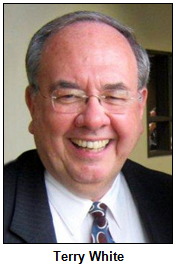 Although Billy Sunday grew up in Iowa and primarily was based in Chicago during most of his preaching years (he first achieved fame as a Chicago baseball player), he settled for part of each year in Winona Lake at a home he called Mount Hood. Built in 1911, the restored home is known today as the Billy Sunday Home Museum. Although Billy Sunday grew up in Iowa and primarily was based in Chicago during most of his preaching years (he first achieved fame as a Chicago baseball player), he settled for part of each year in Winona Lake at a home he called Mount Hood. Built in 1911, the restored home is known today as the Billy Sunday Home Museum.
The first Bible conference in the area started in 1895, according to Winona Lake at 100; it was begun by Presbyterians. Brethren Church groups also began having general conferences in the resort town in the 1890s. Subsequently, a corporation was formed to manage Winona Lake's summer Bible conference, which exploded in growth; it was overseen by a board that included household names such as politician William Jennings Bryan and wagon and auto-maker John Studebaker of South Bend. In 1944, Winona Lake also was the setting for the launch of Youth for Christ, an early employer of evangelist Billy Graham. (Historians now often describe Billy Sunday as "the Billy Graham of his era.") According to Winona Lake at 100, Biomet was founded in 1977 by four young entrepreneurs in the orthopedics industry and began pioneering technological advances early on; within three years, it achieved $1.1 million in net sales. The orthopedics industry now employs more than 6,800 workers in the region, accounting for nearly one in four jobs in Kosciusko County, according to a video on the OrthoWorx website. For several decades, many students at Grace College in Winona Lake have had internships in the orthopedics industry, according to the Star article. A four-year liberal arts and sciences college with a seminary for masters and doctoral study, Grace College is Brethren-affiliated and began in 1937.
According to Terry's book, Winona Lake in the 1960s and '70s was a far cry from its earlier heyday. The resort village, he writes, had "declined remarkably, with much of the summer seasonal housing now ramshackle and unsightly." That era of decline, though, was followed by a resurgence that Terry describes as a "metamorphosis." When he moved back to Winona Lake in 2003 after 26 years away, he discovered a "third wave" that included flourishing arts and culture. The town's historic street, Park Avenue, had become "lined with solid, quaint shops inhabited by artists, photographers, glass blowers, potters and woodworkers." History Mystery
When the tribe was forcibly removed from northern Indiana in 1838 by the forces of Gen. John Tipton, the Potawatomi were marched, single-file, down the city's Main Street. In what became known as the Trail of Death, the Potawatomi were led 900 miles to Kansas. The Trail of Courage Living History Festival in the "mystery" Indiana city includes Native American music and dance, canoe rides, crafts, historic re-enactments and pioneer food cooked over wood fires. Question: What city in northern Indiana hosts the festival? Roadtrip: Glory-June's northern adventureWe’re just going to go with public historian Glory-June Greiff's words here for a few notes about her Roadtrip this Saturday: "I always love a chance to go to the northern part of our state where the glaciers left behind lots of lakes and rolling terrain. Pokagon State Park in Steuben County is a good excuse. It offers all the activities you'd expect in a state park, but swimming in a real lake is a plus. All this and history, too: The park is listed in the National Register of Historic Places for its many examples of the work of the CCC (Civilian Conservation Corps).
"The area is lovely to explore, what with its lakes, small farms, and small towns. Orland is a very small village, about 10 miles west of Clay's on SR120, but boasts a fish hatchery constructed by the WPA (Works Progress Administration). It, too, is listed in the National Register If you're there on a Tuesday, Wednesday or Saturday, check out the Joyce Library in downtown Orland. It's charming, but ask to see the second floor, where the library first started. Many of us remember when most public libraries looked like this. "If you’re going up from central Indiana, it's a goodly drive, although you can make Pokagon in less than three hours on I-69. I'd recommend going at least part of the way on the old highways, however, and if you get hungry, stop for a bite at Pembroke Bakery in downtown Fort Wayne. "Don't let the fact that they offer healthy food deter you - it's really good! But if you’re not convinced, you can always go back in time to Powers Hamburgers at 1402 South Harrison, which was built around 1940. Don't confuse their hamburgers with a certain long-lived chain's sliders. These are meaty and loaded with onions grilled fresh. They also usually have a goodly supply of sweet rolls and doughnuts from the New Haven Bakery (or visit the bakery itself on the old Lincoln Highway! It's at 915 East Lincoln Highway. Enjoy!" 'Ask Nelson' and special-events-in-Indy insights
Along with our invitation to listeners to call the WICR-FM studio - the number is (317) 788-3314 - and pose questions to Nelson, we offer a bonus. In addition to questioning Nelson, who writes books about famous Hoosiers (both historic and contemporary notables) and Indianapolis city history, listeners of this show were able to ask questions of a special guest co-host. Nelson is joined in studio by special-events impresario Gary BraVard, who has planned scores of the most glittering soirees in Indy for more than 25 years. From private parties to weddings, bar mitzvahs and black-tie fund-raisers featuring visiting celebrities, Gary has been the planner of a staggering array of events in the Hoosier capital. Gary's credits include events attended by Liza Minnelli, Carol Channing and the late Ted Kennedy. Nelson's books include Indiana Legends: Famous Hoosiers from Johnny Appleseed to David Letterman (Hawthorne Publishing) and Indianapolis Then and Now (Thunder Bay Press), a visual history about his hometown.
By the way, Gary is no stranger to WICR - or to questions from Nelson. For several years, Gary was the co-host of our "sister" radio show on WICR-FM, Too Many Cooks!, which featured chefs, restaurant owners, dietitians, cookbook authors and foodies as studio guests. Recently, Gary has been featured on-air as one of the rotating Roadtripper correspondents on Hoosier History Live! Did you catch his report last month about Crown Hill Cemetery, the third-largest private burial ground in the nation? Crown Hill also is one of about 70 sites depicted in Indianapolis Then and Now, which involved a collaboration among Nelson, photo historian Joan Hostetler of Heritage Photo & Research Services and photographer Garry Chilluffo. Other sites in the book - which may provide fodder for listener questions - include Conseco Fieldhouse, now renamed Bankers Life Fieldhouse (do you know what was on the site 100 years ago of today's arena for the Indiana Pacers and Indiana Fever?), Broad Ripple, the Indianapolis Motor Speedway, Union Station, Lockerbie, Garfield Park and Massachusetts Avenue.
Nelson has researched the lives of Little Turtle, Madam Walker, Carole Lombard and popcorn king Orville Redenbacher, who was the focus of a recent Hoosier History Live! show. Fun fact: When Nelson was a feature writer/columnist for The Indianapolis Star and its bygone sister newspaper, The Indianapolis News, he interviewed Gary BraVard. Twice, in fact. Two years ago, Gary was shot on the Monon Trail during an attempted robbery. On a much lighter note, Gary also shares behind-the-scenes details of a posh event - the retirement party of an Indianapolis business leader - that went awry. (A teaser: The disaster involved wet paint.) Plus, Gary has a parade of anecdotes from Indy events that he planned with a guest list of visiting celebrities. In addition to the previously mentioned notables, including Carol Channing, attendees at his parties have included Lucie Arnaz, who was visiting the Hoosier capital for a theatrical performance. So, with their trove of anecdotes about Hoosier places, notables and special events, Nelson and Gary field an array of questions from callers, and from one another. Roadtrip: Indiana Dunes, town of Beverly Shores and South Shore Line
The town of Beverly Shores also has some interesting landmarks, including several "modern" homes that were relocated to the town after Chicago's 1933-34 Century of Progress World's Fair. Tune in Saturday for more! History MysterySeveral of the famous Hoosiers featured in Indiana Legends, the book by host Nelson Price, also have been guests on Hoosier History Live! They include a jazz musician and educator who is credited with pioneering the use of cellos in jazz music. A native of Indianapolis, he talked on our radio show about his teenage years at Attucks High School when, although under-age, he was able to slip into nightspots on Indiana Avenue during the area's post-World War II heyday as a jazz mecca. Later in life, the musician and educator primarily has been based in Bloomington. He has enjoyed the distinction of serving as the conductor of the first orchestra funded by the Smithsonian Institution. Question: Who is he? Longtime sponsor A fond farewell to marketing partner Aesop's Tables on Mass Ave.
Aesop's Tables will be open for its last day of business on Saturday, Aug. 24, after 20 years in business. It has sold the lease on its stellar location at 600 Massachusetts Ave. in downtown Indianapolis. The landmark independent restaurant will be offering specials on Saturday. Hoosier History Live has enjoyed a sponsorship trade with Aesop's for many years, which has made it possible for us to treat our fascinating Saturday show guests to lunch after the show, and also to be able to do a little business entertaining. Many loud and lively conversations over great food and drinks have taken place over the years at Aesop's. Thank you! Christ Church Cathedral, Zion and Second Pres in Indy
(Aug. 17, 2013) - Three historic congregations in the Hoosier capital - each with a heritage of more than 150 years and each celebrating a significant milestone - are the focus of this show. Located on a high-visibility site on Monument Circle, Christ Church Cathedral was built in the 1850s; the Gothic Revival building is considered the oldest religious structure in the city. Sometimes called "the Little Church on the Circle," Christ Church remained at the heart of downtown even as neighboring churches moved or closed. Christ Church is known for its support of the arts, annual Strawberry Festival and renowned choirs, which sang at the Indiana State Capitol when Abraham Lincoln lay in state during a stop on his funeral procession to Illinois. Rev. Stephen Carlsen, dean and rector at Christ Church Cathedral, join Nelson in studio. So does Rev. Jonathan Basile, senior pastor at Zion Evangelical United Church of Christ, which has a deep German heritage in Indy.
One of Indy's largest congregations also is celebrating its 175th anniversary. Second Presbyterian Church, which has been known for decades for the "movers and shakers" in its pews, was founded in 1838. Initially located on Monument Circle, followed by a building near the Indiana War Memorial, Second Pres has been at its current site at 7700 N. Meridian St. since the late 1950s.
Christ Church Cathedral also has been actively involved in civic affairs. Congregation members helped start public schools in the city during the 1800s and, more recently, have been involved with the Julian Center, the Damien Center and Second Helpings. After the 9/11 terrorist attacks, the cathedral was the setting for a citywide memorial service. Some history nuggets: Learn more: Zion's stained glass window renovation by Conrad Schmidt Associates. History MysteryAmong several Methodist congregations that founded churches in downtown Indianapolis during the 1800s, one has a special distinction in the city's public-safety history. During the 1870s, a new church elsewhere downtown was built for the Methodist congregation, which continues to worship in the building today. Like Christ Church Cathedral, the church building is on the National Register of Historic Places. Question: What is the Methodist church? Roadtrip: CCC legacy at McCormick's Creek State ParkRoadtripper Suzanne Stanis of Indiana Landmarks suggests we attend a daylong program coming up at McCormick's Creek State Park near Spencer, Ind., to explore the legacy of the Civilian Conversation Corps.
Says Suzanne: "It was a sustainable design program ahead of its time!" McCormick's Creek State Park, Indiana's first state park, offers several examples of CCC. From 1933 to 1935, Company 589 of the CCC constructed shelter houses, a gatehouse and magnificent stone-arch bridge still visible today. On Saturday, Aug. 24, Indiana Landmarks is offering a daylong Landmarks Experience exploring the CCC legacy at McCormick's Creek State Park, with tours and lectures by historians, landscape architects and naturalists. You can register online for Landmarks Experience. This event is co-sponsored by Indiana Landmarks, the Indiana Department of Natural Resources and Owen County Preservations. Ancient people here - and agricultural beginnings in Indiana
During this encore broadcast of one of the most popular shows in our archives (its original air date was Sept. 29, 2012), Nelson's guest is Dr. Christopher Schmidt, an archaeologist, biological anthropologist and director of the Indiana Prehistory Laboratory at the University of Indianapolis. In addition to sharing insights about the ancient people who lived in what became the Hoosier state, Chris also discusses the beginnings of agriculture here. He is credited with discovering the oldest known man-made tool in Hoosier soil, an awl (used for making clothes) found during a dig near the town of Flora in Carroll County. During the show, Chris, a popular U Indy faculty member who has overseen excavations across Indiana, shares details about the ancient Hoosiers of nearly 11,000 years ago, as well as information on the animal and plant life that surrounded them. After many centuries, the ancient people began to develop agriculture, a move that, according to Chris, also meant an increase in various diseases. He discusses the correlation, as well as the origin of maize in Indiana. Chris describes the ancient people as biological ancestors of Native Americans, although they differed culturally from the Native Americans who were living in the Eastern Woodlands when white settlers arrived. According to Chris, the first evidence that Eastern Woodlands people manipulated plants - the beginnings of agriculture - occurred about 3,000 years ago. The ancient people, who lived in structures similar to wigwams, initially cultivated four varieties of plants that, according to Chris, today might be dismissed as "weeds." Conclusions about the ancient people's diet and agricultural cultivations come from analyzing a variety of sources, including fossils found in Indiana. Referring to the early cultivation of maize - a term Chris says is generally synonymous with corn - he explains that the ancient people often selected floodplains as sites of their fields. Floodplains provided a way to irrigate their crops. "The actual corn they cultivated to eat was very similar, nearly identical, to the corn we eat today, except smaller," Chris says. Initially, though, the plant did not produce multiple seeds in cobs. In what Chris describes as a "huge achievement," ancient people selectively bred their maize to produce cobs filled with corn kernels. Switzerland County and living on the Ohio River
Not only does Hoosier History Live! explore the county's heritage, which includes Swiss immigration, an entrepreneur known as the "Hay King" and a popular wine festival, we also explore the impact of the Ohio River on towns and farms in the far-southeastern corner of the Hoosier state. For this journey in advance of the Vevay Switzerland County Bicentennial, Nelson is joined in-studio by three guests: Considered to be the home of the country's first commercial winery, Vevay hosts the annual Swiss Wine Festival. The four-day event, which will be Aug. 22-25, features a parade, riverboat cruises, music and a grape stomp.
The result was that later in the 1800s, when railroads trumped river traffic such as steamboats as the primary way to transport products and people, the region's economy declined. At the "Life on the Ohio" River History Museum, riverboat models and artifacts from the heyday of steamboats are displayed.
"The hay press was a three-story, animal-powered machine that, using a pulley and screw, pressed 300- to 400-pound bales," Martha explains. "The defining characteristic was the large wood 'driver' that dropped from heights of 20 feet or more into a hay-filled box, thus pressing the hay into large bales." Switzerland County resident Ulyyses P. Schenck, who became known as the "Hay King," had a fleet of eight steamboats and barges. Even before that, the ancestors of our guest Barry Brown had settled in the county. Both sides of his family, which included Scottish immigrants, as well as Swiss and French, arrived in the early 1800s. Vintage artifacts from various early settlers displayed at the Switzerland County Historical Museum include the first piano brought down river by flatboat to Indiana. Roadtrip: Hoosier Theater in Vevay, plus good eats
The 1974 TV movie A Girl Named Sooner was shot in Vevay, and Eric even ran a showing of the film at the Hoosier last year! Right next door to the Hoosier Theater is Roxano's Restaurant, a popular local eatery that specializes in pizza and Italian cuisine. Eric also reports that just up the State Road 156 is Shell's Ice Cream and Grill, which he says is open late and is great for someone who just finished watching a long movie and wants to take a shake home for the road. Eric also says Vevay has a very strong Main Street program, which we surely will hear more about from our show guests. History Mystery
Switzerland County is one of the state's smallest counties, but it's not the smallest. That distinction goes to another county in the far-southeastern corner of the Hoosier state; it borders Switzerland County. And it's the smallest county in Indiana, both in population and in area. Question: What is the county? The prize is a couple of tickets to the Switzerland County Historical Museum and the Life on the Ohio River History Museum in Vevay, Ind., courtesy of the Switzerland County Historical Society, and a gift certificate to Dick's Bodacious Bar-B-Q in downtown Indianapolis, courtesy of Visit Indy. Historic movie theaters, Act II
(July 27, 2013) - Consider this a sequel to a popular show last February that focused on historic Indiana movie theaters that now are in a range of conditions, from lavishly restored to long-deteriorating. To explore additional movie theaters with rich histories, as well as delve further into the digital-era challenges and various issues involved in programming classic or other Golden Age movies instead of contemporary films, Nelson is joined in studio by two guests. They are Indianapolis-based architect Jim Kienle, director of historic preservation at Moody Nolan, and film historian Eric Grayson, who owns a vast collection of rare movies and has preserved and restored many of them.
During our show, Nelson and his guests explore the Circle Theatre on Monument Circle in Indianapolis; it was built in 1916 as one of the largest silent-movie palaces west of New York. Despite its highly visible location in the heart of the Hoosier capital, the Circle had deteriorated alarmingly through the 1970s. Our guest Jim Kienle was a key figure in the 1980s renovation of what's now known as the Hilbert Circle Theatre, the concert hall of the Indianapolis Symphony Orchestra.
But what about the long-deteriorated Rivoli Theatre on the eastside of Indy? We provide an update on the once-lavish theater on East 10th Street that seated 1,500 when it opened in 1927. Its disturbing saga, which included a stint as an X-rated theater, followed by decades of sitting vacant, was spotlighted during our February show. Nelson and his guests also explore:
Initially known as the Emboyd Theatre, the ornate Embassy was built with nearly 3,100 seats, according to The Historic Fort Wayne Embassy Theatre (IU Press, 2009). Total seating capacity today is 2,470, including the balcony. Many historic movie houses are far smaller and have just one screen. Their fate is uncertain as the movie industry quickly eliminates film in favor of all-digital distribution, an issue Nelson and his guests discuss. Some history nuggets: Roadtrip: Harrison Memorial at Crown Hill Cemetery
With its elegant landscaping and beautifully curved roads, and as the final resting place for one U.S. president, three vice presidents, Hoosier poet James Whitcomb Riley and infamous bank robber John Dillinger, Crown Hill is a virtual treasure trove for history lovers. Gary spoke recently with Crown Hill President Keith Norwalk, who reported that President Benjamin Harrison Memorial (Indiana's only U.S. president) and gravesite at Crown Hill is getting a restoration, courtesy of a grant received through the Indianapolis Garden Club. A new walkway is being installed, with new steps and new landscaping. After the restoration is complete, visitors will be able to walk all the way around the memorial. The renovation will be complete by the time of the annual Wreath Laying Ceremony for the Harrison Memorial, to be held at Crown Hill on Saturday, Aug. 17, at 10:30 a.m. in celebration of President Harrison's 180th birthday. Benjamin Harrison was elected to the presidency in 1888 and served one term (1889-93). He was the nation's 23rd chief executive. The ceremony is free and open to the public. History MysteryAn extensively restored, historic movie theater reopened last April in an Indiana town that's a county seat. The theater, located on the town's courthouse square, opened on New Year's Eve in 1928 and drew crowds from surrounding communities for several decades. The landmark theater's restoration was spearheaded by Cook Group Inc., which is based in Bloomington - just one county away from the town where the theater is located. Cook Group, the medical supply manufacturer, also has a plant in the "mystery" town. Question: What is the town? Hint: The town and its theater on the courthouse square were discussed during a Hoosier History Live! show in February about vintage movie houses. The prize is four entries to the Indiana Experience at the Indiana Historical Society, two tours of the President Benjamin Harrison Presidential Site, and two public tours of Crown Hill Cemetery. These prizes are courtesy of Visit Indy. Roots-tracing tips and advice
Knowing that genealogy can be intimidating and overwhelming, Hoosier History Live! brings in some experts. They include an acclaimed Hoosier who not only is considered one of the top genealogists in the state, but among the best in the country as well. Curt Witcher is manager of the renowned genealogy center at the Allen County Public Library in Fort Wayne; it's generally regarded as the nation's best resource for roots-tracing, except perhaps for the Mormon-affiliated resources in Salt Lake City. Curt also is former president of the National Genealogical Society and a board member of the Indiana Genealogical Society. Founded in 1989, the Indiana Genealogical Society has more than 500,000 records on its website from all of the state's 92 counties.
Elsewhere in Indiana, a major opportunity will be available for listeners interested in roots-tracing. The Federation of Genealogical Societies will have a national conference Aug. 21-24 in Fort Wayne. During our show, Nelson and his guests explore roots-tracing aspects galore. They include tips on:
Her colleague at the historical society, our guest Kendra Clauser, specializes in interviewing and "collecting individual life stories" of people who have witnessed significant events in Indiana's recent past. This is an ideal show for listeners to call in at (317) 788-3314 and ask for advice in exploring family trees. Learn more: Roadtrip: Wabash, Ind.Guest Roadtripper and historian-at-large Glory- June Greiff recommends we head north from Indianapolis to visit the historic town of Wabash, which was founded in 1834 on a high bluff. Wabash lies above the river of the same name in the county of the same name and also was a port on the Wabash and Erie Canal. It was the first town in the world (!) to be illuminated by electricity, back in 1880. The lights were installed on the dome of the beautiful new courthouse, completed only the year before.
Wabash is filled with many wonderful historic houses, and Glory strongly suggests simply walking, especially north and west of downtown. A very nice house museum is the Dr. James Ford Historic Home. And the Honeywell House is a beautiful bed-and-breakfast that also hosts several arts and educational programs and events throughout the year. The Honeywell Center, an interesting building with Art Deco influences, is a community center and auditorium that offers top-notch entertainment throughout the year. And if you're hungry, don't miss lunch or dinner at the Charley Creek Inn, a beautifully restored 1920s hotel downtown. You may very well want to stay the night! History MysteryIn addition to being the site of the renowned Allen County Public Library and its genealogy center, Fort Wayne also hosts one of the largest annual festivals in northeastern Indiana. The festival is held every September to celebrate the life of an American folk hero.
He has been celebrated in literature as well as pop culture, including Walt Disney cartoons. Question: Who is the folk hero celebrated at the Fort Wayne festival? The prize is four entries to the Indiana Experience at the Indiana Historical Society, two tours of the President Benjamin Harrison Presidential Site, and a pair of tickets to the Track Tour at the Indianapolis Motor Speedway. These prizes are courtesy of Visit Indy. Swedish and Norwegian immigration
Now the turf will involve scenic homelands with fjords, the midnight sun, seafood and ship-builders. That's because Nelson and his guests explore Swedish and Norwegian immigration to Indiana, a topic that involves a legendary football coach at the University of Notre Dame, an organ factory in Chesterton, heritage groups scattered across the state and the Studebaker Brothers in South Bend, even though the wagon- and car-making brothers were of German ancestry themselves.
Full disclosure: Our host Nelson is particularly passionate about this topic because his ancestry is Norwegian. His maternal great-grandparents emigrated in steerage on ocean liners, separately, from Trondheim (Norway's third-largest city) and Bergen, a coastal town. Nelson's parents are members of the Circle City Lodge of Sons of Norway, a heritage group that also has lodges in Fort Wayne, South Bend and Chesterton.
To share insights about our state's Swedish heritage, Nelson welcomes an old friend and colleague, Vasa member Jim Lindgren, a Fishers resident whose ancestry is 100 percent Swedish. Now an editor for Strategic Marketing and Research Inc. in Carmel, Jim Lindgren is a former colleague of Nelson from their years at the Indianapolis News and The Indianapolis Star, where Jim was known for propping up a Swedish flag on his desk. Nelson and the two Jims also are joined by John Bevelhimer of Indianapolis, a retired IT specialist and past chairman of the local Vasa (Lodge Svea No. 253) who extensively researched its history for the recent centennial. According to Peopling Indiana (Indiana Historical Society Press, 1996), Swedes and Norwegians who eventually came to Indiana tended to settle first in Chicago, then filter into the Hoosier state as a result of a second move. The grandparents of both Nelson and Jim Lindgren lived in the Chicago area. In fact, Jim's great-grandfather, Nels Lindgren, owned a Swedish tavern in Chicago. The Andersonville neighborhood of the Windy City is historically Swedish.
In the 1880s, an organ factory in Chesterton became the town's main industry and employed many Swedes and Norwegians, according to Peopling Indiana. "Swedes were so dominant in Chesterton that in the 1880s the Chesterton Tribune occasionally ran front-page articles in the Swedish language," the book notes.
A section of Michigan City became known as "Swedeville," drawing Scandinavians seeking jobs in shipping and lumber. Peopling Indiana notes that by 1890, three counties in northwest Indiana - Lake, LaPorte and Porter counties - included more than half of the state's Swedish-born residents. Studebaker Brothers in South Bend actively recruited Swedish workers during the factory's heyday. Several of the mystery novels of contemporary author Jeanne Dams of South Bend focus on a resourceful Swedish immigrant working as a maid in one of the historic Studebaker mansions during the late 1800s.
Some other fun facts: "Learn more" websites include: Roadtrip: Zaharakos Ice Cream Parlor and art playground in Columbus, Ind.
Guest Roadtripper this week is one of Central Indiana's favorite foodies, Daina Chamness. She'll be reporting on a recent trip she took to Columbus, Ind., to check out the fabulous 1900 ice cream parlor Zaharakos in the 300 block of Washington Street there. Right across the street is "The Commons," which boasts an elaborate children's playground. Remember that the Columbus Visitors Center is in walking distance of these downtown attractions. History MysteryA well-known former political figure from Indiana is Norwegian-American on his mother's side. Her grandfather - the politician's great-grandfather - emigrated from Norway in the late 1800s. The Hoosier politician, who won a series of statewide elections over a 20-year period beginning in the 1980s, took a trip with his mother to their ancestral homeland of Norway, as well as to other Scandinavian countries. The mother-son journey unfolded in the summer of 1978, following the son's graduation from Indiana University.
Question: Name the former Indiana politician who is of Norwegian heritage in his maternal line. Hint: His father, who is still living, also had a long political career and won statewide elections over a period of 20 years. The prize is a pair of tickets to the Indianapolis International Film Festival and a gift certificate to Dick's Bodacious Bar-B-Q. These prizes are courtesy of Visit Indy. Orville Redenbacher and popcorn heritage in Indiana(July 6, 2013) - Chew on this: Not only is "Year of Popcorn" the theme at next month's Indiana State Fair, but the farmboy-turned-entrepreneur who became internationally known as "the Popcorn King" was a Hoosier. A farm agent who grew up near Brazil, Ind., Redenbacher studied at Purdue University and experimented for more 40 years with 3,000 hybrids of popcorn. He's credited with making the first significant changes in the treat since Native Americans introduced it to white settlers in the 1600s. His adopted hometown of Valparaiso, where Redenbacher lived for many years, continues to host an annual Popcorn Festival in his honor. The event, which includes a popcorn parade, typically is attended by 75,000 people. Another Hoosier town - Van Buren in Grant County - also hosts an annual Popcorn Festival that features a parade. Because so much popcorn is produced from the farms surrounding Van Buren (pop.: 864 in the 2010 U.S. Census), the town bills itself as "the popcorn capital of the world." According to the State Fair, Indiana is one of the country's top popcorn-producing states. So not only do we explore the colorful life of Orville Redenbacher, the "king of kernels," Nelson and his guests also delve into the product's historic importance to the Hoosier state's economy and heritage.
To digest all of this popcorn talk, Nelson is joined by Purdue staff writer and historian John Norberg, who interviewed Redenbacher and also was a colleague of the late Robert Topping, author of the definitive biography Just Call Me Orville (Purdue University Press, 2011).
Fun fact: When Nelson was researching Orville Redenbacher's life for his book Indiana Legends, he discovered the popcorn king always preferred his "salted, no butter." At Brazil High School, Redenbacher captured state championships in 4-H club contests. He paid for his tuition at Purdue (which, as he put it, soon was "on the cutting edge of popcorn research") by scrubbing hog houses and tending chickens. Redenbacher became an agricultural agent in Vigo County, where he apparently was the first county agent in Indiana to broadcast live on radio from fields.
According to Just Call Me Orville, Redenbacher was named in honor of Orville Wright of the famous Wright Brothers aviators. (Orville Wright's brother Wilbur was born in far-eastern Indiana.) At age 12, Orville Redenbacher began raising popcorn and selling it in 50-pound sacks to stores in Brazil and Terre Haute. In addition to studying agriculture as a Purdue student, he played the sousaphone in Purdue's renowned All-American Marching Band. The decades he devoted to experimenting with hybrids are credited with producing a variety that popped significantly larger, lighter and fluffier. It became a marketing sensation as Orville Redenbacher's Gourmet Popping Corn and eventually was sold to California-based Hunt Wesson Foods, which continued to use Redenbacher as the brand's spokesman. (It eventually was swallowed up by ConAgra, the giant food conglomerate based in Omaha.) At the State Fair, which will run from Aug. 2-18, the world's largest popcorn ball - weighing 5,200 pounds - will be on display. Other aspects of the "Year of Popcorn" celebration at the fair will include a twist on a traditional corn maze: a popcorn maze that fair-goers can maneuver through. Final fun fact: According to Just Call Me Orville, the "Popcorn King," who became a hit on the speaking circuit, occasionally would introduce his talk by saying, "My topic tonight is sex." After his audience reacted with astonishment, he would share insights about "the sex life of a popcorn plant and the breeding methods required to obtain hybrids." Learn more: Roadtrip: Oldenburg, the village of spires
William tells us that "Oldenburg is one of many towns and villages across Indiana, especially Southern Indiana, founded by and for German immigrants before the Civil War. What makes Oldenburg stand out is its townscape of spired buildings, most of which are part of the complex of the Motherhouse of the Sisters of St. Francis." Oldenburg was founded in 1837 by two immigrants from the Grand Duchy of Oldenburg at the request of the Catholic priest, Fr. Joseph Ferneding, also an Oldenburger. A later priest, Fr. Franz Josef Rudolf from Alsace, had the vision of spires as he built the c. 1848 onion-domed stone church, the current brick 1860s parish church, and the first convent buildings. This energetic priest also co-founded the convent and invited Beatus Gehring to establish his brick yard south of the village. He is honored with a crypt tomb in the parish church. Oldenburg's annual Freudenfest is this July 19-20. History Mystery
Billing itself as the state's oldest drive-in, the restaurant has a memorable name. Known for burgers, shakes and root beer, it serves menu items such as Boilermaker burgers and peanut butter burgers. The restaurant opened in 1929, one year after young Orville Redenbacher graduated from Purdue. Question: Name the landmark restaurant in West Lafayette. The prize is a pair of tickets to the Children's Museum, courtesy of Visit Indy, and tickets to the Indiana State Fair, courtesy of the Indiana State Fair. Underground Railroad reality and myths in Indiana
Exaggerations and misconceptions abound regarding the movement before and during the Civil War to help escaped slaves, according to experts. To share insights about the myths and reality regarding the extent and nature of the Underground Railroad network in Indiana - including what is and isn't confirmed - Nelson is joined in studio by two experts. They are historic researcher and genealogist Dona Stokes-Lucas of Indianapolis and Kisha Tandy, assistant curator of social history at the Indiana State Museum. A board member of Indiana Freedom Trails Inc., a nonprofit established to pull together, verify and preserve information about Underground Railroad history in the Hoosier state, Dona has been a popular guest on Hoosier History Live!, as has Kisha.
Oral histories, diaries, notations in family Bibles and letters have been crucial in figuring out the routes, buildings and people associated with the effort to help runaway slaves - or freedom seekers - as they passed through Indiana. How, though, do you document something that obviously was kept secret? In addition to tackling that issue - Nelson asks Dona and Kisha how people can determine the reliability of diary entries or letters - we also explore which regions of the state had frequent stops on the Underground Railroad. And which ones had very few. Learn more: Clickable map showing Underground Railroad sites in Indiana. According to several accounts, St. Joseph County, which includes South Bend, served an integral role with fugitive slaves as they headed north. And because of the prevalence of anti-slavery Quakers in Wayne County and other parts of far-eastern Indiana, that region also had a flurry of clandestine activity. During our show, we also will discuss the frequency with which so-called slave catchers from the South - often mercenaries - combed Indiana in search of freedom seekers.
Also during the show, Dona and Kisha share insights about on-going efforts to preserve the Underground Railroad heritage across the state.
Learn more: Click on these Hoosier History Live! show newsletters (2008 through 2013) with African-American history themes from our trove of 250 shows: Roadtrip: Underground Railroad in Jeffersonville
Hannah Toliver was a free black woman living in Jeffersonville before the Civil War and was an Underground Railroad activist. She was was arrested for aiding a fugitive slave from Kentucky, and she served time in the Kentucky Penitentiary in Frankfort before being released and returned to Jeffersonville. Her historical marker is on Riverside Drive in Jeffersonville. Maxine Brown, who also known for having restored the Leora Brown Colored School in Corydon, will suggest Underground Railroad spots to visit in "her" part of the state. History MysteryIn a small town near Richmond during the 1840s, a Quaker couple helped so many escaped slaves in their journeys to freedom that their home became known as the "Grand Central Station" of the Underground Railroad.
Feeling passionately that slavery was wrong, the couple convinced other Quakers in their town to join their crusade. A prosperous banker, mill owner and merchant, he prevailed on townspeople to help transport and conceal escaped slaves. She persuaded her friends to gather at her spinning wheel and help weave blankets and clothes for the refugees. Today, their home is a popular destination for school field trips. Question: Name the Quaker couple. Please provide their surname and both of their first names. The prize is a pair of tickets to the Benjamin Harrison Presidential Site, four admissions to the Indiana Experience at the Indiana History Center, and a gift certificate for Greatimes Family Fun Park on Indy’s southside. These prizes are courtesy of Visit Indy. Centennial in 1916, bicentennial in 2016
In one sense, the 1916 centennial hoopla will be hard to top: It's credited with sparking the process to create Indiana's first state parks. To share insights about the 100- and 200-year celebrations, Nelson is joined in studio by Indiana's widely admired and award-winning historian, James Madison, a professor emeritus of history at Indiana University and the author of several books about various aspects of the state's history, and by Chris Jensen, executive director of the Indiana Bicentennial Commission.
President Woodrow Wilson spoke at the Indiana State Fairgrounds Coliseum. A weeklong pageant (called the Pageant of Indiana) was held at Riverside Park in Indianapolis. And high school students across the state donned American Indian outfits and feathers. Enthusiasm generated during the centennial eventually resulted in the purchase of Indiana's first two state parks, Turkey Run in Parke County and McCormick's Creek in Owen County. Civic leader Richard Lieber, who chaired the centennial's park committee, served as a "tireless advocate" of the purchases, as Traces put it. For the 200th celebration, our guest Jim Madison is one of 15 distinguished Hoosiers who have been appointed to the bicentennial commission, which is overseeing the planning and execution of statewide events. Jim Madison is the author of several books about various aspects of Indiana history, including The Indiana Way: A State History, A Lynching in the Heartland and Eli Lilly: A Life. He also is a trustee of the Indiana Historical Society and a board member of Indiana Humanities. According to information from our guest Chris Jensen, the goal of the 2016 celebration is to "honor our state's 200 years of history, but to do so in a modern way that engages all Hoosiers and leaves a lasting legacy for future generations." Plans are being developed for a Bicentennial torch relay that will run through all of the state's 92 counties. The relay will highlight passing the torch from one generation to the next. The bicentennial commission also hopes to spark "legacy projects" across the state. Specifically, the commission wants to work with communities to identify local projects that are dedicated to the bicentennial, but that also will have a lasting impact. Under a Bicentennial Nature Trust dedicated to nature conservation, 35 projects in 28 counties already have received $8.1 million in grants, according to Chris Jensen. The trust is funded by money from the state and the Lilly Endowment. In addition to the state park system that was kicked off in 1916, the centennial also spurred the formation of groups such as the Society of Indiana Pioneers, a nonprofit dedicated to preserving and honoring the work of the state's pioneers. "Local historical societies were forming or reactivating across Indiana," Traces reported, referring to the impact of the 1916 centennial. But the hoopla took awhile to ignite. According to a booklet published after the 1916 festivities, an initial challenge involved galvanizing Hoosiers about the state’s 100th anniversary. "The people of Indiana as a whole knew little and therefore cared little about the centennial anniversary. ... There was the usual amount of inertia to overcome." According to an Indianapolis Star account about the Pageant of Indiana in Riverside Park, its huge cast "nearly matched the number of onlookers," but it was nevertheless a "hit." The pageant, which reviewed the state's history, opened every afternoon for six days and continued after sunset, with electric torches providing the illumination. Re-enactors - who included adults, as well as 1,500 high school students and children - portrayed French soldiers, Native American warriors, Quaker farm wives and famous Hoosiers such as Gen. Lew Wallace, author of Ben-Hur. Roadtrip: Danville's Courthouse Square
Crowning the square is the historic Royal Theater, which one of Indiana's only movie theaters in the Tudor style. The facility has been lovingly maintained and run by the Shearer family for the past several years. Next door to the Royal is an outstanding Italian restaurant, Frank's Place, run by a real Italian. It's in a historic building, but the inside is all-new, and the smells are great. Around the corner, of course, is the legendary Mayberry Cafe, a takeoff on television's classic Andy Griffith Show. The Mayberry Cafe has a 1963 police squad car parked in front, so you can't miss it! History MysteryOne of Indiana's first counties to be organized already is celebrating its bicentennial this year. Located in far-southwestern Indiana, the county was organized in 1813.
Another town in the county is known for its historic Main Street and scenic "river village" ambience; the town is nestled on the Ohio River. Some of the county is considered to be part of the metro area of Evansville, which is located in another bordering county, Vanderburgh County. Question: Name the far-southwestern county celebrating its 200th birthday this year. Hint: It often is listed among the 10 fastest-growing counties in the state. The prize is a pair of tickets to the James Whitcomb Riley Museum Home and four admissions to the Indiana Experience at the Indiana History Center. These prizes are courtesy of Visit Indy. Indy Mayor Greg Ballard on Marines history and 'old' Cathedral High
So there's much local history to cover with Mayor Greg Ballard of Indianapolis, 58, who was elected to his second term in 2011. As Hoosier History Live! segues from a former mayor of Indy (Bill Hudnut, the June 8 show guest) to his current counterpart, Mayor Ballard is Nelson's studio guest for a show that explores history topics that have been intertwined with his life. They include the links between the Hoosier state and the Marines. After a 23-year military career, Mayor Ballard, a Republican, retired as a lieutenant colonel from the Marines in 2001 and returned to his home town to enter private business. He shares insights about who and what influenced him during his youth to join the U.S. Marine Corps. The decision eventually led to assignments in places such as Okinawa, Japan; Saudi Arabia during the first Persian Gulf War; and Stuttgart, Germany, as well as in Michigan, North Carolina and California, where he met his wife, Winnie Ballard, a native of the Philippines. During the first Gulf War, the future mayor was promoted to major. Other links between the Marines and the Hoosier state: Back in the mayor's hometown, we also will focus on Cathedral High School, where he was a member of the Class of '72.
In 1976, four years after he graduated, Cathedral merged with Ladywood, an all-girls Catholic academy located on the northeast-side, a decision that was presented as a financial necessity for both schools. The merged, co-ed school, which took the Cathedral name, is on the former Ladywood site on East 56th Street. Previously, while the future mayor was attending Cathedral, Ladywood had merged in 1971 with Cathedral's "sister" school downtown, St. Agnes Academy. Located just to the south of the "old" Cathedral, the former academy now is the site of St. Agnes Apartments. Greg Ballard, who grew up on the Eastside in a family of five children, attended Cathedral on a scholarship. In addition to graduating from IU, he obtained a master's in military science from Marine Corps University in Quantico, Va. His defeat of incumbent Bart Peterson in the 2007 mayoral election has been called one of the biggest upsets in Indy's political history. Roadtrip: Monument Circle for kids
Kelly's daughter, age 10, had studied President Lincoln in school this year and was fascinated to learn that the church bells had rung out as Lincoln's body lay in state at the nearly Capitol. Kelly and crew then crossed the street, headed up the 330 steps (yes, walked!) to the observation level of the Soldiers and Sailors Monument for a great view of the city, and they visited the Civil War Museum in the lower level. They topped off their Roadtrip with ice cream from the Chocolate Cafe, and then a quick trip back in time for Kelly at Rocket Fizz, a candy shop with nearly every type of novelty candy. Both of these sweet spots are right on the Circle. History MysteryMore than 25 years before future Mayor Greg Ballard became a Marine, another well-known Indianapolis political figure served in the Marines. The future politician was born in Indy in 1932. He graduated from Shortridge High School in 1949, then served in the Marines. After that, he enrolled in Indiana University. In addition to a long political career - he held public office almost without interruption from 1964 until retiring in 1997 - he worked as a deputy sheriff in Marion County, a lawyer, an author and a college instructor. Question: Who was he? The prize is a pair of tickets to the President Benjamin Harrison Presidential Site and four admissions to the Indiana Experience at the Indiana History Center. These prizes are courtesy of Visit Indy. Former Indy Mayor Bill Hudnut
For 16 eventful years - a span of four terms that included unforgettable chapters, many of which have been the focus of previous Hoosier History Live! shows (such as the notorious Although former Mayor Hudnut and his wife, Beverly Hudnut, primarily have lived in the Washington D.C. area since he left the top Indy office in 1992, he makes a return visit and - for our 250th show - joins Nelson in studio to explore what has become known as "the Hudnut era." He didn't start out as a Hoosier. Born in Cincinnati in 1932, Bill Hudnut grew up in New Lebanon, N.Y., graduated from Princeton University and, like his father and grandfather, became a Presbyterian minister. He moved to Indy in 1963 to serve as pastor of Second Presbyterian Church, one of the city's most prestigious congregations. By the time he left Indy, the city's skyline had been transformed - by, among other structures, the domed stadium that initially was known as the Hoosier Dome when it opened in 1984. Mayor Hudnut, a Republican, championed the sports facility's construction, even though the city did not yet have a National Football League team to play in it. The history of what later was named the RCA Dome was the focus of our third Hoosier History Live! Show after our debut in early 2008, shortly before the stadium's demolition. That program followed a show about the 30th anniversary of the Blizzard of '78, the worst in city history, during which the lanky, 6-foot-4 mayor rode on snowplows and urged residents to persevere. An unabashed cheerleader known for his willingness to do just about anything to rally his adopted hometown - including donning a leprechaun outfit on St. Patrick's Day - Bill Hudnut particularly advocated the resurgence of downtown and Indy's unofficial designation as the country's amateur sports capital. During his terms as mayor (1976-92), he also served as president of the National League of Cities. Nelson asks the former mayor to identify his greatest accomplishments, as well as his biggest disappointments. A recent article in the Indianapolis Star about the 25th anniversary of the concert venue initially known as Deer Creek Music Center (now Klipsch Music Center) indicated then-Mayor Hudnut unsuccessfully pushed for it to be built in what became White River State Park, rather than its eventual site in Hamilton County. "What would you do if you were called to lead a city known as Naptown, India-No-Place or Brickyard in a Cornfield?" Bill Hudnut asks in his book The Hudnut Years (IU Press, 1995). His other books include Minister Mayor (Westminster Press, 1987).
Before his record-breaking mayoral terms, Bill Hudnut served as a U.S. congressman from Indianapolis. In 1972, he defeated his friend, incumbent U.S. Rep. Andy Jacobs Jr. - who, in turn, came back and defeated Hudnut two years later. During the mid-1970s, in between his stints in public office, Bill Hudnut was on the faculty at the University of Indianapolis (then Indiana Central University), where he taught political science. As mayor, he oversaw highly touted partnerships between the public and private sectors. In 1990, the Indianapolis News estimated that with "gifts from the Lilly Endowment, millions of dollars in tax abatements and other incentives, and investments from private developers, more than $4 billion worth of construction took place downtown. ... Public and private city leaders placed an unprecedented emphasis on downtown development."
Roadtrip: Whitewater Canal State Historic SiteGuest Roadtripper Christopher Della Rocco will call in on Saturday to tell us about current activities at Whitewater Canal State Historic Site, located in the charming 1836 canal village of Metamora, Ind., which is southeast of Indianapolis in the Whitewater Valley in Franklin County. The site offers a new Whitewater Canal Experience package that allows visitors to experience the best of the site at a discounted rate. And coming up June 29 is a special event called Twilight Time, which features an island-themed catered dinner in Grist Mill Park and twilight cruise on the Ben Franklin III canal boat. Slow and relaxing are the characteristics of this boat ride! The Whitewater Canal State Historic Site is open for tours of the grist mill and canal boat rides Wednesdays through Sundays. Canal rides are at noon, 1, 2, 3 and 4 p.m. - dependent on canal conditions - the same days. More information can be found online or at (765) 647-6512. Enjoy your summer!
History MysteryOne of the best-known men in America from the 1860s through the 1880s had, earlier in his career, served as the minister of Second Presbyterian Church in Indianapolis. A clergyman, abolitionist, social reformer and speaker, he was not a Hoosier by birth or upbringing.
Before coming to Indianapolis, he had been the pastor at a Presbyterian church in Lawrenceburg, Ind., for two years. The clergyman left Indiana in 1847 and rose to national prominence on the East Coast. Question: Who was he? Hint: His sister wrote one of the country's best-selling novels during the 1850s. The prize is a pair of tickets to the Eiteljorg Museum and four admissions to the Indiana Experience at the Indiana History Center. These prizes are courtesy of Visit Indy. Lost cemeteries
To explore lost or "nearly lost" cemeteries across the state - and issues associated with the forgotten or neglected burial grounds - Nelson is joined in studio by Jeannie Regan-Dinius, cemetery and burial ground registry coordinator for the Indiana Department of Natural Resources, and pioneer cemetery advocate Theresa Berghoff, an Elwood native who now lives in Indianapolis. They share details about lost graveyards everywhere from Berne in Adams County and the Madison County community of Leisure, to a site near Kessler Boulevard and Keystone Avenue on the north side of Indy, and Rome in southwestern Indiana.
In 2008, our guest Jeannie Regan-Dinius helped oversee the move of 33 tombstone and remains of Hoosier pioneers from a mid-1800s cemetery in the Castleton area of Indy to Crown Hill. Shortly after that reburial - which was initiated to allow for the widening of I-69 near its interchange with I-465 - Jeannie joined Nelson for a Hoosier History Live! show during our first year on the air.
In Richmond, Maple Grove Cemetery, which apparently had been the site of more than 500 graves, was closed during the late 1800s. The cemetery's land then became part of Glen Miller Park. Many of Richmond's first settlers were buried in Maple Grove Cemetery. According to Theresa's research, the first burial ground for white settlers in what became Indianapolis was known as the Plague Cemetery. Established about 1820, the cemetery was the burial site for victims of a malaria epidemic that swept the newly developing state capital, which was partially built on swampland and marshes. According to Jeannie's research, the lost graveyard in Berne was a Mennonite cemetery. She has copies of notices published in local newspapers in 1908 urging relatives to arrange for reburials of their ancestors to allow for road improvements. During our show, Jeannie shares insights about the protocol that farmers and other property owners should follow if they discover human bones. Nelson and his guests also explore vandalism of cemeteries, as well as the various reasons some graveyards have become lost or forgotten. Some "learn more" websites: Roadtrip: Summer nights on the canal
On Thursday evenings this summer through Aug. 8, the IHS will host some of the area's best performers. Concerts take place from 6 to 8 p.m., with the exception of the annual Independence Day Bash on July 4 (5 p.m. start), and free seating is available on the grassy slope across the canal. For June and July concert dates, IHS's Museum Nights on the Canal will offer free Indiana Experience admission, as well as hands-on activities and extra entertainment, from 4 to 8 p.m. The Eugene and Marilyn Glick Indiana History Center, home of the IHS, is located at 450 W. Ohio St. in downtown Indianapolis, along the picturesque, historic Central Canal. History Mystery
Because the area is known as the "Limestone Capital of the World," generations of highly skilled stone cutters were available to carve sculptures memorializing the deceased. For example, the cemetery, which is on scenic, rolling terrain, includes sculptures of a golfer, a World War I doughboy and the tools of a limestone cutter on various burial sites. Question: Name the historic cemetery near Bedford. The prize is a pair of tickets to the Indiana State Museum and four admissions to the Indiana Experience at the Indiana History Center. These prizes are courtesy of Visit Indy. Historic baseball stadium into apartments
Now the West 16th Street stadium - which had been deteriorating dramatically since the minor-league team left and began playing home games at Victory Field in July 1996 - will be converted into apartments by John Watson of Core Redevelopment LLC. The Stadium Lofts project - featuring 138 apartments set to open Aug. 1 - has attracted such extensive national interest that the National Baseball Hall of Fame and Museum in Cooperstown, N.Y., has contacted John for a mini-exhibit about the stadium re-use.
In addition to the 138 apartments in the $14 million Stadium Lofts conversion project, John Watson plans to build 144 other apartments - to be known as Stadium Flats - just west of the historic ballpark. He also plans to build an office complex in centerfield of the historic stadium. According to a recent article in the Indianapolis Business Journal, the Stadium Lofts design "retains the outer shell of the Art Deco building and includes the look of an actual baseball field in the courtyard" for residents of the apartments.
Bush Stadium also served as the venue for the baseball tournaments during the Pan American Games hosted by Indy in 1987. However, after the Indians, a Triple-A team in baseball's minor leagues, moved to the newly built Victory Field in White River State Park, an attempt fizzled to make Bush the venue for midget auto racing. (A dirt racetrack had been installed.) A long, slow slide downhill followed.
A front-page article in The Indianapolis Star in 2008 was headlined "Decaying diamond." Describing the vacant stadium as an "eyesore," the article noted that the concourse and former clubhouse for the Indians were "littered with trash, abandoned equipment and animal droppings." It described collapsed sections of stadium walls, holes in the grandstand roof and cracks in the steel columns and beams. Even before the Indians moved to Victory Field, the stadium's deteriorating condition had been a major concern. In 1993, the governing body of minor league baseball announced the team would be moved from the city unless Bush Stadium was improved. Instead, the new Victory Field was constructed.
In the 1980s and '90s, our guest John Watson, in partnership with developer Carl Van Rooy, redeveloped several historic buildings in downtown Indy into condos or apartments. They included the Real Silk Factory, which opened in the 1920s and manufactured women's silk hose, then parachutes during World War II. John also oversaw the conversion of The Continental at Vermont Place, 410 N. Meridian St., into contemporary apartments. According to the IBJ article, John is paying "homage" to Bush Stadium's heritage in the apartment development's courtyard by featuring in its design a "permanent baseball diamond made with dirt-colored concrete." He also plans to restore the old scoreboard in right field, which has taken a beating from scores of winters and thunderstorms. In June 2011, city leaders announced a plan to make the area near Bush Stadium into a magnet for life sciences and high-tech businesses. The area would be known as 16 Tech. Roadtrip: Chesterfield Spiritualist Camp near AndersonSuzanne Stanis, director of heritage education and information at Indiana Landmarks, suggests a Roadtrip to historic Camp Chesterfield near Anderson, founded in 1886 and operated by the Indiana Association of Spiritualists.
Spiritualism is a religion based on the belief that the spirits of the dead continue to evolve and can communicate with the living. From the 1840s through the 1920s, Spiritualism attracted a wide following, particularly among the educated elite, many of whom were also devout believers in various Protestant faiths. Camp Chesterfield welcomes visitors to explore the Trail of Religion, a river rock grotto, and the "Toadstools," a meadow of concrete chairs and mini-pedestal tables where mediums held readings in the old days. The Hett Art Gallery and Museum presents a collection of psychic art, spirit photography and precipitated portraits (paintings of the deceased facilitated by mediums). The camp has a welcome center, and you can even spend the night in the 1940s Western Hotel for a very modest rate.
History Mystery
The Negro League team, which had a catchy name featuring three letters of the alphabet, was a fan favorite in the 1910s and '20s. Question: Name the baseball team. The prize is a gift certificate to California Pizza Kitchen in Circle Centre Mall and a pair of tickets to the Indiana State Museum. These prizes are courtesy of Visit Indy. Hollywood icons Red Skelton, Robert Wise and Irene Dunne
All three are the subjects of biographies written by movie historian Wes Gehring, a film professor at Ball State University who joins Nelson in studio for one of the most popular shows in our Hoosier History Live! archives. (Its original air date was Oct. 6, 2012.) Wes' most recent book is Robert Wise Shadowlands (Indiana Historical Society Press), a biography of the Academy Award-winning director who was born in Winchester and grew up in Connersville.
Wes delved into their lives in Red Skelton: The Mask Behind the Mask (IHS Press, 2008), which explores, as Wes puts it, the comedian's "hardscrabble beginnings with a shockingly dysfunctional family in southern Indiana" and Irene Dunne: First Lady of Hollywood (Scarecrow Press, 2003). It's a look at the versatile actress, who won critical acclaim for her roles in genres ranging from musicals like Show Boat (1936) to comedies (including The Awful Truth in 1937 with Cary Grant) and dramas such as I Remember Mama (1948).
Like Irene Dunne, Robert Wise was known for astonishing versatility. He directed movies ranging from the science fiction cult classic The Day the Earth Stood Still (1951) and the horror movie The Haunting (1963), which is set in a spooky New England mansion to the two musicals for which Wise won Oscars as Best Director, The Sound of Music (1965) and West Side Story (1961). At Connersville High School, the auditorium has been renamed in Wise's honor. In his biography of the filmmaker, Wes quotes from columns (titled "Wise Crax") he wrote for the high school newspaper. Phil Gulley on Indiana festivals, summer jobs and other things Hoosier(May 11, 2013) - As a teenager, Phil Gulley may have had the worst summer job in Indiana history. The popular Hoosier storyteller, humorist and Quaker pastor based in Danville once shared details with Nelson about the distasteful job of his youth.
Known for his folksy style, Phil is a popular speaker and a columnist for Indianapolis Monthly magazine. He also has written non-fiction books such as I Love You Miss Huddleston and Other Inappropriate Longings of My Indiana Childhood (2009). Because Phil has spoken and written about the propensity of Indiana towns to throw festivals and fairs in honor of just about every product or crop - ranging from persimmons and pork to popcorn - Nelson asks about that topic as well. They also explore the importance of porches. "I believe all that is wrong with our world can be attributed to the shortage of front porches and the talks we had on them," Phil writes in Porch Talk (2007), a collection of stories that won praise from the likes of Charles Osgood, host of CBS Sunday Morning. "Somewhere around 1950, builders left off the front porch to save money, and we've had nothing but problems ever since."
In addition to his books of vignettes about the quirky characters and life lessons associated with small towns, Phil, a graduate of Christian Theological Seminary, has written several books focused on theology. They include If the Church Were Christian (2010) and The Evolution of Faith: How God is Creating a Better Christianity (2011). He is pastor of Fairfield Friends Meeting in the town of Camby, which is just southwest of Indianapolis. The protagonist in Home to Harmony and the other books in the Harmony series also is a Quaker pastor. Phil, 52, who grew up in a Catholic family, once told Nelson he had a one-word explanation for why he became a Quaker as a teenager: "Girls."
"So I showed up for the wrong reasons," Phil told Nelson. "But you know something? When I started studying Quaker beliefs - the emphasis on simplicity, pacifism and the tolerance for diverse people - they resonated with me." In Home Town Tales, he wrote: "When I was young and unattached, the women in my Quaker meeting paid me considerable attention. But then Quaker women tend to take an inordinate interest in people who need help. And I needed help. I was six feet tall and weighed 110 pounds." Phil's career as an author was launched when, while in seminary in the 1990s, he was serving as the pastor of Irvington Friends Meeting in Indianapolis. His musings for the church's newsletter came to the attention of Paul Harvey Jr., the son of the late, legendary broadcaster. The Harveys showed Phil's tales to a national publisher - and book contracts followed. Like his columns for Indianapolis Monthly, Phil's vignettes in Home Town Tales explore such topics as the arrival of a new Walmart and include wry humor, self-disclosure and insights about human nature. The inclination of Indiana towns to celebrate a product or crop as an excuse for a summer festival has been the focus of one of his popular essays. Roadtrip: Ferdinand in Dubois County
Ferdinand has real curb appeal, as you can see its main attraction for miles. It's a massive complex atop a hill, the monastery of the Sisters of St. Benedict, first established in 1867. The town was founded in 1840 by missionary priest, Father Kundek. He named it for Kaiser Ferdinand von Habsburg of the Austrian Empire. Learn more on the show this Saturday! History MysteryIn addition to Phil Gulley, well-known authors from Indiana who have been guests on Hoosier History Live! include James Alexander Thom, whose books of historical fiction have become national bestsellers. Question: What Native American tribe reflects Dark Rain Thom's heritage? We will also note that there is an 80th birthday party for James Alexander Thom, as well as for Dark Rain Thom, as part of First Friday at the Vonnegut Library at 340 N. Senate Ave. in Indianapolis on June 7 from 6 to 9 p.m. All are welcome. The prize is four admissions to the Indiana Experience and two admissions to the Indianapolis Motor Speedway Hall of Fame Museum, courtesy of Visit Indy. 'Ask Nelson' and more county name origins
He used to dodge that question but 'fessed up that it's Jane Pauley. Nelson grew up about two blocks from the future TV newswoman on the far eastside of Indianapolis. Following in her wake, he attended every school that she did, from Moorhead Elementary School through Warren Central High School and Indiana University.) To give our listeners another opportunity to question Nelson, who calls himself a "garbage can of useless Hoosier trivia," Hoosier History Live! occasionally opens the phone lines. Listeners are invited to call the WICR-FM studio - the number is (317) 788-3314 - and ask questions of Nelson, who writes books about famous Hoosiers (both historic and contemporary figures) and Indianapolis city history. As a bonus, Nelson is joined in studio by our attorney friend and WICR colleague Charles Braun, founder and host of Legally Speaking, the longest-running legal advice show on American radio. Charles, a fellow Hoosier history lover, has extensively researched the origins of county names in Indiana. In September 2010, he joined Nelson for a show about this intriguing topic, but they only scratched the surface of our 92 counties then. (Listeners learned that Marion County is named in honor of Francis Marion, a Revolutionary War hero. Allen County, which includes Charles' hometown of Fort Wayne, derives its name from John Allen, an early American politician, attorney and military leader who was killed in the War of 1812.)
After he signs off the air - and just before Hoosier History Live! signs on - Charles and Nelson typically can be found near the studio chatting about history-related topics. Nelson loves to share anecdotes and insights, particularly those derived from his expertise. His books include Indiana Legends: Famous Hoosiers from Johnny Appleseed to David Letterman (Hawthorne Publishing) and Indianapolis Then and Now (Thunder Bay Press), a visual history about the Hoosier capital. Listeners are encouraged to phone in with questions about famous Hoosiers, including historic figures that Nelson has researched, such as Madam Walker or contemporary notables he has interviewed, including former Indiana Pacers superstar Reggie Miller, astronaut David Wolf and artist Nancy Noel of Zionsville. Several of the famous Hoosiers featured in Indiana Legends have been Nelson's guests on Hoosier History Live!, including Hoosiers and Rudy screenwriter Angelo Pizzo, jazz great David Baker, novelist Dan Wakefield and former Olympic figure skaters Kim and Wayne Seybold of Marion.
Do you know what, 100 years ago, could be found on the site underneath the Artsgarden at Circle Centre mall in downtown Indy? Or what infamous structure was located where the Barnes & Noble is now on the IUPUI campus? Ever wonder about what flourished on the current site of Butler University in the early 1900s, back when the campus was still located in the Irvington neighborhood? This is your opportunity to call in - the number is (317) 788-3314 - during the live show this Saturday from noon to 1 p.m. ET, and ask Nelson to share insights about the then-to-now changes. Questions about the derivation of any county names are fair game for Charles, our in-house expert at WICR-FM. Although some county names are easy to figure out - Ohio County in far-southeastern Indiana, for example, or Wabash County in the north - others have names that are much more obscure. Call in and ask about the ones that always have perplexed you. Roadtrip: 'Morgan's Raid' online video game
Those playing the game learn Indiana geography and history, and as the game unfolds, players allocate resources in order to continue their raid, and reputation points are earned for successful actions that cause chaos across southern Indiana. The game was developed by Ball State students under the direction of Paul V. Gestwicki, Ph.D. in computer science, and our guest Roadtripper, Ron Morris, Ph.D. in history, all of Ball State. This game is a frequent learning tool for fourth- and eighth-grade students in Indiana who are learning about the Civil War. Our Roadtripper is a former Hoosier History Live! guest. He spoke about Oliver P. Morton, Indiana's Civil War Governor, and he also is renovating and planning to move in to Morton's home in Centerville. History MysteryAmong the famous Hoosiers featured in Nelson Price's Indiana Legends book is a broadcaster and business leader who became a pioneer in cable TV. A Lafayette native, he attended Purdue University and got his start in local TV in his hometown.
C-SPAN, which started out focusing on live, gavel-to-gavel coverage of the U.S. House of Representatives, enjoyed dramatic growth. So the Indiana native launched C-SPAN 2 in 2000 and also became the host of shows such as Booknotes, a weekly series of in-depth interviews. He interviewed hundreds of the nation's top politicians, historians, authors and newsmakers, but he always has been known for his calm, low-key demeanor. Question: Who is the famous Hoosier? The prize is a gift certificate to Aesop's Tables, courtesy of Aesop's Tables, and four admissions to the Indiana Experience, courtesy of Visit Indy. Dan Patch, the first superstar racehorse, and True tall tales from Indiana: 2 classic shows(April 27, 2013 - encore presentations) - According to many sports historians, the greatest athlete of the early 1900s was a Hoosier - and he wasn't a baseball player, a bicyclist, a boxer or even a human being. Dan Patch was a racehorse who became a top national celebrity, never lost a race on the grand circuit of harness racing and was hailed as the "Epitome of Excellence in American Sports."
In Churubusco, generations of residents have debated alleged sightings of a giant turtle. Accounts of the "Skunk Woman", the resilient rooster and the alleged turtle (often called the "Beast of 'Busco") were syndicated across the state during the 1950s. These two topics - Dan Patch, the first superstar racehorse and True tall tales from 1950s Indiana - are the focus of "encore" broadcasts of two popular Hoosier History Live! shows. Instead of a one-hour broadcast, you can enjoy back-to-back, half-hour shows from our archives. Dan Patch, the first superstar racehorseFor the first classic show (original air date: April 7, 2012), Nelson is joined in studio by two guests with special expertise about Dan Patch, who had gangly, crooked legs at his birth in 1896. He was foaled in a barn in Oxford, a western Indiana town that continues to celebrate an annual Dan Patch Festival in honor of the famous son; the 2013 festival is planned for Sept. 6-8.
The superstar eventually endorsed an array of products ranging from sleds to washtubs, children's wagons, a pocket knife and a clothes ringer. Dan Patch first made headlines by stunning spectators at the Benton County Fairgrounds with an incredible win that was a sign of his unbroken streak of victories. The barn where "the Patch" was foaled and raised still stands in Oxford and is owned by the grandson of the racehorse's initial owner. The wonder horse died in 1916 in Minnesota, where his final owner lived. Dan Patch's dominance hurt betting at racetracks because, if the undefeated champ was entered, everyone knew who would win. Other prominent owners also didn't want their racehorses "to submit to the humiliation of being beaten every time," according to an award-winning cover story written by our guest Gerald Waite for Traces of Indiana and Midwestern History magazine. So for several years, "the Patch" raced against a stopwatch, essentially competing against himself to set new world records. Our guest Bob Glaspie, a farmer who grew up in Benton County, owns one of the historic stopwatches, as well as more than 300 other pieces of memorabilia. They include Dan Patch-endorsed billiard chalk, children’s wagons (they came in three different styles) and a straight razor. In retirement, Dan Patch enjoyed railroad tours to meet adoring fans across the country. He traveled in a specially designed, private railcar with his portrait on the exterior. True tall tales from 1950s Indiana
An Indianapolis civic leader who is retired after a career in city and state governments, Sally joins Nelson in studio to explore the colorful critters, people and towns that her father described. Sally was growing up in Michigan City during the era when her father was writing the columns, including the one about the "over-hormoned" rooster. During the 1950s, roosters routinely were injected with female hormones so they would shun hens, stop crowing, eat hearty and be tender. Despite numerous injections, a resilient rooster in Goshen named Elco resumed fraternizing with hens as well as emitting "cock-a-doodle-doos" - all in front of a stunned Jaycees event. Some of the tales in Hoosier Lore had their origins long before the 1950s. The "Skunk Woman" (whose real name was Chrissy Hand), for example, died in LaGrange County in 1925. When Al Spiers visited 30 years later, though, he was able to interview many residents of Howe who had known the "Skunk Woman." She typically kept about half a dozen of the critters ("not de-skunked skunks, but fully equipped specimens," as Al wrote) wandering around in her house.
Even though the lake had been partially drained and skin divers deployed (with no confirmations of the turtle's presence) by the time Al Spiers showed up in the mid-1950s, folklore about a massive "Beast of 'Busco" persisted. At dusk, Spiers drove to Fulks Lake, where he noticed, as he put it, a "wild and spooky section - swampy, full of tangled, dead trees and brush, silent and brooding. It looks like ... a set for a movie starring prehistoric monstrosities." The folklore continues to this day in Churubusco, which celebrates a Turtle Days festival every summer in honor of Indiana's counterpart to the Loch Ness Monster. Derek Daly on Indy-car fans overseas, son Conor and more
Now a popular motorsports commentator on TV and radio - Derek has worked for media ranging from ESPN to Fox, CBS and the Speed Channel - he also has a son who is making headlines and blazing a path. So Nelson asks Derek, who has lived in Noblesville for many years, about Conor Daly, 21, who has been hired by A.J. Foyt Racing as a rookie driver in next month's Indy 500. Our guest owns Derek Daly Academy, which coaches, evaluates and manages young motorsports drivers. His career as a race driver spanned 17 years and included competing in the Indy 500 six times. He also is the author of Race to Win (Motorsports Publishing, 2008), which features an introduction by his friend Mario Andretti.
So what has all of this meant to the Indy-car fan base overseas? Do Derek's native land and other European countries still reserve most of their passion for Formula One? Is NASCAR even on their radar yet? We explore that and more with Derek, including the remarkable rise of his son. Conor, an Indianapolis native and graduate of Heritage Christian High School, wasn't even born in 1985, when Derek had his best finish (12th) in the 500 Mile Race. Derek Daly is his son's manager. After retiring from a career as a driver that included starting on the front row with Mario for the Indy 500 in 1984, Derek launched his successful business and broadcasting careers. He's also a popular motivational speaker. In 1990, Derek began a long relationship with WISH-TV/Channel 8 in Indianapolis, serving as the expert racing analyst for the CBS-TV affiliate. This September, he will celebrate his 20th year as an American citizen. Derek's racing career began in his homeland, when he won championships in Ireland during the 1970s. His later triumphs included winning the 12 Hours of Sebring, one of the premier endurance races in the U.S., in 1991 and '92.
"Striving for the 500 to be a truly international affair from the very beginning, overseas entries always had been sought," Speedway historian Donald Davidson writes in Autocourse Official History of the Indianapolis 500. He notes, though, that in the first two years of the 500 - 1911 and 1912 - none of the overseas drivers came primarily to compete in the race, "having been either in the country on an extended basis or else on their way to applying for citizenship." French drivers, however, were the top four finishers in the 1914 race, and various Chevrolet brotherscompeted in the late 1910s and early '20s. (According to Donald Davidson's book, older brothers Louis and Arthur Chevrolet were born in Switzerland, while kid brother Gaston Chevrolet, who won the 500 Mile Race in 1920 at age 23, was born in France.) With Derek, we explore the extent to which the race intrigued overseas fans during that era - as well as during subsequent eras when foreign drivers were rarities. And we get personal, with Nelson asking our special guest about his evolving awareness of the Indianapolis 500 as a boy in Ireland. Hoosier History Live! bonus: You can listen online to Nelson's 2011 interview with Donald Davidson about the Speedway's 100-year history. History MysteryIn the 1980s and early '90s - several years before Juan Pablo Montoya of Colombia and Venezuelan drivers E.J. Viso and Milka Duno made their debuts at the Indianapolis 500 - one of the most popular foreign-born race drivers was a native of Colombia.
Question: Name the Colombian-born race driver. The prize is a pair of tickets to "500 Track Tours" and a pair of tickets to the Indianapolis Motor Speedway Hall of Fame Museum. These prizes are courtesy of Visit Indy. Roadtrip: Historic Pendleton in Madison County
Falls Park in Pendleton is lovely, with trails, charming rock features built over 80 years ago, and a large duck pond with a stone "lighthouse" recently restored. On weekends, drop in to the Pendleton Historical Museum that overlooks the falls; it's free. The park is only a couple of blocks from the historic downtown, which is pleasant to stroll and offers nice antique shops, a coffee bistro and many marvelous old buildings. The New Deal-era post office features a mural inside. Glory recommends lunch or supper at Jimmie's Dairy Bar on the edge of town on Pendleton Pike near Water Street. The sign says they offer the "best barbecue in Indiana." They also offer ice cream sodas, which, as our Roadtripper notes, are hard to find these days! Jazz recording heritage in Richmond
Consider that during the 1920s the parade of future musical legends who traveled to the town - specifically, to the Starr Piano Company and its Gennett Records division - included Louis Armstrong, Indiana native Hoagy Carmichael, cowboy singer Gene Autry and Jelly Roll Morton, who recorded nine piano solos at the Richmond studio in 1924. "Gennett was among the first record companies to cater to both the segregated white and black record markets," according to Rick Kennedy, author of Jelly Roll, Bix and Hoagy, whose book, first published by IU Press in 1994, is being released in an expanded, revised edition.
To honor the city's rich but frequently overlooked heritage - which ended with the Great Depression - the Starr-Gennett Foundation has established a Gennett Records Walk of Fame and an annual music festival in September near the Whitewater River. That's also near where the riverside piano factory and recording studio made so much musical history. Performers who recorded on the Gennett label - either at its Richmond studio or one in Manhattan - included Duke Ellington, Joe "King" Oliver and legendary cornet and piano player Bix Beiderbecke, who befriended and influenced a young Hoagy Carmichael. The musical director and lead soloist of the Wolverine Orchestra (usually known as the Wolverines by jazz enthusiasts), Beiderbecke died at age 28 in 1931.
The saga that unfolded, according to Rick's book, included a legal fight over patent infringement between Gennett and mighty Victor Records, which in 1917 had produced the world's first jazz records. (They featured the Original Dixieland Jazz Band.) Later in 1922, the New Orleans Rhythm Kings made their recording debut at the Richmond studio. "Ragtime, jazz, blues, gospel, country and other 'new' sounds swelled the mainstream of popular music with the help of instruments and recordings produced by Starr and Gennett for international distribution," according to the Starr-Gennett Foundation. Until 1934, the Gennett studio produced thousands of recordings, including some that are considered among the greatest jazz recordings of all time. According to a history included with vintage recordings re-released in recent years on CDs titled Gennett Records Greatest Hits Collection, Hoagy Carmichael first recorded his classic Stardust at Gennett in 1927; it was released to the public early in the following year. Although not a hit initially, Stardust eventually became "one of the most recorded songs of the 20th century." History MysteryHoagy Carmichael often composed songs about places across America such as states or cities, including Can't Get Indiana Off My Mind and Memphis in June. For years, debate ensued about whether one of his songs was about a place or about one of his sisters. The Hoagy Carmichael song - which evokes a mood of yearning - has been recorded by many top performers. Question: What was the name of Hoagy's sister? The prize is a pair of tickets to Conner Prairie Interactive History Park and a pair of tickets to the Eiteljorg Museum. These prizes are courtesy of Visit Indy. Roadtrip: Levi Coffin House in Wayne County
One of the many formerly enslaved persons who hid in the Coffin house was "Eliza," whose story is told in Uncle Tom's Cabin. Governors of Indiana(April 6, 2013) - "Historically, the office of governor in Indiana has been a weak institution compared to the strength of the state legislature and in contrast to the office of governor in some other states. Over time ... the office has been transformed into one with considerably more power." So begins a book co-edited by two distinguished Hoosiers who are Nelson's studio guests for a show exploring the colorful array of Indiana's chief executives since statehood in 1816 - as well as various patterns among the political leaders who have held the top office.
Our first governor, Jonathan Jennings, was a longtime foe of slavery who resigned in 1822 after being elected to Congress; he struggled with alcoholism in his later years. During our show, Nelson and his guests explore how Jennings and other early Indiana governors - including William Hendricks of Madison (our third governor) and Paris Dunning of Bloomington (our ninth) - dealt with slavery-related issues. In their book, Professor Gugin and Professor St. Clair identify the two "most powerful governors" as Civil War-era leader Oliver Perry Morton, a Republican from Centerville, and Franklin native Paul V. McNutt, a Democrat who was the state's chief executive during the Great Depression. (Gov. Morton, an ally of President Lincoln, was the focus of a Hoosier History Live! show last December. Our guest was historic preservationist and Ball State professor Ron Morris, who has purchased Morton's house.)
By the way, Morton had lost his first race for governor, in 1856, during a bitter election in which, according to our guests' book, Democrats resorted to "overt appeals to racism." The election demonstrated "the polarized nature of the state at the time," with the Democratic candidate, New Albany lawyer and orator Ashbel Willard, prevailing in almost all of the southern counties and Morton in the north. In 1860, Willard became the first of four Indiana governors to die in office. The most recent was Corydon newspaper publisher and state legislator Frank O'Bannon in 2003. During our show, Nelson and his guests explore how various civil rights and social justice issues have been handled by governors. A former first lady, Zerelda Wallace, became a leading suffragist during the 1870s and '80s, lobbying the legislature for women's rights and founding suffrage groups in Indianapolis. She was the second wife of David Wallace, who had served as governor in the 1830s. His sons from his first marriage included Lew Wallace, who went on to write the international bestseller Ben-Hur.
Other governors had opposed the Klan, including Warren McCray of Kentland. In the early 1920s, he vetoed a proposed "Klan Day," which would have featured "a nighttime cross burning at the Indiana State Fair," according to The Governors of Indiana. Two governors, both Democrats, went on to become U.S. vice presidents. They were Thomas A. Hendricks of Shelby County, who was elected veep under Grover Cleveland in 1884 (Hendricks died after eight months in office), and Thomas R. Marshall of Columbia City, who served under Woodrow Wilson and is best remembered for his witticisms, including: "What this country needs is a good five-cent cigar." (Indiana's first territorial governor, William Henry Harrison, decades later was elected president after moving to Ohio.) In addition to co-editing The Governors of Indiana, our guests Linda Gugin and James E. St. Clair are the co-editors of Justices of the Indiana Supreme Court (IHS Press, 2010). History MysteryEver since Indiana shifted its capital from Corydon to the new city of Indianapolis during the 1820s, the governor's mansion has been located in various sites and in various houses. However, the first governor's mansion in Indy was built during the 1820s at a different site. The mansion was unused by several governors and their wives, who refused to move into it. Finally, the mansion fell into disrepair and was demolished. Question: Where was it located? The prize is a pair of tickets to the Indiana Experience at the Indiana Historical Society, and a pair of tickets to the James Whitcomb Riley Museum Home. These prizes are courtesy of of Visit Indy. Roadtrip: 'Follow the North Star' at Conner Prairie
"Rotating Roadtripper" Rosemary Arnold will be calling in on Saturday to tell us about Conner Prairie's "Follow the North Star" program, which enables visitors age 12 and older a nighttime experience of being a fugitive slave on the Underground Railroad, fleeing from captivity and risking all. Since 1998, nearly 60,000 people have participated in this 90-minute program, which offers a powerful diversity training experience. This month the program will be offered April 12-13, 19-20 and 26-27, and Rosemary Arnold of Conner Prairie Interactive History Park directs the program. Frank Lloyd Wright and Indiana houses he designed
Frank Lloyd Wright had other connections to the Hoosier state as well. His son, John Lloyd Wright, designed a building in LaPorte County that's now considered endangered. In addition to Samara, which now is owned by a private foundation established by the owner of the house (who continues to live in it), Frank Lloyd Wright (1867-1959) designed houses in Fort Wayne, South Bend, Gary, Marion and other Hoosier cities. To share insights about these homes and Indiana-related aspects of the architect, Nelson is joined by two guests. They are Linda Eales, associate curator of Samara (which was built for Dr. John Christian, a Purdue bio-nucleonics professor, and his late wife Catherine), and Scott W. Perkins, a nationally known Oklahoma-based expert on Wright, as well as on the interiors of the buildings, for many of which the architect designed furniture and textiles.
"He was an authentic American genius, a man who believed he was destined to redesign the world, creating everything anew. Over the course of his long career, Wright designed over 800 buildings, including such revolutionary structures as the Guggenheim Museum, the Johnson Wax Building, Fallingwater, Unity Temple and Taliesin. Wright's buildings and ideas changed the way we live, work and see the world around us." He wasn't a Hoosier - and, in fact, never even visited the sites of several of the Indiana houses he designed, including Samara. (The Christians visited the architect at his Wisconsin studios and consulted by phone, photos and mail.) Samara has a sunken living room, cabinets and other furnishings designed by Wright; even the china is patterned after some he designed for the Imperial Hotel in Japan. It's open for group tours by appointment.
Frank Lloyd Wright, a Wisconsin native, established his career while working in a studio in Oak Park, Ill. Known for his intimidating personality, Wright periodically fell out of public favor because of his sensational personal life. His first scandal hit the headlines in 1909 when Wright abandoned his family - including his first wife (John Lloyd Wright’s mother) and several children - to move to Europe with a client with whom he was carrying on a torrid affair. (A second scandal ensued in 1914 when she was murdered by a deranged, ax-swinging servant in Wisconsin, where the couple had re-settled.) Most of Wright's homes in Indiana - including Samara - were designed in the 1950s when he was enjoying a final, spectacular revival of his career. Wright derived the name Samara from a name for the winged seed of a pinecone.
When Samara was finished in 1956, Wright was 88 years old. He was working on several projects when he died a few months before his 92nd birthday. Some other tidbits: History MysteryOne of Frank Lloyd Wright's granddaughters was an Indiana native who became a famous movie actress. She was born in 1923 in Michigan City. Her mother, Catherine, was one of Wright's daughters.
She went on to star in dozens of classic movies during the 1940s and '50s, even winning an Academy Award. Among her movies is a blockbuster frequently shown on TV during the Easter season. Question: Name the famous actress - and native Hoosier - who was Frank Lloyd Wright's granddaughter. This week's prize is a pair of tickets to the Indiana Wine Fair in Brown County on April 27, courtesy of the Story Inn, and a pair of tickets to Crown Hill Cemetery tours, courtesy of of Visit Indy. Roadtrip: 'Preservation at the Crossroads'The Hoosier History Live! Roadtrip report? Oh yes, that's a live call-in report about a cool place to visit in the Hoosier state, or a festival, or an event coming up. Coming up next, the Rotating Roadtrippers! Yes, we are asking several of you to step up and report your favorite spots and activities around the state. Up this Saturday is Garry Chilluffo of Chilluffo Photography, who chairs the Hospitality Committee for Preservation at the Crossroads. The annual preservation conference for the National Trust for Historic Preservation will be holding its annual conference in Indy this fall, from Oct. 29 through Nov. 2. Hear more on the show this Saturday, and click here to watch a video that puts Indy in a whole new light! Amelia Earhart and her Indiana connections
She was particularly associated with Purdue, which has the world's largest and most comprehensive collection of artifacts associated with the famous aviator, whose disappearance in 1937 remains a mystery. To explore the sky-high stack of Earhart links to Indiana, Purdue staff writer and historian John Norberg, an aviation expert, joins Nelson in studio for one of the most popular shows in our Hoosier History Live! archives. (Its original air date was Sept. 15, 2012.) Our salute to Women's History Month makes a re-broadcast of this show particularly appropriate.
Despite her fame, "Lady Lindy" chose to stay in a women's dorm (then known as South Hall, today it's part of Duhme Hall) and eat with students in the cafeteria. In 1935, the same year she joined the Purdue faculty, Earhart visited the Indianapolis Motor Speedway. She became the first woman to receive an official position during the Indianapolis 500. serving as a race official. Earhart also demonstrated a parachute training device before the race began. The pioneer aviator was just 39 years old when she disappeared with her navigator, Fred Noonan, while flying from New Guinea to the Howland Islands. Purdue's sponsorship of her Lockheed Electra included arranging for financial assistance from Indianapolis business leader J.K. Lilly and other donors. The huge collection of Earhart memorabilia at Purdue includes some of her flight suits, logs and diaries, lecture notes, poems and even a pre-marital agreement with her husband, George Putnam. Amelia Earhart wasn't a native Hoosier. Born in Atchison, Kansas, in 1897, Earhart earned her pilot’s license in 1922 and within a month set an altitude record (14,000 feet) for a woman aviator.
Our guest John Norberg has written extensively about Earhart's colorful life. During our show, he confirms various accounts about the impact of her stay on the Purdue campus. They include an appeal by women students to administrators after they observed the celebrity aviator in slacks. Under a dress code enforced in the mid-1930s, women students at Purdue were prohibited from wearing slacks. Birds across Indiana
Anticipating the arrival of spring, Hoosier History Live! will swoop into all things related to birds across the state. Our show will feature the return appearance of a guest who is making his own history. Don Gorney, a longtime volunteer board member of Amos Butler Audubon Central Indiana who is known for his bird hikes that often are based at Fort Harrison State Park, has just become the first full-time staffer in the 75-year history of the nonprofit. Don joined Nelson in studio to share insights about our bird heritage in late November 2009 for a show that primarily focused on winter-related aspects of our feathered friends. This time around, with spring imminent, there is much more turf to cover.
During the show, we explore the Goose Pond Fish and Wildlife Area in Greene County near the town of Linton. According to our guest Don Gorney, about 8,000 acres of restored marsh and prairie were drained in the 1800s for the site. It has become a "hot spot" for bird watching because of the sheer numbers of species and individual birds. "In late February and early March, there were thousands of geese, over 15,000 Sandhill Cranes, 200 American White Pelicans, 25,000 ducks and nesting bald eagles" seen at the Goose Pond Fish and Wildlife Area, Don reports. In his new post as Amos Butler Audubon's director of bird conservation and education, Don will be an advocate for bird conservation and lead the Lights Out Indy initiative designed to prevent the nighttime deaths of birds as they migrate over the Hoosier capital. He also will oversee a Wings Over Indy project that's designed to benefit - hold on to your hat - chimney swifts.
"Trail sites," he says, "will be designated by signage, and narrative text will be available via a website and smartphone app." Our guest Cliff Chapman, who oversees land management for the Land Trust's preserves located throughout central Indiana, lives in Indy on a nature preserve on the White River. He describes himself as "passionate about birds," noting he has traveled across the country to seek out "rare birds in sometimes beautiful and sometimes difficult areas." Amos Butler Audubon describes itself as a "grassroots chapter" of the National Audubon Society. Don, a naturalist who has worked as a bank examiner, began serving on the chapter's board in 2009. He recommends www.ebird.org as a convenient way to keep bird checklists and provide important data to researchers. During our show, Don, Cliff and Nelson also explore: Roadtrip: Urban Homestead at Flower and Patio Show
Amidst the lush flowers, landscaping and innovative building materials you get to see every year, new this year is the "The Urban Homestead" - an on-site primer for adopting and living a sustainable (think small house!) lifestyle. The "Eco Cottage" on display sits on a 10,000-square-foot "city lot" inside Expo Hall, complete with rain gardens, rain barrels, wind turbines, wood-burning boiler, chicken coops with live chickens, raised-bed gardens and beehives. Learn more when you tune in this Saturday! History MysteryBirds - majestic, colorful or wise - serve as the mascots for sports teams at some Indiana high schools. At one high school, the sports teams are known as the Owls. At another, they are the Cardinals, in honor of our state bird. Other high schools have as their mascots the Blackhawks, the Eagles and the Golden Eagles. Question: Name just ONE of the Indiana high schools with one of these bird-themed mascots. This week's prize is a gift certificate to the Kurt Vonnegut Memorial Library, courtesy of Visit Indy, as well as two tickets to You Are There, where you can see the new 1913: A City Under Water interactive exhibit that opens March 26, courtesy of the Indiana Historical Society. Flood of 1913, worst in state history
So asks Trudy E. Bell, a science writer and author based in Ohio, in a recent blog post in advance of the 100th anniversary of what is generally considered to be the greatest flood in Indiana history. Almost every Hoosier town near water - whether a river, lake or even a pond - found itself overwhelmed by the catastrophic Flood of 1913, which occurred on Easter weekend in late March. Even worse, Terre Haute had just been hit by a tornado that caused an estimated $1 million to $3 million in damage (in 1913 dollars), according to an article Trudy wrote for Traces of Indiana and Midwestern History magazine. "Levees," she reports, "burst all over the state - on the Mississinewa River in Marion, on the White River in Muncie, on the Wabash River in Lafayette, and on the Ohio River in Lawrenceburg - flooding the cities they were supposed to protect."
She is among Nelson's guests for this show about the natural disaster, which usually is remembered - if at all - because of the deaths of nearly 500 caged lions, tigers and other circus animals who drowned in Peru. Others know about the horrific flood because of accounts about cadets from Culver Military Academy who undertook search and rescue operations in Logansport and other Hoosier communities. In addition to Trudy, Nelson is joined in studio by Eloise Batic and Angela Giacomelli, two historical researchers with the Indiana Historical Society. They are helping put together an upcoming exhibit, titled "You Are There 1913: A City Under Water," that opens March 26 at the Eugene and Marilyn Glick Indiana History Center. Re-enactors at the exhibit will portray historic Hoosiers, including Frederick Ayres, the president of the department store founded by his father; he was a key figure on the Indy relief committee for the Flood of 1913.
Amid the torrential rain and flooding in Peru, according to Trudy's article in Traces, more than 3,000 "instantly homeless" residents tried to jam into the hilltop Miami County Courthouse. It became a relief center akin to the Superdome in New Orleans decades later during Hurricane Katrina. Inside the courthouse, 12 people suffocated to death from the overcrowding. Outside, other Peru residents endured a night of pelting rain as they huddled in hopes of gaining entry - and watched in terror as the floodwaters crept ever higher. By the end of the horrific flood, about 200 Hoosiers had died, with 200,000 others left homeless. (The total fatality count of nearly 1,000 includes deaths in other states.) A note about the description of the 1913 flood as the state's worst:
Even so, the consensus of most experts is that the Flood of 1913 (which occurred on Easter weekend) has been the worst statewide, particularly in terms of deaths, loss of homes and the extent of the impact on daily lives. In Indiana, the full devastation began on Maundy Thursday and Good Friday in March of 1913, following what Trudy describes in her Traces article as a winter that had been "unusually warm and wet."
Gov. Samuel Ralston of Indiana appealed for help to the American Red Cross, which Trudy points out was rather small in 1913 and "still relatively unknown in the field of disaster relief." The governor's wife, Jennie Ralston, helped create a women's committee that provided relief for flood sufferers in Indianapolis. At the Indiana History Center, the "You Are There" exhibit will focus on Wulf's Hall Relief Station, a saloon on the west side of downtown Indy that was quickly converted into a relief center. A re-enactor will portray the head rabbi of the Indianapolis Hebrew Congregation, which also was heavily involved with relief efforts.
In addition to the upcoming exhibit at the History Center, other exhibits related to the Flood of 1913 include: Roadtrip: Historic New Carlisle on Lincoln HighwayPublic historian Glory-June Greiff will be Roadtripping for us this Saturday. Her pick is New Carlisle in northern Indiana. It was established in 1835 on the Michigan Road and is also crossed by another scenic byway, the Lincoln Highway, so this trip will get take you to two historic roads for the price of one.
Glory-June also tells us that New Carlisle has a slew of interesting restaurants, including Moser's Austrian Café, a real Irish pub, Millers Home Cafe for old fashioned comfort food, or The Diner for, well, your basic diner. Our Roadtripper tells us if you're looking for more vigorous walking or communing with nature, nearby is Bendix Woods County Park (which formerly was the Studebaker Proving Grounds!) or the lovely Spicer Lake Nature Preserve. Enjoy! History MysteryIn March 1913, just before the great flood that overwhelmed the entire state of Indiana, the town of New Castle was the setting for a tragedy that became a national media sensation for years and remains a mystery to this day. The disappearance of the girl in New Castle in broad daylight - at about noon on March 20, 1913 - resulted in a national search, far-fetched theories about who might have abducted her, suspicion against her parents and massive media coverage. Her mysterious disappearance even inspired two popular songs of the era. For decades, many parents would warn their children to take precautions while walking to school, playing outdoors or running errands - or else they could end up like the girl from New Castle who was never found. Question: Name the girl who vanished in March 1913 in New Castle. This week's prize is two tickets to the Indiana Wine Fair on Saturday, April 27, in Brown County, courtesy of Story Inn, as well as two tickets to You Are There, where you can see the new 1913: A City Under Water interactive exhibit, courtesy of the Indiana Historical Society. Hoosier women pioneers in media
So, as Hoosier History Live! salutes Women's History Month, we will focus on women journalists who blazed trails in our state, including some who attained national renown more than 100 years ago. Nelson is joined in studio by two past presidents of the Woman's Press Club who have won multiple awards for their media work: In addition to discussing the challenges that they have confronted (as a staff member at an Indy radio station in the 1960s, Julie says she was told she could not be a news reader because women did not have "credibility" delivering newscasts), Julie and Ann also will share insights about Hoosier women of earlier media eras.
Julie, Ann and Nelson also discuss Kate Milner Rabb (1866-1937), a columnist for The Indianapolis Star who became a president of the Woman's Press Club, and Hortense Myers (1913-1987), a legendary political reporter for United Press International who was the first woman inducted into the Indiana Journalism Hall of Fame.
In 1971 - six years before Janet Guthrie became the first woman driver to compete in the Indianapolis 500 - Bettie Cadou shattered a barrier at the Indianapolis Motor Speedway. She is considered to have been the first woman, in any professional capacity, to gain coveted silver-badge credentials to Gasoline Alley, allowing her access to the pits and garage areas. Bettie Cadou, who died at age 66 in 2002, also covered the Indianapolis Colts during the 1980s as a stringer for The New York Times and Sports Illustrated. She once told Nelson: "I'm probably the only grandmother covering an NFL team in the country." Nelson and his guests also explore the challenges confronted by the first woman photographer to cover the state high school basketball tournament. Ruth Chinn, now 88, is a Muncie-based photojournalist who, as our guest Ann Allen puts it, "broke into sports reporting with a bang" in the mid-1940s. Lugging 55 pounds of camera equipment into Hinkle Fieldhouse (then Butler Fieldhouse), she covered the tournament during an era when fewer than 20 women in the country were staff photographers for daily newspapers.
Some history facts: Roadtrip: Mauxferry Road, Indiana's 'Mother Road'
In 1824, the road was completed, and in the fall of that year, the state's treasury and other tools of government were moved from Corydon to the new capital of Indianapolis. Learn more when you tune in this Saturday. History MysteryIn 1971, Indianapolis-based journalist Bettie Cadou made a breakthrough for women at the Indianapolis Motor Speedway. Six years before Janet Guthrie became the first woman driver to compete in the Indianapolis 500, Bettie Cadou is considered to have been the first woman, in any professional capacity, to gain coveted silver-badge credentials at the Speedway, allowing her access to the pits and garage areas.
In fact, when Janet Guthrie made international headlines in 1977 by becoming the first woman driver in the Indy 500, she deliberately showed up with a race car painted in this long-unseen color as a gesture of defiance against antiquated traditions. Question: What was the color that was considered bad luck for so many decades in Gasoline Alley at the world-famous racetrack? This week's prize is two tickets to the Indiana Wine Fair on Saturday, April 27 in Brown County, courtesy of Story Inn, as well as two tickets to the Indiana Experience at the Indiana History Center, courtesy of Visit Indy. What do you do with vacant, historic movie theaters?
That's particularly been the case for many vintage theaters built with only one screen, limiting their ability to compete with newer, multiscreen cinemas in shopping centers. Among the historic theaters that have been in the news recently - and that we will explore during the show - is the once-lavish and beloved Rivoli Theatre on the near eastside of Indianapolis. Built in 1927 on East 10th Street, the Rivoli had a seating capacity of 1,500. Its sad post-heyday fate has included a long stint as an X-rated theater, then an even longer stretch of sitting vacant and deteriorating alarmingly.
Mark and Nelson also are joined by Jeannie Regan-Dinius of the Indiana Department of Natural Resources, who, with her husband, once owned the historic Huntington Theatre in Huntington. In her capacity as the DNR's director of special initiatives in historic preservation, Jeannie has been assisting a range of landmark theaters across the state, some with uncertain fates and others undergoing restoration. The latter include the Tivoli Theatre in Spencer, which opened on New Year's Eve in 1928. Located on the town's courthouse square, the Tivoli drew crowds from surrounding communities and featured stage shows and concerts, as well as movies. A few years after a fire, the Tivoli closed in the 1990s and has been vacant. Last summer, though, a restoration of the Tivoli began, thanks to funding from the Cook Group. Jason, who also is the president of the Owen County Historical and Genealogical Society, has been researching and providing historical photos for the extensive restoration of the Tivoli's auditorium. Nelson and his guests also explore the vintage Fowler Theatre, which has been restored in the Benton County town of Fowler, and a bygone movie palace, also called the Rivoli, that was torn down in Muncie. In Bloomington, though, the Buskirk Chumley has been restored; during its Act One life, it was known as the Indiana Theatre for decades after it opened as a silent movie house in 1922. Among the single-screen survivors and success stories are the Devon Theatre, an Art Deco-style theater in Attica that opened in 1932, and, perhaps one of the best-known, the historic Artcraft Theatre in Franklin. In Indianapolis, the Rivoli initially was owned by Universal Studios and cost $250,000 to build during the 1920s. Located in a sprawling building with four storefronts, the Rivioli featured a decorative lobby with terrazzo floors made of marble, balconies, an orchestra pit and state-of-the-art acoustics. Since its closing in 1992, the Rivoli's once-ornate interior has deteriorated to a state of "advanced decay," according to a recent Indianapolis Star article. In addition to the grant money for a new roof over the auditorium, Mark and others involved with the Rivoli Center for the Performing Arts are seeking more than $3 million to renovate the landmark. In Fowler, the town's historic movie theater also had deteriorated. When the community learned in 2001 that artifacts from the theater's interior - and even its marquee - might be sold separately, a nonprofit, the Prairie Preservation Guild, formed. The Fowler Theatre reopened, with an all-volunteer "army" that continues to undertake tasks ranging from ticket taking to running the projector and selling concessions. An issue expected to confront many vintage, single-screen theaters concerns the upcoming distribution of first-run movies only in digital formats. Many lovers of historic theaters worry that owners in small towns won't be able to afford the steep costs of converting their projection areas to digital. Roadtrip: 'America's Music' in Vincennes opens March 4
The opening film and discussion, presented by Tribeca Film Institute and Vincennes State Historic Sites, will take place Monday evening, March 4, at 6:30 p.m. in the Shircliff Auditorium at Vincennes University Campus and is free. On the following day, March 5, Greg Gilpin will perform in the Skelton Center on the university campus at 7 p.m. For more information about the entire series featuring documentary film screenings and scholar-led discussions of 20th-century American popular music, visit America's Music or Indiana State Historic Sites. History MysteryOn the north side of Indy, the Vogue Theater opened in 1938 and was a popular neighborhood movie house for decades. Later, it became even better known with its recreation as a nightclub. The Vogue is now one of the most popular venues in the Indy metro area for dancing and contemporary music, with its movie-style marquee serving as a landmark on North College Avenue. Farther south on College Avenue, a neighborhood movie house once was a popular destination near East 42nd Street. The movie theater opened in 1926 and was designed by the architectural firm that also created the Circle Theatre in downtown Indy. The movie house near College and 42nd closed during the 1970s. Unlike the Vogue and the Circle, it was demolished. Question: Name the bygone movie theater that was a familiar site for decades at College and 42nd on the north side of Indy. This week's prize is two tickets to the Indiana Wine Fair on Saturday, April 27 in Brown County, courtesy of Story Inn, as well as a gift certificate for The Sanctuary, the Art of Nancy Noel in Zionsville, courtesy of Visit Indy. Wine heritage in Indiana
Jill is the owner of Mass Ave Wine Shoppe in downtown Indy, a member of the American Wine Society and a popular speaker about food and wine. She also is a judge at international wine competitions. Nelson and Jill explore Indiana's wine heritage with two guests who are household names among Hoosier connoisseurs.
Deeply knowledgeable about Indiana wineries, Richard is the namesake of the wine library at Purdue, the Richard P. Vine Enology Library, which includes his collection of hundreds of books about wine and wine-making. Also joining us are Mark Easley, who with his wife Meredith owns Easley Winery in downtown Indianapolis. They are second-generation owners of the winery, 205 N. College Ave., which was founded by Mark's parents, Jack and Joan Easley. (More than 40 years ago, Jack Easley, an attorney, was a key member of a group that formed to change Indiana's laws, which greatly restricted wine-making in the Hoosier state. The elder Easleys opened the winery in the 1970s in a former ice cream factory; they had their first "grape crush" in 1974.) We're grateful to Mark because he joins our show by phone from a remote location in the Caribbean! That's even relevant to the topic because the Easleys apparently came up with the idea for a "reggae" wine when they visited an exotic locale near the site where he'll be calling in.
Jill Ditmire's co-hosting gig with Nelson is something of a return to WICR-FM (88.7). Regular listeners will fondly remember Jill's sparkling segment - called "So Many Wines" - that was featured on Too Many Cooks!, the former "sister" show of Hoosier History Live! "Learn more" websites: Roadtrip: Toboggan at Pokagon State Park
Pokagon State Park is located near Angola, just off I-69, and, although its original name was Lake James State Park, in 1925 its name was changed to acknowledge the rich Native American heritage of the state and region. Leopold and Simon Pokagon were father and son and the last two most notable leaders of the Potawatomi, who made their home in the area. Other winter activities at Pokagon include cross-country skiing, sledding and ice fishing. History MysteryIn 2005, a famous Hoosier announced that he was teaming with a California winery to produce a line of wines. Question: Who is the famous Hoosier? This week's prize is four tickets to the Indiana Wine Fair on Saturday, April 27 in Brown County, courtesy of Story Inn, as well as a $25 gift certificate for merchandise at the Kurt Vonnegut Memorial Library, courtesy of Visit Indy. Long-forgotten man who designed Indy
A boutique hotel that just opened in downtown Indianapolis is named in honor of Alexander Ralston. So is a pub-restaurant that opened last year on Massachusetts Avenue, one of the dozens of streets designed by the planner who even had slipped into obscurity by the time he died in 1827. Hoosier History Live! not only will explore the unheralded life of the surveyor (Ralston also helped design Washington D.C.) who had such an enormous impact on the Hoosier capital, we also will analyze issues that historians have debated for decades: The reasons Ralston gave various names to specific streets in the new city. For this show about Ralston (1771-1827), Nelson is joined in studio by Ratio Architects founder Bill Browne, who has delved into the pioneer surveyor's street-naming process. Other guests are Indianapolis historian Sheryl Vanderstel and Joan Hostetler, co-owner of Heritage Photo & Research Services, both of whom have researched Ralston's colorful life. A Scottish expatriate, Ralston was an assistant to French architect Pierre L'Enfant when he laid out the nation's capital. But Ralston came to the "west" - the Indiana frontier - at least partially because he was linked to controversial politico Aaron Burr. With surveyor Elias Pym Fordham, Ralston was hired to design the new state capital that was created in marsh and swampland during the 1820s.
Now, though, Alexander Ralston is becoming "a bit of a rock star," as Urban Times editor Bill Brooks put it in a recent column in the monthly newspaper that serves Indy's historic neighborhoods. The Alexander, the boutique hotel (with extensive, urban artwork) that recently opened as part of the large CityWay development on the south end of downtown, is named in tribute to Indy's initial designer. The hotel's bar, Plat 99, takes its name from the site's location on Ralston’s grid. And Ralston Draft House on Massachusetts Avenue also is named in honor of the long-unheralded city designer. In addition to sharing his insights into Ralston's street-naming process on our show, our guest Bill Browne, who is board chairman of the Indiana State Museum, will share his conclusions in an upcoming article in Traces of Indiana and Midwestern History, the magazine published by the Indiana Historical Society. Our guest Sheryl Vanderstel researched and wrote the Encyclopedia of Indianapolis (Indiana University Press, 1994) entries for Ralston, who planned Indy's original Mile Square plat, as well as for surveyor Fordham. Our guest Joan Hostetler, who specializes in local historic research and in preserving, digitizing and archiving historic photos, collaborated with Nelson and photographer Garry Chilluffo on the Indianapolis Then and Now (Thunder Bay Press, 2004) visual history book.
Not only did Ralston come up with the Georgia Street name, Ralston assigned state names to most of the thoroughfares in the city's original Mile Square, including Pennsylvania Street and Massachusetts Avenue. He made exceptions for Meridian Street, Market Street (which was designed with the idea of having a City Market on it) and Washington Street. Like many residents of early Indy, Ralston never expected the city to grow beyond the Mile Square, which is bounded by North, South, East and West streets. In his native Scotland, Ralston had been an engineer. After the Revolutionary War, he immigrated to the new United States and assisted L'Enfant with the city plan for Washington D.C. Ralston also was at least somewhat involved with Aaron Burr, the vice president who later was charged with (but subsequently acquitted of) treason. In his new hometown of Indy, Ralston was influenced by the Washington D.C. design. He planned the central circle (what eventually became known as Monument Circle) in the center of the Mile Square grid, with four diagonal, radiating avenues, including Indiana Avenue and Virginia Avenue. But the city's designer even was forgotten during his lifetime for reasons that Nelson will explore with his guests. Like former world champion bicyclist Major Taylor, who was the focus of last week's show, Ralston was buried in an unmarked grave. More than 100 years later, he received a headstone on his burial site at Crown Hill Cemetery. Even so, nothing in the Hoosier capital was named in his honor until the new hotel and the pub. Ralston Avenue on the northside of Indy was named in honor of Samuel Ralston, who was elected governor in 1913 and was not related to the city planner. Roadtrip: Black History picks with Dona Stokes-Lucas
Dona has a couple of other downtown Indianapolis Black Heritage picks, including the Crispus Attucks Museum and the Indiana Federation of Colored Women's Clubs Clubhouse. Then at 5:45 p.m. you can head over to Central Library for the Meet The Artist reception, where the African American History committee of the Indianapolis Public Library is celebrating its 25th anniversary. The reception is free and runs from 5:45 to 10 p.m., with free parking. You'll experience a showcase of visual artists, music and spoken word, along with a fashion show with commentary by Indianapolis designer Alpha Blackburn.History MysteryLike most of the other major streets designed by Alexander Ralston in the original Mile Square of Indianapolis, Capitol Avenue initially was named after a state. The current Indiana Statehouse - or Indiana State Capitol Building - was built for $2 million in the late 1880s on a street that still carried its original "state" name. But not too many years later, during the 1890s, the Indianapolis City Council voted to rename the street "Capitol Avenue," dropping the state name. Question: What was the state that Capitol Avenue initially was named for? This week's prize is a gift certificate of $70 to go toward tickets to a performance at the Cabaret at the Columbia Club, as well as a $25 gift certificate for merchandise at the Kurt Vonnegut Memorial Library. These prizes are courtesy of Visit Indy. Major Taylor, world's greatest bicyclist of early 1900s(Feb. 2, 2013) - Amid the international controversy swirling around Lance Armstrong, Hoosier History Live! explores the dramatic life of the Indianapolis native who was the world's top bicyclist during the 1890s and early 1900s - and whose amazing victories were accomplished without performance-enhancing drugs. Even so, Major Taylor (real name: Marshall W. Taylor) coped with a mountain of challenges, including extensive racial prejudice in Indiana and elsewhere. This show about one of the first African-Amerian athletes to become famous around the world kick-starts our salute to Black History Month. Nelson is joined in studio by guests including Kisha Tandy, assistant curator of social history at the Indiana State Museum, which has an extensive collection of Major Taylor artifacts. They include lettters, rare photos, postcards and nine scrapbooks kept during his heyday by family members. Kisha has been the local escort for Major Taylor's descendants, who live in Massachusetts but have visited sites in Indy connected with their legendary ancestor. Those sites include a historic marker erected on the Monon Trail near East 38th Street, the location of a bygone track where Taylor had been banned after setting a record. Of course, the best-known Hoosier site named in honor of the former world champion is the Major Taylor Velodrome, a cycling track on Indy's westside. Built for $2.5 million, the velodrome opened in 1982 and helped accelerate belated recognition for Taylor, who died in obscurity in the charity ward of a Chicago hospital. Our studio guests also include: Coincidentally, Keith and his family live in a 100-year-old house in the Mapleton-Fall Creek neighborhood of Indy that sits on the site of the bygone Newby Oval, a spectacular track that was said to be matched only by Madison Square Garden in New York City for excellence as a bicycle racing venue. Major Taylor competed at the Newby Oval in 1898, 1899 and 1900.
During that era, many bicycle tracks in Indiana were open to whites only. Even when Major Taylor was setting world records in other countries, he was not spared from prejudice. Gangs of white cyclists often worked together during races to box him in or force him to wreck. In many American cities on the racing circuit, he had to hunt to find places to eat and sleep. In addition to exploring Major Taylor's dramatic life, Nelson and his guests also will delve into the Newby Oval and other Hoosier cycling venues and competitions during an era before the ascendancy of the car, when bicycle racing was a wildly popular sport. The northeast turn of the Newby Oval is now the site of Keith's house. A year-round bicycle commuter, Keith works as a designer and draftsman in the parks and greenway department of BF&S, a civil engineering firm. Major Taylor, whose father was a Civil War veteran, was born in rural Marion County. (According to foklore, his "Major" nickname derived from his habit, beginning at 13, of wearing a military cap and uniform while performing bicycle tricks on local sidewalks.) He moved to Massachusetts in 1896, seeking greater opportunities with sponsors and on the bicycle race circuit. Taylor reaped national, then international, fame, competing everywhere from France to Australia and winning the world sprint championship in 1899.
Unfortunately, he confronted almost overwhelming problems, particularly once Americans rapidly lost interest in bicycle racing with the popularity of cars. A combination of factors, including bad financial investments and a divorce, left him destitute. When he died in 1932, Major Taylor was buried in an unmarked pauper's grave in Chicago. (Years later, a bronze tablet was erected in a ceremony organzied by Frank Schwinn of the Schwinn Bicycle Company, who never forgot Taylor's heroics.) Long before then, the Newby Oval had been torn down. Built on 15 acres near 30th Street and east of Central Avenue, the quarter-mile track had cutting-edge electrical lights and grandstand seats; it regularly drew crowds of nearly 20,000 bicycle racing fans. But the track's developer, Arthur Newby, eventually joined partners who were car enthusiasts, including Carl Fisher and Jim Allison, to focus on the new Indianapolis Motor Speedway. Some recommended "learn more" websites: Roadtrip: Love Your Heart/You Are There 1939: Healing BodiesWith Roadtripper Chris Gahl of Visit Indy out on assignment, our guest Roadtripper will be statuesque Amy Lamb of the Indiana Historical Society. On the heels of Valentine's Day and in celebration of American Heart Month, Amy will tell us about the "Love Your Heart" program on Saturday, Feb. 16, at the Eugene and Marilyn Glick Indiana History Center in downtown Indianapolis. Free admission will be offered to guests, and the day includes presentations and heart-healthy activities. To learn more about early heart health in Indianapolis, guests will also be able to step back in time with You Are There 1939: Healing Bodies, Changing Minds to learn the story of Dr. Harvey Middleton, a black physician who was one of Indianapolis' early heart specialists. "Love Your Heart" at IHS is a program of 2013 Indy Talks, which has the theme of Indy's Kids. IHS's daylong program will focus on heart and general health - especially for youths. Other participants will include the JCC with presentations about food choice, and energizing and educational activities will be offered by IUPUI's Schools of Physical Education and Tourism Management. Kroger also will be on hand to offer healthy food samples. History MysteryIn the three "B" sports that captivated Americans from the 1890s through the 1920s - baseball, bicycle racing and boxing - Indianapolis was the hometown of two African-American superstars. Bicycling champion Major Taylor was the first to attain fame. The other athlete was a baseball star - a slugger, pitcher and outfielder in the early era of the Negro Leagues who became known as "the black Babe Ruth."
After a stellar career as a player, the Indy native became the manager in the 1930s of the Pittsburgh Crawfords, a team considered one of the greatest in Negro Leagues history. Later in life, the former player returned to his hometown to manage the Indianapolis Clowns. Question: Who was the Indy native who became an early superstar of the Negro Leagues? This week's prize is two tickets to the James Whitcomb Riley Museum Home and two tickets to the Indiana Experience at the Eugene and Marilyn Glick Indiana History Center. These prizes are courtesy of Visit Indy. Pioneer music in early Indiana
There even were pianos before 1840 in Indiana, despite the significant challenges of transporting them to frontier communities via horse-drawn vehicles and river boats. Musical instruments that weren't widely seen (or, in some cases, not present at all) in the Hoosier state of the 1820s, '30s and '40s: the guitar, banjo, harmonica, mandolin, ukulele and accordion. "Keep in mind that, during the pioneer era, Mozart had not been dead for as long as Buddy Holly has been gone today," says Erik Peterson, an Indianapolis-based musician and historian who has performed at Prairietown at Conner Prairie Interactive History Park and at other history-focused sites. Erik has been researching pre-1840 music of central Indiana for a postgraduate degree, thanks in part to a fellowship from the Society of Indiana Pioneers. Adept at various instruments, Erik often performs traditional Irish, American folk and Celtic music with various ensembles, including Hogeye Navvy, an Indy-based band known for sea chanteys. To share insights about the music cherished by early Hoosier settlers - and to perform a few musical interludes to convey a flavor - Erik joins Nelson in studio for what is certain to be a lively, memorable show. Erik has been gaining insights by tracking down diaries, letters and journals of pioneer families. "People in that era were incredibly musical," he says. "Music was a daily part of their lives, and it served as a way to build community among neighbors."
"The fiddle was the king of instruments here during the pioneer era," he says. "It's loud, and it's portable." According to Erik, reliable accounts indicate the presence of a piano in Switzerland County in 1814, two years before Indiana even became a state. The extraordinary effort undertaken to transport pianos here decades before railroads underscores the importance of music in the lives of pioneers. Many towns in early Indiana, Erik notes, even had community bands. Like later generations, early settlers differed along gender lines when playing musical instruments. But the gender preferences often were reversed from those that unfolded later, Erik says. Many men tended to play flutes and violins, while women played guitars and banjos once they finally made their way to Indiana, primarily after the Civil War.
In analyzing journals and letters of early settlers, Erik has combed through the extensive diaries of Calvin Fletcher, an attorney, banker and civic leader in Indianapolis. Fletcher (1798-1866) wrote about hearing an Irish bagpiper in the Hoosier capital early in the city's history. Fletcher moved to the newly developing city during the 1820s. During our show, Erik will play a few verses of a song that would have been played frequently in early Indiana: Hail, Columbia!, the unofficial national anthem of the era. (The Star Spangled Banner was not adopted as the official national anthem until 1931, about 100 years after the era that will be the focus of our show. Since then, Hail, Columbia! primarily has been played to introduce the American vice president.) In addition to researching Indiana pioneer music for a master's degree at IUPUI, Erik is serving as a historical music consultant for an upcoming "Guitars: Roundups to Rockers" exhibit at the Eiteljorg Museum. He also has worked at the Children's Museum. Erik also recommends the following "learn more" websites: Roadtrip: Hiking and history in Delphi
There's plenty of hiking and history at the Wabash and Erie Canal Park in Delphi, which is open year-round and includes an Interpretive Center, lots of trails for hiking and biking, and canal boat rides (in season, however!). Don't miss the Latrrope and Ruffing Opera House and adjacent shops. Glory-June also has an eye for great small-town restaurants; she says Delphi has the Stonehouse Restaurant and Bakery, and for your dining pleasure either coming or going, there is Treece Restaurant in Rossville. If you go, tell them Hoosier History Live! sent you! History Mystery
Question: Name the Indiana town. This week's prize is two tours of Crown Hill Cemetery presented by Crown Hill Heritage Foundation, and two tours of the Benjamin Harrison Presidential Site. These prizes are courtesy of Visit Indy. L.S. Ayres & Company history
The holiday-season attractions: The lavish display windows and the Santaland Express children's train. The exterior landmark: The clock, which still perches in downtown Indy above the sidewalk at Meridian and Washington streets, once the site of the flagship L.S. Ayres & Company store. Here's how a new, lavishly illustrated book sums up the impact of the legendary retailer on Hoosiers for more than 100 years: "Ayres was as much a part of Indianapolis as Monument Circle or the Indianapolis 500." Ken Turchi, who has devoted years to researching and writing L.S. Ayres & Company: The Store at the Crossroads of America (Indiana Historical Society Press), joins Nelson in studio to explore all aspects of the company that grew to include Ayres department stores in suburban Indy neighborhoods such as the Glendale area, as well as in Fort Wayne, Muncie, Bloomington, Terre Haute and other Indiana cities. Ayres also opened chains of retailers such as Ayr-Way discount stores and Sycamore Shops, which catered to youthful preppies.
As our guest Ken Turchi puts it, they "took the store from its early silk-and-calico days to a diversified company with interests in specialty stores and discount stores - before Target and Wal-Mart." The Trade Palace had just 27 employees when Lyman S. Ayres Sr. acquired control. By 1922, more than 2,000 employees worked for his son, Frederic Ayres, in Indianapolis. According to Ken Turchi's book, both Lyman Sr. and Frederic were modest, work-focused men who shunned the limelight and treated their employees with a nurturing style. Lyman Sr., who had been a retailer in Geneva, N.Y., before moving to Indy, died in 1896. At that point, the opening of a department store at the corner of Meridian and Washington. an intersection then known as the "crossroads of America," was a dream. (The initial Ayres store was located elsewhere on Washington Street.) Frederic oversaw building of the flagship store, which opened in 1905 amid great fanfare. The store's commitment to women's fashion gave Ayres, as our guest Ken Turchi puts it, "the same cachet as its larger competitors in New York and Chicago."
He describes the flagship Ayres as "a traditional department store where you could spend the day browsing for everything from furniture to sheet music to sewing machines to typewriters." In many ways, though, Ayres was more than just a store, Ken writes. "It was an experience." During the 1980s, Ayres was acquired by May Company. A series of local blows followed, beginning with the closing of the Tea Room and the Top of the Stairs restaurants in the flagship Ayres store in the early 1990s. In 1991, the May Company announced that Ayres would not be part of the planned Circle Centre mall, which then was in a fragile state of development.
Some fun facts: Roadtrip: Henry Louis Gates Jr. to speak in Kokomo Jan. 25
This event commemorates the celebration of Ivy Tech Community College's 50th anniversary on March 15, 2013. Tickets for this event are available online at the Ivy Tech website. While in Kokomo, you can also take the Wildcat Creek Walk of Excellence, which winds its way through several of Kokomo's city parks and historic areas. Auto buffs can also visit the Kokomo Automotive Museum, which houses more than 100 classic cars, including the first gasoline-powered car built in 1894 by Kokomo native Elwood Haynes. History MysteryBeginning in 1919, Fort Wayne residents patronized an upscale department store that became the equivalent of L.S. Ayres for shoppers in the state's second-largest city. Generations of Fort Wayne families enjoyed the store's holiday season windows and visited Santa Claus in the downtown retailer.
But Indianapolis-based L.S. Ayres, a competitor, opened a large branch store in Glenbrook Shopping Center on the north side of Fort Wayne in 1966. About three years after that, Ayres went a step further and bought the Fort Wayne stores run by the beloved retailer. Question: Name the department store that, for more than half a century before its purchase by Ayres, was cherished by generations of Fort Wayne shoppers. This week's prize is admission for two to the Eiteljorg Museum, two admissions to the Indiana Experience and two admissions to the Crispus Attucks Museum. These prizes are courtesy of Visit Indy. A Hoosier amid the British royals(Jan. 12, 2013) - How did a slice of Queen Elizabeth II's childhood birthday cake from the 1920s end up in the home of a Hoosier? How did he witness the post-wedding kiss on the balcony between Prince William and Duchess Kate?
Fresh from spending the holiday season in England - where he stays near Sandringham Estate, the country retreat where the royal family is in residence for Christmas - Andrew joins Nelson in studio to share insights, anecdotes and the links between this young, energetic Hoosier and the world-famous Brits. An avid collector of all things royal, Andrew estimates he owns about 500 books about British monarchs, plus countless artifacts and curiosities such as the birthday cake, a marble bust from 1860 of Queen Victoria and a chair from Queen Elizabeth's coronation in 1952. A couple of years ago, Andrew even lived in London and did commentary on royal-themed tours. He's been the general manager of the 150-voice Indianapolis Symphonic Choir since 2010. Andrew, a native of Anderson, Ind., also enjoyed a five-year stint as house manager for the Indianapolis Symphony Orchestra.
Even though well-known protocol is involved when interacting with the royals - "you never extend your hand to the queen," Andrew notes - he emphasizes the royals are far from stuffy. "Queen Elizabeth has a great sense of humor," he says. "She has a wonderful way of putting people at ease." He's fond of all of the royals, including Queen Elizabeth's husband, Prince Philip, who has a reputation as cold. "He's just no-nonsense," replies Andrew, who was seated near Prince Philip and his son, Prince Charles, during a historic service at Westminster Abbey in November 2011. The event, with the Archbishop of Canterbury presiding, celebrated the 400th anniversary of the King James Bible. "History came to life for me there," Andrew says. The Hoosier's interest in British nobility was sparked by news coverage of the tragic death of Princess Diana in 1997. He began collecting memorabilia and traveling to England.
During Queen Elizabeth's visit to the United States in 2009, Andrew arranged to present her a bouquet when she toured the historic settlement of Jamestown, Virginia. (Jamestown, the first English settlement in what became the United States, was celebrating its 400th anniversary.) In addition to a slice of the Queen's cake from her second birthday in 1928 - as well as cake from the wedding of her daughter, Princess Anne, in 1972 - Andrew's vast collection of artifacts includes: Andrew's first visit to England and interaction with nobility was in 2001. "It was," he says, "magic." Roadtrip: Jackie Robinson play premieres at IRT
History MysteryQueen Elizabeth's second son, Prince Andrew (the Duke of York), came to Indiana in 2002. He visited the Hoosier state as part of the festivities leading up to a major sporting event. Prince Andrew, a former helicopter pilot, did not stay for the actual sports competition. But he visited businesses and helped build excitement for the upcoming sports event, which had many European competitors. Question: What was the sports competition? Hint: It's no longer held in Indiana. This week's prize is a gift certificate to Mikado Japanese Restaurant in downtown Indianapolis, courtesy of Visit Indy. By the way, you'll notice that our questions are getting a little more difficult. Why? Because the number of listeners and fans is steadily increasing (as well as the number of visits to our website), so there is a larger pool of listeners who are well-versed in Indiana history! Sharing memories in captivating ways
This is the show for you, whether your memories are about Labor Day on Lake Monroe, the Pan Am Games of 1987, the Indianapolis Motor Speedway or the crowd sensations inside Lucas Oil Stadium during the Super Bowl last February. Click for more! Memories about several of these places, milestones and events have been posted on remember.com, a website founded by two native Hoosiers that's intended to be a "global memory bank" for people to share common experiences. One of the co-founders of remember.com, Indianapolis entrepreneur Jason Becker, joins Nelson in studio to offer tips and advice about how to spark interest among other people (particularly total strangers) in verbal snapshots of your experiences.
A sampling of Lyn's tips: Talk to someone who can help you cue a memory. And hunt up photos, objects and mementos that will help you remember. Jason, a 2004 economics graduate of DePauw University, advises: "Re-immerse yourself totally in the experience, in what it felt like - what you saw, heard, smelled and felt."
For the Writers' Center, our guest Lyn has been the co-editor of two anthologies of memoirs. They are Flanner House Speaks: Sitting at the Feet of our Elders and I Remember: Creative Writing by Indianapolis Youth. She also is the author of two editions of Painless Reading Comprehension. "Memoir is the best search mechanism we are given," she notes. "Memoir is how we try to make sense of who we are, who we once were, and what values and heritage shaped us." Jason, who has "day jobs" with two Indy-area software companies, says he has been surprised to notice that collaborative memorials - memories about people who have died - have become among the most popular entries on remember.com. Whether writing a memorial or another type of short memory, he offers this suggestion: "Don't try to mimic someone else's voice. Do it in a way that's authentic to you." Roadtrip: Cross-country skiing and sledding in Indy
And remember, if you'd like to leave the Circle City and escape for a couple of snuggly winter nights, you can get “two nights for the price of one” at many of the state park lodges around the state through Feb. 28. Winter is the perfect time for quietrelaxation! And if you do like snow, you can always look at the e-newsletter for last February's "Snow history with weatherman Chris Wright" show from the Hoosier History Live! archives. History MysteryA memoir by an Indiana-born entertainer begins with this quote: "Please, can I go home?" She made the request to return to the Hoosier state for her father's funeral on the eve of her big break. As an 18-year-old in the early 1950s, she had been cast in the leading role in a national touring company of a popular musical. Although the native Hoosier opens her memoir with the dilemma about her father's funeral - and despite other challenges that she recounts - she went on to achieve early success on Broadway, followed by a leading role in a TV series that has been seen in reruns almost continuously ever since its premiere more than 40 years ago. Question: Name the entertainer from Indiana. This week's prize is a gift certificate to MacNiven's Restaurant and Bar on Massachusetts Avenue in Indy, and two tickets to Benjamin Harrison Presidential Site, courtesy of Visit Indy. By the way, you'll notice that our questions are getting a little more difficult. Why? Because the number of listeners and fans is steadily increasing, and there's a larger pool of listeners out there who are well-versed in Indiana history. When we started the show five years ago, we had to make the questions a lot easier so we wouldn't eat up a lot of air time with wrong answers! Lincoln's ally, our Civil War governor
So declared (in a speech delivered a few months before the firing on Fort Sumter, S.C.) one of the nation's most ardent advocates of the Northern cause, an avid supporter of President Abraham Lincoln and the dominant figure in Indiana politics for much of the 1860s and '70s. Gov. Oliver Perry Morton even was considered as a presidential nominee by the Republican Party (which he helped found in Indiana) more than a decade after Lincoln's assassination. Amid the acclaim and awards being heaped on the current movie Lincoln, we explore the colorful life of the attorney from Centerville in Wayne County who rose in politics to become Indiana's governor from 1861 to 1867. Our distinguished guest is an educator who also has been garnering awards - and who has purchased Oliver P. Morton's historic home, which had been greatly deteriorating.
Ron shares insights about the life of Oliver P. Morton, whose statue in front of the Indiana Statehouse is a familiar sight for thousands of Hoosiers every day. Thanks in many ways to Morton's dedication to the Northern cause, Indiana ranked second in the percentage of men of military age to serve in the Union Army during the Civil War. "To admirers, Oliver P. Morton was a strong, decisive and effective leader, most notably during the Civil War, and one of the state's greatest governors," according to Governors of Indiana (Indiana Historical Society Press, 2006). Morton's critics accused him of greatly exaggerating the presence in Indiana of Copperheads and other Southern-sympathizing groups late in the war so he could expand his powers and become, as some argued, a "virtual dictator." His historic home in Centerville was purchased last July by Ron Morris, who plans to stabilize it from the elements, then restore it, room by room, to the period between 1848 and 1862. Ron lives nearby in another historic home built in 1830 on the Old National Road in Centerville. He is the author of Bringing History to Life: First Person Presentations in Elementary and Middle School Social Studies (Roman and Littlefield, 2009). "You can step outside of a classroom in any community and give a class a 3D sense of place and the past," Ron told the Indiana Preservationist, a publication of Indiana Landmarks. Morton (1823-1877) was the first Hoosier by birth to serve as the state's governor. Known as the "soldier's friend," he worked tirelessly during the Civil War to make certain "our Indiana boys" were supplied with everything from uniforms and overcoats to weapons and medical supplies. He visited training camps and battlefields, establishing hospitals near the front lines to care for wounded soldiers who could not be transported back to Indiana for treatment.
Several years before the war, Morton had been an anti-slavery Democrat. Then he helped form the People's Party, a forerunner of the Republican Party in Indiana. The pre-Civil War era in Indiana is familiar turf for our guest Ron Morris, who has produced video games about the Underground Railroad and Morgan's Raid, the swath of destruction waged by Confederate soldiers across southern Indiana. After the war, Oliver Perry Morton suffered a stroke but was elected to the U.S. Senate. He was serving there in 1876 when, partially paralyzed from the stroke, he placed second on the initial balloting for the presidential nomination at the Republican National Convention. The ultimate nominee was Rutherford B. Hayes from Ohio, who moved into the White House in 1877. Later that year, Morton died following another stroke; he is buried at Crown Hill Cemetery. Roadtrip: New interpretive panels along Indiana National Road
The Old National Road in Indiana stretches east to west from Richmond to Terre Haute and was our nation's first federally funded interstate highway. In 1811 construction started in Cumberland, Md., and went westward toward Vandalia, Ill., and by 1834, Indiana's section of the road was completed. Thousands of settlers used the road to move west, and by the 1850s, the traffic included families in covered wagons and stagecoaches, as well as farmers moving their livestock to market. In 1994, the Indiana National Road Association (INRA) was created to assist in designating the National Road as a National Scenic Byway. More information is available from Joe Frost, the association's executive director, at (317) 822-7939 or jfrost@indianalandmarks.org. History MysteryOliver Perry Morton, Indiana's governor during the Civil War, studied at Miami University in Oxford, Ohio, for a few years as a young man. He left to study law.
Question: Who was this other famous Hoosier? This week's prize is two tickets to the Indiana Experience, two tickets to the NCAA Hall of Champions, and two tickets to the James Whitcomb Riley Museum Home, courtesy of Visit Indy. Encore presentations Lincoln's youth in Indiana and historic high school gyms: two classic shows(Dec. 22, 2012) - The new movie Lincoln - currently playing in theaters and generating widespread critical praise - focuses on the final era of the life of "The Great Emancipator." So how about a refresher about the character-shaping and life-impacting events that happened during his youth in the new Hoosier state? Abe Lincoln's years in Indiana - he moved here from Kentucky with his family at age 7 in 1816 (the same year we became a state) - are often overlooked. Many people associate the Hoosier state with high school basketball. Is it any surprise, then, that creative reuses have been found for historic high school gyms in towns across the state? Those two topics - Lincoln's youth in Indiana and Historic gyms across Indiana - are be the focus of "encore" broadcasts of two popular Hoosier History Live! shows. Instead of a one-hour broadcast, you can enjoy two back-to-back shows from our archives. Lincoln's youth in Indiana
His guests are Andrea Neal, a history teacher at St. Richard's Episcopal School (and Nelson's former colleague at the Indianapolis Star, where she was editor of the editorial pages and continues to write a column), as well as two of her outstanding students. They are Courtney Burke and Caroline Tucker, who were eighth-graders at St. Richard's when the show was originally broadcast. Because Abe Lincoln and his family didn't move to Illinois until he was 21 years old, all of his "wonder years" were spent as a Hoosier. Young Abe, who was tall and gangly as a 7-year-old, helped his father clear the unbroken forest in southern Indiana so they could build the family's cabin.
They discuss his schooling, his tastes in reading (which became a lifelong passion during his Indiana years) and the influence of various adults during his youth. They included his mother, Nancy Hanks Lincoln, who is buried in Spencer County. Nelson's guests also share insights about the Lincoln family's motivations for moving to Indiana - as well as explanations for why they eventually left to resettle in Illinois. Historic gyms across Indiana
One historic high school gym is owned now by the Miami Nation of Indians. At least two others are private homes. In another small Indiana town, a high school gym built in 1925 is a fire station. To explore these and other former gyms, Nelson is joined in studio by Indianapolis Star sportswriter Kyle Neddenriep, the author of Historic Hoosier Gyms: Discovering Bygone Basketball Landmarks (The History Press), and by Chris May, executive director of the Indiana Basketball Hall of Fame in New Castle. Chris shares folklore about well-known current high school gyms across the state. Kyle's lavishly illustrated book spotlights 100 former gyms; he photographed these "gym gems" in their current uses, which include a church. (That's in tiny Honeywell in far-northeastern Indiana, where a hoop and basket hang over the pews of the Eden Worship Center.) A former gym in the southern Indiana town of Sidney now is a flea market.
In far-eastern Indiana, the Wayne County community of Greens Fork has turned its historic gym (built in 1925) into a fire station. Tune in as we explore these and a hoops-high stack of other gyms, including the New Castle Fieldhouse, which opened in 1960. As many Hoosiers know, the Henry County landmark seats more than 9,320 spectators and is the world's largest high school gym. Tipton County history and Obama ancestral home(Dec. 15, 2012) - Take a turn in the spotlight, Tipton County. Not only is there a new visual history book about your history, but a documentary is also in the works about the farmhouse owned by ancestors of President Barack Obama that's located near the tiny town of Kempton.
That presidential trivia comes courtesy of Images of America: Tipton County (Arcadia Publishing), a visual history book by Tipton-based writer Janis Thornton, who joins Nelson in studio. So does residential contractor and historic preservationist Shawn Clements, owner of Dunham House, the 19th-century farmhouse built by Obama's maternal ancestors. (Several generations of Dunhams owned the house, until 1969.) Shawn joined Nelson for a Hoosier History Live! show about the historic homestead in the spring of 2009, almost exactly a year after Obama (then just a candidate for the Democratic presidential nomination) visited the spacious farmhouse accompanied by his wife, Michelle, and their two daughters, with about 100 journalists in tow.
Janis covered the headline-making visit because she then was an editor at the Frankfort Times newspaper, although she grew up in Tipton. As a teenager, her first date was at a hometown landmark that has become a rare breed: An independent, locally owned cinema house (with a vintage marquee) called the Diana Theater. Built by a Greek immigrant to Tipton in 1926, the Diana was devastated by a fire in the 1940s but was quickly rebuilt (with the added enticement of air conditioning) and continues to be run by a descendant of the original owner. Also during the 1940s, the Tipton County town of Windfall was the setting for a World War II prisoner-of-war camp. Thanks to the help of the Tipton County Historical Society, Janis was able to obtain a rare photo taken inside the camp, which became a temporary home for hundreds of captured Germans and was one of several in Indiana administered by Camp Atterbury. During our show, we also explore the significant impact of railroads on Tipton (in 1910, there was a tragic collision between a freight train and an interurban, resulting in half a dozen deaths) and the annual event for which the town probably is best known across the state. The festival draws tens of thousands of visitors to the lawn of the Tipton County Courthouse and surrounding streets. In her book, Janis refers to the county's signature commodity as "a hot, juicy, barbecued pork chop." Both Tipton County and the town that serves as its county seat are named after Gen. John Tipton, a military leader who battled Native Americans. Miami Indians in the Tipton County area were among the last Native American tribes to leave - or, in most cases, be forcibly removed from - Indiana. In the 1840s, Barack Obama's maternal ancestors, the Dunhams, became the first white settlers of 120 acres they acquired from a government land grant. Some of their descendants - who included farmers, a physician, attorneys, teachers and even a Democratic state legislator - built the Dunham House and were buried nearby in a family cemetery. Our guest Shawn Clements has moved some of their headstones, which were deteriorating, inside the house for display, with the permission of descendants of the initial settler, Jacob Dunham (1795-1865).
Shawn, who grew up in Lebanon and had been living in Noblesville, bought the Dunham House in 2005. As he explained on our show in 2009, Shawn was unaware of the farmhouse's link to Obama, who then was merely a rising political star unknown to much of the general public. Acting on a tip from an elderly Tipton County resident that Shawn explore the home's history, he established the multi-generational link to Obama. The house has 12 rooms, a spacious porch and 5,000 square feet. When Barack and Michele Obama visited it in May 2008, they were accompanied by their daughters Mala and Sasha, as well as by Secret Service agents, a caravan of news media and bomb-sniffing dogs. Photos of the visit are featured in the new book by Janis Thornton, who returned to live in her hometown of Tipton after spending 20 years in Los Angeles. Since then, she has worked as a writer, editor and communications director for St. Luke's Methodist Church in Indianapolis, the Frankfort Times and Purdue University. According to her new book, railroads greatly stimulated Tipton's growth, beginning in the 1850s. "So eager were farmers to get their grain to market by rail that they donated rights-of-way, despite some old pioneers who insisted nothing could ever replace a good team of horses," Janis writes. She notes that north-south and east-west tracks eventually formed a junction in Tipton County; at the turn of the last century, passenger trains from each direction met at the junction three times daily. In addition to the visits by Obama and Teddy Roosevelt, President Harry Truman made one of his whistle-stop speeches in Tipton in 1948. According to Janis' book, Truman's visit drew 9,000 people. The Tipton County Pork Festival often has drawn even larger crowds. In 1991, for example, about 20,000 festival-goers jammed the courthouse square to enjoy musical entertainment and the assortment of pork products. History Mystery
Roosevelt and the Hoosier won a landslide election in 1904. However, the two men had a cool - and sometimes even antagonistic - relationship during Roosevelt's presidency. Question: Name the Hoosier who served as vice president in the Teddy Roosevelt administration. This week's prize is gift certificate to any Arni's Restaurant, and two tickets to the Benjamin Harrison Presidential Site, courtesy of Visit Indy. Roadtrip: Schimpff's Confectionery in JeffersonvilleChris Gahl of Visit Indy suggests that we enjoy a Roadtrip to Jeffersonville to visit Schimpff's Confectionery, which is decked out for the holidays and has been operating as a candy store, soda fountain and lunch counter over 120 years.
You'll also see the long-abandoned Big Four Railroad Bridge over the Ohio River being converted to a bicycle and pedestrian bridge connecting Jeffersonville and Louisville. Other sites in the area include The Depot in Jeffersonville at 600 Quartermaster Station, an 1874 formerly segregated restroom that serves as headquarters for the Southern Indiana African American Heritage Trail. You can even have lunch at The Depot in its attractive small cafe. Also in the area is the Howard Steamboat Museum, and of course the splendid Falls of the Ohio State Park. This Roadtrip was recommended by Eric Grayson and Glory-June Greiff. Colombian and Venezuelan immigration to Indiana(Dec. 8, 2012) - Their percentage of the Indiana population is still relatively small, but immigrants from Colombia and Venezuela have grown explosively here - and across the country - during the last 20 years. So Hoosier History Live! explores immigration from the two South American countries during the next show in our rotating series about the ethnic heritage of the Hoosier state, which has included looks at German, Irish, Scottish and Greek immigration here.
Nelson is joined in studio by Venezuela native Marco Dominguez, who co-anchors the Spanish-language news webcast launched this summer by WTHR-TV/Channel 13 in Indianapolis. Our guests also include Fishers resident Bertha Torres, a native Colombian who is past president of the Friends of Colombia Society, and Danny Lopez, executive director of the Indiana Commission on Hispanic/Latino Affairs. "In all, there are three times as many Colombians as Venezuelans in Indiana," Danny reports. He notes that Colombian immigrants are most heavily concentrated in Lake County and Marion County, whereas their Venezuelan counterparts have tended to settle in north-central Indiana and in Hamilton County. Our guest Marco Dominguez immigrated from Venezuela to Indiana twice, beginning in the 1980s to study at Vincennes University, then at Butler University. He is former station manager for Univision in Indianapolis and is community sales director for the Finance Center Federal Credit Union. A pioneer in Hispanic media in Indiana, Marco was a producer for WTBU, Butler University's TV station, for eight years. Our guest Bertha Torres met Manuel A. Torres, her husband of 53 years, when they were children in Bogota, Colombia's capital city. Because Manuel Torres had a long career in the U.S. Army, they lived everywhere from Germany to San Francisco (as well as in Indianapolis during the 1970s when he worked at Fort Benjamin Harrison) before they settled permanently in central Indiana in the early 1980s.
According to information supplied by our guest Danny Lopez, much of the Venezuelan immigration has occurred during the late 1990s and early 2000s. In fact, almost 75 percent of Venezuelans living in Indiana came during that period, a trend that many analysts link to the ascendancy of Hugo Chavez, the controversial president of Venezuela. Venezuelan immigration, in fact, is said to mirror (on a smaller scale) earlier waves of Cubans, with both groups having higher-than-average levels of education and financial resources. Statistics supplied by Danny indicate about 3,890 people who describe themselves as Colombian live in Indiana. However, he notes wide discrepancies between estimates about immigrants from the Colombian and American governments.
In addition to exploring immigration patterns, Nelson and his guests share insights about the culture, impact, contributions and challenges of Colombians and Venezuelans here. He also asks Bertha and Marco to share their personal stories about coming to the Hoosier state. Some other insights: History MysteryDuring the early 1960s, children who were evacuated from Cuba because of the Fidel Castro regime were brought to more than two dozen American cities designated as havens. The cities included one in Indiana where Catholic parishes and social service organizations had stepped forward to assist Cuban families.
Question: What is the Indiana city? Hints: It is not South Bend, where Cubans also have been a significant presence for generations, generally attributed to Cuban students and alumni of the University of Notre Dame. The other Indiana city - which played a role with "Pedro Pan" children from Cuba - was mentioned on Hoosier History Live! by our guest Danny Lopez during a show last May about Cuban immigration. This week's prize is two tickets to the 1836 Outdoor Adventure and Winter Fun Days at Conner Prarie, two tickets to the Benjamin Harrison Presidential Site, and two tickets to the Indiana Experience, courtesy of Visit Indy. Roadtrip: The Nutcracker around Indy
The Indianapolis School of Ballet's performance of The Nutcracker will be the weekend of Dec. 21 at Indy's Scottish Rite Cathedral in a set that recreates Indy's Victorian-era mansion, the Morris-Butler House. Please take time this holiday season to enjoy our local performers and dance organizations! Live from the Holiday Author Fair History-making sheriff, immigrants to Indy, crusading politico and public gardens(Dec. 1, 2012) - For the fifth year, Hoosier History Live! was broadcast from a remote (non-studio) location: the Eugene and Marilyn Glick Indiana History Center, which bustled with captivating interviewees, as about 80 authors with Indiana connections gathered for the 10th Annual Holiday Author Fair. Nelson conducted round-robin chats with a range of fellow authors. Here are highlights of our special program:
Mr. Archey, who also was the first black teacher at Marion High School, where he had been a state champion in high hurdles in 1955, joins Nelson for an interview. So does John Beineke, the author of a biography of his former teacher titled Going Over All the Hurdles: A Life of Oatess Archey (Indiana Historical Society Press). After teaching at Marion High School (where he initially had been rejected for the faculty and, despite being a college graduate, was hired instead as a janitor), Mr. Archey became the first black track coach and administrator at Ball State University. That was followed by a stint as an FBI agent and firearms instructor at the agency's headquarters in Washington D.C. He returned to his hometown and was elected Grant County sheriff in 1998. Mr. Archey served two terms (the Ku Klux Klan denounced his initial election with a protest on the courthouse square), resulting in headlines that caught the attention of John Beineke, a Marion native who now is an administrator and professor at Arkansas State University.
Derived from a suggestion by former Mexican consul to Indianapolis Sergio Aguilera, the booklet also explores African-Americans in early Indiana, the immigration of Asians such as Chinese, Japanese, Koreans and Vietnamese, and also Hispanics from Mexico and other Central and Latin American countries. According to Teresa, the booklet is intended as a supplement for high school juniors at schools in central Indiana as they study ethnic immigration; it includes a timeline about the waves of arrivals of various groups.
"Ultimately, all of us came from somewhere else to be here," notes Teresa, who is managing editor of family history publications at the historical society. The booklet, which was sponsored by the Efroymson Family Fund, includes vintage photos of a German immigration guide from the 1930s; Greek children during the same era in Indianapolis, and students at Hasten Hebrew Academy during a Passover seder in 1998.
A "long shot" political career. Nelson also interviews Ray Boomhower, author of The People's Choice: Congressman Jim Jontz of Indiana (IHS Press). It's a biography of Jontz, a populist U.S. congressman and crusading environmentalist from Indiana who died of cancer in 2007 at age 55. Ray looks at the "long-shot" political career of Jontz, a Democrat known for his frugal lifestyle and "shoe leather" campaigns who repeatedly won various races, beginning as a state legislator, in northern Indiana districts considered to be conservative and Republican. In 1974, at age 22 while working as an unpaid caretaker for a local nature preserve, Jontz unseated a top Indiana lawmaker by merely two votes. ("One vote more than I needed to win!" Jontz remarked, according to Ray's biography.) After a defeat in his final political race, an effort to unseat U.S. Sen. Richard Lugar in 1994, Jontz became an advocate for environmental groups.
Ray is the editor of Traces of Indiana and Midwestern History, the colorful magazine published by the historical society. He has been a Hoosier History Live! guest several times, including shows about astronaut Gus Grissom and suffragette May Wright Sewall, who are subjects of some of his other biographies.
Nelson talks about Indiana's public gardens with Jo Ellen, a former Indianapolis Star colleague whose "Hoosier Gardener" column is a popular feature of the newspaper. She also has a regular stint as the "Hoosier Gardener" on WXIN-TV/Fox 59. Her new book explores about 400 gardens in the United States and Canada and features maps as well as info about garden talks, walks and other events. Many of the gardens in the book are on the National Register of Historic Places. They include the gardens at Oldfields at the Indianapolis Museum of Art, Garfield Park (the oldest city park in Indy) and New Harmony State Historic Park, where the gardens feature a well-known labyrinth. Fun facts, courtesy of Jo Ellen: Dan Wakefield on Kurt Vonnegut's letters
Now his longtime pal, another novelist from Indianapolis, has edited the letters, which range in tone from haunting, poignant and blistering to witty, warm and irreverent. Dan Wakefield, the author of Going All the Way (1970) and other bestsellers, returns to Hoosier History Live! to share insights about Kurt Vonnegut Letters (Delacorte Press/Random House). Dan wrote the introduction for the book, as well as decade-by-decade biographical summaries and (for many of the letters) explanatory notes. The book is being published this month, when Kurt Vonnegut would have celebrated his 90th birthday.
"Reading these letters has allowed me to know my friend Kurt Vonnegut better and to appreciate him even more," Dan Wakefield writes in the introduction. "Nothing came easy for him." Both Vonnegut and Wakefield attended Shortridge High School and were editors of its legendary newspaper, The Daily Echo. Because of their age difference (Vonnegut was a member of the class of 1940; Wakefield of the class of '50), the two did not meet until the early 1960s. Even so, Dan says that as a high school senior he heard about the impact his future friend was beginning to make as a writer. Years later, Dan credited Vonnegut with a crucial role in making Going All the Way a bestseller by writing an influential review of the novel for Life magazine.
"I sold 13 books in two hours, every one of them to a relative," Vonnegut wrote Wakefield in 1969. "Word of honor." At that point, cities and colleges across the country were clamoring for a Vonnegut visit, with hundreds of eager book buyers standing in long lines. So the dismal turnout at Ayres (the building was designed by Vonnegut's grandfather, acclaimed architect Bernard Vonnegut; its landmark clock was designed later by Kurt Vonnegut Sr.) was particularly exasperating. In 1997, Vonnegut wrote a blistering letter to the Junior League of Indianapolis (it also is included in Kurt Vonnegut Letters) over the organization's handling of the sale of a historic home designed by his grandfather.
Dan Wakefield, who also lived in New York City for many years, as well as in Miami and Boston, resettled in Indianapolis nearly a year ago. Last January, he joined Nelson on Hoosier History Live! to share insights about landmarks from the 1950s (some bygone, some persevering) such as the Red Key Tavern, the Athenaeum and the Ron-D-Vu Drive-In that are mentioned in Going All the Way. A movie version of Going All the Way (1996) starring Ben Affleck was filmed in Indianapolis. In September, Dan received the Eugene and Marilyn Glick Indiana Author Award for lifetime achievement. In addition to Going All the Way, his books include an acclaimed memoir, Returning: A Spiritual Journey (1988); Creating from the Spirit (1996) and Under the Apple Tree (1982).
Some of his letters from the late 1950s were written on stationary from a Saab dealership on Cape Cod. That’s because Vonnegut, while struggling to support his young family, briefly had the unlikely job of selling Saabs, the Swedish-made car. As Dan notes in the introduction to Kurt Vonnegut Letters, "Nothing deterred him" as a writer - not even when a relative to whom he had dedicated The Sirens of Titan (1959) his second novel, told him he was unable to finish reading it. (Another relative, who ran a bookstore in Louisville, Ky., apparently refused to stock his novels because they disgusted her.) After Vonnegut achieved fame, he occasionally fired off letters to school boards and communities that banned his books. They included a town in North Dakota that threw copies of Slaughterhouse-Five into a furnace. Throughout it all, as Dan notes in Kurt Vonnegut Letters, he maintained and cherished lifelong friendships, including many dating from his Shortridge years. History MysteryWhen Kurt Vonnegut Jr. was a boy in the 1920s, he lived with his family in a three-story, Arts & Crafts-style home on the north side of Indy. Kurt and his two older siblings, Bernard and Alice, left their palm prints in cement outside the back door of the elegant house, which has leaded-glass windows and his parents' monogram on the front door.
Later in life, the famous novelist occasionally referred to his initial boyhood home as "the house where nothing bad ever happened." Question: What street was the initial Vonnegut house - which is still standing - located on? This week's prize is four tickets to the Indiana Experience (which can also be used to attend next week's Holiday Author Fair) at the Indiana History Center, as well as a copy of both Indianapolis: A City of Immigrants by M. Teresa Baer and The People's Choice: Jim Jontz of Indiana by Ray E. Boomhower. Both of these authors will be at the Holiday Author Fair, and they also will be featured as guests on the Dec. 1 Hoosier History Live! show. These prizes are courtesy of the Indiana Historical Society. Roadtrip: World War II 'Band of Brothers' member appears in GreensburgRoadtripper Chris Gahl of Visit Indy tells us about an opportunity to meet and to listen to former Army Ranger Herb Sueth, 88, of Minneapolis, who was part of the famed 101st Airborne, also known as the "Band of Brothers," who parachuted into Normandy before D-Day during World War II. A "Chautauqua Celebrating Courage and Tolerance" is open to the public and will be held Thursday, Nov. 29 at Greensburg High School Auditorium in Greensburg, Ind., from 7 to 9 p.m. Admission is $5. According to Greensburg High School history teacher John Pratt, who has also been a guest on Hoosier History Live!, the discussion also will feature four Holocaust survivors who will be coming to Greensburg from all over the country. More information is available from John Pratt at (812) 663-7176, ext. 1222. Enjoy 'encore' return of Covered bridges across Indiana
(Nov. 17, 2012) - Note: Because of WICR-FM's coverage of the University of Indianapolis football team, which has advanced to the NCAA Division II post-season for the first time, Hoosier History Live! will be pre-empted on the air Saturday. As a treat for our listeners, though, we are offering an encore broadcast of one of the most popular shows in our archives.
The show (original air date: Oct. 22, 2011) explores covered bridges across Indiana. More than 600 wooden, covered bridges were built in our state from 1820 to 1922.
During this show, Nelson is joined by Margaret Smith of Indianapolis, past president of the Indiana Covered Bridge Society, and Larry Stout of Rush County, who helped spearhead the restoration of the historic Moscow Covered Bridge, which had been demolished by a tornado. Some fun facts, courtesy of Margaret:
Parke County, which is known as the "Covered Bridge Capital of the World", has 31 covered bridges that remain. In Rush County, a tornado that roared through in 2008 tossed the Moscow bridge (built in 1886) into the Flatrock River. Reconstructed using 30 percent of its original wood, the Moscow Covered Bridge reopened with a community celebration in September 2010. Last year, Indiana Landmarks honored our guest Larry Stout, president of Rush County Heritage and a resident of the village of Gowdy, with the SerVaas Award for lifetime achievement. His preservation efforts extend far beyond covered bridges, but his county - as well as Parke and Putnam counties - is particularly known for them. Why those counties? Although there were several builders of covered bridges across Indiana, the three generally considered to have been the most significant were two historic bridge builders based in Rockville in Parke County (the businesses of J.J. Daniels and Joseph A.. Britton), as well as the firm run by A.M. Kennedy (and later by his sons and grandsons) in Rushville.
"The bridges are located in many out-of-the-way places today, but they once were hubs of commerce," Margaret notes. "Many were railroad bridges. Often, they were the largest covered areas in a community." That meant, she adds, that they frequently served as the setting for "political rallies, community gatherings and revival meetings – even weddings." More fun facts, again courtesy of Margaret: According to Margaret, the restoration of Potter's Ford is "one of the true success stories of covered-bridge preservation." She says Potter's Ford, which originally opened in 1871, now even has a sprinkler system to prevent arson and a coating of special paint to resist graffiti. Arson and graffiti have plagued other covered bridges across the state. Roadtrip: Sandhill Cranes at Jasper-Pulaski Fish & Wildlife Area
Glory also says, "Seeing them come in from all directions with their distinct bugling call is a sight - and sound - not to be forgotten." Try to arrive at least a half-hour before sunset. This gathering takes place at sunrise as well, but then you'd miss the chance to eat at the Whistle Stop several miles south on US 421 (a little north of Monon), where the food is great and the experience heightened by no fewer than four electric trains running on overhead tracks. Allow time for the adjacent train museum, the Monon Connection. Tell them you were sent by Hoosier History Live! Enjoy 'encore' return of Tee Pee and other drive-ins(Nov. 10, 2012) - Note: Because of WICR-FM's live coverage of University of Indianapolis football, Hoosier History Live! was pre-empted on the air for this date. As a treat for our listeners, though, we are offering an encore broadcast of one of the most popular shows in our archives.
The show (original air date: Nov. 27, 2011) explores the distinctive-looking Tee Pee Restaurant in Indianapolis, a favorite hang-out during the "cruising" craze of the 1950s, as well as other drive-ins, bygone and surviving. Nelson is joined in studio by two enthusiasts of the eateries. Actually, the Hoosier capital spawned two Tee Pees. The first, which opened in the 1930s and initially was called the Wigwam, enjoyed a high-visibility site next to the Indiana State Fairgrounds off busy Fall Creek Parkway. Years later, a second Tee Pee opened on the Southside. Glory-June spearheaded a much-publicized (but, alas, unsuccessful) crusade to save the first Tee Pee from the wrecking ball in the 1980s. Its site is now overflow parking for the fairgrounds.
During the show, Glory, who grew up in northern Indiana, dishes about Bonnie Doon Drive-Ins in South Bend and Mishawaka. Some Bonnie Doon locations continue to thrive today. Nelson shares insights about the bygone Knobby's Restaurants in Indy, popular drive-ins patronized by his family during the 1960s and '70s. According to The American Drive-In (Motorbooks International, 1994) by Michael Witzel, many of the beloved restaurants were once settings for "some of the most enjoyable diversions" for young people and families alike. "Waiting for a carhop to serve a meal and remove the dishes became a luxury of another era," Witzel notes. Even so, the Mug n Bun on the westside of Indy and The Suds Drive-In in Greenwood (which opened as the Dog n' Suds in 1957) are still going strong amid so many drive-in casualties. So is Don Hall's Hollywood Drive-In in Fort Wayne. Its promotions assure customers "the fabulous '50s will live on forever" there. Not only do Nelson and his guests share insights about those eateries, they explore the bygone Ron-D-Vu near the Butler University campus, the North Pole at Illinois and 56th streets, and Al Green's Famous Food Drive-In on the eastside.
She also reflects on her crusade to save the cherished Tee Pee, which was patronized for decades by high school and college students. She practically stood in front of bulldozers to try to stop the demolition of the northside landmark. The southside Tee Pee, which was located on Madison Avenue, also has been torn down. But we invite you to tune in to our "encore" show and savor, once again, the culture of cruising and the drive-ins that served as its epicenter. Roadtrip: International Festival, and 'still-around' Indiana drive-ins
Also, we thought we'd let you know about drive-ins around Indiana that are still in operation. Getting a mention on the show were Don Hall's Hollywood Drive-In in Fort Wayne, The Lemon Drop in Anderson, The Flagpole in Rochester, Bonnie Doon in Mishawaka, Edwards in Indianapolis at Raymond and Sherman, Mug n Bun in Speedway, and The Suds in Greenwood, complete with active Hot Rod Club. Check before cruising to these venerable establishments to see if they are open in winter. If you stop in, tell them you learned about them on Hoosier History Live! Here is also a list of Indiana drive-ins still in operation from Dine.com. Fourth-anniversary celebration An eclectic mix of 150 at soiree celebrate Hoosier History Live!"I can't remember the last time I attended a party with such a terrifically eclectic group of people," said Billie Scott, longtime Indianapolis public relations exec.
"We've gotten so crowded, it looks like we'll have to move the party next year to the Cook Theater!" said Indiana Landmarks CEO Marsh Davis. Jo Ellen Meyers Sharp, the Hoosier Gardener, commented: "It was nice catching up at the party with Nelson Price, Molly Head, Richard Sullivan, Marsh Davis, Suzanne Stanis, Dick Cady, Eunice Trotter and many others at the 4th anniversary celebration of Hoosier History Live, a fab show on WICR-FM (88.7)." Some of the party guests included: The party was made possible not only by our friends at Indiana Landmarks, but also a host of other show supporters, including Pam Fraizer, Richard Sullivan, Bill Holmes, Garry Chilluffo, Michele Goodrich, Dana Waddell, Emily Kelso Barker and Jed Duvall. The birthday cake was personally provided by Maureen Dunlap, pastry chef at Divvy in Carmel. Shirley Judkins of "The Real Thing" provided piano accompaniment in the historic home's parlor. The party invitation went out electronically to all of the subscribers to the Hoosier History Live! e-newsletter, so ... always be sure to check your inbox! Street names in Indy + Trees, trees, trees(Nov. 3, 2012 - encore presentation) - Ever wonder how streets throughout Indianapolis got their names? And why some have been changed over the years? Prior to any streets, of course, there were towering trees on the site of the Hoosier capital, as well as across the state, most of which was a dense woodland forest. How has our tree canopy evolved, and what's the latest on an array of aspects about our towering friends? These topics - Street names history in Indy and Trees, trees and trees - will be the focus of "encore" broadcasts of two popular Hoosier History Live! shows. Instead of a one-hour broadcast, you will be able to enjoy two back-to-back shows from our archives. Street names history in IndyFor the first classic show (original air date: Oct. 15, 2011), which focuses on the heritage of street names, Nelson is joined in studio by two experts. They are historian Joan Hostetler, who initiated the crusade last year to keep the 190-year-old name on Georgia Street in downtown Indy, and Steve Campbell, a former Indy deputy mayor who has been working on a book about street names.
According to Steve, the founder of Campbell Strategies, an Indy-based consulting firm, the street naming process in Indy can be divided into two categories: Names in the "old city" (pre-Unigov city limits), and then names in the suburban neighborhoods that were developed later. During the show, Steve explains that Hague Road on the far-northeast side was named after a farmer who owned large tracts of land in the area. According to Joan, some street names were changed because of anti-German sentiment after World War I. They include two streets on the west side: Bismarck Avenue, which became Pershing Avenue, and Belleview Place, which once was called Germania. In the 1890s, an African-American city councilman pushed to change the name of Mississippi Street. It was renamed Senate Avenue in 1895. Tune in to our "encore" show to hear more insights about the naming - and re-naming - process involving Indy streets. Trees, trees and treesFor the second classic show (original air date: Oct. 29, 2011), which focuses on all things trees, Nelson will be joined in studio by David Forsell, president of Keep Indianapolis Beautiful, Inc. During the show, David identifies the tree in Indy that he considers "the most beautiful tree I've ever seen."
During the show, David shares details about how his volunteer-based organization decides where to plant trees - and which species to plant. To top it off, David and Nelson share insights about Indiana's official state tree. It's the tulip tree, sometimes called the yellow poplar. They also explore a tree native to Indiana that's praised for its fall coloration, the sugar maple. Its dense crowns are known for turning brilliant shades of orange and red. Cafeterias across Indiana
Unaware that Indiana was famous for its cafeterias? Well, think how many have flourished for generations of hungry Hoosiers. Gray Brothers Cafeteria in Mooresville has received national acclaim for its fresh-made rolls, fried chicken and old-fashioned pies. Indiana-based MCL Cafeterias is described in Tray Chic: Celebrating Indiana's Cafeteria Culture (Emmis Books, 2004) as "arguably the largest family-owned cafeteria chain in the nation." Poe's Cafeteria in Martinsville is cherished by devotees of its persimmon pudding, gooseberry pie and other scrumptious fare. And Shapiro's Delicatessen has been a landmark in downtown Indy for more than 100 years, although fourth-generation owner Brian Shapiro has been quoted as saying he dislikes the term "cafeteria."
In addition to Sam, Nelson is joined on our exploration of cafeteria culture by a culinary queen who is well-known among Hoosier foodies. Daina Chamness of Greenwood has carved out a long career thanks to her work both in broadcasting and in the kitchen. Now known for her wine cake mixes, Daina formerly specialized in single-serving pies of all varieties. Speaking of pies: As part of our cafeteria conversation, Nelson and his guests will discuss sugar cream pie, which was the focus of our show (with ever-delightful Daina as a guest) four years ago. At that point, legislators were debating whether to anoint sugar cream pie as Indiana's "official state pie". Not only did the lawmakers end up doing so by a vote of 99-to-1 (Nelson will share details), but sugar cream pie also is the official pie of the Indianapolis Colts.
Noting that Hoosier cafeterias long have been hailed for their comfort food, Sam writes: "Some would say that the long view down the tray line is what heaven looks like." According to Tray Chic, though, cafeterias are vanishing in many parts of the country. "Today, they're as state-of-the-art as a brontosaurus, and almost as rare - unless you live in Indiana," Sam writes. In the Hoosier state, he explains, cafeterias are "culinary landmarks."
Expansion of the Laughner's chain included the 1964 opening in Southern Plaza shopping center of a cafeteria in a structure that, as Tray Chic puts it, resembled a "big, Tudor-style house." In 1987, the chain opened a Laughner's Super Cafeteria on the far northside of Indy. After about 100 years in operation, though, the last Laughner's closed in 2000. The MCL chain, however, has survived with signature fare, including cloverleaf rolls, carved roast beef, Swiss steak and Irani iced tea. According to Reid Duffy's Guide to Indiana's Favorite Restaurants(IU Press, 2006), the chain resulted from a business relationship between co-founder Charles McGaughey and George Laughner, a son of the Laughner's founder. (The "L" in MCL stands for Laughner.)
In Mooresville, Gray Brothers seats 500 and often feeds 3,000 patrons per day, according to Tray Chic. With homemade dishes that have won praise from national food critics, Gray Brothers has been a landmark on State Road 67 since the late 1960s. Shapiro's roots go back much farther. In 1905, two years after immigrating from Russia because of anti-Jewish pogroms, Louis and Rebecca Shapiro opened a kosher grocery shop on what's now the south side of downtown Indy, according to Reid Duffy's book. And about 120 years before that, hundreds of Quakers from North Carolina traveled to Indiana to settle. Our guest Daina Chamness noted during our previous show that sugar cream pie may have its origins in a dessert made by Quaker farm wives. In any case, food historians say sugar cream pie became a favorite on Hoosier farms because its ingredients consisted of staples (including flour, cream and sugar) available year-round in farm kitchens. Wick’s Pies,, a multi-generational business in Winchester in far-eastern Indiana, is the country's largest maker of sugar cream pies. Speaking of farms: In Tray Chic, Sam write that, for Hoosiers, cafeterias often conjure up "ancestral memories of old-fashioned farm dinners, or fond reflections of Sunday after-church suppers at Grandma's." Typically, he notes, cafeterias serve fried chicken, macaroni and cheese, pecan pies and "pretty much anything else that farm wives set out for their families 150 years ago." Some fun facts: Roadtrip: The Cabinet of Dr. Caligari
Also on the bill will be the 1921 Buster Keaton comedy The Haunted House. Film historian Eric Grayson will introduce the films. As an added bonus, along with flashing lights, you'll hear the restored 1892 pipe organ in Cook Hall playing scary music to accompany the silent films with organist Mark Herman. Cree-ee-py! Cost is $10 for Indiana Landmarks members, $12 for non-members, and a cash bar will be available. History MysteryDuring the 1960s and '70s, a family-owned chain of restaurants flourished in the Indianapolis area. Frequently patronized by families with young children, the restaurants were not cafeterias. They specialized in char-broiled hamburgers, baked potatoes, tossed salads, steaks and other traditional American food. Locations of the restaurants included 56th and Illinois streets, the Nora area and the Devington shopping center at East 46th and Arlington. The chain, which also included a restaurant on East Washington Street, had a family-ownership relationship with an Indianapolis-founded drug store chain. Question: What was the once-popular Indy-based restaurant chain? This week's prize is a pair of tickets to the Indiana Experience at the Indiana History Center, and a gift certificate to Ram Restaurant and Brewery in downtown Indianapolis. New time! ... Noon to 1 p.m. on Saturdays Hoosier History Live! expands to one hourThe nation's only live with call-in talk radio show about history, Hoosier History Live! with Nelson Price, has expanded to a one-hour format and now is on the air at a new weekly time slot: noon to 1 p.m. on Saturdays. The show will continue to be heard over the air at WICR 88.7 FM in the central Indiana area, or online anywhere at www.hoosierhistorylive.org. We thank all of our sponsors and individual supporters who have helped us over the years. With so many forms of media disappearing or diminishing, and in particular locally focused content about history, we are pleased to still be around. Landmarks and lyrics across Indiana
How can you wax poetic about the Plainfield Diner, which was placed a few years ago on the "10 Most Endangered Places" list by Indiana Landmarks, the historic preservation organization? Well, four members of Brick Street Poetry, inspired by the diner and other landmarks, join us to share insights about the well-known sites - and a sampling of the poetry that has resulted. Our guests include Joyce Brinkman, Indiana's former poet laureate. Although she lives in Indianapolis today, Joyce grew up along the Ohio River and has chosen to write about the Colgate Palmolive plant, which opened in 1924, and its clock, which is the largest in the state and visible for miles. She is a board member of Brick Street Poetry, a statewide group based in Zionsville that publishes the Tipton Poetry Journal and hosts a monthly reading series, Poetry on Brick Street. Also as part of "Landmark Lyrics", a partnership between Indiana Landmarks and Brick Street, award-winning poet J.L. Kato of Beech Grove has written about the Plainfield Diner on the National Road/U.S. 40. Hoosier History Live! focused on the Plainfield Diner's fate - which remains uncertain - during a "Diners Across Indiana" (click to read that show's enewsletter) show in 2010. Nelson's guests also include Laurel Smith, an English professor at Vincennes University who has written a poem about the Pantheon Theatre, which is on the current "10 Most Endangered" list. Built from 1919 through 1921, the theater hosted vaudeville shows, early performances by Vincennes native Red Skelton and touring theatrical productions. According to Indiana Landmarks, the now-vacant theater is deteriorating to such an extent its decorative interior is threatened - and the historic theater could be auctioned at a tax sale. Laurel says her poem inspired by the Pantheon, Talking Snapshots, is intended "to suggest the spirit of a family scrapbook; in this case, the family is the whole community."
Built in the 1870s, the Randolph County Courthouse in Winchester has drawn widespread attention in recent years because of a crusade to save it by local "calendar girls." Members of a bridge-playing club (some in their 80s and 90s) who were aghast at a plan to demolish the courthouse, the women disrobed to pose for a calendar that was sold to help fund its renovation. Other landmarks that are the subjects of Landmark Lyrics poetry include the spectacularly restored Lerner Theatre in Elkhart; Beck's Mill in Salem; the Frankfort Roundhouse, a vacant turn-around terminal for trains in Frankfort; the Greyhound Station, a former bus terminal in Evansville, and Lyles Station, a historic African-American settlement in Princeton. The partnership between Brick Street Poetry and Indiana Landmarks culminate Nov. 15 at 7 p.m. with a visual presentation and poetry reading at Indiana Landmarks Center, 1201 Central Ave. in Indianapolis. After the free program, a selection of the visuals and poetry will be published in the Tipton Poetry Journal. The Colgate Palmolive plant, the focus of Joyce Brinkman's poem, opened in a former reformatory. The massive Colgate Clock originally was located atop a Colgate factory in New Jersey. The clock was moved to Jeffersonville in 1924 and faces Louisville, Ky., across the Ohio River. In Vincennes, the Pantheon Theatre, the subject of Laurel Smith's poem, also has a rich history. In addition to Skelton, entertainers and musicians who performed in the historic theater included W.C. Fields, Duke Ellington, Sally Rand and Will Rogers. "Like many small communities, we are constantly challenged in Vincennes to balance historical preservation with modern development to meet the needs of people who live here," Laurel notes. Of several current suggestions for re-use of the once-glorious Pantheon, Laurel has a favorite idea. Nelson will ask her to share details during the radio show. More about our four poet guests: History MysteryThe two dozen or so historic structures that are the focus of the "Landmarks Lyrics" collaboration between Brick Street Poetry and Indiana Landmarks include Bush Stadium, the home of the Indianapolis Indians until the opening of the $20 million Victory Field in 1996.
However, in between the Perry and Bush eras and beginning during World War II, the stadium was known by another name. Question: What was it? This week's prize is a pair of tickets to Conner Prairie, courtesy of Conner Prairie, and a gift certificate to Iron Skillet Restaurant on West 30th Street in Indianapolis, courtesy of Visit Indy. Roadtrip: Indianapolis Pop-Up Modern TourMove over, Columbus, Indiana. Roadtripper Chris Gahl of Visit Indy tells us that downtown Indy will show off its modern architectural marvels with a free tour this Saturday, Oct. 20, from 2 to 5 p.m. The Pop Up Mod Tour begins on the southeast quadrant of Monument Circle, starting with a discussion of the c. 1970 landscape installation on the Circle.
Also on the tour is the James Whitcomb Riley Center (a residential complex now known as Riley Towers, completed in 1963), which was designed by the well-known Chicago firm of Perkins + Will. Your last stop is Massachusetts Avenue to learn about Barton Tower; it was designed by Evans Woollen and Associates and was completed in 1968. You also can take the tour in any order; just look for a vested docent outside each location. And you can download a tour map here. This Roadtrip was recommended by modern enthusiast (and two-time Hoosier History Live! guest) Connie Zeigler. If a town is on the state map, he's been there
He has counted them because John, who specializes in black-and-white photography, has an unusual distinction: He has visited every city and town. With his artist wife Lynn, he owns Studio Indiana near Bloomington, the base for their travels. His photos - which often, as he puts it, depict "the ignored, forgotten or cast aside" - have been collected in several books, each with a different focus. Nearly two years ago, John was Nelson's guest to share insights and anecdotes from his journeys. They have included stops to photograph courthouse attics, barn roofs with advertising, historic jails, monasteries, abandoned lodges and houses of worship in cities like South Bend in northern Indiana, as well as towns like Vevay on the Ohio River. Now John returns to share more stories, which he and Lynn (who often writes the text) recount in photo books such as The Common Good (2010). Not only does that book include photos of historic jails in Nashville and Vevay, it includes a close-up image of "Old Sparky," a onetime electric chair at the Indiana State Prison in Michigan City.
Other photos are evocative for far different reasons. His book 2nd Stories (2005), which explores "what's upstairs, on top and overhead," includes photos of the attics in the Hancock County Courthouse in Greenfield and the Monroe County Courthouse in Bloomington. It also features several photos of the the Monastery Immaculate Conception in Ferdinand, known as the "Castle on the Hill." Built between 1915 and 1924 (work was suspended during World War I) and listed on the National Register of Historic Places, the monastery is the home of the Sisters of St. Benedict. John and Lynn Bower visited during an extensive renovation designed to give the monastery, as a nun explained to them, a "feminine feel." He also photographed an abandoned synagogue in South Bend that was built in 1901, as well as a massive vacant Knights of the Pythias Lodge in Shelbyville. (Its first floor once had been occupied by a Murphy's Dime Store.) John and Lynn were struck by the "once majestic" Lodge Ballroom on an upper floor. "While our society values the newest, the costliest and the flashiest, I'm motivated to rediscover that which has been ignored, forgotten or cast aside," John says. "By using the inherent drama of black-and-white photography, I'm able to capture the essence - the élan vital - of these subjects." On their journeys, John has taken photos of barns with "billboard" advertising on their roofs in Orange County and Martin County. And his book After the Harvest (2007) focuses on historic grain elevators and feed mills. Some notes from their journeys: History MysteryIn his travels around the Hoosier state, John Bower of Studio Indiana has taken countless photos of distinctive barns. For many decades, Indiana had more of one kind of barn - round barns - than any other state. In fact, one of Indiana's 92 counties promoted itself as the "Round Barn Capital of the World."
However, round barns fell out of favor for several reasons, including the inability of modern tractors and agricultural machinery to fit through their doors. In Indiana, the last round barn apparently was built in 1936. Even so, they still are celebrated in the county known as the "Round Barn Capital of the World." Question: What is the Indiana county? Hint: It is not the county where the Edward May barn (pictured) was located. This week's prize is a gift certificate for a 10-pack of tickets to Heartland Film Festival, courtesy of Heartland, and a pair of tickets to a public tour of Crown Hill Cemetery, given by the Crown Hill Heritage Foundation, courtesy of Visit Indy. Roadtrip: Parke County Covered Bridge Fest through Oct. 21
This countywide festival first started in 1957 and is headquartered around the courthouse lawn in Rockville. You'll find plenty of food booths, crafters and antiques around the courthouse square, as well as maps for self-guided tours throughout the county to check out all those great bridges and little towns! Don't want to drive or bike yourself? Bus tours leave the courthouse lawn daily during the festival at 10:45 a.m. and 2:15 p.m. ET. All tickets are $15 per person, and tours will travel to either the northwest or southwest part of the county. Bus-tour information is at (765) 569-5226, or email info@coveredbridges.com to reserve your seat. Hollywood icons Red Skelton, Robert Wise and Irene Dunne
All three are the subjects of biographies written by movie historian Wes Gehring, a film professor at Ball State University who will be Nelson's guest. Wes' newest book is the just-released Robert Wise Shadowlands (Indiana Historical Society Press), a biography of the Academy Award-winning director who was born in Winchester and grew up in Connersville. With Wes in studio, not only do we focus on the life and career of Robert Wise (1914-2005), we also explore the Hoosier roots and careers of Red Skelton, a native of Vincennes, and Irene Dunne, who grew up in Madison. Wes delved into their lives in Red Skelton: The Mask Behind the Mask (IHS Press, 2008), which explores, as Wes puts it, the comedian's "hardscrabble beginnings with a shockingly dysfunctional family in southern Indiana" and Irene Dunne: First Lady of Hollywood (Scarecrow Press, 2003). Like Irene Dunne (1898-1990), Robert Wise was known for astonishing versatility, directing movies ranging from the science fiction cult classic The Day the Earth Stood Still (1951) and the horror movie The Haunting (1963), which is set in a spooky New England mansion, to the two musicals for which Wise won Oscars as Best Director, The Sound of Music (1965) and West Side Story (1961). In fact, many film historians contend Wise's versatility explains why he never quite became a household name like fellow directors Alfred Hitchcock and Steven Spielberg, who are associated with specific genres. Certainly Red Skelton (1913-1997) became a household name, achieving major stardom in movies, TV, radio and on Broadway after getting his start in vaudeville shows and, before that, in burlesque. On his enormously popular TV series, which enjoyed a run of nearly 20 years (1951-1971), Skelton delighted audiences with the antics of characters such as Clem Kadiddlehopper, a confused bumpkin, and Freddie the Freeloader, a hobo who never spoke.
Although Red (real name: Richard) Skelton worked his way up to stardom, he continued to cope with, as Wes puts it, a "sometimes tragic personal life" that included three marriages, the death of his 9-year-old son from leukemia in 1958, the suicide of his second wife and his lingering bitterness at the entertainment industry after the cancellation of his TV series. Robert Wise and Irene Dunne had more stable personal lives, although her father, a steam vessel supervisor, also died when she was a child. She had been born in Louisville, Ky., but moved with her widowed mother to Madison. In the Ohio River town, she attended St. Michael's Catholic Church, graduated from Madison High School and sang at civic gatherings. Her talent resulted in a scholarship to study music at a conservatory in Indianapolis; eventually, she landed roles in touring stage shows.
After graduation, Wise attended Franklin College. Short of money, he left school during the Depression and followed an older brother to Hollywood. One of his big breaks involved working as a film editor for Orson Welles on the classic Citizen Kane (1941). Long before The Haunting, Wise had experience directing horror and thriller movies. His credits included The Cure of the Cat People (1944) and The Body Snatcher (1945) with Bela Lugosi and Boris Karloff. Some fun facts: After years of pratfalls in his famous slapstick routines, Skelton needed to wear leg braces, although he concealed that from his fans. History MysteryIn 1966, Robert Wise directed an epic movie that starred an actor who, like the director, was an Indiana native. Set in China during the 1920s, the critically acclaimed movie had an antiwar theme and a running time of about three hours; it was filmed on location in Asia. Question: Name the Indiana-born actor and the epic movie in 1966 in which he starred that Robert Wise directed. This week's prize is a gift certificate to Dave and Buster's restaurant in Castleton in Indianapolis and a pair of tickets to a public tour of Crown Hill Cemetery, given by the Crown Hill Heritage Foundation. These prizes are courtesy of Visit Indy. Roadtrip: Heartland Film Festival Oct. 18-27Our charismatic Roadtripper, Chris Gahl of Visit Indy, returns to our airwaves this week to remind us that one of Indy's premier events, the Heartland Film Festival, is just around the corner, October 18-27.
Today, the annual film festival is a 10-day event full of independent films and a variety of special events for film enthusiasts of all ages. This year's movies will screen at AMC Showplace Traders Point 12 and AMC Castleton Square 14. Opening night is Thursday night, Oct. 18, at 7:30 p.m. at the Indianapolis Museum of Art for a screening of High Ground. Admission is free, and popcorn, beer, soda and wine are available for purchase. Tickets for all events may be purchased online at Heartland Film Festival. Ancient people here - and agricultural beginnings in Indiana
Dr. Christopher Schmidt, an archaeologist, biological anthropologist and popular University of Indianapolis faculty member, returns to share insights about these early residents - as well as fresh insights about the beginnings of agriculture. Chris, the director of the Indiana Prehistory Laboratory at UIndy, has overseen excavations across Indiana and is credited with discovering the oldest known man-made tool in Hoosier soil. Created from the leg bone of a white-tailed deer, the tool is an awl (used for making clothes) discovered during a dig near the town of Flora in Carroll County.
Now he returns to share more details about the ancient Hoosiers, as well as the animal and plant life that surrounded them. Chris describes the ancient people of nearly 11,000 years ago as hunter-gatherers who ate both meat and plants. As centuries passed, the people began to develop agriculture, a move that, according to Chris, also meant an increase in various diseases. He plans to share insights about the correlation as well as about the origin of maize in Indiana. During our show in June, Nelson asked Chris about the relationship between the ancient people and Native Americans.
Although ancient people had arrived in the future site of Indiana more than 10,000 years ago, the origin of agriculture did not begin until much later. "The first time we've seen evidence that people manipulated plants in the Eastern Woodlands that became Indiana was about 3,000 years ago," Chris says. The ancient people, who lived in structures similar to wigwams, initially cultivated four varieties of plants that, according to Chris, today might be dismissed as "weeds." Among them was a plant commonly known as goosefoot, including a species of it that recently has become popular in today's cuisine with its Spanish name, quinoa. Sunflowers also were cultivated by ancient people in future Indiana. Then as now, quinoa, sunflowers and other plants were cultivated so their seeds could be eaten, according to Chris. Conclusions about the ancient people's diet and agricultural cultivation come from analyzing a variety of sources, including fossils found in Indiana. "I've looked at thousands of casts of teeth over the years," Chris says.
Particularly once early Native Americans began cultivating maize - a term Chris says is generally synonymous with corn - they often selected floodplains as the sites of their fields. "Floodplains provided good ways to irrigate your crops," he explains. He describes the maize consumed by the ancient people this way: "The actual corn they cultivated to eat was very similar, nearly identical, to the corn we eat today, except smaller." Initially, though, the plant did not produce multiple seeds in cobs. In what Chris calls a "huge achievement," ancient people selectively bred their maize to produce cobs filled with corn kernels. "The plant in nature didn’t do that." That accomplishment didn't originate in the future site of Indiana, but stalks of corn with cobs quickly spread across North America, including the future Hoosier state. Excavations here also indicate the "Very First Hoosiers" eventually cultivated various types of gourds. Then as now, gourds were not eaten. Instead, they were cultivated for what Chris calls "utilitarian" purposes, including serving as water jugs. History MysteryAncient people who lived more than 10,000 years ago shared the wilderness that became Indiana with various animals, some of which became extinct in the Hoosier state. They included a pig-like creature that was discussed by anthropologist Dr. Christopher Schmidt when he was a studio guest in June on Hoosier History Live!
Question: Name the pig-like creature found during ancient eras on the site of today's Indiana. This week's prize is a gift certificate to The Rathskeller Restaurant and a pair of tickets to the Indianapolis Zoo, courtesy of Visit Indy. You will not find the meat of this particular animal on the menu at The Rathskeller, nor will you find this extinct animal at the Zoo. But there sure is a lot to savor and enjoy in Indy. Roadtrip: Amazing Maize at the Indiana State Museum
The exhibit at the Indiana State Museum runs through March 24, 2013. According to the Indiana State Museum's website, it takes 25 corn plants per person per day to support the American way of life. This 10,000-year global genetic journey explores the relationship between people and corn, arguably the most productive domesticated plant and the greatest plant breeding achievement of all time. You can also play an online "corny" game for kids, presented here by the Indiana State Museum. And if you're a teacher, here is a Teacher's Guide for all ages. Unique history of New Harmony
New Harmony, located on the Wabash River in far-southwestern Indiana, was the setting for two historic attempts at communal living. The town's founders in 1814 were German immigrant George Rapp and his followers, who became known as the Harmonists. Devoted to hard work and self-sacrifice, including celibacy, they built the village while waiting for the second coming of Christ. The Harmonists eventually sold their scenic village to Scottish industrialist Robert Owen, a social reformer who attracted some of the era's most progressive educators and scientists to New Harmony, many of whom arrived in a "Boatload of Knowledge" in 1826.
Colorful aspects of New Harmony heritage - beyond the intriguing attempts at utopia - that Don, Darryl and Nelson explore include the village's interdenominational Roofless Church, which was designed by legendary architect Philip Johnson in 1960.
According to our guest Don Pitzer, the Harmonists of George Rapp, who numbered about 2,000 in total, "are thought to be the largest religious group to immigrate to America following a single leader." Harmonist building techniques, which used Roman numeral markings still visible on some of the historic New Harmony structures, "anticipated modern pre-fabricated construction," Don Pitzer writes. Rapp's followers built dormitories to separate the sexes. The Harmonists sold the village and 20,000 acres of forests, orchards, meadows and farmland in 1824 to Owen, a wealthy cotton mill owner in Scotland. He had been born in Wales in 1771. At the dawn of the Industrial Revolution, Owen became appalled at miserable living conditions, lack of sanitation and rampant crime.
Alas, his utopian community didn't last. Nelson will explore the reasons with Don and Darryl, whose striking color photos in New Harmony Then and Now depict historic structures from both utopian communities, including an original Harmony Society cabin, now part of the Barrett Gate House, as well as Harmonist Community Houses. Much of the credit for saving and restoring historic New Harmony is attributed to philanthropist Jane Blaffer Owen, a Texas oil heiress who died at age 95 in 2010. Mrs. Owen married a descendant of Robert Owen, then crusaded to restore the community's heritage, as well as celebrate art and culture. Well-known sites built in modern times that draw visitors to New Harmony include the Roofless Church, as well as the Red Geranium, an acclaimed restaurant. Today, New Harmony also is known for its cultural retreats, interfaith seminars, musical performances and art galleries. Some insights related to New Harmony: History MysteryA fictional town in Indiana named Harmony is the setting for a series of novels by a contemporary Hoosier storyteller known for his folksy humor. The protagonist in the novels is a Quaker minister, as is the Hoosier author of the books. Even though the author gave the name "Harmony" to his fictional Hoosier town, he has conceded the community closely resembles Danville, Ind., his own hometown. Question: Name the Indiana author who has set a series of books in a fictional town named Harmony. This week's prize is a gift certificate to a deluxe room at the New Harmony Inn in New Harmony, courtesy of the New Harmony Inn, Resort and Conference Center. Roadtrip: Panning for gold in Gatesville in Brown County
The Gatesville Store rents and sells gold panning equipment, and it also offers camping, rest rooms and a small restaurant. It's owned and operated by entrepreneur Robin Stevens, a native of Brown County who has a background in chemical engineering, geology and hospitality; all skills that seem to intersect with her business offering. According to the Indiana Department of Natural Resources, panning for gold as a hobby is definitely alive and well in Indiana. Gold is not a naturally occurring metal in Indiana; instead, it was slowly relocated here from Canada by the glaciers, and some of it wound up in the streams of Brown County. The Gatesville Country Store is near the intersection of Gatesville Road and Salt Creek Road in Brown County and is open seven days. The phone number is (812) 988-0788. No, they don’t have a website, but the food is home cooking at its best. Amelia Earhart and her Indiana connections
That's just one of the connections between famous aviator Amelia Earhart and the Hoosier state. She was particularly associated with Purdue, which has the world's largest and most comprehensive collection of artifacts associated with the famous aviator, whose disappearance in 1937 remains a mystery. During the final two years before she vanished, Amelia Earhart was a sort of visiting-celebrity-in-residence on the West Lafayette campus, where she was a career counselor for women students, and where she lectured and conducted conferences. She also was an adviser to the university's department of aeronautics. Despite her fame, Earhart chose to stay in a women's dorm (then known as South Hall, today it's part of Duhme Hall) and eat with students in the cafeteria.
To explore these and a sky-high stack of other Earhart links to Indiana, Nelson is joined in studio by Purdue staff writer and historian John Norberg, an aviation expert who has written extensively about her colorful life. The huge collection of Earhart memorabilia at Purdue includes some of her flight suits, logs and diaries, lecture notes, letters, poems and even a pre-marital agreement with her husband, George Putnam. She wasn't a native Hoosier. Born in Atchison, Kansas, in 1897, Earhart earned her pilot's license in 1922 and within a month set an altitude record (14,000 feet) for a woman aviator. Subsequently, her list of record-breaking achievements included becoming the first woman to fly across the Atlantic Ocean, in 1928, and two years later setting a speed record (181 mph) for a woman in flight.
With this year's 75th anniversary of her disappearance, Amelia Earhart (click to view a Discovery News video clip) has been in the news again. Nelson asks guest John Norberg for his reaction to the recent discovery in the South Pacific of a jar of anti-freckle cream, apparently of a kind used by the redheaded aviator. Fun fact: When Earhart, who loved buttermilk, was observed drinking it several times in the Purdue cafeteria, a campus craze for the beverage kicked off. A statue honoring Amelia Earhart stands in front of what today is known as Earhart Dining Hall. The statue was arranged by Purdue's former president, France Cordova, an Earhart fan. Cordova, who stepped down in July, was Purdue's first woman president.
At Purdue, the trove of Earhart artifacts began with donations from Putnam, who had his wife declared legally dead in 1939. In 2002, his granddaughter, a descendant from an earlier marriage, donated nearly 500 items to the university. Purdue's sponsorship of her Lockheed Electra included arranging for financial assistance from Indianapolis business leader J.K. Lilly and other donors. Between 1930 and 1935, Earhart had set seven women's aviation records. She also was the first person (man or woman) to fly solo from Honolulu to Oakland, Calif. The pioneer aviator was 39 years old when she disappeared with her navigator, Fred Noonan, while flying from New Guinea to the Howland Islands. She was attempting to become the first woman pilot to circumnavigate the globe. History MysteryPurdue University has been nicknamed the "Mother of Astronauts." From the beginning of America's space exploration program, many of the men and women who have become astronauts attended college on the West Lafayette campus. From the first man to walk on the moon, Neil Armstrong (class of '55), to physician-scientist David Wolf (class of '78), the first Indianapolis native in space, Purdue has influenced the exploration of "the New Frontier."
The other university also counts many alums among American astronauts - perhaps, on occasion, close to as many as Purdue. Question: What is the other institution of higher ed? Hints: It's not located in Indiana, and it is a private university. This week's prize is a gift certificate to Rick's Boatyard Café on Indy's west side, courtesy of Visit Indy, and a pair of tickets to Conner Prairie, courtesy of Conner Prairie Roadtrip: Eleutherian College, and 1950s Union Street in Indy
The fall festival to celebrate historic Eleutherian College will take place the weekend of Sep. 21-23 on the grounds of the college itself at 6927 W. State Road 250, near Madison, Ind. The college site is actually in the country; from Madison go north on State Road 7 and turn east on State Road 250, and soon you will come upon the beautiful village of Lancaster and see the college, a three-story limestone building, on your left.
And, it is coming up on your last opportunity to visit You Are There 1950: Making a Jewish Home at the Eugene and Marilyn Glick Indiana History Center in downtown Indianapolis, which closes on Sept. 29. Find out about a family's story of tragedy, courage and new beginnings by visiting the kitchen of Berek (Benny) and Frania (Fanny) Kaplan's Union Street home in a southside Indianapolis neighborhood on April 5, 1950, just a year after their resettlement from a post-World War II displaced-persons camp. Guests will join Mrs. Kaplan as she prepares a kosher meal and learn how Hoosier hospitality helped the Kaplans create a new home. As always, visit the Hoosier History Live! website to for links to more information about these events. Yearbooks: How to use in historical detective work
Our guest, Rachael Heger of the Indiana State Library, shares tips about using high school yearbooks across Indiana to discover historical insights about everything from local businesses to people, fashions, fads and community news. The state library, where Rachael is director of the Indiana division, has a stash of yearbooks available for the public to use. They include several from long-closed schools such as St. Agnes Academy, a Catholic girls school, and Harry E. Wood High School, both in Indianapolis, as well as from small high schools in towns like Monticello, Logootee and Salem. Not to mention yearbooks from Culver Military Academy in northern Indiana, Ben Davis High School in Indy, and Bedford High School in southern Indiana. And although Rachael says high schools mostly gave "birth" to yearbooks beginning in the early 1900s, the state library's collection even has some from the 1890s.
Fun fact: According to Rachael, a yearbook from the former Fairmount High School featuring future movie icon James Dean (class of '49) recently sold at an auction for $2,000. "The ads in the back sections of yearbooks are an incredible resource about local businesses of the era, particularly those that marketed to teenagers," Rachael says. "You often see photos of their interiors, get a flavor of their products and pick up all kinds of other information." Dig deeper, she urges, than just hunting up who was voted "Most Likely to Succeed" and who may have been regarded as the class nerd. Consider the insights available about ancestors or acquaintances who worked as teachers or school administrators. Town histories also unfold in yearbooks because many feature accounts of local news ranging from blizzards to festivals. Sometimes you don't even have to turn pages when embarking on a yearbook search. IUPUI has digitized yearbooks for Attucks High School, and the Indianapolis Public Library did the same for Shortridge High School.
The bottom line, according to our guest Rachael Heger: "Yearbooks can be used as a research tool for more than just nostalgia." Some more fun facts: History Mystery
Both then and now, Tri-West High School is attended by teenagers who live in three Hendricks County towns: Lizton, Pittsboro and North Salem. While living in Pittsboro and attending Tri-West, the future celebrity and his family often dined at Frank & Mary's Restaurant, a popular eatery known for its catfish. Name the future celebrity who was a member of Tri-West's class of 1989. This week's prize was a gift certificate to Crowne Plaza Hotel near the Indy airport, courtesy of Visit Indy, and a pair of tickets to Conner Prairie, courtesy of Conner Prairie. Roadtrip: A weekend of festivalsChris Gahl of Visit Indy will be Roadtripping about with 250 travel journalists from all over the world this week, so standing in will be Garry Chilluffo of Chilluffo Photography with the message that if you can't find the right event to suit your mood or ethnic persuasion this weekend, you are simply in the wrong state of mind!
And if you are a regular listener, you will know that "Penrod" is actually a rather mischievous boy character created by Indiana author Booth Tarkington. Pick from: Garry will be calling in live from the annual meeting of Indiana Landmarks at Indiana Landmarks Center at 12th and Central in Indianapolis. As always, check the links on the Hoosier History Live! website and enewsletter for all your Roadtrip details. Architecture around Indy with Jonathan Hess(Sept. 1, 2012) - At least as much as anyone during the last 25 years, Jonathan Hess has left his fingerprints on landmark Indianapolis buildings. And he's about to do it again by designing the International Orangutan Center at the Indianapolis Zoo.
So Jonathan, president of Browning Day Mullins Dierdorf, is our in-studio guide as he shares architectural insights about Indy landmarks, both those he did not design and those he did. The latter include the towering Pagoda at the Indianapolis Motor Speedway; the current Herron School of Art, which opened in 2005 in a building that once housed the law school on the IUPUI campus; and an addition to the Children's Museum. Is it any wonder The Indianapolis Star once referred to Jonathan Hess as "the rock star" of Indy architects?
Nelson has interviewed Jonathan several times over the years in connection with the blockbuster debuts of his various projects. The list includes a renovation at St. Luke's United Methodist Church (the state's largest Methodist congregation) and Lilly Hall at Butler University. Even though he's primarily known for his extensive work in Indy, Jonathan also has had an impact elsewhere in Hoosierland. He was the architect for the Indiana Basketball Hall of Fame in New Castle, for example. Indy, by the way, is his adopted hometown. Jonathan grew up in Normal, Ill., and studied architecture at the University of Illinois. In reference to that, here's another quote from an interview with Nelson more than 20 years ago: "Most of my college friends in architecture went to Chicago or other large markets. When I told them I was coming here, they said, 'Indianapolis? Architecture? Good luck.'" Now that Jonathan has had such a major impact on Indy - and is about to design the atrium that will be the epicenter of the world's largest center for orangutans, the endangered ape species - it's an ideal time to ask the architect to share his insights.
The exhibit will include indoor as well as outdoor vantage points for observing orangutans and a tower stretching 150 feet high. Orangutans will be able to illuminate the tower themselves at night by activating a switch, according to news accounts. At the Speedway, the Pagoda designed by Jonathan (at the request of owner Tony George) pays tribute to the racetrack's heritage. Beginning in the 1920s, an eye-catching, Japanese-style pagoda was a landmark at the Speedway for decades. Painted green and white, the first was built of wood and burned to the ground in 1925 on the day after the Indianapolis 500. His career was fast-tracked in 1985 when Jonathan, then in his 20s, was chosen by Harrison Eiteljorg to design his namesake museum. Nelson will ask Jonathan to share details about the trips the two men took to the Southwest in search of inspiration for the museum, which opened in 1989 and helps anchor White River State Park. For the expansion and renovation of the IMA, which was unveiled in 2005, Jonathan designed, among other aspects, a new Entrance Pavilion. According to an Indianapolis Star account, he had an epiphany about the pavilion's design and placement while watching his children draw with chalk on the family's driveway. Filled with sudden inspiration, Jonathan grabbed a piece of chalk and sketched the Entrance Pavilion to the art museum. Jonathan and his wife, Jody, are the parents of three children. History MysteryIn 1903, construction began of a Neoclassical building in downtown Indianapolis. Its grand architectural style combines elements of Greek, Roman and Renaissance classicism. In addition, the massive building is lined on all sides by Doric columns.
Question: Name the large public structure that influenced architecture after it was built in the early 1900s. Hint: The historic building is still in use. This week's prize is a gift certificate to Lorenzo's Ristorante in downtown Indianapolis at 15 E. Maryland St., and pair of tickets to the Indianapolis Zoo, courtesy of Visit Indy (formerly ICVA). Roadtrip: New guided walking tour of downtown Columbus, Ind.
According to the Columbus Visitors Center, in addition to the guided Architectural Tour, which takes two hours by motorcoach, and the separate guided Miller Home and Garden tour, which takes 90 minutes, a new downtown guided Walking Tour of Columbus is offered every other Saturday. One of the highlights of the Walking Tour includes the interior of 301 Washington St., the former office of Columbus industrialist and architectural aficionado J. Irwin Miller. "It's like looking into a time capsule; a look at the Mad Men office architectural era," says Erin Hawkins of the Columbus Visitors Center. For detailed info on all the tours, check the group's website. Aug. 25 show Carmel city historyMaybe not every Hoosier is aware that, 175 years ago, Bethlehem was the initial name of the village in Hamilton County that became Carmel. Or that Range Line Road apparently once led clear south to Monument Circle in downtown Indy.
To explore the history of the city that (according to 2010 U.S. Census info shared by a demographer on Hoosier History Live! awhile back) now has 79,191 people, Nelson is joined in studio by three guests with some deep perspectives on the bustling city. They are historian Katherine Dill, executive director of the Carmel Clay Historical Society, and lifelong Carmel residents Nancy Childs and Karla Katterhenry, whose ancestors once owned a business in the Old Town area of the city. Today, the Old Town area anchors the Carmel Arts & Design District, which includes galleries, boutiques and other shops. They share insights about the community that formed in 1837 as Bethlehem. (The name change occurred because it turned out a town of Bethlehem already was under way in far-southern Indiana.) Many early settlers were Quakers who had migrated to the area from North Carolina. They included the ancestors of our guest Nancy Childs, who attends Carmel Friends Church, 651 W. Main St., which evolved from the early Quakers in Carmel.
Today, the Monon Trail, the reclaimed railroad right-of-way, is a popular urban greenway that runs from 146th Street nearly to downtown Indy. In Carmel, the $55 million Monon Community Center, a family recreational facility with a lavish water park, opened in 2007. Carmel High School is the state's largest, with 4,600 students enrolled. Its girls swimming team holds an ongoing national record. Beginning in 1986, the team has won 26 straight state championships, more than any other girls team in any sport across the country. Carmel High also repeatedly has won state championships in other sports, including football, boys swimming and tennis. Our guests Karla and Nancy have been involved with the Carmel Clay School District in several ways. In addition to being Carmel High alum (both are members of the Class of '61), Nancy taught at Clay Middle School (then a junior high) during the 1970s. Karla was an instructional assistant for 28 years, retiring last May from Carmel Elementary School.
Also on Range Line Road - at its intersection with Main Street, to be precise - one of the country's first automatic traffic lights was installed in the early 1920s. The stoplight was created by Carmel inventor Leslie Haines. The historic stoplight is exhibited at the Monon Depot Museum operated by the Carmel Clay Historical Society. Our guest Katherine Dill, its director, has lived in Carmel for eight years and previously worked for the Indiana Historical Society. Some fun facts: History MysteryIn Carmel, a family of exceptional tennis players was known as "Indiana's first family of tennis" from the late 1970s through the 1990s. One of the eldest brothers among eight siblings in the family achieved perhaps the greatest success on the professional circuit of any tennis player in Indiana history. As a Carmel High School student, he won the state championship in tennis. In college, he was a three-time All-American. As a touring pro, he competed against many of the sport's biggest names, reaping international attention at the U.S. Open in 1986 with an upset victory over superstar Jimmy Connors. He eventually became director of the Indianapolis Tennis Center. Sadly, he was just 34 years old when he died of brain cancer in 1998. Question: Who was the famous tennis player from Carmel? This week's prize was a pair of tickets to a pair of tickets to Conner Prairie, courtesy of Conner Prairie, and an overnight stay at University Place Hotel on the IUPUI campus, courtesy of Visit Indy (formerly ICVA). Roadtrip: Indiana African American Heritage TrailChris Gahl of Visit Indy (formerly the Indianapolis Visitors and Convention Association) recommends that we check out the Indiana African American Heritage Trail, which starts at The Depot in Jeffersonville, Ind.
If you'd like to learn more about Indiana African-American history, be sure to sign up for the Progressive Journey Conference to be held in Jeffersonville on October 10-12. One of the highlights of the conference will be a lunch at Cedar Farm, also known as the Kintner-Withers House, an antebellum home overlooking the Ohio River in Laconia, Ind. It was purchased in 1985 by the William and Gayle Cook family of Bloomington, Ind., and is generally not open to the public. The house is painted light yellow with white trim and green shutters, based on an 1898 painting by Indianapolis artist William Forsyth. Mrs. Cook will be greeting her guests for the luncheon, which will be followed by a re-enactment of an 1814 Indiana court case in which a woman of color successfully sued the white man to whom she had been indentured on grounds of assault, trespass and false imprisonment. Following the re-enactment, a group discussion about the 1814 case will be led by Judge Maria Granger, judge of Floyd County Superior Court 3. More information about the Progressive Journey Conference is available here, and you also can register for just specific days or events, rather than the whole conference. You also can receive more information by calling Heritage Trail founder Maxine Brown at (502) 550-0484. This n' that A retrospective of Pan Am Games impact, and more
Much like Super Bowl XLVI, the 1987 Pan Am Games, which were the focus of two recent Hoosier History Live! shows, put Indianapolis on the map. Join Indiana Humanities and Indiana Sports Corp for Chew on This, a series of dinner conversations at 10 various bars and restaurants across Indianapolis to discuss the success, failures and lasting impact of the Pan Am Games on its 25th anniversary. Chew On This: Crossroads 1987 is presented by Hoosier History Live! partner Indiana Humanities. Other bits of Hoosier History Live! news: Ask Nelson(Aug. 18, 2012) - The last time we turned the tables on our host, author/historian Nelson Price, and let our listeners interview him, a caller wanted to know why novelist Kurt Vonnegut Jr. wasn't buried at Crown Hill Cemetery near several generations of his extended family. (Answer: The literary lion, who died in 2007, had expressed a desire to be cremated.)
To give our listeners another opportunity to question Nelson, who calls himself a "garbage can of useless Hoosier trivia," Hoosier History Live! occasionally opens the phone lines and does an "Ask Nelson" show wherein listeners call in and ask questions of Nelson, who writes books about famous Hoosiers (both historic and contemporary figures) and Indianapolis city history. As a commentator on motor-coach tours across the state, he also has shared insights on trips to destinations such as Wildflower Woods, the historic cabin near Rome City of Gene Stratton-Porter, the famous author, photographer and naturalist of the early 1900s. Other destinations of his tours have included the T.C. Steele State Historic Site in Brown County, which includes the studio and home (known as the "House of the Singing Winds") of Indiana's most famous painter.
Speaking of Broad Ripple and Beech Grove: In our four-and-a-half years on the air, Hoosier History Live! has explored the heritage of those communities, as well as the histories of places ranging from Fort Wayne to Vincennes. We also have done rotating shows about our state's ethnic heritage. So we've explored immigration from Germany, Ireland, Scotland, Italy, Cuba, Greece and Brazil, among others. That means Nelson enjoys passing along insights that our expert guests have shared. Freely conceding he can be stumped, Nelson hopes that won't be the goal. Instead, the idea is to enjoy a spontaneous, informative conversation with listeners about our state's fascinating heritage. Some fun facts that may inspire questions, drawn from his books Indiana Legends and Legendary Hoosiers, which include profiles and vignettes about 160 famous men and women: Want to know more about any of this - or any other Indiana-related topic? Questions or insights always are welcome from our wonderful listeners. History Mystery
After retiring from pro baseball, he resettled in his Indiana hometown, where he became a civic leader, serving as a bank president and a board member of the city's largest hospital. As a teenager, he had been a high school baseball star in his hometown. In recent years, he has been named a Living Legend by the Indiana Historical Society and is known for playing a rendition of Take Me Out to the Ballgame on his harmonica. Question: Name both the famous Hoosier and his Hoosier hometown. This week's prize was a pair of tickets to IndyFringe, courtesy of IndyFringe, a pair of tickets to Conner Prairie, courtesy of Conner Prairie, and a pair of tickets to the Eiteljorg Museum, courtesy of the ICVA. Roadtrip: Quilt Show at Nancy Noel's The Sanctuary
The renowned Central Indiana artist is holding her annual quilt show at her gallery, The Sanctuary, in the historic village of Zionsville. The show continues through Saturday, Sept. 1, and vintage and contemporary quilts will take their place alongside Nancy's artwork in the beautifully restored 150-year-old Victorian church that is home to her largest and most complete collection. Also available are gallery tours, dining at The Sanctuary's restaurant, Ghyslain, quilt history sessions and quilting demonstrations. Enjoy! Tiny towns that refuse to die
His hometown was Wheatland (pop.: about 200), a Knox County town east of Vincennes that's been revitalized thanks to an annual festival known as Wheatfest; the opening last month of a new branch of the Knox County Public Library, a bustling gathering spot called the Crossroads Café and other factors. As described by Nancy's late father in his newly re-released memoir, The Life and Times of a Hoosier Judge: John Niblack, Second, Wheatland Edition (Hawthorne Publishing), the town in 1900 had "two main dusty roads," one of which had been created from an old buffalo trace - a path carved out by buffalo in their migrations, then the route often was used by Native Americans, followed by the earliest white settlers.
With a current population of about 300, Merom has resurrected its historic Chautauqua, a festival featuring speakers and music. During the early 1900s, a Chautauqua circuit flourished across the country, with towns serving as hosts for visiting performers, speakers and musicians.
Loblolly Marsh was a setting for A Girl of the Limberlost, a bestselling novel in 1909 by Gene Stratton-Porter, the famous Hoosier naturalist and photographer. She crusaded to preserve the marsh. Kudos to our regular listener, Terri Gorney of Fort Wayne, for suggesting Bryant to feature in this "tiny towns" show. We also plan to explore Monterey, a town in Pulaski County that almost withered in the 1950s. With just 250 people then, Monterey was in danger of losing its post office (it had been condemned) and folding up. Instead, residents decided the town could survive if a doctor and dentist were lured to the community, a story that's recounted in Hoosier Lore (Brooks Publishing), a new collection of human-interest columns written by the late Al Spiers. (His daughter, Sally Spiers, was Nelson's guest in April for a "True Tall Tales" show on Hoosier History Live!) In Monterey, the Lion's Club, then the smallest in the state, took up the cause to keep the town alive with a "civic miracle."
Much of the memoir of her father, John Niblack, is set in Wheatland about 1910. His grandparents' general store then sold canned goods, barrels of pickles, dried fruit and dry goods such as calico, flannel and gingham. The self-sustaining town included a barber shop, drug stores, a bank and two institutions Nancy identifies as the strength of the tiny community: the school and the church. Some other then-or-now tidbits about the tiny towns that Nancy and Nelson explore: History MysteryA gourmet restaurant in northern Indiana has attracted national attention from food critics and helped revitalize the small town in which it's located. The town of about 1,700 residents is in a region that once was a popular hunting and fishing area for the Miami Indians.
Beginning in the 1990s, though, its historic downtown was revitalized. The gourmet restaurant - a destination for foodies from across Indiana and beyond - opened in 2000 in an old bank building. Question: What is the town? This week's prize was a pair of tickets to Conner Prairie and the 1859 Balloon Voyage, courtesy of Conner Prairie, as well as a gift certificate to Tastings, A Wine Experience, located at the Conrad in downtown Indianapolis, courtesy of the ICVA. Roadtrip: Following Lydia at the Indiana State FairHave you heard that fair-train whistle blowing? Roadtripper Chris Gahl of the ICVA tells us that now is the time to head to the Indiana State Fair! In 1852, the first Indiana State Fair was held in downtown Indianapolis at what is now known as Military Park. And the gates opened at the Indiana State Fairgrounds on East 38th Street for the first time on Sept. 19, 1892, when that location was pretty much out in the country. The first electric interurban trolley in Indianapolis traveling to Broad Ripple from downtown had a special line to serve fairgoers, and the Monon Railroad had a siding for cattlemen and farmers to drop off goods at the fair, as did the Nickel Plate, the diagonal railroad line that now runs the fair train. While you are at the Indiana State Fair, be sure to check out Indianapolis writer Rita Kohn's new play, Following Lydia. The Fair Lady Players portray seven women traveling down the Ohio River from Pittsburgh in 1824. The play is presented at the Pioneer Village at the following times: Admission to Following Lydia is free with fair entrance. And don't forget the free park and ride lot located behind Glendale Town Center, which offers free bus service to the fair. Bits-o'-news A helping hand, plus a nice nominationThanks to new individual donor Sharon Butsch Freeland, and remember you can always visit Support us to learn more about keeping us going. Our Irvington Library listening group continues to meet to listen to and discuss the show on Saturday mornings. And thanks to volunteer Gavin Viegas for extra help with tech support this week. Also, we're happy to mention that Hoosier History Live! has been nominated for the Indiana History Outstanding Event or Project Award for 2012 with the Indiana Historical Society, with letters of support from James Alexander Thom, a best-selling author of historical fiction, and Judy O'Bannon, former Indiana first lady and public television producer. Pan Am Games of 1987, Part II(Aug. 4, 2012) - Weren't the details riveting that Mark Miles shared during our July 14 show about dealing with Fidel Castro?
And our other guest on the show, sports columnist Bill Benner, shared insights about how Pan Am's basketball final (which was won unexpectedly by Brazil) dramatically changed international hoops competition. The insights about Castro - who laid down conditions before agreeing to send a Cuban delegation to Indy - and other anecdotes were compelling. But the insights from our two "heavy hitter" guests meant that much turf was left uncovered about the Pan Am Games, the world's second-largest multi-sport event. Only the Olympics are larger. We did not get a chance to explore stories involving the astounding 36,000 Hoosiers who served as volunteers in August 1987. So they will be the focus of our "Part II" show, along with other aspects of the historic games that served as Indy's "coming-out party" on an international stage. As we advance toward the 25th anniversary of Pan Am - the Indiana Sports Corp plans a celebration Aug. 23 in downtown Indy - Nelson's guests will be two Hoosiers who immersed themselves in the games as volunteers: "It changed my life," Suzy recalls.
Next up: Organizers in El Salvador hired Suzy to train aides-de-camp for the Pan Am Games of 1994, which were held in that Central American country. You are invited to phone in at (317) 788-3314 and share your Pan Am anecdotes and insights. And Nelson, our host, plans to share details about his media duties covering the history-making diving and swimming competitions. We ran out of time for those in our first show. Nor was there time then to explore the Athletes Village, which was housed at Fort Harrison, then still an active military facility.
Equestrian events, which were held at Camp Atterbury's horse park in Johnson County, had a crew of volunteers that included Margaret Drew, our guest, who was not in her Amigo outfit for that duty. Eight years earlier, she had moved to Indy from Wisconsin. "I never intended to stay here at all, but the Pan Am Games were a wonderful experience and made me feel very connected to this place," Margaret says. Suzy Henschen, our other guest, grew up in Speedway and, for Pan Am, trained primarily college students to serve as more the more than 130 aides-de-camp to the VIPs. During our show, Suzy will describe how a student from Stanford University - who traveled from California at her own expense and arranged for local housing so she could be an aide-de-camp - was devastated when her VIP never showed up. The incident began as a crisis but eventually paid unexpected dividends for Suzy.
Even so, Suriname swimmer Anthony Nesty won gold and bronze medals at Pan Am. He went on to capture a gold medal the next year at the 1988 Seoul Olympics, meaning his Pan Am success served as a predictor of his Olympic accomplishments, as it did for other athletes. They included diving superstar Greg Louganis, who swept his sport's gold medals both in Indy and in Seoul. According to subsequent estimates, the Pan Am Games drew more than 150,000 visitors to Indy. (The total spectators at all events was estimated at 900,000.) Easily the largest sporting event ever staged in Indy at that point, the Pan Am Games secured the city's reputation as an amateur athletics capital and as a host city. History Mystery
Question: What was the international event? Hint: It was discussed during a recent Hoosier History Live! show. This week's prize was a pair of tickets to Conner Prairie and the 1859 Balloon Voyage, courtesy of Conner Prairie, as well as a pair of tickets to Symphony on the Prairie at Conner Prairie, courtesy of the ICVA. Now, doing all that in one day, especially a day in the 80s weather-wise, would be wonderful! Roadtrip: IndyFringe is coming up fast!
A free opening-night party for the theater festival kicks off on Thursday, and the festival itself runs from Aug. 16 to 29. Among this year's internationally flavored offerings are SimpliCity, by Colombian playwright Carlos Monte, and Do Re Me Fa So Latino, a comedic Hispanic re-imagination of American pop culture, presented by the Yes Theatre Co. of Indianapolis. See you on the avenue! Online audio continues to grow Tornado show gets perma-archived with a kind assist(July 2012) - Thank you to Phil and Pam Brooks for underwriting the podcast of "Palm Sunday tornado outbreak of 1965," and thanks to Jed Duvall for editing the show. If you would like special shows to be archived as audio on the website, please let us know, and we do appreciate financial support for the additional tech work involved. Thanks also to recent individual donors Gretchen Wolfram, David Willkie, and Dana Waddell and Clay Collins. Never-ending kudos to Richard Sullivan of Monomedia, who continues to make our enewsletter and website look so professional, and to our unflappable artist, Pam Fraizer of Fraizer Designs, who created the Hoosier History Live! "look" in 2007, including the caricature logo with our charismatic blond host, Nelson Price. Thanks also to the staff of Indianapolis Public Library Irvington Branch, who facilitate a weekly listening group for Hoosier History Live! at the branch library by providing a place for patrons to meet, a radio, and learning materials to go along with each week's topic. All are welcome to stop by the library about 11:15 a.m. each Saturday to listen to the show in a group. Dog days in Indiana with Patty Spitler
Patty Spitler not only is the host of Pet Pals TV, a syndicated program broadcast every Saturday at 10:30 a.m. on WNDY-TV/Channel 23, she is the owner of Louie, a Bernese mountain dog. She shares details about the Indiana Canine Assistant Network, an innovative statewide program in which dogs spend 18 months to two years living with hosts who train them to be service dogs. In addition, Patty and Nelson explore the surging popularity (both nationally and in Indiana) of English bulldogs, a breed that, according to the American Kennel Club, hit the top 10 in 2008 for the first time in more than 70 years. For the past two years, English bulldogs have ranked No. 6 among 157 breeds listed by the kennel club. In Indiana, much of the recent popularity has been attributed to the basketball triumphs of Butler University and its beloved bulldog mascot, Blue II. Patty plans to share concerns about health and maintenance issues associated with the breed, as well as other breed-specific advice.
Also during our show, Patty discusses her reports involving Indianapolis Animal Care and Control, where 17,000 unwanted pets or lost animals were taken last year. (In addition to dogs and cats, animals brought to the shelter have included horses, owls and even bears, according to Patty's reports.) On a personal level, Patty shares details about how Louie, her cherished 6-year-old dog, helped pull her out of a depression. Her bout with depression occurred after she left WISH-TV/Channel 8 in Indianapolis in 2004; she had worked 23 years as an anchor and entertainment reporter at the CBS affiliate. Patty left because of health issues; she is a spokesperson for Hear Indiana, an advocacy group for the hearing impaired. She also volunteers for various organizations concerned with animal welfare and is an advocate for spaying and neutering pets. In addition to hosting Pet Pals TV, which also is broadcast on WIWU-TV in Marion, Ind., as well as in Dayton, Ohio, Patty continues to appear regular on WISH-TV's weekend morning shows and Indy Style, its weekday mid-morning program. On Pet Pals TV, Patty has reported about the Indiana Canine Assistant Network, known as ICAN, which is celebrating its 10th anniversary this year. The Labrador retriever's use as a police and search-and-rescue dog - as well as its reputation for playfulness with families - account for the breed's continuing popularity, according to the kennel club. The club also reports that Bernese mountain dogs (like Patty's own Louie) are increasing in popularity, rising from 54th to 34th place among the breeds this past year. English and French bulldogs, although increasing rapidly in popularity, are among breeds known for various health issues, including breathing difficulties. Also, according to Patty's research, more than 80 percent of all bulldogs now must be delivered by Caesarian; the percentage is even higher for French bulldogs and for Boston terriers. Yet the English bulldog, because of its gentle nature, distinctive appearance and association with sports teams like Butler's, is rising every year in popularity lists. History MysteryThe History Mystery is a carry-over from last week because there wasn't a correct answer. Our guests included Indianapolis civic leader Georgia Buchanan, whose parents were Greek immigrants, so the question focuses on an aspect of Greek heritage.
Question: Name the spacious building that's on or near the original Greek church's site. Hints: The current landmark building opened in 1999. And it is not Lucas Oil Stadium, Bankers Life Fieldhouse or Fire Station No. 13, which were incorrect guesses by callers last week. This week's prize wais an overnight at the new JW Marriott in downtown Indianapolis, and two tickets to the Eiteljorg Museum, courtesy of the ICVA. Roadtrip: Freetown Village 'living museum' of African American history
Founded by Ophelia Wellington of Indianapolis in 1982, Freetown Village was created to theatrically present the predominantly African American settlements scattered throughout Indiana during the post-Civil War era. Many Indiana settlements were created by former slaves who had moved north and who could now be paid for their work, purchase land, attend school and be legally married. In Indianapolis, many African Americans settled in Indianapolis just west of downtown in the old Fourth Ward, now home to IUPUI and surrounding neighborhoods. Contact Freetown Village via its website or at (317) 631-1870 to book one of their many performance options, including the Touring Troupe, Freetown Village Singers and Craft Workshops. Tell them the Roadtripper sent you! History of Special Olympics, other opportunities for special-needs Hoosiers(July 21, 2012) - Amid the "Olympics summer" hoopla under way, Hoosier History Live! will explore the unfolding of opportunities - in sports competition and all aspects of life - for Hoosiers with special needs. What options were available (and not available) more than 40 years ago? How has the evolution unfolded? What have been the challenges and joys along the way?
Georgia and Nelson are joined by Mike Furnish, who has been president/CEO of Special Olympics Indianafor 22 years. Before that, he was a manager at what today is known as Noble of Indiana, which was founded in the 1950s by parents of children with developmental disabilities. (Many of the pioneer parents were ignoring advice from doctors to institutionalize their children.) "Doctors answered most of my questions as best they could, but there was so much that was a question mark, even to them," Georgia writes in her book, referring to Bryan's childhood in the 1960s and early '70s. An arts advocate and journalist, Georgia, 85, is the daughter of Greek immigrants who settled in Indy during the 1920s. She also is a past board president of Special Olympics Indiana. Its first Summer Games in the Hoosier state were held at Indiana State University in 1970, two years after the international games were launched by founder Eunice Kennedy Shriver. Georgia's son, Bryan, has competed in Special Olympics events, including the Frisbee toss, track and bowling. After receiving a diploma from North Central High School, he became a worker at the greenhouse in what was then called Noble Industries. At Noble's annual celebration on Sept. 12, Georgia will sign copies of her memoir and share remarks about being the mother of a special-needs son. She also will sign books at 1 p.m. Aug. 18 at Black Dog Books in Zionsville. Our guest Mike Furnish has served as a global trainer for Special Olympics, traveling to assist programs in such countries as Russia, Hungary and South Africa. In Indiana, Special Olympics' outreach program in 22 years has expanded from 44 counties to more than 75 of our 92 counties. Fun fact: In August 1987, the same month that Indy hosted the Pan Am Games, the International Special Olympics Gameswere staged on Hoosier soil for the first time. The games at the University of Notre Dame were attended by celebrities such as Arnold Schwarzenegger and Whitney Houston. Georgia and Bryan also attended the international games and watched the parade of athletes from around the world. "Notre Dame, with its golden dome, added an amazing backdrop," she writes in 428½.
All of that is a universe away from opportunities in the early 1900s, when, according to Georgia's book, a few schools in the Indianapolis area offered classes for students who were categorized as "mentally defective." Individualized instruction was available, she writes, "for 'slow' students and those suffering from tuberculosis." Various advancements occurred, most significantly on a national level in 1973 when the U.S. Congress passed legislation requiring public schools to provide an education for all school-age children. Twenty years earlier, parents of special-needs students had organized to open Noble School, the predecessor of what became Noble Industries. Today, Noble of Indiana, which has five sites (including ones in Broad Ripple, Carmel and Richmond), offers an array of services. They range from youth summer camps to employment services for adults. History MysteryIn honor of the Greek heritage of our guest, Indianapolis civic leader Georgia Buchanan, the History Mystery focuses on an aspect of Greek culture. Before either of those sites, however, the Greek Orthodox community in Indy worshipped downtown. Beginning in the 1920s, the parish church was located at a site near a current landmark building. A historic marker near the well-known building of today describes the original Greek Orthodox church on the site. Question: Name the spacious building that's on or near the original Greek church's site. Hint: The current landmark building opened in 1999. This week's prize was an overnight at the new JW Marriott in downtown Indianapolis, and two tickets to the Eiteljorg Museum, courtesy of the ICVA. Roadtrip: Wayne County Historical Museum in Richmond
Composed of eight buildings on a compact site, the museum is an eclectic repository of Wayne County and Richmond history from early pioneer life through the industrial revolution into modern times. Exhibits include two original local log cabins, a Conestoga wagon, a blacksmith shop and a 3000-year-old mummy and a recently updated gallery telling the story of life and death in ancient Egypt. The museum was also mentioned on the July 17, 2010 Hoosier History Live! show about Wayne County history with guest Carolyn Lafever. Pan Am Games of 1987 with Mark Miles, Bill Benner Jumping the gun on next month's 25th anniversary of this milestone in Indy history - which also had ramifications across the sports world - two "heavy hitters" will be Nelson's guests to share insights about the Pan Am Games, which drew an astounding 36,000 Hoosiers as volunteers. Mark Miles, president of PAX/I (Pan American Games Ten/Indianapolis), will be one of our guests. Of course, Mark went on to serve as chairman of the host committee of the 2012 Super Bowl, the only Indy event to eclipse Pan Am in magnitude. Nelson also will be joined by sports columnist Bill Benner, who covered Pan Am's basketball competition for The Indianapolis Star. Today, Bill is a senior associate commissioner for the Horizon League, as well as a columnist for the Indianapolis Business Journal.
Indy was designated as the host late in the game - and only after Chile, then Ecuador, bowed out. Countless stories unfolded after that, culminating with concerns from the American Legion, which is headquartered in Indy, about the spotlight that would fall on communist Cubaduring the closing ceremonies, which were planned for American Legion Mall in the open air. Cuba, in fact, resulted in headlines every step of the way. Before the games, Mark traveled twice to Cuba to meet with dictator Fidel Castro to convince him to send his athletes to Indy. Their participation sparked tremendous interest, along with tensions. During the boxing competition, a brawl broke out between Cuban athletes and anti-Castro exiles who stomped on a Cuban flag. Even so, the games were considered such a spectacular success that they, as the Indianapolis Star later phrased it, "cemented Indianapolis' reputation as a can-do host city and an amateur sports leader." For 16 days at 24 venues in Indy and elsewhere across the state - the yachting competition was based in Michigan City; a horse park at Camp Atterbury hosted equestrian events - Pan Am became, as The Star put it, "a rip-roaring, heart-stopping celebration of sports and civic pride."
Emotional scenes unfolded at the finals of basketball when Brazil beat the USA at Market Square Arena. Not only did Brazilian basketball star Oscar Schmidt fall to the floor in tears - photos of his reaction became some of the games' most enduring images - but the tournament also "changed the course of international hoops history," to quote our guest Bill Benner. He will elaborate during our show. Another emotional scene came in baseball, when Cuba surged from behind to pull out a victory, also over the USA, at the former Bush Stadium. At the IU Natatorium, Nelson reported on the triumphs of a previously unknown swimmer from Costa Rica, 16-year-old Silvia Poll, who stunned spectators by winning eight medals. In diving, Louganis gave one of his gold medals to a spectator: Ryan White, a 15-year-old with AIDS who had crusaded to attend school in Howard County.
Some fun facts: History MysteryJust three years after a lavish renovation, the Circle Theatre on Monument Circle in downtown Indy served as the unlikely venue for a sports competition during the Pan Am Games in 1987.
Question: For what sport did the Circle Theatre serve as the unlikely venue during Pan Am? To win the prize, you must call in with the correct answer during the live show and be willing to be placed on the air. Please do not call if you have won a prize from any WICR show during the last two months. The call-in number is (317) 788-3314, and please do not call until you hear Nelson pose the question on the air. This week's prize is two admissions to the Indianapolis Zoo and two tickets to the Indiana State Museum, courtesy of the ICVA. Roadtrip: Middle Eastern Festival on Indy's eastside
Live Middle Eastern bands and dancers will perform throughout the weekend, and tempting treats, including lamb shanks, gyros, stuffed grape leaves, and falafel, will be available. This year’s festival will be the 17th annual, and next year the festival will move north to the new St. George church in Fishers. Parking is free, and admission is $5 for those 12 and older. Opa! David Willkie on grandfather Wendell - and roof-living So David joins Nelson in studio to share insights about two topics: the life of Wendell Willkie, the Republican Party's nominee for president in 1940, and the roof-living stunt as a recent college graduate atop the building that was designed in the 1890s by architect Bernard Vonnegut and became the hub of German cultural life in the Hoosier capital. A caveat: David never personally knew his grandfather, who died suddenly in 1944 at age 52. He has fond memories, though, of his grandmother, Edith Willkie, who almost became the country's first lady. She was from Rushville, the town from which Wendell Willkie, a native of Elwood, based his rollicking presidential campaign. David, who grew up in Rushville, recently settled in Indianapolis after serving for several years on the staff of U.S. Sen. Richard Lugar.
The chant "We want Willkie! We want Willkie! We want Willkie!" swept delegates to the 1940 Republican convention, which had been deadlocked on more traditional candidates. "The miracle of modern politics," analysts called the upset nomination of Willkie. Subsequently, his speech on a sweltering Saturday in Elwood drew a crowd of 215,000, making it one of the largest political gatherings in Indiana history. (By the time Willkie wound down on the 102-degree afternoon, nearly 360 people needed to be treated for heat-related disorders.) Although Willkie had been sharply critical of aspects of FDR's New Deal and was defeated in the general election, he became a good friend of his rival. In fact, President Roosevelt even designated Willkie to be his personal representative to the Allied nations of Europe.
During his 60 days of roof-living, David, then 22 years old and a recent Indiana University graduate, was interviewed by everyone from WFBQ-FM's Bob and Tom to national media. He says he even received a phone call from literary lion Kurt Vonnegut Jr., the grandson of the architect, who expressed concerns about David's health and safety. On the roof, David lived in a metal shed. At that point, the Athenaeum was rapidly deteriorating. Not only did the roof leak, birds were seen flying inside the historic structure. David's roof-living stunt raised $157,000 for structural repairs, with the Lilly Endowment eventually contributing $645,000. If roof-living sounds scrappy and adventurous, those traits also were attributed to David's grandfather. As a young man, Wendell Willkie held down a series of jobs, including working as a short-order cook and driving a bakery wagon. Eventually, though, he became an extremely successful attorney, then one of the country's top utility executives. He tangled with FDR over the government's new Tennessee Valley Authority, which Willkie regarded as competing with his electric company's holdings in Tennessee. However, Wendell Willkie also was regarded as socially progressive, a champion of civil rights and as an internationalist. (After his defeat by FDR, he wrote a bestselling book titled One World.) "I won't be dropped into a mold," he said several times. "I want to be a free spirit." Tune in to our show to hear insights from the grandson of one of the most intriguing political figures in Hoosier history - as well as David's recollections about life atop a distinctive roof. History MysteryWendell Willkie had a lifelong Hoosier rival. The rival, a Democrat who became Indiana's governor in the 1930s, had attended Indiana University with Willkie. On campus, Willkie's rival attained amazing success, serving as student body president, editor of the newspaper and several other leadership roles. He became dean of the IU School of Law at age 34, the youngest dean in the school's history. The rival was touted as a Democratic presidential candidate (although he never was nominated by the party) and, after World War II, became ambassador to the Philippines. Two dormitories at IU are named in honor of Wendell Willkie and his rival. Question: Name the lifelong rival of Wendell Willkie. This week's prize was two admissions to Conner Prairie Interactive History Park, courtesy of Conner Prairie, and two admission to Symphony on the Prairie, courtesy of the ICVA. Roadtrip: Indianapolis City Market Catacombs
Indianapolis City Market and Indiana Landmarks have joined forces to offer public tours of the City Market Catacombs, the still-existing basement beneath what was once Tomlinson Hall, the huge public building built in 1886 by architect Dietrich Bohlen just west of the City Market. Tomlinson Hall burned to the ground in 1958, but the catacombs remain, and their exact purpose remains a bit of a mystery, although we expect Garry to be able to tell us more. Fun fact: According to Historic Indianapolis, in 1912, the mayor of Indianapolis, Samuel Shank, allowed homeless men to sleep in the catacombs, and donations of food and clothing also were offered. Public tours are offered every Wednesday during the weekly Farmers Market in front of City Hall and on the fourth Saturday of each month. Famous fashion designers from Indiana
Bill Blass, who became internationally known for his classic sportswear and evening gowns, was a native of Fort Wayne. In Evansville, Roy Halston Frowick attended Bosse High School. Eventually calling himself just Halston, he created the pillbox hat worn by Jacqueline Kennedy as first lady. Then he designed dresses worn by celebrities such as Liza Minnelli and became a celebrity himself at the epicenter of Manhattan's fast-paced nightlife of the 1970s. And from the early 1940s through the late 1960s, the country's foremost fashion designer was Norman Norell, who grew up in Noblesville and Indianapolis. To explore the lives, creations and careers of these icons, Nelson is joined in studio by Petra Slinkard, curatorial associate at the Indianapolis Museum of Art. The museum features clothes created by the three designers in An American Legacy: Norell, Blass, Halston & Sprouse, an exhibit that opened earlier this year. It includes an evening gown created for former first lady Nancy Reagan by Blass, who designed the red dresses she made famous in the White House. Although the three designers flourished during different eras, which were reflected in their designs, there may be some common, uh, threads. "All of them were intensely creative individuals with a strong work ethic that was very Midwestern," Petra Slinkard notes. Blass (1922-2002), a 1939 graduate of South Side High School, had a turbulent family life in Fort Wayne - his father committed suicide in their parlor when Bill was 5 years old - before he moved to New York to study fashion. His eventual mentor was Norell (1900-1972), a member of the Levinson family, well-known clothing retailers in Indiana. Norman David Levinson created the name "Norell," which he explained this way: "Nor is for Norman. L for Levinson. Another L for looks." His clients included some of the world's most glamorous women, such as Lauren Bacall. "Warhol and Halston were friends, had a similar outlook on life and surrounded themselves with the same people," Petra Slinkard notes. "It was inevitable that the most popular artist of the era would collaborate with the top designer." All three designers won multiple Coty Awards, the top honor in the American fashion industry. In fact, Norell won so many Cotys in the late 1940s and 1950s that he was the first designer inducted into the industry's hall of fame. When Blass, who was known for designing classic looks that always stayed in style, retired in 1999, he sold his company for $50 million. Halston's business experiences did not have positive outcomes. In the 1980s, he negotiated a deal with JCPenney to sell his creations, which backfired because more upscale retailers immediately dropped him, Petra notes. Even worse, Halston eventually lost the right to use his own name because of tangled agreements with conglomerates. In the designers' heydays, though, clothes by all three not only were purchased by celebrities, they also were sold to Hoosiers by locally owned retailers such as L.S. Ayres, Block's and Wasson's. Some other tidbits: History MysteryOn Monument Circle in downtown Indy, a department store replaced the lavish English Theater and Opera House, which had been built in the 1880s. The demolition in the late 1940s of the ornate English structures, which also included a hotel, to make way for the new department store continues to be regarded as an outrage by historic preservationists. Question: Name the department store. This week's prize was a gift certificate to Tastings at the Conrad Hotel in downtown Indianapolis, courtesy of the ICVA. The prize package also includes a pair of admissions to Conner Prairie Interactive History Park, as well as a pair of 1859 Balloon Voyage tickets, courtesy of Conner Prairie. By the way, a big congratulations to last week's winner, who called in from the Irvington Library Hoosier History Live! listening group. The group meets informally each week to listen to the live show. Thanks to the Indianapolis Public Library, Irvington Branch, for providing a place for the group to meet, as well as a radio and books and other "learn more" materials that pertain to the show's topic. The group welcomes new members. By the way, it's easy to form your own listening group; all you need is a quiet space to meet weekly and access to a radio and/or a laptop for online listening. It's a great way to explore history in a face-to-face setting. If you are a small business, it's a good way to bring people into your business each week! Roadtrip Re-trek: German Park on Indy's far-southside
At German Park, you don't have to be German or have a membership card to dance the night away at the German Park summer festivals. Expect beer, brats, fun and games for the kids, and dancing in the old pavilion with a live band. In 1881, 30 acres were purchased at 8600 S. Meridian Street to create Germania Park. Now known as German Park, the private park is owned and operated by the Federation of German Societies in Indianapolis and boasts a number of summer festivals. The next Summerfest will be Saturday, July 21, hosted by the Indianapolis Saenger Chor. Die Freudemacher will be playing that evening, and gates open at 5 p.m. Admission for adults is $3. Also located on the grounds of German Park is the Edelweiss Restaurant, which is open to the public for dinner Tuesday through Saturday from 5 to 9 p.m. The restaurant serves sauerbraten, wiener schnitzel and other German delights. Civic and business leader Andre Lacy as Living Legend
Adventure-seeking Andre Lacy has climbed that volcano in Tanzania. He's also an avid motorcyclist, scuba diver and whitewater rafter. Not only that, Mr. Lacy pilots a plane that he owns. A few weeks before Mr. Lacy and his sister, civic leader Margot Lacy Eccles, are named Living Legends by the Indiana Historical Society, Mr. Lacy joins Nelson in studio for a look at his life, career, civic endeavors and passions. Andre Lacy is the chairman of LDI Ltd., formerly Lacy Diversified Industries. It, in turn, evolved from a company founded by his grandfather, H.J. Lacy, in 1912 that became one of the country's largest makers of cardboard boxes. This year marks the 100th anniversary of the company that initially was known as U.S. Corrugated-Fibre Box.
But Andre Lacy is known as much for his civic activities as his business success. Not only is he an alum of Shortridge High School (a member of the Class of '57, Mr. Lacy was inducted last month into his alma mater's hall of fame), he served as president of the IPS board in the mid-1980s. He's also an alum of the renowned Stanley K. Lacy Executive Leadership Series, a program for emerging civic leaders. It was established in the 1970s by his mother, Edna Balz Lacy, in honor of Mr. Lacy and Mrs. Eccles' brother, who was killed in an automobile accident. Andre Lacy and his wife, Julia, have three adult sons. One of them, J.A. Lacy, has been named chief operating officer at LDI, which, according to the IBJ, is preparing to hand off leadership to him. The IBJ also reported that Andre Lacy, despite being in his early 70s, rode a motorcycle to the Arctic Circle last year. Yet, according to several accounts, Mr. Lacy also has agricultural roots. Active in 4-H as a youth, he worked on weekends at a family farm with dairy cattle.
"Even to this day, I can tell you the butterfat content properties relative to Jersey and Guernsey and Holstein cattle," Andre Lacy told The Indianapolis News in 1987. Long before Mr. Lacy's teenage years in the 1950s, his family's business had become a national force in the packaging industry. During the 1920s, corrugated boxes replaced wooden crates as the major way of shipping many products, including fruits and vegetables. Upon the sudden death of Andre Lacy's father, Howard J. Lacy II, in 1959, Edna Lacy became chairman of the company, making her one of the first women executives of a major Indiana business. Away from the office, Mr. Lacy has a full schedule with his civic endeavors and various adventures. According to Out of the Box, he has attended every Indianapolis 500 race since he was 7 years old. His enthusiasm for motorcycles revved up when LDI acquired Tucker Rocky, a Texas-based distributor of motorcycle parts. So there's much turf for us to cover with this Living Legend-to-be. By the way, other Hoosiers named Legends at the historical society's annual gala include a fellow inductee into the Shortridge hall of fame: Max Schumacher, the longtime president of the Indianapolis Indians. Others to be named Legends at the July 20 gala are Gerald and Dorit Paul, arts and cultural leaders in Indy. History Mystery
During a visit while president in the 1930s, FDR attended the dedication of a massive memorial in southern Indiana. The memorial, which honors a military leader who shaped Indiana's history, is said to be the largest memorial west of Washington, D.C., that pays tribute to an individual. Question: Name the famous historic figure honored with the memorial dedicated by President Roosevelt. Hint: It's not a memorial to Benjamin Harrison, which was an incorrect guess by a caller last week. This week's prize was four tickets to the Indiana Experience, including You Are There: 1955: Ending Polio. These tickets are courtesy of the Indiana Historical Society. You also receive a one-night stay at the Fairfield Inn by Marriott Indianapolis Downtown, which is courtesy of the ICVA. Roadtrip: German Park on Indy's far-southside
Roadtripper Chris Gahl of the ICVA tells us that back in 1881, 30 acres was purchased at 8600 S. Meridian Street to create Germania Park. Now known as German Park, the private park is owned and operated by the Federation of German Societies in Indianapolis and boasts a number of summer festivals which include beer, brats, live bands, dancing in the old pavilion and fun and games for the kids. This Saturday night, June 23, German Park is open to the public for a Summerfest from 5 to 11 p.m. with live music by Alpine Express. Admission is $3, and children under 12 are admitted for free. Also located on the grounds of German Park is the Edelweiss Restaurant, which is open to the public for dinner Tuesday through Saturday from 5 to 9 p.m. The restaurant serves sauerbraten, wiener schnitzel and other German delights. Don't be surprised if an accordion player stops by your table while you dine. Polio epidemic during the 1940s and '50s
"It was so frightening because, even though we knew polio was caused by a virus, we didn't know how it was being transmitted," recalls Wanda Fortune, an Indianapolis civic leader who is one of Nelson's guests. "Feeding the fear," says Eloise Batic, "was that the treatments seemed to be as frightening as polio itself. The image of an iron lung terrified people, particularly children."
Wanda has been widowed twice. Both of her husbands were involved with the "polio story" as it unfolded in the Hoosier capital. Her first husband, a surgeon who was treating child patients with polio in 1945, contracted the disease himself and spent a week in an iron lung. Her second husband was a top analytical chemist at Eli Lilly and Co. in the 1950s. That's the era depicted by the historical society in a new "You Are There" multimedia exhibit that is set on the Lilly campus, where employees rushed to pack vials of the new vaccine discovered by Dr. Jonas Salk. More than 20,000 cases of polio were reported every year across the country during the early 1950s. According to the historical society, about 75 percent of the cases in 1954 - the year before Salk developed his vaccine - occurred in people under age 20.
In the mid-1940s, Wanda's first husband, Dr. K. Randolph Manning, was in his residency as a young orthopedic surgeon. He was treating child patients at Indianapolis hospitals when he was afflicted with polio; Wanda had been married to him for just three months. "Randy was very fortunate because he recovered and was able to resume a full life, including his medical practice," she says. Her second husband, Dr. Brooks Fortune, helped oversee research and development (as well as quality control) at Lilly. Wanda married him long after 1955. That's when employees - including women assembly workers at Lilly depicted in a photo that has inspired the new Indiana Experience at the Eugene and Marilyn Glick Indiana History Center - hurried to pack and send the vaccine around the world. Salk's discovery of the polio vaccine is considered one of the greatest medical breakthroughs in history. Lilly was one of five companies across the country funded by the National Foundation for Infantile Paralysis (which later became the March of Dimes) to begin, in advance, mass production and distribution of the Salk vaccine.
Treatments before the Salk vaccine - hailed as a miracle - included surgeries to lengthen tendons and limbs; electrotherapy; the "Sister Kenny" treatment (named for an Australian nurse) that involved the application of hot, moist packs to relieve muscle spasms as well as forms of physical therapy; injections of antibody serums and the iron lung. A pediatric iron lung - used for infants and toddlers stricken with the virus - is displayed in the historical society's You Are There exhibit; it is on loan from the Indiana Medical History Museum. Some victims remained in iron lungs for years. Fortunately, Dr. Manning, Wanda's husband, spent only about one week in an iron lung before he began to recover. Not only was he able to resume treating young patients, Dr. Manning and Wanda had four children of their own. When they married, Wanda had been training to be a nurse in Indianapolis; one of her nursing-school classmates was stricken with the polio virus and has suffered extensive paralysis ever since.
"Lilly was a well-oiled machine by the time the Salk vaccine was becoming available," Eloise notes. The manufacturing and packaging at Lilly began in March 1955 - a photo that inspired the new exhibit was taken March 16 at Building 314 on Lilly's campus - even though the Salk vaccine wasn't approved for distribution until April. That way, shipments were ready instantly. By 1960, polio cases in America had dropped to just 3,000, according to the historical society. In 1970, there were about 10 cases in the country. Elsewhere in the world, where access to the Salk vaccine is difficult, polio remains a concern. History Mystery
Question: Name the famous historic figure honored with the memorial dedicated by President Roosevelt. This week's prize was four tickets to the Indiana Experience, including You Are There: 1955: Ending Polio. These tickets are courtesy of the Indiana Historical Society. Also: a one-night stay at the Fairfield Inn by Marriott Indianapolis Downtown, which is courtesy of the ICVA. Roadtripper: Pine Hills Nature PreserveWe welcome back Roadtripper Chris Gahl of the ICVA to our airwaves! He tells us about Pines Hills Nature Preserve southwest of Crawfordsville, which is a hidden treasure for hikers and was also the first project of the the Nature Conservancy's Indiana Chapter. You'll see rock formations at Pine Hills that few ever see, including the Devil's Backbone, which is a strip of rock about six feet wide with nothing but sheer cliff on either side of it. You'll also see graffiti from the 1850s, and it's also very near to Shades State Park. Have a great hike, and this suggestion is courtesy of Eric Grayson. Very first Hoosiers: ancient people here
Dr. Christopher Schmidt, a biological anthropologist and archaeologist who is one of the most popular faculty members at the University of Indianapolis, joins Nelson in studio to share insights about the people who merit being called "the very first Hoosiers." Chris, a lifelong Hoosier who is director of the Indiana Prehistory Laboratory at UIndy, has led excavations across the state and is credited with being a crucial part of the team that discovered the oldest known man-made tool (that can be accurately dated) in Indiana. "These were not slow-witted cave people or aimless wanderers," Chris emphasizes. "They were hunter-gatherers who lived in groups of about 20 or 50 people. When they ventured out into foraging groups, they would often stay under natural, overhanging rock shelters. For a more extended basis, they lived in dwellings they built that were comparable to what we know as wigwams."
"Other animals here then would be recognizable today - white-tailed deer, bobcats, snakes, lizards and black bears," Chris says. By studying the teeth of ancient humans, Chris gains insights about their diet and the diseases they endured. So how did these ancient people get to the future site of Indiana? "Our best information indicates they came from the Bering Straits, then over a period of centuries, spread out," Chris says. "First, they traveled south to what became California, then some of the ancient people moved into the Midwest." The oldest tool that's been discovered in Indiana is a prehistoric bone artifact. Determined to be about 10,400 years old, the tool was found near the town of Flora in Carroll County during an excavation by Chris and others on a UIndy archaeology team. The tool, an awl carved from the bone of a white tail deer, is stored in the Indiana Prehistory Lab in the basement of Good Hall.
"They ate both meat and plants, including nuts, seeds and small animals," he said. "They liked to live along waterways, so there were clusters of ancient people along the Ohio River, from sites near what became Madison over to Evansville. They were not warring groups." Fascinated by archaeology and paleontology since boyhood, Chris grew up in Indianapolis and Carmel. He was a running back on Carmel High School's varsity football team in 1986. "My goal from the beginning has been to emphasize Indiana and its important role in what anthropologists call pre-history," he said. "Dozens of books and articles were being published about ancient people, but the area that became Indiana was being completely overlooked. In a very practical way, I've been trying to call attention to what was here." In addition to overseeing digs in Carroll County, Chris has led excavations in Monroe, Jackson, Johnson and Dearborn counties. History MysteryOne of the greatest leaders in Native American history was born in 1751 not far from the eventual site of Fort Wayne. He grew up in a Miami village said to be, in several ways, similar to European villages of the era. Often described as calm and even-tempered, the Miami leader was respected both in peace and in war. His Miami warriors eventually were overwhelmed by the forces of a former Revolutionary War hero in the Battle of the Fallen Timbers in 1794. Although the Miami leader was defeated, he continued to be so respected that he lived in a lodge in northeastern Indiana until his death in 1812. Question: Name the Native American leader. This week's prize was an overnight stay at the Crowne Plaza Indianapolis Airport and a pair of tickets to the NCAA Hall of Champions in White River State Park. These prizes are courtesy of the ICVA. Roadtripper: Wine Down on the Farm at Huddleston FarmhouseGuest Roadtripper this week is Joe Frost with the Eastern Regional Office of Indiana Landmarks in Cambridge City, Ind. He'll tell us about new opportunities at Indiana Landmarks' 1841 Huddleston Farmhouse, which is located on U.S. 40, the Old National Road, about 20 miles west of Richmond and 60 miles east of Indianapolis.
The Huddleston Farmhouse Museum offers visitors a glimpse of the daily lives of John and Susannah Huddleston and their 11 children, as well as the travelers who crowded the porches and yard and rented the farmhouse's two "travelers' kitchens" for cooking and sleeping. The museum also operates as the National Road Heritage Site, where exhibits offer modern-day travelers a vivid picture of cross-country travel on the Historic National Road from Cumberland, Md., to Vandalia, Ill., from the pioneer era to the present. New this year at the Huddleston Farmhouse is a weekly Farmers Market on Saturdays from 8 a.m. to noon from now through October. It's an opportunity to find fresh local produce, herbs, plants, flowers, arts, crafts and more. And Joe, who also is executive director of the Indiana National Road Association, will also invite us to Wine Down on the Farm at Huddleston Farmhouse on June 28 from 5:30 to 7:30 p.m. That evening, plan to enjoy hors d'oeuvres and wine while viewing a show of paintings by Fort Wayne artist Gwen Gutwein. And Roadtripper Chris Gahl of the ICVA will be back with us live next Saturday! Brain chemistry and genetics studies in mental illness, addictions
The research, which eventually included the biological aspects of addictions, had its beginnings in a two-story, brick building known as the Pathology Department on the grounds of what was then called the Central Indiana Hospital for the Insane (later Central State Hospital) on the near-westside of Indy. Today, the Pathology Department, which opened amid much fanfare in the 1890s, is the site of the Indiana Medical History Museum. Studies that went on there - as well as subsequent lab work (including animal research that involved rats and pigeons) at the Institute of Psychiatric Researchat the IU Medical School - were at the forefront in establishing biological influences on depression, alcoholism and other mental health issues.
Nelson's guests will be Dr. Lucy Jane King and Dr. Alan Schmetzer, professors emeriti of psychiatry at the IU School of Medicine. They are co-authors of a new book, Dr. Edenharter's Dream (Hawthorne Publishing), which describes the decades of historic research in brain chemistry and genetics that unfolded in the Hoosier capital. It began, our guests note, during an era when psychiatric hospitals were derided as "insane asylums"; mental illnesses often were attributed solely to bad parenting and other "nurture" factors. Our guests credit Dr. George Edenharter (1857-1923), who oversaw the opening of the Pathology Department in 1896 as a house laboratory and teaching facility, with a "forward-thinking attitude" about the brain and genetics that kicked off decades of ground-breaking research.
Decades later, studies with inbred rats - including some that preferred alcohol to other rewards - helped clarify various types of alcoholism in people, including binge drinking. Rat and pigeon research at the Institute for Psychiatric Research also clarified the impact of serotonin in mood disorders such as major depression, according to Dr. King and Dr. Schmetzer. They trace the decades of brain and genetics research in Indiana to the studies undertaken at the Pathology Department, which had an autopsy room and labs equipped with low-level microscopes in the early 1900s. "This was state-of-the-art at the time," Dr. King said during a recent presentation at the Indiana Medical History Museum, 3045 W. Vermont St. In their book, Dr. King and Dr. Schmetzer describe the Pathology Department as "a national model visited by psychiatrists from around the country."
An auditorium in the Pathology Department-turned-Medical History Museum was used for lectures and demonstrations to medical students about the influences of brain chemistry and genetics on mental disorders. "When it opened, the building housed the largest research facility in the state, even larger than the laboratories at Indianapolis City Hospital (later Wishard) or the medical colleges," according to Destination Indiana (Indiana Historical Society Press) by historian Ray Boomhower, a frequent Hoosier History Live! guest.
Dr. King has written about the early years of what became Central State Hospital - and the lives of patients there - in a previous book, From Under the Cloud at Seven Steeples. (At Central State, a long-demolished building that housed women patients was known as "Seven Steeples" because of its distinctive architecture.) Dr. Schmetzer interacted with many of the psychiatric researchers of recent decades described in Dr. Edenharter's Dream. The book also recounts the impact of Larue Carter Memorial Hospital, a psychiatric hospital that opened in 1952, on Cold Spring Road, and the rat and pigeon studies undertaken in the 1950s and '60s at the nearby Institute of Psychiatric Research. (Larue Carter and the research institute were connected by an underground tunnel.) During the era of the animal research, Dr. Edenharter had been dead for about 30 years. His funeral, Dr. King notes, was on the grounds of the Central Indiana Hospital for the Insane, which was renamed Central State in 1927. It was closed in 1994. Note: The guests for this live program had originally been scheduled to appear on May 5, but Hoosier History Live! was pre-empted that day. History MysteryAn Indiana governor during the 1950s campaigned on a platform that included reforms of mental health treatment. A native of Brazil, Ind., he was a Republican who had been a trial lawyer. During World War II, the future governor participated in the Normandy invasion on June 6, 1944, and became a personal friend of Dwight Eisenhower. Before serving as governor, he was national commander of the American Legion. Question: Who was the Indiana governor? This week's prize wais a pair of tickets to Conner Prairie Interactive History Park, courtesy of Conner Prairie, as well as a one-night stay at University Place Hotel on the IUPUI campus, courtesy of the ICVA. Roadtripper: History on tap at Conner PrairieWith Roadtripper Chris Gahl of the ICVA spending some quality time with VIPs this weekend (his family!), a guest Roadtripper called in to suggest that we check out "History on Tap" at Conner Prairie Interactive History Park the evening of Friday, June 15.
But, backing up a bit, don't forget that the 1836 Prairietown Grand Reopening weekend celebration will be June 9 and 10, unveiling new experiences, adventures and structures, including a brand-new entry portal to help orient guests to what life was like in 1836. Special activities for the weekend will include a land auction where guests can bid on and "purchase" their own piece of Prairietown. Guests will also be able to visit the new Barker Brothers' Pottery Shop and, for an additional fee, participate in a new make-and-take pottery activity. A party will also be held throughout the town that includes music, dancing, games and more. Puppet shows, participatory plays, crafts and even a few surprises are in store for visitors during the weekend celebration as well. Don’t forget that the Allisonville Road bridge over I-465 on the northeast side of Indianapolis will be closed this summer, so be sure to check out the Conner Prairie website for an alternative route. Nelson appears on Legally Speaking show(June 2, 2012) - If you aren't already in the routine of tuning in to WICR-FM (88.7) before Hoosier History Live! on Saturday mornings, one more reason to listen is the show Legally Speaking at 10 a.m. Our host Nelson Price was the studio guest of our good friend and WICR colleague, attorney Charles Braun, the host of Legally Speaking. His show is the longest-running call-in legal advice program on the air in the country.
Nelson shared his favorite (and least favorite) interview questions. He also talked about how to handle sensitive issues, tips for getting people to elaborate in their responses, the best (and worst) interview settings, and the legal and ethical issues of taping interviews, including phone interviews. Cuban immigration to Indiana(May 26, 2012) - Not only does guest Danny Lopez have perspectives to share on the topic of Cuban heritage - all four of his grandparents left their homeland in 1960, fleeing political and economic upheavals - he also has broader insights about Hispanic and Latino demographics. He's the executive director of the Indiana Commission on Hispanic/Latino Affairs. So Danny joins Nelson in studio for this show, one in our rotating series about ethnic immigration to the Hoosier state. Hoosier History Live! has explored our German, Irish, Italian, Greek, Scottish, Brazilian and even our Sikh heritage in Indiana.
About 85 percent are of Mexican heritage. The next largest ethnic groups of Hispanic/Latino heritage in Indiana, according to Danny, are Puerto Ricans, followed by Cubans. Unlike surrounding Midwestern states that have experienced only slight population increases or, in the case of Michigan, even lost residents since the turn of the 21st century, Indiana's population climbed 6.6 percent. According to an Indianapolis Star analysis of 2010 U.S. Census data, Hispanics accounted for 43 percent of the population increase in the Hoosier state. Cuban-Americans here (there are 4,300 of them, Danny Lopez reports) differ from their counterparts from other Latin homelands in several ways. According to Danny, the largest concentrations of the 4,300 people of Cuban heritage live in South Bend and Fort Wayne. He attributes that to the impact for several generations drawn by, respectively, the University of Notre Dame as well as by Catholic parishes that have assisted Cuban families, including children in the early 1960s, who were evacuated because of the Fidel Castro regime. Regarding the overall Hispanic/Latino population, though, the largest concentrations are in Indianapolis and Lake County. The average age of Hoosiers of Hispanic/Latino heritage is younger than those of many other ethnic immigration groups here, Danny notes. Danny has been a Hoosier since 2008. He grew up in Miami and graduated from an all-male, Jesuit-run preparatory school there that had been attended by his ancestors in Havana. Jesuit priests re-established the school in Miami after Castro (despite being an alumnus himself) shut it down and converted the building into an armory, according to Danny. With his wife, who also is Cuban-American and working on a graduate degree at IU, Danny lives in Bloomington. He commutes to Indy for his job with state government, where he also is the education director for the Indiana Civil Rights Commission. Previously, Danny spent two years as a top staff member with Bloomington Mayor Mark Kruzan.
With increasing waves of Hispanic/Latino immigration to Indiana and other states, concerns have been expressed about "linguistically challenged" children in schools. In some immigrant households, as Danny notes, young children are the only English speakers among the family members. But Danny also emphasizes that a reverse effect has the potential for unnecessarily limiting the advancement and talents of Hispanic and Latino children. "We have concerns that many Hispanic families are not encouraging their kids to develop, or even keep, their fluency in Spanish," he said. "The parents want their children to assimilate so badly that they are discouraging their Spanish language usage. Obviously, though, fluency in Spanish will be a tremendous asset for professional opportunities later in life." Another issue concerns the terms "Hispanic" and "Latino." Although often used interchangeably, the terms actually have different meanings and connotations with various ethnic heritage groups, an issue discussed last June on Hoosier History Live! during our show about Brazilian immigration. Nelson plans to have Danny share his insights on this topic, which has affected the way people have described themselves on census forms. "Learn more" web links: History MysteryDuring the 1990s, a city in Indiana elected a Hispanic mayor, one of the first in the state. He won two terms in office as mayor of the Hoosier city, serving from 1996 to 2003. A Democrat, he is the son of Spanish immigrants and was just 35 years old when he first won election as mayor of the city, which has been gaining population for several years. During his second term in city hall - in 2002 - the mayor launched an unsuccessful campaign for Indiana secretary of state. Question: Name the city in Indiana that had a two-term mayor of Hispanic heritage beginning in 1996. This week's prize was a pair of tickets to Conner Prairie Interactive History Park, courtesy of Conner Prairie, as well as a one-night stay at Residence Inn by Marriott in downtown Indianapolis on the canal, courtesy of the ICVA. Guest Roadtripper: Ernesto GonzalezAs Roadtripper Chris Gahl of the ICVA was playing host to visiting VIPs this race weekend, we thought we'd take the opportunity to have Cuban-born Indy resident Ernesto Gonzalez fill in for Chris with a report on the Latin and salsa dance scene in Indy, be it the Jazz Kitchen, the Red Room, or ... well, Ernesto is an active dancer and will have to tell us.
"I came as a political refugee, completely by myself, speaking no English, with only the clothes on my back," he says. Ernesto has worked in Indianapolis as a hair designer for 32 years. "America provides opportunities," he says. "I believe in hard work, and in reaping the rewards of hard work. I also believe that it is very important for everyone coming to this country to learn English." Ernesto's parents and three siblings still live in Cuba, and 15 years ago Ernesto sponsored one of his brothers in moving to Indianapolis. Janie and Kindergarten College: pioneers of children's TV
As the ukulele-playing, puppet-befriending and child-focused star of Popeye and Janie (later known as just Janie when her popularity eclipsed that of the cartoon character), Janie Woods Hodge enjoyed a spectacular run on WTTV-Channel 4, appearing every weekday from 1963 to 1986. Not only does the indefatigable Janie join Nelson in studio for this encore broadcast of one of the most popular shows in our Hoosier History Live! archives (its original air date was May 7, 2011), another perky pioneer of children's TV in Indiana also is a studio guest. She is Indianapolis civic leader Pat Garrett Rooney, who, as Pat Garrett (or just "Pat," as she was known on the air to rotating groups of children who joined her) was the host of Kindergarten College, a show seen daily on Channel 13 (then an ABC affiliate) from 1957 through 1973. Janie's show, which was stuffed with everything from safety tips to a segment called "Janie's Tree House" that featured local Boy Scout, Girl Scout and Brownie troops, became so popular it was syndicated to TV markets across Indiana and as far away as Illinois, Ohio and West Virginia. And get this, kids: For most of the span that Janie was hosting a live daily TV show, she also was working as a music teacher at Indianapolis Public Schools. Plus, she was the mother of two young sons. Similarly, Pat was the mother of two young children when she began Kindergarten College. She was the host of Indianapolis-based Kindergarten College from 1963 to 1966, when she bowed out due to her pregnancy with her third child, a daughter. (In that era, a pregnant woman was verboten on children's shows. During our show, Pat shares an anecdote about a curious boy who couldn’t resist commenting on her appearance and wardrobe.) So how do the grown-up Baby Boomers and Gen X fans - Nelson unabashedly counts himself among their legion - explain the impact and appeal of Janie to newbies to Indiana? Or to those too young to have enjoyed her effervescence? Suffice it to say Popeye and Janie regularly beat NBC-TV's juggernaut, The Today Show, in the ratings across central Indiana. And that Janie interviewed celebrities such as Betty Ford when the then-first lady visited the Children's Museum. As many Hoosiers know, Janie gave a big leg up (or should we say a boot up?) to a young vocalist named Bob Glaze. As Cowboy Bob, he joined Janie on the air, cut a wildly popular album of Christmas songs with her in 1968, and then became the host of his own show on WTTV-Channel 4. Janie's gigs included narrating Peter and the Wolf with the Indianapolis Symphony Orchestra and performing at Lollipop Concerts attended by hundreds of captivated youngsters. On Kindergarten College, youngsters joined Pat for "Breakfast with Santa," "Breakfast at Easter" and other celebratory events. So during our show, the two TV pioneers share a trove of memories, insights and anecdotes involving animal guests (visitors from the Indianapolis Zoo and pet shops were frequent guests on Janie and Kindergarten College), curious kids and special programs, including Janie's live broadcasts from the Indiana State Fair. Remarkable life of Herman B Wells
As an eagerly anticipated new biography points out, a pattern of suicides ran in the family of the rotund, gregarious educator whom many Hoosiers likened to Santa Claus. (During his run as IU president from the 1930s to the early 1960s - and then for an additional 35 years as the chancellor - Herman B Wells donned a white beard to portray St. Nick during holiday seasons.) To explore the long life (1902-2000) of the man whose other nicknames included "Hermie," Nelson is joined in studio by James Capshew, who first met the legendary figure when he was hired in the late 1970s to work as the chancellor's houseboy.
Jim's book details Herman B Wells' stealth-like, crucial roles in racially integrating aspects of IU ranging from the Commons dining facility in the student union to the basketball court and the swimming pool. Dr. Wells also used his clout to defend sex researcher Alfred Kinsey, whose work at IU came under fire in the 1950s. "Either you have academic freedom or you don't," Dr. Wells told Nelson, our host, who includes him in his book Indiana Legends: Famous Hoosiers from Johnny Appleseed to David Letterman. "There is no compromise. Without it, you don’t have a university. You have a trade school." Describing Herman B Wells as "empathetic, shrewd and charming," Jim Capshew writes: "Wells built an institution, and, in the process, became one himself." When Wells, a native of Boone County and a fifth-generation Hoosier, arrived as a student at IU in 1921, the student body totaled 2,500; more than 90 percent were from Indiana. The size and demographics of the student body - along with a staggering array of other aspects of I.U. - were about to be transformed. Barely 35 years old in 1937 when he was named IU president (initially on an interim basis), Herman B Wells was the youngest college president in America then. He already had made a statewide name for himself by helping put together what Jim Capshew calls "a comprehensive reform package" that helped save Indiana's banks during the Great Depression.
As Jim, our guest, recounts in his new book, Granville Wells suffered from a mood disorder, was often "withdrawn and morose" and killed himself in the 1940s. More than 30 years earlier, when Herman was 12 years old, his paternal grandmother had committed suicide. In contrast, Jim writes, Herman B Wells "projected radiant savoir faire," exhibited tremendous interpersonal skills and had a remarkable memory for names and faces. An opera lover who had been an economics professor before becoming an administrator, Dr. Wells often is credited as the impetus for elevating IU's music and business schools by, among other things, courting outstanding deans to Bloomington. In the aftermath of World War II, Wells took a leave from the IU presidency to serve as a cultural affairs advisor in the reconstruction of Europe. About the same time, Dr. Wells prevailed on IU's basketball coach, Branch McCracken, to recruit Bill Garrett, an African-American high school basketball star from Shelbyville, thereby shattering the color barrier in Big 10 basketball.
Some fun facts: History MysteryBecause of his distinguished career and undeniable impact, Herman B Wells received honorary degrees, including an honorary doctorate from Indiana University. Despite that, another influential and famous Hoosier - not Herman B Wells - is listed in the Guinness Book of World Records as having more honorary degrees than anyone in the world. Question: Name the famous Hoosier. This week's prize is a gift certificate to any of the Occasions Divine restaurants, which include Serenity, Serendipity 2, Signature, and Scrumptious, as well as an overnight stay at University Place Conference Center and Hotel on the IUPUI campus. These prizes are courtesy of the ICVA. Roadtripper: Rotary Jail in CrawfordsvilleRoadtripper Chris Gahl of the ICVA tells us that Indiana boasts the only known working "rotary jail" still in existence. Mother may have had something different in mind when you told her you'd take her out for a "spin," but the Montgomery County Rotary Jail Museum is off I-74 west of Indianapolis in Crawfordsville. The unique jail first opened in 1882.
Prisoners were put in 16 pie-shaped cells housed in large cylinder which literally spun around with a hand crank. The jailer could rotate the large cylinder, positioning one of the 16 cells in front of a stationary door opening, allowing the jailer to move an inmate in or out one at a time while the other prisoners were facing a wall. Decades later, however, the jail was deemed unsafe, unsanitary and inhumane, and in 1967, after numerous condemnations by inspectors, a Montgomery County grand jury ordered the structure abandoned. Both the jail and jailer's magnificent two story Eastlake-design home attached to the jail are now open as the Rotary Jail Museum. It is open Wednesday through Saturday from 10 a.m. to 3 p.m.; check the museum's website for details. You can also view a current video of the rotating jail. May 5 show - web-only encore presentation Thomas Edison's links to IndianaNote: The Hoosier History Live! broadcast for May 5 has been pre-empted by WICR for UIndy softball coverage, so we are offering the program in its entirety as a podcast on the Hoosier History Live! website and enewsletter. Thanks to Jed Duvall for quick work in making this podcast possible.
When the future icon was 17 years old in 1864, Thomas Edison lived in Indianapolis and worked at Union Depot, the forerunner of Union Station, as a telegraph operator. He invented an early machine while living in the Hoosier capital. And - fasten your seat belts - he eventually was fired from his job at Union Depot. Before that, young Tom Edison had worked in Fort Wayne as a telegrapher. He was fired from that job, too. What's the back-story about this tumultuous era in the life of Edison (1847-1931), who went on to hold more than 1,000 patents? Tune in as we explore Edison's connections to Indiana and other aspects of his colorful life with Hank, who performs one-man plays across the country "in character" as the famous inventor known for his independent spirit.
But Hank shares insights about why things didn't work out in Indy for the future inventor of the incandescent light bulb, the phonograph and so much else that became part of daily life. "When the reasonable doesn’t work, try the unreasonable," Hank (as Edison) tells audiences. Regular listeners will recall that Hank has been our guest before. In 2009, he shared insights about the life of John Chapman, who became a folk legend as Johnny Appleseed, another character in Hank's repertoire of historic figures and one-man shows. More info about Hank's plays and performances - including video excerpts of him in costume as Edison - is at hankfincken.com. Some fun facts: Because this is an encore presentation of a show that originally aired on May 14, 2011, there will be no live call-in for the History Mystery. Encore presentation Amusement park history in Indy
All three are bygone and had some dark chapters in their histories, including, in some cases, raging fires, racial discrimination, neighborhood objections over plans to serve alcohol and as many financial ups and downs as a wild ride. To explore the heritage of three major amusement parks that opened more than 100 years ago, Nelson is joined in studio for this encore broadcast of a popular show from our archives (its original air date was July 9, 2011) by historic preservationist Connie Zeigler, president and owner of C. Resources Inc. A writer and historian, Connie has researched the beginnings - during the amusement park craze that swept the country in the early 1900s - of Riverside Amusement Park, the wildly popular attraction on the westside of Indy that flourished until 1970. Connie's 2007 thesis about Indianapolis amusement park history can be read here.
The third major amusement park in Indy was located in Broad Ripple and had a series of lives. Known as White City Amusement Park when it opened in 1906, the entertainment center was named after the "white city" architecture featured at the legendary 1893 World's Columbian Exposition in Chicago. Wonderland also succumbed to flames (ironically, its attractions included a re-enactment of the 1889 Johnstown, Pa., flood), destroyed by a roaring nighttime blaze that, as Connie put it in an Urban Times column, left the once-lavish amusement park "a soaked, smoldering ruin." Wonderland never reopened, but White City did. Later known as Broad Ripple Amusement Park or similar names, it held forth at the site into the 1940s. For nearly 60 years, though, Riverside was king of the heap in Central Indiana. Its attractions included dueling roller coasters, a miniature railroad, a dance hall and a roller skating rink. Today, there is a Facebook page for people to share their Riverside memories and photos. Riverside, however, was not beloved in every aspect. The amusement park outraged many Hoosiers by persisting with a "whites only" admission policy even into the 1960s, even as its surrounding neighborhood became increasingly diverse. African-Americans were permitted to visit only on "Colored Weekends," which were far from frequent.
So what developed on the sites of these once-popular amusement parks? Riverside: Since 2000, subdivisions of homes, townhouses and condos, including River's Edge, have been built on the site. Wonderland: The factory plant of P.R. Mallory and Co., an Indy-based electrical components manufacturer, employed hundreds of workers before it, too, closed. White City: According to Connie, the lavish initial amusement park was located on what today is Broad Ripple's dog park, which opened as Indy's first "bark park" (where dogs can frolic off-leash) in 1999. True tall tales from 1950s Indiana(April 21, 2012) - To the residents of Howe, Ind., a town character was known as the "Skunk Woman." Not only did she keep skunks as pets, she seldom bathed.
Accounts of the "Skunk Woman" and of the resilient rooster were syndicated across the state during the 1950s by Al Spiers, a Michigan City-based columnist and editor. Although Al died in 1994, his columns about true tall tales from across Indiana have been collected in a new book, Hoosier Lore (Brooks Publications), put together by his daughter, Sally Spiers. An Indianapolis civic leader who is retired after a career in city and state governments, Sally is Nelson's studio guest to explore the colorful people, critters, towns and events that her father described.
Hoosier Lore also includes columns about a widow in northern Indiana who became known as "mom" to countless soldiers during World War II and afterward because of her generosity; Al Spiers also wrote about the "tired, decaying" town in Pulaski County of Monterey, which needed a civic miracle to survive. Some of the tales in Hoosier Lore had their origins long before the 1950s. The "Skunk Woman" (whose real name was Chrissy Hand), for example, died in LaGrange County in 1925. When Al Spiers visited 30 years later, though, he was able to interview many residents of Howe who had known her. Based on their accounts, he reported that the "Skunk Woman," who lived on a farm, hated water. "When she went to town, she wore monstrous hats, and even on hot days, a long, thick coat." In addition to a collection of pets in her house that included chickens, guinea pigs, dogs and cats, she typically kept about half a dozen skunks ("not de-skunked skunks, but fully equipped specimens," Al Spiers wrote) wandering around inside. As her fame grew, the "Skunk Woman" became a LaGrange County tourist attraction.
The fame of the "over-hormoned" rooster was more localized. According to Al Spiers' account in Hoosier Lore, Elco received multiple hormone injections prior to a Goshen festival in 1953. Typically, even one or two such injections caused a rooster's comb to turn from a stiff red to "a limp, floppy pink," altered his full-throated crow into "a confused, subdued cackle" and decreased his romantic interests. During a Jaycees festival, though, Elco sprang to life - despite some "refresher" injections - when placed in a cage with hens. Al Spiers, an inductee into the Indiana Journalism Hall of Fame, was editor of the Michigan City News-Dispatch, as well as a human-interest columnist. Sally Spiers is president of the Chatham Arch Neighborhood Association; she has worked as a community crime prevention manager for the city of Indy and as an investment adviser examiner for the Indiana secretary of state's securities division. Sally also is a former member of U.S. Sen. Richard Lugar's staff. She grew up in Michigan City during the era when her father was writing the columns featured in Hoosier Lore. They include accounts from the mid-1950s about the "turtle tizzy" in Churubusco involving residents who claimed to have seen the so-called "Beast of 'Busco" beginning in 1949. Even though Fulks Lake already had been partially drained and skin divers deployed (with no confirmations of the turtle's presence) by the time Al Spiers wrote his accounts, folklore about a massive beast persists to this day. At dusk, Spiers drove to Fulks Lake, which he described as primarily an "overgrown" pond. "But in the east corner there's a wild and spooky section - swampy, full of tangled, dead trees and brush, silent and brooding," he reported. "It looks like a hunk of Florida everglades, or a set for a movie starring prehistoric monstrosities." Sightings of a giant turtle in those environs are not verified, but their impact on the town of Churubusco is undeniable. So Sally and Nelson explore the effects of the "Beast of 'Busco" accounts, along with other Hoosier Lore tales that captivated so many readers during the 1950s. History MysteryFolklore involving Hoosier animals often includes stories about an enormous steer of the early 1900s. Known as Old Ben, the steer was said to be the largest in the world. He apparently weighed more than 4,700 pounds in 1910, when Old Ben slipped on the ice and broke both legs. Euthanized after the accident, Old Ben was stuffed by a taxidermist.
Question: Name the Indiana city where the stuffed Old Ben, reportedly the world's largest steer, is exhibited in a park. This week's prize is two tickets to the Indiana Wine Fair in southern Brown County on Saturday, April 28, courtesy of the Story Inn, and an overnight stay at the Marriott Indianapolis East, courtesy of the ICVA. RoadtripperRoadtripper Chris Gahl of the ICVA reminds us that there is a free concert or performance almost every day around lunchtime at the Artsgarden, that magnificent glass "bubble" nested in downtown Indianapolis and hovering over the busy intersection of Washington and Illinois Streets.
In fact, if you are visiting Indianapolis and staying at a downtown hotel, you don't need to rent a car because downtown Indy is totally walkable, and walkways keep you out of frigid weather in the winter and steamy weather in the summer. If you are parking downtown, however, look for the Circle Centre Mall parking lots for the best parking rates. The Artsgarden is also home to the Cultural Concierge booth, which is a sort of "visitor's center" for information about the arts for visitors and locals alike, and is always fully stocked with maps and information about museums, the arts, and cultural events. The booth does not sell tickets but can direct guests to a nearby Ticketmaster outlet in the mall. The Cultural Concierge hours are 10 a.m. to 9 p.m. Monday through Saturday, and 10 a.m. to 6 p.m. on Sunday. The phone number is ( 317) 624-2563. Broad Ripple neighborhood history in Indy
Nelson is joined in studio by two guests with deep connections to the neighborhood: Bridget Carson, a board member of the Broad Ripple Village Association and a key organizer of the upcoming anniversary celebrations, and Alice Ashby Roettger, whose family moved to the community in 1936 and who has researched the histories of many of its homes, sites and notable figures. The village dates to April 1837, when it was platted and named Broad Ripple, apparently as a tribute to the ripples created by the White River as it flowed over rocks.
In the early 1900s, White City Amusement Park opened in what's now Broad Ripple Park. Although White City is long gone (a roaring fire in 1908 was among its challenges), other historic structures remain. They include the American Legion Post 34, 6440 N. Westfield Boulevard., and Indianapolis Fire Department Station 32, which opened about the time of annexation and today is the city's oldest fire station still in use. Other landmarks include the Vogue, which opened as a popular movie theater in 1938 and endured a decline (Letterman has said he saw his first X-rated films there during the late 1960s) before a series of renovations that today make it a popular venue for concerts. Many of Broad Ripple's bungalows were built between the late 1910s and mid-1930s. The Masonic Lodge (official name: J.S. Mustard Hall) was constructed even earlier, opening in 1908 in a building that also housed a series of banks. Notable graduates of Broad Ripple High School include Letterman (class of '65), Marilyn Quayle, architect Michael Graves and former Lt. Gov. John Mutz. Some of them attended School 80, which was built in 1929. So did our guest Alice Ashby Roettger and her future husband, architect Richard Roettger. School 80, 920 E. 62nd St., has been converted into condos, which typifies the clamor for residential living in Broad Ripple.
To mark Broad Ripple's anniversary, upcoming festivities include a photo scavenger hunt that kicks off April 17; a race of rubber duckies April 21 on the Central Canal and a birthday party April 22 that's free and open to the public at the Indianapolis Art Center, 820 E. 67th St. The art center was designed by Graves (Broad Ripple High class of '52), who is nationally renowned as a pioneer of post-Modernist architecture. In his hometown, he also has designed the NCAA Headquarters and Hall of Champions in White River State Park. Some fun facts: History MysteryIn Broad Ripple during the early 1900s, Watt's Drug Store was located in a two-story brick building. Its top floor was occupied by the International Order of Odd Fellows. Question: What was the drug store that occupied the high-visibility site in Broad Ripple for more than 60 years, beginning in the mid-1920s? This week's prize was four tickets to the Indiana Wine Fair in southern Brown County on Saturday, April 28, courtesy of the Story Inn, and an overnight stay at the Hampton Inn in downtown Indianapolis, courtesy of the ICVA. Roadtrip: Cataract Falls and general store
To get to the falls, take I-70 west from Indianapolis to Cloverdale and exit south on 231. In about seven miles you will see a sign for the park on the right. There are both upper and lower falls, connected by a scenic hiking trail along Mill Creek, but it is also possible to drive between the falls. The upper falls is the largest waterfall in Indiana by volume. The park also features a restored covered bridge, and don't miss the old general store in the town of Cataract! Dan Patch, the first superstar racehorse
Dan Patch was a racehorse who became a top national celebrity, never lost a race on the grand circuit of harness racing and was hailed as the "Epitome of Excellence in American Sports." Yet this superstar, who eventually endorsed an array of products from sleds to washtubs, had gangly, crooked legs at his birth in 1896. He was foaled in a barn in Oxford, a western Indiana town that continues to celebrate an annual Dan Patch Days Festival in honor of the famous son. (This year's event, the 43rd festival, will be Sept. 7-9 at Rommel Park in Oxford.) A pacer who stunned spectators in 1900 at the Benton County Fairgrounds with an incredible win in his first race, Dan Patch initially was owned by local storekeeper Daniel Messner Jr. The barn where "the Patch" was foaled and raised still stands and is owned by Messner's grandson. To explore the life of the racehorse that captivated Americans (even a popular dance, known as the "Dan Patch Two-Step," was composed in his honor, as was a "Dan Patch March"), Nelson is joined in studio by two guests. They are Oxford resident Bob Glaspie, who owns a vast collection of Dan Patch memorabilia, and Gerald Waite, a lecturer emeritus at Ball State University who has written extensively about the legendary horse. Dan Patch also has been the subject of a bestselling biography, Crazy Good: The True Story of Dan Patch, the Most Famous Racehorse in America (Simon & Schuster, 2008) by Charles Leerhsen, whom our guest Bob escorted around Oxford during his research.
Our guest Bob Glaspie, 86, a farmer who grew up in Benton County, owns one of the historic stopwatches, as well as more than 300 other pieces of memorabilia. They include Dan Patch-endorsed children's wagons (they were sold in three styles), a straight razor, a pocket knife and a clothes wringer.
He also owns a horseshoe discovered in the Messner barn that, Bob says, "almost certainly was worn by Dan Patch." The wonder horse had multiple owners, concluding with Marion W. Savage, a Minneapolis-based entrepreneur and master promoter who pioneered much of the product licensing. (In addition to the businesses that purchased the rights to the racehorse's name and image, many others undoubtedly used them without permission, according to Gerry Waite's article in Traces.) In 1902, politicians even campaigned for office "by handing out Dan Patch cigars and balloons to voters," Gerry noted.
And here's how our guest described the horse's reaction to an early celebration in his honor at the town square in Oxford: "Accounts of the time remarked about the almost humanlike sense the horse showed in recognizing friends, dancing to the music, understanding what was said to him, and other characteristics of superior intelligence." In retirement, Dan Patch enjoyed railroad tours to meet adoring fans across the country. He traveled in a specially designed, private railcar decorated with his portrait on the exterior. Some other facts: History MysteryCowboy Bob, the children's TV personality popular in central Indiana and beyond, had more than one horse during the long run of his programs, which included Chuckwagon Theater. Question: What was the name of Cowboy Bob's dog? This week's prize was a copy of the book The Dans, and One Was a Racer, by Mary E. Cross. This prize is courtesy of guest Bob Glaspie and his wife, Thelma. Also, you will have an opportunity to read the book in the lap of luxury with a one-night stay at the Crowne Plaza Hotel at Indianapolis Union Station, courtesy of the ICVA. Roadtrip: Ravine Garden at the IMARoadtripper Chris Gahl of the ICVA returns to our airwaves to suggest that we enjoy spring in all its glory at the Ravine Garden on the grounds of the Indianapolis Museum of Art.
The Ravine Garden was restored to Gallagher's original vision in 1998 with funding from George and Peggy Rapp. The dramatic "wild" garden features a cascading stream, three rock-rimmed pools, and more than 19,000 bulbs, perennials, trees and shrubs. There is no admission charge to enjoy all of the gardens and grounds at the IMA, including the adjacent 100 Acres: The Virginia B. Fairbanks Art & Nature Park. All of the museum grounds are open to the public from dawn until dusk, and free parking is ample. This "hidden oasis" makes for a great value as well as an opportunity to walk around outside and enjoy one of the most stunning landscapes in Indianapolis. Indiana's remarkable suffragist(March 31, 2012) - Among the distinguished Hoosiers honored with the first 10 pillars unveiled earlier this month along Georgia Street in downtown Indy, many of the notables remain household names. They include Madam Walker, Tecumseh and Abraham Lincoln, who spent his youth in Indiana.
The dedication of her pillar - and Women's History Month - are ideal opportunities to explore the colorful life of this once nationally famous leader of the women's suffrage movement who also had a huge impact on her adopted hometown in the arts, culture and education. Among an array of accomplishments, some of which were regarded as radical during her heyday, May Wright Sewall (1844-1920) launched a private school that revolutionized the education of girls in the Hoosier capital. She also became known as the leader of "half a million women" because of her influential work to organize women across the country - and even overseas, after trips to the Netherlands and other European countries. Sadly, although Mrs. Sewall worked tirelessly for voting rights for women all of her life, she never got to cast a ballot in a presidential election. Her death in 1920 came just months before U.S. women got to vote for president for the first time. To explore the life of this remarkable civic leader, who helped start groups that evolved into the Indianapolis Museum of Art as well as an into various non-profits that continue to this day, Nelson is joined in studio by two experts. They are Ray Boomhower, author of But I Do Clamor: May Wright Sewall, A Life, and Jan Wahls, past president of the Indianapolis Propylaeum Club, which was founded by Mrs. Sewall during an era when a club both for women and managed by women was considered radical.
Consider this: When Mrs. Sewall launched the Indianapolis Classical School for Girls in the1880s, she shocked Hoosiers by insisting on a gymnasium. (In that era, physical education was almost unheard of for girls and women - who should not be seen sweating, according to prevailing social attitudes.) Also at Mrs. Sewall's insistence, her students were taught Latin, Greek and world literature as part of a curriculum just as rigorous as that offered at a school for boys founded by her husband, Theodore Sewall. Before May Wright Sewall, education for most girls in Indy ended after some instruction in running a home. "She served as an invaluable ally to such national suffrage leaders as Susan B. Anthony and Elizabeth Cady Stanton, and (she) gave the women's movement an international focus," Ray Boomhower writes in his biography.
Like our guests Ray and Jan, our host Nelson also has ties to May Wright Sewall. Nelson is on the board of the Indianapolis Propylaeum Historic Foundation and serves as the emcee historian for the foundation's annual May Wright Sewall Award banquet. The award honors women civic leaders as well as community volunteers in education, the arts and cultural life, all endeavors in which Mrs. Sewall influenced the Hoosier capital. In addition to founding the Art Association of Indianapolis, the predecessor to the museum of art, she founded the International Council of Women (and served two terms as its president), plus traveled overseas as a peace activist. "My country is the world," Mrs. Sewall once said. "My countrymen are all mankind." And aside from starting the Propylaeum and the Contemporary Club in her adopted hometown of Indy, she also began organizations such as the Indianapolis Women's Club. Sometimes Mrs. Sewall and other Hoosier women met in secret to plan strategies for obtaining the vote. (Many women feared rebukes from their husbands or friends if they shared the real purpose of the meetings. Mrs. Sewall, though, always enjoyed the support of her husband in her activism.)
After a career as an educator everywhere from Michigan to Mississippi, Mrs. Sewall settled in the Hoosier capital in 1874 to teach at Indianapolis High School, which later became Shortridge High School. Eventually, she founded the Classical School for Girls, where she took pride in hiring all of the teachers personally. One of the teachers whom she trained went on to start Tudor Hall (now part of Park Tudor School), which continued to thrive after Mrs. Sewall's school closed in the early 1900s. On top of everything else, Mrs. Sewall was considered a spectacular host at her Indianapolis home, which became known for its glittering soirees. Her guest book read like a Who's Who of distinguished Americans who visited the city, including suffrage leader Carrie Chapman Catt, humanitarian Jane Addams and Clara Barton of American Red Cross fame. A final tidbit about May Wright Sewall: She also shocked the city by wearing her skirts at ankle length. In the 1890s, most women's skirts swept the ground. Historians say only a woman as highly regarded and as forceful as Mrs. Sewall could have gotten away with such a breach of etiquette. History MysteryThe nation's oldest Catholic liberal arts college for women is located in Indiana. Since the 1840s, young women have been educated at the college, which was founded by a Catholic nun. Question: What is the Catholic college with this historic distinction? This week's prize is one night at the Jameson Inn Indianapolis West, as well as two tickets to the Rhythm Discovery Center in downtown Indianapolis, courtesy of the ICVA. Roadtrip: Last Chance for You are There 1968: RFK Speaks
With the upcoming anniversary of Dr. Martin Luther King's assassination on April 4, the thoughts of many Hoosiers turn to the historic speech made by Senator Robert F. Kennedy to a downtown Indianapolis crowd in what is now King Park. RFK's extemporaneous speech disclosed Dr. King's death to the crowd and urged peace. With the help of cutting-edge hologram technology combined with talented historical interpreters, visitors are able to step back in time and become a witness and meet individuals whose lives were changed by this pivotal event. We also expect comment from show guest Ray Boomhowever, who wrote the book "Robert F. Kennedy and the 1968 Indiana Primary" (Indiana University Press). Ray also talked about his book on the April 12, 2008 edition of Hoosier History Live! You also can view the video of RFK's 1968 Indianapolis speech here. Palm Sunday tornado outbreak of 1965
The hot, humid weather on Palm Sunday was particularly atypical in far-northern Indiana. That's where 10-year-old Dennis, a native of Bremen, lived with his family in 1965. His boyhood experiences on April 11, 1965, changed his life - and set Dennis on his career path. Today, after studying atmospheric sciences at Purdue University and then earning a master's in meteorology with a focus on severe weather dynamics and forecasting, he lives in Silver Spring, Md., and works in a highly specialized field of troubleshooting and formatting related to weather data from satellites, radar and aircraft. He was a passenger in his family's car on Palm Sunday 1965 when the hot, humid weather suddenly became eerie. "As we approached LaPorte, we noticed the sky to the south and west began to take on a green color. I had never seen this before," he recalls. After a harrowing car ride - during which a radio announcer proclaimed - "Bulletin: Tornado west of Bremen!" - Dennis and his family made it home. En route, he witnessed a portion of the tragic impact of the Palm Sunday tornado outbreak.
Devastating tornadoes struck northern Indiana communities, including Goshen, LaPaz, Lakeville and Wyatt (the first F-4 tornado alone, whose aftermath Dennis witnessed from the family car, killed 10 people and injured 180) as well as Dunlap, a small community between Goshen and Elkhart that was hit by two separate tornadoes - a rare "double funnel." Dennis will be Nelson's guest to share insights about the tragic tornado outbreak on Palm Sunday of 1965, which became an unforgettable day for so many Hoosiers. In total, the twisters killed 137 Hoosiers and injured about 1,200 others. According to several sources, 10 tornadoes swept through the state that day. Much of Russiaville in Howard County was destroyed; in nearby Kokomo, a tornado that was 800 yards wide killed 25 people. Tornadoes also swept through Marion, Greentown, Berne and Sheridan. "The ironic thing is that due to the heavy rain I never actually saw the tornado, even though we were not that far behind it to the north and west," Dennis recalls, referring to his family's terrifying car ride. Sadly, this Hoosier history topic is timely because of the tragic tornado outbreak that ravaged far-southeastern Indiana earlier this month. Six counties were hit hard by the March 2 tornadoes, which killed 13 Hoosiers and destroyed hundreds of homes and businesses. In Clark County, the towns of Marysville and Henryville have suffered horrific damage. With the Palm Sunday tornadoes in 1965 - which affected six Midwestern states and are generally considered the worst outbreak in American history until that time - forecasts and watches about the severe weather were regarded as good. However, subsequent research indicated many people did not receive the warnings because they were outdoors in the unseasonably balmy weather. And when telephone and electrical lines collapsed, people could not receive warnings about the ferocious tornadoes during an era before cell phones and the Internet. Even three days after the tragic Palm Sunday tornado outbreak, our guest Dennis had an unforgettable experience: He saw his first U.S. president. Dennis' dad took him to South Bend to witness the arrival of Lyndon Johnson, who toured the devastation in northern Indiana.
The tornadoes roared through Indiana in the late afternoon and evening. To this day, sources disagree about the precise location of the infamous "double-funnel tornado" that swept through residential areas near Elkhart and Dunlap. Regardless, the tornado outbreaks destroyed several trailer parks and lakeside communities. In the Hoosier state, the first tornado touched down at 5:30 pm at Koontz Lake in far-northern Indiana. The outbreak eventually included a ferocious F-5 tornado (near Elkhart) with winds of between 261 and 318 mph. History MysteryBremen is the hometown of Otis Bowen, a physician who became a popular governor of Indiana for two terms, beginning in 1972. One of Gov. Bowen's sons, Rob Bowen, also attempted a political career. In 1986, he campaigned to be Indiana's secretary of state, but he lost the election to a young attorney from another family well-known in Hoosier politics. Question: Who defeated Rob Bowen in the 1986 election? To win the prize, you must call in with the correct answer during the live show and be willing to be placed on the air. Please do not call if you have won a prize from any WICR show during the last two months. The call-in number is (317) 788-3314, and please do not call until you hear Nelson pose the question on the air. This week's prize is one night at the Courtyard by Marriott in downtown Indianapolis, as well as two tickets to the NCAA Hall of Champions, courtesy of the ICVA. Roadtrip: Greene County Railroad Viaduct
The viaduct was completed in 1906 when the Illinois Central tracks were extended from Indianapolis to Effingham, Ill. The steel and concrete structure is supported by 18 towers, is 2,295 feet (nearly half a mile) long, and 180 feet high, and it spans Richland Creek. Other than two 45-foot sections that were added in 1916, the bridge is much as it was when it was built. Here are directions (yes, it is a backroads adventure); it's about 22 miles southwest of Bloomington. It still carries rail traffic, although, sadly, it appears to be a hot spot for graffiti. This Roadtrip was suggested by Margaret Smith, who was a guest on the Oct. 22, 2011 Hoosier History Live! show when she talked about Indiana's covered bridges, along with Larry South of Rush County. Ask Nelson
He can be stumped, so instead of that as a goal, the point is to draw him out about Indiana-related topics. Because Nelson has devoted his career to interviewing famous Hoosiers and exploring the state's heritage, including Indianapolis city history, he loves to share anecdotes and insights. Hoosier History Live! will open the phone lines so listeners can call the WICR-FM studio - the number is (317) 788-3314 - and ask questions of Nelson, who has interviewed famous Hoosiers ranging from astronauts, TV stars, musicians and politicians to artists, novelists and sports figures. He also has researched historic figures such as Little Turtle (did you know children in Miami villages during the 1700s played a game similar to today's lacrosse?), entrepreneur Madam Walker and bank robber John Dillinger. As a commentator on motor coach tours across the state, Nelson has shared insights about scenic New Harmony, the site of two failed attempts at utopian living; the North Meridian Street mansions in Indianapolis (fun fact: in addition to novelist Booth Tarkington, some unlikely notables lived in the historic homes, including future pro wrestler Dick the Bruiser), and, in Winchester, the makers of sugar cream pie, Indiana's official state pie.
Nelson's books include Indiana Legends: Famous Hoosiers from Johnny Appleseed to David Letterman (Hawthorne Publishing) and Indianapolis Then and Now (Thunder Bay Press), a visual history of the Hoosier capital that features historic and contemporary images of about 70 sites. They include Monument Circle (do you know what was on the site at the Circle City's center before the Soldiers and Sailors Monument was built?), historic homes in Woodruff Place and the bygone Riverside Amusement Park. He researched the history of those sites for his Indianapolis Then and Now book. Some also have been the topics of Hoosier History Live! shows. So just like our listeners, Nelson has picked up insights from our parade of distinguished guests; he welcomes questions about them. Some fun facts that may inspire questions: History Mystery
Although the author-screenwriter grew up in Indianapolis, he or she primarily has lived as an adult in cities such as New York, Boston and Miami. However, this famous Hoosier recently returned to Indy to live. Question: Name the famous Hoosier. This week's prize is one night at the Wyndham Indianapolis West hotel (near the airport), courtesy of the ICVA. Roadtrip: Desperate housewives from 1925
When their husbands go out of town for a golf outing, two wives who also are close friends are surprised by postcards from a mysterious Frenchman who happens to be an ex-lover and boyfriend to them both. Can the virtues of married life stand firm against the lure of lost romance? Be sure to check out this fun and frothy farce at the IRT, now through April 15 on the Upperstage. Tickets are $25 to $52; prices vary based on day and time. Box-office phone number is (317) 635-5252. Fun fact: Tallulah Bankhead starred in the original London production. Encore presentation James Alexander Thom and Dark Rain on historical fiction(March 10, 2012) - Note: The Hoosier History Live! broadcast for March 10 was pre-empted by WICR for UIndy basketball NCAA tournament coverage, so we are offering the program in its entirety as a podcast on the Hoosier History Live! website and enewsletter. Acclaimed far and wide for the depth of his historic research - his novels have sold more than 2 million copies around the world - James Alexander Thom is the best-known author currently living on Indiana soil. This legendary Hoosier, a nature lover who lives in a 19th-century log cabin that he moved and reconstructed himself on a ridge near a forest in Owen County, prefers to be called "Jim." He joins Nelson in studio. This will be an encore broadcast of their visit, which is one of the most popular shows in our Hoosier History Live! archives. Its original air date was April 2, 2011. James Alexander Thom's novels have included Follow the River, which hit the New York Times bestseller list in 1981, and Panther in the Sky (1989), which focuses on the great Shawnee leader Tecumseh. During our show, he shares insights and challenges about writing historical fiction. The Indiana Magazine of History calls him a "master of the form" in a review of Jim's newest book, The Art and Craft of Writing Historical Fiction (Writer's Digest Books). Dark Rain, who served on the Lewis and Clark Bicentennial Planning Council, and Jim also are the co-authors of Warrior Woman (2004), a novelistic portrait of a real-life, female Shawnee leader of the 1770s. Compelled to fight when her tribe's homes were threatened by thousands of Virginians, she rode into battle "covered in war paint." She ultimately ended up, as the Thoms put it, "estranged from her own people - and betrayed by her white adversaries." During this memorable show, Nelson talks to the husband-and-wife team about myths concerning the Shawnee, as well as their historic home.
His bestseller Follow the River is a fictional account of the true story of a white woman captured by the Shawnee in 1755 and her eventual escape, which took her 1,000 miles.
After Jim and Dark Rain met a Shawnee encampment in Ohio, the couple married in 1990. Before co-writing Warrior Woman with her husband, Dark Rain was the author of Kohkumthena's Grandchildren (1994), a history of the Shawnee.
In addition to his creative and literary talents, Jim is known for going to great lengths to recreate the noises, smells and other sensations of the historic settings and experiences depicted in his books. According to several accounts, Jim fasted for so long while doing the research for Long Knife - he wanted to accurately and precisely describe the experience - that he nearly starved to death. For other book projects, Jim has waded through icy streams during winter. In The Art and Craft of Writing Historical Fiction, he explains that he finds doing the research "as exciting and fascinating as doing the writing." He has tracked down letters, journals, census reports and vintage newspapers, in addition to immersing himself in the sensory experiences of his characters. His non-fiction books include The Spirit of the Place (1995), a celebration of Indiana's hill country that pairs Jim's descriptive prose with sweeping photos by acclaimed Indiana photographer Darryl Jones. "I'm so glad that I grew up with the sense that the past isn’t 'back there'," Jim told Nuvo newsweekly in 2009. "History isn't 'back there.' We're still in it. It's a river. Everything that goes into it affects everything else, and we're creating more of it." Not only are the Thoms' admirers legion, we can't resist noting that Jim won the inaugural Indiana Authors Award in 2009 (watch video here) given by the Indianapolis-Marion County Public Library Foundation. Because this is an encore show, we won't have call-in opportunities from listeners or our History Mystery question. Those features will return next week, though, with a new live Hoosier History Live! show. Roadtripper and History Mystery will return next weekAs this is an encore presentation, there will be no Roadtrip or History Mystery reports during this week's webcast. Irvington Library listening group continues to meet weeklyThe Hoosier History Live! Irvington Library listening group continues to meet weekly on Saturdays at 11:15 a.m. in Story Theater at the library, 5625 E. Washington St. All are welcome, and no reservation is required. The group's discussion leader is Mike Hylton, public services associate, a self-described history enthusiast. Mike reports that the discussion often goes on for nearly an hour after the show's broadcast, so bring a coffee in and join a conversation that is not online but with real humans! We also invite you to join the conversation on the Hoosier History Live Facebook page. Union Station history in Indy
The opening of Union Depot helped account for explosive growth in Indy and the city's longtime "Crossroads of America" nickname. During the 1880s, the initial depot was replaced by a nearby, majestic Union Station designed in Romanesque Revival architectural style with elegant Rookwood tiles in its interior and a 185-foot clock tower that became a city landmark. To discuss the history of the station listed on the National Register of Historic Places - as well as the impact of the railroads on Indy - Nelson will be joined in studio by architectural photographer Garry Chilluffo of Chilluffo Photography. Garry, who often is a commentator on tours of the station, also is the corporate photographer for Crowne Plaza Union Station. Today the historic train shed houses a Crowne Plaza luxury hotel, and the restored grand hall is a ballroom, with rooms in the former concourse serving as convention meeting rooms. (Hotel guests may stay in historic Pullman cars that have been converted to suites and named after famous people who traveled through the train station, such as Winston Churchill, Cole Porter and Amelia Earhart.)
According to Indianapolis Union Station (2000, Guild Press of Indiana), by Jim Hetherington, in the three years after the arrival of the first railroad, the city's population more than doubled, increasing to 8,091 residents. By 1852, the population had soared to 10,800; in 1870, it was 48,224. More than 200 trains passed through Union Station daily by 1910. Rail travel peaked in the 1920s, when famous Americans (ranging from politicians and movie stars to athletes and authors) who traveled by train east of the Mississippi River usually were routed through Union Station. In 1922, 6 million travelers passed through it. "So many trains steamed in and out of Union Station during the heyday of the railroads that some had to wait for others to move out before they could even enter the station," Jim Hetherington notes in his history of the landmark.
Next came another, steeper decline in train travel. By 1967, only 16 trains per day came through Union Station, according to a "Culture Watch" column in the Indianapolis Star by historian James Glass. In 1986, a $48 million restoration and redevelopment of Union Station into a festival marketplace proved unsuccessful, but the National Register designation protects the magnificent structure from demolition. Its interior includes a bronze plaque in the head house that pays tribute to the initial Union Depot, as well as more than two dozen "Ghost People" - white fiberglass sculptures representing the thousands of passengers who traveled through Union Station in its heyday. Fun facts: History MysteryEn route from Illinois to his presidential inauguration in 1861, Abraham Lincoln stopped at Union Depot, the predecessor train station to Union Station. During his stay in Indianapolis, President-elect Lincoln made a significant speech from the balcony of a local hotel.
Question: Name the historic hotel in Indianapolis where President-Elect Lincoln stayed in 1861. To win the prize, you must call in with the correct answer during the live show and be willing to be placed on the air. Please do not call if you have won a prize from any WICR show during the last two months. The call-in number is (317) 788-3314, and please do not call until you hear Nelson pose the question on the air. Friends, we are continuing to receive a lot of interest in the History Mystery. Please be polite on the phone to our engineers and to our host! In honor of this week's show topic, the prize is one night in a deluxe room at Crowne Plaza Hotel Indianapolis Union Station in downtown Indianapolis. All aboard! This prize is courtesy of the ICVA. Roadtrip: Tyson Temple in VersaillesRoadtripper Chris Gahl of the ICVA will tell us about an Art Deco gem that sits right smack dab in the middle of the southeastern Indiana town of Versailles in Ripley County. And yes, it is called Ver-SALES in Indiana, as opposed to the French pronunciation of the word for that magnificent palace just a little west of Paris, France, which was occupied by Louis XIV and Marie-Antoinette prior to their beheading in the French Revolution.
The ceiling in the temple's interior is designed to resemble the look of the night sky the day Tyson's mother died. And no hammers were used in its construction because "no hammers were heard" in the construction of Israel's Holy Temple. The church continues to be an active Methodist congregation, and visitors are welcome at Sunday services. Tours can be arranged by calling (812) 689-6976 or visiting the church's website. While in Versailles, be sure to stop by the lovely Versailles State Park. This Roadtrip was recommended by Connie Zeigler. Murder of heiress Marjorie Jackson in 1977
Reclusive and deeply distrustful of banks (about a year before Mrs. Jackson's murder in 1977, a bank vice president had embezzled about $700,000 from her), she stashed cash in vacuum cleaner bags, closets, toolboxes and drawers in her home on Spring Mill Road. Mrs. Jackson, 66, also placed gifts, cookies, pies and cake around her house with notes indicating they were gifts to God.
In Scavengers: A True Story of Money, Madness and Murder, Dick begins with the fatal shooting in 1931 of Mrs. Jackson's father-in-law, who founded the Standard Grocery chain. Her father-in-law, Lafayette Andrew Jackson, also distrusted banks. He was shot during a robbery at Standard headquarters in downtown Indianapolis. Dick will join Nelson in studio to discuss the series of crimes against the Jackson family that culminated when Mrs. Jackson's body was discovered in a smoldering fire that culprits had set in an attempt to cover up the murder and robbery. The culprits then made a trail of mistakes Dick calls "inept," including paying cash - with stacks of $100 bills - for flashy new cars. Some of the cash also was buried in an Arizona desert. In withdrawing her fortune from banks, Mrs. Jackson had taken her cash away in grocery sacks and suitcases. Attempts to "freeze" her account were unsuccessful because Mrs. Jackson was able to convince judges that, although she may have been eccentric, she was capable of handling her own money. Another complication: About a year before Mrs. Jackson's death, authorities were unable to prosecute intruders who absconded from her house with $800,000 in cash as well as jewelry. The case collapsed because Mrs. Jackson refused to file charges against the perpetrators. She also refused police protection.
Chester Jackson met his future wife, who came from a hardscrabble background, when she was working at a Murphy's five-and-dime store in downtown Indy. According to Scavengers, he later referred to her as his "million-dollar baby from the five-and-ten cent store." Hoosiers who associate Mrs. Jackson with the intense religious practices of her later years (she was known for spending hours daily in prayer and reading scripture) may be surprised to learn that, according to Scavengers, she was a mistress to Chester Jackson (who was married when he met her) for more than 20 years. The two even lived together for several years before he finally divorced his first wife and married Marjorie. They bought the house in the 6400 block of Spring Mill Road in 1954. Chester Jackson died in 1970. Then Mrs. Jackson erected a wire privacy fence around the property. Convinced the end of the world was near and suspicious of banks, she began withdrawing her fortune and hiding it around the house. History MysteryBefore reclusive heiress Marjorie Jackson moved to the house on Spring Mill Road where she was murdered, she lived in the Woodruff Place neighborhood of Indianapolis during the 1940s. Several decades earlier, the historic Woodruff Place neighborhood had been the boyhood home of another eccentric Hoosier millionaire who primarily is remembered in connection with another residence. This Hoosier moved from Woodruff Place into an isolated house on the far-Northeastside that became the source of perhaps the biggest urban legend in Indianapolis history. For several generations, thousands of high school and college students made a ritual, particularly during Halloween season, of trespassing around his property at the house. Question: Name both the eccentric Hoosier and his isolated house. To win the prize, you must call in with the correct answer during the live show and be willing to be placed on the air. Please do not call if you have won a prize from any WICR show during the last two months. The call-in number is (317) 788-3314, and please do not call until you hear Nelson pose the question on the air. The prize is a voucher for two tickets to the Indianapolis Symphony Orchestra for the Lilly Classical Series, the Symphony Hits powered by Lilly, or the Printing Partners Pops Series. This prize is courtesy of the ICVA. The Roadtripper returns!With the NFL Scouting Combine under way at Lucas Oil Stadium, our intrepid Roadtripper, Chris Gahl of the ICVA, will return live on the air with insights about the recent big event at the stadium. Well, that big event before "that other" big event - the Hoosier History Live! fourth anniversary party on Feb. 16! It's hard to get any sleep in this town! Snow history with weatherman Chris Wright
Chris, who has been an amiable on-camera presence at WTHR since 1999, joins Nelson in studio to cover the waterfront, snow-wise. We explore Indiana winters with the most white stuff and those with the least, as well as the dreaded "lake effect" that affects South Bend and other northern Indiana communities. Of course, our current winter is far from history at this point. But we can explore the snowfall pattern so far. According to a recent Indianapolis Star story that relied on National Weather Service data, the snowiest January in Indy city history was January 1978. That reflects the notorious Blizzard of '78, generally considered the worst blizzard in city history.
At the other extreme, the most snow-free January in city history occurred in 1937, when nary a flake fell from the sky. Indy's average snowfall in January is 8.6 inches, meaning last month's 4.4 inches was about half the January average. In some parts of the state, though, this winter has not been a breeze. According to Associated Press reports, a storm system last Saturday dumped more than 12 inches of lake-effect snow on LaPorte and surrounding areas in northwest Indiana.
Maybe as a reward all these years later, the weather gods blessed Indy with a snow-free Super Bowl. (Fun fact: Chris Wright served on the Super Bowl Host Committee's weather subcommittee.) On Feb. 5, the day of the big game at Lucas Oil Stadium, zero snow (or any kind of perception) fell; the city enjoyed a high of 56 degrees.
As we dig into snow history from Chris Wright, we can't resist pointing out the multifaceted talents of our guest. In addition to anchoring Channel 13's Sky Trak Weather, he hosts The Brain Game, the long-running quiz show featuring Hoosier high school students. Chris also is the author of nine mystery novels, including Rockabye Baby (2001), which focused on a kidnapping aboard an airplane of a prominent attorney's infant daughter. Before joining WTHR, Chris was the meteorologist for WISH-TV/Channel 8 in Indianapolis. In 1994, he was named the National Weather Association Broadcaster of the Year. Chris recommends these "learn more" websites: History MysteryThe Trivia Mystery is carried over from last week's show, when there wasn't a correct answer. The question, part of our salute to Black History Month, concerns an early settlement of African-Americans in Hamilton County. During the 1800s, black families journeyed from North Carolina to a rural area near what became the town of Noblesville and established their settlement. Hint: This settlement was not Freetown Village, which was an incorrect guess from a caller last week. Question: Name the historic African-American settlement that occurred in Hamilton County. The prize was a gift certificate to the Jameson Inn on the west side of Indianapolis. This prize is courtesy of the ICVA. Four years on the air!
Can you believe it? Hoosier History Live! has been on the air for four years! We are proud to have become a unique asset to the state of Indiana, producing original content every week that is then added to our growing online archive. Thanks to all who have listened, clicked, browsed and supported the show!
Look here soon for pictures from our Feb. 16 anniversary soiree at the Morris-Butler House, 1204 N. Park Ave. in Indianapolis. The event was generously hosted by Indiana Landmarks. African-American newspapers across Indiana
Since the late 1800s, African-American newspapers have had an impact on communities across the Hoosier state. The most enduring has been the Indianapolis Recorder, which our guest Wilma Moore calls "the single most important tool for researching the history of African Americans in Indianapolis." As Hoosier History Live! salutes Black History Month, Nelson is joined in studio by Wilma, the senior archivist for African-American history at the Indiana Historical Society.
Known for emphasizing local and statewide news, the Recorder covered topics ranging from the political power of the Ku Klux Klan in Indiana during the 1920s to the jazz scene that flourished along Indiana Avenue in Indianapolis after World War II. And in 1901, according to Wilma's research, the Recorder published the names of black Indianapolis residents whose wealth was estimated at more than $5,000. The Recorder also listed African-Americans doing business in Indiana.
So did the Indianapolis Freeman, which began in 1888. Sportswriters at the Freeman were hailed for their in-depth coverage of Negro League Baseball, which, as we noted during a Hoosier History Live! show last summer, held their first official game in Indianapolis. The Freeman extensively covered the triumphs of Indy native Oscar Charleston (1896-1954), a star in the Negro leagues who is considered to have been one of the greatest (albeit generally unheralded) players in baseball history. In general, though, the Recorder offered much more extensive local coverage than the Freeman. That, according to the Encyclopedia of Indianapolis, was one of the factors in the demise of the Freeman in 1926. Two newspapers also served the African-American community in Gary during more recent times. The Gary INFO stopped publishing in the late 1990s, according to Wilma's research. The Gary Crusader is affiliated with the Chicago Crusader; the publications even have shared some editors. The Recorder, though, has the distinction of being the state's longest continually operated African-American newspaper. Distinguished journalists who began their careers at the Recorder include Washington Post columnist William Raspberry, who is nationally syndicated. Since the 1970s and '80s, the Recorder has provided extensive coverage of Indiana Black Expo and the Circle City Classic, two Indianapolis-based events that have drawn national attention. "It is the single, most important publication that captures a panoramic view of 20th-century black Indianapolis,' Wilma has written of the Recorder. The digital archives of the Recorder are available at IUPUI's University Library. The full-text, searchable archives include more than 5,000 issues of the newspaper. The Jim Crow History website is another source for information about black-owned newspapers in Indiana. History MysteryIn the 1800s, Hamilton County was the site of an early settlement of African-Americans. They journeyed from North Carolina to a rural area near what became the town of Noblesville and established their settlement. In 1865, the black families built a chapel that remains on the site to this day. Reunions of descendants of the early settlers also continue to this day. Question: Name the historic African-American settlement that was established in Hamilton County. To win the prize, you must call in with the correct answer during the live show. Please do not call if you have won a prize from any WICR show during the last two months. The call-in number is (317) 788-3314, and please do not call until you hear Nelson pose the question on the air. The prize was a gift certificate to the Jameson Inn on the west side of Indianapolis. This prize is courtesy of the ICVA.
|
|
|
|
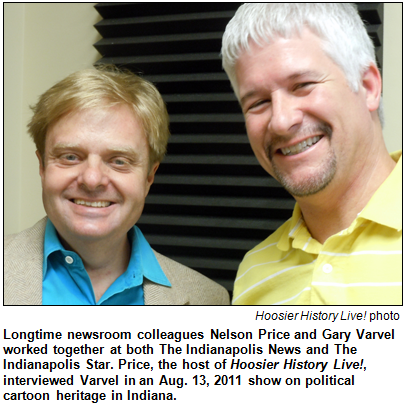 |
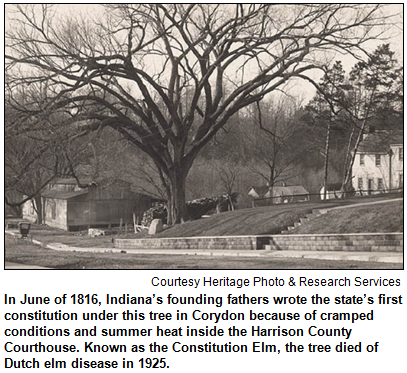 (Oct. 29, 2011) - According to folklore about early Indiana, a squirrel could have jumped from Ohio all the way to Illinois - that is, the critter could have crossed the width of the Hoosier state - without touching ground.
(Oct. 29, 2011) - According to folklore about early Indiana, a squirrel could have jumped from Ohio all the way to Illinois - that is, the critter could have crossed the width of the Hoosier state - without touching ground.
That's an indication about the density of the woodland forest here 300 years ago, before the massive clear-cutting of trees by settlers that made the Indiana landscape almost resemble a prairie.
To explore our tree canopy, as well as an array of other aspects related to our towering friends, Nelson will be joined in studio by David Forsell, president of Keep Indianapolis Beautiful, Inc., known as KIB.
David and his volunteer-based organization have been reaping attention for endeavors that included partnering with Eli Lilly and Co. for an employee service day earlier this month that involved planting more than 3,000 trees across the Hoosier capital.
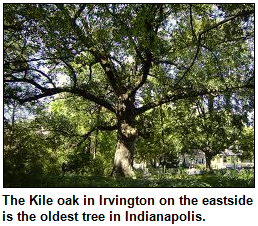 Expect David and Nelson to share details about the city's oldest tree, a bur oak in Irvington estimated to be about 400 years old.
Expect David and Nelson to share details about the city's oldest tree, a bur oak in Irvington estimated to be about 400 years old.
According to Steve Barnett of the Irvington Historical Society (who, by the way, was a studio guest last month for a Hoosier History Live! show about his neighborhood), the tree, known as the "Kile Oak," also is one of the largest bur oaks in the state.
It's commonly referred to as the "Kile oak" because about 110 years ago a family named Kile owned the property on which the tree stands at 5939 Beechwood Ave. The majestic tree and its lot currently are owned by the Irvington Historic Landmarks Foundation, which also owns the neighborhood's historic Benton House. (According to Steve, the Kile Oak property is maintained by the Irvington Garden Club.)
During our show, David Forsell promises to identify the tree in Indy that he considers, as he puts it, "the most beautiful tree I've ever seen."
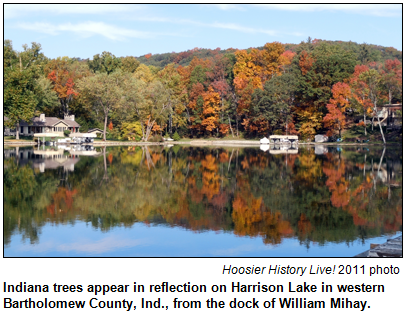 His organization, headquartered in a renovated abandoned warehouse in Indy's Fountain Square neighborhood, has planted hundreds of trees in that neighborhood alone by partnering with Friends of Fountain Square, the North Square Neighborhood Association and other community groups, according to the Urban Times monthly newspaper.
His organization, headquartered in a renovated abandoned warehouse in Indy's Fountain Square neighborhood, has planted hundreds of trees in that neighborhood alone by partnering with Friends of Fountain Square, the North Square Neighborhood Association and other community groups, according to the Urban Times monthly newspaper.
Click here for an application form to receive free trees from the organization.
Urban Times notes that KIB (which has a goal of eventually planting 100,000 trees in Indy) developed a map to identify areas in the city where trees would provide the most benefit in terms of "environmental and socio-economic factors."
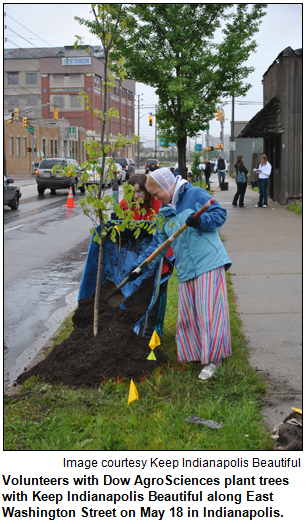 In addition to volunteers who water and mulch the newly planted trees, KIB employs high school students and other young people to care for those trees that "need sustenance through other means."
In addition to volunteers who water and mulch the newly planted trees, KIB employs high school students and other young people to care for those trees that "need sustenance through other means."
According to the book 101 Trees of Indiana (Indiana University Press) by Marion T. Jackson, in the "pre-settlement" era, the state was dominated by forests that consisted of American beech and sugar maple trees (50 percent); various species of oak and hickory (30 percent) and a mixed forest "of Appalachian origin" (more than 7 percent).
David and Nelson also expect to share insights about Indiana's official state tree. It's the tulip tree, sometimes called the yellow poplar.
"No tree species could be more appropriate as Indiana's state tree," according to 101 Trees of Indiana. "Native to nearly all areas of the state, ancient in lineage, majestic in form, impressive in dimensions, beautiful in all seasons, it truly graces the Indiana landscape, either as a forest monarch or as a handsome ornamental."
The book notes that the tulip tree once was the prime timber for log cabins in Indiana. It's also been widely used for furniture and cabinetry.
Fun facts:
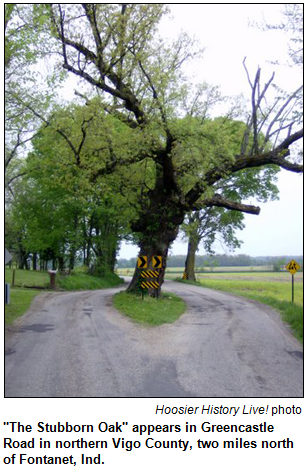 Roadtripper: 'Stubborn Oak' of Vigo County and more
Roadtripper: 'Stubborn Oak' of Vigo County and moreIn keeping with our "Trees, trees, and trees" topic, Chris Gahl of the ICVA suggests we take a Roadtrip to see the "Stubborn Oak" in Nevins Township in northern Vigo County that has been saved by countless generations of "tree huggers" long before there was such a term.
Legend has it that a lone farmer stood decades ago with a shotgun to protect the tree from "the men from the county" who sought to remove the tree with a cross-cut saw. The oak had been on his farm for decades, and he objected to it being cut down for the sake of "progress."
Somewhat like the true origin of the word "Hoosier," the actual story may be lost to time, but the tree does remain triumphant.
When in the area, you also can check out the Thorpe Ford Covered Bridge near Rosedale in southern Parke County. Alas, you can't see nearby Jeffries Ford Bridge because it was destroyed by arson in 2002.
The fruit from this type of tree is often called the "Indiana banana." This tree is on the small side, but it has extremely large leaves with smooth edges. 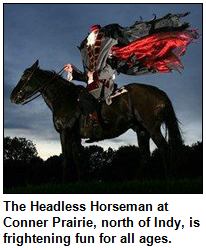 The tree grows throughout Indiana, particularly along streams and in woods and thickets with rich, moist soils. In fact, it often grows in colonies that are referred to as "patches.
The tree grows throughout Indiana, particularly along streams and in woods and thickets with rich, moist soils. In fact, it often grows in colonies that are referred to as "patches.
Question: What is the tree?
To win the prize, you must call in with the correct answer during the live show. Please do not call if you have won a prize from any WICR show during the last two months. The call-in number is (317) 788-3314, and please do not call until you hear Nelson pose the question on the air.
The prize is a an overnight stay at Hilton Indianapolis North and a pair of tickets to Conner Prairie, courtesy of the ICVA.
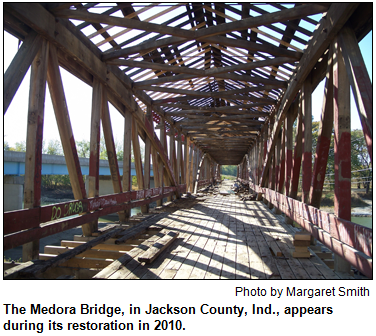 (Oct. 22, 2011) - Our state was a land of wooden, covered bridges from 1820 to 1922. That's when more than 600 covered bridges were built across Indiana.
(Oct. 22, 2011) - Our state was a land of wooden, covered bridges from 1820 to 1922. That's when more than 600 covered bridges were built across Indiana.
Today, about 90 of these historic gems remain.
To explore them, Nelson will be joined in studio by Margaret Smith of Indianapolis, past president of the Indiana Covered Bridge Society, and Larry Stout of Rush County, who helped spearhead the restoration of the historic Moscow Covered Bridge, which had been demolished by a tornado.
Some fun facts, courtesy of Margaret:
The heyday of covered-bridge construction was the 1880s; bridges were covered to protect their flooring and interior from the elements.
Parke County, which is known as the "Covered Bridge Capital of the World," has 31 covered bridges that remain. And Sunday (Oct. 23) is the last day of the annual Parke County Covered Bridge Festival, which began Oct. 14.
In Rush County, a tornado that roared through in 2008 tossed the Moscow bridge (built in 1886) into the Flatrock River.Reconstructed using 30 percent of its original wood, the Moscow Covered Bridge reopened with a community celebration in September 2010.
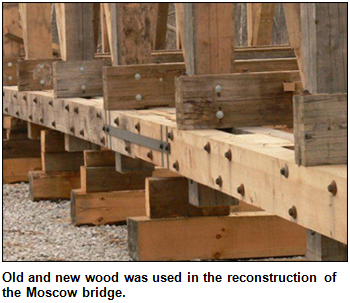 Indiana Landmarks recently honored our guest Larry Stout, president of Rush County Heritage and a resident of the village of Gowdy, with the Servaas Award for lifetime achievement. His preservation efforts extend far beyond covered bridges, but his county - as well as Parke and Putnam counties is particularly known for them.
Indiana Landmarks recently honored our guest Larry Stout, president of Rush County Heritage and a resident of the village of Gowdy, with the Servaas Award for lifetime achievement. His preservation efforts extend far beyond covered bridges, but his county - as well as Parke and Putnam counties is particularly known for them.
Why those counties? Although there were several builders of covered bridges across Indiana, the three generally considered to have been the most significant were two historic bridge builders based in Rockville in Parke County (the businesses of J.J. Daniels and Joseph A. Britton), as well as the firm run by A.M. Kennedy (and later by his sons and grandsons) in Rushville.
In fact, the Moscow Covered Bridge reconstructed after the tornado was originally built by the Kennedy family.  Larry Stout lives two miles north of it and two miles west of the Forsythe Covered Bridge, which also was built by the Kennedys.
Larry Stout lives two miles north of it and two miles west of the Forsythe Covered Bridge, which also was built by the Kennedys.
In total, Rush County has five covered bridges, all still in use. (Some of the other covered bridges across the state no longer carry traffic. They have been bypassed by modern roads or preserved in parks.)
"The bridges are located in many out-of-the-way places today, but they once were hubs of commerce," Margaret notes. "Many were railroad bridges. Often, they were the largest covered areas in a community."
That meant, she adds, that they frequently served as the settings for "political rallies, community gatherings and revival meetings - even weddings."
More fun facts, again courtesy of Margaret:
According to Margaret, the restoration of Potter's Ford is "one of the true success stories of covered-bridge preservation."
She says Potter's Ford, which originally opened to 1871, now even has a sprinkler system to prevent arson and a coating of special paint to resist graffiti. Arson and graffiti have plagued other covered bridges across the state.
Hoosier History Live! fun fact: There is a footpath going north from Potter's Ford Bridge Park that leads to a great swing that has a spectacular view of the White River.
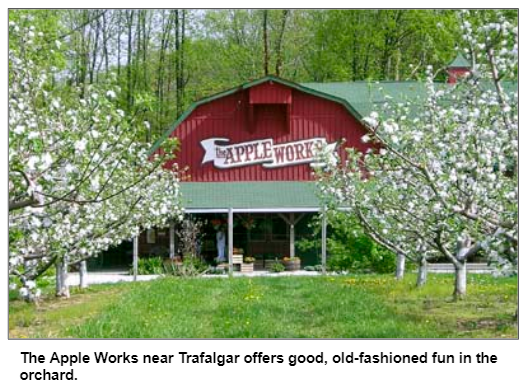 Our Roadtrip suggestion for a crisp and cool autumn adventure is to head south from Indianapolis to The Apple Works, near Trafalgar.
Our Roadtrip suggestion for a crisp and cool autumn adventure is to head south from Indianapolis to The Apple Works, near Trafalgar.
The Apple Works is a privately owned orchard that was started in 1989 by owners Rick and Sarah Brown when they began planting apple trees on their land. They've now grown into many acres of fun for adults and children alike, and they are open to the public seven days a week.
The Apple Works has a country store, as well as offerings for the kids, including train rides, apple shots (which appear to be large sling shots for pitching apples), pony rides, a corn maze and wagon rides to the pumpkin patch.
Do visit the provided web link for directions to this off-the-beaten-track Roadtrip!
A modern, steel bridge - not a wooden, covered bridge - in southern Indiana has made headlines this fall. The double-deck bridge spanning the Ohio River from the Hoosier state to Kentucky was shut down in early September by Gov. Mitch Daniels after construction crews found cracks in the structure. This has caused major traffic disruptions because the bridge is heavily used by motorists traveling between New Albany and Louisville.
The bridge, which has eye-catching arches rising above it, is named after the first Indiana native to become a U.S. Supreme Court justice. He had been born to a hard-scrabble farmer's family in southern Indiana near the Ohio River.
Question: Name the bridge.
To win the prize, you must call in with the correct answer during the live show. Please do not call if you have won a prize from any WICR show during the last two months. The call-in number is (317) 788-3314, and please do not call until you hear Nelson pose the question on the air.
The prize is a an overnight stay at University Place Conference Center & Hotel on the IUPUI campus, courtesy of the ICVA, as well as two tickets to "Vonnegut on the Body", a Spirit & Place literary discussion featuring Hoosier author Dan Wakefield, at 7:30 p.m. on Friday, 11-11-11 (Kurt Vonnegut’s birthday) at the Eugene and Marilyn Glick Indiana History Center. These tickets are courtesy of the Kurt Vonnegut Memorial Library.
Your support keeps us going!
Our little independently produced show would not be able to stay on the air, or maintain its website, were it not for these recent supporters who either renewed their underwriting commitments or made a contribution.
We believe that a show about Indiana history can indeed have some brains and personality! We truly hope to be able to fully develop our website and audio archives at some point in time. Meanwhile, our "Mystery Volunteer" continues to work on our grant-writing project.
Visit "Support the show" on our website to learn more.
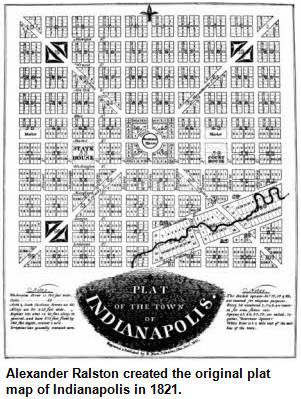 (Oct. 15, 2011) - Amid the controversy surrounding the proposals to rename Georgia Street in downtown Indianapolis, have you been wondering how streets across the city got their names? And why some have been changed over the years?
(Oct. 15, 2011) - Amid the controversy surrounding the proposals to rename Georgia Street in downtown Indianapolis, have you been wondering how streets across the city got their names? And why some have been changed over the years?
Hoosier History Live! explores the heritage of street names with local historian Joan Hostetler, who initiated the crusade to keep the 190-year-old name on Georgia Street with a campaign that began on Facebook.
Joan and Nelson also are joined by Steve Campbell, a former Indy deputy mayor who has been working on a book about street names.
Some were changed because of landmarks such as the Indiana Statehouse. Its construction resulted in Tennessee Street being renamed Capitol Avenue in the 1890s.
Other street names were changed because of anti-German sentiment after World War I. On the west side of town, for example, Bismarck Avenue became Pershing Avenue.
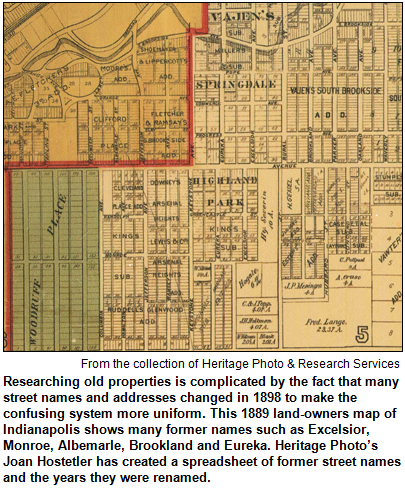 As the city began numbering thoroughfares at 9th Street, other names changed. Did you know East 10th Street once was known as Clifford Avenue?
As the city began numbering thoroughfares at 9th Street, other names changed. Did you know East 10th Street once was known as Clifford Avenue?
To get around state legislation prohibiting taverns on alleys, the Indianapolis City Council changed alleys to streets in the downtown area. This also affected street names, according to Joan, co-owner of Heritage Photo & Research Services. She specializes in local history research and preserving, digitizing and archiving historic photographs.
Curiosity about the city's heritage of naming streets has been intensified by the debates about renaming three blocks of Georgia Street, which is undergoing a $12 million transformation into a covered, pedestrian-friendly mall in time for the Big Ten Football Championship on Dec. 3 and the Super Bowl on Feb. 5.
 Initial suggestions to rename the three blocks "Hospitality Boulevard" or "Championship Way" (the stretch of Georgia Street connects the Indiana Convention Center with Conseco Fieldhouse) drew objections from the public.
Initial suggestions to rename the three blocks "Hospitality Boulevard" or "Championship Way" (the stretch of Georgia Street connects the Indiana Convention Center with Conseco Fieldhouse) drew objections from the public.
With subsequent revelations that pillars along the reconfigured thoroughfare will honor famous Hoosiers, one letter-writer to The Indianapolis Star suggested tweaking the street name to "Georgia on My Mind Street."That was a nod to composer Hoagy Carmichael, a Bloomington native whose hits included "Georgia on My Mind."
The name Georgia Street dates to 1821. That's when city planner Alexander Ralston created the original plat for Indianapolis. He named 22 streets for states. Think of Pennsylvania Street, Ohio Street and Massachusetts Avenue. Or of Delaware Street, Virginia Avenue and Illinois Street.
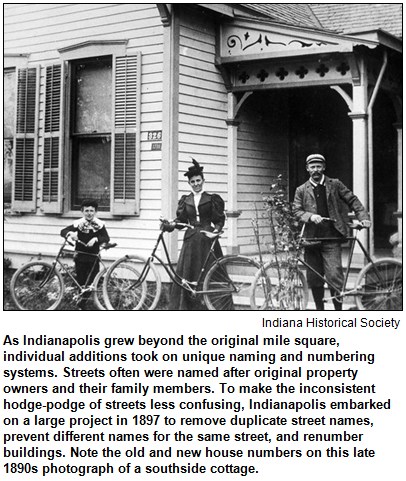 As the city grew, streets were named for various reasons, including as a way to honor people. They also were renamed for various reasons.
As the city grew, streets were named for various reasons, including as a way to honor people. They also were renamed for various reasons.
According to Joan, an African-American city councilman in the 1890s pushed to change the name of Mississippi Street. It was renamed Senate Avenue in 1895.
An example of a renaming in more recent times: A stretch of Fall Creek Boulevard on the northeastside was renamed Binford Boulevard to honor civic leader Tom Binford (1924-1999).
In addition to the Bismarck-to-Pershing switch because of anti-German sentiment, Joan notes another westside street also was affected. Belleview Place once was called Germania.
Intrigued? Tune in for more insights and historical tidbits from Steve Campbell, who was deputy mayor from 2005 to 2007 during the Bart Peterson administration, and Joan, who collaborated with Nelson and photographer Garry Chilluffo on the Indianapolis Then and Now visual history book.
 According to Steve, the street naming process in Indy can be divided into two distinct categories: Names in the "old city" (pre-Unigov city limits) and names in suburban neighborhoods that were developed later.
According to Steve, the street naming process in Indy can be divided into two distinct categories: Names in the "old city" (pre-Unigov city limits) and names in suburban neighborhoods that were developed later.
"The old city naming process was pretty standard and orderly," he says. "The townships developed a little bit by common lore and local usage. I haven't found the answers to every street name, but I'm probably at about 80 to 90 percent."
A history lover, Steve has served on the boards of many civic and historical organizations, including the Benjamin Harrison Presidential Site and the Marion County Historical Society. He's the founder of Campbell Strategies, an Indy-based consulting firm.
At Heritage Photo & Research Services, Joan has worked with clients including the Indianapolis Museum of Art and the Indiana Historical Society, where she formerly was a photo archivist and exhibits coordinator.
As our Roadtripper's day job is that of being the vice president of marketing and communications for the ICVA, and as he's also on the Super Bowl Host Committee, and as he has a bird's-eye view of what's going on downtown, we thought we'd take the opportunity to have Chris Gahl report on what we can expect the new pedestrian mall downtown to look like! Thanks, Chris.
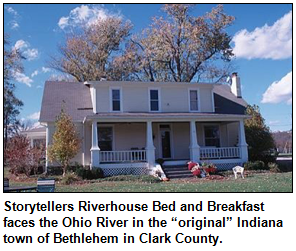 Streets aren't the only places on Indiana maps that have undergone name changes. When a city in central Indiana was laid out as a small village in the 1830s, it was called Bethlehem. The initial plat for Bethlehem in 1837 consisted of 14 lots. When a post office was established in the village in 1846, residents were notified by the U.S. Post Office that another town in Indiana (in the far southern part of the state) already had been named Bethlehem.
Streets aren't the only places on Indiana maps that have undergone name changes. When a city in central Indiana was laid out as a small village in the 1830s, it was called Bethlehem. The initial plat for Bethlehem in 1837 consisted of 14 lots. When a post office was established in the village in 1846, residents were notified by the U.S. Post Office that another town in Indiana (in the far southern part of the state) already had been named Bethlehem.
As a result, the village in central Indiana - now a thriving city - took a new name.
Question: Name the city.
The prize wais a gift certificate to dine at Seasons 52 Fresh Grill at Keystone at the Crossing in Indianapolis, courtesy of the ICVA.
(Oct. 1, 2011) - "The goblins will git you - if you don't watch out!"
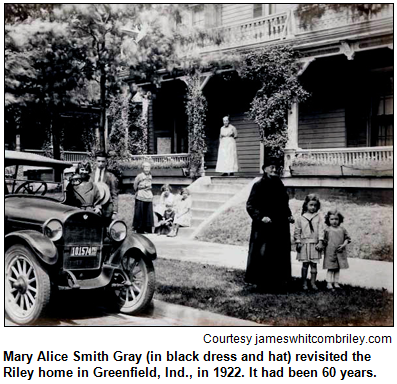 So goes the ominous warning from a fictional, orphaned storyteller in one of the most famous children's poems written by James Whitcomb Riley, the Hoosier who became nationally known for his verse.
So goes the ominous warning from a fictional, orphaned storyteller in one of the most famous children's poems written by James Whitcomb Riley, the Hoosier who became nationally known for his verse.
Historians have long identified a real Hoosier as the inspiration for "Little Orphant Annie," but her life has been shrouded in mystery, folklore and misinformation.
During the winter of 1861-62, young Mary Alice Smith was taken in as a boarder at the Greenfield home of the future poet and his parents. Mary Alice probably was 11 years old, making her slightly younger than Jim Riley (1849-1916), but the Riley family initially may have been misled into assuming she was about 14 years old.
Was she really an orphan? Did her uncle bring her to the Rileys to help with the housework? Did she then proceed to tell frightening tales about goblins and other creatures to Jim and his younger siblings?
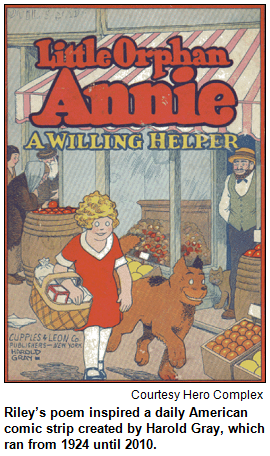 To share insights and new information about the mysterious boarder, who later in life married and became Mary Alice Gray, Nelson is joined in studio by historian Brigette Jones, a docent at the James Whitcomb Riley Old Home & Museum in Greenfield, and writer-historian Al Hunter, a popular columnist for the Eastside Voice weekly newspaper.
To share insights and new information about the mysterious boarder, who later in life married and became Mary Alice Gray, Nelson is joined in studio by historian Brigette Jones, a docent at the James Whitcomb Riley Old Home & Museum in Greenfield, and writer-historian Al Hunter, a popular columnist for the Eastside Voice weekly newspaper.
Brigette, president of the Hancock County Historical Society, lives in rural Greenfield. After years of historical detective work for an upcoming biography of Mary Alice Smith Gray, Brigette reports she has uncovered information that contradicts or clarifies long-established myths about the mysterious boarder.
Al, who conducts walking tours in communities along the Old National Road (including Greenfield and Irvington), has written columns about Mary Alice's life.
"She made such a deep impression on Riley that he never forgot her," writes Elizabeth Van Allen in her biography James Whitcomb Riley: A Life (IU Press).
Did the nationally renowned "Hoosier poet" and his muse ever re-meet as adults? At what point did Mary Alice, who became a farm wife in the Hancock County town of Philadelphia, realize she was the inspiration for the famous "Orphant Annie"?
Brigette, Al and Nelson tackle those questions and myriad others about the Hoosier whose legacy almost lived on in even unexpected ways.
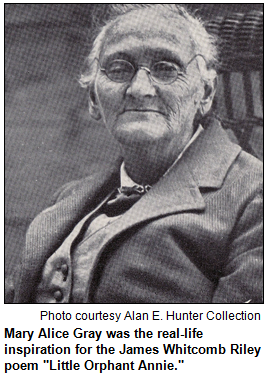 "The original working title of what became Riley Hospital for Children was Little Orphant Annie Hospital," Brigette says. She has examined early plans for the acclaimed hospital in Indianapolis that was established by the poet's friends in the early 1920s as a posthumous tribute to him.
"The original working title of what became Riley Hospital for Children was Little Orphant Annie Hospital," Brigette says. She has examined early plans for the acclaimed hospital in Indianapolis that was established by the poet's friends in the early 1920s as a posthumous tribute to him.
In fact, Mary Alice Smith Gray attended the laying of the cornerstone for the hospital before her own death in 1924, according to Brigette.
In her 70s, Mary Alice also embarked on a Midwestern tour during which she answered audiences' questions. Brigette has tracked down letters written by Mary Alice to the promoter who conceived the tour; she also has obtained Mary Alice's private correspondence from great-grandchildren.
Our show came just before the Riley Festival, one of the largest crafts festivals in Indiana. The 42nd annual Riley Festival, which includes a parade, a breakfast, decorated pumpkin shows and many other events, will be Oct. 6-9 in downtown Greenfield.
The public also is invited to Brigette's presentation, "Who Was the Real Little Orphant Annie?", at 7 p.m. on Oct. 13. The free presentation will be at the New Castle Public Library.
Thanks to his poems written in Hoosier dialect - including "Little Orphant Annie" - Riley became a national celebrity. 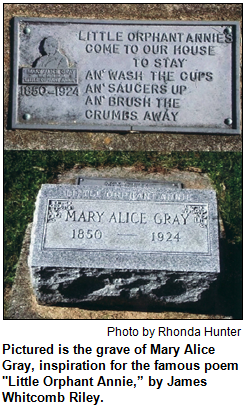 By the way, "Little Orphant Annie," which was first published in 1880, wasn't his only poem inspired by his family's young boarder.
He also wrote a poem titled "Where Is Mary Alice Smith?" in which he depicts the little orphan girl falling in love with a soldier boy who was killed. Then she dies of grief.
By the way, "Little Orphant Annie," which was first published in 1880, wasn't his only poem inspired by his family's young boarder.
He also wrote a poem titled "Where Is Mary Alice Smith?" in which he depicts the little orphan girl falling in love with a soldier boy who was killed. Then she dies of grief.
In truth, Mary Alice went to work in a tavern on the National Road in the town of Philadelphia, where she met her husband, John Wesley Gray. Their marriage produced seven children.
And there are many more intriguing aspects of her colorful life, both as a child before she met young Jim Riley and after she parted ways with his family in Greenfield.
According to a column by our guest Al Hunter, a board member of the Indiana National Road Association, Riley resorted to extensive efforts in his final years to track down Mary Alice. He took out advertisements in newspapers across the Midwest seeking information about her - even though, as both Brigette and Al have documented, she spent less than a year living with his family, not the seven or eight years mentioned in some accounts.
According to Brigette, some of the confusion can be traced to the "muse" herself. Once she found herself in the spotlight, Mary Alice Smith Gray gave conflicting accounts of her life. Click here to see Brigette's personal collection of photos.
Tune into Hoosier History Live! as we reveal more about her.
 This Roadtrip pick is named for another Hoosier woman named Mary Gray, and there is no known connection to Mary Alice Smith Gray. However, if you're headed east from Indianapolis through Greenfield for the Riley Festival, you can keep going east and visit the Mary Gray Bird Sanctuary, which is owned and operated by the Indiana Audubon Society.
This Roadtrip pick is named for another Hoosier woman named Mary Gray, and there is no known connection to Mary Alice Smith Gray. However, if you're headed east from Indianapolis through Greenfield for the Riley Festival, you can keep going east and visit the Mary Gray Bird Sanctuary, which is owned and operated by the Indiana Audubon Society.
Alice Green Gray gave the initial 264-acre property to the Audubon Society in 1943 as a living memorial to her daughter Mary, who preceded her in death.
This idyllic spot, now with more than 700 acres for hiking and bird watching, is open to everyone, and there is no charge, although you can certainly make a donation. Our Roadtripper Chris Gahl of the ICVA suggests you use the map on the provided web link to find the place, which is pretty remote! Again, great autumn vistas in a relaxing setting.
After achieving national fame as a poet, James Whitcomb Riley became a permanent guest in a house owned by friends in downtown Indianapolis. While living in the house, now the James Whitcomb Riley Museum Home, the poet had a dog as a pet. 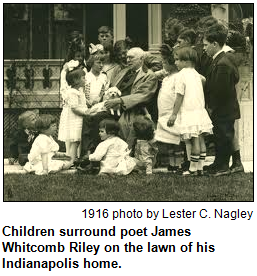 The dog, a white poodle, was seen in some photos with him.
The dog, a white poodle, was seen in some photos with him.
They include a classic picture of James Whitcomb Riley surrounded by Hoosier children that was taken in 1916, a few months before the poet's death; the poodle sits on his master's lap in the photo. You can also watch a silent film taken the same day.
Riley had given his beloved dog a name associated with one of his residences.
Question: What was the name of James Whitcomb Riley's dog?
The prize was an overnight stay at the Comfort Suites Indianapolis City Centre in downtown Indianapolis, as well as two tickets to the Eiteljorg Museum. These prizes are courtesy of the ICVA.
(Sept 24, 2011) - Summer camps, movie nights, sports competitions, hobby shows and science fairs. All have figured in the lives of thousands of Hoosier teenagers and children since the late 1930s because of the Catholic Youth Organization (CYO), which will be the focus of our show just before a related national gathering in Indy.
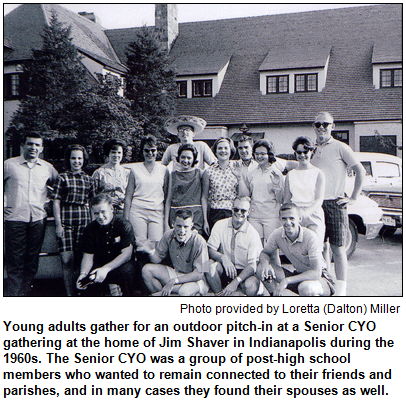 According to a new book, The CYO in Indianapolis & Central Indiana (The History Press), the first CYO event in the Hoosier capital was a dance in 1939 at Cathedral High School (then located downtown on North Meridian Street) that drew more than 1,000 teenagers from every parish in the city.
According to a new book, The CYO in Indianapolis & Central Indiana (The History Press), the first CYO event in the Hoosier capital was a dance in 1939 at Cathedral High School (then located downtown on North Meridian Street) that drew more than 1,000 teenagers from every parish in the city.
"The movement exploded locally in the 1950s and '60s with numerous activities,” reports Julie Young, the book's author, who joins Nelson in studio to explore the heritage and impact of the CYO across Indiana.
Nelson also is joined by Ed Tinder, executive director of the CYO in the Archdiocese of Indianapolis.
Launched in Chicago as a way to offer spiritual, social, athletic and cultural programming for young people, the CYO immediately created a major impact in Indiana. Some youths even met their future spouses at the array of events, according to Julie's book. 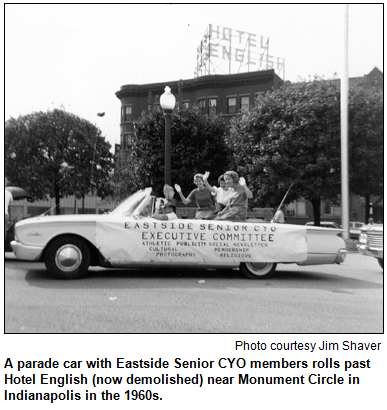 She credits the late Cardinal John Ritter (namesake of Ritter High School on the westside) with bringing the CYO to the Indianapolis area.
She credits the late Cardinal John Ritter (namesake of Ritter High School on the westside) with bringing the CYO to the Indianapolis area.
"Before Facebook, MySpace and Twitter gave everyone the chance to connect and update one another with life-altering news, young people had to congregate in order to catch up," she writes. For young people who were Catholic, the CYO provided the opportunities, which ranged from movie nights in parish basements to dances and sports.
The first CYO football championship in the Indianapolis archdiocese was a game in 1939 between undefeated teams representing the Little Flower and St. Catherine parishes. The game, which Julie calls "the Super Bowl of CYO match-ups," drew nearly 10,000 spectators to Christian Park on the eastside.
In 1959, the CYO established girls track competitions and girls softball leagues in the Indy metro area.
Hobby show competitions flourished almost from the beginning. In her book, Julie describes her first CYO experience as a 9-year-old. She made an apple pie for a hobby show - and was astounded when she won first place. Her baking hobby triumphed over baseball card and coin collections of other parish youngsters.
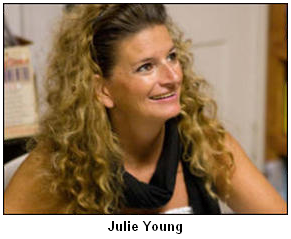 Today, some CYO members are the fourth generation of their families to be involved. For many years, several chapters also flourished of Senior CYO, which provided faith-based social opportunities for people in their late teens and 20s. In Indy during the 1960s, the Eastside Senior CYO was particularly active, offering card parties, picnics, bowling, potluck suppers and pickup games of volleyball.
Today, some CYO members are the fourth generation of their families to be involved. For many years, several chapters also flourished of Senior CYO, which provided faith-based social opportunities for people in their late teens and 20s. In Indy during the 1960s, the Eastside Senior CYO was particularly active, offering card parties, picnics, bowling, potluck suppers and pickup games of volleyball.
In 1946, the CYO opened a summer camp in Brown County. Called Rancho Framasa, it has become known as "the Ranch" to scores of Catholic youth. They continue to visit today for, as Julie puts it, "adventures in the great outdoors." Teachers also bring students to "the Ranch" for nature studies.
Julie's book describes how the amphitheater at the Ranch was built by the National Guard unit of a former camper. Determined to "give back" to the camp he cherished as a boy, he offered to have his unit construct the facility at Rancho Framasa.
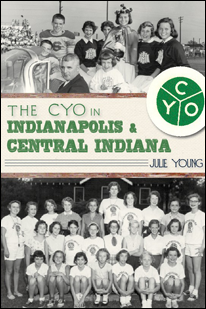 A second, more rugged, CYO camp, Camp Christina, also was established in Brown County. According to Julie's book, Camp Christina became a refuge in the early 1960s for Cuban girls attending Ladywood Academy (later merged with Cathedral); their families had escaped the Castro regime in their homeland. Camp Christina closed in the early 1990s to curb the expenses of operating two camps under the CYO banner.
A second, more rugged, CYO camp, Camp Christina, also was established in Brown County. According to Julie's book, Camp Christina became a refuge in the early 1960s for Cuban girls attending Ladywood Academy (later merged with Cathedral); their families had escaped the Castro regime in their homeland. Camp Christina closed in the early 1990s to curb the expenses of operating two camps under the CYO banner.
Some related facts:
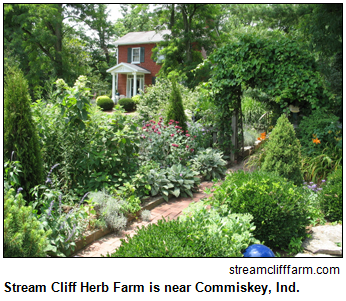 Chris Gahl of the ICVA suggests we head to southern Jennings County to visit Indiana's oldest herb farm, the Stream Cliff Herb Farm near Commiskey. The farm is owned by Betty and Gerald Manning and has been in the family for more than 100 years. It sits near a small "cliff" on Graham Creek and has the distinction of having been visited by Morgan's Raiders during the Civil War.
Chris Gahl of the ICVA suggests we head to southern Jennings County to visit Indiana's oldest herb farm, the Stream Cliff Herb Farm near Commiskey. The farm is owned by Betty and Gerald Manning and has been in the family for more than 100 years. It sits near a small "cliff" on Graham Creek and has the distinction of having been visited by Morgan's Raiders during the Civil War.
The farm now consists of four shops filled with handmade traditional crafts and garden related items, a tea room and an extensive offering of herbs and flowers. Check the farm's website for hours and location, or call (812) 346-5859.
While in Jennings County you also can visit the historic town of Vernon, as well as the Selmier State Forest. Jennings County was the setting for Jessamyn West's book, The Friendly Persuasion.
"Jennings County offers great leaf peeping without the crowds," says our Roadtripper.
The History Mystery is a carry-over from the previous week's show, when there wasn't a correct answer. The question concerns a top Indianapolis civic leader for the first half of the 20th century who lived in Irvington.
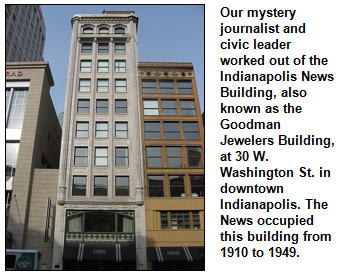 In 1880, when Butler University was located in the neighborhood, he was president of his senior class. Five years later, at age 25, he became the youngest person ever elected to Butler's board of trustees. As a business leader, he had a 77-year career at the Indianapolis News newspaper, working his way up from reporter to editor to top executive. In Irvington, he served as the president of civic and school boards. He died in 1958.
In 1880, when Butler University was located in the neighborhood, he was president of his senior class. Five years later, at age 25, he became the youngest person ever elected to Butler's board of trustees. As a business leader, he had a 77-year career at the Indianapolis News newspaper, working his way up from reporter to editor to top executive. In Irvington, he served as the president of civic and school boards. He died in 1958.
Question: Name the civic and business leader.
Hints: He was not John Atherton, Booth Tarkington or George Clowes; they were incorrect guesses from listeners last week.
The prize was a gift certificate for dinner for two at the Mystery Café at the Milano Inn in downtown Indianapolis, the nation's original murder mystery theater. For all of your October spookery! This prize is courtesy of the ICVA.
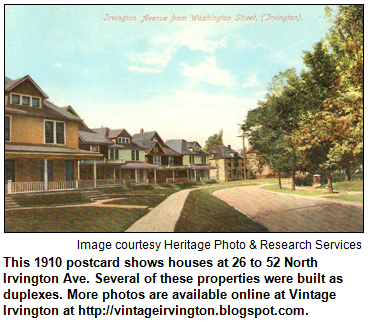 (Sept. 17, 2011) - A historic neighborhood on the eastside of Indy that dates to the 1870s, Irvington has a past as colorful as its leafy, towering trees. But there's also fresh activity under way in this neighborhood, which has been home to artists and civic leaders, as well as to Butler University until the 1920s.
(Sept. 17, 2011) - A historic neighborhood on the eastside of Indy that dates to the 1870s, Irvington has a past as colorful as its leafy, towering trees. But there's also fresh activity under way in this neighborhood, which has been home to artists and civic leaders, as well as to Butler University until the 1920s.
To explore the neighborhood, which has residences ranging from Queen Anne-style and Second Empire houses to Sears kit homes and bungalows, Nelson is joined in studio by Irvington resident Paul Diebold, senior architectural historian for the State DNR and author of Greater Irvington.
Our guests also include Irvington native Steve Barnett, a graduate of Howe High School (one of the neighborhood's landmarks), who is executive director of the Irvington Historical Society.
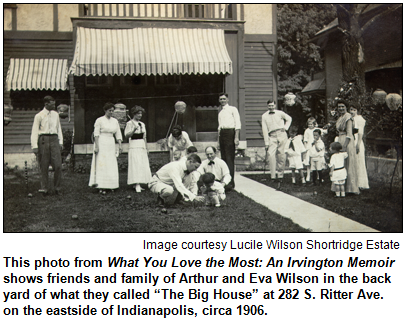 Nelson also is joined by Amandula Henry, executive director of the Irvington Development Organization. She shares insights about new initiatives in the former town, which was annexed into Indy in 1902.
Nelson also is joined by Amandula Henry, executive director of the Irvington Development Organization. She shares insights about new initiatives in the former town, which was annexed into Indy in 1902.
Irvington's founders named the neighborhood in honor of their favorite author, Washington Irving. Ever notice many Irvington streets also are named for authors, such as Hawthorne (Nathaniel) and Emerson (Ralph Waldo) avenues?
Boundary streets, though, are difficult to identify. Irvington is so beloved that many eastside residents want to consider themselves part of it. Our guest Paul Diebold, who has lived in Irvington for 24 years, reports a favorite saying: "Irvington has no boundaries, but is a state of mind."
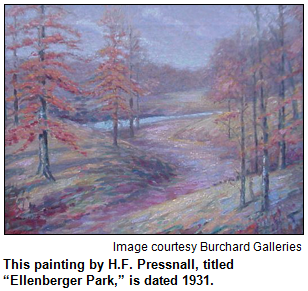 The Historic Irvington Community Council represents an area defined by Emerson on the west, Edmondson Avenue on the east, 10th Street on the north and Brookville Road on the south.
The Historic Irvington Community Council represents an area defined by Emerson on the west, Edmondson Avenue on the east, 10th Street on the north and Brookville Road on the south.
Our show was broadcast on the eve of the Irvington Home Tour, which is set for Sunday (Sept. 18) from noon to 5 p.m.
And 2012 marks the 10th anniversary of the opening as a cultural/arts center of the Bona Thompson Memorial Center, which was built in the early 1900s as Butler's library. To celebrate the 10th anniversary of the $1 million restoration, a series of events will be held throughout Irvington.
Other neighborhood landmarks include the Irving Theater; sprawling Ellenberger Park, which opened in 1911; and the Benton House, which was built in 1873 and became the home of Butler faculty members, including a president.
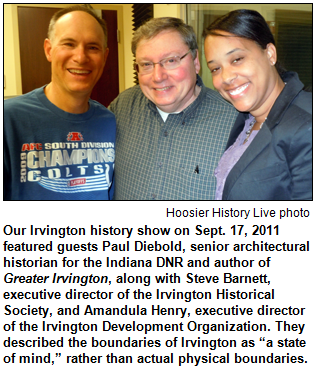 With the presence of Butler, which moved to the neighborhood in 1875 from its initial location on College Avenue in the Old Northside, Irvington flourished as a cultural hub of the city.
With the presence of Butler, which moved to the neighborhood in 1875 from its initial location on College Avenue in the Old Northside, Irvington flourished as a cultural hub of the city.
Notable residents included artist William Forsyth, a member of the renowned Hoosier Group of painters (his artwork periodically depicted scenic Pleasant Run Creek, another landmark) and cartoonist Frank McKinney "Kin" Hubbard, creator of the iconic Abe Martin character.
Notorious residents included D.C. Stephenson, the Grand Dragon of the Ku Klux Klan during the 1920s. His imposing home, which he modeled after the Klan's headquarters in Atlanta, still stands and is privately owned.
Forsyth and various artists also have identified themselves as the Irvington Group. Our guest Steve Barnett has served as curator for their exhibits, as well as many others at the Bona Thompson Center. He also has tracked down the histories of more than 1,600 homes in areas of Irvington listed on the National Register of Historic Places, including Irvington Gardens, Pleasanton and Emerson Addition.
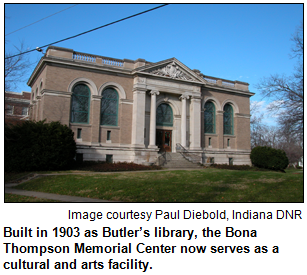 According to the Indianapolis Business Journal, more than 78 percent of Irvington homes were built before 1960. The IBJ estimates the population of the Irvington area as about 11,460.
According to the Indianapolis Business Journal, more than 78 percent of Irvington homes were built before 1960. The IBJ estimates the population of the Irvington area as about 11,460.
In recent years, Irvington has become known for its locally owned restaurants, coffee shops and small businesses. Aside from marketing initiatives such as "Celebrate Irvington" and "Shop Irvington," the neighborhood also has carved out a distinct identity for its celebrations and festivals during Halloween season, including popular "ghost" tours through the neighborhood.
In addition to his book Greater Irvington, our guest Paul Diebold is the author of The History and Architecture of Meridian-Kessler; they are considered Indy's first neighborhood-based architectural history books.
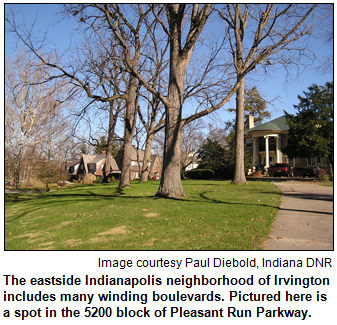 Even Nelson, our host, has gotten into the Irvington act. He penned the foreword for What You Love the Most: An Irvington Memoir, written by Indianapolis author Carol Faenzi. It is a memoir about the building of a spacious, historic home by Arthur Wilson, an early neighborhood resident.
Even Nelson, our host, has gotten into the Irvington act. He penned the foreword for What You Love the Most: An Irvington Memoir, written by Indianapolis author Carol Faenzi. It is a memoir about the building of a spacious, historic home by Arthur Wilson, an early neighborhood resident.
Beginning with its founding along the Old National Road (East Washington Street), Irvington was known for its restrictions on alcohol sales. According to some sources, one of Irvington's founders, Jacob Julian, a former prosecutor, was a teetotaler.
Speaking of the Old National Road: Many streets in Irvington, particularly those south of Washington Street, are known for being curvy and narrow. That's because many were built for travel by horse, not car.
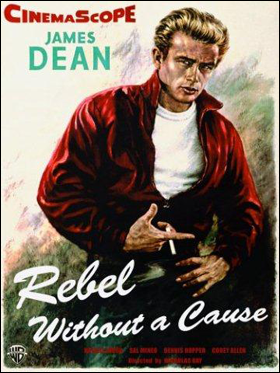 Roadtrip: James Dean Festival in Fairmount
Roadtrip: James Dean Festival in FairmountChris Gahl of the ICVA suggests we head to Fairmount, hometown of the late film actor James Dean, for the 36th annual James Dean Festival, to be held Sept. 23-25. James Dean's untimely death occurred 56 years ago.
The festival includes screenings of all three of James Dean's films: East of Eden, Rebel Without a Cause and Giant. All festival events are free.
This is a great opportunity to get out and enjoy our refreshing autumn weather.
A top civic leader for the first half of the 20th century - before his death in 1958 - lived in Irvington. In 1880, when Butler University was located in the neighborhood, he was president of his senior class.  Five years later, at age 25, he became the youngest person ever elected to Butler's board of trustees. As a business leader, he had a 77-year career at the Indianapolis News newspaper, working his way up from reporter to editor to top executive. In Irvington, he served as the president of civic and school boards. Buildings are named in his honor, both in the neighborhood and at Butler's current location.
Five years later, at age 25, he became the youngest person ever elected to Butler's board of trustees. As a business leader, he had a 77-year career at the Indianapolis News newspaper, working his way up from reporter to editor to top executive. In Irvington, he served as the president of civic and school boards. Buildings are named in his honor, both in the neighborhood and at Butler's current location.
Question: Name the civic and business leader.
To win the prize, you must call in with the correct answer during the live show. Please do not call if you have won a prize from any WICR show during the last two months. The call-in number is (317) 788-3314, and please do not call until you hear Nelson pose the question on the air.
The prize is a gift certificate for dinner for two at the Mystery Café at the Milano Inn in downtown Indianapolis, the nation's original murder mystery theater. Just in time for Halloween! This prize is courtesy of the ICVA.
(Sept. 10, 2011) - At the thrilling climax of the 2009-10 basketball season, Butler University became the smallest school in 40 years to reach the NCAA Championship game. Last April, the Butler Bulldogs did it again.
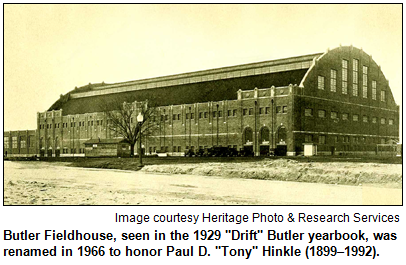 With the country captivated by the underdog teams guided by a values-based approach known as "the Butler Way," how many folks recall that during the 1970s and '80s, the Butler basketball program was, as David Woods puts it, in a "sorry state"?
With the country captivated by the underdog teams guided by a values-based approach known as "the Butler Way," how many folks recall that during the 1970s and '80s, the Butler basketball program was, as David Woods puts it, in a "sorry state"?
The Bulldogs were on the ropes even though their rich tradition dated to the 1920s, when legendary coach Tony Hinkle took command.
In 1928, the arena now known as Hinkle Fieldhouse opened with the largest seating capacity of any basketball stadium in the country. Now a National Historic Landmark, the fieldhouse is talked about, in David's words, "with a reverence associated with places of worship."
He adds: "When the court is lit by sunlight filtering in from tall windows above, nothing is missing but the choir."
At the end of the 1928-29 season, the Bulldogs' first in their fieldhouse, Butler was named national champion.
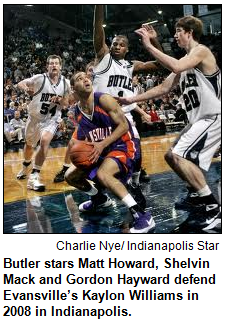 So why did the once-glorious basketball program hit the skids, before rebounding in such spectacular style?
So why did the once-glorious basketball program hit the skids, before rebounding in such spectacular style?
David Woods, the acclaimed Butler basketball reporter for The Indianapolis Star, will join Nelson in studio to explore that question and many others. David is the author of two books that have described the ups and downs of Butler basketball and analyzed its spectacular resurgence: Underdawgs (Scribner, 2010) and The Butler Way (Blue River Press, 2009).
Key figures range from Tony Hinkle, who is credited during the late 1950s with suggesting orange as the ideal color for basketballs (before that, they were muddy brown) to clean-cut Brad Stevens, the current coach who was just 33 years old during the first of his team's back-to-back appearances in the NCAA Championship game. Played in Butler's hometown of Indy, that tournament title game was, to quote Indianapolis Business Journal sports columnist Bill Benner, "the feel-good story of a lifetime."
The five principles of The Butler Way, as outlined by Butler athletics director Barry Collier, are humility, passion, unity, servant-hood and thankfulness. According to Underdawgs, Collier came up with the principles during a summer retreat in 1995 when he was Butler's coach. However, his successor as coach, Thad Mattta, is credited with coining the phrase "The Butler Way."
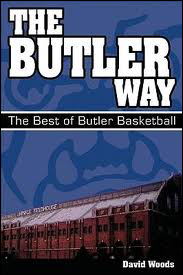 Genesis of the principles is said to stretch much further back - to beloved Tony Hinkle, who nurtured an unselfish, team-oriented style of play. A folk hero on campus during his 41 seasons as basketball coach, Hinkle (1898-1992) was the seventh-winningest coach in college basketball history when he resigned in 1970. At Butler, he also periodically coached football and baseball.
Genesis of the principles is said to stretch much further back - to beloved Tony Hinkle, who nurtured an unselfish, team-oriented style of play. A folk hero on campus during his 41 seasons as basketball coach, Hinkle (1898-1992) was the seventh-winningest coach in college basketball history when he resigned in 1970. At Butler, he also periodically coached football and baseball.
According to David's reporting in Underdawgs and The Butler Way, Hinkle didn't really want to step down as coach in 1970. University administrators at the time pushed him to do so, David writes, because they envied his popularity.
After Hinkle resigned as coach, Butler managed just five winning seasons out of the next 19. In his books, David emphasizes the two-decade stagnancy at Butler stretched beyond basketball.
The rebounds captivated the country, particularly Butler's unexpected run to the NCAA Championship game in 2010.
"A college version of Milan" is David's phrase in The Butler Way, a reference to the fabled 1954 state basketball tournament won by tiny Milan High School, thanks to a buzzer-beating shot by Bobby Plump. Lest anyone has forgotten: After his triumph at Milan, Plump was a star player at Butler, becoming the university's leading scorer in history until that time.
 The major difference between the "Milan Miracle" and Butler's appearance in the 2010 NCAA Championship game: The buzzer-beating shot by Butler player Gordon Hayward bounced off the rim, resulting in a win for perennial powerhouse Duke University.
The major difference between the "Milan Miracle" and Butler's appearance in the 2010 NCAA Championship game: The buzzer-beating shot by Butler player Gordon Hayward bounced off the rim, resulting in a win for perennial powerhouse Duke University.
Even so, the small-town Indiana comparisons extend to the personal stories of many Butler players. Matt Howard, the humble star of the 2010-11 team, grew up in Connersville as the eighth of 10 children. When Matt was born, the family lived in a house with one bathroom, according to Underdawgs. (Matt's father is a mail carrier.) For a portion of the interview with David, Nelson will be joined by Roadtripper correspondent Chris Gahl, a Butler alum who even has been known to commandeer Hinkle Fieldhouse for pickup hoops games. Regular listeners will recall he phoned in his Roadtrip report during such a game awhile back.
You can watch a video about the history of Indiana basketball and the iconic Hinkle Fieldhouse. This video excerpt, produced by Michael Husain of Indianapolis-based GoodVibesMedia, features interviews with Bill Benner, David Halberstam, Bobby Plump, Bob "Slick" Leonard and Angelo Pizzo, and it has great historic black-and-white footage of the 1954 Milan victory in Hinkle Fieldhouse.
Watch the video of CBS Sports' first national coverage of Butler Bulldogs in December of 2010 here.
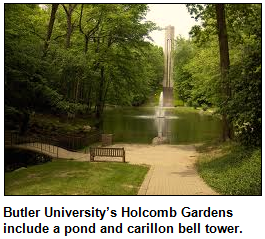 Roadtrip: Holcomb Gardens at Butler University
Roadtrip: Holcomb Gardens at Butler UniversityChris Gahl of the ICVA suggests a spot for quiet reflection right in the middle of Indianapolis's north side, Holcomb Gardens. The gardens are on the campus of Butler University at 4600 Sunset Ave., just southwest of Hinkle Fieldhouse, and are free and open to the public.
Nestled along the Central Canal on 20 acres of prime real estate, the Holcomb Gardens include a pond, a statue of the Greek goddess Persephone, a carillon tower, an observatory and plenty of places to stroll, sit and relax. More information about tours is available by calling (317) 940-8000.
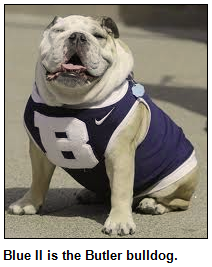 The bulldog mascot at Butler University was nothing new to a well-known player or former player on the basketball team. The player, who competed on at least one of the teams that made the NCAA championship final games during the last two years, had attended an Indiana high school that also has a bulldog mascot.
The bulldog mascot at Butler University was nothing new to a well-known player or former player on the basketball team. The player, who competed on at least one of the teams that made the NCAA championship final games during the last two years, had attended an Indiana high school that also has a bulldog mascot.
Question: Name the player and his high school alma mater.
To win the prize, you must call in with the correct answer during the live show. Please do not call if you have won a prize from any WICR show during the last two months. The call-in number is (317) 788-3314, and please do not call until you hear Nelson pose the question on the air. The prize is a gift certificate to Eddie Merlot's on the north side of Indianapolis, courtesy of the ICVA.
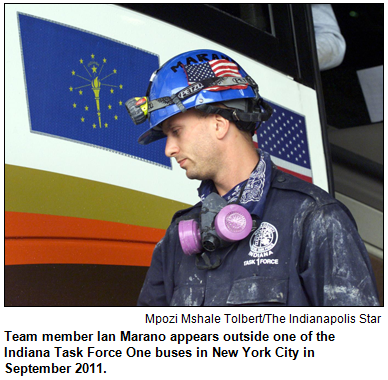 (Sept. 3, 2011) - Most Americans never will forget where they were on 9-11-01 and how their lives have changed since the terrorist attacks 10 years ago. Sixty-two professional rescuers from Indiana and their 12-member support crew have firsthand insights about the tragedy because they searched for survivors on Ground Zero in the aftermath that left the Twin Towers in New York City as still-smoldering ruins when they arrived.
(Sept. 3, 2011) - Most Americans never will forget where they were on 9-11-01 and how their lives have changed since the terrorist attacks 10 years ago. Sixty-two professional rescuers from Indiana and their 12-member support crew have firsthand insights about the tragedy because they searched for survivors on Ground Zero in the aftermath that left the Twin Towers in New York City as still-smoldering ruins when they arrived.
Indiana Task Force One, one of 28 elite rescue teams across the country designed to quickly assemble and respond to catastrophes, consisted of Hoosier firefighters, emergency medical technicians, engineers, search-dog handlers and other highly trained specialists. Nelson's studio guests will be two Hoosiers who were at Ground Zero with the rescuers.
Tom Spalding, then the public safety reporter for The Indianapolis Star, filed daily dispatches as he accompanied the Indiana task force for "up-close and personal" looks at their overwhelming mission.
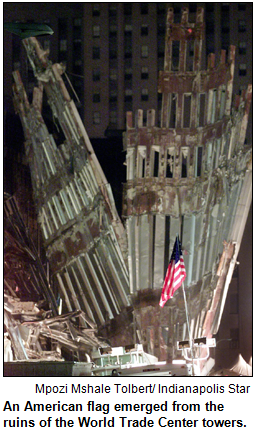 Anne McCurdy managed what Tom has described as the "most popular component" of the task force: the search-and-rescue dogs. In addition to being the training director and manager of the K-9 unit for Indiana Task Force One, Anne is manager of research for Methodist Hospital/IU Health in Indianapolis.
Anne McCurdy managed what Tom has described as the "most popular component" of the task force: the search-and-rescue dogs. In addition to being the training director and manager of the K-9 unit for Indiana Task Force One, Anne is manager of research for Methodist Hospital/IU Health in Indianapolis.
"The air was smoky from still-smoldering underground fires, but it was no longer 'snowing' - the term I'd come up with to describe the floating bits of ash," Tom wrote in a subsequent account in Traces of Indiana and Midwestern History, the Indiana Historical Society's magazine.
He arrived with a night-shift crew (the rescue work was continuing 24-7 at that point) in gear that included a helmet, mask, goggles and steel-toed boots.
In addition to Anne, who lives in Fountaintown, Indiana Task Force One members on the scene included dog handlers from South Bend, Newburgh and Lebanon, as well as firefighters from Pike, Washington, Warren and Decatur townships in Indianapolis. Some barely escaped being burned alive when a 50-foot wall of fire shot up during an underground search.
Many listeners will recall that Indiana Task Force One rescuers were greeted by a cheering crowd of 3,000 on Monument Circle when they returned after their 10-day assignment.
 Some of the Indiana Task Force One members had been among the first "boots on the ground" from across the country at Ground Zero after the twin suicide hijackings of airplanes that crashed into the World Trade Center's 110-story towers.
Some of the Indiana Task Force One members had been among the first "boots on the ground" from across the country at Ground Zero after the twin suicide hijackings of airplanes that crashed into the World Trade Center's 110-story towers.
Not only does this month mark the 10th anniversary of the attacks, it is the 20th anniversary of the formation of Indiana Task Force One. In September 1991, the Indiana force was designated by the federal government as one of the first teams set up to respond to catastrophic events.
Later this month in downtown Indianapolis, a permanent memorial to the 9-11 victims will be dedicated. Topped by a 450-pound bronze eagle sculpted by an Indianapolis firefighter, the memorial will include engraved granite tablets flanked by steel beams from the World Trade Center. The memorial, which will be dedicated on Sept. 11, will be at 421 W. Ohio St., overlooking the downtown canal.
When Indiana Task Force One responded to the 9-11 tragedy, it was the team's first mission in two years. 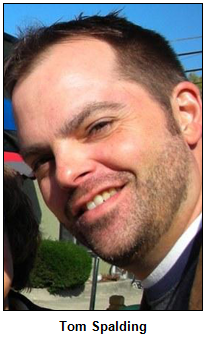 Anne McCurdy participated in the task force's first deployment, a mission to Lafayette in 1994 in response to a tornado that struck a trailer park.
She also has been deployed to hurricanes Floyd, Isabel, Katrina and Rita. Her search-and-rescue dog, Mercedes, is certified at the highest level by the Federal Emergency Management Agency (FEMA).
Anne McCurdy participated in the task force's first deployment, a mission to Lafayette in 1994 in response to a tornado that struck a trailer park.
She also has been deployed to hurricanes Floyd, Isabel, Katrina and Rita. Her search-and-rescue dog, Mercedes, is certified at the highest level by the Federal Emergency Management Agency (FEMA).
As the task force of Hoosiers searched for survivors at Ground Zero, some members, including a Pike Township firefighter, were burned during flare-ups in the underground ruins. In his Traces article, Tom described how other Hoosier firefighters could have been "burned alive" during the search. They survived because they found a protective air pocket in which to hide.
When Tom accompanied a night shift to Ground Zero four days after the tragedy, the team encountered, as he puts it, "two unrecognizable skyscrapers that were coated with an eerie, bland, tan-and-gray dust."
Amid the rubble, Tom noticed remnants of office cubicles adorned with photos that depicted smiling people with their arms around each other.
Search-and-rescue dogs, including those overseen by Anne, are trained to climb atop debris that is, as Tom put it, "unstable and hot" as the K-9 units hunt for survivors.
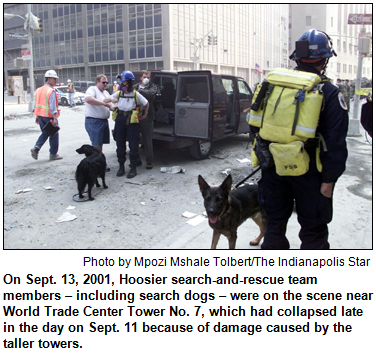 Video footage of the rescue work by Indiana Task Force One has been used to train firefighters across the state, according to Tom's article.
Video footage of the rescue work by Indiana Task Force One has been used to train firefighters across the state, according to Tom's article.
"In the subsequent year, I thought the (Hoosier) task force members would become celebrities, but they did not," Tom added. "They simply returned to the old jobs they had left."
Earlier this year, Tom left The Star to become a public relations executive in Indy. He has stayed in regular contact with many of the task force members, including Anne. She is the editor of DogTalk, the unofficial newsletter for FEMA dog handlers.
In New York City, the National September 11 Memorial and Museum will open Sept. 12 on the site of the World Trade Center. The memorial will include one-acre reflecting pools in the footprints of the leveled towers, as well as bronze panels inscribed with the names of victims.
 Chris Gahl of the ICVA suggests we head east from Indianapolis along the Old National Road, U.S. 40 (or, well, you can take the interstate) to the grand opening of the National Road Heritage Site in Cambridge City at Indiana Landmarks' 1841 Huddleston Farmhouse.
Chris Gahl of the ICVA suggests we head east from Indianapolis along the Old National Road, U.S. 40 (or, well, you can take the interstate) to the grand opening of the National Road Heritage Site in Cambridge City at Indiana Landmarks' 1841 Huddleston Farmhouse.
The grand opening at the site will be Saturday, Sept. 10 with a free open house from 10 a.m. to 4 p.m., and in conjunction with the Cambridge City Canal Days festival.
The Huddleston Farmhouse has been closed for two years in preparation for the new exhibits, which tell the 200-year story of the National Road from its start in Cumberland, Md., in 1806 through Indiana in mid-1820s, to its end in Vandalia, Ill. Visitors will be able to hear from a covered-wagon traveler about the conditions on the road, the food they ate and where they found lodging. More information at www.indianalandmarks.org.
The Soldiers and Sailors Monument in downtown Indianapolis was built to honor Hoosiers lost in the Civil War, although for many it has come to symbolize people from Indiana who have sacrificed in all wars. Since the monument's dedication in 1902, it has been topped by a bronze sculpture known as Victory, or Miss Indiana.
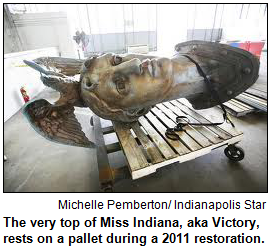 The sculpture, which holds a torch and a sword, has been down for repairs since April, but she was recently returned for public display on Monument Circle. Victory is scheduled to be hoisted to her usual position atop the monument on Sept. 6 (Tuesday), where she has always faced a certain direction.
The sculpture, which holds a torch and a sword, has been down for repairs since April, but she was recently returned for public display on Monument Circle. Victory is scheduled to be hoisted to her usual position atop the monument on Sept. 6 (Tuesday), where she has always faced a certain direction.
Question: Has Victory faced north, south, east or west? And what is the symbolic reason it faces that direction?
To win the prize, you must call in with the correct answer during the live show. Please do not call if you have won a prize from any WICR show during the last two months. The call-in number is (317) 788-3314, and please do not call until you hear Nelson pose the question on the air.
The prize is an overnight stay at the Hyatt Regency downtown Indianapolis, as well as a gift certificate to Wheel Fun Rentals down along the canal. The prizes are courtesy of the ICVA.
(Aug. 27, 2011) - Our host, author/historian Nelson Price, calls himself a "garbage can of useless Hoosier trivia." He's the first to concede he doesn't have all the answers and that he easily can be stumped.  But because Nelson's career has been devoted to interviewing famous Hoosiers, researching historic Indiana figures and exploring the state's heritage, he is a trove of anecdotes and insights - and he loves to share them.
But because Nelson's career has been devoted to interviewing famous Hoosiers, researching historic Indiana figures and exploring the state's heritage, he is a trove of anecdotes and insights - and he loves to share them.
Wonder what it was like to interview David Letterman, Kurt Vonnegut or Florence Henderson? Or to live next door to Reggie Miller? (The former Indiana Pacers superstar was Nelson's next-door neighbor in downtown Indy for about four years.)
This show was a caller opportunity to phone Nelson, turn the tables, and interview him, our "connoisseur of all things Hoosier," about any Indiana-related topic.
A fifth-generation Hoosier who grew up in Indianapolis (his family lived two blocks from the home of a rising star in local media, Jane Pauley), Nelson particularly welcomes questions about the heritage of his hometown, as well as of famous people from across the state.
For this show, Hoosier History Live! opened the phone lines so listeners could call the WICR-FM studio and ask Nelson any burning (or even slow-simmering) questions.
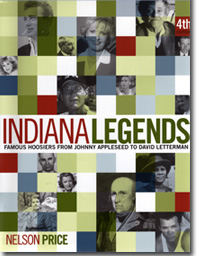 He's the author of several books, including Indiana Legends: Famous Hoosiers from Johnny Appleseed to David Letterman (Hawthorne Publishing), which features profiles and vignettes of more than 160 notables. They range from frontier characters to entrepreneurs such as Madam Walker and popcorn king Orville Redenbacher to notorious figures, including John Dillinger.
He's the author of several books, including Indiana Legends: Famous Hoosiers from Johnny Appleseed to David Letterman (Hawthorne Publishing), which features profiles and vignettes of more than 160 notables. They range from frontier characters to entrepreneurs such as Madam Walker and popcorn king Orville Redenbacher to notorious figures, including John Dillinger.
Among famous Hoosiers also are astronauts, Olympic athletes, movie stars and politicians - not to mention spiritual leaders such as Mother Theodore Guerin, a pioneer Catholic nun who was named Indiana's first saint.
Nelson's books also include Indianapolis Then and Now (Thunder Bay Press), a visual history of the Hoosier capital. The book, a collaboration with photo historian Joan Hostetler and photographer Garry Chilluffo, features historic and contemporary images of about 70 sites in Indy. Before-and-after histories abound, from Broad Ripple, Beech Grove and Speedway to Monument Circle, Woodruff Place and Fort Harrison.
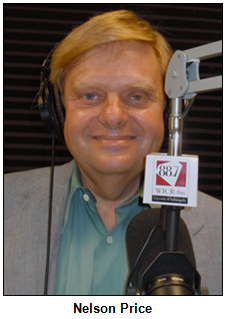 Other images in the book include historic Camp Morton (a Union Army training center and Confederate prisoner-of-war camp during the Civil War) and the beloved Tee Pee Restaurant, a popular "cruising" destination near the Indiana State Fairgounds that was demolished in the late 1980s.
Other images in the book include historic Camp Morton (a Union Army training center and Confederate prisoner-of-war camp during the Civil War) and the beloved Tee Pee Restaurant, a popular "cruising" destination near the Indiana State Fairgounds that was demolished in the late 1980s.
Ever wonder what was on the site of the former RCA Dome in the early 1900s? Or who lived on Monument Circle in the mid-1800s, when it was known as Governor's Circle and consisted almost entirely of private residences and churches?
And are you curious about why Indiana governors and their families absolutely refused to move into the residence built for them on the current site of the Soldiers and Sailors Monument?
In addition to writing Indiana-focused books, Nelson has been a commentator for years on tours across the state. So he's full of anecdotes about Hoosier landmarks, ranging from Culver Military Academy (Nelson has taken his "crew" of travelers aboard the Ledbetter, a three-mast ship used to train Culver cadets to sail) to the Slippery Noodle Inn in Indianapolis (dating to 1850, "the Noodle" is the state's oldest tavern operating on its original location) and sites in New Harmony associated with the two waves of Utopia seekers in the early 1800s.
Some fun facts that may inspire some questions:
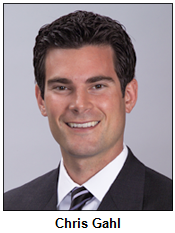 Roadtrip: Abraham Lincoln, Hoosier hero at Fringe 2011
Roadtrip: Abraham Lincoln, Hoosier hero at Fringe 2011Chris Gahl of the ICVA tells us that it's not too late to take in a Fringe Festival show about one of Indiana's most distinguished citizens: Abraham Lincoln. Our 16th president lived in Indiana from the age of 7 to 21. His character was shaped by his formative Hoosier years! Danny Russell's play may be seen the weekend of Aug. 26-27 at the Phoenix Theatre. Visit the Fringe website for more info.
And, a big Hoosier History Live! congratulations to Chris for his promotion to vice president of marketing and communications at the Indianapolis Convention and Visitors Association!
Earlier this summer, a well-known Hoosier appeared as a guest on Hoosier History Live! shortly before being named a Living Legend by the Indiana Historical Society. He or she is featured in host Nelson Price's book, Indiana Legends: Famous Hoosiers from Johnny Appleseed to David Letterman, and was named a Living Legend, along with a longtime professional collaborator.
Question: Name the Legend-to-be who was a studio guest this summer.
To win the prize, you must call in with the correct answer during the live show. Please do not call if you have won a prize from any WICR show during the last two months. The call-in number is (317) 788-3314, and please do not call until you hear Nelson pose the question on the air.
The prize is an overnight stay at the Embassy Suites, Indianapolis North, including two hours of complimentary cocktails at the evening Manager's Reception, and cooked-to-order breakfast the following morning. The prize is courtesy of the ICVA.
 (Aug. 20, 2011 - encore presentation) - In 1934, an 8-year-old boy who lived in Irvington - and who would grow up to become one of the best-known TV news anchors in Indianapolis history - patronized a theater for the first time. It was Loew's Palace at 35 N. Pennsylvania St., where young Howard Caldwell was captivated by a movie, which was followed by a stage show.
(Aug. 20, 2011 - encore presentation) - In 1934, an 8-year-old boy who lived in Irvington - and who would grow up to become one of the best-known TV news anchors in Indianapolis history - patronized a theater for the first time. It was Loew's Palace at 35 N. Pennsylvania St., where young Howard Caldwell was captivated by a movie, which was followed by a stage show.
Although Loew’s Palace is long gone, its essence is captured in a book by Howard, who became a familiar face - and often was described as "Indiana's Walter Cronkite" - during his long career at WRTV-Channel 6.
His book, The Golden Age of Indianapolis Theaters (IU Press), not only explores the city's majestic theaters, many of them bygone or renovated for other uses, it also analyzes the Hoosier capital's theater-going heritage.
 Howard joins Nelson in studio to delve into the colorful history that was kicked off in September 1858 when the Metropolitan, the city's first theater, opened at 148 W. Washington St. with a seating capacity of more than 1,700. The Metropolitan later became known as the Park, then as the Capitol when it was a burlesque house as it declined before closing in the 1930s.
Howard joins Nelson in studio to delve into the colorful history that was kicked off in September 1858 when the Metropolitan, the city's first theater, opened at 148 W. Washington St. with a seating capacity of more than 1,700. The Metropolitan later became known as the Park, then as the Capitol when it was a burlesque house as it declined before closing in the 1930s.
 In the 1860s, famous actors who performed at "the Met" included none other than John Wilkes Booth. That's chilling, but details associated with other theaters evoke other emotions, as described in Howard's book.
In the 1860s, famous actors who performed at "the Met" included none other than John Wilkes Booth. That's chilling, but details associated with other theaters evoke other emotions, as described in Howard's book.
The lavish English Theater and Opera House on Monument Circle (along with an ornate, adjoining hotel) became an Indy landmark for decades. In 1902, a production at the English of Lew Wallace's Ben-Hur featured "eight horses pulling two chariots on treadmills, powered by electricity," creating a sensation.
Howard's book also features insights about the Circle Theater (now called the Hilbert Circle Theatre), the Murat, which opened in 1910 with a revolving stage considered a national innovation, and the Walker Theatre, which was planned by entrepreneur Madam Walker and opened in the 1920s after her death.
 Howard and Nelson explore those, as well as the theaters that did not survive, such as Loew's Palace and the Lyric on North Illinois Street, which presented three vaudeville shows a day when it opened in 1912.
Howard and Nelson explore those, as well as the theaters that did not survive, such as Loew's Palace and the Lyric on North Illinois Street, which presented three vaudeville shows a day when it opened in 1912.
Although Howard is a lifelong theater lover, he forever will be associated with broadcasting. The anchor on WRTV's evening news for its debut in 1959, he has won countless awards and been inducted into several halls of fame. This summer, Howard was honored with the Golden Circle Award by the National Academy of Television Arts and Sciences (watch video here). Cited for lifetime achievement, Howard is one of only six people to receive the honor in the 42-year history of the academy's Lower Great Lakes chapter.
This show is an encore broadcast of a popular program in our Hoosier History Live! archives. (The original broadcast date was July 31, 2010.) So there won’t be an opportunity for call-in questions from listeners. But that opportunity will return Aug. 27 with a brand new Hoosier History Live! show.
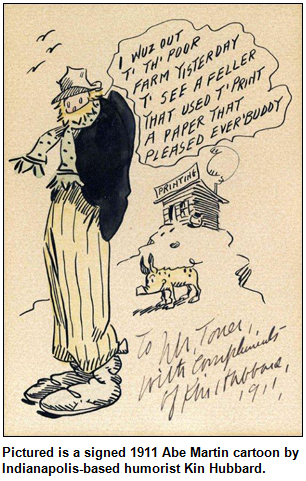 (Aug. 13, 2011) - Whether creating visual commentary about tragedies such as the 9/11 terrorist attacks (the 10th anniversary of which is a month away) or creating mythical characters such as Brown County's cracker-barrel philosopher Abe Martin and whimsical Raggedy Ann, Hoosier political cartoonists have been at the cultural epicenter.
(Aug. 13, 2011) - Whether creating visual commentary about tragedies such as the 9/11 terrorist attacks (the 10th anniversary of which is a month away) or creating mythical characters such as Brown County's cracker-barrel philosopher Abe Martin and whimsical Raggedy Ann, Hoosier political cartoonists have been at the cultural epicenter.
By the way, did you know that other iconic images created by political cartoonists (albeit non-Hoosiers) include Uncle Sam and Santa Claus?
To explore the rich heritage of political cartooning - including images that range from lighthearted to poignant to controversial - Nelson will be joined in studio by Gary Varvel, the award-winning political cartoonist for The Indianapolis Star. Gary, whose work is syndicated to more than 100 newspapers through Creators Syndicate, has created dozens of images that have made readers' blood boil, provoked them to laugh or inspired them to think.
But probably his best-known cartoon was drawn in reaction to the terrorist attacks on Sept. 11, 2001. A depiction of a weeping Uncle Sam holding a limp firefighter while the smoldering skyline of New York City crumbles in the background, the cartoon resulted in requests for copies from thousands of readers.
Born in 1957, Gary grew up in Danville. He joined the former Indianapolis News in the late 1970s, then became The Star's political cartoonist in 1994, replacing Pulitzer Prize-winning cartoonist Charlie Werner.
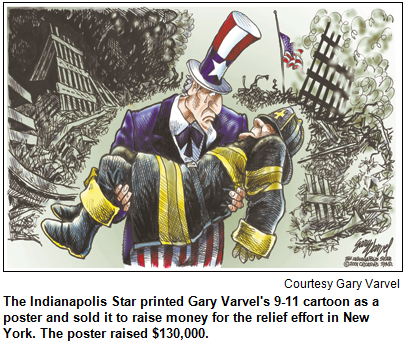 Gary plans to share insights about the cartoons of Werner (who last April was inducted posthumously into the Indiana Journalism Hall of Fame), along with insights about his own work. It recently has included a compelling "eye-for-an-eye" image when al-Qaeda leader Osama bin Laden was killed in May by Navy SEALs after being discovered in Pakistan.
Gary plans to share insights about the cartoons of Werner (who last April was inducted posthumously into the Indiana Journalism Hall of Fame), along with insights about his own work. It recently has included a compelling "eye-for-an-eye" image when al-Qaeda leader Osama bin Laden was killed in May by Navy SEALs after being discovered in Pakistan.
Nelson and Gary also will explore the impact of Abe Martin, the fictional character (sample quip: "You can take a voter to the polls, but you can't make him think") created in 1904 by Indianapolis News cartoonist Frank McKinney "Kin" Hubbard (1868-1930). His homespun wisdom became enormously popular across the country.
More than 50 years after Hubbard's death, Abe Martin cartoons continued to be reprinted in The News during the 1980s. By that point, Gary Varvel was on the staff of the afternoon newspaper as chief artist. He had been recommended for the job by Jerry Barnett, the editorial cartoonist for The News, whose work Gary also will discuss during our show. In addition, he will share insights about the work of former News cartoonist Robbie Robinson.
 Gary studied at the Herron School of Art at IUPUI, worked at The News for 16 years and then became editorial cartoonist at The Star.
Gary studied at the Herron School of Art at IUPUI, worked at The News for 16 years and then became editorial cartoonist at The Star.
His 9/11 cartoon, which The Star printed as a poster for sale, raised $130,000 for relief efforts in New York.
His cartoons - created from the perspective of a political conservative - have appeared on CNN and in publications ranging from Newsweek, Time and The New York Times to the National Review and Sports Illustrated. Gary lives in Brownsburg with his wife and three children.
His predecessor Charlie Werner (1909-1997) lampooned everyone from presidents and popes to Hoosier mayors and civic leaders. President Lyndon Johnson, a frequent target, was said to be so impressed he requested that 14 original Werner cartoons be preserved with his presidential papers.
 As for Raggedy Ann: The book series and dolls were created by former Indianapolis Star cartoonist Johnny Gruelle (1880-1938), who grew up near the Lockerbie neighborhood in Indianapolis. Names and traits of his famous creation were inspired by blending two of his favorite James Whitcomb Riley poems: "The Raggedy Man" and "Little Orphant Annie."
As for Raggedy Ann: The book series and dolls were created by former Indianapolis Star cartoonist Johnny Gruelle (1880-1938), who grew up near the Lockerbie neighborhood in Indianapolis. Names and traits of his famous creation were inspired by blending two of his favorite James Whitcomb Riley poems: "The Raggedy Man" and "Little Orphant Annie."
As an adult, Gruelle created the Raggedy Ann character for bedside stories he told to his 13-year-old daughter, Marcella, to distract her from a mysterious illness, perhaps a reaction to an infected vaccination she had received at school. Marcella Gruelle died in 1915; three years later, the first book of adventures, The Raggedy Ann Stories, made its debut. The floppy rag dolls were side products to promote the books, but they quickly created a sensation.
So did the Abe Martin cartoons. Hubbard, who lived in the Irvington neighborhood of Indianapolis for most of his career, placed the bumpkin philosopher in hilly Brown County because it was considered the state's poorest, most isolated county 100 years ago. The idea of folk wisdom emanating from the county was considered humorous by itself. (At one point, Hubbard was reluctant to visit Brown County because he feared resentful locals would harass him.) When Hubbard died at the peak of his national fame in 1930, no less than Will Rogers called him "America's greatest humorist."
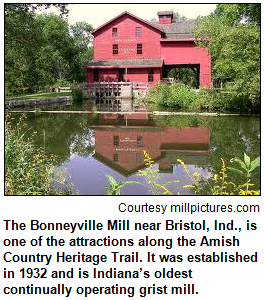 Roadtrip: Amish country in Elkhart County
Roadtrip: Amish country in Elkhart CountyChris Gahl of the ICVA suggests that you head north from Indianapolis to visit Amish Country in Elkhart County, where you can take a self-guided tour on Elkhart County's nationally recognized Heritage Trail. Stop by the visitor's center in Elkhart to pick up a complimentary map and audio CD that guides you, at your own pace, through Wakarusa, Nappanee, Goshen, Shipshewana, Middlebury and Elkhart. Or you can download tour audio and a map.
The Amish Country Heritage Trail was USA Today's Readers Choice top heritage trail pick in 2010. More information at www.amishcountry.org or (800) 860-5949.
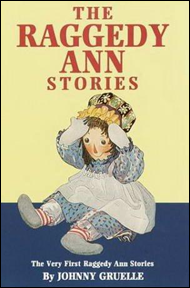 Raggedy Ann dolls initially were spin-off products created to promote a series of books, beginning with Raggedy Ann Stories in 1918, written and illustrated by former Indianapolis Star cartoonist Johnny Gruelle. The floppy rag dolls, which at first were hand-made by Gruelle family members, became immediate sensations.
Raggedy Ann dolls initially were spin-off products created to promote a series of books, beginning with Raggedy Ann Stories in 1918, written and illustrated by former Indianapolis Star cartoonist Johnny Gruelle. The floppy rag dolls, which at first were hand-made by Gruelle family members, became immediate sensations.
Many of the early Raggedy Ann dolls were created with a special feature sewn into them. It was made of cardboard in some cases, candy in others.
Question: What was this special feature?
Hint: It could be felt by children when they hugged their Raggedy Ann dolls.
The prize was two tickets to the Indy Fringe Festival, Aug. 19-28, courtesy of IndyFringe, as well as an overnight stay for two at the Hilton Indianapolis in downtown Indy, courtesy of the ICVA.
(Aug. 6, 2011) - In May, Hoosier History Live! focused on the hosts of two daily TV shows who became icons to thousands of Baby Boomer and Gen X children across central Indiana and beyond. Janie Woods Hodge, known on the air as simply "Janie" during her spectacular run on WTTV-Channel 4, joined Nelson in studio. So did civic leader Pat Garrett Rooney, who was the host of Kindergarten College on Channel 13 (then an ABC affiliate) during the mid-1960s.
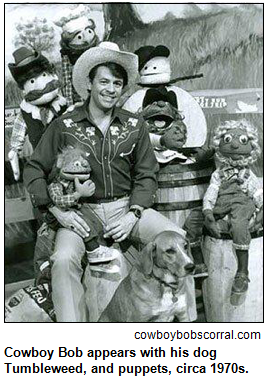 Despite their incalculable impact - Janie's show, initially called Popeye and Janie, then just Janie, was syndicated to TV markets from Illinois to West Virginia - our earlier guests weren't the only icons of children's TV to have been based in Indy.
Despite their incalculable impact - Janie's show, initially called Popeye and Janie, then just Janie, was syndicated to TV markets from Illinois to West Virginia - our earlier guests weren't the only icons of children's TV to have been based in Indy.
Another icon even made an album of Christmas songs with Janie that has been re-mastered and is available as a CD. He also sang campfire songs, shared safety and exercise tips, had a dog sidekick named Tumbleweed and rode a horse named Skye.
Of course, we're talking about Bob Glaze, far better known as Cowboy Bob to thousands of Hoosier fans of his series - initially called Chuckwagon Theatre, then Cowboy Bob's Corral - which aired on WTTV from 1969 to the late 1980s.
To join Nelson in studio as we follow up our earlier show about children's TV history, Cowboy Bob briefly said farewell to his beloved abode, which is about as close as a Hoosier can get to a ranch: Bob and his wife, Gail, a pilot for United Airlines, live in a sprawling, rustic house on more than six acres in Morgan County near Martinsville. (Tumbleweed, who died in 1983, is buried on the property.)
A lifelong fitness enthusiast and music lover, Cowboy Bob was born in 1942 and is a proud grad of Culver Military Academy (class of 1960) in northern Indiana. In fact, his current endeavors include being the key organizer (or wrangler?) of the Culver Club of the Indianapolis Rowing Team, a group of Culver alums and their friends who train at Eagle Creek Reservoir. Cowboy Bob and Gail also are avid scuba divers.
 During the early 1960s - before his big break in TV, which he credits to Janie - Bob gained attention for his singing and toured with the Chad Mitchell Trio as a warm-up act.
During the early 1960s - before his big break in TV, which he credits to Janie - Bob gained attention for his singing and toured with the Chad Mitchell Trio as a warm-up act.
He started at WTTV as a camera operator in 1966, eventually joining Janie on-camera in commercials. Initially seen only in silhouette, Bob sang a jingle with her that touted a soft drink; in fact, his on-air handle was "Mountain Dew Bob" before the cowboy gig came his way by happy accident. (Nelson will ask him to share details during the show.)
In addition to Tumbleweed and Skye, Cowboy Bob's shows featured a puppet named Sourdough the Singing Biscuit.
A hit on the nostalgia circuit now, Cowboy Bob and Janie often appear in parades and at festivals across Indiana. Songs that Cowboy Bob recorded several years ago during the Parke County Covered Bridge Festival - along with an assortment of other tunes, including original recordings he made as an Indiana University student in the early 1960s - are featured on a CD titled Bridges. For more info about it, the Christmas album and other Cowboy Bob memorabilia, including boot-shaped mugs, visit cowboybobscorral.com.
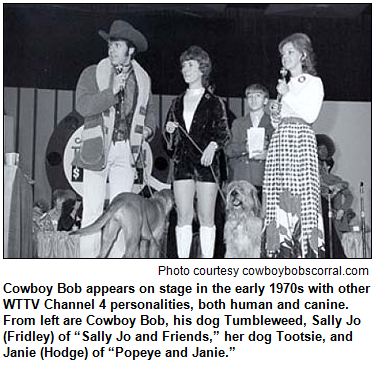 Suffice it to say that anecdotes abound from Cowboy Bob's long run as a children's TV icon. During our show, he shares, for instance, an incident involving a buffalo at the Indiana State Fair that unfolded on live TV.
Suffice it to say that anecdotes abound from Cowboy Bob's long run as a children's TV icon. During our show, he shares, for instance, an incident involving a buffalo at the Indiana State Fair that unfolded on live TV.
Some fun facts:
Watch videos of Cowboy Bob here:
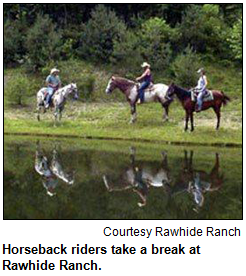 Roadtrip: Rawhide Ranch in Brown County
Roadtrip: Rawhide Ranch in Brown CountyChris Gahl of the ICVA suggests that you visit a western-style dude ranch located in the hills of southern Brown County: the Rawhide Ranch! It's a place where Cowboy Bob could ease right into the saddle.
The Rawhide Ranch is located on State Road 135 south of Nashville, just before you get to the picturesque village of Story. The ranch offers public horseback rides seven days a week, every hour on the hour, between 10 a.m. and 4 p.m. You also can stay overnight in one of the 11 motel rooms over the barn. Happy trails!
In addition to Cowboy Bob and Janie, WTTV-Channel 4's lineup of popular personalities during the 1960s and '70s included horror film host Sammy Terry. 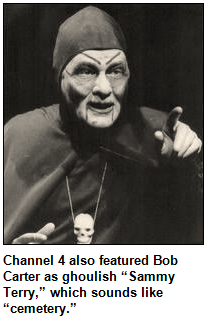 His show, originally called "Shock Theater" and then "Nightmare Theater," became a camp classic for thousands of Hoosier viewers.
His show, originally called "Shock Theater" and then "Nightmare Theater," became a camp classic for thousands of Hoosier viewers.
During most shows, ghoulish Sammy Terry (whose real name was Bob Carter) would emerge from a coffin. Then he often bantered with a sidekick, a spider who sometimes seemed to float. Other times, the spider dangled from a string.
Question: What was the name of the spider sidekick on Sammy Terry's show?
The prize was two tickets to Conner Prairie, courtesy of the ICVA, as well as two tickets to the Indy Fringe Festival, Aug. 19-28, courtesy IndyFringe.
(July 30, 2011) - City hall "museum" may overstate it a bit.
But the University of Indianapolis is planning to preserve "the Indianapolis story" - that is, the unfolding of the city's modern history, including the creation of Unigov, the arrival of the Indianapolis Colts and the development of Circle Centre Mall - by creating an archive for papers and artifacts from a parade of mayors stretching back more than 30 years.
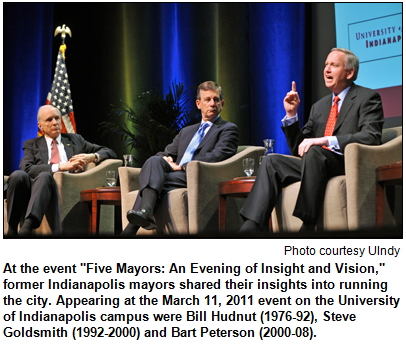 A trio of distinguished guests, including UIndy president Beverley Pitts, join Nelson in studio to share details about the Institute for Civic Leadership and Mayoral Archives under way on campus.
A trio of distinguished guests, including UIndy president Beverley Pitts, join Nelson in studio to share details about the Institute for Civic Leadership and Mayoral Archives under way on campus.
The archives are an ever-evolving collection of documents, speeches, audiotapes and photos from mayors, including Richard Lugar, William Hudnut, Stephen Goldsmith and Bart Peterson. The collection currently consists of more than 450 boxes stored at Krannert Memorial Library.
"Clearly this historical treasure trove should not merely be safeguarded, but also must be made accessible to the researchers, students and rising community leaders - in Indianapolis and elsewhere - who can put the lessons to use," Michael O'Connor, former chief deputy mayor in the Bart Peterson administration, wrote in a recent column in The Indianapolis Star.
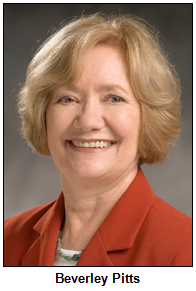 By "lessons," Mike, who long has been identified as Peterson's closest advisor, was referring to the city's transformation from a sleepy Hoosier capital nicknamed "Naptown" to a metro area known for its rejuvenated downtown and an array of other changes since the late 1960s.
By "lessons," Mike, who long has been identified as Peterson's closest advisor, was referring to the city's transformation from a sleepy Hoosier capital nicknamed "Naptown" to a metro area known for its rejuvenated downtown and an array of other changes since the late 1960s.
A Democrat, Mike is now director of state government affairs for Eli Lilly & Co., where he again works with his longtime boss Peterson, now a Lilly executive; he joins Nelson and Dr. Pitts in studio.
So does Robert Vane, a Republican and former deputy chief of staff/communications director for Mayor Greg Ballard. Emphasizing the bipartisan nature of the "museum" or archives - as well as other mayoral initiatives at UIndy - Mayor Ballard participated last spring in a historic "community conversation" on campus with Lugar, Hudnut, Goldsmith and Peterson.
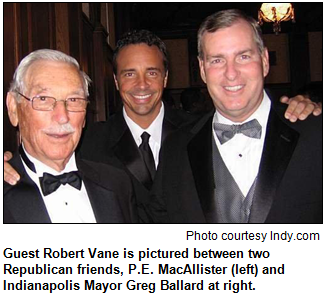 Former staffers for the one-time mayors, including Mike O’Connor and Anne Shane, mayoral chief of staff in the Goldsmith administration, serve on a steering committee to raise funds for the Institute for Civic Leadership & Mayoral Archives. According to UIndy, the $7.5 million capital campaign is designed to fund several initiatives, including cataloguing and digitizing the trove of archives in storage.
Former staffers for the one-time mayors, including Mike O’Connor and Anne Shane, mayoral chief of staff in the Goldsmith administration, serve on a steering committee to raise funds for the Institute for Civic Leadership & Mayoral Archives. According to UIndy, the $7.5 million capital campaign is designed to fund several initiatives, including cataloguing and digitizing the trove of archives in storage.
The involvement of the University of Indianapolis with former mayors stretches back at least to Lugar. Indiana's senior U.S. senator briefly taught at UIndy after serving two terms as mayor (1968-1976) and overseeing the creation of Unigov, which merged many aspects of Marion County and city governments.
The UIndy campus also is the setting for the Lugar Center for Tomorrow's Leaders. Since 1977, Lugar has invited high school juniors from across Indiana to participate in a symposium for future leaders.
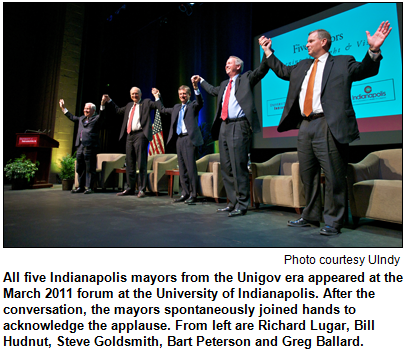 Dr. Pitts was named UIndy's president in July 2005, but her Indiana roots extend much further back. Before coming to UIndy, she served as provost and vice president for academic affairs at Ball State University; she even served as acting president of Ball State in 2004.
Dr. Pitts was named UIndy's president in July 2005, but her Indiana roots extend much further back. Before coming to UIndy, she served as provost and vice president for academic affairs at Ball State University; she even served as acting president of Ball State in 2004.
An accomplished journalist, she once was a writer and communications director for the National Football League (NFL) Players Association in Washington D.C.
Speaking of pro football, the luring of the city's first NFL team in 1984 - a dramatic development that created an enormous impact, with the Colts moving to the then-Hoosier Dome under the cover of darkness - is among the episodes discussed in the trove of archival material from former mayors.
The Colts' arrival occurred during Hudnut's record-breaking four terms. Hudnut occupied the top city office - located on the 25th floor of the City-County Building - from 1976 to 1992.
Other insights:
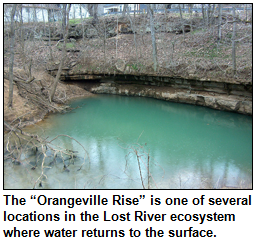 Chris Gahl of the ICVA suggests we head south to the Lost River in Washington and Orange counties in southern Indiana. The Lost River starts out as a normal river and suddenly becomes "lost" by gurgling underground and making its secret course beneath the surface for about eight miles before rising to the surface again. Sinkholes are also in abundance near the unusual river.
Chris Gahl of the ICVA suggests we head south to the Lost River in Washington and Orange counties in southern Indiana. The Lost River starts out as a normal river and suddenly becomes "lost" by gurgling underground and making its secret course beneath the surface for about eight miles before rising to the surface again. Sinkholes are also in abundance near the unusual river.
The Hoosier Chapter of the Sierra Club says that the Lost River is one of the most complex hydrological systems in the world.
This Roadtrip was recommended by Hoosier History Live! listener Daina Chamness. The Lost River Conservation Association believes that "Indiana's Lost River Karst Aquifer System" must be viewed in the context of the total river system to be fully appreciated. It offers free tours open to the public, and the tours are done in your own car. For more information about the tours, click here.
A distinctive item of apparel frequently worn by Indianapolis Mayor William Hudnut during the notorious Blizzard of 1978 became locally famous. Amid the blizzard that's generally considered the worst in Indianapolis history, Mayor Hudnut wore the item of apparel while riding with the city's snow plows, appearing on TV news and guiding the Hoosier capital through what he later called "the most important political event of my life."
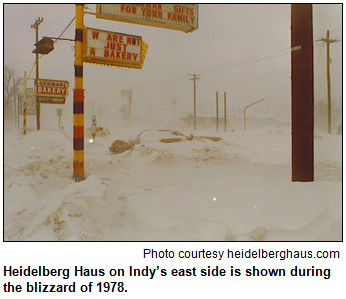 Note: Hoosier History Live! aired a show about the Blizzard of 1978 on Jan. 19, 2008, with guests Craig Widener of the Red Cross and Peggy Rode, who started to go into labor during the blizzard. This was our historic second show, and three and a half years later we are still "making history!"
Note: Hoosier History Live! aired a show about the Blizzard of 1978 on Jan. 19, 2008, with guests Craig Widener of the Red Cross and Peggy Rode, who started to go into labor during the blizzard. This was our historic second show, and three and a half years later we are still "making history!"
Question: Name the distinctive clothing item associated with Mayor Hudnut during the Blizzard of 1978.
The prize was an overnight stay at the University Place Conference Center and Hotel in downtown Indy at 850 W. Michigan St., as well as two tickets to the nearby Indianapolis Zoo. These prizes are courtesy of the ICVA.
 (July 23, 2011) - It's a summer ritual thousands of Hoosiers crow about from Elkhart County to Delaware, Dubois and Jackson counties: participating in - or flocking to attend - the county fair.
(July 23, 2011) - It's a summer ritual thousands of Hoosiers crow about from Elkhart County to Delaware, Dubois and Jackson counties: participating in - or flocking to attend - the county fair.
How have these annual celebrations affected our culture across Indiana? What does "fair culture" reveal about those who participate? And do Hoosiers (as well as other Midwesterners) approach our county fairs with different expectations and enthusiasm than our counterparts in other regions of America?
Join us as we gnaw on (or savor) these questions and a cauldron of other aspects related to the fairs in Indiana's 92 counties. Nelson is joined in studio by the collaborators on an upcoming visual history book titled Fair Culture: Images from Indiana Fairs (Indiana Historical Society Press).
Our guests include Harold Lee Miller, an Indianapolis photographer who began taking pictures of 4-H participants at the poultry and rabbit barns of the Indiana State Fair. Then Harold "branched out" to photograph people and activities at county fairs across the state. Fair Culture features more than 100 of his images; they depict everything from sheep and cattle to antics on the midways.
 Nelson and Harold are joined by Gerald Waite, a lecturer emeritus at Ball State University who was an anthropology instructor. Gerry's essay accompanies Harold's photos in Fair Culture and explores the history of fairs from the Middle Ages to contemporary times; it also delves into the growth of Indiana county fairs.
Nelson and Harold are joined by Gerald Waite, a lecturer emeritus at Ball State University who was an anthropology instructor. Gerry's essay accompanies Harold's photos in Fair Culture and explores the history of fairs from the Middle Ages to contemporary times; it also delves into the growth of Indiana county fairs.
So what's the current popularity of our county fairs? Reports seem to be as different as chili recipes.
According to Fair Culture, the Elkhart County Fair in northern Indiana remains one of the largest in the entire country. It's second in size only to a fair in Orange County, Calif., Gerry notes. 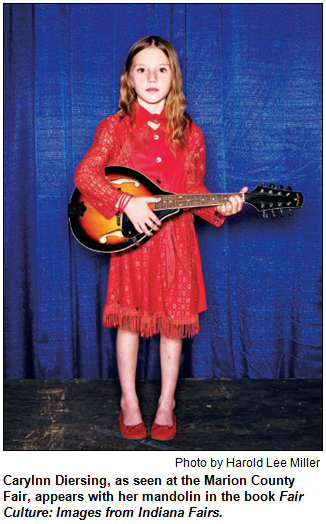 At the 2008 fair in Elkhart County, he reports, there were 1,000 "non-breathing" entries submitted for judging; they ranged from art projects to photos. (Harold's photos of the Elkhart County Fair include an image of a jeans-clad exhibitor cooling down his two hogs by squirting them with a mister as they are routed through a maze of gates.)
At the 2008 fair in Elkhart County, he reports, there were 1,000 "non-breathing" entries submitted for judging; they ranged from art projects to photos. (Harold's photos of the Elkhart County Fair include an image of a jeans-clad exhibitor cooling down his two hogs by squirting them with a mister as they are routed through a maze of gates.)
But hold your horses. An Associated Press report last week indicated some aspects of Hoosier county fairs are struggling.
"County fairs across Indiana are seeing interest wane in a staple of the events," the AP noted. Several of the state's 92 counties, for example, reported sharp declines in contestants in their queen pageants, with the Monroe County Fair indicating the least interest in 30 years.
"Mixed" certainly describes the attractions at county fairs. For generations, the attractions have ranged from apple pie contests, farm equipment displays and swine barns to demolition derbies and midway enticements some consider a bit lurid.
"Entertainment said to be frivolous, seedy, vulgar, or sometimes characterized as 'downright immoral' has been a part of the fair scene since at least the middle of the 19th Century," Gerry writes in Fair Culture.
He adds that such entertainment often has been "seen as a necessity by promoters of the fairs. ... Even the word 'concessions' was said to have originated as a concession to the lower classes."
 In describing his photographic approach to county fairs, Harold indicates he sought to avoid a nostalgic or romantic approach, Instead, he describes his array of color images as "documentational."
In describing his photographic approach to county fairs, Harold indicates he sought to avoid a nostalgic or romantic approach, Instead, he describes his array of color images as "documentational."
Nelson asks how he was able to convince an array of multi-colored roosters and chickens to stand still for some striking images. The cover of Fair Culture features Harold's photo of a teenage boy exhibiting a white rooster at the Indiana State Fair.
Other photos depict harness racer Bob Morrow at the Jay County Fair, a plate of elephant ears (natch) at the state fair, the winner of the "Miss Backyard Sugar Shack" contest at the Elkhart County Fair, and Monroe County resident Jonathan Faulkner standing on the roof of his red, white and blue muscle car.
A bushel of fun facts:
Chris Gahl of the ICVA suggests the Marion County Fair this week as a Roadtrip pick. The fair is located in the southeastern corner of Marion County, near the intersection of I-465 and I-74 and runs through Saturday, July 30.
Events on Saturday, July 23, include the Battle of the Bands from 5 to 9 p.m., motorcycle races at 7 p.m., and the Queen and Princess pageant at 8 p.m. A printable Marion County Fair map is available to guide you toward the fun!
A frequent entry in pie contests at county fairs across Indiana, it was named the state's official pie in 2009. The world's largest maker of it is Wick's Pies in Randolph County. According to food historians, this type of pie has a heritage associated with Hoosier farms because its ingredients primarily include staples almost always on hand in rural kitchens.
 Question: What kind of pie, long associated with farm life, is now the official state pie of Indiana?
Question: What kind of pie, long associated with farm life, is now the official state pie of Indiana?
The prize was four tickets to Conner Prairie Interactive History Park, courtesy of the ICVA.
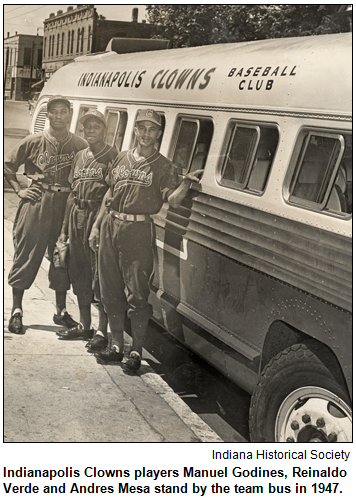 (July 16, 2011) - Step up to the plate for some historic baseball questions and insights. Did you know that in 1920 the very first game in the newly organized Negro Leagues was played in Indianapolis?
(July 16, 2011) - Step up to the plate for some historic baseball questions and insights. Did you know that in 1920 the very first game in the newly organized Negro Leagues was played in Indianapolis?
Were you aware that one of the greatest stars of the Negro Leagues - a slugger often called "the black Babe Ruth" - was an Indy native?
During an era when major league baseball was segregated, the Indianapolis Clowns and predecessor team the Indianapolis ABCs (which, as an independent team, was even competing in the early 1900s) had a huge impact.
To explore the heritage of Negro Leagues baseball in the Hoosier state, Nelson is joined in studio by Geri Strecker, a Ball State University professor who is writing a biography of Indy native Oscar Charleston (1896-1954), an outfielder considered one of the greatest players - and, eventually, managers - in the Negro Leagues.
Nelson also is joined by Indy native Cliff Robinson, who from ages 10 through about 14 was a batboy for the Indianapolis Clowns. Traveling with the team during the 1940s, Cliff visited nearly every major league ballpark in the country and has a mound of anecdotes.
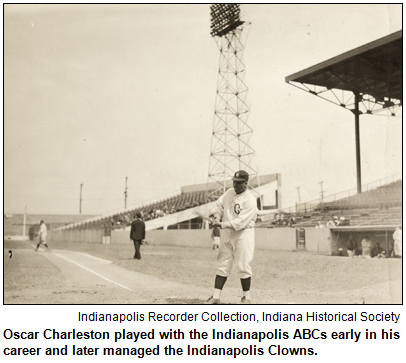 Eventually leaving the road to attend Attucks High School (class of '53) and then college, Cliff became an educator, coach and administrator at several schools before ending his career as human resources director at IUPUI.
Eventually leaving the road to attend Attucks High School (class of '53) and then college, Cliff became an educator, coach and administrator at several schools before ending his career as human resources director at IUPUI.
Our show with Cliff and Geri (who also has put together a documentary with her Ball State students about black baseball in Indiana) aired just before the 14th annual Jerry Malloy Negro Leagues Conference met in Indy, beginning July 21.
During the conference, a historical marker was placed on the site of the first organized Negro Leagues game, which involved the Indianapolis ABCs; the site was in the former West Washington Street Park, now part of the Indianapolis Zoo. (Oscar Charleston played center field during that game.) 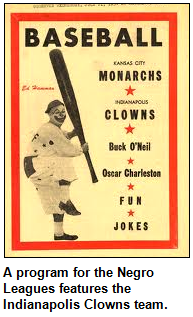 The former West Washington Street Park is not to be confused with Washington Park on the eastside of Indy, which, ironically, was the site of the city's former zoo.
The former West Washington Street Park is not to be confused with Washington Park on the eastside of Indy, which, ironically, was the site of the city's former zoo.
 The first game in the Negro Leagues was held in Indy partially because of the influence of Indianapolis ABCs manager (and later owner) C.I. Taylor. According to the Negro Leagues Baseball eMuseum, Taylor had "stocked the team with players of major leagues talent in 1914, and it immediately became one of the best in black baseball."
The first game in the Negro Leagues was held in Indy partially because of the influence of Indianapolis ABCs manager (and later owner) C.I. Taylor. According to the Negro Leagues Baseball eMuseum, Taylor had "stocked the team with players of major leagues talent in 1914, and it immediately became one of the best in black baseball."
Born in North Carolina, Taylor had managed a team in West Baden, Indiana; it was named the Sprudels after the mineral water at the famous hotel in the Orange County town.
In 1914, the baseball team relocated to Indianapolis and took the name ABCs in honor of its sponsor, the American Brewing Company. 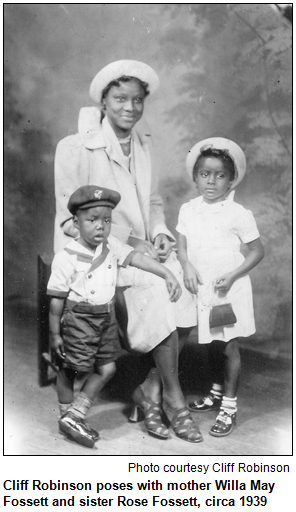 According to the Encyclopedia of Indianapolis, Taylor insisted his players wear "collars, ties and shirts when not in uniform." The ABCs players became role models for many young Hoosiers.
According to the Encyclopedia of Indianapolis, Taylor insisted his players wear "collars, ties and shirts when not in uniform." The ABCs players became role models for many young Hoosiers.
Oscar Charleston joined the team in 1915 and spent more than 30 seasons playing for or managing the ABCs or various other teams in the Negro Leagues. Some experts have called him one of the greatest (albeit unheralded) baseball players who ever lived.
Because record keeping was sketchy for the early Negro Leagues teams, comparisons are difficult. According to some accounts, though, Charleston played more than 1,000 games with a batting average of about .350. Geri says spectators even would throw money at Charleston after he made one of his spectacular plays.
Yet he died in near obscurity and was buried in Floral Park Cemetery on the Westside of Indy in 1954.
By then, the glory years of the Indianapolis Clowns also were over. The team had moved to Indy from Cincinnati during the mid-1940s. As many baseball enthusiasts know, future legend Henry Aaron made his debut with the Negro Leagues during the early 1950s with the Clowns.
As a young batboy, our guest Cliff was a roommate on the road of the flashy Clowns player “Goose” Tatum (real name: Reece Tatum), who went on to much greater fame in basketball as a Harlem Globetrotter. 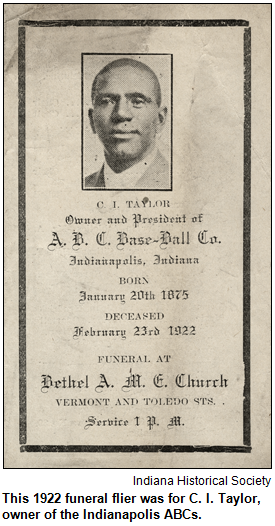 Cliff, meanwhile, grew up to become an educator, coach and administrator - and, during the late 1950s, even was an assistant trainer for the legendary Chicago Bears football team.
Cliff, meanwhile, grew up to become an educator, coach and administrator - and, during the late 1950s, even was an assistant trainer for the legendary Chicago Bears football team.
He was born in North Carolina in 1956, an era when Negro Leagues baseball was fading. So he never played in the Negro Leagues, and his career in Major League baseball was not particularly significant. However, his impact in Indianapolis was spectacular. During the 1980s, he arguably became the most popular player in Indianapolis Indians history. He led the Indians to five regular-season titles in the American Association and spent a total of nine seasons with the team.
His popularity was so great that in 2006, when he was managing the Charlotte Knights, he was hailed at Victory Field with a special night designated in his honor - highly unusual for someone affiliated with an opposing team.
Question: Who is he?
The prize was four tickets to an Indianapolis Indians game, courtesy of the Indians, as well as a one-night stay at the Omni Severin Hotel in downtown Indianapolis, courtesy of the ICVA.
Chris Gahl of the ICVA tells us to head northwest from Indianapolis to the city of Delphi, which is northeast of Lafayette in Carroll County. 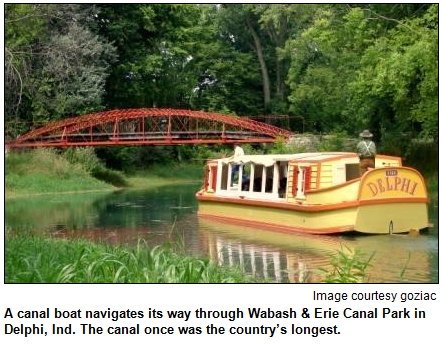 The Wabash and Erie Canal was built between 1832 and 1853 and was the country's longest canal, connecting Lake Erie at Toledo, Ohio, with the Ohio River at Evansville, In.
The Wabash and Erie Canal was built between 1832 and 1853 and was the country's longest canal, connecting Lake Erie at Toledo, Ohio, with the Ohio River at Evansville, In.
Delphi boasts the only watered section of the canal in Indiana. Over the past several decades the area's citizens seem to have taken their local history very seriously; creating the Wabash & Erie Canal Park. The park features more than 7.5 miles of hiking trails and an interpretive center that is open Thursday, Friday, Sunday from 1 to 4 p.m., and Saturday from 10 a.m. to 4 p.m. Admission to the interpretive center is free, and more information is available at (765) 564-2870.
Three National Register sites are located in the canal park, including an Irish workers construction campsite; Lock #33 and lockkeeper's house site; and the Harley & Hubbard Lime Kilns. Canal boat rides are also available during the summer months. Additionally, a large Wabash and Erie canal artifact from Allen County, the Gronauer Lock, is on display at the Indiana State Museum. The largely intact wooden lock was discovered by construction crews in 1991 as I-469 around Ft. Wayne was being built.
(July 9, 2011) - Diving horses, roller coasters, Ferris wheels, bumper cars, dunk tanks, fun houses, landscaped gardens, shoot-the-chutes and waterslides. All were on the summer menu - along with cotton candy and Coney dogs - for generations of Hoosiers who patronized three popular amusement parks in Indianapolis.
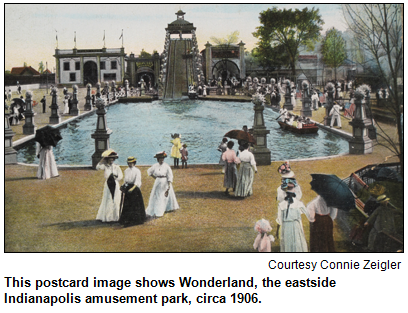 All three are bygone and had some dark chapters in their histories, including - in some cases - raging fires, racial discrimination, neighborhood objections over plans to serve alcohol and as many financial ups and downs as a wild ride.
All three are bygone and had some dark chapters in their histories, including - in some cases - raging fires, racial discrimination, neighborhood objections over plans to serve alcohol and as many financial ups and downs as a wild ride.
To explore the heritage of three major amusement parks that opened more than 100 years ago, Nelson is joined in studio by historic preservationist Connie Zeigler, president and owner of C. Resources Inc.
A writer and historian, Connie has researched the beginnings - during the amusement park craze that swept the country in the early 1900s - of Riverside Amusement Park, the wildly popular attraction on the westside of Indy that flourished until the early 1970s. It's where generations of Hoosier children experienced the thrills of their first ride on a Ferris wheel and roller coaster.
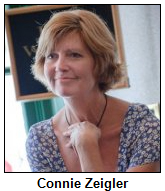 Connie, a regular columnist for Urban Times, the monthly newspaper serving historic neighborhoods in Indy, also has researched Wonderland Amusement Park, a lavish entertainment center on East Washington and Gray streets with a short (1906-1911) but spectacular and colorful life. When illuminated at night, Wonderland's 125-foot central tower was said to be visible for miles. Thousands of Hoosiers flocked to the amusement park, which featured an artificial lake, landscaped gardens and diving horses. (The latter included a mare named Queenie who became a crowd favorite.)
Connie, a regular columnist for Urban Times, the monthly newspaper serving historic neighborhoods in Indy, also has researched Wonderland Amusement Park, a lavish entertainment center on East Washington and Gray streets with a short (1906-1911) but spectacular and colorful life. When illuminated at night, Wonderland's 125-foot central tower was said to be visible for miles. Thousands of Hoosiers flocked to the amusement park, which featured an artificial lake, landscaped gardens and diving horses. (The latter included a mare named Queenie who became a crowd favorite.)
The third major amusement park in Indy was located in Broad Ripple and had a series of lives. Known as White City Amusement Park when it opened in 1906, the entertainment center was named after the "white city" architecture featured at the legendary 1893 World's Columbian Exposition in Chicago. White City burned to the ground in 1908 in a fire that started in its "Mystic Cave" attraction.
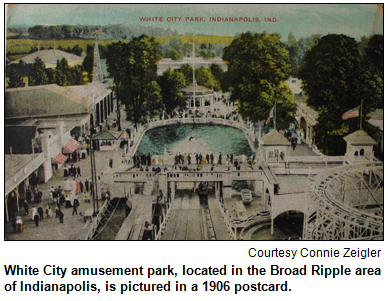 Wonderland also succumbed to flames (ironically, its attractions included a stunning reenactment of the 1889 Johnstown, Pa., flood), destroyed by a roaring nighttime blaze in 1911 that, as Connie put it in an Urban Times column, left the once-lavish amusement park "a soaked, smoldering ruin."
Wonderland also succumbed to flames (ironically, its attractions included a stunning reenactment of the 1889 Johnstown, Pa., flood), destroyed by a roaring nighttime blaze in 1911 that, as Connie put it in an Urban Times column, left the once-lavish amusement park "a soaked, smoldering ruin."
During its brief life, Wonderland not only drew thousands to its attractions such as a hydrogen-powered dirigible Connie says was "as big as two streetcars." The amusement park also drew protests from temperance advocates, including many residents of nearby Irvington, with plans for a German beer garden. (The garden eventually opened, sans beer.)
"In the early 1900s, amusement parks were considered 'edgy' places," according to Connie, who does a paid visual presentation about Riverside, Wonderland and White City. (The amusement parks also were the focus of her master's thesis.)
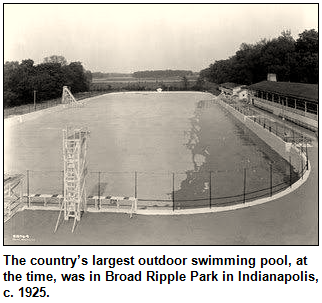 "Amusement parks were located on the edges of town," says Connie, "and they tolerated behavior considered on the edges of what was socially proper then."
"Amusement parks were located on the edges of town," says Connie, "and they tolerated behavior considered on the edges of what was socially proper then."
After the devastating fire at White City, a new entertainment center, known as Broad Ripple Amusement Park or similar names, held forth at the site into the 1940s. Except for certain features - most notably, the country's largest outdoor swimming pool, which served as the site of the 1924 Olympic Trials won by Johnny Weissmuller - Broad Ripple Amusement Park did not match its White City predecessor in terms of inspiring awe.
Instead, Riverside was king of the heap in Central Indiana for decades. Beginning with just a toboggan run at its opening in 1903 on farmland near the White River, Riverside evolved into a sprawling amusement park that included a miniature railroad, a dance hall, a roller skating rink and a trove of rides. According to some estimates, more than 1 million visitors flocked to Riverside in 1952, one of its peak years. Currently there is a Facebook page for those who share their Riverside memories and photos.
 Riverside, however, was not beloved in every aspect. The amusement park outraged many Hoosiers by persisting with a "whites only" admission policy even into the 1960s, even as its surrounding neighborhood became increasingly diverse. African-Americans were permitted to visit only on "Colored Weekends," which were far from frequent.
Riverside, however, was not beloved in every aspect. The amusement park outraged many Hoosiers by persisting with a "whites only" admission policy even into the 1960s, even as its surrounding neighborhood became increasingly diverse. African-Americans were permitted to visit only on "Colored Weekends," which were far from frequent.
There also were controversies about possible histoplasmosis and the deterioration of the attractions. By some accounts, Riverside was losing more than $30,000 annually when it closed after the 1970 season.
So what developed on the sites of these once-popular amusement parks?
Riverside: Since 2000, subdivisions of homes, townhouses and condos, including River's Edge, have been built on the site.
Wonderland: The factory plant of P.R. Mallory and Co., an Indy-based electrical components manufacturer, employed hundreds of workers before it, too, closed.
White City: According to Connie, the lavish initial amusement park was located on what today is Broad Ripple's dog park, which opened as Indy's first "bark park" (where dogs can frolic off-leash) in 1999.
For several decades before Riverside Amusement Park in Indianapolis closed in the early 1970s, its attractions included two major roller coasters. 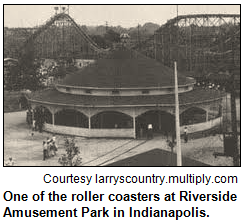 Showcased almost as dueling attractions, the two roller coasters sparked continual debates among patrons, particularly teenagers and children, about which was more terrifying to ride.
Showcased almost as dueling attractions, the two roller coasters sparked continual debates among patrons, particularly teenagers and children, about which was more terrifying to ride.
Question: Name one of the two large roller coasters at Riverside.
The prize was a one-night stay for two at the Canterbury Hotel in downtown Indianapolis, as well as a Yellow Rose Carriage Ride. These prizes are courtesy of the ICVA.
 Chris Gahl of the ICVA tells us to head southwest from Indianapolis to Angel Mounds near Evansville. This state historic site was once a palisaded Middle Mississippian Indian village from about 1050 A.D. to 1450 A.D., when it was abandoned. It is estimated that about 1,000 Native Americans lived here, and the 450-acre site includes 11 man-made mounds, a town plaza and a village area.
Chris Gahl of the ICVA tells us to head southwest from Indianapolis to Angel Mounds near Evansville. This state historic site was once a palisaded Middle Mississippian Indian village from about 1050 A.D. to 1450 A.D., when it was abandoned. It is estimated that about 1,000 Native Americans lived here, and the 450-acre site includes 11 man-made mounds, a town plaza and a village area.
Angel Mounds was purchased by the Indiana Historical Society in 1938 with financial assistance from Eli Lilly II, and in 1947 the Indiana Historical Society transferred ownership to the state of Indiana.
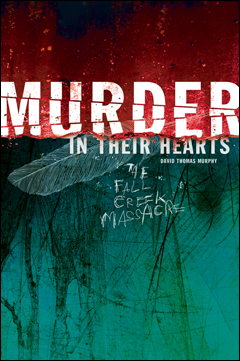 (July 2, 2011 - encore show) - When white men were found guilty by a jury and executed for the slaughter of nine Native Americans in March 1824, it was a milestone in American history. Following what became known as the Fall Creek Massacre, whites for the first time were convicted and executed for the murders of Indians under American law.
(July 2, 2011 - encore show) - When white men were found guilty by a jury and executed for the slaughter of nine Native Americans in March 1824, it was a milestone in American history. Following what became known as the Fall Creek Massacre, whites for the first time were convicted and executed for the murders of Indians under American law.
To explore all aspects of the brutal crimes in the swampy woods of Madison County, where Native Americans (including three women and four children) were gruesomely murdered, Nelson is joined in studio by David Thomas Murphy, author of Murder in Their Hearts: The Fall Creek Massacre (Indiana Historical Society Press).
A professor of history at Anderson University, David has spent four years researching the massacre, trial and subsequent developments, including the social history of pioneer Hoosiers (Indiana only had been a state for about seven years at the time of the massacre) and of the Native Americans in the region.
David says he struggled to reconcile conflicting accounts of the events (the tribal origins of some of the victims remains unclear) as well as the motivations involved.
"The slaughter in the soggy Indiana creek bottoms created a short-lived but serious national security crisis," David writes, referring to concerns across the country that warfare would erupt across newly developing states. Noting that tensions had been brewing between whites and Native Americans for weeks prior to the massacre, David says the attitudes of many white settlers toward Indians were complex and nuanced, mixing respect, fear, tolerance and suspicion.
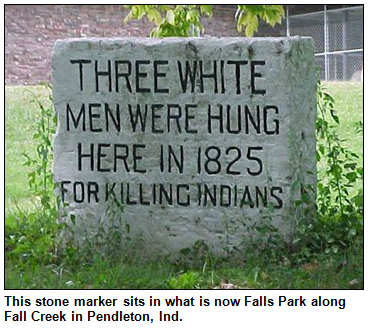 Even though the carnage of the Fall Creek Massacre drew national attention at the time, the slaughter and judicial outcome often are not mentioned in accounts of white-Native American relations, David says.
Even though the carnage of the Fall Creek Massacre drew national attention at the time, the slaughter and judicial outcome often are not mentioned in accounts of white-Native American relations, David says.
An exception involved the late author Jessamyn West, an Indiana native, who wrote a best-selling novel, The Massacre at Fall Creek (1975), about the shocking episode in Hoosier history.
This show is an encore broadcast of a popular program in our Hoosier History Live! archives. (The original broadcast date was Sept. 11, 2010.) So there won’t be an opportunity for call-in questions from listeners. But that opportunity will return July 9 with a brand-new Hoosier History Live! show.
(June 25, 2011) - Speakeasies, moonshine and bootleggers are associated with an era across the country that spanned about 14 years - actually, a bit longer in Indiana because the state went "dry" in 1918, nearly two years before the nation.
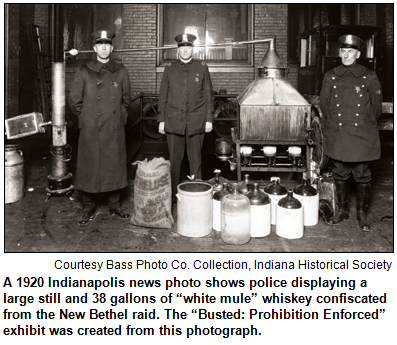 And for several years before Prohibition, some Indiana counties such as LaGrange and Randolph already had prohibited the manufacturing, sale and transportation of alcohol, according to a new exhibit at the Eugene and Marilyn Glick Indiana History Center. Titled "Busted: Prohibition Enforced," the exhibit depicts an arrest based on a raid in 1920 of a major bootlegger operating out of a barn near New Bethel (now known as Wanamaker) in far-southeastern Marion County.
And for several years before Prohibition, some Indiana counties such as LaGrange and Randolph already had prohibited the manufacturing, sale and transportation of alcohol, according to a new exhibit at the Eugene and Marilyn Glick Indiana History Center. Titled "Busted: Prohibition Enforced," the exhibit depicts an arrest based on a raid in 1920 of a major bootlegger operating out of a barn near New Bethel (now known as Wanamaker) in far-southeastern Marion County.
To explore this colorful era, Nelson is joined in studio by Marc Carmichael of the Indiana Beverage Alliance and Clay Pendleton of the Indiana Historical Society. They share Indiana-specific insights about Prohibition, ranging from the influence of the Woman's Christian Temperance Union (WCTU) and Quakers to some unexpected outcomes, including the fact that per capita consumption of alcohol actually increased during the 1920s, the opposite of the intended effect.
Another development: In 1923, during the height of Prohibition, Indiana lawmakers passed the state's first drunk-driving law.
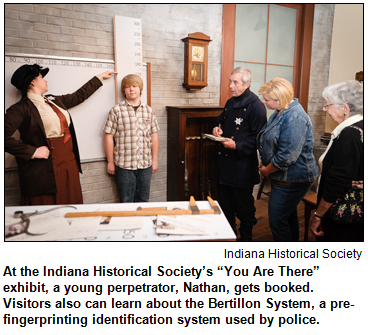 Marc, a former state legislator from Muncie, has researched Prohibition, which ended in 1933. Clay not only helped research the "Busted: Prohibition Enforced" exhibit, he is a re-enactor who portrays the bootlegger, a New Bethel resident named Roy Taylor who was operating a lucrative still selling homemade liquor for $5 to $6 a gallon. When Taylor's still in a rented barn was raided by police in December 1920, it was considered the largest bootlegging bust in the Midwest since Prohibition began.
Marc, a former state legislator from Muncie, has researched Prohibition, which ended in 1933. Clay not only helped research the "Busted: Prohibition Enforced" exhibit, he is a re-enactor who portrays the bootlegger, a New Bethel resident named Roy Taylor who was operating a lucrative still selling homemade liquor for $5 to $6 a gallon. When Taylor's still in a rented barn was raided by police in December 1920, it was considered the largest bootlegging bust in the Midwest since Prohibition began.
Advocates for Prohibition included the WCTU, which argued that women and children were frequent, innocent victims of alcohol abuse, and Quakers, who often practiced temperance although drinking alcohol was not forbidden by the church. According to several sources, the influence of Quakers was particularly persuasive in Randolph County and other parts of far-eastern Indiana.
On a national level, Prohibition was set in motion in 1919, when state legislatures ratified the 18th Amendment; it took effect in January 1920 and banned the manufacturing, sale and transportation (but not the consumption) of alcohol.
In 1921, though, the Indiana legislature made mere possession of alcohol illegal. According to an article in the Historical Society's magazine, Traces of Indiana and Midwestern History, Hoosier lawmakers even banned the sale of products such as hair tonics if they contained alcohol that could be used for "beverage purposes."
Lickety-split, as soon as Prohibition began alcoholic drinks were sold at speakeasies and other underground retailers. According to "Busted: Prohibition Enforced," pickpockets and other petty criminals often became moonshine-makers or bootleggers because it was so lucrative. ("Moonshiners" made the alcohol, while "bootleggers" transported it.)
Some facts to whet your appetite for this show:
In the early 1900s - before Prohibition - one of the country's largest brewers was located in an Indiana city. In this city - not Indianapolis - the biggest brewery consisted of a five-story complex.  It included a bottling plant and a stable with more than 55 Clydesdale and Belgian horses used to draw wagons that delivered the beer, according to the book True Brew, by Rita Kohn.
It included a bottling plant and a stable with more than 55 Clydesdale and Belgian horses used to draw wagons that delivered the beer, according to the book True Brew, by Rita Kohn.
Like Indianapolis, this Indiana city has a significant German heritage. The city's beer-making tradition continued long after Prohibition. A beer called Champagne Velvet brewed in the city was nationally popular during the 1940s and '50s.
Question: Name the Indiana city.
The prize was a one-year household membership to the Indiana Historical Society, which includes free admission for all to the Indiana Experience, courtesy of the Indiana Historical Society.
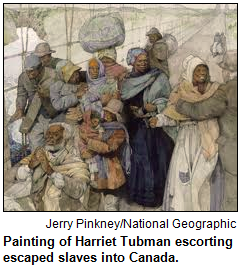 Chris Gahl of the ICVA tells us to head northeast to historic Pendleton, Ind., for a one-day workshop on Thursday, July 11, for Underground Railroad history researchers at the Pendleton Public Library. The workshop is administered by the Indiana Department of Natural Resources, Division of Historic Preservation & Archeology, and is presented by Dr. Paul Finkelman of the Albany Law School.
Chris Gahl of the ICVA tells us to head northeast to historic Pendleton, Ind., for a one-day workshop on Thursday, July 11, for Underground Railroad history researchers at the Pendleton Public Library. The workshop is administered by the Indiana Department of Natural Resources, Division of Historic Preservation & Archeology, and is presented by Dr. Paul Finkelman of the Albany Law School.
While in Pendleton, be sure to visit historic Falls Park along Fall Creek, which has a series of hiking trails and a history museum. The falls there served as a community focal point for centuries and is also the site where three white settlers were executed by hanging in 1825 for their massacre of a group of nine Native Americans near that spot in what is now known as the Fall Creek Massacre. Their execution is significant in that it represents the first time in American history that whites were tried, convicted and executed for murdering Native Americans.
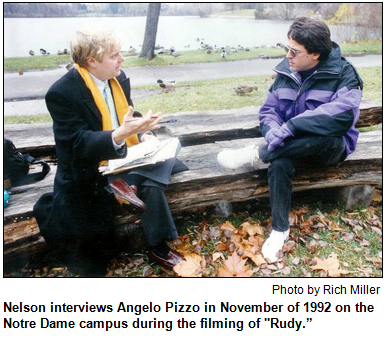 (June 18, 2011) - If you are the screenwriter of a film named "best sports movie of all time" by the likes of ESPN and USA Today, is it any wonder you would be named a Living Legend? Before Hoosiers (1986) filmmaker Angelo Pizzo of Bloomington receives that accolade from the Indiana Historical Society next month, he will join Nelson in studio.
(June 18, 2011) - If you are the screenwriter of a film named "best sports movie of all time" by the likes of ESPN and USA Today, is it any wonder you would be named a Living Legend? Before Hoosiers (1986) filmmaker Angelo Pizzo of Bloomington receives that accolade from the Indiana Historical Society next month, he will join Nelson in studio.
The grandson of Sicilian immigrants, Angelo is renowned for his screenplays inspired by true Indiana sports stories. In addition to Hoosiers, which was inspired by the 1954 upset victory of tiny Milan High School in the state basketball tournament, Angelo wrote the screenplay for Rudy (1993), which focused on a University of Notre Dame football story.
For both of those movies, Angelo collaborated with his Indiana University classmate, director David Anspaugh, who also will be named an Indiana Living Legend at the gala on July 29.
 As Sigma Nu fraternity brothers at IU in the late 1960s, David and Angelo made experimental 16mm films around campus, but few cared. Today their movies are shown around the world; coaches of sports teams as far away as Russia have said they screen Hoosiers as a motivational tool for their athletes.
As Sigma Nu fraternity brothers at IU in the late 1960s, David and Angelo made experimental 16mm films around campus, but few cared. Today their movies are shown around the world; coaches of sports teams as far away as Russia have said they screen Hoosiers as a motivational tool for their athletes.
During our show, Angelo also will share news and details about a current movie project that has come his way unexpectedly. It's a film based on a true episode in NASCAR history. Although that project doesn’t have an Indiana setting, Angelo has been renowned for his allegiance to the Hoosier state, both professionally and personally. After living in southern California for decades, he moved back to Bloomington in 2004 because he wanted to raise his two young sons in his hometown.
The eldest of seven siblings, Angelo was born in 1948 and grew up in a family active in civic and political life. His father, Dr. Anthony Pizzo, a pathologist, served as Monroe County's coroner, the director of laboratories at Bloomington Hospital, and as a Democratic state legislator.
As a boy in Bloomington, Angelo shared some of those interests, but they were trumped by another passion.
"Even as a kid who wanted to be in politics, I was passionate about movies," Angelo told Nelson in an interview during the filming of Rudy.
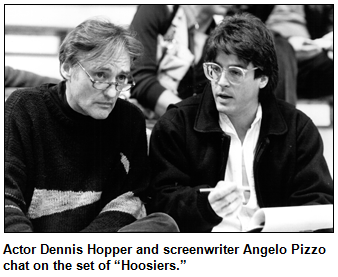 After IU, Angelo attended the film school at the University of Southern California. In addition to writing the screenplays for Hoosiers and Rudy and serving as a co-producer on both movies, Angelo wrote the screenplay for The Game of Their Lives (2005). It's a movie about the unexpected triumph of an American soccer team in 1950 over Great Britain, the world champion.
After IU, Angelo attended the film school at the University of Southern California. In addition to writing the screenplays for Hoosiers and Rudy and serving as a co-producer on both movies, Angelo wrote the screenplay for The Game of Their Lives (2005). It's a movie about the unexpected triumph of an American soccer team in 1950 over Great Britain, the world champion.
Among his various endeavors, Angelo serves on the board of Heartland Truly Moving Pictures. Some fun facts:
 For three movies - "Hoosiers" (1986), "Rudy" (1993) and "The Game of Their Lives" (2005) - screenwriter Angelo Pizzo collaborated with David Anspaugh, the director of the films. Angelo had been a fraternity brother at Indiana University with David, who also grew up in the Hoosier state. David Anspaugh was born and raised in a northern Indiana town where his father was a photographer.
For three movies - "Hoosiers" (1986), "Rudy" (1993) and "The Game of Their Lives" (2005) - screenwriter Angelo Pizzo collaborated with David Anspaugh, the director of the films. Angelo had been a fraternity brother at Indiana University with David, who also grew up in the Hoosier state. David Anspaugh was born and raised in a northern Indiana town where his father was a photographer.
Question: Name director David Anspaugh's hometown.
To win the prize, you must call in with the correct answer during the live show. The call-in number is (317) 788-3314, and please do not call until you hear Nelson pose the question on the air. Please do not call if you have won a prize from any WICR show during the last two months. The prize is a gift certificate to Tavern on South, next to Lucas Oil Stadium, courtesy of the Indianapolis Convention and Visitors Association, and a pair of tickets to Conner Prairie, courtesy of Conner Prairie.
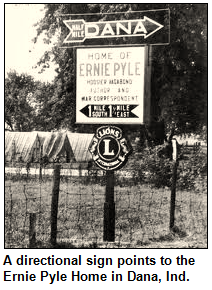 Chris Gahl of the ICVA tells us to head west along U.S. 36 to visit the newly reopened Ernie Pyle Museum Home near Dana.
Chris Gahl of the ICVA tells us to head west along U.S. 36 to visit the newly reopened Ernie Pyle Museum Home near Dana.
After being closed by the state for a couple of years as a tax-saving measure, the childhood home of the famed WWII journalist has been taken over by a private non-profit group called the Friends of Ernie Pyle.
Ernie Pyle won a Pulitzer in 1944 for his columns about the Depression and World War II. He was killed by a Japanese sniper in April of 1945. The museum is open Fridays and Saturdays from 10 a.m. to 4 p.m. and on Sundays from 1 to 4 p.m., and also by appointment. According to Cynthia Myers, president of Friends of Ernie Pyle, the state is in the process of turning over the deed to the property to their group. More information is available at (765) 665-3633.
 (June 11, 2011) - According to folklore, the west-central Indiana town of Brazil derives its name only indirectly from the South American nation. The town took the name of a nearby farm called Brazil that, in turn, appropriated it merely because the country had been in the news frequently during the 1840s.
(June 11, 2011) - According to folklore, the west-central Indiana town of Brazil derives its name only indirectly from the South American nation. The town took the name of a nearby farm called Brazil that, in turn, appropriated it merely because the country had been in the news frequently during the 1840s.
More than 160 years later, though, Brazilian immigrants and visitors are creating a splash in many ways on Hoosier soil. Among the wave makers is acclaimed Indianapolis artist, clothing designer and cultural organizer Artur Silva, who joins Nelson in studio to share insights about immigration from his colorful homeland.
A recipient of the prestigious Efroymson Contemporary Arts Fellowship for 2010-11, Artur has been a co-organizer during recent pre-Lenten seasons of Indy Brazilian Carnaval, including a festive celebration in March that was the largest in the city's history, with about 600 attendees. The Indianapolis Star, in fact, dubbed it "the hottest party" of the Mardi Gras season in the metro area.
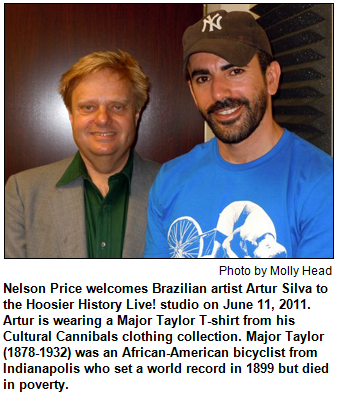 Artur, 35, is a native of Belo Horizonte City (translation: "beautiful horizon"), a city in southeastern Brazil that's surrounded by mountains. His artwork (Artur creates in several media, including painting, sculpture, digital media and photographic collages) has been seen by thousands of Hoosiers. It includes installations in White River State Park and, for about a year, the sparkling "MASS" letters that stood at the gateway to the Massachusetts Avenue arts district in Indy.
Artur, 35, is a native of Belo Horizonte City (translation: "beautiful horizon"), a city in southeastern Brazil that's surrounded by mountains. His artwork (Artur creates in several media, including painting, sculpture, digital media and photographic collages) has been seen by thousands of Hoosiers. It includes installations in White River State Park and, for about a year, the sparkling "MASS" letters that stood at the gateway to the Massachusetts Avenue arts district in Indy.
"My work focuses on the American experience," says Artur, who moved to Indy in 2001 after a few years in New York City. "Brazilians have come here in recent years for no one single reason, but to pursue all walks of life. I know Brazilians who work for Lilly and Rolls Royce, I know people who do cleaning work and babysitting, and I know artists and musicians."
Artur's studio is at the Harrison Center for the Arts in the Old Northside neighborhood of Indy. Coincidentally, the Harrison Center, 1505 N. Delaware St., will be the setting on June 11 for the Independent Music and Art Festival, beginning at noon, right when Hoosier History Live! with Artur signs off, and lasting until 8 p.m. For more info about the festival, visit harrisoncenter.org.
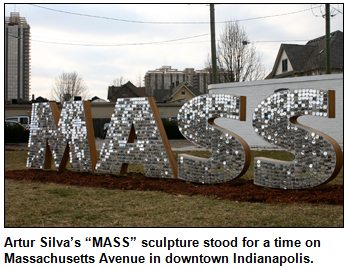 Artur's website is at www.artursilva.com. His artwork has been exhibited across the country and overseas - everywhere, in fact, from the Fort Wayne Museum of Art to galleries in Chicago, Los Angeles, the Netherlands and his native Brazil.
Artur's website is at www.artursilva.com. His artwork has been exhibited across the country and overseas - everywhere, in fact, from the Fort Wayne Museum of Art to galleries in Chicago, Los Angeles, the Netherlands and his native Brazil.
He tries to return once per year to his homeland and estimates about 1,000 people with Brazilian heritage now live in the Indy metro area. Obviously, then, scores of non-Brazilians attended the Indy Brazilian Carnaval that he organized with a business partner, Indianapolis radio disc jockey Kyle Long.
"The idea with Carnaval is for Brazilians to invite the rest of the world to share our culture and joy," Artur says of the festival, which featured samba music and dancing. "Carnaval was brought to Brazil in the 1600s by the Portuguese, but it really became popular when people from other cultures joined the celebration."
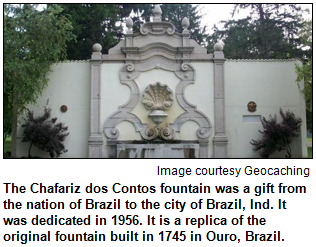 Also with Kyle Long, Artur has created Cultural Cannibals, a line of street wear and other apparel.
Also with Kyle Long, Artur has created Cultural Cannibals, a line of street wear and other apparel.
In addition to the Efroymson fellowship, Artur is a 2011 recipient of the Pollack-Krasner Foundation Grant. He plans to use some of the fellowship awards to study historic cemeteries - specifically, tombstones - as inspiration for his artwork.
Artur, who is in the process of becoming an American citizen, says "the buzz" is increasing in his homeland about the Indianapolis 500 because of the steady presence of Brazilian drivers in the race, including four of the 33 in the most recent field: Helio Castroneves, Tony Kanaan, Vitor Meira and Ana Beatriz. Race enthusiasts will recall there almost was a fifth. Bruno Junqueira - who, like Artur, is a native of Belo Horizonte - qualified among the 33 fastest drivers but was replaced days before the race in a controversial deal among car owners.
"It's taken awhile for (the Indy 500) to get a lot of attention in Brazil because the racing heritage was with Formula One," Artur says. "Now, though, there is much more buzz."
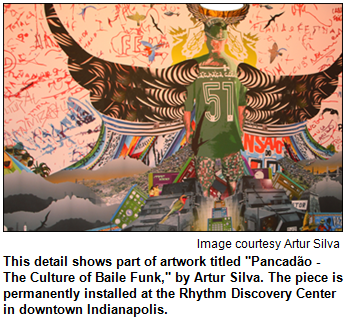 And, even though the Clay County city of Brazil derived its name indirectly from the country, the town for many decades has had a sister-city relationship with a city in southern Brazil. In fact, Forest Park in Brazil, Ind., features a large granite fountain that was a gift from the country. The fountain is a replica of Chafariz Dos Contos Fountain, a historic fountain in the South American nation.
And, even though the Clay County city of Brazil derived its name indirectly from the country, the town for many decades has had a sister-city relationship with a city in southern Brazil. In fact, Forest Park in Brazil, Ind., features a large granite fountain that was a gift from the country. The fountain is a replica of Chafariz Dos Contos Fountain, a historic fountain in the South American nation.
During our show, Artur will explain his reasons for immigrating to America, his initial reactions to Indianapolis and his observations about the capital city's art scene. He also will share the Brazilian perspective on terms such as "Hispanic" and "Latino."
During our recent show about populations shifts, Indiana University demographer Matt Kinghorn noted the state's Hispanic population grew 82 percent during the last decade. He also indicated the increase in Hoosier residents of Hispanic heritage accounted for 43 percent of the state's overall population growth.
The History Mystery question is a carry-over from last week, when there wasn't a correct answer. The question concerns famous composer Hoagy Carmichael, who died in southern California in 1981. In accordance with his wishes, Hoagy is buried in Bloomington, Ind.  His grave is in a historic cemetery that also is the burial site of other notable Hoosiers. They include Ross Lockridge Jr., author of the classic novel "Raintree County," IU sex researcher Alfred Kinsey and Andrew Wylie, IU's first president.
His grave is in a historic cemetery that also is the burial site of other notable Hoosiers. They include Ross Lockridge Jr., author of the classic novel "Raintree County," IU sex researcher Alfred Kinsey and Andrew Wylie, IU's first president.
Question: Name the historic cemetery in Bloomington.
To win the prize, you must call in with the correct answer during the live show. The call-in number is (317) 788-3314, and please do not call until you hear Nelson pose the question on the air. Please do not call if you have won a prize from any WICR show during the last two months. The prize is a gift certificate to Tavern on South, next to Lucas Oil Stadium, courtesy of the Indianapolis Convention and Visitors Association, and a pair of tickets to Conner Prairie, courtesy of Conner Prairie.
Chris Gahl of the ICVA tells us to head up north to South Bend to see two incredible museums that are side by side. "Get all your history in one place," says Chris.
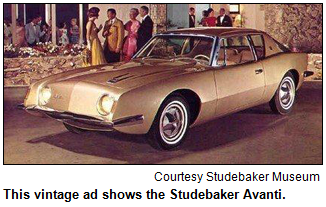 The Center for History in South Bend includes the Joseph D. Oliver mansion, known as Copshaholm, as well as the mansion's historic gardens, a worker's home reflecting a Polish immigrant family in the 1930s, and an exhibit called Women Who Played Hard Ball, The Real League of their Own.
The Center for History in South Bend includes the Joseph D. Oliver mansion, known as Copshaholm, as well as the mansion's historic gardens, a worker's home reflecting a Polish immigrant family in the 1930s, and an exhibit called Women Who Played Hard Ball, The Real League of their Own.
Right next door is the famed Studebaker Museum, with enough vintage cars to satisfy any automobile lover's appetite.
This Roadtrip was suggested by Joan Hostetler, originally of Kosciusko County, Indiana. She also recommends dining at the nearby Tippecanoe Place, which is in a mansion originally owned by the Studebaker family.
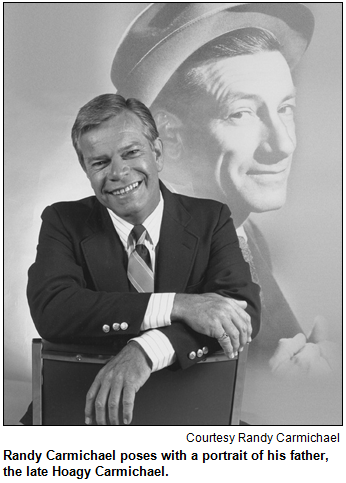 (June 4, 2011) - To the extent songs that become international standards make a composer immortal, Hoagy Carmichael, who grew up in Bloomington and Indianapolis, lives around the world whenever there's a gathering of jazz aficionados or lovers of music with a dreamy, almost surreal quality.
(June 4, 2011) - To the extent songs that become international standards make a composer immortal, Hoagy Carmichael, who grew up in Bloomington and Indianapolis, lives around the world whenever there's a gathering of jazz aficionados or lovers of music with a dreamy, almost surreal quality.
The list of Hoagy hits includes "Stardust," "Georgia On My Mind," "Up a Lazy River," "The Lamplighter's Serenade," "The Nearness of You" and even some Hoosier-specific tunes such as "Can't Get Indiana Off My Mind.
"It's people like Dad who, in my opinion, helped make Hoosiers feel comfortably at home in Indiana," Hoagy's youngest son, Randy Carmichael, told Nelson for his book Indiana Legends, which features Hoagy (1899-1981) among the assortment of famous Hoosiers on the cover.
An acclaimed pianist and vocalist, Randy Carmichael grew up in southern California while his dad was composing for movies and even acting in several, including classics such as To Have and Have Not (1944) and The Best Years of Our Lives (1946).
As a composer, Hoagy won the Academy Award in 1951 for "In the Cool, Cool, Cool of the Evening," a tune featured in Here Comes the Groom, a movie that starred Bing Crosby. About 20 years later, he was inducted into the Songwriters Hall of Fame.
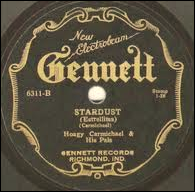 The roster of famous musicians who have recorded Hoagy's music is astounding. Consider just "Georgia On My Mind," which eventually became the state song of Georgia; it continually has been revived by performers ranging from Ray Charles and Willie Nelson to Michael Bolton.
The roster of famous musicians who have recorded Hoagy's music is astounding. Consider just "Georgia On My Mind," which eventually became the state song of Georgia; it continually has been revived by performers ranging from Ray Charles and Willie Nelson to Michael Bolton.
Randy Carmichael, who primarily has been based out of Florida in recent years, will share insights about his father - as Nelson’s guest by phone - just as plans are under way for a "Carmichael on Carmichael" concert in Wabash, Ind. As a highlight of the Charley Creek Arts Fest that will feature an array of events June 24-30, Randy will perform during a dinner show June 25 in the ballroom of the Charley Creek Inn, the award-winning, recently restored historic hotel in Wabash, Ind.
In total, Hoagy Carmichael composed about 650 songs, working with a variety of lyricists. In recent years, experts have concluded that Hoagy deserved more credit for the creation of his songs' lyrics. Nelson plans to ask Randy to describe his father's creative process when working with his lyricist collaborators, such as Johnny Mercer.
"Hoagy really was the precursor to today's singer-songwriters like Elton John and Billy Joel," the late music historian Richard Sudhalter, author of Stardust Melody: The Life and Music of Hoagy Carmichael (Oxford University Press), told Nelson when the biography was published in 2002.
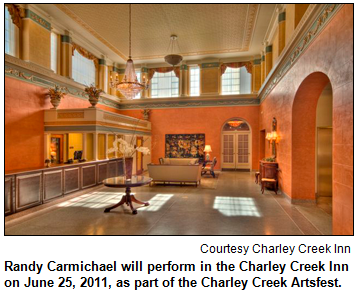 Because Hoagy never received formal music training, he primarily was influenced by informal instruction he received from two key figures. They were his mother, Lida, a pianist who was hired by Bloomington theaters to accompany silent films, and renowned Indianapolis ragtime musician Reggie DuValle, who taught young Hoagy how to improvise on the keyboard. (DuValle's piano is now at the Eugene and Marilyn Glick Indiana History Center in Indianapolis.)
Because Hoagy never received formal music training, he primarily was influenced by informal instruction he received from two key figures. They were his mother, Lida, a pianist who was hired by Bloomington theaters to accompany silent films, and renowned Indianapolis ragtime musician Reggie DuValle, who taught young Hoagy how to improvise on the keyboard. (DuValle's piano is now at the Eugene and Marilyn Glick Indiana History Center in Indianapolis.)
During Hoagy's boyhood and teen years, the Carmichaels shuttled between Bloomington and Indianapolis because his vagabond father, Howard "Cyclone" Carmichael, unsuccessfully attempted a series of jobs ranging from electrician to taxi driver.
Some fun facts:
 Even though Hoagy Carmichael died in southern California in 1981, the famous composer is buried in Bloomington. His grave is in a historic cemetery that also is the burial site of other notable Hoosiers. They include Ross Lockridge Jr., author of the classic novel "Raintree County"; IU sex researcher Alfred Kinsey and Andrew Wylie, IU's first president.
Even though Hoagy Carmichael died in southern California in 1981, the famous composer is buried in Bloomington. His grave is in a historic cemetery that also is the burial site of other notable Hoosiers. They include Ross Lockridge Jr., author of the classic novel "Raintree County"; IU sex researcher Alfred Kinsey and Andrew Wylie, IU's first president.
Question: Name the historic cemetery in Bloomington.
To win the prize, you must call in with the correct answer during the live show. The call-in number is (317) 788-3314, and please do not call until you hear Nelson pose the question on the air. Please do not call if you have won a prize from any WICR show during the last two months. The prize is a gift certificate to Tavern on South in downtown Indianapolis, courtesy of the Indianapolis Convention and Visitors Association.
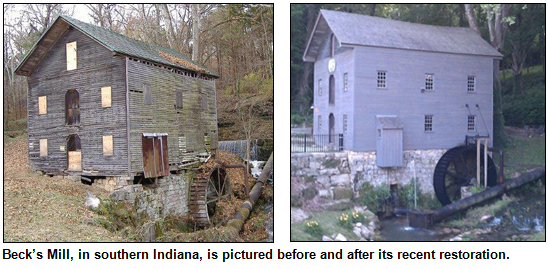 |
Chris Gahl of the ICVA suggests we take a Roadtrip to the rolling hills of southern Indiana near Salem to see a recently restored gristmill, Beck's Mill. The mill is on one of the highest elevations in Indiana and was once an Indiana burial ground. George Beck arrived in the Indiana Territory in 1807 from North Carolina to settle the area and noticed a waterfall coming out of a cave; he decided that that location would be a perfect spot for a mill.
The current structure is the third mill on the spot and was most active from 1864 to 1890, running 24 hours a day. Eventually the more modern roller mills surpassed the capability of the gristmills, and Beck's Mill stopped operating in 1914.
This Roadtrip was recommended by listener Christine Lemley of Columbus, Ind., who listens to the show online at our website. Beck's Mill is seven miles southwest of Salem in Washington County on Beck's Mill Road and has hiking trails nearby. It is operated by Friends of Beck's Mill and is open Friday and Saturday from 11 a.m. to 4 p.m., and Sunday from 1 to 4 p.m. Adult admission is $5. Beautiful Spring Mill State Park is also nearby.
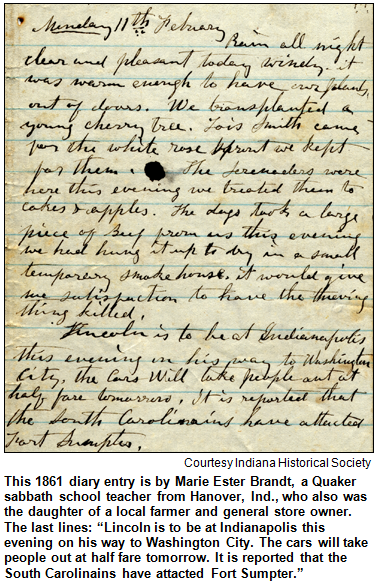 (May 28, 2011) - As the country marks the 150th anniversary of the start of the Civil War, it's worth noting that more than 200,000 men and teenage boys from Indiana fought for the Union cause. In fact, almost 75 percent of Hoosier men of military age served in the Civil War. That means Indiana ranked second only to Delaware in the percentage of men who served.
(May 28, 2011) - As the country marks the 150th anniversary of the start of the Civil War, it's worth noting that more than 200,000 men and teenage boys from Indiana fought for the Union cause. In fact, almost 75 percent of Hoosier men of military age served in the Civil War. That means Indiana ranked second only to Delaware in the percentage of men who served.
With thousands of husbands, fathers and oldest sons off to battle, what was the impact on the Hoosier home front? How did wives and young children cope with physically demanding farm work? What about families in towns where the absent patriarchs ran general stores, banks and taverns?
And, with the absence from Indiana of so many supporters of the Union cause, did Confederate-sympathizing Hoosiers who stayed behind - so-called "Copperheads" and "Butternuts" - take advantage of the situation?
Hoosier History Live! will explore these and other compelling questions as Nelson is joined in studio by two distinguished guests from Conner Prairie Interactive History Park, which is opening a $4.3 million Civil War exhibit in June. The new exhibit will feature "immersion experiences" of various aspects of the Civil War, including opportunities for Conner Prairie visitors to take on the roles of civilian volunteers who helped defend the Hoosier state from a raid by Confederate Gen. John Hunt Morgan and his forces. You can see a Conner Prairie preview video about the Morgan's Raid re-enactment.
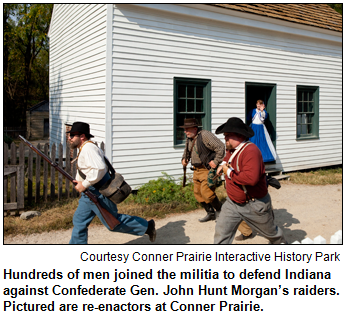 To explore the impact of the war (1861-65) on the home front's daily life, Tim Crumrin and Jim Willaert of Conner Prairie will join Nelson. They will share insights about everything from how rural families harvested crops and tended to farm animals (during an era when basic household chores alone, including cooking and doing laundry, could be all-consuming) to the impact on the schooling of children who undertook significant new responsibilities.
To explore the impact of the war (1861-65) on the home front's daily life, Tim Crumrin and Jim Willaert of Conner Prairie will join Nelson. They will share insights about everything from how rural families harvested crops and tended to farm animals (during an era when basic household chores alone, including cooking and doing laundry, could be all-consuming) to the impact on the schooling of children who undertook significant new responsibilities.
Tim, a senior historian who is Conner Prairie's experience delivery director, also will share insights about the demand for Hoosier agricultural products during the war. (He was the writer-director of Harvesting the Past, a PBS documentary focusing on Indiana's rural history.) The Civil War also increased the demand for Hoosier products such as wagons manufactured by the Studebaker Brothers of South Bend.
Jim, our other studio guest (and Conner Prairie's general manager of guest experience), is no stranger to Hoosier History Live! In previous appearances, he has shared insights about how early settlers and Native Americans survived harsh Indiana winters; he also has discussed the history of White River.
During this week's show, Tim and Jim will join Nelson in exploring how Hoosier families received pay from soldiers fighting in the Union Army. Furloughs for soldiers, Tim says, were far more extensive during the Civil War than many people realize.
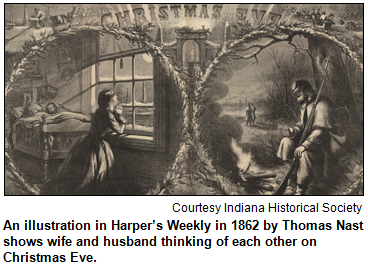 He also will discuss the sporadic "Butternut raids" across Indiana in which Confederate sympathizers harassed recruitment agents for the Union Army. Decades after the Civil War, experts concluded reports of Copperheads in Indiana that prevailed at the time were exaggerated.
He also will discuss the sporadic "Butternut raids" across Indiana in which Confederate sympathizers harassed recruitment agents for the Union Army. Decades after the Civil War, experts concluded reports of Copperheads in Indiana that prevailed at the time were exaggerated.
"Still, the perception was reality to many Hoosiers, who kept an eye out for treason and disloyalty among the neighbors," Tim notes.
Suffice it to say the Civil War altered thousands of lives on the Hoosier home front. Recent immigrants often found work as farm laborers hired by wives who suddenly had become single parents. Neighbors and children often pitched in to help harvest the crops of soldiers' families in ways that mirrored "community barn raisings," Tim says.
Tune in for what's certain to be a memorable show as we examine one of the most significant eras in Indiana's evolution.
The History Mystery is a carryover from our show two weeks ago, when there wasn't a correct answer. The question concerns a massive replica of a mythical character that was displayed in the late 1940s at Union Station in Indianapolis. 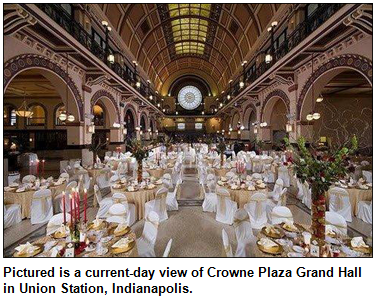 The replica of the folk character stood more than 50 feet tall, towered over the main concourse of the railroad station and was made of Styrofoam. Although the giant Styrofoam replica stood in Union Station for only a few seasons, it was such a hit that thousands of postcards bearing its likeness were distributed to travelers at the train station for several years.
The replica of the folk character stood more than 50 feet tall, towered over the main concourse of the railroad station and was made of Styrofoam. Although the giant Styrofoam replica stood in Union Station for only a few seasons, it was such a hit that thousands of postcards bearing its likeness were distributed to travelers at the train station for several years.
Question: What mythical character was replicated in giant Styrofoam form during the 1940s in Union Station? Hint: It was not Johnny Appleseed or Paul Bunyan, which were incorrect guesses from callers during our May 14 show.
To win the prize, you must call in with the correct answer during the live show. The call-in number is (317) 788-3314, and please do not call until you hear Nelson pose the question on the air. Please do not call if you have won a prize from any WICR show during the last two months. The prize is a Family Fourpack for admission to Conner Prairie, courtesy of our guests from Conner Prairie.
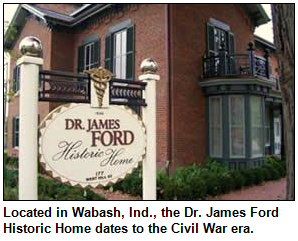 Chris Gahl of the ICVA suggests we take a Roadtrip to Wabash, Ind., to see an excellent example of what a Civil War era home and surgery might look like. The Dr. James Ford Historic Home includes period décor and the opportunity to experience the daily lives of Dr. James Ford and his family during the mid-1800s.
Chris Gahl of the ICVA suggests we take a Roadtrip to Wabash, Ind., to see an excellent example of what a Civil War era home and surgery might look like. The Dr. James Ford Historic Home includes period décor and the opportunity to experience the daily lives of Dr. James Ford and his family during the mid-1800s.
The home includes a Victorian-era flower garden and vegetable and medicinal herb gardens and is open to the public limited hours Wednesday through Sunday. There's more online at www.jamesfordmuseum.org.
A good time to head to Wabash would be June 23-26, when the Charley Creek Artsfest takes place!
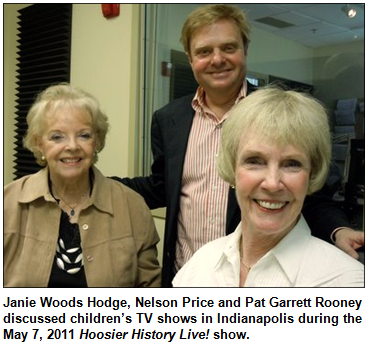 Live in studio!
Live in studio!
(May 14, 2011) - Sometimes in the course of chronicling history, you make a little bit of history, too. Our host, Nelson Price, was delighted to be joined in studio by two pioneers of children's television in Indianapolis: Janie Woods Hodge and Pat Garrett Rooney, who appeared on the May 7, 2011 Hoosier History Live! show.
On the May 7 show, Hodge and Rooney discussed their roles as Channel 4's "Janie" and as Channel 13's "Pat" on the show "Kindergarten College."
Encore presentation
(May 21, 2011) - With a heritage that includes mineral waters renowned for their supposed curative powers, an atrium with one of the largest free-standing domes anywhere (it was touted as the "Eighth Wonder of the World"), a series of colorful owners and a roster of distinguished guests for more than 100 years, the two lavishly restored hotels in French Lick and West Baden are troves for history lovers.
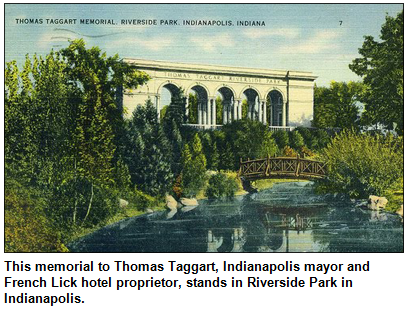 To explore the rollicking history of the French Lick and West Baden Springs hotels, Nelson is joined in studio by a gem of a guest: distinguished Hoosier historian Jim Fadely, widely regarded as the ultimate expert on flamboyant Tom Taggart, the former Indianapolis mayor who purchased the French Lick hotel in the early 1900s and made it an international showplace.
To explore the rollicking history of the French Lick and West Baden Springs hotels, Nelson is joined in studio by a gem of a guest: distinguished Hoosier historian Jim Fadely, widely regarded as the ultimate expert on flamboyant Tom Taggart, the former Indianapolis mayor who purchased the French Lick hotel in the early 1900s and made it an international showplace.
A descendant of early Hoosier settlers (and, like Nelson, a board member of the Society of Indiana Pioneers), Jim is the author of Thomas Taggart: Public Servant, Political Boss 1856-1929 (Indiana Historical Society Press) and a top administrator at University High School near Carmel.
Jim and Nelson have rotated the microphone on tours of the historic hotels in Orange County, where illegal gambling flourished for decades and Taggart's masterful promoters touted a sulfur-based water they marketed as Pluto Water. At the rival West Baden Springs Hotel, mineral water was marketed as Sprudel Water.
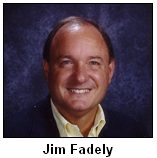 Guests at the hotels during their heydays 100 years ago included Vanderbilts and Rockefellers. A self-made millionaire, Taggart was an Irish immigrant who, as mayor of Indianapolis, won praise for pushing for developing city parks, according to Jim. A few weeks ago, Indiana Landmarks announced that a memorial to Taggart in Riverside Park is among the historic sites on its "10 Most Endangered List."
Guests at the hotels during their heydays 100 years ago included Vanderbilts and Rockefellers. A self-made millionaire, Taggart was an Irish immigrant who, as mayor of Indianapolis, won praise for pushing for developing city parks, according to Jim. A few weeks ago, Indiana Landmarks announced that a memorial to Taggart in Riverside Park is among the historic sites on its "10 Most Endangered List."
After traveling to French Lick on a vacation, Taggart was impressed and bought an existing hotel at the site, where the first inn (known as the French Lick House) had gone up in the 1840s. Then came spectacular success, concurrent with the rise of the rival West Baden Springs.
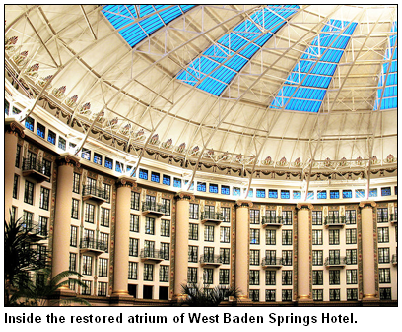 Both hotels underwent stunning restorations in recent years, spearheaded by the late Bloomington-based history preservationist Bill Cook and his wife Gayle. Indiana Landmarks initiated the renovation of West Baden, which had been closed as a hotel since the Great Depression. During the intervening years, West Baden Springs had served as a Jesuit seminary, then as a branch of Northwood Institute, a college that offered instruction in the culinary arts and other fields.
Both hotels underwent stunning restorations in recent years, spearheaded by the late Bloomington-based history preservationist Bill Cook and his wife Gayle. Indiana Landmarks initiated the renovation of West Baden, which had been closed as a hotel since the Great Depression. During the intervening years, West Baden Springs had served as a Jesuit seminary, then as a branch of Northwood Institute, a college that offered instruction in the culinary arts and other fields.
Since its ornate restoration, the French Lick Springs Hotel has 25 miles of hallways and the largest spa in the entire Midwest. One pavilion alone, the Pluto Pavilion, has $300,000 worth of gold leaf.
This show is an encore broadcast of a popular program in our Hoosier History Live! archives. (The original live broadcast date was June 12, 2010.) So there won't be an opportunity for call-in questions from listeners and a chance to answer the History Mystery question. But that opportunity will return on May 28 with a brand-new Hoosier History Live! show, as well as the e-newsletter, which will return on May 27, when Hoosier History Live! will explore Indiana Civil War life on the home front with two distinguished guests from Conner Prairie.
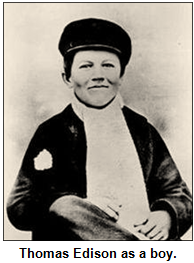 (May 14, 2011) - Are you unaware that one of America's greatest inventors had connections to the Hoosier state? Well, Hoosier History Live! is about to share some, ahem, illuminating info about Thomas A. Edison thanks to a resident expert, Indianapolis-based playwright-performer Hank Fincken.
(May 14, 2011) - Are you unaware that one of America's greatest inventors had connections to the Hoosier state? Well, Hoosier History Live! is about to share some, ahem, illuminating info about Thomas A. Edison thanks to a resident expert, Indianapolis-based playwright-performer Hank Fincken.
When the future icon was 17 years old in 1864, Thomas Edison lived in Indianapolis and worked at Union Depot, the forerunner of Union Station, as a telegraph operator. He invented an early machine while living in the Hoosier capital. And - fasten your seat belts - he eventually was fired from his job at Union Depot.
Before that, young Tom Edison had worked in Fort Wayne as a telegrapher. He was fired from that job, too.
What's the back-story about this tumultuous era in the life of Edison (1847-1931), who went on to hold more than 1,000 patents? Tune in as we explore Edison's connections to Indiana and other aspects of his colorful life with Hank, who performs one-man plays across the country "in character" as the famous inventor known for his independent spirit.
 Edison was born in Milan, Ohio, and grew up in Michigan. By the 1860s, when teenage Tom came to Indianapolis, the bustling town was nicknamed "Railroad City" because the depot served as a junction for so many train lines, according to the book Indianapolis Union Station, written in 2000 by James Hetherington. That meant the Western Union railroad telegraph office, where Edison worked, was "busy and important."
Edison was born in Milan, Ohio, and grew up in Michigan. By the 1860s, when teenage Tom came to Indianapolis, the bustling town was nicknamed "Railroad City" because the depot served as a junction for so many train lines, according to the book Indianapolis Union Station, written in 2000 by James Hetherington. That meant the Western Union railroad telegraph office, where Edison worked, was "busy and important."
But Hank will share insights about why things didn't work out in Indy for the future inventor of the incandescent light bulb, the phonograph and so much else that became part of daily life.
"When the reasonable doesn’t work, try the unreasonable," Hank (as Edison) tells audiences.
Regular listeners will recall that Hank has been our guest before. Nearly two years ago, he shared insights about the life of John Chapman, who became a folk legend as Johnny Appleseed, another character in Hank's repertoire of historic figures and one-man shows. More info about Hank's plays and performances - including video excerpts of him in costume as Edison - is at hankfincken.com.
Some fun facts:
In the late 1940s, Union Station in Indianapolis became the setting for a massive replica of a mythical character.  The replica of the folk character stood more than 50 feet tall, towered over the main concourse of the railroad station and was made of Styrofoam. Although the giant Styrofoam replica stood in Union Station for only a few seasons, it was such a hit that thousands of postcards bearing its likeness were distributed to travelers at the train station for several years.
The replica of the folk character stood more than 50 feet tall, towered over the main concourse of the railroad station and was made of Styrofoam. Although the giant Styrofoam replica stood in Union Station for only a few seasons, it was such a hit that thousands of postcards bearing its likeness were distributed to travelers at the train station for several years.
Question: What mythical character was replicated in giant Styrofoam form during the 1940s at Union Station?
To win the prize, you must call in with the correct answer during the live show. The call-in number is (317) 788-3314, and please do not call until you hear Nelson pose the question on the air. Please do not call if you have won a prize from any WICR show during the last two months. The prize is the fabulous CD of Mr. Edison's Greatest Hits, a collection of old cylinder recordings from Thomas Edison's time, as well as the audio of a standup comedy routine of vaudevillian Cal Stewart. The prize is made possible courtesy of our guest, Hank Fincken.
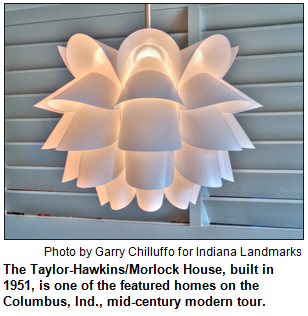 Chris Gahl of the ICVA suggests we take a look at five mid-century modern houses in Columbus, Ind., on Saturday, May 21. The tour is presented by Indiana Landmarks and takes place from 1 to 6 p.m. Tour headquarters is the North Christian Church, 850 Tipton Lane in Columbus, a National Historic Landmark designed by Eero Saarinen.
Chris Gahl of the ICVA suggests we take a look at five mid-century modern houses in Columbus, Ind., on Saturday, May 21. The tour is presented by Indiana Landmarks and takes place from 1 to 6 p.m. Tour headquarters is the North Christian Church, 850 Tipton Lane in Columbus, a National Historic Landmark designed by Eero Saarinen.
You can even make it a weekend in this mecca of modernist architecture by attending a symposium on Columbus's legendary Miller House, hosted by the Indianapolis Museum of Art in Indianapolis, on Friday, May 20. Don’t forget to visit Zaharako's in downtown Columbus (although that is far from modernist; it's an original 1900 ice cream parlor), and you also can stop by the Columbus Area Visitors Center downtown.
(May 7, 2011) - To thousands of Baby Boomer and Gen X children across central Indiana and beyond, the hosts of two daily TV shows seemed more famous than Hollywood movie stars.
As the ukulele-playing, puppet-befriending and child-focused star of Popeye and Janie (later known as just Janie when her local popularity eclipsed that of the cartoon character), Janie Woods Hodge enjoyed a spectacular run on WTTV-Channel 4, appearing every weekday from 1963 to 1986. 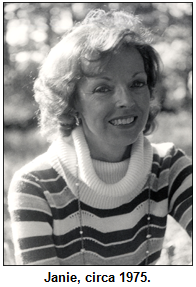 Her show, stuffed with everything from safety tips to a segment called "Janie's Tree House" that featured local Boy Scout, Girl Scout and Brownie troops, became so popular it was syndicated to TV markets across Indiana and as far away as Illinois, Ohio and West Virginia.
Her show, stuffed with everything from safety tips to a segment called "Janie's Tree House" that featured local Boy Scout, Girl Scout and Brownie troops, became so popular it was syndicated to TV markets across Indiana and as far away as Illinois, Ohio and West Virginia.
Not only does the indefatigable Janie join Nelson in studio, so does another perky pioneer of children's TV in Indiana.
His other guest is Indianapolis civic leader Pat Garrett Rooney, who, as Pat Garrett (or just "Pat," as she was known on the air to the rotating groups of children who joined her) was the host of Kindergarten College, a show seen daily on Channel 13 (then an ABC affiliate) from 1957 through 1973.
Pat previously had enjoyed a turn as the Fort Wayne host of Romper Room, a nationally syndicated show overseen by a local personality in each TV market. She was the host of Indianapolis-based Kindergarten College from 1963 until 1966, when she bowed out due to her pregnancy. (In that era, a pregnant woman was verboten on children's shows. Pat will share an anecdote about a curious boy who couldn't resist commenting on her appearance and wardrobe.)
 So how do the grown-up Baby Boomers and Gen X fans - Nelson unabashedly counts himself among their legion - explain the impact and appeal of Janie to newbies to Indiana? Or to those too young to have enjoyed her effervescence?
So how do the grown-up Baby Boomers and Gen X fans - Nelson unabashedly counts himself among their legion - explain the impact and appeal of Janie to newbies to Indiana? Or to those too young to have enjoyed her effervescence?
Suffice it to say Popeye and Janie regularly beat NBC-TV's perennial juggernaut, The Today Show, in the ratings across central Indiana. And that Janie broadcast live from the Indiana State Fair during its run; popped into then-Mayor Richard Lugar's office ("Hi, Mr. Mayor!" her puppet sidekicks chirped), and interviewed celebrities such as Betty Ford when the then-first lady visited the Children's Museum.
And get this, kids: For most of the span that Janie was hosting a live, daily TV show, she also was working as a music teacher at Indianapolis Public Schools. Plus, she was the mother of two young children.
Similarly, Pat also had two young sons when she began Kindergarten College. Her on-air pregnancy involved Pat's third child, a daughter.
As many Hoosiers know, Janie gave a big leg up (or should we say a boot up?) to a young vocalist named Bob Glaze. As Cowboy Bob, he joined Janie on the air, cut a wildly popular album of Christmas songs with her in 1968, and then became the host of his own show on WTTV-Channel 4.
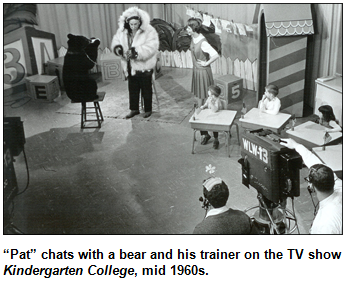 Janie's gigs include narrating Peter and the Wolf with the Indianapolis Symphony Orchestra and performing at Lollipop Concerts attended by hundreds of captivated youngsters.
Janie's gigs include narrating Peter and the Wolf with the Indianapolis Symphony Orchestra and performing at Lollipop Concerts attended by hundreds of captivated youngsters.
On Kindergarten College, young Hoosiers joined Pat for "Breakfast with Santa," "Breakfast at Easter" and other celebratory events. Her approach - as well as that of Pat's predecessor on the show, Barbara Kay Medlicott - was to emphasize what they called "creative play" with children. During the recent Indy in the '60s documentary broadcast on WFYI-Channel 20, Mrs. Medlicott described the concept of creative play. The documentary also featured appearances by Janie and Nelson.
Visitors from the Indianapolis Zoo, pet shops and other cultural or family-friendly businesses were frequent visitors to both Janie and Kindergarten College.
Some fun facts:
During her long run on television in central Indiana, Janie was joined on the air by puppet sidekicks. (Although we have our own cute sidekick on Hoosier History Live!, the Roadtripper.)  The popular puppets included a gopher named Gilroy as well as a snake. There also was a distinctive-looking puppet with a name that's a musical term.
The popular puppets included a gopher named Gilroy as well as a snake. There also was a distinctive-looking puppet with a name that's a musical term.
Question: Name that puppet character.
Hint: His name, when used as a musical term, is a symbol that indicates pitch.
The prize was a one-night stay for two at the Hyatt Regency Indianapolis, as well as romantic gondola ride for two on the Central Canal. Celebrate spring! These prizes are courtesy of the ICVA.
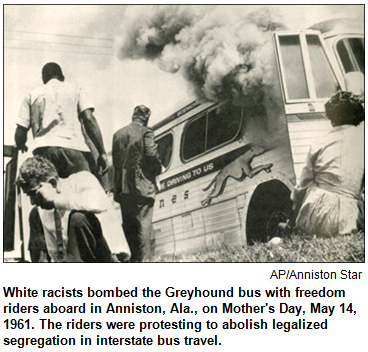 Chris Gahl of the ICVA says "hats off!" to North Decatur Junior-Senior High School history teacher John Pratt (and a former Hoosier History Live! guest) for bringing in three of the original "Freedom Riders" to a Chautauqua at the school on Thursday, May 12, and Friday, May 13.
Chris Gahl of the ICVA says "hats off!" to North Decatur Junior-Senior High School history teacher John Pratt (and a former Hoosier History Live! guest) for bringing in three of the original "Freedom Riders" to a Chautauqua at the school on Thursday, May 12, and Friday, May 13.
The Freedom Riders were a group of whites and blacks who rode buses into the then-segregated South in 1961 to test a Supreme Court decision that banned racial segregation at bus terminals. The first Freedom Ride left Washington, D.C., on May 4, 1961. The three Freedom Riders at the Chautauqua will be Dion Diamond and Reginald Green from Washington, D.C., and Joan Browning from West Virginia.
Also speaking will be John Stokes, one of the original plaintiffs in the 1954 Brown vs. Board of Education Supreme Court case that heralded the beginning of the civil rights movement in the United States. Additionally there are opportunities to ride "Freedom Buses" with commentary by the original Freedom Riders to various parts of the county.
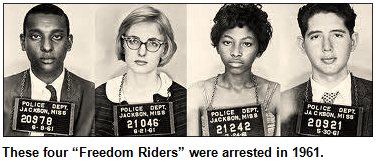 One destination will be the newly renovated African American Methodist Episcopal Church Cemetery which was largely untouched for 150 years. "It's in the middle of the woods," says John. The old cemetery is in the heart of what was known as the Snelling Settlement in Decatur County, a community of more than 200 free blacks who also were part of the Underground Railroad.
One destination will be the newly renovated African American Methodist Episcopal Church Cemetery which was largely untouched for 150 years. "It's in the middle of the woods," says John. The old cemetery is in the heart of what was known as the Snelling Settlement in Decatur County, a community of more than 200 free blacks who also were part of the Underground Railroad.
All events take place or originate from North Decatur Junior-Senior High School just north of Greensburg at 3172 N. State Road 3. More information is available at
www.decaturco.k12.in.us.
We rely on you!
(May 2011) - Hoosier History Live! is independently produced and is responsible for its own fund raising.
We thank Louellen Test Hesse, Patricia Rooney, Loretta and Reid Duffy, Jennifer Smith, Barb and Steve Tegarden, Theresa and David Berghoff, The Fadely Trust - a fund of the Indianapolis Foundation, Gretchen Wolfram, Richard Vonnegut, Don Gorney, Ellen Lee, Joe Young, Dana Waddell and Clay Collins, and several anonymous granting organizations and individuals who have made tax-deductible donations to support the program by following the instructions on "Support the show" on the Hoosier History Live! website.
 "All of us who work on the show wear a lot of hats," says Molly Head, producer. "Much of our energy goes into putting out a good e-newsletter and a good show each week, and our fund-raising efforts could be stronger. We get very few inquiries about sponsorship and donations, even though the contact information is everywhere on our publications. Most of the sponsorship comes from our doing the asking, and many large organizations want a bigger 'media footprint' than our show currently offers.
"All of us who work on the show wear a lot of hats," says Molly Head, producer. "Much of our energy goes into putting out a good e-newsletter and a good show each week, and our fund-raising efforts could be stronger. We get very few inquiries about sponsorship and donations, even though the contact information is everywhere on our publications. Most of the sponsorship comes from our doing the asking, and many large organizations want a bigger 'media footprint' than our show currently offers.
"Meanwhile, we get many requests for full audio archiving of past shows on our website, but I'm loath to push our technical people to work even harder with minimal compensation. I know; our e-newsletter and website look very professional, but that's because Richard Sullivan of Monomedia puts them together.
"We are in the process of sending out several large grant applications to secure the financial future of Hoosier History Live! We would like to have adequate funding in place be able to catalog and archive the past shows on our website, and also to be able to edit the past shows in a way that other radio stations can easily broadcast the shows. Of course, with us being us, we enjoy doing things well. If you are aware of an organization or individual who might be interested in helping us, contact Nelson Price or Molly Head, the project's principals.
"Of course, we continue to seek all donations and sponsorships; at this point, every little bit helps. We think we have an innovative and engaging approach to history not experienced elsewhere. We think the show has a special voice, and we would like to be able to continue that voice."
Encore presentation
(April 30, 2011) - If only your walls could talk, right? This is the ideal show for folks wondering how to track down the past "lives" of their houses. Nelson is joined in studio by two Indianapolis-based home history hunters who live in historic houses themselves and who know firsthand the challenges involved and resources available.
 With tips and advice galore, photo historian Joan Hostetler, owner of Heritage Photo & Research Services, and Tiffany Benedict Berkson, the "Home History Hunter," will offer guidance about how to get started, as well as the pitfalls to avoid.
With tips and advice galore, photo historian Joan Hostetler, owner of Heritage Photo & Research Services, and Tiffany Benedict Berkson, the "Home History Hunter," will offer guidance about how to get started, as well as the pitfalls to avoid.
The two house history "detectives" offer advice to help you:
Joan is the owner of Heritage Photo & Research Services, which specializes in photographic preservation, archive management, digital imaging and photographic research. She lives and works in a home built in 1888 in the Cottage Home neighborhood by the legendary architectural firm of Vonnegut & Bohn. Active in neighborhood revitalization efforts, Joan collaborated with Nelson and photographer Garry Chilluffo on the Indianapolis Then and Now (Thunder Bay Press) visual history book.
Tiffany lives in a spacious, turreted Victorian house built in 1897 in Herron-Morton Place, where she is a past president of the neighborhood association.  An avid local history enthusiast with a particular interest in the Victorian era, she is a member of the Daughters of the American Revolution (Caroline Scott Harrison chapter) and a former volunteer at the President Benjamin Harrison Home.
An avid local history enthusiast with a particular interest in the Victorian era, she is a member of the Daughters of the American Revolution (Caroline Scott Harrison chapter) and a former volunteer at the President Benjamin Harrison Home.
The following "learn more" websites are recommended by our guests:
Also new is Your Historic Indianapolis, an interactive forum where people can post questions about an address or family; it will hopefully be a resource for those willing to explore or share their knowledge of Indianapolis.
This show is an encore broadcast of a popular program in our Hoosier History Live! archives. (The original live broadcast date was May 29, 2010.) So there won't be an opportunity for call-in questions from listeners. But that opportunity will return on May 7 with a brand-new Hoosier History Live! show, as well as the e-newsletter, which will return on May 6.
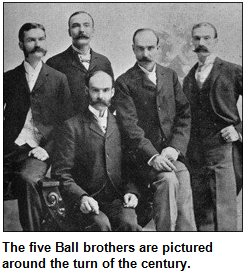 In the news ...
In the news ...
(April 30, 2011) - Nelson was recently interviewed by colleague Victor Reklaitis in the national daily business newspaper Investor's Business Daily in a story about the five Ball Brothers from Muncie. According to the article, the five brothers "manufactured can-do spirit in a jar."
In the article, Nelson says that Frank, one of the five brothers, would display his missing index figure when giving a speech. He had lost the finger in an accident but used that to his advantage when rousing a crowd. Certainly no one has more knowledge of Indiana anomalies than Nelson!
(April 23, 2011) - They met as children and quickly became part of the same group of friends during the Great Depression in Indianapolis. Majie Failey and future literary sensation Kurt Vonnegut Jr. took dance lessons with their pals, spent summer weekends as teenagers at Lake Maxinkuckee and, while attending Shortridge High School, hung out at bygone haunts such as the North Pole drive-in and Eaton's Restaurant.
Majie and Vonnegut, a quipster (even then!) whose childhood nickname was "Kay," remained close friends until his death four years ago this month (April 2007) at age 84. He even told Majie - and several other people - that the major character in his play Happy Birthday, Wanda June (1970) was based on her father.
 Now Majie, who became society editor of The Indianapolis News in the late 1940s, has written We Never Danced Cheek to Cheek (Hawthorne Publishing), an anecdote-filled book about her famous chum. Its title is derived from a note Vonnegut scribbled to her atop the sketch of one of his self-portraits, referring to the fact that, despite their friendship of nearly 75 years, the two never dated.
Now Majie, who became society editor of The Indianapolis News in the late 1940s, has written We Never Danced Cheek to Cheek (Hawthorne Publishing), an anecdote-filled book about her famous chum. Its title is derived from a note Vonnegut scribbled to her atop the sketch of one of his self-portraits, referring to the fact that, despite their friendship of nearly 75 years, the two never dated.
Majie - who eventually married Skip Failey, another Vonnegut crony - joins Nelson in studio to share insights about the Pulitzer Prize-winning author of bestsellers such as Slaughterhouse-Five (1969) and Palm Sunday (1981). Majie writes that Vonnegut often told her he was "happier at Shortridge than anywhere else in his whole life."
His adult life included his capture during World War II by the Germans (as a POW, he witnessed the bombing of Dresden); the sudden death of his mother (Majie writes that she agrees with Vonnegut family members who dispute Kurt's conclusion it was a suicide), and the death of Kurt's beloved sister, Alice, from cancer. 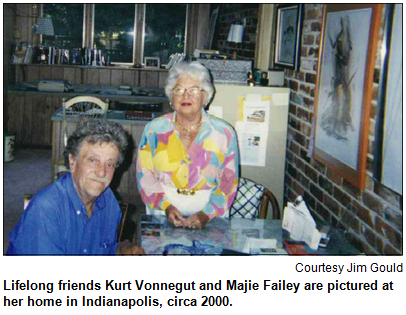 Tragically, Alice's husband was killed in a train accident within days of her death; Kurt promptly adopted her young, orphaned sons.
Tragically, Alice's husband was killed in a train accident within days of her death; Kurt promptly adopted her young, orphaned sons.
He raised them - as well as his three oldest children - with his first wife, Jane Cox Vonnegut, who was Majie's best friend as a young girl at Tudor Hall in Indianapolis. Subsequently, Majie persuaded her parents to let her attend Shortridge, where Vonnegut (class of '40) served as an editor of the legendary Echo, the country's first daily newspaper at a high school. We Never Danced Cheek to Cheek includes photos from yearbooks at Shortridge, where Kurt was a finalist in the "Uglyman" contest - which, despite its title, actually was a popularity contest.
"Trust me, Kurt was not ugly," Majie writes. "Girls wanted a date with him. ... As for Kurt's zany sense of humor, he was to all of us the prince of laughs. ... Kurt Vonnegut spoofed life while he was still trying to understand it."
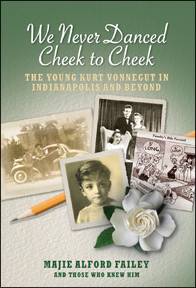 She notes that the two of them made for a "Mutt and Jeff" pairing, with Vonnegut eventually standing 6-feet-3 and tiny Majie barely 5 feet tall. Referring to Vonnegut's note about not dancing cheek-to-cheek, Majie writes, "I could not have reached his cheek, much less his vest buttons."
She notes that the two of them made for a "Mutt and Jeff" pairing, with Vonnegut eventually standing 6-feet-3 and tiny Majie barely 5 feet tall. Referring to Vonnegut's note about not dancing cheek-to-cheek, Majie writes, "I could not have reached his cheek, much less his vest buttons."
In her book, Majie also shares insights about the Vonnegut family's reversal of fortune during the Great Depression; Kurt Sr., an architect, was unable to secure commissions because business and residential construction halted. Because her close friendship with Vonnegut continued for so long - the Faileys were Kurt and Jane's house guests on the East Coast before and during the period he became a literary sensation in the late 1960s - Nelson has much to explore with her during our show.
Even during Vonnegut's final return visits to Indianapolis, he invariably settled on the leather sofa on the sun porch of Majie's home. That's where he often revised the memorable speeches he would deliver to Hoosier audiences.
Some notes:
Among the landmark buildings designed by prominent Indianapolis architect Bernard Vonnegut, the grandfather of Kurt Vonnegut Jr., was the flagship L.S. Ayres department store. 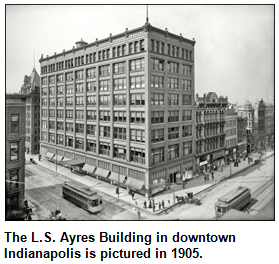 It opened in 1905 at the corner of Meridian and Washington streets. However, one feature of the department store building was not designed until about 30 years later. In the mid-1930s, Bernard's son, Kurt Sr., designed this feature of the Ayres building.
It opened in 1905 at the corner of Meridian and Washington streets. However, one feature of the department store building was not designed until about 30 years later. In the mid-1930s, Bernard's son, Kurt Sr., designed this feature of the Ayres building.
Question: What was it?
The prize was two tickets to the premiere of If These Walls Could Tell, presented by Storytelling Arts of Indiana on Friday, April 29, at 7:30 p.m. at the new Indiana Landmarks Center. The inaugural performance, Hugged by These Walls, told by Sally Perkins, brings to life the people who made the Central Avenue Methodist Church, once the largest Methodist congregation in the state, a powerful contributor to the creation of the capital city. Tickets are courtesy of Indiana Landmarks.
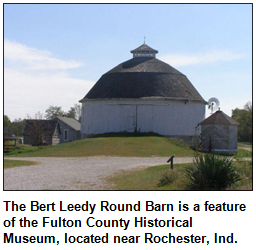 Chris Gahl of the ICVA tells us to head up north along U.S. 31 to Fulton County in the north central part of Indiana, an area also known for its abundance of round barns, and check out the Redbud Trail Rendezvous festival the weekend of April 30 and May 1.
Chris Gahl of the ICVA tells us to head up north along U.S. 31 to Fulton County in the north central part of Indiana, an area also known for its abundance of round barns, and check out the Redbud Trail Rendezvous festival the weekend of April 30 and May 1.
The festival is named for the redbud trees along the Tippecanoe River, and it features historical re-enactors from a number of different periods of frontier Indiana, including western fur trade, French and Indian War and Revolutionary War. You'll also find cooking over open fires, music and dancing, and demonstrations of muzzle-loading rifles. The festival is $3 for adults but also includes free admission to the Fulton County Historical Museum for a look at that round barn.
While you're in the area, the Chief Menominee Memorial is right off the road near Plymouth; lest we forget that the infamous Potawatomi Trail of Death started out from this area in 1838.
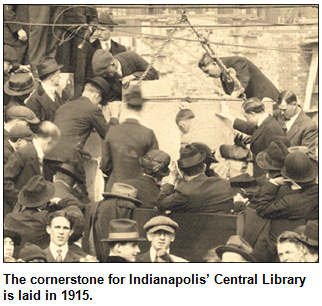 (April 16, 2011) - Chapter One was rather meager. It began in 1873 in a wing of a former private residence that also housed the public high school (a forerunner of Shortridge High School) in Indianapolis. By the late 1890s, though, several branches had opened of what today is the Indianapolis-Marion County Public Library.
(April 16, 2011) - Chapter One was rather meager. It began in 1873 in a wing of a former private residence that also housed the public high school (a forerunner of Shortridge High School) in Indianapolis. By the late 1890s, though, several branches had opened of what today is the Indianapolis-Marion County Public Library.
For many years, the most popular branch in the system was the Haughville Branch, which served a large immigrant population that settled around the nearby Kingan & Company pork processing plant.Central Library, which opened in 1917, was designed by French architect Paul Phillipe Cret, who, according to folklore, even touched up his sketches in the foxholes of World War I while fighting on behalf of his homeland.
To explore these and other intriguing details about library history in the Hoosier capital, Nelson is joined in studio by S.L. "Skip" Berry, the author of Stacks: A History of the Indianapolis-Marion County Public Library, and Christopher Marshall, the team leader of the Nina Mason Pulliam Indianapolis-Special Indianapolis-Special Collections Room at Central Library.
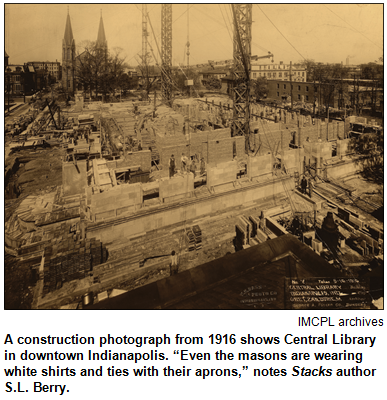 Funded by private donations from the IMCPL Foundation, Stacks describes the ever-evolving relationship between the library system and the community for nearly 140 years. According to Skip, the former visual arts writer for The Indianapolis Star (and a Hoosier History Live! guest two years ago in connection with his pop history of the Indianapolis Museum of Art), the first director of the library was hired, fired, re-hired and then re-fired. The saga extended from the 1870s through 1892. His difficulties apparently involved an inability to compromise with the local school board, which then oversaw the library system.
Funded by private donations from the IMCPL Foundation, Stacks describes the ever-evolving relationship between the library system and the community for nearly 140 years. According to Skip, the former visual arts writer for The Indianapolis Star (and a Hoosier History Live! guest two years ago in connection with his pop history of the Indianapolis Museum of Art), the first director of the library was hired, fired, re-hired and then re-fired. The saga extended from the 1870s through 1892. His difficulties apparently involved an inability to compromise with the local school board, which then oversaw the library system.
Some fun facts:
Chris Gahl of the ICVA suggests that we take the Roadtrip to the much-awaited Wondrous Opening Weekend of the restored former Central Avenue Methodist Church at 12th Street and Central Avenue in downtown Indianapolis, which can be seen on the north side of I-70 in downtown Indianapolis. All of the excitement takes place this weekend, April 16 and 17, to celebrate the opening of the new Indiana Landmarks headquarters.
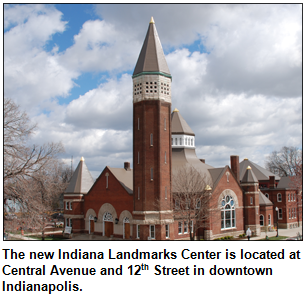 The gala celebration on April 16, which includes a John Mellencamp performance, has been sold out, but there is a free Open House for all on Sunday, April 17, from 11 a.m. to 2 p.m. that includes music, family activities and free admission to the Morris-Butler House next door. Then there's a Classical Bash on Sunday evening for $75 per person with Grammy Award-winning singer Sylvia McNair, followed by a "Taste of Indiana Landmarks Center." Ticket information is available.
The gala celebration on April 16, which includes a John Mellencamp performance, has been sold out, but there is a free Open House for all on Sunday, April 17, from 11 a.m. to 2 p.m. that includes music, family activities and free admission to the Morris-Butler House next door. Then there's a Classical Bash on Sunday evening for $75 per person with Grammy Award-winning singer Sylvia McNair, followed by a "Taste of Indiana Landmarks Center." Ticket information is available.
Spades Park Library opened in 1912 on the near-Eastside of Indianapolis. It's known as a "Carnegie Library" because the Spades Park branch, along with many counterparts across the country, was constructed with a grant from the Andrew Carnegie Foundation. 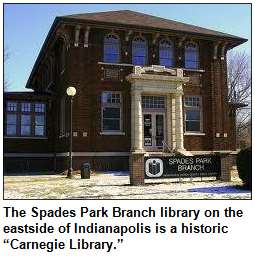 In addition to Spades Park, one other branch library in the Indianapolis-Marion County Public Library system is a historic Carnegie Library."
In addition to Spades Park, one other branch library in the Indianapolis-Marion County Public Library system is a historic Carnegie Library."
Question: Name the branch library.
The prize was two "Original" hamburgers at Johnny Rockets in Circle Centre mall in downtown Indianapolis, and two tickets to Morty's Comedy Joint on the northeastside of Indianapolis, all courtesy of the ICVA.
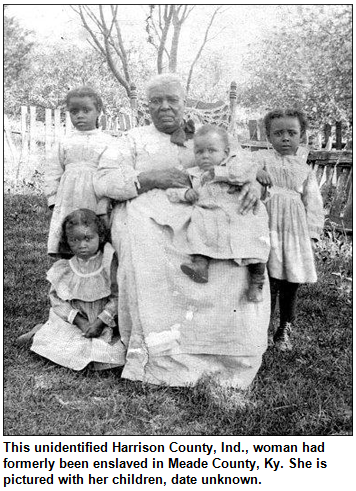 (April 9, 2011) - Tales about the Underground Railroad have captivated the public for generations. Did you know, though, that hundreds of African-Americans journeyed to freedom in the earliest days of Indiana - in some cases, several years before we achieved statehood in 1816? Many of these African-American freedom seekers were slaves who were brought from the South to Indiana, then set free. Others escaped and fled to Hoosier towns and rural areas.
(April 9, 2011) - Tales about the Underground Railroad have captivated the public for generations. Did you know, though, that hundreds of African-Americans journeyed to freedom in the earliest days of Indiana - in some cases, several years before we achieved statehood in 1816? Many of these African-American freedom seekers were slaves who were brought from the South to Indiana, then set free. Others escaped and fled to Hoosier towns and rural areas.
To explore the intriguing but little-known details of "freedom seeking" before the Underground Railroad era (generally defined as beginning in the mid-1830s), Nelson is joined in studio by Maxine Brown, a Corydon-based historic preservationist. She shares the stories of pioneers to southern Indiana areas such as Clark County, Harrison County and Floyd County.
For example, in 1802 - when most of Indiana was still a wilderness - emancipated slaves from Kentucky named Ben and Venus McGee settled in Clark County.  Maxine, who has a copy of their deed of emancipation, reports that a reconstruction of the McGees' small cabin is under way near the Lewis and Clark cabin in Clarksville; it will be a site on the Indiana African American Heritage Trail that's being developed.
Maxine, who has a copy of their deed of emancipation, reports that a reconstruction of the McGees' small cabin is under way near the Lewis and Clark cabin in Clarksville; it will be a site on the Indiana African American Heritage Trail that's being developed.
During our show, Maxine also shares details about a free black man named Oswell Wright who came to Harrison County in the 1820s, then devoted himself to helping assist the escapes of slaves from Kentucky. Some accounts indicate these activities almost sparked a border war between Indiana and Kentucky.
Maxine, who is descended from early settlers in Corydon, was our guest two years ago for a show about her renovation of the Leora Brown School. It's a cultural center in her hometown that she created by restoring the historic Corydon Colored School, which closed with integration. A board member of Indiana Landmarks and the Society of Indiana Pioneers, Maxine is considered an expert on early African-American migration to the Hoosier state.
 Details about freedom seekers before the Underground Railroad - as well as other eras in black history - will be the focus of "A Progressive Journey," a conference June 8-10 in Jeffersonville. If you'd like more information about the conference, click on the provided web link, or Maxine may be contacted directly at (502) 550-0484.
Details about freedom seekers before the Underground Railroad - as well as other eras in black history - will be the focus of "A Progressive Journey," a conference June 8-10 in Jeffersonville. If you'd like more information about the conference, click on the provided web link, or Maxine may be contacted directly at (502) 550-0484.
According to Maxine's research, many slaves who were brought to Indiana before statehood, then freed, were soon compelled to sign "indentured servitude" contracts with Hoosier families. These contracts were the focus of a Hoosier History Live! show last November that focused on an Indiana Supreme Court case in the 1820s involving challenges to the indenture practice, under which African-Americans often signed long-term contracts that provided room, board and clothing, but no pay.
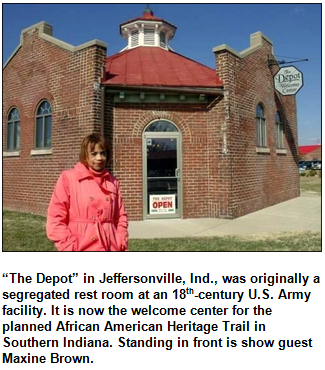 The McGees were the indentured servants of the family of Revolutionary War-era frontiersman and military leader George Rogers Clark, for whom Clark County is named. (Before the Clarks moved to Indiana, the McGees had been their slaves in Kentucky.) The reconstruction of the McGees' cabin was begun last summer by the Indiana Youth Conservation Corps with many tools used in the 19th century. The small Indiana settlement that included the McGees' cabin was called Guinea Bottoms, Maxine reports.
The McGees were the indentured servants of the family of Revolutionary War-era frontiersman and military leader George Rogers Clark, for whom Clark County is named. (Before the Clarks moved to Indiana, the McGees had been their slaves in Kentucky.) The reconstruction of the McGees' cabin was begun last summer by the Indiana Youth Conservation Corps with many tools used in the 19th century. The small Indiana settlement that included the McGees' cabin was called Guinea Bottoms, Maxine reports.
She says Oswell Wright was brought to Indiana as a free man with the Bell family, who purchased a ferry service between Brandenburg, Ky., and Morvin's Landing in Harrison County. They lived on the Indiana side in a house overlooking the Ohio River. In 1857, Wright was arrested for allegedly assisting the escape of a slave from Brandenburg. He was tried and imprisoned for five years in Kentucky, then returned to Indiana. About two years ago, a historic marker honoring Wright was erected in Corydon, his adopted hometown.
Chris Gahl of the ICVA suggested that we take the Roadtrip to the inaugural Indiana Artisan Marketplace on Saturday, April 16, from 10 a.m. to 6 p.m. and on Sunday, April 17, from 10 a.m. to 5 p.m. at Expo Hall at the Indiana State Fairgrounds. 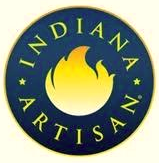 Chris promises "all eclectic things Indiana made" at this multi-sensory event, from sea salt pecan chews to chili-spiced fudge sauce to wearable fiber art.
Chris promises "all eclectic things Indiana made" at this multi-sensory event, from sea salt pecan chews to chili-spiced fudge sauce to wearable fiber art.
Indiana Artisan was established in 2008 to identify and support the business development of Hoosier entrepreneurs who create high-quality arts, crafts and value-added foods (think salsa, not tomatoes; wine, not grapes). The first-time event will feature the work of approximately 90 artists and food artisans whose work has been juried into the prestigious Indiana Artisan program.
"This event is a chance to buy one-of-a-kind artwork and artisan food directly from the Hoosiers who make it," said Tom Prichard, chair of the Indiana Artisan Marketplace. Admission is $8, and parking is $3.
In addition to the many African-Americans who gained their freedom by crossing the Ohio River into Clark County, Harrison County and other parts of southern Indiana, a small port along the Ohio River in Harrison County also served as the point of entry into Indiana of a famous person in 1863. 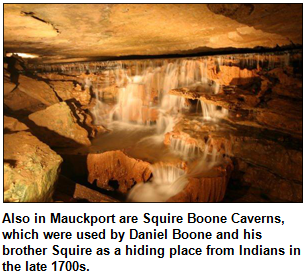 He or she entered Indiana near the small river town of Mauckport in July of that year. The famous historic figure wasn’t an African-American – or even a Hoosier – but did have a major impact on the state during his or her stay.
He or she entered Indiana near the small river town of Mauckport in July of that year. The famous historic figure wasn’t an African-American – or even a Hoosier – but did have a major impact on the state during his or her stay.
Question: Name the historic figure who came to Indiana in 1863 through the town of Mauckport.
The prize was two tickets to the Indiana Wine Fair in Brown County on April 30, courtesy of the Indiana Wine Fair, plus an overnight stay for two at the Westin Indianapolis with a 3 p.m. checkout, plus breakfast for two at Shula's, courtesy of the ICVA.
(April 2, 2011) - Acclaimed far and wide for the depth of his historic research - his novels have sold more than 2 million copies around the world - James Alexander Thom is the best-known author currently living on Indiana soil. 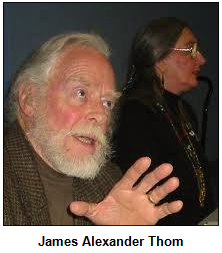 Not only is Nelson visited by this legendary Hoosier, who prefers to be called "Jim" (what would you expect from a nature lover who lives in a 19th-century log cabin that he moved and reconstructed himself on a ridge near a forest in Owen County?), they also are joined by Jim's wife, Dark Rain Thom, a Shawnee elder, tribal historian and fellow author.
Not only is Nelson visited by this legendary Hoosier, who prefers to be called "Jim" (what would you expect from a nature lover who lives in a 19th-century log cabin that he moved and reconstructed himself on a ridge near a forest in Owen County?), they also are joined by Jim's wife, Dark Rain Thom, a Shawnee elder, tribal historian and fellow author.
Jim, whose novels have included Follow the River, which hit the New York Times bestseller list in 1981, and Panther in the Sky (1989), about the great Shawnee leader Tecumseh, shares insights and challenges about writing historical fiction. The Indiana Magazine of History calls him a "master of the form" in a review of Jim's newest book, The Art and Craft of Writing Historical Fiction (Writer's Digest Books).
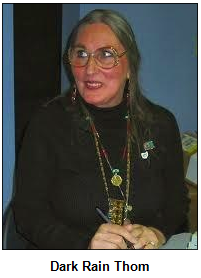 Dark Rain, who served on the Lewis and Clark Bicentennial Planning Council, and Jim also are the co-authors of Warrior Woman (2004), a novelistic portrait of a real-life, female Shawnee leader of the 1770s. Drawing on their historical research, the Thoms describe the Shawnee "warrior woman," whose name was Nonhelema, as articulate, "imposing at more than six feet tall" and desirous of peace. Compelled to fight when her tribe's homes were threatened by thousands of Virginians, she rode into battle "covered in war paint" - and ultimately ended up, as the Thoms put it, "estranged from her own people - and betrayed by her white adversaries."
Dark Rain, who served on the Lewis and Clark Bicentennial Planning Council, and Jim also are the co-authors of Warrior Woman (2004), a novelistic portrait of a real-life, female Shawnee leader of the 1770s. Drawing on their historical research, the Thoms describe the Shawnee "warrior woman," whose name was Nonhelema, as articulate, "imposing at more than six feet tall" and desirous of peace. Compelled to fight when her tribe's homes were threatened by thousands of Virginians, she rode into battle "covered in war paint" - and ultimately ended up, as the Thoms put it, "estranged from her own people - and betrayed by her white adversaries."
During this memorable show, Nelson talks with the husband-and-wife team about myths concerning the Shawnee, as well as their historic home. A native of Owen County, Jim did much of the salvage and reconstruction work himself on the cabin, reassembling it log by log, using material from the 1800s, and sleeping in a tent during the process. 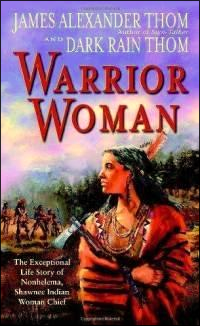 (During that stretch, he wrote at night by kerosene light.) The westward view from his secluded cabin - a panorama of a valley - is said to be nearly identical to the view 200 years ago.
(During that stretch, he wrote at night by kerosene light.) The westward view from his secluded cabin - a panorama of a valley - is said to be nearly identical to the view 200 years ago.
His bestseller Follow the River is a fictional account of the true story of a white woman's capture by the Shawnee in 1755 and her eventual escape, which took her 1,000 miles. Jim's other bestsellers have included Long Knife (1979), about the exploits of George Rogers Clark during the Revolutionary War, and Sign-Talker (2000), which focuses on a French-Shawnee scout who provided invaluable assistance to Lewis and Clark.
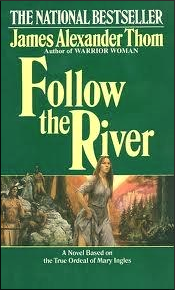 After Jim and Dark Rain met at a Shawnee encampment in Ohio, the couple married in 1990. Before co-writing Warrior Woman with her husband, Dark Rain was the author of Kohkumthena's Grandchildren (1994), a history of the Shawnee. Fun fact: The artwork for her book's cover is an illustration of a Shawnee elder and a grandchild created by James Alexander Thom.
After Jim and Dark Rain met at a Shawnee encampment in Ohio, the couple married in 1990. Before co-writing Warrior Woman with her husband, Dark Rain was the author of Kohkumthena's Grandchildren (1994), a history of the Shawnee. Fun fact: The artwork for her book's cover is an illustration of a Shawnee elder and a grandchild created by James Alexander Thom.
In addition to his creative and literary talents, Jim is known for going to great lengths to recreate the noises, smells and other sensations of the historic settings and experiences depicted in his books. According to several accounts, Jim fasted for so long while doing the research for Long Knife - he wanted to accurately and precisely describe the experience - that he nearly starved to death. For other book projects, Jim has waded through icy streams during winter.
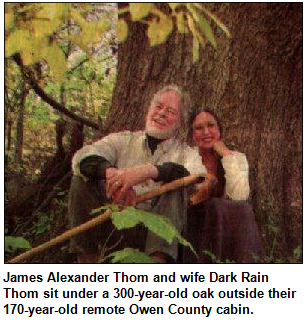 In The Art and Craft of Writing Historical Fiction, he explains that he finds doing the research "as exciting and fascinating as doing the writing." He has tracked down letters, journals, census reports and vintage newspapers, in addition to immersing himself in the sensory experiences of his characters.
In The Art and Craft of Writing Historical Fiction, he explains that he finds doing the research "as exciting and fascinating as doing the writing." He has tracked down letters, journals, census reports and vintage newspapers, in addition to immersing himself in the sensory experiences of his characters.
His non-fiction books include The Spirit of the Place (1995), a celebration of Indiana's hill country that pairs Jim's descriptive prose with sweeping photos by acclaimed Indiana photographer Darryl Jones. The Indianapolis Star lauded Jim's text as "spare, yet evocative."
"I'm so glad that I grew up with the sense that the past isn't 'back there,'" Jim told Nuvo Newsweekly in 2009. "History isn't 'back there.' We're still in it. It's a river. Everything that goes into it affects everything else, and we're creating more of it."
Not only are the Thoms' admirers legion, we can't resist noting Jim won the inaugural Indiana Authors Award in 2009 given by the Indianapolis-Marion County Public Library Foundation.
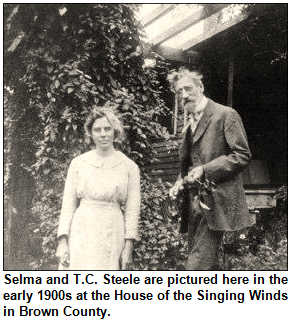 Chris Gahl of the ICVA suggested we take a roadtrip to the one of the most spectacular hilltops in Brown County, the T.C. Steele State Historic Site just southwest of Nashville.
Chris Gahl of the ICVA suggested we take a roadtrip to the one of the most spectacular hilltops in Brown County, the T.C. Steele State Historic Site just southwest of Nashville.
Famed "Hoosier Group" artist T.C. Steele's magnificently placed House of the Singing Winds will host Selma's Secret Garden Tea Party on Saturday, April 9 at 11 a.m.
Selma Steele was T.C. Steele's eclectic second wife, and the party will feature tea and goodies in Selma's garden, along with an opportunity to see the Arts and Crafts Moments exhibit in the house.
All ages are welcome, and registration is required. More information is available on the web link or at (812) 988-2785.
In 1981, the historical novel Follow the River, by James Alexander Thom, spent several weeks in a row on The New York Times bestseller list. Follow the River focuses on a young Virginia woman captured by the Shawnee and her 1,000-mile escape. Follow the River was replaced on the bestseller list by a much different type of book, one that focused on a comic strip character with Hoosier connections.
Question: Name the comic strip character whose book replaced James Alexander Thom's Follow the River on the bestseller list in 1981.
The prize was two tickets to the Indiana Wine Fair in Brown County on April 30, courtesy of the Indiana Wine Fair, plus an overnight stay for two at the Conrad Indianapolis during the month of April, courtesy of the ICVA. The stay at the luxurious Conrad might be a special benefit for those who listened to the previous week's Hoosier History Live!; the show about Victorian women "behind closed doors" was a little steamy!
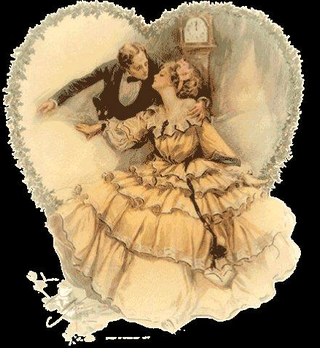 (March 26, 2011) - When the spotlight shines on Victorian-era women during Women's History Month, they typically are depicted as repressed, prim and obsessed with "proper" social behavior. The most famous Hoosier suffragette, educator and civic leader May right Sewall, caused a stir in the late 1800s by insisting that her ndianapolis Classical School for Girls include a gymnasium. (Physical education was not considered "proper" for girls.) Mrs. Sewall also wore her skirts at ankle length, a shocker in an era when women's dresses swept the ground.
(March 26, 2011) - When the spotlight shines on Victorian-era women during Women's History Month, they typically are depicted as repressed, prim and obsessed with "proper" social behavior. The most famous Hoosier suffragette, educator and civic leader May right Sewall, caused a stir in the late 1800s by insisting that her ndianapolis Classical School for Girls include a gymnasium. (Physical education was not considered "proper" for girls.) Mrs. Sewall also wore her skirts at ankle length, a shocker in an era when women's dresses swept the ground.
Indeed, says Karen Lystra, there was a fixation during the Victorian era (1837-1901) with displaying "proper" behavior in public. In private, though, the Victorians were anything but prudish, enjoyed a bawdy sense of humor and have been inaccurately stereotyped for generations, Karen says.
A professor of American studies at California State University, Karen Lystra has been spending most of her time in Indianapolis in recent years and has tracked down, read and analyzed thousands of letters and diaries written during the Victorian era.
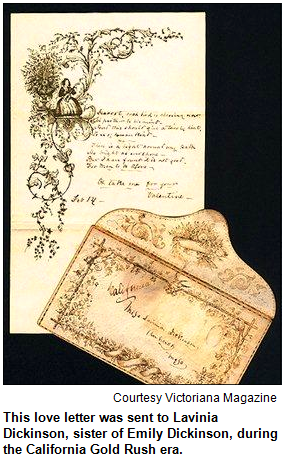 She says wildly misleading folklore about Victorians emanates from a few incidents that robably never happened, including Queen Victoria's supposed advice to her granddaughter about her wedding night: "Lie still and think of the Empire." (In fact, Karen says, Queen Victoria's recollections of her own wedding night are joyful and, ahem, uninhibited.)
She says wildly misleading folklore about Victorians emanates from a few incidents that robably never happened, including Queen Victoria's supposed advice to her granddaughter about her wedding night: "Lie still and think of the Empire." (In fact, Karen says, Queen Victoria's recollections of her own wedding night are joyful and, ahem, uninhibited.)
Rather than succumbing to loveless marriages as per stereotypes, Victorian-era people pioneered the concept of love as a basis for marriage, breaking from previous generations who placed sharp restrictions on who could wed whom, Karen says.
"Victorians didn’t invent love, of course, but they were revolutionary in the concept of love as a basis for marriage," she notes. "This also sets up divorce, because when you base marriage on feelings, you set up expectations."
Karen, the author of Searching the Heart: Women, Men and Romantic Love in Nineteenth Century America (Oxford University Press), is tracking down letters written by working-class Hoosiers during the Victorian era; she welcomes tips and may be contacted at klystra@fullerton.edu.
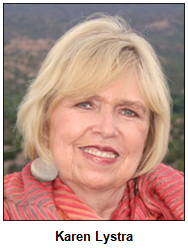 Meanwhile, Karen has been giving fascinating presentations around Indy - including to the Hoosier Chapter, Victorian Society of America - as she explains who created the myths about our Victorian ancestors and why they differed so much in private from their "proper" public personas.
Meanwhile, Karen has been giving fascinating presentations around Indy - including to the Hoosier Chapter, Victorian Society of America - as she explains who created the myths about our Victorian ancestors and why they differed so much in private from their "proper" public personas.
Among the Victorian-era letters Karen has uncovered is a note written during the Civil War by future Indiana Supreme Court Justice John V. Hadley (1840-1915), a native of Hendricks County, to his secret fiancé. The missive, written in 1863, includes this passage:
"It was Sunday night when you wrote your last. And you say that you wished me there. Thanks for the honor you do me. And Heavens how my heart fluttered in responding Amen to your wish. ...  Oh how I did wish it were mine to step to your back and ... to have touched you gently on the shoulder and exclaimed 'I am here.' The ecstasy of the moment I believe would have been fully felt with grasping hands and touching lips. ... But such a time is coming Dear Mary, And we'll sit on the sofa. We'll draw nigh unto each other, we'll talk, we'll love."
Oh how I did wish it were mine to step to your back and ... to have touched you gently on the shoulder and exclaimed 'I am here.' The ecstasy of the moment I believe would have been fully felt with grasping hands and touching lips. ... But such a time is coming Dear Mary, And we'll sit on the sofa. We'll draw nigh unto each other, we'll talk, we'll love."
Other letters written during the Victorian era by women to their lovers and husbands (or to their close friends and relatives, describing their passion for their lovers) are even steamier. Although Victorian-era women did not talk about sex in public because of the emphasis on "proper" appearances, Karen says they discussed it frankly in private.
During our show, she explains who created and perpetuated the inaccurate stereotypes of Victorians that persist to this day. Namely, that they were repressed; their marriages were loveless; courtship was chaperoned, and women were "raised to be passionless and men to seek fun and sexual release with prostitutes."
In fact, Karen says, Victorian-era courtships were not chaperoned after a certain stage in the relationship; courtships and marriages were full of erotic passion and romantic love.
Join us as we visit Victorian-era parlors and even sneak upstairs, all in the quest of accurate history.
Chris Gahl of the ICVA suggests we take the Roadtrip to the Indiana Repertory Theatre in downtown Indianapolis to see a play that explores one of the darkest episodes of our state's history, the infamous double lynching of two young black men by an angry mob in Marion, Indiana, on Aug. 7, 1930. Three young black men had been accused of murdering a white man, Claude Deeter, and of raping his female companion, Mary Ball, who had been parked along a lover's lane.  The three accused were pulled from the jail the next evening by an angry mob. Two of the men were lynched, and the youngest of the three, James Cameron, was spared at the last minute by the crowd.
The three accused were pulled from the jail the next evening by an angry mob. Two of the men were lynched, and the youngest of the three, James Cameron, was spared at the last minute by the crowd.
The Gospel According to James features two-time Tony-nominated actor André De Shields (The Full Monty and Play On!). The play focuses on an imagined meeting in 1980 between James Cameron and Mary Ball.
The Marion lynching was made famous by the iconic Lawrence Beitler black-and-white photograph of the incident. 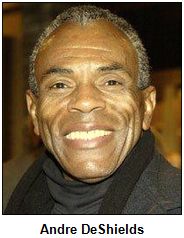 Beitler was in fact a professional photographer in Marion who spent the next 10 days reproducing copies of his photograph, which he sold as souvenirs for 50 cents. Horrifically, lynching photos at the time were often made into postcards as novelty items.
Beitler was in fact a professional photographer in Marion who spent the next 10 days reproducing copies of his photograph, which he sold as souvenirs for 50 cents. Horrifically, lynching photos at the time were often made into postcards as novelty items.
Indiana University historian James Madison, considered an authority on the Marion event and author of A Lynching in the Heartland (Palgrave McMillan, 2001), said in a 2010 NPR story, "We know that three young black men were at the scene of the crime. We know there was also a young white woman at the scene of the crime. Who pulled the trigger, who shot Claude Deeter, is not known. And I don't think really can be known."
You can listen to the NPR story here (contains graphic language and images). The IRT production runs through Sunday, April 10.
On her wedding day to Prince Albert in 1840, Queen Victoria did something that eventually became a tradition for brides across America, including Indiana. It took many decades, however, for the tradition to firmly take hold for some brides in this country.
Question: What did Queen Victoria do on her wedding day that has become a tradition?
The prize was four tickets to the Indiana Wine Fair in Brown County on April 30, courtesy of the Indiana Wine Fair.
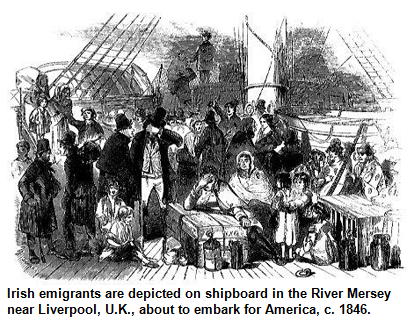 (March 19, 2011) - Hoosier History Live! tips our hat to the Irish among us by exploring when and why immigrants from the Emerald Isle came to the Hoosier state, where they settled, and their cultural and economic impact here.
(March 19, 2011) - Hoosier History Live! tips our hat to the Irish among us by exploring when and why immigrants from the Emerald Isle came to the Hoosier state, where they settled, and their cultural and economic impact here.
Nelson is joined in studio by his longtime colleague John Shaughnessy, former columnist for The Indianapolis Star and author of The Irish Way of Life (Corby Publishing), an anthology of human-interest stories about Irish immigrants; John currently is assistant editor of The Criterion, the newspaper of the Catholic Archdiocese of Indianapolis.
Nelson and John are joined by the official historian for Marion County, David Vanderstel, an adjunct professor at IUPUI. According to an article about the Irish in The Encyclopedia of Indianapolis, they quickly became the Hoosier capital's second-largest ethnic heritage group from Europe. (They were exceeded only by residents of German heritage.)
Agents for the Wabash and Erie Canal in the early 1830s specifically recruited Irish immigrants to Indiana with advertisements for "canal hands" offering "$10 per month for sober and industrious men," according to David's account.
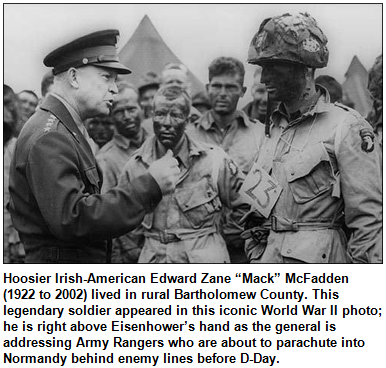 Others came to build roads, including the Old National Road. According to Peopling Indiana: The Ethnic Experience (Indiana Historical Society Press), in 1900 six of the 10 Hoosier counties with the highest numbers of Irish immigrants were on the old Wabash and Erie Canal line or on the Old National Road: Allen, Cass, Marion, Tippecanoe, Vigo and Wayne counties.
Others came to build roads, including the Old National Road. According to Peopling Indiana: The Ethnic Experience (Indiana Historical Society Press), in 1900 six of the 10 Hoosier counties with the highest numbers of Irish immigrants were on the old Wabash and Erie Canal line or on the Old National Road: Allen, Cass, Marion, Tippecanoe, Vigo and Wayne counties.
Life here certainly wasn't a breeze for many of the immigrants. Although canal excavation offered a way to escape urban poverty in East Coast cities, it was hard, dirty and (in the summer) hot work, Peopling Indiana emphasizes. Canal diggers lived in "primitive and unsanitary shelters" and "moved in social circles that were conducive to rowdiness and heavy drinking." Conditions became so deplorable that Irish-American newspapers even started discouraging immigrants from taking jobs in canal construction.
Other challenges mounted. Funding for public works projects such as roads and canals often dried up, meaning the Irish found themselves unemployed "within a community unable to absorb them financially," according to an account by David Vanderstel, our guest.
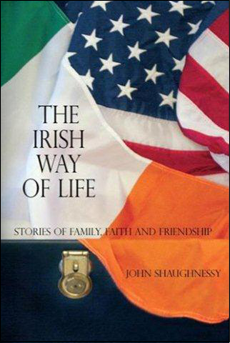 In Ireland, the potato famine that began in the 1840s resulted in a tidal wave of immigration. According to The Irish in America (Hyperion), one-fourth of the country's population had come to America by 1860. Conditions on the boats to America have been described as wretched; so many Irish died during the voyages that the boats became known, as The Irish in America puts it, as "coffin ships."
In Ireland, the potato famine that began in the 1840s resulted in a tidal wave of immigration. According to The Irish in America (Hyperion), one-fourth of the country's population had come to America by 1860. Conditions on the boats to America have been described as wretched; so many Irish died during the voyages that the boats became known, as The Irish in America puts it, as "coffin ships."
Is it any wonder the Irish often have turned to music as a diversion? John Shaughnessy's book includes insights about Irish folk tunes and the ways that love and loss frequently are intertwined. He also conveys a sense of the awe with which generations of Irish families have regarded the University of Norte Dame. Although Notre Dame was founded by a French priest, it quickly became an Irish Catholic bastion, with its sports teams known, of course, as the Fighting Irish.
During the 1850s, the Irish immigrant population tripled in Indianapolis and Terre Haute. In Indianapolis, the early waves of Irish immigrants tended to settle in two neighborhoods: the area that became known as "Irish Hill" on the near-Southside (it's generally considered to be bounded by Shelby Street and College Avenue) and Fountain Square on the near Southeastside.
So there is much Hoosier turf, or sod, for John, David and Nelson to explore. Rest assured, the show consists of more than just facts and trends. John, whose grandparents were Irish immigrants, shares anecdotes that convey, as he puts it, "the heart, humor and heritage" of the Irish among us. Along with his siblings and cousins, John has made certain his grandparents' names have been etched at Ellis Island on the American Immigrant Wall of Honor.
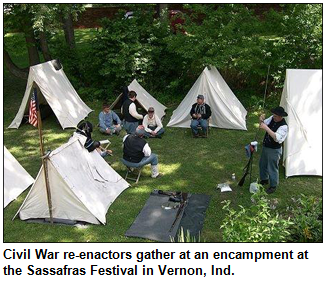 Chris Gahl of the ICVA tells us to head to Vernon in southeastern Indiana on April 16-17 for the Sassafras Tea Festival, sponsored by the Jennings County Historical Society. You'll be able to see a Civil War reenactment of Morgan's Raiders passing through Vernon, which occurred in July of 1863. During that confrontation, Confederate General John Morgan demanded the surrender of the town and was met with resistance from Colonel Hugh Williams of the Indiana Legion, who said that Morgan "must take it by hard fighting." No real battle occurred, and Morgan's men headed south to Dupont in Jefferson County.
Chris Gahl of the ICVA tells us to head to Vernon in southeastern Indiana on April 16-17 for the Sassafras Tea Festival, sponsored by the Jennings County Historical Society. You'll be able to see a Civil War reenactment of Morgan's Raiders passing through Vernon, which occurred in July of 1863. During that confrontation, Confederate General John Morgan demanded the surrender of the town and was met with resistance from Colonel Hugh Williams of the Indiana Legion, who said that Morgan "must take it by hard fighting." No real battle occurred, and Morgan's men headed south to Dupont in Jefferson County.
By the way, Jessamyn West's book The Friendly Persuasion was based on this historic incident and other stories told to her from her early Quaker childhood in Jennings County. Also, Conner Prairie's reenactment of Morgan's raid at Dupont will open on June 4 this summer.
If you travel to the Sassafras Tea Festival in Vernon in April, you'll also be able to visit a Civil War encampment, waltz at the Blue-Gray Ball and chow down on ham and beans, homemade pies and sweet breads - and also some sassafras tea.
Irish immigrants founded the oldest Catholic church in Indianapolis. Origins of the parish date to the 1830s.  However, the current church building, the third for the parish, was constructed during the late 1860s and early 1870s. The parish rectory was built during the Civil War, then significantly enlarged.
However, the current church building, the third for the parish, was constructed during the late 1860s and early 1870s. The parish rectory was built during the Civil War, then significantly enlarged.
Question: Name the historic Catholic church founded by Irish immigrants to Indianapolis. Hint: It was the focus of a Hoosier History Live! show last fall.
The prize was a pair of tickets to the Indianapolis Motor Speedway Hall of Fame Museum, courtesy of the ICVA.
What's new
(March 19, 2011) - Our own Nelson Price, an expert on all things Hoosier, grew up in Indianapolis during the 1960s, a decade that began as a mild reflection of the complacent '50s. That decade later turned itself upside down with its social upheaval, spotlight on racial and social injustice, and opposition to the Vietnam War.
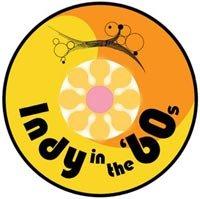 Was Indianapolis still in a time warp during this period? If you watch public television's new documentary Indy in the '60s, you will see Nelson weigh in various topics, including downtown Indy at the time. He also talks about local television personalities, the House of Blue Lights, the Coliseum explosion in October of 1963, and his family's reaction to the JFK assassination, which occurred less than a month after the explosion.
Was Indianapolis still in a time warp during this period? If you watch public television's new documentary Indy in the '60s, you will see Nelson weigh in various topics, including downtown Indy at the time. He also talks about local television personalities, the House of Blue Lights, the Coliseum explosion in October of 1963, and his family's reaction to the JFK assassination, which occurred less than a month after the explosion.
Incidentally, visit the home page of our website to view a list of shows created over the past three years, many of which cover these topics in radio interview format.
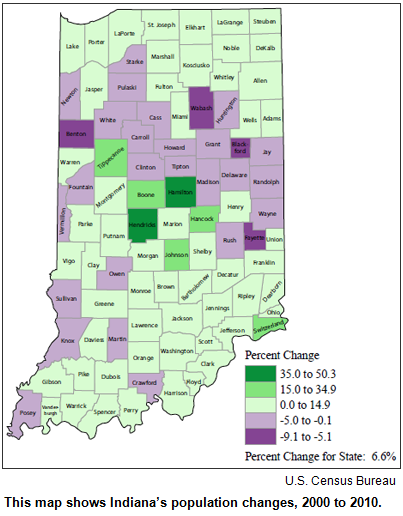 (March 12, 2011) - "State's fastest-growing counties were in Indy metro area" was the headline on a recent Indianapolis Star story about the newly released U.S. Census Bureau results from 2010. Other news accounts reported shifts in Indiana's racial and ethnic makeup.
(March 12, 2011) - "State's fastest-growing counties were in Indy metro area" was the headline on a recent Indianapolis Star story about the newly released U.S. Census Bureau results from 2010. Other news accounts reported shifts in Indiana's racial and ethnic makeup.
Hoosier History Live! will put the results in historic context - and explore population declines in such cities as Gary, South Bend, Evansville and Hammond - when Nelson is joined in studio by an Indiana University demographer quoted in many of these accounts about our state's population shifts. He is Matt Kinghorn, an analyst with the Indiana Business Research Center at IU's Kelley School of Business.
With Matt as our guide, we will explore Indiana's overall population increase; it's up 6.6 percent from 10 years prior, a growth rate that topped those of neighboring Illinois (3.3 percent) and Ohio (1.6 percent); Michigan's population actually dropped, declining by .6 percent.
Matt recommends a look at this interactive map from the Census Bureau.
Although Matt points out that Indiana still remains less diverse than the nation, the population of Hispanics in the Hoosier state grew 82 percent. (In Illinois, Hispanics have become the largest minority group, exceeding blacks, according to an account in USA Today.)
Overall, nearly 60 percent of the growth in Indiana came in Indianapolis (Marion County) and surrounding counties; the population of Carmel and Fishers has more than doubled since 2000. That may not be startling, but perhaps it's a bit surprising that only two of the state's largest cities, Indy and Fort Wayne, gained people. The largest decrease (22 percent) was in Gary, with South Bend and Evansville chalking up 6.1 and 3.4 percent losses, respectively.
 As part of our effort to put the results in historic context, Matt and Nelson will explain how, despite Indiana's reputation as an agricultural state, by far the majority of residents have not lived on farms or in small towns for many generations. The latest census results reinforce the longstanding trend of urban and suburban living.
As part of our effort to put the results in historic context, Matt and Nelson will explain how, despite Indiana's reputation as an agricultural state, by far the majority of residents have not lived on farms or in small towns for many generations. The latest census results reinforce the longstanding trend of urban and suburban living.
With the 6.6 percent growth, the state’s population totaled 6,483,802 people.
Some other results of the new data: Suburban communities and counties reported noticeable increases in black residents. And third-place in terms of growth among the most sizable cities, after Carmel and Fishers, was Noblesville.
Matt Kinghorn, our guest, has served as one of Indiana's representatives to the Census Bureau's Federal-State Cooperative for Population Estimates; he also is a member of the Indiana Geographic Council.
His work includes population projections for Indiana - so, in this case, our history show probably will be taking a future peek as well. A sampling of his projections:
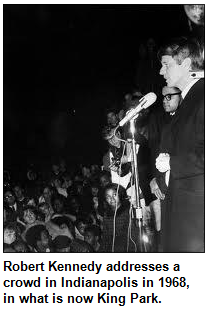 Chris Gahl of the ICVA suggests we take the Roadtrip to the Eugene and Marilyn Glick Indiana History Center at 450 W. Ohio Street in downtown Indianapolis to see a three-dimensional hologram of RFK addressing a stunned crowd near 16th Street and College Avenue in Indianapolis on the evening of April 4, 1968. That night, Kennedy let the crowd know that he had just learned that Martin Luther King had been assassinated in Memphis. The speech may also be viewed on YouTube.
Chris Gahl of the ICVA suggests we take the Roadtrip to the Eugene and Marilyn Glick Indiana History Center at 450 W. Ohio Street in downtown Indianapolis to see a three-dimensional hologram of RFK addressing a stunned crowd near 16th Street and College Avenue in Indianapolis on the evening of April 4, 1968. That night, Kennedy let the crowd know that he had just learned that Martin Luther King had been assassinated in Memphis. The speech may also be viewed on YouTube.
This new exhibit is part of the Indiana Experience, which is free for IHS members and $7 for adults who are not members.
Interesting Hoosier history fact: Only two days after the assassination of Martin Luther King, another major tragedy occurred in Indiana. A gas explosion in downtown Richmond killed 41 people and injured 150 on April 6, 1968. On the national news front, however, the MLK news eclipsed the Richmond tragedy.
During the last 10 years, Fort Wayne has become the home of more refugees from a foreign country than any other American city. Nearly 5,000 refugees from the country, which is overseas, now live in Fort Wayne. About 800 refugees arrived just in one year (2008) alone. Assisted by Fort Wayne charitable organizations, the refugees began arriving in Indiana's second-largest city during the late 1980s after a military junta in their homeland began punishing people who advocated democracy.
Question: Name the foreign country from which so many refugees have settled in Fort Wayne.
The prize is a one-night stay at Hyatt Place Indianapolis at Keystone and a pair of tickets to Morty's Comedy Joint on East 96th Street in Indianapolis, courtesy of the ICVA.
To win the prize, you must call in with the correct answer during the live show. The call-in number is (317) 788-3314, and please do not call until you hear Nelson pose the question on the air. Please do not call if you have won a prize from any WICR show during the last two months. You may wish to email the answer, but that doesn't "count" in the contest. The prize is a one-night stay at Hyatt Place Indianapolis at Keystone and a pair of tickets to Morty's Comedy Joint on East 96th Street in Indianapolis.
(March 5, 2011) - During this "centennial era" of the Indianapolis Motor Speedway - a celebration that began in 2009 to mark the 100th year of the opening of the world-famous racetrack and will continue through May with the 100th anniversary of the inaugural Indianapolis 500 in 1911 - it's not jumping the gun, or green flag, to roar into track history.
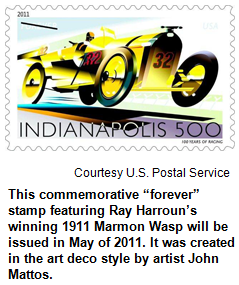 Our guest should draw cheers from Hoosier History Live! listeners who have been clamoring for him to visit us during the centennial era. Speedway historian extraordinaire Donald Davidson, who enjoys international fame for his encyclopedic knowledge of all aspects of the Indy 500, joins Nelson in studio. A native of England who became obsessed with the Speedway as a boy overseas, Donald showed up at the track in 1964 and instantly wowed Hoosiers with the depth of his 500-Mile Race trivia.
Our guest should draw cheers from Hoosier History Live! listeners who have been clamoring for him to visit us during the centennial era. Speedway historian extraordinaire Donald Davidson, who enjoys international fame for his encyclopedic knowledge of all aspects of the Indy 500, joins Nelson in studio. A native of England who became obsessed with the Speedway as a boy overseas, Donald showed up at the track in 1964 and instantly wowed Hoosiers with the depth of his 500-Mile Race trivia. 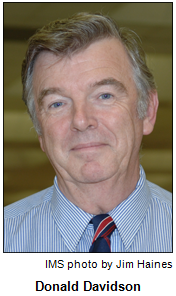 Having Donald Davidson in our studio was an ideal opportunity for listeners to call in and ask their most burning questions about racing folklore and fact.
Having Donald Davidson in our studio was an ideal opportunity for listeners to call in and ask their most burning questions about racing folklore and fact.
Donald and Nelson share insights about their mutual friend, Tom Carnegie, the legendary "Voice of the Speedway," who died Feb. 11. During a memorial service for Carnegie, the track announcer since 1946, Donald said that with his booming voice and enthusiasm, "no single individual" had a greater impact on the growth of qualifications every May at the Speedway.
Of course, Donald Davidson, the author of the Autocourse Official History of the Indianapolis 500 (CMG Publishing, 2006), has had an enormous impact as well. His legions of fans even have created a Facebook page: It's called the Donald Davidson Appreciation Society. Inducted last year into the Auto Racing Hall of Fame, Donald has hosted radio programs on various stations for more than 40 years, including "Talk of Gasoline Alley."
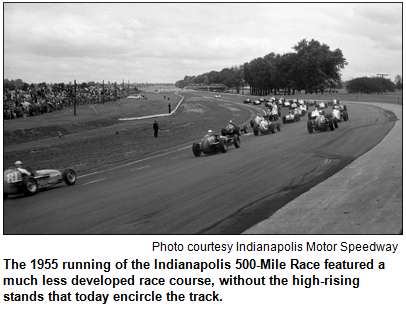 On our show, Donald separates fact from myth about the controversial inaugural race in 1911 won by Ray Harroun in an Indianapolis-made Marmon Wasp.
On our show, Donald separates fact from myth about the controversial inaugural race in 1911 won by Ray Harroun in an Indianapolis-made Marmon Wasp.
Fun facts: Despite various controversies, the race was declared a spectacular success, with the crowd estimated at 80,000; officials at Union Station in downtown Indy announced it was the busiest day in the history of the railroad terminal.
By the way, Harroun's average speed during the historic race was 74.6 mph. It took his Marmon Wasp 6 hours and 42 minutes to complete the 500-mile journey, and that careens into a seldom-discussed issue Nelson intends to explore with Donald during the show: The unheralded but crucial role of relief drivers in the early Indianapolis 500s. Because even the best drivers needed breaks over such a prolonged period in excessive heat and other discomforts, they usually employed relief drivers who spelled them at the wheel.
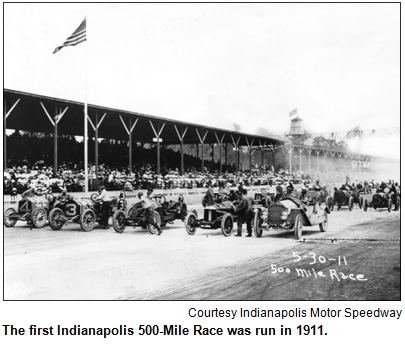 According to a newspaper column Donald wrote in 1989 about the folks he called "unsung heroes," a fellow named Cyrus Patschke drove about 40 laps for Harroun during the 1911 race. The relief drivers received some pay, but almost never credit. (However, Donald noted even the unknown Cyrus Patschke had groupies who belatedly recognized his efforts. During the 1970s, he recalled, a Volkswagen bus used to show up on race day with a banner proclaiming its occupants as members of the "Cyrus Patschke Fan Club.") Were these relief drivers factory workers, engineers and other local folks who just wanted to pitch in and help the drivers? Did any of them resent their anonymity? Nelson expects to ask these questions of our Speedway history guru.
According to a newspaper column Donald wrote in 1989 about the folks he called "unsung heroes," a fellow named Cyrus Patschke drove about 40 laps for Harroun during the 1911 race. The relief drivers received some pay, but almost never credit. (However, Donald noted even the unknown Cyrus Patschke had groupies who belatedly recognized his efforts. During the 1970s, he recalled, a Volkswagen bus used to show up on race day with a banner proclaiming its occupants as members of the "Cyrus Patschke Fan Club.") Were these relief drivers factory workers, engineers and other local folks who just wanted to pitch in and help the drivers? Did any of them resent their anonymity? Nelson expects to ask these questions of our Speedway history guru.
Even casual fans of "the 500" won't want to miss this show.
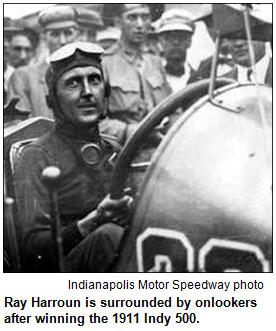 According to Donald Davidson's book Autocourse Official History of the Indianapolis 500, Ray Harroun, the winner of the inaugural 500-Mile Race in 1911, always regarded himself as more of an engineer and an inventor than a race-car driver. In fact, he has been credited with being the first person to use a certain device or feature on a car because he installed one on the Marmon Wasp that he drove to victory in the first 500. This device or implement is a crucial aspect on automobiles to this day.
According to Donald Davidson's book Autocourse Official History of the Indianapolis 500, Ray Harroun, the winner of the inaugural 500-Mile Race in 1911, always regarded himself as more of an engineer and an inventor than a race-car driver. In fact, he has been credited with being the first person to use a certain device or feature on a car because he installed one on the Marmon Wasp that he drove to victory in the first 500. This device or implement is a crucial aspect on automobiles to this day.
Question: Name the device that Ray Harroun may have introduced on cars.
The prize was an Indy 500 Prize Pack, courtesy of the Indianapolis Motor Speedway.
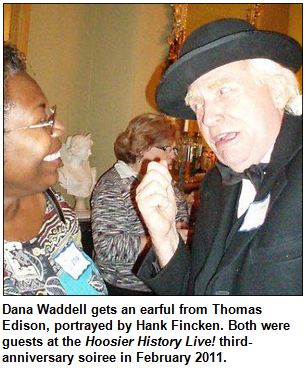 (Feb. 17, 2011) - The 1865 Morris Butler House came alive once again on the evening of Thursday, Feb. 17, 2011, as about 80 history fans celebrated the third anniversary of Hoosier History Live!
(Feb. 17, 2011) - The 1865 Morris Butler House came alive once again on the evening of Thursday, Feb. 17, 2011, as about 80 history fans celebrated the third anniversary of Hoosier History Live!
The soiree was once again hosted by our friends at Indiana Landmarks. Special thanks to Marsh Davis and Suzanne Stanis for the arrangements.
Thomas Edison was portrayed by Hank Fincken, and pioneer songs were performed by Janet Gilray and Leslie Gamero. Thanks to Lorraine Phillips Vavul and Sally Cook for bringing the birthday cakes. Thanks also to volunteers Michael Trudeau and Bill Holmes.
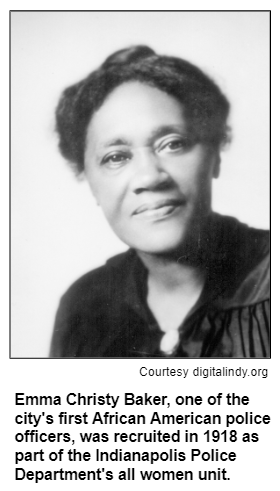 (Feb. 26, 2011) - With the recent tragic on-duty death of Indianapolis Metropolitan Police Department Officer David Moore, community-wide grief over his passing, and various controversies surrounding other members of the force, the spotlight has been on the police recently. Hoosier History Live! is seizing the moment to explore the history of an organized police force in the Hoosier capital and how it has unfolded for more than 150 years.
(Feb. 26, 2011) - With the recent tragic on-duty death of Indianapolis Metropolitan Police Department Officer David Moore, community-wide grief over his passing, and various controversies surrounding other members of the force, the spotlight has been on the police recently. Hoosier History Live! is seizing the moment to explore the history of an organized police force in the Hoosier capital and how it has unfolded for more than 150 years.
Nelson's studio guests are Capt. Craig Fishburn, a 28-year veteran of the police force, and Sabrina Young, vice president of the Indianapolis Police Historical and Educational Foundation. Captain Fishburn, who is currently assigned to IMPD's east district, helped put together Indianapolis Police Department: A Proud Tradition of Service (Turner Publishing Co., 2000).
In connection with Black History Month, Capt. Fishburn and Ms. Young, who is a community volunteer for the force, will share insights about early African-American police officers - and women officers as well.
According to several accounts, the first African-American police detective in Indianapolis, Benjamin Thornton, was appointed to the force in 1875 and promoted to detective 10 years later. He was an escaped slave who had settled in Indianapolis.
Trail-blazers also included a well-known business and civic leader, Emma Christy Baker, who ran a laundry. In 1918, she became the first black female officer on what was then IPD. She patrolled a downtown beat. Despite her achievements, Officer Baker was buried in an unmarked grave at Crown Hill Cemetery, in part because she had no immediate survivors. Capt. Fishburn, our guest, attended the dedication in 2003 of a memorial headstone on Officer Baker's burial site after a fund-raising campaign led by a current IMPD officer, Marilyn Gurnell.
After some breakthroughs during the 1920s, when IPD employed the country's largest all-female unit, the department did not hire women for street patrol again until 1968. Nelson and his guests explore how this unfolded.
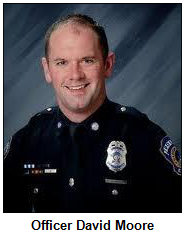 They also will time-travel much farther back, exploring perceptions during the 1840s and '50s that - because of the waves of immigrants, the arrival of railroads and battles over the propriety of alcohol consumption - the city "was in the grip of a crime wave," according to The Encyclopedia of Indianapolis.
They also will time-travel much farther back, exploring perceptions during the 1840s and '50s that - because of the waves of immigrants, the arrival of railroads and battles over the propriety of alcohol consumption - the city "was in the grip of a crime wave," according to The Encyclopedia of Indianapolis.
These fears apparently resulted in a clamor for a paid city police force. It was launched in fits and starts during the 1850s and early '60s. (Before 1854, the peace in Indianapolis was maintained by a town marshal, a sheriff, a few deputies and various night watchmen. The night watchmen were volunteers.) Initially, officers were identified by only a silver star. They got blue uniforms in 1862. The first officers walked their beats. Bicycle units began in 1897. Horse patrols kicked off around the turn of the century.
"When needed," according to an IMPD history on the city of Indianapolis' website, "the department's first officers commandeered private (horse-drawn) wagons and conveyed drunks to the station in a wheelbarrow." The first police automobile in Indy was purchased in 1904.
Historic uniforms, badges and weapons, including nun chucks once used to subdue perpetrators, will be exhibited at a police history museum underway in a historic building at South Pennsylvania and Georgia streets near Conseco Fieldhouse. (Capt. Fishburn emphasizes that nun chucks have not been used by Indianapolis police for many decades.)
Sabrina Young is an organizer of the interactive museum, which will be known as Cop City and is being privately funded. She shares details about Cop City, which is slated to open in time for Super Bowl visitors next February.
Much of the focus at Cop City will be on the education of children about public safety. In addition to exhibits about IPD's history, Ms. Young says Cop City will spotlight the local heritage of other law enforcement officials such as sheriff's deputies and FBI agents.
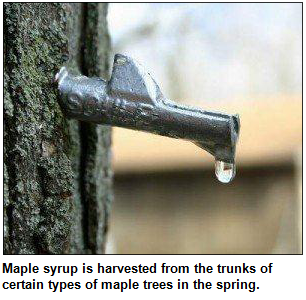 Roadtripper Chris Gahl of the ICVA suggests we head down to Medora in Jackson County the first two weekends of March for the National Maple Syrup Festival. Just as maple-sugaring season gets under way, maple syrup producers from all over the country will be able to showcase their best recipes at this year's Sweet Victory Challenge. Historic re-enactors will show festival goers how Native Americans and, later, white settlers in southern Indiana learned to tap maple trees and produce the sweet stuff.
Roadtripper Chris Gahl of the ICVA suggests we head down to Medora in Jackson County the first two weekends of March for the National Maple Syrup Festival. Just as maple-sugaring season gets under way, maple syrup producers from all over the country will be able to showcase their best recipes at this year's Sweet Victory Challenge. Historic re-enactors will show festival goers how Native Americans and, later, white settlers in southern Indiana learned to tap maple trees and produce the sweet stuff.
The festival includes a children's area and live bluegrass music, so plan to head down to John Mellencamp's native Jackson County for a taste of early spring out in the country!
The largest residential robbery in American history occurred in 1977 at an Indianapolis home. More than $7 million had been hidden in the house by its owner, who had developed an intense distrust of banks. She had hidden money in sewing kits, headboards of beds and vacuum cleaner bags. A group of suspects was implicated in the robbery of the Northside home, during which its owner was killed. Some of the perpetrators later returned to steal more money and set the house on fire. Various law enforcement agencies quickly made a series of arrests in the crime, which drew worldwide attention.
Question: Who was the victim in the 1977 crime?
The prize, courtesy of Indiana Landmarks, was two tickets to "If These Walls Could Tell" at the new Indiana Landmarks Center at 1201 N. Central Avenue in Indianapolis on Friday, April 29.
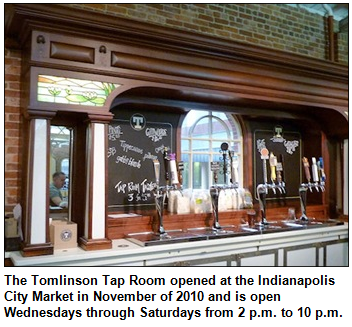 (Feb. 19, 2011) - Does it seem as though evolving lifestyles and various renovations are continually upsetting the apple cart at Indianapolis City Market? With all sorts of changes brewing (or recently accomplished) - including the opening of what may be the first and only bar in the historic marketplace - Hoosier History Live! revisits the landmark, built in 1886.
(Feb. 19, 2011) - Does it seem as though evolving lifestyles and various renovations are continually upsetting the apple cart at Indianapolis City Market? With all sorts of changes brewing (or recently accomplished) - including the opening of what may be the first and only bar in the historic marketplace - Hoosier History Live! revisits the landmark, built in 1886.
Nelson is joined in studio by Jim Reilly, who became executive director of City Market in October 2008 and has overseen the opening of Tomlinson Tap Room, which serves up Indiana-brewed beers. The name of the bar, which is on the mezzanine level, is a historic salute to Tomlinson Hall, a massive civic building that adjoined City Market until it was destroyed by a raging fire in 1958.
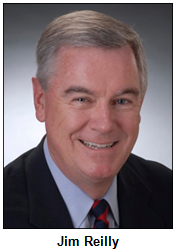 Not only does Jim share insights about the historic fire (only Tomlinson Hall's doorway arch remains, serving as the entryway to City Market's courtyard), he also has dreams for the mysterious, long-unused catacombs beneath the marketplace. Would you believe that, according to Jim, the temperature in the catacombs never dips below 50 degrees, even during bone-chilling winters like we've been enduring?
Not only does Jim share insights about the historic fire (only Tomlinson Hall's doorway arch remains, serving as the entryway to City Market's courtyard), he also has dreams for the mysterious, long-unused catacombs beneath the marketplace. Would you believe that, according to Jim, the temperature in the catacombs never dips below 50 degrees, even during bone-chilling winters like we've been enduring?
As part of the show's "then/now" theme, Jim also shares updates on the $2.7 million renovation, which includes the $800,000 project that's planned to transform City Market's east wing into a bicycle hub with showers. He welcomes listener questions and understands the frustrations with the seemingly endless attempts to revive the historic marketplace that once bustled with generations of immigrant families who sold fresh fruit, vegetables, bakery goods, poultry and meat.
It seems like only yesterday - actually, it was 2007 - when City Market underwent a $2.5 million renovation. 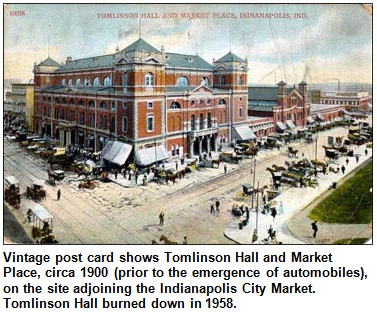 (Fun fact: In 1886, City Market was built for $29,225.) As Hoosier History Live! listeners learned when Dale Kenney, who served as market master in the 1970s, was our studio guest, its site on East Market Street was an outdoor marketplace at the very beginnings of the city in the 1820s, long predating the building's construction.
(Fun fact: In 1886, City Market was built for $29,225.) As Hoosier History Live! listeners learned when Dale Kenney, who served as market master in the 1970s, was our studio guest, its site on East Market Street was an outdoor marketplace at the very beginnings of the city in the 1820s, long predating the building's construction.
"As far as I know, the Tomlinson Tap Room is the first and only bar establishment to be located in the City Market, though," Jim Reilly says. "If any of your listeners have information to the contrary, I would love to know the details." Tomlinson Tap Room is a joint venture between City Market and the Brewers of Indiana Guild.
Meanwhile, the historic catacombs underneath the west plaza remain a source of intrigue. According to folklore - and a note Jim received from a city resident during the week before the show - the catacombs may have been used more than 100 years ago by the U.S. Army to store cannon balls and gun powder. Several local historians, however, doubt that. Jim and Nelson will explain why it's unlikely. 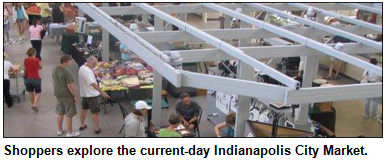 They also will welcome your "then and now" memories, insights and suggestions involving City Market during the show. Some aspects of the renovation plans for the landmark have been delayed, although new vendors are expected to open soon.
They also will welcome your "then and now" memories, insights and suggestions involving City Market during the show. Some aspects of the renovation plans for the landmark have been delayed, although new vendors are expected to open soon.
By the way, this is not Jim Reilly's first time at the rodeo. Although he wasn't at City Market during its previous renovation, he served as executive director from 1994 to 2001. A native of Pennsylvania, Jim moved to Indy in the 1970s to work for what's now Simon Property Group. He has visited urban marketplaces from Seattle to Boston.
In 1886, the same year Indianapolis City Market was built, a family-owned retailer opened in downtown Indianapolis. Almost from the very beginning, the store specialized in hard-to-find sizes of the product it sold. Today, nearly 130 years later, the retailer is still open at its original site downtown. Owned and operated by descendants of its founder, the store claims to be the oldest continually operated retailer of its kind in the entire country.
Question: Name the store in downtown Indianapolis.
The was four tickets to the NCAA Hall of Champions, courtesy of the ICVA.
Roadtripper Chris Gahl of the ICVA tells us that swimming stars from across the country will be making waves and returning to Indianapolis March 3-5, 2011 for the Indy Grand Prix at the Nat.
 Michael Phelps will be diving in at the Indiana University Natatorium to compete in the USA Swimming Grand Prix Series against other past Olympians Ryan Lochte, Katie Hoff and Missy Franklin. Here's an opportunity to see up close the athletes we cheered to gold during the summer games.
Michael Phelps will be diving in at the Indiana University Natatorium to compete in the USA Swimming Grand Prix Series against other past Olympians Ryan Lochte, Katie Hoff and Missy Franklin. Here's an opportunity to see up close the athletes we cheered to gold during the summer games.
The Indy Grand Prix is one stop on a seven-event series. Swimmers are competing for medals and a $20,000 cash prize awarded at the end of the series.
Tickets can be purchased at www.allgreatracers.com or on-site at the Natatorium box office.
(Feb. 12, 2011) - They came here via the Ohio River, the Old National Road and the Cumberland Gap. As the early settlers rowed, walked and rode to Indiana, they often sang. Janet Gilray, an Indianapolis-based musician and teacher, researched the folk tunes of pioneers - and now has developed creative ways to teach American history to children by using the lyrics of the songs.
 Janet - who sings, plays the guitar and has performed early American folk music at festivals across the state - joins Nelson in studio along with two Hoosier children who have performed with her and learned about history in the process. They are Alec Hurtubise, a 15-year-old banjo player who attends Heritage Builders Home School Association, and Leslie Gamero, a 10-year-old vocalist who is a student at Holy Cross Central School. As a special treat, Janet, Alec and Leslie perform excerpts from an early folk song titled A Hoosier That's True, as well as Across the Wide Missouri (Oh, Shenandoah).
Janet - who sings, plays the guitar and has performed early American folk music at festivals across the state - joins Nelson in studio along with two Hoosier children who have performed with her and learned about history in the process. They are Alec Hurtubise, a 15-year-old banjo player who attends Heritage Builders Home School Association, and Leslie Gamero, a 10-year-old vocalist who is a student at Holy Cross Central School. As a special treat, Janet, Alec and Leslie perform excerpts from an early folk song titled A Hoosier That's True, as well as Across the Wide Missouri (Oh, Shenandoah).
Janet is a former sixth-grade teacher at Holy Cross, where her students included many Hispanic children from immigrant families. She also has taught children of migrant farm workers in California, experiences that propelled her to explore creative ways to teach American history.
Her new book, Janet Gilray's Voices in Time, features lesson plans about history derived from folk songs, as well as a companion music CD of the tunes cherished by pioneers. History, she says, is "embedded" in folk music.
"Songs are a reflection of ancestral thought and emotion, and also describe the environments of those living during the time," Janet writes in Voices in Time. "Song may be the most ancient form of transferring culture and lessons from one time period to another."
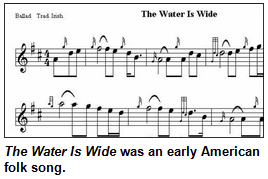 All of the folk songs featured in Voices in Time are more than 100 years old. They include Wabash Cannonball, a "train song" that became popular with the arrival of railroads. At towns with depots, the periodic arrival of trains "with mail, passengers and merchandise," as Janet writes, became an "event" that drew residents to the train station - and merited celebration in song.
All of the folk songs featured in Voices in Time are more than 100 years old. They include Wabash Cannonball, a "train song" that became popular with the arrival of railroads. At towns with depots, the periodic arrival of trains "with mail, passengers and merchandise," as Janet writes, became an "event" that drew residents to the train station - and merited celebration in song.
Even though she grew up in Indianapolis, Janet says she was unaware of A Hoosier That's True, a now-obscure but once popular folk tune, until a musician in California told her about it.
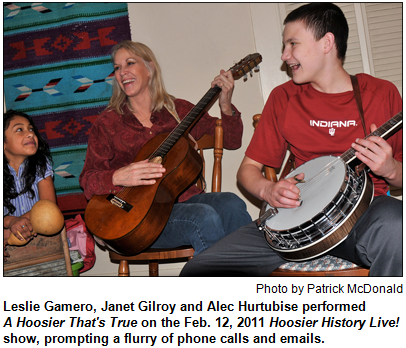 "It's a classic example of a song that travels without borders," she notes.
"It's a classic example of a song that travels without borders," she notes.
And even though the lyrics of Oh Shenandoah! obviously focus on the Missouri River, she says the tune was sung by pioneers as they traveled on the Ohio River to Indiana as well as points west. "The Ohio River," she says, "was like the freeway of its time."
Janet will have a sing-along and Voices in Time book signing March 12 at Black Dog Books in Zionsville. She also is scheduled to perform American folk songs at the Pioneer Village during the Indiana State Fair.
And the young folks joining her on Hoosier History Live! already have amassed credits of their own. Alec, who took up the banjo at age 4, has performed at the annual bluegrass festival in Bean Blossom. Both Leslie and Alec have joined Janet for recordings at Renaissance Studios in Broad Ripple.
During our Feb. 12, 2011 show about "songs of our ancestors as they journeyed here," our trio of guests performed a folk tune that may have been titled A Hoosier That's True. The folk song has become at least somewhat obscure - neither Nelson nor teacher-musician Janet Gilray, author of Voices in Time - said they had heard the tune while growing up in Indiana. (Janet was alerted to the Hoosier song by a musician in California.)
However, it rang a bell with many of our listeners, including some who recalled singing the tune - perhaps with a different title - at summer camp more than 60 years ago. Our faithful listener Phil Brooks of Brownsburg even sent YouTube links to renditions of it by some disparate performers, including Rosemary Clooney and, believe it or not, Bugs Bunny.
Janet and her young musician accompanists, 15-year-old banjo player Alec Hurtubise and 10-year-old vocalist Leslie Gamero, would be grateful for any other info about the folk tune, including the identify of the composer. E-mail us, and we’ll pass along the info. Meanwhile, here are the YouTube links for your listening pleasure:
http://www.youtube.com/watch?v=B5qqQWkzl-E
http://www.youtube.com/watch?v=-tIWrwSHY7M
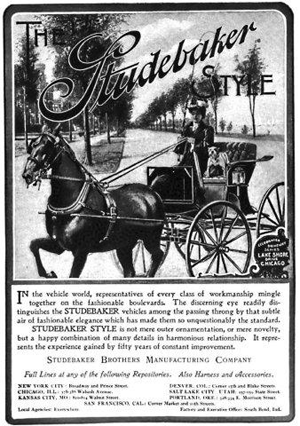 During the 1800s, many pioneers who traveled to Indiana made their journey with a special type of covered wagon. Drawn by horses or oxen, the wagons had broad wheels and were designed to resemble boats. Sometimes they even were used to cross rivers. Although this type of covered wagon originally was made in Pennsylvania, by the late 1800s the largest manufacturer of them was Studebaker Brothers, based in South Bend.
During the 1800s, many pioneers who traveled to Indiana made their journey with a special type of covered wagon. Drawn by horses or oxen, the wagons had broad wheels and were designed to resemble boats. Sometimes they even were used to cross rivers. Although this type of covered wagon originally was made in Pennsylvania, by the late 1800s the largest manufacturer of them was Studebaker Brothers, based in South Bend.
Question: Name the type of covered wagon.
The prize was a pair of tickets to the Benjamin Harrison Home, courtesy of the ICVA.
Roadtripper Chris Gahl of the ICVA recommends that we visit the tropics this weekend at the Mesker Park Zoo & Botanic Gardens in Evansville for the opening of a new special exhibit, Orchid Escape.  Immerse yourself in hundreds of rare orchid flowers from South America, all in the 75 degree temperature of Amazonia, the Zoo's indoor rainforest. Orchid Escape will be open for only a short time, until March 12.
Immerse yourself in hundreds of rare orchid flowers from South America, all in the 75 degree temperature of Amazonia, the Zoo's indoor rainforest. Orchid Escape will be open for only a short time, until March 12.
The Mesker Park Zoo is open all year, so be sure not to miss the zoo's other exhibits. Winter admission is $6.50 for adults and $5.50 for children. The zoo is open daily 9 a.m. to 4 p.m.
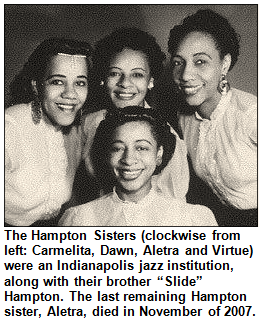 (Feb. 5, 2011) - To explore jazz heritage in the Hoosier capital - including the heyday of Indiana Avenue nightspots as Hoosier History Live! salutes Black History Month - who could be a better guest than a native son who lived through the fabled era and is renowned for talking and writing about local jazz, then and now?
(Feb. 5, 2011) - To explore jazz heritage in the Hoosier capital - including the heyday of Indiana Avenue nightspots as Hoosier History Live! salutes Black History Month - who could be a better guest than a native son who lived through the fabled era and is renowned for talking and writing about local jazz, then and now?
We didn't need to search far to find this inductee into the Indianapolis Jazz Hall of Fame. Among his gigs as a multi-media connoisseur, Chuck Workman is the popular host of two shows on WICR-FM, Saturday Evening Jazz with Chuck Workman and Sunday Morning Jazz with Chuck Workman.
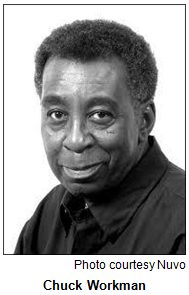 He also has been writing a Nuvo column about the Indy jazz scene for 18 years, almost since the inception of the newsweekly.
He also has been writing a Nuvo column about the Indy jazz scene for 18 years, almost since the inception of the newsweekly.
A true broadcasting pioneer, Chuck became the state's first African-American TV sports director, at WTTV/Channel 4 inn the 1970s. His accomplishments (which include organizing and promoting jazz concerts) are abundant, and Chuck will join Nelson in studio to share insights about how they all began and the history he has witnessed.
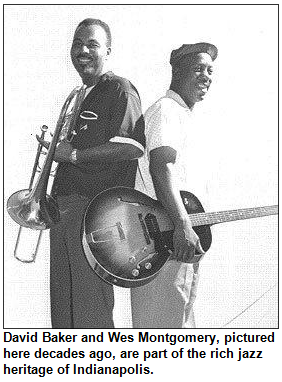 He grew up in Lockefield Gardens and attended Cathedral High School (Class of '50) during the era when it was all-male, located downtown and when only about seven fellow students there were black. As a teenager, Chuck began patronizing the legendary clubs along Indiana Avenue and got to know the jazz greats associated with the scene, including the late Wes Montgomery and composer-musician-educator David Baker, who shared his own Indiana Avenue experiences with Hoosier History Live! listeners shortly after our debut three years ago.
He grew up in Lockefield Gardens and attended Cathedral High School (Class of '50) during the era when it was all-male, located downtown and when only about seven fellow students there were black. As a teenager, Chuck began patronizing the legendary clubs along Indiana Avenue and got to know the jazz greats associated with the scene, including the late Wes Montgomery and composer-musician-educator David Baker, who shared his own Indiana Avenue experiences with Hoosier History Live! listeners shortly after our debut three years ago.
"Indiana Avenue was a city within a city, a culture within a culture," Chuck says.
When Indiana Black Expo honored Chuck last summer, Nuvo called its jazz columnist - who also has been a TV sportscaster as well as a music director and host with various Indy radio stations - "the hardest-working man in showbiz, and other bizzes as well." Who won't be intrigued by this inexhaustible jazz enthusiast's riffs on history?
A ragtime piano player in Indianapolis during the early 1900s mentored a teenager who grew up to be a legendary composer.  Even though young Hoagy Carmichael was white and most people had segregated social lives during the era, he was drawn to the ragtime and "hot jazz" rhythms of African-American musicians.
Even though young Hoagy Carmichael was white and most people had segregated social lives during the era, he was drawn to the ragtime and "hot jazz" rhythms of African-American musicians.
The ragtime piano player showed young Hoagy how to improvise on the keyboard and taught him complex rhythms. The black musician's piano, on which Hoagy enhanced his talent, today is at the Eugene and Marilyn Glick Indiana History Center.
Question: Name the African-American ragtime musician who mentored young Hoagy Carmichael in Indianapolis.
The prize was a gift certificate to Harry & Izzy’s, courtesy of the ICVA.
Warmer weather may still be a few months away, but Roadtripper Chris Gahl of the ICVA suggests we visit the Hamilton County Winter Marketplace to check out the artists and craftsmen who sell their unique products during the summer and fall at art fairs, festivals and outdoor markets across the state.
Stop by the Hamilton County 4-H Fairgrounds from 9 a.m. until 4 p.m. on Saturday, Feb. 5. This showcase of more than 90 Indiana vendors offers the jewelry, art, food and crafts that we see at our favorite local festivals and fairs during warmer months.
Admission is $1, and children under 12 are admitted free. If you can't make this Saturday, you still have one more marketplace date this season on Saturday, March 12.
 (Jan. 29, 2011) - For decades, Indiana's former First Lady Judy O'Bannon has been well-known for her advocacy of preserving historic landmarks and buildings. What sparked this passion? Mrs. O'Bannon, who was named a Living Legend by the Indiana Historical Society in 2004, joins Nelson in studio to answer that question. She also shares insights about a range of history and preservation-related issues, as well as Judy O'Bannon’s Foreign Exchange, her periodic series on WFYI-TV/Channel 20 that takes Hoosier viewers to intriguing international sites. (Mrs. O’Bannon also recently returned from a trip to Romania, and last year she traveled down the Amazon River.)
(Jan. 29, 2011) - For decades, Indiana's former First Lady Judy O'Bannon has been well-known for her advocacy of preserving historic landmarks and buildings. What sparked this passion? Mrs. O'Bannon, who was named a Living Legend by the Indiana Historical Society in 2004, joins Nelson in studio to answer that question. She also shares insights about a range of history and preservation-related issues, as well as Judy O'Bannon’s Foreign Exchange, her periodic series on WFYI-TV/Channel 20 that takes Hoosier viewers to intriguing international sites. (Mrs. O’Bannon also recently returned from a trip to Romania, and last year she traveled down the Amazon River.)
She's also putting together a documentary about the restoration of the historic Central Avenue United Methodist Church as the new headquarters of Indiana Landmarks, where she has been a longtime board member. She currently is secretary emerita of the Indiana Landmarks board, as well as a trustee of the National Trust for Historic Preservation.
 Many listeners will recall that before her late husband Frank O'Bannon served as Indiana's governor from 1997 to 2003, the O'Bannons lived in a historic home in the Old Northside neighborhood, in downtown Indianapolis, during his years as lieutenant governor. Their former home is barely a stone's throw from the new Indiana Landmarks Center, formerly Central Avenue United Methodist Church.
Many listeners will recall that before her late husband Frank O'Bannon served as Indiana's governor from 1997 to 2003, the O'Bannons lived in a historic home in the Old Northside neighborhood, in downtown Indianapolis, during his years as lieutenant governor. Their former home is barely a stone's throw from the new Indiana Landmarks Center, formerly Central Avenue United Methodist Church.
The O'Bannons met at Indiana University on a blind date in the 1950s and raised their three children in Corydon, Frank O’Bannon's hometown. Their son Jonathan is publisher and president of The Corydon Democrat, an award-winning weekly newspaper that has been owned for several generations by the O'Bannon family. 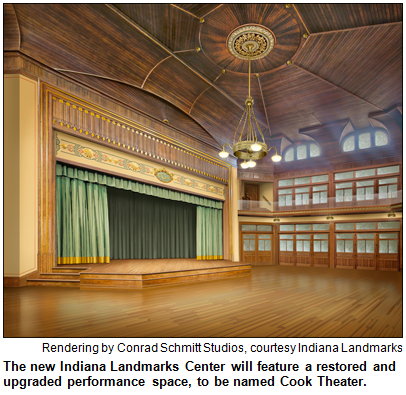 (In addition to practicing law in Corydon before launching his political career, Frank O'Bannon wrote news and sports stories and took photos for The Corydon Democrat.) While serving his second term as governor, Frank O'Bannon died suddenly in 2003 at age 73.
(In addition to practicing law in Corydon before launching his political career, Frank O'Bannon wrote news and sports stories and took photos for The Corydon Democrat.) While serving his second term as governor, Frank O'Bannon died suddenly in 2003 at age 73.
During her husband's years as governor, Mrs. O'Bannon led delegations of Hoosiers to South Africa, Russia and other overseas destinations. Several of the trips were medical and humanitarian missions.
As the state's First Lady, Mrs. O'Bannon also initiated a renovation of the Governor's Mansion in Indianapolis, to make the historic North Meridian Street house accessible to the handicapped.
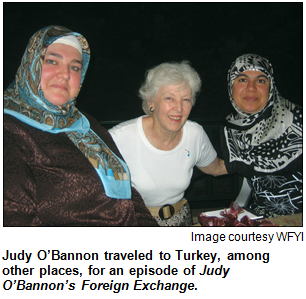 Judy O'Bannon - then Judy Asmus - grew up on the Northside of Indianapolis and graduated from Shortridge High School. At Indiana University, where she was Phi Beta Kappa, Mrs. O'Bannon majored in social work. Then she became the first woman to attend the Louisville Presbyterian Theological Seminary. Nelson asks her about that seminary experience, as well as a trove of preservation topics.
Judy O'Bannon - then Judy Asmus - grew up on the Northside of Indianapolis and graduated from Shortridge High School. At Indiana University, where she was Phi Beta Kappa, Mrs. O'Bannon majored in social work. Then she became the first woman to attend the Louisville Presbyterian Theological Seminary. Nelson asks her about that seminary experience, as well as a trove of preservation topics.
Mrs. O'Bannon's civic activities also have included involvement with the Indiana Main Street Council and the Indiana State Museum, where she served as a board member. Her Judy O'Bannon's Foreign Exchange program has taken Central Indiana television viewers to India, Jamaica, Turkey, Serbia and Moldova.
Today, Mrs. O'Bannon once again lives on the Northside of Indianapolis, and she has then/now insights about Broad Ripple and other neighborhoods she frequented during her childhood and teen years. 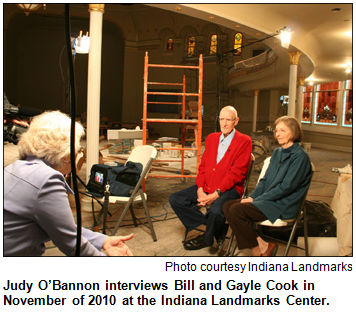 Please tune in and join us as we welcome one of the state's best-known women to Hoosier History Live!
Please tune in and join us as we welcome one of the state's best-known women to Hoosier History Live!
Judy O'Bannon’s alma mater, Shortridge High School, was attended by many other Hoosiers who have risen to prominence in politics or literature. Other Shortridge graduates include U.S. Sen. Richard Lugar and novelist Dan Wakefield (both members of the Class of '50) and Kurt Vonnegut Jr., the late literary icon, who graduated in 1940.
The Class of '49 included a future Hoosier politician. After Shortridge, he attended Indiana University and served in the Marines during the Korean War. Then he became a lawyer before embarking on a long career in politics. He retired in 1997 and has written several books.
Question: Name the Hoosier politician.
The prize was a one-night weekend stay in a deluxe room at the Marriott Indianapolis Downtown at 350 W. Maryland Street, courtesy of the ICVA.
Chris Gahl of the ICVA will tempt us to with a sweet Roadtrip this weekend to the Bloomington Week of Chocolate. Visit Sundaes on Saturday at the Monroe County History Center, and on Sunday visit the Indiana University Art Museum for The Art of Chocolate. This evening is filled with artwork from more than 34 artists, decadent hors d’oeuvres and drinks, live entertainment and chocolate creations by top chefs.
Other events later the week include Chocolate Bingo, the Inaugural Chocolate Luncheon, Chocolate Olympics, Death by Chocolate, Chocolate Prom and Wonka's Chocolate Carnival. Tell them the Roadtripper sent you!
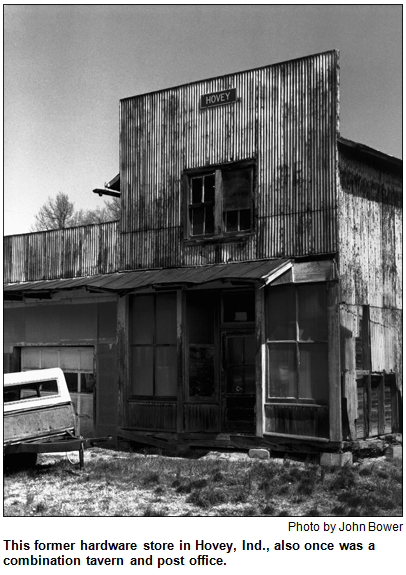 (Jan. 22, 2011) - John Bower is an award-winning, Bloomington-based photographer with a rare distinction. He has visited, as he puts it, "every city and town on the map of Indiana." As a result, John has a silo-high stack of anecdotes and stories about towns he never had heard of until he visited, such as Merom in Sullivan County, where he says there's "an amazing spiral staircase in an attic" and West Terre Haute, where he discovered an abandoned brick and tile factory.
(Jan. 22, 2011) - John Bower is an award-winning, Bloomington-based photographer with a rare distinction. He has visited, as he puts it, "every city and town on the map of Indiana." As a result, John has a silo-high stack of anecdotes and stories about towns he never had heard of until he visited, such as Merom in Sullivan County, where he says there's "an amazing spiral staircase in an attic" and West Terre Haute, where he discovered an abandoned brick and tile factory.
During one of his trips to Alexandria, he photographed a factory where rock wool, a precursor of fiberglass, was invented and manufactured.
"While our society values the newest, the costliest and the flashiest, I'm motivated to rediscover that which has been ignored, forgotten, or cast aside," John says. "By using the inherent drama of black-and-white photography, I'm able to capture the essence - the élan vital - of these subjects."
John, who owns Studio Indiana with his artist wife Lynn, estimates he has traveled 90,000 miles to visit every city and town (a total of 2,099 localities) on the Indiana Highway Map.
 His seven photo books include Lingering Spirit (2003), which he calls "a tribute to Indiana's fading, forlorn and forgotten places"; After the Harvest (2007), which features images of Indiana's historic grain elevators and feed mills, and his newest, The Common Good (2010), which looks at schools, churches, post offices and other buildings established for the common good.
His seven photo books include Lingering Spirit (2003), which he calls "a tribute to Indiana's fading, forlorn and forgotten places"; After the Harvest (2007), which features images of Indiana's historic grain elevators and feed mills, and his newest, The Common Good (2010), which looks at schools, churches, post offices and other buildings established for the common good.
His new book includes photos of the former main post office in Gary, a once-grand, now-abandoned Art Deco structure built in the 1930s. Also in Gary, he photographed City Methodist Church, which was built in 1925 for a "staggering" $650,000.
"With a towering belfry, large auditorium, multiple classrooms, inspiring leaded-glass windows, huge limestone columns and oak-paneled sanctuary, it was a landmark all of Gary must have been proud of," according to The Common Good. After a devastating fire and rampant vandalism, the historic church now is a symbol of "decaying glory" with dangerous debris, a leaky roof and roosting pigeons.
John explains his motivation this way: "I’ve come to believe that each rusted vehicle, each battered machine, each deserted building (especially a school or church) is an integral part of our collective past."
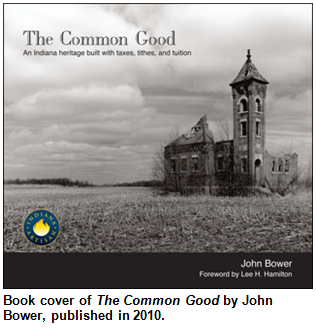 In the town of Hovey, he photographed a shuttered hardware store that once had been a popular tavern. When he explores the state's back roads, John says, he is fascinated by hand-made objects ("an oak balustrade, a marble cemetery statue, a forged iron gate") and by abandoned homes that may not have been inhabited for 50 years, yet "there are still clothes hanging in the closets."
In the town of Hovey, he photographed a shuttered hardware store that once had been a popular tavern. When he explores the state's back roads, John says, he is fascinated by hand-made objects ("an oak balustrade, a marble cemetery statue, a forged iron gate") and by abandoned homes that may not have been inhabited for 50 years, yet "there are still clothes hanging in the closets."
He estimates more than 20 percent of the buildings in his first photo book no longer exist since its 2003 publication. His other books include Guardians of the Soul (2004), which features photos of cemetery sculpture across Indiana.
John and Lynn, who writes most of the text, met as teachers more than 35 years ago in Kendallville. After school, they would climb into the car and take off down a route they'd never traveled before.
A photo company founded more than 100 years ago became renowned for documenting downtown Indianapolis. In the early 1900s, the company's photographers took hundreds of pictures of street scenes, buildings and other landmarks. Particularly in its early years, the company specialized in commercial and industrial photography. The company remains in business today, but its historic photo collection is owned by the Indiana Historical Society.
Question: Name the photo company.
The prize was a DVD of the documentary Movers & Stakers, Stories Along the Indiana National Road, courtesy its producer/director, Nancy Carlson of Ball State University.
 Chris Gahl of the ICVA suggests that we take the Roadtrip to "Chopin & Champagne" on Sunday, Jan. 30 at Mo's ... A Place for Steaks in downtown Indianapolis.
Chris Gahl of the ICVA suggests that we take the Roadtrip to "Chopin & Champagne" on Sunday, Jan. 30 at Mo's ... A Place for Steaks in downtown Indianapolis.
Enjoy an evening of champagne and elegant music presented the by American Pianists Association and be entertained by classical musicians as you are guided by a Champagne connoisseur through a selection of champagnes and food pairings. Doors open at 4 p.m., and music and champagne tastings begin at 4:30 p.m., followed by a piano performance by the 1983 American Pianists Association Classical Fellow, Michael Lewin.
Every two years, the American Pianists Association, headquartered in Indianapolis, produces either the Classical or Jazz Fellowship Awards. These seven-month-long competitions feature young American world-class pianists ages 18-30.
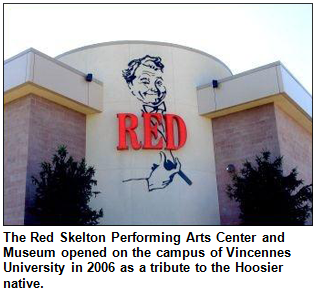 (Jan. 15, 2011) - Ever wonder why some Hoosiers used to tell Kentuckian jokes? Interested in exploring the humor of Vincennes native Red Skelton or Herb Shriner of Fort Wayne, who was nationally known as "the Hoosier Humorist" during his heyday as a radio and TV star of the 1940s and '50s?
(Jan. 15, 2011) - Ever wonder why some Hoosiers used to tell Kentuckian jokes? Interested in exploring the humor of Vincennes native Red Skelton or Herb Shriner of Fort Wayne, who was nationally known as "the Hoosier Humorist" during his heyday as a radio and TV star of the 1940s and '50s?
And what about cartoonist Kin Hubbard, who created the iconic Abe Martin character that was a hit in newspapers across the country during the early 1900s?
Well, to sift through the yuks and guide us as we explore Hoosier humor, we have called upon one of today's best-known contemporary humorists based in Indiana. Nelson is joined in studio by longtime Channel 8/WISH-TV personality Dick Wolfsie, who also writes a weekly humor column for 25 newspapers in Central Indiana.
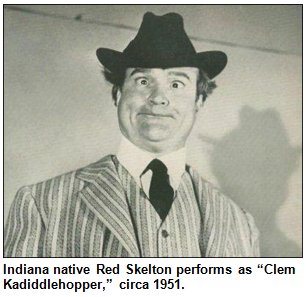 Dick is the author of 12 books, including Indiana Curiosities (Globe Pequot Press) - remember when he visited our show to share insights about his journeys to oddball sites across Indiana? - and Mornings with Barney (Sky Horse Publishing), which focused on his beloved, late canine companion who became a familiar face to TV viewers.
Dick is the author of 12 books, including Indiana Curiosities (Globe Pequot Press) - remember when he visited our show to share insights about his journeys to oddball sites across Indiana? - and Mornings with Barney (Sky Horse Publishing), which focused on his beloved, late canine companion who became a familiar face to TV viewers.
From the quips of Abe Martin (a folk philosopher who lived in Brown County) and Skelton's characters such as Clem Kadiddlehopper (see Skelton ad-lib admirably in a video clip from his Clem archives) and the "Mean Wittle Kid" to the monologues of Indianapolis native David Letterman, Indiana has been at the forefront of American humor almost ever since there was a good laugh to be had.
 Shriner, who actually was born in Ohio in 1918 but moved to Fort Wayne as a 3-year-old with his mother, used to say, "I came to Indiana as soon as I heard about it." Dick, whose humorous essays also have been heard on WFYI-FM, helps us analyze commonalities in this full house of jokers Indiana has dealt to the rest of the land.
Shriner, who actually was born in Ohio in 1918 but moved to Fort Wayne as a 3-year-old with his mother, used to say, "I came to Indiana as soon as I heard about it." Dick, whose humorous essays also have been heard on WFYI-FM, helps us analyze commonalities in this full house of jokers Indiana has dealt to the rest of the land.
Our trove also has included the late Jean Shepherd of Hammond, who created the classic A Christmas Story and entertained millions for years as a late-night, New York-based radio personality who even occasionally did standup comedy.
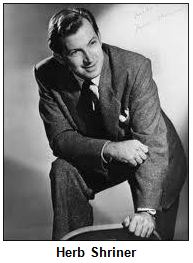 Dick says he has a theory about why so many humorists have had Indiana connections. For more than 20 years, Dick has been a popular on-air presence at WISH-TV thanks to his live reports from across the state as well as his video essays. His travels around the state also spawned Indiana Curiosities, which became one of the biggest sellers ever in a state-by-state "curiosities" series produced by his publisher. So he's an ideal guest to weigh in on notable Hoosier humorists, including:
Dick says he has a theory about why so many humorists have had Indiana connections. For more than 20 years, Dick has been a popular on-air presence at WISH-TV thanks to his live reports from across the state as well as his video essays. His travels around the state also spawned Indiana Curiosities, which became one of the biggest sellers ever in a state-by-state "curiosities" series produced by his publisher. So he's an ideal guest to weigh in on notable Hoosier humorists, including:
No need to wipe that grin off your face when you tune in to this show!
 Film and TV comedian Steve Martin isn't a Hoosier, but in the late 1970s he drew national attention to an Indiana city by referring to it as the most "nowhere" town in America.
Film and TV comedian Steve Martin isn't a Hoosier, but in the late 1970s he drew national attention to an Indiana city by referring to it as the most "nowhere" town in America.
Question: Name the Indiana city.
The prize was a pair of tickets to the Indiana Experience at the Eugene and Marilyn Glick Indiana History Center, courtesy of the Indianapolis Convention and Visitors Association.
 Chris Gahl of the ICVA suggests a wintry Roadtrip to the toboggan run at Pokagon State Park. The park was founded in 1925 and offers more than 1,200 acres dedicated to nature. Its toboggan run races down an icy track to speeds up to 40 mph and has been up and running since 1935. This Angola, Ind. staple attracts more than 90,000 visitors annually.
Chris Gahl of the ICVA suggests a wintry Roadtrip to the toboggan run at Pokagon State Park. The park was founded in 1925 and offers more than 1,200 acres dedicated to nature. Its toboggan run races down an icy track to speeds up to 40 mph and has been up and running since 1935. This Angola, Ind. staple attracts more than 90,000 visitors annually.
Sleds are rented on a first-come, first-served basis, so be sure to arrive early. Toboggans are $10 per hour and allow for four riders. The toboggan run is open this winter from 10 a.m. to 5 p.m.
Encore presentation - originally broadcast Feb. 13, 2010
(Jan. 8, 2011) - To help cure a family member struggling with a disorder, would you serve a delicacy known as fried mice pie? Believe it or not, that was a treatment suggested to pioneers in the Old Northwest Territory, including early Indiana.
To find out what disorder the repulsive-sounding pie was supposed to cure, you will have to tune in to the show, which is an encore broadcast of one of our most popular programs from this past year. Nelson's studio guest is Hoosier storyteller Sue Grizzell, who has extensively researched medical "treatments" practiced during the late 1700s and early 1800s, often using archives at the Indiana Historical Society. 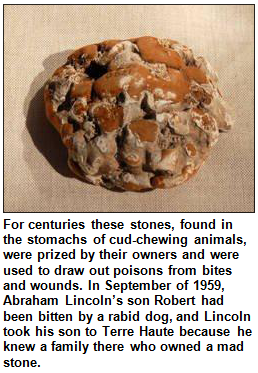 In fact, the IHS and Storytelling Arts of Indiana commissioned Sue awhile back to put together a presentation she titled "Root Doctors, Midwives and Fried Mice Pie: Medicine in Early Indiana." She has uncovered the story of a so-called "root doctor," Dr. Joseph Burr, who was run out of early Connersville, for example.
In fact, the IHS and Storytelling Arts of Indiana commissioned Sue awhile back to put together a presentation she titled "Root Doctors, Midwives and Fried Mice Pie: Medicine in Early Indiana." She has uncovered the story of a so-called "root doctor," Dr. Joseph Burr, who was run out of early Connersville, for example.
According to Sue, many of the bizarre or crude early folk remedies were the result of desperation on the frontier.
"Early Hoosiers only occasionally had access to doctors. ... They mostly lived in isolation, faced economic uncertainty and practiced self-sufficiency as much as possible."
A lifelong storyteller, Sue has collaborated with the Indianapolis Symphony Orchestra on various projects; in 2002, her story "Porch Swings and Prairie Wings" became part of the "Sharing Hoosier History Through Stories" series. You won't want to miss this fascinating show, during which Sue explains how our ancestors dealt with ailments and terrifying illnesses such as malaria and cholera.
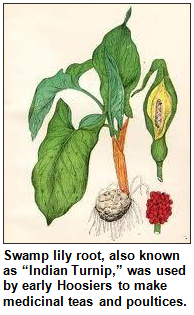 "Whether ill or injured, the inhabitants of the Old Northwest Territory and early Indiana were subjected to all manner of medical treatments," Sue says. "Ranging from the common-sensical to the bizarre, these treatments sometimes worked but could often be fatal."
"Whether ill or injured, the inhabitants of the Old Northwest Territory and early Indiana were subjected to all manner of medical treatments," Sue says. "Ranging from the common-sensical to the bizarre, these treatments sometimes worked but could often be fatal."
She notes that Thomas Jefferson once remarked, referring to doctors during his era, that they "let loose upon the world, destroy more human life in one year than all the ... Cartouches (a murderous French bandit) and Macbeths do in a century."
 Families on the Indiana frontier typically ended up doing most of their own doctoring because contact with physicians was infrequent, Sue says. Hence the popularity of folk remedies. She points out that although pioneers had as many challenges surviving some of the "cures" as they did the initial illnesses, "modern science has proven some folk remedies effective."
Families on the Indiana frontier typically ended up doing most of their own doctoring because contact with physicians was infrequent, Sue says. Hence the popularity of folk remedies. She points out that although pioneers had as many challenges surviving some of the "cures" as they did the initial illnesses, "modern science has proven some folk remedies effective."
All of this will be fodder for a show that will be as intriguing as Sue's popular, fact-based storytelling presentation about fried mice pie and root doctors.
Because this is an encore broadcast of a show that originally aired last Feb. 13, there won't be an opportunity for call-in questions or guesses for the History Mystery. All of that will return next week, though, with another live show.
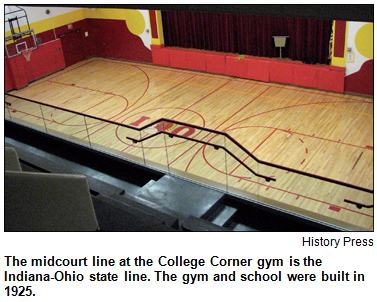 (Jan. 1, 2011) - One historic high school gym is owned now by the Miami Nation of Indians. At least two others are private homes. In another small Indiana town, a high school gym built in 1925 is a fire station.
(Jan. 1, 2011) - One historic high school gym is owned now by the Miami Nation of Indians. At least two others are private homes. In another small Indiana town, a high school gym built in 1925 is a fire station.
And then there's the historic gym that, thanks to its starring role in the classic movie Hoosiers (1986), has become a tourist attraction.
To explore these and other former gyms - which often served as "town halls," pulling basketball-crazed communities together on Friday nights from the 1920s through the '50s - Nelson is joined in studio by Indianapolis Star sportswriter Kyle Neddenriep, author of a new book, Historic Hoosier Gyms: Discovering Bygone Basketball Landmarks (The History Press).
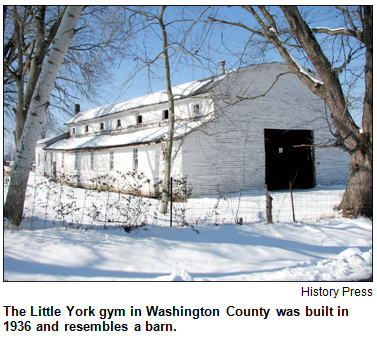 The lavishly illustrated book spotlights 100 former gyms, most dating to an era when every town, no matter how small, had a high school. Kyle not only unearthed the colorful pasts of these "gym gems," he photographed them in their current uses, which include a church (that's in tiny Honeywell in far-northeastern Indiana, where a hoop and basket hang over the pews of the Eden Worship Center) and a flea market (that's in Sidney in southern Indiana).
The lavishly illustrated book spotlights 100 former gyms, most dating to an era when every town, no matter how small, had a high school. Kyle not only unearthed the colorful pasts of these "gym gems," he photographed them in their current uses, which include a church (that's in tiny Honeywell in far-northeastern Indiana, where a hoop and basket hang over the pews of the Eden Worship Center) and a flea market (that's in Sidney in southern Indiana).
To help put all of this in context, Kyle and Nelson are joined in studio by Chris May, executive director of the Indiana Basketball Hall of Fame in New Castle, who shares insights about how current Hoosier high school gyms stack up against their counterparts across the country.
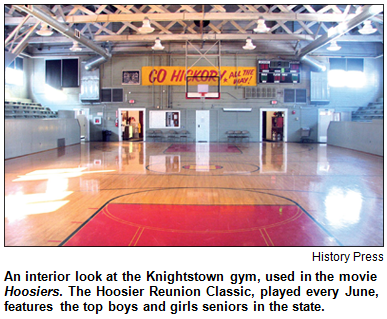 Speaking of New Castle: The city in Henry County, as many Hoosiers know, houses the world's largest high school gym. The New Castle Fieldhouse opened in 1960, seats more than 9,320 and has been dubbed "the cathedral of high school basketball" by USA Today.
Speaking of New Castle: The city in Henry County, as many Hoosiers know, houses the world's largest high school gym. The New Castle Fieldhouse opened in 1960, seats more than 9,320 and has been dubbed "the cathedral of high school basketball" by USA Today.
Did you know, though, that Martinsville once had top honors? Back in 1924 - just a few years before a player named Johnny Wooden would lead the team to glory, resulting in his first wave of fame - Martinsville opened a gym that accommodated more spectators (5,200) than the town's entire population at the time (4,800).
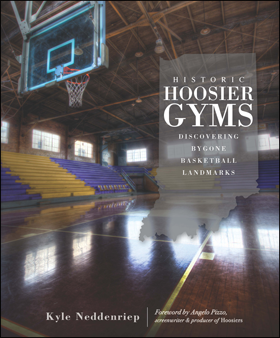 Not only was the Martinsville High School gym larger than Indiana and Purdue University's arenas then, it was featured in the nationally syndicated Ripley's Believe It or Not column.
Not only was the Martinsville High School gym larger than Indiana and Purdue University's arenas then, it was featured in the nationally syndicated Ripley's Believe It or Not column.
The historic gym, which today is part of Martinsville West Middle School (although only the original gym's brick entryway remains), also is featured in Kyle's book. He says he had three parameters for including a community's former basketball gym among the 100 showcased in Historic Hoosier Gyms.
"It could no longer be used as a high school gym. It had to be still standing. And I had to be able to gain access to get inside to take a photo."
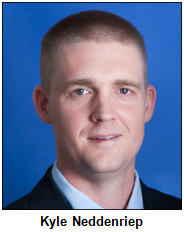 Among those showcased in Historic Hoosier Gyms:
Among those showcased in Historic Hoosier Gyms:
As we spotlight high school gyms, we ask Chris to share folklore about some of the well-known current ones. Second in size only to the New Castle Fieldhouse (which turned into an overnight shelter for a visiting team and spectators when a blizzard roared through during the early 1960s) is the Wigwam in Anderson, which seats more than 8,990. The Wigwam has remained open even though the former Anderson High School, which used to be next to it, closed more than a dozen years ago and subsequently burned.
Our History Mystery is a carry-over from two weeks previous, when there was no correct answer. The question focuses on one of the best-known Hoosier politicians during World War II.
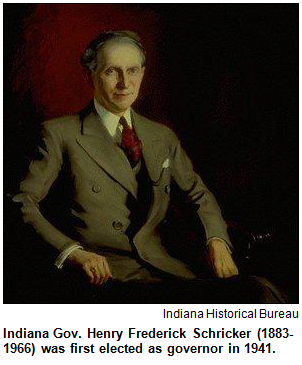 For most of the war, Indiana's popular governor was Henry Schricker, a maverick Democrat from North Judson. Gov. Schricker maintained a high public profile across the state after he was elected in 1941, appearing at war bond rallies on Monument Circle with glamorous movie star Carole Lombard and even running (unsuccessfully) for the U.S. Senate in 1944 while also serving as governor.
For most of the war, Indiana's popular governor was Henry Schricker, a maverick Democrat from North Judson. Gov. Schricker maintained a high public profile across the state after he was elected in 1941, appearing at war bond rallies on Monument Circle with glamorous movie star Carole Lombard and even running (unsuccessfully) for the U.S. Senate in 1944 while also serving as governor.
In his public appearances, including his speeches at war bond rallies, Gov. Schricker invariably wore a distinctive item of apparel that became his trademark.
Question: What article of clothing was identified with Gov. Henry Schricker? Callers during our previous show guessed "top hat," "string tie" and "bowler hat," none of which is the precise answer.
The prize was a gift card to Ambrosia Ristorante-Bar and two tickets to the Eiteljorg Museum, courtesy of the Indianapolis Convention and Visitors Association.
 (Dec. 18, 2010) - The final surviving WASP in Indiana is 88-year-old Marty Wyall of Fort Wayne. For many years, she has been the official, national historian of the WASPs (Women Air Force Service Pilots), who were recognized last spring with a Congressional Gold Medal for their service during World War II.
(Dec. 18, 2010) - The final surviving WASP in Indiana is 88-year-old Marty Wyall of Fort Wayne. For many years, she has been the official, national historian of the WASPs (Women Air Force Service Pilots), who were recognized last spring with a Congressional Gold Medal for their service during World War II.
Created in 1942 to address a severe shortage of pilots, the WASP program was the first in which women flew aircraft for the U.S. military, undertaking non-combat missions. The historic details are fascinating, and Marty Wyall joins Nelson to explore them.
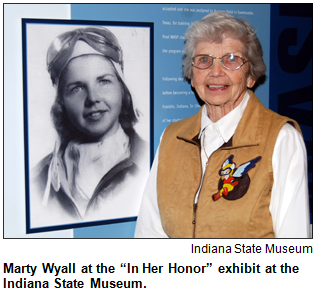 So does Leslie Lorance, new media manager of the Indiana State Museum, where a current exhibit titled "In Her Honor" salutes Marty and other WASPs. More than 1,000 women earned silver wings to become WASPs; Marty graduated in the final class just days before the experimental program closed in December 1944.
So does Leslie Lorance, new media manager of the Indiana State Museum, where a current exhibit titled "In Her Honor" salutes Marty and other WASPs. More than 1,000 women earned silver wings to become WASPs; Marty graduated in the final class just days before the experimental program closed in December 1944.
Although the WASPs were not involved in combat, they test-flew new and experimental planes from factories to military bases, towed targets to help train gunners in their shooting skills and undertook other challenges in the air. During their service, 38 WASPs died. Experts say their work paved the way - or blazed a route - for generations of women pilots who have followed.
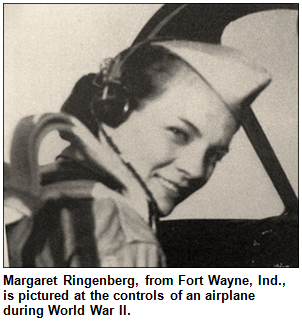 Marty (her real name is Mary Anna) was born in the town of Liberty in eastern Indiana, graduated from DePauw University in 1943 and had taken solo flying lessons prior to applying to the WASPs. After the war, she became a ferry pilot, then a flight instructor near Franklin, Ind. Even while marrying and raising a family in Fort Wayne, Marty continued flying and competing in transcontinental air races.
Marty (her real name is Mary Anna) was born in the town of Liberty in eastern Indiana, graduated from DePauw University in 1943 and had taken solo flying lessons prior to applying to the WASPs. After the war, she became a ferry pilot, then a flight instructor near Franklin, Ind. Even while marrying and raising a family in Fort Wayne, Marty continued flying and competing in transcontinental air races.
So did another WASP from the Fort Wayne area, Margaret Ringenberg, who was featured in Tom Brokaw's book The Greatest Generation (not to mention Nelson's Indiana Legends) and was named a Living Legend by the Indiana Historical Society several years ago; Margaret passed away in 2008. The exhibit at the State Museum honoring Marty, Margaret and the other WASPs - all of whom were civilian volunteers - continues through Aug 8.
A small fleet of insights:
Learn more: Click here to listen to Susan Stamberg's NPR story, from March of 2010, about the Congressional Gold Medal awards in Washington.
 For most of World War II, Indiana's popular governor was Henry Schricker, a maverick Democrat from North Judson. Gov. Schricker maintained a high public profile across the state after he was elected in 1941, appearing at war bond rallies on Monument Circle with glamorous movie star Carole Lombard and even running (unsuccessfully) for the U.S. Senate in 1944 while also serving as governor. In his public appearances - including his speeches at war bond rallies - Gov. Schricker invariably wore a distinctive item of apparel that became his trademark.
For most of World War II, Indiana's popular governor was Henry Schricker, a maverick Democrat from North Judson. Gov. Schricker maintained a high public profile across the state after he was elected in 1941, appearing at war bond rallies on Monument Circle with glamorous movie star Carole Lombard and even running (unsuccessfully) for the U.S. Senate in 1944 while also serving as governor. In his public appearances - including his speeches at war bond rallies - Gov. Schricker invariably wore a distinctive item of apparel that became his trademark.
Question: What article of clothing was identified with Gov. Henry Schricker?
The prize was a gift card to Barcelona Tapas Restaurant and a one-night stay at Sheraton Indianapolis City Centre Hotel, courtesy of the Indianapolis Convention and Visitors Association.
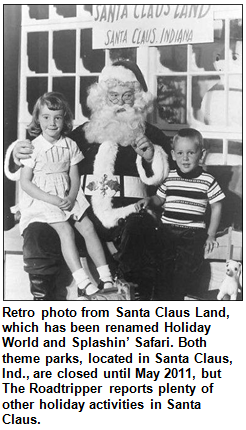 Chris Gahl of the ICVA tells us there's no better way to celebrate the holiday season than a visit to America's Christmas town, Santa Claus, Ind. This small town in Spencer County in southern Indiana devotes the entire month to the holiday, and this is the last weekend to join in the festivities.
Chris Gahl of the ICVA tells us there's no better way to celebrate the holiday season than a visit to America's Christmas town, Santa Claus, Ind. This small town in Spencer County in southern Indiana devotes the entire month to the holiday, and this is the last weekend to join in the festivities.
The festivities include everything from Christmas tree lightings to dinner with Santa. Join a yuletide wine tasting at Christmas Lake Golf Course or family activities at Kringle Place, and be sure not to miss all the sweet treats at Santa's Candy Castle. At the end of the night, take a drive through Lake Rudolph's 1.2-mile "Santa Claus Land of Lights" for a special Christmas story.
 (Dec. 11, 2010) - It may not have a world-famous racetrack like its counterpart town that's surrounded by Indianapolis (Hoosier History Live! explored Speedway's town history a while back), but Beech Grove sports its own distinctive heritage. Railroad repair facilities, a major hospital, the birth of a movie icon of the 1960s and '70s and a post-World War II housing boom are chapters in the history of a city in southeastern Marion County that evolved from what had been a beech tree-filled cattle farm in the late 1800s.
(Dec. 11, 2010) - It may not have a world-famous racetrack like its counterpart town that's surrounded by Indianapolis (Hoosier History Live! explored Speedway's town history a while back), but Beech Grove sports its own distinctive heritage. Railroad repair facilities, a major hospital, the birth of a movie icon of the 1960s and '70s and a post-World War II housing boom are chapters in the history of a city in southeastern Marion County that evolved from what had been a beech tree-filled cattle farm in the late 1800s.
Nelson's guests in studio include lifelong Beech Grove resident Steve Nontell, a veteran announcer for its school district's sports teams whose parents moved into the town’s first post-WWII housing developments. In addition to Steve (who has been connected to Beech Grove High School's wrestling program - as a student manager, then as a scorekeeper and announcer - longer than anyone else in its history), Nelson is joined in studio by librarian Will Smither, who grew up in the town, lived there for more than 34 years and has helped research the local links of Steve McQueen.
Speaking of the future star of The Great Escape (1963) and Bullitt (1968), who was born in Beech Grove's St. Francis Hospital in 1930: Nelson and his studio guests also are joined by phone from Arizona by McQueen's biographer, Marshall Terrill. Considered a top expert on the turbulent life of the film actor, Marshall recently visited Beech Grove in connection with his new books, Steve McQueen: The Life and Legend of a Hollywood Icon (Triumph Books) and Steve McQueen: A Tribute to the King of Cool (Dalton Watson). His biographies are being released to commemorate the 30th anniversary of McQueen's death in 1980.
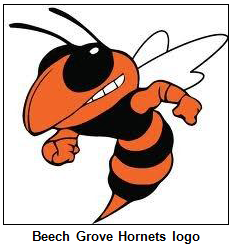 McQueen's birthplace, St. Francis, has been one of the city's largest employers for decades. For much of the early 20th century, so were railroad repair and equipment facilities. One of them was so massive that, according to the Encyclopedia of Indianapolis, it was known as "the largest locomotive hospital in the world."
McQueen's birthplace, St. Francis, has been one of the city's largest employers for decades. For much of the early 20th century, so were railroad repair and equipment facilities. One of them was so massive that, according to the Encyclopedia of Indianapolis, it was known as "the largest locomotive hospital in the world."
First, though, the area was rural. The owner of one of the largest farms, banker Francis Churchman, is credited with convincing a major railroad to construct a shipping facility there at the dawn of the last century In 1906, construction began of a locomotive shop and equipment plant - and the city's identification with railroad repair facilities roared off.
Some fun facts:
In one of his acclaimed movies, The Sand Pebbles" (1966), Steve McQueen was directed by a fellow native Hoosier. 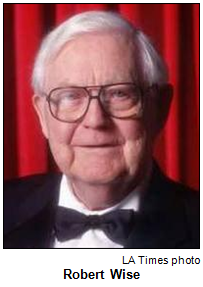 His director, Robert Wise, was one of the most talented and versatile in Hollywood; his credits include directing "The Sound of Music" (1965) and "West Side Story" (1961).
His director, Robert Wise, was one of the most talented and versatile in Hollywood; his credits include directing "The Sound of Music" (1965) and "West Side Story" (1961).
Although Robert Wise was born in 1914 in Winchester in far-eastern Indiana, he attended high school in another town, which also is in that region of the state. The high school has named its auditorium in honor of Wise.
Question: Name the Indiana high school from which Robert Wise graduated.
The prize was a gift card to Barcelona Tapas Restaurant and a one-night stay at Sheraton Indianapolis City Centre Hotel, courtesy of the Indianapolis Convention and Visitors Association.
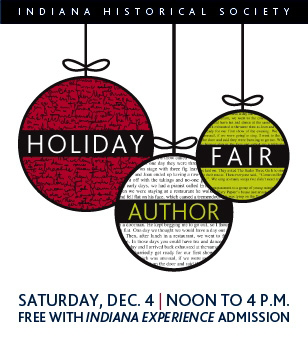 (Dec. 4, 2010) - For the third year, Hoosier History Live! did our broadcast from a remote (non-studio) location: the Eugene and Marilyn Glick Indiana History Center, which always bustles and abound with captivating interviewees, as more than 70 authors with ties to Indiana gather for the 8th Annual Holiday Author Fair. Nelson conducts round-robin chats with fellow authors who have a range of Hoosier expertise.
(Dec. 4, 2010) - For the third year, Hoosier History Live! did our broadcast from a remote (non-studio) location: the Eugene and Marilyn Glick Indiana History Center, which always bustles and abound with captivating interviewees, as more than 70 authors with ties to Indiana gather for the 8th Annual Holiday Author Fair. Nelson conducts round-robin chats with fellow authors who have a range of Hoosier expertise.
Our show features:
Barbara Olenyik Morrow of Auburn, Ind., who has written a new biography for young readers of legendary naturalist Gene Stratton-Porter. The book, Nature's Storyteller: The Life of Gene Stratton-Porter(Indiana Historical Society Press), explores the colorful life of the photographer and author of classics such as A Girl of the Limberlost, Freckles and Laddie. Born in 1863, she grew up on a farm in Wabash County and fell in love with wildlife, particularly birds. 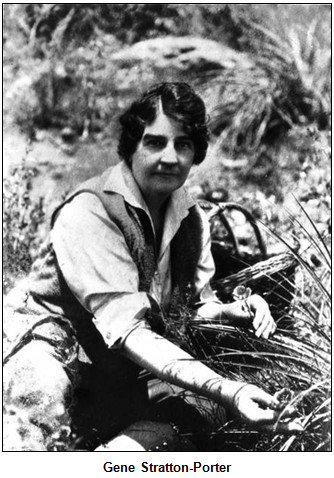 As an adult, Stratton-Porter founded Limberlost cabins in Geneva and Rome City, plunged into swamps to explore and photograph wildlife, and fought political and business leaders to preserve Indiana's wetlands. Her biographer Barbara Olenyik Morrow is an award-winning author of children's books.
As an adult, Stratton-Porter founded Limberlost cabins in Geneva and Rome City, plunged into swamps to explore and photograph wildlife, and fought political and business leaders to preserve Indiana's wetlands. Her biographer Barbara Olenyik Morrow is an award-winning author of children's books.
Janet Edwards, the author of Diana of the Dunes: The True Story of Alice Gray (The History Press). Janet lives in St. Louis but says she has spent many summers as a "Dunebug" in northwest Indiana, where she was told folklore about the mysterious Diana of the Dunes. Janet's biography separates myths from facts about the inspiration for the folklore, a Chicago native named Alice Gray who settled in the sand hills of northwest Indiana in 1915. Cultured and well-educated - Alice Gray was a Phi Beta Kappa graduate of the University of Chicago - she abandoned the city (she once was quoted as saying, "Life as a wage earner is slavery") - for a secluded life in a fisherman's shack. Did she really splash naked in Lake Michigan and romp on the beach to dry off? Did she find serenity in the Indiana Dunes? Nelson asks Janet, who has put together the first full-length biography of the intriguing woman buried in Oak Hill Cemetery in Gary.
Philip Potempa, a popular food and celebrity columnist for The Times of Northwest Indiana newspaper. 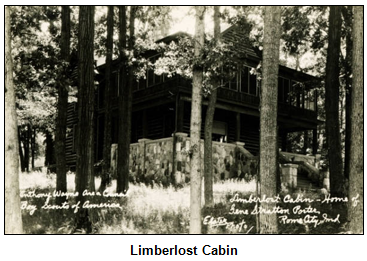 Phil, who grew up on a multi-generational family farm near Valparaiso, is the author of Further from the Farm: Family Recipes and Memories of a Lifetime (Pediment Press), his latest collection of food-related vignettes and recipes. With a special emphasis on heirloom menu favorites from Hoosier farm families, Phil's cookbook includes recipes from dozens of readers of his weekly "From the Farm" column. His new cookbook also features recipes from his celebrity interviewees; they include actress Betsy Palmer, who grew up in East Chicago and is best remembered for her long-running stint as a panelist in the 1950s and '60s on the TV show I've Got A Secret.
Phil, who grew up on a multi-generational family farm near Valparaiso, is the author of Further from the Farm: Family Recipes and Memories of a Lifetime (Pediment Press), his latest collection of food-related vignettes and recipes. With a special emphasis on heirloom menu favorites from Hoosier farm families, Phil's cookbook includes recipes from dozens of readers of his weekly "From the Farm" column. His new cookbook also features recipes from his celebrity interviewees; they include actress Betsy Palmer, who grew up in East Chicago and is best remembered for her long-running stint as a panelist in the 1950s and '60s on the TV show I've Got A Secret.
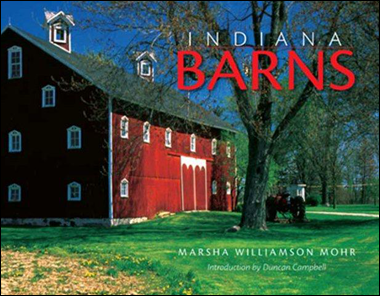 And agricultural expert Mauri Williamson of West Lafayette, who wrote the preface for Indiana Barns (Indiana University Press), a photo book featuring rustic barns "tucked among bucolic fields from Valparaiso to Vincennes." The images are drawn from the portfolio of Mauri's daughter, Marsha Williamson Mohr, who photographed barns of all sizes, shapes and conditions. Marsha collaborated on the project with Duncan Campbell, a professor of architecture. Among rural Hoosiers, Mauri Williamson is well known for originating the Pioneer Village at the Indiana State Fair and as the retired longtime executive secretary of the Purdue Agricultural Alumni Association; he's also director of the Indiana Corn Growers Association.
And agricultural expert Mauri Williamson of West Lafayette, who wrote the preface for Indiana Barns (Indiana University Press), a photo book featuring rustic barns "tucked among bucolic fields from Valparaiso to Vincennes." The images are drawn from the portfolio of Mauri's daughter, Marsha Williamson Mohr, who photographed barns of all sizes, shapes and conditions. Marsha collaborated on the project with Duncan Campbell, a professor of architecture. Among rural Hoosiers, Mauri Williamson is well known for originating the Pioneer Village at the Indiana State Fair and as the retired longtime executive secretary of the Purdue Agricultural Alumni Association; he's also director of the Indiana Corn Growers Association.
For many of her years amid the sand hills of far-northwestern Indiana, Diana of the Dunes lived in a shack near Chesterton. The town in Porter County also is known for hosting an annual festival associated with a classic book and movie.  In terms of plot and characters, the book and movie have no direct connection to Indiana, but Chesterton began hosting the annual festival in 1981.
In terms of plot and characters, the book and movie have no direct connection to Indiana, but Chesterton began hosting the annual festival in 1981.
Question: Name the classic book and movie.
The prizes were pairs of tickets to Handel's Messiah the weekend of Dec. 11-12. These tickets are courtesy of the Indianapolis Chamber Orchestra. Don't pass up this opportunity to mingle with Indiana authors and win the gift of a live musical performance.
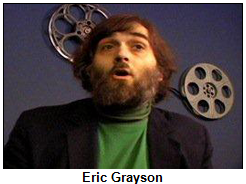 (Nov. 27, 2010) - Identifying the Hoosier links of some movies - such as Hoosiers (1986), Breaking Away (1979) and Rudy (1993) - is a breeze. Yet dozens of much more obscure films, both silent movies and talkies, also have major connections to Indiana because of their topics, settings, cast or directors. Some of these movies are in danger of becoming "lost."
(Nov. 27, 2010) - Identifying the Hoosier links of some movies - such as Hoosiers (1986), Breaking Away (1979) and Rudy (1993) - is a breeze. Yet dozens of much more obscure films, both silent movies and talkies, also have major connections to Indiana because of their topics, settings, cast or directors. Some of these movies are in danger of becoming "lost."
Nelson is joined in studio by Indianapolis-based film historian and collector Eric Grayson, who has discovered the only surviving print of Freckles (1935), which was based on a best-selling book by Hoosier naturalist Gene Stratton-Porter. Eric's vast collection of rare 16mm and 35mm films - which he shows at events across the state - includes other movie versions of Stratton-Porter's bestsellers, such as A Girl of the Limberlost (1934) and Laddie(1940).
By the way, we explore the life of photographer-author Stratton-Porter, who founded scenic Limberlost cabins in Geneva and Rome City in northeast Indiana, on the next week's show (Dec. 4, 2010).
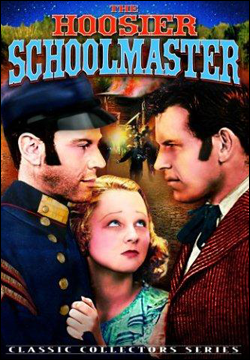 Other highlights of our show about rare movies include:
Other highlights of our show about rare movies include:
Drawing on his vast library of rare film-related material, Eric has done presentations in places ranging from Kansas and New York to Finland. He also contends that the "best gems" among rare films are found, as he puts it, "in dumpsters and dilapidated theaters."
By the way, you can also view Eric's Dr. Film, which he calls his "film history project for the digital age," at www.drfilm.net.
She was born in 1890 and grew up in rural Shelby County. 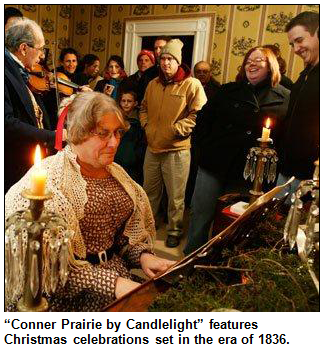 Her father, a minister, objected to acting. She attended Franklin College for a year but eventually began touring in vaudeville and stock companies. That resulted in Broadway roles. By the time she began making an impact in Hollywood, she already was middle-aged. The native Hoosier had supporting roles in several major movies from the 1930s through the 1950s. But she is best remembered for a series of lower-budget movies in which she played a leading role.
Her father, a minister, objected to acting. She attended Franklin College for a year but eventually began touring in vaudeville and stock companies. That resulted in Broadway roles. By the time she began making an impact in Hollywood, she already was middle-aged. The native Hoosier had supporting roles in several major movies from the 1930s through the 1950s. But she is best remembered for a series of lower-budget movies in which she played a leading role.
Question: Name the movie actress.
The prize was a pair of tickets to Conner Prairie by Candlelight, where you can travel back in time to Dec. 24, 1836, and visit all of your favorite Prairietown families preparing for Christmas. Tickets courtesy of the Indianapolis Convention and Visitors Association.
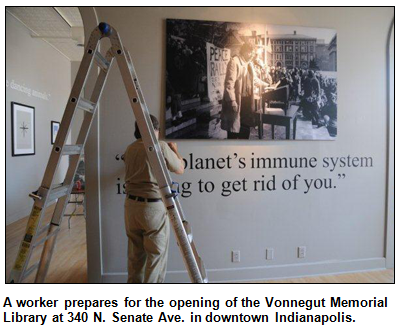 "Indianapolis made me what I am today. The city was a terrific influence." - Kurt Vonnegut Jr. during an interview with Nelson in 1991
"Indianapolis made me what I am today. The city was a terrific influence." - Kurt Vonnegut Jr. during an interview with Nelson in 1991
"Some very authentically nasty things happened to me here." - Vonnegut to The Indianapolis News in 1973
(Nov. 20, 2010) - His ancestors were among the earliest Indianapolis families, not to mention among the most prominent and influential. Literary lion Kurt Vonnegut Jr., though, had a complicated, continually evolving relationship with his hometown, although he rejoiced in the resurgence of downtown and emphasized he felt honored by the citywide "Year of Vonnegut" events under way when he passed away in 2007.
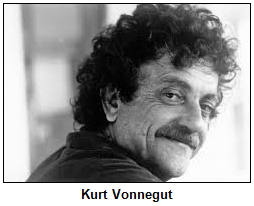 As Hoosier History Live! salutes what would have been his 88th birthday this month, we explore his attitudes toward the Hoosier capital, where his grandfather and father, both architects, designed landmarks that remain with us today. Nelson is joined in studio by David Hoppe of Nuvo newsweekly, who befriended Vonnegut and escorted the author of Slaughterhouse Five (1969) and other bestsellers during his return visits. Our guests also include Len Mozzi, a board member of the Kurt Vonnegut Memorial Library, which is getting under way in the historic Emelie Building, 340 N. Senate Ave. in downtown Indianapolis.
As Hoosier History Live! salutes what would have been his 88th birthday this month, we explore his attitudes toward the Hoosier capital, where his grandfather and father, both architects, designed landmarks that remain with us today. Nelson is joined in studio by David Hoppe of Nuvo newsweekly, who befriended Vonnegut and escorted the author of Slaughterhouse Five (1969) and other bestsellers during his return visits. Our guests also include Len Mozzi, a board member of the Kurt Vonnegut Memorial Library, which is getting under way in the historic Emelie Building, 340 N. Senate Ave. in downtown Indianapolis.
A 1940 graduate of Shortridge High School, where Vonnegut became an editor of the legendary Echo student newspaper, he frequently referred to Indianapolis and his boyhood in books such as Palm Sunday (1981) and A Man Without a Country (2005). Vonnegut's great-grandfather, 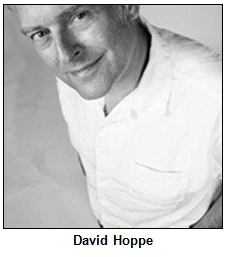 Clemens Vonnegut, arrived in 1851 from Germany during an explosive era of growth in the Hoosier capital. He founded a chain of hardware stores that had become the city's oldest family-owned business when it was sold more than 100 years later.Three of his four sons were involved in the enterprise.
Clemens Vonnegut, arrived in 1851 from Germany during an explosive era of growth in the Hoosier capital. He founded a chain of hardware stores that had become the city's oldest family-owned business when it was sold more than 100 years later.Three of his four sons were involved in the enterprise.
But one son, Bernard Vonnegut, became a distinguished architect and designed the Athenaeum (initially known as Das Deutsche Haus), the flagship L.S. Ayres department store and other landmarks. (Much later, in the 1930s, Bernard's son, architect Kurt Sr., designed the Ayres clock) All of this was a source of pride to Kurt Jr., as was his Shortridge education.
However, the famous novelist also was highly critical of his hometown during its “Naptown” era. 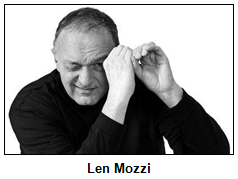 And decades earlier, his family experienced a dramatic reversal of fortune during the Great Depression; then they coped with the tragic death of Vonnegut's mother, a possible suicide.In some interviews during the 1970s, he even referred to Shortridge as an "elitist" school. Vonnegut also was outraged after a disastrous initial book signing (in the Ayres building, no less) for Slaughterhouse Five, despite the novel's spectacular reception elsewhere.
And decades earlier, his family experienced a dramatic reversal of fortune during the Great Depression; then they coped with the tragic death of Vonnegut's mother, a possible suicide.In some interviews during the 1970s, he even referred to Shortridge as an "elitist" school. Vonnegut also was outraged after a disastrous initial book signing (in the Ayres building, no less) for Slaughterhouse Five, despite the novel's spectacular reception elsewhere.
So there's much to explore during the show. Nelson and David were heavily involved in "Year of Vonnegut" events and spoke during a reflection of his life at the Indianapolis Museum of Art. Len, president of Indianapolis-based Dramatic Difference, which provides presentation,  theatrical and creativity skills to business leaders, is actively involved in the memorial library. It's being developed with the help of Vonnegut's daughters Edie and Nanny and his son Mark, who came to Indy shortly after his father's death to deliver what many experts think were his final written words: the speech he intended to give at Clowes Hall during the "Year of Vonnegut."
theatrical and creativity skills to business leaders, is actively involved in the memorial library. It's being developed with the help of Vonnegut's daughters Edie and Nanny and his son Mark, who came to Indy shortly after his father's death to deliver what many experts think were his final written words: the speech he intended to give at Clowes Hall during the "Year of Vonnegut."
Shortridge High School in Indianapolis has produced many distinguished grads in addition to Kurt Vonnegut, who was a member of the Class of 1940. The Class of '50, for example, included future U.S. Sen. Richard Lugar and Dan Wakefield, who would go on to write bestselling books such as Going All the Way.
Among Vonnegut's friends at Shortridge was a fellow editor of the Echo student newspaper named Madelyn Pugh. Several years later, as Madelyn Pugh Davis, she became a prominent  Hollywood-based writer during the Golden Age of radio and TV. In fact, she was the co-creator of a classic TV series shown in reruns to this day. She co-wrote most of the show's scripts.
Hollywood-based writer during the Golden Age of radio and TV. In fact, she was the co-creator of a classic TV series shown in reruns to this day. She co-wrote most of the show's scripts.
Question: What classic TV series did Shortridge grad Madelyn Pugh Davis help create?
The prize was a gift certificate to Scotty's Brewhouse, as well as a pair of passes to the Rhythm Discovery Center, courtesy of the Indianapolis Convention and Visitors Association.
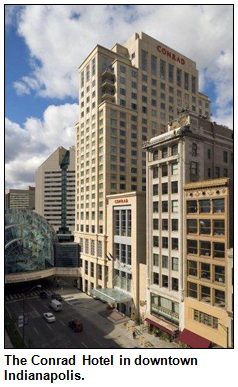 A Black Friday Roadtrip was touted by Chris Gahl of the ICVA. Our Roadtripper tells us that each year more than 25,000 people from outside of Indianapolis travel to the capital city to take advantage of "Black Friday," exploring the city's numerous shopping centers and boutiques. Often considered a great place to "getaway," the Conrad Indianapolis is offering an epic deal.
A Black Friday Roadtrip was touted by Chris Gahl of the ICVA. Our Roadtripper tells us that each year more than 25,000 people from outside of Indianapolis travel to the capital city to take advantage of "Black Friday," exploring the city's numerous shopping centers and boutiques. Often considered a great place to "getaway," the Conrad Indianapolis is offering an epic deal.
For only $99, you can stay at this upscale hotel - the same place Bush, Obama, Eric Clapton and Sidney Poitier have stayed. This rate includes coffee and valet parking. If you're looking for a place to eat the day before, on Thanksgiving, the Conrad will be offering a feast spread over a 20-foot-long buffet table, with complimentary champagne.
The Conrad is Hilton's luxury brand, a brand that was founded in 1919 by Conrad Hilton - his first hotel, in Mobley in Cisco, Texas. You don't have to travel to Texas to find a steal of a deal and be a tourist in your own hometown.
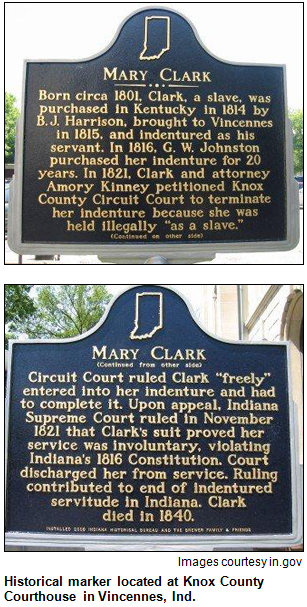 (Nov. 13, 2010) - In 1821, a young African-American woman in Vincennes made history. A lawyer for Mary Bateman Clark filed a lawsuit seeking her release from an "indentured servitude" contract with one of the most prominent men in the new state of Indiana. The contract required Mary to cook, clean and sew for Gen. Washington Johnston and his family for 20 years. Her only pay was housing, food and clothing.
(Nov. 13, 2010) - In 1821, a young African-American woman in Vincennes made history. A lawyer for Mary Bateman Clark filed a lawsuit seeking her release from an "indentured servitude" contract with one of the most prominent men in the new state of Indiana. The contract required Mary to cook, clean and sew for Gen. Washington Johnston and his family for 20 years. Her only pay was housing, food and clothing.
The case, which made its way to the Indiana Supreme Court, involved determining whether such "indentured servitude" contracts violated the state's constitution as a form of slavery. Nearly 200 years ago this month - on Nov. 16, 1821 - the Supreme Court ruled in Mary's favor and ordered her employer to release her.
To share insights about the social history of the era and the landmark case, Nelson was joined in studio by one of Mary's descendants, Indianapolis resident Eunice Trotter. Eunice, a veteran journalist, and her sister Ethel McCane are using their research about their ancestor to do "living history performances" for schools and civic groups across the state. They can be contacted through their website at marybatemanclark.org.
 Eunice and Ethel crusaded for a historic marker in honor of Mary Bateman Clark; it was dedicated at the Knox County Courthouse in 2009. The sisters are Mary Bateman Clark's great-great-great granddaughters.
Eunice and Ethel crusaded for a historic marker in honor of Mary Bateman Clark; it was dedicated at the Knox County Courthouse in 2009. The sisters are Mary Bateman Clark's great-great-great granddaughters.
According to their research, many white residents of Vincennes and other early Indiana communities worried about the presence of free African-Americans, fearing they would incite indentured blacks.
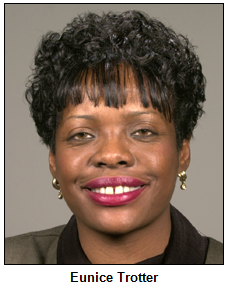 Also in the 1820s, another young woman in Vincennes sued to obtain her freedom. Polly Strong had been enslaved by Col. Hyacinth LaSalle, a prominent Vincennes resident, before Indiana became a state in 1816. LaSalle challenged the new state constitution, unsuccessfully arguing that it could not be applied retroactively.
Also in the 1820s, another young woman in Vincennes sued to obtain her freedom. Polly Strong had been enslaved by Col. Hyacinth LaSalle, a prominent Vincennes resident, before Indiana became a state in 1816. LaSalle challenged the new state constitution, unsuccessfully arguing that it could not be applied retroactively.
Re-enactments of the Polly Strong case are performed across Indiana under the direction of Corydon historic preservationist Maxine Brown. She was our guest on Hoosier History Live! two years ago for a show about her historic restoration of a segregated school in Corydon. The restored school, now known as the Leora Brown School, has been the setting for re-enactments of the court cases of Mary Bateman Clark and Polly Strong.
Vincennes has the distinction of being Indiana's oldest city, as well as our territorial capital. But by 1830 another town in southern Indiana claimed the distinction of being the state's largest city. This city remained the state's biggest until about 1850, when it was eclipsed by the explosive growth of Indianapolis.
Question: Name the southern Indiana town that was our largest city in the 1830s and '40s.
To win the prize, you must call in with the correct answer during the live show. The call-in number is (317) 788-3314, and the prize is two tickets to the
Children's Museum, courtesy of the Indianapolis Convention and Visitors Association.
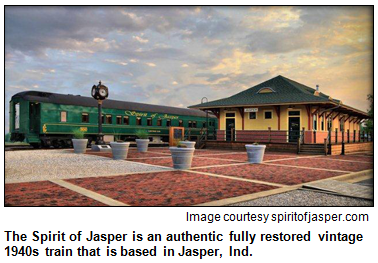 Chris Gahl of the ICVA says "All Aboard" and tells us to head to Jasper in southern Indiana to catch a ride on the Spirit of Jasper, an authentic fully restored vintage 1940s train. Coming up on Saturday, Nov. 20, you'll be able to buy a ticket and take an hourlong scenic ride from Jasper to French Lick.
Chris Gahl of the ICVA says "All Aboard" and tells us to head to Jasper in southern Indiana to catch a ride on the Spirit of Jasper, an authentic fully restored vintage 1940s train. Coming up on Saturday, Nov. 20, you'll be able to buy a ticket and take an hourlong scenic ride from Jasper to French Lick.
Depart from the Jasper Train Depot at 5 p.m. on the Spirit of Jasper and wind through the Hoosier countryside, arriving at the 1907 Monon Depot in French Lick, home of the Indiana Railway Museum. Besides checking out the museum, you also can do a tasting at the French Lick Winery or have a spa treatment with the healing mineral waters of the West Baden Hotel.
At 11 p.m., the train heads back to Jasper, making this a scenic, historic and fun way to spend a Saturday. Make reservations online at www.spiritofjasper.com.
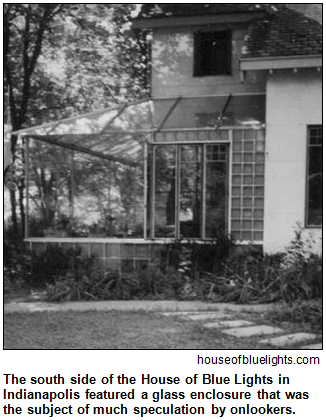 (Oct. 30, 2010) - You now can listen to the full audio of our Oct. 31, 2009 Hoosier History Live! show about the House of Blue Lights with guest Mike Ahern. This audio link, as well as many photographs, are courtesy of the website that our guests have created, houseofbluelights.com.
(Oct. 30, 2010) - You now can listen to the full audio of our Oct. 31, 2009 Hoosier History Live! show about the House of Blue Lights with guest Mike Ahern. This audio link, as well as many photographs, are courtesy of the website that our guests have created, houseofbluelights.com.
As the source of perhaps the biggest urban legend in state history, the House of Blue Lights - and resulting folklore about the secluded estate regarded for nearly 50 years as the creepiest place in Indianapolis - can't be covered in a single show.
Those of you who tuned in to our Halloween Day broadcast last year featuring longtime WISH-TV anchorman Mike Ahern's insights about the House of Blue Lights - as well as anyone fascinated by the myths surrounding the estate of eccentric millionaire Skiles E. Test - are in for another Halloween treat. 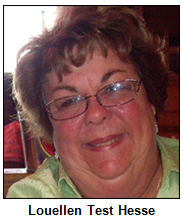 Nelson's guests included Skiles Test's daughter, Louellen Test Hesse, a lifelong Californian who rarely has been interviewed about the House of Blue Lights.
Nelson's guests included Skiles Test's daughter, Louellen Test Hesse, a lifelong Californian who rarely has been interviewed about the House of Blue Lights.
Sneaking around the estate near Fall Creek Road and Shadeland Avenue became a Halloween-season rite of passage for thousands of high school and college students from the 1920s through the 1960s. Louellen graciously agreed to be a guest by phone, joining Nelson and his in-studio guest, another person with firsthand knowledge of the mysterious House of Blue Lights: 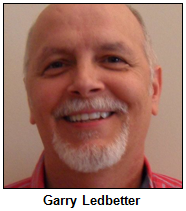 Garry Ledbetter, whom Mr. Test employed as a young caretaker.
Garry Ledbetter, whom Mr. Test employed as a young caretaker.
Regular listeners will recall that Garry phoned in during last year's show to mention his duties included feeding more than 150 cats that Mr. Test kept as pets on the property. The resulting pet cemetery fueled curiosity by six generations of teenagers.
Primarily, though, their obsession focused on the urban legend that Mr. Test kept the corpse of his beautiful, dead wife in a glass coffin that he bathed in blue light. Trespassers hoped to catch a glimpse of the casket, the perfectly preserved dead body and of Mr. Test, who was said to sit beside it in a chair, rocking in sorrow night after night.
As we clarified during last year's show, there was never a corpse. Mr. Test (1889-1964) was married three times, and all of his former wives (including Louellen's mother in California) outlived him. 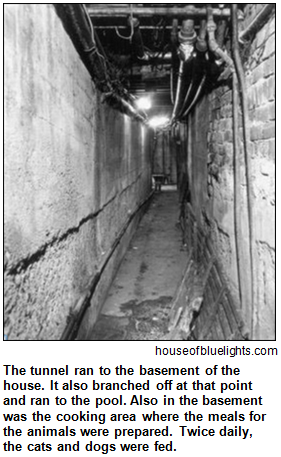 Many more questions and myths abound, even though the eerie House of Blue Lights was demolished in 1978. As a news anchor, Mike Ahern covered the demolition, which he discussed during last year's show.
Many more questions and myths abound, even though the eerie House of Blue Lights was demolished in 1978. As a news anchor, Mike Ahern covered the demolition, which he discussed during last year's show.
Garry and Louellen joined Nelson on the air this Halloween weekend to cover as much more turf as possible during the show.
According to Garry, some accounts even indicate J. Edgar Hoover visited the Test property during the 1930s to check out the creepy doings on behalf of the FBI.
Garry, Louellen and Nelson also explored the tunnels on the Test estate, one of the many sources of intrigue for the waves of trespassing teenagers. What was the purpose of the tunnels? Did teens ever get trapped in them? And why, if the thousands of young trespassers eventually distressed Mr. Test, didn't he get out the word that there was no corpse on the property?
Some tidbits:
According to urban legends about the House of Blue Lights, the sprawling estate was guarded by packs of vicious dogs, primarily Dobermans. 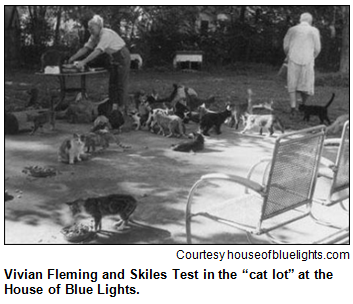 In truth, owner Skiles Test kept far more cats than dogs. And the pet dogs owned by Mr. Test were not breeds known for being vicious. Some of the pet dogs were Pekingese. But most of the dogs were of a large breed that was discussed on Hoosier History Live! last year as well as in other media accounts that have explored the truth - and the myths - about the House of Blue Lights.
In truth, owner Skiles Test kept far more cats than dogs. And the pet dogs owned by Mr. Test were not breeds known for being vicious. Some of the pet dogs were Pekingese. But most of the dogs were of a large breed that was discussed on Hoosier History Live! last year as well as in other media accounts that have explored the truth - and the myths - about the House of Blue Lights.
Question: Name the primary breed of dog that Skiles Test kept on the estate.
The prize was a gift certificate to Iozzo's Garden of Italy, courtesy of the Indianapolis Convention and Visitors Association.
Chris Gahl of the ICVA suggested we visit the Harrison Center for the Arts, which is located at 15th and Delaware streets in downtown Indianapolis. 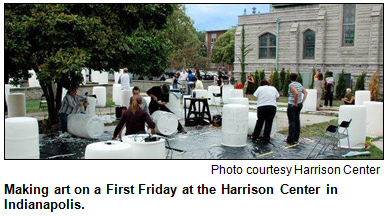 The Harrison Center is housed in what used to be the First Presbyterian Congregation, which was established in 1823 - a church where President Benjamin Harrison was an elder and Sunday-school teacher.
The Harrison Center is housed in what used to be the First Presbyterian Congregation, which was established in 1823 - a church where President Benjamin Harrison was an elder and Sunday-school teacher.
Present day, the Harrison Center serves as a hub for cultural development and urban revitalization, with more than 15 in-resident artists and lots of community education programs. Each month, the Harrison Center offers a new exhibit. November's show will feature paintings, photographs and written word that explores Indiana residents' relationship with Indiana food.
You can also plug in to the Harrison Center for the popular First Friday Art Tour, with the next one occurring Nov. 5 from 6 to 9 p.m.
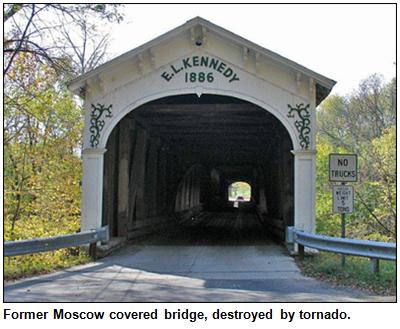 (Oct. 23, 2010) - Given that Hoosier newsmakers hail from every corner of the state, isn't it grand when they drop by Hoosier History Live! to be our guides as we explore their hometowns and counties? It's particularly appreciated when they do this amid a high-profile job change.
(Oct. 23, 2010) - Given that Hoosier newsmakers hail from every corner of the state, isn't it grand when they drop by Hoosier History Live! to be our guides as we explore their hometowns and counties? It's particularly appreciated when they do this amid a high-profile job change.
To explore Rush County and his cherished hometown of Rushville, the county seat, former Indiana Secretary of State Joe Hogsett joined Nelson in studio. Joe has been generating a fresh round of headlines because he started his new job this month as U.S. attorney for the Southern District of Indiana following his confirmation by the U.S. Senate.
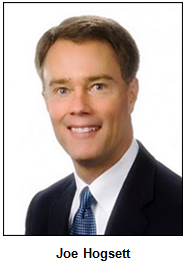 Before launching his political career in the 1980s by managing Evan Bayh's campaigns for governor and secretary of state, Joe grew up in Rushville, the town of about 5,900 located 40 miles southeast of Indy.
Before launching his political career in the 1980s by managing Evan Bayh's campaigns for governor and secretary of state, Joe grew up in Rushville, the town of about 5,900 located 40 miles southeast of Indy.
Joe isn't the only prominent politician associated with the town. As the maverick, dark-horse presidential nominee of the Republican Party in 1940, charismatic Wendell Willkie, a native of Elwood, designated Rushville as his adopted hometown because he had married a local resident, Edith Wilk (no relation). Her husband ran his rollicking campaign against FDR out of the historic Durbin Hotel, drawing national news media and public figures to Rushville, where Willkie eventually bought property.
In more recent years, political figures from Rushville have included Suellen Reed, a Republican who served three terms as Indiana's superintendent of public instruction, beginning in 1992.  Fun fact: As a teacher in Rushville, her students included a young Joe Hogsett.
Fun fact: As a teacher in Rushville, her students included a young Joe Hogsett.
It's not just public figures who have drawn attention to Rush County, though. The county also is the home of covered bridges built in the late 1800s by the renowned designer E.L. Kennedy. Amid much fanfare in September, a reconstructed covered bridge in tiny Moscow (pop. 38 people) was dedicated after the bridge, which Kennedy designed in 1886, was thrown into the Flatrock River by a tornado in 2008.
The reconstruction of the Moscow covered bridge used 30 percent of the wood from the historic bridge, which had been held and contained in the river. Gov. Mitch Daniels likened the reconstruction, which took 18 months and involved a community-wide effort, to "an old-fashioned barn raising." Attended by a crowd of camera-toting, flag-waving spectators, the dedication 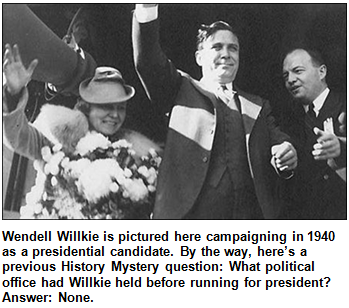 ceremony featured bagpipes, drums and performances by the marching band from Rushville High School, Joe's alma mater.
ceremony featured bagpipes, drums and performances by the marching band from Rushville High School, Joe's alma mater.
In addition to covered bridges and politicians, Rush County has been the home of Amish communities for many generations. Named in honor of Dr. Benjamin Rush, a signer of the Declaration of Independence, the county also has several round barns.
Let's circle back to the public figures. In addition to Joe Hogsett, an attorney long associated with the Indianapolis law firm of Bingham McHale (he also served as chairman of the Indiana Democratic Party), Rushville has ties to NASCAR driver Tony Stewart, who, like Willkie, has two Hoosier hometowns. He primarily grew up in Columbus, where Tony maintains a home to this day, but as a boy he launched his racing career in Rushville and was nicknamed "the Rushville Rocket."
Some more fun facts:
Twenty years ago, Joe Hogsett pulled off an upset victory in the election for Indiana secretary of state. Although he was the incumbent - having been appointed secretary of state a year earlier by newly elected Gov. Evan Bayh - Joe was running against a much better known opponent in his 1990 campaign for the office.
Question: Name the well-known Republican whom he defeated.
The prize was four tickets to the Indiana State Museum, courtesy of the Indianapolis Convention and Visitors Association.
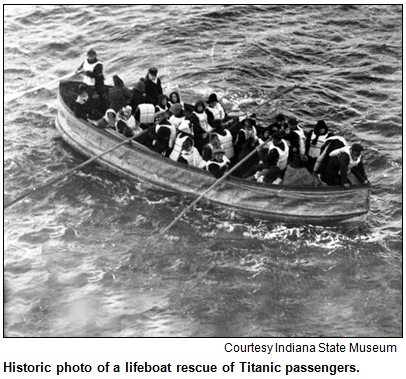 (Oct. 9, 2010) - If historians contended there were links between landlocked Indiana and the sinking of the Titanic in 1912, would you argue they were all wet? Well, steady yourselves. It turns out there were 14 passengers on the "unsinkable" luxury liner who had Hoosier connections. Some of the Hoosiers survived, while others were among the more than 1,500 passengers and crew members who perished.
(Oct. 9, 2010) - If historians contended there were links between landlocked Indiana and the sinking of the Titanic in 1912, would you argue they were all wet? Well, steady yourselves. It turns out there were 14 passengers on the "unsinkable" luxury liner who had Hoosier connections. Some of the Hoosiers survived, while others were among the more than 1,500 passengers and crew members who perished.
To explore all aspects of the tragedy that has captivated the world since the Titanic struck an iceberg on its maiden voyage, Nelson was joined in studio by Indianapolis resident Craig Ware, whose lifelong interest in the Titanic culminated with meeting the final living survivor - and then corresponding with her. (Millvina Dean, the youngest passenger on board, died at age 97 in England last year.)
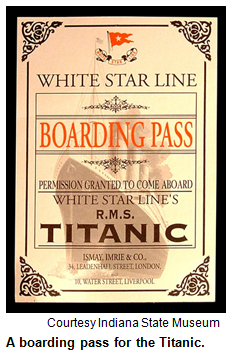 A member of the Titanic Historical Society years before the ship was discovered at the bottom of the North Atlantic in 1985, Craig has amassed a trove of info about the massive liner that was built for luxury and convenience, not speed. Indeed, the Titanic has become a symbol of the overconfidence and opulence of the Edwardian era.
A member of the Titanic Historical Society years before the ship was discovered at the bottom of the North Atlantic in 1985, Craig has amassed a trove of info about the massive liner that was built for luxury and convenience, not speed. Indeed, the Titanic has become a symbol of the overconfidence and opulence of the Edwardian era.
Nelson and Craig were joined in studio by Katherine Gould, associate curator of cultural history at the Indiana State Museum, where an extensive new exhibit recently opened. Featuring room re-creations and about 240 artifacts that have been salvaged from the wreck site, Titanic: The Artifact Exhibition will continue at the State Museum through Jan. 16.
The Hoosier survivors included an Irish maid who had immigrated to Indianapolis but then returned to her homeland to visit relatives. Victims included a Hammond resident who had traveled to Sweden to visit her parents. She perished, as did her 2-year-old daughter, who had been born in Hammond.
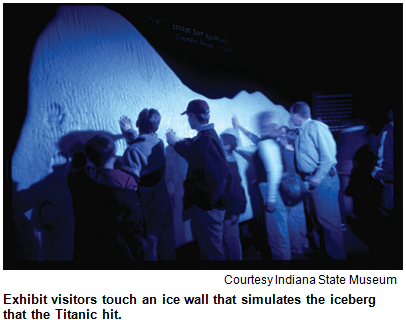 Myths and folklore abound about the sinking. They include allegations that distress signals were ignored, that third-class passengers deliberately were kept below deck, and that the ship's cargo included cases of dragon blood.
Myths and folklore abound about the sinking. They include allegations that distress signals were ignored, that third-class passengers deliberately were kept below deck, and that the ship's cargo included cases of dragon blood.
We try to separate fact from myth as we delve into a tragedy that for generations has fascinated social historians, analysts of mass panic, science-oriented folks, and those intrigued with what happened to - and aboard - the ship. Their numbers are legion, particularly since the release of the blockbuster movie Titanic (1997) starring Leonardo DiCaprio and Kate Winslet. (Their co-star Gloria Stuart passed away last month at age 100.)
Some Titanic-related tidbits:
In 1913, just one year after the tragic sinking of the Titanic, a natural disaster affected the state of Indiana. The natural disaster happened in March 1913 and resulted in more than 200 deaths across the state.
Question: What was the natural disaster?
The prize was four tickets to the Indiana State Museum, as well as a gift certificate to Ike & Jonesy's, all courtesy of the Indianapolis Convention and Visitors Association.
With Chris Gahl of the ICVA out Roadtripping far beyond the banks of the Wabash, Amy Lamb, media relations manager at the Indiana Historical Society, filled in on Saturday.
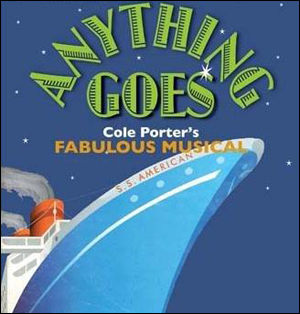 Amy says "Anything Goes" as the Indiana Historical Society's Anything Goes: Cole Porter Revue kicks off on Oct. 14 and 15, 2010.
Amy says "Anything Goes" as the Indiana Historical Society's Anything Goes: Cole Porter Revue kicks off on Oct. 14 and 15, 2010.
Eli Lilly Hall will be transformed into a 1940s-era nightclub for a De-Lovely evening including dinner and dancing, as well as a cabaret show about Porter's life and music performed by Actors Theatre of Indiana. Cost is $75 per person (or $60 if you're an IHS member), and advance registration is required. Other Anything Goes programming will also take place in November, February and March.
If you can't make the revue, Amy says you can always visit the Cole Porter Room at the Eugene and Marilyn Glick Indiana History Center anytime Tuesday through Saturday, 10 a.m. to 5 p.m., to see related memorabilia and have your song selection performed for you, right on the spot.
(Oct. 2, 2010) - Not only is St. John Catholic Church the oldest in Indianapolis, with parish origins that date clear back to the 1830s, the ornate church with twin steeples that are a distinctive part of the city's skyline has evolved into a unique role as a spiritual haven.
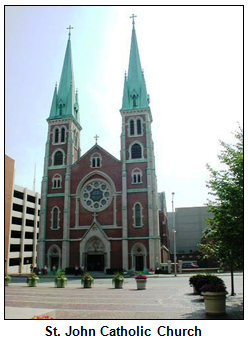 Rising up right near our pro football arenas - Lucas Oil Stadium and its predecessor the RCA Dome - as well as the Indiana Convention Center and downtown hotels, St. John, at 126 W. Georgia St., has become the church where convention-goers, tourists, Indianapolis Colts fans and international visitors go to celebrate Mass.
Rising up right near our pro football arenas - Lucas Oil Stadium and its predecessor the RCA Dome - as well as the Indiana Convention Center and downtown hotels, St. John, at 126 W. Georgia St., has become the church where convention-goers, tourists, Indianapolis Colts fans and international visitors go to celebrate Mass.
The odyssey of the majestic church that has become Indy's version of tourist-oriented St. Patrick's Cathedral in Manhattan mirrors downtown's journey from "Naptown" to vibrancy. Before its resurgence with a special niche, St. John's membership had declined from a peak of 3,000 parishioners in the 1880s to fewer than 300 by the early 1970s.
Nelson was joined in studio by St. John's historian/music director Tom Nichols and two well-known civic leaders who were instrumental in the renaissance: Rev. Tom Murphy, who became a Catholic priest in mid-life after a distinguished career as an attorney and state legislator (he helped push through a bill that allowed for the Convention Center's creation in 1971), and Bill McGowan Jr., who served as president and CEO of the Indianapolis Convention and Visitors Association from 1984 to 2002.
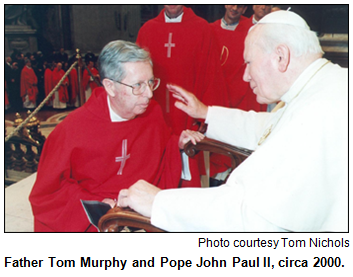 The church features a parish rectory built during the Civil War, nave windows and twin steeples that rise to a height of 194 feet.
The church features a parish rectory built during the Civil War, nave windows and twin steeples that rise to a height of 194 feet.
Not only does our show's spotlight fall on St. John during football season, it comes amid citywide tributes to Rev. Murphy, who is celebrating the 25th anniversary of his ordination. His ancestors were married at St. John, which was partially founded by Irish immigrants. The St. John parish rectory opened in 1863, then was greatly enlarged in 1877 by Bishop Silas Chatard, the first bishop of Indianapolis.
St. John's connection to the Colts and the Convention Center begins with location, location, location: The majestic church practically "greets" spectators as they walk to (or exit from) the nearby stadium and convention center. Downtown hotels also are barely more than a football's throw away, meaning the church is a convenient destination for visiting business officials and tourists.
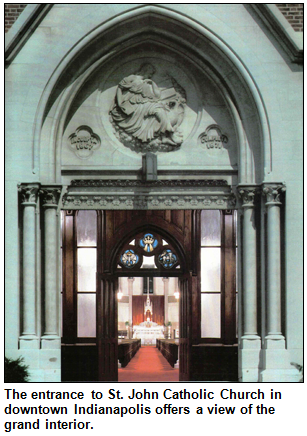 Rev. Murphy served as the priest at St. John from 1993 to 2003. That's been only one chapter, though, in a life that has had a significant impact on downtown Indy and beyond, including stints in Rome and as president of Serra International. As an attorney in the 1960s and '70s, he worked in a law office on Monument Circle. He served in the General Assembly, then studied theology in Rome and was ordained in 1985. Rev. Murphy's assignments as a priest, in addition to St. John, included a pastorate at St. Joan of Arc in Indy. Through it all, he has been noted for his compassion and his efforts to revitalize downtown.
Rev. Murphy served as the priest at St. John from 1993 to 2003. That's been only one chapter, though, in a life that has had a significant impact on downtown Indy and beyond, including stints in Rome and as president of Serra International. As an attorney in the 1960s and '70s, he worked in a law office on Monument Circle. He served in the General Assembly, then studied theology in Rome and was ordained in 1985. Rev. Murphy's assignments as a priest, in addition to St. John, included a pastorate at St. Joan of Arc in Indy. Through it all, he has been noted for his compassion and his efforts to revitalize downtown.
Ditto for Bill McGowan Jr., who has served on a staggering number of civic boards and has been named a Sagamore of the Wabash by four Indiana governors. In addition to (or as a result of) his long-running leadership with the ICVA, Bill was a key player in dozens of major events in Indy, including the 1987 Pan American Games, the Penrod Art Fair and the International Violin Competition.
Our show, though, focuses on the niche that St. John (and our three guests) have played in the revitalization of downtown - as well as the journey of a church that began with Irish immigrants and now involves international visitors, sports fans and tourists.
A second Catholic parish was founded in downtown Indianapolis in 1910. Many of the founding parishioners were German immigrants and wanted to celebrate Mass in the language of their homeland. 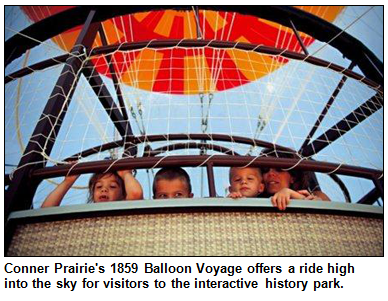 They built a Catholic church with twin spires on the east end of downtown. Today the church continues to serve many immigrants, but now they primarily are Hispanic. Mass often is celebrated in Spanish.
They built a Catholic church with twin spires on the east end of downtown. Today the church continues to serve many immigrants, but now they primarily are Hispanic. Mass often is celebrated in Spanish.
Question: Name the Catholic church in downtown Indy that opened in 1910.
The prize was two tickets to Conner Prairie and two tickets for the 1859 Balloon Voyage at Conner Prairie, all courtesy of the Indianapolis Convention and Visitors Association.
With Chris Gahl of the ICVA on an extended Roadtrip, we asked Amy Lamb, media relations manager at the Indiana Historical Society, to fill in. 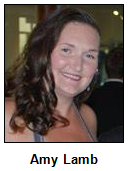 Amy told us about a very first in Indianapolis, the Inaugural Indianapolis Scottish Highland Games. The Games will take place Saturday, Oct. 9, from 9 to 5 at the Latvian Center at 1008 W. 64th St. in Indianapolis and are hosted by the Scottish Society of Indianapolis.
Amy told us about a very first in Indianapolis, the Inaugural Indianapolis Scottish Highland Games. The Games will take place Saturday, Oct. 9, from 9 to 5 at the Latvian Center at 1008 W. 64th St. in Indianapolis and are hosted by the Scottish Society of Indianapolis.
Some of the traditional Highland games will include the Braemar Stone Put, 56-pound weight throw, caber toss, hammer toss and sheaf toss, for all those brawny lads and lasses. Music will include performances by Hogeye Navvy and Highland Reign. Tickets are $10 at the gate and $8 advanced sale, with more at indyscot.org.
Longtime Hoosier History Live! listeners will recall our August 2008 show about Scottish heritage with Dr. Lee Cloe. And expect to hear more from Amy about a painting of a famous Scot who founded New Harmony, Indiana: Robert Owen.
(Sept. 25, 2010) - Some day camps for children and teenagers have been ground-breaking - and did you know Indiana led the way? Not only has the Hoosier state long been considered a leader of the pack in children's camping, the country's first-ever day camp even was started here.
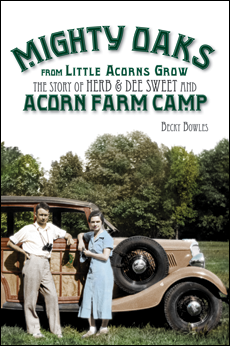 Begun in 1933, the trend-setting (or should we say pioneering?) Acorn Farm Camp in Hamilton County set a national pattern for child-centered day camps and, for 45 years, was attended by future Hoosier movers and shakers; even young Kurt Vonnegut Jr. and future biologist John Watson had connections to Acorn. The camp's founder became president of the American Camp Association, headquartered in Bradford Woods, and Acorn's heritage includes parallels with Gnaw Bone Camp in Brown County and Orchard School in Indianapolis.
Begun in 1933, the trend-setting (or should we say pioneering?) Acorn Farm Camp in Hamilton County set a national pattern for child-centered day camps and, for 45 years, was attended by future Hoosier movers and shakers; even young Kurt Vonnegut Jr. and future biologist John Watson had connections to Acorn. The camp's founder became president of the American Camp Association, headquartered in Bradford Woods, and Acorn's heritage includes parallels with Gnaw Bone Camp in Brown County and Orchard School in Indianapolis.
To explore nooks and crannies - not to mention crevices, woods and rocks - of our camping heritage, Nelson was joined in studio by three guests who have lived and breathed camping. They are sisters Jill Sweet Mead and Judee Sweet of Westfield, whose late parents became regional celebrities thanks to Acorn Farms and the multi-media endeavors that resulted from its success, including early local TV shows and a nationally syndicated newspaper column of "hands-on" tips for children.
 The story of Acorn Farms - and Indiana's day camp heritage - is told in a new book, Mighty Oaks from Little Acorns Grow (Hawthorne Publishing), written by Jill's daughter, Carmel resident Becky Bowles, who joined her mother and aunt in studio with Nelson.
The story of Acorn Farms - and Indiana's day camp heritage - is told in a new book, Mighty Oaks from Little Acorns Grow (Hawthorne Publishing), written by Jill's daughter, Carmel resident Becky Bowles, who joined her mother and aunt in studio with Nelson.
To put together the book, Becky had a trove: hundreds of camp newsletters, photos and mementos saved by her grandparents, Acorn founder Herb Sweet (who wrote a nationally syndicated "Try It" column of tips in the 1950s) and his wife, Dee, who became the host of some of the first local TV talk shows, also in the 1950s.
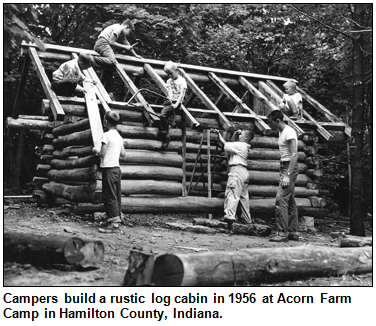 Before the Sweets and their "creative fun" approach involving children and nature, organized camping across the country had focused on overnight trips for teenagers, adults or groups of families.
Before the Sweets and their "creative fun" approach involving children and nature, organized camping across the country had focused on overnight trips for teenagers, adults or groups of families.
Why, the Sweets wondered, couldn't children as young as 5 years old during the Great Depression immerse themselves in nature - and then return to their homes at the end of the day? Seed pods, nuts, twigs, bark and feathers would be used to create toys, dolls and jewelry at Acorn Farms. The day camp sprang up in a bucolic setting between Carmel and Westfield ("sleepy villages" during the 1930s, as Becky notes in her book), with young campers traveling by bus from Indy.
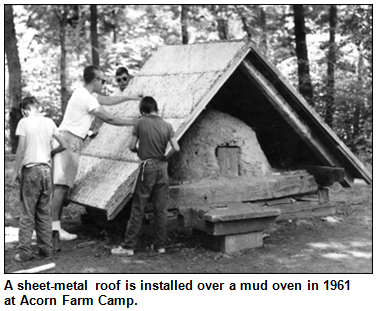 A lifelong nature lover, Herb Sweet for several years in the 1930s taught at Orchard School, which became known for "progressive education" concepts that pervaded Acorn Farms. According to Mighty Oaks From Little Acorns Grow, previous camping experiences, in addition to being overnighters, "were heavy on competition and award-giving for every achievement." At Acorn Farms and Gnaw Bone, which was founded by fellow Orchard faculty member Fred Lorenz, the focus was on creating "a culture of delight" for children in the natural world and encouraging self-expression.
A lifelong nature lover, Herb Sweet for several years in the 1930s taught at Orchard School, which became known for "progressive education" concepts that pervaded Acorn Farms. According to Mighty Oaks From Little Acorns Grow, previous camping experiences, in addition to being overnighters, "were heavy on competition and award-giving for every achievement." At Acorn Farms and Gnaw Bone, which was founded by fellow Orchard faculty member Fred Lorenz, the focus was on creating "a culture of delight" for children in the natural world and encouraging self-expression.
During the show, we explore the pioneers of day camping who had an impact on thousands of young Hoosiers, including Vonnegut during the summer of 1939. Some fun facts:
The Trivia Mystery is a carry-over from the last show, when there was no correct answer. The question focuses on one of the worst tragedies in Indiana history, the so-called Trail of Death involving the Potawatomi tribe in 1838.
A key figure in the tragedy was the leader of the Potawatomi, who were forced to leave their village in the "Twin Lakes" region of north central Indiana by soldiers under the command of Gen. John Tipton.
The soldiers led about 860 Potawatomi men, women and children on a 900-mile march to Kansas known as the Trail of Death. The Potawatomi chief, a convert to Catholicism who was known as a peacemaker, was put in a cage for the march. A statue of the chief stands today near his beloved Twin Lakes region; the tragic and courageous story of the Potawatomi is remembered every September in Fulton County with a Trail of Courage Living History Festival.
Question: Name the Potawatomi chief. Hint: He was not Little Turtle, who was incorrectly guessed by a listener two weeks ago.
The prize was two tickets to the Circle City Classic on Oct. 2 at Lucas Oil Stadium, and two tickets to the Eiteljorg Museum of American Indians and Western Art, all courtesy of the Indianapolis Convention and Visitors Association.
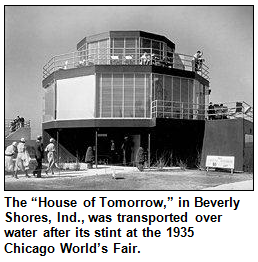 With Chris Gahl of the ICVA out on an extended transcontinental Roadtrip, Todd Zeiger, director of the Northern Regional Office of Indiana Landmarks, filled in for Chris and suggested that we head north to Beverly Shores along Lake Michigan to attend the Century of Progress Home Tour.
With Chris Gahl of the ICVA out on an extended transcontinental Roadtrip, Todd Zeiger, director of the Northern Regional Office of Indiana Landmarks, filled in for Chris and suggested that we head north to Beverly Shores along Lake Michigan to attend the Century of Progress Home Tour.
In 1935, Indiana inherited five then-modern houses from the Chicago World's Fair that were barged across Lake Michigan to Beverly Shores. All five houses will be open for public tours on October 23 and 24. You can register online for this event.
 (Sept. 11, 2010) - When white men were found guilty by a jury and executed for the slaughter of nine Native Americans in March 1824, it was a milestone in American history. Following what became known as the Fall Creek Massacre, whites for the first time were convicted and executed for the murders of Indians under American law.
(Sept. 11, 2010) - When white men were found guilty by a jury and executed for the slaughter of nine Native Americans in March 1824, it was a milestone in American history. Following what became known as the Fall Creek Massacre, whites for the first time were convicted and executed for the murders of Indians under American law.
To explore all aspects of the brutal crimes in the swampy woods of Madison County - where Native Americans (including three women and four children) were gruesomely murdered - Nelson was joined in studio by David Thomas Murphy, author of a new book, Murder in Their Hearts: The Fall Creek Massacre (Indiana Historical Society Press).
A professor of history at Anderson University, David has spent four years researching the massacre, trial and subsequent developments, including the social history of pioneer Hoosiers (Indiana only had been a state for about seven years at the time of the massacre) and of the Native Americans in the region.
"The slaughter in the soggy Indiana creek bottoms created a short-lived but serious national security crisis," David writes, referring to concerns across the country that warfare would erupt across newly developing states.
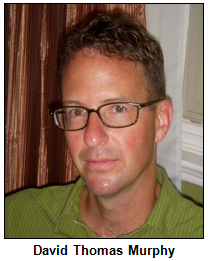 Noting that tensions had been brewing between whites and Native Americans for weeks prior to the massacre, David says the attitudes of many white settlers toward Indians were complex and nuanced, mixing respect, fear, tolerance and suspicion.
Noting that tensions had been brewing between whites and Native Americans for weeks prior to the massacre, David says the attitudes of many white settlers toward Indians were complex and nuanced, mixing respect, fear, tolerance and suspicion.
In researching the tragedy, David explored why the federal government devoted great efforts and resources to prosecuting the perpetrators; Nelson asks him to share his intriguing conclusions during the show.
They also discussed how David reconciled conflicting accounts of the events (the tribal origins of some of the victims remain unclear), as well as the motivations involved in the cold-blooded crimes, which involved shooting some of the Native Americans in their backs and mutilating several of the corpses.
 "Madison County was shocked by the killings at Fall Creek ... because deliberate, deadly violence, as opposed to spontaneous scuffles or fistfights, was not especially common on the farming frontier," according to Murder in Their Hearts.
"Madison County was shocked by the killings at Fall Creek ... because deliberate, deadly violence, as opposed to spontaneous scuffles or fistfights, was not especially common on the farming frontier," according to Murder in Their Hearts.
Fears of retaliation and of a disruption of the "wary co-existence" between white settlers and Native Americans were widespread.
"Hysteria swept through Madison County and then through the northern half of Indiana," David writes.
Within three days of the killings, six of the gang of seven killers were apprehended. 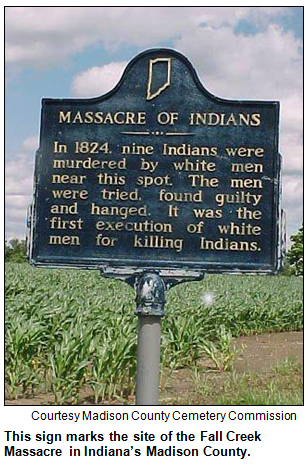 To imprison and then hold a trial for the perpetrators, frontier Madison County had to build both a jail and a courthouse.
To imprison and then hold a trial for the perpetrators, frontier Madison County had to build both a jail and a courthouse.
The brutal crimes and their aftermath involve many sensational incidents. They included the designation of Indiana's best-known politician (U.S. Sen. James Noble) as the prosecutor and, at the gallows, a last-minute pardon by Indiana's new governor, James Ray. On horseback, Gov. Ray galloped up to spare the life of a teenage member of the murderous gang.
The carnage of the Fall Creek Massacre drew national attention at the time, but the slaughter and judicial outcome often are not even mentioned in subsequent accounts of white-Native American relations, David says. An exception involved the late author Jessamyn West, an Indiana native who wrote a best-selling novel, The Massacre at Fall Creek (1975), about the shocking episode in Hoosier history.
David says he spent more than four years researching and writing Murder in Their Hearts. At Anderson University, he chairs the history and political science department; he also has directed the university's honors program.
Among the worst tragedies in Indiana history was the so-called Trail of Death involving the Potawatomi tribe in 1838. A key figure in the tragedy was the leader of the Potawatomi, who were forced to leave their village in the "Twin Lakes" region of north central Indiana by soldiers under the command of Gen. John Tipton. The soldiers led about 860 Potawatomi men, women and children on a 900-mile march to Kansas known as the Trail of Death.
The Potawatomi chief, a convert to Catholicism who was known as a peacemaker, was put in a cage for the march. A statue of the chief stands today near his beloved "Twin Lakes" region; the tragic and courageous story of the Potawatomi is remembered every September in Fulton County with a Trail of Courage Living History Festival.
Question: Name the Potawatomi chief.
The prize was two tickets to the Eiteljorg Museum of American Indians and Western Art, and two tickets to the Indiana Experience, courtesy of the Indianapolis Convention and Visitors Association.
Chris Gahl of the ICVA suggested we head up to the 37th annual Indianapolis Greek Festival at Holy Trinity Greek Orthodox Church in Carmel for authentic Greek cuisine, live music and dancing, and church tours. The festival was Saturday, Sept. 11.
On offer each year are savory dishes of gyros and lamb, sweet-tooth dishes such as baklava, as well as Hellenic dance performances with dancers from elementary to high school ages, plus church tours available all afternoon.
(Sept. 4, 2010) - 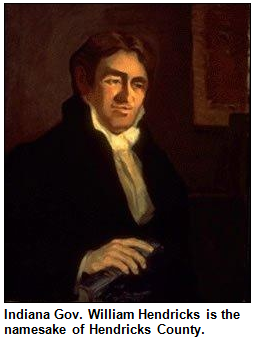 Lake County is easy to figure out, name-wise. Ditto for Boone County - at least if you are familiar with frontiersman Daniel Boone. But what about Marion, Allen and, for heaven's sake, Kosciusko or Ripley counties?
Lake County is easy to figure out, name-wise. Ditto for Boone County - at least if you are familiar with frontiersman Daniel Boone. But what about Marion, Allen and, for heaven's sake, Kosciusko or Ripley counties?
Turns out we have an in-house expert on the origin of county names among our WICR-FM colleagues. Nelson was joined in studio by our attorney friend Charles Braun, founder and co-host of Legally Speaking, the longest-running legal advice show on American radio. Charles, a Fort Wayne native, is a fellow Hoosier history lover, so he and Nelson enjoy swapping tidbits in between his show - which airs at 10 a.m. on Saturdays - and ours.
Now we go public with the history chatter, with Charles sharing his research and insights about Indiana county names for all listeners to enjoy. 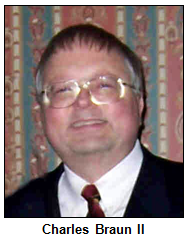 Promising to come to the studio armed with the origins of each of our 92 county names, Charles and Nelson will welcome your calls.
Promising to come to the studio armed with the origins of each of our 92 county names, Charles and Nelson will welcome your calls.
A former deputy state attorney general, Charles is an instructor at the Indiana Law Enforcement Academy, where he helps train police officers from across Indiana. Charles launched Legally Speaking in 1983. For the last 14 years, he has rotated the mic on the show with his co-host, attorney Charles Gantz.
Fun fact: The law enforcement academy is in Plainfield of Hendricks County, which was named after a family of early Hoosier politicians. The county's namesake was Gov. William Hendricks, who was in office at the time the county was formed.
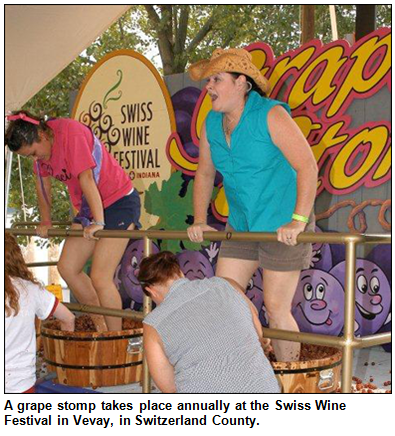 A sampling of other county name origins:
A sampling of other county name origins:
Knox County - which includes Vincennes, our state's oldest city - was named after a military leader with no Hoosier connections. Henry Knox, a soldier in the Revolutionary War, became the country's first Secretary of War. As such, he oversaw both the Army and the Navy.
Miami County in north central Indiana takes its name from the Native American people who lived in the area before white settlers arrived.
As you would expect, Switzerland County in the state's far-southeastern corner is named after the homeland of many of its early settlers. The county seat, Vevay, has a Swiss Wine Festival to this day.
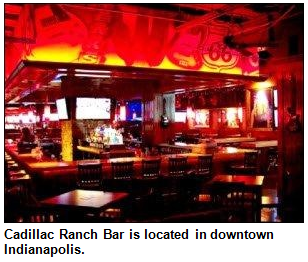 A city in Indiana takes its name from the French phrase for "high land" or "high ground."
A city in Indiana takes its name from the French phrase for "high land" or "high ground."
Question: What is the name of the city?
The prize was a gift certificate to Cadillac Ranch All American Bar and Grill in downtown Indy at Union Station, courtesy of the Indianapolis Convention and Visitors Association.
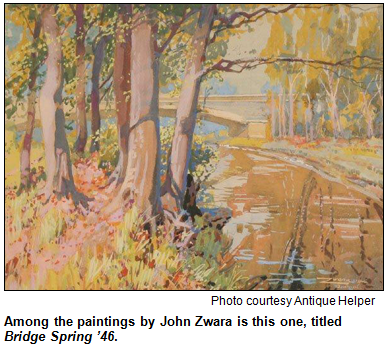 Chris Gahl of the ICVA highlights a special exhibit at nation's oldest surviving pathology laboratory, the Indiana Medical History Museum. The building provided physicians in the late 1800s and 1900s with state-of-the-art facilities to study mental and nervous disorders.
Chris Gahl of the ICVA highlights a special exhibit at nation's oldest surviving pathology laboratory, the Indiana Medical History Museum. The building provided physicians in the late 1800s and 1900s with state-of-the-art facilities to study mental and nervous disorders.
The museum now uses its more than 15,000 artifacts to educate visitors about the developments that made today's advanced medical treatments possible. It is located on the grounds of the former Central State Hospital on the near westside of Indianapolis.
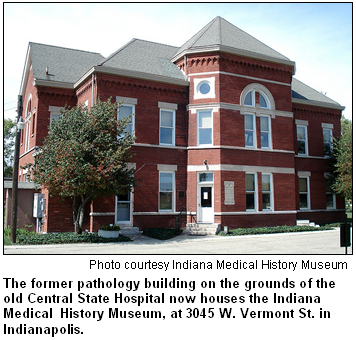 There's a unique exhibit running the entire month of September.
There's a unique exhibit running the entire month of September.
Austrian-born painter John Zwara came to Indianapolis in 1933 and spent several years living on the streets and selling his artwork. His friend, Alexander Vonnegut (uncle of Kurt Vonnegut), committed Zwara to Central State Hospital in 1938, where he was diagnosed with schizophrenia and spent six months at the hospital before escaping.
This exhibit features many of his works that were completed at Central State and will also highlight what little is known of his fascinating life.
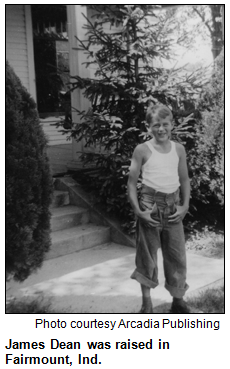 (Aug. 28, 2010) - You may know that movie icon James Dean grew up on a farm near the Grant County town of Fairmount. But were you aware the creator of the most widely syndicated comic strip in the world also grew up on a Fairmount farm? It was the boyhood home of Jim Davis, creator of Garfield, the cantankerous cat.
(Aug. 28, 2010) - You may know that movie icon James Dean grew up on a farm near the Grant County town of Fairmount. But were you aware the creator of the most widely syndicated comic strip in the world also grew up on a Fairmount farm? It was the boyhood home of Jim Davis, creator of Garfield, the cantankerous cat.
To explore the heritage of a town with several distinctions, Nelson was joined in studio by Fairmount resident Cathy Duling Shouse, the author of a new visual history book about her hometown, Fairmount, the latest in Arcadia Publishing's "Images of America" series. Cathy's ancestors settled in the Fairmount area before 1850. Of the 223 rare vintage photos in her book, more than half came from private collections of local residents. The images include a 1904 photo of the construction of the Winslow family farmhouse, where young James Dean was raised during the 1930s and '40s by his aunt and uncle.
There also are photos of Lake Galatia near Fairmount, which was formed by the last glacier. Lake Galatia is where, as Cathy puts it, "the most complete set of mammoth bones ever found was discovered." 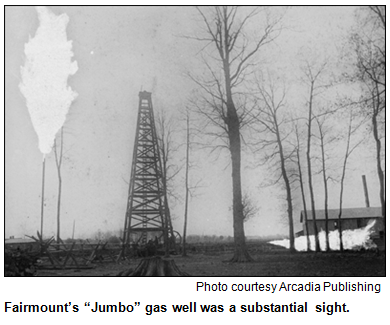 That was in 1904. The discovery of the huge skeleton of the mammoth (which apparently lived 11,000 years ago) sparked a lawsuit among local residents about their ownership. After the controversy was resolved, the mammoth bones were sold to the American Museum of Natural History in New York, where they remain on display to this day.
That was in 1904. The discovery of the huge skeleton of the mammoth (which apparently lived 11,000 years ago) sparked a lawsuit among local residents about their ownership. After the controversy was resolved, the mammoth bones were sold to the American Museum of Natural History in New York, where they remain on display to this day.
Initially part of Miami Indian territory, Fairmount was settled early on by Quakers. Fun fact: The mascot of old Fairmount High School - where James Dean, a member of the Class of 49, was a standout basketball player - was "the Quakers."
Even before the discovery of the mammoth bones, there was a "jumbo" making news in Fairmount. 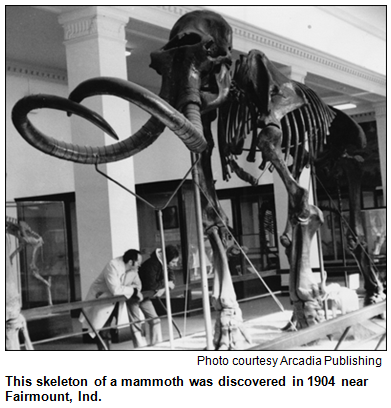 In 1887, as Cathy writes in her book, "this small, primarily agricultural area participated in one of the most dramatic eras in state history: the natural gas boom."
In 1887, as Cathy writes in her book, "this small, primarily agricultural area participated in one of the most dramatic eras in state history: the natural gas boom."
Indeed, a natural gas well discovered near Fairmount that year was so massive it was named "Jumbo," after the famous circus elephant. Thanks to the bountiful gas reserves, entrepreneurs flocked to the Fairmount area and built spacious, Victorian-era houses, many of which still stand.
"The wells produced so much natural gas that it was thought the supply never would run dry," Cathy notes.
Her book, which she put together with the Fairmount Historical Museum, includes boyhood photos of both James Dean and Jim (Garfield) Davis, who suffered from severe asthma during his boyhood on a farm. In interviews with Nelson over the years, Jim Davis has said his artistic endeavors kicked off when he was bedfast with asthma and began doodling.
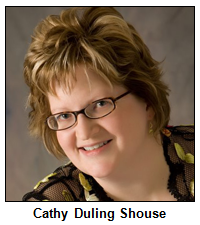 James Dean and Jim Davis had the same mentor at the high school: drama teacher Adeline Nall, whom the future cartoonist credits for pulling him out of shyness that resulted from the asthma.
James Dean and Jim Davis had the same mentor at the high school: drama teacher Adeline Nall, whom the future cartoonist credits for pulling him out of shyness that resulted from the asthma.
Other notables with Fairmount roots include Olive Rush, a renowned artist who even had one of her works displayed in the White House, and a Fairmount High grad who went on to become director of the National Hurricane Center. (Do you think of Hoosiers as likely to become experts on hurricanes?)
Our focus on the town came just before the James Dean Festival, which draws thousands to the community, with the arrival of vintage autos and pilgrimages to the grave site at Park Cemetery of the actor (1931-1955), every September.
 Although James Dean had a long list of credits in live television shows, as well as a few small movie roles at the start of his career, he had starred in only three films before his death in a car crash in 1955. The three movies were East of Eden, Rebel Without a Cause and Giant.
Although James Dean had a long list of credits in live television shows, as well as a few small movie roles at the start of his career, he had starred in only three films before his death in a car crash in 1955. The three movies were East of Eden, Rebel Without a Cause and Giant.
The casts of two of those movies included a young actor who, decades later, would come to Indiana to play a significant role in a movie filmed here. In fact, the actor would be nominated for an Academy Award for his performance in the Indiana-made movie.
Question: Name the actor.
The prize was a pair of tickets to Conner Prairie, as well as a pair of tickets to the Indiana Experience, all courtesy of the ICVA.
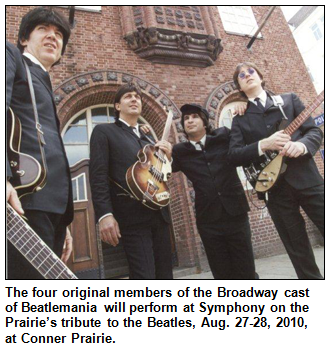 If we dial back the clock 200 years and travel to what is now 116th Street and Allisonville Road in Fishers, Ind., we would find William Conner living in a log home beside the White River with his Lenape (Delaware Indian) wife and five children.
If we dial back the clock 200 years and travel to what is now 116th Street and Allisonville Road in Fishers, Ind., we would find William Conner living in a log home beside the White River with his Lenape (Delaware Indian) wife and five children.
Our Roadtripper, Chris Gahl of the ICVA, says that if we travel to Conner Prairie this weekend, we'll see the the four original members of the Broadway cast of Beatlemania perform many Beatles hits such as Hard Day's Night, Twist and Shout and others in an authentic tribute to Liverpool's "Fab Four."
Symphony on the Prairie's tribute to the Beatles will run Friday, Aug. 27 at 8 p.m. and Saturday, Aug. 28 at 8 p.m.
Pack a picnic, watch the sunset over the prairie, and enjoy live music off Broadway.
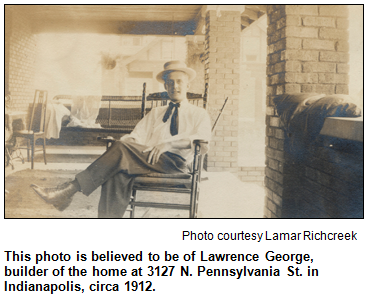 (Aug. 21, 2010) - Colorful history, welcoming porches, towering trees and a diverse assortment of homeowners are distinctive aspects of the next neighborhood to be featured in our rotating series. Many of the homes in the historic Meridian Park neighborhood on the near-Northside of Indianapolis were built between 1905 and 1930. They range from Arts and Crafts bungalows to spacious Dutch Colonial Revival, Tudor and Italian Villa homes. Listed on the National Register of Historic Places, Meridian Park has been in the spotlight this summer, which has included a popular home and garden tour.
(Aug. 21, 2010) - Colorful history, welcoming porches, towering trees and a diverse assortment of homeowners are distinctive aspects of the next neighborhood to be featured in our rotating series. Many of the homes in the historic Meridian Park neighborhood on the near-Northside of Indianapolis were built between 1905 and 1930. They range from Arts and Crafts bungalows to spacious Dutch Colonial Revival, Tudor and Italian Villa homes. Listed on the National Register of Historic Places, Meridian Park has been in the spotlight this summer, which has included a popular home and garden tour.
For Meridian Park's turn on Hoosier History Live!, Nelson was joined in studio by two longtime residents of the scenic neighborhood, which is tucked away east of Meridian Street and north of 30th Street.
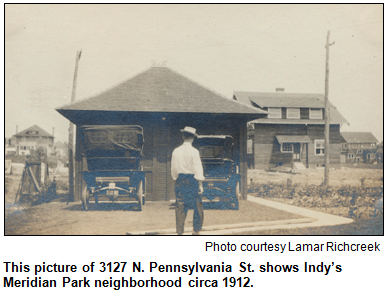 His guests from Meridian Park, which has been revitalized during the last 30 years, included Ben Solomon, who lives in an antique-filled Colonial Revival home built in 1916. Ben, who is the co-owner of Solomon/Jones Antiques and Interiors, has filled his historic house with furnishings purchased from the estates of prominent Indianapolis families. Nelson also was joined by photographer Lamar Richcreek, a faculty member at the Herron School of Art and Design who has lived in Meridian Park for decades with his wife, Jean.
His guests from Meridian Park, which has been revitalized during the last 30 years, included Ben Solomon, who lives in an antique-filled Colonial Revival home built in 1916. Ben, who is the co-owner of Solomon/Jones Antiques and Interiors, has filled his historic house with furnishings purchased from the estates of prominent Indianapolis families. Nelson also was joined by photographer Lamar Richcreek, a faculty member at the Herron School of Art and Design who has lived in Meridian Park for decades with his wife, Jean.
According to a recent article in Urban Times, in the 1870s the site of the future neighborhood "was not just farmland - it was a frontier." The houses built in the early 1900s became the then-suburban homes of bankers, architects, artists and business leaders.
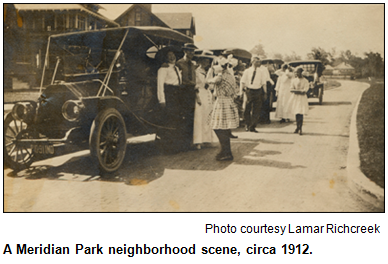 In addition to Arts and Crafts bungalows, several homes in Meridian Park were built in the Prairie and American Four Square styles, although the architecture is extremely diverse. Several Meridian Park homes also have quaint gardens. In addition, the neighborhood includes Washington Court, which is considered one of the city's first residential, pedestrian courtyards.
In addition to Arts and Crafts bungalows, several homes in Meridian Park were built in the Prairie and American Four Square styles, although the architecture is extremely diverse. Several Meridian Park homes also have quaint gardens. In addition, the neighborhood includes Washington Court, which is considered one of the city's first residential, pedestrian courtyards.
As affluent residents moved farther north during the mid-1900s, though, many homes were converted into businesses or deteriorated. A spacious home built in 1919 for a prominent Indianapolis businessman - and restored in recent years by its current owners, City County Councilor Jackie Nytes and her husband Michael O'Brien - eventually became a kindergarten, then served as the offices of a design firm. Nelson plans to ask his guests, Ben and Lamar, to share details about their homes' histories.
 Some fun facts:
Some fun facts:
Historic neighborhoods south of Meridian Park include Herron-Morton Place. In the late 19th century, Herron-Morton Place flourished as a residential neighborhood thanks to the construction of Queen Anne-style houses and other homes, many of which have been restored in recent years.
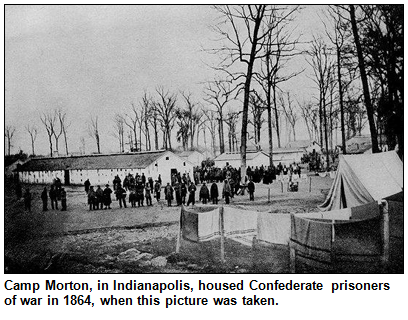 It's well-known that before the area became residential, it served as the site of Camp Morton, a Civil War site for the induction of Union Army soldiers. During the war, much of Camp Morton became a prisoner-of-war camp for captured Confederate soldiers. But before the Civil War, this part of Indianapolis - near Alabama, Delaware and 20th streets - had a very different use. It was the peacetime site of an Indiana event that continues to this day, albeit at a different location.
It's well-known that before the area became residential, it served as the site of Camp Morton, a Civil War site for the induction of Union Army soldiers. During the war, much of Camp Morton became a prisoner-of-war camp for captured Confederate soldiers. But before the Civil War, this part of Indianapolis - near Alabama, Delaware and 20th streets - had a very different use. It was the peacetime site of an Indiana event that continues to this day, albeit at a different location.
Question: What was on the site of today's Herron-Morton neighborhood immediately before the Civil War?
The prize was a pair of tickets to Conner Prairie, plus a gift certificate for Wheel Fun Rentals along the Central Canal in downtown Indianapolis, all courtesy of the ICVA.
Military Park is the oldest park in Indianapolis and covers 14 acres. The park hosted Indianapolis' first celebrated Independence Day on July 4, 1822. The first Indiana State Fair was held at the park in October 1852.
Our Roadtripper, Chris Gahl of the ICVA, suggests that we head to the 15th Rib America Festival on Labor Day Weekend - Friday, Sept. 3 through Monday, Sept. 6. Ten of the top rib restaurants will compete for the title of best - including teams from Texas, Tennessee and Georgia.
Admission is free before 5 p.m. on Friday and before 1 p.m. on Saturday, Sunday and Monday. Music, ribs, outside, Labor Day weekend - all a perfect combination!
(Aug. 14, 2010) - Earlier this summer, Hoosier History Live! explored the history of Indiana state parks. Next up is the system of parks and boulevards in Indianapolis, which involves the life of an internationally renowned landscape architect, George Kessler, who put together the first comprehensive, citywide parks plan. 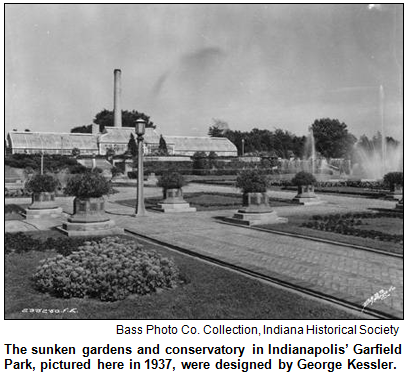 A German immigrant who eventually was based out of St. Louis, Kessler (1862-1923) never really became a resident of Indy, but he left a lasting impact on the city.
A German immigrant who eventually was based out of St. Louis, Kessler (1862-1923) never really became a resident of Indy, but he left a lasting impact on the city.
Nelson was joined in studio by two Indianapolis-based landscape architects who know this turf well. His guests were Meg Storrow of Storrow Kinsella Associates, who put together the National Register of Historic Places nomination for Indy's park and boulevard system, and David Roth of Synthesis Incorporated.
With Meg and David as our guides, we dig in and explore the creation of parks here, including Kessler's redesign of pre-existing Garfield Park (he created its well-known sunken gardens) and his vision for a chain of parks linked by wide, sweeping boulevards.
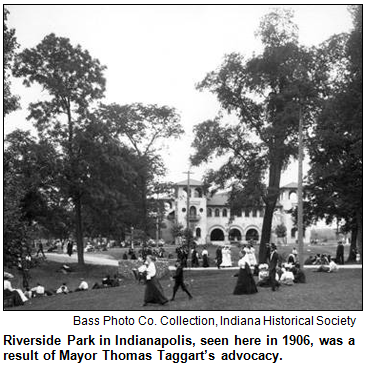 Kessler Boulevard, built after his death, was named in his honor. His system of parkways followed the major waterways in Marion County, including White River, Fall Creek and Pleasant Run.
Kessler Boulevard, built after his death, was named in his honor. His system of parkways followed the major waterways in Marion County, including White River, Fall Creek and Pleasant Run.
Some fun facts:
Nelson also asked Meg about her current work on the enhancement of Alice Carter Park at North Meridian Street and Westfield Boulevard. A co-founder and principal of Storrow Kinsella, Meg has been involved in an extensive array of landscape design, greenway and park projects across Indiana. At Synthesis, David has been the project manager for many urban design and greenway projects across Indiana, as well as a playground project at Washington Park in Indianapolis.
Our History Mystery question is a carry-over from last week, when there was no correct answer. The question concerns a popular Republican congressman from Indiana who is thought to have been the last public figure to shake Abraham Lincoln's hand before the president's assassination in 1865.
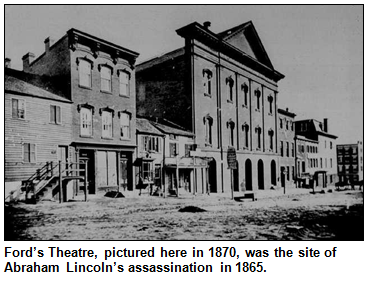 The Hoosier congressman, who later would become vice president of the United States, had been invited to accompany President and Mrs. Lincoln to Ford's Theatre that fateful evening in April, but he declined. The Hoosier congressman was elected speaker of the House twice, then became vice president. Hint: He was the first of (so far) five Hoosiers to become vice president.
The Hoosier congressman, who later would become vice president of the United States, had been invited to accompany President and Mrs. Lincoln to Ford's Theatre that fateful evening in April, but he declined. The Hoosier congressman was elected speaker of the House twice, then became vice president. Hint: He was the first of (so far) five Hoosiers to become vice president.
Question: Name the Indiana politician.
The prize was a one-night stay at the Holiday Inn Express Indianapolis City Centre, as well as a pair of tickets to the Indiana State Museum, courtesy of the ICVA.
Chris Gahl of the ICVA says it is time for us to "Dig-IN." This Taste of Indiana is a daylong event featuring growers and chefs from across Indiana. Held Sunday, Aug. 29, at White River State Park, this foodie event will draw in the top chefs from across the state for a unique gastronomic experience.
Highlights include free local food tastings prepared by local chefs, urban gardening exhibits, free wine and beer tastings, discussion panels, cooking demonstrations, urban gardening exhibits and much more.
Combining the best of what farmers markets have to offer with the know-how of some great food minds, this event will inspire the senses, educate the mind and bring many of Indiana's best and brightest agricultural and culinary experts to the forefront. Tickets are only $15.
(Aug. 7, 2010) - Whether you applaud the outcomes or bemoan them, there's no question the 2008 election cycle made Hoosier history. Our atypical recent turn as a "swing state" included a fierce intra-party battle among Democrats during their first truly significant presidential primary in Indiana in 40 years. Next came a historic break from a tradition that stretched back even further, with a majority of Hoosiers voting for a Democratic presidential candidate for the first time since 1964.
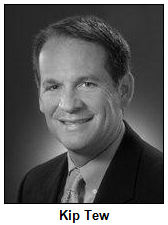 At the epicenter of all this was political commando Kip Tew, who headed Barack Obama's campaigns in Indiana. A partner with the Indianapolis law firm of Krieg DeVault LLP, Kip joined Nelson in studio to share behind-the-scenes details from the razor-close primary against Hillary Clinton - which involved a split among Democrats here that Kip describes as "difficult and joyless" in his new book Journey to Blue (Hawthorne Publishing) - to a presidential campaign that involved TV journalist Jane Pauley, rallies in traditionally Republican strongholds such as Plainfield, and a whirlwind that changed lives, Kip's among them.
At the epicenter of all this was political commando Kip Tew, who headed Barack Obama's campaigns in Indiana. A partner with the Indianapolis law firm of Krieg DeVault LLP, Kip joined Nelson in studio to share behind-the-scenes details from the razor-close primary against Hillary Clinton - which involved a split among Democrats here that Kip describes as "difficult and joyless" in his new book Journey to Blue (Hawthorne Publishing) - to a presidential campaign that involved TV journalist Jane Pauley, rallies in traditionally Republican strongholds such as Plainfield, and a whirlwind that changed lives, Kip's among them.
A Fort Wayne native who graduated from North Central High School in Indianapolis and Indiana University, Kip is a former state chairman and Marion County chairman for the Democratic Party. He is the latest in a parade of well-known Hoosier politicos of both parties who have joined Nelson to explore the dynamics - including shifts, curves, upsets and historic firsts - of Indiana's political landscape.
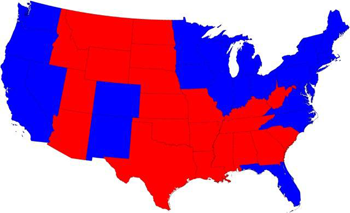 Except for the top of the ticket (Lyndon B. Johnson had been the last Democratic presidential candidate to carry Indiana), Hoosiers have a long history of ballot-splitting. And it may seem like ancient history now - with Evan Bayh's announcement earlier this year that he will not run for re-election - but speculation he could have been Obama's running mate hung over much of the '08 campaign here, according to Kip's book. Before that, Bayh and several of his closest colleagues aligned themselves with Hillary Clinton in the primary battle, meaning Kip and his crew became their opposition.
Except for the top of the ticket (Lyndon B. Johnson had been the last Democratic presidential candidate to carry Indiana), Hoosiers have a long history of ballot-splitting. And it may seem like ancient history now - with Evan Bayh's announcement earlier this year that he will not run for re-election - but speculation he could have been Obama's running mate hung over much of the '08 campaign here, according to Kip's book. Before that, Bayh and several of his closest colleagues aligned themselves with Hillary Clinton in the primary battle, meaning Kip and his crew became their opposition.
In Journey to Blue, Kip writes, the switch in allegiance from Clinton to Obama of another native Hoosier insider in the Democratic Party, former national chairman Joe Andrew, "angered the Bayh hierarchy more than anything else in the campaign."
Some other tidbits from Kip's book:
Indiana had the lowest turnout of registered voters of any state in the 2004 presidential election. In the show, Nelson explores how this affected the strategy of Kip and his team four years later. He also asks about the role of social media in the campaign here - and whether Kip thinks Obama could win Indiana if he had to run for re-election this year.
This show with a key Hooser newsmaker answers questions and gives insight into a campaign that resulted in a (temporary?) shift in presidential politics in the Hoosier state.
 A popular Republican congressman from Indiana - who later would become vice president of the United States - is thought to have been the last public figure to shake Abraham Lincoln's hand before the president's assassination in 1865. The Hoosier congressman had been invited to accompany President and Mrs. Lincoln to Ford's Theatre that fateful evening in April, but he declined.
A popular Republican congressman from Indiana - who later would become vice president of the United States - is thought to have been the last public figure to shake Abraham Lincoln's hand before the president's assassination in 1865. The Hoosier congressman had been invited to accompany President and Mrs. Lincoln to Ford's Theatre that fateful evening in April, but he declined.
The Hoosier congressman was elected speaker of the House twice, then became vice president. Hint: He was the first of (so far) five Hoosiers to become vice president.
Question: Name the Indiana politician.
The prize was a one-night stay at the Holiday Inn Express Indianapolis City Centre, courtesy of the ICVA.
Our Roadtripper, Chris Gahl of the ICVA, recommended venturing to the Rathskeller in downtown Indy on Aug. 8 for a performance by the American Pianists Association's Classical Fellowship Awards Finalist, Igor Lovchinsky.
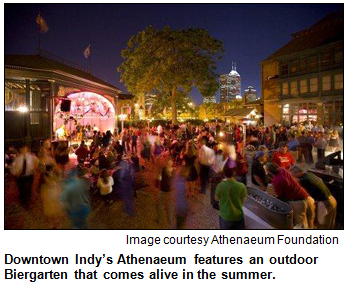 The performance took place in the Athenaeum's Biergarten and is the final concert in their popular Summer Concert Series.
The performance took place in the Athenaeum's Biergarten and is the final concert in their popular Summer Concert Series.
Lovchinsky, an alumnus of Juilliard, won both the Eastman International Piano Competition and the National Chopin Piano Competition. His talent has won him solo spots in the Indianapolis Symphony Orchestra, the Indiana Chamber Orchestra and others.
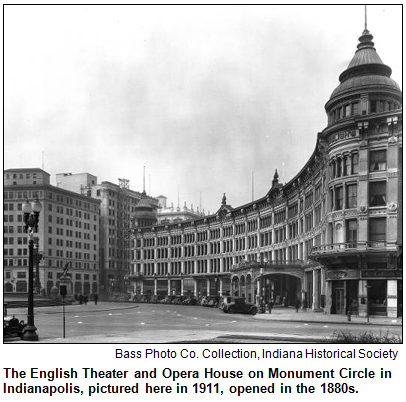 (July 31, 2010) - In 1934, an 8-year-old boy who lived in Irvington - and who would grow up to become one of the best-known TV news anchors in Indianapolis history - patronized a theater for the first time. It was Loew's Palace at 35 N. Pennsylvania St., where young Howard Caldwell was captivated by a movie, which was followed by a stage show.
(July 31, 2010) - In 1934, an 8-year-old boy who lived in Irvington - and who would grow up to become one of the best-known TV news anchors in Indianapolis history - patronized a theater for the first time. It was Loew's Palace at 35 N. Pennsylvania St., where young Howard Caldwell was captivated by a movie, which was followed by a stage show.
Although Loew's Palace is long gone, its essence is recaptured in a new book by Howard, who became a familiar face - and often was described as "Indiana’s Walter Cronkite" - during his long career at WRTV-Channel 6. His book, The Golden Age of Indianapolis Theaters (IU Press), not only explores the city's majestic theaters, many of them bygone or renovated for other uses, it also analyzes the Hoosier capital's theater-going heritage.
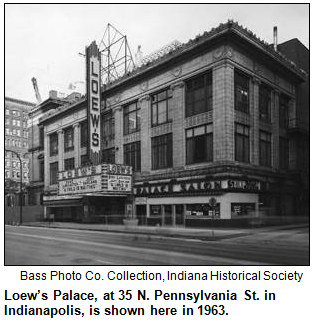 Howard joined Nelson in studio to delve into the colorful history that kicked off in September 1858 when the Metropolitan, the city's first theater, opened at 148 W. Washington St. with a seating capacity of more than 1,700. The Metropolitan later became known as the Park, then as the Capitol when it was a burlesque house as it declined before closing in the 1930s.
Howard joined Nelson in studio to delve into the colorful history that kicked off in September 1858 when the Metropolitan, the city's first theater, opened at 148 W. Washington St. with a seating capacity of more than 1,700. The Metropolitan later became known as the Park, then as the Capitol when it was a burlesque house as it declined before closing in the 1930s.
Almost from the start, there was controversy. Some shows at "the Met" featured dancing, which, as Howard points out, "was not tolerated by Methodists, Presbyterians or Baptists" during the 1850s. And many church groups here frowned on theater-going in general.
In the 1860s, famous actors who performed at "the Met" included none other than John Wilkes Booth. 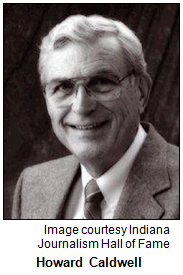 As Howard notes, his final performance in Indy was in 1863, a mere two years before he assassinated President Lincoln.
As Howard notes, his final performance in Indy was in 1863, a mere two years before he assassinated President Lincoln.
The city's second theater, the Grand Opera House, opened in 1875 and eventually became known for vaudeville. In the 1880s, the lavish English Theater and Opera House on Monument Circle vaulted theater-going to a new level. 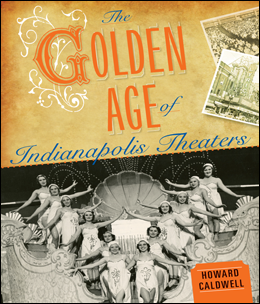 In 1902, a production at the English of Lew Wallace's Ben-Hur featured "eight horses pulling two chariots on treadmills, powered by electricity," creating a sensation. As Howard notes in his book, performers who came to the Hoosier capital included W.C. Fields and escape artist Harry Houdini (both appeared at the Grand) and Ethel and John Barrymore at the English.
In 1902, a production at the English of Lew Wallace's Ben-Hur featured "eight horses pulling two chariots on treadmills, powered by electricity," creating a sensation. As Howard notes in his book, performers who came to the Hoosier capital included W.C. Fields and escape artist Harry Houdini (both appeared at the Grand) and Ethel and John Barrymore at the English.
Alas, only four of the grand historic theaters downtown survive:
Howard and Nelson explored those, as well as the theaters that did not survive, such as Loew's Palace and the Lyric on North Illinois Street, which presented three vaudeville 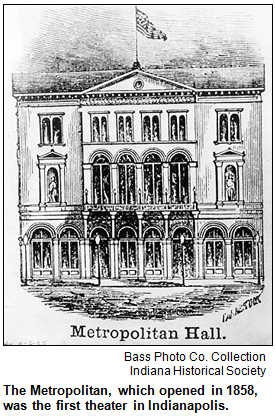 shows a day when it opened in 1912. Some fun facts:
shows a day when it opened in 1912. Some fun facts:
In 1938, a new movie theater opened in Indianapolis, but not downtown. The first film shown in it was College Swing, starring Bob Hope.
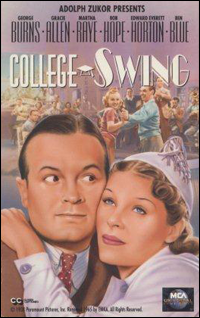 The new movie theater became one of the city's first to be air conditioned. For decades, it was considered among the city's finest movie theaters, but by the early 1970s it had declined and even was showing adult movies, some rated X.
The new movie theater became one of the city's first to be air conditioned. For decades, it was considered among the city's finest movie theaters, but by the early 1970s it had declined and even was showing adult movies, some rated X.
Then a major restoration in the late 1970s gave the theater a new life as a nightclub and concert venue that continues to this day. Long lines under the theater's marquee are a common sight as patrons wait to enter or buy concert tickets.
Question: Name the Indianapolis theater that fits this description.
The prize was four tickets to downtown Indy's newest attraction, the Rhythm Discovery Center at Illinois and Washington Streets, courtesy of the ICVA.
Chris Gahl of the ICVA suggested that we stroll down memory lane to check out the Heartland Film Festival's premiere of the major motion picture Flipped (see a preview) on Aug. 2 at Hilbert Circle Theatre in downtown Indianapolis.
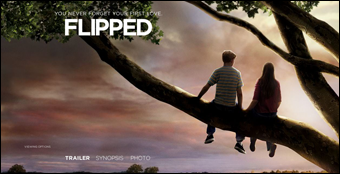 Hollywood director, writer and producer Rob Reiner attended the premiere, along with the movie's stars Anthony Edwards, John Mahoney and Penelope Ann Miller.
Hollywood director, writer and producer Rob Reiner attended the premiere, along with the movie's stars Anthony Edwards, John Mahoney and Penelope Ann Miller.
The movie Flipped is the latest addition to Reiner's directorial credits, joining such memorable films as Stand by Me, When Harry Met Sally, A Few Good Men and The Bucket List. Doors open at 6 p.m., with the screening beginning at 7 p.m. Tickets for reserved seating will be available in advance for $25 each.
(July 24, 2010) - Did you know one of the country's largest brewers 100 years ago was in Terre Haute? Before Prohibition, a German immigrant section of the Hoosier city bustled as the setting of beer-makers.  None was savored more than the Terre Haute Brewing Company, which was located in a five-story complex that included a bottling plant and a stable that housed dozens of Clydesdale and Belgian horses. (The horses drew wagons that delivered the beer.)
None was savored more than the Terre Haute Brewing Company, which was located in a five-story complex that included a bottling plant and a stable that housed dozens of Clydesdale and Belgian horses. (The horses drew wagons that delivered the beer.)
Terre Haute-made Champagne Velvet became wildly popular with the World War II generation, with connoisseurs from coast to coast. Fort Wayne, Lafayette, New Albany and even tiny Aurora on the Ohio River also have rich beer-making heritages.
Thirsty for details? Nelson was joined in studio by the writer recently dubbed "one of Indiana’s grand dames of beer" by The Indianapolis Star. Rita Kohn writes the "Beer Buzz" column in Nuvo newsweekly and is the author of a new book, True Brew(Indiana University Press), that explores all aspects of the Hoosier state's links to beer, present and past.
And the past goes way back. According to Rita's book, a brewery was built in LaPorte in 1831 – even though the town's streets weren't laid out until two years later. In the 1840s, a brewery in Aurora was so productive it exported beer to Germany. Even one of the most prominent residents of early Indianapolis, banker Calvin Fletcher, wrote diary entries about his occasional beer-making endeavors using local ingredients.
"Indiana has a 200-year-old tradition of brewing practiced by people whose beer heritage was part of their cultural, social and economic life as home-brewers and commercial brewers," Rita writes in True Brew.
According to her book, the monks at St. Meinrad Archabbey in southern Indiana started a brewery in 1860. Alas, their beer was so lousy the brewery closed the next year.
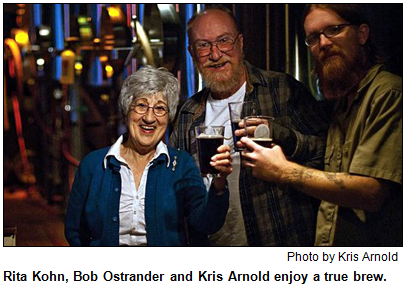 No such humiliation was suffered by several beer-makers in Terre Haute, Fort Wayne and other Indiana communities. In Fort Wayne, popular Berghoff Brewing got under way in 1887. Civic leaders in Terre Haute hoped that city, not Milwaukee, would emerge as America’s beer-making capital.
No such humiliation was suffered by several beer-makers in Terre Haute, Fort Wayne and other Indiana communities. In Fort Wayne, popular Berghoff Brewing got under way in 1887. Civic leaders in Terre Haute hoped that city, not Milwaukee, would emerge as America’s beer-making capital.
Prohibition, which began in 1918, changed the landscape in many ways. According to True Brew, when Prohibition ended in the 1930s only about half of the country's brewers reopened. The landscape changed again in the 1990s with the popularity of microbreweries and brew pubs, where beer is brewed and consumed on the premises.
Some fun facts:
Our beer heritage - and Rita - are featured in some Indiana events:
A former speakeasy is being reused in an unusual way in a scenic Indiana town on the Ohio River. During Prohibition, the two-story speakeasy was patronized by riverboat passengers. Today, the former speakeasy building is the home of a harp-making operation and gallery. Harps made there are sold all over the world - even to Ireland. The historic building, which is located on the town's Main Street, also is the setting for concerts involving harps, including Celtic music celebrations.
Question: Name the Indiana river town with a former speakeasy that's been turned into a harp-making operation.
The prize was a pair of tickets to the new Indiana Experience at the Eugene and Marilyn Glick Indiana History Center, courtesy of the Indiana Historical Society.
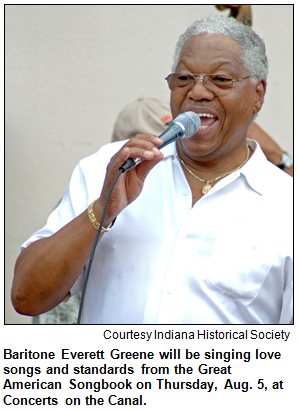 Stepping in this week for ever-busy Chris Gahl was our Roadtripper-ess, Amy Lamb of the Indiana Historical Society.
Stepping in this week for ever-busy Chris Gahl was our Roadtripper-ess, Amy Lamb of the Indiana Historical Society.
Amy recommended we Roadtrip down to weekly Concerts on the Canal on Thursday evenings through the end of August. The concert lineup includes a diverse selection of musical styles, from jazz, blues and Latin to cabaret and the Great American Songbook.
The IHS will also extend the Eugene and Marilyn Glick Indiana History Center's operating hours to 6 p.m. on concert nights. The new Indiana Experience includes a set of several interactive opportunities that connect visitors with the state's history in exciting and meaningful ways.
The home of the IHS is located at 450 W. Ohio St. in downtown Indianapolis along the Central Canal. And concerts are complimentary for those who bring a chair or blankets and sit on the east side of the canal!
(July 17, 2010) - It was the setting for a "courthouse war" that involved the state's most protracted battle over the location of a county seat. With early settlements by groups of Quakers, Wayne County in far-eastern Indiana became a hub of anti-slavery activity and housed significant stops on the Underground Railroad.
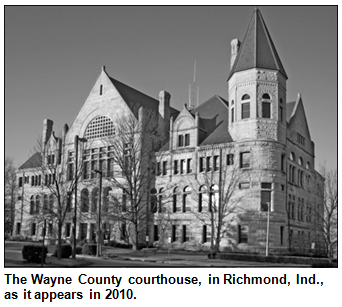 And as one of the first counties formed in the Indiana Territory (it was organized in 1810, six years before Indiana became a state), Wayne County will celebrate its bicentennial this year. That makes it ideal for this installment in our Hoosier History Live! rotating series about town and county histories.
And as one of the first counties formed in the Indiana Territory (it was organized in 1810, six years before Indiana became a state), Wayne County will celebrate its bicentennial this year. That makes it ideal for this installment in our Hoosier History Live! rotating series about town and county histories.
Nelson was joined in studio by Wayne County historian Carolyn Lafever, who lives on a 40-acre farm near Hagerstown. She is the author of A Pictorial History of Wayne County, Indiana (Donning Company Publishers, 1998) and the new Wayne County Indiana: The Battles for the Courthouse (The History Press), which describes the bitter feuds that resulted in six courthouses and three county seats, with Richmond finally winning out over Centerville.
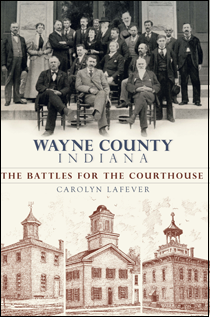 Wayne County is home to everything from Abbott's Candy in Hagerstown, a legendary locally owned candy-maker/retailer that opened in the 1890s, to the Levi Coffin House in Fountain City (the town once was called Newport), which became known as the "Grand Central Station of the Underground Railroad." Many of the escaped slaves helped by Levi Coffin and his wife, Catharine, chose to settle in Wayne County after the Civil War.
Wayne County is home to everything from Abbott's Candy in Hagerstown, a legendary locally owned candy-maker/retailer that opened in the 1890s, to the Levi Coffin House in Fountain City (the town once was called Newport), which became known as the "Grand Central Station of the Underground Railroad." Many of the escaped slaves helped by Levi Coffin and his wife, Catharine, chose to settle in Wayne County after the Civil War.
Speaking of the Civil War: Indiana's famous governor during the conflict, Oliver Perry Morton, was a Wayne County native who practiced law in Centerville for many years. An early supporter of the Republican Party, Morton's first official act as governor was to alert President Lincoln, his close friend, that Indiana would send 10,000 men for the Union Army.
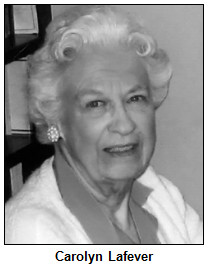 Prior to the Civil War, Wayne County was the most prosperous county in the state "by virtue of the National Road passing through," according to A Pictorial History of Wayne County, Indiana. In her book, Mrs. Lafever notes that Wayne County had the state's largest population in 1848. At that point, Centerville was the county's hub; only with the advent of railroad lines in the next decade did Richmond eclipse it.
Prior to the Civil War, Wayne County was the most prosperous county in the state "by virtue of the National Road passing through," according to A Pictorial History of Wayne County, Indiana. In her book, Mrs. Lafever notes that Wayne County had the state's largest population in 1848. At that point, Centerville was the county's hub; only with the advent of railroad lines in the next decade did Richmond eclipse it.
Richmond may have triumphed in the courthouse war, but not quite 100 years later the city endured a horrific tragedy. On Palm Sunday in 1968, two explosions devastated the downtown, damaging a 14-block area and causing 41 deaths and more than 100 injuries. Nelson and Mrs. Lafever explored the aftermath and the still-disputed causes of the explosions, which have been blamed on a gas leak, followed by the igniting of gunpowder stored at a sporting goods store.
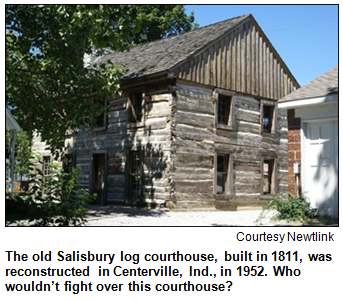 For several years after the tragedy, a major part of downtown Richmond became a pedestrian-only zone known as The Promenade. When controversy ensued, vehicular traffic was allowed to return to the downtown area in 1997. (Does the conflict sound a bit familiar, Indy?)
For several years after the tragedy, a major part of downtown Richmond became a pedestrian-only zone known as The Promenade. When controversy ensued, vehicular traffic was allowed to return to the downtown area in 1997. (Does the conflict sound a bit familiar, Indy?)
Some fun facts:
Faculty members at Earlham College in Richmond included one of the country's best-known Quaker authors and scholars. He lived on campus into his late 80s, was quoted in everything from "Dear Abby" advice columns to the Philosophical Review and wrote books about spiritual and ethical topics. 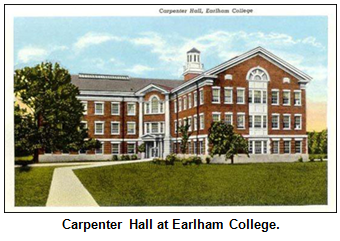 Born in 1900, he became known as "Mr. Earlham" in much the way Herman B Wells was regarded as "Mr. IU."
Born in 1900, he became known as "Mr. Earlham" in much the way Herman B Wells was regarded as "Mr. IU."
Question: Name the legendary faculty member at Earlham College.
The prize was a DVD of Movers and Stakers, Stories Along the National Road, courtesy of Executive Director Nancy Carlson of Ball State University. The National Road, of course, went through Wayne County, and you'll learn more about Richmond, Centerville and the Salisbury Log Courthouse.
By the way, if you didn’t win the prize, the film also will be screened at the Indianapolis International Film Festival on Saturday, July 24, at 2:45 p.m. at the Indianapolis Museum of Art.
What was the first Indiana state capital? Where did the nickname "Hoosiers" come from? 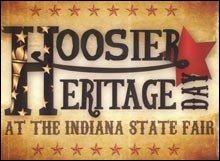 Chris Gahl of the ICVA has picked Hoosier Heritage Day on Thursday, August 12,
at the Indiana State Fairgrounds as a Roadtrip to learn answers to these questions and more.
Chris Gahl of the ICVA has picked Hoosier Heritage Day on Thursday, August 12,
at the Indiana State Fairgrounds as a Roadtrip to learn answers to these questions and more.
Hoosier Heritage Day, aimed to educate visitors about Indiana history, will test your knowledge of Indiana trivia, trace your Hoosier family history, expand your understanding of Indiana archeology, and much more.
Approximately 25 organizations will be present on the Boulevard from 9 a.m. to 9 p.m. to educate, re-enact and talk about Indiana history. And don't forget to order corn on the cob at the fair, an Indiana specialty!
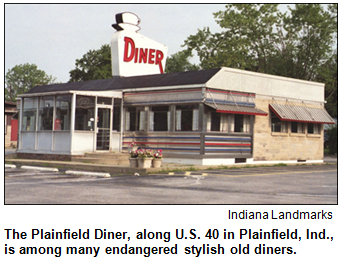 (July 10, 2010) - Roadside diners are a broiling topic this summer, what with a landmark, now-vacant eatery in Plainfield imperiled. Built in 1954 and topped by an eye-catching coffee cup sign, the Plainfield Diner stands along the National Road/U.S. 40 and heads the "10 Most Endangered" buildings in the state list compiled by Indiana Landmarks.
(July 10, 2010) - Roadside diners are a broiling topic this summer, what with a landmark, now-vacant eatery in Plainfield imperiled. Built in 1954 and topped by an eye-catching coffee cup sign, the Plainfield Diner stands along the National Road/U.S. 40 and heads the "10 Most Endangered" buildings in the state list compiled by Indiana Landmarks.
The hubbub has prompted the creation of a Facebook crusade to save the beloved dinner and an outcry that's startling all and sundry, according to Mark Dollase, vice president of preservation services at Landmarks. Diners, which boomed during the 1940s and '50s, have been popular across the state for decades, even though, as the current issue of Landmarks' Indiana Preservationist puts it, they now are at risk of being "rendered obsolete by fast-food chains, urban sprawl, and interstates."
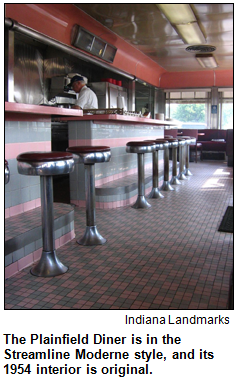 At Hoosier History Live!, we relish this opportunity to explore all aspects of Indiana diners. That means not only did Mark join Nelson in studio, so did Max Lemley of Columbus, Ind., former president of the Indiana Restaurant Association and a former "King of the Road" trucker who for years patronized diners along the highways and byways of the Hoosier state.
At Hoosier History Live!, we relish this opportunity to explore all aspects of Indiana diners. That means not only did Mark join Nelson in studio, so did Max Lemley of Columbus, Ind., former president of the Indiana Restaurant Association and a former "King of the Road" trucker who for years patronized diners along the highways and byways of the Hoosier state.
As we served up a slice of Americana, Mark, Max and Nelson weighed in on an array of Hoosier diners, contemporary and bygone. What are the ingredients of a good diner, and what are telltale signs of a rotten one? What makes the Plainfield diner, built in an architectural style known as "Streamline Moderne," so special? (Note: The diner, which has its original interior, closed in 2009 and currently is for sale.)
Do you savor the jukeboxes, chili platters, milk shakes or curved booths at a beloved Hoosier diner? Consider yourself invited to call in during the show to share your picks and pans.
With Mark, we also explored other historic structures on the "10 Most Endangered" list. They include Bush Stadium in Indianapolis, the former baseball park that was the focus of a Hoosier History Live! show (also with Mark as our guest) two summers ago. Tune in to hear about the latest proposal for the former home of the Indianapolis Indians on West 16th Street. 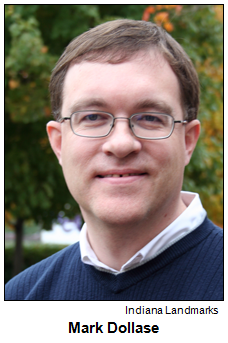 The stadium reappears on the "10 Most Endangered" list, joining the Plainfield diner; circus barns in Peru where big cats and elephants once were trained; and St. John's Hospital in Gary, which was built in 1929 by African-Americans when the city's public hospitals declined to admit black patients.
The stadium reappears on the "10 Most Endangered" list, joining the Plainfield diner; circus barns in Peru where big cats and elephants once were trained; and St. John's Hospital in Gary, which was built in 1929 by African-Americans when the city's public hospitals declined to admit black patients.
Primarily, though, our focus is on diners, which, as the Indiana Preservationist puts it, are "a vanishing species."
Some fun facts:
Three restaurants in Indianapolis opened as drive-ins, not diners, and constituted a small, locally owned chain. Located on busy city streets, the three restaurants began opening during the 1950s and continued with drive-in service through the 1960s. 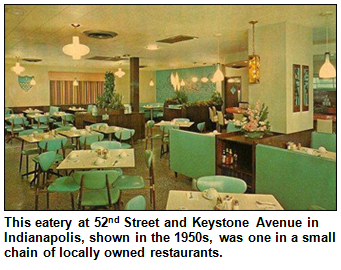 After that, some patrons referred to them as diners, although they did not have stainless-steel exteriors. But the small chain specialized in food often served in diners, including milkshakes, catfish and beef Manhattans.
After that, some patrons referred to them as diners, although they did not have stainless-steel exteriors. But the small chain specialized in food often served in diners, including milkshakes, catfish and beef Manhattans.
One of the restaurants was located on North Shadeland Avenue. Another, at East 52nd Street and North Keystone Avenue, was the last to remain. It closed in early 2002.
Question: Name the small chain of Indianapolis-based drive-ins that fits this description.
The call-in number for the correct answer is (317) 788-3314, and the prize was two tickets to the James Whitcomb Riley Home, courtesy of the ICVA.
Roadtripper Chris Gahl of the ICVA suggests you get a little wild in July - at the Indianapolis Zoo!
 How did the Indianapolis Zoo come to fruition? In the 1940s, newspaper columnist Lowell Nussbaum began voicing his dream of establishing a zoo in Indianapolis via his column "Inside Indianapolis," which first appeared in the Indianapolis Times and then the Indianapolis Star. The columns spurred community leaders into action, and on Oct. 24, 1944, Articles of Incorporation for the Indianapolis Zoological Society Inc. were filed.
How did the Indianapolis Zoo come to fruition? In the 1940s, newspaper columnist Lowell Nussbaum began voicing his dream of establishing a zoo in Indianapolis via his column "Inside Indianapolis," which first appeared in the Indianapolis Times and then the Indianapolis Star. The columns spurred community leaders into action, and on Oct. 24, 1944, Articles of Incorporation for the Indianapolis Zoological Society Inc. were filed.
The Indianapolis Zoo continues its unique summer concert series, "Animals & All That Jazz," with performances July 15, 23 and 29. Meander alongside the animals as you listen to live jazz by Indiana musicians. It's a weeknight adventure, with food and beverage served. The Indianapolis Zoo welcomes more than 1 million visitors each year and plays a major role in worldwide conservation and research.
(July 3, 2010) - 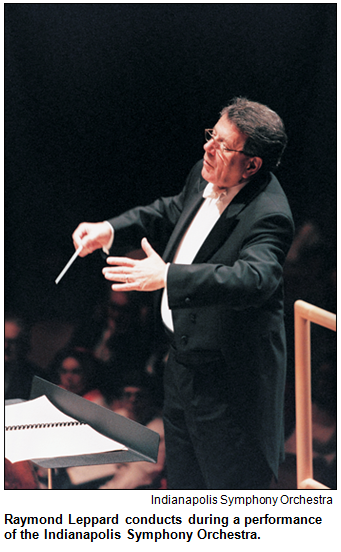 In a first for Hoosier History Live!, our guest holds the title of Commander of the British Empire. That honor, bestowed by the Queen of England, is merely one of many high notes in the remarkable life and career of Indianapolis Symphony Orchestra conductor laureate Raymond Leppard.
In a first for Hoosier History Live!, our guest holds the title of Commander of the British Empire. That honor, bestowed by the Queen of England, is merely one of many high notes in the remarkable life and career of Indianapolis Symphony Orchestra conductor laureate Raymond Leppard.
The 82-year-old maestro's visit to our studio came as he is about to be named a Living Legend by the Indiana Historical Society at a black-tie gala July 16.
Maestro Leppard, who served as the ISO's music director from 1987 to 2001, certainly has become an adopted (and beloved) Hoosier since taking up permanent residency in Indianapolis. He even became an American citizen in 2003.
Born in London, he grew up in scenic Bath and became a prolific recording artist (his other honors include a Grammy Award) and conducted major orchestras around the world before his 14-year career with the ISO. During that tenure, he led the orchestra on eight recordings and two tours of Europe. He also has written several film scores, including the soundtracks for Lord of the Flies (1963) and Hotel New Hampshire (1984).
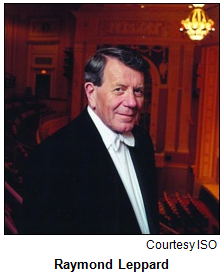 What's more, Leppard returned to the podium at the Hilbert Circle Theatre last September when his musical successor, Mario Venzago, left the ISO after contract negotiations failed. The ISO reached out to its conductor laureate and asked him to lead the orchestra for its season opener.
What's more, Leppard returned to the podium at the Hilbert Circle Theatre last September when his musical successor, Mario Venzago, left the ISO after contract negotiations failed. The ISO reached out to its conductor laureate and asked him to lead the orchestra for its season opener.
The maestro's legion of admirers also know he was a longtime friend of the late "Queen Mum" (mother of the current Queen Elizabeth II) and that he initiated Indianapolis On-The-Air, a nationally syndicated radio broadcast of ISO performances. At the beginning of his prolific career, he won raves as a harpsichordist.
In addition to the maestro, the distinguished Living Legends-to-be will include U.S. District Judge Sarah Evans Barker and civic leaders Bill Mays, founder of Mays Chemical, and his wife Rose, a professor emeritus at the IU School of Nursing at IUPUI.
Some fun facts:
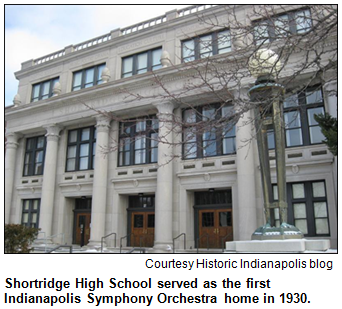 The Indianapolis Symphony Orchestra was founded in 1930 and played its first concert at Shortridge High School. Since then, three venues have served for long periods as the concert hall for the ISO. The second venue was Clowes Hall, which opened in 1963. The ISO moved to Circle Theatre on Monument Circle with its initial renovation in 1984.
The Indianapolis Symphony Orchestra was founded in 1930 and played its first concert at Shortridge High School. Since then, three venues have served for long periods as the concert hall for the ISO. The second venue was Clowes Hall, which opened in 1963. The ISO moved to Circle Theatre on Monument Circle with its initial renovation in 1984.
Question: What majestic building was the primary concert hall for the ISO from the mid-1930s until the opening of Clowes Hall? Hints: The building was not Shortridge. And it still stands.
The call-in number for the correct answer is (317) 788-3314, and the prize is two tickets to the Children's Museum, courtesy of the ICVA.
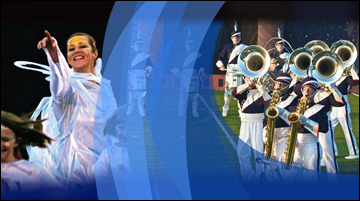 Roadtripper Chris Gahl of the ICVA recommended that we check out the Spirit of America, a world-class marching band from Cape Cod, Massachusetts. How does free sound? Check out this marching-band extravaganza on Thursday, July 8 at 8 p.m. at IPS's Manual High School. The Spirit of America 100-member marching band will perform its acclaimed "Exploration," an inspiring adventure and a time travel through history to meet some of our nation's most prominent figures.
Roadtripper Chris Gahl of the ICVA recommended that we check out the Spirit of America, a world-class marching band from Cape Cod, Massachusetts. How does free sound? Check out this marching-band extravaganza on Thursday, July 8 at 8 p.m. at IPS's Manual High School. The Spirit of America 100-member marching band will perform its acclaimed "Exploration," an inspiring adventure and a time travel through history to meet some of our nation's most prominent figures.
 Founded in the early 1970s, Spirit of America began as a hometown marching band and now tours the country to teach of the about the United States and the history of our country. This group has toured Europe, Africa, Canada and even Australia. Be sure to make the easy Roadtrip to Manual High School this Thursday!
Founded in the early 1970s, Spirit of America began as a hometown marching band and now tours the country to teach of the about the United States and the history of our country. This group has toured Europe, Africa, Canada and even Australia. Be sure to make the easy Roadtrip to Manual High School this Thursday!
Encore presentation - originally broadcast April 25, 2009
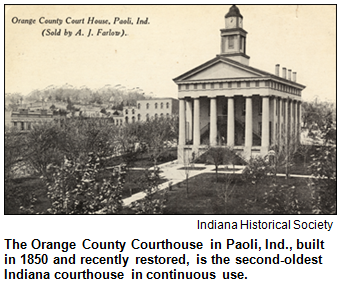 (June 26, 2010) - Everyone loves Indiana county courthouses. Those architectural gems known as "the magnificent 92," the majestic courthouses that dominate town squares across Indiana, will be the focus of our show. Nelson's distinguished guest is Indianapolis architect and historic preservationist Jim Kienle, of Moody Nolan, who is known for his award-winning restoration work.
(June 26, 2010) - Everyone loves Indiana county courthouses. Those architectural gems known as "the magnificent 92," the majestic courthouses that dominate town squares across Indiana, will be the focus of our show. Nelson's distinguished guest is Indianapolis architect and historic preservationist Jim Kienle, of Moody Nolan, who is known for his award-winning restoration work.
As the lavishly illustrated book Magnificent 92 (IU Press, 1991) puts it, Hoosier towns "seemed to compete with one another for splendor and expense" in constructing their courthouses during the 1800s and early 1900s. There's no question that courthouses are cherished – and deemed worth fighting (or even disrobing) for. Remember the national spotlight that fell on members of a women's bridge club in Randolph County who posed for a calendar to raise money to save their historic courthouse in Winchester?
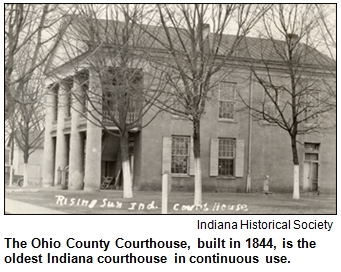 Magnificent 92 quotes a 19th-century historian as rhapsodizing: "A man might sooner be the architect of that edifice than be President of the United States or King of England." By the way, most of the "calendar girls" were in their 80s; the eldest was nearly 94 years old. (They posed behind discreetly placed miniature replicas of the beloved courthouse.)
Magnificent 92 quotes a 19th-century historian as rhapsodizing: "A man might sooner be the architect of that edifice than be President of the United States or King of England." By the way, most of the "calendar girls" were in their 80s; the eldest was nearly 94 years old. (They posed behind discreetly placed miniature replicas of the beloved courthouse.)
Last year, Jim restored the Orange County Courthouse in Paoli. Built in 1850, it is the state's second-oldest courthouse in continuous use and is seen annually by thousands of travelers who visit the nearby resort hotels in French Lick and West Baden. (Fun fact: The oldest still in use is the Ohio County Courthouse in Rising Sun, which was built in 1844. Like its Orange County counterpart, the Ohio County Courthouse was designed in Greek Revival style.)
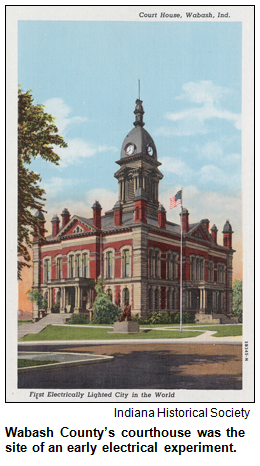 Jim and Nelson also will discuss bygone courthouses, including the ornate Marion County Courthouse, which was demolished during the early 1960s (a major shame, if you ask Jim and other historic preservationists) to make way for the 28-floor City-County Building that stands on its site. And how can we talk about Indiana courthouses without mentioning the landmark Decatur County Courthouse in Greensburg, which has a tree growing at the top of its 115-foot clock tower? According to the book Oddball Indiana (2002), the tree atop the courthouse in Greensburg is now in its 12th generation.
Jim and Nelson also will discuss bygone courthouses, including the ornate Marion County Courthouse, which was demolished during the early 1960s (a major shame, if you ask Jim and other historic preservationists) to make way for the 28-floor City-County Building that stands on its site. And how can we talk about Indiana courthouses without mentioning the landmark Decatur County Courthouse in Greensburg, which has a tree growing at the top of its 115-foot clock tower? According to the book Oddball Indiana (2002), the tree atop the courthouse in Greensburg is now in its 12th generation.
Nelson plans to ask Jim whether towns in other states have showcased their courthouses to the same extent, or is this a Hoosier thing? According to Magnificent 92, the flurry of construction between 1870 and 1899 across Indiana was such that more than 60 of the 92 courthouses were built during that era, with 23 others erected between 1900 and 1930.
"This wasn't entirely foolishness," according to the book's collaborators, Jon Dilts and Will Counts. "Old courthouses, built of wood or brick 30 years before, were small and dangerous. Records often had to be stored elsewhere where fire was not a constant threat."
Fun facts:
Our guest has focused his architectural career on bringing new life to historic structures and Main Streets in small towns. Jim and his wife, Marjorie Kienle, also were among the first wave of urban pioneers in the 1970s revival of the historic Lockerbie neighborhood in Indianapolis. Tune in to learn more!
(June 19, 2010) - 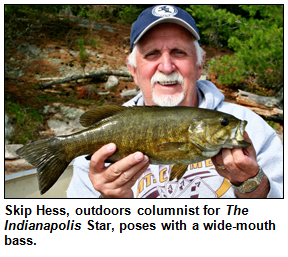 Spring and summertime are fishin' time, and Hoosier History Live! reeled in a catch as a guest. To offer tips about prime fishing spots across Indiana, share advice about techniques and maybe tell a whopper fish story or two, the "Outdoors" columnist for The Indianapolis Star, veteran journalist Skip Hess, joined Nelson in studio.
Spring and summertime are fishin' time, and Hoosier History Live! reeled in a catch as a guest. To offer tips about prime fishing spots across Indiana, share advice about techniques and maybe tell a whopper fish story or two, the "Outdoors" columnist for The Indianapolis Star, veteran journalist Skip Hess, joined Nelson in studio.
With Skip as our guide, we explored the good, the bad and the unheralded about all things related to fishing, from the best bait to common mistakes by aspiring anglers.
Seizing the opportunity with his former colleague (Skip and Nelson sat next to each other for several years at the Star; before that, they worked together at the bygone Indianapolis News), Nelson asked Skip to share some favorite fishing spots at the state's lakes, rivers, streams and reservoirs.
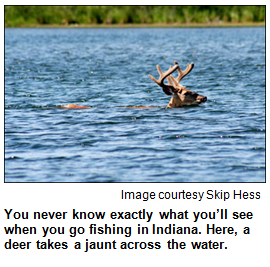 They also discussed artificial baits, including ones manufacturers say are "guaranteed" to catch fish, as well as various "gimmicks" (Skip's word) that he says to avoid. Conceding that he can't resist eavesdropping on conversations in fishing-gear departments, Skip shared insights from his stealth work.
They also discussed artificial baits, including ones manufacturers say are "guaranteed" to catch fish, as well as various "gimmicks" (Skip's word) that he says to avoid. Conceding that he can't resist eavesdropping on conversations in fishing-gear departments, Skip shared insights from his stealth work.
Noting that bass, crappie and bluegill are the favorite fish to catch in Indiana, Skip shared tidbits about record catches and other kinds of fish that may not be as popular but nevertheless are a thrill to reel in from Hoosier waters. And he shared specifics about the cost of fishing licenses and related details.
His popular "Outdoors" column appears every other Sunday in the Star. You may have read Skip's recent column about sightings around the state of mountain lions now prowling Hoosier trails decades after they were thought to have vanished from the state.
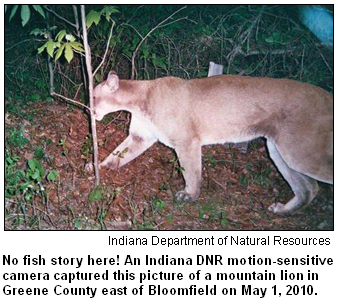 According to Skip's column, even the Department of Natural Resources is conceding the big cats are out there after a camera installed along a Greene County trail captured some startling photos. This topic is too hot to ignore, even though water creatures will be the primary focus of the show. So Skip and Nelson will go with the flow and, at some point, move to dry land to explore the mountain lion sightings.
According to Skip's column, even the Department of Natural Resources is conceding the big cats are out there after a camera installed along a Greene County trail captured some startling photos. This topic is too hot to ignore, even though water creatures will be the primary focus of the show. So Skip and Nelson will go with the flow and, at some point, move to dry land to explore the mountain lion sightings.
Some fun facts:
 The Hoosier History Trivia Mystery was a carry-over from the previous week, when there was no correct answer. The question concerns the family of Irish immigrant-turned-Indianapolis mayor and French Lick Springs Hotel owner Thomas Taggart. One of Taggart's daughters became a renowned artist. She studied art in New York City and had studios in the Taggart family homes both in Indianapolis and Hyannis Port, Mass. In the 1930s, she also began teaching at what was then called the John Herron Art Institute after earlier serving on its board.
The Hoosier History Trivia Mystery was a carry-over from the previous week, when there was no correct answer. The question concerns the family of Irish immigrant-turned-Indianapolis mayor and French Lick Springs Hotel owner Thomas Taggart. One of Taggart's daughters became a renowned artist. She studied art in New York City and had studios in the Taggart family homes both in Indianapolis and Hyannis Port, Mass. In the 1930s, she also began teaching at what was then called the John Herron Art Institute after earlier serving on its board.
Question: Name the Taggart daughter who became an influential Hoosier artist.
The call-in number for the correct answer is (317) 788-3314, and the prize was two adult and two youth tickets to the NCAA Hall of Champions, courtesy of the ICVA.
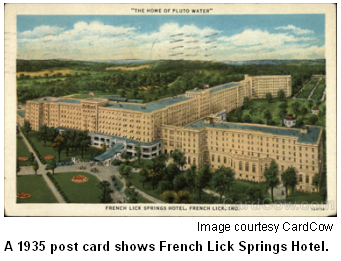 (June 12, 2010) - With a heritage that includes mineral waters renowned for their supposed curative powers, an atrium with one of largest free-standing domes anywhere (it was touted as the "Eighth Wonder of the World"), a series of colorful owners and a roster of distinguished guests for more than 100 years, the two lavishly restored hotels in French Lick and West Baden are troves for history lovers.
(June 12, 2010) - With a heritage that includes mineral waters renowned for their supposed curative powers, an atrium with one of largest free-standing domes anywhere (it was touted as the "Eighth Wonder of the World"), a series of colorful owners and a roster of distinguished guests for more than 100 years, the two lavishly restored hotels in French Lick and West Baden are troves for history lovers.
To explore the rollicking history of the French Lick Springs and West Baden Springs hotels, Nelson was joined in studio by a gem of a guest: distinguished Hoosier historian  Jim Fadely, widely regarded as the ultimate expert on flamboyant Tom Taggart, the former Indianapolis mayor who purchased the French Lick hotel in the early 1900s and made it an international showplace.
Jim Fadely, widely regarded as the ultimate expert on flamboyant Tom Taggart, the former Indianapolis mayor who purchased the French Lick hotel in the early 1900s and made it an international showplace.
A descendant of early Indiana pioneers, Jim is the author of Thomas Taggart: Public Servant, Political Boss 1856-1929 (Indiana Historical Society Press) and a top administrator at University High School near Carmel.
Jim and Nelson have rotated the microphone on tours of the historic hotels in Orange County, where illegal gambling flourished for decades and Taggart's masterful promoters touted a sulfur-based water they marketed as Pluto Water.  At the rival West Baden Springs Hotel, mineral water was marketed as Sprudel Water.
At the rival West Baden Springs Hotel, mineral water was marketed as Sprudel Water.
(West Baden was named after Baden Baden, Germany, a centuries-old site of similar mineral water. George Rogers Clark is credited with coining the name for French Lick, perhaps inspired by its salt licks. Even before the first white settlers, Native Americans had contended the mineral baths and waters of the Springs Valley were beneficial.)
Guests at the hotels during their heydays 100 years ago included Vanderbilts and Rockefellers. A self-made multimillionaire, Taggart was an Irish immigrant who, as mayor of Indianapolis, won praise for pushing for developing city parks, according to Jim. After traveling to French Lick on a vacation, Taggart was impressed and bought an existing hotel at the site, where the first inn (known as the French Lick House) had gone up in the 1840s. Then came spectacular success, concurrent with the rise of the rival West Baden Springs.
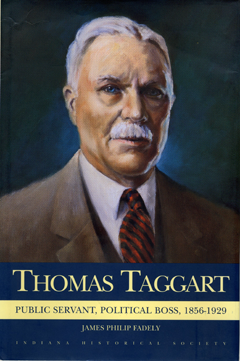 Both hotels in recent years have undergone stunning restorations spearheaded by Bloomington-based historic preservationists Bill and Gayle Cook; Indiana Landmarks Foundation initiated the renovation of West Baden, which had been closed as a hotel since the Great Depression. (During the intervening years, West Baden Springs had served as a Jesuit seminary, then as a branch of Northwood Institute, a college that offered instruction in the culinary arts and other fields.)
Both hotels in recent years have undergone stunning restorations spearheaded by Bloomington-based historic preservationists Bill and Gayle Cook; Indiana Landmarks Foundation initiated the renovation of West Baden, which had been closed as a hotel since the Great Depression. (During the intervening years, West Baden Springs had served as a Jesuit seminary, then as a branch of Northwood Institute, a college that offered instruction in the culinary arts and other fields.)
Some fun facts:
 The family of Irish immigrant-turned-Indianapolis mayor and French Lick Springs Hotel owner Thomas Taggart endured tragedies, just like the Kennedy family. (Both families owned homes in the resort of Hyannis Port, Mass.) The eldest of Tom Taggart's six children, a daughter named Florence, died at age 20 in a tragic yacht accident near New Orleans in 1899. However, one of Taggart's other daughters became a renowned artist. She studied art in New York City and had studios in the Taggart family homes, both in Indianapolis and Hyannis Port. In the 1930s, she also began teaching at what was then called the John Herron Art Institute after earlier serving on its board.
The family of Irish immigrant-turned-Indianapolis mayor and French Lick Springs Hotel owner Thomas Taggart endured tragedies, just like the Kennedy family. (Both families owned homes in the resort of Hyannis Port, Mass.) The eldest of Tom Taggart's six children, a daughter named Florence, died at age 20 in a tragic yacht accident near New Orleans in 1899. However, one of Taggart's other daughters became a renowned artist. She studied art in New York City and had studios in the Taggart family homes, both in Indianapolis and Hyannis Port. In the 1930s, she also began teaching at what was then called the John Herron Art Institute after earlier serving on its board.
Question: Name the Taggart daughter who became an influential Hoosier artist.
The call-in number for the correct answer is (317) 788-3314, and the prize is two adult and two youth tickets to the NCAA Hall of Champions, courtesy of the ICVA.
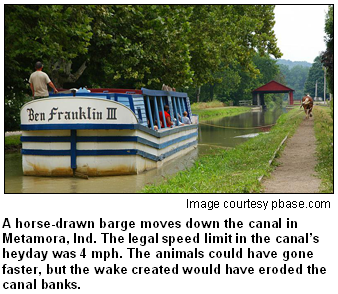 Tucked 65 miles southeast of Indianapolis is the charming town of Metamora, Indiana's only remaining functioning canal town. Our Roadtripper, Chris Gahl of the ICVA, says that when you visit the town, you'll journey through the early 19th-century history of horse-drawn canal boats - which fueled southeastern Indiana's economy until its displacement by the railroad later on in that century.
Tucked 65 miles southeast of Indianapolis is the charming town of Metamora, Indiana's only remaining functioning canal town. Our Roadtripper, Chris Gahl of the ICVA, says that when you visit the town, you'll journey through the early 19th-century history of horse-drawn canal boats - which fueled southeastern Indiana's economy until its displacement by the railroad later on in that century.
Metamora is littered with mom-and-pop stores in historic buildings dating back to the early 1800s. A must-stop is for a bag of freshly stone-ground cornmeal, a town treasure. And there are lots of great hikes along the Whitewater River Valley.
You might try spending the night at the Brookville Inn, a quaint B&B constructed in 1900. When in Brookville, be sure to see one of T.C. Steele's homes called "The Heritage" along the Whitewater River. And just down the road is Oldenburg, the Village of Spires. You can't go wrong by heading to Metamora for a slower pace of life. Leave your electronic gadgets at home!
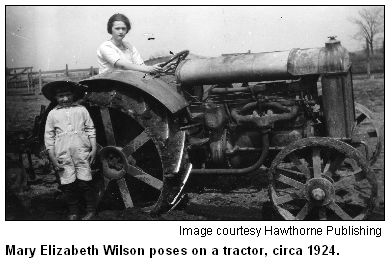 (June 5, 2010) - Journey with us to an era of rural schoolhouses heated by pot-bellied stoves, "party line" telephones with eavesdropping neighbors, chicken thieves, and kerosene lanterns used for nighttime walks to the hen house. Folks used slang and phrases that would perplex many of us today. Do you know what a "dewberry" is? And what kind of farm bird is a pullet?
(June 5, 2010) - Journey with us to an era of rural schoolhouses heated by pot-bellied stoves, "party line" telephones with eavesdropping neighbors, chicken thieves, and kerosene lanterns used for nighttime walks to the hen house. Folks used slang and phrases that would perplex many of us today. Do you know what a "dewberry" is? And what kind of farm bird is a pullet?
Believe it or not, all of these - along with a sorghum mill, whooping cough epidemics and doctors who made house calls - were part of life 100 years ago in a corner of what today is the fastest-growing county in Indiana. For a glimpse of a bygone era in the Hamilton County village of Bakers Corner - typical in many ways of rural life across the state during the early 1900s - Nelson will be joined by a set of cousins, Ellen Swain and Carol Longenecker.
They are co-editors of a new book, Growing Up with Bakers Corner (Hawthorne Publishing). It's a collection of memoirs and vignettes told by a beloved ancestor, Mary Elizabeth Wilson, who was Carol's grandmother and Ellen's great-aunt. She was born in 1907 in Bakers Corner (the nearest "big city" is Sheridan), grew up on a farm, married a farmer, and enchanted people with her stories until her death in 2003.
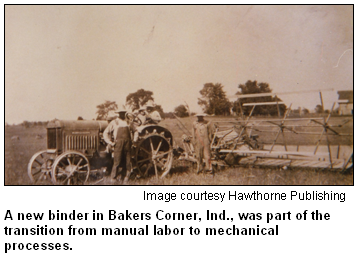 She also was an artist. Mary Elizabeth's works include a painting of a historic covered bridge, over which she drove to attend Cicero High School in the 1920s. The covered bridge was demolished in the 1950s to make way for Morse Reservoir. The sorghum mill in Bakers Corner, which was the hub of much of the village activity, also is gone. It had been one of the country's last remaining, operational sorghum mills, but it burned down last summer.
She also was an artist. Mary Elizabeth's works include a painting of a historic covered bridge, over which she drove to attend Cicero High School in the 1920s. The covered bridge was demolished in the 1950s to make way for Morse Reservoir. The sorghum mill in Bakers Corner, which was the hub of much of the village activity, also is gone. It had been one of the country's last remaining, operational sorghum mills, but it burned down last summer.
Although the sorghum mill may have been distinctive, much of daily life in Bakers Corner during the early 1900s, as recounted in Mary Elizabeth's vignettes, will resonate with anyone familiar with rural and small-town Midwestern life during the era. Her family enjoyed eating a treat known as "mush". (Never heard of it? Tune in for a description.) At school, long hours were devoted to "penmanship" - in jarring contrast to recent news accounts about some Indiana schools that have considered phasing out instruction in cursive writing because so much activity today involves computer keyboards.
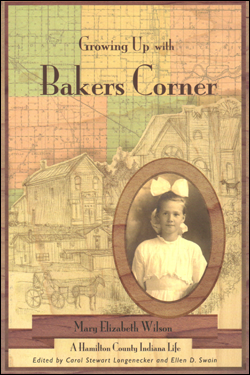 Mary Elizabeth's classmates often were felled by whooping cough; they also were among the first waves of children to receive the smallpox vaccine. And during the devastating influenza epidemic of 1918, Mary Elizabeth's mother became ill (she was pregnant at the time) during the Christmas holiday; she was so sick, according to Mary Elizabeth's account, that the doctor came to their home daily - sometimes twice per day. Eventually, young Mary Elizabeth also was stricken with the dreaded influenza, which was the focus of a Hoosier History Live! show in the summer of 2009.
Mary Elizabeth's classmates often were felled by whooping cough; they also were among the first waves of children to receive the smallpox vaccine. And during the devastating influenza epidemic of 1918, Mary Elizabeth's mother became ill (she was pregnant at the time) during the Christmas holiday; she was so sick, according to Mary Elizabeth's account, that the doctor came to their home daily - sometimes twice per day. Eventually, young Mary Elizabeth also was stricken with the dreaded influenza, which was the focus of a Hoosier History Live! show in the summer of 2009.
Despite the illnesses and hardships, as Ellen and Carol will explain, their ancestor also shared stories filled with humor and warmth. Take her account about "party line" phones in which several families shared a single line. Every household had a distinctive ring ("two shorts and one long," for example), connections had to go through a local operator, and eavesdropping was rampant. According to Growing Up With Bakers Corner, the community did not convert from crank phones to ones with dials until the mid-1950s.
Families feasted on homemade delicacies such as gooseberry pie. And to help guide their hens about where to lay eggs, farmers used a fake product known as "nest eggs." As described by Mary Elizabeth, they were made of "white, smooth, heavy glass" and purchased in a local variety store. "It seemed the hen could not tell the difference between them and a real egg."
If these tales of party lines, nest eggs and other aspects of a bygone era and rural life ring a bell, call the show during our broadcast at (317) 788-3314. Nelson, Ellen and Carol would be delighted to hear anecdotes.
Ellen is an associate professor of library administration and an archivist at the University of Illinois. Explaining that she cherished listening to her Great Aunt Elizabeth's stories as a child, Ellen says they have directly influenced her current work in oral history. Carol, an ordained Wesleyan minister, is pastor of Bakers Corner Wesleyan. Like her grandmother, she lives on a farm in the area. The cousins will be the speakers at 7 p.m. on June 14 at the Sheridan Public Library. They also will be signing books at most events at the Sheridan Sesquicentennial from June 25 through July 4.
In recent years, the restoration of a historic cabin in Sheridan, Ind., has won acclaim for the Hamilton County town. 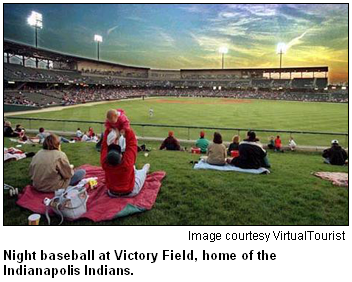 Built in the 1830s, the cabin was the home of a Virginia-born abolitionist who became a fugitive from justice in his home state. He secretly had been working to help a rebellion of slaves.
Built in the 1830s, the cabin was the home of a Virginia-born abolitionist who became a fugitive from justice in his home state. He secretly had been working to help a rebellion of slaves.
After the plan was discovered, he was thrown in jail. He managed to escape (although he was chased by bounty hunters) and fled to the Indiana wilderness, settling in what today is the town of Sheridan. The abolitionist's restored cabin sits on Pioneer Hill in Sheridan Veterans Park.
Question: Name the historic cabin.
The call-in number for the correct answer is (317) 788-3314, and the prize is four tickets to any Indianapolis Indians baseball game this summer at Victory Field, courtesy of the ICVA.
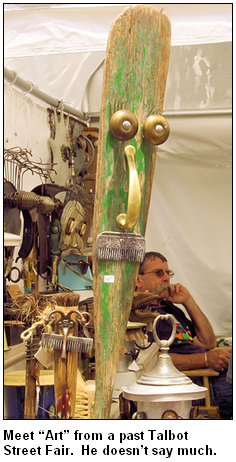 Chris Gahl of the ICVA suggests that we take in the 55th annual Talbot Street Art Fair coming up on June 12 and 13. Samuel Henderson, the first mayor of Indianapolis, was also the first owner of the land now encompassing the historic Herron-Morton neighborhood, where the fair takes place.
Chris Gahl of the ICVA suggests that we take in the 55th annual Talbot Street Art Fair coming up on June 12 and 13. Samuel Henderson, the first mayor of Indianapolis, was also the first owner of the land now encompassing the historic Herron-Morton neighborhood, where the fair takes place.
Henderson did not believe Indianapolis would ever amount to much, and he later sold his substantial real estate here to pursue the Gold Rush in California. In 1859, Indiana's State Board of Agriculture purchased the land to create a permanent Indiana State Fairgrounds.
With more than 270 artists from across the nation, this juried art fair continues to be ranked as one of the finest fairs in the country. Fair hours are 10 a.m. to 6 p.m. on Saturday, and 10 a.m. to 5 p.m. on Sunday. And you can walk a few blocks over to the adjacent neighborhood of Fall Creek Place for its annual neighborhood sale on Saturday, June 12.
(May 29, 2010) - If only your walls could talk, right? This is the ideal show for folks wondering how to track down the past "lives" of their houses. Nelson was joined in studio by two Indianapolis-based home history hunters who live in historic houses themselves and who know firsthand the challenges involved and resources available.
With tips and advice galore, photo historian Joan Hostetler and Home History Hunter (as she calls herself!) Tiffany Benedict Berkson offered guidance about how to get started, as well as the pitfalls to avoid.
The two house history "detectives" discussed how to:
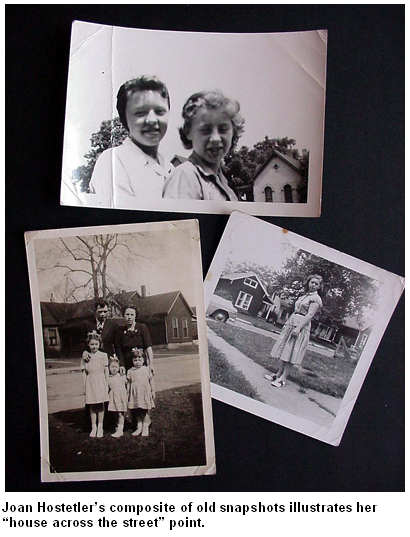 Joan is the owner of Heritage Photo Services, which specializes in photographic preservation, archive management, digital imaging and photographic research. She lives and works in a home built in1888 in the Cottage Home neighborhood by the legendary architectural firm of Vonnegut & Bohn. Active in neighborhood revitalization efforts, Joan collaborated with Nelson and photographer Garry Chilluffo on the Indianapolis Then and Now (Thunder Bay Press) visual history book.
Joan is the owner of Heritage Photo Services, which specializes in photographic preservation, archive management, digital imaging and photographic research. She lives and works in a home built in1888 in the Cottage Home neighborhood by the legendary architectural firm of Vonnegut & Bohn. Active in neighborhood revitalization efforts, Joan collaborated with Nelson and photographer Garry Chilluffo on the Indianapolis Then and Now (Thunder Bay Press) visual history book.
Tiffany lives in a spacious, turreted house built in 1897 in Herron-Morton Place, where she is a past president of the neighborhood association. An avid local history enthusiast with a particular interest in the Victorian era, she is a member of the Daughters of the American Revolution (Caroline Scott Harrison chapter) and a former volunteer at the President Benjamin Harrison Home.
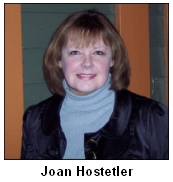 This show is your chance to call in and seek free advice from two professional house history "detectives." Joan can be reached at heritagephoto@indy.rr.com. Tiffany can be reached through her website.
This show is your chance to call in and seek free advice from two professional house history "detectives." Joan can be reached at heritagephoto@indy.rr.com. Tiffany can be reached through her website.
The following "learn more" websites are recommended by our guests:
A historic home with a distinctive past - and a distinctive name - is located in the Meridian Park neighborhood on the near Northside of Indianapolis. A bungalow built in 1906, the house became the residence of a fashion designer and his wife. She developed an international reputation as a palm reader.
Famous people such as Walt Disney, Eleanor Roosevelt, George Gershwin, James Whitcomb Riley and Helen Hayes visited the house to have their palms analyzed by the owner, Nellie Meier.
Nellie and her husband, George Phillips Meier, also were noted for their glittering dinner parties at the bungalow, which is listed on the National Register of Historic Places. It almost is hidden from view because of towering trees.
Question: What is the name of the famous bungalow?
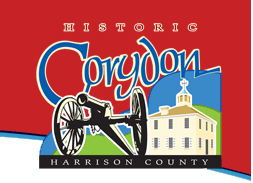 Chris Gahl of the ICVA suggested that we Unwind in Indiana: Southern Indiana, Uncorked!
Chris Gahl of the ICVA suggested that we Unwind in Indiana: Southern Indiana, Uncorked!
For a Memorial Day Weekend escape, Corydon offers its annual wine and beer tasting festival. The Uncorked! festival features live music, food vendors and, of course, wine and beer. Entry into the festival is $10 and includes 12 free samplings, as well as a complimentary wine glass. A portion of proceeds are donated to the American Heart Association.
Founded in 1808 and known as Indiana's first state capital, Corydon was the second capital of the Indiana Territory, from 1813-1816. After statehood, Corydon was the capital of Indiana until 1825, when the capital was moved to Indianapolis.
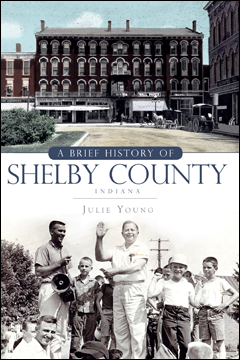 (May 22, 2010) - This show, one in our rotating series about town, neighborhood and county histories, is a look at the heritage of a county just southeast of Indianapolis that the Big Blue River runs through. That river was romanticized 100 years ago by Shelbyville author Charles Major.
(May 22, 2010) - This show, one in our rotating series about town, neighborhood and county histories, is a look at the heritage of a county just southeast of Indianapolis that the Big Blue River runs through. That river was romanticized 100 years ago by Shelbyville author Charles Major.
Shelby County also is known for destinations such as the Boggstown Cabaret, which opened in 1884 as an inn and quickly became a popular venue for piano and banjo music, as well as the Kopper Kettle in Morristown, an antique-filled, family-style restaurant that's also located in an historic building.
All of these are featured in a new visual history book written by Nelson's guest Julie Young, author of A Brief History of Shelby County (The History Press). Her book features dozens of photos and postcards of Shelbyville from the mid- and late 1800s. After a rocky start because of financial challenges, the county seat enjoyed a growth spurt from 1830 to 1850, with families who stayed put for generations.
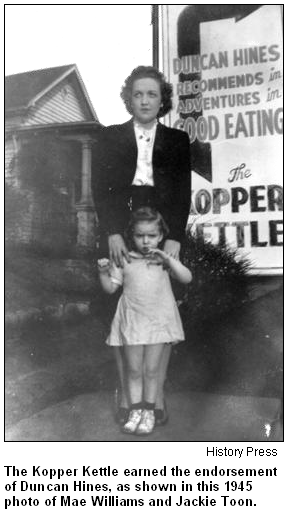 "Shelby County is an old region where family names ... date back nearly two centuries," Julie writes.
"Shelby County is an old region where family names ... date back nearly two centuries," Julie writes.
Railroad lines through the county often helped spur growth. An exception was the Knightstown & Shelbyville Railroad in 1850, which, as Julie recounts, "folded faster than any other line in the state’s history." (Tune in to hear some of the amusing explanations.)
In addition to Charles Major, an attorney and author whose bestsellers included the adventure novel The Bears of Blue River (1901), famous folks who grew up in Shelby County include movie actress Marjorie Main (1890-1975), who always will be remembered for her performances as crusty "Ma Kettle" in a series of movies during the 1950s. As one of Hollywood's busiest character actresses, she also had roles in box office hits such as Meet Me in St. Louis (1944) and Friendly Persuasion (1956); ironically, her father was a Shelby County minister who objected to the theater.
Shelbyville was the hometown of basketball great Bill Garrett (1929-1974), who broke the "color barrier" in the Big Ten when, after being recruited by Indiana University, he became the first African-American to play regularly.  Earlier, he had been named "Mr. Indiana Basketball" as an outstanding player for Shelbyville High School in 1947.
Earlier, he had been named "Mr. Indiana Basketball" as an outstanding player for Shelbyville High School in 1947.
In downtown Shelbyville, the public square is known for its diverse architecture.
The square also features a statue of Basler, the fictional hero of The Bears of Blue River, holding two bear cubs. (The desk used by Majors, the book's author, is displayed at the Grover Museum in Shelbyville. Among his other novels is When Knighthood Was in Flower, a historical romance that became a national bestseller in 1898.)
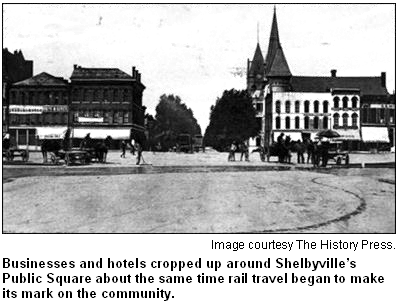 Recent developments in Shelby County, as Julie notes in her book, have included the building of the Indiana Downs race track and Indiana Live Casino, which has become the largest land-based casino in the Midwest.
Recent developments in Shelby County, as Julie notes in her book, have included the building of the Indiana Downs race track and Indiana Live Casino, which has become the largest land-based casino in the Midwest.
Julie joined us last July for a popular show about bygone landmarks on the Eastside of Indianapolis. That's because her other books include Eastside Indianapolis: A Brief History (The History Press).
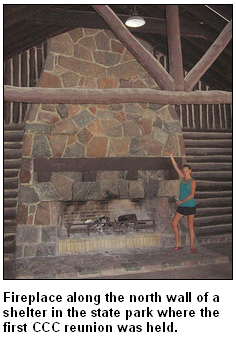 The History Mystery was a carry-over from two weeks ago, when there was no correct answer. The mystery concerns one of Indiana's state parks, which became the site of the first annual Civilian Conservation Corps (CCC) reunion in the country.
The History Mystery was a carry-over from two weeks ago, when there was no correct answer. The mystery concerns one of Indiana's state parks, which became the site of the first annual Civilian Conservation Corps (CCC) reunion in the country.
The park's CCC reunion began in 1953 and has continued for more than 50 years. It's the longest-running CCC reunion.
Question: Name the Indiana state park. Hint: Incorrect guesses two weeks ago included Brown County, McCormick's Creek and Spring Mill state parks.
The prize was a pair of tickets to Conner Prairie, courtesy of the ICVA.
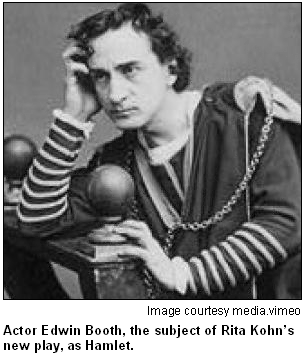 Chris Gahl of the ICVA picked the fourth annual Celebrate the Arts - Indiana Performing Arts Festival this weekend at the Indiana State Museum. The festival ran through Sunday, May 23, and showcased interpretive programs of the museum by displaying its numerous arts forms. Included in the performances was a variety of Hoosier dance, theatre, music and storytelling.
Chris Gahl of the ICVA picked the fourth annual Celebrate the Arts - Indiana Performing Arts Festival this weekend at the Indiana State Museum. The festival ran through Sunday, May 23, and showcased interpretive programs of the museum by displaying its numerous arts forms. Included in the performances was a variety of Hoosier dance, theatre, music and storytelling.
Additionally, Indianapolis writer Rita Kohn's new play, Before the Shadows Flee, was presented at the Indiana State Museum on Saturday, May 22, at 2 p.m. The play is about actor Edwin Booth, brother of President Lincoln's assassin John Wilkes Booth. Edwin Booth performed in Indiana theaters from the 1850s through the 1880s and experienced a lifetime of anguish over his brother's assassination of the president.
Encore show
(May 15, 2010) - It's been called one of the greatest tragedies in the history of westward migration. The Donner Party tragedy's most gruesome aspects occurred in the Sierra Nevada mountains during the brutal winter of 1846-47, but there are some Hoosier links with the ill-fated wagon train. 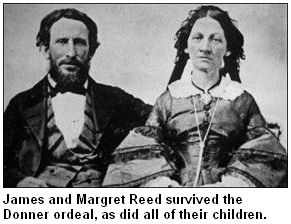 Nelson's studio guest not only will explain the Indiana connection, he will share lessons derived (in conflict resolution, leadership selection and group decision-making) from the tragedy that involved stranded, California-bound pioneers, some of whom eventually resorted to cannibalism.
Nelson's studio guest not only will explain the Indiana connection, he will share lessons derived (in conflict resolution, leadership selection and group decision-making) from the tragedy that involved stranded, California-bound pioneers, some of whom eventually resorted to cannibalism.
Although group leader George Donner was born in North Carolina and, as a 62-year-old farmer, was based in Springfield, Ill., when the expedition headed west, he had lived for several years in Greensburg, Indiana. In fact, Nelson's guest, Hoosier business consultant and speaker Karl Ahlrichs, is a descendant of George Donner, one of whose wives is buried in Indiana. (A subsequent wife, Donner's third, accompanied the California-bound group.)
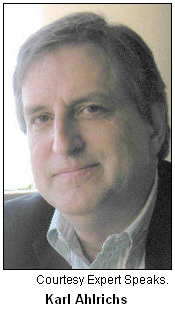 The "Donner" name not only is on sites in California (including what is now known as Donner Pass, where some of the more than 40 deaths occurred), it also is on parks and buildings in southern Indiana because of the influence of the extended family in this state, including Donner Park in Columbus. Donner also owned property in Jefferson County. According to Karl, some of the Donner land later became part of the Jefferson Proving Ground, an ammunition testing site established in the 1940s.
The "Donner" name not only is on sites in California (including what is now known as Donner Pass, where some of the more than 40 deaths occurred), it also is on parks and buildings in southern Indiana because of the influence of the extended family in this state, including Donner Park in Columbus. Donner also owned property in Jefferson County. According to Karl, some of the Donner land later became part of the Jefferson Proving Ground, an ammunition testing site established in the 1940s.
After researching what happened with the Donner Party and why, Karl will explain how he uses this historic episode to enhance decision-making and critical-thinking skills. He even sees parallels between political choices at the ballot box for Hoosier voters and the selection of grandfatherly, affable George Donner as the group's leader rather than a much younger candidate, James Reed, a visionary who was intense, ambitious and abrasive.
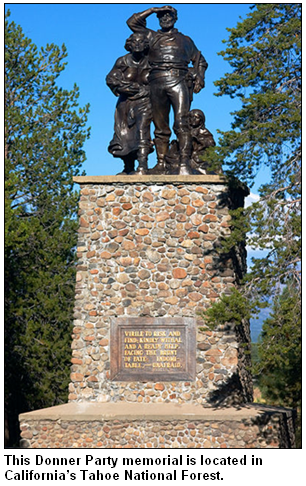 The horrifying tragedies associated with the Donner Party (of an original group that numbered 87 pioneers, 39 perished, along with two Native Americans who died while bringing supplies) resulted in changes in the way rescue parties were dispatched to help stranded wagon trains.
The horrifying tragedies associated with the Donner Party (of an original group that numbered 87 pioneers, 39 perished, along with two Native Americans who died while bringing supplies) resulted in changes in the way rescue parties were dispatched to help stranded wagon trains.
In addition to George Donner, the party included his brother Jacob and several members of their extended families, as well as hired hands. When they became snowbound for months during the raging blizzards, members of the Donner Party ran out of provisions and ate their oxen and other animals. In desperation, they then turned to mice and just about anything else that could be consumed. The tragedy is not a lighthearted topic, but Karl says it can be instructive, and Hoosier History Live! strives to cover all aspects of our heritage, even events that we wish had not occurred.
Note: This is an encore of a show originally broadcast in September 2009.
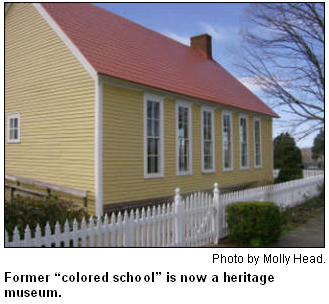 In the early 1800s, one of Indiana's first African-American communities was established in a Southern Indiana town. That's because abolitionists, over a series of years, brought more than 100 black slaves from the South to the Indiana town and freed them. For many generations, the descendants of these freed slaves attended a segregated school in the Indiana town. In recent years, the historic school, once known as the town's "colored school," has been restored as a heritage museum.
In the early 1800s, one of Indiana's first African-American communities was established in a Southern Indiana town. That's because abolitionists, over a series of years, brought more than 100 black slaves from the South to the Indiana town and freed them. For many generations, the descendants of these freed slaves attended a segregated school in the Indiana town. In recent years, the historic school, once known as the town's "colored school," has been restored as a heritage museum.
Question: Name the Southern Indiana town in which the historic African-American school-turned-museum is located.
Since this was an encore presentation, we fielded answers on our Facebook page. Prize was four tickets to an Indians game at Victory Field, courtesy of the ICVA.
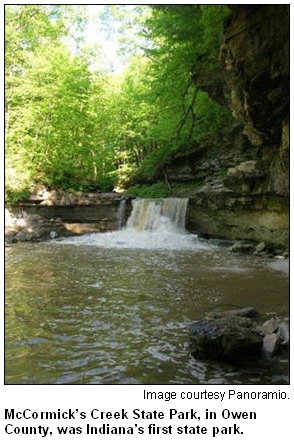 (May 8, 2010) - With nature in full bloom, Indiana's state parks not only beckon as serene retreats, they practically beg to be the focus of a Hoosier History Live! show. Responding to the call, we will explore their history, covering as much turf as possible with Nelson's guest, public historian Glory-June Greiff, author of People, Parks and Perceptions: A History and Appreciation of Indiana State Parks (Trafford Publishing).
(May 8, 2010) - With nature in full bloom, Indiana's state parks not only beckon as serene retreats, they practically beg to be the focus of a Hoosier History Live! show. Responding to the call, we will explore their history, covering as much turf as possible with Nelson's guest, public historian Glory-June Greiff, author of People, Parks and Perceptions: A History and Appreciation of Indiana State Parks (Trafford Publishing).
With Glory-June, a preservation activist, as our guide, we will dig in to the creation of our state parks. We also will explore the major impact of German-born conservationist Richard Lieber (1869-1944), who is known as the "Father of Indiana State Parks," as well as the impact of the New Deal, including the Civilian Conservation Corps. And expect Glory-June and Nelson to explore the creation and evolution of state parks ranging from Turkey Run and Clifty Falls to Pokagon, Spring Mill and Fort Harrison.
Crusades to protect scenic areas of the state gained momentum in 1915 when, according to People, Parks and Perceptions, the sandstone canyons of Turkey Run in Parke County came up for sale. "The Hoosier Veneer Company coveted the heavily forested site in order to harvest its massive hardwoods," Glory-June writes. 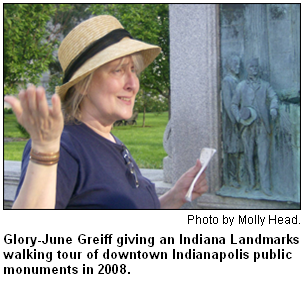 As a result, the survival of the "relatively pristine area was seriously in doubt." Lieber and others led a public outcry and convinced the scenic area's new owners to sell it to the state in late 1916.
As a result, the survival of the "relatively pristine area was seriously in doubt." Lieber and others led a public outcry and convinced the scenic area's new owners to sell it to the state in late 1916.
By that point, McCormick's Creek in Owen County already had been established as Indiana's first state park. Almost immediately after World War I, unexpectedly large crowds flocked to both Turkey Run and McCormick's Creek. Fun fact: Turkey Run, which includes Sugar Creek, derives its distinctive name, Glory-June writes, because of "the great flocks of wild turkeys that once sought shelter within the stream's canyon walls."
Her book describes the ways state parks became cherished by, among other Hoosiers, modest-income families as destinations for their annual vacations. 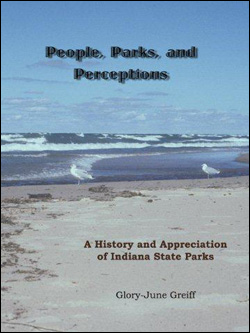 In the 1950s, family camping boomed, as did the clamor for the creation of more state parks.
In the 1950s, family camping boomed, as did the clamor for the creation of more state parks.
Among the most recently created of them, there's a distinctive history with Fort Harrison State Park; it was established in 1996 after the closing of the military installation on northeast Marion County. "The property was virtually ready to go, once the park boundaries were determined, because the military installation had established large green spaces around its borders," Glory-June writes. "There were trails, artificial lakes, and even an 18-hole golf course, the first (and only) one in a state park."
Glory-June also is the author of: Remembrance, Faith and Fancy: Outdoor Public Sculpture in Indiana (Indiana Historical Society Press, 2005)
Bonus: She will offer a free presentation, "The New Deal in Indiana State Parks," at Hancock County Library in Greenfield at 7 p.m. on June 7.
One of Indiana's state parks became the site of the first annual Civilian Conservation Corps (CCC) reunion in the country. The park's CCC reunion began in 1953 and continued for 50 years. It became the longest-running CCC reunion.
Question: Name the Indiana state park. Note: This Trivia Mystery was suggested by listener Terri Gorney of Fort Wayne.
The call-in number for the correct answer is (317) 788-3314, and the prize is a pair of tickets to the 40th Broad Ripple Art Fair on the weekend of May 15 and 16, courtesy of the ICVA.
Chris Gahl of the ICVA suggests we head to Vincennes on the weekend of May 29 & 30 for the 34th annual Spirit of Vincennes Rendezvous.
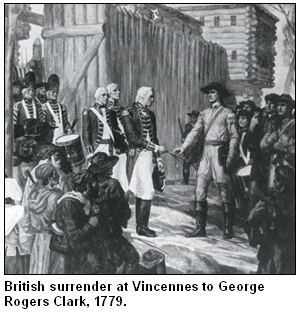 At 10 a.m. on Thursday, Feb. 25, 1779, British Lt. Gov. Henry Hamilton surrendered to the Americans and French Canadians after a siege at Vincennes. The victor, Lt. Col. George Rogers Clark, had led an army of 170 Americans and French-Canadians across the flooded area of present-day southern Illinois in a march to Vincennes.
At 10 a.m. on Thursday, Feb. 25, 1779, British Lt. Gov. Henry Hamilton surrendered to the Americans and French Canadians after a siege at Vincennes. The victor, Lt. Col. George Rogers Clark, had led an army of 170 Americans and French-Canadians across the flooded area of present-day southern Illinois in a march to Vincennes.
This event is one of the premier Revolutionary War reenactments, and it attracts 400 to 500 re-enactors, along with an estimated 35,000 visitors.
The Spirit of Vincennes Rendezvous is designed to bring back to life the sights, sounds and smells of late 18th-century and early 19th-century Vincennes.
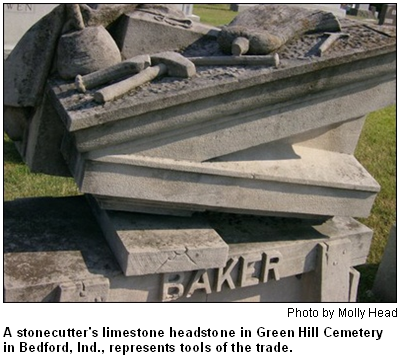 (May 1, 2010) - In our popular series about ethnic immigration and heritage, we explored the legacy of Italian stonecutters who came to southern Indiana to carve our famous limestone. Nelson was joined in studio by a descendant of stone carvers from Carrara, Italy, Indianapolis author and speaker Carol Faenzi. Her dramatic account of her great-grandparents' journey from Italy to the Hoosier state, The Stonecutter's Aria (Aperto Books), was selected by the Indianapolis Opera Company for its "One Book, One Opera"
celebration and was selected by the Columbus Area Arts Council for its Community Read.
(May 1, 2010) - In our popular series about ethnic immigration and heritage, we explored the legacy of Italian stonecutters who came to southern Indiana to carve our famous limestone. Nelson was joined in studio by a descendant of stone carvers from Carrara, Italy, Indianapolis author and speaker Carol Faenzi. Her dramatic account of her great-grandparents' journey from Italy to the Hoosier state, The Stonecutter's Aria (Aperto Books), was selected by the Indianapolis Opera Company for its "One Book, One Opera"
celebration and was selected by the Columbus Area Arts Council for its Community Read.
Carol shared details about the "first families" of Italian stone carvers to settle in Bedford, including the Arenas, who did much of the carving work on the town's main plaza.
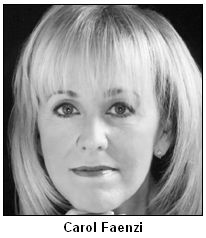 Did you know marble cutters from Italy who settled in Indiana often went on to use their talents with limestone in the construction during the 1930s of cathedrals, monuments and private buildings across the country? (Carol's ancestor's handiwork graces Julian Chapel at Duke University, the National Archives and the Cathedral of Learning at the University of Pittsburgh.)
Did you know marble cutters from Italy who settled in Indiana often went on to use their talents with limestone in the construction during the 1930s of cathedrals, monuments and private buildings across the country? (Carol's ancestor's handiwork graces Julian Chapel at Duke University, the National Archives and the Cathedral of Learning at the University of Pittsburgh.)
Carol and Nelson also explored one of the state's "gems" among our burial grounds, scenic Green Hill Cemetery in Bedford, a trove of distinctive, personalized monuments created by the stonecutters. Carol has traveled extensively to her ancestral home of Carrara, located at the epicenter of the Italian Alps and the quarries of marble, which is known in Tuscany as "white gold."
(April 24, 2010) - 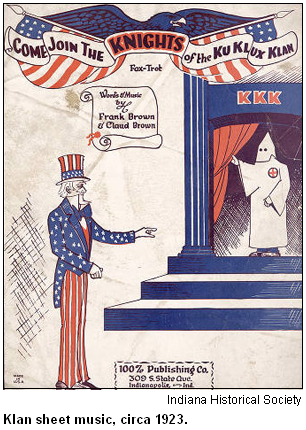 Hoosier History Live! is dedicated to covering all aspects of Indiana's past, including those we wish had not happened. Certainly the political and cultural dominance of the notorious Ku Klux Klan during the 1920s falls into the category of shameful. To explore what happened and why, Nelson was joined in studio by Allen Safianow of Kokomo, a professor emeritus at IU-Kokomo who has done extensive research on the KKK in Indiana.
Hoosier History Live! is dedicated to covering all aspects of Indiana's past, including those we wish had not happened. Certainly the political and cultural dominance of the notorious Ku Klux Klan during the 1920s falls into the category of shameful. To explore what happened and why, Nelson was joined in studio by Allen Safianow of Kokomo, a professor emeritus at IU-Kokomo who has done extensive research on the KKK in Indiana.
The central figure during the 1920s heyday of the hate group was the flamboyant D.C. Stephenson (1891-1966), who rose to become Grand Dragon. Stephenson intimidated Indiana politicians, recruited large numbers of Hoosier members and even boasted, "I am the law in Indiana."
Stephenson's downfall (and the decline of the KKK's dominance in the state) came when he was arrested in the death of an Indianapolis woman whom he had brutally raped. 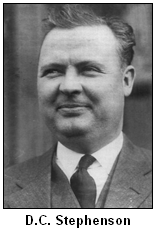 During a sensational trial in 1925, Stephenson was found guilt of second-degree murder. The trial was in Noblesville, which drew national attention again decades later when a local building contractor discovered Klan records and memorabilia dating back to the 1920s.
During a sensational trial in 1925, Stephenson was found guilt of second-degree murder. The trial was in Noblesville, which drew national attention again decades later when a local building contractor discovered Klan records and memorabilia dating back to the 1920s.
Professor Safianow has analyzed the impact of those records, which contained membership rolls of Hamilton County citizens, hoods and sashes. 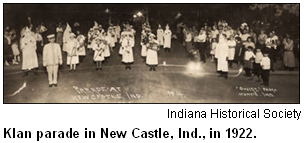 Professor Safianow also has analyzed the KKK's impact during the 1920s in other parts of the state, including Tipton and Kokomo, said to be the site in 1923 of the largest conclave (called a "Konclave") ever held in the United States.
Professor Safianow also has analyzed the KKK's impact during the 1920s in other parts of the state, including Tipton and Kokomo, said to be the site in 1923 of the largest conclave (called a "Konclave") ever held in the United States.
"At its height in Indiana in the 1920s, one quarter to one third of native-born, white males in Indiana were Klan members," Professor Safianow noted in an article in the Indiana Magazine of History about the discovery of the Hamilton County membership records and memorabilia. 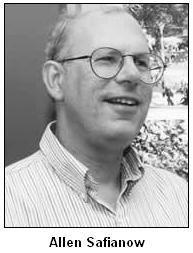 He also notes that the unraveling of – and infighting among – the Klan in Indiana had begun even before Stephenson's trial. In the aftermath, confidential files were released that described corruption and Klan ties to the administration of Gov. Ed Jackson.
He also notes that the unraveling of – and infighting among – the Klan in Indiana had begun even before Stephenson's trial. In the aftermath, confidential files were released that described corruption and Klan ties to the administration of Gov. Ed Jackson.
In Indiana, the resurgence of the KKK (which had flourished after the Civil War in the Deep South) is often traced to the arrival in Evansville in 1920 of a Klan recruiter named Joseph Huffington. Agents then began recruiting members in southern Indiana. Stephenson, a Texas native who spent much of his youth in Oklahoma, also drifted to Evansville in the early 1920s, then moved to Indianapolis.
During a 12-month period beginning in July 1922, more than 100,000 Hoosier men joined the Klan, according to some experts. Targets of the KKK during the 1920s in Indiana included immigrants, Catholics, Jews and African-Americans.
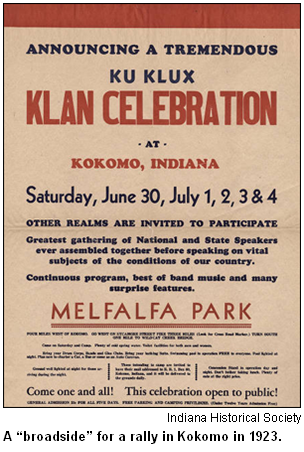 Professor Safianow, a New Jersey native educated at Rutgers and Cornell, moved to Indiana in the early 1970s to join the faculty at IU-Kokomo. He says he began his research on the KKK because of Kokomo's connection to the massive rally in 1923. Nelson discussed with Professor Safianow the challenges that confront historians who attempt to get a handle on the Klan of the 1920s.
Professor Safianow, a New Jersey native educated at Rutgers and Cornell, moved to Indiana in the early 1970s to join the faculty at IU-Kokomo. He says he began his research on the KKK because of Kokomo's connection to the massive rally in 1923. Nelson discussed with Professor Safianow the challenges that confront historians who attempt to get a handle on the Klan of the 1920s.
In the 1920s, the Ku Klux Klan was so brazen it openly used a convention center-revival house in downtown Indianapolis for several rallies. The convention center, known as a "tabernacle," was the setting for a vast array of public events, most having nothing to do with the Klan; they included dance marathons, religious revivals and teachers' conventions. Designed in a Spanish style with a whitewashed facade, the tabernacle was built in 1921 at the corner of Ohio and New Jersey streets. It had a seating capacity of 10,000, not counting a loft for 1,500 choir members. (Choral performances frequently were broadcast across the country on network radio programs.)
Question: Name the sprawling tabernacle that was the setting for hundreds of large gatherings in downtown Indianapolis from the 1920s until its demolition in the late 1960s.
Answer: Cadle Tabernacle. Its owner, entrepreneur Howard E. Cadle, intended for the tabernacle to promote nondenominational Christianity. But the building's use expanded to include hundreds of secular gatherings, some of which distressed Cadle, who lost control of the site periodically and died in 1942. The tabernacle, located on the northwest corner of Ohio and New Jersey streets, was demolished in the late 1960s to create parking lots for banks and other businesses east of Monument Circle. Today the former Cadle site is the location of Firehouse Square, an upscale complex of townhouse condos.
The prize was a DVD of Movers and Stakers, a documentary about the history of the National Road in Indiana, courtesy of producer/director Nancy Carlson of Ball State University.
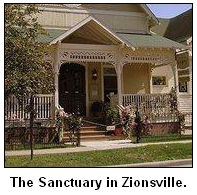 World-celebrated artist Nancy Noël invited all to experience her Spring Open House, on Saturday, May 1, and Sunday, May 2, at The Sanctuary, a restored Victorian church in downtown Zionsville. During this annual celebration, guests travel from all over the country to buy art and have the chance to actually meet Nancy in person.
World-celebrated artist Nancy Noël invited all to experience her Spring Open House, on Saturday, May 1, and Sunday, May 2, at The Sanctuary, a restored Victorian church in downtown Zionsville. During this annual celebration, guests travel from all over the country to buy art and have the chance to actually meet Nancy in person.
Live music and tasty treats provided by the resident, in-house French chef ensure an enjoyable Roadtrip to Zionsville. And the open house is free. Hear more on Saturday from the Roadtripper himself, Chris Gahl of the ICVA.
Encore show
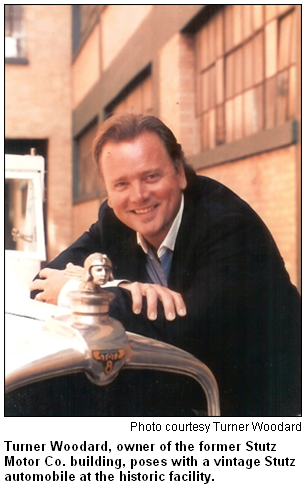 (April 17, 2010) - With so much focus recently on the Detroit-based auto industry, does anyone remember that before the Great Depression of the 1930s, Indy almost rivaled Detroit as the car-making capital? During the Roaring '20s, three of the most elegant American cars were designed and manufactured in Indy: the Stutz, the Marmon and the Duesenberg.
(April 17, 2010) - With so much focus recently on the Detroit-based auto industry, does anyone remember that before the Great Depression of the 1930s, Indy almost rivaled Detroit as the car-making capital? During the Roaring '20s, three of the most elegant American cars were designed and manufactured in Indy: the Stutz, the Marmon and the Duesenberg.
Certainly our studio guest has not forgotten the Hoosier auto-making heyday. In this "encore" show, originally broadcast in February 2009, Nelson welcomes well-known entrepreneur Turner Woodard, a vintage-auto buff, historic preservationist and owner of what was once the Stutz Motor Company building in the 1100 block of North Capitol Avenue in Indianapolis. Today, the Stutz Business Center houses more than 120 artists, architects, photographers and small businesses.
Fasten your seat belts as we roar back to the days when the Stutz Bearcat, the Blackhawk and other Indy-designed autos were captivating aficionados across the land. Turner, a board member of Indiana Landmarks and a former race-car driver, joins Nelson to explore how the luxury-car boom took off in Indy – and why it sputtered out, leaving Detroit unrivaled as the auto hub. Note: Because this is an encore broadcast, there won’t be opportunities for call-in comments.
Some tidbits about Indy’s auto heritage:
Buyers of the luxurious Stutz, Marmon and Duesenberg cars, according to the encyclopedia, "were people who regarded their automobiles the way they did their yachts, as exotic playthings." 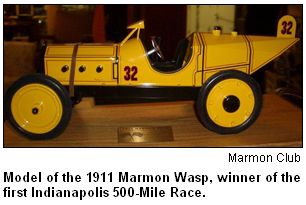 The Great Depression was among the factors that spelled doom. Turner and Nelson explore other factors, including the fact that many of the Indy-made cars were custom-assembled to buyers' specifications (Henry Ford is generally credited for having the genius to create assembly line production in Detroit), as well as the easy access in Michigan to the Great Lakes for shipping convenience.
The Great Depression was among the factors that spelled doom. Turner and Nelson explore other factors, including the fact that many of the Indy-made cars were custom-assembled to buyers' specifications (Henry Ford is generally credited for having the genius to create assembly line production in Detroit), as well as the easy access in Michigan to the Great Lakes for shipping convenience.
Nelson also asks Turner about his collection of rare and exotic automobiles. Many of the Indy-made cars of the 1920s now are considered collectors' dream machines. And since the original broadcast of this show in 2009, Hoosier History Live! would also like to note that Turner also invested in Indianapolis heritage by buying the historic Canterbury Hotel in downtown Indianapolis in March of 2010.
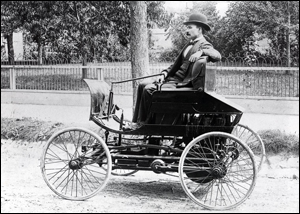 A Hoosier inventor born in 1857 is credited with creating one of the very first gasoline-powered cars in America. During a test run in 1894, the "horseless carriage" reached a top speed of about 7 miles per hour. To avoid scaring horses on city streets, the test run was conducted in a rural area near Kokomo, which was the inventor's adopted hometown. He built automobiles in Kokomo until the 1920s.
A Hoosier inventor born in 1857 is credited with creating one of the very first gasoline-powered cars in America. During a test run in 1894, the "horseless carriage" reached a top speed of about 7 miles per hour. To avoid scaring horses on city streets, the test run was conducted in a rural area near Kokomo, which was the inventor's adopted hometown. He built automobiles in Kokomo until the 1920s.
Question: Name the inventor.
Because this week's show is an "encore" presentation, you won't be able to call in with the answer. However, since Hoosier History Live! is now on Facebook, if you go to our page and sign up as a fan and are the first to put the correct answer on our Facebook page, we'll send you a pair of tickets to the Indiana Wine Fair on April 24 in Brown County! That might even be more fun than a drive around Howard County.
We are gradually adding a richer audio section with full-length shows for your listening pleasure. Recently added:
There's treasure buried everywhere in the Hoosier History Live! website — and ironies ...
 In the Elkinsville show audiocast (in bold above), you can hear the thunder and lightning in the background. It was recorded from 11:30 a.m. to noon on the day of the June 6, 2008 flood. The basement of the home of one of the sisters was flooded when she came up from Columbus, Indiana to Indy to do the show, and it took the sisters something like 10 hours to drive back down. And all for a show called "Elkinsville: A Town Under Water."
In the Elkinsville show audiocast (in bold above), you can hear the thunder and lightning in the background. It was recorded from 11:30 a.m. to noon on the day of the June 6, 2008 flood. The basement of the home of one of the sisters was flooded when she came up from Columbus, Indiana to Indy to do the show, and it took the sisters something like 10 hours to drive back down. And all for a show called "Elkinsville: A Town Under Water."
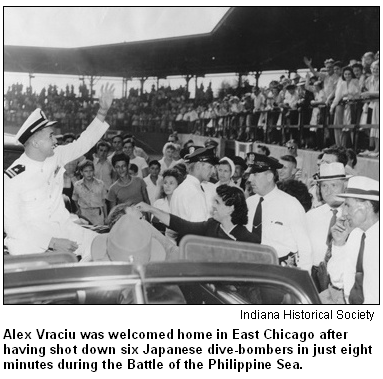 (April 10, 2010) - For four months in 1944, a Hoosier was the lead flying ace in the entire U.S. Navy. His biographer, Ray Boomhower of the Indiana Historical Society, joined Nelson in studio to share insights about the daring exploits of Alex Vraciu, a Hellcat fighter pilot who shot down 19 enemy airplanes in the air and destroyed an additional 21 on the ground.
(April 10, 2010) - For four months in 1944, a Hoosier was the lead flying ace in the entire U.S. Navy. His biographer, Ray Boomhower of the Indiana Historical Society, joined Nelson in studio to share insights about the daring exploits of Alex Vraciu, a Hellcat fighter pilot who shot down 19 enemy airplanes in the air and destroyed an additional 21 on the ground.
Ray is the author of Fighter Pilot (Indiana Historical Society Press), a new biography of Vraciu (rhymes with "cashew") that's written for young readers to enhance their understanding of World War II.
A native of the Calumet Region of far-northwestern Indiana and the son of Romanian immigrants, Vraciu graduated from high school in East Chicago, then attended 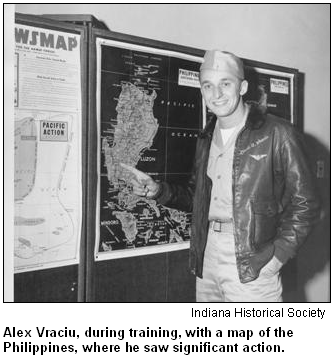 DePauw University and learned to fly during his college years.
DePauw University and learned to fly during his college years.
Fighting in the skies over the Pacific Ocean, he shot down six dive-bombing Japanese airplanes in just eight minutes on June 19, 1944. According to Ray, the Hoosier flying ace was "possessed with keen eyesight, quick reflexes, excellent shooting instincts and a knack for finding his opponent's weak spot."
Born in 1918, Alex Vraciu grew up in East Chicago enthralled by the exploits of aviator Charles Lindbergh and World War I flying ace Eddie Rickenbacker, according to Fighter Pilot. At DePauw, fearless Vraciu received national attention for a prank that he pulled during his psychology class. (Tune in to the show to hear Ray describe the details.)
When Pearl Harbor was attacked in December 1941, Vraciu was undergoing training to be a Navy pilot. 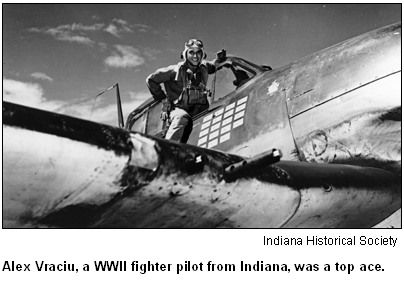 Eventually, the Hoosier earned the title of "ace" (achieved by downing five enemy aircraft in aerial combat), doing so while piloting one of the famous F6F Hellcat fighter planes. The Hellcats, Ray writes, "helped turn the tide for the Americans" in the aerial war against the Japanese.
Eventually, the Hoosier earned the title of "ace" (achieved by downing five enemy aircraft in aerial combat), doing so while piloting one of the famous F6F Hellcat fighter planes. The Hellcats, Ray writes, "helped turn the tide for the Americans" in the aerial war against the Japanese.
Several times, Vraciu nearly lost his life. He had to ditch his Hellcat in the ocean twice because of battle damage or mechanical failure. In addition, two of the Navy carriers he served on were torpedoed (but not sunk) by the Japanese. 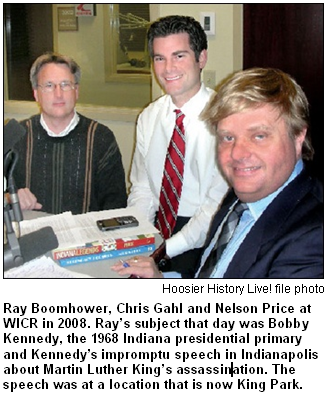 His exploits made him a hero in East Chicago. According to Fighter Pilot, more than 6,000 people cheered Vraciu at a welcome-home celebration. After the war, Vraciu remained with the Navy, retired with the rank of commander and settled in California.
His exploits made him a hero in East Chicago. According to Fighter Pilot, more than 6,000 people cheered Vraciu at a welcome-home celebration. After the war, Vraciu remained with the Navy, retired with the rank of commander and settled in California.
Fighter Pilot is Ray's 11th book. Others have included biographies about Hoosier astronaut Gus Grissom (which was the focus of a Hoosier History Live! show with Ray in April 2009) and about war correspondent Ernie Pyle. Ray also is the editor of Traces of Indiana and Midwestern History, the popular magazine published by the IHS.
During World War II, a Hoosier who already was famous for his football achievements endured two near-death experiences as a pilot. 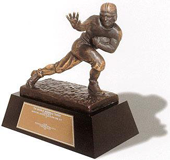 As a fighter pilot in the U.S. Army Air Corps, this native of northern Indiana was reported missing in action and was given up for dead twice during the war. Both times, he survived terrifying ordeals. After World War II, he became a pioneer sportscaster in the early days of television.
As a fighter pilot in the U.S. Army Air Corps, this native of northern Indiana was reported missing in action and was given up for dead twice during the war. Both times, he survived terrifying ordeals. After World War II, he became a pioneer sportscaster in the early days of television.
Question: Name the football star-turned-war hero. Hint: To this day, he remains the only native Hoosier to have won the Heisman Trophy as the nation's outstanding collegiate football player.
Answer: Tom Harmon, who grew up in Rensselaer and Gary, where he drew national attention in the 1930s to Horace Mann High School as a star quarterback. Harmon followed that up with even greater fame at the University of Michigan, where he captured the 1940 Heisman Trophy. Shortly after the bombing of Pearl Harbor, Harmon enlisted in the Army Air Corps and became a fighter pilot. His B-25 bomber crashed during a ferocious thunderstorm over South America in 1943; he was the only crew member to survive. Later that year, his aircraft was shot down over China by the Japanese. Harmon survived because he parachuted into a lake, was rescued by the Chinese and hidden. For more than a month, Americans feared he had been killed; a special Mass was held in his honor. His war injuries, particularly severe burns on his legs suffered during the attack over China, limited his effectiveness after the war as a pro football player. But Harmon became extremely successful as one of TV's first sportscasters. Tom Harmon, who died in 1990, was the father of popular TV and movie actor Mark Harmon, the star of the "Navy NCIS" series.
The prize was a pair of tickets to the Indiana Wine Fair on April 24 in Brown County.
Roadtripper Chris Gahl of the ICVA suggested that we head to bucolic Brown County for the Indiana Wine Fair on Saturday, April 24 in the village of Story in southern Brown County.
Doling out 1-ounce pours to an appreciative public in the Story Inn's "Old Barn," the Indiana Wine Fair will be an excellent opportunity to build your own wine cellar. Additionally, the night before, Friday, April 23, will feature a jazz concert and cabaret-style show.
Free parking will be available adjacent to the Story Inn, and free shuttle service will be running from the Nashville Courthouse.
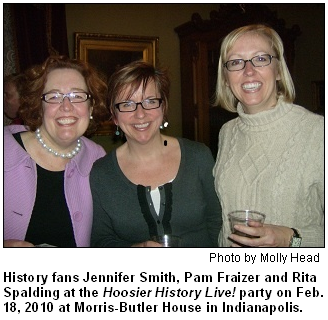 Proudly two years (on the air) old, Hoosier History Live! celebrated on Feb. 18 with a soiree at Morris-Butler House in Indianapolis. Party attendees enjoyed cake and refreshments and got to meet and greet fellow history lovers from a wide variety of backgrounds. Several on-air guests made appearances, including Sue Grizzell, Chris Connolly, Bo Connor and Rita Rose.
Proudly two years (on the air) old, Hoosier History Live! celebrated on Feb. 18 with a soiree at Morris-Butler House in Indianapolis. Party attendees enjoyed cake and refreshments and got to meet and greet fellow history lovers from a wide variety of backgrounds. Several on-air guests made appearances, including Sue Grizzell, Chris Connolly, Bo Connor and Rita Rose.
Host Nelson Price, producer Molly Head and event sponsor Marsh Davis of Historic Landmarks gave brief talks, and Nelson quizzed participants on Hoosier history, with prizes to several winners. Webmaster Richard Sullivan of Monomedia presented a slide show featuring some photos from the program's two-year history and some tidbits about the making of the show and the website.
Thanks to all who attended and helped out with our two-year celebration. And thanks so much for listening to - and reading about - Hoosier History Live!
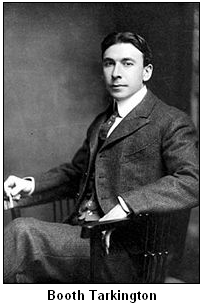 (April 3, 2010) - "A Decorated Past" was the headline on a recent newspaper story about the historic North Meridian Street mansion once owned by two-time Pulitzer Prize-winning novelist and playwright Booth Tarkington. The "decorated past" included glittering dinner parties that the author of The Magnificent Ambersons (1918) and the Penrod series hosted for guests such as Helen Hayes and the Marx Brothers.
(April 3, 2010) - "A Decorated Past" was the headline on a recent newspaper story about the historic North Meridian Street mansion once owned by two-time Pulitzer Prize-winning novelist and playwright Booth Tarkington. The "decorated past" included glittering dinner parties that the author of The Magnificent Ambersons (1918) and the Penrod series hosted for guests such as Helen Hayes and the Marx Brothers.
But there also is a "decorated present" at the Tudor-style home, as its current owner, former Marion County Clerk Doris Anne Sadler, explained when she joined Nelson in studio along with Sally Sebeckis, decorator chairman of St. Margaret's Hospital Guild, which has chosen what's commonly known as the "Booth Tarkington Home" as the 2010 Decorators' Show House.
By the way, the Decorators' Show House, which benefits Wishard Health Services, has quite a history of its own: This marks its 49th year, making it one of the nation’s oldest, consecutively-running show house events.
A portion of the Booth Tarkington Home dates clear back to 1911, long before most of the other North Meridian mansions were built. Most were constructed during the mid- and late 1920s. 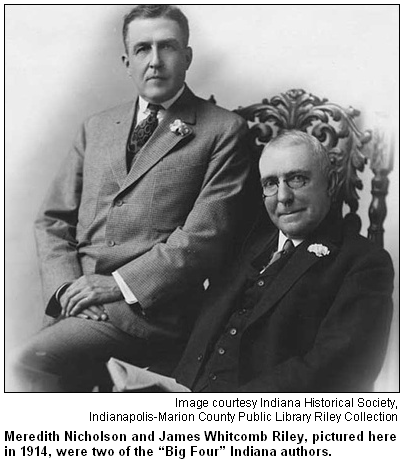 The home’s initial owner was a widow named Marie Hare, who lived in it with her six children. Tarkington, who first drew national attention for his novel The Gentleman from Indiana (1899), bought the home from Mrs. Hare in 1923. Then he significantly enhanced the mansion, filling it with artwork as he flourished as a writer there and entertained his distinguished friends until his death in 1946.
The home’s initial owner was a widow named Marie Hare, who lived in it with her six children. Tarkington, who first drew national attention for his novel The Gentleman from Indiana (1899), bought the home from Mrs. Hare in 1923. Then he significantly enhanced the mansion, filling it with artwork as he flourished as a writer there and entertained his distinguished friends until his death in 1946.
Since Doris Anne, her husband Tim and their two young children moved in, guests have included former President George H.W. Bush. During a visit last fall, the former president shared memories of his encounters as a young boy in Kennebunkport, Maine, with Tarkington, who spent his summers at the New England resort. For nine months of the year, though, Tarkington and his wife, Susannah, lived in the North Meridian mansion, where he wrote every single day, including Sundays, even during a period in the late 1920s and early '30s when he suffered from cataracts and was nearly blind. (During that period, Tarkington wrote by dictating his stories.)
This was quite a reversal from the early life of Tarkington, who had been born in 1869 to one of Indianapolis' most prominent families. He disliked school, frequently played hooky, and, as a young man, drank heavily and lived extravagantly. As a condition of Susannah's marriage to him in 1912, she demanded that he focus on his gift for writing. 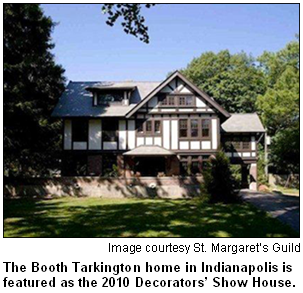 In addition to winning the Pulitzer Price for The Magnificent Ambersons, a novel about an aristocratic family coping with social and economic upheavals, Tarkington won a Pulitzer for Alice Adams (1921). This is the second time St. Margaret's Hospital Guild has chosen his mansion as the Decorator's Show House; it also was the show home in the mid-1980s.
In addition to winning the Pulitzer Price for The Magnificent Ambersons, a novel about an aristocratic family coping with social and economic upheavals, Tarkington won a Pulitzer for Alice Adams (1921). This is the second time St. Margaret's Hospital Guild has chosen his mansion as the Decorator's Show House; it also was the show home in the mid-1980s.
Daily tours of the Decorators' Show House will be April 24-May 9 (except for Mondays), with special events sprinkled throughout. They will include a "designer breakfast tour" May 7 at 8:30 a.m. that will feature presentations by Tarkington scholar Jim Powell of IUPUI as well as by Nelson and photo historian Joan Hostetler, who collaborated on the book Indianapolis Then and Now, which features the historic home. Fun fact: Even though Tarkington is associated with a North Meridian mansion, he used spacious homes built during an earlier era, houses in the Woodruff Place neighborhood, as the inspirations for the elegant residences in The Magnificent Ambersons.
Roadtripper Chris Gahl of the ICVA suggested that we head to Franklin, Indiana to see a picture at the Artcraft Theatre in Franklin's historic downtown, just north of the Johnson County courthouse. 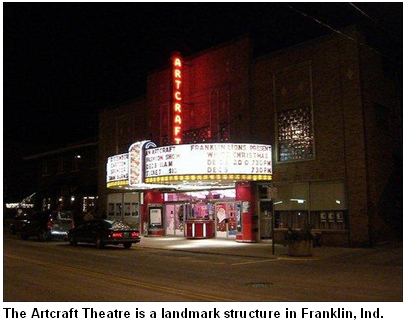 Built in 1922, the theater has been a venue for Indiana entertainment for more than 80 years.
Built in 1922, the theater has been a venue for Indiana entertainment for more than 80 years.
The Artcraft started out as a theater for Franklin residents to enjoy both motion picture and stage productions, and through years of faithful patronage it has been able to establish itself as the perfect place to catch silver-screen hits from the Golden Age of film. This summer's movie lineup includes famous films like "Treasure Island," "Seven Brides for Seven Brothers," the James Dean classic "Rebel Without A Cause" and the family favorite "The Wizard of Oz." And tickets are only $5!
While you are enjoying Franklin's delightful small-town ambiance, you also can dine at the Willard Hotel, next door to the Artcraft. Make it a Roadtrip!
Novelist-playwright Booth Tarkington is considered to have been one of the "Big Four" of the golden age of Indiana literature during the early 1900s. Two of the others were poet James Whitcomb Riley and Meredith Nicholson, author of the best-selling novel "The House of 1,000 Candles."
Question: Name the fourth distinguished Hoosier literary figure regarded as one of the "Big Four" during the early 1900s.
The prize was a pair of tickets to the Indiana Wine Fair in Brown County on April 24!
Answer: George Ade. Known as the "Aesop of Indiana," George Ade lived for many years in Kentland in northern Indiana and became famous for his modern fables. Ade (1866-1944) attended Purdue University and is remembered there in the name of Ross-Ade Stadium. His best-selling books, including "Fables In Slang" (1899), told moral tales using humor and everyday language. George Ade's lavish home near Kentland, known as Hazleden, became the setting for parties and events attended by Theodore Roosevelt and Will Rogers. Hazleden, which is open to the public by appointment, is on the National Register of Historic Places.
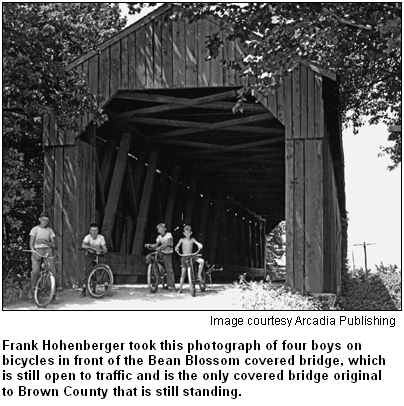 (March 27, 2010) - Has any Hoosier not marveled at the scenic beauty of the southern Indiana county that includes the Hoosier National Forest, the charming towns of Nashville and Story, colonies of artists, and a mountain (or at least a Hoosier hill) of other attractions? With at long last the arrival of spring, Hoosier History Live! explored Brown County in all its wonder.
(March 27, 2010) - Has any Hoosier not marveled at the scenic beauty of the southern Indiana county that includes the Hoosier National Forest, the charming towns of Nashville and Story, colonies of artists, and a mountain (or at least a Hoosier hill) of other attractions? With at long last the arrival of spring, Hoosier History Live! explored Brown County in all its wonder.
Nelson was joined in studio by the co-authors of a new book about the county's rich history. Titled (naturally) Brown County, the visual history book is part of the Arcadia Books "Images of America" series. The co-authors are attorney and historic preservationist Rick Hofstetter, owner of the historic Story Inn, and Jane Ammeson, a travel writer who has put together several other books about southern Indiana. 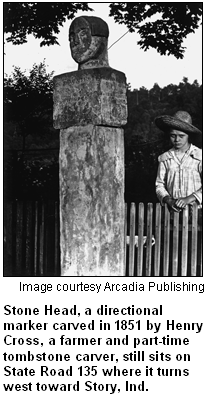 Jane and Rick guide us through the heritage of a once-isolated county that, as they put it, attracted generations of photographers, painters and potters, as well as a mix of lifelong locals, including "hardworking 'hill' people sometimes just eking out a living."
Jane and Rick guide us through the heritage of a once-isolated county that, as they put it, attracted generations of photographers, painters and potters, as well as a mix of lifelong locals, including "hardworking 'hill' people sometimes just eking out a living."
The story of Brown County involves everything and everyone from Abe Martin, the cartoon character who attracted a huge national fan base in the early 1900s, and renowned artist T.C. Steele to covered bridges, ice cream parlors and bed-and-breakfasts. In 1859, the Nashville House was built as the county's first hotel. Although the original structure burned in 1943, the rebuilt Nashville House (located on the same site) is among the county's wildly popular dining spots, known for fried chicken, fried biscuits and apple butter.
Several captivating images in Rick and Jane's book were taken during the early 1900s by renowned photographer Frank Hohenberger. Initially based in Indianapolis, he was inspired to move to Brown County in 1917 after seeing photos of, as Rick and Jane write, "a log cabin, an old water mill and some people who looked to him like Southern mountain folk." His nationally distributed photos were credited with increasing tourism to the area, as did the artwork of painters such as Steele, whose hillside home, the House of the Singing Winds, is now a state historic site. 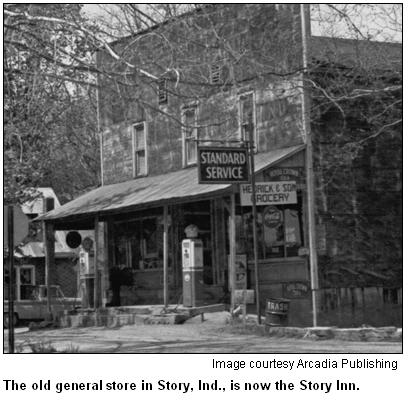 Such attractions along with festivals and events – next up is the Indiana Wine Fair in the town of Story on April 24 – make the county a perpetual destination for visitors.
Such attractions along with festivals and events – next up is the Indiana Wine Fair in the town of Story on April 24 – make the county a perpetual destination for visitors.
Before the boom in Brown County's popularity, though, it actually had been losing population. According to Brown County, the number of residents dropped almost by half between 1890 and 1930, declining from 10,308 to 5,168 "due to poor land management and the Depression." Electricity did not arrive to parts of the county until the late 1940s, and the first automobile didn't appear until 1913, two years after car-crazed Indianapolis already had celebrated the inaugural 500 Mile Race. The county's isolation was among the reasons famed cartoonist Frank "Kin" Hubbard chose it as the home for his bumpkin philosopher creation, Abe Martin. According to Brown County, Hubbard found material by sitting near the potbellied stove in a Brown County hardware store.
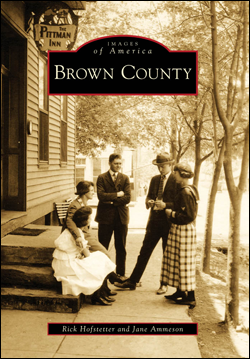 Some fun facts:
Some fun facts:
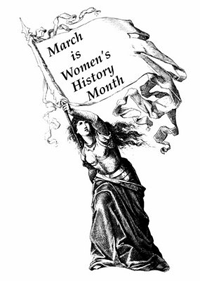 The Hoosier History Trivia Mystery is part of our salute to Women's History Month. In 1999, a "first" for women occurred in the campaign for Indianapolis mayor. A major political party nominated a woman in the race. Although she lost the mayoral election, she previously had made Indiana history by serving as the state's first female secretary of state, from 1994 to 2003.
The Hoosier History Trivia Mystery is part of our salute to Women's History Month. In 1999, a "first" for women occurred in the campaign for Indianapolis mayor. A major political party nominated a woman in the race. Although she lost the mayoral election, she previously had made Indiana history by serving as the state's first female secretary of state, from 1994 to 2003.
Question: Name the first woman to run as a major-party candidate for Indy mayor.
Answer: Sue Anne Gilroy. A Republican, she lost her race for Indianapolis mayor in 1999 to Bart Peterson, a Democrat. Before that, Gilroy had won election to two terms as secretary of state. Her career in politics began with work for her mentor, Richard Lugar, when he was Indianapolis mayor in the 1960s and '70s; eventually, Gilroy became director of the Indianapolis Parks and Recreation Department in the Lugar administration. Today, Gilroy is executive director of the St. Vincent Hospital Foundation.
The prize was a CD of Movers and Stakers, a documentary about the history of the National Road in Indiana, courtesy of producer/director Nancy Carlson of Ball State.
(March 20, 2010) - In a salute to Women's History Month, we explored the life of Caroline Scott Harrison, the wife of President Benjamin Harrison and, so far, the only Hoosier to have served as First Lady. 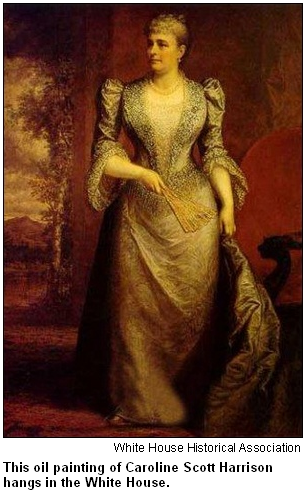 Although many accounts focus on Mrs. Harrison's gentle nature and tragic illness – she died of tuberculosis in the White House in 1892, throwing the country (and her adopted hometown of Indianapolis) into deep mourning – Mrs. Harrison initiated many accomplishments and often stood firmly on principle, sometimes on issues particularly appropriate for exploration during Women's History Month.
Although many accounts focus on Mrs. Harrison's gentle nature and tragic illness – she died of tuberculosis in the White House in 1892, throwing the country (and her adopted hometown of Indianapolis) into deep mourning – Mrs. Harrison initiated many accomplishments and often stood firmly on principle, sometimes on issues particularly appropriate for exploration during Women's History Month.
When the influential Johns Hopkins Medical School asked Mrs. Harrison, as First Lady, to help raise funds, she agreed, with major conditions: She demanded that the medical center begin admitting women students, and do so in the same way men were being admitted. Mrs. Harrison also founded the Daughters of the American Revolution and served as its first president general. An Indianapolis chapter of the DAR is named for her.
Nelson was joined in studio by Jennifer Capps, curator of the President Benjamin Harrison Home. Like her husband, Mrs. Harrison was born in Ohio (in 1832) and became a civic leader after moving to Indianapolis. Talented in the creative arts, she painted with watercolors, played the piano and grew orchids. Along with her husband, Mrs. Harrison became an active member of First Presbyterian Church and taught singing to children in the congregation.
 At the White House, Mrs. Harrison started the china collection that continues to this day. (A stunning, nearly life-sized portrait painting of Mrs. Harrison hangs today near the China Room in the White House as a tribute to her.) She is credited with initiating many improvements to the White House. Mrs. Harrison was convinced it had fallen into neglect; she also knew that the Harrisons' two grown children, grandchildren and her elderly father would be living there with the president and First Lady. Fun fact: The Harrisons apparently were indulgent grandparents. They allowed their grandchildren to keep a rambunctious pet goat named "Whiskers." The goat boarded at the White House horse stables ("Whiskers" posed no threat to presidential decorum; he did not roam around the Oval Office!), but his presence did annoy the groundskeeper.
At the White House, Mrs. Harrison started the china collection that continues to this day. (A stunning, nearly life-sized portrait painting of Mrs. Harrison hangs today near the China Room in the White House as a tribute to her.) She is credited with initiating many improvements to the White House. Mrs. Harrison was convinced it had fallen into neglect; she also knew that the Harrisons' two grown children, grandchildren and her elderly father would be living there with the president and First Lady. Fun fact: The Harrisons apparently were indulgent grandparents. They allowed their grandchildren to keep a rambunctious pet goat named "Whiskers." The goat boarded at the White House horse stables ("Whiskers" posed no threat to presidential decorum; he did not roam around the Oval Office!), but his presence did annoy the groundskeeper.
More significantly, several "firsts" resulted from Mrs. Harrison's vow to improve the White House. 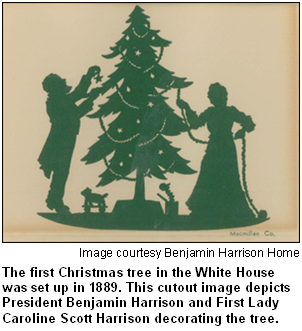 The Harrisons were the first family to live in the White House with electricity, beginning in 1890. They also were the first family to have a decorated Christmas tree on the premises. (Previous generations typically adorned their holiday trees only with candles.)
The Harrisons were the first family to live in the White House with electricity, beginning in 1890. They also were the first family to have a decorated Christmas tree on the premises. (Previous generations typically adorned their holiday trees only with candles.)
As Mrs. Harrison began losing her battle with tuberculosis in 1892, her husband announced he would not take to the campaign trail so he could stay by her side. His opponent, Grover Cleveland, responded by sharply curtailing his campaigning as well. Among the Americans who wrote letters of support and sympathy to the ailing First Lady was a young Helen Keller. (Regular listeners will recall the Helen Keller letter as the subject of a recent History Mystery question.) Mrs. Harrison's death occurred two weeks before her husband lost his bid for re-election. Thousands of Indianapolis residents watched her funeral procession to Crown Hill Cemetery.
Roadtripper Chris Gahl of the ICVA returned to tell us about the opening of the 2010 outdoor season at Conner Prairie on Saturday, March 27.
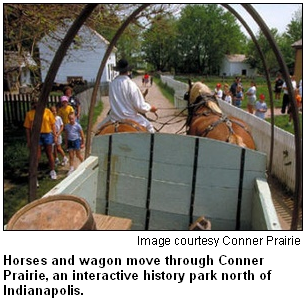 New this season will be "Grandparents Day," happening each Wednesday — special programming for grandparents and grandchildren. Also, each Thursday will feature "Taste the Past," where you can sample authentic foods from Indiana's Prairietown residents.
New this season will be "Grandparents Day," happening each Wednesday — special programming for grandparents and grandchildren. Also, each Thursday will feature "Taste the Past," where you can sample authentic foods from Indiana's Prairietown residents.
Opening Weekend on March 27 and 28 will also feature an "ask the doctor" dialogue between a present-day physician and Prairietown's Dr. Campbell, comparing common medical issues and diseases of 1836 to those of the present day.
And weather permitting, Conner Prairie's 1859 Balloon Voyage will open for its second season on Opening Weekend. So, get outdoors and head to Conner Prairie!
This question was a hold-over from the previous week, when no one called in with the correct answer. So we added another hint!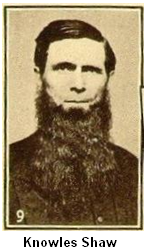
This town lies along the Big Blue River in Indiana, and the popular hymn Bringing in the Sheaves was written there in 1874 by evangelical preacher and composer Knowles Shaw (1834-1878).
The town's state-of-the-art Thompson Mill had a water-funneled turbine in its basement, as opposed to a mill wheel, and provided all of the flour for the Union Army during the Civil War.
More recently, this town's Main Cross Street was the original location of contemporary business The Best Chocolate in Town, owned by Elizabeth Garber, who now has a retail location on Massachusetts Avenue in downtown Indianapolis.
Question: What is the name of the town? The prize was a gift certificate to The Best Chocolate in Town.
Answer: Edinburgh. Knowles Shaw wrote Bringing in the Sheaves in Edinburgh in 1874 while serving as minister of the First Christian Church there. An itinerant evangelical preacher, he also wrote Tarry with Me and a tune used with We Saw Thee Not. He is thought to have baptized (immersed) some 20,000 people, and he is buried in East Hill Cemetery in Rushville.
The Thompson Mill was originally built in 1826, and in 1850 James Thompson erected a larger four-story mill with a water-funneled turbine in its basement, as opposed to the more familiar side mill wheel with water running over it to create power. The Thompson Mill did provide all of the flour for the Union Army during the Civil War.
Fun fact: The Bona Thompson Memorial Center in Irvington is named after a daughter of one of the Thompsons of Edinburgh who moved up to Indianapolis.
Speaking of moving up to the big city of Indianapolis, Elizabeth Garber, originally from Columbus, started her chocolate operation in Edinburgh in 1998. She later moved her business to Franklin and now operates on Massachusetts Avenue in downtown Indianapolis as The Best Chocolate in Town.
(March 13, 2010) - March is Women's History Month, and as Nelson was off in New York City tripping the light fantastic on a well-deserved break, we had a pair of not-so-well-behaved women guest-hosting the show. 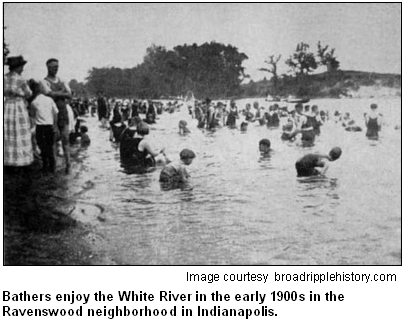 One grew up along the banks of the White River picking up Indian artifacts, and the other is an oft-canoeist of many rivers in Indiana. Per writer Laurel Thatcher Ulrich's words, "well-behaved women seldom make history."
One grew up along the banks of the White River picking up Indian artifacts, and the other is an oft-canoeist of many rivers in Indiana. Per writer Laurel Thatcher Ulrich's words, "well-behaved women seldom make history."
Jim Willaert, guest experience general manager at Conner Prairie, took us on a tour in time down the west fork of the White River in Central Indiana. Bereft of mountains and seashores (although you will incorrectly see mountains in the 1956 movie Friendly Persuasion starring Gary Cooper, set in Indiana during the Civil War), the Wahehani once boasted 12 or more Delaware settlements along the river between what is now 96th Street in Indianapolis and Muncie.
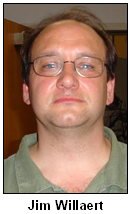 Beyond the Native American connection to the river, Jim took us through the progression of European settlers arriving in flatboats. He told us a bit about the Indiana Mammoth Internal Improvement Act of 1836, which provided for making rivers more navigable, as well as for construction of canals, roads and railroads, but it also nearly drove the state bankrupt. And did you know that much of the proud early citizenry of Indianapolis, from the 1820s right up until after the Civil War, firmly believed that Indianapolis could be a thriving river port? They thought White River could handle steamboat and barge traffic coming up from the Wabash. We heard about a couple of accidents and disasters.
Beyond the Native American connection to the river, Jim took us through the progression of European settlers arriving in flatboats. He told us a bit about the Indiana Mammoth Internal Improvement Act of 1836, which provided for making rivers more navigable, as well as for construction of canals, roads and railroads, but it also nearly drove the state bankrupt. And did you know that much of the proud early citizenry of Indianapolis, from the 1820s right up until after the Civil War, firmly believed that Indianapolis could be a thriving river port? They thought White River could handle steamboat and barge traffic coming up from the Wabash. We heard about a couple of accidents and disasters.
In the early 1900s, resort areas for swimming and boating sprung up along the White River in what is now Broad Ripple and Ravenswood in Indianapolis. The White City Park (now Broad Ripple Park, owned by the city) built the second-largest swimming pool in the country there in 1908. 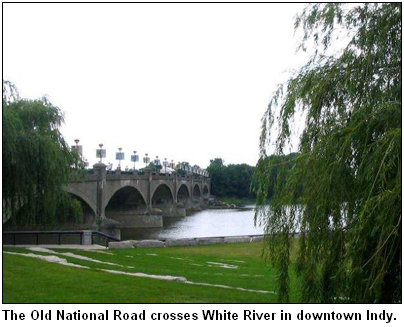 In 1922, the National Swimming Event took place in the Broad Ripple pool, and, in 1924, the Olympic tryouts were there. At this meet, Johnny Weissmuller won the 100-meter freestyle and later went on to win a gold medal at the Olympics.
In 1922, the National Swimming Event took place in the Broad Ripple pool, and, in 1924, the Olympic tryouts were there. At this meet, Johnny Weissmuller won the 100-meter freestyle and later went on to win a gold medal at the Olympics.
More recently, the White River fish kill downstream from Anderson in December of 1999 brought further attention to the need to preserve and protect one of Central Indiana's most precious natural resources, the White River.
Some more White River resources:
As Chris Gahl of the ICVA was deep in Big Ten action, Amy Lamb of the Indiana Historical Society checked in with a special preview of the Indiana Experience, opening to the public on March 20 at the Eugene and Marilyn Glick Indiana History Center. This ongoing interactive and high-tech exhibit allows the IHS to showcase its archival holdings, including 1.6 million photographs, in engaging new ways. This is not your grandfather's history museum exhibit, apparently!
According to Amy, ongoing elements of the Indiana Experience will include:
 (March 6, 2010) - On Good Friday of 1948, the town was devastated by a tornado that flattened almost everything in its path. By that time, the Hendricks County town of Danville for generations had been the home of Central Normal College, which brought prestige to the community. Never heard of it? Unaware that Danville in 1878 "stole" the entire school – including equipment, faculty, students and baggage – from the town of Ladoga?
(March 6, 2010) - On Good Friday of 1948, the town was devastated by a tornado that flattened almost everything in its path. By that time, the Hendricks County town of Danville for generations had been the home of Central Normal College, which brought prestige to the community. Never heard of it? Unaware that Danville in 1878 "stole" the entire school – including equipment, faculty, students and baggage – from the town of Ladoga?
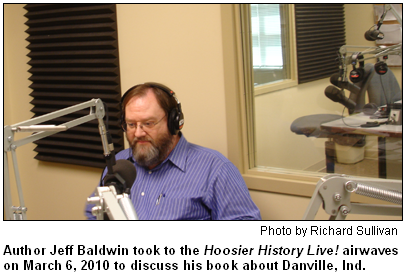 Find out more during this show, one in our rotating series about Indiana towns that already has explored Fort Wayne, Greensburg, Greenfield, Sheridan and many others. Nelson was joined in studio by Danville lawyer and civic leader Jeff Baldwin, the author of Danville, a visual history published in 2009 as part of Arcadia Books' Images of America series. A lifelong resident of the town founded in 1824 as the county seat of Hendricks County, Jeff writes that evidence of the 1948 tornado still is discovered when digging in many yards. "Pieces of tin roof and glass from that day," he says, "are turned up with a shovel." In fact, one caller to the show lived through that day and told of seeing, in the aftermath, a two-story building with one wall completely blown away, yet a lace tablecloth was still in place on a table in a second-floor room, visible from the ground below.
Find out more during this show, one in our rotating series about Indiana towns that already has explored Fort Wayne, Greensburg, Greenfield, Sheridan and many others. Nelson was joined in studio by Danville lawyer and civic leader Jeff Baldwin, the author of Danville, a visual history published in 2009 as part of Arcadia Books' Images of America series. A lifelong resident of the town founded in 1824 as the county seat of Hendricks County, Jeff writes that evidence of the 1948 tornado still is discovered when digging in many yards. "Pieces of tin roof and glass from that day," he says, "are turned up with a shovel." In fact, one caller to the show lived through that day and told of seeing, in the aftermath, a two-story building with one wall completely blown away, yet a lace tablecloth was still in place on a table in a second-floor room, visible from the ground below.
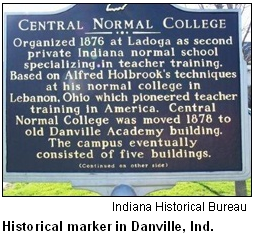 On a more lighthearted topic, Jeff points out that Danville found itself in the national spotlight a few years ago when a mysterious "Danville Turkey" showed up in the middle of Main Street and stopped traffic by strutting back and forth for days. The turkey could not be shot because it was not in season. As a protected animal, it also could not be adopted.
On a more lighthearted topic, Jeff points out that Danville found itself in the national spotlight a few years ago when a mysterious "Danville Turkey" showed up in the middle of Main Street and stopped traffic by strutting back and forth for days. The turkey could not be shot because it was not in season. As a protected animal, it also could not be adopted.
There's much turf to cover as we explore the heritage of the town that once was home to perhaps the heaviest married couple in the country (they toured with P.T. Barnum's circus) as well as an Indiana governor during the 1890s who refused to relocate to Indianapolis and instead took a passenger train daily.
We also explore the impact of Central Normal College, which specialized in training teachers. 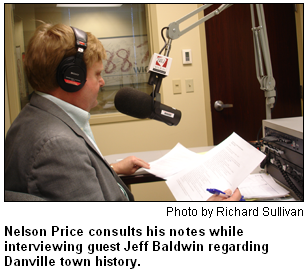 There were no dorms or fraternity houses, so most students roomed with local families. That meant the construction of spacious homes with multiple entrances – and, as Jeff puts it, "a lifestyle that we now would call upscale" for many Danville residents until the college closed in 1951. (At the turn of the last century, Central Normal had trained more teachers than IU, Purdue, and the forerunners of Ball State and Indiana State combined, according to Jeff's book.)
There were no dorms or fraternity houses, so most students roomed with local families. That meant the construction of spacious homes with multiple entrances – and, as Jeff puts it, "a lifestyle that we now would call upscale" for many Danville residents until the college closed in 1951. (At the turn of the last century, Central Normal had trained more teachers than IU, Purdue, and the forerunners of Ball State and Indiana State combined, according to Jeff's book.)
And then there's the Mayberry Cafe, a diner in Danville that pays tribute to the classic TV series The Andy Griffith Show. A popular tourist destination, the cafe is easy to find. Just look for the unattended squad car parked nearby.
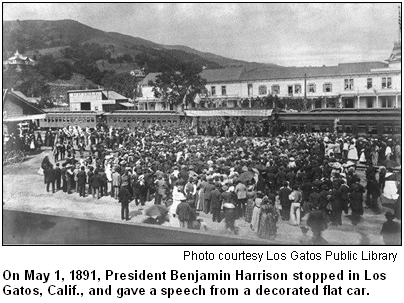 Chris Gahl of the ICVA says "All aboard! Make tracks with the presidential train!" He called to suggest that we head to the President Benjamin Harrison Home on March 23 to participate in Benjamin Harrison Day.
Chris Gahl of the ICVA says "All aboard! Make tracks with the presidential train!" He called to suggest that we head to the President Benjamin Harrison Home on March 23 to participate in Benjamin Harrison Day.
Harrison was our centennial president, inaugurated 100 years after George Washington. It's timely to visit, as the home is also hosting a unique exhibit chronicling presidential travel by rail, including the journeys of Presidents Lincoln, Garfield, Hayes, McKinley and Theodore Roosevelt. In addition, the exhibit includes many items from the hundreds of gifts presented to Benjamin Harrison's party when making its 10,000-mile train trip in 1891 to the West Coast.
One of Indiana's best-known contemporary authors grew up in Danville and continues to live there today. The author, a Quaker minister, writes nationally distributed books that include a series of folksy, humorous vignettes set in the fictional town of Harmony; it is quite similar to Danville. In addition, the author also writes theological books and is a popular speaker across the country.
Question: Name the contemporary author based in Danville.
Answer: Phil Gulley. He is the author of Front Porch Tales, Hometown Tales, Porch Talk and other popular books that have won him praise as a modern voice for small-town American life. Gulley, who grew up in Danville, continues to live in his hometown with his wife and two sons. He is the pastor of a Quaker meeting house in Camby and has written several theological books, including If Grace is True. He also writes a humor column for Indianapolis Monthly magazine. He will be featured with the Encore Vocal Arts chorus in a concert at 8 p.m. on Saturday, March 6, called “Poems & Parables” at Meridian Street United Methodist Church in Indianapolis.
The prize was a pair of tickets to the President Benjamin Harrison Home, courtesy of the President Harrison Home.
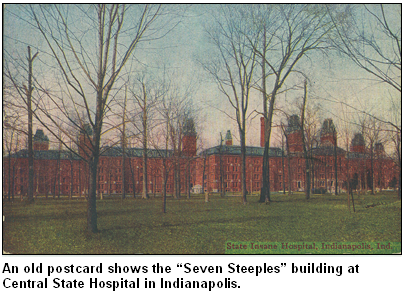 (Feb. 27, 2010) - It opened as the Indiana Hospital for the Insane in 1848 as the state's first psychiatric hospital. The final chapter on what became known as Central State Hospital is scheduled to come later this year when most of its remaining buildings (located just west of downtown Indianapolis) are to be demolished.
(Feb. 27, 2010) - It opened as the Indiana Hospital for the Insane in 1848 as the state's first psychiatric hospital. The final chapter on what became known as Central State Hospital is scheduled to come later this year when most of its remaining buildings (located just west of downtown Indianapolis) are to be demolished.
The hospital on West Washington Street housed more than 3,000 patients in 1928 when its name was changed to Central State. But it closed in 1994, and some of its most distinctive structures – including a stately, Victorian-era building often referred to as the "Seven Steeples" – were declared unsound and torn down clear back in the late 1970s.
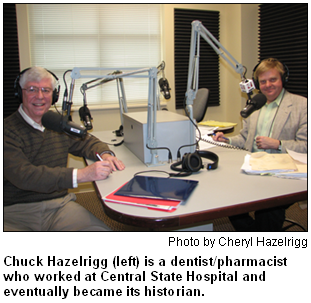 To guide us through the dramatic history of the institution that became known to generations of Hoosiers as simply "Central State," Nelson is joined in studio by Chuck Hazelrigg, a dentist and pharmacist who worked at Central State for 15 years beginning in 1970.
To guide us through the dramatic history of the institution that became known to generations of Hoosiers as simply "Central State," Nelson is joined in studio by Chuck Hazelrigg, a dentist and pharmacist who worked at Central State for 15 years beginning in 1970.
Eventually, Chuck became director of Central State's medical support services, supervising everything from radiology to security and the children's wards. He also became fascinated with Central State's history, conducted a range of interviews with former patients and employees, and is regarded as its historian. (Today he teaches at the IU School of Dentistry and serves as vice president of the Carmel Clay Historical Society.)
 During the show, Chuck shares insights about the history of buildings, including the original structure (which eventually became known as the "men’s building"), the women's building and what was known as the Sick Hospital. Central State’s pathology building now houses the Indiana Medical History Museum.
During the show, Chuck shares insights about the history of buildings, including the original structure (which eventually became known as the "men’s building"), the women's building and what was known as the Sick Hospital. Central State’s pathology building now houses the Indiana Medical History Museum.
In 2004, the city of Indianapolis took possession of the other former hospital buildings after purchasing the site from the state for $400,000. The city is exploring the possibilities for development such as commercial, residential or mixed uses.
Some facts:
Although not truly a Hoosier, one of the most famous and influential psychologists of the 20th century lived in Bloomington during the 1940s. 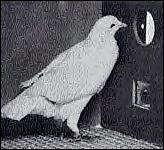 This person chaired the psychology department at Indiana University for several years during and after World War II and recruited several like-minded psychologists and researchers to join the faculty. This psychologist also conducted behavioral experiments with pigeons and rats while in the Hoosier state. In 1948, this psychologist left IU to teach at Harvard University.
This person chaired the psychology department at Indiana University for several years during and after World War II and recruited several like-minded psychologists and researchers to join the faculty. This psychologist also conducted behavioral experiments with pigeons and rats while in the Hoosier state. In 1948, this psychologist left IU to teach at Harvard University.
Question: Name the influential psychologist.
Answer: B.F. Skinner. Considered a “radical behaviorist,” B.F. Skinner became famous for developing the theory of “operant conditioning” – that is, that behavior is determined by consequences such as rewards and punishments. He worked extensively in laboratories with rats and pigeons, including during his stint on the IU campus in the 1940s. Skinner, who was born in Pennsylvania in 1904, spent most of his career at Harvard. After writing influential books such as Walden Two (1948) and Beyond Freedom and Dignity (1971), he died in Cambridge, Mass., in 1990.
The prize was a CD of Movers and Stakers, a documentary about the history of the National Road in Indiana, courtesy of producer/director Nancy Carlson of Ball State.
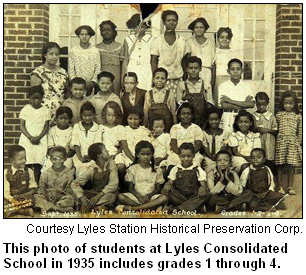 (Feb. 20, 2010) - As Hoosier History Live! saluted Black History Month, we explored the waves of African-American migration here, which began even before Indiana became a state in 1816. Nelson was joined in studio by Wilma Moore, senior archivist for African-American history at the Indiana Historical Society. She shared details about the settlements that began, sometimes initially by freed slaves, during the pioneer era up through World War I.
(Feb. 20, 2010) - As Hoosier History Live! saluted Black History Month, we explored the waves of African-American migration here, which began even before Indiana became a state in 1816. Nelson was joined in studio by Wilma Moore, senior archivist for African-American history at the Indiana Historical Society. She shared details about the settlements that began, sometimes initially by freed slaves, during the pioneer era up through World War I.
From the beginning, many blacks who came here encountered challenges and restrictions. A state law in 1831, for example, required blacks settling in Indiana to register with county authorities and pay a bond to guarantee good behavior. Even so, African-Americans chose to settle in Indiana during the early 1800s – and even before. According to an article that Wilma recently wrote for Traces, the Historical Society's magazine, some blacks settled with the French in the mid- to late 1700s in the area that eventually became Knox County.
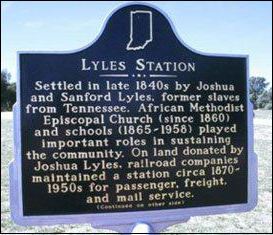 Early communities of African Americans in the 1800s included the Roberts settlement in Hamilton County, Lyles Station in Gibson County and the Beech settlement in Rush County. Many of the black communities were located near Quaker settlements. In northern Indiana, one of the first rural black settlements was initiated in St. Joseph County by Samuel Huggart, a free African-American from Ohio. Huggart was able to buy property beginning in the 1830s, according to a recent story in The Indianapolis Star.
Early communities of African Americans in the 1800s included the Roberts settlement in Hamilton County, Lyles Station in Gibson County and the Beech settlement in Rush County. Many of the black communities were located near Quaker settlements. In northern Indiana, one of the first rural black settlements was initiated in St. Joseph County by Samuel Huggart, a free African-American from Ohio. Huggart was able to buy property beginning in the 1830s, according to a recent story in The Indianapolis Star.
Some insights from Wilma’s article in Traces:
Incidentally, here is the study guide for the 2010 Indiana Black History Challenge, courtesy of the Indiana Historical Society. What’s your score?
African-American resort community in northern Indiana
Beginning in the 1930s, African-American families built cottages in northern Indiana to create a resort community. They had been prohibited from purchasing vacation homes at resort communities on lakes elsewhere in northern Indiana. 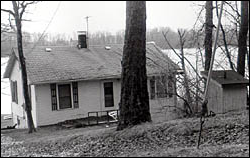 The resulting community became a popular summer destination for black families from Indianapolis, Fort Wayne and other Indiana cities, as well as families who lived in Michigan, Ohio and Illinois.
The resulting community became a popular summer destination for black families from Indianapolis, Fort Wayne and other Indiana cities, as well as families who lived in Michigan, Ohio and Illinois.
Question: Name the historic African-American resort community in northern Indiana. Hint: It was the focus of a Hoosier History Live! show last year. At right is a picture of one of its rustic cottages.
Answer: Fox Lake. By World War II, more than 30 cottages had been built in the resort community, which is in Steuben County in far-northeastern Indiana. Among the few communities of its kind in the nation, Fox Lake featured recreational opportunities for families such as swimming, dancing, basketball and tennis, as well as Sunday religious services. Fox Lake, which is now integrated, continues to thrive today.
The prize was a pair of tickets to the Indiana State Museum, as well as a couple of day passes to Climb Time Indy Indoor Rock Climbing, courtesy of the ICVA.
In search of Indiana authors
Chris Gahl of the ICVA called in with a tip about how the Indianapolis-Marion County Public Library Foundation is asking the public to help find the next Kurt Vonnegut or Booth Tarkington. As part of the Eugene & Marilyn Glick Indiana Authors Award, the foundation is canvassing the community to recognize the contributions of Indiana authors to the literary landscape.  The deadline to nominate is March 26, with a panel selecting a national and regional winner, as well as an emerging author. Any published writer who was born in Indiana or has lived in Indiana for at least five years is eligible for nomination.
The deadline to nominate is March 26, with a panel selecting a national and regional winner, as well as an emerging author. Any published writer who was born in Indiana or has lived in Indiana for at least five years is eligible for nomination.
Winning authors will each receive up to $10,000 and will be able to designate their hometown Indiana public library as a recipient of an additional $2,500 grant. This is a public nomination process. See the Indiana Authors Award website for the full scoop.
A historic event!
Our Hoosier History Live! Second Anniversary Soiree on Feb. 18, 2010, was a successful event. Dozens of our audience members, on-air guests and show sponsors attended at the historic Morris-Butler House at 1204 N. Park Ave. in Indianapolis for birthday cake and cupcakes, History Mystery questions with prizes, and a demo of our new website with an ever-growing audio library. Thanks to Historic Landmarks Foundation of Indiana for hosting.
(Feb. 13, 2010) - To help cure a family member struggling with a disorder, would you serve a delicacy known as fried mice pie? Believe it or not, that was a treatment suggested to pioneers in the Old Northwest Territory, including early Indiana.
To find out what disorder the repulsive-sounding pie was supposed to cure, you'll have to listen to the show. Nelson was joined in studio by Hoosier storyteller Sue Grizzell, who has extensively researched medical "treatments" practiced during the late 1700s and early 1800s, often using archives at the Indiana Historical Society.
In fact, the IHS and Storytelling Arts Indiana recently commissioned Sue to put together a presentation she titled "Root Doctors, Midwives and Fried Mice Pie: Medicine in Early Indiana." She has uncovered the story of a so-called "root doctor" who was run out of early Connersville, for example.
According to Sue, many of the bizarre or crude early folk remedies were the result of desperation on the frontier. "Early Hoosiers only occasionally had access to doctors. ... They mostly lived in isolation, faced economic uncertainty and practiced self-sufficiency as much as possible."
A lifelong storyteller, Sue has collaborated with the Indianapolis Symphony Orchestra on various projects; in 2002, her story "Porch Swings and Prairie Wings" became part of the "Sharing Hoosier History Through Stories" series.  You won't want to miss this fascinating show, during which Sue will explain how our ancestors dealt with ailments and terrifying illnesses such as malaria and cholera.
You won't want to miss this fascinating show, during which Sue will explain how our ancestors dealt with ailments and terrifying illnesses such as malaria and cholera.
"Whether ill or injured, the inhabitants of the Old Northwest Territory and early Indiana were subjected to all manner of medical treatments," Sue says. "Ranging from the common-sensical to the bizarre, these treatments sometimes worked but could often be fatal."
She notes that Thomas Jefferson once remarked, referring to doctors during his era, that they "let loose upon the world, destroy more human life in one year than all the ... Cartouches (a murderous French bandit) and Macbeths do in a century."
Families on the Indiana frontier typically ended up doing most of their own doctoring because contact with physicians was infrequent, Sue says. Hence, the popularity of folk remedies. She points out that, although pioneers had as many challenges surviving some of the "cures" as they did the initial illnesses, "modern science has proven some folk remedies effective." All of this was fodder for a show that was as intriguing as Sue’s popular, fact-based storytelling presentation about fried mice pie and root doctors.
Her next public presentation is scheduled for March 25 at the Marion Public Library.
Sweet treats in Fort Wayne
Chris Gahl of the ICVA suggested a sweet Roadtrip to Fort Wayne. The Chocolate Tour at Fort Wayne-based DeBrand Fine Chocolates is a perfect getaway for chocolate lovers during February, the month of romance.
Founded in 1987 by artisan chocolatier Cathy Brand, this Indiana company has grown significantly since its humble beginnings in Cathy's family's century-old home and now employs nearly 100 people with its four retail shops. Public tours of the chocolate maker take roughly one hour and include touring three chocolate kitchens and, of course, samples of their confections!
Orthopedic manufacturing, starting in the 1890s
Beginning in the 1890s, the manufacturing of orthopedic devices began in a small Indiana city. 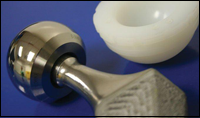 Eventually, several orthopedic businesses and suppliers were founded in – or chose to move to – the city, including the manufacturers of artificial hips. They have had a huge, historic impact on the local economy of the Hoosier city, which has a population of about 13,000 people.
Eventually, several orthopedic businesses and suppliers were founded in – or chose to move to – the city, including the manufacturers of artificial hips. They have had a huge, historic impact on the local economy of the Hoosier city, which has a population of about 13,000 people.
Question: Name the Indiana city.
Answer: Warsaw. Its nickname is "Orthopedic Capital of the World." Located near lakes in north central Indiana, Warsaw is in Kosciusko County. In 1895, the first orthopedic manufacturer – what became known as DePuy Manufacturing Company – began in the city. In the decades after that, competitors and related businesses, including Zimmer Inc. and Biomet, were founded in Warsaw or moved there.
The prize was a pair of tickets to the President Benjamin Harrison Home, as well as a couple of free slots coupons for Indiana Live Casino, courtesy of the ICVA.
(Feb. 6, 2010) - With our rotating series about town histories, we typically don’t focus exclusively on a single decade. This show is an exception because Nelson’s guest – Tom Roznowski, a musician and radio personality – has spent years researching a new book with an unusual format that’s as much a social history of American life in the 1920s as it is a close-up look at Terre Haute.
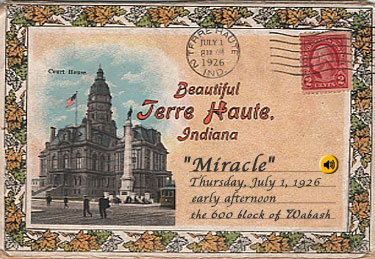 Written in the form of an old-fashioned city directory – and using Terre Haute’s 1927 Polk Directory as a starting point – An American Hometown: Terre Haute, Indiana 1927 (Indiana University Press) examines the city on the Wabash River that in 1927 had 400 grocery stores, three daily newspapers, speakeasies, cigar stores and a self-sufficiency that meant, as Tom puts it, more than 40 percent of the food consumed came from area farms.
Written in the form of an old-fashioned city directory – and using Terre Haute’s 1927 Polk Directory as a starting point – An American Hometown: Terre Haute, Indiana 1927 (Indiana University Press) examines the city on the Wabash River that in 1927 had 400 grocery stores, three daily newspapers, speakeasies, cigar stores and a self-sufficiency that meant, as Tom puts it, more than 40 percent of the food consumed came from area farms.
He also notes most music was heard live, with four theaters in Terre Haute maintaining house orchestras in 1927, upright pianos in most living rooms, 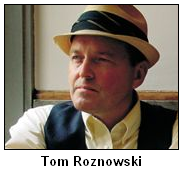 and radio sets just beginning to “pre-empt” entertainment. Through vignettes of individual residents’ stories – ranging from a local teacher and a fashion editor to a boxer, a chicken plucker and an inn keep – his book also depicts disturbing aspects of Terre Haute life in 1927. Those include the segregation of blacks into a neighborhood derisively called “Baghdad” and the disdain for destitute residents of an institution known as the County Poor Farm in an era before Social Security and worker’s comp.
and radio sets just beginning to “pre-empt” entertainment. Through vignettes of individual residents’ stories – ranging from a local teacher and a fashion editor to a boxer, a chicken plucker and an inn keep – his book also depicts disturbing aspects of Terre Haute life in 1927. Those include the segregation of blacks into a neighborhood derisively called “Baghdad” and the disdain for destitute residents of an institution known as the County Poor Farm in an era before Social Security and worker’s comp.
Although Tom is based in Bloomington, where he hosts a radio show on WFIU-FM, he long ago began immersing himself in Terre Haute of the 1920s, an era when the country was, as he puts it, “completing the transition of a rural nation into an urbanized one.” Many of the social changes are reflected in the vignettes captured in his book. Observations and insights from An American Hometown: Terre Haute, Indiana 1927 include:
Roadtripper Chris Gahl of the ICVA called in from the Super Bowl action in Miami and suggested the best fan gathering spots for listeners for Sunday night’s game. Of course, we expect to see our Indianapolis Colts make Hoosier History! again with a second Super Bowl win!
Speaking of the Colts, did you know that the Hoosier History Live! audio library includes an interview with Mark Herrmann, currently of the NCAA, who played quarterback for the Colts in both Baltimore and Indianapolis? This show aired 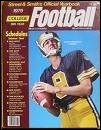 originally on Feb. 2, 2008, and Mark talked about Colts history in Indianapolis, and the history of the RCA (formerly Hoosier) Dome. This show aired while the RCA Dome was still standing, and before the construction of Lucas Oil Stadium.
originally on Feb. 2, 2008, and Mark talked about Colts history in Indianapolis, and the history of the RCA (formerly Hoosier) Dome. This show aired while the RCA Dome was still standing, and before the construction of Lucas Oil Stadium.
Wouldn’t you like to be able to hear the Mark Herrmann show on the Hoosier History Live! website? Friends, remember the we are an independently produced show and are self-supporting through sponsorships and individual contributions. For a small sponsorship amount, you can sponsor the podcast of the Mark Herrmann show, or any other show, on our website, and you’ll get a credit on the podcast. For details, contact Molly Head, or see the "Support us" page.
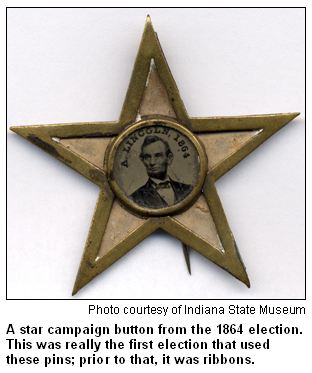 (Jan. 30, 2010) - We don’t stretch historic truths, particularly if "Honest Abe" is involved. So it’s no overstatement to predict an upcoming unveiling of the Lincoln treasures newly acquired by the Indiana State Museum – paired with a traveling display of Lincoln artifacts from the Library of Congress – will be the blockbuster exhibit of 2010 in the Hoosier state. On top of all that, “sister” institutions across Indiana are lending rare Lincoln artifacts to the state museum.
(Jan. 30, 2010) - We don’t stretch historic truths, particularly if "Honest Abe" is involved. So it’s no overstatement to predict an upcoming unveiling of the Lincoln treasures newly acquired by the Indiana State Museum – paired with a traveling display of Lincoln artifacts from the Library of Congress – will be the blockbuster exhibit of 2010 in the Hoosier state. On top of all that, “sister” institutions across Indiana are lending rare Lincoln artifacts to the state museum.
Where else are you going to see the Bible on which President Lincoln (and, just last year, Barack Obama) took the oath of office? Our guest will be the Hoosier expert who has been immersed in all things Lincoln ever since the announcement that the $20 million collection of the now-closed Lincoln Museum in Fort Wayne would remain in the Hoosier state, where Lincoln lived from ages 7 to 21. 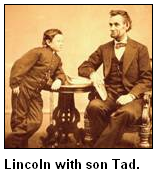 Dale Ogden, chief curator of cultural history at the state museum, has been burning the midnight oil to set up the exhibit called With Charity for All: The Lincoln Financial Foundation Collection, which opens Feb. 12 along with the Library of Congress' traveling exhibit.
Dale Ogden, chief curator of cultural history at the state museum, has been burning the midnight oil to set up the exhibit called With Charity for All: The Lincoln Financial Foundation Collection, which opens Feb. 12 along with the Library of Congress' traveling exhibit.
Dale shared folklore about – and guided us through – the trove, which includes a handwritten copy of Lincoln’s second inaugural address that "the Great Emancipator" delivered in March 1865, the last portrait Lincoln sat for and rare signed copies of the Emancipation Proclamation. Dale and his crew even have arranged for famous Hoosiers, ranging from NASCAR driver Tony Stewart and WNBA star Tamika Catchings to astronaut David Wolf, to cut videos for a Lincoln trivia kiosk.
Some other gems that will be displayed:
Dale’s visit to Hoosier History Live! comes on the heels of the announcement that $7 million has been raised in just six months to care for the state museum’s large collection of Lincoln artifacts. Part of the collection from the former Lincoln Museum in Fort Wayne will be housed at the Allen County Public Library.The state museum and the library became the recipients of the collection after officials of Philadelphia-based Lincoln Financial Corporation, which had been headquartered in Fort Wayne, announced in spring 2008 that they would end their support of the Lincoln Museum. (The museum had been started decades ago by a top executive of Lincoln Financial, then known as Lincoln Life, who amassed a vast collection of artifacts.) 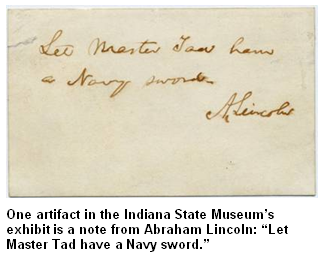 The decision to close the museum, as Dale notes, "put into play a collection of historic proportions."
The decision to close the museum, as Dale notes, "put into play a collection of historic proportions."
After nine months during which experts worried that the artifacts might be dispersed to private collectors across the country – and during which the Smithsonian in Washington D.C. and other esteemed institutions expressed interest in acquiring them – the resolution was announced last December that the collection would remain in Indiana. That’s when Dale began burning the midnight oil – as well as traveling to D.C. to view the historic Bible ("It took my breath away," he says) and other artifacts at the Library of Congress. The display of the Library of Congress artifacts is being titled With Malice Toward None at the state museum.
There’s info about With Charity for All and With Malice Toward None, which will be a timed-ticket exhibit, at www.indianamuseum.org.
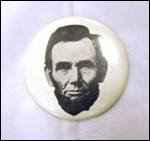 In February 1861, President-elect Abraham Lincoln traveled through Indianapolis en route from Illinois to Washington D.C. for his inauguration. During his stay in the Hoosier capital, the president-elect delivered a speech that made national news. Lincoln made the speech to thousands of Hoosiers from the balcony of a hotel in downtown Indianapolis. The hotel, located on the corner of Washington and Illinois streets, was demolished in 1901.
In February 1861, President-elect Abraham Lincoln traveled through Indianapolis en route from Illinois to Washington D.C. for his inauguration. During his stay in the Hoosier capital, the president-elect delivered a speech that made national news. Lincoln made the speech to thousands of Hoosiers from the balcony of a hotel in downtown Indianapolis. The hotel, located on the corner of Washington and Illinois streets, was demolished in 1901.
Question: Name the historic hotel.
The prize was a gift certificate to Chancellor's Restaurant at the University Place Conference Center, part of the Devour Downtown showcase of food and drink.
Roadtripper Chris Gahl of the ICVA gave us a complete report about Devour Downtown Winterfest, running through Feb. 6. More than 40 downtown restaurants are offering three-course meals for $30.
(Jan. 23, 2010) - The Vancouver Winter Olympics will kick off in February of 2010, and who better to explore Winter Olympians with Indiana connections than the brother-and-sister figure-skating duo who became the most famous of that illustrious group, even though they didn’t win a medal? Wayne and Kim Seybold certainly put their hometown of Marion in the national spotlight with their quest to compete in the 1988 Calgary Olympics, a story that involved hard luck, family sacrifices, a town that rallied to support them, and overwhelming health crises that persisted long after their heyday as Olympians.
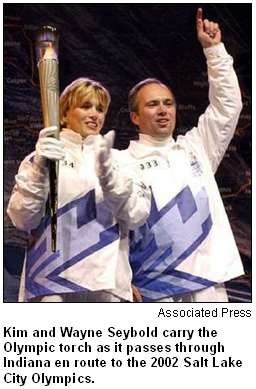 Fans of the Seybolds will recall many of the basics, including how their family lived for years in a trailer park so their devoted parents could save money for coaches, costumes and travel expenses for Wayne and Kim as they made long daily commutes across the state for lessons. Then there were the three scares with brain tumors for Kim (officially known as Natalie, her given name); she learned of the second health crisis the day after Wayne and Kim carried the Olympic torch in Indiana as the flame passed through en route to the 2002 Salt Lake City Olympics.
Fans of the Seybolds will recall many of the basics, including how their family lived for years in a trailer park so their devoted parents could save money for coaches, costumes and travel expenses for Wayne and Kim as they made long daily commutes across the state for lessons. Then there were the three scares with brain tumors for Kim (officially known as Natalie, her given name); she learned of the second health crisis the day after Wayne and Kim carried the Olympic torch in Indiana as the flame passed through en route to the 2002 Salt Lake City Olympics.
Beginning more than 22 years ago when the Seybolds were pursing their Olympic dream - and continuing through their post-Calgary career as touring professionals in shows with ice skating’s top names - Nelson covered their story for the Indianapolis Star and News. (Wayne and Kim are featured in his books about famous Hoosiers.)
And today? Wayne is mayor of Marion, where the Seybolds remain hometown heroes. Kim lives in the Fishers area, coaches at the Carmel Ice Skadium, married a former hockey player and is the mother of two young daughters. (The youngest was just a few months old when her mother was diagnosed with the second brain tumor.)
Known for their warm personalities, the Seybolds joined Nelson not only to explore the joys and struggles intertwined with their personal Olympic story, but also to share details about other Hoosiers who have competed in previous Winter Olympics. Granted, there have not been many – in fact, fewer than a dozen since the debut of the Olympic Winter Games in 1924. It’s not as though mountains, luge and bobsled runs, and speedskating coaches are plentiful in Indiana.
 Even top-level figure skating arenas and coaches were not abundant here when Wayne and Kim (who are 46 and 44. respectively) began chasing their dream as kids. Not only did the Seybolds live in a trailer during most of their years of training, they received donations from residents and businesses of Marion (think bake sales and car washes), which put their hometown in the spotlight during ABC Sports coverage of the 1988 Calgary Olympics.
Even top-level figure skating arenas and coaches were not abundant here when Wayne and Kim (who are 46 and 44. respectively) began chasing their dream as kids. Not only did the Seybolds live in a trailer during most of their years of training, they received donations from residents and businesses of Marion (think bake sales and car washes), which put their hometown in the spotlight during ABC Sports coverage of the 1988 Calgary Olympics.
The Marion High School graduates finished 10th in pairs skating, a result that drew criticism of the judging from many analysts (not just Hoosier fans of the brother and sister), but their popularity was such that Wayne and Kim were able to carve out careers as professional skaters in touring shows for several years before returning to Indiana. Campaigning as a Republican, Wayne was elected mayor of Marion in 2003 and has kept up a jammed itinerary of overseas trips as he courts jobs to replace those lost to economic downturns.
While the Seybolds were still touring as skaters – and performing a routine known as the “death spiral” in which Wayne swung Kim inches above the ice – she began experiencing spells of dizziness and blurred vision. After being diagnosed with the type of brain tumor that may reoccur throughout her life, Kim underwent her first surgery – which involved temporarily removing an eye so the surgeons could extract the tumor – in 1995. She eventually married former pro hockey player Mark Catron (Wayne’s former roommate) and began coaching. The need for a second surgery was discovered in January 2002, the day after Wayne and Kim served as Olympic torchbearers in a ceremony on Monument Circle. That surgery, which went well, occurred 14 years to the day after Wayne and Kim, now known as Kim Seybold-Catron, performed their short program in Calgary. Kim underwent brain surgery for the third time in May 2007.
Others with Hoosier roots who have competed in the Winter Olympics include:
A national Hall of Fame that has nothing to do with sports is located in Marion, Indiana. This Hall of Fame is in a Colonial Revival house and celebrates a domestic art.
Question: Name the Hall of Fame.
The call-in number for the correct answer is (317) 788-3314. The prize was a pair of tickets to the Eiteljorg Museum.
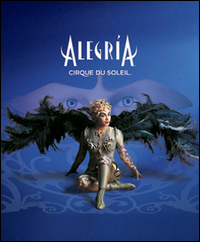 Roadtripper
RoadtripperAccording to Roadtripper Chris Gahl of the ICVA, the internationally renowned performing group Cirque du Soleil is coming to Indy February 11 to 14, performing seven shows entitled Alegria at Conseco Fieldhouse. From a group of 20 street performers in 1984 Quebec, the group has grown to a major performing-arts troupe with more than 1,000 performing artists. If you enjoy live theater, live music and the circus on steroids, Cirque du Soleil at Conseco Fieldhouse is a Roadtrip you won’t want to miss.
 (Jan. 16, 2010) - On the heels of our 100th show, the sport intertwined with Indiana culture is about to celebrate a centennial. The high school basketball season will culminate with the 100th state tournament, the perfect opportunity for Hoosier History Live! to explore the chaotic and colorful early years of hoops here. With the "100 Years in 100 Days" celebration of Hoosier Hysteria under way – it will culminate with a parade in downtown Indy in March – Nelson was joined in studio by Chris May, executive director of the Indiana Basketball Hall of Fame in New Castle, and a Hall of Famer: Ralph Taylor, an outstanding player for Washington High School's state champion team of 1965. (Ralph went on to star at Purdue, leading the Boilermakers to a Big Ten championship in 1969.)
(Jan. 16, 2010) - On the heels of our 100th show, the sport intertwined with Indiana culture is about to celebrate a centennial. The high school basketball season will culminate with the 100th state tournament, the perfect opportunity for Hoosier History Live! to explore the chaotic and colorful early years of hoops here. With the "100 Years in 100 Days" celebration of Hoosier Hysteria under way – it will culminate with a parade in downtown Indy in March – Nelson was joined in studio by Chris May, executive director of the Indiana Basketball Hall of Fame in New Castle, and a Hall of Famer: Ralph Taylor, an outstanding player for Washington High School's state champion team of 1965. (Ralph went on to star at Purdue, leading the Boilermakers to a Big Ten championship in 1969.)
Ralph, Chris and Nelson explored the first basketball game ever played in Indiana. (The game in 1894, the subject of one of our History Mystery questions a while back, was played at the Crawfordsville YMCA.) We also explored the tumultuous early days of the state tournament. The first, in 1911, came down to arch-rival teams from Crawfordsville and Lebanon. According to some accounts, the Crawfordsville players were in agony during the first half because of sabotage. In the locker room, they discovered their jock straps had been saturated with Dr. Sloan’s Liniment. Perhaps motivated by righteous anger, the Crawfordsville roared ahead in the second half to win, 24-17.
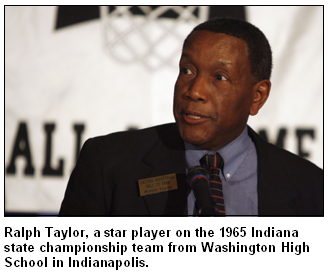 Hoops enthusiasts know basketball wasn’t invented by a Hoosier. That distinction goes to Dr. James Naismith of Massachusetts, a medical doctor and minister who used peach baskets when he set up (and drafted early rules for) a game he called "Basket Ball" at a YMCA where he was a youth instructor. Even Naismith, though, identified the Hoosier state as ideal for the sport; when he visited Indiana to attend the 1925 high school tournament, he is said to have marveled at how his "little wintertime diversion had gripped an entire state," according to an Indianapolis Star account.
Hoops enthusiasts know basketball wasn’t invented by a Hoosier. That distinction goes to Dr. James Naismith of Massachusetts, a medical doctor and minister who used peach baskets when he set up (and drafted early rules for) a game he called "Basket Ball" at a YMCA where he was a youth instructor. Even Naismith, though, identified the Hoosier state as ideal for the sport; when he visited Indiana to attend the 1925 high school tournament, he is said to have marveled at how his "little wintertime diversion had gripped an entire state," according to an Indianapolis Star account.
The on-court dramas that have ensued since then at the state tournament have become Hoosier folklore. We easily could devote entire shows to the "Milan Miracle" of 1954 in which tiny Milan High School slew "Goliath" (Muncie Central), an astonishing upset that inspired the classic movie Hoosiers (1986). Or to the back-to-back triumphs in 1955 and '56 by Oscar Robertson and his teammates at Attucks High School, the first all African-American (and first Indianapolis) team to capture the state title.
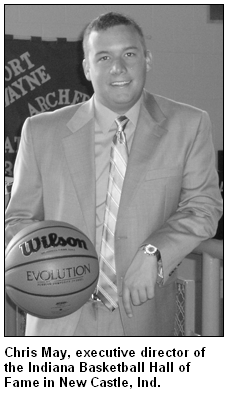 During those Attucks victories, Ralph, our guest, was a young boy who idolized the state champs and dreamed of one day following in their sneakers. Ralph, Chris and Nelson shared details of the "100 Years in 100 Days" hoopla, which will involve a traveling exhibit – put together with the help of the Basketball Hall of Fame – that will visit high schools and towns across Indiana. The centennial celebrations are being organized by the Indiana High School Athletic Association.
During those Attucks victories, Ralph, our guest, was a young boy who idolized the state champs and dreamed of one day following in their sneakers. Ralph, Chris and Nelson shared details of the "100 Years in 100 Days" hoopla, which will involve a traveling exhibit – put together with the help of the Basketball Hall of Fame – that will visit high schools and towns across Indiana. The centennial celebrations are being organized by the Indiana High School Athletic Association.
Today, Ralph is an Indy-based international resource adviser and president of the Hall of Fame's board. Chris, a former radio sportscaster, was not on the team during his days at Rushville High School; at 5-feet-6, he has found other ways to be immersed in the sport he loves. Nelson asked his guests about the sense among some that the "golden age" of the state tournament happened about 50 years ago – and that enthusiasm has fallen dramatically because of several factors, including "class" basketball. According to Hoosiers All author Emerson Houck, the guest on our show in August 2009, in 1938 there were 787 schools entered in a single-class championship, the largest entry list ever. Today, there are slightly more than 400 high schools entered in what has become a four-class tournament. No less a legendary figure than former coach Johnny Wooden (who was a star player at Martinsville High School in the 1920s) has called class basketball "a crime against culture."
Other fun facts:
For most of basketball’s early history, the balls were muddy brown in color. A famous Hoosier is credited with suggesting orange as an ideal color for a basketball.
Question: Name the famous Hoosier.
Answer: Tony Hinkle, the legendary multi-sport coach at Butler University. He's credited in the 1950s with advocating an orange basketball so that it would be more visible to players and spectators. Born on a farm near Logansport in 1898, Hinkle came to Butler in the early 1920s and was a coach or teacher there for nearly 50 years. He took Butler's basketball team to a national championship in 1929, and he also coached football and baseball. He died in 1992, more than 20 years after the athletic fieldhouse on campus had been renamed in his honor.
The prize was a pair of tickets to the Indianapolis Symphony Orchestra concert, featuring the music of Mozart, on Saturday, Feb. 20, courtesy of the ICVA. The station requests that you not try to call in to win if you have won a prize on any WICR program within the last two months. Of course, we always do welcome general questions for the show!
Our intrepid Roadtripper correspondent, Chris Gahl of the ICVA, shared details about two upcoming winter festivals. Chris gave us the scoop on the 15th annual Winter Antique Show in Huntingburg, as well as the Chocolate Lover’s Weekend in French Lick.
(Jan. 9, 2010) - For our 100th show, wouldn't you expect something special from Hoosier History Live? Well-known artist K.P. Singh joined Nelson in studio for a show in our rotating series about ethnic immigration and spiritual heritage in Indiana. Born in India, trained as an architect and renowned for his pen-and-ink drawings, K.P. was one of the few local members of the Sikh religion when he settled in Indianapolis during the 1960s; then-Mayor Richard Lugar had hired him as a city planner. Today, there's more than one Sikh temple in the Indy metro area, as well as a head priest. K.P., who eventually became a founding member of the International Center of Indianapolis and now devotes himself full-time to his artwork, will share details about the growth here in Sikhism, the world's fifth-largest religion. At one Sikh temple alone in Indianapolis, weekly attendance usually is more than 300 people.
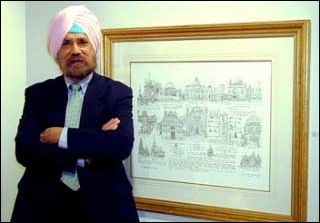 Credited with helping start a group that saved Union Station from demolition in the 1970s, K.P. is a tireless advocate of historic preservation and is acclaimed for his architectural artwork of Hoosier landmarks, ranging from the Indianapolis City Market, Monument Circle and the Indiana Statehouse to the Vigo County Courthouse and the University of Notre Dame. He's also acclaimed for his artwork that depicts monuments in his homeland of India, as well as in Washington D.C., such as the Lincoln Memorial. Many of his drawings, as well as accompanying essays and poems, are featured in his book, The Art and Spirit of K.P. Singh (2003). He will share his personal journey as a Hoosier, along with details about the evolution of local Sikhs, whose temples are called "gurdwaras."
Credited with helping start a group that saved Union Station from demolition in the 1970s, K.P. is a tireless advocate of historic preservation and is acclaimed for his architectural artwork of Hoosier landmarks, ranging from the Indianapolis City Market, Monument Circle and the Indiana Statehouse to the Vigo County Courthouse and the University of Notre Dame. He's also acclaimed for his artwork that depicts monuments in his homeland of India, as well as in Washington D.C., such as the Lincoln Memorial. Many of his drawings, as well as accompanying essays and poems, are featured in his book, The Art and Spirit of K.P. Singh (2003). He will share his personal journey as a Hoosier, along with details about the evolution of local Sikhs, whose temples are called "gurdwaras."
In 1947, when he was just 7 years old, K.P. left India with his family. His family members, along with thousands of other people, were thrown out of the country during an era of ethnic strife. Eventually he studied architecture, then earned a master's degree in city planning at the University of Michigan. He came to Indianapolis in 1967 and almost immediately found himself described on the front page of the former Indianapolis News in its "Did You Notice?" feature this way: "Did you see a turbaned and bearded man looking like an Indian maharajah viewing a children’s exhibit in the lobby of the City-County Building?" Fortunately, Indy has come a long way in its international diversity, sensitivity and awareness during the 43 years since his arrival created such a stir. Along the way, K.P., who has been named a Sagamore of the Wabash, has enjoyed remarkable successes with his artwork. It’s been exhibited in more than 25 countries and at the Smithsonian in Washington DC.
Some fun facts:
A former governor of Indiana served as the U.S. ambassador to a small Asian nation in the late 1980s and early 1990s.
Question: Name the former governor and the Asian nation where he represented the U.S. in the diplomatic corps.
Answer: Gov. Robert Orr and Singapore. A Republican who grew up in Evansville, Orr served two terms as Indiana’s governor, from 1981 to 1989. (Before that, he spent eight years as lieutenant governor.) In 1989, President George H.W. Bush appointed Orr as U.S. ambassador to the Republic of Singapore, an island city-state. Singapore is the smallest nation in Southeast Asia. Orr served as the ambassador there for three years. He died in 2004 and is buried in Crown Hill Cemetery in Indianapolis.
The prize was a pair of tickets to the Children's Museum, courtesy of the ICVA. The station requests that you not try to call in to win if you have won a prize on any WICR program within the last two months. Of course, we always do welcome general questions into the show!
 Our Roadtripper, Chris Gahl of the ICVA, logs almost as many airplane miles as George Clooney in Up In the Air. (Of course, our intrepid Roadtripper is a far more stand-up guy than is the Clooney character.) How are new security guidelines affecting air travel these days? Just how much do you have to take off, and what about those full-body scanners? What are some tips for getting in and out of the airport in a smooth and calm manner? Any trips on parking, or good transit options? Chris offered a report.
Our Roadtripper, Chris Gahl of the ICVA, logs almost as many airplane miles as George Clooney in Up In the Air. (Of course, our intrepid Roadtripper is a far more stand-up guy than is the Clooney character.) How are new security guidelines affecting air travel these days? Just how much do you have to take off, and what about those full-body scanners? What are some tips for getting in and out of the airport in a smooth and calm manner? Any trips on parking, or good transit options? Chris offered a report.
(Jan. 2, 2010) - Along with her admirer Kurt Vonnegut, fascinating Janet Flanner was one of the most acclaimed literary figures ever to come out of Indianapolis. Alas, more than 30 years after her death, Paris-based Janet Flanner may no longer be a household name, although she received a burst of attention last spring when 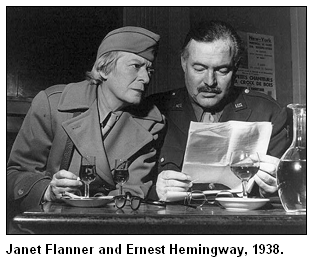 she was inducted posthumously into the Indiana Journalism Hall of Fame.
she was inducted posthumously into the Indiana Journalism Hall of Fame.
Witty and incisive, Janet Flanner (1892-1978) grew up amid the family that founded the Flanner & Buchanan mortuary business in Indianapolis. For 50 years, from 1925 to 1975, she wrote – under the pen name "Genet" – columns, profiles and vignettes for The New Yorker as its Paris correspondent. Her conversational dispatches, packaged as her"Letter from Paris," were eagerly awaited by thousands of devoted readers and included profiles of such cultural icons (and personal friends) as Pablo Picasso, Henri Matisse, Charles de Gaulle and Albert Camus.
Nelson’s studio guests will be Flanner’s cousin, Scott Keller, the former city-county councilman in Indy, and Chris Connolly, a local expert about her life and career. A well-known appraiser of antiques, fine art and collectibles, Scott always champions the impact of his colorful cousin, whose dispatches chronicled the “Lost Generation” in post-World War I Europe that included Flanner’s pals Ernest Hemingway and Gertrude Stein.
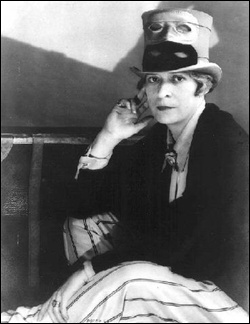 Before her astonishing career overseas, Flanner served as the first movie critic for The Indianapolis Star in 1916. According to some accounts, she was one of the first film critics (reviewing silent flicks, of course) in the entire country. Chris, an Indianapolis businessman, is writing a play about Flanner. Incidentally, in this Youtube video, you can watch Flanner hold her own in a live television scuffle between Gore Vidal and Normal Mailer; it's from a 1971 Dick Cavett show.
Before her astonishing career overseas, Flanner served as the first movie critic for The Indianapolis Star in 1916. According to some accounts, she was one of the first film critics (reviewing silent flicks, of course) in the entire country. Chris, an Indianapolis businessman, is writing a play about Flanner. Incidentally, in this Youtube video, you can watch Flanner hold her own in a live television scuffle between Gore Vidal and Normal Mailer; it's from a 1971 Dick Cavett show.
Known as a "writer's writer," Janet Flanner once said, "I act as a sponge. I soak it up and squeeze it out in ink every two weeks." Flanner attended Tudor Hall School for Girls (where she was president of her class in 1905) and, like Vonnegut, had a turbulent relationship with her hometown. Her father, Indianapolis philanthropist Frank Flanner, committed suicide in 1912. He had co-founded the mortuary business with his brother-in-law, Charles Buchanan. (Frank Flanner also had founded a nonprofit organization, the Flanner Guild, to assist low-income people. It was the forerunner of today’s Flanner House.)
Scott's crusade to make certain that his distinguished relative is remembered in their hometown has included donating the building that houses the Phoenix Theatre in her memory. A pioneer in the renovation of downtown houses and other properties in the 1980s, Scott has won awards from the Riley Area Development Corp. and other organizations for his urban trailblazing.
Some fast facts:
In addition to Janet Flanner, several other women who were native Hoosiers became famous writers during the mid-20th century. They included a woman who was born in Muncie during the 1890s. Known for her light-hearted humor, she was the co-author of a book about her youthful trip to Europe that became a national bestseller in 1942. Then it was turned into a hit movie in 1944. Before that, she had carved out a successful career as a journalist, serving as managing editor of Ladies' Home Journal magazine. After her 1942 bestseller, she wrote more than a dozen other books. Like Janet Flanner, she also wrote regularly for The New Yorker magazine. She died in 1989.
Question: Name the famous Hoosier writer.
Answer: Emily Kimbrough. Born in Muncie in 1898, she is best remembered for her 1942 bestseller, Our Hearts Were Young and Gay, a witty reminiscence. Written with her best friend, actress Cornelia Otis Skinner, the book recounts their youthful adventures during the early 1920s on an ocean liner and a vacation in Europe. Eventually, Emily Kimbrough wrote 14 books, including a sequel, We Followed Our Hearts to Hollywood, and an exuberant account of life in Muncie at the turn of the last century, How Dear to My Heart. She also wrote several popular books about international travel during the 1940s and '50s. Emily Kimbrough's girlhood home in Muncie, which has been restored, is open for tours by appointment.
Our Roadtripper, Chris Gahl of the ICVA, called in with a surprise Indiana travel pick from a sub-tropical clime - checking in with those of us shivering up north.
(Dec. 19, 2009) - Among the earliest movers and shakers in Indianapolis history, probably no name looms larger than Calvin Fletcher. An entrepreneur, lawyer and banker who kept extensive, detailed diaries, Fletcher also owned a sprawling farm south of the Mile Square. In the 1850s, the Fletcher farm was divided into lots, and the Fletcher Place neighborhood eventually began to blossom. Today it’s in the midst of a revival, along with nearby Fountain Square to the south, making Fletcher Place ideal as the next focus of our rotating series exploring Indy neighborhoods.
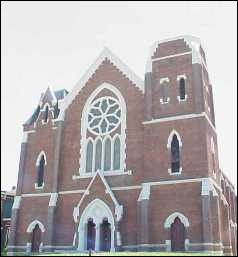 Nelson was joined in studio by Jeff Miller and Mary Jo Showley, both of whom are longtime residents of the historic Southeastside neighborhood. Jeff, the president of the Fletcher Place Neighborhood Association, renovated an Italianate home built in 1874 that, he says, had been dubbed "one of the three ugly stepsisters" because of its once-dilapidated condition. It's now home sweet home for Jeff, his wife and their 3-year-old son. Mary Jo, a Realtor, arts patron and former choral conductor at the long-closed Harry Wood High School, once taught students who lived in Fletcher Place and Fountain Square. There's much turf to cover with them, including everything from economic development initiatives to a proposed "bark park."
Nelson was joined in studio by Jeff Miller and Mary Jo Showley, both of whom are longtime residents of the historic Southeastside neighborhood. Jeff, the president of the Fletcher Place Neighborhood Association, renovated an Italianate home built in 1874 that, he says, had been dubbed "one of the three ugly stepsisters" because of its once-dilapidated condition. It's now home sweet home for Jeff, his wife and their 3-year-old son. Mary Jo, a Realtor, arts patron and former choral conductor at the long-closed Harry Wood High School, once taught students who lived in Fletcher Place and Fountain Square. There's much turf to cover with them, including everything from economic development initiatives to a proposed "bark park."
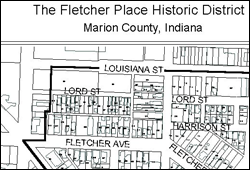 Fletcher Place generally is defined as east of East Street, west of I-65/I-70, south of Lord Street and north of I-70. Jeff likes to tout part of the neighborhood group’s mission statement that calls for "preservation, revitalization, and the promotion of the neighborhood as a walkable community ... with the goal of creating a total urban community while maintaining a respect for the past."
Fletcher Place generally is defined as east of East Street, west of I-65/I-70, south of Lord Street and north of I-70. Jeff likes to tout part of the neighborhood group’s mission statement that calls for "preservation, revitalization, and the promotion of the neighborhood as a walkable community ... with the goal of creating a total urban community while maintaining a respect for the past."
Some fun facts:
Question: During the Victorian era in Indianapolis, the oldest restaurant in the city (that's still operating today) opened. Name the restaurant. Note that this is a sit-down restaurant, not an establishment that's primarily a tavern. Hint: The answer is not St. Elmo's, which was an incorrect guess from a listener in the previous week's show, from which this question is a carry-over because no correct answer was received. St. Elmo's opened in 1902, six years after the city's oldest continuously operating restaurant began serving patrons.
Answer: The Rathskeller, in the basement of the Athenaeum, 401 E. Michigan St. Specializing in German food, the Rathskeller was established in 1894 along with the opening of the Athenaeum, the German cultural and social center that was then known as Das Deutsche Haus. (The building’s name was changed because of anti-German sentiment during World War I.) The heritage of the Rathskeller was discussed during a recent Hoosier History Live! show about Athenaeum and German history in Indy.
The prize for the correct answer was a pair of tickets to the Indiana State Museum, courtesy of the ICVA.
 (Nov. 19, 2009) - We thank Charlotte Lucas, executive vice president of Lucas Oil, for her one-year sponsorship commitment to Hoosier History Live! Charlotte is a native of Dubois County in southern Indiana, and she and husband Forrest, CEO of Lucas Oil, believe that Hoosier History Live! "makes the grade" as the nation's only live, call-in radio talk show about history.
(Nov. 19, 2009) - We thank Charlotte Lucas, executive vice president of Lucas Oil, for her one-year sponsorship commitment to Hoosier History Live! Charlotte is a native of Dubois County in southern Indiana, and she and husband Forrest, CEO of Lucas Oil, believe that Hoosier History Live! "makes the grade" as the nation's only live, call-in radio talk show about history.
Forrest and his three younger sisters were guests on a June 2008 edition of Hoosier History Live!, talking about their childhood in Elkinsville, a hamlet in southern Brown County. In the 1960s, the Lucases, 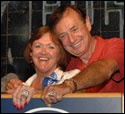 and in fact all of the residents of Elkinsville, were forced to move in order to make way for the construction of Monroe Reservoir.
and in fact all of the residents of Elkinsville, were forced to move in order to make way for the construction of Monroe Reservoir.
Fun fact: Forrest's sister Carol, who lives in Columbus, Indiana, is married to Larry Cummins, who is the nephew of the creator of the Cummins engine, Clessie Cummins.
Read more in Clessie's book My Days with the Diesel. This is quite an automotive family.
![]() Speaking of sponsors, our new "look" on our website and in our e-newsletter is courtesy of Richard Sullivan of Monomedia.
Speaking of sponsors, our new "look" on our website and in our e-newsletter is courtesy of Richard Sullivan of Monomedia.
Remember that we will be expanding the program on the Internet as podcasts, and on prx.org, so that our program will have a wider audience. If you are planning your marketing budget for '10, now is the time to make a year commitment. Contact Molly Head at (317) 927-9101 for information.
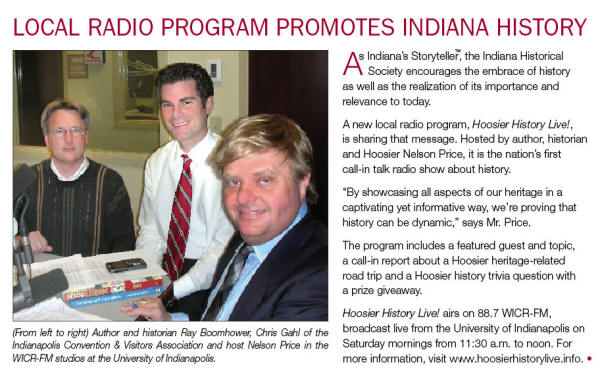
Above article is from the July/August 2008 issue of INPerspective, the member newsletter of the Indiana Historical Society.
 (Dec. 12, 2009) - Hold on to your hat. Indianapolis-based dietitian Kim Galeaz has hunted up Christmas Day menus from the 1890s in Indianapolis that featured oysters among the delicacies served. How could this be in the landlocked Hoosier state? Kim, the owner of Galeaz Food & Nutrition Communications, was Nelson’s guest and shared insights about what the Victorians ate, as well as their approach to meals and how they dined, including a look at some of their bygone dining ware. The Victorian era generally is defined as 1837 to 1901.
(Dec. 12, 2009) - Hold on to your hat. Indianapolis-based dietitian Kim Galeaz has hunted up Christmas Day menus from the 1890s in Indianapolis that featured oysters among the delicacies served. How could this be in the landlocked Hoosier state? Kim, the owner of Galeaz Food & Nutrition Communications, was Nelson’s guest and shared insights about what the Victorians ate, as well as their approach to meals and how they dined, including a look at some of their bygone dining ware. The Victorian era generally is defined as 1837 to 1901.
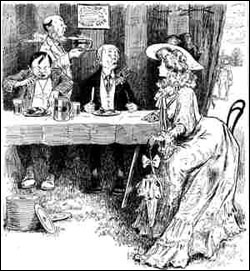 For a cover story in the December issue of Urban Times, Kim hunted up three Christmas menus from 1890s homes in Indianapolis that include food choices that are, as she puts it, "striking similar to ours today." For example, potato chips are listed on one of the Victorian-era menus. (Nelson inquired whether these chips of yore were similar to the munchies that tempt people today.) Other items served during Victorian-era meals would seldom be found in Hoosier homes of 2009, including venison and (gulp) opossum.
For a cover story in the December issue of Urban Times, Kim hunted up three Christmas menus from 1890s homes in Indianapolis that include food choices that are, as she puts it, "striking similar to ours today." For example, potato chips are listed on one of the Victorian-era menus. (Nelson inquired whether these chips of yore were similar to the munchies that tempt people today.) Other items served during Victorian-era meals would seldom be found in Hoosier homes of 2009, including venison and (gulp) opossum.
To put together the article for Urban Times, the newspaper that covers downtown Indy’s historic neighborhoods, Kim explored the kitchens and dining rooms of three home museums: the 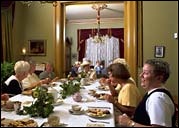 Morris-Butler House, the President Benjamin Harrison Home, and the James Whitcomb Riley Home. She found an unusual serving platter for venison and a specially designed dish with a swiveling base for oranges. Kim says the swiveling base allowed Victorians to drink the juice "and not waste one bit" of the precious citrus during our cold months.
Morris-Butler House, the President Benjamin Harrison Home, and the James Whitcomb Riley Home. She found an unusual serving platter for venison and a specially designed dish with a swiveling base for oranges. Kim says the swiveling base allowed Victorians to drink the juice "and not waste one bit" of the precious citrus during our cold months.
Speaking of oranges, venison and opossum: Nelson asked Kim how the Victorians' menu choices compare to ours in terms of healthful eating. A culinary nutrition expert, Kim is a consultant to food and beverage companies, restaurants and supermarkets in Indy and Jacksonville, Fla. (Although her primary residence is in the historic Chatham Arch neighborhood, Kim joined Nelson by phone because she's at her Florida abode this week.)
Some fun facts:
During the Victorian era in Indianapolis, the oldest restaurant in the city (that’s still operating today) opened.
Question: Name the restaurant. Note that this is a sit-down restaurant, not an establishment that’s primarily a tavern.
The prize for the correct answer was a pair of tickets to the Indiana State Museum, courtesy of the ICVA. Additional prizes were available at the Fireside Chats group at the Central Library for those with the correct answer. (Editor's note: No one called in with the correct answer, so the question was asked again in the following week's show.)
Speaking of the History Mystery, at least five of you came up to Nelson in person at the Dec. 5 Holiday Author Fair and whispered the words "Natalie Wood" in his ear. Well, Nelson was quite excited, as "Natalie Wood" was the answer to that week's History Mystery! Some of the other authors thought this was a little bizarre, but we had to have the History Mystery answered in a different way because we didn't have telephone call-in to the show that week.
Chris Gahl of the ICVA told us about the city's upcoming 12 Free Days of Indy Christmas. Is there that special Central Indiana attraction that you've never quite made it to? Are holiday financial woes getting your attention? It's time to be carefree and celebrate Indianapolis! From Dec. 13 to 24, you can take a special Roadtrip each day that is FREE and open to the public. From the Harrison Home to the Eiteljorg, from Conner Prairie to Morris-Butler House, our Roadtripper told us about this very special holiday journey.
Live from the Holiday Author Fair
(Dec. 5, 2009) - For the second year, Hoosier History Live! was broadcast from a remote (non-studio) location: the Eugene and Marilyn Glick Indiana History Center, which bustled and abounded with captivating interviewees, as nearly 90 authors with ties to Indiana gathered for the 7th Annual Holiday Author Fair. Nelson conducted round-robin chats with fellow authors who have a range of Hoosier expertise.
Our show featured the following authors:
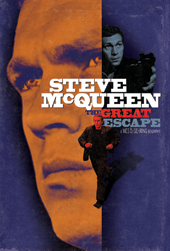 Film historian Wes Gehring of Ball State, whose new biography focuses on a native of Beech Grove who went on to become one of the top movie stars of the 1960s and '70s. Steve McQueen: The Great Escape (Indiana Historical Society Press) explores the troubled youth as well as the Hollywood stardom of Steve McQueen, who was born into a dysfunctional family in 1930 and died while undergoing unorthodox treatment for cancer in 1980.
Film historian Wes Gehring of Ball State, whose new biography focuses on a native of Beech Grove who went on to become one of the top movie stars of the 1960s and '70s. Steve McQueen: The Great Escape (Indiana Historical Society Press) explores the troubled youth as well as the Hollywood stardom of Steve McQueen, who was born into a dysfunctional family in 1930 and died while undergoing unorthodox treatment for cancer in 1980.
As Wes describes in his book, McQueen was the son of an alcoholic, teenage mother and a barnstorming pilot who abandoned the family soon after the boy's birth. McQueen spent his early childhood and adolescence shuttling between his mother in the Indianapolis area and extended family members in Missouri. As Wes puts it, McQueen "fell into a life of gangs and petty crime" in the Hoosier capital. Eventually, he ended up in a California school for neglected and troubled boys, which he credited with turning his life around. McQueen went on to star in movies, including The Magnificent Seven (1960), The Great Escape (1963) and The Sand Pebbles (1966). In addition to his book on McQueen, Wes has written biographies of other screen legends with Hoosier roots such as Red Skelton, Irene Dunne and James Dean.
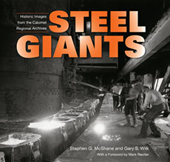 Stephen McShane, co-author of Steel Giants (Indiana University Press), a book of historic photos of steel mills, towns and residents of northwest Indiana from 1906 through the 1960s. In addition to extensive photos showing the construction of the mills in Gary and other cities, Steel Giants also features dozens of vintage photos of the region's schoolchildren, crane operators, bathing beaches, homes and company recreational teams, including a women's softball team in 1945. With co-author Gary Wilk, Steve also includes explanations of the "open hearth" process at the steel mills and a description of how and why five major steel companies built along Indiana's northern coastline.
Stephen McShane, co-author of Steel Giants (Indiana University Press), a book of historic photos of steel mills, towns and residents of northwest Indiana from 1906 through the 1960s. In addition to extensive photos showing the construction of the mills in Gary and other cities, Steel Giants also features dozens of vintage photos of the region's schoolchildren, crane operators, bathing beaches, homes and company recreational teams, including a women's softball team in 1945. With co-author Gary Wilk, Steve also includes explanations of the "open hearth" process at the steel mills and a description of how and why five major steel companies built along Indiana's northern coastline.
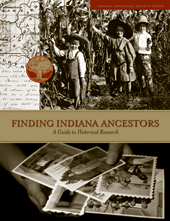 Teresa Baer, co-editor of Finding Indiana Ancestors: A Guide to Historical Research (IHS Press), which offers tips for first-time researchers as well as experienced genealogists. Teresa's book is a guide that focuses on Indiana-specific sources for ancestor hunting.
Teresa Baer, co-editor of Finding Indiana Ancestors: A Guide to Historical Research (IHS Press), which offers tips for first-time researchers as well as experienced genealogists. Teresa's book is a guide that focuses on Indiana-specific sources for ancestor hunting. 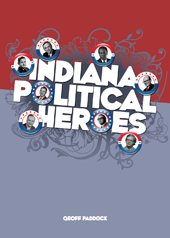 Nelson asked if there are special challenges with roots-tracing in counties where early courthouses were destroyed by fire or damaged by floods.
Nelson asked if there are special challenges with roots-tracing in counties where early courthouses were destroyed by fire or damaged by floods.
And Fort Wayne civic leader Geoff Paddock, author of Indiana Political Heroes (IHS Press). Tune in to see if you agree with Geoff's choices. He's a former school board president in Fort Wayne and a self-described political junkie. Geoff says he attempted to salute Hoosier politicians who risked their popularity to do what they considered to be the right thing.
No call-ins to the show this week. Winners needed to appear in person at the Holiday Author Fair to find Nelson (he was the effervescent blond guy running around talking to authors) and give him the answer. The fair was free, and it took place Saturday, Dec. 5, from noon to 4 p.m. at the Eugene and Marilyn Glick History Center at 450 W. Ohio St. There is a free parking lot directly north of the History Center. A great opportunity to meet and mingle with all of our wonderful Hoosier writers!
Steve McQueen, who was born in Beech Grove in 1930, often portrayed rebellious or misunderstood characters in films. So did movie icon James Dean, who was born in 1931 and grew up on a farm near Fairmount.
Question: Name the movie actress who co-starred with James Dean and, about eight years later, with Steve McQueen. Hint: She was NOT a Hoosier.
Answer: Natalie Wood. She was James Dean's co-star in Rebel Without a Cause, which was released shortly after his death in 1955. Both received Oscar nominations for their performances, although neither won. In 1963, Natalie Wood co-starred with Steve McQueen in Love With the Proper Stranger. Once again, she was nominated for an Academy Award (although McQueen was not), but she did not win.
More than one winner was selected. Prizes included a pair of tickets to Handel's The Messiah on Dec. 12 and 13, courtesy of the Indianapolis Chamber Orchestra, tickets to the Eiteljorg, the Indiana State Museum, the Children's Museum and the Indianapolis Zoo, all courtesy of the ICVA.
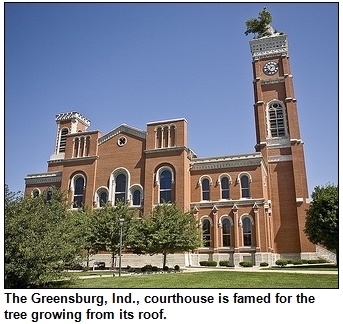 (Nov. 28, 2009) - What other burg in Indiana – or town anywhere – has a tree growing out of its courthouse? The tree atop the Decatur County Courthouse may be the biggest claim to fame of Greensburg, but there's plenty of other fascinating folklore and fodder to explore as well. For a show in our rotating series about town histories that already has featured two other "Greens" in the Hoosier state – Greenfield and Greencastle – Nelson was joined in studio by a proud native son of Greensburg. His guest was John Pratt, a history teacher at North Decatur High School who is reviving Chautauqua-style events in his hometown. (See flier for Dec. 1 Chautauqua 1 in Greensburg.)
(Nov. 28, 2009) - What other burg in Indiana – or town anywhere – has a tree growing out of its courthouse? The tree atop the Decatur County Courthouse may be the biggest claim to fame of Greensburg, but there's plenty of other fascinating folklore and fodder to explore as well. For a show in our rotating series about town histories that already has featured two other "Greens" in the Hoosier state – Greenfield and Greencastle – Nelson was joined in studio by a proud native son of Greensburg. His guest was John Pratt, a history teacher at North Decatur High School who is reviving Chautauqua-style events in his hometown. (See flier for Dec. 1 Chautauqua 1 in Greensburg.)
According to John, Chautauqua guests in Greensburg decades ago included Helen Keller, John Phillips Sousa, hypnotists and comedians. John's father once owned the Taylor Hotel, considered one of the premier Midwestern hotels.
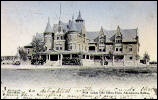 Of course, Greensburg has made recent headlines with the opening of a Honda assembly plant for Civics, so we will explore the impact on the town of the $550 million facility. According to the 2000 U.S. Census, Greensburg has a population of 10,260. The town, which is located 47 miles southeast of Indianapolis, generally is considered to be half-way between the Hoosier capital and Cincinnati.
Of course, Greensburg has made recent headlines with the opening of a Honda assembly plant for Civics, so we will explore the impact on the town of the $550 million facility. According to the 2000 U.S. Census, Greensburg has a population of 10,260. The town, which is located 47 miles southeast of Indianapolis, generally is considered to be half-way between the Hoosier capital and Cincinnati.
Other fun facts:
Incidentally, our guest also has an extensive collection of beer cans, license plates, baseball cards and family memorabilia, all housed in the barn behind his home in Greensburg (he says the barn used to be a feed store and it's very large). Watch The Collector's Collector, from WFYI's Across Indiana archives; his segment is about 18 minutes in.
Decades before Helen Keller visited Greensburg on the Chautauqua circuit, she wrote a letter to a famous woman from Indiana. In 1892, when Helen Keller was 12 years old, she learned that the distinguished Hoosier was ill, so she sent her a kind letter wishing her a recovery.
Question: Who was the famous Hoosier woman who received a letter from young Helen Keller?
Answer: First Lady Caroline Scott Harrison. In the fall of 1892, Mrs. Harrison, who was married to President Benjamin Harrison, was battling tuberculosis while living in the White House. Feeling sorry for the First Lady, 12-year-old Helen Keller sent her a letter of sympathy. Sadly, Mrs. Harrison died in the White House in late October, just two weeks before her husband lost his bid for re-election. Thousands of Indianapolis residents watched her funeral procession to Crown Hill Cemetery.
The letter from young Helen Keller is on permanent display at the President Benjamin Harrison Home, 1230 N. Delaware St. According to the home's director, Phyllis Geeslin, the letter invariably fascinates hundreds of school children every year during their visits.
The prize for the correct answer was a pair of tickets to Handel's The Messiah on Dec. 12 and 13, courtesy of the Indianapolis Chamber Orchestra, and a pair of tickets to the Indiana State Museum, courtesy of the ICVA.
(Nov. 21, 2009) - We talked turkey – wild turkeys, that is – along with a flock of other bird-related topics guaranteed to intrigue anyone with even a fleeting interest in our feathered friends. Nelson was joined in studio by 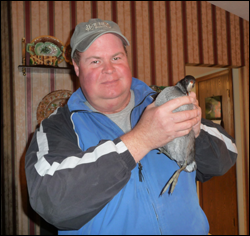 Don Gorney, president of the Amos W. Butler Audubon Society, which serves Central Indiana. A volunteer naturalist at Fort Harrison State Park who leads bird hikes throughout the year, Don shared insights about wild turkeys, which once were extirpated from Indiana but have recently rebounded greatly. He also chatted about cardinals (our state bird, of course), which have expanded their range and are more common in northern Indiana.
Don Gorney, president of the Amos W. Butler Audubon Society, which serves Central Indiana. A volunteer naturalist at Fort Harrison State Park who leads bird hikes throughout the year, Don shared insights about wild turkeys, which once were extirpated from Indiana but have recently rebounded greatly. He also chatted about cardinals (our state bird, of course), which have expanded their range and are more common in northern Indiana.
Do you assume birding is hopeless during Indiana's cold months? Hummingbirds and other species still can be seen, according to Don. Alas, though, he also shared insights about species that have become extinct in the Hoosier state, including the Greater Prairie Chicken, the passenger pigeon and the Carolina Parakeet.
Don is leading Lights Out Indy, a crusade to reduce the nighttime deaths of migratory birds because of "building strikes."
"The combination of lights, glass and reflexivity is deadly to birds," he says. "Tens of thousands of birds die each year in the Indianapolis area because of building strikes. ... Most birds migrate at night, and urban lighting interferes with their ability to navigate."
Lights Out Indy encourages the reduction of unnecessary lighting at night to help reduce bird mortalities.
At the other extreme, various species of birds have been "introduced" to Indiana – and, perhaps unfortunately, are becoming better known than our native birds, Don says. Introduced species include rock pigeons, house sparrows and European starlings.
Some other fun facts:
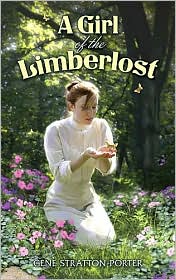 Hoosier author and naturalist Gene Stratton-Porter probably is best remembered for her novel A Girl of the Limberlost, published in 1909. But she also was a prolific magazine writer and nature photographer, often taking pictures of - and writing about - birds in the swamps and meadows of northeastern Indiana. In fact, Gene Stratton-Porter wrote a book in 1903 about a bird that is stalked by a hunter. The bird lives near the Limberlost swamp in Geneva, Indiana.
Hoosier author and naturalist Gene Stratton-Porter probably is best remembered for her novel A Girl of the Limberlost, published in 1909. But she also was a prolific magazine writer and nature photographer, often taking pictures of - and writing about - birds in the swamps and meadows of northeastern Indiana. In fact, Gene Stratton-Porter wrote a book in 1903 about a bird that is stalked by a hunter. The bird lives near the Limberlost swamp in Geneva, Indiana.
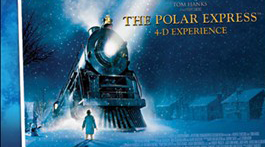 Question: Name the species of bird that's the focus of her 1903 best-selling novel.
Question: Name the species of bird that's the focus of her 1903 best-selling novel.
Answer: The cardinal.
The prize for the correct answer was a pair of tickets to the Indianapolis Zoo, courtesy of the ICVA. Coming up, Christmas at the Zoo, and the new 4D adventure, The Polar Express.
(Nov. 14, 2009) - His real name was John Chapman. He probably died in 1845 in Allen County, where the largest city, Fort Wayne, celebrates a popular Johnny Appleseed Festival every autumn. Did he wear a saucepan on his head, as depicted in Walt Disney cartoons? What were the facts, and what were the myths or embellishments, about the folk hero of the Indiana frontier known as Johnny Appleseed?
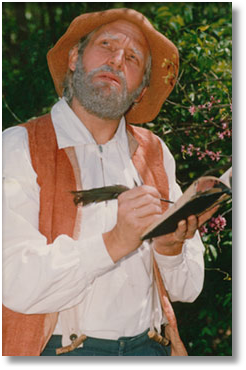 To enlighten us, one of the country's foremost experts on Johnny Appleseed will join Nelson in studio. His guest will be Indianapolis-based re-enactor and playwright Hank Fincken, who has spent decades researching Appleseed/Chapman. Hank portrays colorful, eccentric Johnny Appleseed at schools, festivals, fairs and special events; his website is at hankfincken.com.
To enlighten us, one of the country's foremost experts on Johnny Appleseed will join Nelson in studio. His guest will be Indianapolis-based re-enactor and playwright Hank Fincken, who has spent decades researching Appleseed/Chapman. Hank portrays colorful, eccentric Johnny Appleseed at schools, festivals, fairs and special events; his website is at hankfincken.com.
According to most accounts, John Chapman was born in New England in 1774. He was a pacifist and a vegetarian who befriended many Native Americans – all cause for many other pioneers to regard him as a bit of an oddball, although they were grateful for his gifts of apple seedlings as they settled in the frontier. The wanderlust of Chapman/Appleseed is said to have been motivated in part by his spiritual beliefs. In addition to apple seedlings, he distributed scriptures across the Indiana wilderness in the 1830s and '40s.
Before that, Chapman was a true hero during the War of 1812 and helped save the lives of massacre survivors trapped in Mansfield, Ohio, according to Hank. The author of Three Midwest History Plays and Then Some (1997), Hank also portrays such historical figures as Christopher Columbus, Henry Ford, Thomas Edison and Francisco Pizarro. Here's his motto about his one-man shows: "If history were to repeat itself, it would be like this!"
Some fun facts:
 Not only did Disney feature Johnny Appleseed in the animated movie Melody Time, the movie studio hired a famous Indiana native as the voice of a character in The Jungle Book in 1967. The Hoosier-born performer, who had been a popular bandleader and radio personality, won a new generation of young fans thanks to his character in The Jungle Book, who sings a song that was nominated for an Academy Award.
Not only did Disney feature Johnny Appleseed in the animated movie Melody Time, the movie studio hired a famous Indiana native as the voice of a character in The Jungle Book in 1967. The Hoosier-born performer, who had been a popular bandleader and radio personality, won a new generation of young fans thanks to his character in The Jungle Book, who sings a song that was nominated for an Academy Award.
Question: Name the Hoosier-born entertainer who voiced a character in Disney's The Jungle Book AND the Oscar-nominated tune that the character sang.
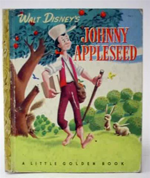 Answer: Phil Harris, who was born in Linton, Ind., and the song The Bare Necessities. After a long career as a bandleader and as Jack Benny's sidekick on radio, Harris, who was born in 1904, enjoyed a career revival as the voice of Baloo the Bear in The Jungle Book. An extensive collection of memorabilia that belonged to Phil Harris and his glamorous wife Alice Faye, the star of Hollywood musicals, is exhibited in Linton. Harris and Faye died in the 1990s.
Answer: Phil Harris, who was born in Linton, Ind., and the song The Bare Necessities. After a long career as a bandleader and as Jack Benny's sidekick on radio, Harris, who was born in 1904, enjoyed a career revival as the voice of Baloo the Bear in The Jungle Book. An extensive collection of memorabilia that belonged to Phil Harris and his glamorous wife Alice Faye, the star of Hollywood musicals, is exhibited in Linton. Harris and Faye died in the 1990s.
Chris Gahl of the ICVA was back with us this week to suggest that we Roadtrip to the Hilbert Circle Theatre to see Indiana native Florence Henderson. She's host of a special three-night show there starting Friday, Nov. 20, through Sunday, Nov. 22. Her performance will take audiences down memory lane as she sings Broadway hits and other popular songs that were highlights in her career.
She was born in Dale, Indiana but left at 17 to study at New York's American Academy of Dramatic Arts. Shortly after, she landed her first Broadway appearance in the musical Wish You Were Here. Of course, Henderson is best known as "America's Favorite Mom" on The Brady Bunch, though she also starred in productions of Oklahoma, The Sound Of Music, The King and I and many more.
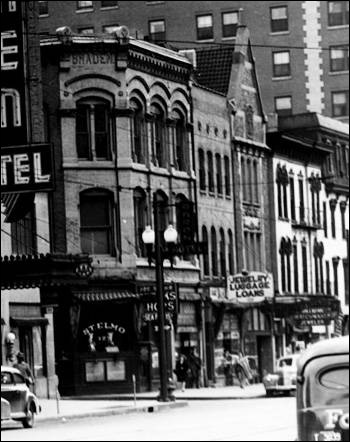 (Nov. 7, 2009) - When the St. Elmo Steakhouse opened at 127 S. Illinois St. in downtown Indianapolis in 1902, it consisted of only a barroom and one small dining room, which now serves as its kitchen. Its turn-of-the-last-century Chicago saloon décor has changed little since its opening.
(Nov. 7, 2009) - When the St. Elmo Steakhouse opened at 127 S. Illinois St. in downtown Indianapolis in 1902, it consisted of only a barroom and one small dining room, which now serves as its kitchen. Its turn-of-the-last-century Chicago saloon décor has changed little since its opening.
In 1904, the opening of the Indianapolis Traction Terminal spilled thousands of businessmen from interurban lines out into the intersection of Market and Illinois, contributing to St. Elmo's success. And yes, we say business "men" because St. Elmo's historically had been one of those "male bastions" of politicking, dealmaking, and celebrating. Although, of course, times have changed, and now even business "men" eat sushi. Though you won't find that on the St. Elmo menu.
With Nelson out on assignment, our live in-studio was guest host and Central Indiana broadcaster Daina Chamness, who also makes hand-crafted pies when not orchestrating 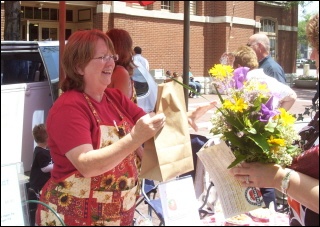 the activities of her seven children. No, she's doesn't live in a shoe, but she does have her fingers in many pies and is constantly busy. She chatted with guest Craig Huse, owner of St. Elmo since 1997, about the restaurant's illustrious history, tales about St. Elmo during the Prohibition years, the betting in the back of the house during the 1920s, JFK's visit, and the impact of the opening of the Circle Centre Mall in 1996.
the activities of her seven children. No, she's doesn't live in a shoe, but she does have her fingers in many pies and is constantly busy. She chatted with guest Craig Huse, owner of St. Elmo since 1997, about the restaurant's illustrious history, tales about St. Elmo during the Prohibition years, the betting in the back of the house during the 1920s, JFK's visit, and the impact of the opening of the Circle Centre Mall in 1996.
Did you know that St. Elmo's doors open only to the street and not to the inside of the Circle Centre Mall, even though all the other restaurants have access to both?
Image of St. Elmo Steakhouse from Bass Photo Co. Collection, Indiana Historical Society.
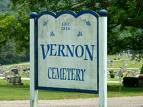 Two famous Indy race car drivers are buried near one another in Vernon Cemetery in Jennings County.
Two famous Indy race car drivers are buried near one another in Vernon Cemetery in Jennings County.
Question: Name the two famous drivers. Hint: One of them is credited with being instrumental in the revival of the Indianapolis Motor Speedway after World War II.
Answer: Wilbur Shaw and Pat O'Connor.
The prize was a gift certificate to St. Elmo Steakhouse, courtesy of our guest, Craig Huse.
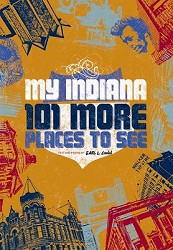 Filling in for Chris Gahl, who also is out on assignment, was his colleague, Amy Lamb, media relations manager for the Indiana Historical Society. In addition to having welcomed her son, Leo Robert, into the world on June 7 of this year, Amy also let us know that the Stardust Terrace Café and Basile History Market are now officially open at the Indiana History Center.
Filling in for Chris Gahl, who also is out on assignment, was his colleague, Amy Lamb, media relations manager for the Indiana Historical Society. In addition to having welcomed her son, Leo Robert, into the world on June 7 of this year, Amy also let us know that the Stardust Terrace Café and Basile History Market are now officially open at the Indiana History Center.
Amy featured a Roadtrip from one of our beloved Hoosier authors who died this September, Earl Conn of Muncie. Her pick was from Earl's most recent book, My Indiana: 101 More Places to See. By the way, Earl Conn appeared on the December 2008 Holiday Author Fair show with Nelson Price, which was done as a live remote from the Indiana History Center.
"Only the brave would dare go there - that's what everyone said about it."
-- A member of Shortridge High School's class of '62
 (Oct. 31, 2009) - For nearly 50 years, The House of Blue Lights was regarded as the creepiest place in Indianapolis. Sneaking around the secluded estate of eccentric millionaire Skiles E. Test became a Halloween-season rite of passage for thousands of high school and college students from the 1920s through the1960s.
(Oct. 31, 2009) - For nearly 50 years, The House of Blue Lights was regarded as the creepiest place in Indianapolis. Sneaking around the secluded estate of eccentric millionaire Skiles E. Test became a Halloween-season rite of passage for thousands of high school and college students from the 1920s through the1960s.
The hordes of frightened gawkers hoped to glimpse the corpse of Mr. Test's beautiful, dead wife, which they suspected he enclosed in a glass coffin. According to the urban legend that captivated six generations of Hoosiers, Mr. Test bathed the glass casket in eerie blue lights and sat in a rocking chair next to her embalmed, perfectly preserved body every night. Rocking in sorrow, or so the story went, he kept a lonely vigil at his estate near Fall Creek Road and Shadeland Avenue.
The thousands of Hoosier teenagers who crept around the House of Blue Lights and the surrounding, heavily wooded property included a member of Cathedral High School's class of '56 who would grow up to become famous in local broadcasting. 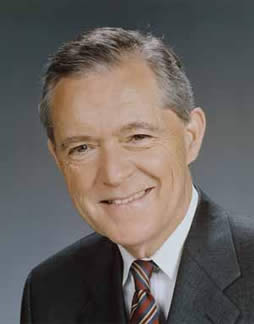 Mike Ahern not only ventured up to the estate night after night with his Cathedral buddies, he went on to cover the demolition of The House of Blue Lights in 1978 during his record-setting, 37-year stint as the news anchor at WISH-TV/Channel 8.
Mike Ahern not only ventured up to the estate night after night with his Cathedral buddies, he went on to cover the demolition of The House of Blue Lights in 1978 during his record-setting, 37-year stint as the news anchor at WISH-TV/Channel 8.
As a Halloween Day treat, Mike (who retired amid statewide accolades in 2004) will return to the air to join Nelson, who for years has written feature stories and columns about The House of Blue Lights that have included rare interviews with Skiles Test's anguished relatives. The fascinating story - which became perhaps the biggest urban legend in state history - involved everything from a pet cemetery to an unusual swimming pool to an amateur inventor-architect from a wealthy family who, sadly, eventually felt terrorized to spend the night in his sprawling home because of the throngs of trespassers.
Myths, facts, distortions and exaggerations - or combinations of them - fueled folklore about the mysterious house, which Mr. Test (1889-1964) inherited in 1913.
But was there a dead wife? What was the real source of the blue glow that emanated from Mr. Test's hilly estate? Was the property guarded by vicious Dobermans as per the urban legend, or were Mr. Test's dogs a very different breed?
Tune in as Mike and Nelson sort truth from myth about the spooky folklore. It so captivated teenagers that, according to a member of Howe High School's class of '50 whom Nelson once interviewed, "Night after night, there were always kids lurking around the property. Chatard kids, Lawrence Central kids, North Central kids, Cathedral guys, Ladywood girls - there would almost be traffic jams, particularly around Halloween."
Here's how a North Central grad once described the scene that involved piling into a car with his classmates: "We would keep daring each other, 'C'mon, let's go further up the driveway. Further, further, further.' "
The House of Blue Lights even developed an unlikely reputation as a lovers' lane. High school boys would drive at night with their girlfriends to the locked gates on Mr. Test's property. The couples would swap stories about the place. Boys hoped girls would get so terrified they would want to cuddle.
Some fun facts:
www.houseofbluelights.com - This website is owned and operated by the Louellen Test Hesse family and is dedicated to the memory of Skiles Test. It includes pictures of Test's cats and dogs, underground tunnels, swimming pool, pet cemetery, and a 1937 aerial view of the property.
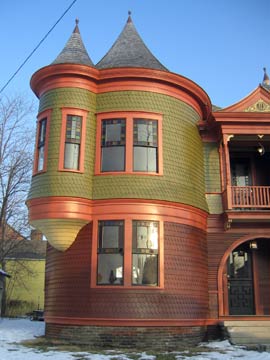 Question: What is the name for a small tower that projects vertically from a house or building, usually a structure of a historic nature? This type of tower is attached to the house and often contains a staircase. Such decorative towers can be seen adorning Victorian- or Edwardian-era homes in the Herron-Morton Place and Woodruff Place neighborhoods.
Question: What is the name for a small tower that projects vertically from a house or building, usually a structure of a historic nature? This type of tower is attached to the house and often contains a staircase. Such decorative towers can be seen adorning Victorian- or Edwardian-era homes in the Herron-Morton Place and Woodruff Place neighborhoods.
Answer: A turret. According to historians, turrets became widespread during the Middle Ages with the construction of castles in Europe. They had a military purpose then, providing cover for defenders of a castle while they hurled weapons at the enemy. After their military use declined, turrets were modified for decorative purposes.
Chris Gahl of the ICVA caledl in with a Roadtripper report on the culminating weekend for Cabaret Poe at the Irvington Masonic Lodge. A Broadway-style musical featuring the works of Edgar Allan Poe was timed with Poe's 200th birthday. Some of the pieces re-imagined for the musical are The Fall of the House of Usher, The Pit and the Pendulum, The Black Cat and, of course, The Raven.
As many of our listeners know, Irvington was the birthplace and home to the only historic art movement in Central Indiana named for a specific place, the Irvington Group. In the early 1900s, this group of artists lived, met, practiced and exhibited art in Irvington.
 (Oct. 24, 2009) - During
this Year of Lincoln, celebrating the bicentennial of the Great
Emancipator's birth in 1809, Hoosier History Live! continued our
periodic, special programming by tapping the insights of the Indiana Repertory Theatre's
acclaimed playwright-in-residence, James Still. His play The Heavens Are Hung in Black, on stage at the IRT through Oct. 25, was commissioned by Ford's Theatre in
Washington DC., where it premiered last February and was seen by the
Obamas as well as other political leaders.
(Oct. 24, 2009) - During
this Year of Lincoln, celebrating the bicentennial of the Great
Emancipator's birth in 1809, Hoosier History Live! continued our
periodic, special programming by tapping the insights of the Indiana Repertory Theatre's
acclaimed playwright-in-residence, James Still. His play The Heavens Are Hung in Black, on stage at the IRT through Oct. 25, was commissioned by Ford's Theatre in
Washington DC., where it premiered last February and was seen by the
Obamas as well as other political leaders.
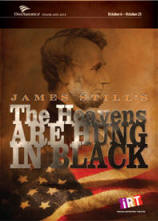 Nelson talked with James about the complicated character of Abraham Lincoln and the agonizing decisions that confronted him during the era depicted in the play. It's set during the spring and summer of 1862, when the Civil War was raging (with an uncertain outcome) and the Lincolns were mourning the death in the White House of their beloved son Willie. During the play, President Lincoln reflects on his nighttime habit of staring at the stars "when I was a boy in Indiana"; as Hoosier history lovers know, he lived here from age 8 through 21. In James' play, Lincoln interacts, in fictionalized sequences, with famous 19th-century figures such as poet Walt Whitman, Confederate leader Jefferson Davis, abolitionist John Brown, civil rights icon Dred Scott, political rival Stephen Douglas, and actor Edwin Booth.
Nelson talked with James about the complicated character of Abraham Lincoln and the agonizing decisions that confronted him during the era depicted in the play. It's set during the spring and summer of 1862, when the Civil War was raging (with an uncertain outcome) and the Lincolns were mourning the death in the White House of their beloved son Willie. During the play, President Lincoln reflects on his nighttime habit of staring at the stars "when I was a boy in Indiana"; as Hoosier history lovers know, he lived here from age 8 through 21. In James' play, Lincoln interacts, in fictionalized sequences, with famous 19th-century figures such as poet Walt Whitman, Confederate leader Jefferson Davis, abolitionist John Brown, civil rights icon Dred Scott, political rival Stephen Douglas, and actor Edwin Booth.
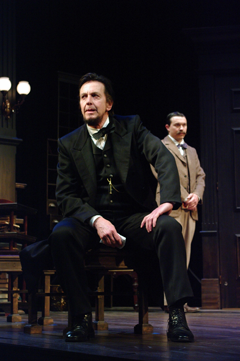 According to James, the title for The Heavens Are Hung in Black is taken from one of Lincoln's speeches. Nelson plans to ask the playwright about the challenges in writing about an iconic figure, his creative choices, how and why he has reshaped the play for the IRT after its performance at Ford's Theatre, and his historic research. (FYI: Some of James's groupies from Indiana even trekked to the nation's capital last February to catch the play in its premiere run.)
According to James, the title for The Heavens Are Hung in Black is taken from one of Lincoln's speeches. Nelson plans to ask the playwright about the challenges in writing about an iconic figure, his creative choices, how and why he has reshaped the play for the IRT after its performance at Ford's Theatre, and his historic research. (FYI: Some of James's groupies from Indiana even trekked to the nation's capital last February to catch the play in its premiere run.)
"One thing that was quickly apparent: The cult of celebrity existed in the 19th century just as it does now," James writes in an ongoing blog about the play that he's been contributing to irtlive.com. Then as now, James writes, people attempted to "cash in" on their relationships with a charismatic president, meaning whenever James uncovered a compelling anecdote, he always sought verification from a second source.
Although he grew up in Kansas, where his father was a high-school history teacher, James is based primarily on the west coast these days. He escaped to Italy to write the Lincoln play. James has been an influential figure on the central Indiana art scene for more than a decade. Now in his 11th year as the IRT's playwright-in-residence, he frequently tackles topics with Hoosier connections. For example, he was our studio guest in May during the run of Interpreting William, a play that analyzed the character of pioneer entrepreneur William Conner, of Conner Prairie fame. This time 'round, James was Nelson's guest by long-distance phone, although he continually makes trips to Indy during the reshaping of (and rehearsals for) The Heavens Are Hung in Black. As James notes in his blog, the play premiered just two weeks after Barack Obama was inaugurated "with his hand on Abraham Lincoln's Bible."
Even aside from the Year of Lincoln, 2009 was quite a year for James, who in August received a national award in a ceremony at New York's fabled Sardi's Restaurant. Standing in front of the rows of caricatures of theatrical legends that adorn Sardi's walls, he received the Medallion of the Children's Theatre Foundation of America.
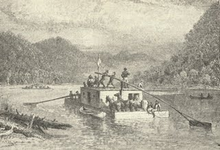 When Abraham Lincoln was a 19-year-old Hoosier in 1828, he was hired, along with a friend, to take a cargo of goods on a flatboat to a city in the Deep South. Abe Lincoln and his friend, Allen Gentry, embarked on the flatboat trip from Rockport, Indiana. The three-month adventure was said to be eye-opening for young Abe, who for the first time witnessed slavery in the Deep South city that was his destination.
When Abraham Lincoln was a 19-year-old Hoosier in 1828, he was hired, along with a friend, to take a cargo of goods on a flatboat to a city in the Deep South. Abe Lincoln and his friend, Allen Gentry, embarked on the flatboat trip from Rockport, Indiana. The three-month adventure was said to be eye-opening for young Abe, who for the first time witnessed slavery in the Deep South city that was his destination.
Question: Name the Southern city where Abraham Lincoln and Allen Gentry took the goods on the 65-foot long flatboat. The prize was a pair of tickets to the Eiteljorg Museum, plus a pair of tickets to Conner Prairie, courtesy of the Indianapolis Convention & Visitors Association.
Carole Lombard, born as Jane Alice Peters on Oct. 6, 1908, lived with her parents and two brothers in a two-story house on Rockhill Street in Fort Wayne. (The historic house, located near the St. Mary's River, is still there.) She moved to California with her mother and brothers, breaking into the movies during the 1920s. In the 1930s, Carole Lombard became hugely popular in sophisticated comedies such as “My Man Godfrey” (1936) and “Nothing Sacred” (1937); at one point, she was Hollywood's highest-paid actress.
She had been married to the “King” of Hollywood, Clark Gable, for about three years when she returned to Indiana in January 1942 during the early months of World War II. Lombard set records selling war bonds at rallies in Indianapolis, but was killed (along with her mother) when her return flight crashed en route to southern California. Carole Lombard and Clark Gable are buried next to each other in Forrest Lawn Cemetery in Los Angeles.
The painting, titled “Daisy at the Piano” depicts T.C. Steele's daughter Daisy. It sold for $246,000 during an auction in 2004. The painting was purchased by Lafayette residents Bill and Ellie Haan, who own an extensive collection of “Hoosier Group” artwork. The “Hoosier Group” consisted of Steele and four other Indiana artists who won national acclaim at the turn of the 20th century. T.C. Steele was the most famous artist of the “Hoosier Group” and the painting sold for a record amount. Steele created it in 1893. Although T.C. Steele primarily was known for his landscape paintings of Brown County, the record amount was fetched for this painting.
A wooden, one-room schoolhouse called the Corydon Colored School opened in 1891 for the education of black children and teenagers in southern Indiana. Today, the restored Leora Brown School one of Indiana's oldest buildings used to educate African-Americans, is the setting for tours as well as discussions about segregation, slavery and historic preservation.
The key figure who organized a community-wide restoration of the historic school is Maxine Brown the great-niece of Leora Brown. Maxine, whose ancestors settled in far-southern Indiana during the early 1800s, named the restored school after her great-aunt, who attended the Corydon Colored School as a girl, obtained a college education, and then returned to teach at the segregated school for 26 years until it closed in 1950.
The Frankfort High gymnasium, which seats 6,000 spectators, was featured in the 1994 movie “Blue Chips”. It starred Nick Nolte as a college basketball coach modeled after Bobby Knight, who has a cameo role in the film. Frankfort is located in Clinton County and was founded in 1830 by brothers whose grandparents had lived in Frankfurt, Germany. As noted in Hoosiers All, the town always has had fun with its name. “Every July, during the dog days of summer, the annual Frankfort Hot Dog Festival is held.” The Frankfort Hot Dogs basketball team won four state championships between 1925 and 1939.
In the 1840s, national attention focused on
Indiana town Plainfield located on the National Road because of a
rather shocking incident. Residents of the town, who were angry at
former U.S. President Martin Van Buren for having vetoed a bill to improve the National
Road, overturned his stage coach. After purposefully being tipped
over, the carriage spilled the former President into the mud on the
road. The intent was to show him fist-hand the need for road
improvements. The incident occurred in 1842, when Van Buren was traveling through
the town two years after his term as President. At that point, he
was considered running for the White House again. (In Plainfield, the
National Road (U.S. 40) is Main Street.)
The episode involving Van Buren's stage coach has become a major
part of Plainfield's history and folklore. A school built near the
site of the episode is named Van Buren Elementary School, and a
massive tree at the site became known as the Van Buren Elm.
Decatur Township, located in the southwestern corner of Marion County, includes a family farm of more than 600 acres. It's a corn, soybean and walnut tree farm that was established by the ancestors of a currently famous Hoosier. Since the mid-1950s, this famous Hoosier has managed the farm in Decatur Township he inherited. Long before he entered politics, Dick Lugar began managing the 604-acre family farm in Decatur Township following the death of his father, Marvin Lugar, in 1956.
Marvin Lugar had grown up in Decatur Township and graduated from the former Valley Mills High School, where his father – the grandfather of Sen. Lugar – coached the basketball team. In 1930, Valley Mills High School burned to the ground. At that point, high schools in the township were consolidated, resulting in the formation of Decatur Central High School. The Lugar family still owns the corn, soybean and walnut tree farm.
Forty years ago – in 1969 – Hollywood released a major movie that was partially filmed at the Indianapolis Motor Speedway. “Winning,” which starred Paul Newman and his real-life wife, Joanne Woodward, focused on an ambitious race driver determined to win the Indianapolis 500. Many scenes in the movie were filmed at the Speedway during May 1968. Several long, tracking shots in the movie depict the thousands of spectators at the infield during the race. In addition to Newman (who would go on to co-own racing teams) and Woodward, “Winning” starred Richard Thomas, soon to become more famous as “John Boy” on "The Waltons” TV series. Several real-life racing figures – including the Speedway's owner, Tony Hulman, and race driver Bobby Unser – portray themselves in the movie.
In the 1870s and ‘80s, several distinguished Indiana painters who were members of the Hoosier Group, including T.C. Steele, traveled overseas to study art in Munich, Germany. By the1880s, T.C. Steele was establishing a reputation as a prominent portrait painter in Indianapolis. Impressed with Steele's talent, wealthy Hoosier benefactors, including Herman Lieber and members of the Fletcher family, offered to send Steele and his family to Munich to study for two years. The Steeles, who enjoyed Munich, ended up staying for five years before returning to Indianapolis in 1885. In addition to Steele, Hoosier Group artists William Forsyth, Ottis Adams, and Otto Stark also studied about the same time in the this major European city with master artists there.
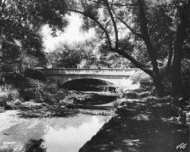 Garfield
Park on the Southside generally is considered to be the oldest park
in the Indianapolis park system, but it initially had a different
name. Garfield Park traces its beginnings to 1873, when the city
purchased the land – then totaling 98 acres -- from civic leaders
who had created a harness racetrack on the site. The park initially
was known by the name used for the racetrack, but was it renamed in
tribute to President James A. Garfield after his assassination in
1881. The initial name of Garfield Park was Southern Park. In the
decades after its renaming, Garfield Park became popular for its
pagoda, which served as the focal point for dances, as well as for
its sunken gardens, which opened in 1916, and its conservatory.
Today, Garfield Park also includes the MacAllister Center for the
Performing Arts.
Garfield
Park on the Southside generally is considered to be the oldest park
in the Indianapolis park system, but it initially had a different
name. Garfield Park traces its beginnings to 1873, when the city
purchased the land – then totaling 98 acres -- from civic leaders
who had created a harness racetrack on the site. The park initially
was known by the name used for the racetrack, but was it renamed in
tribute to President James A. Garfield after his assassination in
1881. The initial name of Garfield Park was Southern Park. In the
decades after its renaming, Garfield Park became popular for its
pagoda, which served as the focal point for dances, as well as for
its sunken gardens, which opened in 1916, and its conservatory.
Today, Garfield Park also includes the MacAllister Center for the
Performing Arts.
 In 1905, a major milk company,
Polk's Best Jersey Milk, based
in Indianapolis built a very unusual-looking headquarters and
bottling plant on the near-Northside. The corners of the company's
entrance were shaped like giant milk bottles and was located at E. 15th Street and Lewis Street. Founded by Civil War veteran James Polk,
the company had a slogan – “Polk's milk – always ahead” – that was
framed around a cow's head. Although Polk's became the state's'
largest milk company, it began experiencing financial problems
during the 1950s because of competition from large food chains. The
bottling plant was torn down in the 1960s, but the milk company's
old stables still stand. The stable building, where Polk kept its
delivery horses are now are part of a maintenance complex for
Indianapolis Public Schools. This made the building
an eye-catching landmark for more than 55 years, until it finally
met the wrecking ball in the 1960s. The company had been founded in
1893 by a Greenwood resident who was a Civil War veteran.
In 1905, a major milk company,
Polk's Best Jersey Milk, based
in Indianapolis built a very unusual-looking headquarters and
bottling plant on the near-Northside. The corners of the company's
entrance were shaped like giant milk bottles and was located at E. 15th Street and Lewis Street. Founded by Civil War veteran James Polk,
the company had a slogan – “Polk's milk – always ahead” – that was
framed around a cow's head. Although Polk's became the state's'
largest milk company, it began experiencing financial problems
during the 1950s because of competition from large food chains. The
bottling plant was torn down in the 1960s, but the milk company's
old stables still stand. The stable building, where Polk kept its
delivery horses are now are part of a maintenance complex for
Indianapolis Public Schools. This made the building
an eye-catching landmark for more than 55 years, until it finally
met the wrecking ball in the 1960s. The company had been founded in
1893 by a Greenwood resident who was a Civil War veteran.
Today, there is a vacant lot at the corner of 10th and Delaware streets. However, in 1899 the esteemed architectural firm of Vonnegut & Bohn built a synagogue on the site for the Indianapolis Hebrew Congregation. After the congregation moved farther north, the former synagogue building became a very different house of worship in the late 1950s and early '60s. Its preacher--Rev. Jim Jones, founder of the Peoples Temple--eventually became a household name after moving from Indianapolis. In the late 1950s and early ‘60s, Rev. Jones oversaw a racially integrated Christian congregation in the former synagogue building at 10th and Alabama. He also began a social ministry, operating a soup kitchen and providing nursing care for the elderly. Jones, who had been born in 1932 in Lynn, Indiana, eventually cast himself as a prophet and convinced more than 140 church members to resettle in California. In the 1970s, he established Jonestown, a commune in Guyana, where he convinced his followers to join him in drinking cyanide-laced Kool-Aid in a mass ritual. Jones became notorious for overseeing the 1978 mass murder-suicide in Guyana, South America, during which more than 900 of his followers died, including several who had begun attending his services in Indianapolis.
William Conner and his older brother John were Hoosier pioneers. Like William, John was born in Ohio, grew up in Michigan and began trading furs with Native Americans in the Indiana wilderness. While William Conner of Conner Prairie fame, set up a trading post and cabin on the White River near what became the town of Noblesville, John Conner went on to plan a town elsewhere in Indiana, Connersville, a town named in John Conner's honor. He headed southeast in the Indiana Territory while his brother William settled in what became Hamilton County. According to a story told by John Conner's granddaughter, he was building his cabin – it didn't even have a roof or floors yet – when a wagon of immigrants drew up and asked to be directed to Connersville. Laughing, Conner replied, “My friend, you are right in the heart of town.” Like his brother, John Conner seized business opportunities. In the 1820s, as the new state capital of Indianapolis was being developed, he opened a dry goods store here. He died a few years later in 1826.
When the Indianapolis 500 was suspended during World War II, the Indianapolis Motor Speedway greatly deteriorated due to neglect. After the war ended, weeds were growing in the racetrack. Serious consideration was given to abandoning the 500 Mile Race and converting the Speedway into a housing subdivision. However, a famous Hoosier convinced Terre Haute millionaire Tony Hulman to buy the Speedway in 1945, and the Indianapolis 500 went on to even greater glory than before the war. Race driver Wilbur Shaw, a three-time winner of the Indianapolis 500 persuaded Tony Hulman to buy the Speedway. Wilbur Shaw, who was born in Shelbyville in 1902, started out as a teenage errand-boy in Gasoline Alley. As a driver, he won the race in 1937, 1939, and 1940, making him the first to earn back-to-back wins. Shaw almost captured a fourth 500 victory in 1941, the final race before World War II. He was in the lead when a wheel hub broke off on his Masuerati, causing an accident. Eventually Wilbur Shaw became American's premiere racing promoter. He was killed in 1954 in a private plane crash in northeastern Indiana.
John Mellencamp was so captivated by "HUD" (1963), a movie starring Paul Newman, that he named one of his children after the actor's character. Mellencamp, who was born in Seymour and lives near Bloomington, has said the dialogue in the movie, for which Newman was nominated for an Academy Award, influenced the lyrics of several of his songs. Mellencamp and his wife, Elaine, gave the name “Hud” to their oldest son. Fourteen-year-old Hud Mellencamp recently made headlines by winning a division title in the Indiana Golden Gloves boxing tournament. The match featuring Hud, who boxes for the Indy Police Athletic League, was held at the Tyndall Armory in Indianapolis.
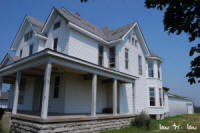 The Victorian-era home, known as the Dunham House, was built
on land homesteaded by Jacob Dunham (1795-1865), whose descendants
eventually settled in Kansas, where Ann Dunham grew up. Obama – accompanied by wife
Michelle and their daughters Malia and Sasha – visited last May
during the presidential primary campaign. The last Dunham to live
in the farmhouse, Hazel, died in 1969. Jacob Dunham was Obama's
great-great-great-great-grandfather.
The Victorian-era home, known as the Dunham House, was built
on land homesteaded by Jacob Dunham (1795-1865), whose descendants
eventually settled in Kansas, where Ann Dunham grew up. Obama – accompanied by wife
Michelle and their daughters Malia and Sasha – visited last May
during the presidential primary campaign. The last Dunham to live
in the farmhouse, Hazel, died in 1969. Jacob Dunham was Obama's
great-great-great-great-grandfather.
In July 1934, authorities caught up with – and killed – “Public Enemy No. 1”, Hoosier-born bank robber John Dillinger, when he emerged with two women friends from a movie theater in Chicago. One of the women, Anna Sage of East Chicago, Ind., had tipped off federal agents they would be watching a movie at the Biograph Theatre. When Dillinger and his companions emerged from the Biograph, a shoot-out ensued in the 101-degree heat, and the outlaw was killed. Anna Sage became known as “The Lady in Red”, but she always claimed she was not wearing a red skirt that fateful night.
Anna Sage, a Romanian immigrant, was a former brothel owner in East Chicago. She had two reasons for tipping off federal agents about Dillinger: She wanted the $10,000 reward, and she also hoped to ingratiate herself with authorities because she was about to be deported as an undesirable alien. Anna Sage always claimed that she wore an orange skirt on the night Dillinger was killed, even though she has gone down in history as “The Lady in Red.” Anna Sage eventually received only about half of the $10,000 reward, and authorities did deport her to Romania. She died in Europe after World War II.
Almost all of the native Hoosiers who have become astronauts – from Gus Grissom to David Wolf – have attended Purdue University, which bills itself “The Mother of Astronauts.” Joe Allen, who was born in Crawfordsville in 1937 and graduated from Crawfordsville High School, was the only Hoosier astronaut who did not attend Purdue. After his years at DePauw and Yale, he was chosen by NASA as an astronaut-scientist in 1967, the same year that Gus Grissom was killed. As an astronaut, Joe Allen flew on two space missions, including a spectacular salvage mission in 1984 during which he rescued a stranded satellite by flying over to it with a jet backpack. After 18 years with NASA, Joe Allen left the space agency in 1985 to become CEO of a private business based in Houston, Texas, that deals with space exploration.
Caroline Scott Harrison, the only First Lady from Indiana, started the china collection for the White House, which continues to this day. Mrs. Harrison began the collection during the presidency of her husband, Benjamin Harrison, who was elected in 1888. As a tribute, the portrait painting of her is displayed near the China Room in the White House.
Mrs. Harrison died in the White House of tuberculosis in 1892, two weeks before her husband lost his bid for re-election. Thousands of Hoosiers watched the First Lady's funeral procession to Crown Hill Cemetery.
Elwood Haynes, still remembered today as a pioneer in the auto industry, was born in Portland, Indiana in 1857, but moved to Kokomo during the area's natural gas boom in the early 1890s. The Hoosier inventor is credited with creating one of the very first gasoline-powered cars in America. During a test run in 1894, the “horseless carriage” reached a top speed of about 7 miles per hour. To avoid scaring horses on city streets, the test run was conducted in a rural area near Kokomo, which was the inventor's adopted hometown. He built automobiles in Kokomo until the 1920s. His pioneer auto is on permanent display at he Smithsonian Institution in Washington DC. For a variety of reasons – including Haynes' refusal to budge from the luxury car market – his auto company went bankrupt in 1924, throwing 400 workers out of jobs. Haynes died the next year.
Greg Kinnear was an Oscar nominee for his performance in “As Good As It Gets” (1997), a movie that won lead acting Academy Awards for Jack Nicholson and Helen Hunt. His family owned a vending business in Logansport, where he was born in 1963. When the future actor was 9 years old, his father became a diplomat and the family moved overseas.
Greg's teenage years were spent in Beirut, Lebanon, and Athens, Greece. He launched his career as a TV personality, hosting cable and late-night talk shows. Then, Sydney Pollack cast him as Harrison Ford's kid brother in the remake of “Sabrina” in 1995. Greg Kinnear's other movies have included “You've Got Mail” (1998) with Tom Hanks and Meg Ryan; “Auto Focus” (2002), and “Little Miss Sunshine” (2006).
The largest natural lake in Indiana is Lake Wawasee, which is located near the town of Syracuse in northeastern Indiana. A spring-fed lake, Lake Wawasee is 3,060 acres in size.
The second-largest natural lake in Indiana is Lake Maxinkuckee, near Culver in north-central Indiana. With a name from the Potawatomi Indians who once were the predominant tribe in northern Indiana, Lake Maxinkuckee covers1,864 acres. During the winter, residents of Marshall County and visitors frequently ice-fish at the lake, where the most common catch is blue-gill. The campus of Culver Military Academy is located on the lake, which has an average depth of 24 feet.
The largest man-made lake in the state is Lake Monroe, near Bloomington.
When he was en route to Washington D.C. for his inauguration in 1861, President-elect Abraham Lincoln delivered a speech in Indianapolis that made national headlines. Speaking from a balcony at the Bates House hotel, Lincoln spoke out in definitive terms about the need to preserve the Union as hundreds of Hoosiers cheered. His speech had a national impact because it was Lincoln's first major policy statement as a president-elect. The Bates House, which was built in the early 1850s, was considered the city's finest hotel, as befit the president-elect. The hotel stood at the northwest corner of Washington and Illinois streets until 1901, when it was razed.
The Claypool Hotel replaced the Bates House at the NW corner of Washington and Illinois – a location that, interestingly, has been a hotel site for most of city history. When the posh Claypool Hotel opened in 1903, some accounts described its lobby as the largest in the country. For decades, the Claypool was regarded as one of the most elegant hotels in the Midwest, with a dazzling array of distinguished, overnight guests who included Eleanor Roosevelt, Gene Autry and Jack Benny. It closed two years after a fire in 1967.
Today, the NW corner of Washington and Illinois is the site of the Embassy Suites and Claypool Grille.
Hoosier native Major Taylor became an American and world champion bicycle racer, dominating the sport during its first peak in popularity 100 years ago.
Throughout his life, Major Taylor refused to compete on Sundays because of a promise to his mother “to lead an upright Christian life.” For example, in 1899 – after winning the world sprint championship – Major Taylor turned down a $10,000 offer to race in Europe because the competitions were to be on a Sunday. Two years later, though, he toured Europe with the promise there would be no Sunday racing. “The Ebony Streak” became hugely popular, particularly in France.
Major Taylor met kings and queens of Europe, but his wealth and fame were fleeting. Because of the abrupt decline in the popularity of bicycle racing – along with financial mistakes and other problems -- Major Taylor was poverty-stricken when he died in 1932 and buried in an unmarked pauper's grave in Chicago. Years later, the Schwinn Bicycle Company paid for a bronze monument and organized a belated memorial service attended by many of the country's top athletes.
Founded in 1850, the Slippery Noodle has endured many name changes and scandals. It was built on South Meridian Street as a roadhouse called The Tremont House. Before the Civil War, it may have been a stop on the Underground Railroad.
In the 1860s, its name was changed to the Concordia House, then to the German House. Because of anti-German sentiment during World War I, the German House became Beck's Saloon. During the Great Depression in the 1930s, it was known as Moore's Beer House; that's when gangster John Dillinger patronized the bar with his cronies. Eventually, a bordello operated upstairs. After two patrons quarreled over a woman – one patron pulled a knife and stabbed the other to death -- the place shut down.
Its reputation was restored in 1963 when it was purchased by the parents of current owner Hal Yeagy; they christened it The Slippery Noodle. Today, the Noodle is a tavern and restaurant that's nationally known for blues music.
In 1820, a group of Hoosier power brokers met to hash out a new location for our state capital. Corydon, which had been serving as the capital since Indiana achieved statehood in 1816, was judged to be too far south for statewide convenience. They eventually settled on the undeveloped lowlands and swamps that became the city of Indianapolis, chosen for its location smack in the center of the state.
The site of the meeting was the log cabin of William Conner of Conner Prairie fame, where he lived in 1820, and was located on the White River near Noblesville. The group of state leaders, including the governor, also met under a tree on Conner's property. Conner hoped the state capital would be in the Noblesville area. However, surveyors advised the powerbrokers that the future Indianapolis site was precisely in the Hoosier state's center.
Even though he named his fabulously successful business Colonel Harland Sanders actually was born in Clark County, Indiana.
In 1956, Crest hit the market of a product used every morning in homes across the country. The new brand became enormously popular – and remains so today. It's made by Proctor and Gamble, which is not based in Indiana. However, the Proctor and Gamble product contains ingredients – or compounds – patented by three researchers at Indiana University.
The legendary Gimbels department store based in Manhattan had its roots with merchant Adam Gimbel of Vincennes.
Vera Bradley, which designs and makes cotton-quilted handbags, travel bags and an expanding array of other products. The business was founded by two neighbors in 1982 in Fort Wayne, Pat Miler and Barbara Baekgaard, who named the business after Barbara's mother in 1982. Within three years, sales of Vera Bradley products had reached $1 million.
Later this month, Pat Miller and Barbara Baekgaard will be named Living Legends by the Indiana Historical Society.
In Crawfordsville at a YMCA in 1894 the first basketball game in Indiana was played. The Crawfordsville team beat a team from Lafayette by the score of 45 to 21. Basketball quickly became popular across Indiana.
The very first official basketball game ever was played two years earlier, in 1892, at a YMCA in Springfield, Mass. The inventor, James Naismith, set up a peach basket in which players scored points with their shots.
There's a fascinating “flaw” in the 1969 official photo of front-row qualifiers for the Indianapolis 500 The “flaw” in the photo concerns Mario Andretti, who went on to win the 500-Mile Race that year.
It's actually not Mario in the official photo of front-row qualifiers for the 1969 race. Instead, his identical twin brother, Aldo Andretti, posed as Mario for the photo. Also, who left racing to become an Indianapolis businessman (as well as the father of current driver John Andretti), didn't want to pose as his twin. But Mario insisted.
A few days before the photo session, Mario had endured a fiery crash. He was burned on his upper lip and didn't want to be photographed that way. So he prevailed on his twin brother to pose alongside the two other front-row drivers for the official photo. The ruse was kept a secret initially, but word eventually leaked out to racing enthusiasts.
In June 1993, the city of Marion, Indiana, found itself in the national news because of an unexpected event that occurred there. Movie star Julia Roberts married singer-songwriter Lyle Lovett at St. James Lutheran Church in Marion, Indiana, after a three-week courtship. They eloped and married in Marion because Lyle Lovett was on a concert tour; his next performance was at then-Deer Creek Music Center near Noblesville. Julia Roberts and Lyle Lovett announced their divorce less than two years later, in March 1995.
During the Civil War, a greater percentage of young men and teenagers of military age from Indiana fought in “Mr. Lincoln's Army,” the Union Army, than any other state except one. Delaware was the only state that had a greater percentage of young men in the Union Army.
Hoosier History Live! is proud to offer samples of our groundbreaking radio show for your listening pleasure.
(Aug. 1, 2009) - It's been called “the government's first highway project” – and it stretched east-west across Indiana. Created beginning in Maryland in 1811, the old National Road was intended to be the first road funded by the federal government to span the country. Constructed in stages, the National Road was open across Indiana by the late 1830s and brought thousands of settlers from the East Coast across the state, often traveling with Conestoga wagons, horses and buggies, and produce wagons. “Many new settlements sprang up along the Indiana route to provide stops for the travelers,” James Glass wrote in one of his recent “Culture Watch” columns for The Indianapolis Star. Among the Hoosier communities that sprang up: Cambridge City, Knightstown, Greenfield, Plainfield, and Brazil. Jim, the director of Historic Preservation and Archaeology for the state's DNR, was Nelson's studio guest and explored the impact of the fabled road that paved the way – but also had its ups and downs.
The Indianapolis portion of the National Road became Washington Street, which was built as the widest downtown thoroughfare to accommodate the traffic. The National Road's importance dipped with the railroad boom in the 1850s, but revived with the advent of the car; the old National Road then became a portion of U.S. 40. Every May in recent years, 825 miles of the highway across Indiana (actually, the stretch from Maryland to Illinois) serve as the National Road Yard Sale, attracting thousands of bargain hunters. Finally, there is the website for a recent Ball State documentary about the Road at www.moversandstakers.com
(May 16, 2009) - 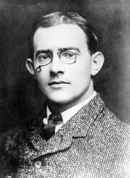 Amid
the hoopla about the 100th anniversary of the opening of the Indianapolis
Motor Speedway Hoosier History Live! explored the life
of flamboyant entrepreneur Carl Fisher, who led a group of partners that developed the racetrack in 1909 as
a way to spotlight the automobile, then in its infancy. A master
showman, Fisher (1874-1939) even competed in the first race at the
Speedway, a hot air balloon competition in which Fisher piloted an
entry titled “Indiana.”
Amid
the hoopla about the 100th anniversary of the opening of the Indianapolis
Motor Speedway Hoosier History Live! explored the life
of flamboyant entrepreneur Carl Fisher, who led a group of partners that developed the racetrack in 1909 as
a way to spotlight the automobile, then in its infancy. A master
showman, Fisher (1874-1939) even competed in the first race at the
Speedway, a hot air balloon competition in which Fisher piloted an
entry titled “Indiana.”
Nelson was joined in studio by public historian Glory-June Greiff, an expert on sculptures and monuments across the state (they are the subject of her book Remembrance, Faith & Fancy published by the Indiana Historical Society Press), as well as the roller-coaster career of Carl Fisher, who opened one of the state's first auto showrooms and co-founded Prest-O-Lite Storage Battery Company. His influence stretched far beyond founding the Speedway. From his beginnings as a teenage bicycle salesman (despite being half-blind since birth, Fisher undertook high-wire stunts in downtown Indy to promote his merchandise), he eventually transformed a Florida mangrove swamp into one of the Sunshine State's first resorts, Miami Beach. Glory-June and Nelson also discussed Fisher's lavish mansion, now a landmark on the Marian College campus; his marriage to a much-younger woman who sought his help when her house caught fire, and his role as an organizer of the Lincoln Highway. Along the way, Carl Fisher made a fortune – and had lost almost all of it by the time he died.
(Jan. 10, 2009) - Snowstorms, ice, sleet, howling winds and long, dark nights. With all of that, winter in Indiana can be a major challenge in the 21st century. Ever wonder how the early Hoosier pioneers and Native Americans made it through? 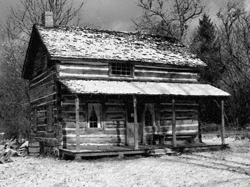 Nelson’s studio guest, Jim Willaert, now general manager of guest experience at Conner Prairie, tackled a blizzard of questions about how folks survived harsh winters in the Indiana wilderness of the 1820s and '30s.
Nelson’s studio guest, Jim Willaert, now general manager of guest experience at Conner Prairie, tackled a blizzard of questions about how folks survived harsh winters in the Indiana wilderness of the 1820s and '30s.
Jim, whose various responsibilities at Conner Prairie have included serving as the experience manager of the Lenape Village and Conner Homestead, proved to be a fountain of information.
Where and how did white settlers and Native Americans store their food during the long winter? Without access to fresh fruit, why didn't everyone here in the 1830s get scurvy? What about drinking water? And was it ever truly comfortable in the lean-tos and wooden cabins of the pioneers or the Native Americans' wigwams?
Those are just a sampling of the questions that Jim tackled. He even shared some advantages that the cold months brought to the pioneers and Native Americans here. FYI: The predominant Native American tribe in Central Indiana during the 1820s and '30s was the Delaware (Hoosier History Live! explored the Delaware in our Feb. 16, 2008 show), also called the Lenape. According to Jim, they lived in wigwams or log cabins similar to the white settlers. Obviously, no one enjoyed furnaces, snow plows, plumbing and refrigerators.
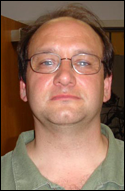 During the show, Jim explains:
During the show, Jim explains:
Jim recently suggested the following websites to learn more about modern winter survival skills:
As hard as it may be to imagine for those who hate winter, Jim also shares some advantages that the cold months brought for pioneers and Native Americans.
(Aug. 16, 2008) - Did you know the Circle Theatre on Monument Circle was considered one of the most lavish silent movie palaces west of New York when it opened in 1916? Listen to three generations discuss Indy's crown jewel, The Circle Theatre, on our August 16, 2008 show.
Dave L. Smith, former host of WISH-TV's popular When Movies Were Movies series, Chris Gahl, our "Roadtripper" and Nelson Price talk about the impact of the Circle Theatre on the Circle City.
(April 5, 2008) - Listen to our April 5, 2008 Sears Kit Homes show with Guest Paul Diebold of the Indiana Department of Natural Resources.
Caller shares with our guest Paul about a kit home with an indoor/outdoor fish pool.
(June 7, 2008) - For more than a century, Elkinsville, Ind., was a small, peaceful farming town nestled amid the rolling hills of southwestern Brown County. Because of the construction of Lake Monroe in the 1960s, all of the residents of Elkinsville were forced to move. Among the families who moved were Raymond and Marie Lucas, along with their four children, Forrest, Carol, Connie and Brenda. Both "in studio" and via telephone, the Lucas siblings tell the story of their early years in Elkinsville. Forrest, the eldest, went on to become the CEO of Lucas Oil.
 There's treasure buried everywhere in the Hoosier History Live! website ...
There's treasure buried everywhere in the Hoosier History Live! website ...
In the Elkinsville show audiocast, you can hear the thunder and lightning in the background. It was recorded at 11:30 a.m. to noon on the day of the June 6, 2008 flood. The basement of Brenda (youngest sister) was flooded when she came up from Columbus, Ind., to Indy to do the show — although, as she later said, it would have flooded anyway, whether she came to Indy or not. It took Carol and Brenda something like 10 hours to drive back to back to Columbus.
(Jan. 16, 2008) - Listen to Survival Tales from the the Blizzard of January 1978 on its 30th anniversary, Jan. 16, 2008.
Craig Widener, former chief operating officer of the Indianapolis chapter of the American Red Cross, shares how the city opened its Red Cross Shelter to stranded Greyhound passengers:
Caller talks about being stranded at O'Malia's grocery store in Carmel:
Peggy Sabens of the Meridian Street Foundation, host Nelson Price, Chris "The
Roadtripper" 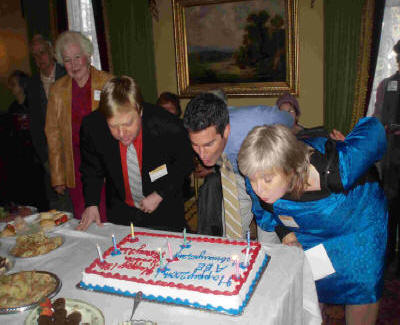 Gahl and producer Molly Head blow out their first-year birthday cake candles presented to them by the Meridian Street
Foundation.
Gahl and producer Molly Head blow out their first-year birthday cake candles presented to them by the Meridian Street
Foundation.
The party for Hoosier History Live! at the Morris-Butler House was sponsored by the Historic Landmarks Foundation of Indiana on Abe's 200th birthday, Feb. 12.
President Marsh Davis of Historic Landmarks Foundation of Indiana said, "It was great to see the old house come to life."
(Photo by Bill Holmes.)
 'Tis
prime season to explore Indiana-made antiques as well as to share a
potpourri of tips and advice about antiquing across Hoosierland.
Nelson was joined in studio by the ideal guest to weigh in:
antiques maven Lynn Hopper who writes the popular
“Antiques & Collectibles” column in The Indianapolis Star. Lynn chated about cherished Indiana-made collectibles, including
Wooten Desks, Hoosier Cabinets (regular listeners will recall that
their history was the focus of a recent Hoosier History Live! show), Greentown Glass (to left) and Uhl
Pottery (to right).
'Tis
prime season to explore Indiana-made antiques as well as to share a
potpourri of tips and advice about antiquing across Hoosierland.
Nelson was joined in studio by the ideal guest to weigh in:
antiques maven Lynn Hopper who writes the popular
“Antiques & Collectibles” column in The Indianapolis Star. Lynn chated about cherished Indiana-made collectibles, including
Wooten Desks, Hoosier Cabinets (regular listeners will recall that
their history was the focus of a recent Hoosier History Live! show), Greentown Glass (to left) and Uhl
Pottery (to right).
She also is brimming with tips about antique-hunting, a passion for so many Hoosiers. “Always Look on the Bottom!” is the title of an advice-filled presentation that Lynn gives to fellow enthusiasts. Please note that Lynn does not do appraisals, on or off the air. This show came just in time to spotlight the 40th anniversary of the Hoosier Antiques Expo which returned to the Indiana State Fairgrounds Sept. 11-13. “In the world of antiques, 40 years is a long time – to stay in business,” Lynn wrote in a recent column. As Lynn also wrote in a recent column, “Antiques and history go hand in hand.”
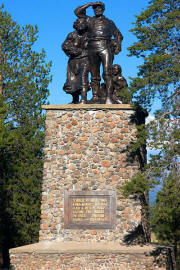 It's
been called one of the greatest tragedies in the history of Westward
migration. The Donner Party tragedy's most gruesome aspects occurred in the Sierra
Nevada mountains during the brutal winter or 1846-47, but there are
some Hoosier links with the ill-fated wagon train. Nelson's studio
guest not only explained the Indiana connection, he shared
lessons derived (in conflict resolution, leadership selection, and
group decision-making) from the tragedy that involved stranded,
California-bound pioneers, some of whom eventually resorted to
cannibalism. Although group leader George Donner was born
in North Carolina and, as a 62-year-old farmer, was based in
Springfield, Ill., when the expedition headed West, he had lived for
several years in Greensburg, Indiana. In fact, Nelson's guest,
Hoosier business consultant and speaker Karl Ahlrichs is a
descendant of George Donner, one of whose wives is buried in
Indiana. (A subsequent wife, Donner's third, accompanied the
California-bound group.) The “Donner” name not only is on sites in
California (including what is now known as Donner Pass, where some
of the more than 40 deaths occurred). It also is on parks and
buildings in southern Indiana because of the influence of the
extended family in this state. After researching what happened with
the Donner Party and why, Karl explained how he uses this
historic episode to enhance decision-making and critical thinking
skills. (Photo courtesy: Donner
Memorial State Park)
It's
been called one of the greatest tragedies in the history of Westward
migration. The Donner Party tragedy's most gruesome aspects occurred in the Sierra
Nevada mountains during the brutal winter or 1846-47, but there are
some Hoosier links with the ill-fated wagon train. Nelson's studio
guest not only explained the Indiana connection, he shared
lessons derived (in conflict resolution, leadership selection, and
group decision-making) from the tragedy that involved stranded,
California-bound pioneers, some of whom eventually resorted to
cannibalism. Although group leader George Donner was born
in North Carolina and, as a 62-year-old farmer, was based in
Springfield, Ill., when the expedition headed West, he had lived for
several years in Greensburg, Indiana. In fact, Nelson's guest,
Hoosier business consultant and speaker Karl Ahlrichs is a
descendant of George Donner, one of whose wives is buried in
Indiana. (A subsequent wife, Donner's third, accompanied the
California-bound group.) The “Donner” name not only is on sites in
California (including what is now known as Donner Pass, where some
of the more than 40 deaths occurred). It also is on parks and
buildings in southern Indiana because of the influence of the
extended family in this state. After researching what happened with
the Donner Party and why, Karl explained how he uses this
historic episode to enhance decision-making and critical thinking
skills. (Photo courtesy: Donner
Memorial State Park)
 Oral
histories, diaries, notations in family Bibles, and letters. All of
those have been crucial in figuring out which historic homes, inns,
taverns, and other buildings may have been stops on the
Underground Railroad – and which ones probably were not,
according to Indiana
Freedom Trails, Inc. But exaggerations and misconceptions
abound. To hear some folks tell it, almost all 19th century homes
with cellars, attics or other hiding places were used in the crusade
to help African-Americans escape from slave owners in the South. How
do we separate myth from fact? How can you verify folklore about an
old building? And did you know that one of the nation's best-known
abolitionists and women's rights activists Sojourner Truth had connections to Indiana?
Oral
histories, diaries, notations in family Bibles, and letters. All of
those have been crucial in figuring out which historic homes, inns,
taverns, and other buildings may have been stops on the
Underground Railroad – and which ones probably were not,
according to Indiana
Freedom Trails, Inc. But exaggerations and misconceptions
abound. To hear some folks tell it, almost all 19th century homes
with cellars, attics or other hiding places were used in the crusade
to help African-Americans escape from slave owners in the South. How
do we separate myth from fact? How can you verify folklore about an
old building? And did you know that one of the nation's best-known
abolitionists and women's rights activists Sojourner Truth had connections to Indiana?
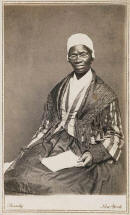 To
share insights on these and other aspects of the Underground
Railroad, historic researcher and genealogist Dona Stokes-Lucas
of Indianapolis joined Nelson in studio. Dona, who is on the
board of directors of Indiana Freedom Trails, Inc., helped organize a national Underground Railroad Conference 2009 set for Sept. 16-19 at
the Hilton Indianapolis North, 8181 N. Shadeland Ave. Indiana
Freedom Trails is a diverse group that seeks to identify, verify and
preserve Hoosier sites that were part of the Underground Railroad
network.
To
share insights on these and other aspects of the Underground
Railroad, historic researcher and genealogist Dona Stokes-Lucas
of Indianapolis joined Nelson in studio. Dona, who is on the
board of directors of Indiana Freedom Trails, Inc., helped organize a national Underground Railroad Conference 2009 set for Sept. 16-19 at
the Hilton Indianapolis North, 8181 N. Shadeland Ave. Indiana
Freedom Trails is a diverse group that seeks to identify, verify and
preserve Hoosier sites that were part of the Underground Railroad
network.
(Image of Sojourner Truth courtesy of Mathew Brady Studio, albumen silver print c. 1864, National Portrait Gallery.)
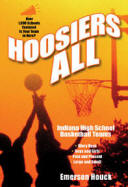 Why
was West Baden High School's basketball team called The Sprudels?
What Hoosier teams, then or now, were known as the Epsom Salts, the
Pimento Peppers, and the Blue Jeans? And why are we doing a show
about Hoosier hoops in August? Well, it's because of a brand new
book, Hoosiers
All: Indiana High School Basketball Teams (Hawthorne
Publishing, $25), which is being touted as a definitive exploration
of all boys and girls high school basketball teams that ever
existed, including those at long-shuttered schools in small towns.
Why
was West Baden High School's basketball team called The Sprudels?
What Hoosier teams, then or now, were known as the Epsom Salts, the
Pimento Peppers, and the Blue Jeans? And why are we doing a show
about Hoosier hoops in August? Well, it's because of a brand new
book, Hoosiers
All: Indiana High School Basketball Teams (Hawthorne
Publishing, $25), which is being touted as a definitive exploration
of all boys and girls high school basketball teams that ever
existed, including those at long-shuttered schools in small towns.
Nelson was joined in studio by Hoosiers All author Emerson Houck, a retired Eli Lilly & Co. executive who also has headed up a hospital auditing firm and is a trustee emeritus of Hanover College. His book – for which Emerson spent years traveling to small towns across Indiana with his wife Jane – was launched as part of a 2009 gala at the Indiana High School Basketball Hall of Fame in New Castle. He says some mascot names are obvious if you know local folklore: the Elnora Owls is a result of Elnora's nickname as “owl town” because of an abundance of the birds in the environs. But why are Vincennes teams known as the Alices? Expect us also to explore the Banquo Ghosts, Bedford Stonecutters, and Stinesville Quarry Lads. It also may surprise folks to learn many Hoosier high schools had girls basketball teams during the 1920s. We'll ask Emerson why the girls teams vanished for generations, only to be revived with Title IX in the 1970s. This show was a slam-dunk. It was enlightening, informative – and fun.
Hoopah! Don't you enjoy our rotating series about ethnic immigration to the Hoosier state? Previous shows have explored our German history and our Scottish heritage. Now, Hoosier History Live! turns to all things Greek in Indiana, including Holy Trinity Greek Christian Orthodox Church. Georgia Gianakos Buchanan, who joined Nelson in studio, is one of the best-known Hoosiers of Greek heritage. A former president of Indiana Special Olympics, an arts advocate, fund raiser for charities, and a writer, Georgia is a first-generation Greek-American whose parents emigrated here in the 1920s. Her father opened a restaurant in a near-Westside neighborhood known as “The District” that was home to many Greek families. Georgia is the author of Paved With Gold, a new edition of her novel about Greek-Americans that originally was published in 1979. She was our guide as we explored why Greeks came to the Hoosier state, where they settled, the jobs they undertook, and the culture they have strived to preserve. Holy Trinity, which grew from a handful of families at the parish's beginnings in 1910, now has more than 2,000 members.
Fun facts: The church originally was located on the site today of the Indiana History Center at West and New York streets. (Check out the historical marker there.) In the early 1960s, Holy Trinity moved to its long-time home at 40th and Pennsylvania; now, the church is at an eye-catching, new building with a Byzantine dome in western Carmel.
Remember Al Green's Famous Food, the once-wildly popular drive-in restaurant on East Washington Street? Even though food service was so slow it became a standing (or sitting) joke among motorist-customers, Al Green's was packed for several generations and sported a towering, neon sign that could be seen for miles at night. You also may fondly remember the glorious heyday of Eastgate Shopping Center, long before it devolved into being Eastgate Consumer Mall and endured a prolonged demise. You probably DON'T remember Wonderland Amusement Park, a sprawling entertainment center with diving horses, a beer garden, “dream-like” architecture, and thrill rides; the amusement park on East Washington Street had a fleeting (but huge) heyday before burning to the ground in 1911. These and other bygone landmarks on Eastside Indy will be our show's focus.
Nelson's guest, author Julie Young, whose new visual history book, Eastside of Indianapolis: A Brief History (The History Press), includes those warmly remembered landmarks. Also featured are the Rivoli Theater (believe it or not, it once was a beloved, revival movie house), the Paramount Music Palace (its pipe organ was stunning), and the Eastwood, a movie theater with a massive, curved screen that made it “the” place to see “Star Wars” in the 1970s. Julie grew up on the Eastside, as did Nelson, who is quoted in the book.
Swine flu has been a big worry, with lots of references to the devastation and dread associated with one of the world's worst epidemics. It was the influenza virus of 1918, which followed World War I and ravaged North America and Europe. But what was the impact in Indiana? Were there ramifications here beyond the loss of lives? Hoosier historian Bill Beck joined Nelson to share insights about the 1918 influenza epidemic, a “hot” history topic now. In fact, just a few hours after our show on July 18th, Bill spoke about the 1918 epidemic in a program open to the public at the Indiana Medical History Museum, 3045 E. Vermont St. Here's one way the 1918 epidemic impacted Indiana: According to Bill, the widespread deaths created a national boom in sales of coffins made by Batesville Casket Co. in southern Indiana.
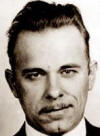 Amid
the hype about outlaw John Dillinger and the new movie “Public Enemies” starring Johnny Depp, Nelson explored
the heritage of the Morgan County town where the bank robber spent
many of his formative years and first slid into a life of crime. Mooresville,
which is located ten miles southwest of Indianapolis, has a rich
heritage even aside from its association with the youthful
Dillinger; to share it, Hoosier History Live! lined up a
studio visit from a lifelong resident steeped in his hometown's
history and folklore. Don Adams is a retired history teacher at Mooresville High School. Don grew up
in a house once owned by one of Mooresville's other notable
residents: watercolor artist Paul Hadley the designer of the state flag of Indiana. Don and Nelson also
discussed how
Mooresville feels about its link with Dillinger, who moved there as
a teenager with his father and stepmother. This show is part of our rotating series of town histories; previous shows
have focused on Greencastle, Madison, Sheridan, Greenfield, and the
bygone town of Elkinsville.
Amid
the hype about outlaw John Dillinger and the new movie “Public Enemies” starring Johnny Depp, Nelson explored
the heritage of the Morgan County town where the bank robber spent
many of his formative years and first slid into a life of crime. Mooresville,
which is located ten miles southwest of Indianapolis, has a rich
heritage even aside from its association with the youthful
Dillinger; to share it, Hoosier History Live! lined up a
studio visit from a lifelong resident steeped in his hometown's
history and folklore. Don Adams is a retired history teacher at Mooresville High School. Don grew up
in a house once owned by one of Mooresville's other notable
residents: watercolor artist Paul Hadley the designer of the state flag of Indiana. Don and Nelson also
discussed how
Mooresville feels about its link with Dillinger, who moved there as
a teenager with his father and stepmother. This show is part of our rotating series of town histories; previous shows
have focused on Greencastle, Madison, Sheridan, Greenfield, and the
bygone town of Elkinsville.
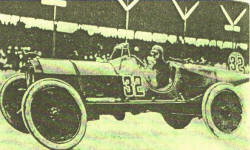 Following
on the heels of our recent show about the colorful life of Indianapolis
Motor Speedway founder Carl Fisher Hoosier History Live! explored an exciting, current project about a
milestone in Indy city history. Nelson was joined in
studio by businessman and motor sports enthusiast Roger Brummett, who, as associate producer, is helping arrange the funding for a
major movie now in production about the inaugural Indianapolis 500 in 1911, a race that was
extremely controversial. (Photo Courtesy:
Al Weatherburn). The $35 million movie is sparking a lot of excitement. The screenplay is by none other
than Angelo
Pizzo of Bloomington, who wrote Hoosiers (1986) and Rudy (1993), smash-hit movies about other Indiana sports
legends. A racetrack designed to resemble the Speedway of 1911 is
expected to be built in Newton County for the movie, which will
feature Carl Fisher as a major character. According to Donald
Davidson's Official History of the Indianapolis 500, the
winner of the inaugural 500, Ray Harroun,
always thought of himself more as an engineer and inventor than a
race driver. He's believed to have been the very first person to use
a rearview mirror when he installed one on his Marmon Wasp that won the first 500.
Following
on the heels of our recent show about the colorful life of Indianapolis
Motor Speedway founder Carl Fisher Hoosier History Live! explored an exciting, current project about a
milestone in Indy city history. Nelson was joined in
studio by businessman and motor sports enthusiast Roger Brummett, who, as associate producer, is helping arrange the funding for a
major movie now in production about the inaugural Indianapolis 500 in 1911, a race that was
extremely controversial. (Photo Courtesy:
Al Weatherburn). The $35 million movie is sparking a lot of excitement. The screenplay is by none other
than Angelo
Pizzo of Bloomington, who wrote Hoosiers (1986) and Rudy (1993), smash-hit movies about other Indiana sports
legends. A racetrack designed to resemble the Speedway of 1911 is
expected to be built in Newton County for the movie, which will
feature Carl Fisher as a major character. According to Donald
Davidson's Official History of the Indianapolis 500, the
winner of the inaugural 500, Ray Harroun,
always thought of himself more as an engineer and inventor than a
race driver. He's believed to have been the very first person to use
a rearview mirror when he installed one on his Marmon Wasp that won the first 500.
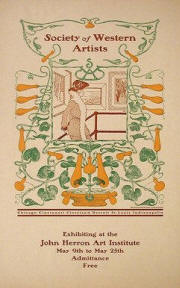 The Indiana State Museum is touting a new exhibition as the
first major one ever to explore the challenges that have confronted
artists who opt to remain in the Midwest. According to fine arts
curator Rachel Perry, the exhibit, titled Making It in the Midwest: Artists Who Chose to Stay “brings together an important array of historical works, many of
which are in private collections and have not been seen publicly for
decades.”
The Indiana State Museum is touting a new exhibition as the
first major one ever to explore the challenges that have confronted
artists who opt to remain in the Midwest. According to fine arts
curator Rachel Perry, the exhibit, titled Making It in the Midwest: Artists Who Chose to Stay “brings together an important array of historical works, many of
which are in private collections and have not been seen publicly for
decades.”
Rachel is the author of a lavishly illustrated book about some of the most illustrious artists who stayed. Her book, T.C. Steele and the Society of Western Artists, 1896-1914 (IU Press), examines the legendary Steele and his painting techniques as well as his role as a catalyst for Brown County's art colony. (Fun fact: Rachel knows that scenic turf well. She's a longtime resident of rural Brown County.) The exhibit features about 50 paintings from the Society of Western Artists, which formed in the late 1800s to bring greater attention to works created in the Midwest. They organized annual exhibitions that attracted national notice. Even so, Rachel notes, “Hoosier artists today continue to struggle to build their careers and sustain their artistic passions while remaining in Indiana.” (Photo Courtesy: Indianapolis Museum of Art)
What artifacts are buried at the site of Madam Walker's long-demolished house? What about at the former sites of homes built in the late 1800s in the near-Westside neighborhood known today as Ransom Place? And what about a legendary (or notorious) two-story outhouse that “serviced” low-income, multi-family dwellings as recently as the 1940s? Every summer, an archaeological dig overseen by Paul Mullins has tackled each of those questions. Paul, an associate prof of anthropology and director of IUPUI's archaeology field school was Nelson's studio guest and explored the fascinating excavations into Hoosier history that his students undertake.
This summer, Paul & crew are in the midst of a much-publicized dig in the 600 block of N. West Street to find artifacts linked to the home and office of Madam Walker. Experts think Madam Walker, who died in 1919, may have been the first African-American woman to become a millionaire as a result of her hair care and beauty products. The daughter of former slaves, Madam Walker was born in the Deep South in 1867, just two years after the Civil War. She moved to Indianapolis in 1910 to launch her company; initially, Madam and her husband, C.J. Walker, lived in a rental house. By May 1911, she had become sufficiently prosperous to buy a spacious, two-story house that had been built in the 1870s by a white couple from New Hampshire. (More than 150 guests attended the Walkers' housewarming party. A harpist entertained, and the home was decorated with palms.) Since May 2009, Paul and his IUPUI students have been digging on the site of the Walker residence, which was razed in the mid-1960s.
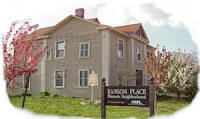 A few summers ago, Paul and his students excavated in the 900 block
of California Street, searching for artifacts related to homes built
in the 1870s for working-class, multi-ethnic families. Paul
emphasizes that, until about 1920, the near-Westside was much more
diverse than people realize, with many German, Irish and Greek
immigrants living in the neighborhood. Hundreds of these homes were
later demolished, particularly as IUPUI developed. Today, the Ransom
Place Historic District is, he says, “the only surviving remnant” of
what had been a densely populated residential area.
A few summers ago, Paul and his students excavated in the 900 block
of California Street, searching for artifacts related to homes built
in the 1870s for working-class, multi-ethnic families. Paul
emphasizes that, until about 1920, the near-Westside was much more
diverse than people realize, with many German, Irish and Greek
immigrants living in the neighborhood. Hundreds of these homes were
later demolished, particularly as IUPUI developed. Today, the Ransom
Place Historic District is, he says, “the only surviving remnant” of
what had been a densely populated residential area.
And then there's the two-story outhouse, a photo of which is featured in many Indianapolis history books, including Nelson's Indianapolis Then and Now (thanks to his collaborator, photo historian Joan Hostetler). Serving multi-family households living in poverty and ignored by many city leaders, the unusual privy was located on property that's now part of the IUPUI campus. The privy stood in the 400 block of University Boulevard (it was called Agnes Street until being renamed in the 1980s), today the site of IUPUI's new Campus Center.
A few summers ago, well before the Campus Center construction, Paul and his students went digging to find artifacts related to the outhouse. He says determining the precise locations of outhouses is relatively easy. That's because generations of people tended to use privies as makeshift Dumpsters, tossing mounds of trash in them. Paul & crew found everything from a “lucky” coin popular in the 1930s to Milk of Magnesia bottles, Jergens hand lotion, and animal bones.
Nelson spoke to Paul about the insights these digs have revealed about our culture from earlier eras as well as, including the amazing life of Madam Walker. By the way, she spent the final two years of her life based in the New York City area, dividing her time between a Harlem townhouse and an Irvington-on-Hudson mansion. (Her home on West Street continued as her company's office for many years.) Artifacts excavated this summer become the property of the Madame Walker Theatre Center, which is located on Indiana Avenue just north of the dig site. (Photos Courtesy of IUPUI Anthropology Department)
In July 90-year-old Indianapolis business leader and
philanthropist P.E. MacAllister 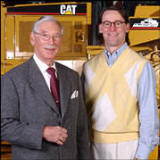 was named a Living Legend by the Indiana Historical Society.
Mr. MacAllister will join an illustrious class of Legend inductees
that also will include Indiana Pacers commentator Bobby “Slick"
Leonard, who coached the team during its triumphant era in the
bygone ABA league; Olympics organizer Anita DeFrantz, a Shortridge
High School graduate who won a bronze medal as a rower in the 1976
Montreal Olympics, then became an attorney and rose to the top ranks
of the International Olympics Committee; and shopping mall magnates
Herb and Mel Simon. (Photo to the left: P.E. & Chris
MacAllister)
was named a Living Legend by the Indiana Historical Society.
Mr. MacAllister will join an illustrious class of Legend inductees
that also will include Indiana Pacers commentator Bobby “Slick"
Leonard, who coached the team during its triumphant era in the
bygone ABA league; Olympics organizer Anita DeFrantz, a Shortridge
High School graduate who won a bronze medal as a rower in the 1976
Montreal Olympics, then became an attorney and rose to the top ranks
of the International Olympics Committee; and shopping mall magnates
Herb and Mel Simon. (Photo to the left: P.E. & Chris
MacAllister)
Anticipating the Living Legends gala
(for which Nelson serves on the selection/organizing committee), Mr.
MacAllister visited Hoosier History Live! to reflect on the state
where he's had a tremendous impact as a civic leader. 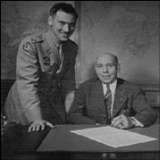 Now
chairman of the board of MacAllister
Machinery Co., which was founded by his father in 1945
during the post-World War II business boom, Mr. MacAllister has
focused his civic interests on everything from the Indianapolis
Opera Company to public parks, hospitals, Scottish heritage
groups, and efforts to honor veterans. (Mr. MacAllister served in
the U.S. Army air Corps during World War II.) Nelson tapped into his insights on an array of civic and historical
topics from his vantage point of 90 years.
Now
chairman of the board of MacAllister
Machinery Co., which was founded by his father in 1945
during the post-World War II business boom, Mr. MacAllister has
focused his civic interests on everything from the Indianapolis
Opera Company to public parks, hospitals, Scottish heritage
groups, and efforts to honor veterans. (Mr. MacAllister served in
the U.S. Army air Corps during World War II.) Nelson tapped into his insights on an array of civic and historical
topics from his vantage point of 90 years.
(Photo to the right: father and son, P.E. & E.W. MacAllister)
Pioneer kitchens. Indiana as a hub of furniture making in the 1800s because of its dense hardwood forests. And the debut, marketing, explosion in popularity, and eventual decline of the Hoosier Cabinet, an innovative piece of furniture manufactured in Henry County from the 1890s through the 1930s that “came to alter the course of kitchen history”, as a new book puts it.
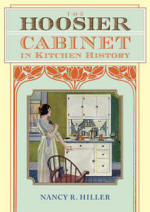 All
of these aspects of our heritage are explored in The Hoosier Cabinet in Kitchen History (IU Press)
written by Nancy Hiller, a Bloomington cabinetmaker. A social
historian and the owner of NR Hiller Design Inc.,
Nancy joined Nelson in studio to explore how settlers initially
arrived in the Indiana Territory – primarily on foot, with their
wagons filled with cooking pots and other supplies, unlike the
popular image, as her book puts it, of “a horse-drawn version of a
ride we might enjoy in an SUV on Interstate 70 today.” From there,
Nancy and Nelson will explore the development of kitchens and the
way women's work lives evolved, along with the marketing of the
Hoosier Cabinet as a revolutionary “step-saver”. According to
Nancy's book, more than 2 million had been sold by 1920, meaning
Hoosier Cabinets (which eventually were produced by non-Indiana
businesses as well as by the Hoosier Manufacturing Company based in
Albany and New Castle) could be found in one in ten American homes.
Their appeal rapidly declined in the 1930s – Nancy and Nelson will
discuss why – but Hoosier Cabinets remain treasures for collectors
and many kitchen lovers. Nancy still recalls her mother's delight at
discovering one in the Miami city dump in the 1960s.
All
of these aspects of our heritage are explored in The Hoosier Cabinet in Kitchen History (IU Press)
written by Nancy Hiller, a Bloomington cabinetmaker. A social
historian and the owner of NR Hiller Design Inc.,
Nancy joined Nelson in studio to explore how settlers initially
arrived in the Indiana Territory – primarily on foot, with their
wagons filled with cooking pots and other supplies, unlike the
popular image, as her book puts it, of “a horse-drawn version of a
ride we might enjoy in an SUV on Interstate 70 today.” From there,
Nancy and Nelson will explore the development of kitchens and the
way women's work lives evolved, along with the marketing of the
Hoosier Cabinet as a revolutionary “step-saver”. According to
Nancy's book, more than 2 million had been sold by 1920, meaning
Hoosier Cabinets (which eventually were produced by non-Indiana
businesses as well as by the Hoosier Manufacturing Company based in
Albany and New Castle) could be found in one in ten American homes.
Their appeal rapidly declined in the 1930s – Nancy and Nelson will
discuss why – but Hoosier Cabinets remain treasures for collectors
and many kitchen lovers. Nancy still recalls her mother's delight at
discovering one in the Miami city dump in the 1960s.
Following on the heels of our shows about other historic Indianapolis neighborhoods -Woodruff Place, Herron-Morton Place, and the North Meridian Mansions – is an exploration of diverse, urban St. Joseph Neighborhood on downtown Indy's near-Northside.
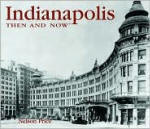 Our
studio guests were two well-known leaders of the neighborhood,
both long involved in historic preservation: photographer Garry Chilluffo,
president of the St. Joseph Historic Neighborhood Association
(and, not so incidentally, Nelson's collaborator on the ever-popular Indianapolis Then and Now book), and artist Leah Orr, who has won many awards for her work as a social
activist and her historic research. An activist for the homeless, Leah has lived for nearly 30 years
in St. Joseph, which is roughly bounded by Fort Wayne
and Central avenues, Pennsylvania Street and I-65.
Our
studio guests were two well-known leaders of the neighborhood,
both long involved in historic preservation: photographer Garry Chilluffo,
president of the St. Joseph Historic Neighborhood Association
(and, not so incidentally, Nelson's collaborator on the ever-popular Indianapolis Then and Now book), and artist Leah Orr, who has won many awards for her work as a social
activist and her historic research. An activist for the homeless, Leah has lived for nearly 30 years
in St. Joseph, which is roughly bounded by Fort Wayne
and Central avenues, Pennsylvania Street and I-65.
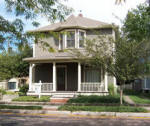 A mixed-use neighborhood that includes everything from Civil War-era
cottages, turn-of-the-last-century row houses, and historic
commercial buildings, St. Joseph has residential
architecture that spans almost the entire history of
Indianapolis, from Italianate and Queen Anne to Renaissance Revival.
As the neighborhood has pulled itself out of a decline in the
mid-20th Century, its colorful recent history has included crusades
for historic preservation. (Leah once stopped a bulldozer in
action!) Esteemed for his architectural and commercial photography,
Garry has visually documented much of the neighborhood he calls
home.
A mixed-use neighborhood that includes everything from Civil War-era
cottages, turn-of-the-last-century row houses, and historic
commercial buildings, St. Joseph has residential
architecture that spans almost the entire history of
Indianapolis, from Italianate and Queen Anne to Renaissance Revival.
As the neighborhood has pulled itself out of a decline in the
mid-20th Century, its colorful recent history has included crusades
for historic preservation. (Leah once stopped a bulldozer in
action!) Esteemed for his architectural and commercial photography,
Garry has visually documented much of the neighborhood he calls
home.
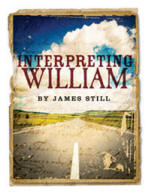 The
dramatic story of Hoosier pioneer William Conner, of Conner Prairie fame, has been told in many ways, but which interpretation is
correct? And who gets to make the historic call, not only with
Conner's life but with the presentation of any slice of our past? We
at Hoosier History Live! were thrilled to be able to call in a big gun to
tackle these and other challenges about history, Indiana Repertory Theatre's playwright-in-residence James
Still, whose new drama, Interpreting William, runs through May 31 and grapples
with similar themes.
The
dramatic story of Hoosier pioneer William Conner, of Conner Prairie fame, has been told in many ways, but which interpretation is
correct? And who gets to make the historic call, not only with
Conner's life but with the presentation of any slice of our past? We
at Hoosier History Live! were thrilled to be able to call in a big gun to
tackle these and other challenges about history, Indiana Repertory Theatre's playwright-in-residence James
Still, whose new drama, Interpreting William, runs through May 31 and grapples
with similar themes.
Although James didn't grow up in Indiana and isn't based here full-time – he grew up in Kansas, where his dad was a high school history teacher, and he now lives on the West Coast – James certainly qualifies as an honorary Hoosier (and an Indiana history expert!) by now. The central character in Interpreting William is a contemporary historian on deadline who is confronted by mysteries in the complicated personal life of Conner (1777-1855). The play is James' ninth IRT production. Many of them, including his acclaimed adaptation of Booth Tarkington's The Gentleman from Indiana and last year's Looking Over the President's Shoulder, have touched on Hoosier historical figures.
 Nelson spoke with James about the challenges in interpreting history, how
to capture an audience's interest in it, and his take on Conner, who
stayed here while his first wife (a Lenape, or Delaware, Indian) and
their six children were “re-settled” to the West. (Conner then
married a white woman, with whom he had 10 more children.) In Interpreting William, the historian character is confronted
with challenges after visiting Conner Prairie, the interactive
outdoor history park, which has partnered with the IRT for James'
play.
Nelson spoke with James about the challenges in interpreting history, how
to capture an audience's interest in it, and his take on Conner, who
stayed here while his first wife (a Lenape, or Delaware, Indian) and
their six children were “re-settled” to the West. (Conner then
married a white woman, with whom he had 10 more children.) In Interpreting William, the historian character is confronted
with challenges after visiting Conner Prairie, the interactive
outdoor history park, which has partnered with the IRT for James'
play.
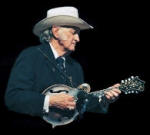 Even though Indiana may not be the primary state associated with
bluegrass, its heritage here has been rich, deep, and includes a
hugely popular annual festival that every June turns tiny Bean
Blossom in scenic Brown County into heaven for devotees of the
music. Who better to share folklore about the links between
Hoosiers, bluegrass music, and its legendary “father,” Bill
Monroe, than WICR-FM's own Cary Allen Fields, host of The Fields of Bluegrass
Radio Hour featured on the popular Friday Night Folk show,
and Col. James Peva, author of Bean Blossom: Its People and Its Music, a visual history
of the town that's been a site for bluegrass performances ever since
1940. Col. Peva also is the official historian for the Bill Monroe Music Park.
Cary is a guitarist/bassist/singer who writes for Bluegrass
Now magazine. They shared insights about Monroe
(1911-1996), whom Cary first met as a young boy.
Even though Indiana may not be the primary state associated with
bluegrass, its heritage here has been rich, deep, and includes a
hugely popular annual festival that every June turns tiny Bean
Blossom in scenic Brown County into heaven for devotees of the
music. Who better to share folklore about the links between
Hoosiers, bluegrass music, and its legendary “father,” Bill
Monroe, than WICR-FM's own Cary Allen Fields, host of The Fields of Bluegrass
Radio Hour featured on the popular Friday Night Folk show,
and Col. James Peva, author of Bean Blossom: Its People and Its Music, a visual history
of the town that's been a site for bluegrass performances ever since
1940. Col. Peva also is the official historian for the Bill Monroe Music Park.
Cary is a guitarist/bassist/singer who writes for Bluegrass
Now magazine. They shared insights about Monroe
(1911-1996), whom Cary first met as a young boy.
Nelson explored the architectural gems known as “the magnificent 92”: the majestic courthouses that dominate town squares across Indiana. His guest, Indianapolis architect and historic preservationist ,Jim Kienle, is known for his award-winning restoration work. Jim, president of James T. Kienle & Associates, is in the midst of restoring the Orange County Courthouse in Paoli; built in 1850, it is the state's second oldest courthouse in continuous use and is seen annually by thousands of travelers who visit the nearby resort hotels in French Lick and West Baden. As the lavishly illustrated book Magnificent 92 (IU Press, 1991) puts it, Hoosier towns “seemed to compete with one another for splendor and expense” in constructing their courthouses during the 1800s and early 1900s.
Substituting as host (Nelson was out of
town) was the Wine Maven herself, Jill Ditmire. Jill is an Omnimedia Wine Specialist who shares her wine wit and
wisdom in print, radio and television. She is an AWS Certified Wine
Judge and owner of Mass Ave Wine Shoppe in downtown Indianapolis.
Her guests were Tia Agnew and Brett Canady, owners
of New Day Meadery in Elwood, Indiana, who make hand crafted honey
wines, as well as Jim Bulter, author of Indiana Wines: a History ( I.U. Press).
According to Jim's book, a Frenchman from Switzerland named James
Dufour arrived in America in 1796, looking for land for a colony of
'vinedressers.' The group first settled in Kentucky, but then
purchased land in the Indiana Territory on the north bank of the
Ohio River. In the town they called Vevay, the Swiss winegrowers
successfully produced America's first commercial wines.
Jill is an Omnimedia Wine Specialist who shares her wine wit and
wisdom in print, radio and television. She is an AWS Certified Wine
Judge and owner of Mass Ave Wine Shoppe in downtown Indianapolis.
Her guests were Tia Agnew and Brett Canady, owners
of New Day Meadery in Elwood, Indiana, who make hand crafted honey
wines, as well as Jim Bulter, author of Indiana Wines: a History ( I.U. Press).
According to Jim's book, a Frenchman from Switzerland named James
Dufour arrived in America in 1796, looking for land for a colony of
'vinedressers.' The group first settled in Kentucky, but then
purchased land in the Indiana Territory on the north bank of the
Ohio River. In the town they called Vevay, the Swiss winegrowers
successfully produced America's first commercial wines.
On our rotating series of town histories – Hoosier History Live! has explored Greenfield, Clark County, Madison, and Sheridan – on this show Nelson was joined by Greencastle civic leader and historian Jinsie Bingham, a seventh-generation Greencastle Putnam County resident, who is a broadcasting executive. Her parents inadvertently (and innocently!) figured in John Dillinger's infamous robbery of a Greencastle bank in 1933 during which he escaped with the largest heist of his criminal career.
The bank building still stands, along with several other historic structures on or near Greencastle's town square. Nelson spoke with Jinsie about early pioneer settlements in the Greencastle area and the role of the National Road; the town's great fire of 1874; the Putnam County Courthouse and its distinctive sculpture of a World War I doughboy; the legendary Monon Bell rivalry between DePauw in Greencastle and Wabash College in Crawfordsville, and the area's extensive nature park. There's also a new Putnam County Museum; Jinsie is a board member of the museum as well as an inductee in the Indiana Broadcasters Hall of Fame. She owns Radio Greencastle and served as the first woman president of the Greencastle Rotary Club.
On Greencastle's website is a free six-part “Our Town” video (a WTIU production)
The 19th state has produced its share of cult figures. We explored two of them: Humorist/author/radio personality Jean Shepherd from Hammond (best remembered for the holiday movie favorite “A Christmas Story”), and William Dudley Pelley, a right-wing political extremist of the 1930s and ‘40s (he founded a group known as the Silver Shirts) who also became a well-known psychic and believer in the occult. Pelley spent his final years in Noblesville and is buried there. What do Shepherd and Pelley have in common, aside from being (to borrow a word used by our studio guest) curmudgeons?
Well, our guest, IRT actor John Guerrasio, is an expert in both of these quirky characters. John grew up in New York City listening to Shepherd's late-night radio monologues about his Hammond boyhood, tales that are said to have influenced top humorists such as Jerry Seinfeld. A Christmas Story (1983) was drawn from a bestselling book titled “In God We Trust, All Others Pay Cash” by Shepherd, who died in 1999 after years of semi-seclusion.
 In
addition to researching Shepherd, John has spent years working on a
screenplay about Pelley (1890-1965), who sympathized with the
Nazis and served a stint in federal prison for sedition
during World War II. That prison stint interrupted his life in
Noblesville. After his release from prison, Pelley focused on his
enterprise as a psychic, conducted séances in his Noblesville
garage, and sent material about the occult to followers around the
country.
In
addition to researching Shepherd, John has spent years working on a
screenplay about Pelley (1890-1965), who sympathized with the
Nazis and served a stint in federal prison for sedition
during World War II. That prison stint interrupted his life in
Noblesville. After his release from prison, Pelley focused on his
enterprise as a psychic, conducted séances in his Noblesville
garage, and sent material about the occult to followers around the
country.
This March, with the state in the midst of “March Madness,” Hoosier History Live! took a fresh perspective on basketball history courtesy of a studio guest who has been a star at just about every level of the game, including high school (Attucks) and college (IU). Recently honored by the Harlem Globetrotters as the 28th player to be inducted into the team's Ring of Legends during a game at Conseco Fieldhouse, Hallie Bryant shared with us about the links between Hoosiers and the world-famous team that combines athleticism with entertainment.
Amazingly, Hallie was one of four teammates from Attucks High School's remarkable Class of '53 who ended up touring the world as Globetrotters. In Hallie's case, it meant traveling to 82 countries during 13 barnstorming seasons as a player and another 14 in public relations.
Launched on the Southside of Chicago (despite the “Harlem” in the name) in the late 1920s, the Globetrotters have had links to Hoosiers almost from the beginning. Following Hallie's triumphs as a star player at IU (he co-captained the team in 1957 and set what was then a school record for free throws), the NBA offered limited opportunities, particularly for black players – but the Globetrotters were a showcase.
Today, as he enjoys a series of accolades (his jersey, along with those of other former stars from Attucks and Washington high schools, was retired during half-time celebrations a few weeks ago), Hallie is a popular motivational speaker, businessman, and the author of Hallie's Comet: Breaking the Code a self-help book that draws on his rich experiences, including those that we will explore with the Globetrotters.
Hallie Bryant's bio at the official website for the Harlem Globetrotters
Queen Victoria wasn't a Hoosier, but the way she reacted to the death of Prince Albert in 1861 eventually affected Indiana residents. She set the standard for strict guidelines of mourning etiquette that dictated everything from the bereaved's apparel to the way coffins were displayed – and how the deceased were photographed.
Our studio, Sheila Riley, an expert on Victorian-era mourning customs, who also is director of collections at the Children's Museum of Indianapolis, spoke with Nelson about all aspects of Victorian-era folklore about death and mourning, from social behavior to jewelry.
For more information visit the National Museum of Funeral History in Houston, which Shelia says has an extraordinary collection of artifacts related to mourning.
She began running for public office after leaving her husband and taking their seven children with her. The youngest child was 2 years old. From those unlikely beginnings more than 40 years ago, Marge O'Laughlin eventually rose in the 1980s to attain what was then the highest-ranking political office ever for a woman in Indiana. And when popular “Marge O” won re-election as State Treasurer in 1990, she was the top vote-getter on the state GOP ticket.
“Marge O” joined Nelson in studio to explore the challenges, influences, and strategies for success that have been part of her eventful life, from her days at Shortridge High School in the late 1940s (she and future US Sen. Richard Lugar were fellow cellists in the orchestra) to stints as a Northside housewife, Marion County clerk, Supreme Court clerk, and, eventually, the official in charge of state investments as Indiana's treasurer. The political pioneer once told Nelson, “I'm a great one for the art of the possible.”
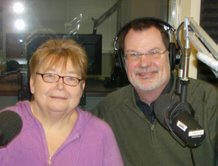 Are you assuming there's no Hoosier connection to the
Academy Awards. To the contrary, there's a deep Oscar heritage with
Hoosiers, which we explored with two well-known movie experts: Jeff Sparks, president and founder of the widely praised Heartland Film
Festival, and Bonnie Britton, former movie critic for The Indianapolis Star. Their “Oscars & Indiana” fodder
included the 50th anniversary of the “Best Picture” winner of 1959, Ben Hur, which was based on the spectacularly
successful novel by Lew Wallace of Crawfordsville. Ben Hur won 11 Oscars, which set a
record then.
Are you assuming there's no Hoosier connection to the
Academy Awards. To the contrary, there's a deep Oscar heritage with
Hoosiers, which we explored with two well-known movie experts: Jeff Sparks, president and founder of the widely praised Heartland Film
Festival, and Bonnie Britton, former movie critic for The Indianapolis Star. Their “Oscars & Indiana” fodder
included the 50th anniversary of the “Best Picture” winner of 1959, Ben Hur, which was based on the spectacularly
successful novel by Lew Wallace of Crawfordsville. Ben Hur won 11 Oscars, which set a
record then.
Bonnie, Jeff and Nelson also discussed the parallels between the posthumous nomination for Heath Ledger and those for Fairmount's James Dean, who had been killed in a car crash before he was nominated for East of Eden and Giant. Then there are the four Academy Awards won by the late filmmaker Robert Wise, who grew up in Winchester and Connersville; he went on to direct The Sound of Music, West Side Story, and an astonishing array of other hits.
And speaking of anniversaries, it's been 30 years since the 1979 release of Breaking Away, which won an Academy Award for the late screenwriter Steve Tesich, who grew up in East Chicago and based the movie on his experiences as an IU student. Other previous Oscar winners with Hoosier connections include actor Karl Malden, composer Hoagy Carmichael, and actress Anne Baxter.
During the 1930s and 1940s, an era when African-Americans were prohibited from buying property at popular lakeside resorts in northern Indiana and elsewhere, a group of Hoosiers decided to create their own summer community near Angola in the state's far-Northeastern corner. So began the fascinating story of tranquil Fox Lake, one of the few resorts in the country then for African-Americans. Fox Lake is listed on the National Register of Historic Places.
Nelson's studio guests, two Indianapolis-area natives for whom Fox Lake became their summer home throughout their childhood and teenage years, were Joanna Flowers, an administrator for state government who now takes her grandchildren to the family cottage that her parents built in 1948, and Edwyna Ratcliff, whose family never owned property at Fox Lake, but who began accompanying friends to the resort when the secluded community didn't even have electricity yet. As Fox Lake grew, attracting African-American residents from Chicago, Detroit and various cities in Ohio, the resort eventually included a clubhouse that featured dances and performances by well-known musicians, a restaurant, a pier, and tennis courts.
This is considered the “Year of Lincoln” across the country because of his 200th birthday on February 12. To highlight the character-shaping and life-impacting events that happened during his often-overlooked years in the new Hoosier state (Abe moved to the southern Indiana wilderness with his family in 1816, the same year we became a state), Nelson called on some young people – and their well-known teacher -- who have been immersing themselves in Lincoln and Indiana lore.
Nelson's guests were Andrea Neal, his former colleague (and fellow Hoosier history lover) at The Indianapolis Star, where she was editor of the editorial pages. These days, Andrea is a history teacher at St. Richard's Episcopal School in Indianapolis, which has been named one of the state's “Lincoln Bicentennial Schools” by the federal bicentennial commission for the 200th birthday. He spoke with Andrea and her two students, who joined her in studio, about a candlelight vigil in which they plan participate on the eve of the birthday. Mostly, though Andrea and two eighth graders at St. Richard's, Courtney Burke and Caroline Tucker, explored on the air young Abe's eventful years as Hoosier (his family didn't move to Illinois until he was 21), which included everything from the death of his beloved mother, adjustments to a stepparents and step-siblings, as well as his beginnings as a young speechmaker and his masterful use of humor.
As Hoosier History Live! saluted Black History Month, we focused on a treasure trove. More than 700,000 historic photos, many never seen in public, were in the private collection of the late New York eye surgeon, Dr. Stanley Burns.
Nelson's studio guest Modupe Labode an assistant professor of museum studies and history at IUPUI was assigned to sift through these thousands of images to create the exhibit “Shadows and Substance: African-American Photographs from the Burns Archive” that opened January 19, 2009 at the Indiana State Museum, and covers African-American life from the 1840s through the 1960s. The Burns Archive Website: www.burnsarchive.com
Hoosier History Live! focused on the heritage of the scenic town on the Ohio River that was the Hoosier state's leading city for much of the first half of the 1800s. Our guide was studio guest Wayne Sanford a Madison enthusiast who frequently gives lively presentations about various aspects of the town, including its famous Lanier Mansion as well as the impact of railroads on the city, where the downtown area (a grand total of 133 blocks) has been designated one of the largest national historic landmarks in the entire country. Expect to see the spotlight shine a lot in upcoming months on the town that's a historic gem. Madison incorporated in 1809, meaning next year is its 200th anniversary; celebrations galore are planned. www.historicmadisoninc.com
Trent Pendley, president of the Indiana Jewish Historical Society, a Porter County writer, jeweler and historian, talked about the various waves of Jewish immigration to the state, including Indiana's firsts Jewish settlers, as well as areas in the state where Jews were forbidden to buy property. According to Peopling Indiana: The Ethnic Experience (Indiana Historical Society Press, 1996), about 80 percent of the state's Jewish population today lives in the Indianapolis metro area, the northwest Indiana metro area, South Bend, Fort Wayne, and Evansville, in that order. But did you know that smaller Wabash, Indiana, once had a thriving Jewish community? According to The Encyclopedia of Indianapolis (IU Press, 1994)Jews have comprised about 2 percent of the Hoosier capital's population for most of the city's history. Trent, an IU grad, is the author of an in-depth article, “Jewish History of Indiana Dunes County, 1830-1950,” featured in the Indiana Jewish History journal from the Indiana Jewish Historical Society.
Cemeteries have a rich history in Indiana and have been in the news recently with the move of tombstones and human remains from a mid-1800s cemetery in the Castleton area of Indianapolis to Crown Hill Cemetery to allow for the widening of I-69 near its interchange with I-465. Our studio guest, Jeannie Regan-Dinius of the Indiana Division of Natural Resources helped oversee the reburial. Nelson spoke with Jeannie about the history of Crown Hill (the country's third largest cemetery) and its predecessor, Greenlawn Cemetery, which was located near White River and prone to flooding. We also discussed magnificent Green Hill Cemetery near Bedford that has unforgettable, personalized monuments created by generations of stone cutters in the community.
Dr. Lee Cloe, a charter member – and secretary emeritus – of the Scottish Society of Indianapolis, was our guide, as we explored why Scots immigrated to Indiana, where they settled, the jobs they undertook, and their contributions to Hoosier culture.
Circle Theatre on Monument Circle was considered one of the first silent movie palaces west of New York when it opened in 1916. One of the top stars of the silent screen, Monte Blue, grew up in an orphanage in Knightstown, Indiana and that Rudolph Valentino's leading lady in the movie that shot him to stardom was a native of Vincennes.
David L. Smith, a Ball State Professor Emeritus, former host of WISH-TV's popular “When Movies Were Movies” series, and author of the definitive book Hoosiers in Hollywood (2006, Indiana Historical Society Press) explored Hoosier connections to silent movie stars and theaters. You can visit Dave's website at www.whenmoviesweremovies.com
When Bush Stadium was built on W. 16th Street in 1931, it was considered one of the country's best minor-league baseball parks. As the longtime home of the Indianapolis Indians, as well as various teams in the old Negro leagues, Bush became much loved and served as the historic setting for the movie Eight Men Out (1988), which recently celebrated its 20th anniversary.
Historic Landmarks Foundation of Indiana has placed the empty stadium on its list of 10 Most Endangered Places in the state. Mark Dollase, Landmark's vice president of preservation services, said Bush barely escaped demolition by a potential developer last year.
Among the Hoosiers who attended Elvis Presley's final concert on June 26, 1977 – 31 years ago this month – were two reviewers Zach Dunkin who pioneered local rock n' roll coverage with his Rock Pile column in the old Indianapolis News (he gave The King's concert at Market Square Arena a devastating review), and Rita Rose who then was a concert reviewer for The Indianapolis Star. After Elvis' performance in a gold and white jumpsuit at MSA he stopped touring and died two months later.
For months Zach (who now is a travel writer for The Star) received hate mail for his blistering review, although he helped organize the group that lobbied for the display commemorating the final Elvis concert at the site of MSA, which was imploded in 2001.
Rita, who retired from The Star last year, now has written a cover story for The Indiana Historical Society's Publication Traces of Indiana and Midwestern History that includes interviews with an assortment of the 18,000 people in the audience that fateful night. Their reactions to The King may vary, but, as Rita puts it in her retrospective, “one thing is abundantly clear; Elvis will never leave the building. Even if the building ... is no longer standing.”
Read Rita Rose's cover story published by The Indiana Historical Society's magazine Traces of Indiana and Midwestern History in the spring 2008 issue here
More Links for your inner Elvis enthusiast:
Appears to be home video of the concert in
Indianapolis, with real audio
http://www.youtube.com/watch?v=21Ml2ms4fw4&NR=1
Close-up of Elvis Historical Marker at MSA site
http://www.hmdb.org/marker.asp?marker=538
Video of MSA implosion (why does this stuff fascinate us?)
http://www.youtube.com/watch?v=Bvsp5UOcuw0
On May 3, Nelson's guest Speedway native Chuck Bennett, a teacher at Speedway High School steered us through Speedway's heritage. He lives in a historic house that once was the home of the city's original platter. In a strange twist of fate, Mr. Bennett's front door even came from the Allison Mansion, the home of International Motor Speedway co-founder James Allison.
Speedway's was as a “horseless” town after the first 500-Mile Race was launched in 1911. The first competitive race at the track occurred two years earlier in 1909. That race involved hot air balloons, not cars, with Speedway co-founder Carl Fisher among the contestants.
Last year, Mr. Bennett taught history at Speedway Junior High School and supervised his students as they set up a Website about the town's historical neighborhood. To see aerial photos of the town taken decades ago as well as photos of historic homes as they look today, click here
Mr. Bennett suggests the following Websites for exploring the heritage of the town and racetrack:
Town site: www.townofspeedway.org
Schools site: www.speedwayschools.org
Indianapolis Motor Speedway: www.indianapolismotorspeedway.com
Home | About us | Support the show | Contact us | Archives | Listen
© 2008-2017 Hoosier History Live. All rights reserved.